Understanding Your
Plumbing Needs


When Your Furnace Fails: A Homeowner's Guide to Emergency Repair in Mission
When your furnace stops working on a freezing Mission night, emergency furnace repair in mission, bc becomes your top priority. Whether your home is suddenly cold, you're hearing alarming noises, or you detect a gas smell, knowing how to respond quickly can protect your family and prevent costly damage like frozen pipes.
If you need emergency furnace repair right now:
- Turn off your furnace if you smell gas or hear unusual sounds
- Call a 24/7 emergency HVAC service - most Mission contractors offer same-day response
- Have your furnace make, model, and symptoms ready to describe
- Keep your family warm with safe temporary heating until help arrives
- Don't attempt DIY repairs - gas and electrical issues require licensed professionals
If you're looking for comprehensive guidance on furnace issues, check out our complete furnace repair guide for Mission homeowners. For immediate professional assistance, contact Valley Pacific Mechanical Contracting for fast, reliable emergency service.
Mission's damp, coastal-influenced winters put constant demand on your heating system. The Fraser Valley's fluctuating temperatures and older homes with limited ventilation can accelerate furnace problems, making emergency breakdowns more common than in many other regions. Understanding when a furnace issue requires immediate attention versus scheduled service helps you protect your home and avoid the stress of unexpected cold nights. This guide walks you through recognizing critical warning signs, taking immediate action, and getting professional help fast.
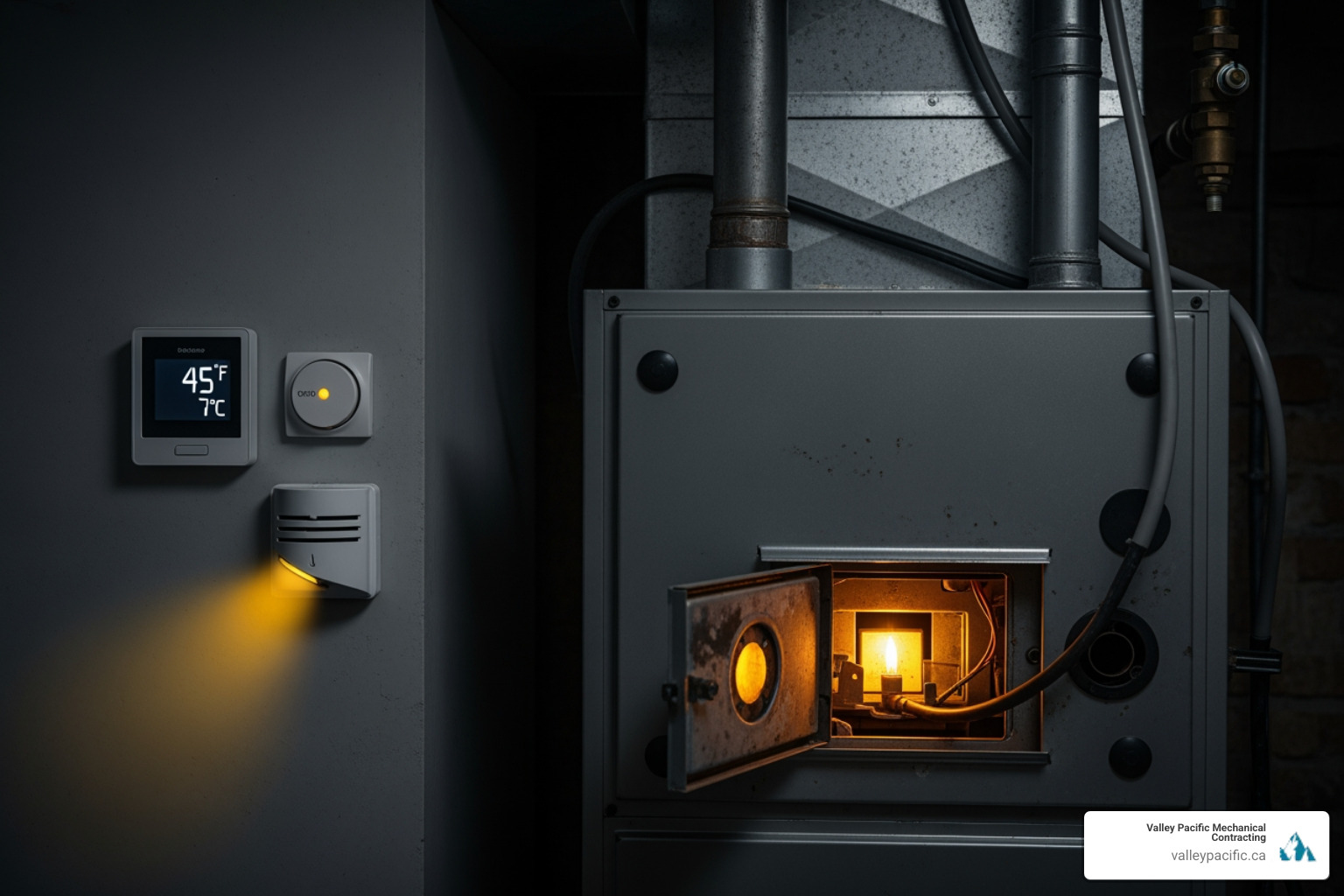
Key Signs You Need Emergency Furnace Repair
When the cold sets in, a functioning furnace isn't just about comfort; it's about safety. Mission's long, wet winters and chilly nights mean your heating system works hard. If your furnace is acting up, it’s crucial to know whether it's a minor hiccup or a full-blown emergency requiring immediate attention.
One of the most obvious signs that something is seriously wrong is a complete lack of heat. You might find your thermostat displaying a low temperature, even when it's set much higher. If your furnace is running but only blowing cold air, or if it stops working entirely, especially during a cold snap, this is a clear signal for emergency furnace repair in mission, bc. These issues can stem from various sources, including a malfunctioning thermostat, a dirty air filter severely restricting airflow, problems with the pilot light or ignition system, or even issues with the gas valve or burners. In Mission, where temperatures can drop quickly, losing heat is not just an inconvenience; it can lead to serious health risks and potential property damage like frozen pipes.
Critical Symptoms Demanding Immediate Attention
Beyond the absence of heat, certain critical symptoms demand immediate attention from a professional. Ignoring these can not only worsen the problem but also pose significant safety risks to your household.
- Strange Noises: Furnaces are not silent, but they shouldn't sound like a rock concert. If you hear banging, screeching, rattling, or grinding noises, it's a red flag. These sounds often indicate loose parts, worn bearings in the motor, or airflow issues. A professional can pinpoint the source and make necessary repairs before a small problem escalates into a major breakdown.
- Gas Smell or Carbon Monoxide Detector Alarm: This is arguably the most critical and dangerous sign. If you smell gas, even faintly, or if your carbon monoxide (CO) detector goes off, do not hesitate. Gas leaks and carbon monoxide are invisible, odorless, and potentially deadly. Immediately turn off your furnace, evacuate your home, and call 911 or FortisBC's emergency line. Once the area is deemed safe, contact us for a thorough inspection and emergency furnace repair in mission, bc. A cracked heat exchanger or poor venting can lead to carbon monoxide leaks, which is why we perform CO tests during every furnace service for your safety. The Safety Authority of BC highly recommends that you perform furnace service at least once a year to prevent such dangerous situations.
- Burning Smells: When you first turn on your furnace after months of inactivity, a slight burning dust smell is common as accumulated dust burns off. However, if this smell persists for more than a few hours, or if you detect a distinct burning plastic or electrical smell, it could indicate overheating components, faulty wiring, or even a fire hazard.
- Visible Rust, Water Leaks, or Soot: While a furnace is designed to be a dry system, you might notice water pooling around the unit, especially with high-efficiency condensing furnaces. This often points to a clogged condensate line or a malfunctioning humidifier. Rust or excessive soot build-up can indicate combustion problems and warrant an inspection.
Common Causes of Sudden Furnace Failure
Understanding the root causes of furnace failure can help you better articulate the problem to a technician and even take preventative measures. Many of the urgent repair calls we receive in Mission are, surprisingly, preventable.
- Clogged Filters: This is a surprisingly common culprit. A dirty air filter restricts airflow, forcing your furnace to work harder, which reduces efficiency, strains the blower motor, and can even cause overheating and system shutdowns. Regular filter replacement is one of the easiest ways to extend your system's lifespan and reduce emergency repair needs.
- Faulty Ignitor or Flame Sensor Issues: Modern furnaces use an electronic ignitor to light the gas, or a flame sensor to ensure a flame is present. If these components fail or become dirty, your furnace won't be able to light or stay lit, leading to no heat or short cycling. Failed ignitors and dirty flame sensors are among the most frequent issues we encounter.
- Blower Motor Malfunction: The blower motor is responsible for circulating heated air throughout your home. If it starts to fail, you might hear grinding or rattling noises, or experience weak airflow. A complete motor failure means no air circulation, regardless of how hot the furnace gets.
- Broken Thermostat: Sometimes the problem isn't the furnace itself, but the command center. A malfunctioning thermostat can incorrectly read temperatures, fail to send signals to the furnace, or even cause the system to short cycle. We troubleshoot and repair all types of thermostats, including digital, programmable, and smart units.
- Short Cycling: This occurs when your furnace turns on and off frequently without completing a full heating cycle. It's typically caused by overheating due to dirty filters, poor airflow, a malfunctioning flame sensor, or an improperly sized system. Short cycling is inefficient and puts excessive wear and tear on your furnace.
- Gas Furnace Specific Issues: These can include problems with the pilot light (if applicable), gas valve malfunctions, or issues with the gas connection.
- Electric Furnace Specific Issues: For electric furnaces, common problems include tripped circuit breakers, faulty sequencers, or blown heating elements.
Knowing these common causes helps us diagnose and address your issue faster. For a broader look at our services, explore our HVAC services in Mission.
What to Do Immediately When Your Furnace Breaks Down
When your furnace decides to take an unscheduled vacation, especially during Mission's colder months, panic can quickly set in. But a clear head and swift action can make a huge difference, protecting your home and family until professional help arrives. Our 24/7 emergency service means we can dispatch a technician swiftly, day or night, 365 days a year, but there are crucial steps you can take in the interim.
Safety Protocols and Initial Troubleshooting
Your safety, and the safety of your home, is our top priority. Before calling us for emergency furnace repair in mission, bc, follow these essential safety protocols and perform some basic checks:
- Gas Leak Procedure: If you smell gas or your carbon monoxide detector activates, this is an immediate emergency. Do not try to find the source. Turn off your furnace, evacuate everyone from the home, and call 911 or FortisBC from a safe location. Do not re-enter until emergency services declare it safe. Once cleared, then call us for a full furnace inspection and repair.
- Turn Off the Furnace: If there's no gas smell but you hear alarming noises, see sparks, or suspect an electrical issue, locate the emergency shut-off switch for your furnace. This is typically a light-switch-like toggle on a wall near the furnace. Turning it off will prevent further damage and ensure safety until a technician can assess the problem.
- Check Circuit Breakers: Go to your home's electrical panel and look for a tripped breaker labeled "furnace" or "HVAC." Sometimes, a simple power surge or a minor electrical fault can trip the breaker. Resetting it might restore power to your furnace. If it trips again immediately, do not keep resetting it; this indicates a persistent electrical issue requiring professional attention.
- Check the Thermostat Battery: It might sound too simple, but a dead or low battery in your thermostat is a common reason for a furnace not responding. Replace the batteries if your thermostat has them.
- Ensure Vents Are Open: Double-check that all your heating vents are open and not blocked by furniture, rugs, or drapes. Restricted airflow can cause your furnace to overheat and shut down prematurely.
These initial steps can sometimes resolve the issue or, at the very least, ensure your safety while you await professional assistance.
What to Have Ready for Your Emergency Furnace Repair in Mission, BC Call
When you call for emergency furnace repair in mission, bc, having key information readily available helps our dispatch team and technicians prepare more effectively, potentially speeding up the diagnostic and repair process. Please have the following details ready:
- Furnace Make and Model: This information is usually found on a label inside the furnace's access panel or on the unit's exterior. Knowing the make (e.g., Lennox, Carrier, Trane) and model number allows us to anticipate potential parts needed and dispatch the most appropriately equipped technician.
- Age of the Unit: The age of your furnace helps us understand its potential lifespan and whether repair or replacement might be a more cost-effective long-term solution. Furnaces that are more than 15-20 years old, for example, may be nearing the end of their efficient life.
- Description of the Problem: Be as specific as possible. Is there no heat at all? Is it blowing cold air? What kind of noises are you hearing (banging, screeching, rattling)? Is there a strange smell? When did the problem start? The more details you provide, the better.
- Any Error Codes Displayed: Many modern furnaces have a small display that shows error codes when a problem occurs. Note down any codes you see, as these are invaluable diagnostic tools for our technicians.
- Your Address in Mission, BC: For obvious reasons, this helps us get to you as quickly as possible! Also, mention any specific access instructions or if you live in a strata or complex.
- Occupant Vulnerability: If there are infants, elderly individuals, or medically vulnerable residents in your home, please inform us. We prioritize homes with these circumstances during extreme cold to ensure the fastest possible response.
- Recent Maintenance History: Let us know when your furnace was last serviced and if any recent repairs were performed. This can provide context for the current issue.
Having this information at hand ensures a smoother, faster, and more "headache-free" experience when you need us most.
The Process for Emergency Furnace Repair in Mission, BC
When your furnace fails, especially on a frigid Mission evening, you need more than just a repair; you need a rapid, reliable solution. Our commitment to emergency furnace repair in mission, bc means we're ready to spring into action whenever you need us. We pride ourselves on delivering 24/7 emergency HVAC service, day or night, 365 days a year, with a strong focus on same-day repairs to restore your comfort swiftly. Our experienced, Red Seal certified gas fitters arrive equipped with fully stocked vans, increasing the chance of having your furnace working again in less than an hour.
What to Expect During the Service Call
We understand that an emergency furnace breakdown is stressful. Our goal is to make the repair process as transparent and efficient as possible, providing you with a "headache-free" experience. Here’s what you can expect when our technician arrives for your emergency furnace repair in mission, bc:
- Initial Assessment and Information Gathering: Our technician will begin by discussing the symptoms you've observed, reviewing the information you provided during your call, and asking any clarifying questions. This helps them get a clear picture of the problem.
- System Diagnostics: Using specialized tools and their extensive expertise, the technician will perform a thorough diagnostic assessment. This includes checking power and gas supply, inspecting the thermostat and control board, visually examining all furnace components, testing the ignition and flame, and assessing combustion and venting. If a gas leak is suspected, gas leak and pressure testing will be performed.
- Safety Checks: Safety is paramount. Every emergency repair service includes comprehensive safety checks. This involves carbon monoxide (CO) detection at the furnace and in your living spaces, visual and pressure testing of gas lines, inspecting the combustion air supply and exhaust venting, and a crucial heat exchanger inspection for cracks. We also verify that all safety interlocks and limit switches are functioning correctly. We follow the Safety Authority of BC's recommendations and ensure all work adheres to provincial regulations and local safety codes.
- Clear Explanation of the Issue: Once the diagnosis is complete, our technician will clearly explain the problem, outlining the necessary repairs, and presenting your options. They will explain whether the repair is minor, safety-critical, or a major repair that might warrant considering replacement, especially for older units.
- Repair and Testing: With your approval, the technician will proceed with the repair, utilizing the quality parts typically stocked in their vehicle. After the repair is complete, the system will be rigorously tested to ensure it's functioning safely and efficiently. This includes checking system temperature output, airflow, and overall performance.
- Parts and Labor Warranties: We stand behind our work. Our service providers typically offer labor warranties and limited parts warranties on repairs. We encourage you to request written warranty details and retain your service receipt for your records. This commitment is part of our Daikin Comfort Promise, ensuring your satisfaction and peace of mind.
For more details on our comprehensive furnace repair services, visit our page on furnace repair in Mission, BC.
How to Prevent Future Furnace Emergencies
While we're always here for your emergency furnace repair in mission, bc needs, we'd much rather help you avoid them! Proactive maintenance is the key to extending your furnace's lifespan, improving its efficiency, and drastically reducing the risk of unexpected breakdowns.
- Regular Maintenance: We cannot stress this enough. Regular maintenance, ideally once a year before the peak heating season, is the single best way to ensure your furnace runs reliably. This preventative service helps catch small issues before they become major emergencies.
- Annual Tune-Ups: An annual furnace tune-up is a comprehensive inspection and cleaning that includes checking the heat exchanger for defects, inspecting the blower wheel and motor, cleaning burners and pilot orifice, checking gas pressures, testing safety controls, and much more. This not only prevents breakdowns but also improves efficiency and safety, as recommended by the Safety Authority of BC.
- Changing Air Filters: This is a simple DIY task that makes a huge difference. HVAC filters should be replaced every 1 to 3 months, depending on usage, pets, and indoor air quality. A clean filter ensures proper airflow, reduces strain on your system, and maintains indoor air quality.
- Recognizing Early Warning Signs: Don't ignore subtle changes in your furnace's operation. Unusual noises, strange smells, inconsistent heating, or higher-than-normal energy bills can all be early indicators of a developing problem. Addressing these promptly can prevent an emergency.
- Knowing When to Consider a Replacement: If your furnace is frequently breaking down, is over 15-20 years old, or your energy bills are consistently high, it might be more economical in the long run to consider a new, high-efficiency furnace. Our technicians can help you assess whether repair or replacement is the best option for your home. For information on new installations, see our page on furnace installation in Mission, BC.
By following these preventative measures, you can significantly minimize the chances of needing an emergency repair, keeping your Mission home warm and comfortable all winter long.
Frequently Asked Questions about Furnace Emergencies in Mission
We know you have questions when your furnace acts up, especially in an emergency. Here are some common inquiries we receive regarding furnace emergencies in Mission, BC.
What's the difference between standard and emergency furnace repair?
Understanding the distinction between standard and emergency furnace repair is crucial for making the right call when your heating system falters.
| Feature | Standard Furnace Repair | Emergency Furnace Repair |
|---|---|---|
| Response Time | Scheduled appointments, often within a few days. | Immediate dispatch, often within hours. |
| Availability | Typically during regular business hours. | 24/7, 365 days a year, including nights, weekends, and holidays. |
| Priority Level | Standard service queue. | Highest priority, especially for safety risks or extreme cold. |
| Ideal For | Non-urgent issues, minor efficiency dips, routine checks, preventative maintenance. | No heat (especially in cold weather), gas smell, CO detector alarm, visible sparks, alarming noises, frozen pipes risk, extreme discomfort. |
Standard repair addresses issues that can wait without significant risk, discomfort, or property damage. Emergency repair is reserved for situations that pose an immediate threat to safety, health, or property, or cause severe discomfort dueating a critical time.
What are the risks of delaying a furnace repair?
Delaying furnace repair, particularly when facing critical symptoms, can lead to a cascade of negative consequences that far outweigh the temporary convenience or perceived cost savings. In Mission's climate, these risks are amplified:
- Health Risks: Prolonged exposure to cold temperatures can be dangerous, especially for vulnerable populations such as infants, the elderly, or individuals with certain medical conditions. A faulty furnace can also pose a risk of carbon monoxide poisoning if there's a gas leak or a cracked heat exchanger. Prompt professional repair prevents discomfort, higher energy bills, and potential safety hazards.
- Frozen Pipes: One of the most immediate and costly risks in a cold Mission winter is frozen pipes. Without adequate heating, water pipes can freeze and burst, leading to extensive water damage, expensive repairs, and significant disruption to your home.
- Property Damage: Beyond frozen pipes, water leaks from high-efficiency condensing furnaces (due to clogged condensate lines) can cause damage to surrounding flooring, walls, and other property if not addressed promptly.
- Higher Energy Bills: A furnace that is struggling or operating inefficiently will consume more fuel to try and reach your desired temperature, leading to a noticeable spike in your energy bills. Delaying repair means you're literally paying more for less comfort.
- Complete System Failure: Minor issues, if left unaddressed, can quickly escalate into major, more complex, and significantly more expensive breakdowns. What might have been a simple component replacement could turn into the need for a full furnace replacement if neglected. Our Mission, BC furnace repair guide elaborates further on these risks.
Can I perform DIY furnace repairs in an emergency?
While we appreciate a homeowner's initiative, attempting DIY furnace repairs, especially in an emergency, is strongly discouraged and can be extremely dangerous. Furnaces involve complex gas and electrical components, and mishandling them can lead to severe consequences:
- Safety Hazards: The risks are substantial. You could face gas leaks, which are highly flammable and toxic, potentially leading to explosions or carbon monoxide poisoning. Electrical shock is another serious danger from exposed wiring or faulty components. DIY furnace work is dangerous due to these inherent risks.
- Voiding Warranty: Most furnace manufacturers' warranties explicitly state that repairs or modifications performed by unlicensed or uncertified individuals will void the warranty. This means if a more significant issue arises later, you could be on the hook for the full cost of repairs or replacement. You don't want to violate warranty coverage.
- Making the Problem Worse: Without proper training, specialized tools, and diagnostic experience, you might misdiagnose the problem or inadvertently cause further damage, turning a relatively simple fix into a much more complex and expensive repair.
- Importance of Licensed Gas Fitters: In British Columbia, any work involving gas appliances must be performed by certified and licensed gas fitters. Our experienced gas fitters are Red Seal certified and equipped with fully stocked vans, ensuring that all work is done safely, correctly, and in compliance with provincial regulations and local safety codes. Trusting professionals provides not only a reliable fix but also peace of mind.
Restore Your Home's Comfort and Safety Today
When your furnace goes out, especially during a cold Mission winter, it's more than just an inconvenience—it's an urgent situation that can impact your family's health and your home's safety. Knowing the critical signs of a furnace emergency and understanding the steps to take immediately can make all the difference.
We believe in providing a "headache-free" experience, which is why our team of Red Seal certified technicians is ready to provide emergency furnace repair in mission, bc 24/7, 365 days a year. With over 30 years of expertise and our Daikin Comfort Promise, we are committed to swiftly diagnosing and resolving your furnace issues, ensuring your home returns to warmth and comfort as quickly as possible.
Don't let a furnace emergency leave you in the cold. For fast, reliable, and professional emergency furnace repair in mission, bc, contact Valley Pacific Mechanical Contracting today. We're here to restore your peace of mind and keep your home safe and warm.
Why Professional Furnace Installation Matters for Mission Homeowners
Furnace installation mission bc is a critical service for homeowners facing cold winters, rising energy bills, or aging heating systems. When your furnace is near the end of its lifespan or struggling to keep up, professional installation ensures you get a system that's properly sized, safely connected, and optimized for Mission's climate.
Quick Answer: What to Expect from Furnace Installation in Mission BC
- Timeline: Most installations completed within one day
- Lifespan: New furnaces last 15-20 years with regular maintenance
- Efficiency: High-efficiency models (95%+ AFUE) can cut heating costs by 20-40%
- Process: Includes home assessment, proper sizing, professional installation, and system testing
- Safety: Licensed technicians ensure all gas lines, venting, and electrical connections meet local codes
- Support: Manufacturer warranties (typically 10 years) plus labor warranty and ongoing maintenance options
If you're experiencing frequent breakdowns, uneven heating, or a furnace over 15 years old, it's likely time for a replacement. Mission's winter temperatures demand a heating system you can count on. A professional installation guarantees your new furnace will deliver consistent warmth, operate safely, and run efficiently for years to come. The right contractor will assess your home's specific needs, recommend the ideal system size and type, handle all permits and inspections, and ensure everything is installed to manufacturer specifications and local building codes.

Why a New Furnace is a Smart Investment for Your Mission Home
Investing in a new furnace for your Mission home offers a multitude of benefits that extend beyond just warmth. It's about upgrading your lifestyle and ensuring long-term comfort, efficiency, and peace of mind.
One of the most immediate advantages is improved home comfort. An old, struggling furnace often leads to inconsistent temperatures, leaving some rooms feeling like an icebox while others are stifling hot. A new furnace provides consistent, even heating throughout your home, effectively eliminating those annoying cold spots. Modern units also operate much quieter than their older counterparts, ensuring a peaceful home environment.
Perhaps the most compelling benefit for many homeowners is improved energy efficiency and lower utility bills. Older furnace models might have Annual Fuel Utilization Efficiency (AFUE) ratings as low as 60-70%, meaning a significant portion of the fuel they consume is wasted. Today's high-efficiency gas furnaces, especially condensing models, boast AFUE ratings of 95% or higher. This means less wasted energy and significantly lower monthly utility bills. In fact, replacing an old, inefficient furnace with a modern high-efficiency unit can cut your heating costs by 20-40%, depending on usage and insulation levels. That's a substantial saving that adds up over time.
Beyond comfort and cost savings, a new furnace can also contribute to better indoor air quality. Many modern furnaces integrate with advanced air filtration and purification systems. This means cleaner air circulating through your home, reducing allergens, dust, and other pollutants, which is a big plus for families, especially those with allergies or respiratory sensitivities.
Finally, a new furnace increases the reliability and longevity of your heating system. You won't have to worry about frequent breakdowns during Mission's chilly winters. It also boosts your home's value, making it a more attractive prospect for potential buyers down the line. It's an investment that pays dividends in comfort, savings, and property value. For more information on how we can improve your home's overall climate control, please visit our page on HVAC services.
Key Signs It's Time for a Furnace Replacement
How do you know if your furnace is waving the white flag and signaling its retirement? There are several clear indicators that suggest it's time to consider a new furnace installation mission bc. Ignoring these signs can lead to discomfort, higher costs, and even potential safety hazards.
One of the most obvious signs is the age of your furnace. Most furnaces are designed to last between 15-20 years with proper maintenance. If your unit is approaching or has exceeded this age, its efficiency is likely declining, and it's more prone to problems.
Frequent breakdowns are a major red flag. If you find yourself calling for repairs every winter, or even multiple times a season, the cost of these repairs can quickly add up, often nearing the cost of a new unit. It's like patching up an old pair of shoes when you could buy a new, more comfortable pair.
You might also notice rising energy bills without a corresponding increase in usage. An inefficient furnace has to work harder and longer to heat your home, consuming more fuel and driving up your utility costs. This can be a silent drain on your wallet.
Strange noises or smells emanating from your furnace are never a good sign. Banging, rattling, squealing, or grinding sounds often indicate mechanical issues. A metallic smell could suggest an overheating component, while a persistent dusty or burning odor is also cause for concern. A discolored, often yellow, pilot light instead of a strong blue flame is another critical safety indicator, as it could signal incomplete combustion and potential carbon monoxide issues.
Uneven heating throughout your home, where some rooms are warm while others remain chilly, is a common complaint with aging furnaces. This indicates the system is struggling to distribute heat effectively, leading to discomfort and wasted energy as you try to compensate by turning up the thermostat.
Deciding between repair or replacement can be a tough call. While most furnaces can usually be repaired, if your unit is old, frequently breaking down, and costing you more in energy and repair bills, replacement often becomes the more economical and practical choice in the long run. We offer thorough assessments to help you make this decision. For more details on furnace repairs and when they're still a viable option, check out our furnace repair page.
Choosing the Right Furnace for Your Mission Home
Selecting the ideal furnace for your home in Mission, BC, is a crucial decision that impacts your comfort, energy bills, and peace of mind for years to come. It's not a one-size-fits-all situation; several factors must be carefully considered.
The first and most important step is a professional heat load calculation. This isn't just guesswork or simply matching the size of your old unit. Our technicians perform a detailed assessment, considering your home's square footage, insulation levels, window types, and even the local climate. This calculation determines the precise heating capacity (measured in BTUs) your home needs to stay warm efficiently. An oversized furnace will cycle too frequently, wasting energy and causing uneven heating, while an undersized unit will struggle to keep your home warm during peak winter cold.
Next, we look at AFUE (Annual Fuel Utilization Efficiency) ratings. This percentage tells you how efficiently your furnace converts fuel into usable heat. Modern, high-efficiency models boast AFUE ratings of 90% or higher, with condensing furnaces often reaching 95% or more. Choosing a furnace with a higher AFUE rating means less wasted energy, lower monthly utility bills, and a reduced carbon footprint. While these units might have a higher upfront cost, the long-term savings often make them a wise investment.
We also consider different furnace types and features. Do you need a single-stage, two-stage, or modulating furnace? Single-stage units operate at full capacity whenever they're on, while two-stage models can run at a lower capacity for milder days, offering better comfort and efficiency. Modulating furnaces are the most advanced, precisely adjusting their heat output to match demand, providing exceptional comfort and energy savings.
Finally, we discuss reputable brands known for performance, reliability, and innovation. We work with leading manufacturers to ensure you receive a quality product. Our goal is to guide you through these considerations, ensuring you make an informed decision that meets your specific needs, comfort preferences, and budget. For a deeper dive into furnace technology, explore our main furnace page.
Furnace Types for Mission's Climate
Mission's climate, with its distinct chilly winters, makes the choice of furnace type particularly important. We offer a range of options to suit different homes and energy preferences.
Natural gas furnaces are by far the most common and often the most cost-effective heating solution in British Columbia, especially in areas with readily available gas lines. They are known for their powerful, consistent warmth and relatively low operating costs compared to other fuel types. Modern natural gas furnaces are highly efficient, making them an excellent choice for keeping homes warm during Mission's colder months.
For homes without access to natural gas lines, electric furnaces provide a viable alternative. They are typically less expensive to install upfront and don't require venting, offering greater flexibility in placement. While electricity costs can sometimes be higher than natural gas, advancements in electric furnace technology have improved their efficiency. They are a clean-burning option with no emissions.
In rural areas of Mission or where natural gas is not an option, propane furnaces serve as a strong alternative. Propane is stored on-site in a tank, making it accessible even in remote locations. Like natural gas furnaces, propane units provide robust heat and are very effective in cold climates.
For those prioritizing maximum efficiency and environmental benefits, high-efficiency condensing furnaces are an excellent choice. These units have AFUE ratings of 95% or higher. They achieve this superior efficiency by capturing heat from exhaust gases that would otherwise be wasted, using a secondary heat exchanger. This process creates condensation, hence the name "condensing furnace." They significantly reduce fuel consumption and lower heating bills.
Another increasingly popular option, particularly for Mission's varied climate, is a dual-fuel system. This innovative setup combines the energy efficiency of a heat pump with the reliable power of a natural gas or propane furnace. The heat pump handles heating and cooling during milder temperatures, operating very efficiently. When temperatures drop significantly, the system intelligently switches to the furnace, which excels at providing powerful heat in colder conditions. This hybrid approach offers the best of both worlds, optimizing energy usage and ensuring comfort year-round. You can learn more about these versatile systems on our heat pump installation page.
Integrating Smart Technology
In today's connected world, your furnace isn't just a standalone appliance anymore; it's a vital part of your smart home ecosystem. Integrating smart thermostats with your new furnace installation offers unparalleled convenience, control, and energy savings.
These intelligent devices go far beyond basic programming. They allow for remote temperature control, meaning you can adjust your home's heating from anywhere using your smartphone. Imagine heading home from a chilly day in the Fraser Valley and being able to warm up your house before you even step through the door!
Smart thermostats also provide valuable energy usage tracking, giving you insights into your heating patterns and helping you identify opportunities for further savings. Many models learn your preferences over time and automatically adjust temperatures based on your schedule and even whether you're home or away. Their programmable schedules are more sophisticated, allowing for precise temperature settings throughout the day and week, ensuring comfort when you need it and energy savings when you don't.
Some advanced smart thermostats even offer zoning capabilities when paired with compatible HVAC systems. This means you can independently control the temperature in different areas or "zones" of your home. No more overheating unused rooms while trying to keep the living room warm! This level of control significantly improves comfort and can lead to even greater energy efficiency.
By integrating a smart thermostat, your new furnace installation becomes a high-tech solution for ultimate home comfort and energy management, perfectly suited for the modern Mission homeowner.
The Professional Furnace Installation in Mission BC Process
When it comes to furnace installation mission bc, choosing professionals is paramount. Our team ensures a process that is not only efficient but also guarantees quality and safety. We understand that inviting technicians into your home is a decision not taken lightly, and we are committed to making the experience smooth and pleasant.
A professional installation ensures optimal performance, improved safety, compliance with all local building codes, and an extended lifespan for your furnace. We work with licensed and certified technicians who are experts in their field, ensuring every aspect of the installation adheres to the highest industry standards. This includes meticulous attention to all gas lines, electrical connections, and venting systems to prevent hazards and ensure safe operation.
We pride ourselves on offering a "headache-free" experience, which means we handle all the complexities from start to finish. Our commitment to you doesn't end with installation; we also provide 24/7 emergency service for any urgent heating needs that may arise, because we know that comfort and safety are non-negotiable, especially during the colder months.
The Step-by-Step Process for Furnace Installation in Mission BC
Our comprehensive approach to furnace installation mission bc is designed to be transparent and efficient, ensuring you know exactly what to expect at every stage:
- Initial Consultation & Home Assessment: We begin with a thorough discussion of your heating needs, preferences, and budget. Our technicians then perform a detailed on-site assessment of your home, considering its size, insulation, layout, and existing ductwork.
- System Sizing & Recommendation: Based on the heat load calculation from our assessment, we recommend the ideal furnace size and type for your home. We present you with options that balance efficiency, features, and your financial goals.
- Furnace Selection: Once you've chosen your new furnace, we schedule the installation at a time that works best for you.
- Professional Installation: Our certified technicians arrive promptly, ready to install your new system. They safely disconnect and remove your old furnace, handling its environmentally responsible disposal. Then, they carefully install the new unit, ensuring all gas lines, electrical connections, and venting are correctly and safely integrated, adhering to all local and provincial codes.
- Ductwork Inspection & Modification: Ductwork plays a critical role in your furnace's efficiency. During installation, we inspect your existing ductwork for leaks, blockages, or improper sizing. If upgrades or modifications are needed to ensure optimal airflow and efficiency, we will discuss these with you and integrate them into the installation plan. This is especially crucial for new construction projects, where we coordinate closely with builders and contractors to install energy-efficient heating systems from the ground up.
- System Testing & Calibration: After installation, we thoroughly test the new furnace to ensure it's operating at peak performance. This includes checking for gas leaks, carbon monoxide, proper airflow, ignition function, and calibrating the thermostat.
- Cleanup & Customer Education: We ensure the work area is left spotless. More importantly, we provide a comprehensive walk-through of your new system, explaining its features, how to operate it confidently, and essential maintenance tips.
What to Expect on Installation Day:
- Our team will arrive on time and work efficiently.
- Your existing heating system will be off during the installation. We work quickly to minimize this disruption.
- We'll handle the safe removal and disposal of your old furnace.
- The installation typically takes 4 to 8 hours, with most jobs completed within one day. More complex installations, especially those involving significant ductwork upgrades or older homes, might take slightly longer.
- We will conduct thorough safety checks before leaving.
- We'll ensure you understand how to use your new thermostat and furnace.
Post-Installation: Maintenance and Long-Term Performance
Congratulations on your new furnace installation mission bc! Now that your home is equipped with a state-of-the-art heating system, ensuring its longevity and optimal performance becomes our next priority.
The lifespan of a new furnace is typically 15–20 years, but this significantly depends on consistent and proper maintenance. Just like a car needs regular oil changes, your furnace benefits from routine care.
Every furnace we install comes with a robust manufacturer warranty, which typically covers parts for 10 years. In addition to this, we stand behind our work with our own labour warranty on the installation, usually for 1–2 years, giving you extra peace of mind. Extended warranty options are also available for even greater protection.
The importance of regular maintenance cannot be overstated. It's the key to maximizing your furnace's efficiency, extending its lifespan, and preventing unexpected breakdowns. We recommend two main types of maintenance:
- DIY Filter Changes: This is the easiest and most crucial task you can do yourself. Replacing your furnace air filter every 1-3 months, depending on usage and household conditions (e.g., pets, allergies), ensures proper airflow and prevents dust buildup that can hinder efficiency and even damage components.
- Annual Tune-ups: We recommend scheduling a professional annual tune-up for your furnace. During this comprehensive service, our technicians will inspect, clean, and test all critical components. This includes checking the burner, heat exchanger, electrical connections, gas pressure, and safety controls. These annual checks help catch minor issues before they become major problems, maintain your warranty coverage, and ensure your furnace runs at peak efficiency throughout the heating season.
Our post-installation support is part of our commitment to your comfort. If you have any questions or concerns after your new furnace is installed, we're just a call away. We believe in building lasting relationships with our clients, ensuring your heating system serves you reliably for years to come. For a full list of our comprehensive services, please visit our services page.
Frequently Asked Questions about Furnace Installation
Homeowners often have many questions when considering a new furnace. Here are some of the most common ones we encounter regarding furnace installation mission bc:
How long does a typical furnace installation take?
Most furnace installations are completed efficiently within one day. While the exact duration can vary depending on the complexity of the project – such as whether ductwork modifications are needed or if it's an older home – our skilled technicians typically finish the job within 4 to 8 hours. We always work diligently to minimize any disruption to your daily routine.
What is the lifespan of a new, professionally installed furnace?
With proper professional installation and consistent regular maintenance, a new, high-quality furnace is designed to provide reliable warmth for 15 to 20 years. High-efficiency units, when cared for diligently, may even offer a longer lifespan. Regular annual tune-ups and routine filter changes are crucial to achieving this longevity.
Will my home's heat be disrupted during the installation?
Yes, your home's heating system will need to be turned off during the installation process as we remove the old unit and connect the new one. However, our team works as quickly and efficiently as possible to minimize this downtime. We understand the importance of a warm home, especially in Mission's climate, and strive to restore your comfort swiftly.
Your Partner for Seamless Heating Solutions in Mission
Choosing us for your furnace installation mission bc means partnering with a team dedicated to your comfort and safety. We bring over 30 years of expertise to every project, ensuring a "headache-free" experience from your initial consultation to post-installation support. Our commitment to quality and safety is unwavering, backed by our certified technicians and adherence to the highest industry standards.
We understand the unique heating needs of homes and businesses in Mission, Maple Ridge, and Langley, and we are equipped to provide comprehensive HVAC, plumbing, and mechanical services that ensure year-round comfort. Our services extend beyond just installation; we offer expert guidance, precise sizing, and continuous support to maximize your system's efficiency and lifespan. Plus, with our 24/7 emergency service and the Daikin Comfort Promise, you can always count on us for reliable solutions.
When you're ready to upgrade your home's heating system with a professional and reliable furnace installation, we are here to help.
Why Professional Furnace Installation Matters in Pitt Meadows
Furnace installation Pitt Meadows BC is essential for homeowners facing the region's cool, damp winters. As temperatures drop and river fog settles in, your heating system is vital for keeping your family safe, warm, and healthy. A properly installed furnace ensures consistent heating, lower energy bills, and peace of mind during the coldest months.
What to expect from professional furnace installation in Pitt Meadows:
- Complete home assessment to determine the right size and type of furnace for your space
- Expert system recommendation based on your home's insulation, layout, and heating needs
- Safe removal of old equipment and proper disposal following BC regulations
- Professional installation with all ductwork, venting, gas lines, and electrical connections
- Thorough testing and calibration to ensure optimal performance and safety
- Final inspection to meet local codes and manufacturer warranty requirements
Whether you're replacing an aging system or installing heating in a new home, understanding the process helps you make informed decisions. For comprehensive heating and cooling solutions, explore our residential HVAC solutions, or request a quote to get started on your furnace installation today.
Why Professional Installation is Crucial in Pitt Meadows
Professional furnace installation Pitt Meadows BC is a necessity for your home's comfort and safety. An expertly installed furnace ensures long-term efficiency and longevity, especially during our cold, damp winters. Our certified technicians adhere strictly to BC safety codes, guaranteeing your new furnace operates safely and effectively. Improper installation can lead to inefficient operation and potential hazards like carbon monoxide leaks.
An expertly installed furnace works smarter, not harder, heating your home evenly and reducing wear and tear. This extends its lifespan and translates directly into lower utility bills. Professional installation also protects your investment, as most manufacturers require it for warranty coverage. For ongoing care, consider our HVAC Preventative Maintenance services.
The Impact on Energy Efficiency and Home Comfort
A new furnace installation Pitt Meadows BC has a profound impact on energy efficiency and home comfort. Old, inefficient furnaces drive up monthly expenses, while new high-efficiency models with high AFUE (Annual Fuel Utilization Efficiency) ratings use significantly less fuel to produce more heat. This means tangible savings and a smaller carbon footprint.
Professional installation also banishes cold spots by ensuring consistent heating throughout your home. Modern furnaces improve indoor air quality with advanced filtration systems, which is especially beneficial during regional smoke events. They also operate much quieter than older models, creating a more peaceful home environment. To keep your system at its best, learn about our HVAC System Check.
Climate Considerations for Pitt Meadows Homes
Pitt Meadows' unique climate requires specific considerations for your heating system. Our cool, damp winters and river fog can create high humidity, which may accelerate corrosion on HVAC components if not addressed during installation. Our local expertise means we install systems designed to handle these damp conditions.
Our region also sees warm summer spikes, making a robust HVAC system that handles both heating and cooling essential. You can explore our Air Conditioning services for summer comfort. Additionally, a new furnace installation is an excellent opportunity to upgrade filtration and improve your home's air quality, protecting your family from external pollutants like regional smoke. We also assess factors like outdated ductwork or insulation in older homes to recommend solutions for consistent comfort.
For comprehensive support, explore our Residential HVAC Solutions.
Choosing the Right Heating System for Your Home
Choosing the right heating system is a significant decision, and we help you select one that provides optimal comfort and efficiency for your home. Key factors include your home's size, layout, and insulation levels, which determine the required heating capacity. The available fuel type—natural gas, electric, or a dual-fuel system—is another critical consideration.
Energy efficiency ratings, such as AFUE for furnaces, are also crucial. Higher ratings mean greater efficiency and lower operating costs. For more guidance, check out our article on How do I choose the right furnace for my home in Pitt Meadows BC.
Key Factors for Your Furnace Installation in Pitt Meadows BC
For any furnace installation Pitt Meadows BC, several factors ensure you get the most from your new system. Heating capacity (BTUs) is a precise calculation based on your home's unique features. An incorrectly sized furnace will operate inefficiently and wear out prematurely.
Furnace technology also varies:
- Single-stage furnaces run at full capacity.
- Two-stage furnaces have a high and a low setting for better efficiency.
- Modulating furnaces continuously adjust their output for the most consistent comfort and highest efficiency.
We recommend ENERGY STAR-rated models, which are proven to save energy. The condition of your existing ductwork is also vital, as leaky or poorly sized ducts will hinder performance. Finally, proper ventilation is paramount for safety, and we ensure all installations meet stringent codes. For a comprehensive checklist, see our Furnace Installation Homeowner Essentials.
Gas Furnaces vs. Heat Pumps for Your Furnace Installation in Pitt Meadows BC
When planning a furnace installation Pitt Meadows BC, homeowners often compare gas furnaces and heat pumps. Both are excellent solutions with distinct advantages for our climate.
Gas Furnaces are popular in the Lower Mainland, providing robust, consistent heat through combustion. They are highly effective even in very cold temperatures.
Heat Pumps are increasingly popular for their efficiency. They transfer heat rather than creating it, providing heating in the winter and acting as an air conditioner in the summer. This dual functionality makes them very energy-efficient, though their heating performance can decrease in sub-zero temperatures.
Here's a quick comparison:
| Feature | Gas Furnace | Heat Pump |
|---|---|---|
| Fuel Source | Natural Gas (or propane) | Electricity |
| Operation | Generates heat through combustion | Transfers heat (heating & cooling) |
| Winter Effic. | Excellent, especially in very cold temps | Very high, but can decrease below 0°C |
| Summer Effic. | No cooling function (paired with AC) | Excellent (acts as an air conditioner) |
| Upfront Cost | Generally lower | Generally higher (but often eligible for rebates) |
| Environmental | Produces greenhouse gases | More environmentally friendly (electric) |
| Maintenance | Regular filter changes, annual inspections | Regular filter changes, annual inspections |
Dual-fuel systems, which combine a gas furnace with a heat pump, offer the best of both worlds by maximizing efficiency and comfort year-round. We offer Heat Pump Installation Pitt Meadows BC and you can learn more about traditional options on our Furnace page.
The Professional Furnace Installation Pitt Meadows BC Process Explained
Starting on a new furnace installation Pitt Meadows BC is a smooth, "headache-free" experience with our team. With over 30 years of experience, our certified technicians are problem-solvers dedicated to your comfort and safety. We respect your home and provide a seamless, transparent service from start to finish. Our commitment to your peace of mind is backed by the Daikin Comfort Promise for qualifying products, ensuring any installation issues are resolved.
From Initial Assessment to Final Testing
Our comprehensive installation process covers every detail for your furnace installation Pitt Meadows BC. Here’s a step-by-step breakdown:
- Home Assessment: We begin with a thorough evaluation of your home's size, layout, insulation, and ductwork to determine the ideal furnace capacity and type.
- System Recommendation: Based on the assessment, we provide custom recommendations on systems like gas furnaces or heat pumps, custom to your needs and budget.
- Old Unit Removal: We safely disconnect and remove your old unit, ensuring responsible disposal and minimal disruption.
- New Furnace Placement: The new furnace is precisely positioned, ensuring proper clearances for safety and future maintenance.
- Ductwork and Vent Connection: We connect the furnace to your ductwork, sealing all connections to prevent energy loss and ensuring proper venting for safety.
- Electrical and Gas Line Hookup: Licensed professionals make all electrical and gas connections, performing rigorous leak tests to guarantee safety and code compliance.
- Thermostat Integration: We integrate your new furnace with your thermostat, including modern smart thermostats for improved control and savings.
- System Testing and Calibration: The furnace undergoes extensive testing and calibration to ensure it runs at peak performance and efficiency.
- Final Inspection: We conduct a final walk-through to verify that the installation meets all manufacturer specifications and local codes, and we'll explain your new system's features.
Is It Time for a Replacement? Signs Your Furnace is Failing
Recognizing the signs that your furnace is failing can save you from unexpected breakdowns and help you plan for a furnace installation Pitt Meadows BC before you're left in the cold.
Key indicators that it might be time for a replacement include:
- Age: If your furnace is over 15 years old, it's nearing the end of its efficient lifespan.
- Frequent Breakdowns: Constantly calling for repairs can become more expensive than replacing the unit.
- Rising Energy Bills: An inefficient furnace works harder, consuming more fuel and increasing your bills.
- Uneven Heating: Cold spots in your home suggest the furnace is struggling to distribute heat effectively.
- Strange Noises: Banging, screeching, or clanking sounds often indicate mechanical issues that could lead to failure.
- Yellow Pilot Light: For gas furnaces, a yellow flame (instead of blue) indicates a serious safety issue, potentially involving carbon monoxide. Shut down your system and call for emergency service immediately.
- Poor Indoor Air Quality: Increased dust or musty smells can be linked to an aging furnace with poor filtration.
If you're experiencing these issues, it may be time for a replacement. For immediate concerns, our team can help with Furnace Repair Pitt Meadows BC.
Deciding Between Repair and Replacement
The "repair or replace" dilemma is a common one. When considering a new furnace installation Pitt Meadows BC, we can help you make the most cost-effective choice.
Replacement is often the better option if the repair cost is significant (over 50% of a new unit's cost), if the system is over 15 years old, or if it requires frequent repairs. Safety is also paramount; any risk, such as a cracked heat exchanger, warrants immediate replacement. Finally, a new high-efficiency furnace can offer substantial long-term savings on utility bills, making it a wise investment over another costly repair.
We're here to provide an honest assessment to help you weigh these factors. If you're ready to explore your options, you can Request A Quote for a new system.
Available Rebates and Incentives for High-Efficiency Upgrades
Investing in a new, high-efficiency furnace installation Pitt Meadows BC not only saves you money on energy bills but may also qualify you for various rebates and incentives. Provincial and utility provider programs are often available to encourage homeowners to upgrade to more energy-efficient systems.
These incentives can significantly offset the initial cost of a new system, making an upgrade even more appealing. The programs can vary, so it's always a good idea to check for current offers. Our team can help you understand which programs you might qualify for and guide you through the application process to ensure you take advantage of every available saving.
These rebates are about improving home energy efficiency, reducing your carbon footprint, and enjoying a more comfortable home. To see what current offers might be available, visit our Promotions page, and we can discuss how to apply these savings to your furnace installation.
Conclusion
From the importance of professional furnace installation Pitt Meadows BC to choosing the right system and recognizing when it's time for a replacement, our goal is to empower you with the knowledge to keep your home warm and comfortable. Professional installation is non-negotiable for safety, efficiency, and warranty protection, especially given Pitt Meadows' unique climate.
Choosing the right system, understanding our detailed installation process, and identifying the signs of a failing furnace can save you from unexpected breakdowns. A timely, cost-effective replacement can be made even more affordable with available rebates and incentives.
At Valley Pacific Mechanical Contracting, we bring over 30 years of expertise to every job, offering a "headache-free" experience and 24/7 emergency service. We are proud to serve the communities of Pitt Meadows, Langley, Maple Ridge, and Mission, ensuring homes across the Lower Mainland are warm and safe.
Ensure your home is ready for any season with a reliable, efficient heating system. Contact us today to discuss your furnace installation in Pitt Meadows, BC. Let us help you create the perfect indoor climate for your family.
Your Guide to Furnace Repair in Pitt Meadows
Furnace repair pitt meadows bc is essential for maintaining comfort in your home during the region's mild but damp winters. When your heating system starts acting up—whether it's making strange noises, blowing cold air, or driving up your energy bills—you need a reliable local team who understands the unique challenges that Pitt Meadows homes face. With the area experiencing a 15.4% increase in private homes and temperature swings that put steady demand on heating systems, having access to expert furnace repair services isn't just convenient—it's necessary for your family's comfort and safety.
Quick Guide to Furnace Repair Services in Pitt Meadows:
- 24/7 Emergency Repair - Available when your heat fails unexpectedly
- Common Repairs - Ignitor replacement, flame sensor cleaning, blower motor fixes
- Diagnostic Services - Comprehensive system inspection and safety checks
- Maintenance Plans - Regular tune-ups to prevent breakdowns
- Repair vs. Replace Guidance - Expert advice on the most cost-effective solution
- Local Expertise - Understanding of how humidity and rain affect your system
For comprehensive HVAC services in Pitt Meadows, including heating, cooling, and maintenance, explore our complete guide. If you need immediate furnace repair, contact Valley Pacific Mechanical Contracting for reliable service from experienced local technicians.
The damp winters in Pitt Meadows create specific challenges for furnaces. Higher humidity levels increase condensation and corrosion risk, while seasonal temperature variations mean your system works harder than in drier climates. Older ductwork common in many local homes can compound these issues, making it crucial to work with technicians who know exactly what to look for when diagnosing problems.
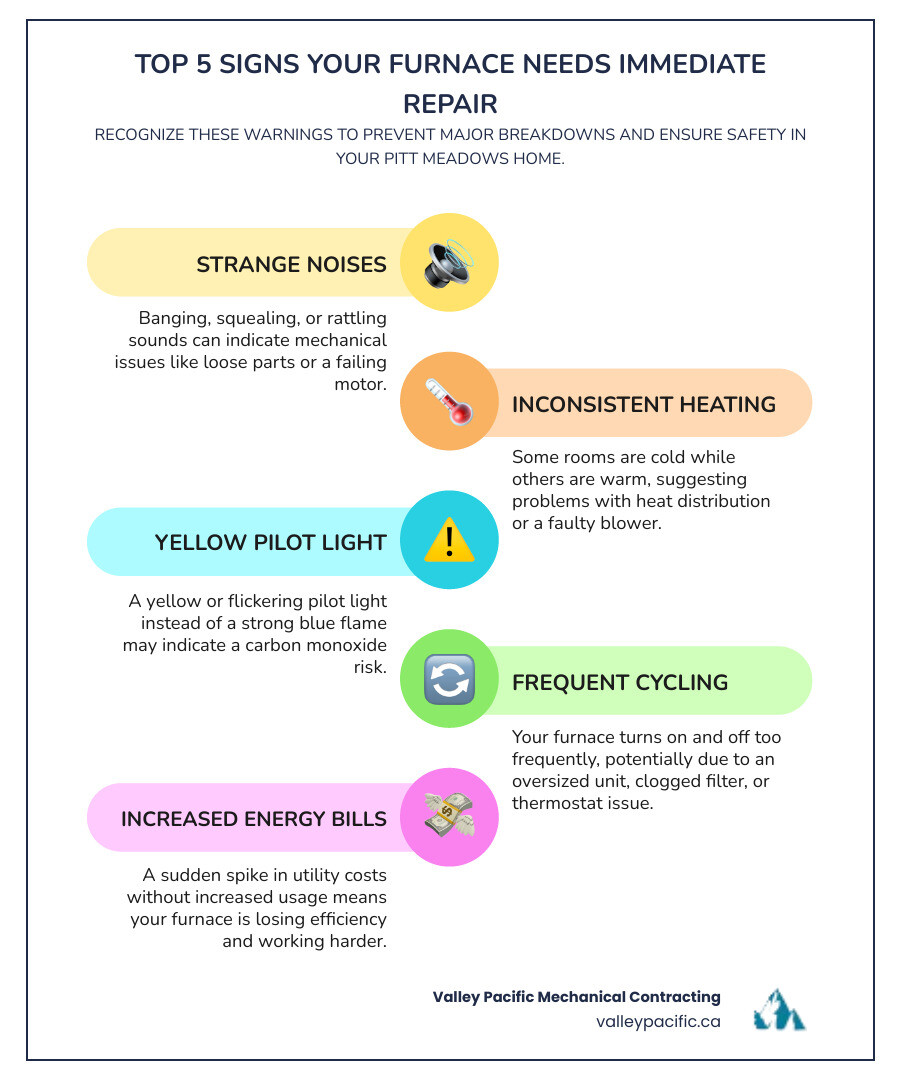
Common Signs Your Furnace Needs Professional Attention
When your furnace starts to falter, it often gives off subtle (or not-so-subtle) clues. Recognizing these common signs early can prevent a minor issue from escalating into a major breakdown, saving you from discomfort and potentially costly repairs. Our team has been providing HVAC solutions in the Pitt Meadows community for years, and with over 30 years of experience across the Lower Mainland, we've seen it all. Here’s what to look out for:
- Inconsistent Heating: Are some rooms toasty while others remain chilly? This uneven heating suggests your furnace isn't distributing warmth effectively. It could be due to issues with the blower motor, ductwork, or even a malfunctioning thermostat.
- Unusual Noises: Furnaces are generally quiet workhorses. If yours starts banging, squealing, rattling, or groaning, it's trying to tell you something. These sounds often point to mechanical problems that require immediate attention. We'll dig deeper into these noises shortly!
- Increased Energy Bills: If your utility bills are suddenly soaring without a change in usage, your furnace is likely working harder than it should to maintain temperature. This inefficiency can be caused by a clogged filter, a faulty thermostat, or other underlying issues. Modern furnaces are highly energy-efficient, using less gas to produce more heat, so a sudden spike is a red flag.
- Poor Air Quality: An aging or malfunctioning furnace can contribute to excessive dust, stale odors, or even a dry, stuffy feeling in your home. This can be particularly problematic for residents with allergies or respiratory sensitivities.
- Thermostat Malfunctions: Your thermostat is the brain of your heating system. If it's not accurately reading temperatures, or if your furnace isn't responding to its commands, it could indicate a problem with the thermostat itself or the communication between it and the furnace.
- Yellow Pilot Light: For gas furnaces, a healthy pilot light should be blue. A flickering yellow or orange flame indicates incomplete combustion, which can produce dangerous carbon monoxide. This is a serious safety hazard and requires immediate professional attention.
- Frequent Cycling (Short Cycling): If your furnace turns on and off frequently in short bursts, it's called short cycling. This is inefficient and puts undue stress on the system, potentially leading to premature wear and tear. It could be caused by a dirty filter, an oversized unit, or a malfunctioning thermostat.
For more insights into keeping your home comfortable, check out our HVAC Services Pitt Meadows Guide. If you're experiencing issues with your cooling system, our team also offers expert AC Repair Pitt Meadows BC.
Strange Noises and What They Mean
Your furnace might be trying to communicate with you through sound! Here's a quick guide to deciphering those unusual noises:
- Banging or Popping: This often occurs when dust and grime accumulate on the burners, causing delayed ignition. When the gas finally ignites, it creates a small "explosion" that results in a banging sound. It could also indicate expanding and contracting ductwork.
- Squealing or Screeching: A high-pitched squeal typically points to a worn-out or loose blower belt, or a failing motor bearing. Ignoring this can lead to further damage to the motor.
- Rattling or Vibrating: Loose panels, a faulty blower motor, or even debris inside the unit can cause rattling. If it's a vibrating sound, it could be an unbalanced blower fan.
- Clicking: While some clicking is normal during startup and shutdown, continuous clicking or clicking that doesn't lead to ignition often indicates a problem with the ignition system, such as a faulty ignitor or flame sensor.
Performance and Efficiency Issues
Beyond strange noises, several performance issues can signal that your furnace is in distress:
- Sudden Spike in Utility Bills: As mentioned, this is a clear sign of inefficiency. Your furnace is consuming more fuel to produce the same (or less) heat, often due to a lack of maintenance or a failing component.
- Uneven Heating or Cold Spots: If your furnace isn't evenly distributing heat, you'll notice some areas of your home are warmer than others. This could be due to ductwork issues, blocked vents, or a problem with the blower fan.
- System Runs Constantly: A furnace that never seems to shut off is likely struggling to reach the set temperature, indicating an underlying problem with its heating capacity or thermostat.
- Furnace Struggles to Start: If your furnace takes multiple attempts to ignite or doesn't start at all, it's a sign of ignition system problems, such as a dirty flame sensor or a faulty ignitor.
Comprehensive Furnace Repair Pitt Meadows BC Services
When your furnace exhibits any of these signs, it's time to call in the professionals. Our team provides a full range of furnace repair pitt meadows bc services to get your system running smoothly and safely again. With over 30 years serving the Lower Mainland, we bring extensive experience to every job, understanding the nuances of heating systems common in Pitt Meadows homes.
Our comprehensive services include:
- Diagnostic Services: We start with a thorough inspection to pinpoint the exact cause of the problem. This includes visual and safety checks, combustion and heat exchange assessment, airflow diagnostics, and verification of controls and thermostats. We leave no stone unturned to ensure we accurately identify the issue.
- Safety Inspections: Your safety is our top priority. We carefully check for potential hazards such as gas leaks (especially with a yellow pilot light), carbon monoxide leaks, and faulty electrical connections.
- Component Repair & Replacement: From faulty ignitors and flame sensors to worn-out blower motors and control boards, our skilled technicians can repair or replace any malfunctioning component. We ensure we have access to a wide range of furnace parts for various brands and ages of furnaces, allowing us to get the job done efficiently.
- Airflow Problems: Issues like clogged filters, blocked return vents, or ductwork leaks can severely restrict airflow, impacting your furnace's efficiency and your home's comfort. We diagnose and resolve these issues to restore proper air circulation.
For all your heating, ventilation, and air conditioning needs, explore our full suite of HVAC Services Pitt Meadows.
Emergency 24/7 Furnace Repair
We understand that furnace breakdowns don't adhere to a 9-to-5 schedule. A sudden loss of heat during a cold Pitt Meadows winter evening can be more than just uncomfortable; it can be a serious health and safety concern. That's why we offer 24/7 emergency services. Our team is always ready to respond when your comfort is on the line, ensuring that your problems are quickly solved. Winter in Metro Vancouver can be cold, and we are here to keep you warm.
Whether it’s a holiday, late at night, or a weekend, our technicians are on call, fully equipped with the tools and parts necessary to get your furnace back up and operating. We prioritize emergency calls, especially when safety hazards like potential carbon monoxide leaks are involved. Our goal is to restore your comfort and peace of mind as quickly and efficiently as possible. For issues with other heating systems, we also provide expert Boiler Repair Pitt Meadows BC.
Common Issues Requiring Furnace Repair in Pitt Meadows BC
From our extensive experience, we've identified several common furnace problems that frequently affect homes in Pitt Meadows:
- Faulty Ignitors: Many modern furnaces use an electronic ignitor instead of a pilot light. If this component fails, your furnace won't be able to start the heating cycle.
- Flame Sensor Cleaning: A dirty flame sensor can't detect the flame, causing the furnace to shut off prematurely as a safety measure. Cleaning this small but crucial part can often resolve intermittent heating issues.
- Blower Motor Issues: The blower motor is responsible for circulating heated air throughout your home. Problems here can lead to poor airflow, unusual noises, or the furnace running constantly.
- Heat Exchanger Inspection: The heat exchanger separates combustion gases from the air you breathe. Cracks or corrosion in this component are extremely dangerous as they can allow carbon monoxide into your home. Regular inspection is vital.
- Clogged Filters: A dirty air filter is one of the most common and easily preventable furnace problems. It restricts airflow, making your furnace work harder, reducing efficiency, and potentially leading to overheating and breakdowns.
Beyond furnaces, we also offer specialized services for heat pump systems. Learn more about our Heat Pump Service Pitt Meadows BC.
The Crucial Role of Regular Furnace Maintenance
Think of furnace maintenance like regular oil changes for your car – it's vital for longevity and performance. Regular furnace maintenance is not just a good idea; it's a necessity for any homeowner in Pitt Meadows. A well-maintained furnace can last up to 20 years, providing reliable heat with regular servicing.
Here's why proactive care is so important:
- Extending Furnace Lifespan: Furnaces typically last 15-20 years. Regular tune-ups keep components in good shape, preventing premature wear and tear and helping your system reach its maximum lifespan.
- Improving Energy Efficiency: A clean, well-adjusted furnace operates more efficiently, using less energy to heat your home. This directly translates to lower energy bills and a reduced carbon footprint.
- Preventing Costly Breakdowns: Many furnace problems start small. Maintenance allows us to identify and address these minor issues before they escalate into major, expensive repairs. It's often cheaper to prevent a problem than to fix it.
- Ensuring Safe Operation: During maintenance, we perform critical safety checks, including inspecting for gas leaks and carbon monoxide emissions. This ensures your furnace isn't just warm, but also safe for your family.
- Maintaining Warranty Validity: Many furnace manufacturers require annual professional maintenance to keep your warranty valid. Skipping tune-ups could void your coverage, leaving you responsible for the full cost of future repairs.
For a deeper dive into maintaining your home's comfort systems, refer to our HVAC Services Pitt Meadows Ultimate Guide.
How the Pitt Meadows Climate Impacts Your Furnace
The local Pitt Meadows climate, with its mild, rainy winters and warm, dry summers, presents unique challenges for heating systems. The higher humidity levels and frequent rain during winter can increase the risk of condensation and corrosion within your furnace components. This dampness can lead to issues like rust on metal parts and the growth of mold or mildew, which can impact both efficiency and indoor air quality.
Seasonal temperature swings mean your furnace might be working harder than in other regions, especially as it cycles on and off more frequently. This puts additional stress on the system. Our local technicians understand these regional factors specific to Pitt Meadows homes, allowing us to tailor our maintenance and repair solutions to best suit your needs and protect your system from the elements.
What a Maintenance Plan Includes
A comprehensive furnace maintenance plan covers all the bases to ensure your system is running optimally and safely:
- System Inspection: A thorough visual inspection of all furnace components for visible damage or wear.
- Filter Replacement: Cleaning or replacing your air filter (we recommend changing it every 1-3 months, depending on usage and household factors).
- Coil Cleaning: Cleaning the indoor coil to ensure efficient heat transfer.
- Safety Control Checks: Verifying the proper operation of all safety controls, including limit switches and flame sensors.
- Lubricating Moving Parts: Applying lubrication to motors and other moving parts to reduce friction and wear.
- Performance Testing: Testing the thermostat, checking gas pressure, and measuring temperature rise to ensure optimal performance.
Regular maintenance helps your furnace achieve its expected lifespan and often improves indoor air quality. Similarly, regular attention to your cooling system can be found with our AC Service Pitt Meadows BC.
Repair or Replace? Making the Right Choice for Your Heating System
This is a question many homeowners in Pitt Meadows face, especially as their furnaces age. Deciding whether to repair your existing furnace or invest in a new one depends on several factors, including its age, the frequency of repairs, and its energy efficiency.
| Factor | Repair | Replace |
|---|---|---|
| Furnace Age | Generally, repair if under 10-12 years old. | Consider replacing if 15 years or older (furnaces last 15-20 years). |
| Repair Frequency | Occasional, minor repairs are acceptable. | Frequent breakdowns or repeated costly repairs. |
| Energy Efficiency | Older models are less efficient, even after repairs. | Modern furnaces are highly energy-efficient, significantly reducing bills. |
| Cost | Less expensive upfront for isolated issues. | Higher upfront cost, but long-term savings on energy and future repairs. |
| Comfort/IAQ | Might not improve existing comfort or air quality issues. | Improved consistent heating, advanced filtration for better air quality. |
Furnaces typically last between 15-20 years. If your furnace is approaching or has exceeded this age, or if you're facing frequent and expensive repairs, it might be more cost-effective in the long run to consider a replacement. Modern furnaces are not only highly energy-efficient, leading to significant reductions in your energy bills and carbon footprint, but they also offer improved indoor air quality with advanced filtration systems and quieter operation than older models. Our team can help you weigh the pros and cons for your specific situation.
If replacement is the best option for your home, our experts are ready to assist with Furnace Installation Pitt Meadows BC.
Factors to Consider for a New Furnace Installation
Choosing a new furnace for your Pitt Meadows home involves more than just picking a brand. It's about finding the right system that meets your family's needs, suits the local climate, and maximizes energy savings. Here’s what we help you consider:
- High-Efficiency Models: Modern furnaces boast impressive AFUE (Annual Fuel Utilization Efficiency) ratings, meaning they convert a higher percentage of fuel into usable heat. This is a game-changer for your energy bills, especially during our damp winters.
- Proper Sizing for Your Home: A furnace that's too large will short cycle, wasting energy and wearing out components faster. One that's too small won't adequately heat your home. We perform precise load calculations to ensure your new furnace is perfectly sized for your property.
- Heat Pump Compatibility: Many homeowners in Pitt Meadows are opting for heat pumps for their energy-efficient heating and cooling capabilities. We can help you integrate a new furnace with a heat pump system, creating a versatile and highly efficient hybrid system. For new heat pump installations, see our Heat Pump Installation Pitt Meadows BC services.
- Ductless Mini-Splits: For additions, renovations, or homes without existing ductwork, ductless mini-splits offer a flexible and efficient alternative for targeted heating and cooling.
- Boiler Systems: While furnaces are common, some homes in Pitt Meadows use boiler systems for radiant heat. If you're considering a boiler, we also offer expert Boiler Installation Pitt Meadows BC.
Choosing the right system can be complex, but we're here to guide you through every step. For more detailed advice, read our blog: How do I choose the right furnace for my home in Pitt Meadows, BC. If you're also considering a new AC unit, our team handles AC Installation Pitt Meadows BC.
Frequently Asked Questions about Furnace Repair
We believe in empowering our customers with knowledge. Here are some common questions we hear about furnace repair pitt meadows bc:
Why is my furnace blowing cold air?
This is a common and frustrating problem. Several factors can cause your furnace to blow cold air:
- Thermostat Settings: Double-check that your thermostat is set to "heat" and not "fan only." Sometimes it's the simplest solution!
- Overheating Safety Switch: If your furnace overheats, a safety switch will trip, causing the burner to shut off while the fan continues to run, blowing cold air. This often happens due to a clogged air filter or blocked vents.
- Clogged Filter Restricting Airflow: A severely clogged air filter can restrict warm air from reaching your living spaces.
- Pilot Light or Ignition Issue: If the pilot light is out (for older models) or the electronic ignitor is failing, the furnace won't produce heat, but the fan might still run.
- Condensate Line Clog: High-efficiency furnaces produce condensate, which drains away. If this line clogs, a safety switch can shut down the furnace.
Our technicians can quickly diagnose the exact cause and provide the necessary furnace repair pitt meadows bc.
How often should I change my furnace filter?
The general recommendation is to change your furnace filter every one to three months. However, several factors can influence this frequency:
- Pet Ownership: Homes with pets often need more frequent filter changes due to increased dander and hair.
- Allergies or Respiratory Issues: If anyone in your household suffers from allergies or asthma, changing the filter more often can significantly improve indoor air quality.
- Home Size and Occupancy: Larger homes or those with more residents might require more frequent changes.
- Construction or Renovation: Nearby construction or recent home renovations can introduce more dust into the air, necessitating quicker filter replacements.
- Filter Type: Some higher-MERV filters are designed to last longer, but always follow the manufacturer's recommendations.
A clean filter is crucial for both your furnace's efficiency and your home's air quality.
Is furnace maintenance really necessary every year?
Yes, annual furnace maintenance is absolutely necessary, especially in a climate like Pitt Meadows. Think of it as an annual check-up for your home's heart of warmth. Here’s why it’s so important:
- Safety Checks for Gas Leaks: Crucial for gas furnaces, maintenance includes checking for any potential gas leaks or carbon monoxide issues, protecting your family from invisible dangers.
- Maximizing Efficiency: Regular tune-ups keep your furnace running at peak efficiency, which means lower energy bills and a smaller carbon footprint.
- Preventing Unexpected Failures: Technicians can spot small problems before they turn into major, expensive breakdowns, often saving you from emergency repairs on the coldest day of the year.
- Extending Equipment Lifespan: Just like a car, regular servicing helps your furnace last longer, delaying the need for a costly replacement.
- Warranty Requirements: Many manufacturers require annual professional maintenance to keep your furnace's warranty valid.
Your Partner for Year-Round Comfort in Pitt Meadows
Maintaining a comfortable and safe home in Pitt Meadows is a priority, and a reliable furnace is at the heart of that comfort. From prompt repairs to proactive maintenance and expert installations, our team is dedicated to providing you with a "headache-free" experience. With over 30 years of expertise serving the Lower Mainland, including Pitt Meadows, we understand the unique needs of our community and are committed to delivering top-notch HVAC services.
Our local technicians are not just skilled; they're part of the community, understanding precisely what Pitt Meadows residents are looking for in their heating solutions. We offer 24/7 emergency services, ensuring that whether your furnace fails in the dead of winter or your AC struggles in the summer heat, we're always just a phone call away, ready to restore your comfort.
For expert Furnace Repair Pitt Meadows BC, contact our team today. We're here to keep your home warm, safe, and comfortable, season after season.
When a Plumbing Crisis Strikes Without Warning
A plumbing emergency service is for urgent situations that threaten your property, health, and peace of mind—like a burst pipe at 2 AM, a sewage backup, or the smell of gas near your water heater. These problems require immediate professional intervention, not a scheduled appointment for next week.
Quick Answer: Do You Need Emergency Plumbing Help Right Now?
Call for emergency service immediately if you experience:
- Burst pipes flooding your home
- Sewage backup creating health hazards
- Gas odors near plumbing fixtures
- No water supply to your entire home
- Major leaks causing visible property damage
- Water heater failure with active leaking
For comprehensive plumbing solutions in the Lower Mainland, explore our full range of plumbing services in Maple Ridge BC, or if you're facing an urgent situation right now, contact our emergency response team.
Plumbing emergencies don't keep business hours. That's why emergency plumbers are available 24/7, 365 days a year, aiming to arrive within 30 minutes to 2 hours. A fast response is critical to minimizing water damage, and the difference between a minor issue and a catastrophe often comes down to how quickly you get professional help.

Identifying a True Plumbing Emergency
A true plumbing emergency service situation is any unexpected problem that poses an immediate threat to your property, compromises your health and safety, or disrupts essential services. The defining characteristic is urgency—a situation that demands a rapid professional response to prevent extensive damage and restore safety.
What constitutes an emergency can also be personal. A single blocked toilet in a one-bathroom home is an emergency for that family. If you have young children and your hot water heater fails in winter, that matters. Anything that's an emergency to you is an emergency to us.

Key Signs You Need Urgent Help
Recognizing a true emergency can save you from catastrophic damage. Here’s what to watch for:
Major water leaks or burst pipes are top-tier emergencies. Uncontrolled water flow causes rapid damage to floors, structures, and belongings, and can lead to mold. Signs include sudden drops in water pressure, the sound of running water when fixtures are off, and spreading water stains. Our guide on Burst Pipe Repair provides more detail.
Sewage backup is a serious health hazard. When wastewater comes up through drains, it contaminates your home with harmful bacteria. This usually indicates a blockage in your main sewer line that needs immediate professional cleaning.
Gas odors require instant action. A 'rotten egg' smell or hissing sound near gas lines indicates a potentially life-threatening leak. Evacuate immediately and get professional help. See our Emergency Gas Leak information for safety protocols.
Complete loss of water supply could signal a major break in your main water line, especially if your neighbors still have water.
Multiple clogged drains or an overflowing toilet often point to a main sewer line blockage that requires immediate attention to prevent flooding and contamination.
Water heater failure with active leaking causes water damage while cutting off your hot water supply. This requires a fast response to prevent property destruction.
Sump pump failure during heavy rain or snowmelt is an emergency that puts your basement at immediate risk of flooding. Our Sump Pump Repair guide has prevention strategies.
When to Call an Emergency Plumber vs. Scheduling Routine Service
Understanding the difference between an urgent and a routine issue can save you stress and money.
You need emergency plumbing service immediately when a situation threatens health, safety, or property—like gas leaks, burst pipes, or sewage backups. Ask yourself: Could waiting make this significantly worse? If the answer is yes, it's an emergency that can't wait for business hours.
You can schedule routine service when the problem is an annoyance, not a threat. A dripping faucet, a single slow-draining sink, or planned maintenance can wait for regular hours. Our Faucet Leak Repair service can address these issues. If a minor problem is causing you anxiety, it's better to call for peace of mind than to risk a larger problem later.
Immediate Steps to Take While Waiting for Help
In a plumbing emergency, the first few minutes are crucial. The steps you take can significantly reduce water damage and keep your family safe while you wait for professional help.
First and foremost, shut off your main water supply. This is the most important step in any water-related emergency. Locate your main water shut-off valve (usually in the basement, crawl space, or a utility closet) and turn it clockwise to stop the flow of water into your home.
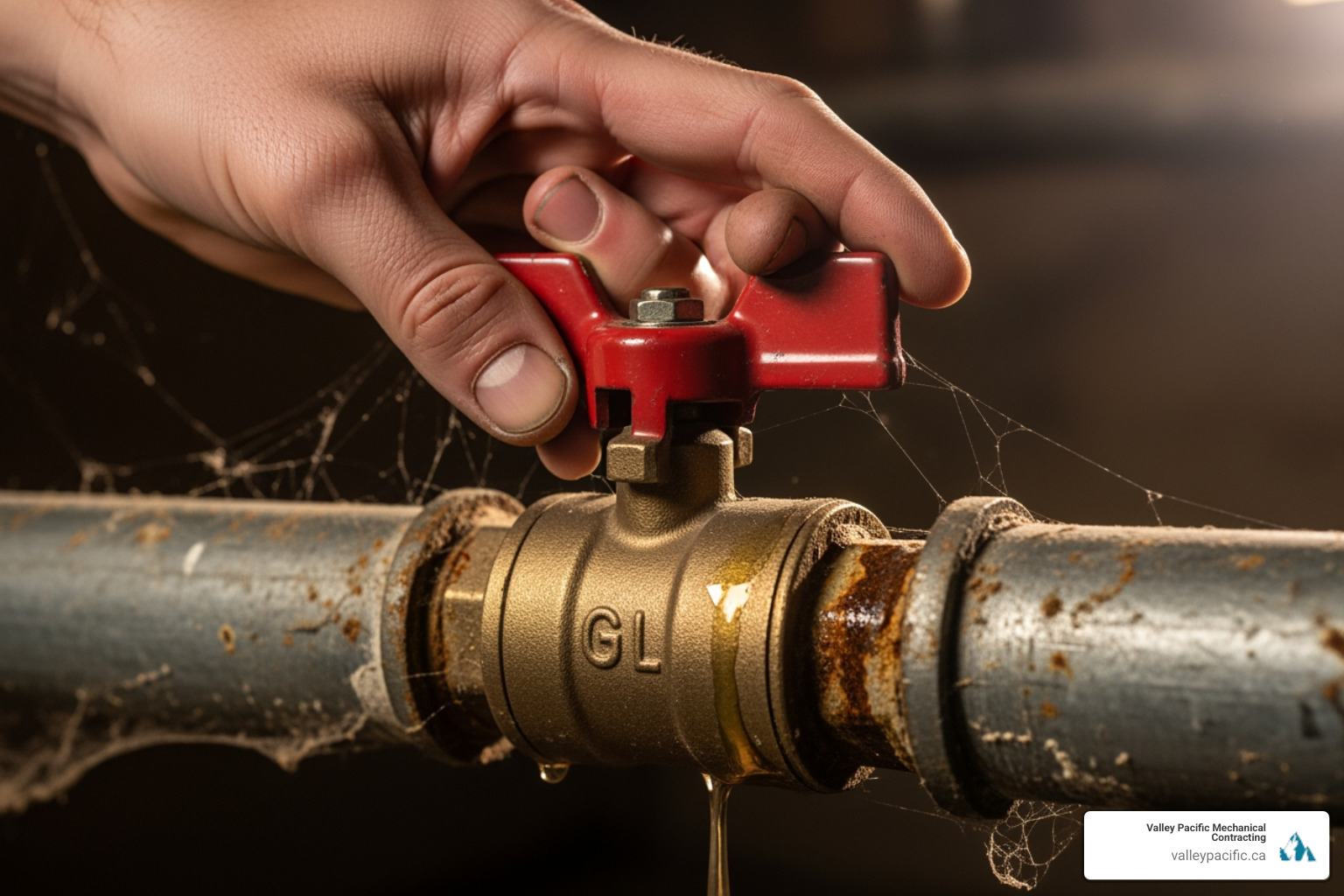
Once the water is off, follow these critical safety steps:
Turn Off Power to the Water Heater: If the leak is from your water heater, shut off its power. For an electric model, flip the corresponding circuit breaker. For a gas model, turn the gas valve to the "off" position.
Ensure Electrical Safety: If water is near electrical outlets or appliances, shut off the power at your main electrical panel immediately to prevent a deadly shock hazard.
Contain the Damage: Use towels, buckets, and a wet/dry vacuum to remove standing water. Move furniture, electronics, and other valuables away from the affected area.
Handle Gas Leaks with Extreme Caution: If you smell gas or hear hissing, evacuate everyone from the house immediately. Do not use phones, light switches, or anything that could create a spark. Once safely outside, call your gas utility company first, then contact our plumbing emergency service. Our Emergency Gas Leak guide has more safety information.
Avoid Using Plumbing: Do not use any toilets, faucets, or drains, as this could worsen the problem or cause more overflow.
When you call our emergency response team, describe the situation clearly. Our representatives can offer specific guidance while you wait for our technician to arrive.
What to Expect from a Professional Plumbing Emergency Service
When you call for a plumbing emergency service, you need a rapid, reliable, and expert response. Our team is available 24 hours a day, 7 days a week, 365 days a year, for residential and commercial clients across the Lower Mainland, including Mission, Maple Ridge, and Langley. We aim to arrive at your door within 30 minutes to two hours.
Our licensed plumbers arrive in fully stocked service vehicles, ready to diagnose and repair most issues on the spot. With over 30 years of experience, we focus on identifying the root cause to provide lasting repairs, ensuring a "headache-free" experience even in the most stressful situations.

Common Issues Handled by a plumbing emergency service
Our emergency team is equipped to handle a full range of plumbing crises:
- Burst Pipe Repair: We quickly locate and perform Burst Pipe Repair to stop flooding and prevent further property damage.
- Sewer Line Blockages: Using sewer cameras and hydro-jetting, we accurately diagnose and clear stubborn sewer line blockages. For damaged lines, we offer minimally invasive Trenchless Pipe Repair.
- Major Leaks: Our team uses specialized equipment to find and fix major leaks, whether visible or hidden, preventing structural damage and mold.
- Gas Line Issues: Our licensed gas fitters provide an immediate response for any Emergency Gas Leak, ensuring your property is safe.
- Water Heater Repair: We repair all types of leaking or malfunctioning water heaters to restore your hot water and prevent water damage.
- Sump Pump Failure: We offer rapid Sump Pump Repair and replacement for failed pumps to protect your basement from flooding.
- Overflowing Toilets & Drains: We use professional equipment to clear overflowing toilets and multiple clogged drains when basic methods fail.
The Benefits of Hiring a Professional vs. DIY Fixes
In a plumbing crisis, DIY fixes often make the problem worse. Hiring a professional is crucial for these reasons:
- Expert Diagnosis: Professionals identify the root cause of the problem, not just the symptom, preventing future issues.
- Specialized Tools: We use tools like sewer cameras and hydro-jetters for effective and efficient repairs.
- Safety: Licensed plumbers are trained to safely handle hazardous situations involving gas, electricity, and contaminated water.
- Prevents Further Damage: A professional repair is done right the first time, preventing the costly secondary damage that often results from failed DIY attempts.
- Guaranteed Workmanship: Our work is guaranteed, giving you peace of mind that the solution is reliable and long-lasting.
- Long-Term Solutions: We provide permanent solutions, not temporary patches that are bound to fail.
- Insurance: Our professional insurance protects you from any liability for accidental damage during the repair.
Questions to Ask Your Emergency Plumber
When you call, asking these key questions ensures you're hiring a reliable professional:
- "Are you available 24/7, including holidays and weekends?" A true emergency service must be available 24/7, 365 days a year.
- "Are your plumbers licensed and insured?" This is non-negotiable. Licensing ensures competence, and insurance protects you from liability.
- "Do you have experience with my specific type of issue?" Confirming they have experience with your specific problem provides extra confidence.
- "What is your estimated arrival time?" A reputable service will provide a realistic ETA, which helps reduce anxiety.
- "Do you offer any guarantees on your work?" A guarantee on workmanship ensures you're getting a lasting solution, not a temporary fix.
Proactive Measures: Preventing Future Plumbing Disasters
The best emergency is one that's prevented. Proactive maintenance can save you from the stress and cost of a plumbing emergency service call. Many crises result from gradual wear and tear that can be addressed ahead of time.

Common Causes of Plumbing Emergencies
Understanding the culprits is your first line of defense:
- Aging Pipes: Older pipes corrode and weaken over time, making them prone to leaks and bursts.
- Freezing Temperatures: Water expands when it freezes, creating immense pressure that can burst pipes, especially in uninsulated areas like crawl spaces or garages.
- Clogged Drains: Grease, hair, and foreign objects can create severe clogs, leading to backups and pressure buildup.
- Tree Root Intrusion: Tree roots can invade underground sewer lines, causing major blockages and pipe damage. A Sewer Line Inspection can detect this.
- High Water Pressure: Water pressure that is too high strains your entire plumbing system, leading to leaks and burst pipes.
- Improper Installations: Faulty installations or poor DIY repairs often create weak points that fail under pressure.
A Homeowner's Prevention Checklist
Follow this checklist to protect your home from plumbing emergencies:
- Schedule Regular Professional Inspections: An annual inspection by a professional can catch potential problems like corrosion or small leaks before they escalate.
- Insulate Pipes in Cold Areas: Insulate pipes in unheated areas like basements, garages, and crawl spaces to prevent them from freezing and bursting.
- Practice Proper Waste Disposal: Avoid pouring grease down drains and only flush human waste and toilet paper. Use drain strainers to catch hair and food scraps.
- Know Your Main Water Shut-Off Valve: Locate your main water shut-off valve and ensure everyone in the house knows how to use it. Test it periodically.
- Monitor Your Water Pressure: Use a pressure gauge to check your water pressure. If it's consistently above 80 psi, a pressure regulator can protect your plumbing.
- Perform Regular Backflow Testing: For applicable systems, our Backflow Prevention Testing service ensures your drinking water remains safe from contamination.
- Be Mindful of Landscaping: If you have large trees, consider a periodic Sewer Line Inspection to check for root intrusion into your sewer line.
Frequently Asked Questions about Emergency Plumbing
During a plumbing crisis, you need clear answers fast. Here are our responses to the most common questions about plumbing emergency service situations:
What is the most important first step in a water-related plumbing emergency?
The absolute first step is to shut off the main water supply to your home. This stops the water flow and minimizes damage. The valve is usually in a basement, crawl space, or utility closet. Turn it clockwise to close. Knowing its location before an emergency is critical.
Can a clogged toilet be considered an emergency?
Yes, a clogged toilet is an emergency if it's overflowing and causing water damage, if it's the only toilet in the home, or if it's a sign of a main sewer line blockage (indicated by multiple backed-up drains). If it's a simple clog in a home with other working toilets, it can likely wait for a routine appointment.
Are emergency plumbing services available on holidays and weekends?
Yes. True plumbing emergency service providers operate 24/7, 365 days a year, because disasters can happen at any time. Our team is always on call—including nights, weekends, and holidays—to serve Mission, Maple Ridge, Langley, and the surrounding Lower Mainland. When you need help, you can contact our emergency response team any time, day or night, and we'll be there.
Your Partner for Urgent Plumbing Needs
When a plumbing crisis strikes, you need a reliable partner who understands the urgency. At Valley Pacific Mechanical Contracting, we combine over 30 years of technical expertise with the reassurance and clear communication you need in a stressful moment.
Our licensed team is available 24/7/365 across Mission, Maple Ridge, Langley, and Pitt Meadows. For everything from burst pipes and gas leaks to overflowing toilets and water heater failures, we respond quickly with fully stocked trucks to resolve the issue efficiently, often in a single visit.
We are committed to a "headache-free" experience and the Daikin Comfort Promise, delivering lasting solutions that restore your plumbing and your peace of mind. We fix problems right the first time.
In a plumbing emergency, quick action is key. For urgent help or to learn about our Plumbing Services in Maple Ridge BC, Contact Us anytime. For total home comfort, ask about our heat pump installation services. We're here to bring you peace of mind, one expertly fixed pipe at a time.
Why Commercial Plumbing Services Matter for Your Business
Commercial plumbing services are essential for reliable water, safe drainage, and code compliance in high-use environments. In any Maple Ridge, BC business—from restaurants to offices—plumbing infrastructure works harder than residential systems, handling more fixtures, higher demand, and stricter regulations. A plumbing failure means downtime, lost revenue, unhappy customers, and potential health code violations.
What commercial plumbing services include:
- Installation of industrial-grade fixtures and water lines
- Routine maintenance and inspections
- Emergency repairs for leaks, clogs, and backups
- Drain and sewer cleaning
- Water heater and boiler servicing
- Backflow prevention testing
- Gas line installation and repair
- Pipe replacement and rehabilitation
For comprehensive mechanical solutions, explore our commercial services, or contact us to discuss your specific needs.
Commercial systems handle constant use from hundreds of people daily. A clogged drain or leaking pipe can halt operations and create safety hazards. That's why businesses need specialized plumbers who understand complex commercial infrastructure and municipal codes.
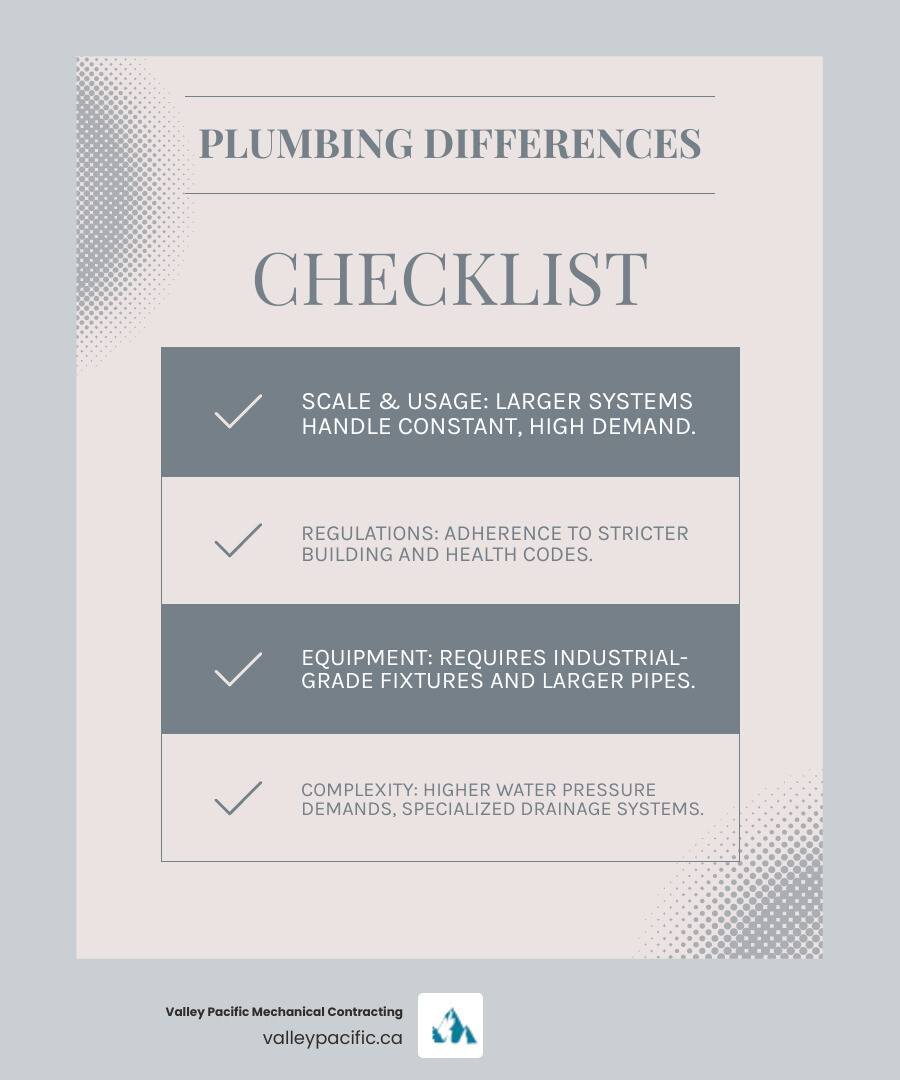
Similar topics to commercial plumbing services:
Understanding the Scope of Commercial Plumbing Services
Commercial plumbing systems in Langley and Maple Ridge are the unsung heroes that keep businesses running. They are vastly different from residential systems. Commercial plumbing services encompass everything needed to keep water flowing safely in high-demand environments.
Commercial plumbing is defined by its system complexity, with intricate pipe networks serving dozens of fixtures across multiple floors. The water demand can overwhelm residential systems; a single office building may have more toilets than an entire residential street. This higher water demand requires a different approach. Hotels and restaurants need industrial-grade fixtures built to withstand constant use, unlike typical home fixtures.
Commercial properties must also meet stricter building codes to protect public health and safety. These regulations cover everything from water temperature to backflow prevention. Our team specializes in navigating these requirements to ensure your business stays compliant. Learn more about our comprehensive commercial solutions.
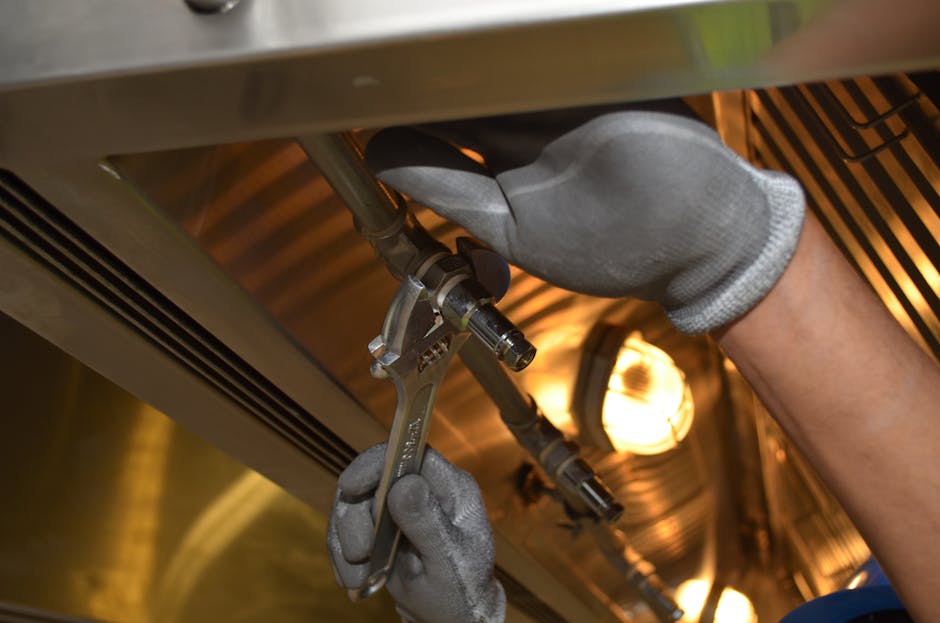
Key Differences: Commercial vs. Residential Plumbing
Here's what makes commercial plumbing a specialized field.
System size: Commercial buildings have extensive, multi-story pipe networks, while residential systems are simpler and serve a single family.
Fixture durability: Fixtures like toilets and sinks are engineered for constant use, efficiency, and health code requirements, making them far more durable than residential models.
Pipe diameter: Commercial buildings use larger diameter pipes (one-inch or more) to handle greater water volume, compared to the smaller pipes found in homes.
Water pressure demands: Higher water pressure is needed to serve multiple floors, requiring powerful pumps and pressure regulation systems for consistent flow.
Drainage systems: These are more complex, often including grease traps for restaurants, specialized industrial waste disposal, and extensive storm drainage.
Code compliance: Adherence to stringent building, health, and safety codes is a legal requirement. Non-compliance can lead to fines and shutdowns, making professional expertise essential.
Common Types of Commercial Plumbing Services
Comprehensive commercial plumbing services cover a wide range of needs for businesses in Mission, Maple Ridge, Langley, or Pitt Meadows:
Installation: Designing and installing complete plumbing systems for new construction or renovations, ensuring code compliance and efficiency.
Repair: Addressing all issues from minor leaks to major failures. Quick response is critical to minimize costly downtime.
Maintenance: Preventative care and regular inspections to catch small problems early and avoid business-disrupting emergencies.
Drain and sewer services: Handling routine drain cleaning, hydro-jetting, and advanced sewer line inspection to manage common clogs.
Water heater services: Installing, repairing, and maintaining commercial-grade water heaters and boilers to ensure a constant hot water supply.
Backflow prevention testing: This is a legally required service to protect the public water supply from contamination. We install, test, and certify these critical safety devices.
Gas line installation: Safely installing and repairing gas lines for businesses that rely on natural gas.
Mechanical installations: Integrating heating, ventilation, and air conditioning with plumbing for complete building systems.
Pipe replacement: Addressing aging or corroded piping before it fails, using modern techniques like trenchless pipe repair to minimize disruption.
Our 24/7 availability means we're there when you need us most, as plumbing emergencies don't wait for business hours.
Common Plumbing Challenges in Commercial Buildings
Plumbing issues in a commercial setting are more than inconvenient—they can be devastating. A single failure can cause business downtime, revenue loss, property damage, and health risks, making professional commercial plumbing services critical. Imagine a kitchen sink backing up in your Mission restaurant or a ceiling leak in your Langley office. These are common realities for businesses that lack proper plumbing maintenance.
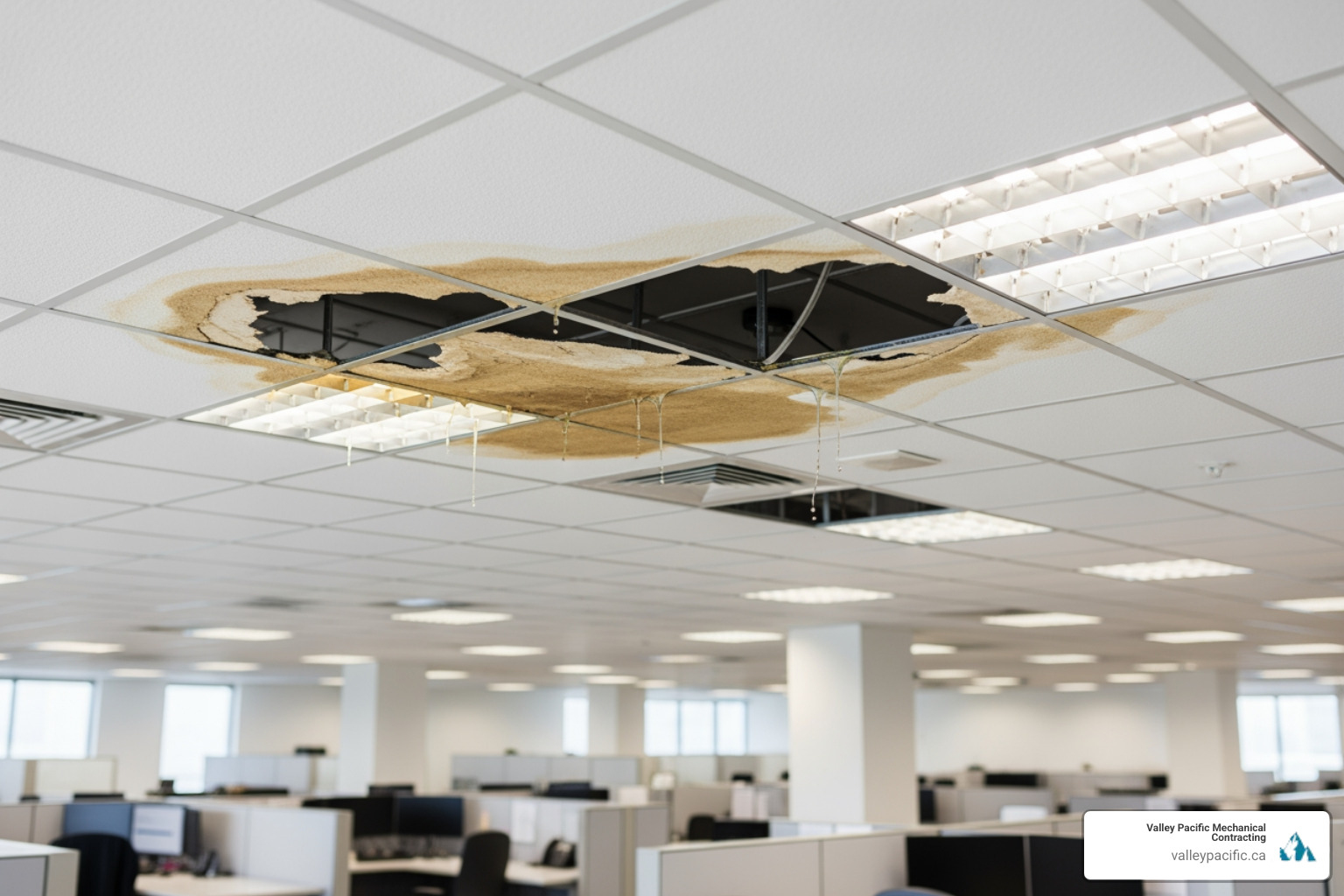
Top Plumbing Problems for Businesses
Commercial properties face more frequent and severe plumbing issues due to the sheer volume of daily use.
Clogged drains are the most common issue. Grease in restaurants and foreign objects in public restrooms cause slow drains that escalate to complete blockages, foul odors, and operational shutdowns.
Sewer line backups occur when the main line is clogged or damaged, causing hazardous sewage to back up into your building. This requires immediate professional intervention and sewer line inspection to diagnose.
Silent leaks are slow drips behind walls or under floors that go undetected for months. They waste water and cause extensive structural damage before they are noticed. Catching a simple faucet leak repair early can save you from major headaches.
Low water pressure can seriously impact business operations. It can be caused by corroded pipes, leaks, or faulty pressure regulators.
Water heater failure can halt business for restaurants, hotels, and laundromats. Commercial units are complex and require specialized knowledge for repair and maintenance.
Burst pipe repair requires immediate emergency response. A burst pipe can flood a property in minutes, causing catastrophic damage. If your building has old Poly B piping, you should consider whether to replace your Poly B piping before it's an emergency.
Proactive Prevention Strategies
Most commercial plumbing disasters are preventable with a proactive approach.
Regular drain cleaning should be scheduled based on business type. Restaurants in Maple Ridge need it more often than offices. This preventative step removes buildup before it causes a blockage.
Proper waste disposal is essential, especially in food service. Staff should know what can go down drains. Proper grease trap maintenance is often a code requirement.
Employee training makes your staff the first line of defense. They can spot early warning signs like slow drains or odd odors, and proper fixture use training reduces wear and tear.
Fixture upgrades to durable, commercial-grade options pay for themselves. Water-efficient and touchless fixtures cut utility costs and reduce wear, lasting longer in high-traffic environments.
Routine inspections are your most powerful prevention tool. We recommend biannual inspections for most properties, or quarterly for high-traffic businesses in Mission or Langley. This allows us to spot issues like leaks, corrosion, and clogs before they fail, often using sewer line inspection technology.
The Importance of Professional Maintenance and Emergency Readiness
Imagine a plumbing failure on your busiest day—a flooded kitchen or a backed-up restroom. These situations halt business, leading to lost revenue, frustrated customers, and safety hazards. This is why professional maintenance and emergency readiness are necessities, not luxuries. Your plumbing system is foundational; if it fails, your business can come crashing down. Regular care protects your investment, ensures operations continue, and maintains code compliance. Our team provides comprehensive plumbing services in Maple Ridge BC and the Lower Mainland because your business can't afford to wait.
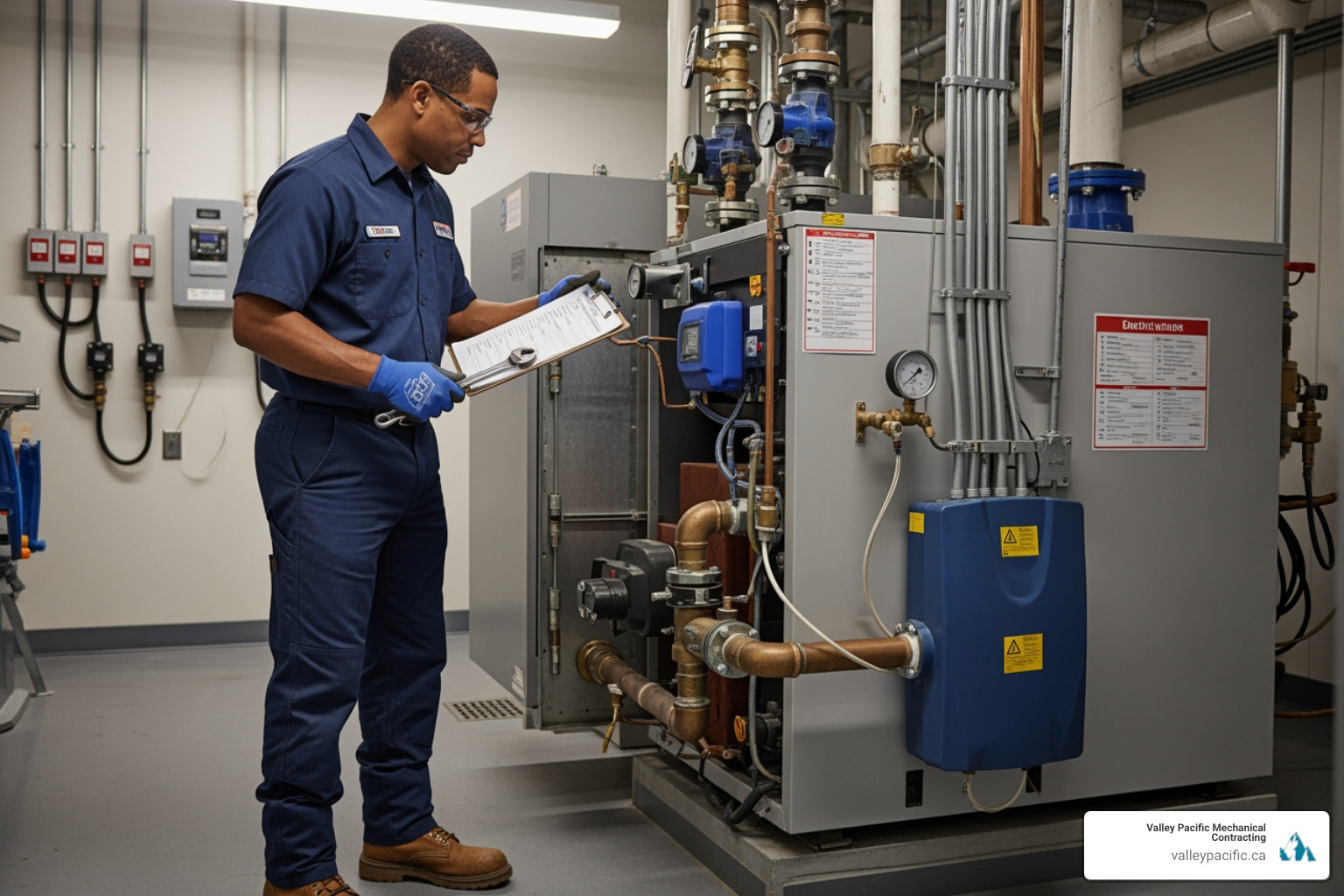
Benefits of a Regular Maintenance Plan
Most major plumbing disasters give warning signs weeks or months in advance. A regular maintenance plan for your commercial plumbing services acts as a safety net, allowing technicians to hunt for those warning signs before they escalate.
- Preventing emergencies: Regular maintenance dramatically reduces the risk of after-hours emergencies that force you to close your doors. It's one of the smartest investments for your business.
- Extending equipment lifespan: Consistent professional care extends the life of significant investments like commercial water heaters and boilers, helping them last years longer than expected.
- Improving efficiency: A well-maintained system is more efficient, leading to lower water and energy bills. Fixing minor issues like hidden leaks prevents significant waste and cost.
- Ensuring compliance: Regular maintenance ensures your property in Langley, Mission, or Maple Ridge meets strict health and building codes, helping you avoid fines and shutdowns. Explore our services to see how we keep businesses compliant.
- Providing peace of mind: Knowing your plumbing is professionally maintained allows you to focus on running your business instead of worrying about potential emergencies.
What to Do in a Commercial Plumbing Emergency
Despite prevention, emergencies can happen. When disaster strikes, stay calm and act quickly.
1. Shut off the main water supply. Know where the main water shutoff valve is and turn it off immediately. This is the first step to prevent flooding and extensive water damage.
2. Contact a 24/7 professional plumber right away. Call a 24/7 professional plumber immediately. Commercial emergencies require specialized expertise and equipment. Our team is available around the clock.
3. Notify your staff and building occupants. Clearly communicate the situation to staff and occupants. Direct people away from affected areas, especially if there is standing water, and inform them about restroom availability.
4. Document the damage. Safely take photos or videos of the damage for insurance claims. Document the source, the extent of the damage, and any affected inventory. Prioritize safety above all.
5. Keep safety as your top priority. Prioritize safety. Avoid wet areas with electrical equipment, be cautious of slippery floors, and stay clear of any potential sewage contamination, as it is a serious health hazard.
An emergency plan is crucial. Ensure multiple staff members know the shutoff valve location, have our emergency number saved, and understand these basic steps. Preparation saves money and reduces stress.
Choosing the Right Partner for Your Commercial Plumbing Needs
When plumbing problems strike, you need a trusted partner who understands commercial systems. The right commercial plumbing services provider acts as an extension of your team, protecting your investment and reputation. Choosing a commercial plumber is a high-stakes decision, as poor service can lead to lost revenue and safety violations. For businesses in the Lower Mainland, our commercial project services Maple Ridge BC are built on partnership and trust.
Look for these key qualities in a commercial plumber:
- Experience: You need a team with experience in commercial and industrial systems. Our team brings over 30 years of expertise to every project.
- Licensing and Insurance: This is non-negotiable. A fully licensed and insured company protects you from liability and ensures all work meets provincial standards.
- 24/7 Availability: This is crucial for minimizing downtime. Plumbing emergencies don't keep business hours, so your plumber shouldn't either. We offer 24/7 service to handle unexpected issues promptly.
- Customer Reviews: A strong reputation is built on reliability and quality work. Check reviews and references from other commercial clients to gauge a provider's suitability for your industry.
- Range of Services: A partner who handles everything from maintenance to emergency repairs simplifies your operations with a single, trusted point of contact.
- Transparent Communication: A great plumber explains issues clearly, outlines options honestly, and keeps you informed, helping you make smart decisions for your business.
- Modern Technology: Advanced tools like video inspection cameras and hydro-jetting equipment lead to more accurate diagnostics, less invasive repairs, and faster solutions.
- Local Knowledge: A plumber familiar with local codes and regional issues can steer regulations efficiently and provide relevant solutions.
Emerging Trends in Commercial Plumbing
Staying current with new technologies can give your business an advantage.
Touchless fixtures are now standard for improving hygiene and reducing water waste in high-traffic restrooms. Sensor-activated faucets, flush valves, and soap dispensers are especially important in restaurants and healthcare facilities.
Smart leak detection systems are a valuable innovation. These sensors monitor your system in real-time, sending immediate alerts for leaks or unusual flow patterns. This allows you to prevent serious damage and water waste.
Water conservation technology saves money and helps the environment. Low-flow fixtures, high-efficiency water heaters, and smart irrigation systems reduce utility bills and often pay for themselves over time.
Trenchless pipe repair revolutionizes underground pipe repair. Methods like pipe lining allow for repairs with minimal excavation, reducing business disruption, project time, and restoration costs.
Eco-friendly solutions are gaining momentum. Options like microbial drain cleaners and sustainable materials help businesses reduce their environmental impact and meet green building certification requirements.
Frequently Asked Questions about Commercial Plumbing
We understand business owners in Mission, Langley, and Maple Ridge have questions about their plumbing. Here are answers to some of the most common ones.
How often should a commercial plumbing system be inspected?
For most commercial buildings, we recommend professional inspections at least twice a year. This helps identify wear, potential leaks, and clogs before they disrupt your business.
High-traffic businesses like restaurants, hotels, or healthcare facilities have greater plumbing demands and benefit from more frequent inspections, such as quarterly check-ups. Restaurants especially need attention due to grease buildup. This preventative investment helps avoid emergencies, extends equipment life, ensures code compliance, and keeps your business running smoothly.
Why is backflow prevention so important for businesses?
Backflow prevention protects the public drinking water from contamination and is mandatory under municipal codes in the Lower Mainland. Backflow is the reversal of water flow in your pipes, which can allow contaminated water from your property to enter the clean public supply. It's often caused by sudden pressure changes.
The risk is higher for commercial properties due to industrial appliances, chemical processes, or irrigation systems. Proper backflow prevention testing is a legal requirement to protect public health.
We install, test, and certify backflow prevention devices to ensure your business stays compliant and the community stays safe. If you're unsure about your current backflow prevention status or need to schedule your annual testing, contact us and we'll make sure everything is up to code.
What are signs my commercial plumbing needs immediate attention?
Your plumbing system often gives warning signs before a major failure. Recognizing these red flags can save you from costly repairs. Call a professional immediately if you notice any of the following issues.
- Unusual odors: Foul smells from drains are not normal and often indicate sewer line or grease trap issues. These smells signal a worsening problem.
- Gurgling sounds: Noises from drains or toilets indicate trapped air from a blockage or venting issue. Your system is struggling to drain properly.
- Water stains: Stains on ceilings, walls, or floors are clear signs of a leak. Even small stains can point to significant hidden damage and potential mold growth.
- Low water pressure: A sudden or gradual drop in pressure suggests blockages, hidden leaks, or a main supply line problem, all of which can impact your operations.
- Frequent clogs or slow drains: This may indicate a main sewer line obstruction that requires professional attention before it causes a complete backup.
- Unexplained increase in water costs: This almost always points to a hidden leak that can waste thousands of gallons and increase your bills significantly.
Trust your instincts. If something seems off with your commercial plumbing services, it probably is. Early intervention prevents minor issues from becoming major, business-halting headaches.
Conclusion
Your commercial plumbing system is the backbone of your business, crucial for smooth operations, health, and safety. Investing in professional commercial plumbing services is a smart move for your business's protection, efficiency, and the safety of your staff and customers.
The right plumbing partner makes all the difference, from complex installations to 2 a.m. emergencies. A reliable team works proactively to prevent problems, saving you money, stress, and downtime.
At Valley Pacific Mechanical Contracting, we've spent over 30 years providing a "headache-free" experience for businesses in Mission, Maple Ridge, Langley, and Pitt Meadows. We know you can't afford downtime, which is why we're available 24/7. We bring dedication and expertise to every job, from routine maintenance to complete overhauls.
Don't wait until a minor issue becomes a major crisis. Let us be your proactive partner in maintaining a safe, efficient, and code-compliant commercial environment. Your plumbing system deserves professional attention, and your business deserves peace of mind.
Ready to protect your business and keep everything running smoothly? Request a quote today and experience the Valley Pacific difference. And while you're planning for your building's needs, don't forget to explore our expert heat pump services in Langley, BC for comprehensive mechanical support that goes beyond plumbing.
Why Reliable Home Heating Matters in Langley's Climate
Boiler installation Langley homeowners trust starts with understanding your heating needs. Langley's damp, cool winters demand a heating system that delivers consistent warmth without driving up energy bills or breaking down when you need it most. If your current boiler is over 15 years old, struggles to heat your home evenly, or requires frequent repairs, it's likely time for a professional replacement. Modern high-efficiency boilers can reduce your energy costs by 20-30%, provide more reliable heat, and lower your carbon footprint—all while lasting 15-20 years with proper maintenance.
Quick Guide to Boiler Installation in Langley:
- Best Boiler Types: Combi boilers for smaller homes, system boilers for multiple bathrooms, conventional boilers for larger properties
- Key Installation Steps: Home assessment, old system removal, professional installation with proper venting, permits and inspections, system flush and testing
- Timeline: Most installations complete in 1-2 days
- Efficiency Ratings: Look for AFUE ratings of 90% or higher
- Maintenance: Annual professional servicing recommended
For expert guidance on your heating system, explore our HVAC services in Langley, or request a quote for professional boiler installation today.
This guide walks you through everything you need to know about boiler installation in Langley—from recognizing when it's time to replace your existing system to choosing the right boiler type, understanding the professional installation process, and ensuring your new system operates efficiently for years to come.
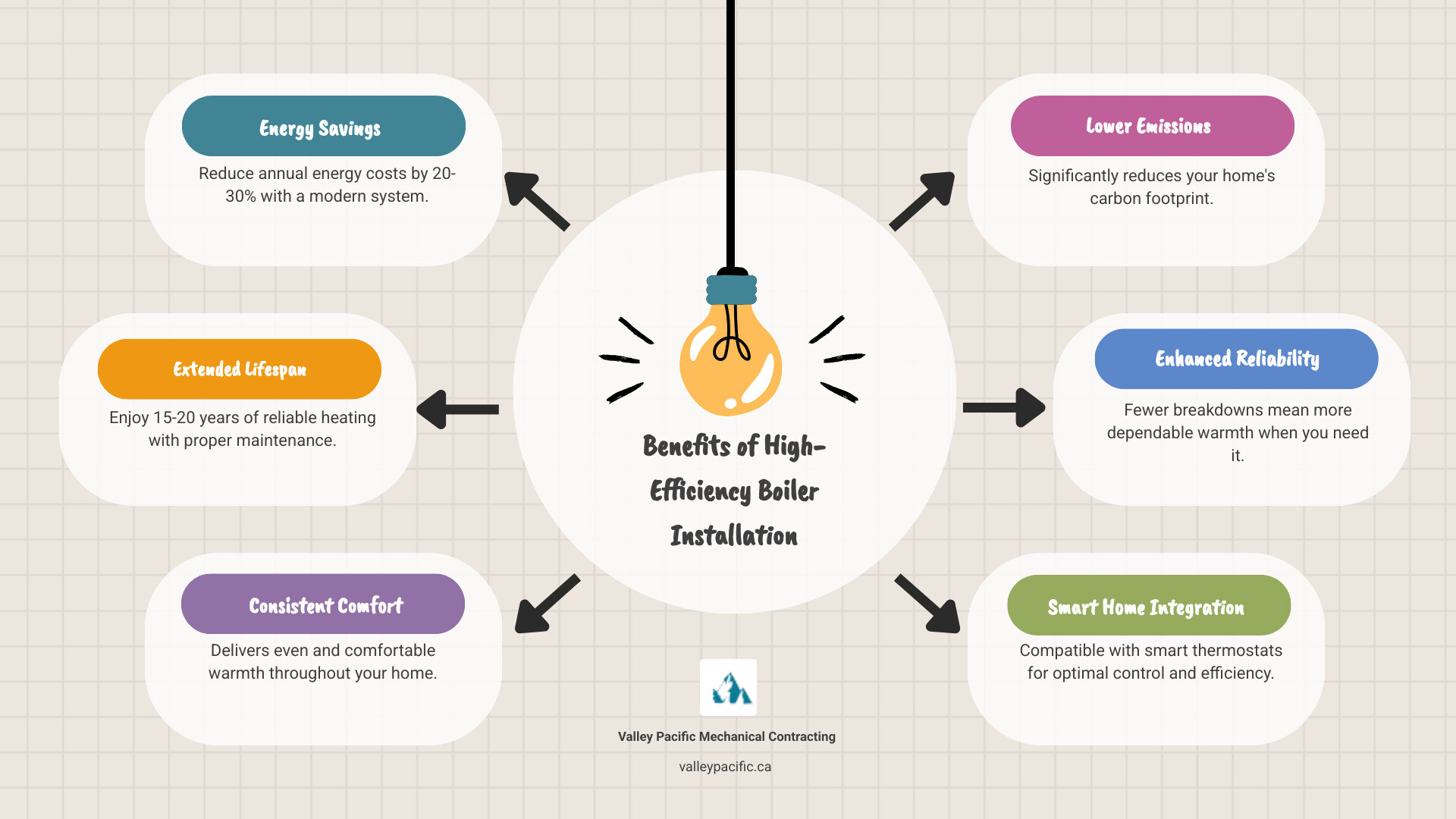
Relevant articles related to Boiler installation Langley:
Is It Time for a New Boiler? Key Signs to Watch For
Nobody wants to think about replacing their boiler until it stops working on the coldest night of the year. But here's the thing—your boiler usually gives you plenty of warning signs before it gives up completely. Learning to recognize these signals early can save you from shivering under blankets at 2 AM, waiting for emergency service.
The truth is, there comes a point in every boiler's life when replacement makes more sense than another repair. It's not always an easy decision, but understanding what to look for can help you make the right call before you're forced into an emergency situation.

Signs Your Boiler Needs Replacement
Think of your boiler like a car. After about 15 years of loyal service, things start to wear out. Parts that used to work perfectly begin to struggle. Efficiency drops. And suddenly, you're spending more money to get less heat.
Age is often the first indicator. If your boiler is pushing past the 15-year mark, it's entered its senior years. Even with excellent maintenance, boilers typically last between 15 and 20 years. After that, the decline accelerates. Components wear out, seals deteriorate, and efficiency plummets.
But age isn't the only factor. Rising energy bills often signal a struggling boiler long before it completely fails. When your boiler loses efficiency, it works harder and runs longer to heat your home to the same temperature. You might not notice the difference in performance right away, but you'll definitely notice it in your monthly bills. Modern high-efficiency boilers can cut your heating costs by 20-30%, which means an old, inefficient unit is costing you significantly more every month.
Frequent repairs are another red flag. If you're calling for service several times a year, those repair bills add up quickly. At some point, you're essentially making payments on a new boiler while still using the old one. When repair costs start approaching half the price of a new unit, replacement usually makes better financial sense. Our Boiler Repair Langley Guide can help you understand when repair versus replacement makes the most sense.
Uneven heating throughout your home means your boiler is struggling to distribute warmth effectively. Some rooms feel toasty while others stay stubbornly cold. Radiators heat unevenly or take forever to warm up. This isn't just uncomfortable—it's a sign your boiler can't keep up with your home's heating demands anymore.
Finally, unusual noises deserve your attention. Yes, boilers make some noise during normal operation. But loud banging, persistent whistling, or gurgling sounds indicate internal problems. These noises often point to mineral buildup (called kettling), failing pumps, or deteriorating components.
Common Boiler Problems That Signal a Need for Service
Not every boiler issue means you need a full replacement. Sometimes your system just needs professional attention to get back on track. But even seemingly minor problems can snowball into major headaches if you ignore them.
Water leaks around your boiler should never be dismissed as "just a small drip." Any moisture means something's wrong—whether it's a faulty pressure relief valve, corroded pipes, or a failing seal. Water and heating systems don't mix well, and leaks can cause serious damage to your home and your boiler. If you spot water, our guide on what to do when your boiler is leaking water walks you through the immediate steps.
Pressure problems are incredibly common but shouldn't be ignored. Your boiler needs to maintain the right pressure to heat efficiently. If the pressure gauge keeps dropping, you likely have a leak somewhere in the system or a problem with the expansion vessel. Low pressure means poor heating performance and higher energy bills. Check out our resource on what to do when boiler pressure drops for practical solutions.
No hot water is one of those problems that gets your immediate attention—especially during a cold Langley winter. This frustrating issue could stem from a faulty thermostat, a broken diverter valve, or problems with the heating element. Our troubleshooting guide for no hot water from boiler can help you identify the cause.
Strange noises beyond normal operation deserve investigation. While some sounds are typical, persistent banging, high-pitched whistling, or constant gurgling indicate specific problems. These noises often signal mineral buildup on the heat exchanger, air trapped in the system, or a pump that's on its last legs.
Pilot light issues matter more than you might think. Your pilot light should burn a steady blue flame. If it keeps going out, burns yellow or orange, or flickers constantly, something's wrong with the thermocouple, gas supply, or ventilation. These aren't just performance issues—they're potential safety concerns. Learn more about addressing boiler pilot light problems properly.
The key is catching these problems early. Our technicians have spent 30+ years working with every type of boiler imaginable, from older conventional systems to the latest high-efficiency models. We know what to look for, how to fix it right, and when it makes more sense to recommend boiler installation in Langley rather than another repair. When you work with Valley Pacific Mechanical Contracting, you get honest advice based on what's actually best for your home and your budget—not what's easiest for us.
Choosing the Right Boiler for Your Langley Home
Selecting the perfect boiler for your home is a crucial decision that impacts your comfort, energy bills, and environmental footprint for years to come. With our 30+ years of expertise, we're here to guide you through the options, ensuring you get a headache-free experience.
The good news? Modern boilers are more efficient and reliable than ever. The challenge? Figuring out which type suits your specific needs. Let's break down your options in plain English.
Types of Boilers Explained
Boiler systems are getting more advanced as technology develops, with more electronics placed inside to monitor operation. Understanding the main types available will help you make an informed choice for your boiler installation Langley project.
Combi boilers (short for combination boilers) are the compact champions of the boiler world. They heat water directly from your mains supply whenever you turn on a tap or radiator, eliminating the need for a separate hot water storage tank. This makes them ideal for smaller homes, apartments, or properties with limited space. If you have one or two bathrooms and don't need multiple taps running hot water simultaneously, a combi boiler could be your perfect match. They're energy-efficient because they only heat water when you need it—no energy wasted keeping a tank warm all day.
System boilers work with a separate hot water storage cylinder, making them better suited for homes with higher hot water demands. If your family includes multiple people who shower in the morning, or you have two or more bathrooms that get used at the same time, a system boiler ensures everyone gets hot water without pressure drops or temperature fluctuations. The stored hot water means you can run multiple taps and showers simultaneously without any issues. These systems are also compatible with solar thermal panels if you're thinking about renewable energy down the road.
Conventional boilers (also called regular or traditional boilers) are the workhorses for larger properties. They require both a hot water cylinder and a cold water storage tank, typically installed in your loft or attic. If you live in a larger home with multiple bathrooms and high simultaneous hot water demands, a conventional boiler provides the capacity you need. They're also the best choice if you have an older heating system with a traditional radiator setup, as they work seamlessly with existing pipework. For more details on how different boiler systems operate, visit our guide on boiler heating systems.
| Boiler Type | Best For | Key Benefits |
|---|---|---|
| Combi | Small to medium homes, 1-2 bathrooms, limited space | No storage tank needed, instant hot water, space-saving, energy-efficient |
| System | Medium to large homes, 2-3 bathrooms, multiple users | Handles multiple taps simultaneously, works with solar panels, reliable hot water supply |
| Conventional | Large homes, 3+ bathrooms, existing traditional systems | Highest capacity, compatible with older radiator systems, excellent for high demand |
Sizing and Energy Efficiency
Getting the right boiler size isn't about physical dimensions—it's about heating capacity measured in kilowatts (kW). This is where many homeowners make costly mistakes. A boiler that's too small will struggle to heat your home properly, running constantly and wearing out prematurely. One that's too large wastes energy and cycles on and off inefficiently, also shortening its lifespan.
Proper boiler sizing requires professional load calculations that factor in your home's square footage, insulation quality, number of radiators, hot water usage patterns, and even Langley's specific climate conditions. Our technicians perform these assessments during your consultation to ensure your new boiler is perfectly matched to your needs.
When evaluating efficiency, look for the AFUE rating (Annual Fuel Utilization Efficiency). This percentage tells you how much of the fuel your boiler uses actually goes toward heating your home versus being lost through exhaust. Modern high-efficiency boilers typically have AFUE ratings of 90% or higher, with some condensing models reaching 95-98%. Compare that to older boilers that might only achieve 60-70% efficiency, and you can see why upgrading makes such a difference.
High-efficiency models cost more upfront, but the math works in your favor quickly. A boiler with a 95% AFUE rating versus an old 70% model means you're getting 25% more heat from the same amount of fuel. Over a Langley winter, those savings add up month after month, year after year. Most homeowners see the investment pay for itself within 5-8 years through reduced energy bills alone.
Beyond your wallet, there are environmental benefits to consider. High-efficiency boilers produce fewer greenhouse gas emissions because they extract more heat from the fuel they burn. If sustainability matters to you, upgrading to a modern boiler is one of the most impactful home improvements you can make. Some newer models also qualify for utility rebates, putting even more money back in your pocket while reducing your carbon footprint.
The right boiler choice depends on your unique situation—your home's size, your family's hot water needs, your existing system, and your budget. That's why we always start with a thorough consultation to understand your specific circumstances before recommending a solution. No cookie-cutter approaches, just honest guidance backed by three decades of experience keeping Langley homes comfortable.
Your Guide to a Warm and Comfortable Coquitlam Home
Furnace installation coquitlam is essential for keeping your home comfortable through our damp, chilly winters. When your furnace falters, you need reliable heating fast. Coquitlam's climate demands a properly sized, high-efficiency furnace that can handle cold nights and help manage moisture. Whether you're replacing an aging unit or upgrading for better efficiency, professional installation is key to ensuring safety, reliability, and performance.
If your furnace is over 15 years old, requires frequent repairs, or seems to be working harder than ever, replacement is likely your best choice. A modern, properly installed furnace keeps every room comfortable, operates safely, and provides cleaner indoor air for your family. For expert guidance on all your heating needs, explore our HVAC services, or get started with a free consultation today.
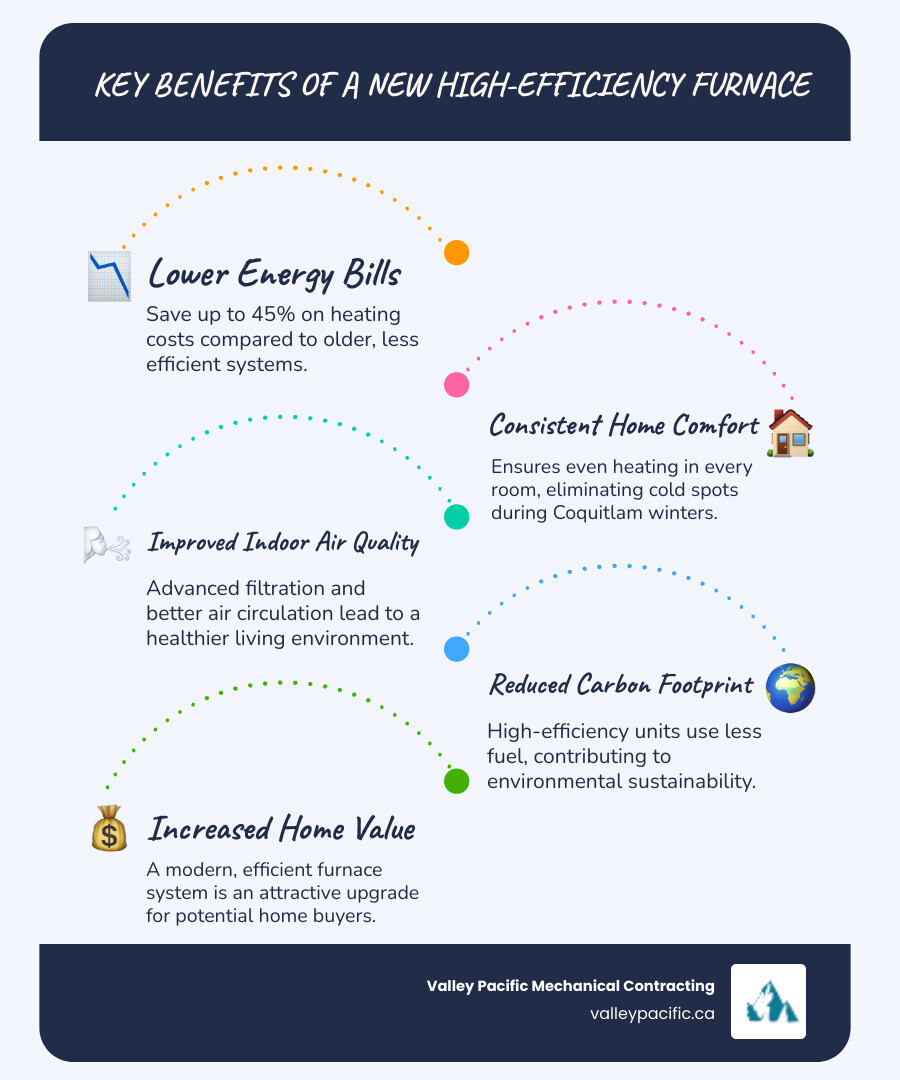
Related content about furnace installation coquitlam:
Is It Time for a Furnace Replacement? Key Signs to Watch For
Your furnace works hard through Coquitlam's long, damp winters, but it won't last forever. Knowing when to replace it can save you from the stress of unexpected breakdowns and uncomfortable nights.
The most obvious clue is the age of your furnace. Most systems have a lifespan of 15 to 20 years. If yours is approaching this age, it's wise to consider a replacement, even if it's still running. Other telltale signs include rising energy consumption, a need for frequent repairs, and uneven heating that leaves some rooms cold while others are too warm.
Pay attention to strange noises like banging, rattling, or squealing, as these often indicate failing mechanical parts. For gas furnaces, a yellow pilot light is a serious warning sign; it should always burn steady and blue. A yellow or flickering flame can indicate incomplete combustion, which may produce dangerous carbon monoxide. Carbon monoxide safety is paramount, and an aging furnace with a cracked heat exchanger poses a significant risk. If you notice soot around your unit or your carbon monoxide detector alarms, seek professional help immediately.
Delaying a necessary replacement can lead to ongoing discomfort and safety concerns. If these signs sound familiar, it's time for a professional assessment. Our team can evaluate your system and help you understand your options. For more guidance, check out our Furnace Repair Coquitlam page.
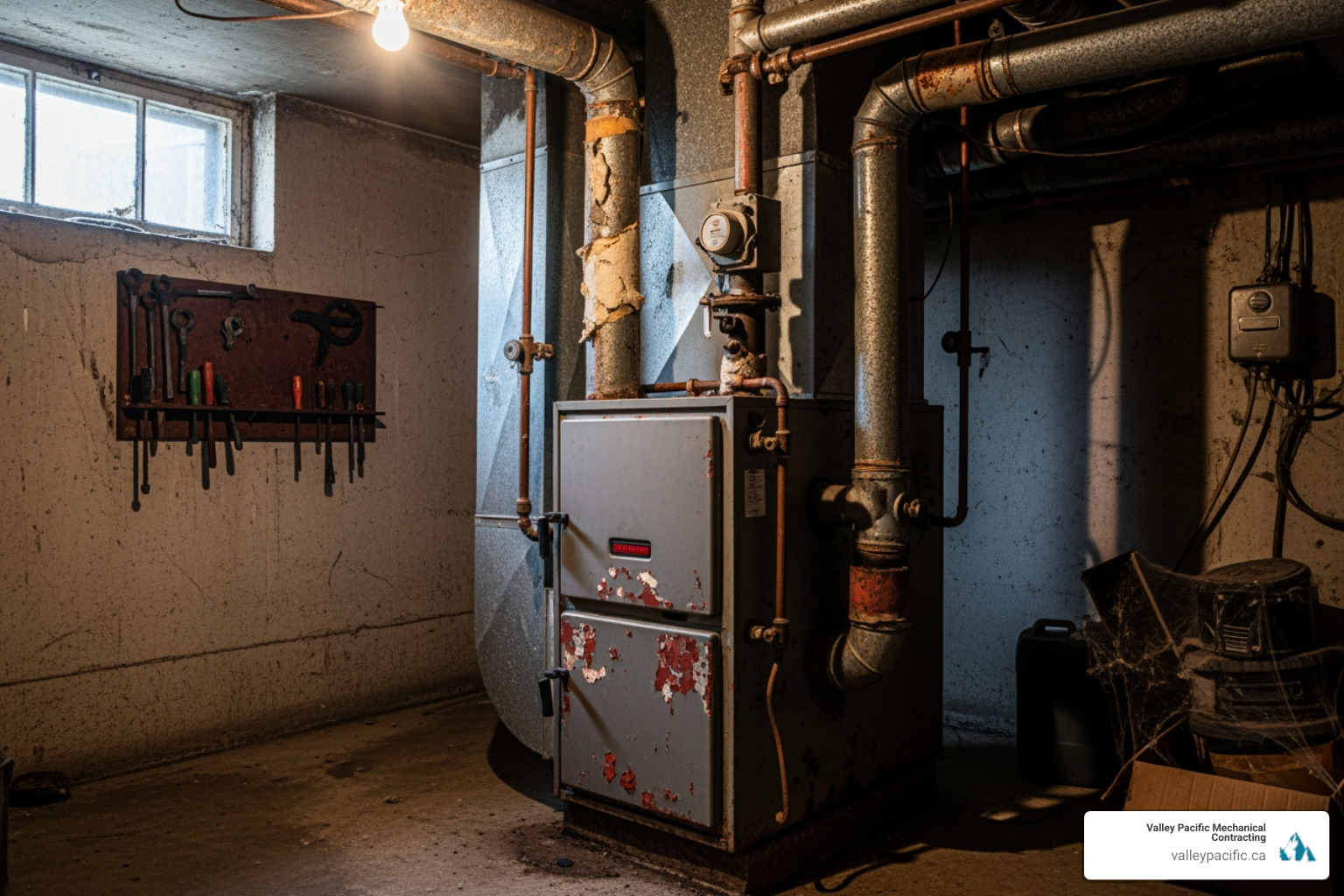
Repair vs. Replace: Making the Right Decision
The decision to repair or replace depends on your furnace's age, warranty status, the extent of the repair, and its overall system reliability. For a relatively new furnace under warranty, a repair is often the logical choice. However, if you have an older, out-of-warranty unit that requires constant attention or a major component replacement, upgrading to a new system provides a fresh start with dependable performance. We'll always provide an honest assessment to help you decide. For more details on repair options, visit our Coquitlam Furnace Repair page.
Immediate Warning Signs of a Malfunctioning Furnace
Some furnace problems are urgent. If you notice any of the following, contact a professional right away for your family's safety:
- Soot around the unit: This indicates incomplete fuel combustion and a potential carbon monoxide risk.
- Carbon monoxide detector alarms: Evacuate your home immediately, call emergency services, and then contact us for an inspection. This is critical for gas furnaces.
- Persistent loud noises: Banging, grinding, or squealing can signal serious mechanical failure.
- Flickering or discolored pilot light: On a gas furnace, a yellow or orange flame is a major red flag for combustion issues.
These signs demand immediate attention. For urgent concerns, check out our HVAC Repair Coquitlam services.
Choosing the Right Furnace for Your Coquitlam Home
Picking the right furnace is a long-term decision affecting your comfort and energy use for years. With expert guidance, you can find a heating system that fits your home perfectly.
Coquitlam's damp, chilly winters demand a heating system that can handle moisture and keep your home consistently warm. Your home size and insulation levels are critical factors. An oversized furnace will cycle inefficiently, while an undersized one will struggle to keep up. That's why every furnace installation coquitlam project should begin with a thorough home assessment. We evaluate your square footage, layout, insulation, windows, and ductwork to recommend a system sized precisely for your space. Our expertise in Residential HVAC Solutions and HVAC System Design ensures we find the right fit for your home.
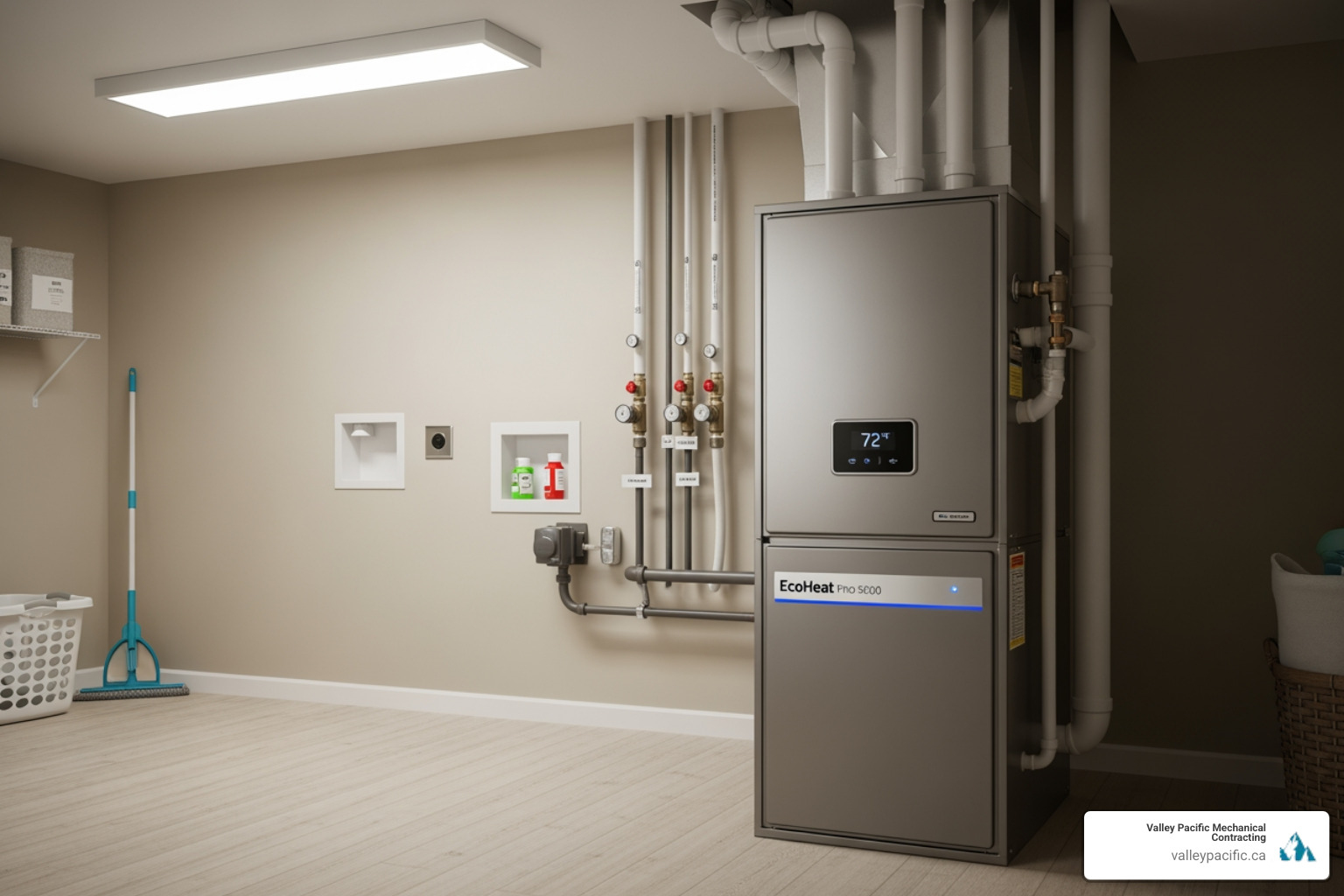
Gas Furnaces, Electric Furnaces, and Heat Pumps
You have three main options for heating your home: gas furnaces, electric furnaces, and heat pumps.
Gas furnaces are a popular choice in Coquitlam, burning natural gas to deliver powerful, reliable heat. Modern high-efficiency models convert over 90% of their fuel into warmth, making them very effective for our climate. They require a natural gas line and proper ventilation.
Electric furnaces use electric heating elements to generate warmth. They are highly efficient at converting electricity to heat and don't require a gas line or venting. This makes them a simple and quiet option, though their energy consumption can be higher during the coldest months compared to other fuel sources.
Heat pumps are an innovative technology well-suited to our mild coastal climate. Instead of creating heat, they move it from the outside air into your home. In the summer, they reverse the process to provide cooling. They are remarkably energy-efficient for most of the year. For the coldest days, many homeowners opt for dual-fuel systems, which pair a heat pump with a gas furnace for optimal efficiency and comfort.
Here's how they compare:
| Feature | Gas Furnace | Electric Furnace | Heat Pump |
|---|---|---|---|
| Operating Principle | Burns natural gas to create heat | Uses electric heating elements to create heat | Moves heat (extracts from outside, transfers inside) |
| Fuel Type | Natural Gas | Electricity | Electricity (for moving heat) |
| Efficiency | High (90%+ AFUE for modern units) | Nearly 100% conversion of electricity to heat | Very high in mild climates |
| Coquitlam Suitability | Excellent for colder, damp winters | Good for smaller homes or as backup | Excellent for mild climate (heating & cooling) |
| Ventilation | Required for exhaust gases | Not required | Not required |
| Carbon Monoxide | Potential risk if not maintained/vented | No risk | No risk |
Understanding AFUE and Other Key Features for Your Furnace Installation Coquitlam
When shopping for a furnace, you'll see an AFUE (Annual Fuel Utilization Efficiency) rating. This tells you how much fuel is converted into heat. A 95% AFUE rating means 95% of the fuel warms your home, while only 5% is wasted. Modern high-efficiency furnaces have AFUE ratings of 90% or higher, a significant improvement over older models. An ENERGY STAR® certification indicates a unit meets strict efficiency standards.
Other key features improve comfort and performance:
- Variable-speed blowers adjust their output for more consistent temperatures, quieter operation, and better air filtration.
- Two-stage heating uses a low setting for mild days and a high setting for cold weather, providing steadier heat and improving efficiency.
- Smart thermostats offer precise control and scheduling from your phone, helping you manage energy use.
- Advanced filtration compatibility allows for higher-efficiency filters that trap more dust, allergens, and particles, improving indoor air quality.
Understanding these features helps you choose a system that meets your comfort and efficiency goals. For more information, visit our Furnace page.
The Professional Furnace Installation Coquitlam Process
A furnace installation Coquitlam is a complex job that requires licensed professionals to ensure safety and compliance. It involves working with gas lines, high-voltage electrical connections, and ventilation systems—all of which pose serious risks if handled improperly. DIY installation can lead to inefficient operation, safety hazards, and issues with building codes or home insurance.
A typical installation takes about four to eight hours. Our process is methodical and thorough, backed by over 30 years of experience and a commitment to a headache-free experience. We handle everything from start to finish, including permits and cleanup. For more on our process, see our page on Forced Air Furnace Installation.
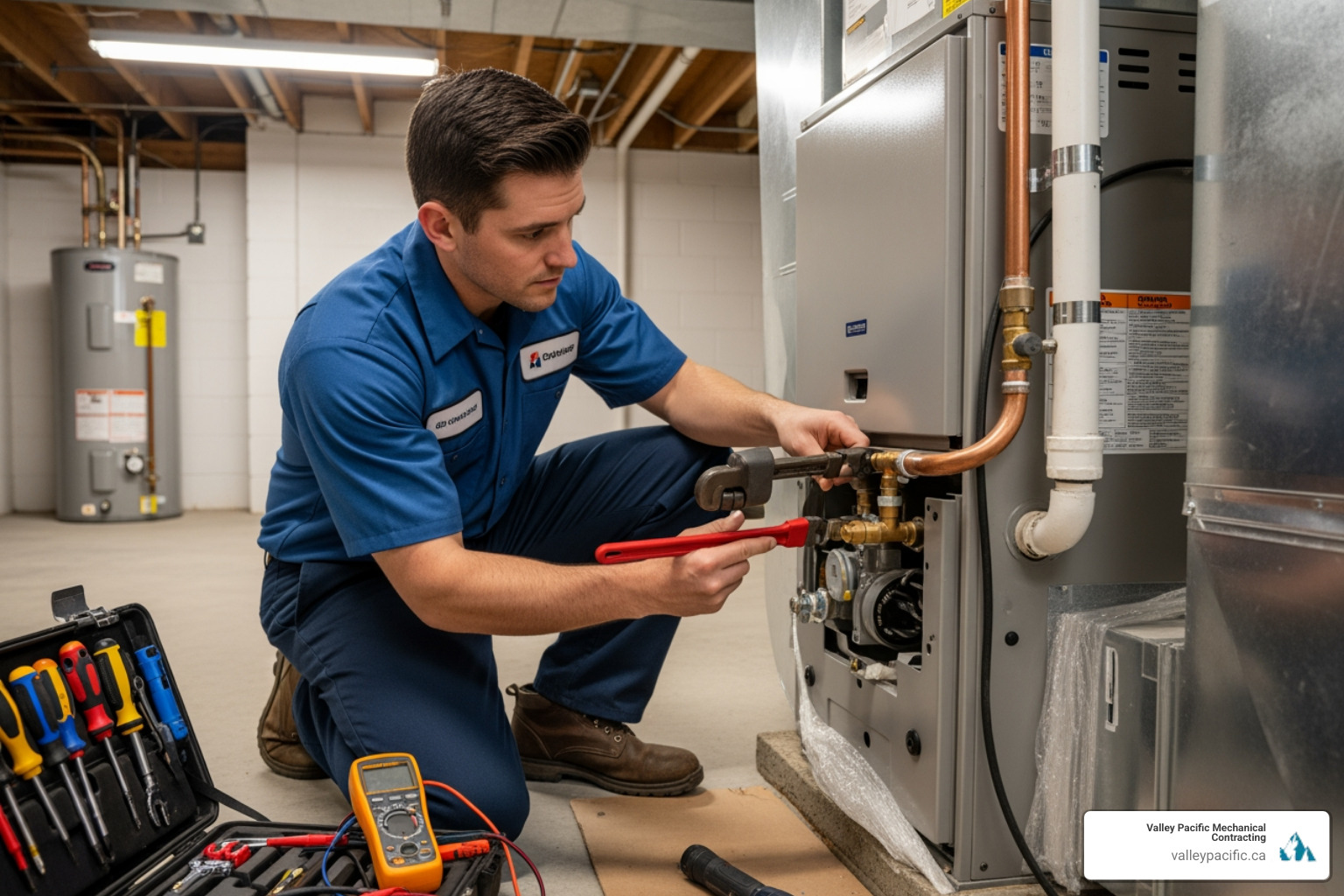
What to Expect During Your Installation
Our installation process is transparent and designed for your peace of mind:
- Home Assessment and System Selection: We start by evaluating your home's unique layout, insulation, and ductwork to determine the correct furnace size. We then help you select the best system for your needs and budget.
- Permits and Preparation: We handle all necessary permits to ensure your installation is fully compliant with Coquitlam's building codes. On installation day, we protect your home and safely remove the old unit.
- New Furnace Installation: Our certified technicians expertly position the new furnace and connect it to your ductwork, fuel lines, and electrical system. We perform a thorough ductwork inspection and recommend any necessary modifications for optimal airflow.
- Testing and Walkthrough: Before finishing, we conduct comprehensive tests to ensure every component is functioning safely and efficiently. We then walk you through your new system, explaining its operation and maintenance so you feel confident and comfortable.
For more homeowner tips, visit our Furnace Installation Homeowner Essentials page.
Post-Installation Care and Maintenance
Proper care after your furnace installation Coquitlam is complete ensures longevity and peak performance. Annual tune-ups are essential for inspecting components, cleaning the system, and verifying safety controls. This preventative maintenance catches small issues early and keeps your system running efficiently.
Between professional visits, remember to perform regular filter changes. A clean filter improves airflow and indoor air quality. Most manufacturers also require annual maintenance to keep your warranty valid, protecting your investment.
A well-maintained furnace can easily reach its expected 15-20 year lifespan. We make ongoing care easy with reminders and flexible scheduling. For more on maintenance, explore our HVAC Services Coquitlam Guide.
Maximizing the Benefits of Your New Furnace
Investing in a new furnace installation Coquitlam is a step toward a more comfortable, healthier, and efficient home. Whether you live in Central Coquitlam or a surrounding neighborhood, a modern furnace transforms your living space.
Key benefits include:
- Improved Energy Efficiency: Modern furnaces with high AFUE ratings convert more fuel into usable heat, reducing waste compared to older, less efficient units.
- Consistent Home Comfort: Advanced features like variable-speed blowers and two-stage heating eliminate hot and cold spots, maintaining a steady temperature throughout your home.
- Improved Indoor Air Quality: New systems work with advanced filters to capture dust, pollen, and other irritants. Many also integrate with humidity control systems to prevent mold growth and improve respiratory comfort.
- Increased Reliability: A new furnace provides peace of mind, eliminating the worry of unexpected breakdowns on the coldest days. Your investment is also protected by a manufacturer's warranty.
- Improved Home Value: An updated, energy-efficient heating system is a significant asset to potential buyers, who value the reliability and improved performance.
How a New Furnace Improves Indoor Air Quality
A new furnace installation Coquitlam significantly improves the air you breathe. Modern furnaces offer advanced filtration, using high-efficiency filters to trap microscopic particles like dust, dander, and allergens. This is especially beneficial for homes in areas like Maillardville.
Many systems also support humidity control, integrating with whole-home humidifiers or dehumidifiers to maintain an ideal moisture level. This prevents mold growth and improves comfort. Finally, features like variable-speed blowers provide better air circulation, continuously moving filtered air to prevent stagnant pockets and ensure every room feels fresh.
Government Rebates and Incentives
Upgrading to a high-efficiency furnace may make you eligible for government rebates and incentives designed to promote energy-efficient home improvements. These programs can help make your investment more affordable.
As a qualified installer, we stay current on available programs for homeowners in areas like Coquitlam City Centre. We can help you identify qualifying systems and provide guidance on the application process. To learn more about current opportunities, you can research provincial and local energy-saving initiatives online, such as those offered by FortisBC.
Frequently Asked Questions about Furnace Installation
When considering a furnace installation Coquitlam, it's natural to have questions. Here are clear, honest answers to some of the most common concerns.
How long does a furnace typically last?
A well-maintained furnace generally lasts 15 to 20 years. Its actual lifespan depends on several factors, including the quality of the initial installation, how frequently it's used, and most importantly, regular professional maintenance. Annual tune-ups are the best way to ensure your system reaches and even exceeds its expected lifespan.
Does a new high-efficiency furnace use less gas?
Yes, significantly. A high-efficiency gas furnace with a 95% AFUE rating converts 95% of its fuel into usable heat. In contrast, older furnaces could be as low as 50-70% efficient, meaning a large portion of the fuel was wasted. By upgrading, you ensure that nearly all the natural gas you use is actively heating your home, which leads to a substantial reduction in fuel consumption and a smaller environmental footprint.
What is the difference between a furnace and a heat pump?
This is a common question in our mild coastal climate. The key difference is how they produce warmth.
- A furnace generates heat by burning natural gas or using electric heating elements. It creates new heat and distributes it through your home.
- A heat pump moves heat. In winter, it extracts warmth from the outdoor air and transfers it inside. In summer, it reverses this process for cooling.
Heat pumps are extremely energy-efficient in mild climates like Coquitlam's. However, their performance can decrease in freezing temperatures. For this reason, many homeowners choose a dual-fuel system, which combines a heat pump for most of the year with a furnace for the coldest days, ensuring optimal efficiency and comfort.
Your Partner for a Headache-Free Furnace Installation
Choosing the right furnace and ensuring a professional furnace installation Coquitlam are crucial for your home's long-term comfort and safety. From recognizing the signs of a failing unit to understanding your options, making an informed decision is key. Most importantly, it means partnering with professionals who care about your satisfaction.
At Valley Pacific Mechanical, we've provided headache-free HVAC solutions to Coquitlam homeowners for over 30 years. Our certified technicians understand our local climate and are dedicated to delivering exceptional comfort. We build lasting relationships with the families we serve, standing behind our work with the Daikin Comfort Promise.
We're available 24/7 for emergency service because heating problems don't wait for business hours. Whether you need an urgent repair or are planning an upgrade, we're here to help with transparent advice and expert workmanship.
Your home deserves the best. Contact us today to discuss your comfort needs or schedule a free consultation. Ready to get started? Request a quote for your furnace installation and experience the Valley Pacific difference.
Why Understanding Plumbing System Installation Matters for Your Home
A properly installed plumbing system is the backbone of a functional home, delivering clean water and safely removing waste. Yet, it's often overlooked until a problem arises. Whether you're building, renovating, or upgrading, understanding the basics of plumbing system installation can save you from costly water damage and future headaches. It's more than just pipes; it's an integrated network of supply, drainage, and venting that must work in perfect harmony.
Quick Answer: What is Plumbing System Installation?
Plumbing system installation involves three core subsystems working together:
- Supply System - Delivers pressurized clean water throughout your home via copper or PEX pipes.
- Drainage System - Uses gravity and sloped pipes to remove wastewater to the sewer or septic system.
- Venting System - Allows air into drain pipes to prevent vacuums and keep water flowing smoothly while blocking sewer gases.
The process is typically done in phases: rough-in (installing pipes in walls and floors), testing (checking for leaks), and finishing (connecting fixtures).
If you're planning a larger mechanical upgrade, check out our guide to mechanical installations, or if you're ready to start your project, contact our team for expert plumbing services. This guide will cover the essentials of plumbing installation, from pipe materials to common mistakes, helping you ensure the job is done right.

Learn more about plumbing system installation:
Understanding Your Home's Plumbing Fundamentals
Your home's plumbing consists of two separate systems: one that brings fresh water in and another that takes wastewater out. Understanding how these systems work is key to any successful plumbing system installation.

The system relies on basic physics. The supply subsystem uses pressure to push clean water to your faucets and appliances. The drainage subsystem uses gravity to pull wastewater out of your home. A third component, the vent system, allows air into the drain lines to ensure water flows smoothly and prevents sewer gases from entering your home. Together, these form the Drain-Waste-Vent (DWV) system.
The Water Supply System: Pressurized and Ready
Clean water enters your home under pressure from a municipal water line or a private well. This pressure is what allows water to travel to upper floors and through your home's network of pipes.
- Main Shutoff Valve: This is the most important valve in your home. In an emergency like a burst pipe, shutting it off quickly can prevent major water damage. If you need help with a burst pipe repair, knowing its location is the first step.
- Hot and Cold Water Lines: The main line splits into two paths. The cold line runs directly to fixtures. The hot line diverts water through your water heater, where it's heated (ideally to around 120°F for safety and efficiency), and then distributed through separate hot water lines to your fixtures.
- Pressure Regulation: Water pressure that is too high can damage fixtures, while pressure that is too low results in poor flow. A pressure regulator, usually installed near the main shutoff, helps maintain the optimal pressure.
The Drainage and Vent System: The Power of Gravity
Your drainage system relies on gravity to function.
- Drain Pipes & Slope: All drain pipes are installed with a slight downward slope (typically 1/4 inch per foot) to ensure wastewater and solids flow smoothly toward the sewer or septic system.
- Vent Pipes: These pipes, which usually exit through the roof, allow air into the drainage system. This prevents a vacuum from forming, which would otherwise cause slow or gurgling drains.
- P-Traps: The U-shaped pipe under every sink is a P-trap. It holds a small amount of water to create a seal that blocks sewer gases from entering your home.
- Cleanouts: These are access points that allow you or a plumber to clear clogs without opening up walls.
A properly functioning DWV system is crucial for a healthy home. Regular backflow prevention testing is also important to ensure wastewater doesn't contaminate your clean water supply.
Planning and Preparation for Installation
Proper planning is the most critical step for a successful plumbing system installation. Rushing this phase can lead to code violations, costly mistakes, and future headaches. Before any work begins, have a clear plan, the right materials, and the necessary permits.
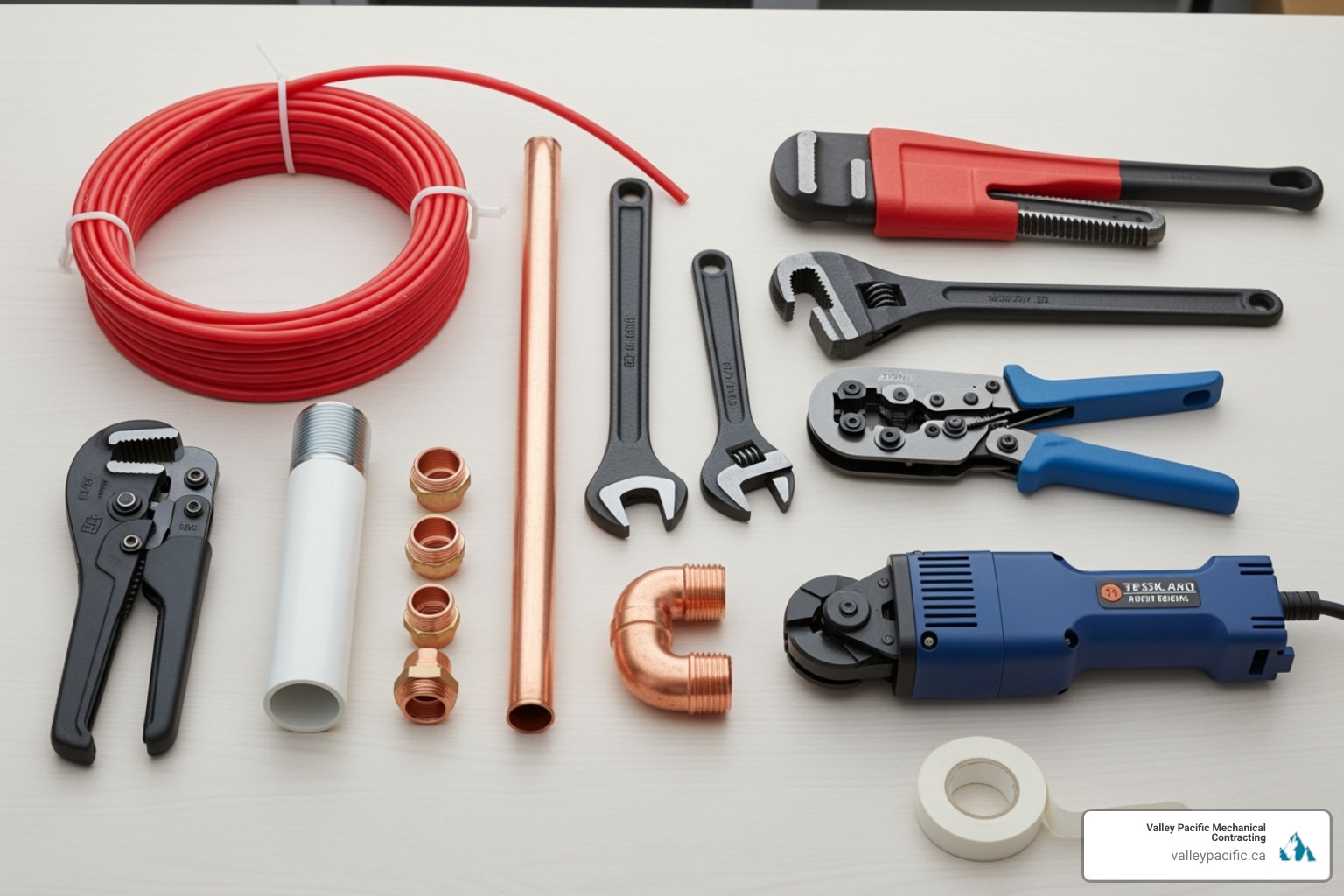
Choosing the Right Pipes and Fittings
The materials you choose will significantly impact the longevity, performance, and cost of your plumbing system. Different applications call for different materials, each with its own advantages.
| Material Type | Application | Durability | Cost-Effectiveness | Ease of Installation | Best For |
|---|---|---|---|---|---|
| PEX | Supply lines | High (resists freezing) | Excellent | Very easy (no soldering) | DIY projects, retrofits, cold climates |
| Copper | Supply lines | Excellent (50+ years) | Moderate | Moderate (requires soldering) | Long-term installations, hot water lines |
| PVC | Drain/waste/vent | High (doesn't corrode) | Excellent | Easy | Most drain and vent applications |
| ABS | Drain/waste/vent | High (impact resistant) | Excellent | Easy | Areas where code permits, colder climates |
If your home has outdated materials like Poly B piping, consider an upgrade. Replace your Poly B piping before it's an emergency to prevent potential leaks and water damage.
Creating Your Plumbing System Installation Plan
A detailed plan is your roadmap. Here’s what to consider:
- Know Your Local Codes: Every municipality has specific plumbing codes. Major work almost always requires a permit. Failing to comply can lead to significant issues, especially when selling your home.
- Map Your Layout: Plan where fixtures will go. Grouping them near a central "wet wall" can save on materials and simplify the system.
- Plan for Access: Ensure that shutoff valves and cleanouts are easily accessible for future maintenance and repairs.
- Gather Your Tools: Before you start, make sure you have all the necessary tools, such as pipe cutters, wrenches, plumber's tape, and safety gear.
For complex projects involving heating, ventilation, and plumbing, professional coordination is key. Our expertise in mechanical installations ensures all systems work together seamlessly.
The Step-by-Step Plumbing System Installation Process
A professional plumbing system installation follows a structured process to ensure everything is done correctly and to code. It's typically broken down into three main phases.
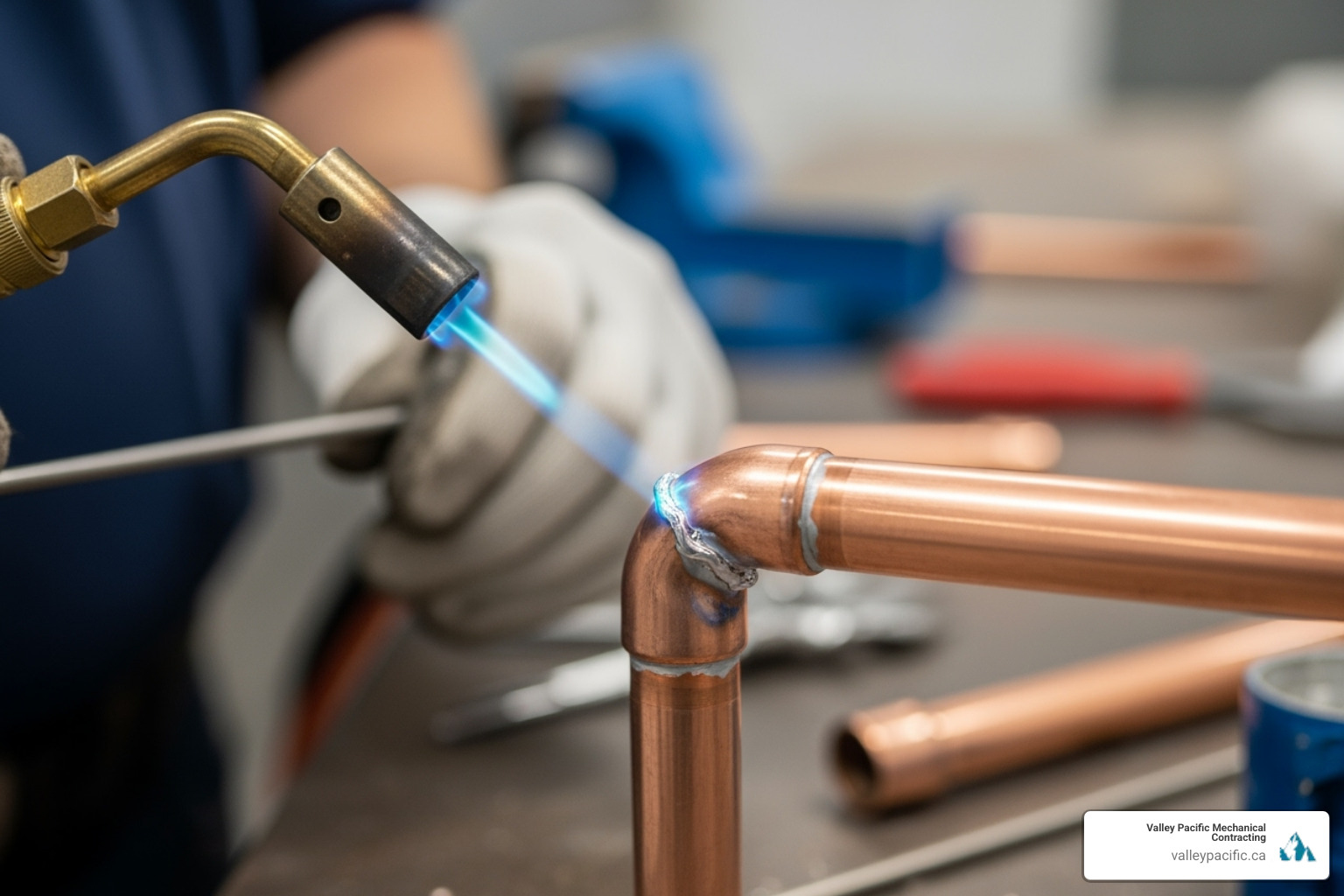
- Rough-In Phase: This is the most critical stage, done after the framing is up but before drywall is installed. All the water supply and drain pipes are run through the walls, ceilings, and floors. This includes setting the main drain lines with the correct slope and running hot and cold water lines to each future fixture location.
- Testing Phase: Before any walls are closed, the entire system is pressurized with air or water to test for leaks. Catching a leak at this stage is a simple fix, whereas finding one after the walls are finished can be a disaster.
- Finishing Phase: After the walls and floors are complete, the final fixtures are installed. This includes setting toilets, connecting sinks and faucets, installing showerheads, and hooking up appliances like dishwashers and washing machines.
Bathroom vs. Kitchen Installation
While the core principles are the same, bathroom and kitchen installations have unique requirements.
Bathroom Plumbing: This involves coordinating multiple fixtures in a small space (toilet, sink, shower/tub). Precise placement of drains and supply lines is crucial. For example, the toilet flange must be set at an exact distance from the wall. Each fixture also requires its own vent, which often ties into a larger vent stack. If you're upgrading, it's a good time to consider a shower valve replacement.
Kitchen Plumbing: The focus here is often on the sink and its related appliances. A kitchen installation must account for a garbage disposal, dishwasher, and often an ice maker line for the refrigerator. The dishwasher requires a hot water supply, a drain line (often connected through an air gap to prevent backflow), and an electrical connection. If you notice any drips during your project, it's best to handle that faucet leak repair immediately.
In both cases, installing individual shutoff valves for each fixture is a best practice that simplifies future repairs.
Best Practices for a Leak-Free, Long-Lasting System
A quality plumbing system installation is built to last. Following best practices ensures your system remains reliable and leak-free for years.
- Proper Pipe Support: Secure pipes at regular intervals to prevent sagging and rattling. This ensures consistent water flow and reduces stress on joints.
- Pipe Insulation: Insulate hot water pipes to conserve energy and both hot and cold pipes in unheated areas (like crawl spaces) to prevent freezing and bursting.
- Accessible Cleanouts: Install cleanouts at key points in the drainage system. This allows for easy access to clear clogs without needing to cut into walls. For major blockages, modern solutions like trenchless pipe repair can solve the problem with minimal disruption.
- Thorough Testing: Always pressure test the system for leaks before closing up walls. It's also wise to test the water pressure to ensure it's within a safe range for your fixtures and appliances.
Common Mistakes to Avoid
Even small errors during installation can lead to big problems. Here are some common pitfalls to avoid:
- Improper Drain Slope: Drain lines must have a consistent, gentle slope (usually 1/4 inch per foot) to allow waste and water to flow correctly.
- Mixing Pipe Materials Incorrectly: Connecting different types of pipes without the proper transition fittings can cause corrosion and leaks.
- Inadequate Venting: Every drain needs a vent to allow air in, preventing slow drains, gurgling noises, and sewer gas from entering your home.
- Over-tightening Fittings: Especially with plastic components, over-tightening can crack fittings and cause leaks.
- Ignoring Building Codes: Plumbing codes exist for safety. Bypassing them can lead to failed inspections, costly rework, and unsafe conditions.
Maintenance, Troubleshooting, and When to Call a Professional
A new plumbing system installation is just the beginning. Regular maintenance is key to preventing major issues and extending the life of your system.
Simple Maintenance Tips:
- Regular Inspections: Periodically check under sinks and around toilets for any signs of moisture or drips.
- Keep Drains Clear: Avoid chemical drain cleaners. Use a mix of baking soda and vinegar, or a drain snake, for minor clogs.
- Prevent Frozen Pipes: Insulate pipes in unheated areas like crawl spaces and garages. During a deep freeze, let a faucet drip slightly to keep water moving.
- Check for Hidden Leaks: Turn off all water in your house and check the water meter. If it's still moving, you likely have a hidden leak.
- Test Your Sump Pump: If you have a sump pump, test it regularly to ensure it's ready to protect your basement from flooding. If you need assistance, we offer expert sump pump repair.
For routine maintenance or unexpected issues, Valley Pacific Mechanical Contracting provides reliable plumbing services in Maple Ridge, BC and the surrounding areas.
When Professional Expertise is Non-Negotiable
While some minor tasks are DIY-friendly, certain jobs should always be left to a licensed professional. Call an expert for:
- Major Renovations or New Construction: A complete plumbing system installation requires knowledge of system design, pipe sizing, and local building codes.
- Main Water or Sewer Line Issues: These jobs require specialized equipment and can cause significant damage if not handled correctly.
- Gas Line Work: For your safety, any work involving gas lines for appliances must be done by a certified professional.
- Persistent Problems: If you're dealing with recurring clogs, low water pressure, or strange noises, a professional can diagnose the root cause.
Hiring a professional ensures the job is done safely, correctly, and up to code, giving you peace of mind. This is especially true for complex projects like mechanical and boiler installation services Maple Ridge BC.
Your Partner for a Perfect Plumbing Installation
A successful plumbing system installation is the backbone of a functional and comfortable home. From understanding the core components to planning the layout and choosing the right materials, a well-executed project ensures reliable water delivery and waste removal for decades. While this guide provides a solid foundation, complex installations require professional expertise to avoid costly mistakes, water damage, and safety hazards.
That's where Valley Pacific Mechanical Contracting comes in. For over 30 years, our team has provided headache-free mechanical and plumbing solutions throughout the Lower Mainland. We treat every project—from a simple repair to a complete system installation—with the care and precision it deserves. Whether you're building, renovating, or dealing with aging pipes, we're here to ensure your plumbing is installed correctly the first time.
We're also your complete mechanical solutions partner, offering services like heat pump installation in Maple Ridge, BC and mechanical and boiler installation services in Maple Ridge, BC.
Ready to start your plumbing project? Contact us for a headache-free experience.
Best Practices for a Leak-Free, Long-Lasting System
A successful plumbing system installation is about more than getting water to flowit's about reliability for decades. Focus on these essentials during installation:
- Proper pipe support and anchoring: secure supply lines about every six feet and drain lines about every four feet to prevent sagging, rattling, and water hammer.
- Pipe insulation: insulate hot water lines for efficiency and any pipes in unheated areas to prevent freezing and bursts.
- Accessible cleanouts: place them near the building exit, at the base of vertical stacks, and on trap arms serving kitchen sinks. For severe underground issues, modern solutions like trenchless pipe repair minimize disruption.
- Thorough testing before closing walls: pressure-test with water or air and verify no pressure drop.
- Water pressure testing: confirm system pressure is in a safe range and use a regulator on the main if needed.
Common Mistakes to Avoid
- Improper drain slope: horizontal drains should fall 1/4 inch per foottoo little causes slow flow; too much leaves solids behind.
- Mixing materials incorrectly: always use proper transition fittings to avoid leaks and galvanic corrosion.
- Inadequate venting: every drain needs a vent to prevent gurgling, slow drains, and sewer gas entry.
- Over-tightening fittings: especially with plastics, hand-tight plus a small wrench turn is often enough.
- Not following code: expect inspections; codes protect safety, performance, and home value.
- Forgetting insulation: unconditioned spaces can cause freezing in winter and condensation/mold in summer.
Maintenance, Troubleshooting, and When to Call a Professional
Even after a solid plumbing system installation, routine upkeep prevents surprises and extends system life.
- Regular inspections: look for stains, moisture around joints, and musty odors. An unexplained water bill spike often signals a hidden leak.
- Keep drains clear: avoid chemical cleaners. Use a plunger or drain snake; for maintenance, try baking soda + vinegar followed by hot water.
- Protect against freezing: insulate exposed pipes, seal drafts, and let faucets drip slightly in deep freezes.
- Find hidden leaks: turn off all water, note the meter, wait an hour without use; movement indicates a leak.
- Fix low water pressure: ensure valves are fully open and clean faucet aerators. House-wide low pressure may indicate main line or regulator issues.
- Sump pump reliability: test by adding water to the pit to confirm automatic operation. For help, see our sump pump repair.
- Ongoing support: Valley Pacific provides expert plumbing services in Maple Ridge, BC and across the Lower Mainland.
When Professional Expertise is Non-Negotiable
- Major renovations or new construction: system design, pipe sizing, venting, and code compliance demand licensed expertise for a complete plumbing system installation.
- Main water or sewer line issues: specialized equipment, permits, and safeguards are essential.
- Gas line work: must be performed by certified professionals for safety.
- Complex code requirements and permits: professionals handle approvals and inspections.
Hiring a pro ensures a safe, efficient, code-compliant system and a headache-free experienceespecially for complex projects like mechanical and boiler installation services Maple Ridge BC.
Your Partner for a Perfect Plumbing Installation
A successful plumbing system installation delivers clean water and safe waste removal for decades. With a clear plan, the right materials, and sound best practices, your home stays comfortable and worry-free.
That's where Valley Pacific Mechanical Contracting comes in. For over 30 years, we've delivered headache-free mechanical and plumbing solutions across the Lower Mainland, with 24/7 emergency service and a commitment to doing it right the first time.
Beyond plumbing, were your complete mechanical partner. Need efficient heating? Explore our heat pump installation in Maple Ridge, BC. For comprehensive heating solutions, see our mechanical and boiler installation services in Maple Ridge, BC.
When Your AC Fails, Every Minute Counts
Emergency AC repair is critical when your cooling system fails during a heatwave. A broken air conditioner is more than an inconvenience; it's a health hazard, especially for children, the elderly, and those with respiratory conditions. According to the CDC's Heat & Health Tracker, a heat index over 90°F (32°C) significantly increases the risk of heat-related illnesses, making a functional AC essential.
If you need immediate help, here's what to do:
- Turn off your AC at the thermostat and circuit breaker to prevent further damage.
- Check the basics: thermostat settings, air filter, and tripped breakers.
- Call a professional if the system won't turn on, makes loud noises, smells like burning, or is leaking.
- Stay cool by closing blinds, using fans, drinking water, and moving to lower levels of your home.
- Never ignore electrical issues, strange smells, or visible smoke.
Most AC emergencies can be resolved quickly when you know how to respond. This guide will help you identify true emergencies, take immediate action, and prevent future breakdowns. For comprehensive HVAC solutions beyond emergency repairs, explore our full range of residential and commercial services, or contact us for immediate assistance.

Emergency AC repair helpful reading:
Is It a True AC Emergency? Key Warning Signs
When your AC fails on the hottest day of the year, you need to know: can it wait, or do you need help right now? We define an emergency AC repair as any situation that poses a health risk, safety risk, or threatens major property damage. A complete system failure during a heatwave is always an emergency, but other warning signs also demand immediate attention.
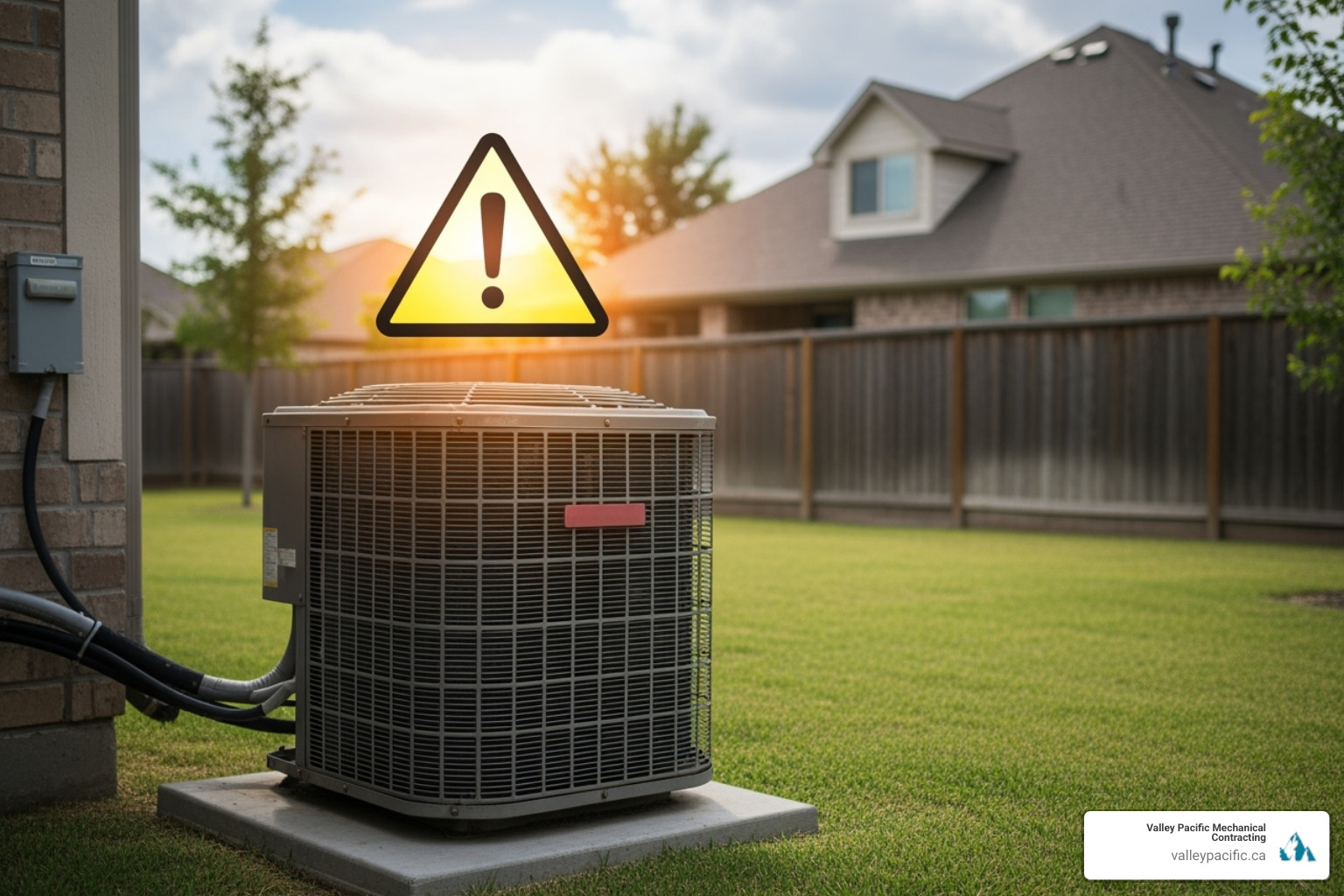
Your AC communicates problems through sounds, smells, and visible signs. Recognizing these signals can be the difference between a quick fix and a total system replacement. To learn more, check out our guide on How Do I Know If My AC Needs Immediate Repair or Just Maintenance.
Signs of Electrical Problems
Electrical issues are dangerous and can cause fires or damage your home's wiring. Act immediately if you notice these signs:
- Circuit breakers that keep tripping: This indicates your AC is drawing too much power due to a short circuit or failing component. Don't just reset it; this is a serious warning. Learn more about Why is my AC circuit breaker tripping.
- A burning smell from your vents: This likely means wiring or a motor is overheating. Turn off your AC at the thermostat and circuit breaker immediately.
- Lights that dim when the AC starts: This signals the unit is pulling excessive power, often due to a component that's about to fail.
Alarming Noises and Smells
Unusual sounds mean your system is in trouble. Turn it off and call a professional if you hear:
- Grinding or screeching: These are often the death rattle of failing motor bearings. Continuing to run the system will lead to a more expensive motor failure.
- Banging or clanking: This means a part has broken or come loose. Running the unit can cause a chain reaction of damage.
- Hissing or bubbling: This usually points to a refrigerant leak, which can destroy your compressor.
- Musty or moldy odors: This indicates mold growth in your system, which is a health concern. Read more about Strange Noises Coming From AC Unit and Addressing AC Foul Odours.
Visible Leaks or Freezing
Water or ice where it shouldn't be requires prompt attention to prevent serious damage.
- Water pooling around your indoor unit: This is often from a clogged condensate drain line and can lead to water damage and mold. Our guide on Troubleshooting AC Water Leaking can help.
- Ice buildup on coils or refrigerant lines: This is a common sign of restricted airflow (like a dirty filter) or low refrigerant. It blocks cooling and strains the system. Learn more in Why is my AC unit freezing up.
- Refrigerant leaks: Besides hissing sounds and ice, a refrigerant leak causes a noticeable drop in cooling power. Running an AC with low refrigerant will ruin the compressor.
Don't wait and see with these warning signs. A minor issue today can become a major emergency AC repair tomorrow.
Your Immediate Action Plan for Emergency AC Repair
When your AC gives up, a few calm, deliberate steps can protect your family, prevent further damage, and help you communicate clearly with a professional.

Your first priority is safety. If you smell something burning or see major leaks, turn the system off immediately. Once it's safe, some basic troubleshooting might reveal a simple fix. For a full walkthrough, see our guide on AC Suddenly Stops Working.
First-Step Troubleshooting
Before scheduling an emergency AC repair, try these simple checks:
- Check your thermostat: Ensure it's set to "cool" and the temperature is set below the current room temperature. Check the batteries if it's wireless. If the remote is the issue, see our article on AC Remote Not Working.
- Inspect your air filter: A clogged filter is a common culprit. If it's dirty, replace it.
- Check the circuit breaker: Find the breaker for your AC. If it's tripped, flip it completely off, then back on.
- Examine the outdoor unit: Turn off the power at the nearby disconnect box, then clear away any leaves, grass, or debris blocking airflow.
How to Stay Cool While You Wait
While our technicians are on their way, use these strategies to stay cool:
- Close blinds and curtains to block heat from the sun.
- Use fans to circulate air and create a cooling effect.
- Stay hydrated by drinking plenty of water.
- Avoid using heat-generating appliances like the oven, stove, or dryer.
- Move to the lowest level of your home, as basements and ground floors are naturally cooler.
The Risks of Running a Malfunctioning AC
It's tempting to keep a struggling AC running, but this can turn a minor repair into a major catastrophe. Forcing a system with grinding noises or leaks to operate can cause the initial problem to spread, potentially destroying the compressor—the most expensive part of your system.
The financial difference between acting early and ignoring a problem is substantial. A simple fix can escalate into a full system replacement. Learn the Signs Your HVAC System May Fail Soon to catch issues early. Most importantly, electrical issues are a fire hazard. If your breaker keeps tripping or you smell burning, turn the system off at the thermostat and breaker immediately.
Common Culprits: Why AC Units Fail During Peak Season
Your AC is most likely to fail during a heatwave because the relentless demand exposes every weak point. Components that limp along in mild weather can't keep up when they have to run constantly. Understanding these common failure points can help you avoid a full-blown emergency AC repair. For more on this, see our guide on AC Not Cooling During Heatwaves.

Airflow and Cooling Problems
Most peak-season breakdowns are caused by restricted airflow. Your AC cools by moving air over cold coils; if that air can't flow, the system breaks down.
- Dirty air filters are the #1 culprit. A clogged filter suffocates your system, leading to overheating and frozen coils. Check your filter frequently during summer.
- Blocked vents also restrict airflow, forcing your AC to overwork. Ensure furniture and curtains aren't covering registers.
- Frozen evaporator coils are a symptom of poor airflow. Ice builds up on the indoor coil, blocking air and creating a vicious cycle. Our article Why is my AC unit freezing up explains this in detail.
- Warm air blowing from vents is the frustrating result of these issues. If you're experiencing this, see AC Vents Warm Air Causes Solutions. For uneven cooling, check our guide to Uneven Cooling Issues With Your AC.
Component and System Failures
Summer heat puts immense stress on your AC's mechanical and electrical parts.
- Capacitor failure is extremely common in heatwaves. Capacitors give motors the boost they need to start and run. When they fail from overheating, your system won't start.
- Compressor issues are the most serious failures. The compressor is the heart of your AC. It can fail from continuous operation in extreme heat or from running with low refrigerant. A failing compressor is an expensive problem.
- Refrigerant leaks become obvious during peak season. Low refrigerant means poor cooling and can cause the compressor to overheat and fail.
- Thermostat malfunctions can mimic serious problems, causing the AC to run constantly or not at all. During a heatwave, this can be critical. Learn more about Fixing AC That's Constantly Running.
The Proactive Approach: Preventing Future Breakdowns
The best emergency AC repair is the one you never have to make. Like a car, your air conditioner needs regular maintenance to run reliably and efficiently, especially when you need it most.
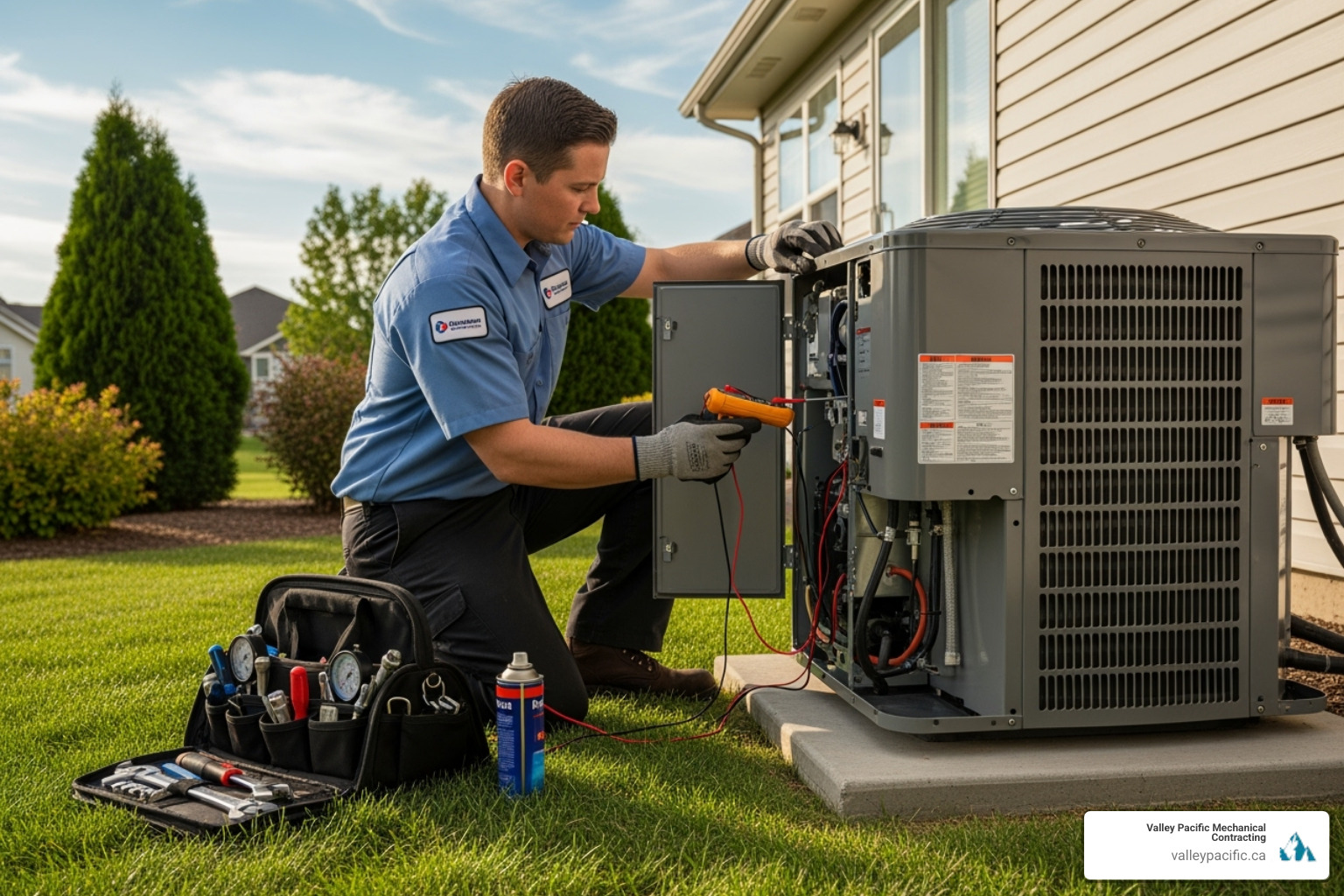
Preventative care saves you from stress and high costs in the long run by extending your system's life and lowering energy bills. For a complete overview, check out our HVAC Preventative Maintenance guide.
The Role of Regular AC Maintenance
Professional maintenance is a health checkup for your AC. Our technicians inspect all components, clean essential parts, and fine-tune your system for peak performance. We clean evaporator and condenser coils, clear the condensate drain line to prevent leaks, and verify refrigerant levels to protect your compressor. A comprehensive inspection is detailed on our HVAC System Check page.
The benefits are clear: your AC lasts longer, your energy bills are lower, your air quality improves, and you maintain your manufacturer's warranty. For local service options, see our HVAC Maintenance Langley page.
Preparing Your AC for Summer
A little preparation in the spring ensures a cool, worry-free summer.
- Schedule a professional spring tune-up before the first heatwave. This allows us to fix issues before our summer rush begins.
- Keep your outdoor unit clear of leaves, grass, and other debris that can block airflow.
- Test your system on a mild day. Turn it on to ensure it's blowing cool air and not making strange noises.
- Ensure proper airflow by replacing your air filter regularly and keeping all indoor vents open and unobstructed.
For homeowners in Maple Ridge, we offer comprehensive AC Service Maple Ridge BC to get your system summer-ready.
Repair vs. Replace: Making the Right Call for Your Old Unit
When facing an emergency AC repair on an older system, you have a tough choice: fix it or replace it? Understanding a few key factors will help you make the smartest decision for your home and budget. Our guide When to Install a New AC System offers more insight.
The table below outlines the main factors to consider:
| Factor | Repair Favored | Replace Favored |
|---|---|---|
| Age | Less than 10-12 years old | Over 15 years old |
| Repair Freq. | First or second minor repair | Frequent, recurring breakdowns |
| Efficiency | Unit still operates efficiently | High energy bills, poor cooling performance |
| Warranty | Repairs covered under warranty | Warranty expired, major component failure |
| Cost | Repair cost is less than 50% of new unit | Repair cost approaches or exceeds 50% of new unit |
When to Choose AC Repair
A repair is often the right move. Consider repairing if:
- Your AC unit is less than 10-12 years old. It likely has several years of life left.
- The fix is minor and inexpensive, like replacing a capacitor or clearing a drain line.
- The system is still under warranty. Many warranties cover parts, so you'll only pay for labor. We offer expert AC Repair Mission BC to get your unit running again.
Signs You Need a New AC Installation
Sometimes, continuing to repair an old unit is throwing good money after bad. It's time for a new system if:
- Your unit is over 15 years old. It's past its typical lifespan and will likely have more frequent breakdowns.
- You face frequent and costly breakdowns. If you're calling for emergency AC repair every summer, the costs add up. A major repair like a compressor replacement can cost 50% or more of a new unit.
- Your energy bills are rising. An old, inefficient unit works harder to do less.
- Your unit uses outdated R-22 refrigerant (Freon). This refrigerant is phased out, expensive, and hard to find.
For more details, see Signs You Need a New AC Installation. A new system is an investment in reliability, efficiency, and peace of mind. We provide expert AC Installation Langley BC to ensure you get the perfect system for your home.
Frequently Asked Questions about Emergency AC Repair
When your AC goes down in a heatwave, you need answers fast. Here are some of the most common questions we hear about emergency AC repair.
What constitutes a true emergency AC repair situation?
An emergency involves any scenario that poses a health risk (extreme heat), a safety hazard (electrical issues), or threatens property damage (major leaks). If your system fails completely during a heatwave, especially with vulnerable individuals at home, it's an emergency. Likewise, burning smells or frequent breaker trips are safety emergencies that require an immediate call.
What are the first things I should check myself?
Before calling, a few quick checks might solve the problem:
- Thermostat: Is it set to "cool" with the temperature set low enough?
- Air Filter: Is it clogged and in need of replacement?
- Circuit Breaker: Has the breaker for the AC unit tripped? Try resetting it once.
- Outdoor Unit: Is it blocked by leaves or debris?
Is it safe to keep my AC running if it's making strange noises?
No, turn it off immediately. Loud grinding, banging, or screeching noises indicate a serious internal problem. Continuing to run the unit can cause a minor issue to become a catastrophic failure, potentially destroying expensive components like the compressor. Turn the system off at both the thermostat and the circuit breaker, then call a professional.
At Valley Pacific Mechanical Contracting, we're available 24/7 for these exact situations. Your comfort and safety are our top priorities, and we're always just a phone call away when you need emergency AC repair.
Your Partner for Year-Round Home Comfort
When your AC quits during a heatwave, you need a partner who understands the urgency. Our mission is to restore comfort to your home quickly and efficiently. While we believe prevention through regular maintenance is the key to avoiding emergency AC repair, we know emergencies still happen.
That's why we offer 24/7 availability for unexpected breakdowns. Whether it's a strange noise in the night or a complete system failure on the hottest day of the year, we are ready to help.
At Valley Pacific Mechanical Contracting, we provide a headache-free experience. From routine maintenance to emergency repairs and new installations, our team brings over 30 years of expertise and reliability to homeowners throughout the Lower Mainland, including Mission, Maple Ridge, and Langley. We back our work with the Daikin Comfort Promise, ensuring your home remains a sanctuary year-round.
For more information about our comprehensive heat pump services, visit our dedicated page: More info about heat pump services.
Why Homeowners in the Lower Mainland Are Choosing New Boiler Installation
A new boiler installation is one of the most effective ways to improve your home's comfort, energy efficiency, and heating reliability. Replacing an aging system with a modern boiler can make a significant difference in your home's warmth and your energy bills.
If you're considering a new boiler installation, here's what you need to know:
- Professional installation is essential for safety, efficiency, and warranty protection.
- Choose the right type (combi, system, or conventional) for your home's size and hot water needs.
- Proper sizing is critical – a qualified technician must assess your heating requirements.
- Look for high-efficiency models with AFUE ratings of 90% or higher.
- The process typically takes 1-3 days, depending on complexity.
- Annual maintenance is crucial for longevity and performance.
For expert guidance, explore our Boiler Heating System guide or get started with a professional assessment from our certified team.
Today's boilers are more efficient, quieter, and easier to control. Upgrading to a modern condensing boiler can save hundreds of dollars annually on heating bills while providing consistent warmth and reliability. In this guide, we'll cover everything from choosing the right system to installation and maintenance.
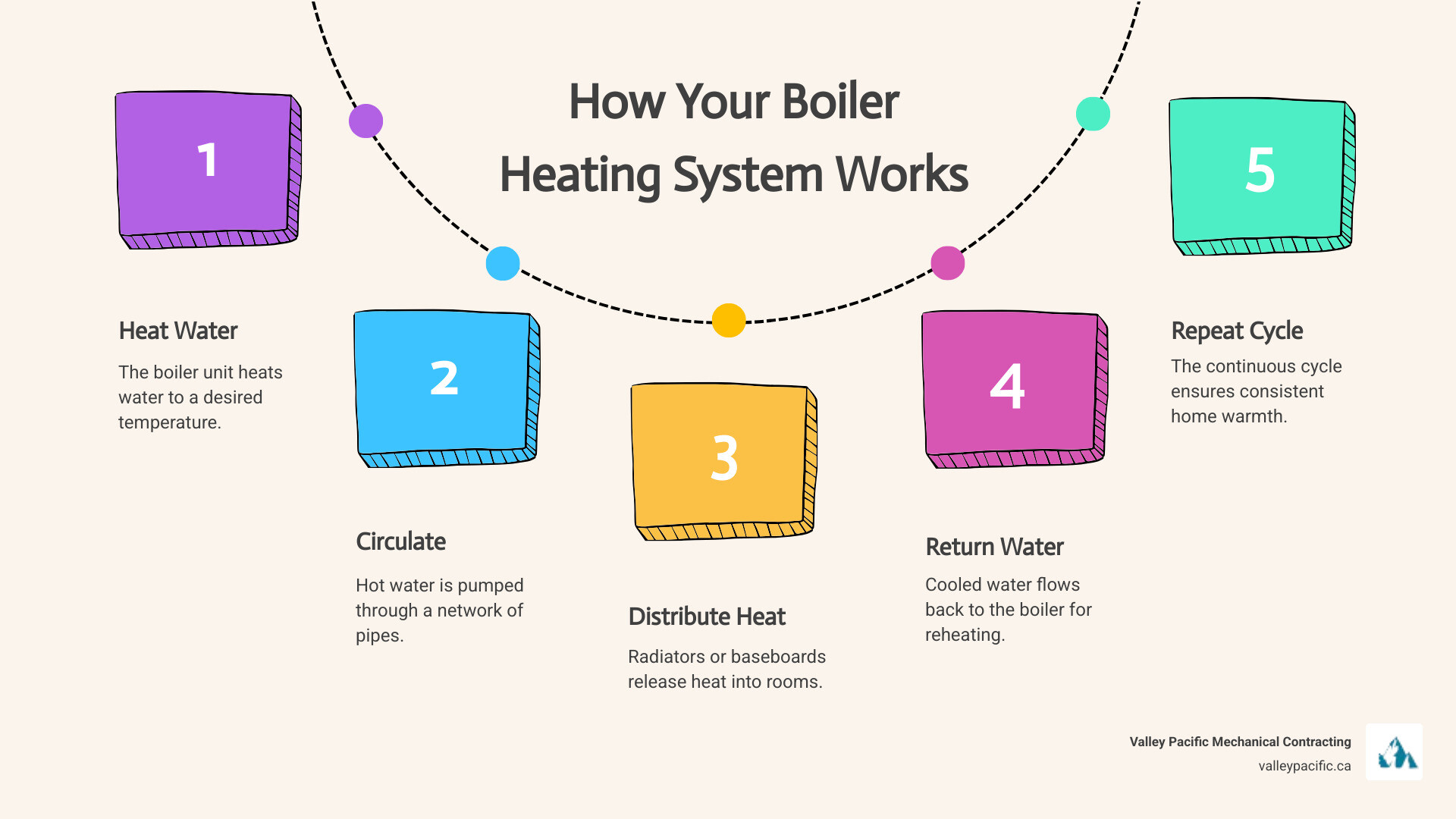
New boiler installation vocab to learn:
Why Upgrade? The Benefits of a Modern Boiler
If your old boiler is unreliable or inefficient, it might be time for an upgrade. A new boiler installation is an investment in your home's comfort, energy use, and long-term savings.
The benefits of modern systems are impressive. While an old boiler may only convert 60% of its fuel into heat, modern condensing boilers achieve efficiency ratings of 90% or higher. This translates directly into reduced utility bills, with many homeowners saving hundreds of dollars per year.
Beyond savings, modern boilers provide consistent heating without cold spots, quieter operation, and increased reliability, which means fewer emergency breakdowns. For more details on how these systems operate, explore our Boiler Heating System guide.
Improved Comfort and Control
A new boiler gives you superior control over your home's climate. Modern systems offer improved temperature regulation for precise comfort.
- Smart thermostat compatibility allows you to control your heating remotely from your phone, adjusting to your schedule automatically.
- Zoned heating potential lets you heat only the areas you're using, reducing energy waste.
- Combi boilers provide faster hot water on demand, eliminating the wait for a storage tank to heat up.
Efficiency and Environmental Impact
A high-efficiency boiler is also an environmentally responsible choice. Modern boilers achieve top-tier A-rated efficiency through condensing technology. This process captures heat from exhaust gases that older boilers waste, using it to pre-heat water returning to the boiler.
This dramatically reduces fuel consumption, resulting in a significantly reduced carbon footprint for your home. By burning less fuel, you lower greenhouse gas emissions while enjoying lower energy bills. Learn more about this technology in our guide to Condensing Boiler Installation.
Choosing the Right Boiler for Your Home
Choosing the right boiler is crucial for a successful new boiler installation. Key factors include your home's size, insulation, number of bathrooms, and hot water usage. You should also consider your existing heating setup and any future plans for home expansion, as these will influence the best choice for your needs.
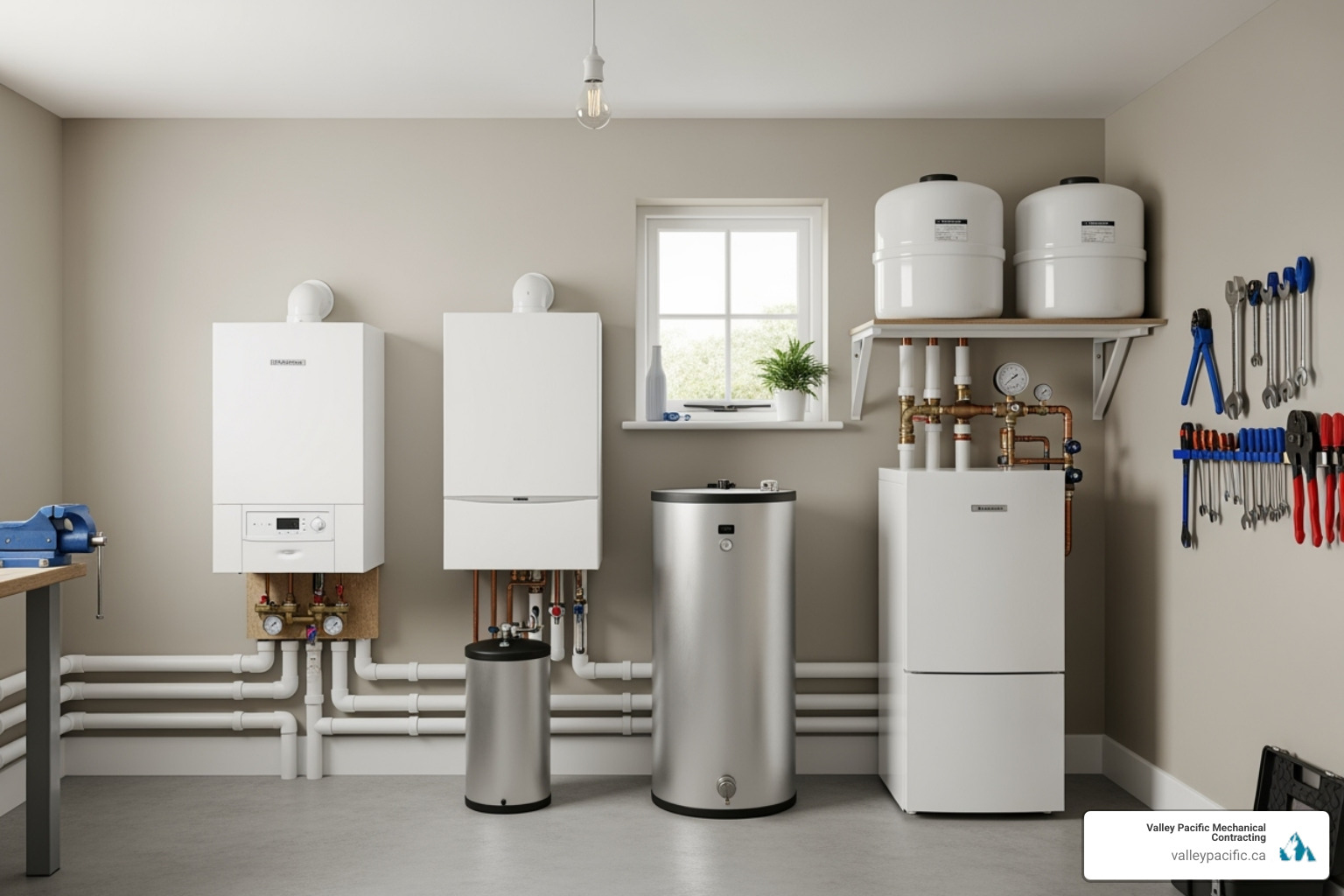
Main Types of Boilers
There are three main types of boilers, each suited for different homes.
| Boiler Type | Space Required | Hot Water Supply | Best For |
|---|---|---|---|
| Combi Boiler | Compact, no tanks | On-demand, direct from mains, limited simultaneous outlets | Small to medium-sized homes, 1-2 bathrooms, limited space |
| System Boiler | Boiler + hot water cylinder | Consistent, high pressure, multiple simultaneous outlets | Medium to large homes, 2+ bathrooms, high hot water demand |
| Conventional (Regular) Boiler | Boiler + hot water cylinder + cold water tank | Consistent, gravity-fed, good for older systems | Larger homes, older heating systems, low water pressure areas |
- Combi (Combination) boilers are compact, all-in-one units that provide both heating and instant hot water. They are efficient and space-saving, making them ideal for smaller homes with 1-2 bathrooms.
- System boilers work with a hot water cylinder to supply multiple taps at once. They are perfect for larger homes with high hot water demand and two or more bathrooms.
- Conventional (Regular) boilers use a hot water cylinder and a cold water tank. They are a good fit for large properties, homes with older radiator systems, or areas with low mains water pressure.
How to Choose the Right Size Boiler
Boiler sizing refers to its heat output, measured in BTUs (British Thermal Units). Correct sizing is vital for efficiency and comfort. A boiler that's too small won't adequately heat your home, while an oversized boiler will waste energy and wear out faster by cycling on and off too frequently.
The right size depends on your home's square footage, ceiling height, insulation levels, and hot water habits. This is why a professional assessment is essential. Our experts calculate your home's specific heating requirements to ensure you get a perfectly sized boiler—no more, no less. For homeowners in Maple Ridge, our Boiler Installation Maple Ridge BC service provides this expertise.
Understanding AFUE and Fuel Types
AFUE (Annual Fuel Utilization Efficiency) measures how efficiently a boiler converts fuel into heat. An 85% AFUE rating means 85% of the fuel heats your home, while 15% is lost.
High-efficiency models have AFUE ratings of 90% or higher. While they may have a higher initial cost, their long-term energy savings make them a smart investment.
Regarding fuel types:
- Natural gas is the most common and affordable option for homes on the gas grid.
- Propane is an excellent alternative for rural properties not connected to natural gas.
- Electric boilers are an option for smaller properties, as they are cheaper to install but can have higher running costs depending on electricity rates.
Our team will help you steer these choices for your new boiler installation. For those in and around Mission, see our Boiler Installation Mission BC services for local expertise.
The Professional New Boiler Installation Process
A new boiler installation involves gas lines, water systems, and electrical connections, making professional installation essential for safety, efficiency, and warranty validation. Our certified technicians adhere to the highest safety standards and code compliance, drawing on over 30 years of experience to ensure a flawless installation. For a detailed overview, see our Professional Boiler Replacement Process guide.
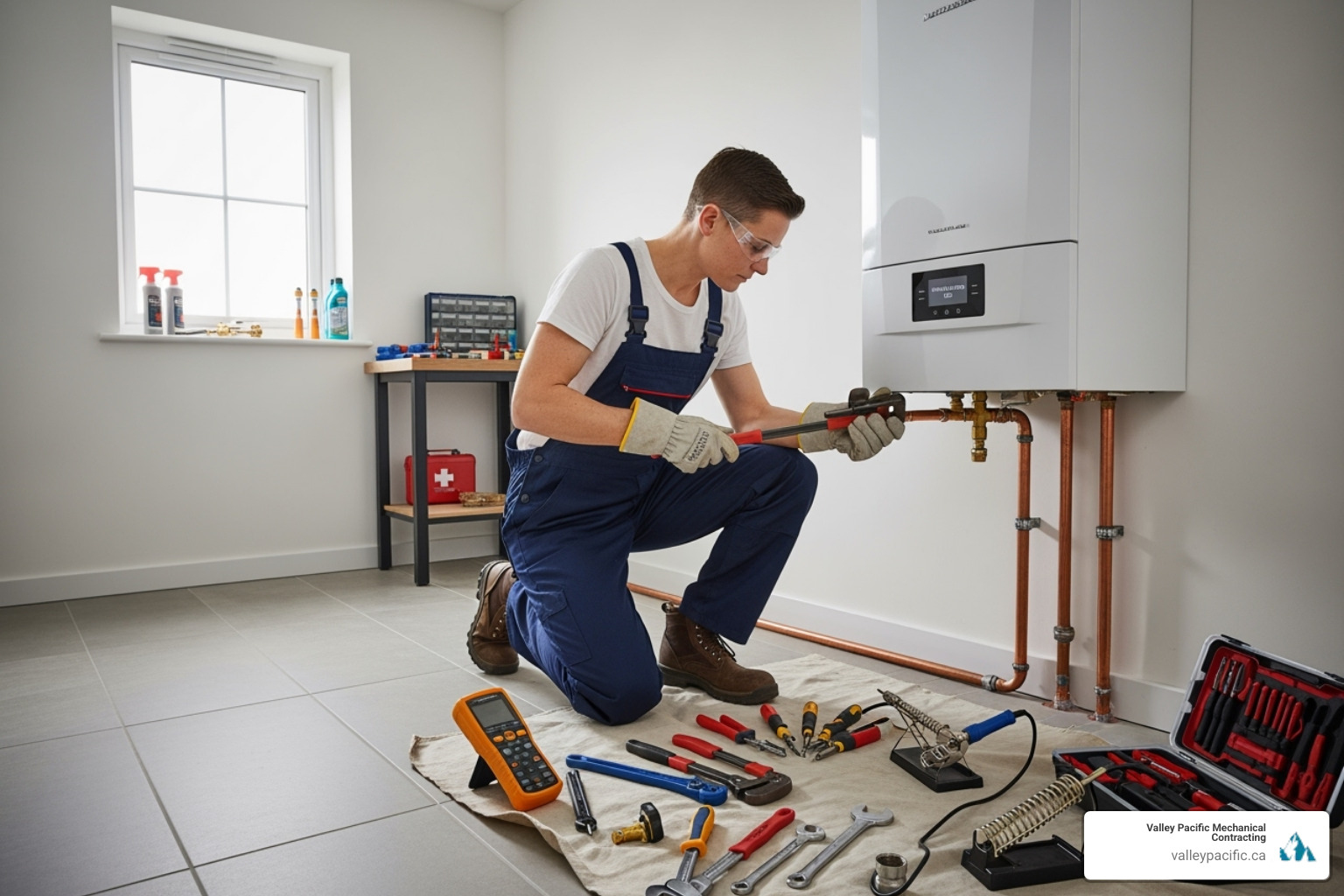
Key Factors for Your New Boiler Installation
Before installation, our technicians assess several key factors to ensure a smooth process:
- Ventilation requirements: We verify that your boiler has proper airflow to operate safely and efficiently.
- Flue system condition: The flue, which vents exhaust gases, is inspected to ensure it is safe and correctly sized.
- Pipework adjustments: We determine if any modifications are needed to connect the new boiler, especially when changing boiler types.
- Electrical connections: Our licensed technicians ensure all wiring meets electrical codes for safe operation.
Find more tips in our guide on Preparing Your Home for a New Boiler.
What to Expect During a New Boiler Installation
Our goal is a smooth and transparent process. A typical installation includes:
- Preparation: We protect your home with drop cloths before inspecting the workspace.
- Old System Removal: We safely shut off and drain the old system, then remove and dispose of the old boiler.
- New Boiler Installation: The new unit is positioned and professionally connected to your water, heating, and electrical systems. The flue is then installed or connected.
- System Flushing: We flush the heating system to remove sludge and debris that could damage the new boiler.
- Testing and Calibration: After filling the system, we conduct rigorous tests for leaks and pressure, calibrate the thermostat, and perform comprehensive safety checks.
- Homeowner Handover: We walk you through your new system's operation and answer all your questions before cleaning up the work area completely.
A simple replacement can take a single day, while more complex jobs may take 2-3 days. We provide expert installation for residents in Pitt Meadows and beyond. Learn more at Boiler Installation Pitt Meadows BC.
Ensuring Longevity: Warranty and Maintenance
To protect your new boiler installation, it's important to understand your warranty and commit to regular maintenance. Most new boilers include a manufacturer warranty (5-10 years for parts) and a labour guarantee from the installer. However, these warranties typically require proof of annual servicing to remain valid, making regular check-ups essential.
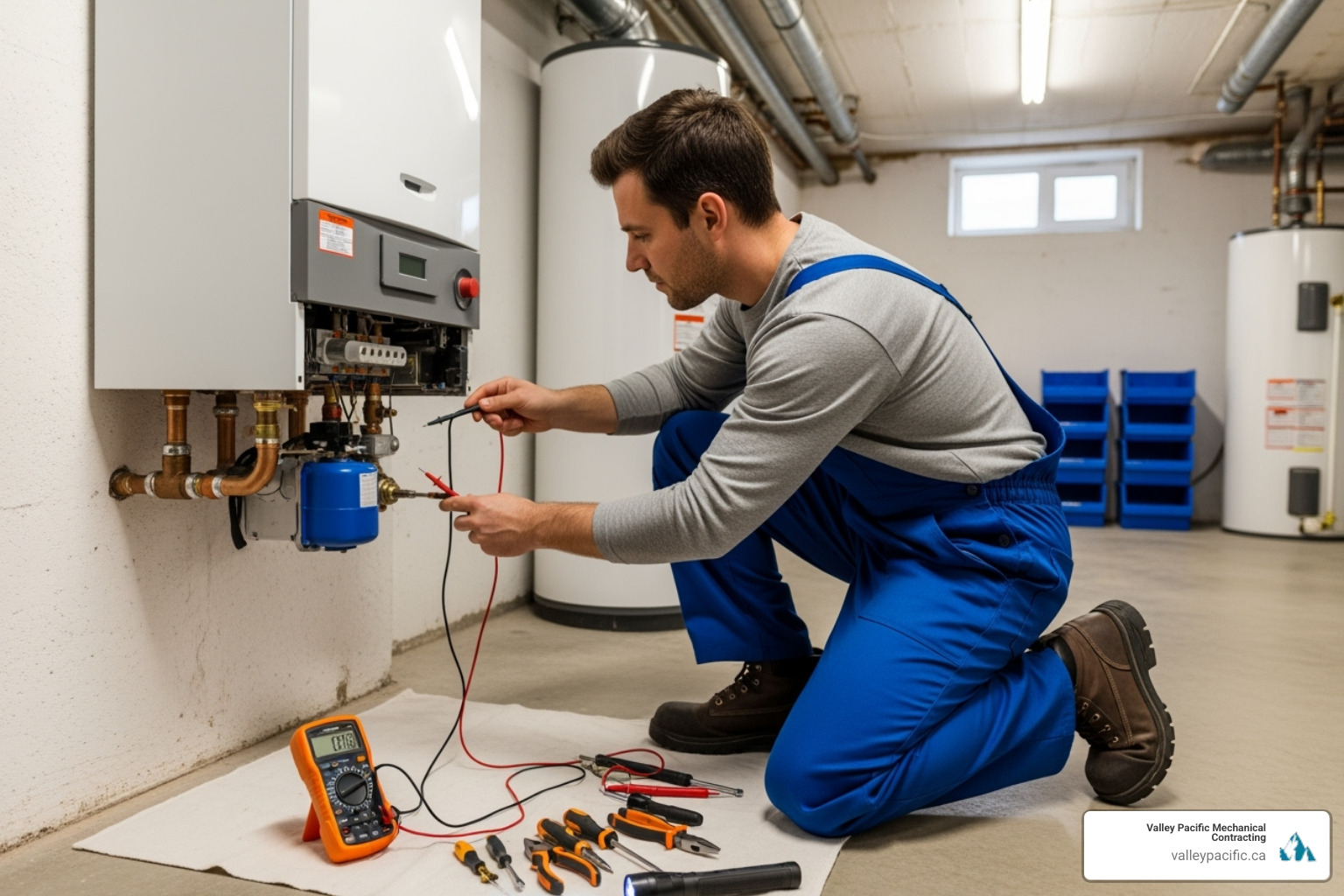
The Importance of Regular Maintenance
With proper care, a boiler can last 15 to 25 years. Annual servicing is the key to achieving this lifespan and includes:
- Preventing breakdowns: Technicians can spot and fix small issues before they lead to costly emergency repairs.
- Maximizing efficiency: Cleaning and calibration keep your boiler running at peak performance, preventing your energy bills from creeping up.
- Safety checks: A professional will inspect for carbon monoxide leaks, check ventilation, and ensure all safety devices are functioning correctly.
For more tips, see our guides on Boiler System Maintenance and Boiler Repair Langley BC Guide.
Common Boiler Issues to Watch For
Be alert for these warning signs:
- Losing pressure: Frequent pressure drops often signal a leak. Learn more about Boiler pressure issues.
- Unusual noises: Banging, whistling, or gurgling can indicate air in the system or a failing component.
- Leaks: Any visible water around the boiler requires immediate attention. Turn off the boiler and call a professional. See our guide on a Boiler leaking water.
- Pilot light problems: A pilot light that frequently goes out or has a discolored flame needs expert service.
Our 24/7 emergency service ensures you're never left in the cold. We're always ready to restore your home's comfort.
Frequently Asked Questions about Boiler Installation
Here are answers to common questions about new boiler installation.
How long does a new boiler typically last?
With professional installation and proper care, a new boiler typically lasts between 15 to 25 years. Key factors influencing its lifespan include:
- Boiler Quality: Higher-quality models with robust components tend to last longer.
- Installation Quality: Correct installation prevents unnecessary strain on the system.
- Water Quality: Hard or corrosive water can affect internal parts. We can recommend solutions to mitigate this.
- Regular Maintenance: Annual servicing is the single most important factor in extending your boiler's life.
What documentation should I receive after installation?
After your new boiler installation, you should receive several important documents for warranty and safety verification:
- Building Regulations Certificate: Proof that the installation complies with local codes and permits.
- Proof of Certification: Documentation showing your installer is licensed to work on gas appliances (e.g., by Technical Safety BC).
- Manufacturer's Warranty: Details on what is covered and for how long.
- User Manual: Instructions on operating your new system.
Is a system flush necessary with a new boiler?
Yes, we strongly recommend a system flush with every new boiler installation. Over time, older heating systems accumulate sludge and debris. If not removed, this buildup can circulate into your new boiler, causing blockages, reducing efficiency, and potentially voiding the warranty.
A system flush (either a power flush or chemical flush) removes these harmful contaminants, protecting your new boiler's sensitive components like the heat exchanger and pump. It ensures your new system operates at peak performance from day one and protects your investment for the long term.
Your Partner for a Warm and Comfortable Home
Choosing the right boiler and ensuring a professional new boiler installation are fundamental to creating a warm and efficient home. This guide has covered the benefits of modern boilers, how to select the right type and size, and what to expect during the installation process.
We've also highlighted that the journey doesn't end on installation day. Long-term maintenance is the key to ensuring your boiler serves your family reliably for 15 to 25 years. Regular servicing maintains efficiency, prevents breakdowns, and keeps your home safe.
At Valley Pacific Mechanical Contracting, we know a new boiler installation is about creating lasting comfort and peace of mind. With over 30 years of expertise in the Lower Mainland and 24/7 emergency service, we are the partner you can trust for installation and beyond. We are proud to offer a headache-free experience and the Daikin Comfort Promise to homes in Langley, Pitt Meadows, Maple Ridge, and Mission, BC.
Ready for a winter of unparalleled comfort? Get a professional quote for your new boiler installation in Langley, BC today. We're here to help you find the perfect heating solution for your home.
Why Reliable HVAC Services Matter for Your Pitt Meadows Home
HVAC services pitt meadows are essential for year-round comfort. Reliable heating, ventilation, and air conditioning (HVAC) support is crucial, whether your furnace fails in February or your AC struggles in August. Pitt Meadows' climate, with its mild, rainy winters and warm, dry summers, requires efficient systems to manage both heating and cooling needs while keeping energy costs down.
Quick Guide to HVAC Services in Pitt Meadows:
- Installation - New furnaces, air conditioners, heat pumps, and boilers
- Repair - Same-day fixes for heating and cooling breakdowns
- Maintenance - Regular tune-ups to prevent breakdowns and improve efficiency
- Emergency Service - 24/7 support when your system fails unexpectedly
- Indoor Air Quality - Filtration and ventilation improvements
For comprehensive information, check out our HVAC Services Pitt Meadows Guide, and when you're ready to schedule service, visit our contact page.
Your home should be a comfortable refuge. When your HVAC system makes strange noises, fails to maintain temperature, or increases energy bills, that comfort is lost. Understanding when to call for professional help ensures your system remains reliable when you need it most.
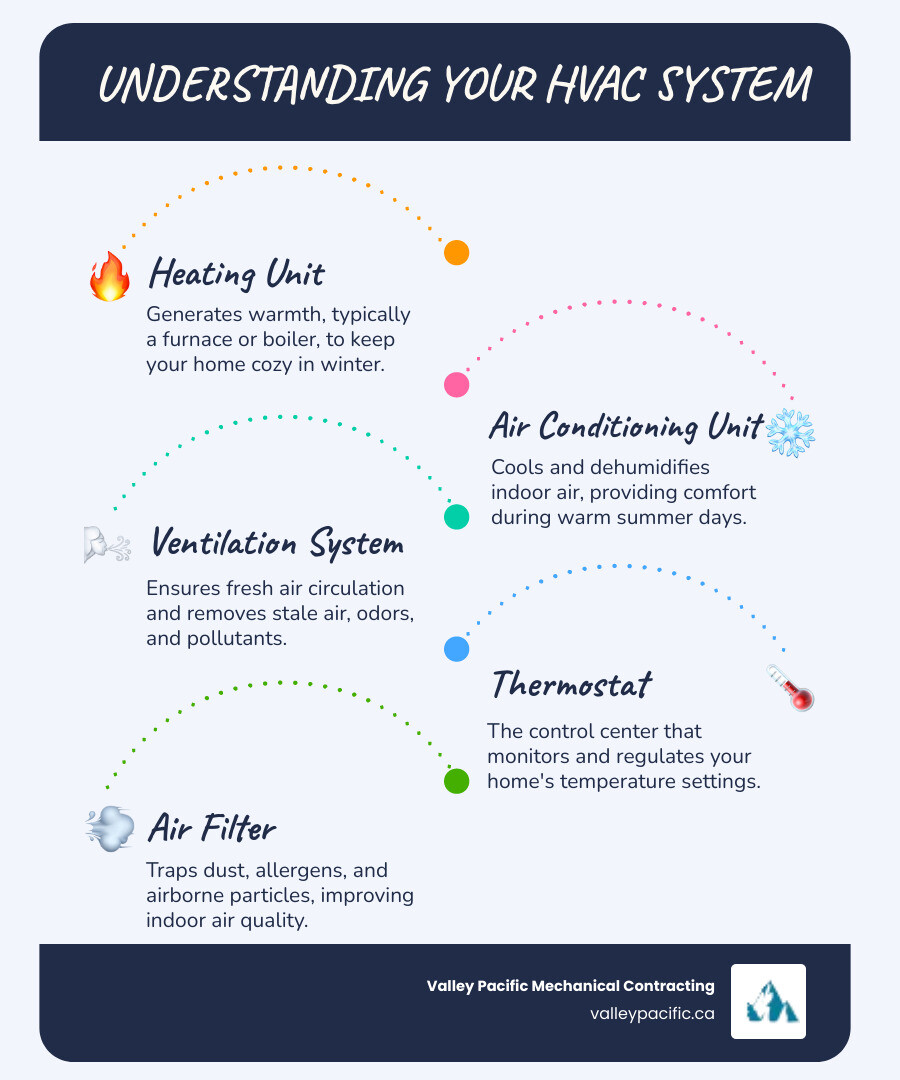
Simple HVAC services pitt meadows glossary:
Understanding Your HVAC Needs in the Pitt Meadows Climate
Pitt Meadows' climate presents unique challenges. Mild, rainy winters demand reliable heating, while warm, dry summers make air conditioning essential. Your HVAC system is a year-round partner in maintaining home comfort.
Energy efficiency is key in Pitt Meadows. An efficient system heats and cools your home faster with less effort, leading to lower utility bills, fewer repairs, and a smaller environmental footprint. It also ensures consistent comfort without hot or cold spots. The right system works smarter, not harder, extending the life of your equipment and ensuring it’s ready to perform when you need it most.
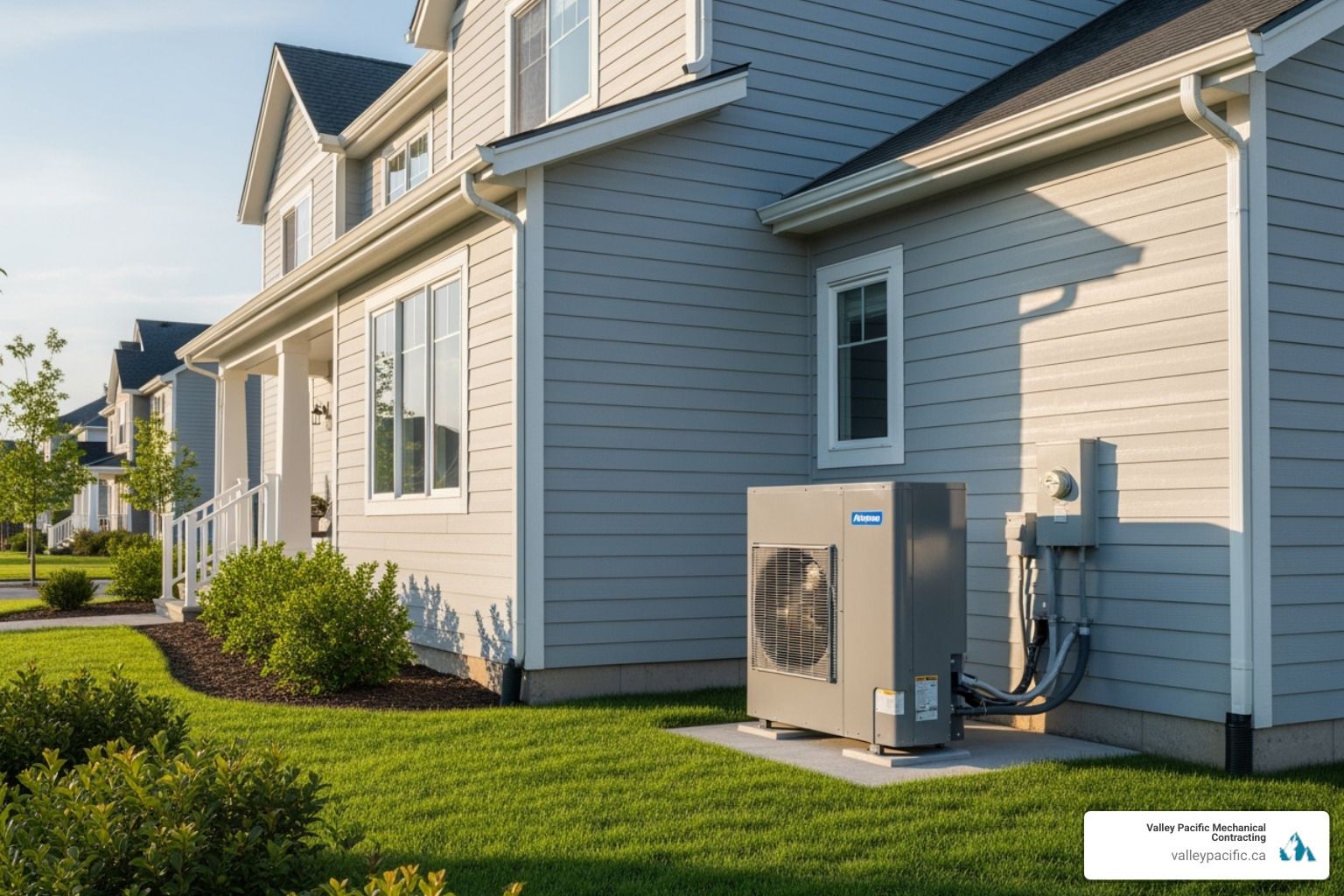
Suitable HVAC Systems for Local Homes
Not every HVAC system handles Pitt Meadows' climate equally well. Some are perfectly suited to our needs.
High-efficiency furnaces are the gold standard for our rainy winters, providing even, cozy heat. If you're wondering which model is best, our guide on How Do I Choose The Right Furnace For My Home In Pitt Meadows BC can help. When you're ready, we handle Furnace Installation Pitt Meadows BC from start to finish.
Central air conditioners are increasingly necessary for our warm summers. A properly sized central AC system cools, dehumidifies, and circulates fresh air, creating a perfect indoor oasis.
Heat pumps are remarkably energy-efficient, as they transfer heat rather than generating it. They are ideal for our mild winters, providing both heating and cooling in one unit.
Ductless mini-splits offer flexible, room-by-room climate control, perfect for homes without ductwork, additions, or for targeted comfort.
Boilers provide steady, radiant heat that feels gentler than forced air. We offer expert Boiler Installation Pitt Meadows BC to keep your home perfectly warm.
Choosing the right system depends on your home's size, insulation, and your preferences. Our team helps you steer these decisions, ensuring you get HVAC services pitt meadows residents can count on.
Benefits of a New AC Unit
If your air conditioner is struggling, consider the benefits of a new unit.
Improved energy efficiency is a top priority. Modern AC units use far less electricity than older models, translating to significant, long-term savings on your utility bills.
Improved indoor comfort goes beyond just cooling. New ACs provide consistent temperatures, eliminating hot spots, and manage humidity better, making your home feel truly comfortable.
Quieter operation is a real benefit. Newer models run so quietly you'll barely notice them, creating a more peaceful home environment.
A new unit also brings warranty protection and peace of mind, as you're investing in years of reliable service backed by manufacturer guarantees.
Finally, upgrading your AC system increases your home's value, signaling a well-maintained home to prospective buyers. When you're ready, our team specializes in Air Conditioning Installation Pitt Meadows BC, ensuring a proper installation from day one.
Is Your System Calling for Help? Common HVAC Issues
Your HVAC system will show signs of wear over time. Recognizing these early warnings can save you from discomfort and costly emergency repairs, as most major breakdowns are preceded by clear warning signs.

Rising energy bills are a common red flag. A sudden spike in utility costs often means your system is working too hard due to an internal issue and needs service.
Poor airflow or weak ventilation from your vents can be caused by a clogged filter, a failing blower motor, or blocked ducts, preventing your system from working effectively.
Frequent cycling on and off, or short cycling, puts stress on your system. It may indicate a dirty filter, thermostat issues, or an improperly sized system.
Strange noises like rattling, banging, or squealing indicate loose or failing parts. Ignoring them can lead to major mechanical failure.
Unpleasant odors can signal real problems. A musty smell suggests mold, while a burning odor could mean dust or electrical issues. If you smell gas, shut down your system immediately and call for emergency HVAC services pitt meadows.
Telltale Signs for Repair or Replacement
Deciding whether to repair or replace your system can be tough, but some clear indicators can help.
System age is a key factor. Furnaces last 15-20 years and ACs/heat pumps 10-15 years. As systems age, repairs become more frequent and costly, making replacement a better long-term investment.
If you're calling for frequent repairs (more than once a year), the costs can add up. A new, efficient system may be more economical.
Inconsistent cooling or heating and uneven temperatures throughout your home often point to significant issues where replacement is a more practical solution than repair.
Refrigerant leaks in AC units are problematic. If your unit needs regular refrigerant top-ups, it has a leak that can harm the environment and reduce efficiency, often indicating broader issues.
Our team is ready to help with Furnace Repair Pitt Meadows BC and Boiler Repair Pitt Meadows BC, providing honest advice on whether to repair or replace.
The Importance of Proactive Care for your HVAC services pitt meadows
Regular maintenance is the best investment you can make in your heating and cooling systems.
Extended system lifespan is a major benefit. Regular maintenance helps your furnace last up to 20 years and your AC up to 15 years by catching small issues before they become major problems.
Improved efficiency means lower bills. A clean, well-adjusted system runs more efficiently, and the annual savings can be substantial.
Fewer breakdowns are another key advantage. Proactive maintenance significantly reduces the risk of unexpected failures, especially during extreme weather.
Better air quality is an immediate benefit. Cleaning filters and coils removes dust, pollen, and allergens, which is especially important for families with allergies or asthma.
Safety is non-negotiable. During maintenance, we check for gas leaks and carbon monoxide risks, ensuring your system is not a hazard to your family.
We recommend scheduling maintenance twice a year. For comprehensive care, our Heat Pump Service Pitt Meadows BC keeps your system performing at its best.
Your Guide to Professional HVAC services pitt meadows
When your HVAC system fails, you need a trusted partner. Professional HVAC services pitt meadows offer comprehensive solutions, including proactive maintenance, emergency repairs, and expert installation to ensure year-round comfort.
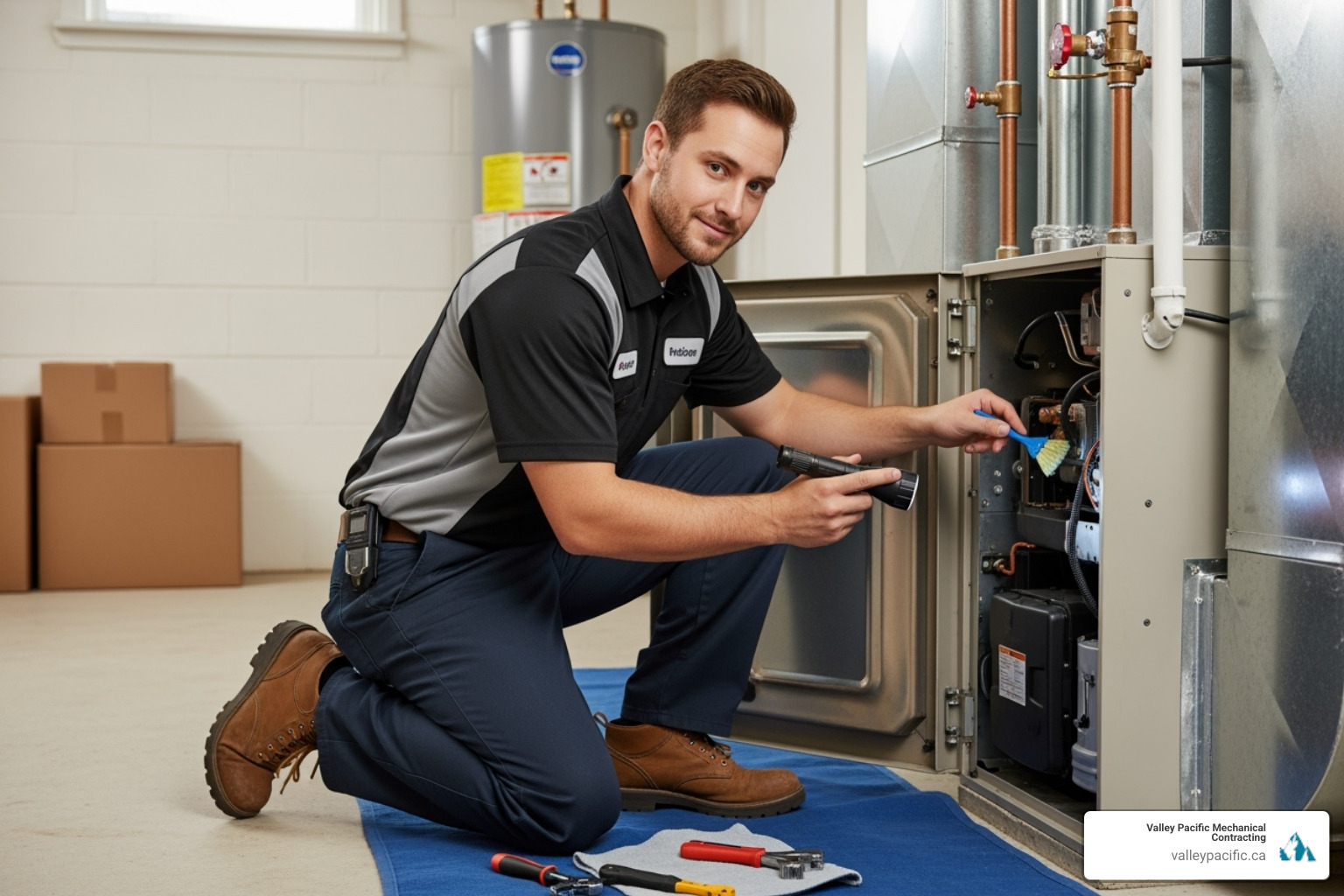
With over 30 years serving the Lower Mainland, including Pitt Meadows, we know what challenges our local climate presents. We tailor our services to match your specific needs and ensure your system operates at peak performance.
What's Included in a Comprehensive Maintenance Plan
A maintenance plan is like a health checkup for your HVAC system, essential for its efficiency and longevity. Our technicians perform a thorough inspection, not just a quick look. Our plan includes a full system inspection, filter replacement (typically every 1-3 months), coil cleaning, electrical and safety checks, lubrication of moving parts, refrigerant level verification, thermostat calibration, and performance testing. This thorough process is designed to catch small issues before they become expensive emergencies.
Regular servicing, ideally before peak heating and cooling seasons, is your best defense against unexpected breakdowns. Our Air Conditioning Service Pitt Meadows BC exemplifies the detailed care we bring to every maintenance visit.
Choosing the Right HVAC Provider
Finding the right HVAC provider is about building a relationship with a team you trust with your family's comfort and safety.
Licensing and certification are non-negotiable. Ensure your provider is licensed with Technical Safety BC and employs certified technicians. This guarantees they have the proper training for safe and correct work.
Customer reviews and reputation offer insight into a company's quality and reliability. Look for consistent praise regarding punctuality, clear communication, and quality workmanship.
A solid warranty and guarantee program shows a company's confidence. We offer a Fixed-Right Guarantee and, for qualifying installations, the Daikin Comfort Promise for additional peace of mind.
Comprehensive services are convenient. Choosing a provider that handles all your HVAC needs means you have a single, trusted team that understands your home's entire system.
24/7 emergency availability is a necessity. HVAC emergencies don't keep business hours. Our team is always ready to respond when your comfort is on the line.
Local expertise is invaluable. A provider familiar with Pitt Meadows understands our climate, building codes, and common issues, leading to better, faster service. Our 30+ years of experience translates into solutions customized for our community.
For more insights, our HVAC Services Pitt Meadows Guide offers additional guidance. We are committed to a headache-free experience built on expertise and reliability.
Frequently Asked Questions about Pitt Meadows HVAC
We love hearing from our Pitt Meadows neighbors. Here are answers to some of the most common questions we receive about home comfort systems.
What's the difference between an HVAC system and an AC unit?
HVAC stands for Heating, Ventilation, and Air Conditioning. It's the complete system that manages your home's climate year-round. An AC unit is just the air conditioning component of that larger system, responsible only for cooling. While every AC unit is part of an HVAC system, the HVAC system itself also includes heating and ventilation to keep you comfortable in every season.
How can I make my HVAC system more energy-efficient?
Improving your system's efficiency saves money and is better for the environment. Here are a few key ways:
- Regular maintenance is the most effective way to boost efficiency. A clean, well-calibrated system uses less energy.
- Smart thermostats learn your schedule and automatically adjust temperatures, saving energy without you thinking about it.
- Sealing air leaks around windows, doors, and in your ductwork prevents conditioned air from escaping, so your system runs less.
- Routine filter changes every one to three months prevent clogged filters from restricting airflow and forcing your system to work harder.
- Upgrading to a high-efficiency model can dramatically reduce energy use if your system is older. For businesses, investing in energy-efficient HVAC services pitt meadows solutions also reduces operational costs and improves indoor air quality.
Why is regular HVAC maintenance so important?
Regular maintenance is one of the best things you can do for your HVAC system, your budget, and your family's safety.
- Preventing breakdowns: Maintenance helps prevent inconvenient and expensive breakdowns by catching small issues before they escalate, especially during extreme weather.
- Improved efficiency: A well-tuned system runs more efficiently, leading to lower energy bills. The savings can often cover the cost of the maintenance itself.
- Extended system lifespan: Proper care extends the lifespan of your equipment—up to 20 years for a furnace and 15 for an AC—delaying costly replacement.
- Safety: Maintenance includes essential safety checks for gas leaks and carbon monoxide emissions, protecting your family from potential hazards.
- Maintains indoor air quality: Cleaning filters and coils removes dust, allergens, and other pollutants, which is especially beneficial for those with allergies or asthma.
We recommend scheduling maintenance twice a year, before the heating and cooling seasons begin, to ensure your system is always ready when you need it most.
Your Partner for Year-Round Home Comfort
At Valley Pacific Mechanical Contracting, we believe your Pitt Meadows home should be a comfortable sanctuary year-round. We provide professional HVAC services pitt meadows with expertise and care to ensure your comfort in every season.
With over 30 years of experience in the Lower Mainland, we offer a 'headache-free' experience. You can trust us for timely, accurate service. Our comprehensive solutions include heating and cooling installation, emergency repairs, and proactive maintenance plans to keep your system running smoothly.
HVAC emergencies don't keep business hours, which is why we offer 24/7 emergency service. We're always a phone call away, ready to restore your comfort when you need it most.
We also stand behind our work with the Daikin Comfort Promise on qualifying equipment, ensuring your investment is protected. Whether you're upgrading to a high-efficiency furnace, installing a modern air conditioner, or scheduling a tune-up, our goal is to improve your living environment and give you peace of mind.
Our team takes pride in transparent communication and building lasting relationships within our community. We're not satisfied until you're completely comfortable in your home.
Ready to experience the Valley Pacific difference? Contact us for your furnace installation needs and let us help you create the perfect indoor climate for your Pitt Meadows home.
Why Expert Heat Pump Installation Matters for Your Home
Expert heat pump installation is the foundation of a reliable, efficient heating and cooling system that will serve your home for years to come.
Key Elements of Expert Installation:
- Proper System Sizing - Manual J load calculations ensure your heat pump matches your home's exact needs
- Certified Technicians - NATE or manufacturer-certified installers follow industry best practices
- Quality Connections - Leak-free refrigerant lines and correct electrical work prevent future failures
- Code Compliance - All work meets local building codes and safety regulations
- Thorough Testing - Complete system commissioning and calibration before handoff
- Warranty Protection - Manufacturer warranties often require professional installation
Heat pumps are highly energy-efficient because they transfer heat instead of generating it. However, this efficiency is lost if the unit isn't installed correctly. Every step, from sizing to electrical work, requires professional expertise to prevent underperformance and premature failure.
A modern heat pump can cut your heating and cooling costs by up to 50%, provide year-round comfort from a single unit, and last 10-15 years. But these benefits are only achievable with a proper installation from day one.
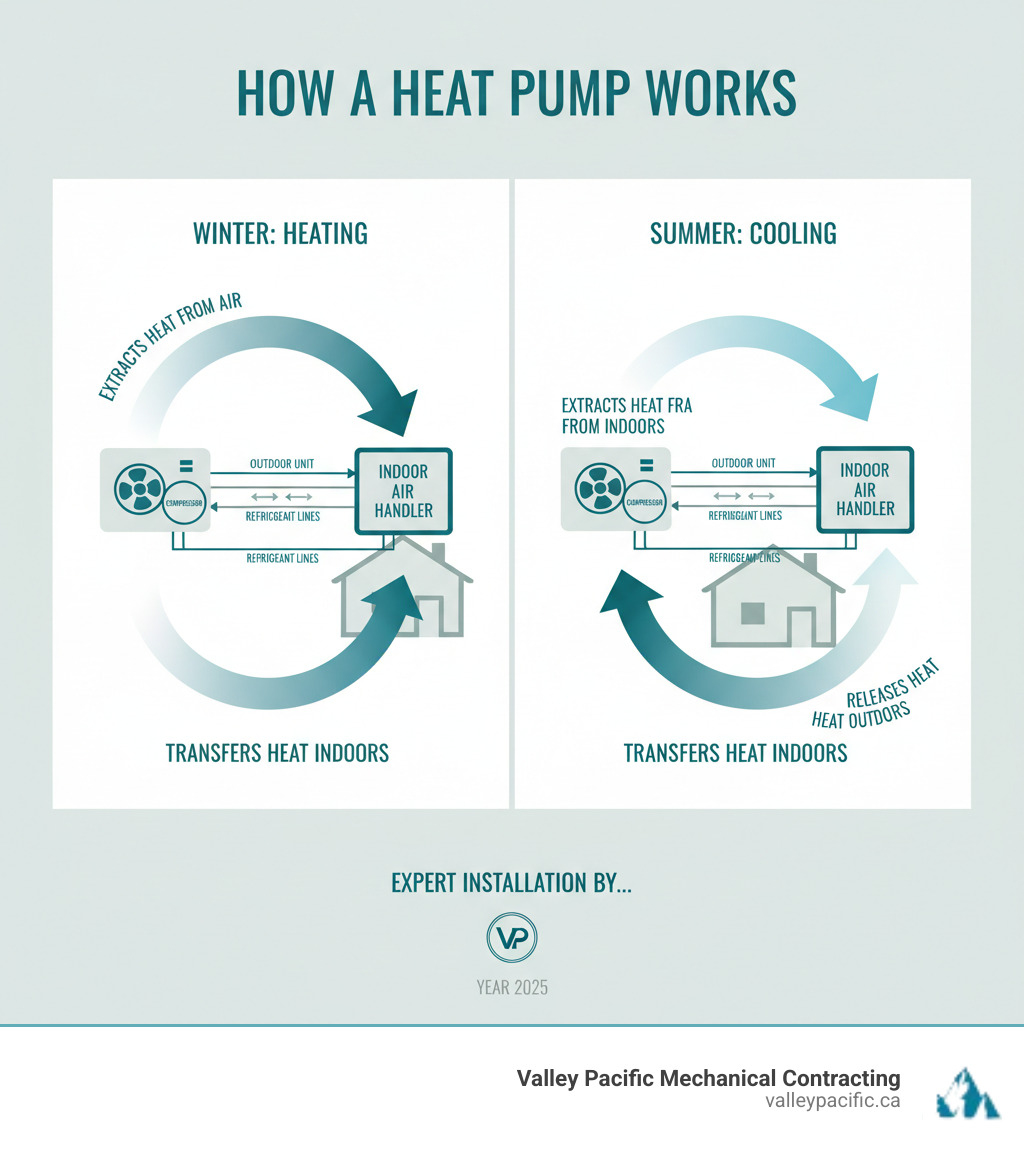
Expert heat pump installation glossary:
The Best Benefits of a Modern Heat Pump System
Heat pumps are changing how homeowners think about heating and cooling, offering benefits that go far beyond just keeping you comfortable year-round.
Heat pumps are an all-in-one solution, replacing separate furnaces and air conditioners. This means less equipment, simpler maintenance, and unified comfort year-round.
Energy savings are significant. By transferring heat instead of creating it, heat pumps can reduce heating and cooling costs by up to 50% compared to older systems.
This efficiency also means a reduced carbon footprint. Since they don't burn fossil fuels and use less electricity, heat pumps are an eco-friendly choice for your home.
Many people are surprised by the improved indoor air quality. Heat pumps filter and dehumidify the air, removing moisture and airborne particles, which is a major benefit for those with allergies or respiratory issues.
You'll also appreciate the quiet operation. Modern heat pumps provide powerful heating and cooling without the disruptive noise of older furnaces.
Homeowners across the Lower Mainland are upgrading to modern heat pumps for consistent comfort, cleaner air, and lower energy bills. With expert heat pump installation and available government incentives, there's never been a better time to make the switch. To learn more, explore these resources: Consider Heat Pump Installation Reasons and our HVAC System Upgrades Complete Guide.
Preparing for Your Installation: Key Factors for Homeowners
A successful heat pump installation depends on choosing the right system for your unique home. That's why a proper expert heat pump installation begins with a comprehensive home assessment. We evaluate your current HVAC setup, home layout, and insulation to match you with the perfect system for your needs and the Lower Mainland climate.
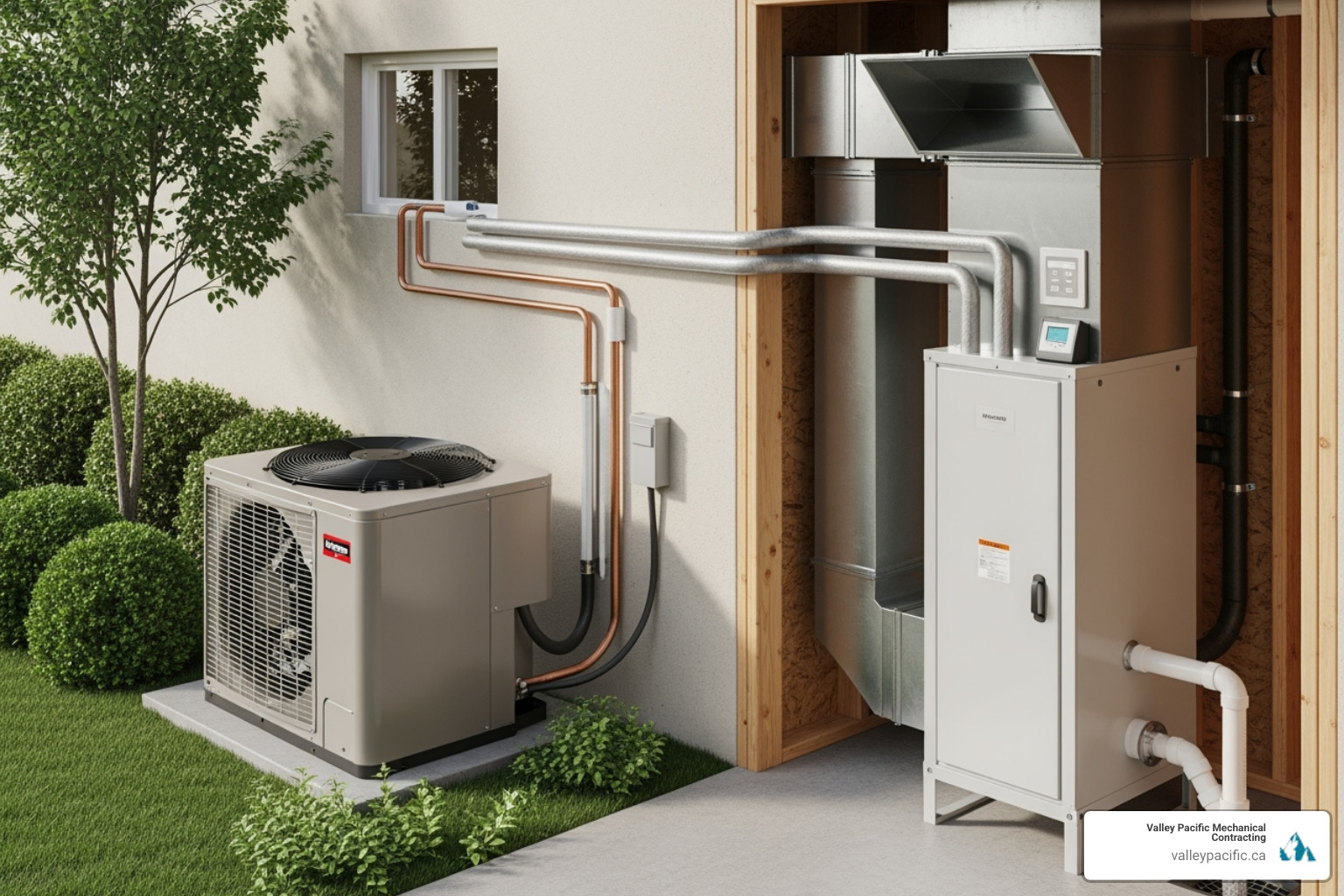
Understanding Heat Pump Types
Heat pumps come in several varieties, and choosing the right one is key to your comfort and energy bills.
Air-source heat pumps are the most popular choice, transferring heat between your home and the outside air. Modern cold-climate models are highly effective, keeping homes warm even in freezing temperatures.
Geothermal heat pumps use the stable temperature of the earth for best efficiency and low operating costs. While the initial investment is higher, they are ideal for long-term homeowners.
Ductless mini-split systems are perfect for homes without ductwork or for zoned heating and cooling. An outdoor unit connects to one or more indoor units, allowing for independent temperature control in different rooms.
Hybrid systems pair an electric heat pump with a gas furnace, intelligently switching between the two for optimal efficiency and reliability in all temperatures. Our guide on Residential Heat Pump solutions can help you explore which type suits your lifestyle best.
Sizing and Efficiency Ratings Explained
When it comes to heat pumps, bigger isn't better. An improperly sized unit, whether too large or too small, will cause problems.
We use a Manual J load calculation—the industry gold standard—to determine the correct size for your home. This analysis considers factors like square footage, insulation, windows, and occupancy to ensure optimal performance.
Two efficiency ratings are key: SEER2 (cooling) and HSPF2 (heating). Higher numbers mean greater efficiency and lower energy bills.
An oversized unit will short-cycle, causing uneven temperatures and premature wear, while an undersized unit will run constantly without reaching the desired temperature. Both waste energy and money. That's why we take sizing seriously—you can read more about this in our article on Why AC Sizing Matters for Installation.
Home and Climate Considerations
Your home's characteristics and our local climate are crucial in selecting the best heat pump.
Cold climate performance is vital in the Lower Mainland. Modern heat pumps are engineered to heat efficiently down to -15°C or lower, with some models including supplemental heat for extreme cold snaps.
Your electrical panel capacity must be sufficient to handle the new system. We'll assess your panel and advise if an upgrade is needed. A federal tax credit can help cover the cost of panel upgrades done with a heat pump installation.
We perform a thorough ductwork inspection to check for leaks or blockages that waste energy. If your home lacks ducts, ductless mini-splits are an excellent alternative.
Home insulation quality is key to efficiency. A well-insulated home allows your heat pump to work less and save more energy. We'll evaluate your insulation during our assessment.
Where you place your heat pump components also affects performance. Our guide on Best Locations for Heat Pump Placement covers this important topic.
The Critical Importance of an Expert Heat Pump Installation
An expert heat pump installation is more than just placing equipment; it's the foundation for years of reliable comfort and energy savings. The difference between a quick job and a quality installation is significant, and it's where professional experience is vital.
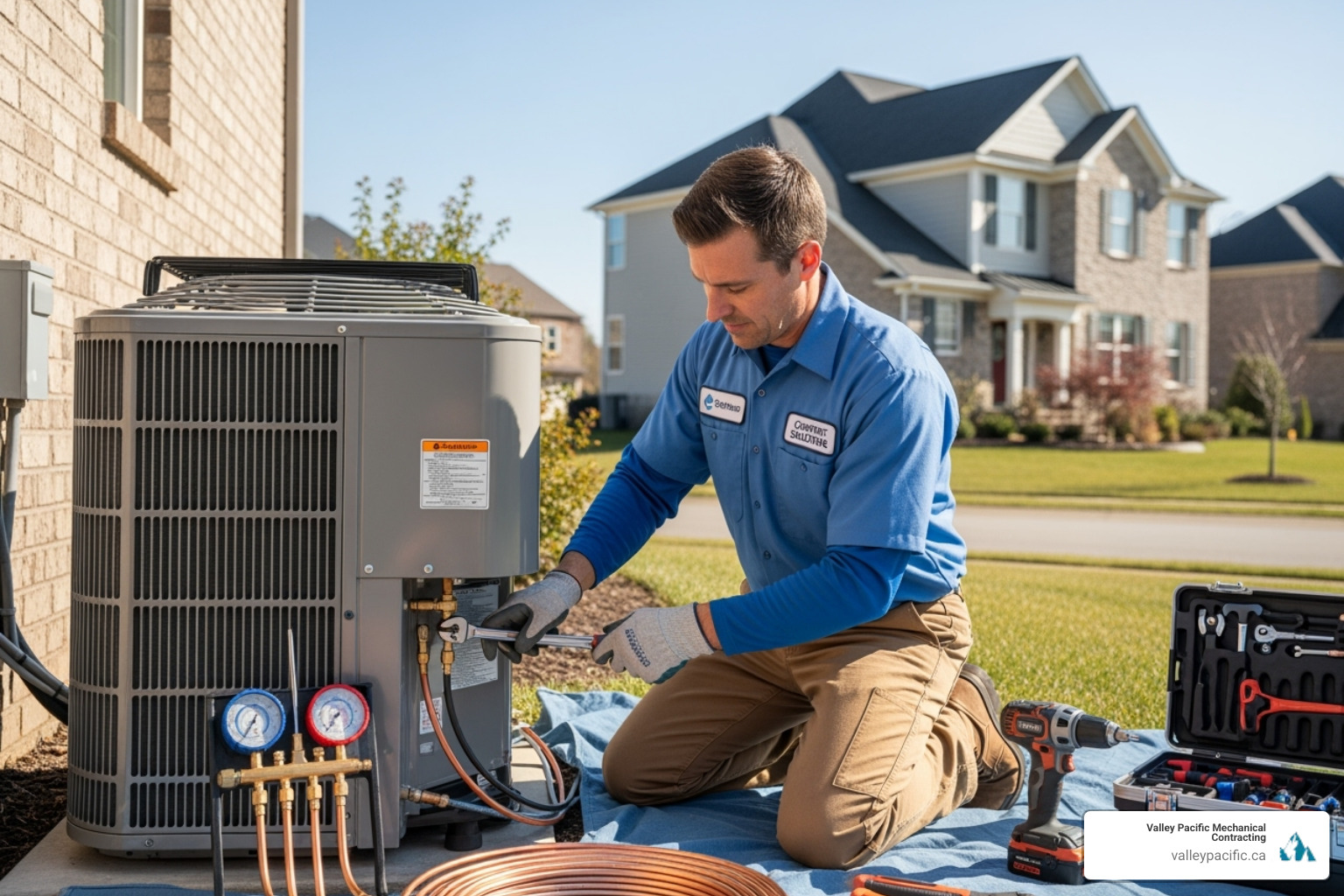
Why an Expert Heat Pump Installation is Non-Negotiable
Even the most advanced heat pump will underperform if not installed correctly. All its benefits depend on a proper installation.
Maximizing efficiency: Proper installation with precise refrigerant calibration and optimized airflow ensures your system operates at its peak rated efficiency, delivering maximum energy savings.
Preventing premature failure: A professional installation can help your system last 12 to 20 years. Cutting corners leads to early breakdowns and costly repairs.
Ensuring safety: Heat pumps involve high-voltage electricity and refrigerants. Professional installation adheres to strict safety protocols to prevent hazards like electrical faults or leaks.
Adhering to local codes: Our certified technicians ensure your installation complies with all local building codes and environmental regulations in Maple Ridge, Langley, and Mission.
Protecting your investment: Most manufacturer warranties are void without professional installation. This protects you from paying for repairs that should be covered. Resources like the Find a trusted Heat Pump Champion Advocate emphasize choosing quality professionals. Our meticulous approach to HVAC System Design ensures every component works together seamlessly.
The Step-by-Step Process of an Expert Heat Pump Installation
Our expert heat pump installation follows a systematic process to ensure quality and a headache-free experience.
- Initial Site Assessment: We examine your home's layout, insulation, ductwork, and electrical system to determine its specific needs.
- Old System Removal: We safely disconnect, remove, and properly dispose of your old equipment and refrigerants.
- Outdoor Unit Placement: We install the outdoor unit on a stable, level pad with proper clearance for airflow and maintenance.
- Indoor Air Handler Installation: The indoor unit is positioned for optimal performance, whether in a closet, attic, or as a wall-mounted ductless unit.
- Refrigerant and Electrical Line Connection: We run and seal refrigerant lines to be leak-free and make all electrical connections safely and to code.
- Ductwork Modifications: If needed, we seal leaks or resize ducts to ensure efficient airflow.
- Rigorous Testing and Calibration: We test refrigerant levels, airflow, and all functions, calibrating the system for peak performance.
- Homeowner Orientation: We walk you through your new system's operation and maintenance.
Most installations wrap up within one to two days.
Telltale Signs of an Incorrectly Installed Heat Pump
An incorrectly installed heat pump will cause problems. Here are the warning signs:
- Uneven temperatures: Rooms are too hot or too cold, often due to improper sizing or ductwork issues.
- Frequent short cycling: The system turns on and off rapidly, indicating an oversized unit or wiring problems.
- Strange noises: Grinding, banging, or hissing can signal loose parts or refrigerant issues.
- Higher-than-expected energy bills: If your bills don't drop, the system isn't running efficiently, often due to poor installation.
- Refrigerant leaks: Look for ice on the outdoor unit or reduced performance. Leaks damage the system and harm the environment.
- Poor airflow: Weak airflow from vents suggests ductwork problems or an improperly installed indoor unit.
If you notice these signs, have a qualified technician inspect your system. Our guide on Signs your Heat Pump needs Repair can help.
Long-Term Care: Heat Pump Lifespan, Maintenance, and Replacement
An expert heat pump installation is the first step. Proactive care is key to ensuring your system provides reliable performance and a long lifespan.
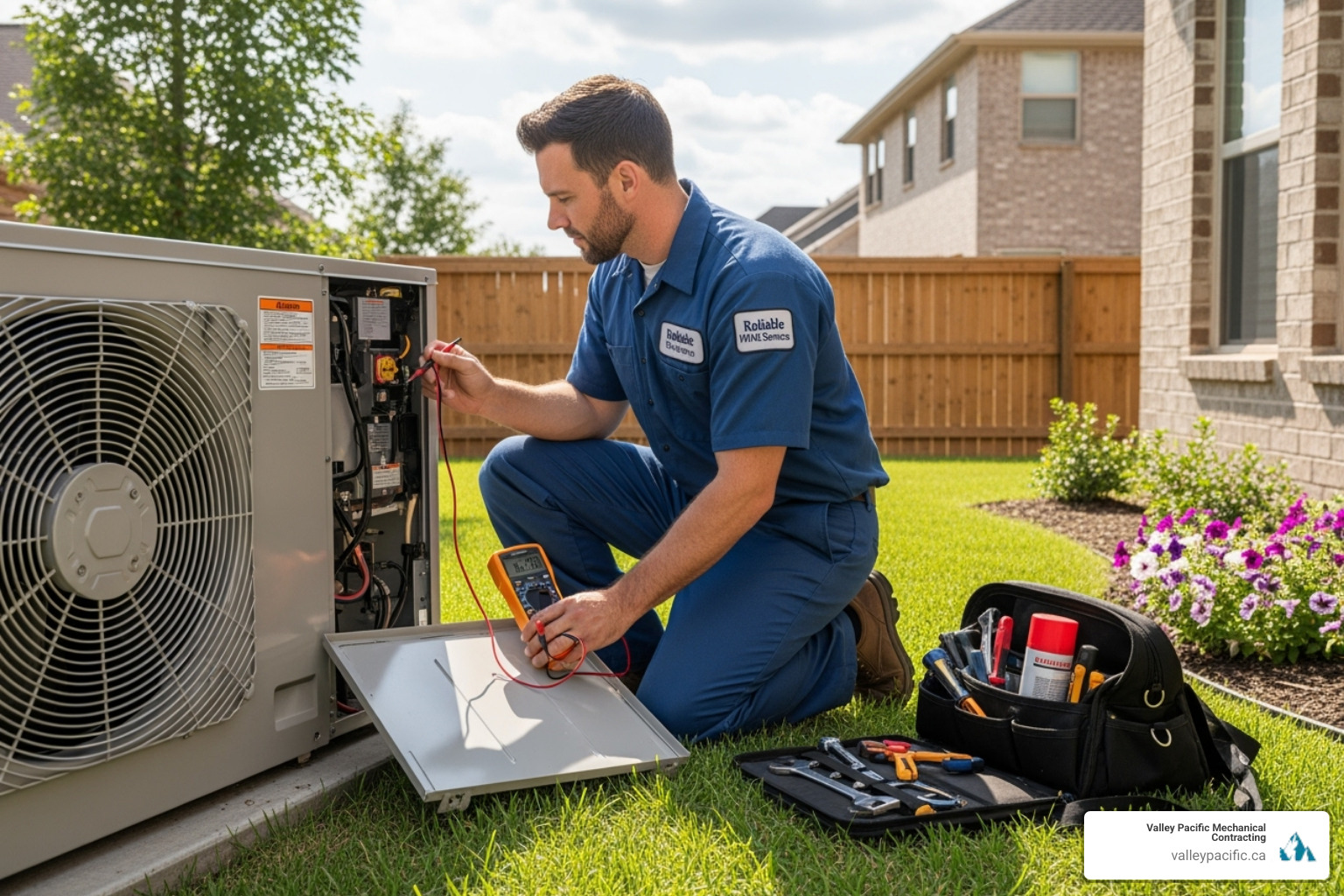
Extending the Life of Your Heat Pump
A well-maintained heat pump can last 10 to 15 years or more. The key is consistent, proactive care.
Annual professional servicing is essential. A yearly checkup allows technicians to clean components, check refrigerant levels, and catch minor issues before they become major, expensive problems.
Between professional visits, you can perform simple DIY tasks. Change air filters every 1-3 months to maintain airflow and efficiency. Also, keep the outdoor unit clear of leaves, snow, and debris, ensuring at least two feet of clearance.
Pay attention to unusual noises or performance changes, as catching issues early saves money. For more guidance, see our Seasonal Heat Pump Maintenance Tips and comprehensive Heat Pump Maintenance guide.
When to Repair vs. When to Replace Your System
Deciding whether to repair or replace an aging heat pump can be tough. Here are key factors to consider:
- Age: If your unit is over 10-15 years old, a replacement will offer far greater efficiency (higher SEER2 and HSPF2 ratings), leading to lower energy bills.
- Frequent repairs: If repair costs are mounting, investing that money in a new, reliable system with a warranty is often more cost-effective.
- Declining efficiency: Rising utility bills or uneven heating and cooling are signs your old unit is losing efficiency. A new system can pay for itself in energy savings.
- Obsolete technology: Modern heat pumps feature advanced cold-climate performance and variable-speed compressors for better comfort and efficiency than older models.
- Major component failure: If a critical part like the compressor fails, the repair can be very expensive. Replacement is often the smarter financial choice for an older unit.
We provide honest assessments to help you make a confident decision. Our goal is to provide the information you need, whether it leads to a repair with our Expert Heat Pump Repair Services or a replacement. Our guide on Is Your Old AC Ready for Replacement offers more insights.
Frequently Asked Questions about Heat Pump Installation
Here are answers to the most common questions we receive about heat pump installation.
How does a heat pump installation differ from a traditional furnace or AC?
A heat pump installation has a few key differences from traditional furnace or AC installations.
- All-in-one system: A heat pump handles both heating and cooling, potentially replacing both your furnace and air conditioner with a single, streamlined unit.
- Outdoor unit requirement: Like an air conditioner, a heat pump has an outdoor component. This is a new consideration if you're transitioning from furnace-only heating.
- Refrigerant lines: These lines connect the indoor and outdoor units, transferring heat to provide both heating and cooling.
- Potential electrical work: Heat pumps run on electricity, so your electrical panel may need an upgrade. A federal tax credit is available through 2032 to help with this cost.
- Reversing valve function: This component is unique to heat pumps. It changes the direction of refrigerant flow, allowing the system to switch between heating and cooling. This versatility is what makes an expert heat pump installation a smart investment.
Are modern heat pumps effective in cold climates like the Lower Mainland?
Yes. While older models struggled in the cold, modern heat pumps are engineered to perform exceptionally well in climates like the Lower Mainland.
- Cold-climate technology: Today's technology allows modern units to extract heat from outside air even when it's well below freezing, operating efficiently down to -15°C or colder.
- Variable-speed compressors: These compressors adjust their output to precisely match your home's needs, maintaining consistent comfort while using less energy.
- Supplemental heat sources: For rare, extremely cold days, many heat pumps can be paired with supplemental heat sources, like built-in heat strips or a hybrid furnace setup, ensuring your home always stays warm.
- High HSPF2 ratings: We recommend systems with high HSPF2 (Heating Seasonal Performance Factor 2) ratings, which indicate superior heating efficiency and year-round reliability in our climate.
What role does my existing ductwork play in a new heat pump installation?
Your home's ductwork is critical for distributing conditioned air, and its condition directly impacts your new heat pump's performance.
- Ductwork inspection: Before installation, we conduct a thorough ductwork inspection to identify any leaks, blockages, or damage that could compromise performance.
- Sealing leaks: Sealing leaks is crucial. Even small gaps can waste a significant amount of energy and reduce comfort by allowing conditioned air to escape.
- Ensuring proper size: We also verify that your ducts are the proper size for the new system. Undersized ducts restrict airflow, forcing the system to work harder and less efficiently.
- Airflow optimization: Part of an expert heat pump installation involves airflow optimization, which may include adjustments to ensure balanced comfort in every room.
- Ductless options: If your home has no ductwork or the existing system is in poor condition, ductless options like mini-split heat pumps are an excellent, highly efficient alternative.
Conclusion: Partner with the Experts for a Headache-Free Experience
Choosing an expert heat pump installation is an investment in your home's comfort, efficiency, and value. As we've covered, modern heat pumps offer incredible benefits, but they all depend on a high-quality installation.
Professional expertise is the difference between a system that performs flawlessly and one that causes constant problems. Proper sizing, correct connections, and adherence to codes are non-negotiable for preventing future repairs and maximizing performance.
For over 30 years, Valley Pacific Mechanical Contracting has served the Lower Mainland, including Mission, Maple Ridge, and Langley. Our certified technicians understand our local climate and provide a headache-free experience from start to finish. We back our work with the Daikin Comfort Promise and offer 24/7 emergency service.
Your home deserves the best. If you're ready to upgrade to a more efficient and reliable comfort system, we are here to guide you.
Ready to experience the difference that professional installation makes? Contact us for your expert heat pump installation in Maple Ridge today. Let's work together to create the comfortable, efficient home you've been dreaming of.
Why Every Langley Homeowner Needs a Trusted Plumbing Partner
When a pipe bursts at midnight or your shower runs ice cold, reliable plumbing services Langley homeowners can trust are essential. Your home's plumbing system works silently until something goes wrong, and when it does, you need help fast. Having access to licensed professionals can mean the difference between a quick fix and costly water damage. This guide covers everything Langley homeowners need to know about maintaining, repairing, and upgrading their plumbing.
Quick Answer: What Plumbing Services Are Available in Langley?
- Emergency Repairs - 24/7 response for burst pipes, flooding, and sewer backups
- Drain Cleaning - Professional clearing of clogs using hydro jetting and camera inspection
- Water Heater Services - Installation, repair, and maintenance for all tank types
- Fixture Work - Repair and installation of faucets, toilets, showers, and sinks
- Leak Detection - Finding and fixing hidden leaks before they cause damage
- Sump Pump Services - Installation and repair to prevent basement flooding
- Pipe Repair - Fixing frozen, burst, or corroded pipes throughout your home
- Commercial Plumbing - Specialized services for businesses and strata properties
For comprehensive HVAC and plumbing solutions in your area, explore our HVAC services in Langley or schedule a service call with Valley Pacific Mechanical today.
Langley's mix of older heritage homes and new developments presents a wide range of plumbing systems. Many local companies offer 24/7 emergency service, a necessity for unexpected problems. Whether you have a small leak or are planning a major renovation, understanding what professional plumbers offer helps you make smart decisions for your home.
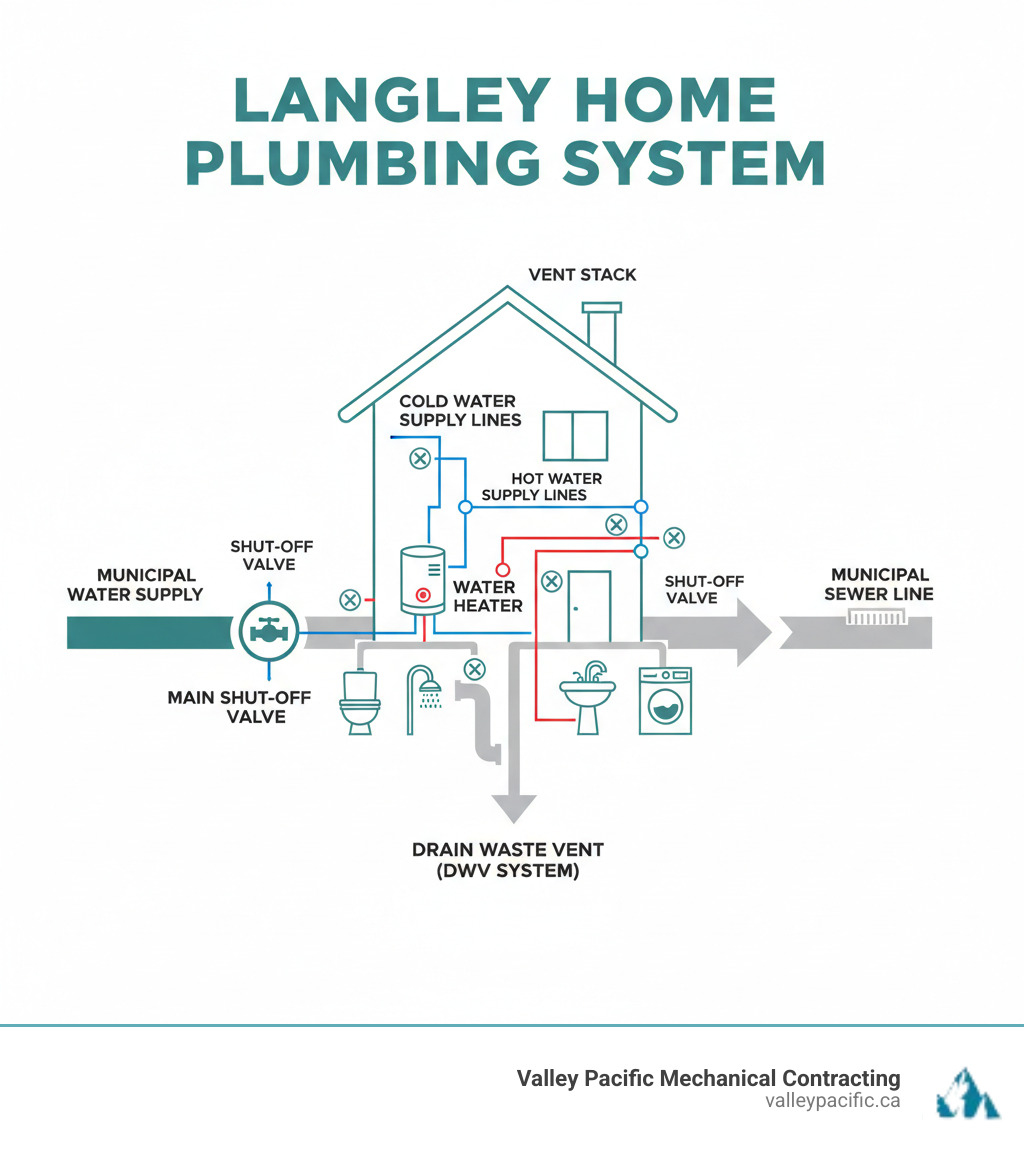
Plumbing services Langley helpful reading:
Common Plumbing Issues in Langley Homes
Plumbing problems can happen in any Langley home, from heritage farmhouses to new townhouses. The most common plumbing services Langley homeowners request are for leaky faucets, clogged drains, running toilets, and low water pressure. More serious issues include water heater problems and sump pump failures, which can be especially risky during Langley's rainy season. Older homes may have aging pipes, but even new homes require maintenance. Fortunately, most plumbing issues provide warning signs, allowing you to act before a disaster strikes.
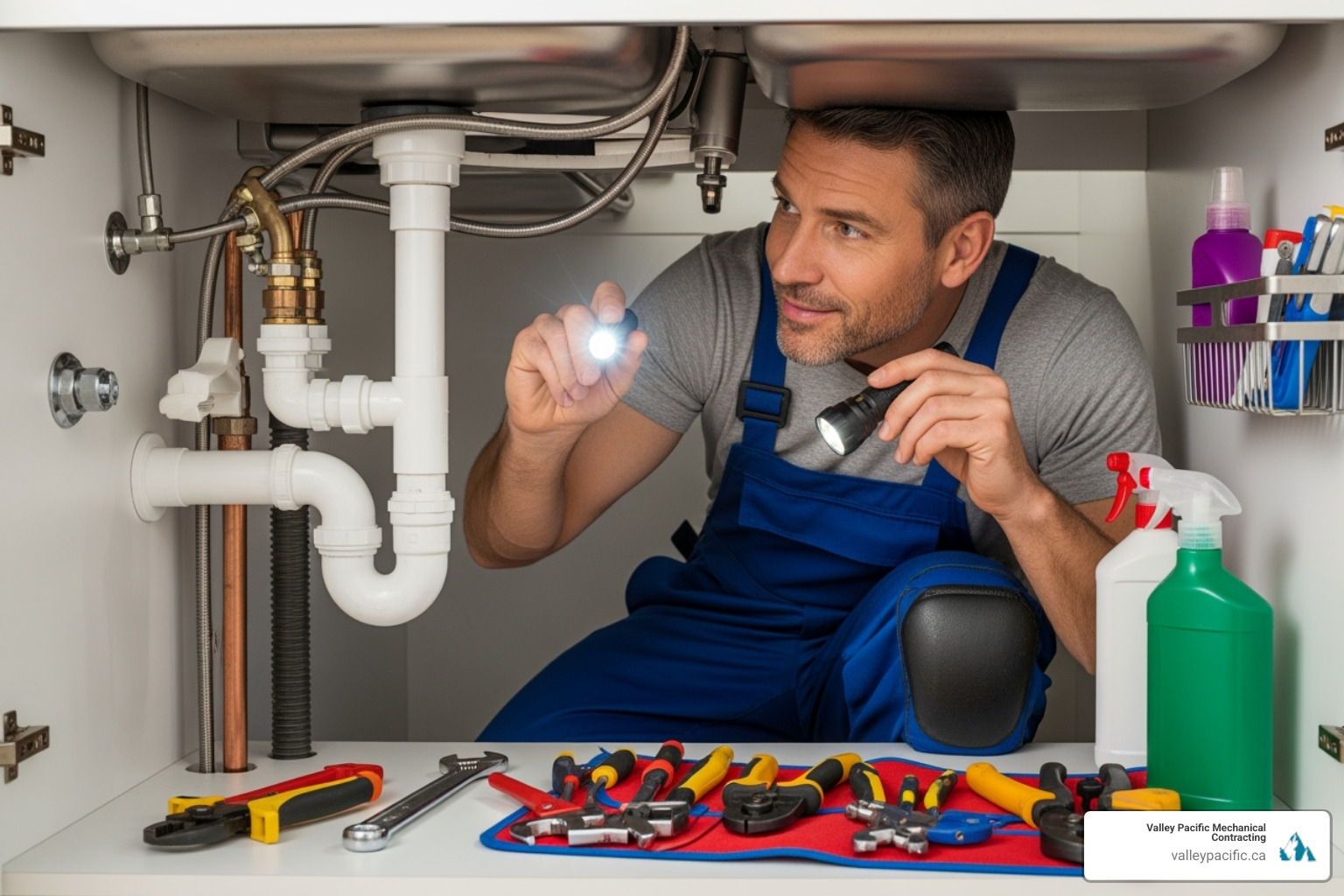
When to Call for Professional Drain Cleaning
When should you call a professional for a clogged drain? Watch for these signs: Slow drains in sinks or showers, strange gurgling sounds from pipes, foul odors from drains, or multiple clogged fixtures at once. The last sign often points to a main sewer line blockage that requires immediate attention. While DIY chemical cleaners offer a temporary fix, they can damage your pipes. Professional plumbing services Langley teams use safer, more effective methods like hydro jetting (high-pressure water) and camera inspections to clear clogs without harming your plumbing. More info about drain cleaning
Leaks, Drips, and Pipe Problems
A small drip is more than an annoyance; it's money down the drain. Faucet drips often need a simple washer replacement, while silent toilet leaks (check with food coloring in the tank) can waste huge amounts of water. The most dangerous are hidden pipe leaks behind walls or under floors, which cause water damage and mold. Look for water stains, musty smells, or a higher water bill. In winter, frozen pipes in unheated areas are a major threat. Freezing water expands and can lead to burst pipe risks, causing severe flooding. Addressing leaks promptly is key to protecting your home, much like regular HVAC maintenance. For more on home system care, see our guide on AC Repair Langley BC.
Water Heater and Sump Pump Malfunctions
Your water heater and sump pump are essential but often overlooked. Signs of water heater failure include no hot water, rusty water, or strange noises from the tank like popping or rumbling, which suggest sediment buildup. A typical water heater lifespan is 15-20 years; if yours is old and failing, replacement is often the best option. Your sump pump is crucial for basement flood prevention. Regular sump pump testing is vital—pour a bucket of water into the pit to ensure it activates and drains correctly. A failed pump during a storm can lead to costly flooding. Maintaining these appliances is as important as servicing your furnace. Learn more about system maintenance in our guide to Boiler Repair Langley BC.
A Full Spectrum of Plumbing Services in Langley
You need more than a handyman when your water heater quits on a Sunday morning. Trusted plumbing services Langley homeowners rely on cover everything from emergency repairs to routine maintenance and renovations. At Valley Pacific Mechanical Contracting, we offer a complete range of residential and commercial solutions. Our team arrives in fully stocked service vehicles, ready to handle any plumbing challenge, any time.
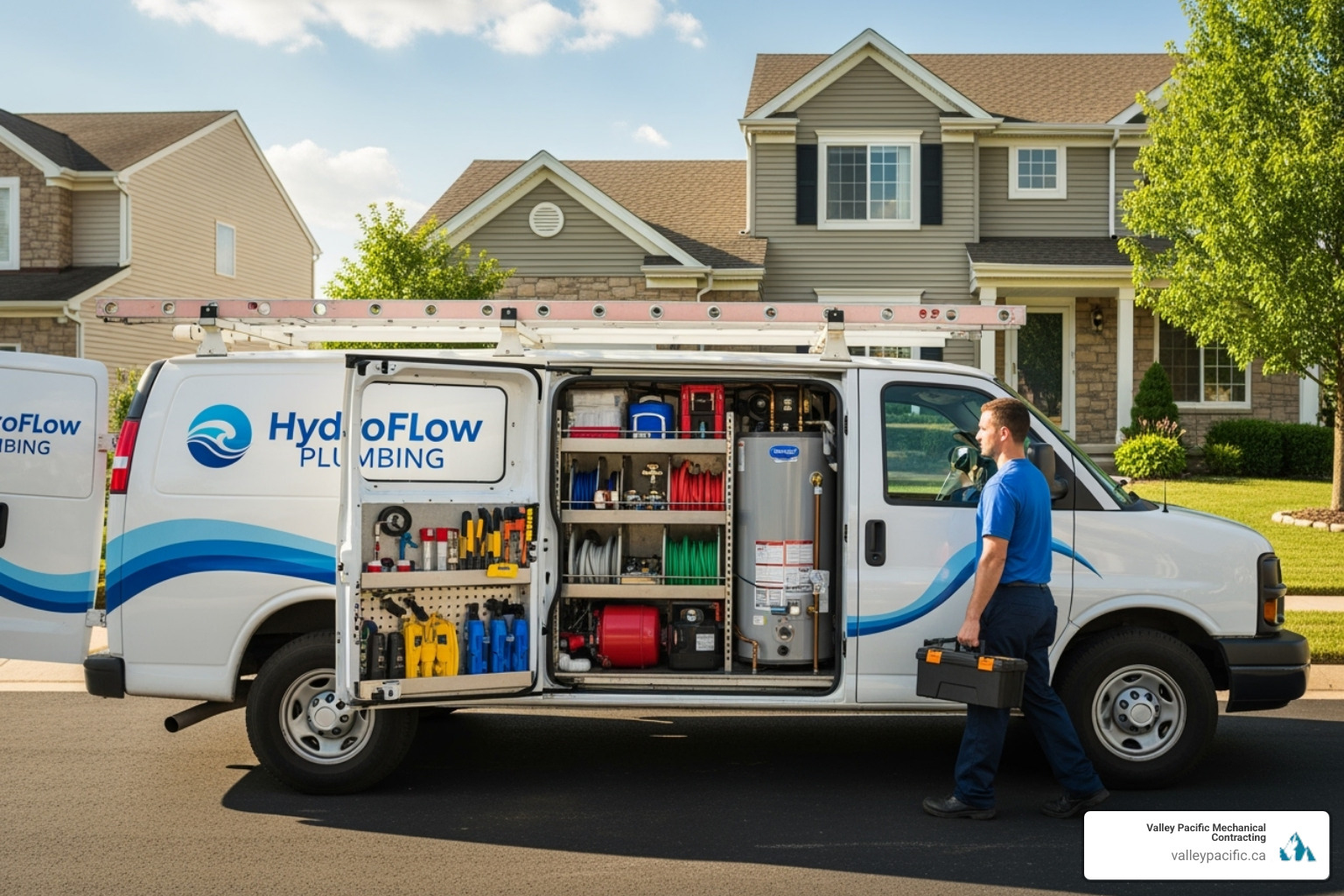
Residential Plumbing Solutions for Every Room
Our residential services cover every room in your home. In the bathroom, we handle fixture repair and installation, toilet repair, and shower valve replacement. In the kitchen, we offer sink, faucet, and garburator services. If you have aging pipes causing discolored water or low pressure, our pipe replacement services can restore your system. We also handle upgrades and installations to improve your home's value, applying the same precision as we do to our Furnace Installation Langley BC and AC Installation Langley BC services.
Specialized Commercial and Strata Plumbing
Commercial and strata properties have unique plumbing needs due to high usage and strict regulations. Our specialized plumbing services Langley businesses rely on include grease trap cleaning for restaurants, general maintenance for offices and retail spaces, and coordinated services for strata properties. We handle leak detection, pipe inspections, and mandatory backflow testing to protect the public water supply. We also offer custom preventative maintenance contracts to catch issues early, reduce downtime, and keep your property running smoothly. Our commercial plumbing integrates with our other HVAC Services Langley.
Finding a Reliable 24/7 Emergency Plumber
Plumbing disasters don't keep business hours, which is why 24/7 emergency availability is crucial for plumbing services Langley residents need. For issues like a burst pipe or sewer backup, you need a team that responds fast. At Valley Pacific Mechanical Contracting, we are available around the clock. While waiting for our arrival, you can minimize damage:
- Turn off your main water shut-off valve. Know its location before an emergency.
- Shut off electricity in flooded areas for safety.
- Contain the water with buckets and towels.
Our emergency team responds with urgency to protect your home, just as we do for heating emergencies like those requiring Heat Pump Repair Langley BC.
Choosing the Right Langley Plumber: A Homeowner's Checklist
Choosing the right plumber is critical for a smooth experience. You need a professional who works safely, correctly, and guarantees their work. Here's what to look for when selecting plumbing services Langley professionals.
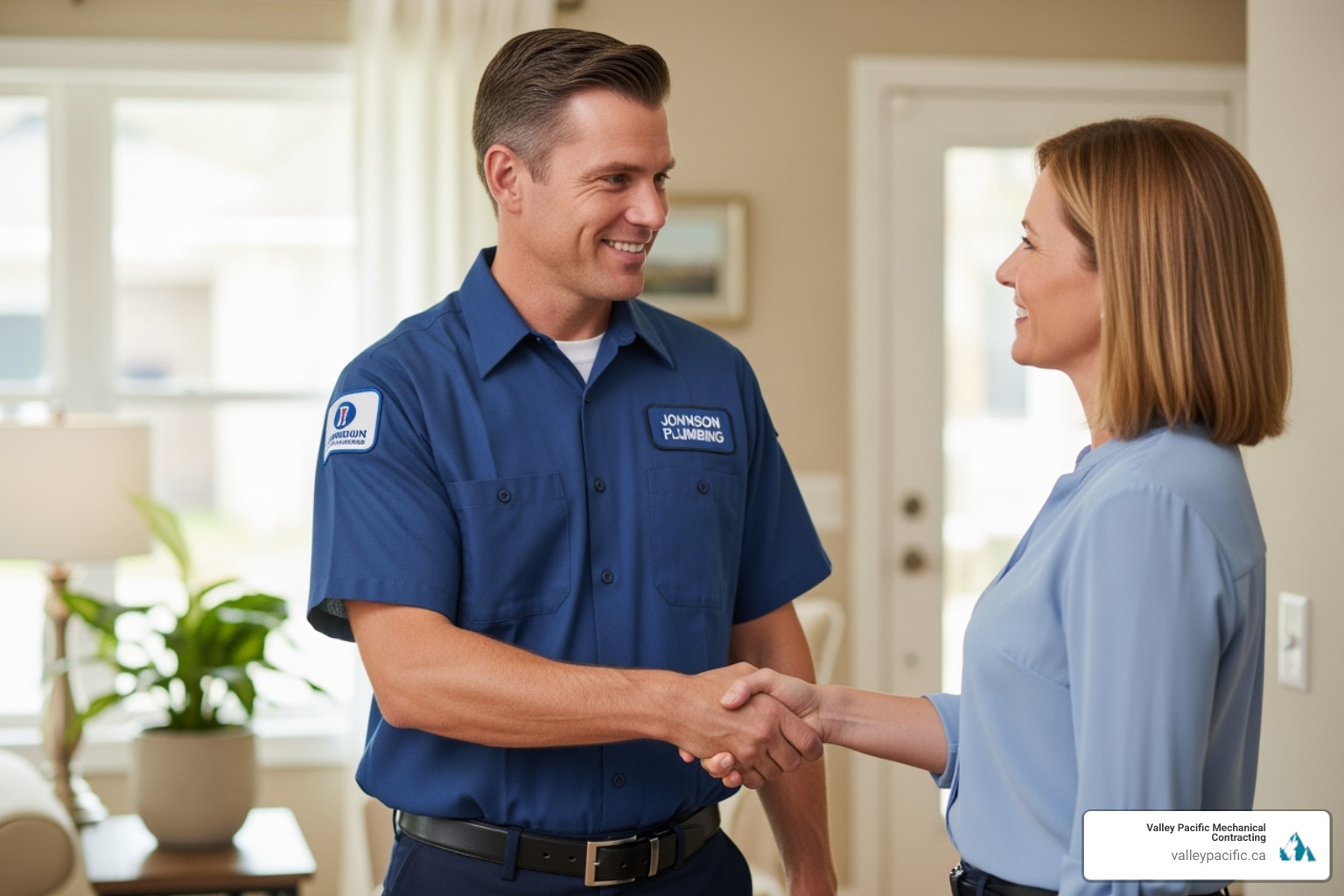
The Non-Negotiables: Licensing, Insurance, and Guarantees
These three items are the foundation of a trustworthy plumber.
- Licensing: This is non-negotiable. A licensed plumber understands local building codes and safety regulations, ensuring the work is done correctly and legally.
- Insurance: Liability insurance protects your home from accidental damage, while WorkSafeBC coverage protects you from liability if a worker is injured on your property.
- Guarantees: Look for companies that offer workmanship guarantees on repairs and installations. This shows they stand behind their work and are committed to your satisfaction.
Why Upfront Communication and Transparency are Key
Clear, honest communication is essential. A good plumber will explain the problem and your options in simple terms. Upfront pricing is also a key feature of the best plumbing services Langley has to offer. You should receive a clear, written quote before work begins, eliminating surprise charges. This transparency builds trust and ensures you know exactly what to expect.
Vetting Your Options: Experience and Reputation
Once you've confirmed the basics, look at a company's track record. Years in business and local expertise are important, as an experienced Langley plumber will understand the area's unique challenges. Check online reviews and customer testimonials to see what others say about their punctuality, cleanliness, and quality of work. Finally, don't underestimate word-of-mouth referrals from trusted friends and neighbors. Choosing a plumber with a solid reputation ensures you're partnering with a professional who cares about your home. For more tips on choosing home service providers, see our Langley Heat Pump Complete Guide.
Proactive Plumbing: Maintenance and Prevention
Proactive plumbing maintenance, much like a car's oil change, can save you from costly emergencies and stress. Homeowners who invest in regular care for their pipes and fixtures often avoid the headache of burst pipes and flooded basements. This preventative approach is just as important for plumbing as it is for your AC system. For more on this, see our AC Service Langley Ultimate Guide.
The Value of Regular Plumbing Maintenance
Waiting for a plumbing problem to appear is a risky strategy. Instead, plumbing services Langley professionals recommend annual inspections. During a maintenance visit, a technician inspects your entire system, including water pressure, pipes, valves, and your water heater. This proactive approach offers significant benefits: it extends the lifespan of your system, improves water pressure, and catches minor issues before they become costly emergencies. A small leak found early is a simple fix; found later, it could mean major water damage. Regular tune-ups help you avoid disasters and keep your home running smoothly, a philosophy we apply to all home systems. Learn more in our Heat Pump Service Langley Guide.
Simple Steps to Prevent Common Plumbing Problems
You can take simple steps to maintain your plumbing between professional visits.
- Practice proper drain care: Avoid pouring grease, oil, or fats down the sink. Use drain strainers to catch hair and food, and only flush human waste and toilet paper.
- Winterize outdoor faucets: Before the first freeze, shut off the water supply to outdoor taps and drain them to prevent pipes from bursting. Insulate any exposed pipes.
- Check for toilet leaks: Use the food coloring trick to spot silent leaks that waste water and money.
- Know your main water shut-off valve: Locate your main water shut-off valve and learn how to use it. This is critical for stopping water flow during an emergency.
- Inspect your water heater: Monthly, look for rust or moisture at the base of the tank to catch problems early.
These simple habits, combined with professional maintenance, are your best defense against common plumbing issues.
Frequently Asked Questions about Plumbing Services Langley
We understand that homeowners often have questions about their plumbing, especially when something goes wrong or you're trying to decide whether to tackle a problem yourself or call in the professionals. Here are some of the most common inquiries we receive regarding plumbing services Langley residents need.
How do I know if I have a plumbing emergency?
A plumbing emergency is any issue that threatens your property or health and requires immediate attention. Call for emergency plumbing services Langley if you experience:
- Burst pipes or any form of uncontrolled flooding.
- A sewer backup into your drains or basement, which is a serious health hazard.
- A sudden loss of all water in the house, which could signal a major pipe break.
In these situations, turn off your main water supply if you can and call for help immediately. The faster you act, the less damage will occur.
What are the benefits of choosing a licensed and insured plumber?
Hiring a licensed and insured plumber provides crucial protection. Code compliance is a key benefit, as licensed pros ensure all work is done safely and legally, preventing issues with future home inspections. Financial protection is another. Liability insurance covers any accidental damage to your property, while WorkSafeBC coverage protects you from liability if a worker is injured. Finally, you get quality workmanship backed by training and warranties, giving you peace of mind that the job is done right.
How can I prevent my pipes from freezing in the winter?
Preventing frozen pipes in winter can save you from a costly, damaging emergency. Follow these steps:
- Insulate exposed pipes in unheated areas like crawl spaces, garages, and attics using foam sleeves or heat tape.
- Drain outdoor lines by shutting off their water supply and opening the faucets to empty them before the first freeze.
- Keep garage doors closed to protect any water lines running through the garage.
- Open cabinet doors under sinks on exterior walls to allow warm air to circulate.
- During extreme cold, let faucets drip slightly to relieve pressure and prevent freezing.
If you suspect a pipe is already frozen, call a plumber immediately to prevent it from bursting.
Conclusion: Your Partner for a Healthy Home Plumbing System
Your home's plumbing is essential, and this guide has covered the common challenges, the available plumbing services Langley offers, and how to choose the right professional. The key is proactive maintenance and having a reliable plumber on call to prevent costly repairs and stress. Simple steps like annual check-ups and knowing your water shut-off valve can protect your home and provide peace of mind.
When you need help, choosing a licensed, insured, and transparent professional is critical. At Valley Pacific Mechanical Contracting, we have over 30 years of experience serving Langley and the Lower Mainland. We are committed to a "headache-free" experience, offering 24/7 emergency service for any issue, big or small. From clogs to renovations, our team combines expertise with care for your home.
Your home's systems work together, and we're dedicated to your plumbing, heating, and cooling needs. Schedule your professional heat pump service in Langley BC today and partner with a team that has your back.
Why a Clear Boiler Installation Quote Matters for Your Home
A boiler installation quote is the first step toward a warm, comfortable home in Mission, Maple Ridge, or Langley, but it can be a confusing process. You're making a significant investment in your home's comfort and efficiency, yet many homeowners feel overwhelmed by technical jargon and unclear pricing. The difference between a rushed, vague quote and a comprehensive one can mean thousands of dollars and years of reliable service.
What to Expect in a Professional Boiler Installation Quote:
- Equipment specifications - The exact boiler model, type (combi, system, or conventional), efficiency rating (AFUE), and fuel source
- Complete labor costs - Installation work, system testing, and technician time with clear hourly rates or flat fees
- Required permits and inspections - All regulatory requirements and associated fees for your municipality
- System modifications - Any upgrades needed for gas lines, venting, electrical work, or existing piping
- Old equipment removal - Safe disposal of your existing boiler and related components
- Warranty details - Coverage on both the equipment and the installation workmanship
- Project timeline - Start date, expected completion time, and any factors that might extend the schedule
This guide walks you through exactly what should be in your quote, the factors that influence the final number, and how to spot red flags before you commit. If you're looking for expert guidance on your home's heating system, explore our comprehensive boiler services, or reach out to our team for a detailed assessment.
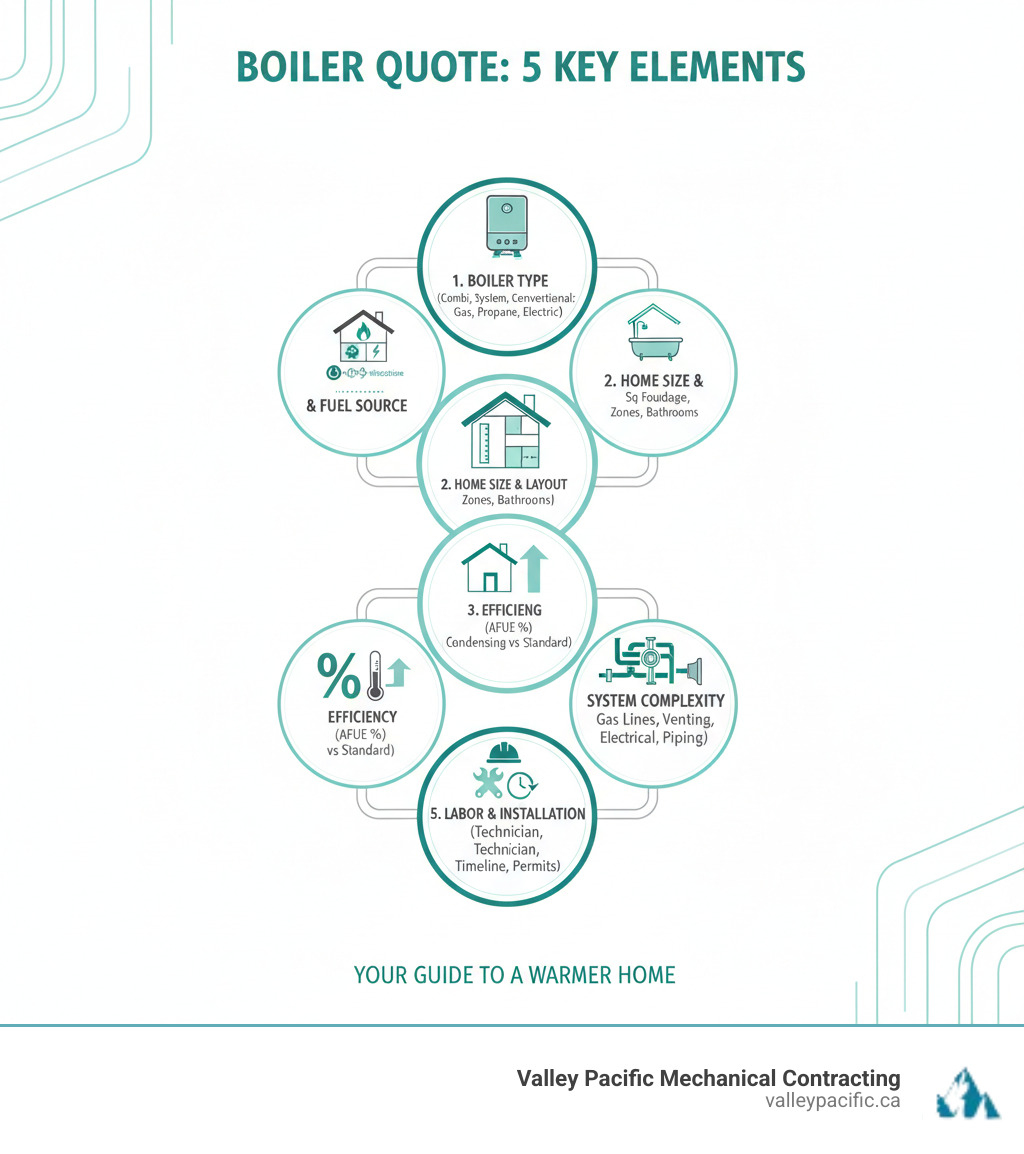
Boiler installation quote basics:
Decoding the Details: What a Professional Boiler Installation Quote Includes
A professional boiler installation quote should be more than just a final price. It's a detailed roadmap for your project, helping you avoid surprises. Just as you'd want a breakdown for a kitchen renovation, a detailed quote for your heating system provides the confidence to make an informed decision for your home's comfort and safety.
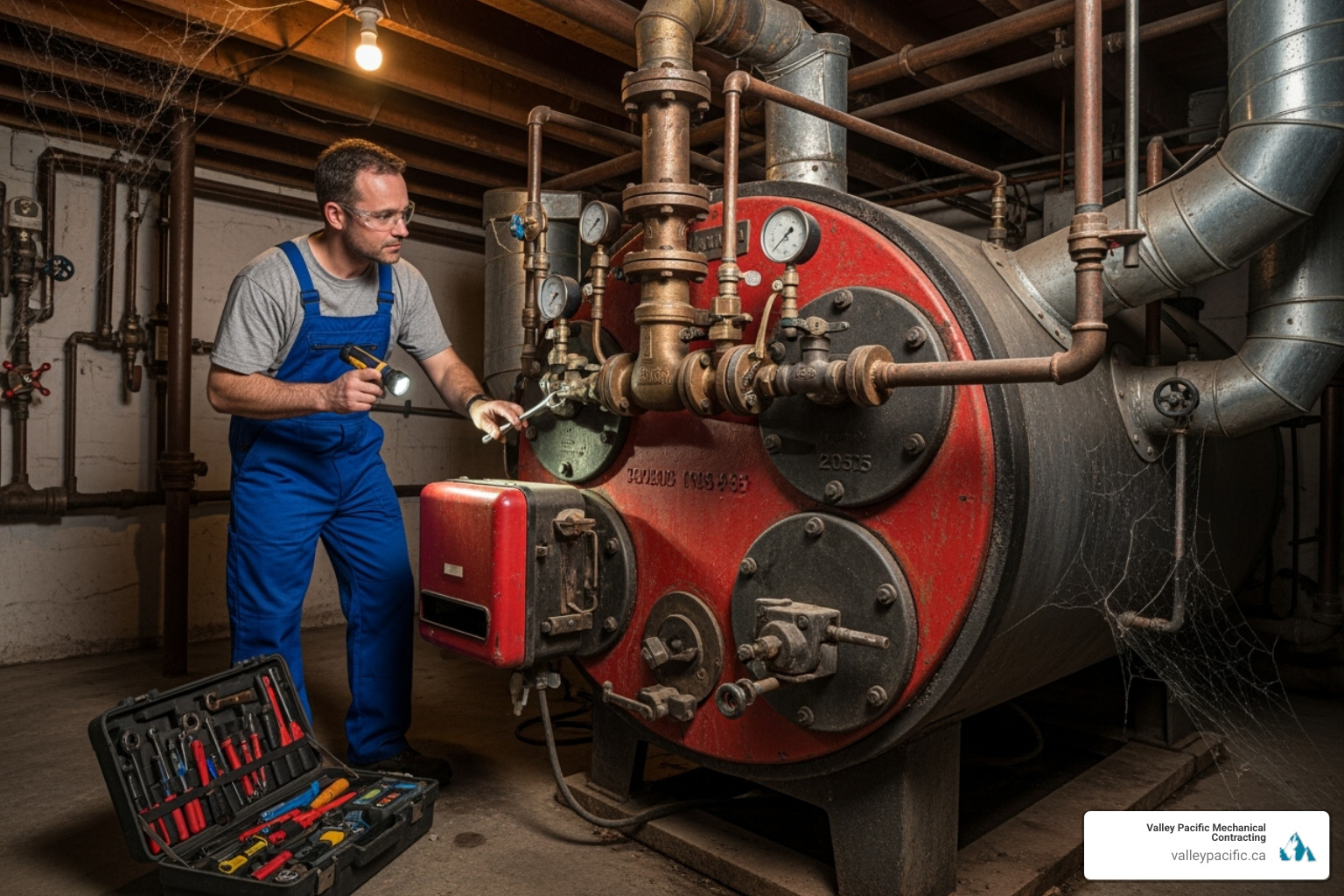
The Core Components
Every professional quote starts with the fundamentals. Your boiler unit should be clearly specified by make, model, type (conventional, system, or combi), and energy efficiency rating. This choice will shape your home's comfort and energy bills for over 15 years.
Next, labor and workmanship covers the time and expertise of licensed technicians. A proper installation ensures every connection is secure and all safety features function correctly. Cutting corners here can lead to future problems.
The quote must outline permits and inspections. Local authorities in Langley, Maple Ridge, and Mission require these to ensure your installation meets safety and building codes. A professional contractor handles this process, protecting your investment.
Finally, old boiler removal and disposal should be included. A professional will safely disconnect, remove, and responsibly dispose of your old unit. To ensure a smooth process, it's helpful to prepare your home for a new boiler beforehand.
Potential System Upgrades
Installing a new boiler can reveal that other parts of your system also need attention. A thorough boiler installation quote identifies these needs upfront to avoid surprises.
New gas lines might be necessary if you're switching fuel types or if existing lines don't meet current safety standards. This work requires precision for a safe fuel supply.
Modern high-efficiency boilers often need electrical upgrades. These advanced systems have sophisticated controls requiring specific connections. Upgrades may be needed if your home's wiring or electrical panel is outdated, as old wiring can be a safety hazard.
Venting modifications are another common requirement with high-efficiency condensing boilers. These units vent differently than older models, often requiring new flue materials or configurations. Proper venting is essential for safety and efficiency.
Don't overlook pipe insulation. Insulating heating pipes reduces heat loss and improves performance. Upgrading deteriorated or inadequate insulation during the installation is a smart move.
Finally, consider a thermostat replacement. Pairing a new, efficient boiler with a modern programmable or smart thermostat open ups its full potential. This gives you better temperature control and maximizes energy savings, a smart addition to any boiler heating system.
Key Factors That Shape Your Boiler Installation Quote
Every home has unique heating needs, so several key factors influence your boiler installation quote. Understanding these elements helps you compare different proposals effectively.
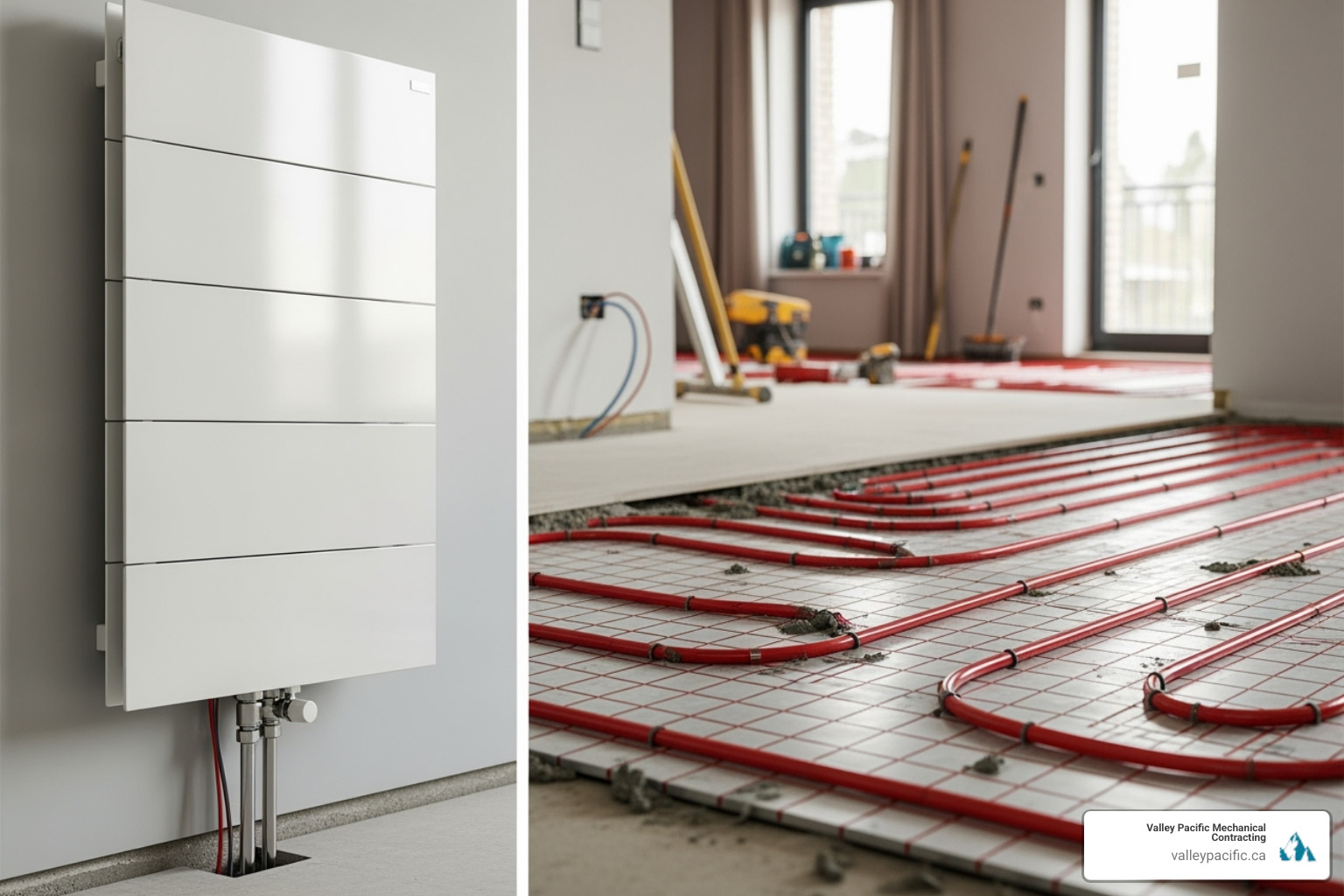
How Boiler Type and Fuel Source Affect Your Quote
The boiler type and its fuel are significant factors in your boiler installation quote. A compact combi boiler on natural gas has different installation requirements and complexity than a conventional boiler on propane.
| Boiler Type | Space Requirements | Hot Water Delivery | Suitability for Home Size |
|---|---|---|---|
| Conventional | Requires cold water tank & hot water cylinder | Stores hot water, good for multiple bathrooms | Larger homes with high hot water demand |
| System | Requires hot water cylinder, no cold water tank | Stores hot water, good for multiple bathrooms | Medium to large homes with high hot water demand |
| Combi (Combination) | Compact, no separate tanks | Instantaneous, on-demand hot water | Smaller to medium homes, limited space |
Conventional boilers require a cold water tank and hot water cylinder, making them ideal for larger homes with high simultaneous hot water demand. System boilers remove the need for a cold water tank but keep the hot water cylinder, suiting medium to large homes. Combi boilers are compact, providing heat and hot water on demand without tanks, perfect for smaller homes.
For fuel, natural gas is typically the most economical option in Mission, Maple Ridge, and Langley. If natural gas isn't available, propane is the alternative, though it requires a storage tank and different piping that affects the quote. Electric boilers are another option, best for small spaces, but they use electric currents to generate heat and can have higher operating costs. You can learn more about electric resistance heating if you're curious.
The Impact of Your Home's Characteristics
To provide an accurate boiler installation quote, we must understand your home's design, age, and condition, as these factors determine your heating system needs.
Home size (square footage) directly influences the required boiler capacity (BTU output). A larger home requires a more powerful boiler and potentially a more complex distribution system.
The number of bathrooms matters. Multiple bathrooms, especially if used simultaneously, create high hot water demand. This often requires a conventional or system boiler, as a combi might struggle to keep up.
Your home's insulation quality affects heat loss. Good insulation means you may need a smaller boiler, while a drafty home requires more heating power, affecting the boiler specifications in your quote.
The condition of your existing pipework is crucial. Older homes may have pipes with rust or corrosion, requiring re-piping. If the existing layout is unsuitable for the new boiler, rerouting may be necessary for safety and efficiency.
If your home has multiple heating zones for independent temperature control, the installation is more complex. This requires zone valves, extra thermostats, and advanced controls, adding to the project scope and shaping your quote. Effective boiler system maintenance is essential for these systems.
High-Efficiency Boilers: Understanding the Long-Term Value in Your Quote
A boiler installation quote's upfront number is only part of the story. The long-term value over the boiler's 15- to 20-year lifespan is what truly counts. A high-efficiency boiler reduces monthly energy bills, and government incentives can help with the initial investment, making this upgrade more accessible.
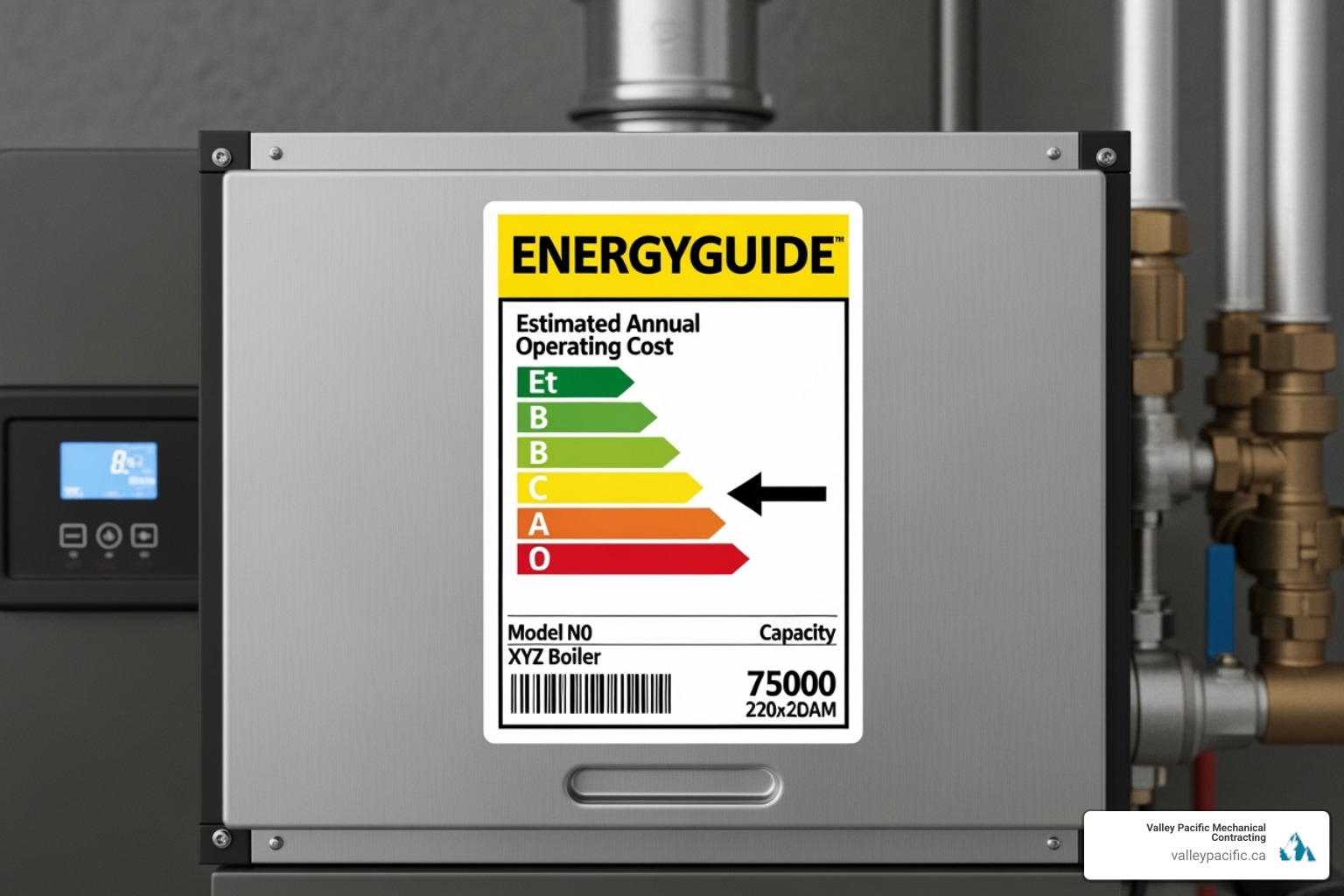
Reading the AFUE Rating
One number cuts through the technical confusion: the Annual Fuel Utilization Efficiency (AFUE) rating. This rating indicates how much fuel is converted to heat. An 80% AFUE rating means 80 cents of every fuel dollar heats your home, while 20 cents is wasted.
Standard efficiency boilers have around an 80% AFUE rating. High-efficiency models, in contrast, achieve ratings between 90% and 98%, which translates directly into lower energy bills.
The secret is condensing technology. These boilers capture heat from exhaust gases to preheat water entering the system, allowing them to reach 95-98% AFUE ratings.
The potential long-term fuel savings can be 30% or more compared to older models. While the initial boiler installation quote for a high-efficiency unit is higher, homeowners in Mission, Maple Ridge, and Langley often find the energy savings pay for the difference within a few years, delivering savings for the life of the unit.
Rebates and Incentives
Government programs can help you upgrade to a more efficient heating system.
Federal tax credits are available for homeowners who install ENERGY STAR certified gas boilers with at least a 95% AFUE rating. This can significantly reduce your project investment. We recommend you check for a federal tax credit to see what's available.
Provincial rebates through programs like the Canada Greener Homes Initiative and CleanBC offer additional support. These programs make energy-efficient upgrades more accessible for BC homeowners, with a focus on high-efficiency boilers.
Also, check for local utility programs. Your local provider may offer rebates for installing energy-efficient heating systems in your area, whether it's Mission, Maple Ridge, or Coquitlam.
Our team stays current on all available incentives and can help you steer the application process. When you're ready to explore your options, check out our services for boiler installation in Langley BC and let's discuss what makes sense for your home.
Repair or Replace? Deciding Before You Seek a Quote
For any homeowner with an aging heating system, the crucial question is whether to repair or replace it. Making the right choice can save you from unnecessary spending and future headaches. There's no point in getting a boiler installation quote if a simple repair will do, but you also don't want to keep patching up a system that's on its last legs.
Telltale Signs It's Time for a Replacement
Your boiler might be trying to tell you it's time for a replacement. Listen for these warning signs.
Age is more than just a number. If your boiler is 15 years or more, it's likely operating at a much lower efficiency and wasting fuel, even if it isn't breaking down.
Frequent breakdowns are a clear sign. If you're calling for service multiple times a season, the repair bills can add up, costing you a significant portion of a new boiler's price without the benefits.
If your energy bills are climbing for no apparent reason, it often indicates your boiler is losing efficiency and working harder to produce the same amount of heat.
Visible leaks or corrosion are serious concerns. Water pooling, rust spots, or corroded pipes signal that internal components are failing. If you spot your boiler leaking water, it's time for a professional assessment.
Strange noises like gurgling, banging, or whistling indicate serious internal problems, such as mineral buildup, a failing pump, or worn-out components.
Finally, inconsistent heating—some rooms being too hot while others are cold, or an unpredictable hot water supply—suggests your boiler is struggling. Our boiler repair Langley guide can help you understand these issues.
How to Get a Fair Boiler Installation Quote
Once you've decided on replacement, getting a fair boiler installation quote is the priority.
Start by comparing repair costs against replacement. If annual repair costs on a boiler over 10 years old are approaching 30-50% of a new unit's cost, that money is better invested in a new system.
Also, factor in declining efficiency. An old boiler might operate at 65% efficiency, while a new high-efficiency model reaches 95-98%. That difference translates directly into monthly energy savings.
Finally, consider the peace of mind. A new boiler provides reliable heat and hot water, eliminating the stress of an unpredictable system, especially during cold Lower Mainland winters.
When you're ready, a reputable company will walk you through the professional boiler replacement process, providing a detailed, transparent boiler installation quote that ensures there are no surprises.
Frequently Asked Questions About Boiler Installations
Getting a new boiler brings up many questions. As you're making a significant investment, it's natural to want clarity. Here are answers to common inquiries from homeowners in Mission, Maple Ridge, and Langley.
How long does a typical boiler installation take?
A straightforward, like-for-like replacement can often be completed in a single day (typically 4-6 hours). More complex jobs, such as switching boiler types, relocating the unit, or requiring significant modifications to gas lines, venting, or electrical systems, may take two to three days. Your boiler installation quote will provide a clear, realistic timeline so you can plan accordingly.
What is the average lifespan of a new boiler?
With proper annual maintenance, a modern boiler can last 15 years or more, with some high-quality cast iron models exceeding 20 years. The quality of the installation is a critical factor in its longevity. A professional installation, followed by regular servicing, ensures your boiler operates at peak efficiency, catches small issues before they become big problems, and protects your investment.
What are the signs of a failing boiler I should look for?
Your boiler will often give warning signs before it fails. Look for rising energy bills, strange gurgling or banging noises, and leaks around the unit. A yellow pilot light flame (instead of blue) is a serious concern, indicating incomplete combustion. Other signs include rooms that don't heat up properly and the need for frequent repairs. If you're experiencing these issues, especially troubleshooting no hot water from boiler, it's time for a professional assessment to see if a replacement is needed and to get a comprehensive boiler installation quote.
Get a Clear, Comprehensive Quote for Your Peace of Mind
Securing the best boiler installation quote isn't about finding the lowest price—it's about getting the best value and a headache-free experience. A detailed, transparent quote from an experienced team is a roadmap for your project, ensuring you know exactly what you're getting with no surprises. This transparency gives you the confidence to make an informed decision.
For over 30 years, Valley Pacific Mechanical Contracting has served homeowners in Mission, Maple Ridge, Langley, Pitt Meadows, and Coquitlam. Our commitment to a headache-free experience is backed by 24/7 emergency service and the Daikin Comfort Promise. We provide comprehensive, clear quotes so you can move forward with peace of mind.
Your home deserves a reliable, efficient, and safe heating system. Let us provide a transparent boiler installation quote that gives you confidence in your home's future warmth. Whether you're replacing an old unit or upgrading to a high-efficiency model, we're here to guide you.
Ready to get started? Request a Quote for your boiler installation in Langley BC and experience the difference that three decades of expertise can make.
Why Professional Furnace Installation Maple Ridge Matters for Your Home
Furnace installation maple ridge is an important decision if youre facing cold winters, rising energy bills, or an aging system. In Maple Ridges damp, chilly climate, a properly sized and professionally installed unit delivers efficient, reliable, and safe heat.
Quick Answer: What to Expect from Furnace Installation in Maple Ridge
- Timeline: 4-8 hours for a typical residential installation
- Process: Assessment, old unit removal, ductwork evaluation, new furnace installation, testing, and final walkthrough
- Key Benefit: Professional installation ensures safety compliance, manufacturer warranty protection, and optimal efficiency
- Local Expertise: Licensed technicians familiar with Maple Ridge building codes and climate demands
Need more guidance? See our HVAC System Upgrades Complete Guide. Ready to get started? Explore our professional Furnace Installation Maple Ridge BC services.
A quality install minimizes carbon monoxide risks, protects your manufacturer warranty, and optimizes performance for lower energy use over the next 15-20 years.
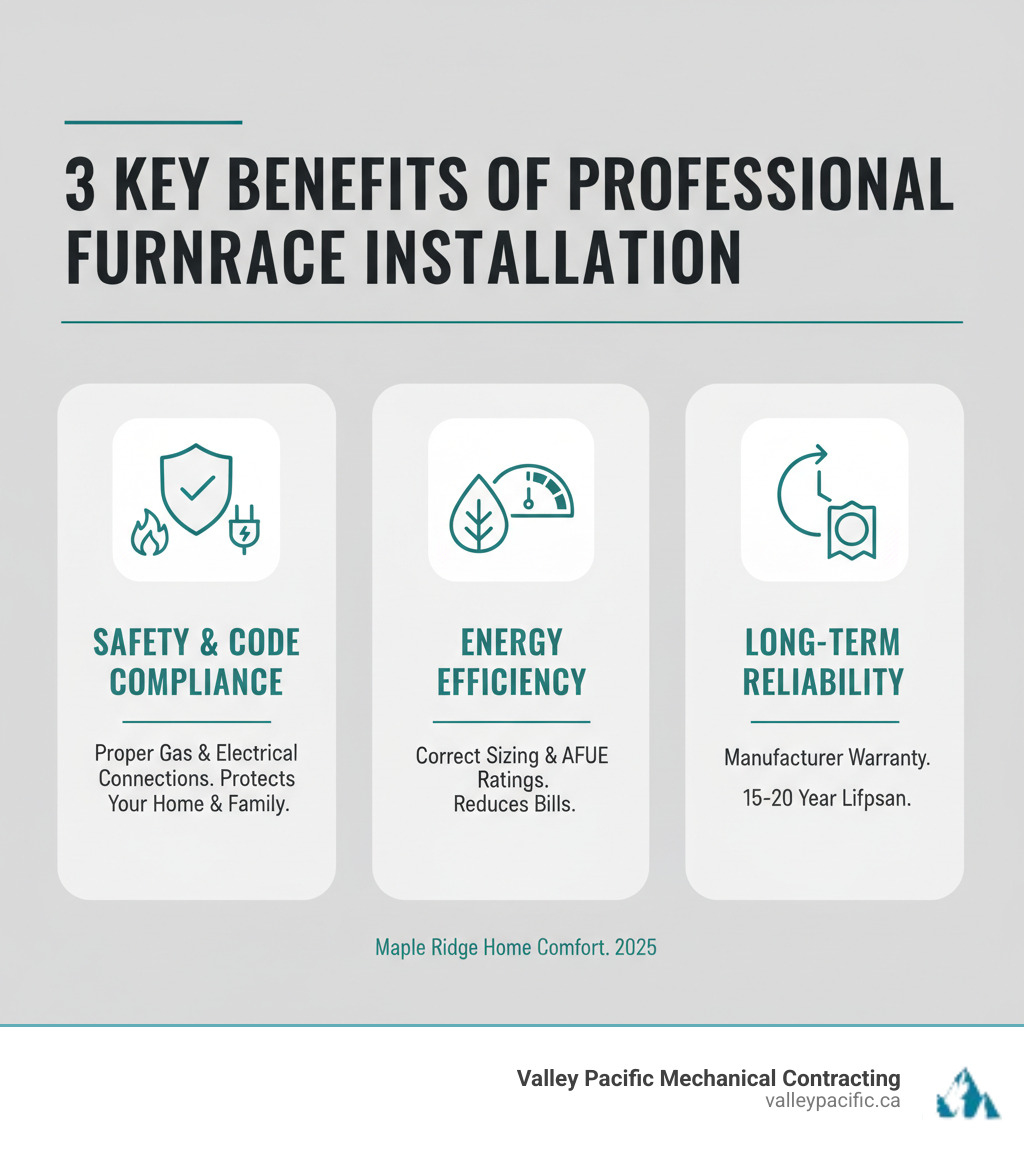
Basic furnace installation maple ridge vocab:
Is It Time for a New Furnace? 7 Signs You Need a Replacement
Even well-maintained systems wear out. If your furnace is approaching 15-20 years, plan your furnace installation maple ridge before an emergency.
Here are seven quick signs its time to consider a replacement:
- Age: 15+ years typically means lower efficiency and reliability.
- Frequent repairs: Repeated service calls point to end-of-life.
- Rising energy bills: Efficiency is dropping even with the same usage.
- Uneven heating: Hot/cold rooms signal poor distribution or capacity issues.
- Strange noises: Banging, clanking, whistling, or screeching arent normal.
- Yellow pilot light: Incomplete combustion and potential CO riskact immediately.
- Poor indoor air quality: Dust and allergy symptoms can worsen with older units.
If these sound familiar, book a professional assessment. Well help you decide between repair or a new furnace installation maple ridge. Learn more in our HVAC System Upgrades Complete Guide.
Choosing the Right Furnace for Your Maple Ridge Home
Selecting a new furnace affects comfort, energy use, and air quality for 15-20 years. We help Maple Ridge homeowners choose a smart, efficient solution that fits the home and long-term goals.
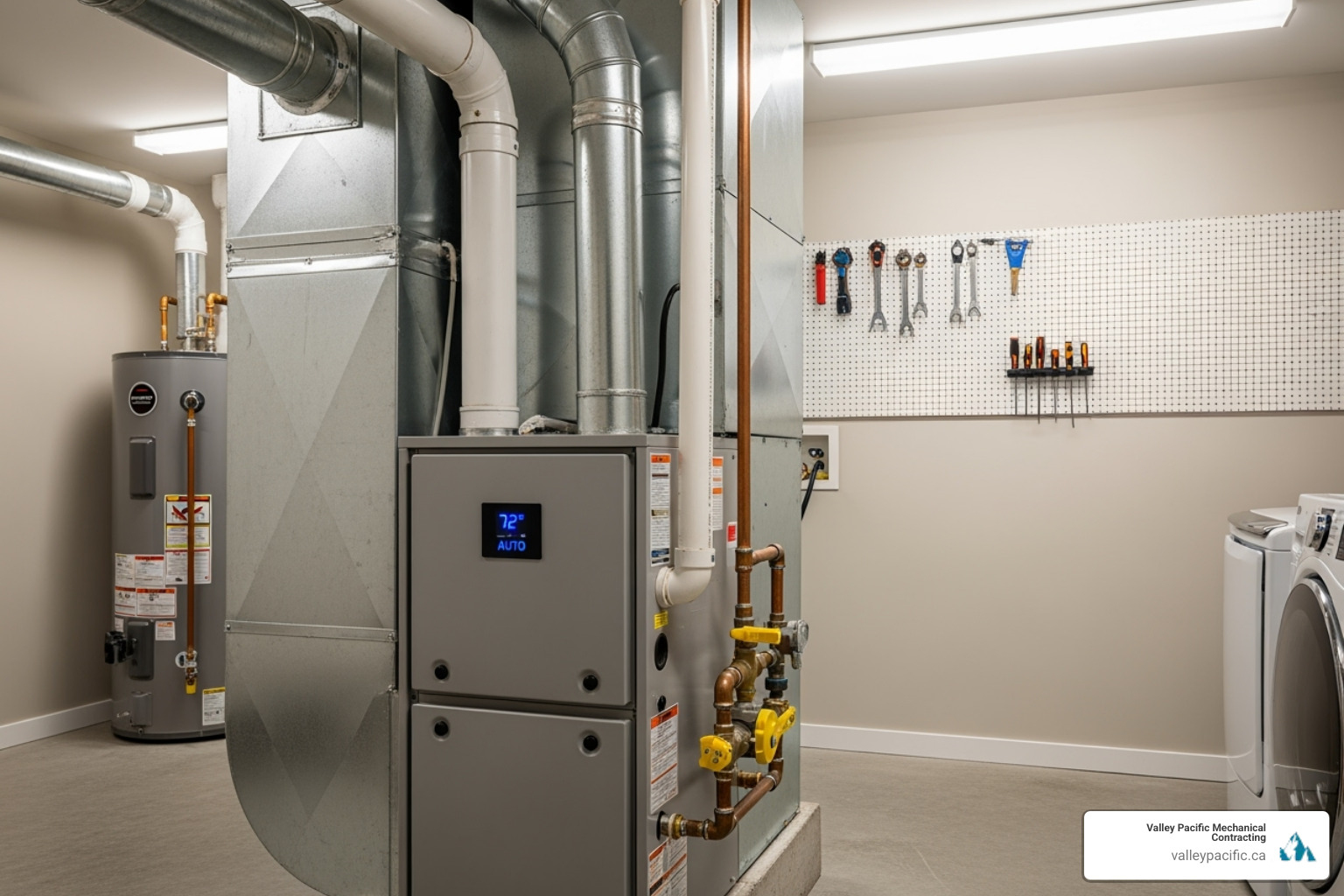
Understanding Furnace Fuel Types
- Natural Gas: Most common and cost-effective in Maple Ridge; strong, efficient heat where gas is available.
- Electric: Simple installation; higher operating cost in many cases; good for homes without gas.
- Oil & Propane: Options for rural homes without gas; require on-site tanks; strong heat output.
The right fuel for your furnace installation maple ridge depends on availability and your energy goals. See our guide on choosing a furnace.
Size, Efficiency, and High-Efficiency Upgrades
- AFUE: The Annual Fuel Utilization Efficiency shows how much fuel becomes heat (e.g., 95% AFUE = 95% becomes heat). Older units can be as low as 60%.
- High-efficiency benefits (90%+ AFUE):
- Lower energy use and bills
- More even comfort and quieter operation
- Better IAQ compatibility and a smaller carbon footprint
- Proper sizing (Manual J): Prevents short-cycling or underheating. We size based on your homes envelope and Maple Ridge climate. See HVAC System Design and check FortisBC rebates.
Furnaces vs. Heat Pumps: Which is Best for Maple Ridge?
You've likely heard about heat pumps as an alternative to traditional furnaces. Heres how they compare for our local climate:
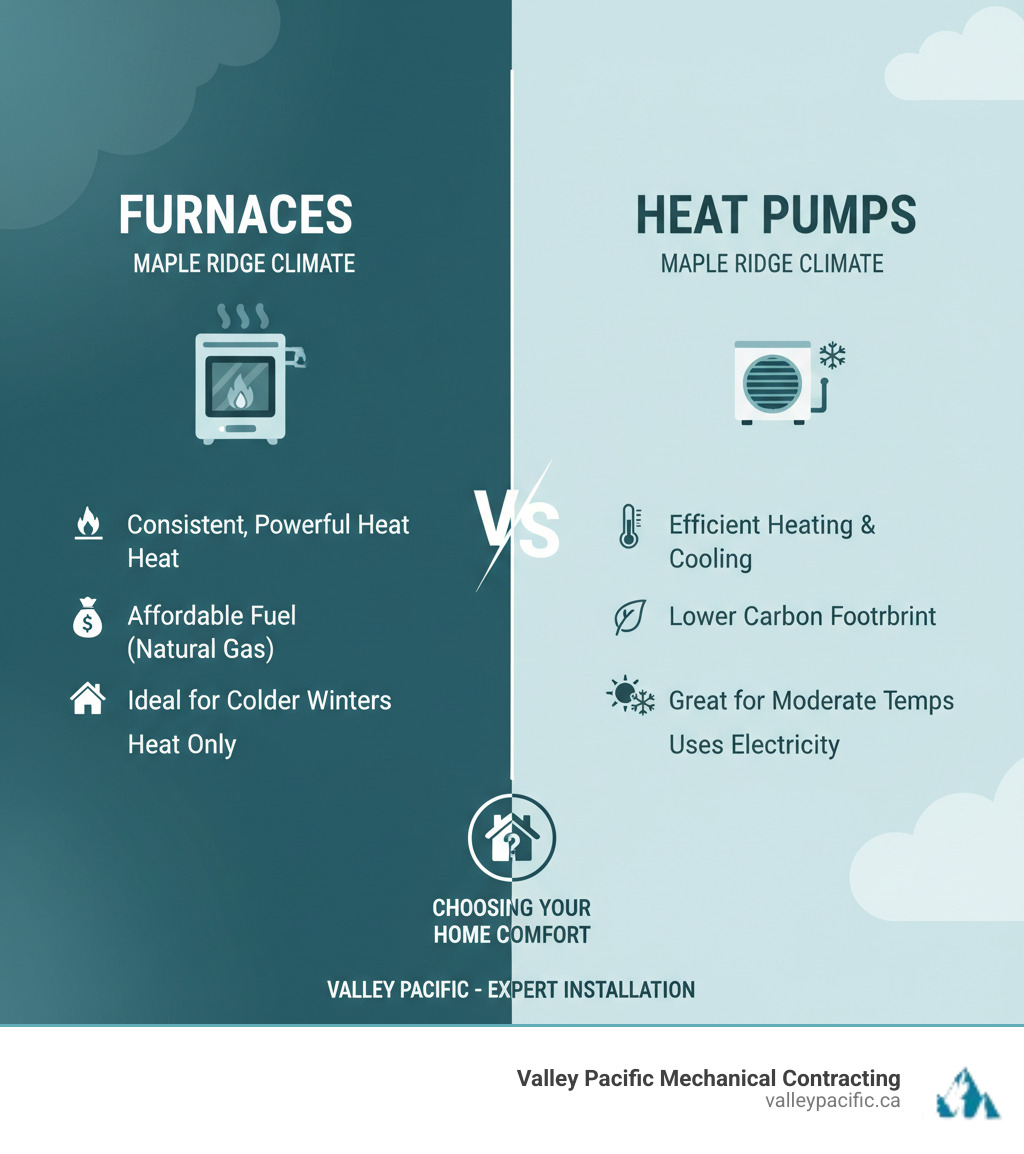
| Feature | Furnace | Heat Pump |
|---|---|---|
| Performance in Cold Weather | Excellentproduces strong, consistent heat even when temperatures drop well below freezing | Good in moderate cold, but efficiency decreases significantly in extreme cold (below -10 C); may require backup heating |
| Cooling Ability | Nonerequires separate air conditioning system | Provides both heating and cooling in one system, offering year-round comfort |
| Typical Lifespan | 15-20 years with proper maintenance | 10-15 years with proper maintenance |
| Relative Upfront Investment | Generally lower initial cost | Higher upfront cost, but potential long-term energy savings and dual functionality |
A dual-fuel system pairs a heat pump with a furnace for efficient heating and cooling most of the year, with furnace backup on the coldest days. Well help you decide. See our Heat Pump Installation Maple Ridge Guide.
Introduction
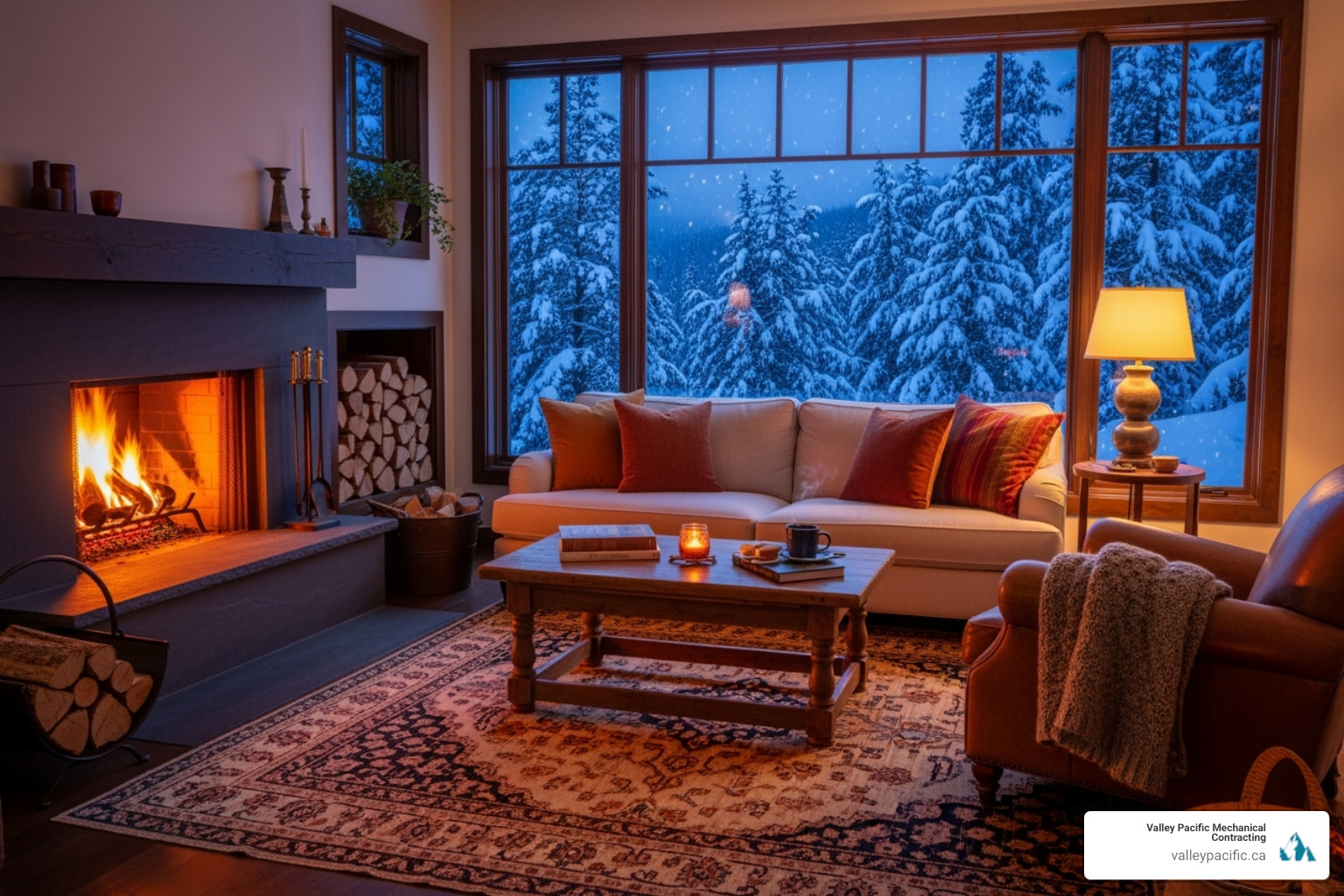
In Maple Ridge, winter comfort depends on a safe, efficient heating system. Whether replacing an older unit or installing in a new build, professional furnace installation maple ridge ensures code compliance, warranty protection, and dependable performance.
Quick Answer: What to Expect from Furnace Installation in Maple Ridge
- Timeline: 4-8 hours
- Process: Assessment, removal, duct evaluation, installation, testing, walkthrough
- Key Benefit: Safety, warranty, and efficiency
- Local Expertise: Technicians versed in Maple Ridge codes and climate
Explore our HVAC System Upgrades Complete Guide and our Furnace Installation Maple Ridge BC services.
Basic furnace installation maple ridge vocab:
Is It Time for a New Furnace? 7 Signs You Need a Replacement
Even reliable furnaces reach the end of their service life. Plan your furnace installation maple ridge if you notice:
- Age: Past 15 years and losing efficiency.
- Frequent repairs: Recurring breakdowns each season.
- Rising bills: Usage the same but costs climbing.
- Uneven temperatures: Persistent hot/cold rooms.
- Odd noises: Banging, clanking, or whistling.
- Yellow pilot: Combustion issue and potential CO risk.
- IAQ concerns: More dust or allergy symptoms.
Well help you decide between repair and replacement. See our HVAC System Upgrades Complete Guide.
Choosing the Right Furnace for Your Maple Ridge Home
A smart choice now sets you up for 15-20 years of comfort, efficiency, and clean indoor air. We guide you through the key decisions for your furnace installation maple ridge.
Understanding Furnace Fuel Types
- Natural Gas Furnaces: Most common in Maple Ridge; efficient, powerful heat where gas is available.
- Electric Furnaces: Simpler installs; higher operating cost in many cases; good when gas isnt available.
- Oil Furnaces: Suitable for rural areas; require a storage tank and regular deliveries.
- Propane Furnaces: Ideal where gas lines dont reach; tank-based with efficient, reliable heat.
Get more context in our guide: How do I choose the right furnace for my home in Pitt Meadows BC.
Size, Efficiency, and High-Efficiency Upgrades
- AFUE rating: Indicates how much fuel becomes heat annually (e.g., 95% AFUE = 95% becomes heat). Older units may be 60-70%.
- High-efficiency advantages (90%+ AFUE):
- Lower energy use and bills
- More even, quieter comfort
- Better IAQ options and smaller carbon footprint
- Correct Sizing (Manual J): Avoids short-cycling (oversized) and underheating (undersized). We calculate load based on your home and Maple Ridge weather. Learn more in our HVAC System Design, and remember to Check for available FortisBC rebates.
Furnaces vs. Heat Pumps: Which is Best for Maple Ridge?
Both can work well here. Furnaces excel in colder snaps; heat pumps offer efficient heating and built-in cooling for much of the year. Many homeowners choose a dual-fuel setup (heat pump + gas furnace) for the best of both.
| Feature | Furnace | Heat Pump |
|---|---|---|
| Performance in Cold | Excellent, steady heat in freezing weather | Efficient in mild-to-moderate cold; needs backup in deep cold |
| Cooling | Separate AC needed | Built-in cooling |
| Typical Lifespan | ~15-20 years | ~10-15 years |
| Upfront Investment | Generally lower | Generally higher; may qualify for incentives |
Compare options in our Heat Pump Installation Maple Ridge Guide.
Is It Time for a New Furnace? 7 Signs You Need a Replacement
Unsure whether to repair or replace? If your system is 15+ years old, breaks down often, costs more to run, heats unevenly, makes unusual noises, shows a yellow pilot flame, or worsens indoor air quality, its likely time for a new furnace installation maple ridge.
Read our HVAC System Upgrades Complete Guide and book a professional assessment.
Choosing the Right Furnace for Your Maple Ridge Home
This decision sets your comfort and operating costs for the next two decades. Well help you pick the right fuel, efficiency, and size for your furnace installation maple ridge.
Understanding Furnace Fuel Types
- Natural gas: Widely available locally; efficient, dependable heat.
- Electric: Straightforward installs; higher operating cost in many cases.
- Oil/Propane: Solid alternatives without gas service; require tanks and deliveries.
See: How do I choose the right furnace for my home in Pitt Meadows BC.
Size, Efficiency, and High-Efficiency Upgrades
- AFUE explains fuel-to-heat efficiency; 90%+ models reduce energy use.
- Proper sizing (Manual J) avoids short-cycling and cold rooms. More in our HVAC System Design. Check FortisBC rebates.
Furnaces vs. Heat Pumps: Which is Best for Maple Ridge?
Heres what you need to know when deciding for your furnace installation maple ridge:
| Feature | Furnace | Heat Pump |
|---|---|---|
| Performance in Cold Weather | Excellentprovides consistent, powerful heat even when temperatures drop well below freezing | Goodmodern heat pumps work well in cold weather, but efficiency decreases as temperatures drop; may need backup heating for extreme cold |
| Cooling Ability | Requires separate air conditioning system | Provides both heating and cooling in one unitno separate AC needed |
| Lifespan | Typically 15-20 years with proper maintenance | Generally 10-15 years; outdoor components face more wear |
| Relative Upfront Investment | Generally lower initial cost, especially for gas furnaces | Higher upfront cost, but may qualify for larger rebates and incentives |
Dual-fuel systems combine both for year-round efficiency and comfort. For a deeper dive, read our Heat Pump Installation Maple Ridge Guide.
The Professional Furnace Installation Maple Ridge Process
When you choose a professional furnace installation maple ridge, youre getting safety-first workmanship, correct sizing, and calibration for long-term performancenot just a swap.
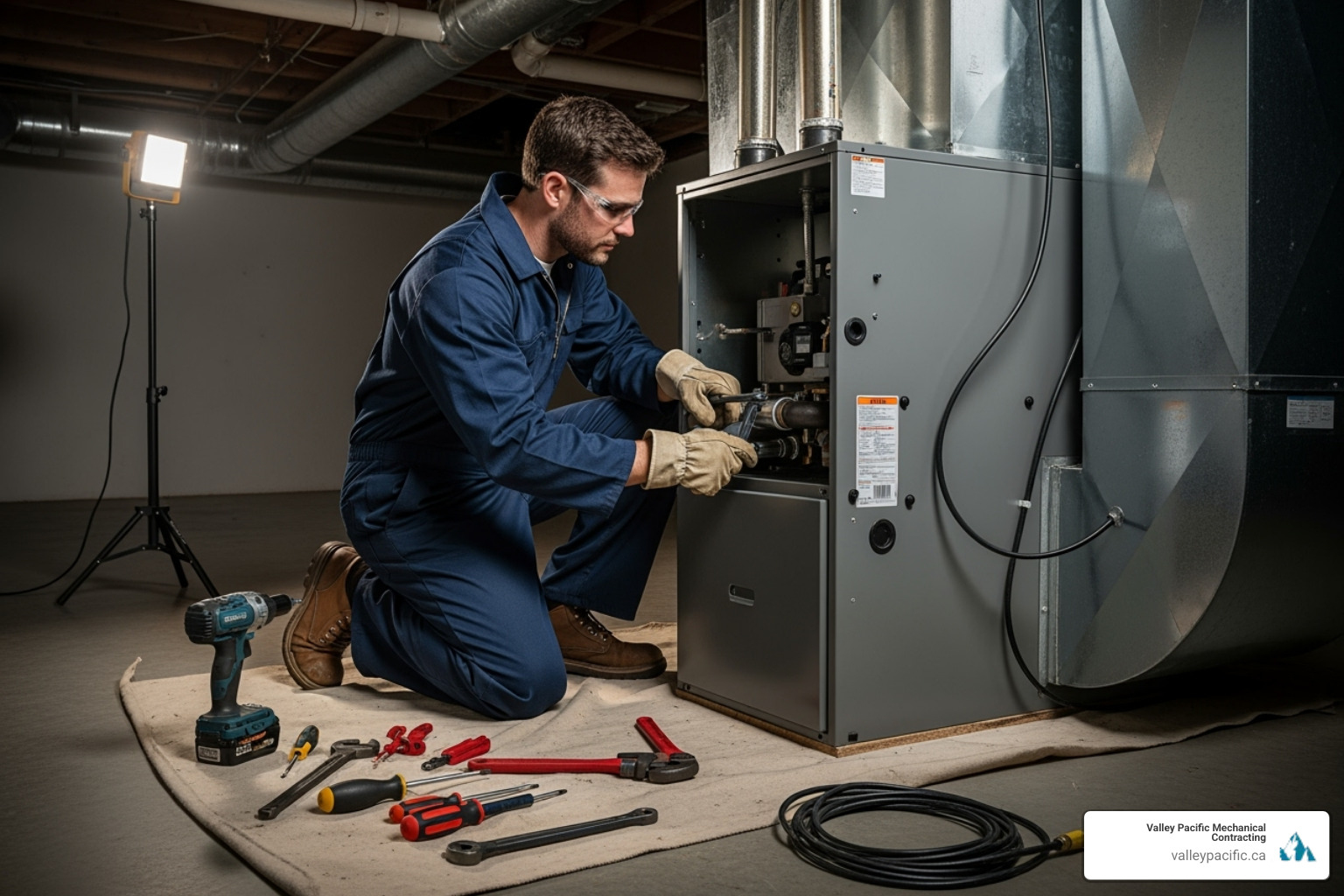
Why Professional Furnace Installation in Maple Ridge is Crucial
- Safety: Gas, electricity, and combustion require code-compliant work to prevent leaks and CO exposure.
- Warranty: Most manufacturers require certified installation for coverage.
- Performance: Load calculations and proper setup ensure peak efficiency and reliability.
Learn more: Furnace Installation Homeowner Essentials.
A Step-by-Step Guide to Furnace Installation in Maple Ridge
- Assessment & Load Calculation: Manual J sizing for your home and climate.
- Old Unit Removal: Safe disconnect, removal, and responsible disposal/recycling.
- Ductwork Check: Inspect, seal, and adjust for proper airflow; see Forced Air Furnace Installation.
- New Furnace Placement: Connect gas, electrical, and venting to code and specs.
- Venting & Thermostat: Correct exhaust, sealed joints, and thermostat setup.
- Testing & Calibration: Leak checks, airflow verification, temperature rise, safety controls.
- Walkthrough: Final inspection, homeowner orientation, and maintenance tips.
Typical residential installations take 48 hours.
After the Installation: Ensuring Longevity and Performance
Congratulations on your new furnace installation maple ridge! To ensure your investment provides reliable comfort and efficiency for its full 15-20 year lifespan, a little post-installation care goes a long way. Regular maintenance is key to preventing breakdowns, keeping energy bills low, and ensuring clean indoor air.

Here are the two most important things you can do:
Change Your Furnace Filter Regularly: This is the simplest and most effective task for any homeowner. A clogged filter restricts airflow, forcing your furnace to work harder and driving up energy costs. Check your filter monthly and replace it every 1-3 months, or more often if you have pets.
Schedule Annual Professional Service: Before each heating season, have a certified technician perform a comprehensive tune-up. During this visit, we inspect and clean all internal components, check electrical connections, test safety controls, and ensure the system is running at peak efficiency. This preventative step catches small issues before they become major problems.
Regular servicing not only extends your furnace's life but also maintains its efficiency and improves your home's air quality. For more tips, explore our HVAC Preventative Maintenance guide, or consider our convenient Maintenance Plan to make scheduling a breeze.
Your Partner for a Warm and Comfortable Home
A professional furnace installation maple ridge delivers safer operation, better efficiency, cleaner air, and dependable comfort for up to 20 years.
Valley Pacific Mechanical Contracting has served Maple Ridge and the Lower Mainland for 30+ years. Count on our headache-free experience, licensed technicians, 24/7 emergency service, and the Daikin Comfort Promise.
Have questions or ready to get started? Contact Us to schedule your consultation, or explore our Furnace Installation Maple Ridge BC solutions.
Why Your Boiler Pressure Gauge Demands Your Attention
My boiler pressure keeps dropping. Who can I call to diagnose boiler pressure issues? It's a common concern for homeowners in Langley, Maple Ridge, Mission, and Pitt Meadows. A boiler that repeatedly loses pressure is a warning sign that your sealed heating system needs attention. If the pressure gauge stays below the green zone, your boiler may stop heating, leaving you in the cold.
Quick Answer: If your boiler pressure keeps dropping, you should call a licensed gas technician or HVAC professional who specializes in boiler repair. For persistent pressure loss in the Lower Mainland, contact a qualified service provider like Valley Pacific Mechanical at their emergency line.
When to Call a Professional:
- Pressure drops daily or weekly despite topping up
- Visible water leaks around the boiler, radiators, or pipes
- Error codes appear on your boiler display (F22, E119, F1, E118)
- No heating or hot water despite normal pressure gauge reading
- Strange noises like kettling, banging, or gurgling
- Damp patches on walls or ceilings near heating pipes
Normal boiler pressure is between 1.0 and 1.5 bar when cold. If you're constantly repressurizing your system or the gauge drops below 1 bar within days, it's more than a simple maintenance issue. Hidden leaks, faulty valves, or internal component failure could be the cause. Topping up is a temporary fix; repeated pressure loss requires a professional diagnosis to prevent expensive damage.
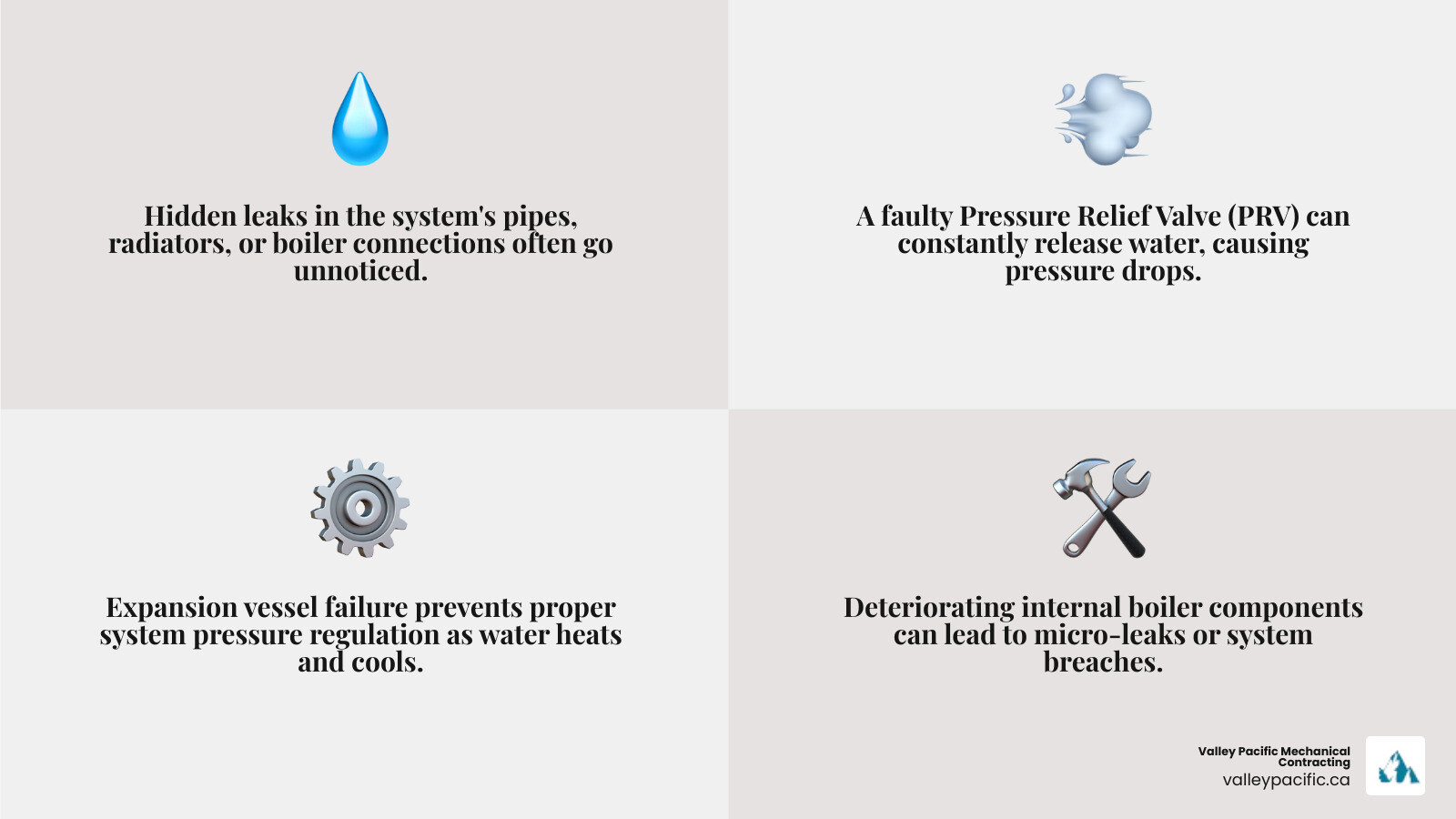
Terms related to My boiler pressure keeps dropping. Who can I call to diagnose boiler pressure issues?":
Understanding Normal Boiler Pressure
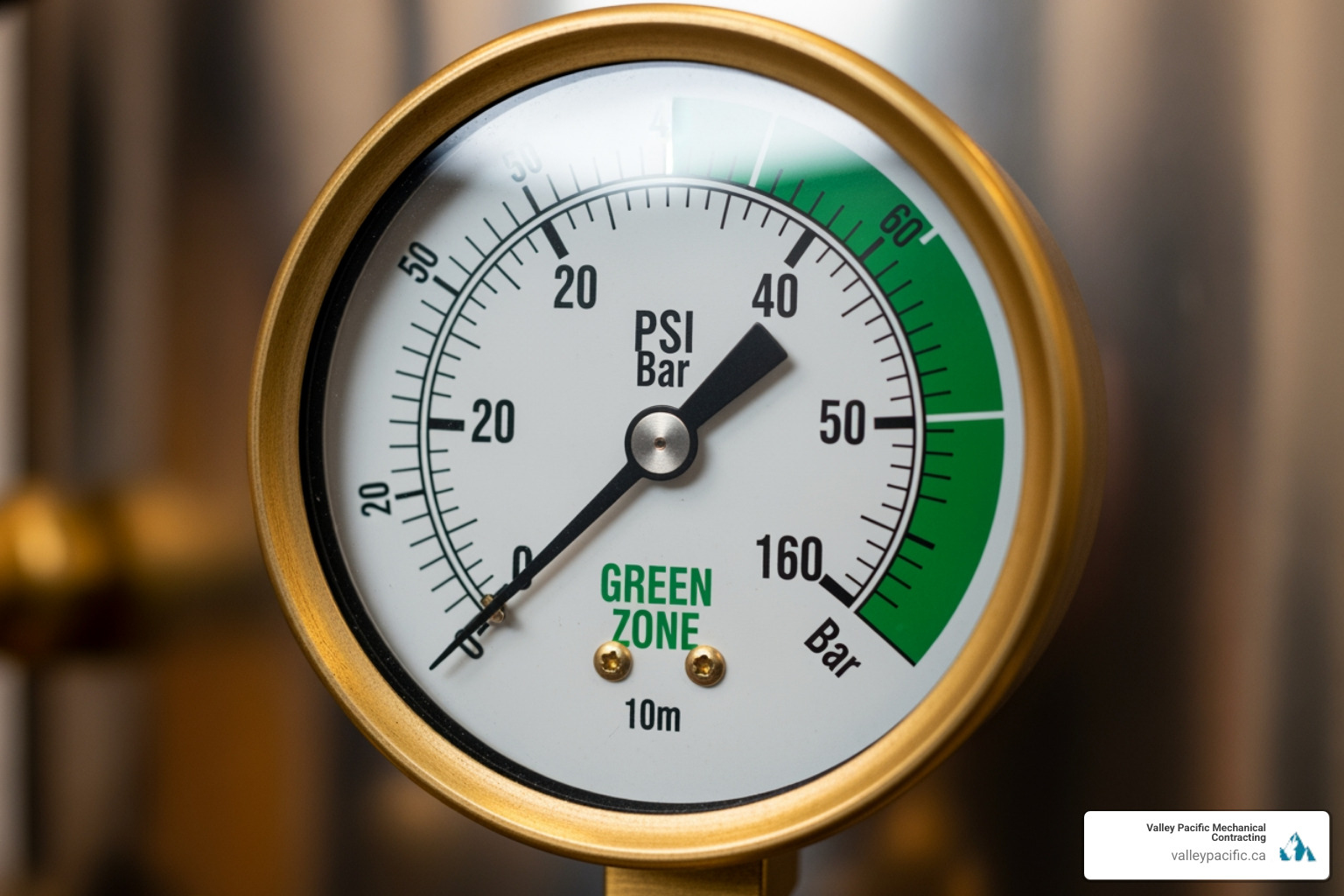
To understand why your boiler pressure keeps dropping, you first need to know what's normal. Boiler pressure is the force that moves water through your sealed central heating system. Without the right pressure, the system struggles.
When your system is cold, the pressure gauge should be in the green zone, typically between 1.0 and 1.5 bar. When you turn on the heating, the pressure will naturally rise as the water heats and expands. It's normal to see it climb to around 2.0 or 2.5 bar while hot. The pressure will drop back down as the system cools.
Correct pressure is vital. When it drops below 1.0 bar, your boiler often enters a safety lockout mode and won't fire up. This protects components like the heat exchanger and pump from damage. Conversely, if pressure is consistently too high (above 2.5-3.0 bar), the pressure relief valve may release water, causing drips around your boiler.
The signs of low boiler pressure are obvious: radiators feel cold or lukewarm, you hear gurgling noises from pipes, or the boiler displays error codes like F22, E119, F1, or E118. Some boilers shut down entirely (boiler lockout) until the pressure is restored. Our guide on what to do when boiler pressure drops can help.
A healthy boiler maintains steady pressure. If you're constantly topping it up, something needs professional attention.
Common Causes for a Boiler Losing Pressure
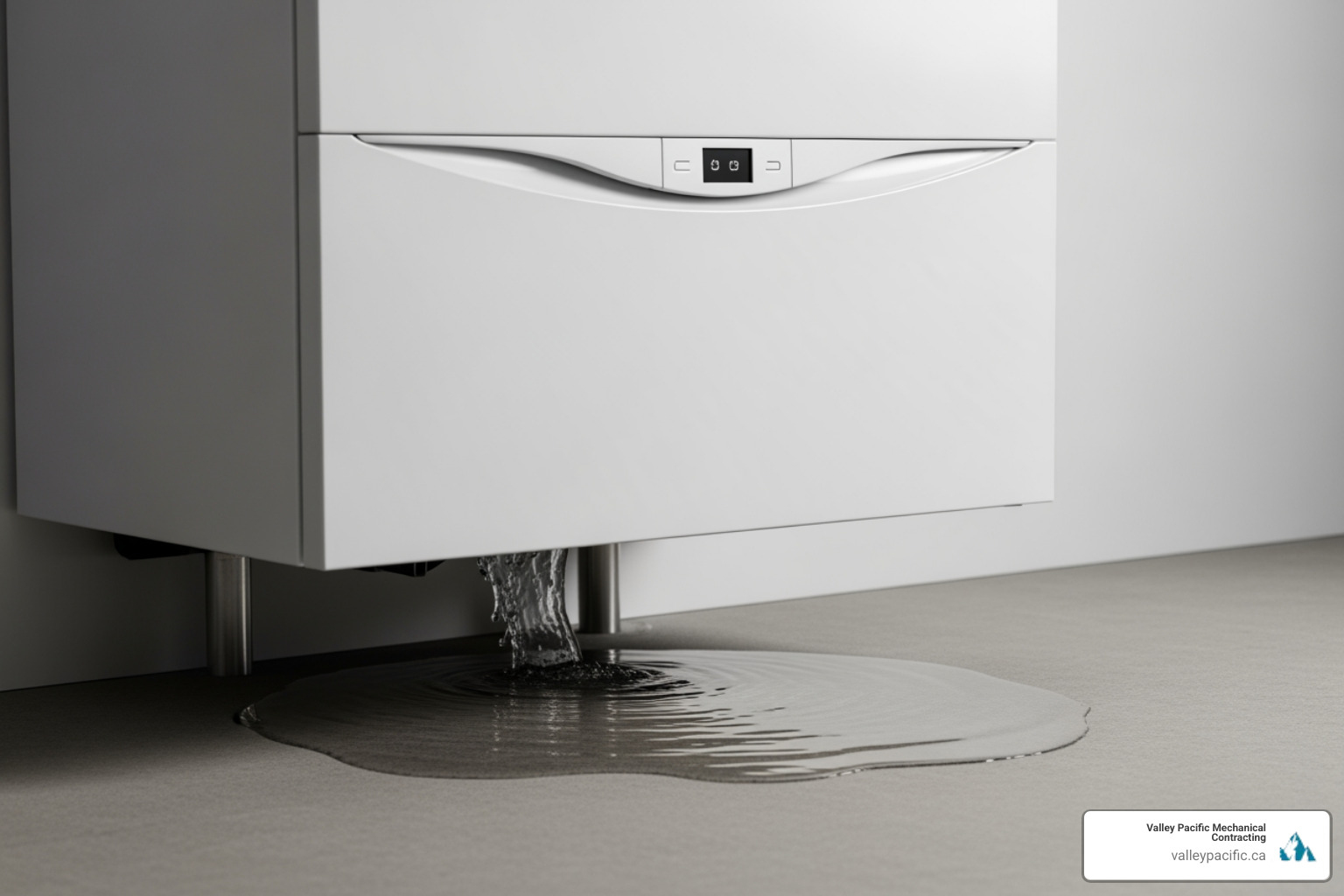
If your boiler pressure gauge keeps dropping, it usually points to a few common culprits. Leaks are the number one reason for pressure loss. Even a pinhole-sized leak can drain the system over time.
Check your radiator valves for dampness, stains, or corrosion. Inspect visible pipework joints for rust or damp patches on nearby surfaces. Leaks can also hide under floorboards or behind walls, evidenced by damp spots or discoloration. If you see water around your boiler, our guide on boiler leaking water can help.
Faulty components can also cause pressure drops. The expansion vessel manages water expansion as it heats and cools. If the internal diaphragm fails, it can lead to pressure loss. Our article on the boiler expansion tank explains more.
The pressure relief valve (PRV) is a safety device that releases water if pressure gets too high. A faulty PRV can get stuck open, continuously discharging water. You might see water dripping from a small copper pipe on an outside wall.
If you recently bled your radiators, you released air and a small amount of water, which naturally lowers the pressure. This is normal; simply top up the system to bring the pressure back into the green zone.
If you've checked for obvious leaks and still wonder, "My boiler pressure keeps dropping. Who can I call to diagnose boiler pressure issues?" it's time for a professional. A qualified technician can find hidden leaks and faulty components.
How to Safely Repressurize Your Boiler: A DIY Guide
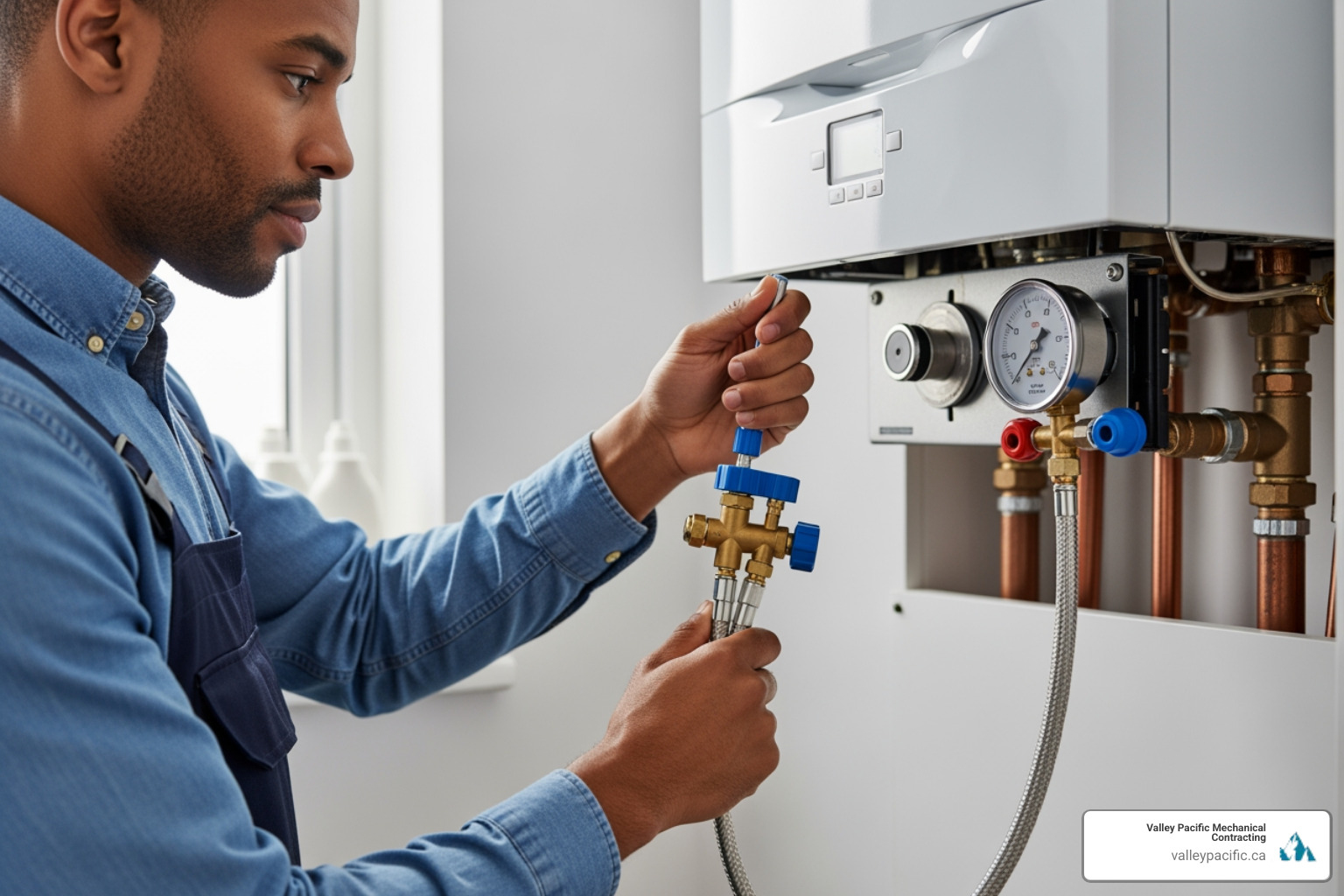
If your boiler pressure is below 1.0 bar and you see no obvious leaks, you might be able to repressurize it yourself. Disclaimer: Only proceed if you feel confident and consult your boiler's manual for specific instructions. If unsure, call a professional.
First, turn off the boiler and let it cool down for an accurate reading. Locate the filling loop—a silver or grey flexible hose with two valves, usually under the boiler. If it's detachable, ensure it's securely connected.
Next, open the valves slowly, one after the other. You'll hear water flowing into the system.
Watch the pressure gauge closely. As water enters, the needle will rise. Aim for 1.0 to 1.5 bar (the green zone) when the system is cold. Once in range, close both valves firmly, starting with the second one you opened. Ensure both are fully closed to prevent over-pressurization.
If your filling loop is detachable, remove it. Then turn your boiler back on, pressing the reset button if necessary. If you overfill the system, you can bleed a radiator to release a little water and lower the pressure.
For a visual guide, this video shows you how to do it yourself.
Repressurizing is a useful skill, but if you're doing it more than twice a year, it's time to ask, "My boiler pressure keeps dropping. Who can I call to diagnose boiler pressure issues?" and call a professional.
My boiler pressure keeps dropping. Who can I call to diagnose boiler pressure issues?
If you're constantly topping up your boiler pressure only to see it drop again, it's no longer a DIY fix. A persistent pressure drop indicates a deeper issue that will only worsen if ignored. Calling for a repair in the cold winter months in Langley, Maple Ridge, Mission, or Pitt Meadows is never ideal. However, a boiler that repeatedly loses pressure is signaling a problem like a hidden leak or a failing component. These issues don't resolve on their own and can lead to expensive damage and boiler failure.
At Valley Pacific Mechanical, we know that my boiler pressure keeps dropping. Who can I call to diagnose boiler pressure issues? is a question from a worried homeowner. With 30+ years serving the Lower Mainland and 24/7 emergency service, we're here to ensure you're never left in the cold.
For expert diagnosis and repair, our specialized teams are ready to help:
- Boiler Repair Langley BC
- Boiler Repair Maple Ridge BC
- Boiler Repair Pitt Meadows BC
- Boiler Repair Mission BC
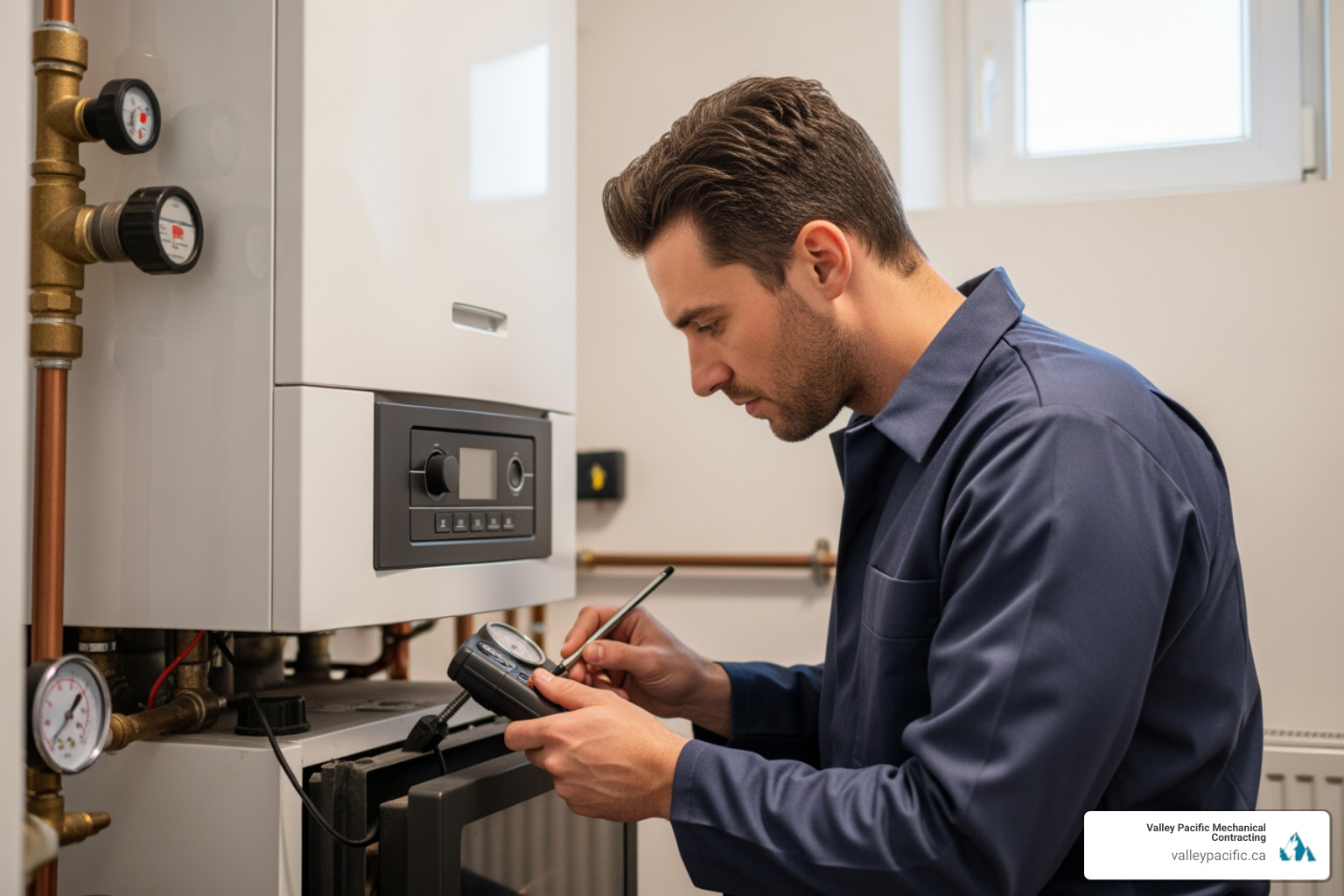
When is it time to call a professional because my boiler pressure keeps dropping?
A one-time pressure drop after bleeding radiators is different from a persistent problem. If you're repressurizing your boiler daily or weekly, it's time to call a professional. Constantly adding fresh water introduces oxygen, which accelerates internal corrosion.
Other clear signs you need help include:
- Visible leaks you can't fix: A persistent drip from the boiler, a valve, or pipework can lead to significant water damage.
- Unusual noises: Kettling, banging, or gurgling are symptoms of underlying problems like limescale buildup or air in the system.
- Lockout mode and error codes: If your boiler shuts down and displays codes like F22, F1, E119, or E118, it needs professional attention.
- No hot water or heating: If the system isn't working despite a normal pressure reading, another component may have failed.
Working with gas appliances requires specialized training. In British Columbia, a licensed gas fitter must legally work on your boiler. For your family's safety, only qualified professionals like those with a gas safe engineer certification (the UK equivalent) should handle gas appliances.
What can a professional do to diagnose boiler pressure issues?
Our licensed gas fitters don't just top up the pressure; we find the root cause. With over 30 years of experience, we use a systematic approach to diagnose why your pressure keeps dropping.
- Advanced leak detection: We use thermal imaging cameras to find hidden moisture and acoustic listening devices to hear faint water leaks, pinpointing problems that are otherwise invisible.
- Component testing: We test the pressure relief valve (PRV) for faults and check if the expansion vessel has lost its charge or failed.
- System health check: Frequent top-ups can dilute corrosion inhibitors, leading to sludge and rust. We may recommend a system flush to clean the system and restore flow.
- Error code analysis: We use manufacturer-specific knowledge to interpret what your boiler's error codes mean.
Professional diagnosis looks at the whole picture to find the cause, not just the symptom. Regular boiler system maintenance is the best way to catch these issues early. During a maintenance visit, we check all components, test pressure, and inspect for leaks, preventing small problems from becoming expensive ones.
When my boiler pressure keeps dropping, the answer to who can I call to diagnose boiler pressure issues? is Valley Pacific Mechanical. We bring three decades of experience to every job for honest, expert service.
Frequently Asked Questions About Boiler Pressure
Here are answers to common questions from homeowners in Langley, Maple Ridge, Mission, and Pitt Meadows about boiler pressure.
Why does my boiler pressure rise when the heating is on?
It's normal for boiler pressure to rise when the heating is on due to thermal expansion. As water heats up in the sealed system, it expands, which increases the pressure. A rise of about 0.5 bar is typical. However, an excessive rise (e.g., from 1.0 bar to 3.0 bar) could indicate a problem with your expansion vessel, which is designed to absorb this pressure change. This requires a professional inspection.
Is low boiler pressure dangerous?
Low boiler pressure isn't immediately dangerous. Modern boilers have safety features that put them into lockout mode when pressure drops too low (usually below 1.0 bar). This is a protective measure to prevent system damage. The real risk is the underlying cause. A persistent leak can cause hidden water damage, leading to mold and structural issues. Ignoring low pressure also leads to inefficiency, higher energy bills, and a shorter boiler lifespan.
Can a boiler lose pressure without a visible leak?
Yes, a boiler can lose pressure without a visible leak. This is a frustrating but common scenario. A faulty Pressure Relief Valve (PRV) might release small amounts of water outside, or a failing expansion vessel can cause gradual pressure drops. Sometimes, leaks are so tiny they evaporate before forming a puddle. This is why professional diagnosis with tools like thermal imaging cameras is so valuable for finding hidden culprits.
Your Local Experts for Boiler Pressure Problems
You now know what normal boiler pressure is, why it drops, and when to call a professional. The reality is, if your boiler pressure keeps dropping, the problem won't fix itself. Persistent pressure loss from a hidden leak or faulty component requires the specialized tools of a licensed gas fitter.
You don't have to figure this out alone. At Valley Pacific Mechanical, we've been solving boiler pressure problems for homeowners across the Lower Mainland for over 30 years. Our licensed technicians use advanced diagnostic equipment and hands-on experience to find and fix the issue.
Boiler problems are never convenient, which is why we offer 24/7 emergency service. We are committed to a "headache-free" experience: arriving on time, explaining the problem clearly, and fixing it right the first time.
Whether you're in Langley, Maple Ridge, Mission, or Pitt Meadows, you have a local team you can trust. We live and work here, helping your neighbors keep their homes warm.
Don't let a dropping pressure gauge lead to a major repair bill or a cold night. The longer you wait, the more damage a hidden leak can cause. If you're constantly topping up your system, it's time to let the professionals take over.
Contact us today for expert diagnosis and repair. We'll get to the bottom of your pressure problem and restore your home's warmth and reliability. Learn more about our comprehensive heating services at Boiler.
Why Affordable Heat Pump Service Matters for Your Home
Affordable heat pump service is about more than just the initial price—it's about getting quality heating and cooling that fits your budget now and in the future. Whether you need a new installation, repairs, or routine maintenance, understanding your options can lead to significant long-term savings.
Quick answers for those searching for affordable heat pump service:
- Installation: Costs vary based on whether you choose a ducted or ductless system, but professional installation is key to long-term value.
- Government Support: Generous rebates and interest-free loans are available to help homeowners make the switch to energy-efficient heat pumps.
- Operating Costs: Heat pumps can reduce heating bills by up to 25-40% compared to traditional electric heating.
- Maintenance: Annual professional service helps prevent costly breakdowns and extends system life to 12-15 years.
- Repairs: Emergency services and routine fixes are available, with some programs offering subsidized service for eligible households.
Heat pumps are a popular choice for Lower Mainland homeowners seeking reliable comfort without breaking the bank. They function like a reversible air conditioner, moving heat indoors during winter and outdoors during summer. This heat transfer method uses far less electricity than systems that generate heat from scratch.
True affordability considers the complete picture: government rebates that lower installation costs, ongoing energy savings that reduce monthly bills, and proper maintenance that prevents expensive emergency repairs.
For example, one of our clients in New Westminster was struggling with high baseboard heating costs. After switching to a heat pump, her hydro bills dropped by over 40% in the winter, and she gained the benefit of summer cooling for the first time.
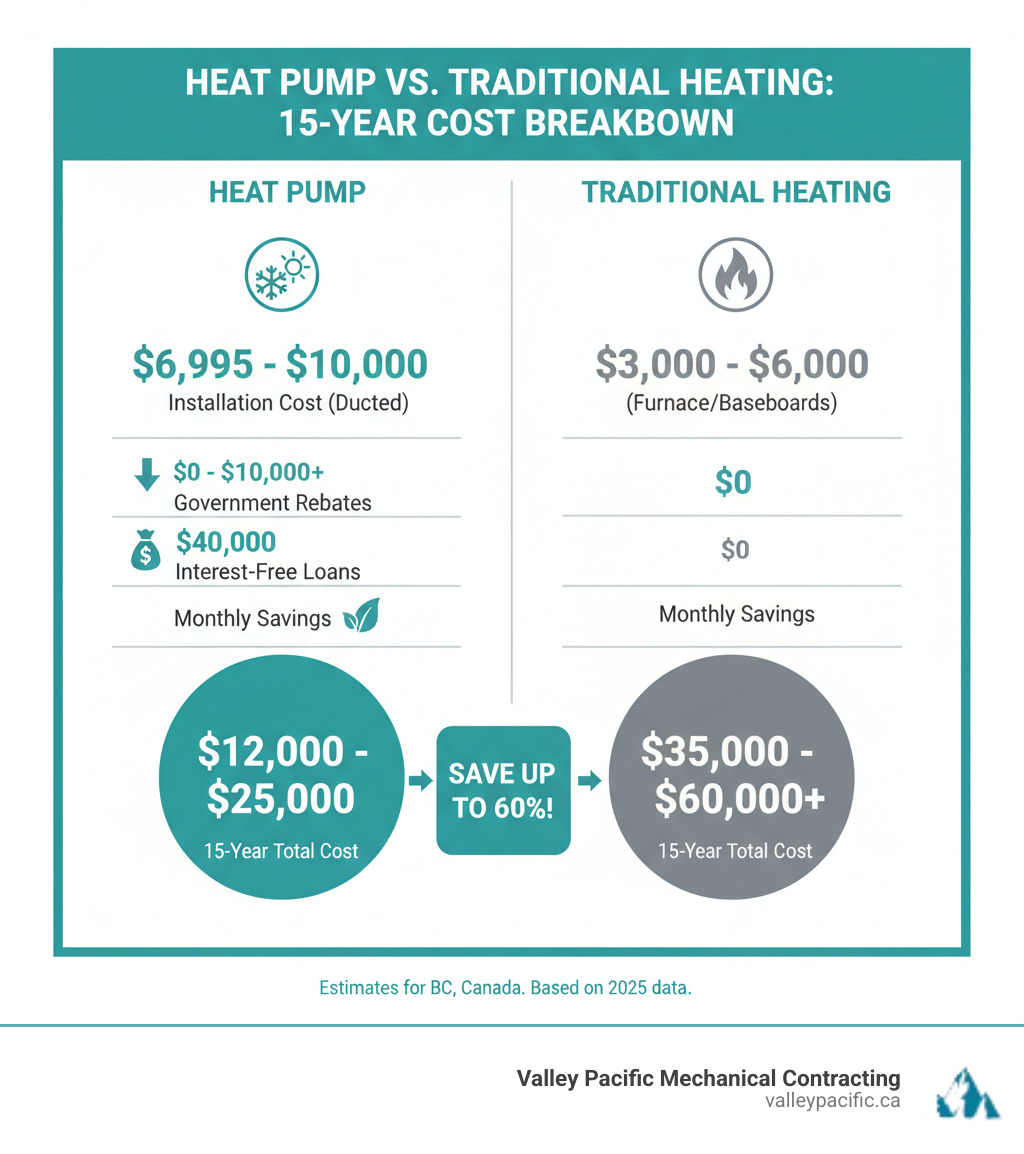
Basic affordable heat pump service glossary:
Understanding the Full Cost of a Heat Pump
When shopping for an affordable heat pump service, it's crucial to look beyond the initial price tag. The true cost includes the unit, professional installation, and long-term operational expenses. Think of it like a car: the sticker price is just one part of the total cost of ownership, which also includes fuel efficiency and maintenance.
The upfront investment covers the unit and installation. Ducted systems use existing ductwork for whole-home comfort, while ductless mini-splits provide zoned heating and cooling without ducts. Your home's layout, size, and the chosen model all influence the initial cost. To make this more manageable, some companies, including Valley Pacific Mechanical, offer financing or rental programs that spread the cost over time, often with maintenance included.
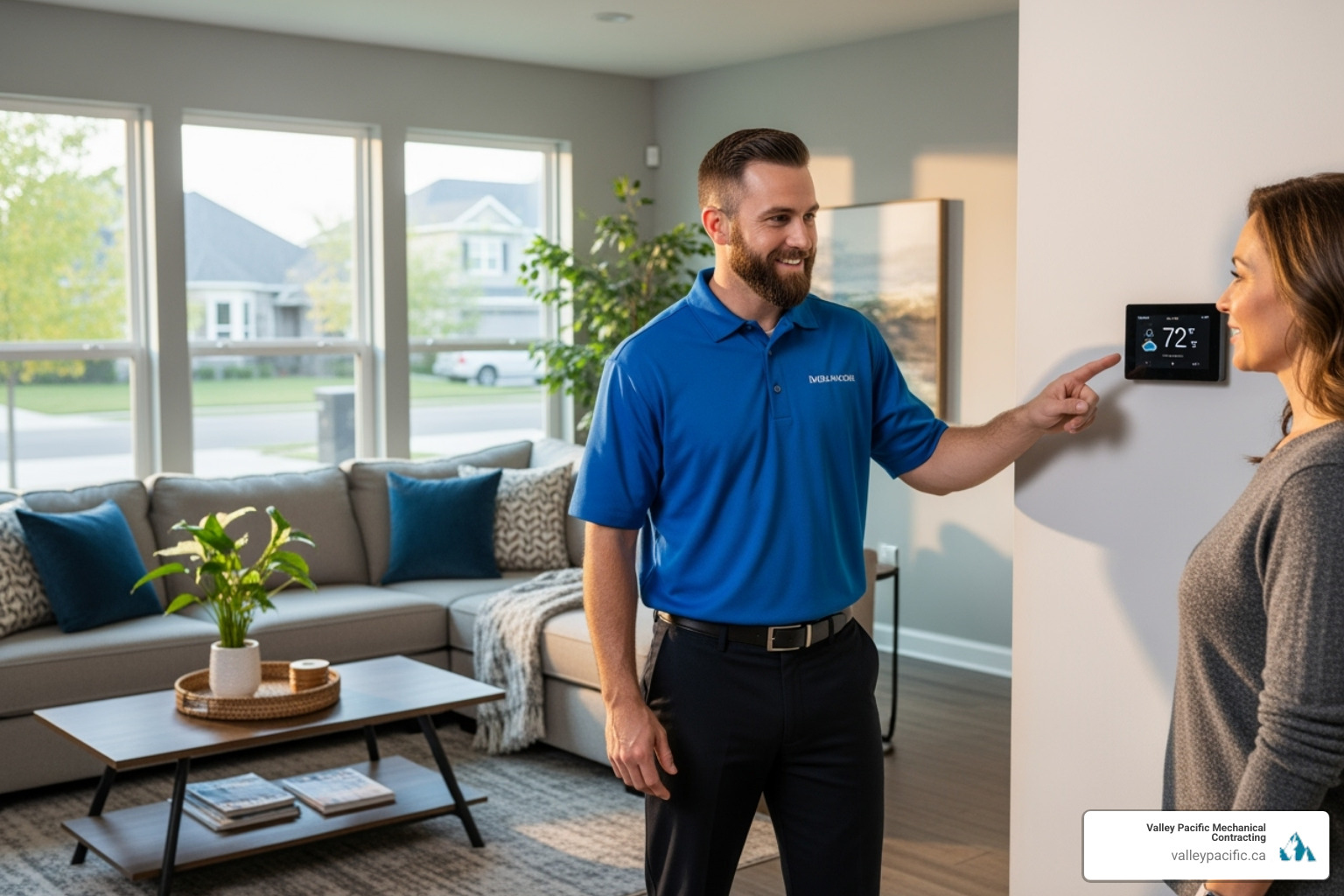
Once installed, the ongoing costs are where heat pumps truly excel. Their main expense is electricity, but because they move existing heat rather than creating it, they are incredibly efficient. This efficiency translates directly into lower monthly utility bills. Regular maintenance is another ongoing consideration, but it's an investment that prevents surprise breakdowns and extends the system's lifespan. Higher efficiency ratings (SEER for cooling, HSPF for heating) also mean lower long-term operating costs. For more details on their dual capabilities, check out our page on Heat Pump AC.
How Heat Pumps Compare to Traditional Systems
Traditional furnaces and boilers create heat by burning fuel. Heat pumps use a different approach: energy transfer. Even on a cold day, there is heat energy in the outdoor air. A heat pump extracts this heat and moves it inside. In summer, it reverses the process, pulling heat from your home and releasing it outdoors. This transfer method is far more efficient than generating heat. For every unit of electricity a heat pump uses, it can move three or more units of heat, delivering substantial long-term operational savings and a reduced carbon footprint.
Their dual-purpose functionality is another major advantage. One system handles both heating and cooling, simplifying your home's setup and maintenance needs.
| Feature | Heat Pump | Traditional Furnace/AC System |
|---|---|---|
| Functionality | Heating & Cooling (year-round) | Furnace: Heating only; AC: Cooling only |
| Energy Source | Electricity (moves heat) | Electricity (AC), Natural Gas/Oil/Propane (Furn.) |
| Efficiency | Very High (transfers heat) | Moderate (generates heat) |
| Environmental | Low carbon footprint, reduced emissions | Higher carbon footprint (especially fossil fuels) |
| Comfort | Consistent, quiet, even heating/cooling | Can be less even, louder operation |
| Lifespan | 12-15 years (with maintenance) | Furnace: 15-20 years; AC: 10-15 years |
The Role of Maintenance in an Affordable Heat Pump Service
Just like a car needs regular oil changes, your heat pump requires preventative care to avoid expensive problems. Professional maintenance should be performed at least once a year. During these visits, technicians clean coils, check refrigerant levels, and inspect electrical components to catch small issues before they become major breakdowns.
Regular maintenance directly impacts system longevity, helping a heat pump last 12-15 years or more. It also maintains peak efficiency, keeping your energy bills low. Dirty filters or clogged coils force the system to work harder, wasting electricity. Between professional visits, you can help by cleaning or replacing your filters every one to three months and keeping the outdoor unit clear of debris. Think of maintenance as an insurance policy for your comfort and budget. For more tips, explore our Seasonal Heat Pump Maintenance Tips.
Making Heat Pumps Affordable: Rebates, Grants, and Financing
Many homeowners are surprised to learn that the upfront cost of a heat pump may be much lower than they think. With available rebates and financing, you could end up paying a fraction of the sticker price. Governments across Canada are eager to help homeowners switch to energy-efficient heating and cooling because it reduces carbon emissions and lowers energy demand.
These incentives can transform a major expense into a smart, manageable home investment. The key is knowing what programs are available and how to access them. A great first step is to check the federal government's resource to find financial incentives in your area.

Government Rebates and Incentive Programs
In British Columbia, homeowners have access to some of the most generous heat pump incentives in the country. BC Hydro and the CleanBC Better Homes initiative offer substantial rebates for qualifying heat pump installations, especially for homeowners switching from less efficient systems. The CleanBC Better Homes initiative provides detailed information on how to apply.
If your home uses oil heating, the federal Oil to Heat Pump Affordability (OHPA) program provides significant upfront payments to help you make the switch. This grant can cover the heat pump, necessary electrical upgrades, and the safe removal of your old oil tank. Beyond rebates, the Canada Greener Homes Loan offers substantial, long-term, interest-free financing for home energy retrofits, including heat pump installations. This allows you to upgrade now and spread the payments out comfortably while enjoying immediate energy savings.
Navigating these programs can be complex, but we help homeowners understand their eligibility and guide them through the application process. Our Comprehensive Heat Pump Service Plans are designed to work with these incentives to maximize your investment.
Understanding Eligibility for Affordability Programs
Most programs have eligibility requirements designed to be accessible. Income requirements are common for programs aimed at helping middle- and lower-income families. You'll also typically need to own your home and use it as your primary residence. Your current heating source is also a factor, especially for fuel-switching programs like the OHPA program, which requires proof of recent oil purchases.
Geographic requirements also apply, with some incentives specific to British Columbia and others available nationwide. The heat pump itself must meet efficiency standards (like ENERGY STAR certification) and be installed by a licensed contractor. When applying, you'll generally need documents like proof of residence and ownership, heating fuel receipts, and contractor quotes.
One important caution: legitimate government agencies like Natural Resources Canada do not solicit homeowners through unsolicited calls, emails, or door-to-door visits. Be skeptical of anyone contacting you out of the blue. Always go to official government websites or trusted local contractors to learn about available programs. An affordable heat pump service is about leveraging these legitimate financial supports.
Maximizing Value with Professional Heat Pump Service
An affordable heat pump service isn't just about rebates; it's about ensuring your system is installed correctly to deliver comfort and savings for years. Professional service is invaluable. A top-of-the-line heat pump won't perform well if it's improperly sized or installed, leading to high bills and poor comfort.
With over 30 years of experience across the Lower Mainland—from Maple Ridge to Mission and Langley to Coquitlam—we've seen how a quality installation makes all the difference. Our goal is a headache-free experience where everything works right from the start. Proper sizing and contractor selection are the foundation of a great heat pump experience. For local insights, see our Maple Ridge Heat Pump Installation Tips.
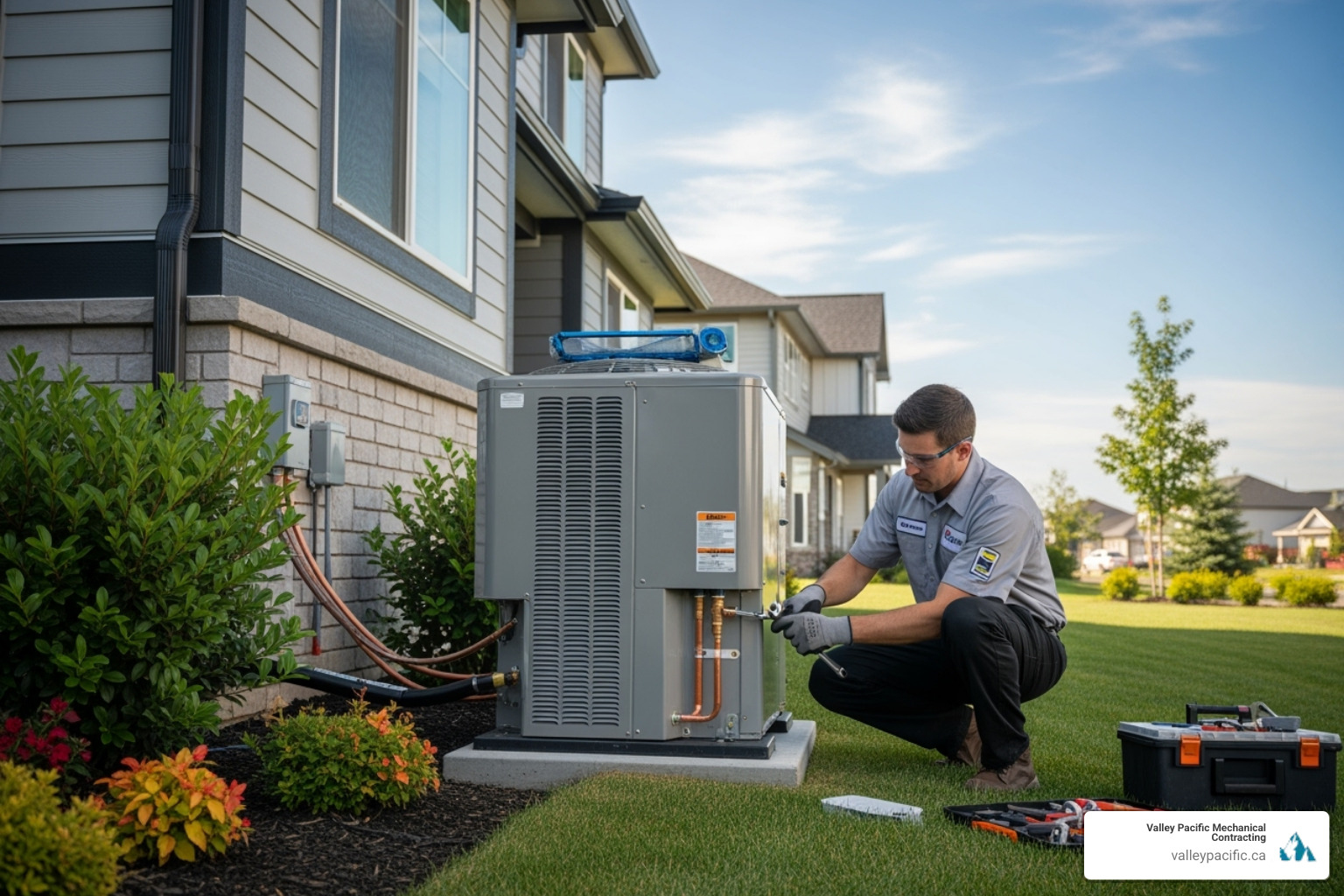
Why Proper Sizing and Installation are Crucial for Affordability
A heat pump's capacity must match your home's specific needs. This is determined through a detailed Manual J load calculation, which analyzes your home's insulation, windows, square footage, and more. An oversized heat pump will short-cycle—turning on and off frequently. This is inefficient, increases wear and tear, and leads to premature repairs. An undersized unit will struggle to maintain a comfortable temperature, running constantly without success, especially during extreme weather.
A properly sized system runs in longer, more efficient cycles, maximizing energy savings and extending the system's lifespan to 12-15 years or more. We also assess your existing ductwork and electrical panel to prevent unexpected costs. Sometimes, improving insulation first allows for a smaller, more affordable system. Proper placement of indoor and outdoor units is also critical for airflow and performance. Our guide on Best Locations for Heat Pump Placement covers this in more detail.
Services Offered by a Quality Heat Pump Provider
A truly affordable heat pump service includes support through every stage of ownership. We offer a comprehensive approach:
- System Design and Consultation: We listen to your needs and budget to help you choose the right system, whether it's ducted, ductless, or a dual fuel setup.
- Professional Installation: Our certified technicians follow strict industry standards, ensuring your system performs optimally and qualifies for government rebates.
- Expert Repair Services: We diagnose and repair all makes and models, providing a clear, written quote before any work begins. Our repairs are backed by a 1-year parts and 90-day labour warranty. Learn more about our Expert Heat Pump Repair Services.
- Routine Maintenance Plans: Annual tune-ups prevent costly problems and protect your investment by keeping your system running efficiently.
- 24/7 Emergency Service: We understand that emergencies don't wait. Our team is available around the clock to provide immediate assistance when you need it most.
Long-Term Benefits and Common Repair Needs
Investing in a heat pump pays dividends long after installation. The most significant long-term benefit is lower monthly energy bills. Because heat pumps transfer heat instead of creating it, they use far less electricity than traditional systems. Homeowners often see their winter heating costs drop by 25-40%—real money that stays in your pocket.
Beyond savings, you're also reducing your home's carbon footprint. By using less electricity and eliminating on-site fossil fuel combustion, you're making an environmentally responsible choice. Of course, like any hardworking appliance, heat pumps can develop issues. Knowing the warning signs helps you address small problems before they become expensive.
How to Identify Common Issues That Require an Affordable Heat Pump Service
Your heat pump will usually signal when it needs attention. Acting quickly on these signs often leads to simpler, more affordable repairs.
- Refrigerant Leaks: If your system isn't heating or cooling effectively or you hear a hissing sound, you may have a leak. Low refrigerant cripples performance. Our blog on Signs Heat Pump Refrigerant is Low has more details.
- Blower Motor Problems: Weak airflow or strange noises from the indoor unit can indicate a failing blower motor, which is responsible for circulating air through your home.
- Frozen Coils: While a light frost is normal in winter, a thick layer of ice on the outdoor unit points to a problem like dirty filters or a malfunctioning defrost cycle.
- Thermostat Issues: Before assuming the worst, check your thermostat. Is it responsive? Does it need new batteries? The issue might be with the controls, not the heat pump itself.
- Unusual Noises: Grinding, squealing, or buzzing sounds are red flags that signal mechanical problems. Our guide on Heat Pump Grinding Noises Causes can help you identify the source.
- Reduced Performance: If your home isn't reaching the set temperature or the system runs constantly, it's struggling and needs a professional diagnosis.
When you spot these signs, don't wait. We provide a clear, written quote after diagnosing the issue, so you know the cost before work begins. For a full list of warning signs, visit our page on Signs Your Heat Pump Needs Repair.
Frequently Asked Questions about Heat Pump Services
Homeowners often have great questions when considering a heat pump. Here are answers to some of the most common ones we hear.
Do I need to keep my furnace if I install a heat pump?
For many Lower Mainland homeowners, the answer is yes, and it's a smart choice. A dual fuel system pairs your new heat pump with your existing furnace. The heat pump handles the heating for most of the year. When the temperature drops to a very low point (which you can set), the system automatically switches to the furnace for backup heat. This gives you the best of both worlds: incredible efficiency most of the time and powerful backup heat for the coldest days. To learn more, visit our page on Residential Heat Pumps.
How long do heat pumps typically last?
A well-maintained heat pump will typically last 12 to 15 years. The key to reaching and exceeding this lifespan is proper care from day one. This includes correct sizing and professional installation, followed by annual professional maintenance. Simple homeowner tasks, like regularly changing air filters, also make a huge difference in system health and longevity. For more on this, explore our guide on Heat Pump Maintenance.
What are the main benefits of choosing a heat pump?
The advantages of switching to a heat pump are significant and go beyond just cost savings.
- Energy Efficiency: Heat pumps use far less electricity than traditional systems, reducing heating costs by 25-40%.
- Year-Round Comfort: One system provides both heating in the winter and cooling in the summer.
- Environmental Benefits: A smaller carbon footprint and the elimination of on-site fossil fuel combustion make them an eco-friendly choice.
- Quiet Operation: Modern heat pumps run much more quietly than older HVAC systems.
- Improved Air Quality: Many systems include advanced filtration to remove dust and allergens from your home's air.
For a deeper dive, check out our article on Consider Heat Pump Installation Reasons.
Conclusion
Achieving affordable heat pump service is about making a smart investment for the long term. True affordability combines a manageable upfront cost with significant energy savings, reliable performance, and environmental benefits. The financial landscape has never been more favorable, with generous government rebates and interest-free loans available to dramatically lower the initial investment. Combined with a 25-40% reduction in heating bills, the case for switching is compelling.
However, these benefits are only realized with professional service. Proper sizing and installation are critical to prevent issues like short-cycling or underperformance, which waste energy and shorten the system's life. Regular maintenance is the best way to protect your investment, ensure peak efficiency, and avoid costly emergency repairs.
Choosing a heat pump is a decision that feels good both financially and ethically, as it significantly reduces your home's carbon footprint. With over 30 years of expertise, Valley Pacific Mechanical provides a headache-free experience for homeowners across the Lower Mainland, including Mission, Maple Ridge, Langley, Pitt Meadows, and Coquitlam. We guide you through the rebate process, ensure your system is perfectly sized and installed, and provide ongoing support.
Ready to experience the comfort and savings of a professionally installed heat pump? Let's talk about what's possible for your home.
Why Your Furnace Circuit Board Matters
When your heating system suddenly stops working in the middle of winter, you need to find HVAC companies in Coquitlam that can fix a furnace circuit board. The circuit board is your furnace's brain, controlling everything from ignition to blower operation. When it fails, you're left without heat, often at the worst possible time.
Circuit board problems can manifest as no heat, strange error codes, or a furnace that starts and stops randomly. These issues require professional diagnosis because the electrical components are complex and potentially dangerous. In Coquitlam, where temperatures can drop quickly, having a reliable HVAC company on call is essential for your family's comfort and safety.
For expert guidance on maintaining your entire HVAC system, check out our comprehensive HVAC maintenance guide. When you need immediate professional help, contact us for fast, reliable furnace circuit board repair.
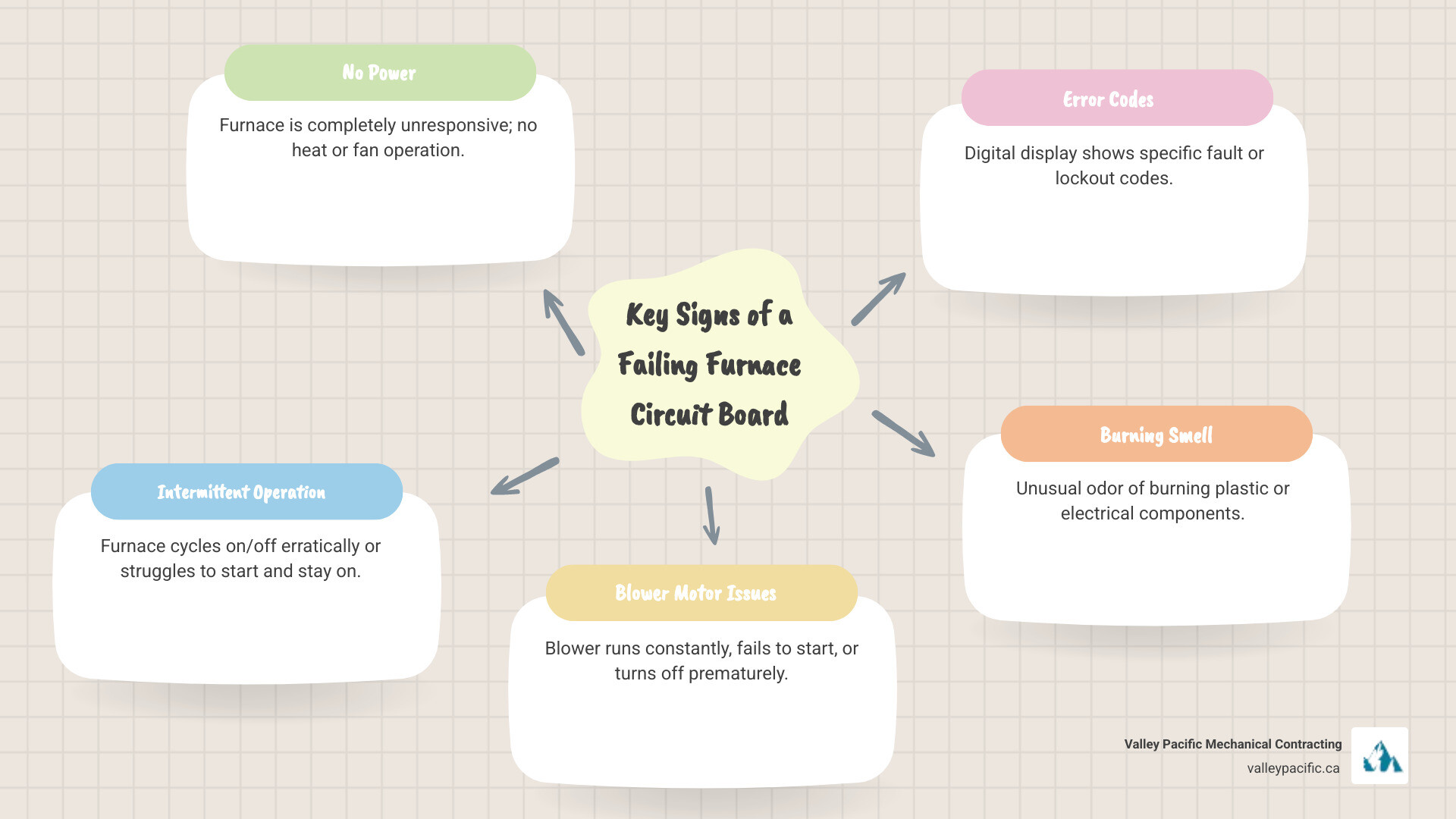
Common Signs of a Malfunctioning Furnace Circuit Board
Your furnace often gives warning signs before its circuit board fails completely. Recognizing these can help you find HVAC companies in Coquitlam that can fix a furnace circuit board before a minor issue becomes a winter emergency. Key signs include:
- No Power: The furnace is completely unresponsive, with no clicks, hums, or signs of life.
- Intermittent Operation: The system short-cycles, turning on and off randomly without properly heating your home.
- Blower Motor Issues: The blower may run constantly even when the furnace isn't heating, or it might not turn on at all, preventing warm air from circulating.
- Error Codes or Flashing Lights: Diagnostic LEDs on the furnace blink in specific patterns to signal a problem, often pointing to the control board.
- Burning Smell: An electrical burning odour is a red flag indicating the board may be overheating. Shut off the furnace immediately and call a professional.
- Visible Damage: Scorch marks, bulging capacitors, or burnt resistors on the board are clear signs of serious damage.
For more warning signs, see our guide on HVAC System May Fail Soon Signs.
How to Identify if the Circuit Board Needs Repair
While circuit board issues almost always require a professional, you can perform a few simple checks first.
- Check the Thermostat: Ensure it's set to "heat" and the temperature is set higher than the current room temperature. Replace the batteries if it has them.
- Check the Breaker Panel: Look for a tripped breaker for your furnace. Reset it once. If it trips again, there's an underlying electrical problem that needs professional attention.
- Note Diagnostic Lights: If you see flashing lights, check your furnace manual for the corresponding error code. This information is valuable for the technician.
If these steps don't resolve the issue, it's time to call an expert. DIY repairs on circuit boards are dangerous due to the complex electrical components. A qualified technician can accurately diagnose the problem. For more details, visit our page on Furnace Circuit Board Repair. Safely and correctly fixing a circuit board requires professional expertise.
The Professional Process for Diagnosing and Repairing a Circuit Board
When you find HVAC companies in Coquitlam that can fix a furnace circuit board, you're enlisting professionals who follow a systematic approach to ensure a safe and reliable repair. The process includes:
- Safety Shutdown: The technician completely shuts down power and gas to the furnace to prevent electrical shock or gas leaks.
- Visual Inspection: They look for obvious signs of damage like scorch marks, swollen capacitors, or loose wiring.
- Multimeter Testing: Using a multimeter, the technician tests voltage, continuity, and resistance to trace the electrical fault.
- Repair or Replacement Decision: Based on the diagnosis, the technician will recommend either repairing a minor issue (like a blown fuse) or replacing the board if damage is extensive.
- System Testing: After the repair, the technician runs the furnace through multiple cycles to confirm it operates safely and efficiently. This is a key part of a proper HVAC System Check.
Can a Faulty Board Affect Other HVAC Components?
Yes. A malfunctioning circuit board is the command center, and its failure can damage other expensive parts. It can send incorrect signals that cause:
- Blower Motor Stress: The motor may run constantly or not at all, leading to premature wear and tear.
- Ignition System Failure: The precise sequence for ignition can be disrupted, leaving you without heat. This often requires immediate Furnace Repair in Coquitlam.
- Safety Sensor Malfunctions: The board may misinterpret signals from safety sensors, creating dangerous conditions like overheating or unburned gas.
- Inconsistent Voltage: Fluctuating voltage can damage other electrical components, turning one problem into many.
Addressing board issues quickly protects the rest of your furnace from a cascade of failures.
The Dangers of DIY vs. Hiring HVAC companies in Coquitlam that can fix a furnace circuit board
Attempting a DIY circuit board repair is dangerous. We strongly recommend hiring a professional. The risks include:
- Electrical Shock: Furnaces use high voltage that can cause serious injury or death, even when the power is off, due to stored energy in capacitors.
- Gas Line Safety: Improperly handling gas connections can lead to leaks, fires, or carbon monoxide poisoning.
- Voiding Your Warranty: Most manufacturers require repairs to be done by certified professionals to keep the warranty valid.
- Incorrect Diagnosis and Further Damage: Misdiagnosing the problem can lead to wasted money on unneeded parts and can cause more damage to your system.
Trusting Licensed HVAC Technicians ensures the job is done safely and correctly the first time.
How to Find HVAC Companies in Coquitlam That Can Fix a Furnace Circuit Board
When your furnace fails, you need help fast. But taking a moment to research can ensure you find HVAC companies in Coquitlam that can fix a furnace circuit board properly. Look for these key qualities:
- Solid Local Reputation: Check online reviews and ask for local recommendations. A company with a strong community presence understands the heating needs of Lower Mainland homes. Our guide to HVAC Services in Coquitlam offers a helpful overview.
- 24/7 Emergency Service: Circuit boards fail at the worst times. A reputable company will be available around the clock to take your call.
- Clear Service Area: Confirm the company serves your specific Coquitlam neighbourhood, whether it's Maillardville, Westwood Plateau, or Chineside.
- High Customer Satisfaction: Look for consistently high ratings (4.5 stars or more) and read comments about professionalism, communication, and reliability.

What to Look for in a Qualified HVAC Technician
The technician's qualifications are just as important as the company's reputation. Ensure they have:
- NATE-Certification: This certification proves a technician's expertise in HVAC systems.
- Gasfitter License: This is mandatory for anyone working on a gas furnace, ensuring they follow strict safety codes.
- Experience: Technicians with years of experience can diagnose complex circuit board issues more quickly and accurately.
- Insurance and Bonding: This protects you from liability in case of accidents or property damage during the repair.
For more on professional services, see our page on HVAC Repair in Coquitlam.
Questions to Ask a Potential HVAC Company
When you call, have these questions ready:
- Do you offer warranties on circuit board repairs or replacements?
- What furnace brands do you service?
- How quickly can you respond to emergencies in Coquitlam neighbourhoods like Chineside?
- Are your technicians certified and licensed?
- Can you explain your diagnostic process?
- Do you offer preventative maintenance plans to avoid future issues?
Extending the Life of Your Furnace Circuit Board
Your furnace circuit board is designed to last 15-20 years, but certain factors can shorten its lifespan. Common threats include:
- Power Surges: Spikes in electrical current from the grid or lightning can fry delicate electronic components.
- Moisture Damage: High humidity, a clogged condensate drain, or a leaky humidifier can cause corrosion and short circuits.
- Dust and Debris: A buildup of dust acts as an insulator, trapping heat and causing the board to overheat.
- Overheating: Caused by dust, poor airflow, or a stressed system, excessive heat accelerates the breakdown of electronic components.
For a comprehensive approach to system health, see our guide on HVAC Preventative Maintenance.
Preventative Maintenance Tips to Avoid Future Repairs
You can take proactive steps to extend your circuit board's life and prevent emergency repairs.
- Install a Whole-Home Surge Protector: A surge protector installed at your main electrical panel shields your furnace and other appliances from damaging power spikes.
- Keep it Clean and Clear: Regularly change your furnace air filter (every 1-3 months) to prevent dust buildup and ensure proper airflow. Keep the area around the furnace unit clear of debris.
- Schedule Annual Professional Tune-Ups: A technician can spot early warning signs of wear, corrosion, or heat stress on the circuit board and ensure all electrical connections are secure.
- Check for Moisture: Periodically inspect the area around your furnace for any signs of leaks or condensation and address them immediately.
- Ensure Proper Airflow: Keep all supply and return air vents in your home unblocked by furniture or rugs to prevent your furnace from overworking and overheating.
Following these HVAC Preventative Maintenance Tips gives your circuit board the best chance at a long, healthy life.
Your Trusted Partner for Furnace Repair in Coquitlam
When your furnace's circuit board fails, your family's comfort and safety are on the line. As we've covered, this component is the brain of your heating system, and its repair is a job for experienced professionals, not a DIY project.
At Valley Pacific Mechanical Contracting, we have over 30 years of experience with furnace repair in the Lower Mainland. Our licensed and certified technicians have the expertise to diagnose and fix complex circuit board issues safely and effectively. When you need to find HVAC companies in Coquitlam that can fix a furnace circuit board, you need a team that is reliable, transparent, and committed to safety.
We approach every job with a "safety first" mindset, following rigorous protocols for all electrical and gas work. We offer 24/7 emergency service in Coquitlam, Langley, Pitt Meadows, Maple Ridge, and Mission because we know heating problems don't stick to a 9-to-5 schedule. Our goal is to provide a "headache-free" experience and restore your heat as quickly as possible.
Don't wait in the cold. Contact us for expert furnace repair services and let our team restore warmth and peace of mind to your home.
Why Reliable Furnace Care Matters for Langley Homeowners
Furnace repair Langley services are essential for home comfort and safety during our cold, damp winters. If your furnace is making strange noises, producing unusual smells, or failing to heat your home properly, you need a qualified technician to diagnose and fix the problem quickly.
Quick Guide: When to Call for Furnace Repair in Langley
| Warning Sign | What It Means | Action Required |
|---|---|---|
| Strange noises (banging, grinding, squealing) | Mechanical problems with blower motor or other components | Schedule repair soon |
| Unusual smells (rotten eggs, burning) | Possible gas leak or electrical issue | Call immediately |
| Weak or no airflow | Clogged filter, blower motor failure, or ductwork issues | Professional inspection needed |
| Yellow pilot light | Incomplete combustion, possible carbon monoxide risk | Emergency service required |
| Inconsistent heating | Thermostat problems or failing components | Schedule diagnostic visit |
Langley's climate puts extra stress on heating systems. For the over 37,000 households in the area, a furnace breakdown isn't just uncomfortable—it can be dangerous. Your furnace does more than keep you warm; it protects your home from frozen pipes, maintains healthy indoor air quality, and prevents carbon monoxide risks. Prompt professional attention is critical when something goes wrong.
Most furnaces show warning signs before a complete failure. While a gas furnace can last 15-20 years, neglecting small problems shortens that lifespan. Regular servicing helps your furnace run efficiently, reduces energy costs, and catches potential safety hazards early, preventing costly emergency repairs.
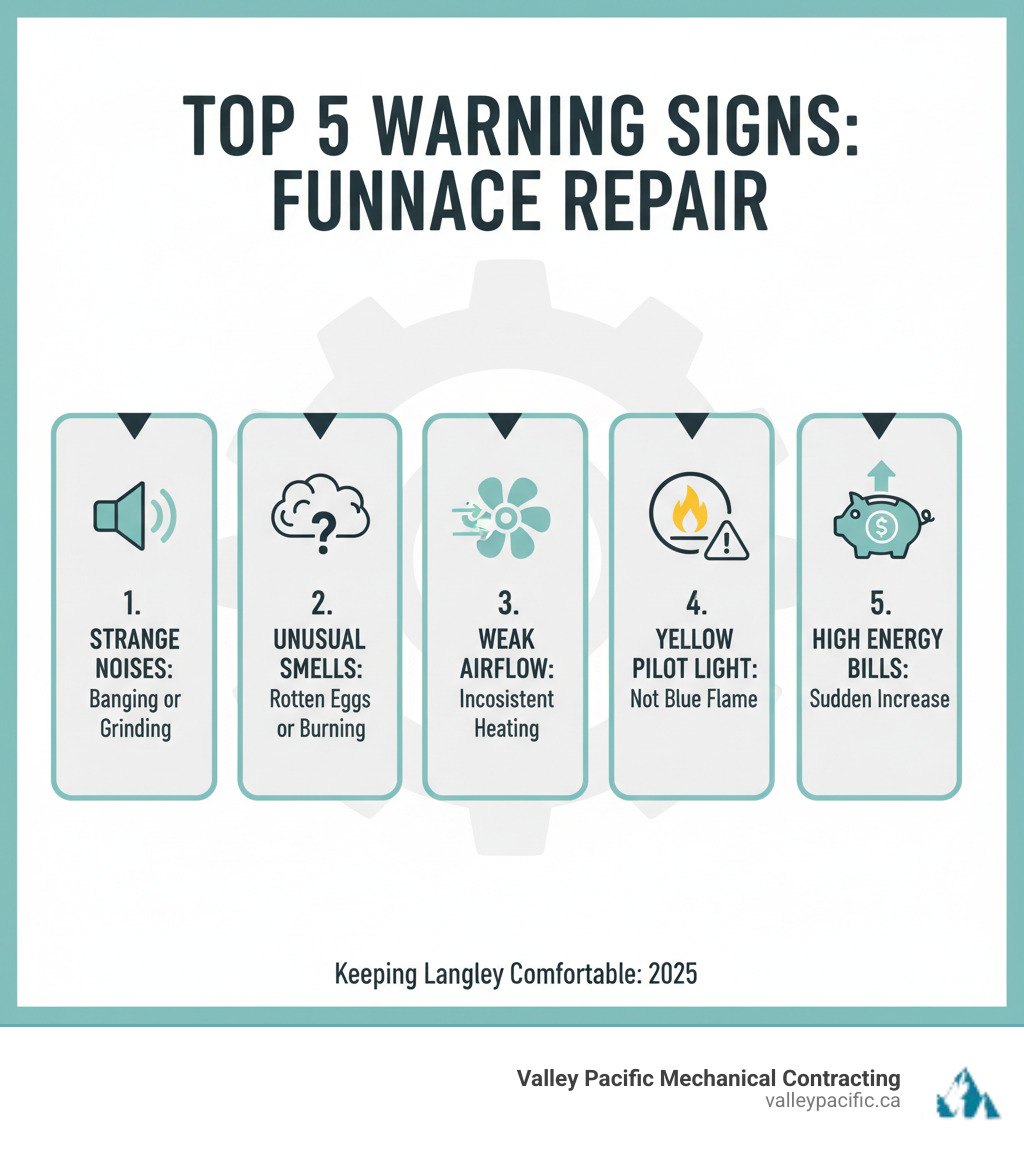
Furnace repair Langley glossary:
Identifying Furnace Problems: When to Call for Repairs
Your furnace works quietly in the background, but when something goes wrong, the signs aren't always obvious at first. Recognizing early warning signals can mean the difference between a simple fix and a complete system failure. More importantly, it helps protect your family from safety hazards. Knowing when to call for professional furnace repair Langley services is about maintaining a safe, comfortable home.
We believe in providing a headache-free experience when your heating system needs attention. That means responding quickly, diagnosing accurately, and getting your furnace back to peak performance without the runaround.
Common Warning Signs Your Furnace Needs Attention
Your furnace will usually signal when something is wrong. Strange noises are a common clue; banging could be ductwork or a burner issue, while squealing often points to a failing blower motor or belt. Grinding noises are particularly concerning and usually indicate a motor problem requiring immediate help. Learn about common blower motor issues.
Unusual smells demand immediate attention. While a dusty odor is normal at the start of the season, persistent burning or electrical smells are red flags. The smell of "rotten eggs" is an urgent sign of a potential gas leak.
If you notice weak or inconsistent airflow, your furnace is struggling. This can be caused by a clogged filter, blower motor issues, or ductwork problems. A sudden spike in energy bills also indicates declining efficiency. For older furnaces, a yellow or flickering pilot light instead of a healthy blue one warns of incomplete combustion and a possible carbon monoxide risk.
Frequent cycling—when the furnace turns on and off rapidly—wastes energy and puts excessive wear on components. Understand furnace short cycling, its signs, and solutions to protect your system. Finally, if your furnace struggles to ignite or won't start, you may have a faulty igniter or other component failures. Explore common reasons why a furnace won't ignite.
The Dangers of a Gas Leak and What to Do
A natural gas leak is a serious furnace emergency. Utility companies add a chemical called mercaptan to give gas a distinct "rotten egg" odor for safety. Other signs include hissing sounds near gas lines or dying vegetation near outdoor lines.
If you suspect a gas leak:
- Evacuate everyone immediately, including pets.
- Do not use any electrical devices like light switches or phones inside.
- If safe, open windows and doors on your way out to ventilate.
- Call 911 or your gas provider (FortisBC) from a safe distance outside your home. Do not re-enter until emergency services give the all-clear.
As a FortisBC Trade Ally Member, we are committed to gas safety and can perform professional repairs once your home is declared safe.
Emergency Situations Requiring Immediate Furnace Repair in Langley
Some furnace problems can't wait. You need help fast when safety is a concern or your heating fails in cold weather.
- No heat during winter: This is a danger to vulnerable family members and can lead to frozen pipes, causing major water damage.
- Suspected gas leak: As discussed, this requires immediate evacuation and a call to 911.
- Electrical issues: Burning smells, sparks, or frequently tripping breakers are fire hazards that need immediate attention.
- Carbon monoxide detector alarm: CO is an odorless, deadly gas. If the alarm sounds, evacuate immediately and call 911.
For these urgent situations, Valley Pacific Mechanical Contracting offers 24/7 emergency service. When you need expert furnace repair in Langley, we're ready to respond day or night.
The Importance of Proactive Furnace Maintenance in Langley
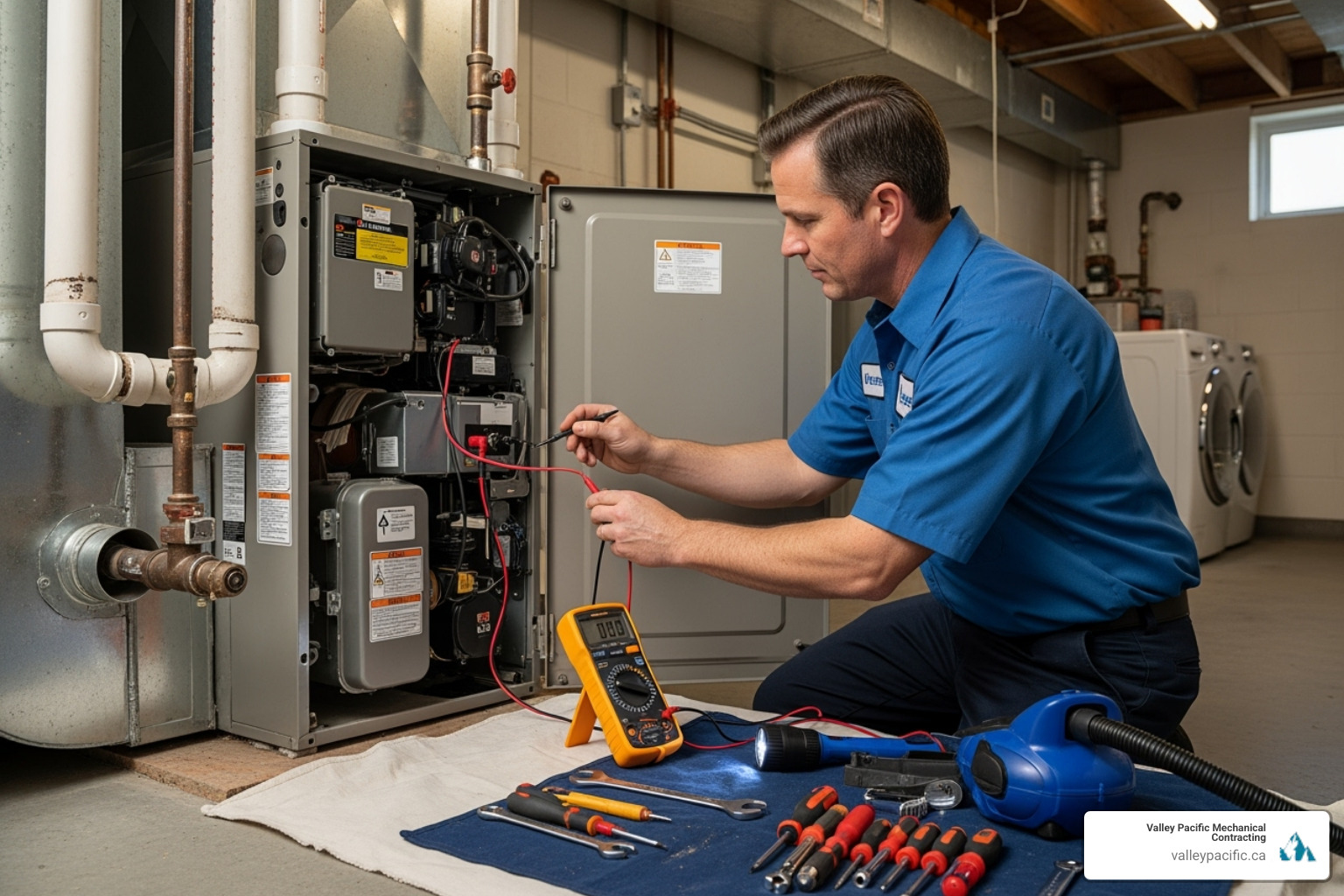
Just as a car needs regular oil changes, your furnace requires proactive care to run reliably. In Langley, where winters can be chilly and damp, keeping your heating system in top shape is about smart living, not just comfort.
Proactive furnace maintenance helps your system last longer, run at peak energy efficiency, and keep winter utility bills in check. It's a small investment that pays big dividends in comfort and savings. Our HVAC maintenance plans are designed to keep your furnace running smoothly and reliably through Langley's demanding climate.
Benefits of Regular Furnace Servicing
Investing in regular servicing provides a host of benefits:
- Improved Efficiency: A well-maintained furnace doesn't have to work as hard, which translates directly to lower energy bills.
- Improved Safety: Technicians can spot potential hazards like gas leaks, carbon monoxide risks, or faulty wiring before they become dangerous.
- Extended Equipment Lifespan: Most furnaces last 15-20 years, but regular maintenance is key to reaching that lifespan.
- Fewer Breakdowns: Catching small problems early prevents surprise breakdowns on the coldest days of the year.
- Better Air Quality: Clean filters and components mean less dust and fewer allergens circulating through your home.
- Peace of Mind: Know your heating system is professionally checked and ready for winter. For more advice, see our HVAC preventative maintenance tips.
How Often Should You Service Your Furnace?
We recommend annual servicing, ideally in the fall before cold weather sets in. This pre-season check-up ensures your system is ready for a Langley winter. Some manufacturers may even suggest bi-annual service for older or heavily used systems.
Given our damp, chilly climate, an annual check-up is a smart move to address any issues from the previous winter's workload. Scheduling your annual HVAC system check is a simple step that improves efficiency and helps avoid unexpected furnace repair Langley needs.
The Role of Your Thermostat in Furnace Performance
The thermostat is the brain of your furnace, telling it when to turn on and off. Using it correctly can significantly impact your comfort and energy bills.
Modern options like programmable thermostats let you set different temperatures for different times of day, while smart thermostats learn your habits and can be controlled from your phone. Using the proper settings is key; a comfortable temperature around 20-21°C during the day, and slightly lower at night or when you're away, can lead to significant savings. For larger homes, zone control systems allow you to heat only the areas you're using.
Understanding your thermostat is an easy way to boost efficiency. If you're curious about upgrading, we can help as part of our comprehensive HVAC services in Langley.
Your Guide to Expert Furnace Repair Langley Services
When your furnace acts up, you need skilled professionals who can fix the problem correctly the first time. That's where furnace repair Langley expertise makes all the difference.
Our approach is straightforward: thorough diagnostics, quality parts, and a headache-free experience. With over 30 years in the business, we've seen and solved nearly every furnace problem imaginable. We're proud to offer our comprehensive furnace services to keep your home comfortable all winter.
Comprehensive Repair Services for Your Home
Our technicians are trained to diagnose and repair every aspect of your heating system. Common issues we handle include:
- Blower Motor Issues: We repair or replace faulty motors to restore proper airflow and eliminate strange noises.
- Ignition and Pilot Light Problems: Whether you have a modern electronic igniter or an older pilot light, we diagnose and fix ignition failures to get your heat running again. Learn more about common reasons your furnace won't ignite.
- Thermostat Malfunctions: We troubleshoot communication issues between your thermostat and furnace, replacing the unit if necessary.
- Heat Exchanger Concerns: This is a serious safety issue. We are trained to identify cracks or damage that could lead to carbon monoxide leaks and will recommend the safest course of action.
- Circuit Board Failures: As the furnace's brain, a faulty control board can cause numerous problems. We have the tools to diagnose and perform furnace circuit board repair.
Our technicians arrive in well-stocked service vehicles, allowing us to complete 93% of repairs on the first visit for faster comfort.
Choosing a Reliable and Trustworthy HVAC Company
When your furnace breaks down, you want a company you can trust. Look for these key qualities:
- Licensed and Certified Technicians: This ensures your technician meets professional standards for safety and best practices.
- Customer Reviews: See what other Langley homeowners say about a company's reliability and professionalism.
- Local Experience: A company familiar with Langley's climate, homes, and building codes can provide better, faster service.
- Professional Accreditations: We are BBB Accredited, reflecting our commitment to ethical practices.
- Transparency and Communication: You deserve a clear explanation of the problem and your options before any work begins.
We believe in treating every customer with respect, showing up on time, and delivering the headache-free experience we promise.
The Advantages of Using a Local Langley Provider
Choosing a local company for your furnace repair Langley needs offers distinct benefits:
- Faster Response Times: Being local means we can get to you quickly, which is crucial during emergencies.
- Local Code Knowledge: Our technicians know Langley's specific building codes, ensuring your repairs are safe and compliant.
- Community Investment: We live and work in Langley and are invested in the comfort and safety of our neighbours.
- Personalized Attention: You're never just a ticket number. We get to know our customers and provide solutions custom to their homes. Learn more about our Langley service area.
Choosing local means choosing a reliable partner invested in your long-term comfort.
Furnace Replacement and Installation Essentials
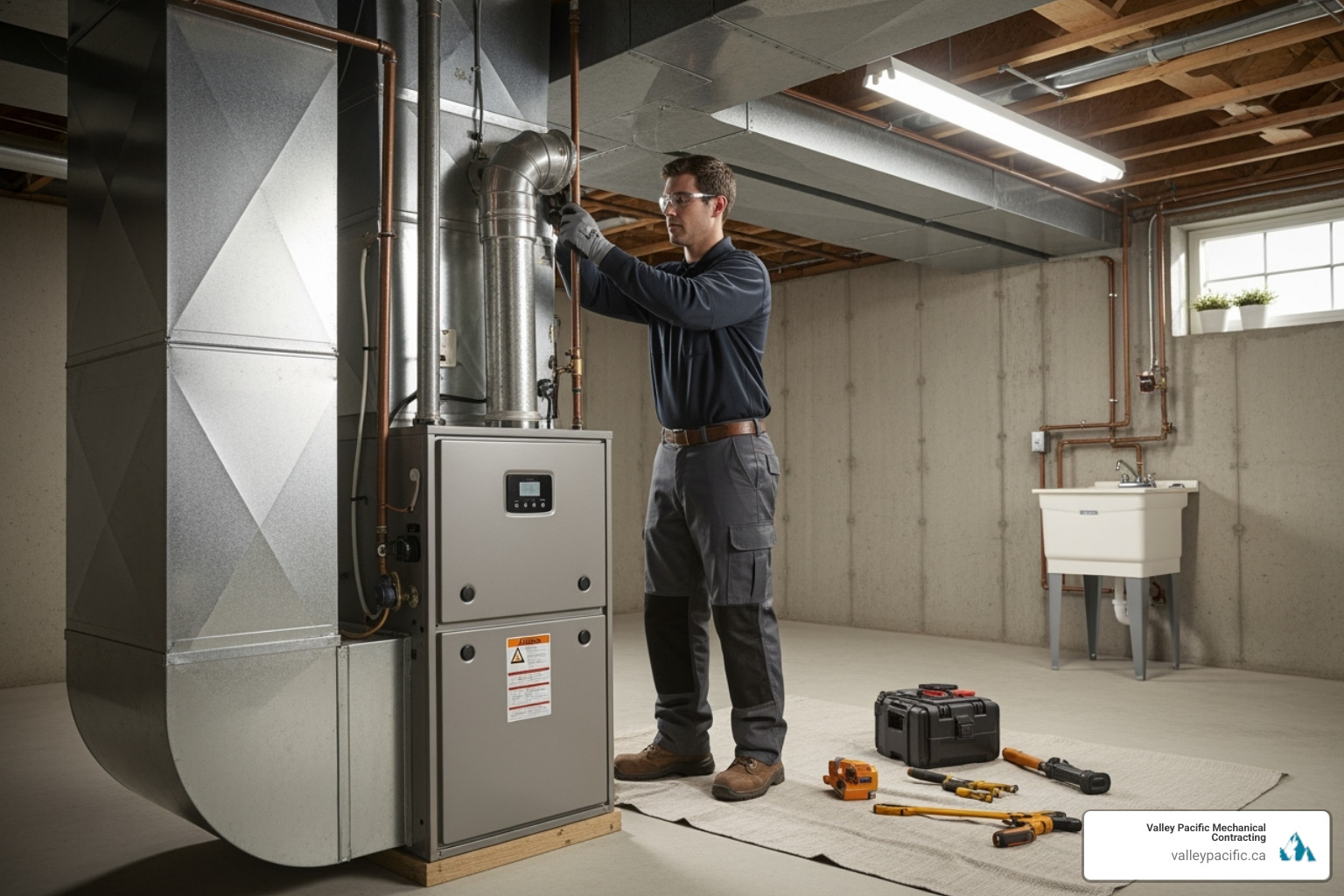
Sometimes, a repair isn't enough for an old furnace. When it's time, replacement is a smart move toward modern efficiency. This is an opportunity to upgrade to technology that keeps your home warmer while lowering energy bills for years. We guide you through every step, and our furnace installation homeowner essentials guide can help you prepare.
Repair vs. Replace: Knowing When It's Time for an Upgrade
The decision to repair or replace becomes clearer when you consider a few key factors:
- Furnace Age: Most furnaces last 15-20 years. As they approach this age, efficiency declines.
- Frequent Repairs: If you're calling for furnace repair Langley services every winter, those costs add up. Investing in a new unit may be more economical.
- Declining Efficiency: Rising utility bills are a clear sign your furnace is working harder and less efficiently.
- Safety Concerns: Recurring issues with gas leaks or carbon monoxide risks make replacement essential for your family's safety.
- Major Component Failure: If a critical part like the heat exchanger fails, the repair cost can be close to the price of a new unit, making replacement the better financial choice.
For more insights, check out our guide to HVAC system upgrades.
Furnace Types Explained: Gas, Electric, and Heat Pumps
Understanding your options helps you make the right choice for your Langley home:
- Natural Gas Furnaces: The most popular choice in our area, they provide powerful, consistent, and efficient heat.
- Electric Furnaces: A solid option where natural gas isn't available, though operating costs are typically higher.
- Dual Fuel Systems: These combine a natural gas furnace with an electric heat pump, intelligently switching between them to maximize efficiency based on outdoor temperatures.
- Heat Pumps: Increasingly popular in our climate, modern heat pumps are efficient at both heating and cooling. They work by moving heat rather than creating it, saving significant energy. We specialize in heat pump repair services in Langley and can help determine if this technology is right for you.
Energy Efficiency Rebates and Incentives
Upgrading to a high-efficiency furnace or heat pump can pay you back through various rebates and incentives. These programs from government and utility providers can significantly reduce your upfront investment.
High-efficiency models are measured by their AFUE (Annual Fuel Utilization Efficiency) rating—the higher the percentage, the more efficient the system. As a FortisBC Trade Ally Member, we stay current on all available programs, including those for high-efficiency gas furnaces and heat pumps. We can help you steer the application process to maximize your savings on your furnace installation in Langley.
Frequently Asked Questions about Furnace Care
We know you have questions about keeping your furnace running smoothly through Langley's winters. Here are answers to some of the most common concerns.
What are the most common furnace problems in Langley?
Based on our 30+ years of local experience, we see a few issues most often:
- Clogged Filters: This is the top problem. A dirty filter restricts airflow, reduces efficiency, and can cause the system to overheat.
- Thermostat Malfunctions: A faulty thermostat can cause inconsistent heating, or prevent the furnace from turning on or off correctly.
- Ignition or Pilot Control Problems: A worn-out igniter or a pilot light that won't stay lit will prevent your furnace from starting. Understanding common reasons your furnace won't ignite can help.
- Wear and Tear: The damp climate can accelerate wear on components like blower motors and bearings, leading to strange noises and eventual failure.
Can I perform any furnace maintenance myself?
Yes, a few simple tasks make a big difference. Regularly changing your air filter is the most important thing you can do. Check it monthly and replace it if you can't see light through it (typically every 1-3 months). Also, keep the area around your furnace clear of clutter for proper airflow and safety, and ensure vents and registers throughout your home are unobstructed. For anything more technical, it's always best to call a professional for safety and to avoid causing more damage.
What is furnace "short cycling" and is it bad?
Short cycling is when your furnace turns on and off in rapid, short bursts. Yes, it's very bad for your system. It's highly inefficient, driving up energy bills, and it puts extreme wear and tear on components like the igniter and blower motor, leading to a shorter furnace lifespan and more frequent repairs.
Common causes include an oversized furnace, a clogged air filter restricting airflow, or a faulty thermostat. If your furnace is short cycling, don't ignore it. This problem requires professional diagnosis to prevent further damage. Learn more about the signs and solutions for furnace short cycling.
When you need expert furnace repair Langley services, we're here to diagnose the problem quickly and get your system running smoothly again.
Conclusion
Your furnace is the heart of your home's comfort, especially during Langley's cold winters. Recognizing warning signs like strange noises or smells, and understanding the importance of regular maintenance, are key to ensuring your system runs reliably and safely. An annual service can extend your furnace's lifespan and prevent costly breakdowns, while a modern, high-efficiency replacement offers long-term energy savings and improved comfort.
Understanding your heating system empowers you to protect your home, but you don't have to do it alone. Having a trusted local partner who knows Langley's climate and responds quickly in an emergency makes all the difference.
For expert, reliable furnace repair Langley service backed by over 30 years of experience, trust the team at Valley Pacific Mechanical Contracting. We're here to provide the "headache-free" experience we're known for, with 24/7 emergency availability. Whether it's a sudden breakdown, routine maintenance, or a system upgrade, we're here to help.
For comprehensive heat pump services and furnace solutions in Langley, contact our experts today!
Finding Immediate Help When Your Pipe Bursts
Searching for "I need an emergency plumber in Maple Ridge for a burst pipe who is available 24/7" means you're in a crisis. A burst pipe is a major plumbing emergency that can cause extensive water damage in minutes. In Maple Ridge, factors like heavy rainfall and hard water can strain plumbing, making access to reliable 24/7 emergency services essential.
Quick Answer for Maple Ridge Residents:
- Valley Pacific Mechanical Contracting offers 24/7 emergency plumbing services in Maple Ridge.
- Our local plumbers can often arrive within 30 minutes of your call.
- We are available on weekends, holidays, and in the middle of the night.
- First step: Shut off your main water valve to minimize damage.
- Second step: Call a licensed emergency plumber immediately.
For comprehensive mechanical services, visit our emergency services page, or request immediate assistance if you're dealing with an active emergency right now.
Most critical plumbing issues don't follow business hours. Knowing who to call before disaster strikes is key, so you're not scrambling to find help while water floods your home.

A Burst Pipe Emergency: Your First 4 Steps
When a pipe bursts, acting quickly can minimize damage and get the situation under control. Follow these four essential steps to protect your home and family while you wait for help to arrive.
Step 1: Shut Off the Main Water Supply
Your first priority is to stop the water at its source. Find your main water valve, which is typically located in the basement, a crawl space, near the water heater, or outside by the water meter. Turn the round handle clockwise or the lever handle a quarter turn until it's perpendicular to the pipe. This single action is the most effective way to prevent further damage.
Step 2: Turn Off Electricity
Water and electricity are a dangerous mix. For your safety, go to your breaker panel. If you can reach it without stepping in water, turn off the breaker for the flooded area. If you're unsure which one it is, shut off the main breaker to the entire house to eliminate any electrocution risk. Crucially, if the panel is surrounded by water, do not approach it. Call for emergency help instead.
Step 3: Document the Damage
After securing the water and power, document the scene for your insurance provider. Take clear photos and videos of the burst pipe, the extent of the flooding, and any damaged property. This evidence of damage is crucial for a smooth insurance claims process.
Step 4: Call for 24/7 Professional Help
With the immediate threats handled, it's time to call for professional help. At Valley Pacific Mechanical Contracting, we provide immediate assistance 24/7, because emergencies don't wait. Our professional plumbers will quickly locate and repair the burst, helping you prevent extensive repairs and long-term issues like mold, structural damage, and warped flooring. Getting expert help fast is the best way to protect your home's long-term health. For urgent situations, learn more about how we handle critical calls on our Emergency Plumbing Services page.
I need an emergency plumber in Maple Ridge for a burst pipe. Who is available 24/7?
When a pipe bursts, you need help now. At Valley Pacific Mechanical Contracting, we provide 24/7 emergency plumbing services across Maple Ridge, including on weekends and holidays. We don't close for late nights because we know emergencies are inconvenient. When you search "I need an emergency plumber in Maple Ridge for a burst pipe. Who is available 24/7?"—we are the answer.
Because we are local to Maple Ridge, we can often arrive within 30 minutes of your call. This rapid response is critical to minimizing water damage and protecting your home. Our proximity means we're not coming from across the region; we're coming from just around the corner.
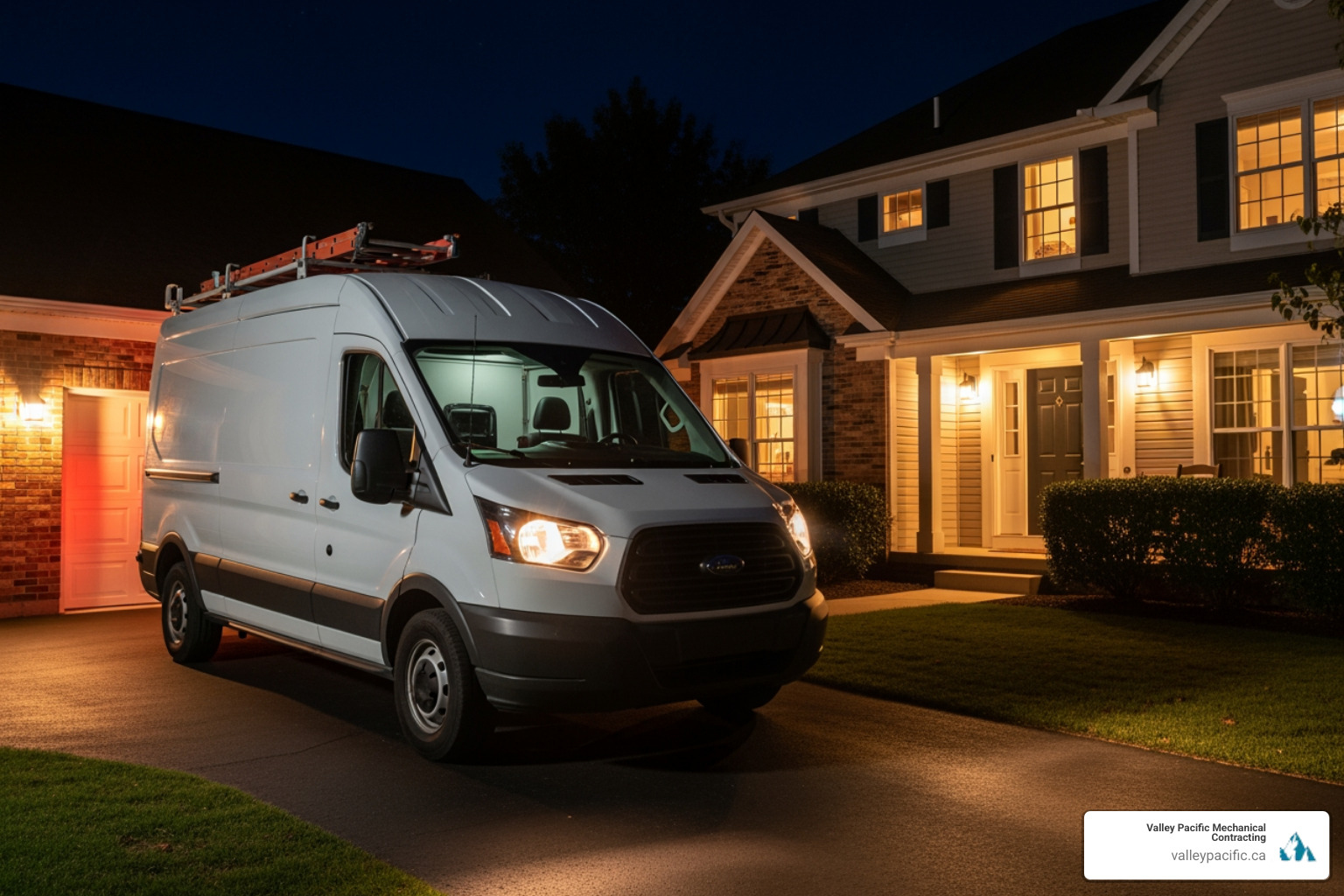
How to Verify a Plumber's Reliability
In an emergency, call a trustworthy service. Here’s how to verify a plumber's reliability:
- Licensed and Insured: Ensure the plumber has proper licensed and insured credentials. This protects you and guarantees a professional standard of work. All our technicians are fully licensed and insured for your peace of mind.
- Reputation and Reviews: Look for a company with positive online reviews and a strong reputation in the community. Consistent feedback about response times and quality of work speaks volumes.
- Local Presence: A plumber with a physical address in the area, like our Maple Ridge office at 21 - 20172 113B Avenue, Maple Ridge, BC, ensures faster response times and familiarity with local plumbing challenges, from building codes to common pipe issues.
What Information to Have Ready When You Call
To help us respond even faster, please have the following information ready when you call:
- Your name, full address, and a contact phone number.
- A clear description of the problem (e.g., "water spraying from a pipe in the basement").
- The location of the burst pipe.
- Any steps you've already taken, such as shutting off the water or electricity.
What to Expect from an Emergency Burst Pipe Repair Service
When you call because you need an emergency plumber in Maple Ridge for a burst pipe who is available 24/7, knowing what to expect can reduce stress. Our emergency plumber will arrive with a clear plan to get your home back to normal.
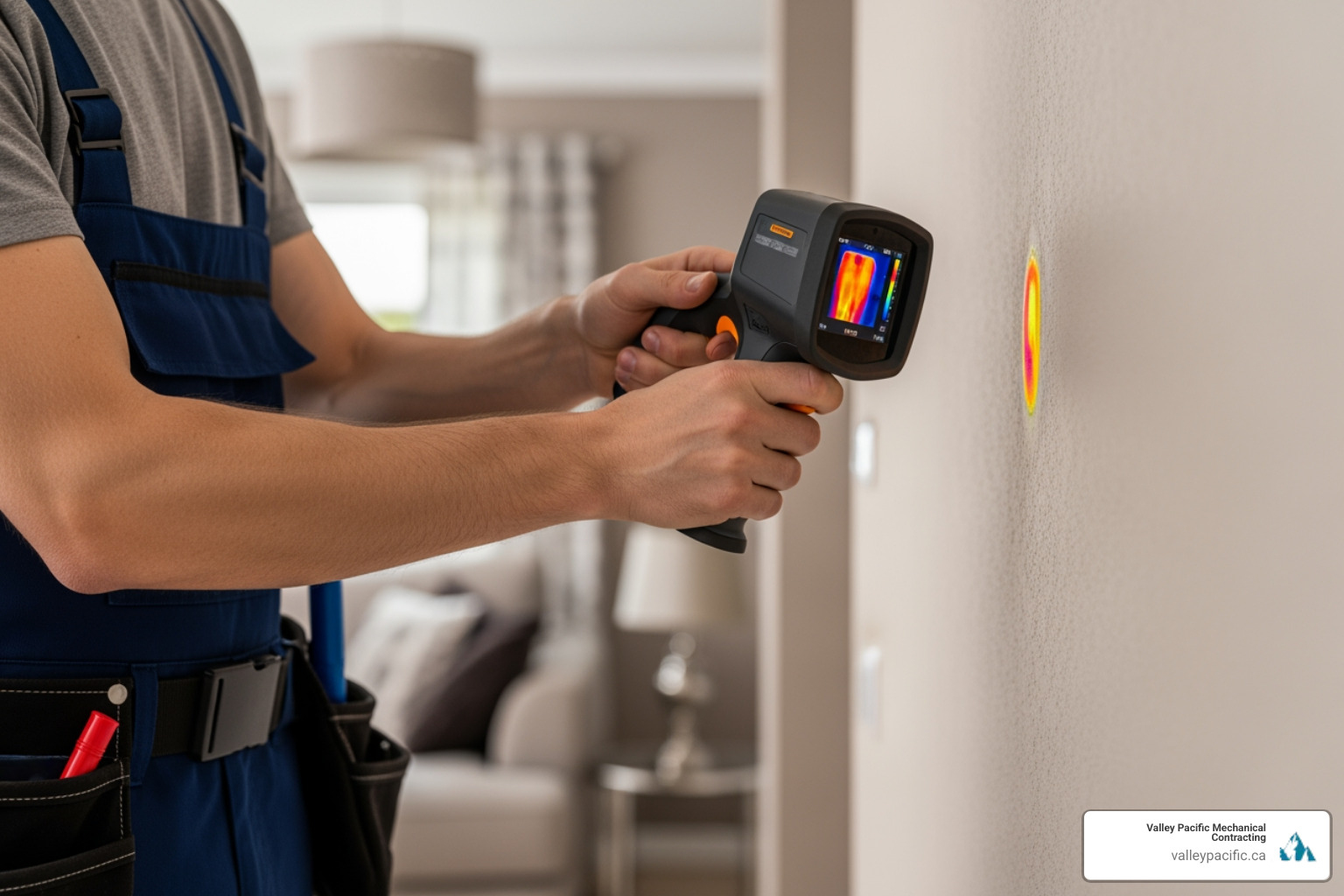
First, our technician will ensure the area is safe. Then, using tools like thermal imaging technology, they will pinpoint the leak without unnecessary damage to your home. We'll explain the problem and repair options clearly before fixing the pipe. Our goal is to provide a comprehensive solution, not just a quick patch. For more on our process, see our page on Burst Pipe Repair.
Common Signs You Have a Plumbing Emergency
Sometimes a burst pipe is a dramatic spray, but other times the signs are more subtle. Recognizing these warnings can help you prevent a crisis.
- Sudden drop in water pressure: A significant drop in pressure across your home can signal a major leak.
- Discolored water: Brown or rusty water often indicates pipe corrosion, a precursor to bursts.
- Visible puddles or flooding: Any unexplained water, damp spots on walls, or pooling under sinks requires immediate attention.
- Strange noises: Gurgling, banging ("water hammer"), or whistling from pipes can indicate trapped air or high pressure.
- Unexplained spike in your water costs: A higher bill with no change in usage is a classic sign of a hidden leak.
Services Included in a Burst Pipe Callout
When you call us for a burst pipe, you get a comprehensive service designed to solve the problem correctly the first time.
- Leak Detection: We use advanced equipment to find the exact source of the burst, minimizing damage during the search.
- Pipe Repair: For localized damage, we perform a durable repair to seal the burst section completely.
- Pipe Replacement: If a pipe is old or severely corroded, we will replace the compromised section with high-quality materials for a long-term solution.
- Water Removal: We provide immediate assistance to remove standing water and prepare the area for professional restoration.
- Damage Mitigation: We advise you on protecting your property and guide you through the next steps to prevent further issues.
After the Fix: Prevention and Post-Repair Actions
Once our emergency plumber has fixed your burst pipe, the next steps are focused on recovery and prevention. This involves proper cleanup, addressing water damage, and taking measures to ensure you don't face another burst pipe emergency.
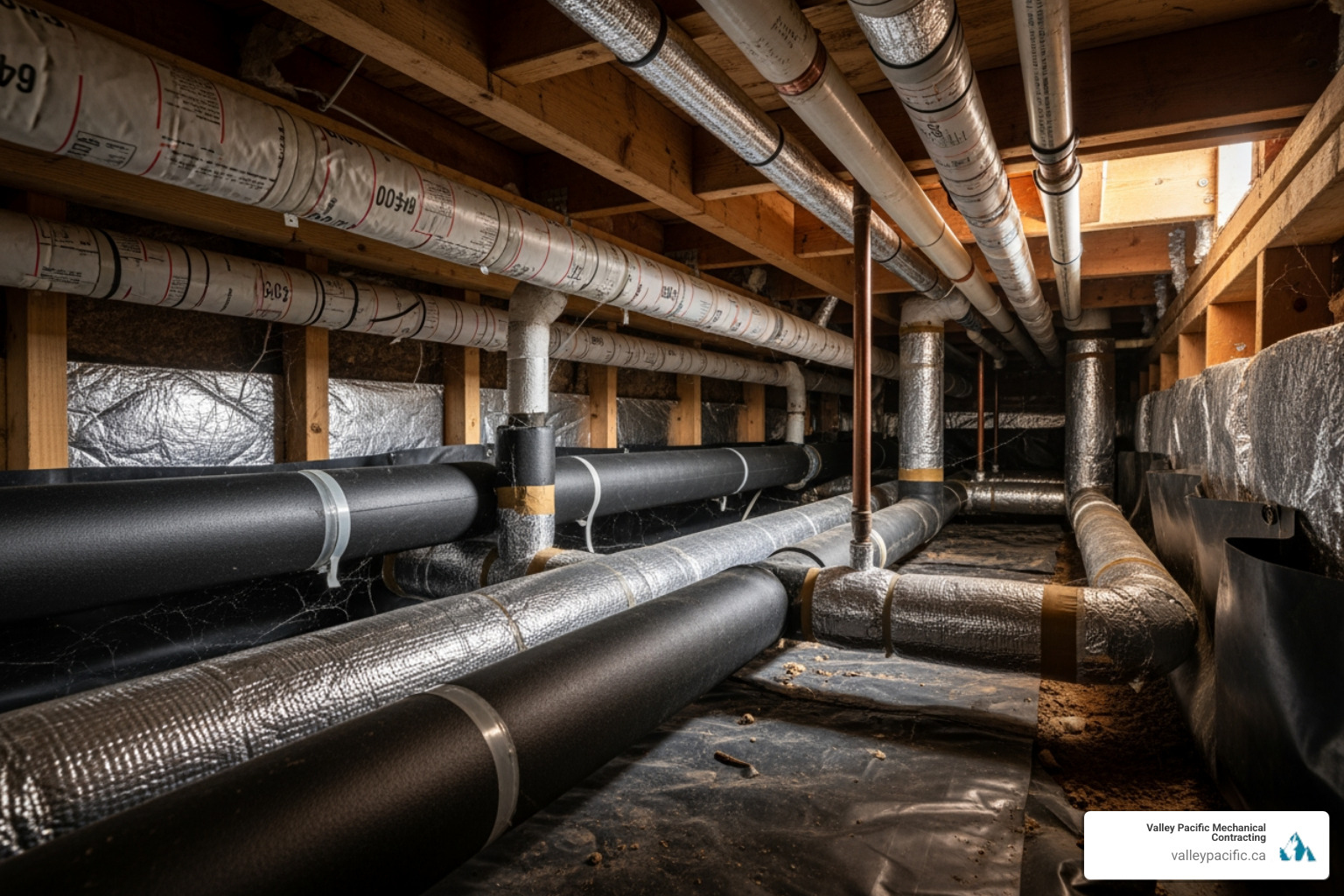
What to Do After the Plumber Leaves
Taking these steps after the repair can prevent long-term problems like mold and structural damage.
- Drying the area: Use fans and dehumidifiers to circulate air and dry any damp areas within 24-48 hours to prevent mold growth.
- Professional restoration services: For significant flooding, consider hiring restoration specialists who use industrial-grade equipment to ensure everything, including hidden areas, is completely dry.
- Contacting your insurance provider: Report the incident to your insurance company promptly. Provide them with the photos, videos, and plumber's report you collected.
How to Prevent Needing an emergency plumber in Maple Ridge for a burst pipe
Preventative maintenance is the best way to avoid another frantic search for "I need an emergency plumber in Maple Ridge for a burst pipe. Who is available 24/7?"
- Pipe insulation: Insulate exposed pipes in basements, crawl spaces, and attics. This is a simple, effective defense against freezing.
- Winterizing pipes: During cold snaps, let faucets drip slightly and open under-sink cabinets to allow warm air to circulate.
- Regular maintenance: Schedule periodic plumbing inspections to catch corrosion, high pressure, and other vulnerabilities early. Our Maple Ridge Plumbing Services can identify problems before they escalate.
- Water pressure regulation: High water pressure stresses pipes. A pressure reducing valve (PRV) can keep pressure at a safe level.
- Address hard water: Maple Ridge's hard water causes mineral buildup that can narrow and weaken pipes. Regular maintenance helps manage this issue.
Frequently Asked Questions about Burst Pipes in Maple Ridge
When you're dealing with a plumbing emergency, you have questions. With over 30 years of experience helping Maple Ridge homeowners, we have the answers.
How quickly can an emergency plumber arrive in Maple Ridge?
Because our technicians are locally based in the Lower Mainland, we can respond to emergencies in Maple Ridge very quickly. Our goal is to arrive within 30 minutes of your call. This rapid response is possible because our team lives and works in the communities we serve, including Maple Ridge, allowing us to minimize travel time and start addressing your emergency faster.
What are the most common causes of burst pipes in this area?
Understanding the common causes of burst pipes in Maple Ridge can help you prevent them.
- Freezing temperatures: Water expands when it freezes, and the pressure can easily crack uninsulated pipes.
- Old or corroded pipes: Over time, pipes weaken from the inside out, especially in older homes, making them prone to failure.
- High water pressure: Constant high pressure puts excessive strain on your entire plumbing system, leading to bursts at weak points.
- Severe clogs: Blockages can cause pressure to build up behind the clog, eventually rupturing the pipe.
- Maple Ridge's hard water: Mineral buildup from our local water supply narrows pipes, increasing internal pressure and causing corrosion, which weakens them over time.
What should I do if I can't find the main water shut-off valve?
If you can't find the valve, stay calm. Check common locations first: the basement (near the front wall), a crawl space, or near your water heater. Your home's property inspection report may also show its location. If you're still unable to find it when you call us because "I need an emergency plumber in Maple Ridge for a burst pipe. Who is available 24/7?"—ask our emergency dispatcher for guidance. They are experienced in helping homeowners locate shut-off valves over the phone while a technician is en route.
Get Professional 24/7 Plumbing Help in Maple Ridge
When a burst pipe floods your home, fast action is crucial. For over 30 years, Valley Pacific Mechanical Contracting has provided Maple Ridge homeowners with a headache-free experience, even in the most stressful emergencies. Our licensed and insured technicians deliver lasting solutions, not just quick patches.
Our 24/7 emergency service means we're always ready to respond, day or night. With our local presence, we can often arrive within 30 minutes to stop the damage and begin repairs. We also focus on prevention, helping you understand why the pipe burst and how to avoid future issues.
If you've found yourself searching "I need an emergency plumber in Maple Ridge for a burst pipe. Who is available 24/7?", follow these steps and call us for immediate, professional help:
- Shut off the main water supply.
- Turn off electricity to the wet area (if safe to do so).
- Document the damage.
- Call us for immediate, professional help.
Ready to get the help you need right now? Contact us directly for immediate emergency assistance. For preventative maintenance, request a quote.
We offer comprehensive mechanical services throughout the Lower Mainland. Explore our Maple Ridge Plumbing Services, Maple Ridge HVAC Services, and Mission HVAC Services to keep your home's systems in top condition.
Why Your Boiler System Depends on This Critical Component
A Boiler expansion tank is a safety device that manages water expansion in closed-loop heating systems. As water heats, it expands by 4-9%. Without a tank to absorb this extra volume, pressure would spike dangerously, damaging your boiler and pipes. The tank contains two chambers separated by a flexible diaphragm: one for pressurized air and the other for system water. When water expands, it pushes against the diaphragm, compressing the air to safely absorb the pressure.
Quick Answer for Choosing the Right Expansion Tank:
- Combi boilers typically have internal expansion vessels.
- System and regular boilers usually need external tanks.
- Sizing matters: The tank should be roughly 1/4 of your boiler's water volume.
- Standard pressure: Most residential tanks are pre-charged to 12-15 PSI.
- Typical lifespan: Expect 5-10 years before replacement is needed.
Most homeowners don't notice their expansion tank until something goes wrong. Signs of failure include a wildly swinging pressure gauge, water dripping from the pressure relief valve, or banging noises in your pipes. These indicate the tank may have failed or lost its air charge.
This component acts as a shock absorber, maintaining stable pressure as water heats and cools. Without it, your boiler would face dangerous over-pressurization with every heating cycle.
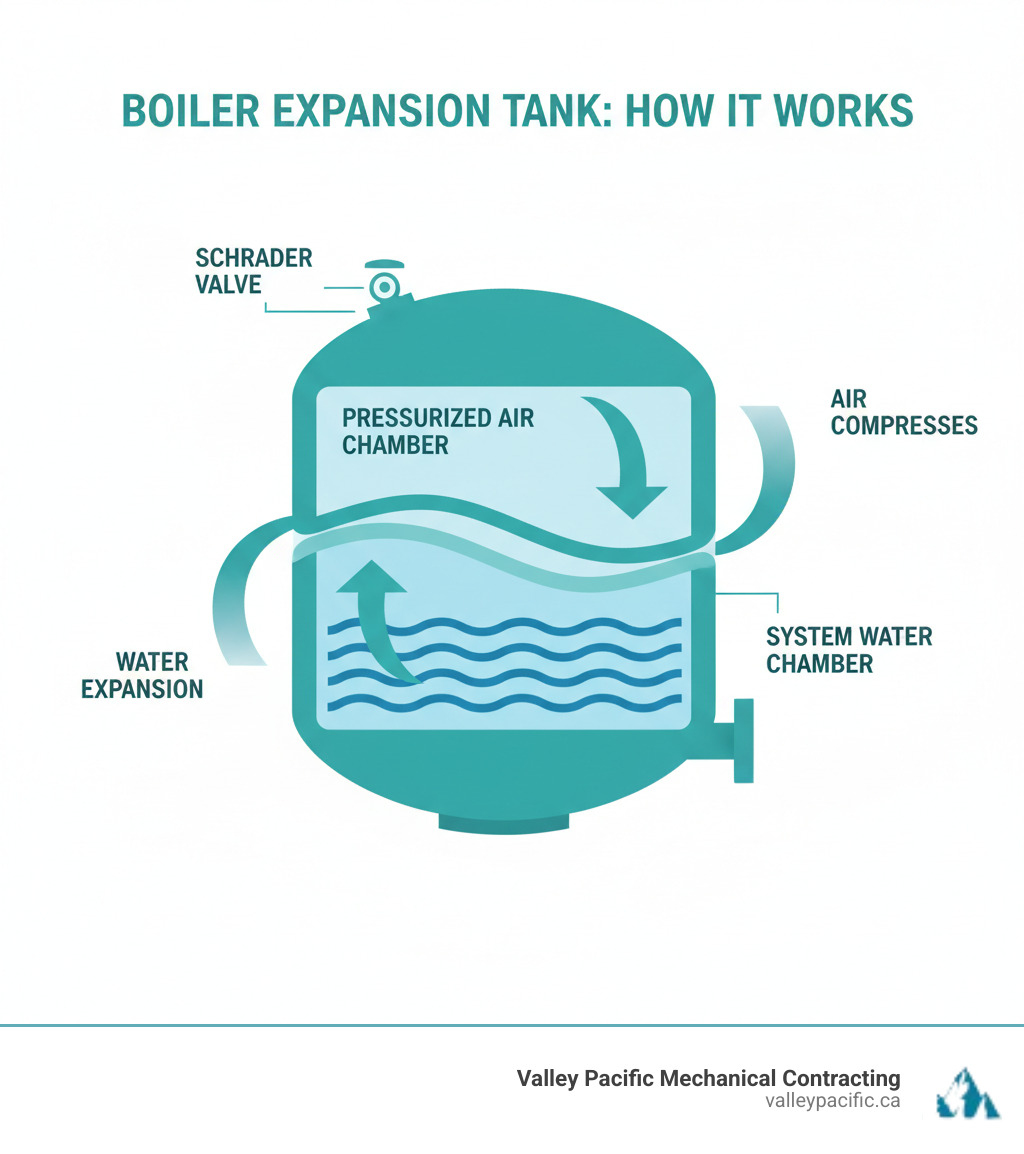
Simple guide to Boiler expansion tank terms:
Understanding the Boiler Expansion Tank: Function and Mechanics
In a closed heating system, water flows in a continuous loop from the boiler through your radiators and back again. A key principle at play is thermal expansion: when water heats up, its volume can increase by 4% to 9%. In a sealed system, this expansion creates immense pressure with nowhere to go.
This is where the boiler expansion tank becomes essential. It acts as a pressure cushion or shock absorber, preventing dangerous pressure spikes that would otherwise stress every pipe, valve, and connection in your home each time the boiler fires up.

What is its Primary Function?
The primary job of a boiler expansion tank is to absorb the excess water volume created during heating. Inside the tank, a flexible rubber diaphragm or bladder separates a chamber of pressurized air from the system's water. As the water heats and expands, it pushes against this membrane, compressing the air on the other side.
This action provides the necessary space for the expanded water, preventing pressure spikes. When the water cools and contracts, the compressed air pushes it back into the system, maintaining stable pressure. This automatic cycle protects your boiler components from the stress of constant pressure fluctuations. For more details on how these parts work, see What Is An Expansion Vessel?.
How it Differs from a Pressure Relief Valve (PRV)
While often confused, the expansion tank and the pressure relief valve (PRV) have distinct roles.
- The expansion tank is proactive. It works constantly during normal operation to manage the everyday pressure changes from thermal expansion.
- The pressure relief valve (PRV) is reactive. It's an emergency backup that only activates when pressure reaches a dangerous level (typically 30 PSI), discharging water to prevent catastrophic failure.
An important warning sign: if you see water dripping from your PRV, it often means your expansion tank has failed. The PRV is being forced to do the expansion tank's job, a sign of trouble that can lead to other issues, as discussed in our guide on Troubleshooting No Hot Water From Boiler. Your expansion tank ensures daily efficiency, while the PRV is your last line of defense.
Types, Sizing, and Location
The type, size, and location of your boiler expansion tank are all crucial for safe and smooth system operation. Understanding your boiler's specific requirements ensures you get the right fit from the start.

Diaphragm vs. Bladder Tanks
Modern boiler expansion tanks come in two main types, both using a flexible membrane to separate air and water.
Diaphragm tanks feature a fixed rubber diaphragm that divides the tank into an air chamber and a water chamber. System water touches the tank's steel shell, making these a reliable and cost-effective choice for most homes. However, this design makes proper air elimination important to prevent internal corrosion.
Bladder tanks use a replaceable rubber bladder that contains the system water, preventing it from ever touching the tank's metal walls. This isolation reduces the risk of corrosion and can extend the tank's lifespan, making it a popular choice for larger or commercial systems. They are also more compact than older tank styles.
While bladder tanks may offer greater longevity, a well-maintained diaphragm tank can serve a home effectively for years.
How to Properly Size Your Boiler Expansion Tank
Correctly sizing a boiler expansion tank is critical. A tank that's too small will cause the pressure relief valve to drip and lead to constant pressure issues. One that's too large is an unnecessary expense and takes up extra space.
Proper sizing depends on several factors:
- System water volume: The total amount of water in your boiler, pipes, and radiators.
- Boiler temperature range: Hotter systems cause more expansion and require a larger tank.
- Fill pressure: The system's cold pressure must match the tank's pre-charge pressure.
- Pressure relief valve setting: The tank must keep operating pressure below this emergency threshold.
Given these variables, professional calculation is the best way to ensure your tank is perfectly matched to your system. This is a key part of designing and maintaining a reliable Boiler Heating System.
Where to Find the Expansion Tank
The location of your boiler expansion tank depends on your boiler type.
Combi boilers typically have an internal expansion vessel built into the unit's casing for a compact, space-saving design.
System and regular boilers almost always use an external expansion tank. You'll find it mounted on a wall or hanging from a pipe near the boiler, connected to the supply-side piping. It is often located on the suction side of the circulator pump.
Whether your tank is internal or external, our technicians in Langley, Maple Ridge, and Mission know exactly where to find and service it.
Diagnosing and Addressing Expansion Tank Problems
Over time, the diaphragm inside a boiler expansion tank can weaken or rupture, causing the air cushion to escape and the tank to become "waterlogged." When this happens, it can no longer manage pressure, and your system will show signs of distress. Catching these problems early through regular Boiler System Maintenance can prevent more serious issues.
Common Signs of a Failing Expansion Tank
Look for these telltale symptoms that your boiler expansion tank may be failing:
- Fluctuating pressure gauge: The gauge swings dramatically as the system heats and cools. A swing of more than 7 PSI is a red flag.
- Water dripping from the pressure relief valve (PRV): The PRV is discharging water frequently, meaning it's doing the job the expansion tank should be handling.
- Banging or gurgling noises: Strange sounds from your pipes can indicate pressure instability caused by a waterlogged tank.
- Cold spots on radiators: Uneven heating and a frequent need to bleed air from radiators suggest a pressure imbalance.
- Constantly adding water: If you're regularly topping up the system, a failing tank could be the cause, especially if the PRV has been discharging.
A simple test: carefully tap the top and bottom of an external tank. The top should be warm and the bottom cool. If the entire tank is hot, the diaphragm has likely failed.
Consequences of a Malfunctioning Tank
Ignoring a failing boiler expansion tank can lead to significant problems:
- Component Stress: Constant pressure swings damage pumps, valves, and heat exchangers, causing them to wear out prematurely.
- System Leaks: The repeated stress can cause weak points in pipes and connections to fail. A malfunctioning tank is often the culprit behind a Boiler Leaking Water.
- Inefficient Heating: Unstable pressure forces your boiler to work harder, leading to uneven heating and higher energy bills.
- Premature Boiler Failure: A boiler operating under these conditions won't last its expected lifespan, potentially requiring a costly early replacement.
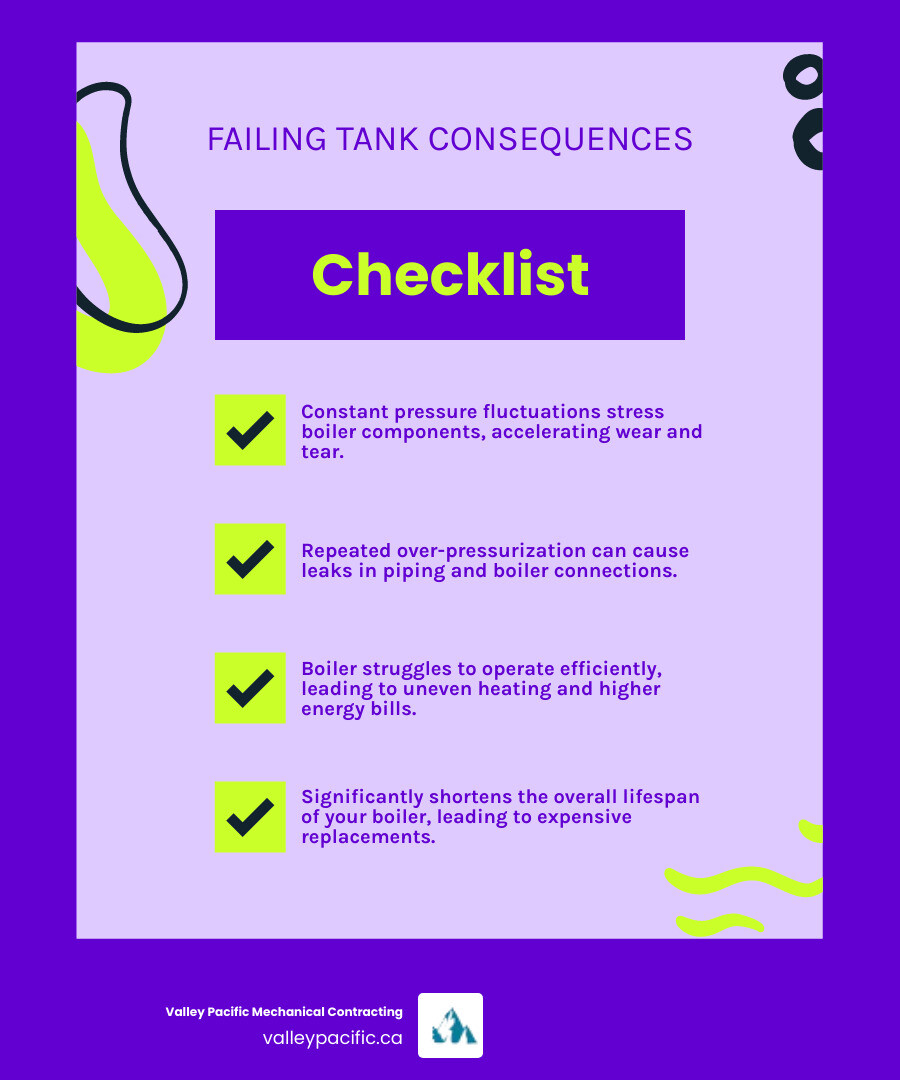
Maintenance and Repair: Can It Be Fixed?
The right fix depends on the problem. Sometimes, a simple recharge is all that's needed, while other times, replacement is the only option.
Recharging Air Pressure: Often, a tank simply loses its air charge over time. A technician can drain the system pressure, check the air pressure at the Schrader valve (like a tire valve), and add air with a pump to restore it to the recommended 12-15 PSI. This routine maintenance can restore full function.
Waterlogged Tank Test: To check for a rupture, a technician can press the pin on the Schrader valve after draining boiler pressure. If air comes out, the diaphragm is likely intact. If water spurts out, the diaphragm has failed.
Replacement: A ruptured diaphragm cannot be repaired in most residential tanks. The internal membrane is torn, allowing water and air to mix. In this case, the entire boiler expansion tank must be replaced. Catching pressure issues early can help prevent this; our guide on What to Do When Boiler Pressure Drops explains the warning signs. While some DIY fixes seem simple, diagnosing the true cause is best left to a qualified technician.
The Professional Replacement Process and Safety
Replacing a boiler expansion tank involves working with a pressurized system of water, electricity, and potentially gas. A small mistake can lead to water damage or safety hazards, which is why this job is best left to qualified technicians. While A guide to installing an expansion tank offers an overview, professional expertise ensures your system's integrity and your family's safety.
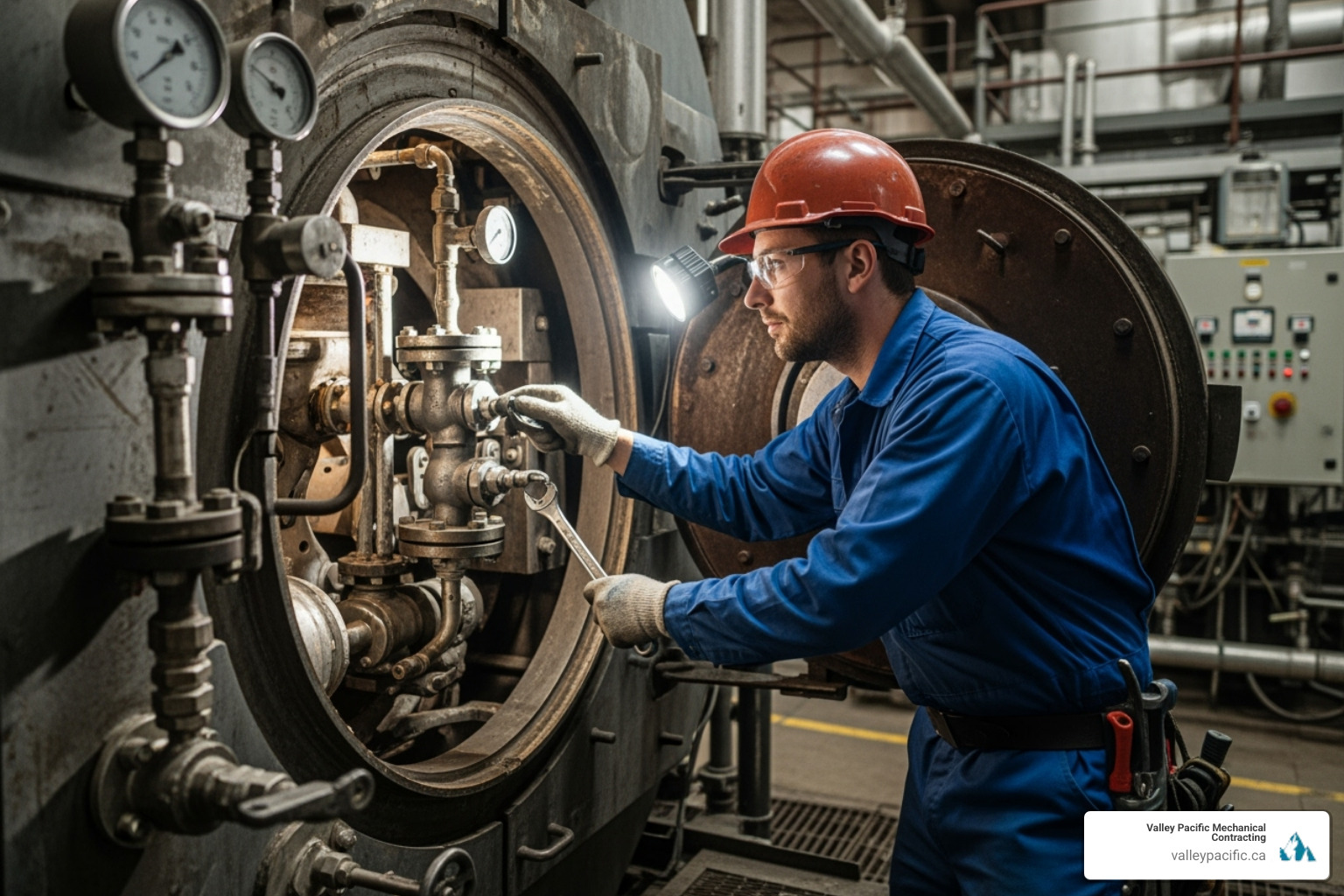
Key Safety Precautions
Our technicians follow strict safety protocols before starting any work:
- Shut down power: The electrical power to the boiler is cut at the breaker to prevent electrical shock.
- Turn off water supply: The main water supply to the boiler is shut off to prevent flooding during the repair.
- Cool the system: We ensure the system is completely cool to avoid the risk of severe burns from hot water.
- Depressurize the system: The boiler is safely drained of all pressure and water before the old tank is removed. This is a critical step to prevent uncontrolled water release.
Overview of the Replacement Steps
Once the system is safe, the replacement process follows a precise sequence:
- Drain the System: The boiler is thoroughly drained until the pressure gauge reads zero.
- Remove the Old Tank: The old tank, which can be heavy if waterlogged, is carefully supported and removed to avoid damaging pipes.
- Prepare the New Tank: Crucially, we check and adjust the new boiler expansion tank's pre-charge air pressure to match your system's requirements (typically 12-15 PSI). This step is often missed in DIY attempts and is essential for proper function.
- Install the New Tank: We apply thread sealant to ensure watertight connections and securely install the new tank.
- Refill and Bleed the System: The system is slowly refilled with water while we carefully bleed air from the boiler and radiators to prevent noise and cold spots.
- Test the System: Finally, we fire up the boiler and test it thoroughly, checking for leaks and ensuring pressure remains stable as it heats up.
This methodical approach ensures a successful installation. For more on our process, see our guide to the Professional Boiler Replacement Process. Residents of Langley, Maple Ridge, or Mission can trust us to handle the job correctly.
Frequently Asked Questions about Boiler Expansion Tanks
Here are answers to common questions we hear from homeowners in Langley, Maple Ridge, and Mission.
What is the correct air pressure for an expansion tank?
The pre-charge air pressure in a boiler expansion tank must match your heating system's cold fill pressure. For most residential systems, this is 12 to 15 PSI (or 1 to 2 bars for combi boilers). This baseline pressure is crucial for the tank to function correctly. A technician can check and adjust this pressure using the Schrader valve on the tank during a maintenance visit. Your boiler's manual will list the exact pressure required for your model.
How long does a boiler expansion tank last?
A boiler expansion tank typically lasts 5 to 10 years. This lifespan can be affected by factors like water quality, system operating pressure, and maintenance frequency. Hard water can cause corrosion, while frequent boiler cycling increases wear. Regular inspections during annual boiler service can help identify wear early, allowing for planned replacement instead of an emergency repair.
Can I run my boiler without an expansion tank?
Absolutely not. Operating a boiler without a functioning boiler expansion tank is dangerous and will cause severe damage. Without it, thermal expansion will create extreme pressure spikes with every heating cycle. This will cause your pressure relief valve to constantly discharge water, put immense stress on all boiler components (leading to leaks and premature failure), and void your manufacturer's warranty. If you suspect your tank has failed, shut down the system and call a professional immediately.
Conclusion
Though often overlooked, your boiler expansion tank is a vital component that protects your entire heating system from dangerous pressure spikes. It acts as a shock absorber, preventing the stress that leads to leaks, component failure, and a shortened boiler lifespan. Without a functioning expansion tank, every heating cycle would put your system at risk.
Recognizing the warning signs—like a fluctuating pressure gauge or a dripping relief valve—allows you to address issues before they become major repairs. With proper maintenance and timely replacement by a qualified professional, your expansion tank will safeguard your investment for years to come.
For homeowners in Langley, Maple Ridge, and Mission, Valley Pacific Mechanical Contracting offers a headache-free experience backed by over 30 years of expertise. Whether you need a routine check or a full replacement, our team is committed to keeping your system running smoothly.
If you've noticed signs of expansion tank trouble or are due for a boiler inspection, don't wait. Our team is available 24/7 for emergencies to ensure your home stays warm and safe. Learn more about our boiler installation services in Langley, BC and how we can protect your heating system's longevity.
Why Finding the Right Plumber Matters in Langley BC
Searching for a plumber langley bc means you need reliable help, fast. From a dripping faucet to a cold water heater, plumbing problems are always inconvenient and don't wait for a good time.
When you need a plumber in Langley BC, look for:
- Licensed and insured professionals with WorkSafeBC coverage
- Local experience with Langley's mix of heritage homes and new construction
- Red Seal certification for complex installations and repairs
- 24/7 emergency availability for urgent issues like burst pipes
- Transparent pricing and workmanship guarantees
- Full-service capabilities including drain cleaning, water heaters, gas fitting, and renovations
Langley homeowners face unique challenges, from aging pipes in Fort Langley farmhouses to the Poly-B piping common in older homes and hard water issues throughout the Fraser Valley.
This guide will help you find a professional plumber, know when to call, and avoid the stress of hiring the wrong contractor. We'll cover common warning signs, expected services, and the right questions to ask before hiring.
The right plumber doesn't just fix your immediate problem—they help you avoid future emergencies through proper maintenance and honest advice.
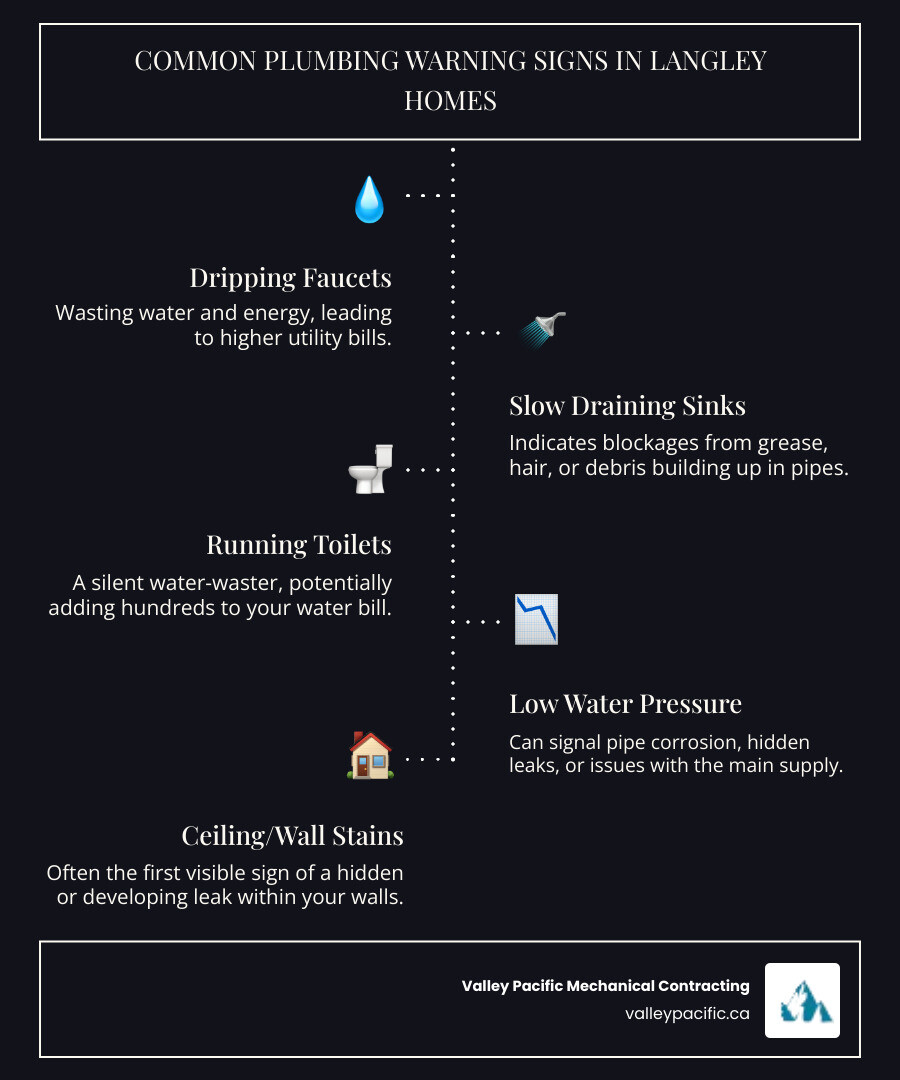
Plumber langley bc terms to know:
Common Plumbing Problems and Warning Signs in Langley
Langley's diverse homes, from heritage properties to new developments, all face plumbing issues. While problems can arise unexpectedly, most provide warning signs before becoming emergencies.
A dripping faucet is more than an annoyance; it wastes thousands of liters of water annually and can damage fixtures. An occasional drip can worsen if ignored. Our team handles Faucet Leak Repair quickly to prevent more expensive problems.
Clogged drains are a common headache caused by grease, hair, and soap buildup. While a plunger offers a temporary fix, gurgling sounds or foul odors indicate a deeper blockage. Professional drain cleaning addresses the root cause instead of just pushing the problem further down the pipe.
Running toilets often go unnoticed but waste a significant amount of water. The cause is typically a worn flapper valve. To check, add food coloring to the tank before bed. If the bowl water is colored in the morning, you have a leak that needs repair.
Low water pressure makes showers frustrating and can signal mineral buildup, a hidden leak, or a faulty pressure regulator. This is a frequent issue in Langley due to hard water, which causes deposits inside pipes.
Your water heater gives warning signs before it fails. Look for rust-colored water, puddles around the tank, or banging noises. If your unit is 15-20 years old and showing these symptoms, it's time to plan for a replacement to avoid an unexpected cold shower.
A major concern for Langley homeowners is Poly-B piping, found in homes built from the late 1970s to early 1990s. This grey plastic piping becomes brittle over time, leading to leaks and catastrophic bursts. We strongly recommend you Replace Your Poly-B Piping Before It's An Emergency to avoid costly water damage and insurance claims.
Burst pipes are a homeowner's nightmare, often caused by freezing temperatures or aging Poly-B. A burst can cause a flood in minutes, making every second critical. Immediate Burst Pipe Repair is essential to stop the water and prevent extensive damage.
Avoiding plumbing disasters means paying attention to small signs. A slow drain or occasional drip can quickly worsen. When you spot an issue, calling a professional plumber langley bc residents trust helps you catch problems while they are still small and affordable to fix.
What Services Can You Expect from a Plumber in Langley BC?
When searching for a plumber langley bc, you need a partner who can handle everything from minor drips to major overhauls. A full-service team provides a complete range of solutions.
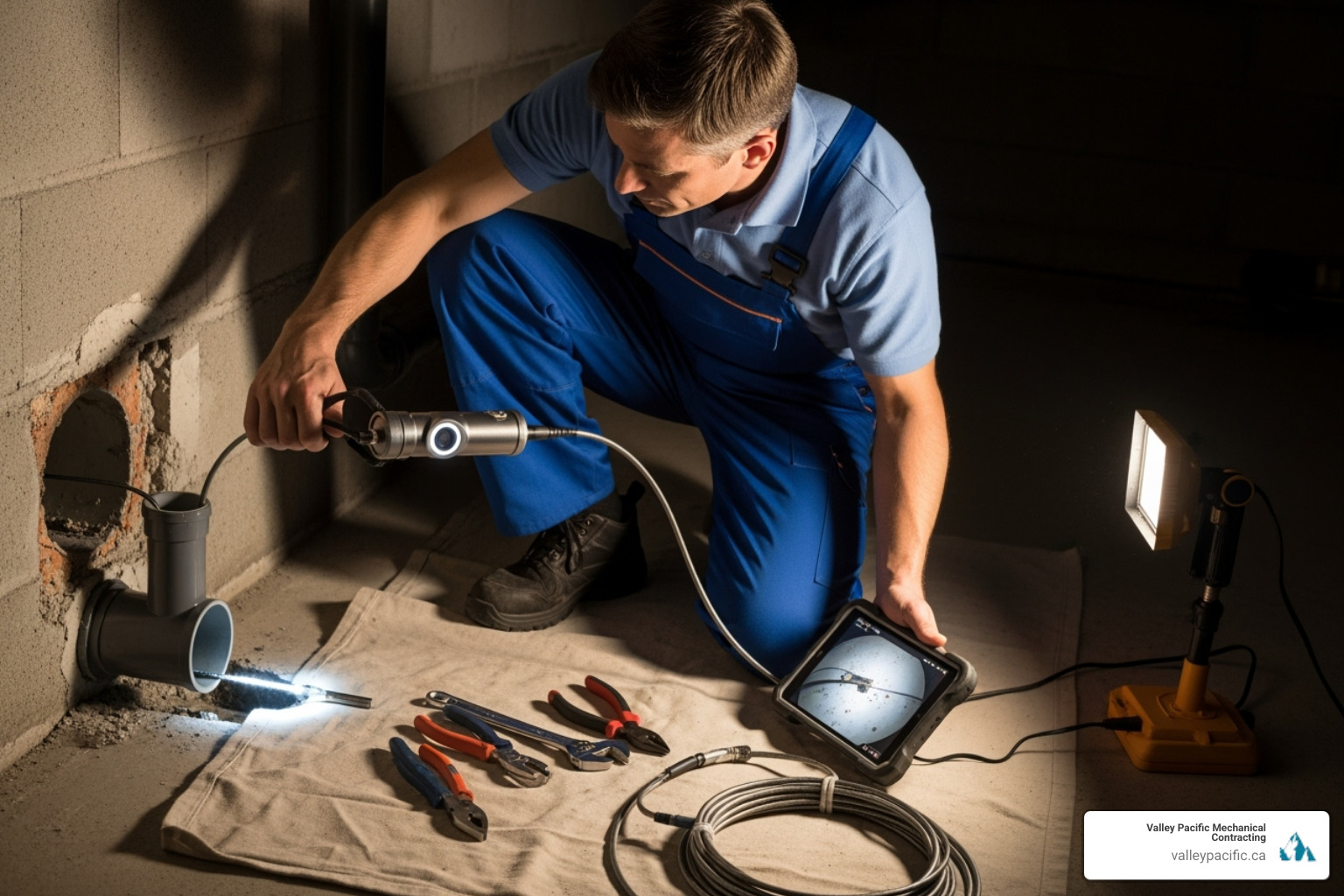
General repairs cover everyday issues like leaky faucets, running toilets, and weeping pipe joints. While seemingly small, these problems can lead to water damage and high utility bills if ignored.
Fixture installation includes upgrading sinks, faucets, and toilets. If your shower valve is faulty, a professional replacement is key. Our team performs Shower Valve Replacement to ensure consistent water temperature and pressure.
For stubborn clogs, professional drain cleaning is essential. Unlike chemical drain cleaners, we use specialized equipment like augers and hydro-jetting to blast away buildup with high-pressure water, effectively clearing your pipes.
Sewer services address serious underground issues. Modern Sewer Line Inspection uses cameras to diagnose problems like tree root intrusion or collapsed pipes. For repairs, Trenchless Pipe Repair techniques can fix the issue without excavating your yard.
Water heater services ensure you have reliable hot water. We handle maintenance, repairs, and replacement for both tank and tankless systems, helping you choose the right unit for your home's needs.
Gas fitting must be handled by licensed professionals for safety. This includes installing and maintaining gas lines for furnaces, water heaters, fireplaces, and stoves. Never attempt DIY gas work.
Renovation plumbing is crucial for new kitchens and bathrooms. We relocate lines, install fixtures, and ensure all work meets building codes, so your new space functions as beautifully as it looks.
Other specialized services include water main replacements, sump pump services, backflow testing, perimeter drainage, thermal camera imaging for hidden leaks, and strata maintenance. For more on the topic, see this General information on plumbing systems.
With over 30 years of experience in Langley, we bring expertise and reliability to every job, backed by our 24/7 emergency service and commitment to a headache-free experience.
Choosing a Reliable and Licensed Plumber in Langley
Finding a trustworthy plumber langley bc is about ensuring your family's comfort and safety. When something goes wrong with your plumbing, you need a reliable, skilled, and honest professional.
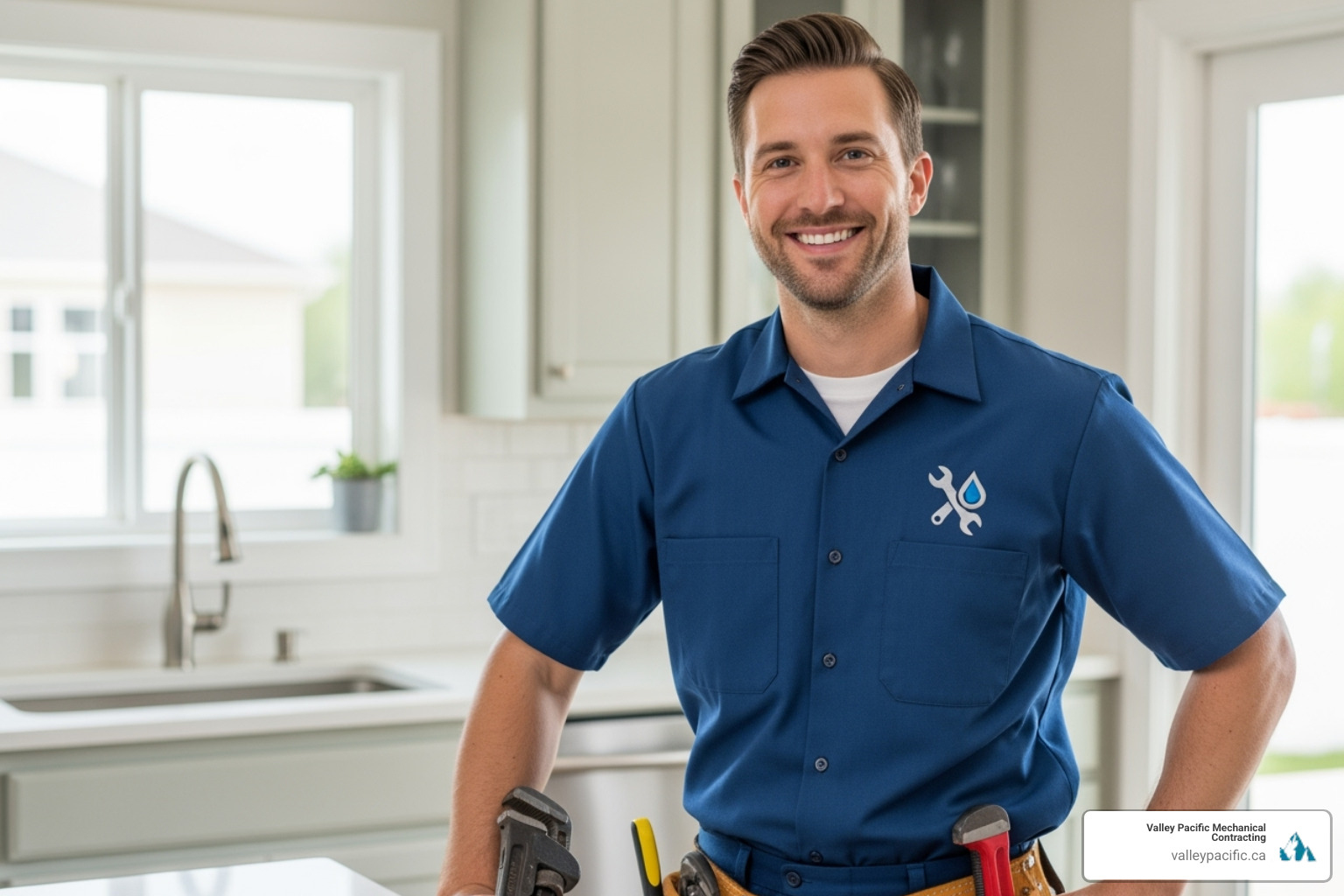
Local expertise is crucial. A plumber familiar with Langley understands its unique challenges, like Poly-B piping, hard water, and the mix of heritage and new homes. This experience leads to faster, more effective solutions.
Before hiring, check online reviews and ask for recommendations. A reputable company employs uniformed, professional technicians who respect your home and explain their work clearly. A workmanship guarantee is a sign of confidence. A plumber who offers warranties on parts and labor will stand behind their work.
Key Factors for Your Plumber Langley BC Search
When you're searching for a plumber langley bc, certain credentials should be non-negotiable.
Licensing is non-negotiable. It confirms your plumber meets provincial standards and is qualified to work on your home's systems.
Insurance protects you from liability for accidental damage during a job. A professional plumber will carry comprehensive liability coverage.
WorkSafeBC coverage protects you from liability if a worker is injured on your property. It's a hallmark of a responsible business that values its employees' safety.
Red Seal certification is Canada's national standard of excellence for skilled trades. A Red Seal plumber has proven expertise to handle the most complex jobs.
Why a Local Plumber in Langley BC is Your Best Bet
Choosing a local company offers distinct advantages.
Local knowledge of Langley's infrastructure, water quality, and common neighborhood issues leads to faster, more accurate solutions.
Faster response times are critical in an emergency. A local plumber langley bc can arrive quickly, especially for urgent issues like a burst pipe, minimizing damage. Our 24/7 service ensures we're there when you need us.
Community reputation matters. Local businesses are invested in providing quality, fair service to their neighbors. You can easily check their reputation through local reviews and word-of-mouth.
Supporting the local economy is another benefit. Hiring a local company keeps money within the community, supports local jobs, and contributes to a stronger Langley.
Proactive Care: Maintenance and Knowing When to Hire a Pro
The best plumbing service is proactive, not just reactive. Like a car, your home's plumbing system needs regular maintenance to prevent costly breakdowns.
The Value of Regular Plumbing Maintenance
Regular maintenance is a smart investment. It prevents emergencies by allowing a professional to catch warning signs of issues like burst pipes or sewer backups before they escalate. It also saves money, as proactive repairs are cheaper than emergency fixes and prevent small leaks from causing water damage or mold. Finally, maintenance extends your system's life. Regular inspections for proper pressure and corrosion help your plumbing last longer. For example, timely Sump Pump Repair can prevent basement flooding and protect your home's foundation.
Here are some seasonal maintenance tasks we recommend to homeowners in Langley:
- Leaky Toilets: Use the food coloring test in the tank overnight. Color in the bowl by morning indicates a leak that wastes thousands of liters annually.
- Water Heaters: Visually inspect the tank monthly for rust or moisture. If your unit is over 15 years old and shows wear, it's time for a professional check.
- Outdoor Faucets: Drain and turn off all outdoor faucets before winter to prevent freezing and burst pipes.
- Clogged Sinks: Use drain strainers and never pour fats, oils, or grease (FOG) down the drain; dispose of them in the garbage to prevent blockages.
Professional Repair vs. DIY: Why an Expert is Worth It
While DIY plumbing might seem cost-effective, the risk of turning a simple fix into a costly disaster is high. Hiring a professional plumber langley bc is often the safer, smarter choice.
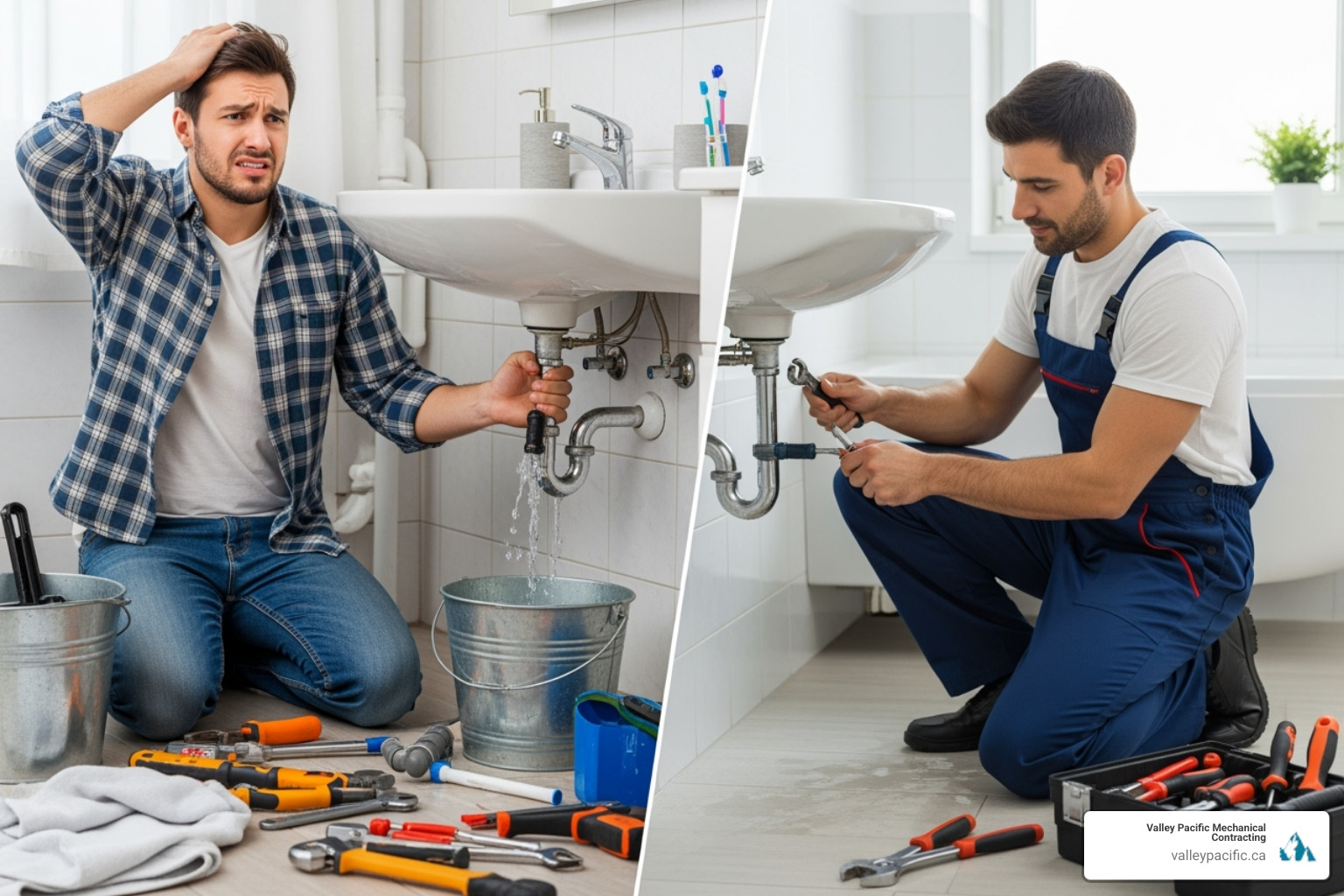
DIY risks are significant. A simple mistake can lead to major water damage and mold, costing far more than an initial professional repair.
Professionals prevent code violations. Licensed plumbers ensure all work meets building codes, which is crucial for safety, efficiency, and future home inspections.
Experts use specialized tools like hydro-jetting systems and video inspection cameras to diagnose and resolve issues that basic tools can't handle.
Hiring an expert provides safety and peace of mind. Our licensed and insured technicians do the job right, saving you time, stress, and future expenses.
Emergency Plumbing: Knowing When to Make the Call
Plumbing emergencies happen at the worst times. It's crucial to know which situations require immediate professional help.
A burst pipe is always an emergency. Gushing water can cause immense damage in minutes. If this happens, shut off your main water valve and call for immediate Burst Pipe Repair. Our team is available 24/7 to minimize damage.
A sewer backup is a health hazard. Raw sewage contains dangerous pathogens. If you see sewage backing up into drains or toilets, call a professional plumber langley bc immediately for safe cleanup.
Major leaks you can't control are emergencies. Whether it's a flooding water heater or an overflowing toilet, if you can't stop the water, call for help.
Having no water can indicate a major break in your main water line. This is an urgent issue as it affects all basic hygiene and sanitation, requiring prompt diagnosis.
Gas line issues are the most critical emergency. If you smell natural gas, evacuate immediately without using any electronics or light switches. Once outside, call FortisBC's emergency line, then contact us for the repair after the scene is secured.
Severe drain clogs become emergencies when multiple fixtures back up and threaten to overflow. For a business, this can halt operations and lead to health code violations.
Finding a burst pipe or flooded basement is frightening. Our emergency specialists respond with urgency, arriving quickly to assess the situation, prevent further damage, and restore your peace of mind. That's why 24/7 availability is essential when searching for a plumber langley bc. Emergencies don't wait for business hours, and neither do we.
Frequently Asked Questions
Here are answers to some of the most common questions we receive from Langley homeowners.
What should I do if I have a flood in my home?
If you have a flood, act quickly. First, stop the water by turning off your home's main water shut-off valve, typically located in the basement or utility room. Second, ensure safety by shutting off electricity to any affected areas to prevent electrical shock. Once the immediate danger is contained, call a professional. Our 24/7 emergency service is available to find the cause, make repairs, and restore your home. When you need a plumber langley bc in a crisis, we're ready to help.
Why are fats, oils, and grease so bad for my drains?
Fats, oils, and grease (FOG) are major causes of drain problems. While liquid when warm, FOG solidifies in your pipes as it cools, creating a sticky buildup that traps other debris. This leads to stubborn clogs that often require professional tools like hydro-jetting to clear. The solution is simple: dispose of FOG in the garbage, not down the drain. Let it cool and solidify in a container before throwing it away.
What are the signs my water heater is about to fail?
Water heaters usually show signs of failure. Watch for these red flags:
- Rust or moisture at the base of the tank, indicating a leak or corrosion.
- Age: If your unit is over 15-20 years old, it's at higher risk of failure.
- Unusual noises like popping or rumbling, which suggest sediment buildup.
- Lukewarm water or hot water that runs out quickly, signaling a failing heating element.
- Discolored water from the hot tap, a sign of internal corrosion.
Catching these signs early allows you to schedule a replacement before it fails completely. If you notice these issues, contact a trusted plumber langley bc for an assessment.
Your Trusted Partner for Langley Plumbing Needs
Finding the right plumber langley bc shouldn't be stressful. This guide has covered common Langley plumbing challenges, the wide range of professional services available, and how to identify problems before they become emergencies.
We've highlighted the importance of choosing a licensed, insured, and Red Seal certified plumber with local expertise. Regular maintenance and professional service are key to preventing costly emergencies and avoiding the risks of DIY repairs.
In an emergency, having a reliable 24/7 team is crucial. The right partner does more than fix the immediate issue; they provide honest advice to help you prevent future problems.
For over 30 years, Valley Pacific Mechanical Contracting has served Langley and the Lower Mainland. Our commitment to a headache-free experience ensures transparent communication, skilled technicians, and lasting solutions. From routine maintenance to 24/7 emergencies, we are here for you with the Daikin Comfort Promise.
Your home's plumbing is too important to leave to chance. For expert boiler maintenance, water heater installation, drain cleaning, or any other plumbing need, our team is ready to help. For expert boiler services and all your plumbing needs, contact our team at https://valleypacific.ca/boiler. We're here to keep your home running smoothly, because you deserve peace of mind.
Why Regular Furnace Care Matters in Langley
Furnace maintenance langley bc is essential for keeping your home warm and safe through the cold, damp winters that characterize this part of the Lower Mainland. If you're looking for professional furnace maintenance in Langley, here's what you need to know:
Quick Answer: What Does Furnace Maintenance Include?
- Comprehensive inspection of all furnace components (heat exchanger, burners, blower motor)
- Cleaning and replacement of air filters and internal parts
- Safety checks including carbon monoxide testing and electrical connections
- System calibration for optimal efficiency and performance
- Annual service recommended before the heating season begins
Let's be honest—when temperatures drop in Langley, a reliable furnace isn't a luxury. It's essential. But too many homeowners wait until their system breaks down on the coldest night of the year to call for help.
Regular furnace maintenance prevents that scenario. A well-maintained furnace runs more efficiently, lasts longer (typically 15-20 years with proper care), and keeps your family safe from hazards like carbon monoxide leaks.
The reality is simple: An annual tune-up costs far less than an emergency repair or premature replacement. Plus, many furnace manufacturers require regular maintenance to keep warranties valid.
Whether you live in Willoughby, Brookswood, or Fort Langley, your furnace works hard during our rainy, chilly winters. Giving it the attention it needs through professional maintenance ensures it's ready when you need it most.
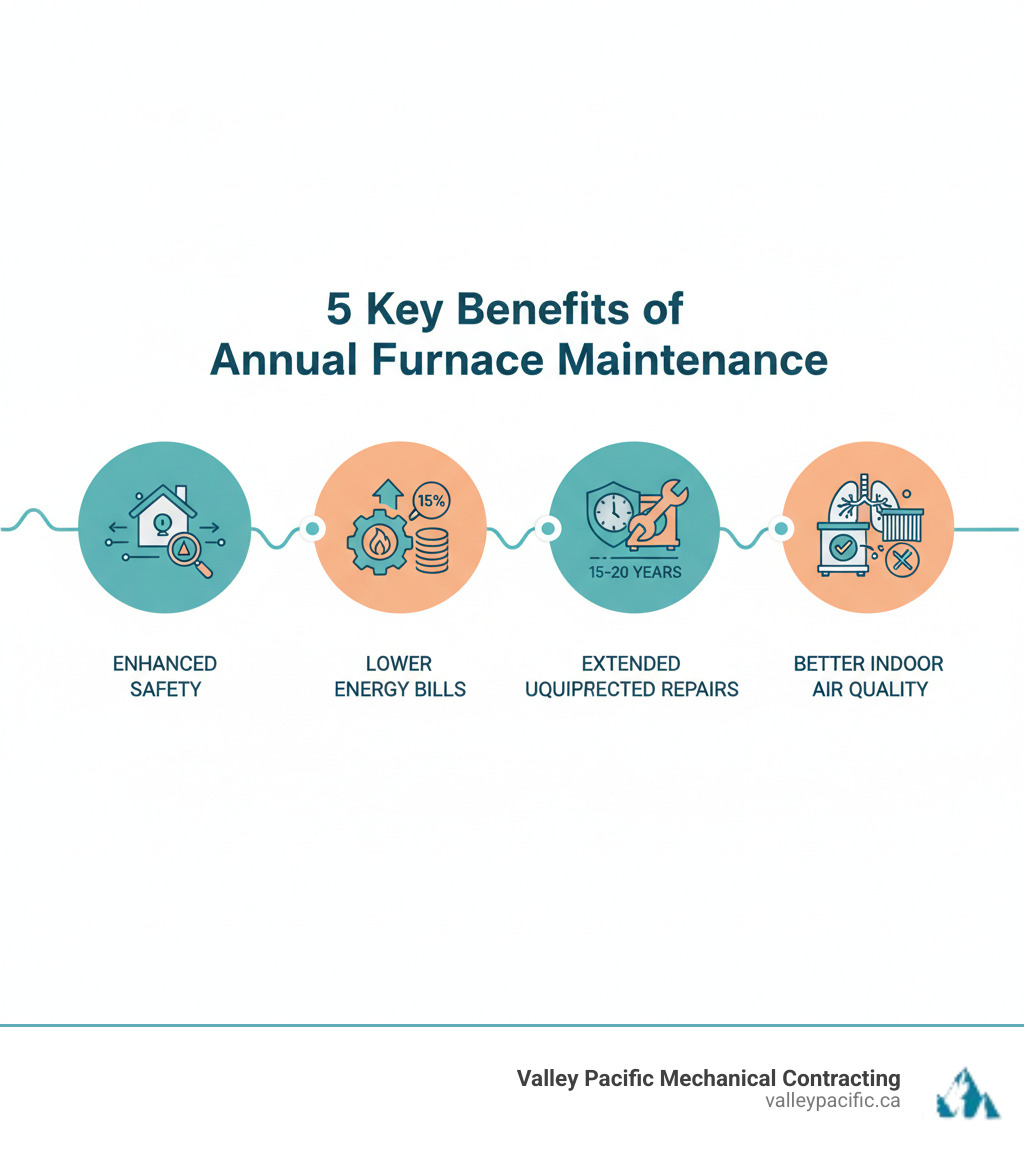
Furnace maintenance langley bc helpful reading:
Why Proactive Furnace Maintenance is a Must for Langley Homeowners
Living in Langley means you know what our winters are like—cool, damp, and demanding on your heating system. Your furnace isn't just running occasionally; it's working hard for months on end to keep your family comfortable. That's exactly why waiting for something to break isn't a strategy that works well here.
Proactive furnace maintenance langley bc is about getting ahead of problems before they disrupt your life. Think of it this way: you wouldn't skip oil changes for your car and then act surprised when the engine seizes up, right? Your furnace deserves the same consideration—maybe even more, since it's protecting your family's comfort and safety all winter long.
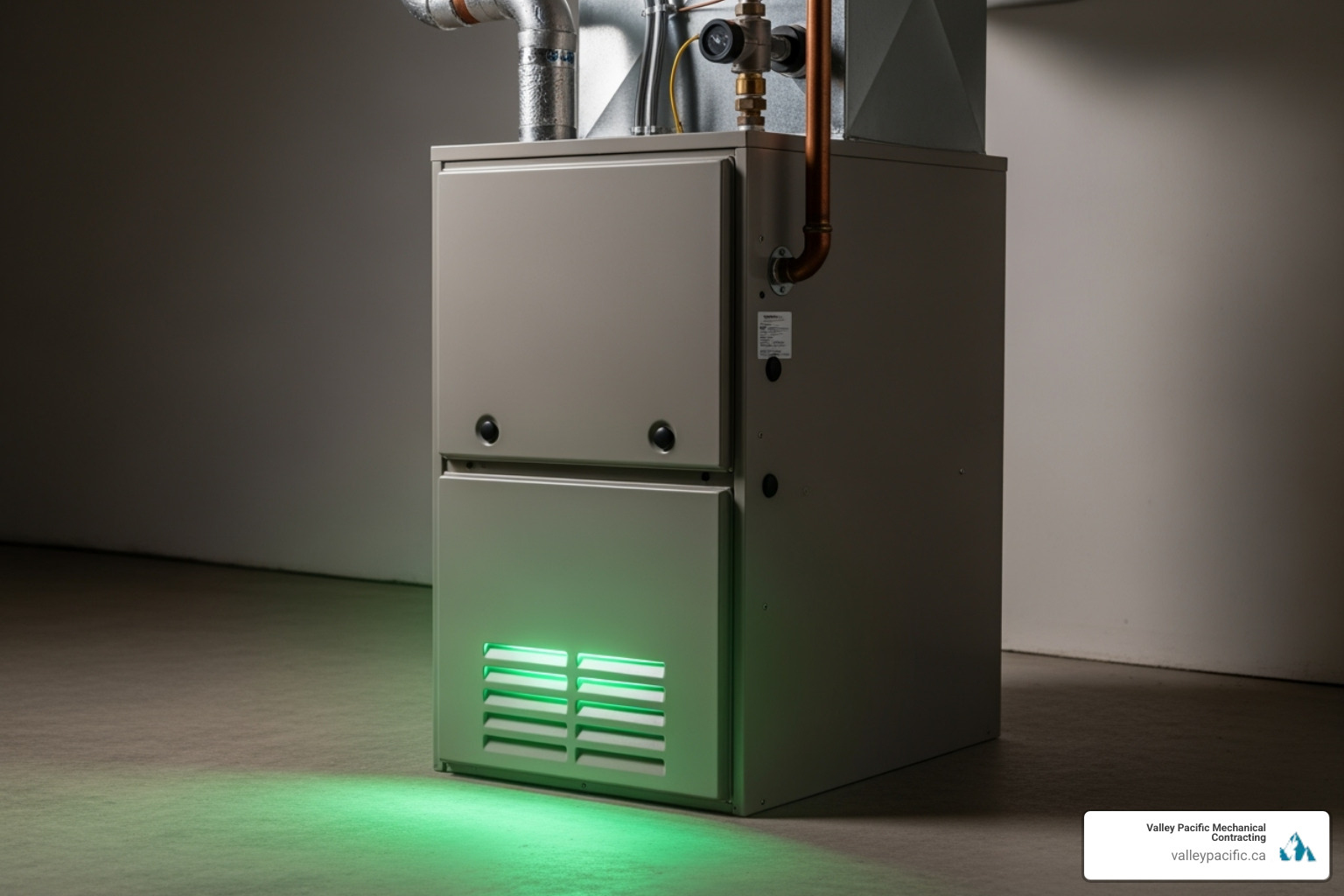
The benefits of regular maintenance touch every aspect of your home comfort: lower energy bills, a longer-lasting furnace, better safety, and cleaner air. It's not just about avoiding breakdowns (though that's certainly part of it). It's about creating a reliable, efficient system that works for you instead of against you. For a deeper look at how comprehensive care benefits your entire home comfort system, check out our guide on HVAC preventative maintenance tips.
Boost Energy Efficiency and Lower Your Utility Bills
When your furnace is running smoothly, it doesn't have to work as hard. When it doesn't have to work as hard, it uses less energy. And when it uses less energy, you see the difference in your utility bills. It's really that straightforward.
During a professional furnace maintenance langley bc appointment, technicians clean components that have accumulated dust and debris, lubricate moving parts to reduce friction, and make sure everything is calibrated correctly. These seemingly small adjustments add up to significant improvements in how efficiently your system operates.
Here's a number that might surprise you: just replacing a dirty air filter can improve your furnace's efficiency by up to 15%. That's substantial savings over the course of a Langley winter. A clean filter allows air to flow freely through your system, so your furnace isn't straining to push warm air through clogged pathways. Similarly, a properly calibrated thermostat ensures your system heats your home to the right temperature without cycling on and off unnecessarily.
All these optimizations mean your furnace delivers maximum warmth while consuming minimal energy. Your monthly bills reflect this efficiency, and you stay comfortable without the financial stress of skyrocketing heating costs.
Extend Your Furnace's Lifespan and Protect Your Investment
Let's be honest—a furnace represents a significant investment in your home. You want to get every possible year out of it, and regular maintenance is how you make that happen.
Every time your furnace runs, its components experience wear and tear. Belts stretch, motors work, and parts gradually accumulate stress. Without routine care, minor issues compound into major problems. A small misalignment becomes a worn bearing. A dirty component causes another part to overheat. Before you know it, you're facing a breakdown that could have been prevented.
With consistent furnace maintenance langley bc, technicians catch these small issues early. They clean parts that would otherwise deteriorate faster. They adjust components that are out of alignment. They replace worn items before they fail completely. This proactive approach significantly reduces the overall stress on your system.
The result? Your furnace can reach its full potential lifespan of 15 to 20 years with proper care. That's potentially a decade or more of extra service from a single investment in regular maintenance. The long-term savings are substantial when you consider the cost of premature replacement. Want to learn more about maximizing your home comfort investment? Our article on HVAC system upgrades offers valuable insights.
Improve Home Safety and Prevent Carbon Monoxide Risks
This is where furnace maintenance becomes about more than just comfort and money—it becomes about protecting your family's safety.
Gas furnaces produce carbon monoxide as a byproduct of combustion. Under normal circumstances, this dangerous gas vents safely outside your home. But when something goes wrong—a cracked heat exchanger, a blocked vent, a malfunctioning safety control—carbon monoxide can leak into your living space. The frightening part? It's completely odorless, colorless, and tasteless, which is why organizations like Technical Safety BC highlight the importance of CO awareness. You can't detect it without proper equipment.
During every furnace maintenance langley bc visit, our technicians perform thorough safety inspections specifically designed to identify these risks. We carefully examine your heat exchanger for any cracks or damage. We test all gas connections to ensure they're sealed properly. We inspect your venting system to confirm exhaust gases are flowing correctly. We verify that safety controls like the limit switch are functioning as designed.
These professional safety checks, combined with working CO detectors in your home, provide genuine peace of mind. You can rest easy knowing your furnace isn't putting your family at risk. For more detailed information about this critical component, read our guide on furnace heat exchanger repair.
Improve Indoor Air Quality for a Healthier Home
Your furnace doesn't just heat your home—it also plays a major role in circulating air throughout your living space. That means whatever is inside your furnace and ductwork gets distributed to every room where your family breathes.
Over time, dust, pet dander, pollen, and other allergens accumulate inside your heating system. When your furnace kicks on, these particles get blown into your home's air. For family members with allergies, asthma, or respiratory sensitivities, this can make a noticeable difference in their daily comfort and health.
Regular furnace maintenance langley bc addresses this issue directly. Technicians clean or replace your air filter, which acts as the first line of defense against airborne particles. They also clean internal furnace components where dust and debris tend to collect. This thorough cleaning means fewer irritants circulating through your home.
The result is noticeably cleaner, healthier air. Better air circulation and reduced respiratory irritants create a more comfortable living environment for everyone in your household. This is especially valuable during winter months when your home is sealed up tight against the cold, and indoor air quality becomes even more important.
Telltale Signs Your Langley Furnace Needs a Tune-Up
Your furnace has a way of speaking to you—sometimes quietly, sometimes not so quietly. The key is learning to listen before those whispers turn into expensive shouts. Catching these warning signs early is what separates a quick, affordable tune-up from a major repair or, worse, a complete breakdown on the coldest night of the year.
Being proactive about furnace maintenance langley bc means paying attention to how your system behaves. Is it making sounds you've never heard before? Are your utility bills suddenly climbing for no apparent reason? These are your furnace's way of asking for help. If your system won't even start, our guide on common reasons a furnace won't ignite can help you understand what might be going wrong.
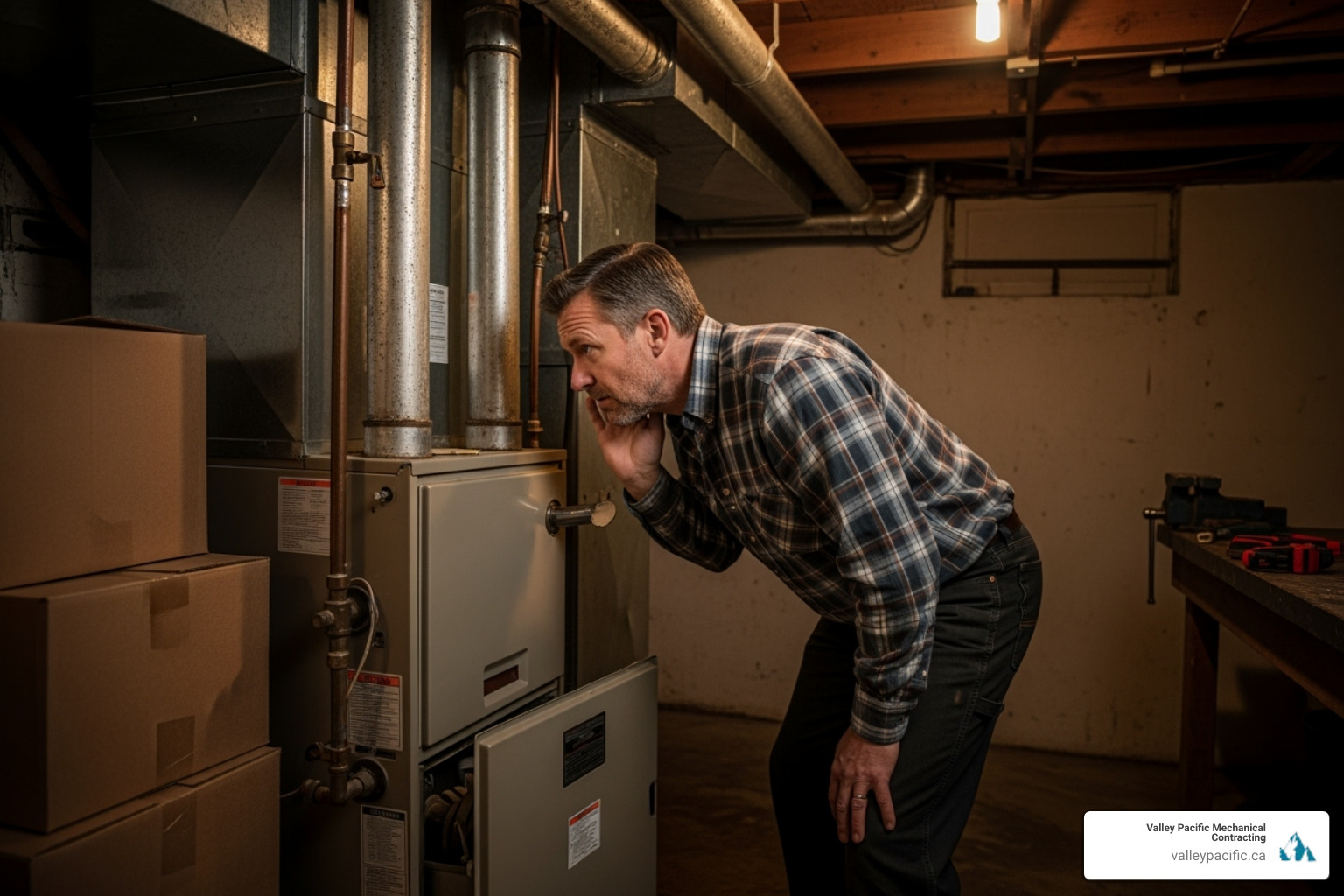
[LIST] of Common Furnace Warning Signs
Here's what to watch (and listen) for:
Unusual noises (banging, squealing, rattling): Your furnace should hum along quietly in the background. If you're hearing banging, that could mean trouble with the blower motor or even a cracked heat exchanger. Squealing typically points to a worn belt or failing motor bearing. Rattling might just be a loose panel, but it still deserves attention. None of these sounds are normal, and they won't fix themselves.
Sudden increase in energy bills: When your heating costs jump without explanation—same usage, same temperatures outside—your furnace is telling you it's struggling. It's working overtime to deliver the same warmth, burning through extra energy in the process. This is often one of the earliest signs that maintenance is overdue.
Uneven heating or cold spots in your home: If your bedroom feels like the Arctic while your living room is toasty, something's off. This uneven heating can stem from dirty ducts, a malfunctioning blower, or a thermostat that needs recalibrating. Your home should be consistently comfortable throughout.
Furnace cycles on and off frequently (short cycling): Does your furnace turn on, run briefly, shut off, then repeat the whole cycle a few minutes later? This "short cycling" puts enormous strain on your system. Common culprits include a clogged filter, thermostat issues, or even an incorrectly sized unit. Either way, it's wearing out your furnace faster than it should.
Yellow or flickering pilot light: This one's critical for safety. A healthy pilot light burns steady and blue. If yours is yellow or flickering, it could mean incomplete combustion—which can produce carbon monoxide. Don't wait on this one. Get a professional to check it immediately.
Visible rust or cracks on the furnace: Rust often signals water leaks that can corrode components over time. Cracks are even more serious, especially on the heat exchanger, where they can allow carbon monoxide to escape into your home. Any visible damage needs professional eyes on it right away.
Poor indoor air quality or excessive dust: Notice more dust settling on your furniture? Experiencing dry air or strange odors when the heat kicks on? Your furnace might be circulating pollutants or struggling with dirty internal components. A thorough tune-up can clean things out and get your air quality back to where it should be.
The bottom line? Trust your instincts. If something seems off with your furnace, it probably is. Addressing these warning signs early through professional furnace maintenance langley bc keeps small issues from becoming big, expensive problems.
What to Expect from a Professional Furnace Maintenance Langley BC Service
When you book furnace maintenance langley bc with our team, you're getting far more than a quick once-over. We're talking about a thorough, methodical inspection and tune-up that touches every critical component of your heating system. Our Langley technicians know the local climate inside and out—they understand how the damp, chilly winters put extra demands on your furnace, and they're trained to make sure your system is ready to handle whatever Mother Nature throws our way.
Think of it as a complete physical for your furnace. We check everything from the heat exchanger to the smallest electrical connection, ensuring nothing gets overlooked. Our goal is simple: to give you peace of mind knowing your furnace is safe, efficient, and ready to keep your family comfortable all winter long. For more details about our comprehensive approach to keeping your system in top shape, visit our page on HVAC maintenance services in Langley.
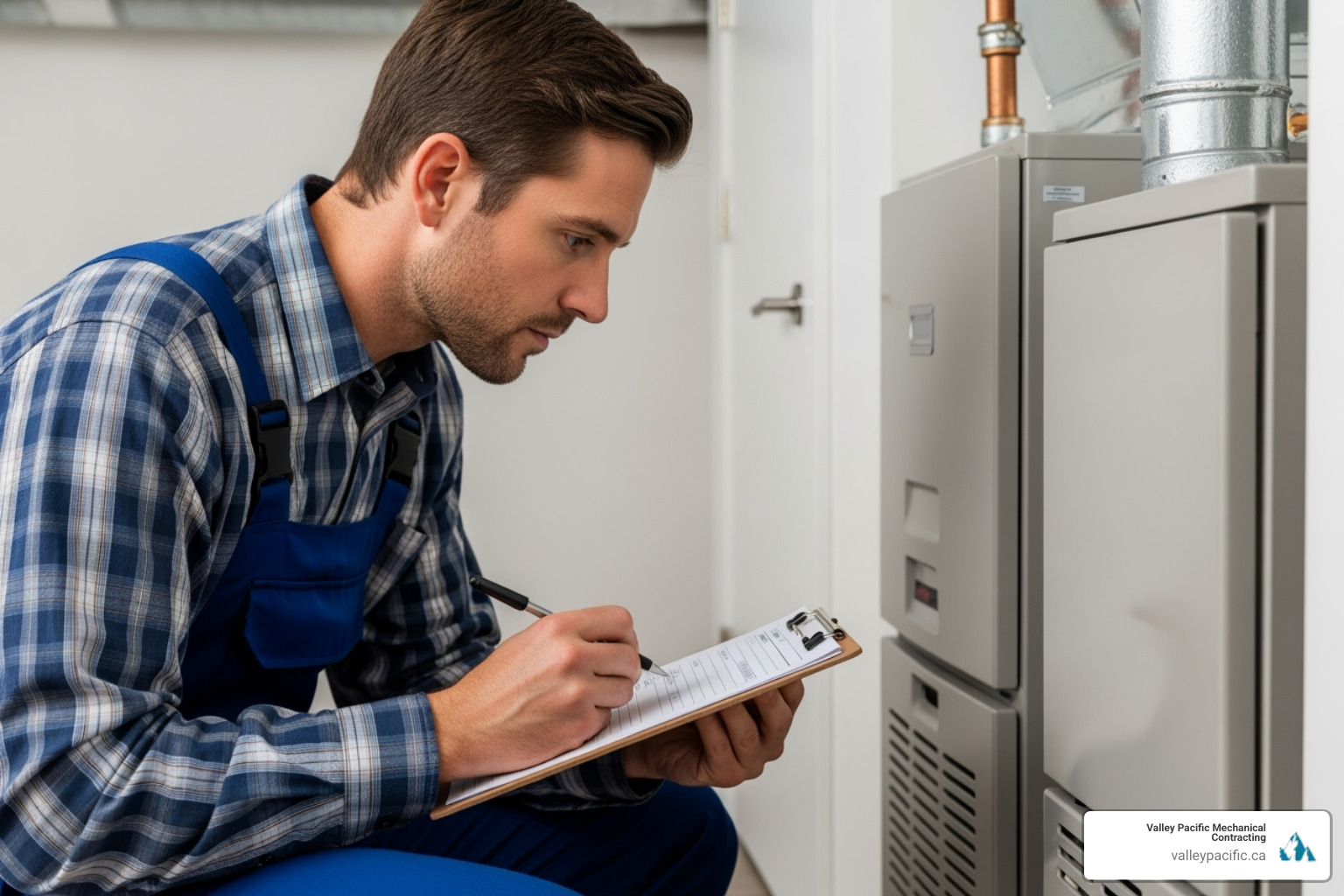
The Comprehensive Furnace Maintenance Checklist
Our professional tune-up follows a detailed checklist that covers every aspect of your furnace's operation. First and foremost, we inspect the heat exchanger—this is absolutely critical for safety. Even a tiny crack can allow dangerous carbon monoxide to seep into your living space, so we examine it carefully for any signs of damage or corrosion.
Next, we turn our attention to your air filter. Depending on the type you have, we'll either clean it thoroughly or replace it with a fresh one. This simple step alone can dramatically improve your system's efficiency and the quality of air circulating through your home. Then we check and clean the blower motor, making sure it's properly lubricated and free of dust buildup. This hardworking component needs to run smoothly to distribute warm air evenly throughout your home.
Your thermostat gets tested and calibrated to ensure it's reading temperatures accurately and communicating properly with your furnace. We also inspect all electrical connections, tightening any loose wires and checking for signs of wear or corrosion that could cause problems down the road. Safety is always top of mind, so we test safety controls like the limit switch to confirm your furnace will shut down if it starts to overheat.
The burners get a thorough cleaning and inspection to ensure they're producing a clean, efficient flame. We check and adjust gas pressure to manufacturer specifications—this ensures your furnace burns fuel efficiently without wasting energy or creating harmful emissions. Finally, we inspect the flue system to make sure combustion gases are venting properly outside your home, not lingering where they could pose a health risk.
Preparing for Your Furnace Maintenance Langley BC Appointment
You can help us provide the best possible service by taking a few simple steps before we arrive. Clear the area around your furnace so our technician has plenty of room to work. Even just three or four feet of clearance makes a big difference and allows us to inspect everything thoroughly.
Make sure we can easily access your furnace when we arrive. If it's tucked away in a locked closet or basement room, please leave it open uped or let us know where to find the key. It's also incredibly helpful if you make a note of any specific problems you've noticed—unusual sounds, strange smells, rooms that won't heat properly, anything at all. These observations often provide valuable clues that help us pinpoint issues quickly.
If you happen to know the make and model of your furnace, having that information handy can sometimes speed things up, though it's certainly not required. We can always find that information ourselves once we're on site.
These small preparations help us deliver the "headache-free" experience Valley Pacific is known for, ensuring your furnace maintenance langley bc appointment goes smoothly and your system gets the thorough attention it deserves.
Frequently Asked Questions about Furnace Tune-Ups in Langley
You're not alone if you have questions about keeping your furnace in top shape. We hear similar concerns from Langley homeowners all the time, and honestly, we love talking about this stuff! Here are the answers to the most common questions we get about furnace maintenance langley bc:
How often should I have my furnace serviced?
Here's the golden rule: annual maintenance is recommended for all furnaces, and fall is your sweet spot—ideally before the heating season kicks into high gear. This timing ensures your system is safe, efficient, and ready to tackle Langley's cold, damp winter weather without missing a beat.
Think of it this way: you wouldn't wait until your car breaks down on the highway to get an oil change, right? Your furnace deserves the same proactive care. A typical tune-up takes about an hour—a small investment of time for months of reliable warmth and peace of mind.
Now, if you have pets, family members with allergies, or you're particularly concerned about indoor air quality, you might even consider more frequent checks. Some homeowners benefit from service two to four times per year, especially if they notice dust buildup or run their system heavily. But for most Langley homes, that once-a-year fall appointment is the baseline that keeps everything running smoothly.
The key takeaway? Get it done before you're relying on your furnace day and night, so any minor issues can be caught and fixed before they leave you shivering.
Can regular maintenance prevent the need for emergency repairs?
Absolutely, yes! This is one of the biggest benefits of annual tune-ups, and it's something we see proven time and time again. Regular maintenance is genuinely one of your best defenses against those dreaded middle-of-the-night furnace failures.
Here's how it works: during your furnace maintenance langley bc appointment, our technicians carefully inspect every component of your system. We're looking for worn parts, loose connections, dirty components, and those subtle signs that something might fail soon. When we catch these small issues early, we can fix them proactively—before they snowball into major problems that cause a complete system breakdown.
It's like preventative medicine for your furnace. A small fix today prevents a major headache (and expense) tomorrow. While we're absolutely here for you with 24/7 emergency furnace repairs if you need them, our real goal is helping you avoid needing emergency service in the first place. Your comfort and budget will thank you.
Does furnace maintenance keep my manufacturer's warranty valid?
In many cases, yes—and this is a crucial detail that too many homeowners overlook until it's too late. Most furnace manufacturers explicitly require proof of regular professional maintenance to keep your warranty active. It's right there in the fine print of your warranty terms.
Here's the reality: if you skip your annual service and a major component fails, the manufacturer may deny your warranty claim entirely. That means you'd be stuck covering the full cost of the repair or replacement yourself, which can be thousands of dollars. Not exactly the outcome anyone wants.
The solution is simple: keep detailed records of your annual furnace maintenance langley bc appointments. These records serve as proof that you've properly cared for your unit, protecting your investment and ensuring you're covered if a warranted part fails. Think of maintenance not just as system care, but as warranty insurance. It's protecting both your furnace and your financial investment in that furnace.
Your Partner for Reliable Home Comfort in Langley
We've covered a lot of ground together today. From boosting energy efficiency and lowering your utility bills to improving home safety and extending your furnace's lifespan, the value of regular furnace maintenance langley bc is crystal clear. When your furnace is running smoothly, your whole home benefits—warmer rooms, cleaner air, lower bills, and most importantly, peace of mind knowing your family is safe.
Living in Langley means dealing with damp, chilly winters that put real demands on your heating system. That's why having a local partner who understands our unique climate makes all the difference. At Valley Pacific Mechanical Contracting, we've been serving homeowners throughout the Lower Mainland for over 30 years. We know Langley homes inside and out, and we're committed to delivering what we call a "headache-free" experience—no surprises, no runarounds, just straightforward, honest service when you need it.
Whether you're scheduling your annual tune-up, dealing with strange noises from your furnace, or simply want to ensure your system is ready for another winter, we're here for you. Our team is available 24/7 for emergencies because we know furnaces don't always break down at convenient times. But our real goal? Helping you avoid those emergency calls altogether through proactive, thorough maintenance.
Ready to give your furnace the attention it deserves? We invite you to explore all our furnace services to see how we can help keep your home perfectly comfortable all season long. And if your current system is nearing the end of its life or you're ready for an upgrade, check out our furnace installation services in Langley BC to learn about modern, efficient options.
Your comfort isn't just our job—it's our promise. Let's work together to keep your home warm, safe, and comfortable for years to come.
Why a Daikin heat pump install Requires Professional Expertise
A Daikin heat pump install is a precision process that determines whether your advanced system delivers the comfort and efficiency you paid for. While Daikin makes some of the world's best heating and cooling systems, research from NIST shows that most heat pumps underperform due to installation errors, not equipment flaws.
What makes a professional Daikin installation essential:
- Proper refrigerant handling: Nitrogen pressure testing, vacuum evacuation to below 500 microns, and precise charging.
- Correct electrical setup: Dedicated circuits, disconnect boxes, and code-compliant wiring.
- Optimal placement: Positioning indoor and outdoor units for maximum efficiency and airflow.
- System commissioning: Testing in both heating and cooling modes before completion.
- Warranty protection: Professional installation is required to keep your up to 12-year limited parts warranty valid.
The quality of your installation is as crucial as the equipment itself. Whether it's a ductless system installed in a few hours or a central heat pump taking a full day, the technical details matter for long-term performance.
Installation timelines vary by system type:
- Single-zone ductless mini-split: 4-6 hours
- Multi-zone system (2-4 heads): 6-10 hours
- Central ducted heat pump replacement: 6-10 hours
This guide explains what happens during a professional Daikin installation, from pre-installation prep to the technical steps that ensure your system runs efficiently for 12-15 years or more.
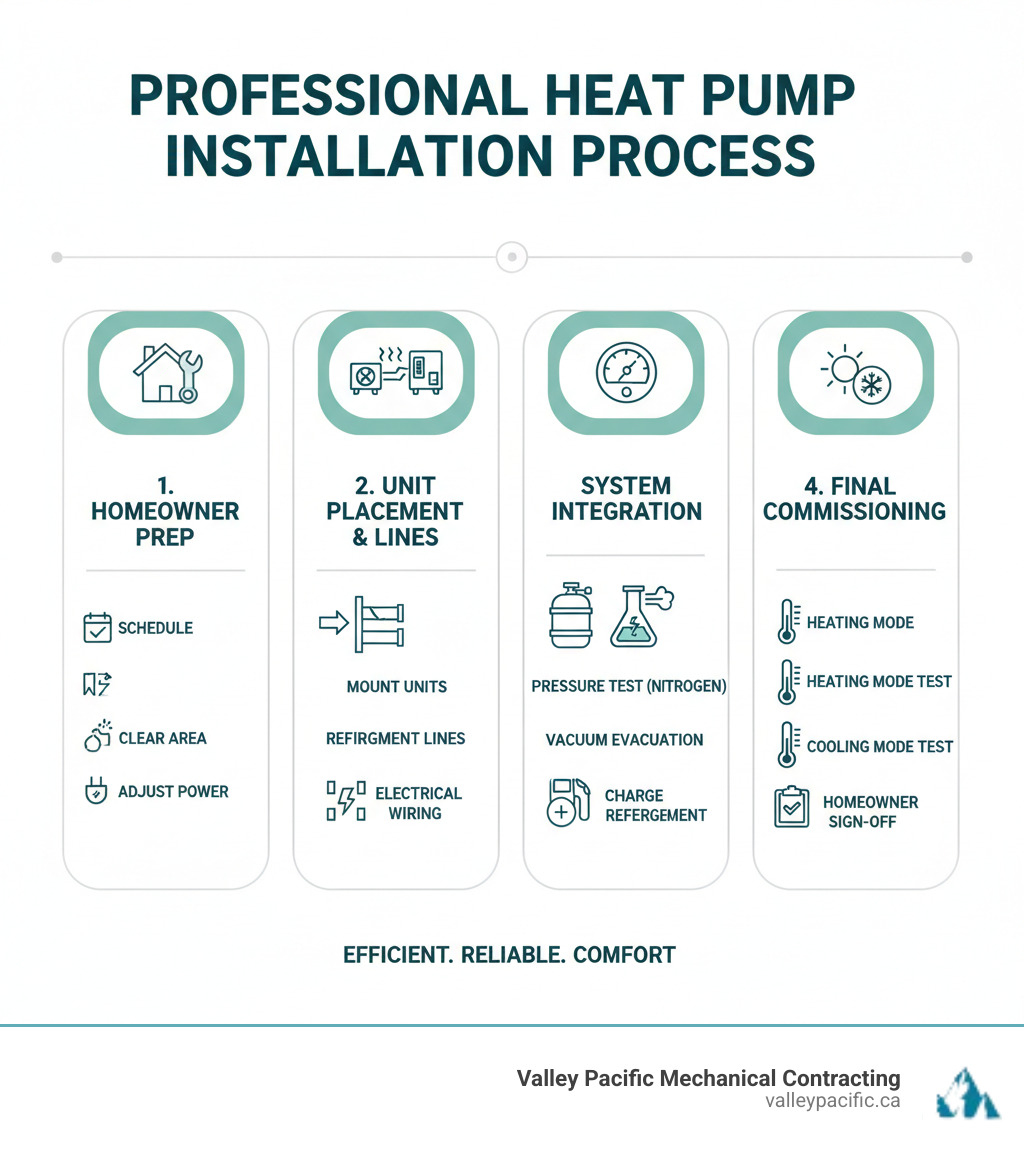
Basic Daikin heat pump install vocab:
The Daikin Advantage: Why Professional Installation is Non-Negotiable
When you choose a Daikin heat pump, you're investing in over 90 years of heating and cooling innovation. Instead of burning fuel, a Daikin heat pump moves heat between your home and the outdoors, an efficient process that can reduce your electricity consumption by up to 40% compared to electric baseboards.
However, even the most advanced heat pump won't deliver these savings if installed incorrectly. Common installation errors like incorrect refrigerant charge, leaky connections, and poor airflow can waste energy and money for the life of the system. This is why professional installation is non-negotiable.
We stand behind the Daikin Comfort Promise—our commitment that your system will perform as designed from day one. With over 30 years of expertise, our team ensures every Daikin heat pump install is executed perfectly. Proper Daikin Heat Pump Service is key to open uping your system's full potential.
Improved Comfort with Daikin FIT and Daikin One Systems
Two Daikin innovations that redefine home comfort are the Daikin FIT system and the Daikin One+ Smart Thermostat.
The Daikin FIT features a compact, side-discharge design, making it ideal for tight spaces like narrow side yards. Its real advantage is its quiet operation—producing as little as 25% of the noise of conventional units. This is thanks to inverter technology, which allows the compressor to adjust its speed smoothly rather than cycling on and off. The result is steady temperatures, lower energy bills, and a peaceful home environment.
Paired with the Daikin One+ Smart Thermostat, your system becomes an intelligent comfort hub. The Daikin One Home app lets you adjust your home's temperature from anywhere. The thermostat's smart scheduling learns your routine to optimize comfort and savings, while cloud-based monitoring can detect potential issues before they become problems. This intelligent control can add another 5-10% in energy savings.
Together, the Daikin FIT and Daikin One systems offer cutting-edge equipment with intelligent controls for effortless comfort management.
Your Pre-Installation Checklist: Preparing for a Smooth Process
A successful Daikin heat pump install begins with a few simple preparations. Taking these steps helps our technicians work safely and efficiently, keeping your installation on schedule and ensuring a headache-free experience.
Clear Indoor Work Areas: Please create a clear path from the entrance to the indoor unit's location (for ductless systems) or your furnace/air handler (for central systems). Moving furniture, decorations, and personal items beforehand allows us to start work immediately.
Prepare the Outdoor Unit Location: The outdoor unit needs a stable, level spot with ample airflow. Clear away any debris, plants, or other items from the designated area. We will confirm the Best Locations for Heat Pump Placement and ensure it is perfectly level on a solid pad or brackets.
Ensure a Safe Access Path: A clear, obstacle-free route from our vehicle to both the indoor and outdoor work areas helps us move equipment safely and speeds up the installation.
Keep Children and Pets Safe: For everyone's safety, please keep children and pets away from the work zones during the installation. We will be working with electrical components, refrigerants, and specialized tools.
Be Available for Walkthroughs: We'll need you present for two key moments: a brief walkthrough when we arrive to confirm project details, and a final walkthrough at the end of the day. During the final walkthrough, we'll demonstrate how to use your new system and answer all your questions.
Locate Your Electrical Panel: Knowing where your electrical panel is can be helpful, though our electricians will handle all technical work.
These preparation steps allow us to focus on what we do best: delivering a professional installation that ensures years of reliable comfort.
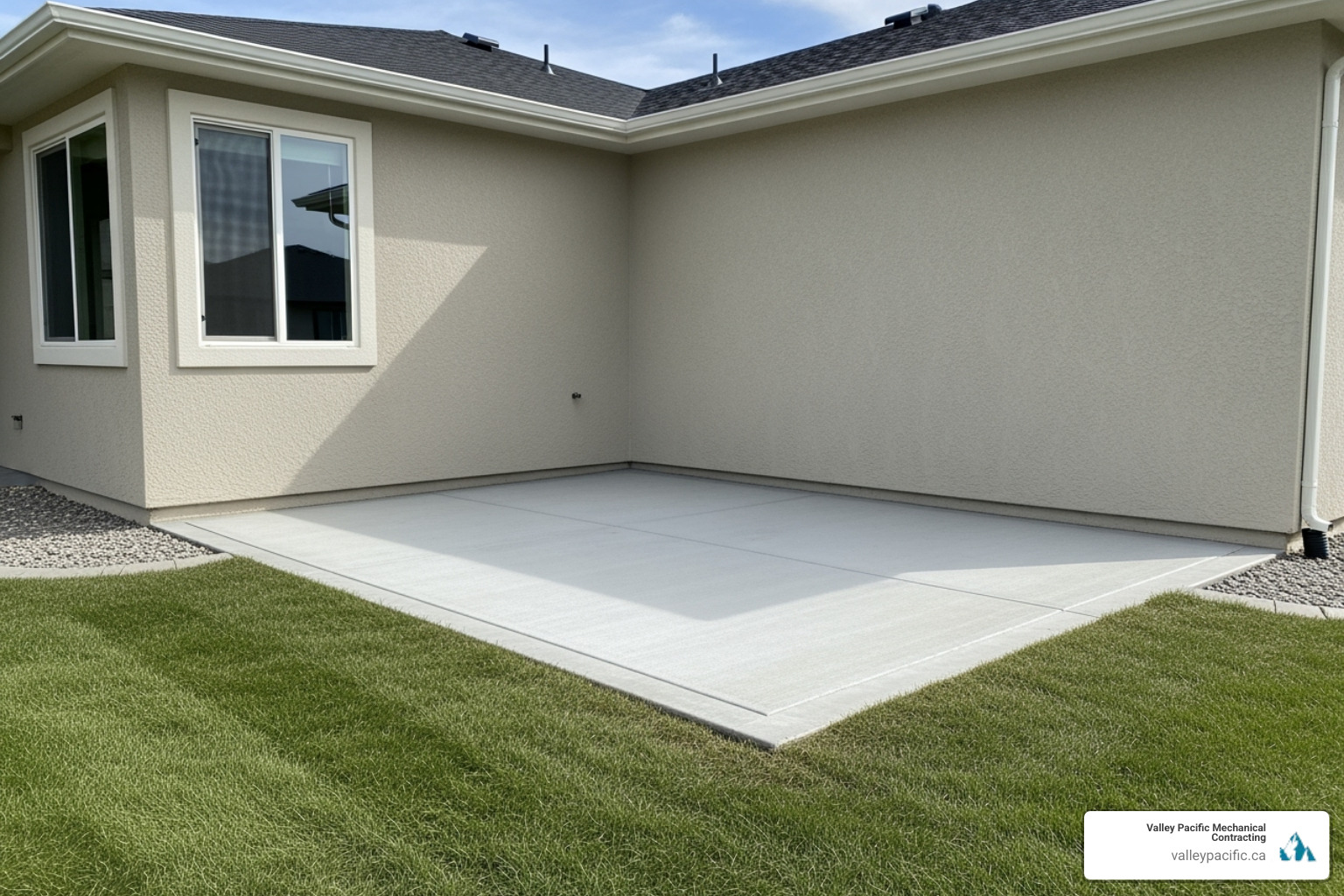
A Step-by-Step Guide to the Installation Day
On installation day, our refined process ensures your Daikin heat pump install is smooth and transparent. Here’s what to expect:
- Arrival and Walkthrough: Our certified technicians arrive on time and begin with a walkthrough to confirm unit locations, access points, and answer your questions.
- Site Protection: We lay down drop cloths and floor runners to protect your home's floors and furniture, aiming to leave no trace behind.
- Old System Removal: If replacing an existing system, we safely decommission, remove, and responsibly dispose of the old equipment.
- New Unit Installation: Our experienced technicians carefully install the indoor and outdoor units, ensuring every measurement and connection is precise.
- System Commissioning: This critical phase includes nitrogen pressure testing for leaks, evacuating lines with a vacuum pump to remove contaminants, and precisely charging the system with refrigerant. We then run comprehensive tests in both heating and cooling modes.
- Homeowner Tutorial: Before we leave, we'll walk you through your new system's controls, including the remote or Daikin One+ Smart Thermostat, so you feel confident operating it.
- Final Cleanup: We thoroughly clean all work areas, removing debris, packaging, and old equipment.
This detailed process guarantees your installation meets the highest standards, providing reliable performance for the next 12-15 years.

The Daikin Ductless Mini-Split Install Process
Ductless mini-splits offer versatile, targeted heating and cooling. Whether for a single-zone or a multi-zone system, a professional Daikin heat pump install requires precision.
- Mounting the Indoor Unit: We select the optimal wall location for air distribution and aesthetics, securely attaching the mounting plate.
- Creating the Line Set Path: A small, angled hole (approx. 3 inches) is drilled through the exterior wall behind the unit for the refrigerant lines, wiring, and drain. This penetration is weatherproofed and sealed.
- Placing the Outdoor Unit: The unit is set on a perfectly level concrete pad or heavy-duty brackets to ensure proper operation and drainage. We maintain proper clearances for airflow and future service.
- Connecting Lines: We run insulated refrigerant lines, electrical wiring, and a drain tube between the units, often in a protective conduit. Connections are torqued to exact specifications to prevent leaks.
- Multi-Zone Systems: For multi-zone setups, we connect multiple indoor units to a single outdoor unit, allowing for individual room temperature control and improved energy efficiency.
If you're in Pitt Meadows, learn more about our Heat Pump Installation Pitt Meadows BC services.
The Daikin Central (Ducted) Heat Pump Install Process
A Daikin central heat pump integrates with your home's existing ductwork for whole-home comfort.
- Indoor Coil Replacement: We typically replace your existing A/C coil with a new one sized for optimal heat pump efficiency, fitting it perfectly within your furnace or air handler.
- Custom Sheet Metal Fabrication: To ensure an airtight system, we often fabricate custom sheet metal transitions. This prevents air leaks and maximizes efficiency, which can lower your energy bills.
- Ductwork Integration: We connect the new components to your ductwork, inspecting for leaks or inefficiencies. Sealing ducts can significantly boost performance.
- Outdoor Unit Installation: The outdoor unit is placed on a level concrete pad, and we run insulated refrigerant and electrical lines between the indoor and outdoor components.
- Thermostat and Dual-Fuel Integration: We integrate the new system with your thermostat. For dual-fuel systems (heat pump + furnace), the Daikin One+ Smart Thermostat automatically switches to the most efficient heating source based on the outdoor temperature.
Langley homeowners can learn more about our professional services by visiting our Heat Pump Installation Langley BC page.
Key Technical Steps in a Professional Daikin Heat Pump Install
The technical execution of a Daikin heat pump install is critical for safety, efficiency, and longevity. These steps are why professional installation is essential.
- Safety First: Our technicians prioritize safety by ensuring proper ventilation when handling refrigerants, following strict electrical protocols (including power disconnects and code compliance), and using caution around sharp components.
- Electrical Requirements: Your Daikin system requires a dedicated electrical circuit. We install a new, properly sized breaker and wiring, along with an accessible outdoor disconnect box for safety and maintenance. All work is performed by qualified electricians to meet code.
- Refrigerant Piping: We use clean, sealed, refrigerant-grade copper tubing. Pipes are bent carefully to avoid kinks, and connections are torqued precisely to create leak-proof seals. Both lines are insulated to prevent condensation and maintain efficiency.
- Nitrogen Pressure Testing: Before charging the system, we pressurize the lines with dry nitrogen to 450-550 PSI and monitor for any pressure drop. This ensures the system is 100% leak-free.
- System Evacuation: Using a vacuum pump, we evacuate the refrigerant lines to below 500 microns. This critical step removes all moisture and air, which can cause corrosion and reduce efficiency, protecting your compressor and ensuring long-term reliability.
- Releasing Refrigerant: Finally, we release the factory refrigerant charge into the clean, dry, and sealed system. If extra refrigerant is needed for longer line sets, we weigh in the precise amount required for optimal performance.
These technical steps, combined with our Seasonal Heat Pump Maintenance Tips, ensure your Daikin system delivers reliable comfort and savings for its entire 12-15 year lifespan.
Frequently Asked Questions About Your Daikin Heat Pump Install
We understand you might have a few questions about your upcoming Daikin heat pump install. Here are some of the most common ones we hear, answered with our expert knowledge and real-world experience.

How long does a typical Daikin heat pump installation take?
The timeline for a Daikin heat pump install depends on the system type and your home's layout. We work efficiently but never rush the critical steps.
- Single-zone ductless system: Typically 4 to 6 hours.
- Multi-zone ductless or central ducted system: Usually a full day, from 6 to 10 hours.
Factors like complex line runs, bracket mounting for the outdoor unit, or electrical panel upgrades can add time. Following the pre-installation checklist helps ensure the process is as efficient as possible. We will provide a more precise timeline during your initial consultation.
Can I use my new Daikin heat pump on the same day it's installed?
Yes, absolutely. Your new Daikin heat pump will be fully operational and ready to use by the time we leave.
Our installation process concludes with a thorough commissioning phase, where we test the system in both heating and cooling modes to ensure it performs perfectly. We also provide a complete homeowner tutorial on how to operate your new remote or smart thermostat. You will be able to enjoy immediate comfort on the same day as your installation.
What kind of warranty comes with a Daikin heat pump?
Daikin offers one of the best warranties in the industry, providing significant peace of mind.
Most Daikin systems include up to a 12-year limited parts guarantee. The specific terms vary by model, and we will provide you with all the details for your system.
Critically, professional installation is required to keep your warranty valid. Installation errors can void your coverage. Choosing Valley Pacific Mechanical Contracting for your Daikin heat pump install ensures your warranty remains intact. We also guide you through the product registration process, which is necessary to activate your full warranty benefits.
To further protect your investment and extend its lifespan, consider our Comprehensive Heat Pump Service Plans. These plans provide ongoing maintenance to ensure your system runs efficiently for 15 years or more.
Conclusion: Get Your Daikin Installed Right for Lasting Comfort
Your decision to choose a Daikin heat pump is a smart investment in your home's comfort and efficiency. But as we've explored throughout this guide, that investment only reaches its full potential when paired with a professional Daikin heat pump install. The difference between a system that performs beautifully for 12-15 years and one that underperforms from day one often comes down to the quality of installation.
Think about everything we've covered: the precision refrigerant handling, the careful electrical work, the meticulous pressure testing, and the thorough commissioning process. These aren't just technical checkboxes—they're the foundation of long-term performance and efficiency. When your system is installed correctly, you'll enjoy consistent comfort in every season, lower energy bills month after month, and the peace of mind that comes with knowing your warranty is fully protected.
At Valley Pacific Mechanical Contracting, we've been delivering this level of expertise to homeowners throughout the Lower Mainland for over 30 years. Our certified technicians serve Mission, Maple Ridge, Langley, Pitt Meadows, and Coquitlam with a commitment that goes beyond simply mounting equipment. We're meticulous craftsmen who understand that every connection, every seal, and every setting matters.
This dedication is what we mean by a truly "headache-free" experience. From the moment you contact us through the final homeowner tutorial, we handle every detail with care. We protect your home during installation, we test every function thoroughly, and we don't consider the job complete until you're comfortable operating your new system. It's all part of the Daikin Comfort Promise—our pledge that your system will deliver the performance and efficiency you paid for.
Your home deserves better than installation shortcuts or guesswork. It deserves the precision and expertise that ensures your Daikin heat pump operates at peak performance for years to come. If you're ready to experience the difference that professional installation makes, we're here to help.
Get your professional Daikin installation in Maple Ridge and find what lasting comfort really means.
Your Introduction to Year-Round Comfort with Heat Pumps
Heat pump installation Langley services connect homeowners with energy-efficient systems that provide both heating and cooling. When looking for a qualified installer, focus on these key factors:
- Local climate expertise - Langley's mild winters and warm summers are ideal for heat pump efficiency.
- Verified licensing and certifications - Licensed technicians ensure proper installation and warranty protection.
- System sizing knowledge - Professional load calculations match the right heat pump to your home's needs.
- Clear installation process - Transparent timelines, site prep, and post-installation support.
- Rebate and financing guidance - Help navigating BC and federal incentive programs.
Langley's moderate climate is perfect for heat pump technology. Unlike furnaces that burn fuel, heat pumps transfer heat. In winter, they pull warmth from outdoor air and move it inside. In summer, they reverse the process to cool your home.
This approach uses significantly less energy than conventional systems, reducing your consumption while maintaining year-round comfort.
However, professional installation matters. An improperly sized or installed unit won't deliver the expected efficiency or comfort and can lead to short cycling, poor performance, and premature failure. The right installer performs detailed load calculations to determine the perfect system size and ensures all components are installed to manufacturer specifications.
With proper installation, heat pumps typically last 15-25 years, making them a long-term investment in your home's comfort and budget.
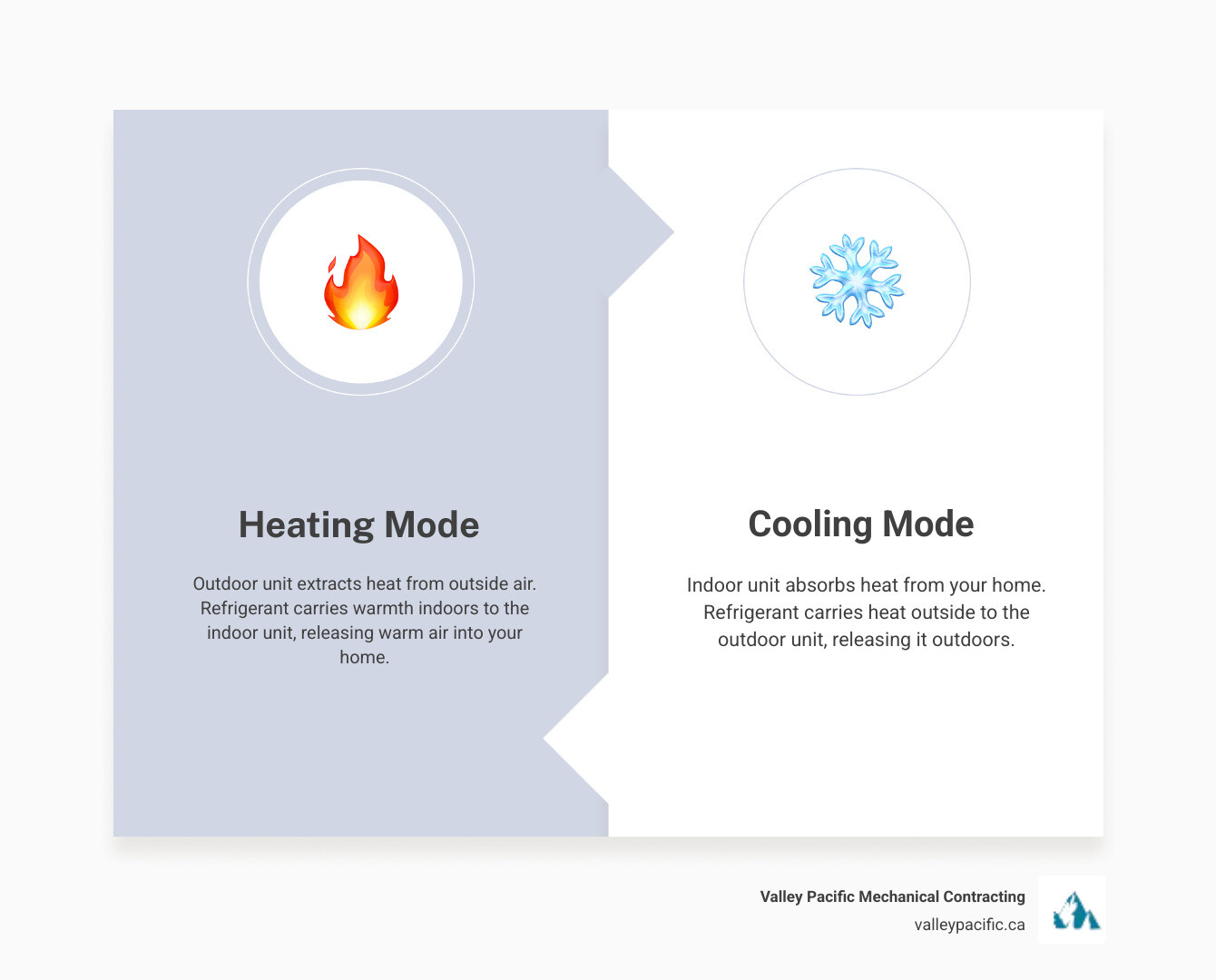
#1: Check for Local Expertise and Deep Knowledge of Langley's Climate
When seeking heat pump installation Langley services, choose an installer with deep local knowledge. A technician who understands Langley's specific climate can recommend a system that will perform efficiently for years.
Langley's moderate climate, with its mild winters and warm summers, allows heat pumps to operate at peak efficiency most of the year. An experienced local installer understands how humidity affects performance and how homes in different neighborhoods respond to seasonal changes—knowledge gained only through years of working in the community.
At Valley Pacific Mechanical Contracting, we've served the Lower Mainland for over 30 years, installing heat pumps in homes throughout Langley. This experience allows us to recommend systems perfectly matched to your home and our local climate, maximizing energy savings while ensuring year-round comfort.
An installer who truly understands Langley's weather patterns helps you avoid common pitfalls, like choosing an incorrectly sized system for our mild winters or summer cooling demands. The result is a heat pump that thrives in Langley's conditions. If you're curious about the broader benefits of this technology, take a look at the reasons to consider heat pump installation.

Why Heat Pumps are a Smart Choice for Langley Homes
Compared to traditional HVAC systems, the advantages of heat pumps are clear. A conventional setup uses two separate systems—a furnace and an air conditioner—which consumes more energy. A heat pump is an all-in-one solution that moves heat rather than creating it through combustion.
This remarkable energy efficiency has a real impact on your wallet and the planet. Lower energy consumption means reduced utility bills and a lower carbon footprint, contributing to environmental sustainability.
Modern heat pumps also offer improved indoor air quality. Their advanced filtration systems continuously clean the air circulating through your home, filtering allergens like pollen, dust, and pet dander. This can make a noticeable difference for family members with allergies or respiratory sensitivities.
It's a smart investment for comfort, cost savings, environmental responsibility, and health. Learn more about what makes a residential heat pump such a valuable addition to your home.
#2: Verify Experience, Licensing, and Warranty Guarantees
Investing in heat pump installation Langley is a long-term commitment to your home's comfort. It's vital to verify your installer's credentials and ensure they stand behind their work.
Experience is crucial. With over 30 years serving the Lower Mainland, we bring wisdom from thousands of installations to every job. Your installer should also have licensed and certified technicians trained in heat pump technology. Licensing proves that technicians meet rigorous standards for working safely with complex HVAC equipment. Our team stays current with the latest best practices through continuous training.
Customer reviews reveal a company's true character. Look for consistent feedback from other Langley homeowners about communication, the installation process, and post-sale support.
We're proud to offer a "headache-free" experience, backed by real guarantees and the Daikin Comfort Promise. A reputable installer will always offer clear warranties on both the equipment and their workmanship. This no-hassle guarantee protects you if anything goes wrong, preventing finger-pointing between the manufacturer and installer.
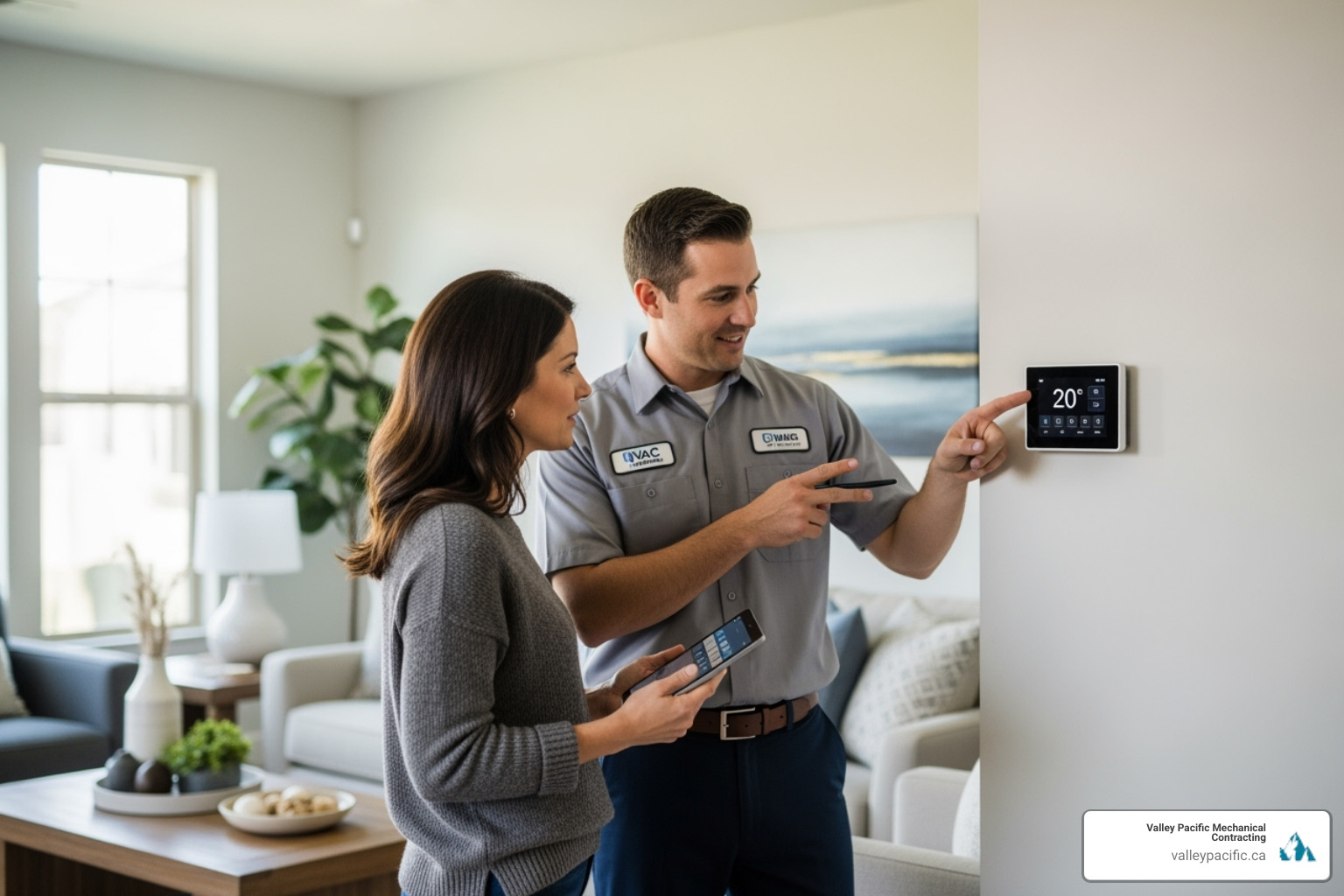
How Professional Installation Affects Lifespan and Performance
The quality of your installation has more impact on your heat pump's lifespan than almost anything else. A well-installed unit typically lasts 15-25 years, while a poorly installed one may fail in under a decade.
The difference is in the details. Proper sizing, determined by professional load calculations, is the most critical factor. An improperly sized unit will run inefficiently, wear out faster, and fail to keep you comfortable.
We also strictly follow manufacturer standards during every installation. This protects your investment and ensures your equipment warranties remain valid, allowing your system to perform as engineered.
Our workmanship guarantees provide an extra layer of protection. We stand behind every connection and calibration. If something isn't right, we make it right—no excuses.
Professional installation also means avoiding common issues like incorrect refrigerant charging, leaky ductwork, and poor unit placement. We test and calibrate the entire system before we leave, ensuring your heat pump will deliver reliable comfort and energy savings for decades. For guidance on keeping your system running smoothly, see our heat pump maintenance tips.
#3: Assess Their Knowledge of Heat Pump Types and System Sizing
When evaluating a heat pump installation Langley partner, ask them: "How do you determine the right system for my home?" Their answer reveals their expertise.
A knowledgeable installer knows every home is unique. The right heat pump for your neighbor might be wrong for you due to differences in layout, insulation, and window quality. A professional never takes shortcuts.
Our process begins with a comprehensive home assessment. We examine your home's layout, insulation, and windows to perform a precise load calculation. This mathematical approach determines the exact heating and cooling capacity your home needs, ensuring your system runs efficiently and lasts longer. Installers who skip this step leave you with systems that waste energy or provide inadequate comfort.
A true professional will take time on this assessment, ask about your comfort preferences, and explain their recommendations. This attention to detail is what separates a professional installation from a rushed job.
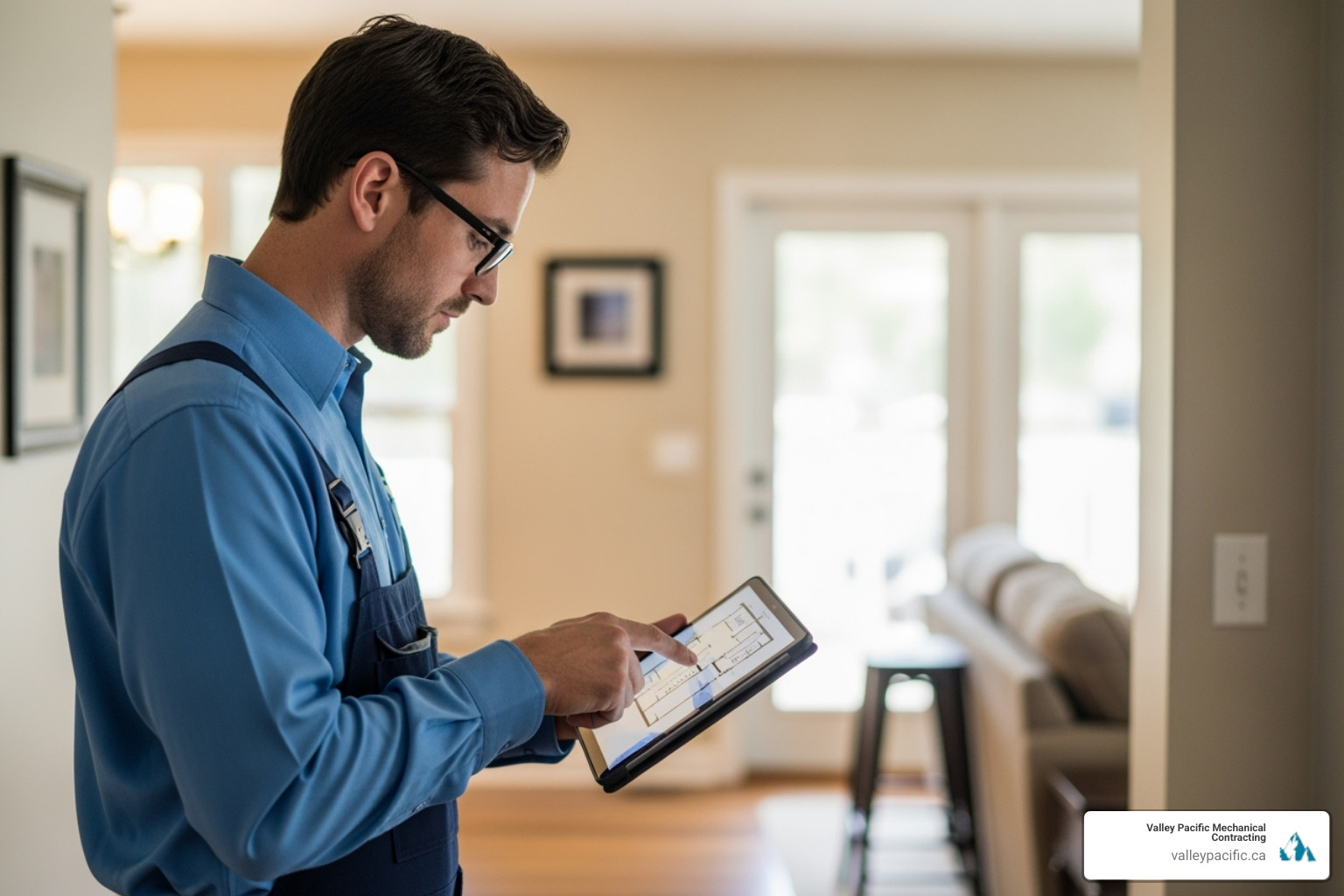
Choosing the Right Type of Heat Pump for Your Home
Once your home's needs are understood, the next step is choosing the right type of heat pump. A knowledgeable installer will walk you through these options:
- Air-source heat pumps: The most popular choice in Langley, these systems are ideal for our climate and integrate seamlessly with existing ductwork.
- Ductless mini-splits: Perfect for homes without ductwork or for creating comfort zones. They allow independent temperature control in different rooms, boosting comfort and savings.
- Geothermal systems: These offer exceptional efficiency by using the earth's stable underground temperatures. They have a higher upfront investment but deliver consistent performance regardless of the weather.
- Hybrid heat pumps: This system combines an electric heat pump with a gas furnace, intelligently switching to the most efficient energy source based on outdoor temperatures.
- Variable-speed models: Unlike single-speed systems, these adjust their output smoothly to match your home's needs, resulting in quieter operation and greater efficiency.
A good installer will help you understand which system best fits your property, budget, and lifestyle. They can also advise on the best locations for heat pump placement to maximize efficiency. With over 30 years of experience, we know which systems thrive in different situations and will guide you to the right solution.
#4: Inquire About the Heat Pump Installation Langley Process and Aftercare
When you choose a company for heat pump installation Langley, the experience should be a "headache-free" journey where you feel supported and informed.
Before we arrive, we'll guide you through simple site preparation, like clearing access paths for our team, to ensure a smooth installation day. Our licensed technicians will arrive on time, ready to work. They will position the indoor and outdoor units, connect all lines and wiring, and seal any ductwork. We work efficiently and keep your home tidy, minimizing disruption.
After installation, we conduct thorough testing and calibration. A key part of our process is customer education: we walk you through your new system's operation and features so you feel completely confident. We also handle the removal and disposal of your old system according to all environmental regulations. For more details, see our heat pump installation guide.
Understanding Post-Installation Maintenance for Your Heat Pump
To keep your new heat pump running efficiently for years, a little ongoing care is needed. We'll show you exactly what to do.
- Filter changes: This is the most important DIY task. We'll show you how to change or clean your filters every 1-3 months to maintain good airflow, air quality, and efficiency.
- Outdoor unit care: Keep the area around the outdoor unit clear of leaves, debris, and vegetation to ensure proper airflow. A quick visual check each month is usually sufficient.
- Annual professional service: A yearly tune-up by our technicians is essential. We inspect all components, check refrigerant levels, and clean coils to catch small issues before they become expensive repairs.
To make this even easier, we offer service plans for comprehensive care and peace of mind. If you suspect an issue between visits, our guide on signs your heat pump needs repair can help. For ongoing support, explore our comprehensive heat pump service plans.
With proper care, your heat pump will provide comfort for 15 to 25 years, and we'll be here to support you every step of the way.
#5: Confirm Their Expertise with Rebates and Financing Options
The best heat pump installation Langley companies do more than just install equipment; they help you access every available rebate and incentive, which can save you thousands.
With over 30 years of experience, we make it our business to stay current on all provincial and federal programs to ensure our customers don't pay more than they have to. The landscape of incentives, including Better Homes BC rebates and federal grants, changes regularly. These programs have specific requirements and deadlines that can be easy to miss.
Our team guides you through the eligibility and application process to maximize your savings. We've helped countless Langley homeowners steer these programs successfully. You can learn about BC rebates to get started, and we'll handle the rest.
We also understand that a heat pump is an investment. That's why we offer flexible financing options to fit your budget, allowing you to spread the cost over time while enjoying immediate energy savings. We also feature regular promotions that add even more value. Combining promotions, rebates, and grants can make a new system surprisingly affordable.
A knowledgeable installer should be your partner in maximizing savings. If a potential installer seems uncertain about rebates, consider it a red flag. The right team will treat your budget with the same care they treat your home.
Frequently Asked Questions about Heat Pump Installation in Langley
How long does a typical heat pump installation take?
Most heat pump installation Langley projects for homes with existing ductwork are completed in a single day. More complex installations, such as those needing ductwork modifications or geothermal systems, may take longer. We provide a clear and realistic timeline during your initial consultation, so there are no surprises.
Can a heat pump be installed in a home without existing ductwork?
Yes. Ductless mini-split systems are the perfect solution for homes without existing ductwork. They consist of an outdoor unit connected to one or more indoor units, allowing for less invasive installation. The main advantage is zoned heating and cooling, which lets you control temperatures in individual rooms for personalized comfort and energy savings. To learn more about how these systems keep you cool, check out our page on Heat Pump AC.
What are the signs that I need to replace my old heat pump?
If your heat pump is over 15 years old, its efficiency has likely declined, and it's time to consider a replacement. Recognizing the warning signs early can help you avoid a sudden breakdown. Here are the key signs your heat pump is failing:
- Age: Any unit over 15 years old is far less efficient and reliable than modern models.
- Reduced effectiveness: The system struggles to heat or cool your home to the set temperature.
- Rising energy bills: Your utility costs are increasing without a change in your usage habits.
- Frequent repairs: You're paying for repairs more than once a year, and the costs are adding up.
- Unusual noises: Grinding, rattling, or other loud noises often signal serious mechanical issues. Some noises, like grinding, can indicate major component failure. You can learn more in our article on heat pump grinding noises causes.
If you notice these signs, call us for an honest assessment. Often, investing in a new, efficient heat pump is the smarter long-term choice for your comfort and your budget.
Find Your Trusted Langley Heat Pump Installer Today
By focusing on local expertise, credentials, proper sizing, a clear process, and rebate guidance, you can confidently choose the right partner for your heat pump installation Langley project. A trusted partner delivers more than a technical installation; they provide a "headache-free" experience and ensure long-term reliability and comfort.
For over 30 years, Valley Pacific Mechanical Contracting has been that trusted partner for Langley homeowners. Our licensed and certified technicians understand our local climate and bring deep expertise to every project, whether you're upgrading an old furnace or adding cooling for the first time.
Your comfort is our priority, which is why we offer 24/7 emergency service. You're never left in the cold or heat. We stand behind our work with comprehensive warranties and the trusted Daikin Comfort Promise, giving you complete peace of mind.
Ready to experience year-round comfort without the headaches? We're here to answer your questions and design a solution that fits your lifestyle and budget. Our team will guide you through every step, from choosing the right system to maximizing available rebates.
Don't wait for another uncomfortable season. Contact Us today to schedule your consultation and find how our expert Heat Pump Installation Langley BC services can transform your home's comfort while lowering your energy bills.
Why Commercial Drain Problems Demand Immediate Attention
Drain cleaning services are essential for maintaining the health and efficiency of commercial plumbing systems. Unlike residential drains, commercial facilities face unique challenges that require professional expertise and specialized equipment.
Key reasons businesses need professional drain cleaning:
- Prevent costly business downtime - A single clogged drain can shut down operations
- Avoid health code violations - Backed-up drains create unsanitary conditions that fail inspections
- Stop property damage - Overflowing drains can cause expensive water damage to floors, walls, and equipment
- Reduce emergency repair costs - Regular maintenance prevents major plumbing failures
- Maintain proper hygiene - Clean drains prevent bacteria growth and foul odors
Over 400,000 homes in the U.S. face clogged drain problems annually, and commercial properties experience even higher failure rates due to intensive use. Research shows that regular drain maintenance can cut emergency plumbing calls by 50% and potentially extend your plumbing system's lifespan by up to 50%.
The reality is stark: clogged drains don't just cause inconvenience. They create health hazards, violate sanitation codes, and force businesses to close their doors until repairs are complete. Whether you're running a restaurant dealing with grease buildup or managing an office building with aging pipes, professional drain cleaning services provide the preventative care your commercial property needs.
This guide will walk you through everything you need to know about selecting the right commercial drain cleaning partner - from understanding why commercial drains require specialized care to asking the right questions before hiring a service provider.
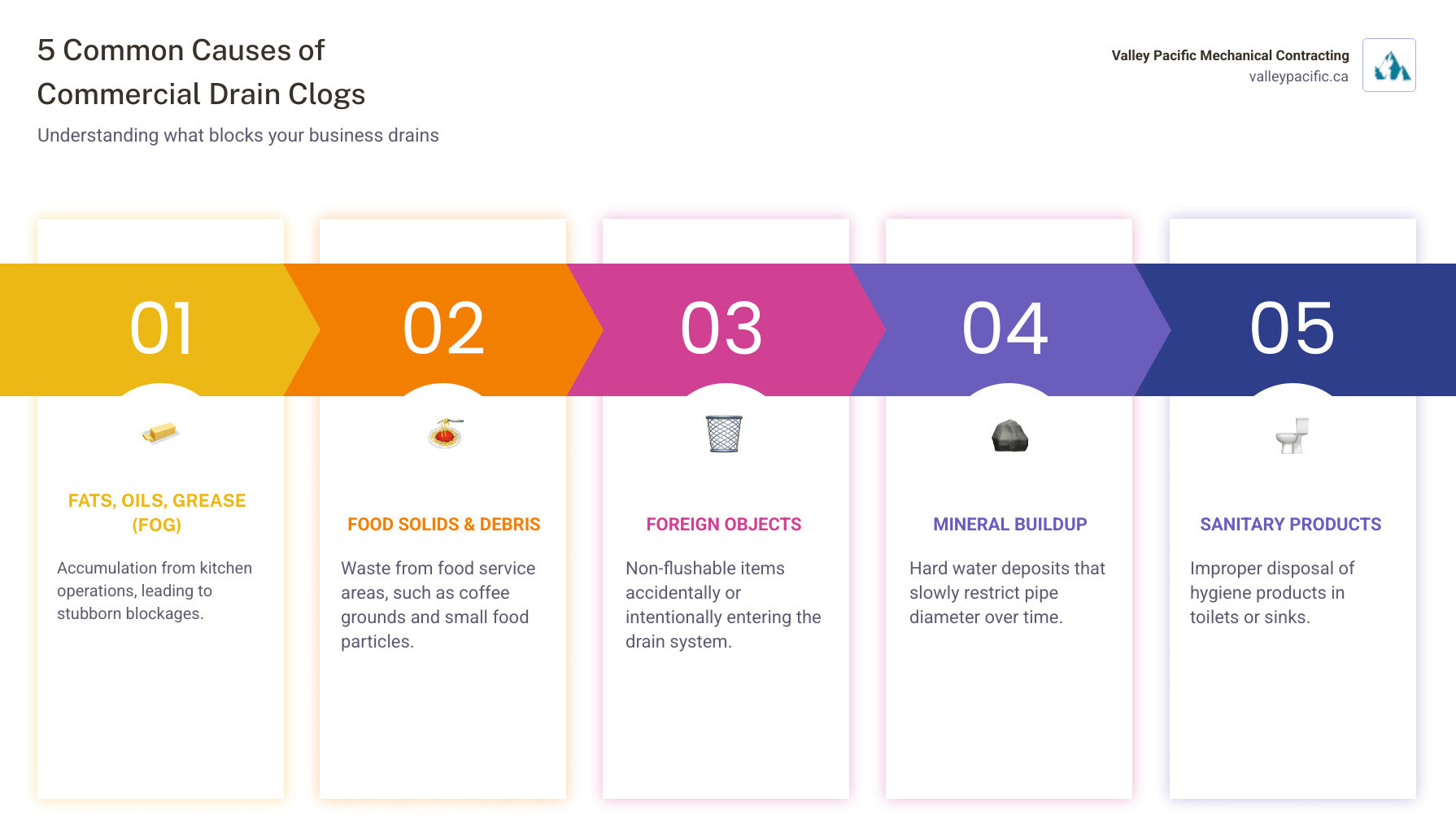
Drain cleaning services basics:
Why Commercial Drains Are a Different Beast
When you hear "commercial drains," you might picture something like your home plumbing, just bigger. But here's the truth: commercial drainage systems are an entirely different animal. They're built to handle volumes and materials that would overwhelm a residential system in minutes.
Picture a busy restaurant during the dinner rush, or a multi-story office building with hundreds of employees, or a manufacturing plant running three shifts a day. Each of these environments generates massive amounts of wastewater carrying everything from grease and food debris to industrial waste and cleaning chemicals. This high-volume usage puts constant pressure on every component of the system, which is exactly why commercial properties experience significantly higher failure rates than homes.
The complexity doesn't stop at volume, either. Commercial plumbing systems feature intricate networks of pipes, lift stations, and sump pumps, all working together to move waste efficiently. The pipes themselves are typically much larger in diameter than residential lines—which helps with capacity but also means blockages can be harder to detect and clear without professional drain cleaning services.
If your business involves food service, you're probably familiar with grease traps. These essential components capture fats, oils, and grease (FOG) before they reach the main sewer line. When properly maintained, they're your first line of defense against devastating backups. When neglected? They become ticking time bombs that can shut down your entire operation and trigger health code violations.
For more information about how we tackle these complex commercial challenges, check out more info about our plumbing services.
Common Causes of Commercial Clogs
Understanding what's actually clogging your commercial drains is the first step toward keeping them flowing smoothly. While home drains might struggle with hair and soap scum, commercial systems face an entirely different lineup of troublemakers.
FOG (Fats, Oils, and Grease) is public enemy number one for commercial kitchens. When it's hot, FOG flows like water. But as it cools inside your pipes, it solidifies into a sticky coating that clings to pipe walls. Over time, these layers build up, narrowing the passage and trapping other debris until you've got a solid blockage. This is why restaurants can't skip regular grease trap maintenance—it's not optional.
Food solids and debris might seem harmless when they're small particles swirling down the drain, but they accumulate faster than you'd think. In restaurants, cafeterias, and food processing facilities, these bits decompose, creating sticky masses that combine with FOG to form nearly impenetrable clogs.
Foreign objects cause some of the most frustrating blockages we see. Plastic utensils, food packaging, cleaning rags, and even toys (yes, really—we've seen everything from action figures in daycare center drains to entire mop heads wedged in floor drains) can bring your system to a complete standstill. These items simply don't belong in drains, but accidents happen in busy commercial environments.
Mineral buildup from hard water is a silent system killer. Dissolved calcium and magnesium gradually deposit on the inside of your pipes, forming a hard scale that reduces water flow and creates rough surfaces where debris catches easily. Over months and years, this mineral scale can significantly shrink your pipe diameter.
Sanitary products create havoc in commercial restrooms. Paper towels, sanitary napkins, and other hygiene products don't break down in water like toilet paper does. When employees or customers flush these items, they quickly create stubborn blockages that require professional intervention.
Don't underestimate tree root intrusion, either. Tree roots are nature's plumbing wreckers, constantly searching for moisture and nutrients. Even tiny cracks or loose joints in underground sewer lines become entry points for roots, which then grow into dense masses that trap waste and can eventually crack your pipes wide open.
The Consequences of Neglect
Ignoring a sluggish drain or brushing off persistent odors might seem like the easier choice when you're busy running a business. But the consequences of skipping proper drain cleaning services can snowball into disasters that affect your bottom line, your reputation, and the health of everyone in your building.
Business interruption is often the most immediate and painful consequence. A severe clog doesn't care about your lunch rush or your quarterly sales meeting. When your restaurant kitchen sinks back up or your office building's restrooms overflow, operations stop. You're losing revenue by the hour, customers are walking out frustrated, and you might even need to close until the problem's fixed. Regular professional drain cleaning prevents these costly downtimes before they happen.
Health hazards and bacteria growth turn clogged drains from an inconvenience into a genuine danger. Stagnant water and accumulated waste create perfect breeding grounds for harmful bacteria, mold, and pests. The air quality suffers, foul odors drive away customers and make employees miserable, and you're potentially exposing everyone to illness. Health inspectors don't take these conditions lightly—and neither should you.
Structural damage from overflowing drains can devastate your commercial property. Water doesn't stay contained when drains back up—it spreads across floors, seeps into walls, damages ceilings, and ruins expensive equipment. The repair bills climb quickly, and you might be looking at compromised structural integrity if the problem persists. Persistent clogs also increase pressure inside your pipes, which can lead to cracks, leaks, or even a burst pipe repair emergency, especially in older systems.
Foul odors do more than just smell bad—they signal that waste is decomposing somewhere in your plumbing system. These smells drive customers away, create an uncomfortable work environment, and advertise to everyone that something's seriously wrong with your facility's maintenance.
The bottom line? Neglecting your commercial drains is like ignoring the foundation of your building. What starts as a minor issue becomes a cascade of expensive, disruptive problems that could have been prevented with simple, regular maintenance.
The Core of Professional Drain Cleaning Services
When your commercial drains start acting up, reaching for a bottle of chemical cleaner or a basic plunger just won't cut it. Professional drain cleaning services bring something fundamentally different to the table: expertise backed by specialized equipment that can actually see what's happening inside your pipes and fix it properly.
We don't just push a clog further down the line and call it a day. Our approach is about understanding exactly what's causing the problem, addressing it at the source, and making sure it stays fixed.
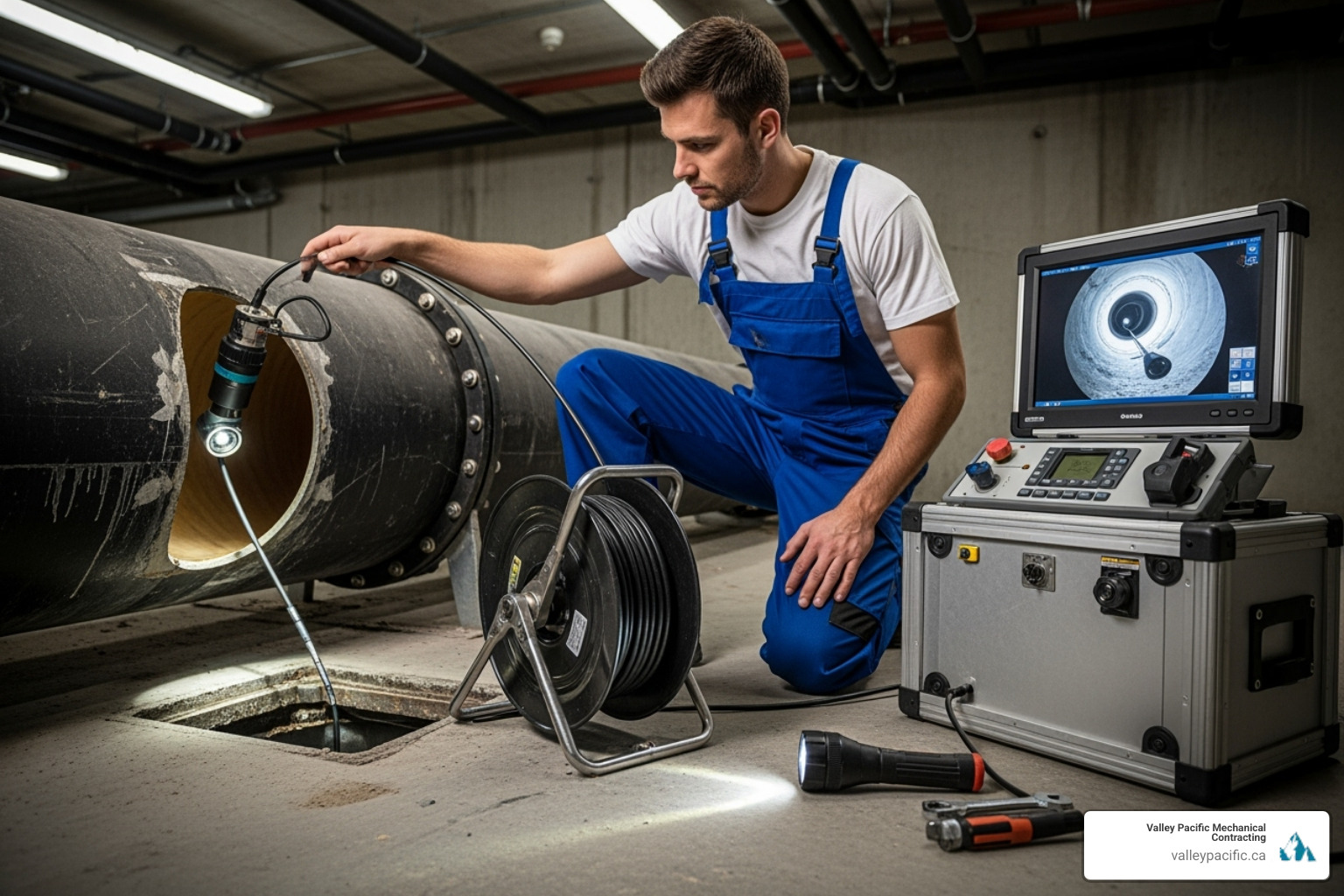
Advanced Diagnostic Tools: Camera Inspection
Remember when plumbers had to guess where a clog was hiding? Those days are long gone, thankfully. Today's camera inspection technology lets us actually see inside your pipes, which changes everything.
We insert a small, high-resolution waterproof camera attached to a flexible cable directly into your drain line. As our technicians guide it through your plumbing system, we get a real-time view of exactly what's happening in there. It's like giving your pipes a medical exam, and the results are immediately visible on our monitor.
Pinpointing blockages becomes incredibly precise this way. Instead of guessing that there's probably grease buildup somewhere in the kitchen line, we can see the exact location of that greasy mass, identify how severe it is, and determine the best way to remove it. Whether it's a stubborn FOG accumulation, a foreign object that shouldn't be there, or tree roots that have pushed their way in, the camera shows us everything.
But the real value goes beyond just finding clogs. Assessing your pipe condition is equally important, especially in older commercial buildings. The camera reveals cracks, corrosion, misaligned joints, and sagging sections that might be contributing to your drainage problems. This is information you simply can't get any other way without tearing up your floors or digging up your parking lot.
Identifying root intrusion is another area where camera inspection proves invaluable. Tree roots are sneaky—they find the tiniest crack or loose joint and exploit it, growing into dense tangles that trap waste and eventually block the entire line. The camera shows us exactly where roots have invaded and how extensive the problem is, so we can plan the most effective removal strategy.
After we've cleaned your drains, we don't just pack up and leave. We run the camera through again to verify that the cleaning was effective. This post-service inspection confirms that the blockage is completely gone, the pipes are thoroughly clean, and water is flowing freely again. It's quality assurance you can actually see.
Perhaps best of all, camera inspection prevents unnecessary digging. By accurately diagnosing issues without excavation, we save you significant time, money, and disruption to your business operations. It's a non-invasive way to get definitive answers about your plumbing system.
Our Sewer Line Inspection services rely heavily on this technology because it provides the clarity and precision that guesswork simply cannot match.
Powerful Cleaning Methods
Once we know exactly what we're dealing with, we choose the right tool for the job. Commercial clogs vary widely in their nature and severity, so our cleaning methods need to match the specific situation.
Drain snaking, also called augering, is our go-to method for many standard blockages. We feed a flexible metal cable with a specialized cutting head into the drain line. As the cable rotates, the cutting head breaks through the clog, clearing a path for water to flow. This method works beautifully for stubborn clogs caused by food debris, paper products, and minor root intrusions. It's effective, relatively gentle on pipes, and often the perfect solution for localized blockages.
Hydro-jetting is where we bring out the heavy artillery. This method uses high-pressure water—we're talking thousands of PSI—blasted through a specialized nozzle that's inserted into your drain line. The pressurized water doesn't just punch through blockages; it completely scours the interior walls of your pipes, removing years of accumulated grease, mineral deposits, and debris. It's like giving your pipes a power wash from the inside.
Hydro-jetting excels at descaling pipes that have significant mineral buildup or hardened grease deposits. The high-pressure water strips away these stubborn accumulations, restoring your pipes to nearly their original diameter. This thorough cleaning means your drains stay clear longer, reducing the frequency of future maintenance.
Here's how these two methods compare:
| Feature | Drain Snaking (Augering) | Hydro-Jetting |
|---|---|---|
| Best For | Localized clogs, foreign objects, minor root intrusion | Severe blockages, FOG buildup, mineral scaling, thorough pipe cleaning |
| Cleaning Power | Breaks through and removes immediate blockage | Completely scours pipe walls, removes all accumulated debris |
| Pipe Compatibility | Safe for most pipe types and conditions | Requires professional assessment; may not suit severely damaged or very old pipes |
| Preventative Value | Addresses current problem | Provides deep cleaning that extends time between services |
| Speed | Quick for straightforward clogs | Takes longer but provides more comprehensive results |
The right choice depends on what the camera inspection reveals about your specific situation. Sometimes drain snaking is all you need. Other times, especially for commercial kitchens with persistent grease issues, hydro-jetting provides the thorough cleaning that prevents recurring problems.
What to Expect from Commercial Drain Cleaning Services
When you call us for drain cleaning services, we follow a systematic approach that ensures nothing gets overlooked and the job gets done right.
Everything begins with an initial assessment. Our technician arrives and discusses the symptoms you've been experiencing—slow drains, backups, foul odors, or whatever brought us to your door. We'll ask about the history of the problem, what you've already tried, and how your facility uses its plumbing system. This conversation helps us understand the context before we even look at the pipes.
Next comes method selection, guided by our diagnostic tools. After running a camera inspection (when appropriate), we have a clear picture of what's causing your drainage issues. Based on what we find—whether it's a simple clog, extensive grease buildup, root intrusion, or pipe damage—we recommend the most effective cleaning method. We explain our reasoning and make sure you understand what we're about to do and why.
The thorough cleaning phase is where the real work happens. Whether we're using drain snaking to break through a stubborn blockage or hydro-jetting to completely clean your lines, we take the time to do it properly. We don't rush the job or leave problems partially resolved. Our goal is to restore your drains to full functionality.
After cleaning, we conduct a post-service inspection. This typically involves another camera pass through the cleaned pipes to verify that the blockage is completely removed and the pipes are in good condition. You get to see the before-and-after comparison, which provides reassuring proof that your investment delivered real results.
Finally, we provide maintenance recommendations custom to your specific facility. Based on what we found during the inspection and cleaning, we'll suggest a preventative maintenance schedule that makes sense for your business. A busy restaurant will have different needs than an office building, and we adjust our recommendations accordingly. We might also suggest improvements to your current practices—like grease trap maintenance frequency or employee training on what shouldn't go down drains—that can help prevent future issues.
This comprehensive approach is what separates professional drain cleaning services from quick fixes that leave underlying problems unaddressed. We're here to solve your drainage issues for the long term, not just until our truck pulls away.
The Unsung Hero of Your Heating System
Boiler flue repair is essential for safely expelling dangerous combustion gases like carbon monoxide from your home. While some visual checks are safe for homeowners, actual repairs must be performed by licensed gas fitters to ensure safety and code compliance.
Key things to know:
- What it is: A pipe system that removes exhaust gases (CO₂, water vapour, carbon monoxide) from your boiler to the outside
- Warning signs: Soot marks, condensation, damaged pipes, blockages, pilot light issues, or unusual noises
- DIY limit: You can visually inspect and clear exterior debris only—all repairs require a professional
- Safety critical: A faulty flue can allow carbon monoxide to leak into your home
- Inspection frequency: Annual professional inspection as part of your boiler heating system maintenance
Most homeowners rarely think about their boiler flue until something goes wrong. Yet this seemingly simple pipe plays a life-saving role in your home's safety. Every time your boiler fires up, it burns fuel to create heat—a process that produces carbon dioxide, water vapour, and potentially deadly carbon monoxide.
The flue's job is to safely escort these combustion byproducts outside your home. When it works properly, you never notice it. When it doesn't, the consequences can be severe, from boiler breakdowns to serious health hazards.
Understanding when you can safely inspect your flue yourself—and when you absolutely need a professional—can save you money, protect your family, and keep your heating system running efficiently. This guide will help you steer that crucial distinction.
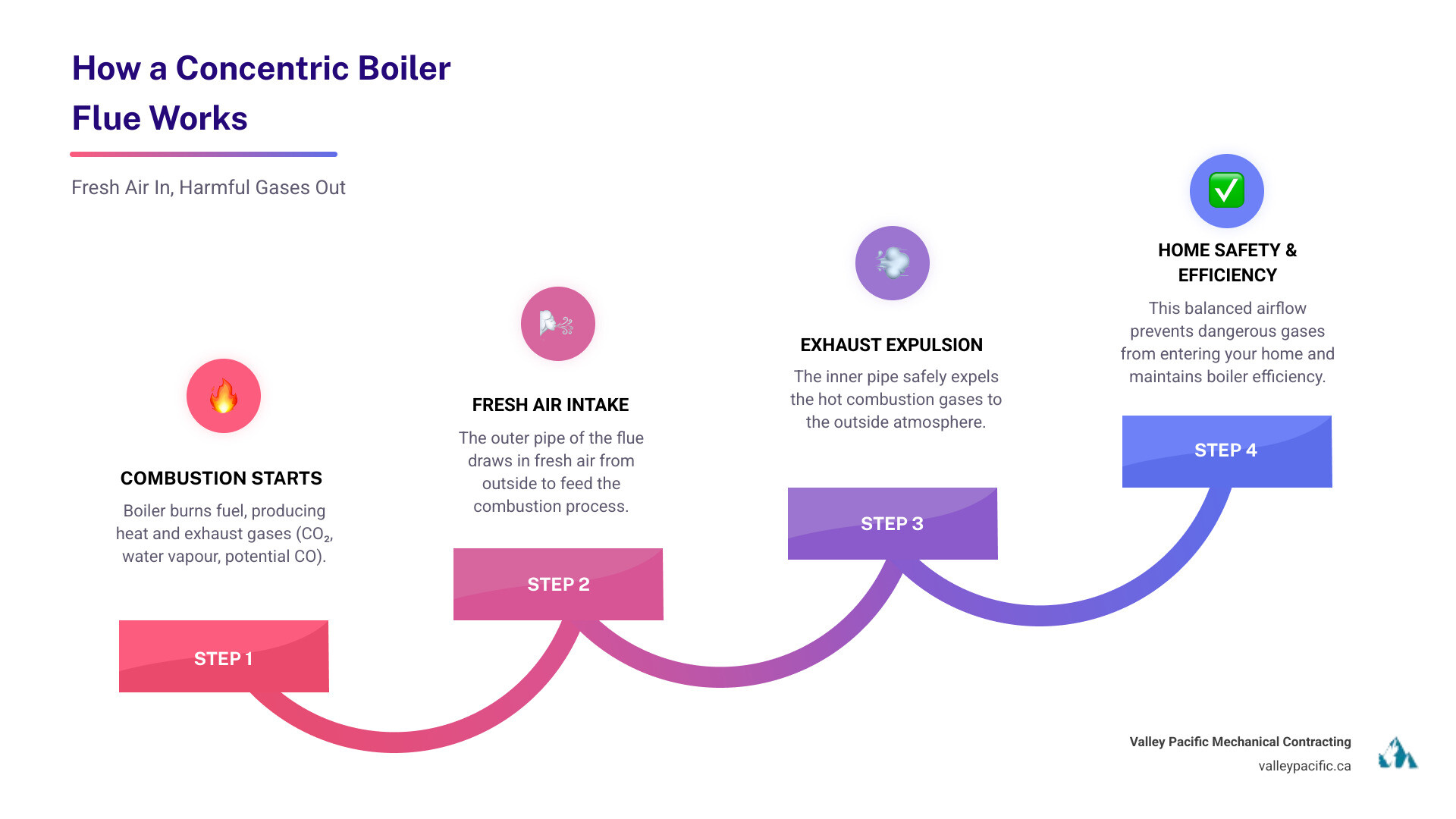
Key terms for Boiler flue repair:
Identifying Flue Problems: Telltale Signs of Trouble
Your boiler flue is designed to work silently in the background, faithfully venting combustion gases without fanfare. When everything's running smoothly, you'll never give it a second thought. But when problems develop, your heating system has ways of letting you know—sometimes subtly, sometimes not so subtly.
The key is knowing what to look for. Catching these warning signs early can prevent a minor inconvenience from becoming a serious safety hazard, especially when it comes to carbon monoxide exposure.
A healthy flue operates quietly and efficiently. When something goes wrong, you'll typically notice changes around your boiler or along the flue system itself. During your routine visual checks, keep your eyes open for these telltale signs.
Soot or black marks around the boiler casing or where the flue connects to your wall or ceiling are serious red flags. These dark stains mean combustion gases aren't being properly expelled—they're leaking into your home instead. This isn't something to ignore or put off until next week. It requires immediate professional attention.
Condensation or drips around the flue pipe deserve a closer look. Yes, modern condensing boilers naturally produce moisture, but that condensate should drain away through a separate pipe. If you're seeing excessive moisture, puddles, or dripping directly from the flue, you've likely got a leak. The acidic nature of this condensation can eat away at metal components over time, causing further damage. If you're dealing with unexpected water issues, our article on boiler leaking water can help you understand what might be happening.
Take a moment to inspect any accessible sections of the flue pipe for physical damage. Look for cracks, corrosion, dents, or sections that seem loose or disconnected. Even minor damage can compromise the entire system's integrity, creating pathways for dangerous gases to escape into your living space.
The external terminal where your flue exits your home is particularly vulnerable to blockages from debris. Leaves, twigs, and bird nests can accumulate there, especially after storms or during fall. We've even seen ambitious birds build entire nests inside terminals during spring! A blocked terminal prevents proper ventilation and can force combustion gases back into your home.
If your boiler has a pilot light, pay attention to its behavior. Does it frequently go out? Is the flame weak or yellow instead of strong and blue? These symptoms often point to ventilation problems related to the flue. A compromised flue restricts the oxygen supply needed for complete combustion, directly affecting your pilot light's performance. Our guide on boiler pilot light issues explores this connection in more detail.
Unusual noises coming from your boiler—banging, whistling, or gurgling sounds that weren't there before—can also indicate flue problems. A blocked flue creates pressure imbalances that affect your boiler's operation, sometimes producing these strange sounds.
Common Signs You Need Boiler Flue Repair
Beyond these general warning signs, certain specific indicators almost always mean your flue needs professional attention. Ignoring them won't just affect your heating efficiency or increase your energy bills—it could create a genuinely dangerous situation in your home.
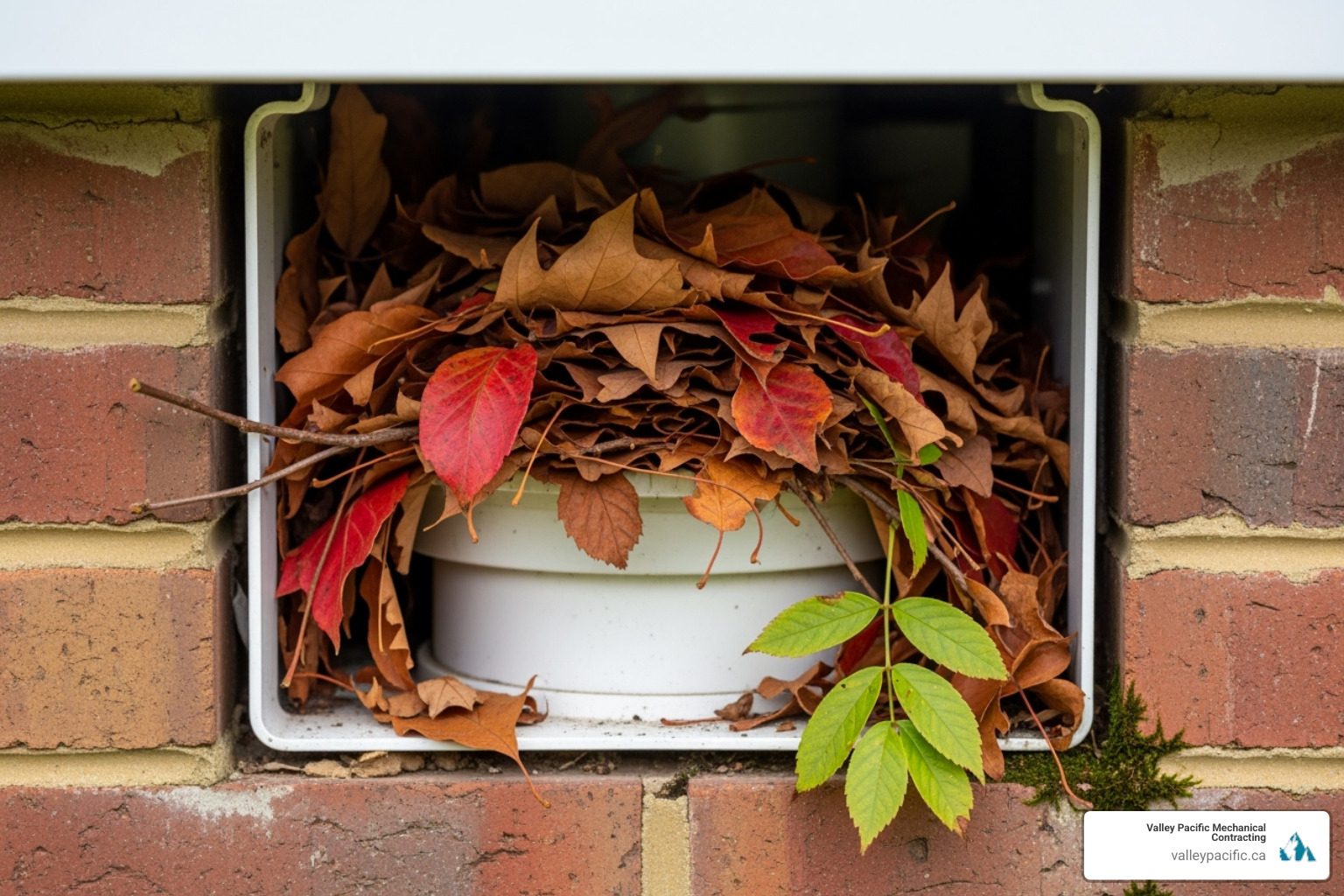
White, powdery stains around flue connection points—often called oxidization—are telltale signs of leaking acidic condensate. When this corrosive moisture escapes and reacts with surrounding materials, it leaves these distinctive white marks behind.
Physical damage to the flue pipe itself demands immediate action. Cracks, holes, or significant corrosion compromise the flue's fundamental purpose: safely venting gases outside your home. These aren't cosmetic issues that can wait—they're structural failures that need addressing.
Loose fittings along the flue system might seem minor, but they matter more than you'd think. Missing screws, unsecured joints, or wobbly sections create potential leak points. Every component should be tightly fitted according to manufacturer specifications. While some homeowners debate whether every single screw is critical, we always recommend ensuring everything is properly secured—why take the risk?
Modern boilers are remarkably smart, and error codes are their way of communicating with you. If your boiler displays a fault code—especially one related to ventilation, combustion, or exhaust—don't ignore it. Check your manual, as these codes often point directly to flue issues that need professional diagnosis.
Finally, poor boiler performance can be your flue's way of crying for help. Is your home taking longer to heat up? Is your hot water not as hot as it used to be? A struggling flue leads to inefficient combustion, forcing your boiler to work overtime just to maintain comfortable temperatures. You might notice cold spots in your radiators or find yourself troubleshooting no hot water from boiler problems that seem to come out of nowhere.
When you spot any of these signs, it's time to call in the professionals for boiler flue repair. Your safety—and your family's—depends on it.
The Critical Dangers of a Faulty Flue
Let's talk about something that keeps us up at night: carbon monoxide. When your boiler flue isn't working properly, you're not just dealing with a broken heating system—you're facing a genuine threat to your family's safety.
Carbon monoxide (CO) is produced whenever your boiler burns fuel. It's a colourless and odourless gas, which means you can't see it, smell it, or taste it. There's absolutely no way to detect it with your senses alone. This invisible nature is precisely what makes it so dangerous.
When your boiler's flue is blocked, damaged, or improperly installed, the fuel doesn't burn completely. Instead of clean combustion, you get incomplete combustion that produces excess carbon monoxide. And when that CO can't escape through the flue as designed, it has nowhere to go but back into your living space.
The symptoms of CO poisoning often masquerade as common ailments—headaches, dizziness, nausea, weakness, fatigue, confusion, or chest pain. Many people mistake these warning signs for the flu or food poisoning. That's the terrifying part: you might not realize what's happening until it's too late.
A faulty flue creates a perfect storm for boiler malfunction. Without proper ventilation, your boiler can't draw in the fresh air it needs for clean, efficient combustion. The result? More carbon monoxide production, reduced efficiency, and dangerous gases accumulating in your home instead of being safely expelled outside.
This is why we're absolutely adamant about the importance of CO alarms in your home. Install them near your boiler and in sleeping areas. These devices are your first line of defense against this silent threat. And if you ever suspect a gas leak or carbon monoxide presence, follow emergency advice from authorities like the National Grid or your local gas provider. Don't take chances—evacuate and call for help immediately.
Why a Blocked Boiler Flue is a Silent Threat
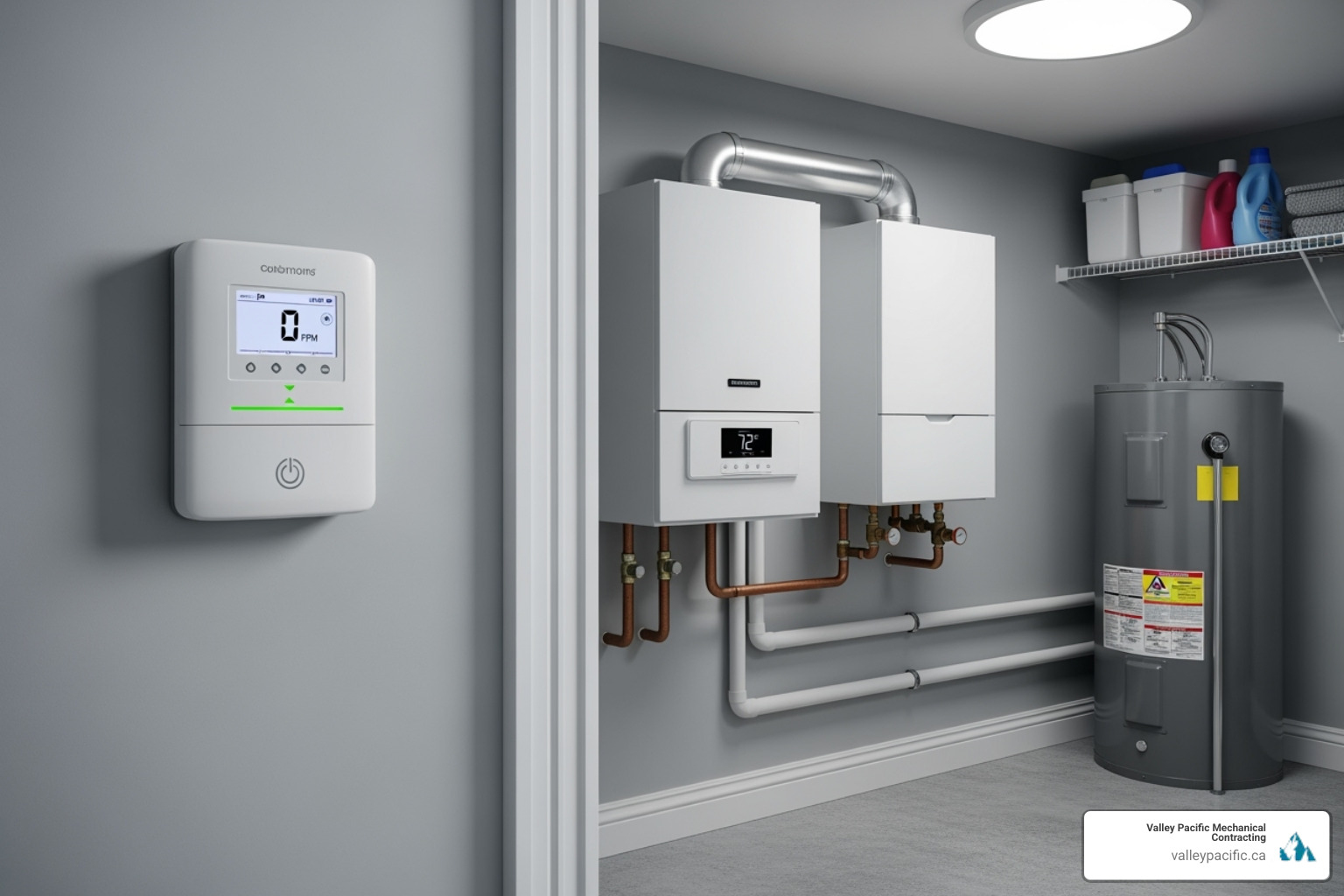
A blocked flue doesn't announce itself with flashing lights or alarm bells. It quietly and methodically puts everyone in your home at risk. Understanding why makes the threat real and emphasizes why boiler flue repair is never something to postpone.
When your flue becomes blocked—whether from debris, a bird's nest, or damage—the combustion gases have nowhere to go. Instead of flowing safely outside, they experience what we call gas backdraft. The exhaust reverses course and flows back into your home, bringing carbon monoxide and other toxic byproducts with it.
At the same time, that blockage creates oxygen starvation inside your boiler's combustion chamber. Your boiler needs a constant supply of fresh air to burn fuel cleanly. Cut off that oxygen supply, and the entire combustion process suffers.
This oxygen deficit leads directly to incomplete combustion—the primary culprit behind carbon monoxide production. A boiler that can't breathe properly becomes a CO factory, turning what might have started as a minor blockage into a life-threatening situation.
The risk to occupants is what drives our urgency around these issues. Because carbon monoxide gives you no sensory warnings, a blocked flue can silently fill your home with deadly gas while you sleep, watch TV, or go about your daily routine. You simply won't know until symptoms appear—or until your CO detector sounds.
If your carbon monoxide alarm goes off, or if you notice any warning signs we've discussed, take immediate action. Turn off your heating system right away. Open every window and door to ventilate your home thoroughly. Get everyone out—family members and pets included. Then call emergency services and your gas provider from a safe location outside.
Never re-enter your home until emergency personnel have declared it safe. This isn't the time for second-guessing or "just checking" if things are okay. When it comes to carbon monoxide, caution isn't just wise—it's essential.
We're here around the clock for situations like these, providing expert Boiler Repair Coquitlam and emergency service throughout the Lower Mainland. Your safety is always our top priority.
DIY vs. Professional Boiler Flue Repair: What You Need to Know
Let's be honest—there's something deeply satisfying about fixing things around your home yourself. Maybe it's the sense of accomplishment, maybe it's saving a few dollars, or maybe you just enjoy the challenge. We get it. But when it comes to boiler flue repair, we need to have a frank conversation about where that DIY spirit needs to stop.
This isn't us being precious about our profession. It's about keeping you and your family safe. The combustion gases flowing through your flue include carbon monoxide—a substance that doesn't give second chances. That's why actual repairs to your boiler flue system must always, without exception, be performed by licensed professionals. Not "handy people who've done it before," not "my neighbour who used to work in construction"—we're talking about certified gas fitters who are legally authorized to do this work.
The Limits of DIY: What Homeowners Can (and Can't) Do
That said, you're not completely powerless. There are several important tasks you can—and should—handle yourself to help keep your heating system healthy and catch problems early.
Visual checks for blockages are perfectly safe when done from the ground. Every few weeks, especially after storms or during autumn when leaves are falling, take a moment to look at your flue terminal. You're checking for obvious obstructions—leaves, dirt, spider webs, or anything else that shouldn't be there.
If you can safely reach the terminal without climbing ladders or putting yourself at risk, clearing debris from the terminal exterior is fine. We're talking about gently removing visible debris from the outside opening only. Think of it like clearing leaves from a gutter downspout—simple, external maintenance.
Checking your CO alarm batteries might be the most important task on this list. Test your carbon monoxide detector regularly by pressing that little test button, and replace batteries the moment you hear that annoying low-battery chirp. This device is literally your family's early warning system.
You can also help by keeping the area around your flue clear. Make sure shrubs or trees aren't growing too close to the terminal outside, and keep the space around your boiler inside free from clutter. Your technician will thank you when they come for service.
Now, here's where you stop. The moment you notice damage to the flue pipe itself, suspect an internal problem, see soot marks or white staining, or if your CO alarm sounds—step back and call a professional. This isn't about questioning your abilities. It's about recognizing that gas work is governed by strict legal and safety boundaries for very good reasons.
In British Columbia, all gas work—including boiler flue repair—must be performed by someone licensed through Technical Safety BC. Attempting to repair a gas flue yourself isn't just dangerous; it's illegal. It can void your home insurance, invalidate your boiler warranty, and most importantly, put lives at risk through improper combustion or gas leaks.
The Professional Approach to Boiler Flue Repair
When you call us for boiler flue repair, you're getting more than just someone with tools and experience. You're getting a systematic, safety-first approach backed by certification and specialized equipment.
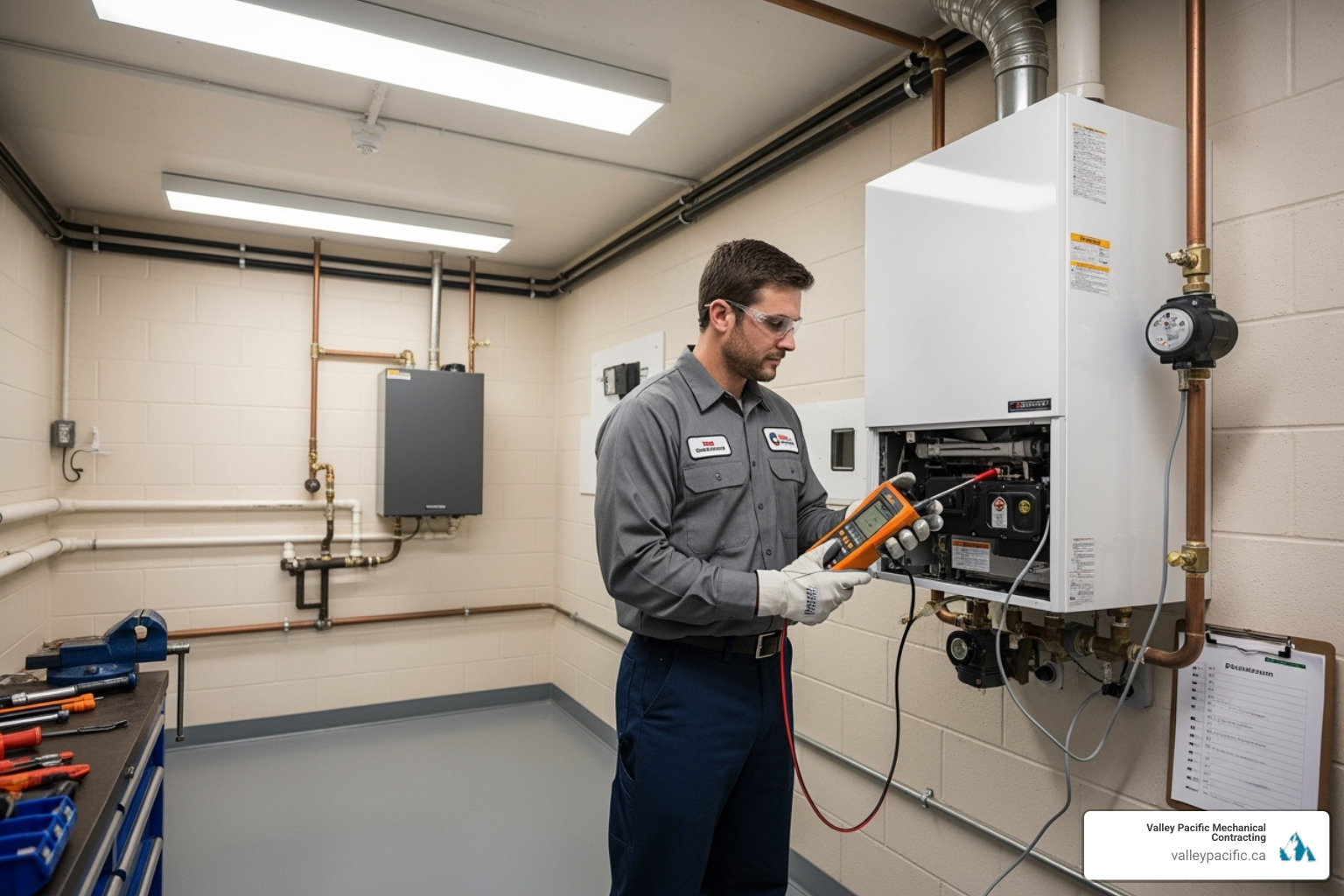
Our team consists of licensed gas fitters certified by Technical Safety BC. This isn't just a piece of paper on the wall—it represents rigorous training and ongoing education in the latest safety standards and techniques. These professionals have the knowledge and legal authorization to work on your gas appliances safely.
One of the key differences between professional and amateur work is the use of diagnostic tools. We don't just eyeball your flue and make our best guess. Our technicians use flue gas analysers that measure exactly what's coming out of your system. These sophisticated devices detect inefficient combustion, carbon monoxide presence, and other invisible problems that could compromise your safety. It's like having X-ray vision for your heating system.
Ensuring code compliance is another critical piece of the puzzle. Building codes exist for a reason—they're written in response to decades of real-world experience, sometimes learned the hard way. Our technicians know these regulations inside and out, from proper clearances to approved materials to correct securing methods. When we complete a job, you can be confident it meets every safety standard.
When we assess your flue, we're making an important decision: repair or replacement. Sometimes a targeted repair is the right call—perhaps resealing a joint or replacing a damaged section. Other times, especially with older flues that don't meet current codes or have extensive damage, replacement is the safer and more cost-effective long-term solution. We'll always explain our reasoning and help you understand your options. If you do need a new system, our Professional Boiler Replacement Process takes the stress out of the transition.
Finally, we can't emphasize enough the value of an annual boiler service. Think of it as a check-up for your heating system. During this service, we inspect your entire boiler and flue system, checking for wear and tear, blockages, leaks, and early warning signs of future problems. Catching issues before they become emergencies saves you money and keeps your family safe. If you're in our service area, check out our Boiler Repair Langley Guide for more information about what we offer locally.
Understanding Flue Types and Regulations
When it comes to boiler flue repair, one size definitely doesn't fit all. The flue system connected to your boiler isn't just a generic pipe—it's a carefully engineered component designed to work with your specific heating system. Understanding these differences can help you appreciate why professional expertise is so crucial when repairs are needed.
Your boiler and its flue are essentially a matched pair. You can't simply swap flue components between different boiler models or manufacturers and expect things to work safely. Each boiler's combustion system has unique requirements for how much air it needs to draw in and how efficiently it must expel exhaust gases. The flue is designed to meet those exact specifications.
One of the biggest distinctions in the boiler world is between condensing and non-condensing boilers. If you have a modern condensing boiler (and most homes do these days), it's designed to squeeze every bit of heat possible from the combustion process. This efficiency comes with a trade-off: the exhaust gases cool down so much that they produce acidic condensate—basically, acidic water that drips out during operation.
This means condensing boiler flues must be made from corrosion-resistant materials like plastic (PVC or polypropylene) or stainless steel. They also need a proper drainage system to handle that condensate. Older non-condensing boilers, on the other hand, run much hotter and don't produce this condensate, so their flues are typically made from different materials and have simpler designs.
Every boiler manufacturer provides detailed specifications for their flue systems, and these aren't just suggestions—they're requirements. Following manufacturer specifications ensures your boiler operates safely, efficiently, and within warranty terms. Our certified technicians always consult these guidelines when performing any boiler flue repair work.
Beyond manufacturer requirements, all flue installations and repairs must comply with local building codes. Here in British Columbia, these codes are quite specific about everything from flue materials and diameter to how long the flue can be, how many bends it can have, and how far it must be from windows, doors, property lines, and combustible materials. These regulations exist for one reason: your safety.
When you're preparing your home for a new boiler, understanding these requirements from the start makes the installation process much smoother.
Flue Configurations and Materials
The type of flue your home needs depends on several factors: your boiler model, where it's located, and the layout of your home. Let's look at the main configurations you'll encounter:
Horizontal flues are by far the most common, especially with modern condensing boilers. These run directly from your boiler through an exterior wall, expelling exhaust gases horizontally. They're straightforward to install when your boiler is positioned on an outside wall, and they're typically the most cost-effective option.
Vertical flues take a different route—straight up through your roof. You'll often see these in homes where the boiler is located in an interior room or where a horizontal flue isn't practical. Vertical flues require special weathering slates or flashing where they penetrate the roof to prevent water infiltration. Proper sealing is critical here, as roof penetrations are always potential weak points for leaks.
Concentric flues are clever pieces of engineering—they're essentially a pipe within a pipe. The inner pipe expels exhaust gases while the outer pipe draws in fresh air for combustion. This design is particularly useful for room-sealed boilers that don't draw air from inside your home. You'll recognize these by their distinctive double-ring appearance at the terminal.
Twin flues use two separate pipes running side by side—one for air intake and one for exhaust. While they serve the same function as concentric flues, they're used in situations where a concentric design won't fit or isn't suitable for the installation.
If you have an older home, you might still have a square metal flue rather than the round plastic or stainless steel flues common today. These older flues were standard with non-condensing boilers and are often made from aluminum or galvanized steel. While they can still be safe if properly maintained, they're not suitable for modern condensing boilers.
The material your flue is made from matters tremendously. Modern condensing boiler flues are typically white or gray plastic (PVC or polypropylene) because these materials resist the acidic condensate. High-efficiency systems might use stainless steel, especially for longer flue runs. Older systems used aluminum or galvanized steel, which work fine for high-temperature exhaust but would corrode quickly with acidic condensate.
Whether you need boiler installation in Maple Ridge BC or anywhere else in the Lower Mainland, our team ensures your flue configuration meets all manufacturer specifications and local codes. We've seen countless homes with different layouts and challenges, and we know how to design a safe, compliant flue system for any situation.
Your Guide to Boiler Health in Vancouver
Boiler repair vancouver bc is essential when your heating system starts showing signs of trouble—and knowing when to call for help can save you from a cold house and expensive emergency repairs.
Quick Action Guide for Boiler Issues:
- No heat or hot water → Check thermostat and pressure, then call a technician
- Strange noises (banging, whistling, gurgling) → Likely air in system or sediment buildup
- Water leaking → Turn off boiler and call immediately
- Gas smell or yellow pilot light → Evacuate and call gas company + technician
- Low pressure gauge → May need simple refill or indicate a leak
- Uneven heating → Could be air in radiators or pump failure
If you've lived in an older Vancouver home, you might have a fondness for the cozy warmth that comes from a cast-iron radiator. As one local heating expert puts it, that heat is "less dry, less dusty and more comfortable than heat from a forced air system." That's the beauty of hydronic heating—your boiler heats water, and that warmth radiates through your home via pipes and radiators or baseboard heaters.
But when your boiler breaks down, that comfort disappears fast. And in Vancouver's damp, chilly climate, a malfunctioning boiler isn't just inconvenient—it can make your home downright uncomfortable.
Boilers are remarkably reliable systems. With proper maintenance, they can last 15-20 years or more. But they do require attention. Most breakdowns happen because of lack of regular maintenance, according to industry experts. Whether you're dealing with strange noises, pressure issues, or a complete loss of heat, understanding the basics of your boiler system helps you recognize problems early.
This guide covers everything Vancouver homeowners need to know about boiler repair—from recognizing warning signs to understanding when repair makes sense versus replacement, and how to choose the right professional to keep your system running smoothly.
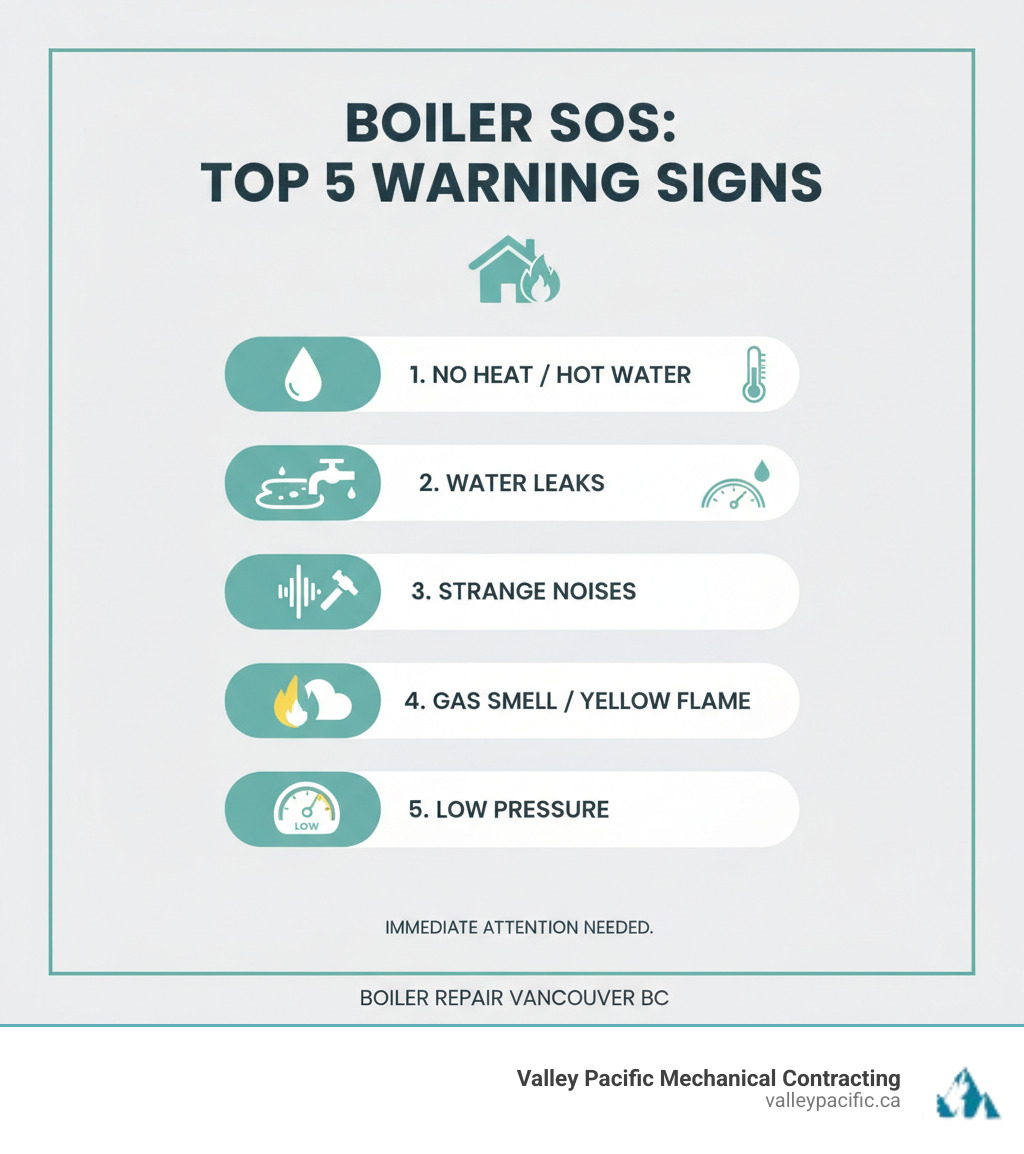
Quick boiler repair vancouver bc terms:
Recognizing When Your Boiler Needs Repair
Here's the truth about living in Vancouver: our winters might not be brutal by Canadian standards, but those damp, chilly months mean your heating system works overtime. When your boiler starts acting up, you'll know it—and fast.
The good news? Most boiler problems give you warning signs before they turn into full-blown emergencies. Paying attention to these signals and scheduling seasonal maintenance can save you from waking up to a freezing house on the coldest morning of the year.
Common Signs of Boiler Trouble
Your boiler talks to you. Sometimes it whispers, sometimes it shouts, but it's always communicating. The trick is learning its language.
No heat or hot water is the most obvious cry for help. You turn on the tap expecting warmth, or you wait for your radiators to kick in, and... nothing. While this could be something simple like a thermostat that needs adjusting, it often means your boiler has a more serious issue that needs professional eyes. Our guide on Troubleshooting No Hot Water From Boiler walks you through the common culprits.
Water pooling around your boiler never means anything good. Whether it's a failing pressure relief valve, corroded pipes, or a pump that's seen better days, a leak demands immediate attention. Water damage spreads fast, and what starts as a small puddle can quickly become a major repair bill. Check out Boiler Leaking Water for more details on what causes leaks and how they're fixed.
Strange noises are your boiler's way of saying "something's wrong in here." A healthy boiler runs quietly in the background. But when you start hearing kettling (a whistling sound like a kettle boiling), gurgling (like water moving through air pockets), or banging (which can sound downright alarming), your system is struggling. Kettling usually means limescale or sediment has built up on the heat exchanger. Gurgling often points to air trapped in the system. Banging might indicate issues with your pump or expansion tank.
Low boiler pressure shows up on that little gauge on your boiler—the one most of us ignore until something goes wrong. Your pressure should sit between 1 and 2 bar. If it keeps dropping below that range, you've either got a leak somewhere, a faulty pressure relief valve, or your system needs repressurizing. Pressure that drops frequently isn't something to brush off. We explain the causes and fixes in our article on Boiler Pressure Issues.
If you have an older boiler with a pilot light, watch that flame. It should burn strong and blue. When it goes out frequently, or burns yellow instead of blue, you've got a problem. A yellow flame means incomplete combustion—and that can produce dangerous carbon monoxide. Our Boiler Pilot Light guide covers what to do when your pilot won't stay lit.
You might also notice radiators that heat unevenly—some hot, some cold—or a boiler that cycles on and off randomly. These quirks point to inefficiencies that make your system work harder than it should, wasting energy and shortening your boiler's lifespan.
Vancouver's climate means your boiler runs for months on end during the rainy season. Regular proactive checks help you catch small issues before they become big ones. That's where boiler repair vancouver bc professionals make all the difference—they know what to look for and can spot problems you might miss.
Emergency Signs: When to Call for Help Immediately
Some boiler problems can wait until morning. Others can't wait five minutes. Knowing the difference could literally save lives.
A gas smell—that distinctive rotten egg odor—is the ultimate red flag. Natural gas companies add that smell specifically so you'll notice a leak. If you smell it, don't touch any light switches or create any sparks. Open windows and doors if you can do so safely, get everyone out of the house, and call your gas provider and a certified technician once you're at a safe distance.
Your carbon monoxide detector going off means evacuate now, ask questions later. Carbon monoxide is invisible, odorless, and deadly. It's produced when fuel doesn't burn completely, which can happen with a malfunctioning boiler. Get everyone outside immediately and call 911 from a safe location.
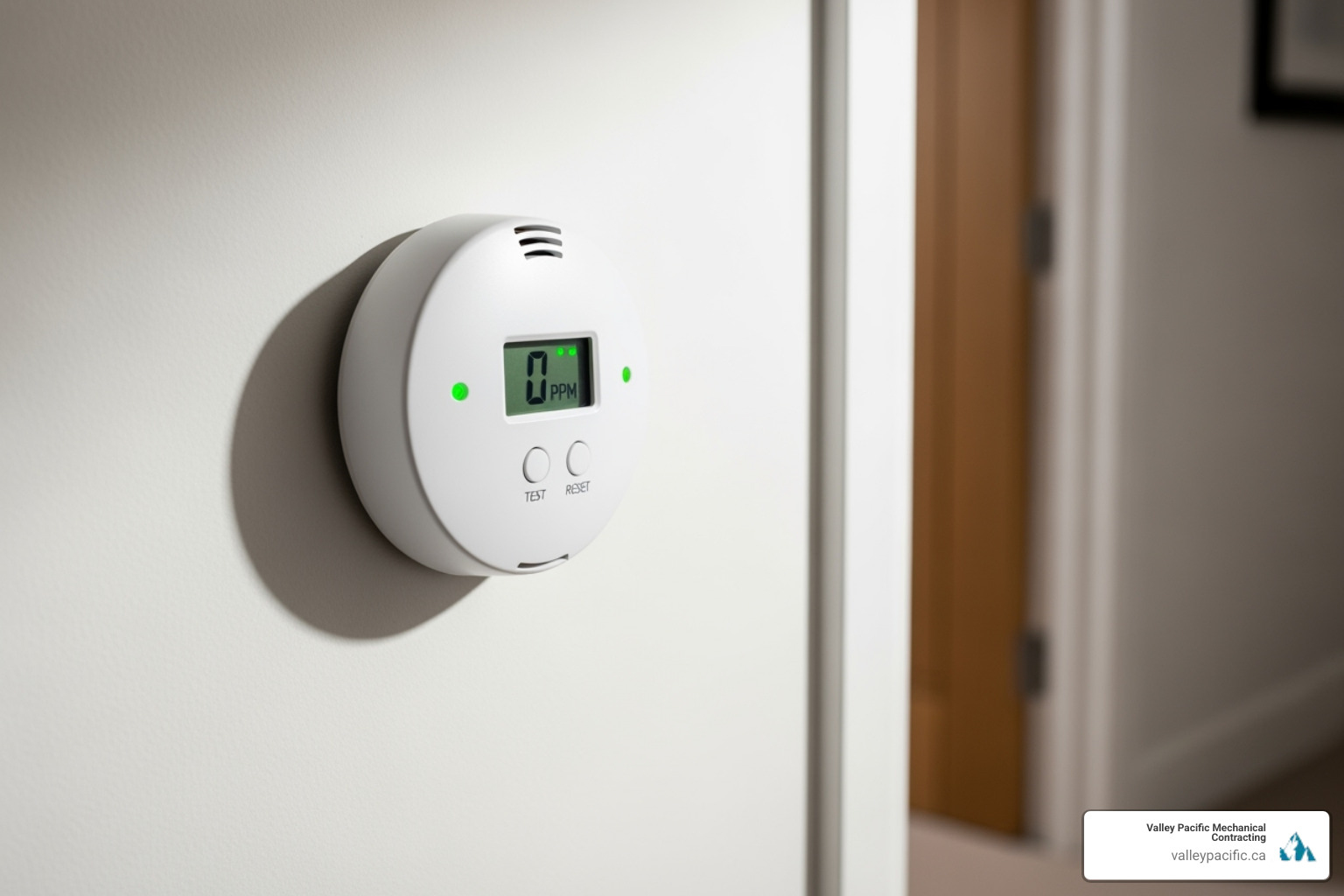
Soot or black stains around your boiler tell you combustion isn't happening properly. You might see dark marks on the boiler casing or on the wall behind it. This is another sign of potential carbon monoxide production and needs immediate professional attention.
A yellow or orange pilot light flame instead of a strong blue one also signals incomplete combustion. Blue means everything's working as it should. Yellow means carbon monoxide could be building up in your home.
These aren't situations for DIY troubleshooting. When you need emergency boiler repair vancouver bc service, Valley Pacific Mechanical's 24/7 availability means help is just a phone call away, day or night.
Understanding Boiler Systems and Common Breakdowns
There's something almost magical about how a boiler transforms cold water into the cozy warmth that fills your home on a rainy Vancouver evening. Unlike furnaces that blow heated air through ducts, boilers create what's known as hydronic heating—they heat water and send it circulating through pipes to radiators, baseboards, or even under your floors.
This "wet heat" feels different than forced air. It's gentler, more even, and doesn't leave you feeling parched. Instead of hot air blasting and then cooling down, radiant heat from a boiler wraps around you consistently. That's why so many Vancouver homeowners who've lived with both systems swear by their boilers. If you're curious about the technical details of how these systems work, our comprehensive guide on Boiler Heating System breaks it all down.
At Valley Pacific Mechanical, we've worked with just about every boiler type and brand you can imagine. Whether you have a sleek modern Viessmann, a reliable Navien, a time-tested Weil McLain, or systems from manufacturers like Super Hot, Slant Fin, Laars, and Burnham, our technicians know these machines inside and out. Each brand has its quirks, and we've seen them all.
Key Causes of Boiler Breakdowns in Vancouver
Even the most reliable boiler can run into trouble. Understanding what typically goes wrong helps you catch problems early—and maybe even prevent them altogether.
Lack of regular maintenance sits at the top of the list. It's not particularly exciting to schedule a boiler tune-up when everything seems fine, but neglecting this simple step is the single biggest reason boilers fail. Sediment quietly builds up, small leaks go unnoticed, and components gradually wear down until something finally gives out. Industry experts consistently point to skipped maintenance as the primary culprit behind breakdowns.
Age catches up with every boiler eventually. After 15-20 years of faithful service, pumps start to struggle, valves don't seal quite as well, and heat exchangers develop stress fractures. If your boiler is approaching this age and needs frequent repairs, it might be telling you something.
Thermostat problems can be surprisingly deceptive. Your boiler might be working perfectly, but if the thermostat isn't reading temperatures correctly or communicating properly with the system, you'll end up cold and frustrated—blaming a boiler that's just waiting for proper instructions.
When the circulating pump fails, hot water sits in the boiler instead of traveling through your home. The boiler heats the water just fine, but without that pump pushing it through the pipes, the warmth never reaches your radiators.
Vancouver's damp, chilly weather creates a specific problem for modern high-efficiency boilers: blocked condensate pipes. These boilers produce acidic water that needs to drain away, but when temperatures drop, that drainage pipe can freeze solid. The boiler detects the blockage and shuts down as a safety measure.
Air trapped in the system creates those unsettling gurgling sounds and leaves you with radiators that are hot at the bottom but cold at the top. Sometimes bleeding the radiators helps, but persistent air issues usually indicate a deeper problem that needs professional attention.
Our hard water in Vancouver contributes to another common issue: sediment and mineral buildup. Over time, these deposits accumulate inside the boiler and throughout your pipes, reducing efficiency and putting stress on components. Think of it like plaque in arteries—it restricts flow and makes everything work harder. Regular flushing helps, but once scaling becomes severe, it can cause permanent damage.
Boilers vs. Forced-Air Furnaces
If you're weighing your heating options, or just curious why your neighbor raves about their boiler while you have a furnace, understanding the real differences helps.
| Feature | Boiler Systems | Forced-Air Systems |
|---|---|---|
| Comfort | Consistent, radiant "wet heat" | Can feel drier, temperature fluctuations |
| Air Quality | Less dust, fewer allergens circulated | Circulates air, dust, and allergens |
| Efficiency | Can be highly efficient, especially modern condensing models | Efficiency varies, can lose heat through ducts |
| Installation Space | Modern units often compact, easier for condos | Requires ductwork, takes up more space |
| Noise Level | Generally quieter | Can be noisy due to fan and airflow |
The comfort difference between radiant heat from a boiler and forced air is something you feel rather than measure. Forced-air systems create temperature swings—blast of hot air, then cooling down, then another blast. Boilers maintain steady warmth that radiates from surfaces. Your skin doesn't dry out as much, and you don't get that slightly stuffy feeling.
For anyone dealing with allergies or respiratory sensitivities, this is huge. Forced-air systems constantly circulate whatever's floating around your house—dust, pet dander, pollen. Boilers don't blow air around, so they're not stirring up irritants every time the heat kicks on.
Modern boilers, especially condensing models, can be remarkably efficient. They don't lose heat through leaky ductwork because there is no ductwork. And unlike the older cast-iron behemoths that took up half a basement, today's units are surprisingly compact—perfect for Vancouver's condos and smaller homes where every square foot matters.
The quiet operation is another bonus. There's no fan whooshing, no air rushing through vents. Just gentle, silent warmth. If you've ever been woken up by your furnace kicking on at 3 AM, you'll appreciate the difference.
When you're dealing with boiler repair vancouver bc needs, understanding these fundamentals helps you make informed decisions about whether to repair or eventually upgrade your system.
The Importance of Professional Boiler Repair Vancouver BC
When your boiler starts acting up, the stakes are higher than you might think. This isn't like fixing a leaky faucet or replacing a light switch. We're talking about a complex system that heats water under pressure, often using combustible fuel, and keeps your entire home comfortable. That's why boiler repair vancouver bc needs to be handled by professionals who know exactly what they're doing.
Think of it this way: your boiler is working hard every day, quietly doing its job in your basement or utility room. But when something goes wrong, the consequences can range from an uncomfortable cold spell to genuine safety hazards. The good news? Working with certified technicians means you get the repair done right the first time, safely and reliably.
Why Choose a Certified Technician for boiler repair vancouver bc?

Here's what happens when you call in a certified professional for your boiler repair. First and foremost, you're getting someone who's certified by Technical Safety BC. This isn't just a nice credential to have on the wall—it means they've been rigorously trained and tested on safety protocols, local codes, and proper procedures. When you're dealing with natural gas or propane, this certification isn't optional. It's essential.
A certified technician brings the right expertise to properly diagnose what's actually wrong with your system. We've all heard stories of someone who replaced a part, only to have the same problem pop up a week later. That's usually because they treated the symptom instead of finding the root cause. Our technicians have seen hundreds of boilers over the years, and they know how to trace a problem back to its source.
They also show up with the proper tools and authentic parts needed to get the job done. There's nothing more frustrating than having a repair person visit, only to learn they need to order a part and come back another day. We maintain a comprehensive inventory so we can often complete repairs on the first visit, getting your heat back up and running quickly.
Then there's the matter of warranty protection. Most boiler manufacturers require professional service to keep your warranty valid. Try to repair it yourself or hire someone unqualified, and you might find yourself on the hook for expensive repairs down the road that would have been covered. Professional repairs typically come with guarantees on both parts and labor, giving you an extra layer of protection.
What we're really offering is long-term reliability and peace of mind. A properly repaired boiler runs more efficiently, costs less to operate, and is far less likely to break down again in the near future. With over 30 years of experience, we've built our reputation on providing that "headache-free" experience—fixing problems right so you can forget about them and just enjoy a warm home.
And because boiler emergencies don't respect business hours, we offer 24/7 emergency service availability. Whether it's a Tuesday afternoon or three in the morning on a Sunday, we're here to help when you need us most.
The Risks of DIY Boiler Repairs
We get it. There's a certain satisfaction in fixing things yourself, and maybe you're pretty handy around the house. But boilers are different. The risks aren't worth it.
Let's start with the most serious concern: gas leak dangers. If you have a natural gas or propane boiler and you don't know exactly what you're doing, you could create a situation that leads to fire or even an explosion. That's not an exaggeration—it's why gas work requires specific certification and training.
Then there's carbon monoxide risk. This silent killer is produced when combustion isn't happening properly. You can't see it, smell it, or taste it, but it can be fatal. Incorrect repairs or adjustments can turn your boiler into a carbon monoxide producer, putting everyone in your home at risk.
Even if you're not dealing with gas, there's potential for significant water damage. Boilers operate under pressure, and a small mistake can lead to leaks that damage floors, walls, and belongings. What started as an attempt to save money on a repair could end up costing thousands in property damage.
Here's something many people don't realize until it's too late: DIY repairs almost always void your manufacturer's warranty. That warranty you paid for when you bought or installed the boiler? Gone. Now if something major breaks, you're paying for it all out of pocket.
Perhaps the biggest risk is incorrect diagnosis. Without proper training and experience, you might think you know what's wrong, but you're actually fixing the wrong thing. Or worse, you might make adjustments that cause additional damage to other components. Industry experts consistently warn that using non-professionals can lead to poor performance and significant damage to your system.
The bottom line? When it comes to boiler repair vancouver bc, the professional route isn't just the smart choice—it's the safe choice. Your family's comfort and safety are worth far more than any potential savings from a DIY attempt.
Boiler Maintenance, Replacement, and High-Efficiency Upgrades
Think of your boiler like a car—regular tune-ups keep it running smoothly and catch small problems before they become big, expensive headaches. The truth is, regular maintenance is the single most effective way to extend your boiler's lifespan and prevent those middle-of-the-night emergency calls for boiler repair vancouver bc. We see it time and time again: homeowners who invest in annual service save themselves from costly breakdowns and enjoy consistent, reliable heat year after year. It's the same philosophy we bring to all our work, including HVAC Maintenance Langley.
But here's the reality—even the best-maintained boiler won't last forever. Eventually, you'll face that important decision: repair or replace? Understanding when your faithful heating companion has reached the end of its road can save you money and give you peace of mind.
Proactive Maintenance to Prevent Repairs
Here's a sobering fact: most boiler breakdowns happen because of neglected maintenance. Industry experts consistently point to this as the number one cause of system failures. That's why we recommend servicing your boiler every 12 months—ideally before the heating season kicks in—to ensure it's running efficiently and, most importantly, safely.
During our comprehensive maintenance visits, we're thorough. We start by inspecting your heat exchanger and burners, checking for sediment buildup, corrosion, and ensuring proper combustion. A clean combustion chamber is essential for both efficiency and safety. We also examine your flue system—the chimney and exhaust vents that carry combustion gases safely out of your home. A poorly maintained flue can lead to dangerous carbon monoxide buildup, which is why we take this step seriously.
Your boiler's safety controls get a complete workout during our visit. We test the thermostat, pressure relief valve, and other protective mechanisms to confirm they'll do their job when needed. We check your system's water pressure, too, because pressure that's consistently too low or too high can signal leaks or failing components. All electrical connections are examined and tightened to prevent faults, and for gas boilers, we carefully inspect the gas loop, control valve, and all connections for leaks while testing for carbon monoxide.
We're also looking for the subtle signs of trouble—leaking and rust anywhere in the system, checking the expansion vessel, regulators, and air vents to ensure they're maintaining system stability. One of the most beneficial services we provide is system flushing, which removes trapped air and reduces sediment buildup. This simple step improves heating efficiency and prevents corrosion. For older systems with significant sediment accumulation, we might recommend chemical cleaning to restore efficiency and give your boiler a new lease on life.
The benefits of annual service extend beyond just avoiding breakdowns. A well-maintained boiler consumes fuel more efficiently, which means it's not wasting energy—or your money—heating your home.
Is It Time for a Boiler Replacement?
Most boilers live productive lives of about 15 to 20 years. Some well-maintained units even push beyond that, but if yours is approaching this milestone and you're noticing frequent breakdowns or rising energy bills, it might be time for an honest conversation about replacement rather than another repair.
We understand this isn't an easy decision. But when you're calling for boiler repair vancouver bc multiple times a year, those repair costs add up quickly. Sometimes they can even exceed what you'd invest in a new, reliable system. An aging boiler also has to work harder to heat your home, consuming more fuel and driving up your utility costs month after month. And then there are safety concerns—older boilers can develop cracks or combustion issues that compromise your family's safety. For very old models, finding replacement parts becomes increasingly difficult and expensive, turning each repair into a treasure hunt.
When you're ready to explore replacement, several factors come into play. The size of your new boiler, measured in BTUs, needs to match your home's heating needs. Too small, and you'll never be quite warm enough. Too large, and it'll cycle on and off inefficiently, wasting energy and shortening its lifespan. You'll also want to think about how many heating zones you'd like—maybe you want different temperatures in different areas of your home—and whether your existing flue system needs updating. Proper boiler sizing is critical enough that experts universally recommend leaving it to professionals who can calculate your home's exact requirements.
Our Professional Boiler Replacement Process walks you through what to expect, and Preparing Your Home For A New Boiler offers practical considerations to help you get ready.
The Advantages of High-Efficiency Boilers

If you're considering a replacement, you're in luck—modern boiler technology has come a long way. Today's high-efficiency boilers, especially condensing models, offer impressive advantages that can make a real difference in your comfort and your wallet.
Let's talk about AFUE ratings—that's Annual Fuel Utilization Efficiency, which measures how much of your fuel actually becomes heat for your home. Older, non-condensing boilers typically achieve 80% to 85% efficiency. But modern high-efficiency condensing boilers? They can reach 90% to 99%. Think about that for a moment: for every dollar you spend heating your home, up to 99 cents goes directly into warmth, with almost nothing wasted up the chimney.
This efficiency comes from clever engineering. High-efficiency boilers capture heat from water vapor that older models just let escape through the flue. They use this recovered heat to preheat incoming water, squeezing every bit of warmth from the fuel you're paying for. The result? Lower energy consumption that translates directly to smaller utility bills, month after month, year after year.
There's an environmental benefit too. By burning less fuel to achieve the same comfort, you're reducing your home's carbon footprint. It's a way to stay warm while being a better steward of our beautiful Vancouver environment.
Modern boilers also tend to be more compact than traditional furnaces, which is fantastic news if you're living in one of Vancouver's space-challenged condos or working with a tight mechanical room. And here's a bonus: various government rebate programs often offer incentives for installing high-efficiency boilers. Programs like the Greener Homes Grant and CleanBC can provide significant financial support, making that upfront investment more manageable. We're happy to help you steer these opportunities.
We work with trusted, high-efficiency brands like Viessmann, along with Navien, Super Hot, Slant Fin, Laars, Weil Mclain, and Burnham, ensuring you get a system that's built to last and perform beautifully for years to come.
Your Partner for Reliable Boiler Services in Vancouver
When the rain starts tapping on your windows and the temperature drops, there's nothing quite like the dependable warmth of a well-functioning boiler. Throughout this guide, we've walked through everything you need to know about keeping your heating system healthy—from recognizing those first warning signs to understanding when it's time for professional help.
The truth is, your boiler works hard to keep your Vancouver home comfortable, and it deserves attention. Whether it's the gurgling sounds that signal air in the system, pressure drops that indicate a potential leak, or that unmistakable smell of gas that demands immediate action, being aware of these signs helps you protect both your comfort and your safety.
We can't stress enough how important it is to work with certified professionals for your boiler repair vancouver bc needs. Gas systems, high-pressure water, and the risk of carbon monoxide aren't things to take lightly. When you choose experienced technicians, you're not just getting a repair—you're getting peace of mind that the job is done safely, correctly, and in compliance with Technical Safety BC standards.
Regular maintenance truly is your best friend here. Most boiler breakdowns happen simply because systems don't get the annual attention they need. A yearly check-up keeps your boiler running efficiently, catches small problems before they become big ones, and can even lower your energy bills. It's one of those investments that pays for itself.
At Valley Pacific Mechanical Contracting, we've spent over 30 years helping homeowners and businesses across the Lower Mainland—from Mission and Maple Ridge to Langley, Pitt Meadows, and Coquitlam—keep their heating systems running smoothly. We understand that boiler problems never happen at convenient times, which is why we're available 24/7 for emergencies. Our goal has always been simple: provide you with a headache-free experience and get your home warm again as quickly as possible.
Whether you're dealing with an urgent repair, thinking about a high-efficiency upgrade, or just want to schedule your annual maintenance, we're here to help. Our team brings the right expertise, the right parts, and a genuine commitment to your comfort and safety.
Don't wait for a cold night to find your boiler needs attention. Contact us for all your boiler needs today, and let's keep your home warm and comfortable all season long.
Why Langley Homeowners Trust Local Experts for Furnace Installation
Furnace installation Langley BC is a critical service for homeowners preparing for the cooler months. Choosing the right installation partner ensures years of reliable warmth, avoiding ongoing headaches. With over 37,000 private households in Langley, reliable heating is essential for comfort and safety.
Homeowners choose professional installation for several key reasons:
- Safety and Compliance: Certified technicians properly handle gas lines, electrical work, and carbon monoxide risks, ensuring all work meets BC building codes.
- Efficiency and Performance: A professional assessment guarantees your furnace is correctly sized for your home, maximizing performance and energy efficiency.
- Warranty Protection: Manufacturer warranties require professional installation to remain valid.
- Local Expertise: Installers familiar with Langley's mild, damp climate can recommend the best systems for optimal comfort.
Most furnaces last 15 to 20 years. If your system is aging, breaking down frequently, or increasing your energy bills, it's time to consider a replacement. A typical installation takes four to ten hours, with a professional team handling everything from removal to final testing.

Furnace installation langley bc helpful reading:
Why Professional Furnace Installation is Non-Negotiable
While it might be tempting to save money with a DIY approach, furnace installation Langley BC is a job where professional expertise is essential. This isn't a simple weekend project; it involves complex systems where mistakes can lead to life-threatening hazards.
You're dealing with natural gas lines, high-voltage electrical wiring, and ventilation systems that carry away deadly carbon monoxide. An improper connection can lead to gas leaks, fires, or CO poisoning. Certified technicians are trained to handle these systems safely, preventing catastrophic failures. Furthermore, most manufacturer warranties are voided by a DIY installation, leaving you responsible for any future repair costs. For more information about our comprehensive services, visit our page on HVAC Services Langley.

Ensuring Safety and Maximizing Efficiency
Professional installation is built on a foundation of safety and performance. Our certified technicians ensure every aspect of your installation meets or exceeds Langley's building codes and permit requirements, from gas fitting to electrical connections. We handle all the permitting, so you can rest easy knowing your home and family are protected.
A furnace that is incorrectly sized for your home will cause problems from day one. An undersized unit will run constantly and wear out prematurely, while an oversized unit will "short-cycle," wasting energy and stressing components. Our technicians perform detailed calculations to ensure your new furnace is perfectly matched to your home's unique heating needs.
This correct sizing, combined with professional installation, translates directly into lower energy bills and a longer lifespan for your furnace. A properly installed system operates smoothly, reducing wear and tear and leading to fewer repairs over time. Your furnace is the heart of your home's comfort system; it deserves professional care. For insights into optimizing your entire heating and cooling system, explore A complete guide to HVAC System Upgrades.
Choosing the Right Furnace for Langley's Climate
Langley's mild but damp winters present unique heating challenges. The moisture in the air can make moderate temperatures feel chilly, affecting your home's comfort. This is why choosing the right furnace for furnace installation Langley BC involves more than just power or price; it's about performance in our specific climate.
Key factors include the furnace type and its energy efficiency, indicated by its AFUE (Annual Fuel Utilization Efficiency) rating and ENERGY STAR® certification. A high AFUE rating means the furnace converts more fuel into heat, lowering your monthly bills and environmental impact.
Gas vs. Electric Furnaces: What's Best for You?
The choice between a gas and electric furnace depends on your home's infrastructure and your priorities.
Gas furnaces are popular in Langley due to the wide availability of natural gas. They provide powerful, rapid heating, and modern high-efficiency models (90%+ AFUE) are very effective. While they require more complex installation with gas lines and venting, their operating costs are generally lower.
Electric furnaces are simpler to install and are 100% efficient at converting electricity into heat. They produce zero on-site carbon emissions, making them an eco-friendly choice. However, operating costs can be higher depending on electricity rates.
| Feature | Gas Furnaces | Electric Furnaces |
|---|---|---|
| Heating Power | Excellent, provides quick and powerful heat | Good, consistent heat, but can be slower to warm up |
| Operating Costs | Generally lower, especially with natural gas | Can be higher, depending on electricity rates |
| Efficiency | High-efficiency models (90%+ AFUE) available | 100% efficient at converting electricity to heat |
| Installation | More complex, requires gas line and venting | Simpler, typically easier and cheaper to install |
| Fuel Availability | Requires natural gas connection (common in BC) | Requires sufficient electrical supply |
| Environmental | Produces carbon emissions | Zero on-site carbon emissions |
Understanding AFUE and High-Efficiency Models
The Annual Fuel Utilization Efficiency (AFUE) rating tells you what percentage of fuel is converted into usable heat. An old furnace might operate at only 50-60% efficiency, meaning nearly half your heating dollars are wasted.
High-efficiency furnaces with AFUE ratings of 95% or higher represent a major upgrade. While the upfront cost is higher, they can reduce heating costs by 30% or more, offering substantial long-term savings. These models also provide more consistent temperatures and better humidity control, which is especially valuable in Langley's climate.
Standard-efficiency furnaces (80-85% AFUE) are a good budget-friendly option and are still far more efficient than older systems. We're here to help you understand all your options so you can choose the system that's truly right for your home and family. To learn more about what you should know before your installation day, check out our guide on Homeowner Essentials for Furnace Installation.
The Complete Guide to Furnace Installation in Langley BC
When it's time for a new furnace, the process doesn't have to be overwhelming. Our approach to furnace installation Langley BC is designed to be as smooth and stress-free as possible, so you can get back to enjoying a warm, comfortable home.
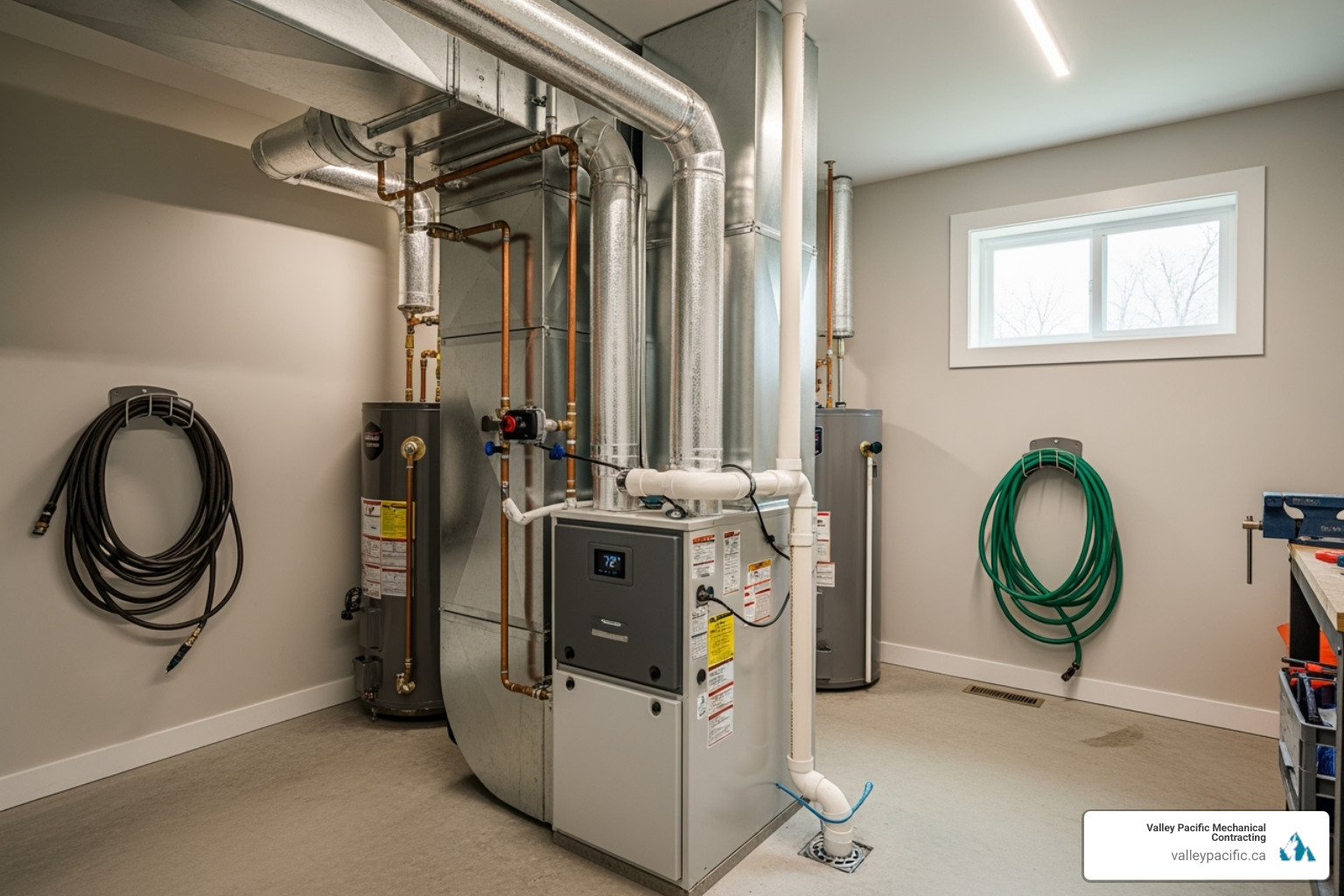
Telltale Signs It's Time for a Replacement
Your furnace often gives warning signs before it fails completely. Look out for these indicators:
- Age: If your furnace is over 15-20 years old, replacement is often more cost-effective than continued repairs.
- Rising Energy Bills: A sudden or steady increase in heating costs signals declining efficiency.
- Frequent Repairs: If you're constantly calling for service, the cost of repairs can quickly add up. Replacement is smarter when a single repair costs more than half the price of a new unit.
- Uneven Heating: Cold spots and inconsistent temperatures mean your furnace can no longer distribute heat effectively.
- Strange Noises: Banging, rattling, or squealing sounds often point to mechanical failures.
- Yellow Pilot Light: A healthy flame is blue. A yellow or flickering flame can indicate a serious combustion problem and a potential carbon monoxide risk.
- Visible Rust or Cracks: Corrosion on the furnace or heat exchanger is a sign that the unit has reached the end of its safe operating life.
If you see these signs, it's time for a professional evaluation. Not sure which path makes sense for your situation? Check out Need a repair instead? to explore your options.
What to Expect During an In-Home Consultation
Your journey begins with a no-obligation, in-home consultation. Our expert will conduct a thorough home assessment, including your current system, insulation, and ductwork. We perform precise sizing calculations to determine the exact heating requirements for your home, ensuring your new furnace isn't too big or too small. Based on this, we'll discuss system recommendations custom to your needs and budget and provide a detailed, transparent quote with no hidden fees.
The Typical Installation Day: A Step-by-Step Overview
A typical installation takes between four and ten hours. Our team works efficiently to minimize disruption:
- Preparation: We protect the work area with drop cloths and ensure safe access.
- Old Unit Removal: We safely disconnect and remove your old furnace for responsible disposal.
- New Furnace Placement: The new unit is precisely positioned and leveled according to manufacturer and code requirements.
- Connections: We connect the furnace to your ductwork, gas lines (with rigorous leak testing), and electrical systems.
- Thermostat Integration: We wire and program your new or existing thermostat to work seamlessly with the furnace.
- System Testing: We run the furnace through multiple cycles to verify proper operation, airflow, and safety features.
- Cleanup and Walkthrough: We clean the work area completely and walk you through your new system's operation, answering any questions you have.
Post-Installation: Maintenance, Warranties, and Rebates
You've invested in a new furnace; now it's time to protect that investment. Proper care will ensure your system provides reliable warmth and efficiency for its entire 15- to 20-year lifespan.
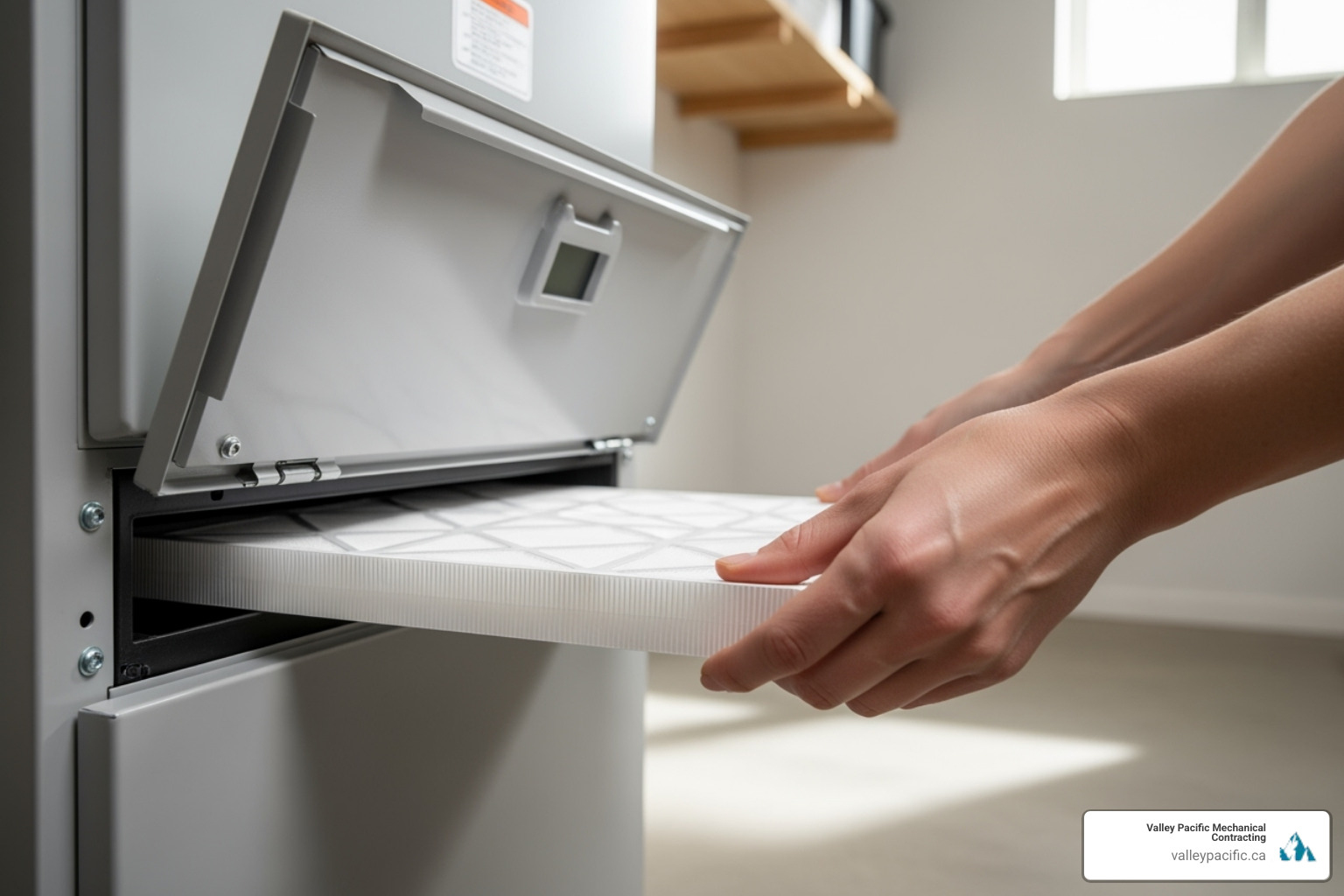
Extending Your Furnace's Lifespan
The most important step is annual professional servicing. A yearly tune-up keeps your furnace installation Langley BC running at peak efficiency, prevents costly breakdowns, and extends its life. Between visits, you can help by:
- Changing the air filter every 1-3 months to ensure proper airflow and maintain good air quality.
- Keeping all supply and return vents clear of furniture, rugs, and other obstructions.
- Using a programmable thermostat to reduce unnecessary wear on your system when you're away or asleep.
For more insights on keeping your entire HVAC system in top shape, explore our guide to HVAC Preventative Maintenance.
Warranties and Available Rebates in BC
Your new system comes with comprehensive warranty protection. Most furnaces include a parts warranty (5-10 years), an extended heat exchanger warranty (20 years to lifetime), and a labour warranty (1-2 years). We'll explain the specific coverage for your model.
As a proud FortisBC Trade Ally Member, we help you take advantage of provincial and federal rebate programs, including CleanBC initiatives. These rebates can significantly offset the cost of a new high-efficiency furnace. We'll guide you through the application process to ensure you receive all eligible savings.
Frequently Asked Questions about Furnace Services
We know that planning for a new furnace brings plenty of questions—and rightfully so. It's a significant investment in your home's comfort and safety. Here are some of the most common questions we hear from Langley homeowners, answered with the clarity you deserve.
What factors should I consider when choosing a furnace installation company in Langley?
Choosing the right partner for your furnace installation Langley BC is just as important as selecting the furnace itself. Look for a partner with:
- Local Experience: A company that understands Langley's climate and homes.
- Licensing and Insurance: This is non-negotiable for your protection and guarantees qualified work.
- Positive Reviews: A strong reputation indicates quality service.
- 24/7 Emergency Service: Peace of mind knowing help is available anytime.
- In-House Technicians: Ensures consistent quality and accountability.
- Comprehensive Services: A partner for installation, repair, and maintenance.
When should I repair my furnace versus replace it?
This is a smart question to ask. The answer depends on age, cost, and safety.
Consider replacement if your furnace is over 15 years old, a repair costs more than half the price of a new unit, or your energy bills are consistently high. Safety issues like a cracked heat exchanger always warrant immediate replacement.
Repair is often the right choice for younger furnaces (under 10-12 years old), especially if the issue is minor and the unit has been reliable.
Our technicians will walk you through an honest cost-benefit analysis, helping you understand whether repair or replacement makes the most sense for your situation and budget.
What's the difference between a single-stage and a two-stage furnace?
Understanding furnace stages helps you choose a system that matches your comfort expectations.
A single-stage furnace is the straightforward option. It has one speed: full blast. When your thermostat calls for heat, the furnace kicks on at 100% capacity and then shuts off, which can create noticeable temperature swings.
A two-stage furnace offers more finesse. It operates at two settings: a lower capacity for most days and a high capacity for colder weather. It runs longer on its gentle, lower setting, providing steady, consistent warmth. The benefits include more consistent comfort, better humidity control (valuable in Langley's damp climate), and quieter operation.
Your Partner for a Warm and Cozy Home
As we've journeyed through this guide, you've learned what you need to know about furnace installation Langley BC. The heart of the matter is this: professional installation is an investment in years of reliable warmth, lower energy bills, and peace of mind. When you choose the right system and have it installed correctly, you're setting yourself up for worry-free heating.
At Valley Pacific Mechanical Contracting, we've spent over 30 years perfecting the "headache-free experience." Our in-house technicians handle every detail with care, and we're available 24/7 for emergency service. We understand Langley homes and what it takes to keep your family cozy.
Backed by the Daikin Comfort Promise, we stand behind every installation with the highest standards of service. Whether you're replacing an aging furnace or upgrading to a high-efficiency system, we're here to guide you. Don't wait until the coldest night of winter to find your furnace has given up. Let's work together to ensure your home stays warm and safe.
Schedule your professional furnace installation in Langley BC today!
Why Heat Pump Repair Matters for Langley Homeowners
Langley heat pump repair services restore comfort when your system fails. Here's what to know:
- Emergency Service: Local providers offer 24/7 emergency repairs for urgent failures.
- Common Warning Signs: Inconsistent temperatures, rising energy bills, strange noises, unusual smells, frequent cycling, or poor airflow.
- What to Expect: Professional diagnosis, clear repair options, and same-day service when possible.
- Repair vs. Replace: Systems under 10 years old are typically worth repairing; older systems may benefit from replacement.
In Langley's moderate climate, your heat pump works year-round, providing both heating and cooling from a single, efficient system. This constant operation means that when it fails, your comfort is immediately compromised. Fortunately, most issues can be repaired quickly if caught early.
A properly functioning heat pump can reduce your heating and cooling costs by up to 50%. However, a struggling system uses more energy and delivers less comfort. Understanding the warning signs helps you act fast, often preventing a simple repair from becoming a costly replacement. Want a neutral primer on how these systems work? See Wikipedia's overview of heat pumps.
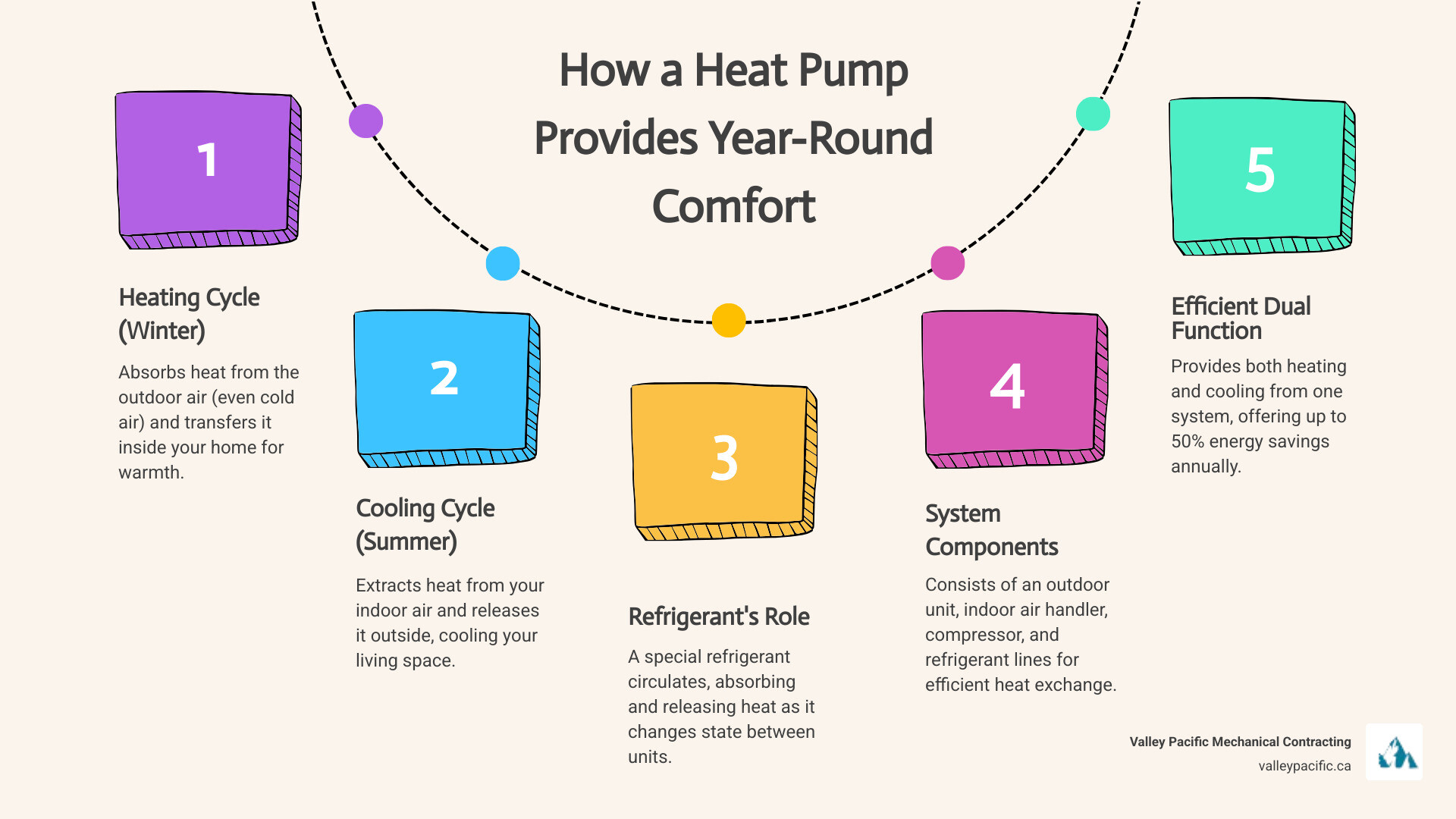
Key terms for Langley heat pump repair:
When to Call for Help: Warning Signs of a Failing Heat Pump
Because heat pumps in Langley run year-round, switching between heating and cooling, wear and tear is inevitable. Catching problems early almost always means simpler, less expensive repairs. If you notice your energy bill has jumped or your home has uneven temperatures, your heat pump may be crying out for help.
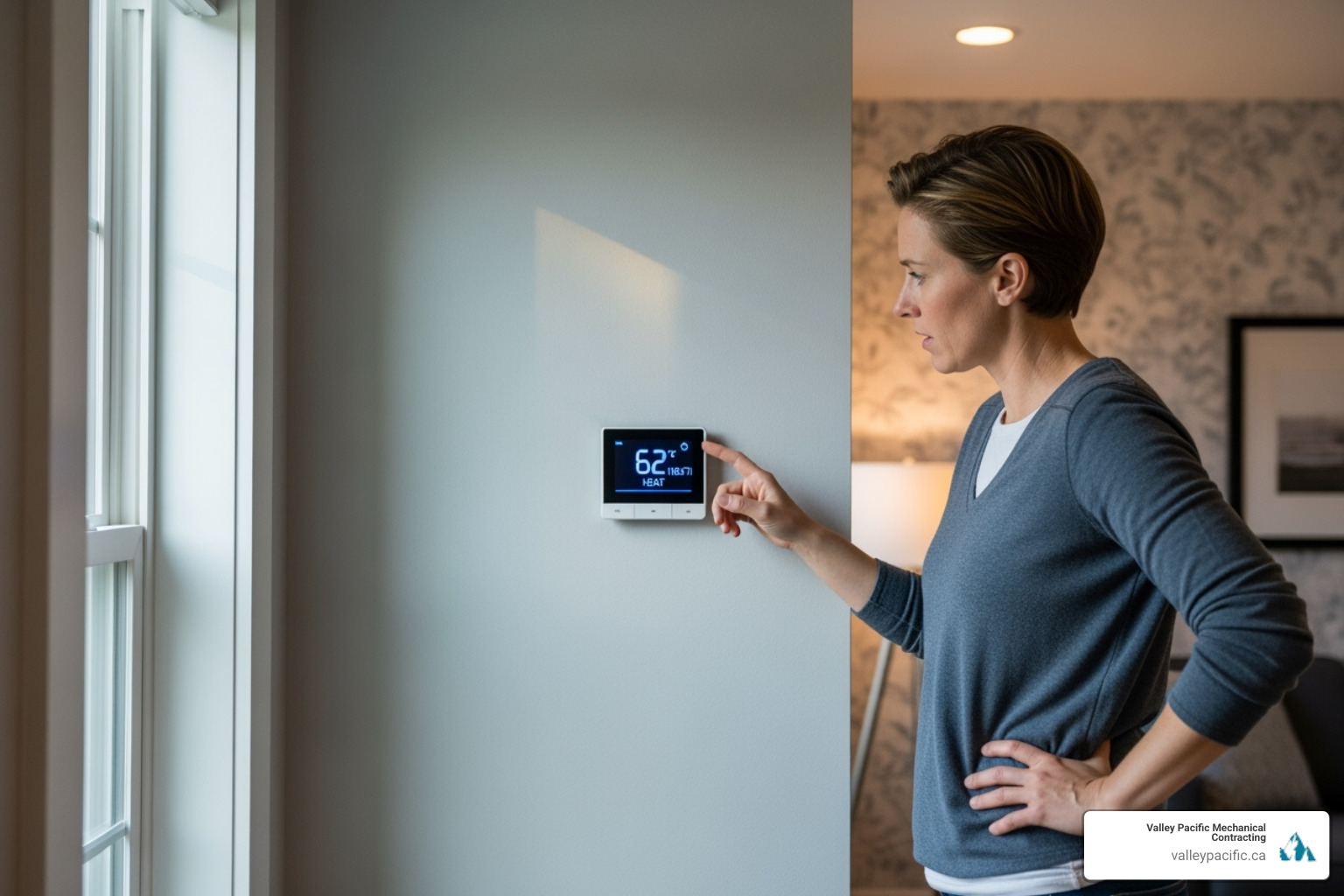
Watch for these common warning signs:
- Inconsistent temperatures: If one room is a sauna while another is an icebox, your system is struggling to distribute air evenly.
- Rising energy bills: A sudden spike in your bill without a change in usage means your system is working overtime due to inefficiency.
- Strange noises: Heat pumps should run quietly. New sounds are clues that something is wrong inside the unit.
- Unusual smells: Burning, musty, or electrical odors from your vents are red flags that require immediate investigation.
- Frequent cycling: If your system turns on and off too often ("short cycling"), it wastes energy and wears out components faster.
- Poor airflow: Weak airflow from vents can stem from fan issues, blockages, or other circulation problems.
- Ice buildup: While some frost is normal in winter, a thick layer of ice on the outdoor unit can indicate a refrigerant leak or a malfunctioning defrost cycle.
- Leaks or moisture: Water pooling around your indoor or outdoor unit points to drainage problems or refrigerant leaks.
Don't wait for a minor issue to become a major breakdown. For more details, see our guide on Signs Your Heat Pump Needs Repair.
Common Noises and What They Mean
Unusual noises are your heat pump's way of telling you what's wrong.
- Grinding: This typically points to failing motor bearings, which can lead to complete motor failure if ignored.
- Squealing: A high-pitched squeal often means the fan motor bearings are worn out and beginning to fail.
- Banging or Clanking: These loud noises usually indicate loose or broken parts in the compressor or fan, requiring immediate attention to prevent severe damage.
- Hissing: A sound like escaping gas is a classic sign of a refrigerant leak, which harms efficiency and can damage the compressor.
Performance-Related Red Flags
Beyond sounds, performance issues clearly signal it's time for Langley heat pump repair.
- System blows cool air in heat mode: This often points to a reversing valve issue or low refrigerant, preventing the system from transferring heat indoors.
- System blows warm air in cool mode: The opposite problem, this indicates the system can't remove heat, likely due to refrigerant or compressor issues.
- Ice on the outdoor unit: A thin, quickly melting layer of frost is normal in winter. Thick, persistent ice suggests a problem with the defrost system or low refrigerant.
- Leaks or moisture: Puddles near your unit could be a clogged condensate drain, a refrigerant leak, or a damaged coil.
When you spot these issues, our team provides Expert Heat Pump Repair Services to diagnose and resolve them quickly. We also offer specialized Heat Pump Repair Langley BC services.
The Expert Langley Heat Pump Repair Process: From Diagnosis to Solution
When your heat pump fails, you need a solution that's fast and stress-free. Our Langley heat pump repair process is designed to be as headache-free as possible. A failing system is a major disruption, which is why our 24/7 emergency service is always ready to respond.
Our goal isn't just to fix the problem but to ensure you understand what happened and how we're solving it. We follow a thorough, systematic approach from the moment you call.
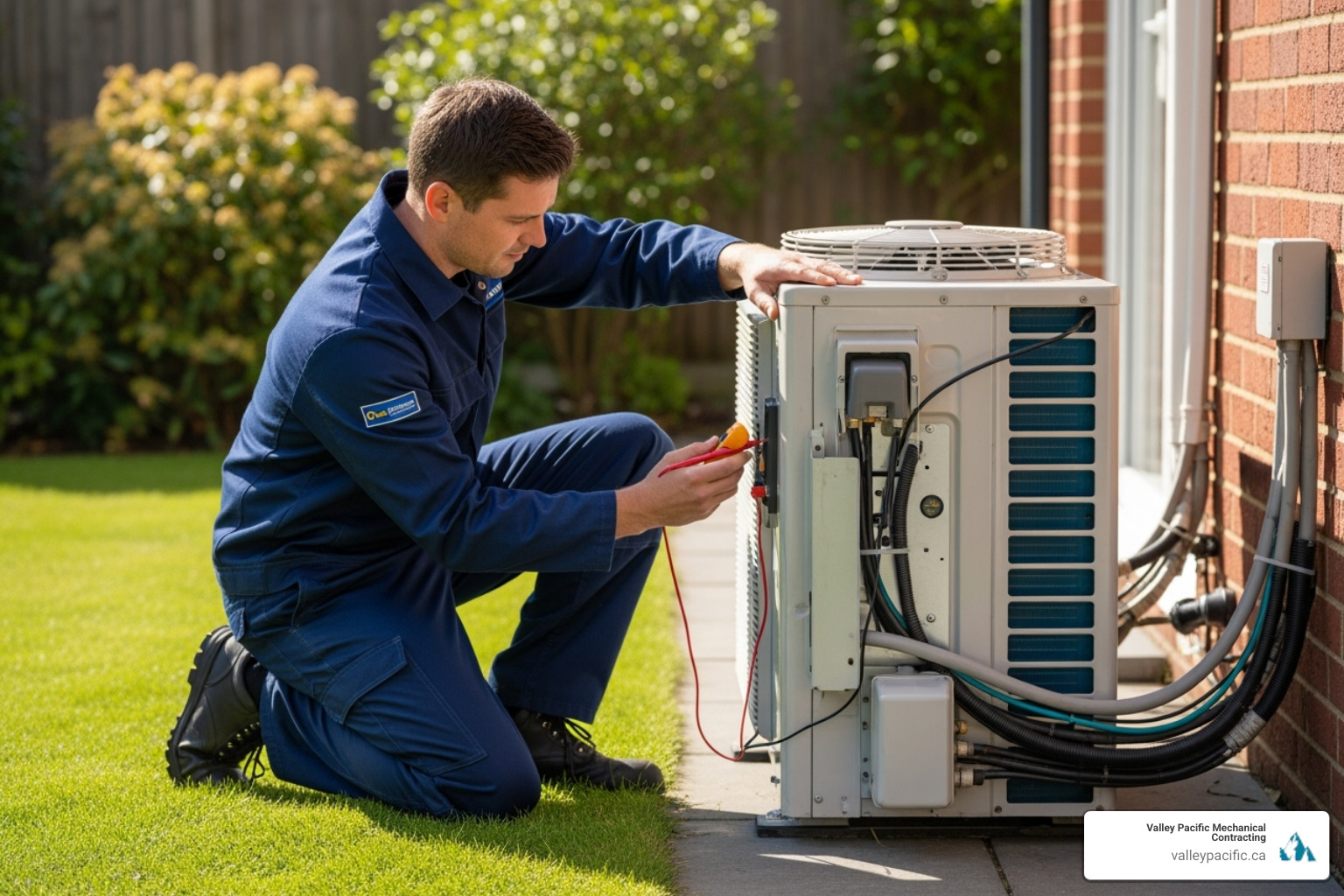
What to Expect During a Langley heat pump repair Visit
When our technicians arrive, they begin with a safety check to ensure no immediate hazards exist. Then, we listen to your observations and perform a complete system inspection of both indoor and outdoor units, examining coils, fans, electrical connections, and ductwork.
Using specialized tools, we conduct component testing on the compressor, motors, and controls to measure their performance. A refrigerant level check is also crucial, as incorrect levels severely impact efficiency. We'll also perform an electrical connection inspection for any loose or corroded wiring that could cause system failure.
Throughout the process, we prioritize clear communication. We'll explain the problem in plain English, walk you through your repair options, and answer all your questions before any work begins. You'll be fully informed and in control. For more on our approach, visit our Heat Pump Repair Langley BC page.
Common Issues Addressed by Langley heat pump repair Experts
With over 30 years of experience, we've seen it all. Here are some of the most common issues we fix:
- Refrigerant leaks: When refrigerant escapes, your heat pump can't transfer heat effectively. We locate and repair the leak, then recharge the system to proper levels.
- Compressor failure: The compressor is the heart of your system. A failure means no heating or cooling. Depending on your system's age, this may lead to a replacement discussion.
- Thermostat malfunctions: A faulty thermostat can send wrong signals, causing erratic operation or preventing the system from turning on.
- Fan motor issues: A failing indoor or outdoor fan motor disrupts airflow, leading to poor performance and strange noises.
- Reversing valve problems: This component switches the system between heating and cooling. If it sticks, your heat pump may get stuck in one mode.
Our expertise also covers standard air conditioning issues, so we provide comprehensive AC Repair Langley BC services. We have the knowledge to diagnose the problem accurately and fix it right the first time.
Repair or Replace? Making the Right Decision for Your Home
When faced with a repair quote, it's smart to ask: "Is it worth fixing, or should I get a new one?" The answer depends on several factors, much like deciding whether to fix an old car or trade it in.
Age is the biggest factor. Most heat pumps last 10-15 years. If your system is under 10 years old and has its first major issue, repair is usually the best choice. However, if it's over 10 and requires frequent repairs, you may be throwing good money after bad.
A helpful rule of thumb: If the repair cost is over 50% of a new system's price, replacement often makes more financial sense, especially for older, inefficient units. Frequent calls for Langley heat pump repair are a sign that multiple components are wearing out, and another breakdown may be just around the corner.
Your system's efficiency is another key consideration. An older heat pump struggling to maintain comfort while driving up energy bills may be worth replacing for the long-term savings alone. For similar logic on other systems, see our page on Furnace Repair Langley BC.
Here's a quick comparison to help you decide:
| Factor | Repair | Replacement |
|---|---|---|
| Age | Often preferred for systems under 10 years old | Recommended for systems 10+ years old |
| Repair Cost | Typically lower upfront cost | Higher upfront cost |
| Energy Efficiency | Remains the same (potentially low) | Significantly improved |
| Warranty | May still be covered | New warranty coverage |
| Frequency of Issues | One-off or rare problems | Frequent breakdowns and recurring issues |
| Home Comfort | Restores current level | Improved, more consistent comfort |
| Technology | Older technology retained | Access to latest features and smart controls |
Benefits of a Timely Replacement
While nobody looks forward to the upfront cost of a new heat pump, it can be the best long-term financial decision.
- Energy Efficiency: Modern heat pumps can cut heating and cooling costs by up to 50% compared to older models. These monthly savings add up quickly.
- Improved Comfort: New systems provide consistent temperatures, eliminating hot and cold spots. They also offer better humidity control and quieter operation.
- New Technology: Upgrade to features like smart thermostats and zoning systems that allow for greater control and convenience.
- Long-Term Savings & Peace of Mind: A new system comes with a fresh warranty, meaning years without worrying about repair bills and emergency service fees.
- Environmental Benefits: As one of the most eco-friendly HVAC options, a new heat pump reduces your home's greenhouse gas emissions.
If you're leaning toward replacement, our Consider Heat Pump Installation Reasons page offers more details. We'll always provide honest information to help you make the right choice for your home and budget, without any sales pressure.
Beyond the Repair: Maintenance, Installation, and Long-Term Benefits
Fixing your heat pump is just one piece of the puzzle. True long-term comfort and efficiency come from proactive servicing and understanding the benefits of a well-maintained system. Think of it like regular oil changes for your car—it prevents major breakdowns and keeps things running smoothly.

A heat pump at peak performance can save up to 50% on heating and cooling costs. It also reduces your environmental footprint and improves indoor air quality. With our 30+ years of expertise and the Daikin Comfort Promise, you can trust your system to deliver consistent comfort year after year. For more tips, see our guide on HVAC Preventative Maintenance Tips.
How Regular Maintenance Prevents Breakdowns
Most emergency heat pump repairs are preventable. An annual service visit catches small issues before they become expensive problems. Key maintenance tasks include:
- Filter Changes: A clean filter ensures proper airflow and efficiency. We recommend changing them every 3-6 months.
- Coil Cleaning: Dirty coils can't transfer heat effectively. Cleaning them improves performance and lowers operating costs.
- Electrical Checks: We tighten all connections and check voltages to prevent failures and ensure safety.
- Lubricating Moving Parts: This reduces friction and wear on components like fan motors, ensuring quiet operation.
- Drainage Inspection: We check the condensate drain to prevent clogs that can cause water damage or system shutdowns.
- Refrigerant Level Verification: Proper refrigerant charge is essential for efficient operation.
These steps not only prevent breakdowns but also extend your system's lifespan, often well beyond the typical 15 years. Learn more in our guide to Heat Pump Maintenance.
The Heat Pump Installation Process
When it's time for a new heat pump, our installation process is designed to be smooth and stress-free. A proper installation is the foundation for years of reliable comfort.
- Home Assessment: We evaluate your home's size, insulation, and layout, and discuss your comfort goals and budget. We don't believe in one-size-fits-all solutions.
- System Sizing: Using precise load calculations, we determine the exact heating and cooling capacity your home needs. An improperly sized unit wastes energy and wears out prematurely.
- Ductwork Evaluation: We inspect existing ductwork for leaks or blockages. For ductless systems, we plan the ideal placement of indoor units.
- Professional Installation: Our certified technicians handle every detail with precision, from positioning the units to connecting all refrigerant and electrical lines.
- System Testing: After installation, we calibrate the system and perform comprehensive tests to ensure it operates safely and efficiently. We'll also show you how to use your new system.
We provide ongoing support to keep your new heat pump performing beautifully for decades. Explore our Heat Pump Installation Langley BC services to learn more.
Navigating Your Upgrade: Rebates and Choosing a Local Langley Pro
Upgrading to a new heat pump is even more appealing when you factor in the available financial incentives. Langley homeowners can currently access rebates up to $24,000 by switching to an energy-efficient heat pump, making the transition more affordable than ever.
These significant savings come from stacking various programs:
- The Canada Greener Homes Grant is a federal program providing grants for energy-efficient home retrofits, including heat pumps.
- BC Hydro rebates offer incentives for homeowners switching from fossil fuels or older electric systems to new, efficient heat pumps.
- CleanBC programs provide additional provincial support to help reduce greenhouse gas emissions.
- FortisBC programs may also offer rebates for customers upgrading their heating systems.
Navigating these programs can be complex, but you don't have to do it alone. We guide our customers through the entire rebate process to ensure you maximize your savings. It's part of our commitment to a headache-free experience. To see all our offerings, visit our Services page.
Choosing a local company for your Langley heat pump repair and installation needs provides immense value. A local team understands our climate, building codes, and common household issues, ensuring customized solutions and faster response times.
How to Choose the Right HVAC Provider
Selecting the right HVAC provider impacts your comfort for years. Here's what to look for:
- Licenses and Insurance: This is non-negotiable. It protects you from liability and ensures the company is accountable.
- Reviews and Testimonials: See what other Langley homeowners say about their experiences. Look for consistent feedback on professionalism and quality.
- Certifications and Affiliations: Credentials like BBB Accreditation and FortisBC Trade Ally status demonstrate a commitment to industry standards.
- Trusted Local Reputation: A company with a long-standing presence in the community is more likely to stand behind its work.
- A Clear Process: A reputable provider will explain all your options clearly before starting work and offer guarantees. Our 24/7 emergency service and "headache-free" promise are examples of this commitment.
For comprehensive services from a trusted local expert, visit our HVAC Services Langley page.
Conclusion
Your heat pump is a year-round workhorse, providing comfort to your Langley home through every season. This vital investment deserves professional care to ensure it runs efficiently and reliably.
Recognizing warning signs like strange noises, inconsistent temperatures, or rising energy bills is the first step. Acting quickly can often prevent a minor issue from becoming an expensive breakdown. Professional Langley heat pump repair is about more than just a quick fix; it's about receiving clear explanations and lasting solutions from trusted experts.
Regular maintenance is your best defense against unexpected failures and high energy costs. A well-maintained heat pump can reduce heating and cooling costs by up to 50% and significantly extend its lifespan.
If you're considering an upgrade, significant government rebates of up to $24,000 make now an excellent time to invest in a modern, high-efficiency system. These programs make comfort more accessible while reducing your environmental impact.
With over 30 years of experience in the Lower Mainland, we've built our reputation on a "headache-free" experience, transparent communication, and the Daikin Comfort Promise. Whether you need 24/7 emergency repairs or are planning a future upgrade, our team is ready to help.
Don't leave your comfort to chance. If your heat pump is struggling, or you're ready to explore the benefits of a new system, we're here for you.
Book your heat pump installation consultation today and let us restore reliable, year-round comfort to your Langley home.
Why Your Family's Safety Depends on the Right Credentials
Your home's heating and cooling system is about more than comfort—it's about safety. When you need a repair, the urgency shouldn't lead to a costly mistake. Hiring a licensed HVAC technician is the only way to ensure the job is done safely and correctly.
These professionals have met mandatory government requirements to legally install, repair, and maintain HVAC systems. Here's what that means for you:
- Proven Expertise: They hold provincial licenses (like Gas Fitter or Refrigeration Mechanic) proving they've passed rigorous exams.
- Legal Authority: They are legally authorized to work on gas lines, electrical systems, and refrigerants—work that's illegal for unlicensed individuals.
- Safety Compliance: They follow strict building codes to prevent carbon monoxide leaks, gas explosions, and electrical fires.
- Investment Protection: Their work keeps your warranty valid, ensures your home is insurable, and helps your system run efficiently.
Not everyone working on HVAC systems has the proper credentials. The difference isn't just paperwork; it's the line between a safe, reliable system and one that puts your family at risk. An unlicensed technician offering a low price often cuts corners, leading to dangerous gas connections, faulty wiring, and environmental hazards. If something goes wrong, your homeowner's insurance may refuse to cover the damage.
This guide will explain what HVAC licenses mean, why they are non-negotiable, and how to verify that the technician you hire is qualified to do the job right.
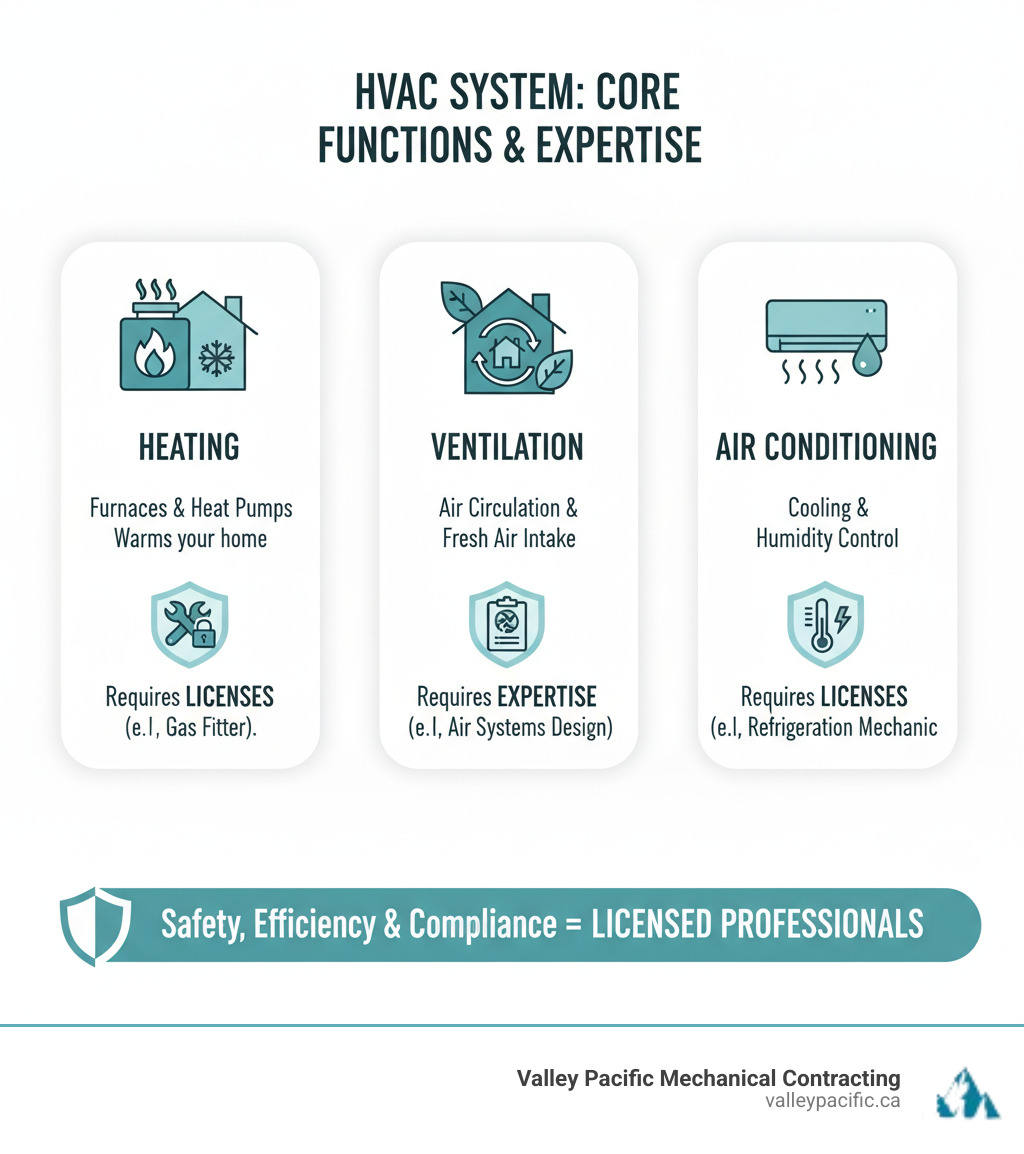
Important Licensed HVAC technicians terms:
The Anatomy of a Credential: What HVAC Licenses Really Mean
When you hire a licensed HVAC technician, you're hiring a professional who has invested years in training and passed comprehensive government exams. These credentials exist for one critical reason: to protect you and your family.
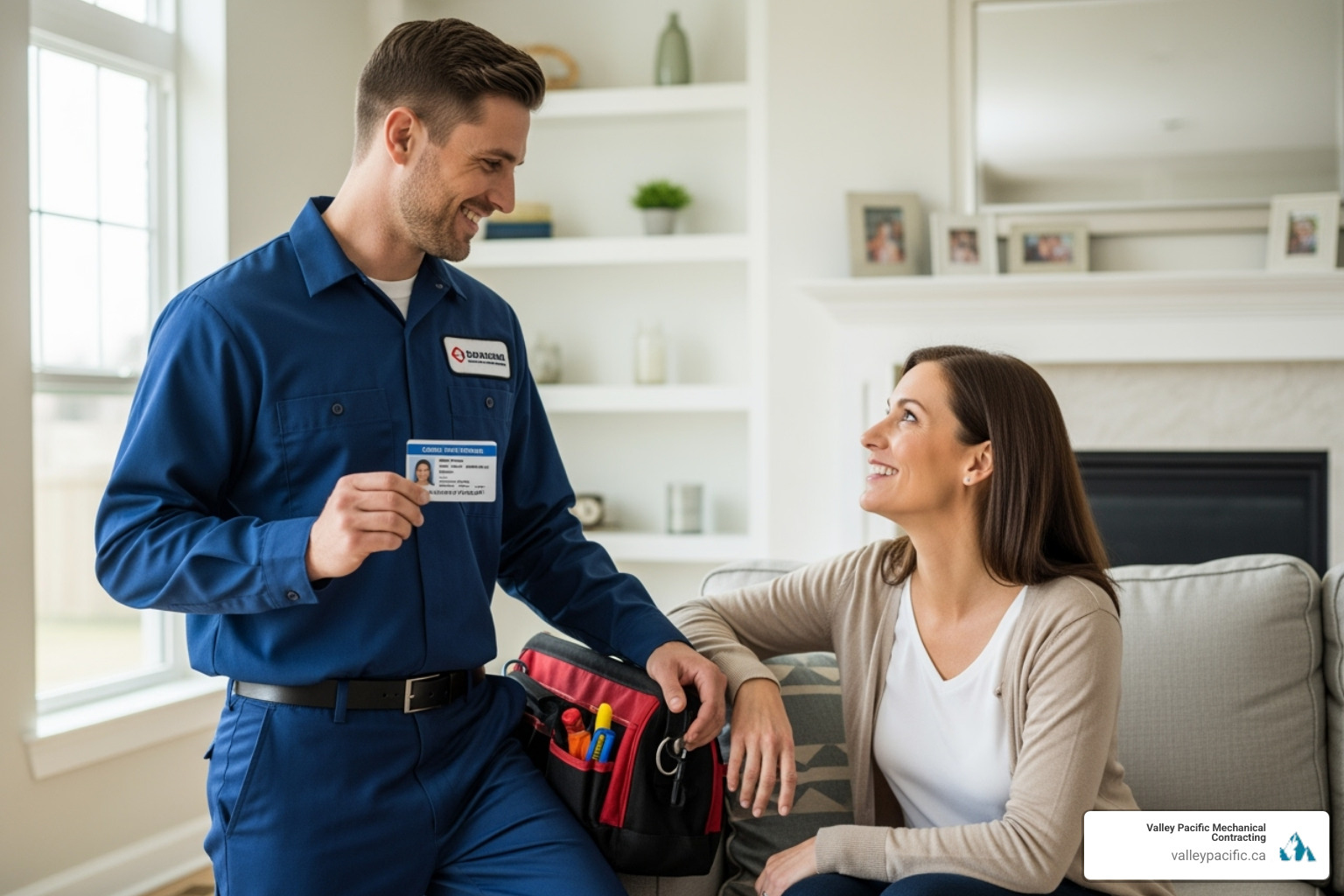
It's important to understand the difference between a license and a certification. A license is a mandatory legal requirement from a government body like Technical Safety BC. It grants a technician the legal authority to perform specific work, such as on gas or refrigeration lines. Without it, they are breaking the law.
A certification is typically voluntary and awarded by a professional organization. It shows a technician has gone the extra mile to prove their expertise in a specialized area. Think of a license as a driver's license (required to drive) and a certification as an advanced driving course (proves extra skill).
Provincial and Federal Requirements
In British Columbia, Technical Safety BC regulates HVAC work to ensure anyone handling your gas lines, refrigerants, or electrical components is qualified. Key licenses include:
- Gas Fitter License: Authorizes work on gas appliances like furnaces and water heaters. This is critical for preventing gas leaks and carbon monoxide poisoning.
- Refrigeration and Air Conditioning Mechanic License: Covers work on cooling systems and heat pumps, ensuring safe handling of refrigerants.
Refrigerant handling is also strictly regulated by the federal government to protect the environment. Licensed technicians are trained in proper recovery and disposal procedures. You can verify a company's credentials online and find a licensed contractor in BC through the public registry: Find a licensed contractor in BC, giving you peace of mind.
Voluntary Professional Certifications
Voluntary certifications separate good technicians from exceptional ones. They show a commitment to continuous learning and a higher standard of work.
- NATE (North American Technical Excellence): This is the industry's gold standard, proving expertise in specific areas like air conditioning or gas furnaces.
- HVAC Excellence: This certification indicates comprehensive knowledge in diagnostics, installation, and maintenance.
- Manufacturer-Specific Training: Programs from companies like Daikin ensure technicians know the optimal way to install and service specific equipment.
At Valley Pacific Mechanical, our technicians don't just meet the legal minimums. We invest in ongoing training to deliver the high-quality tailored HVAC services for homes our customers deserve.
Why Hiring Licensed HVAC Technicians is Crucial for Your Home
Hiring licensed HVAC technicians is a critical decision for your family's safety, financial security, and comfort. Qualified professionals have invested years in training and stay current with evolving safety codes. This commitment protects your family and maximizes your investment. At Valley Pacific Mechanical, we deliver HVAC Services for Home Comfort with fully licensed professionals, ensuring peace of mind.
Ensuring Safety and Code Compliance
The primary reason to hire licensed technicians is safety. An HVAC system involves gas lines, electrical circuits, and refrigerants, each carrying serious risks if handled incorrectly.
- Preventing Carbon Monoxide Leaks: Licensed gas fitters are trained to install and service gas furnaces and appliances correctly, preventing leaks of this odorless, deadly gas.
- Avoiding Gas Leaks and Fires: Technicians follow strict codes for connecting gas lines, preventing flammable leaks and explosion risks. Faulty electrical work is a major fire hazard, and licensed professionals ensure all wiring is safe and up to code.
- Improving Air Quality: Proper installation and maintenance include ensuring adequate ventilation, which prevents the buildup of indoor air pollutants and mold.
- Meeting Building Codes: Licensed technicians ensure all work complies with local building codes in the Lower Mainland, avoiding potential fines and legal issues when you sell your home.
Protecting Your Investment and Warranty
Your HVAC system is a major investment. Hiring licensed professionals is the best way to protect it.
- Maintaining Your Warranty: Most manufacturers will void their equipment warranty if installation or repairs are done by an unlicensed individual. This could leave you paying the full cost for repairs, even for a factory defect.
- Extending Equipment Lifespan: Proper installation and regular maintenance by a licensed expert prevent premature wear and tear, significantly extending the life of your system.
- Qualifying for Rebates: Many government and utility rebate programs for energy-efficient upgrades require installation by a licensed contractor. Our HVAC System Upgrades Complete Guide highlights how these programs can help offset costs.
The Benefits of Quality and Efficiency
Licensed technicians deliver superior quality and efficiency, which translates to better comfort and lower energy bills.
- Correct System Sizing: Professionals use scientific calculations to determine the exact size of the system your home needs. An improperly sized unit (too large or too small) wastes energy, provides poor comfort, and wears out faster.
- Optimal Performance: A properly installed and calibrated system runs at peak efficiency, providing consistent temperatures, better humidity control, and lower utility bills.
- Fewer Breakdowns: Quality work from a licensed expert, from initial HVAC System Design to routine maintenance, drastically reduces the chance of unexpected failures, saving you from the stress and expense of emergency repairs.
The Red Flags: Risks of Hiring Unlicensed Technicians
A price that seems too good to be true usually is. Hiring an unlicensed technician is a gamble with your family's safety and your home's value. Operating outside the law, these individuals lack the training, tools, and accountability that come with a license. This doesn't lead to a bargain—it leads to dangerous and costly problems.
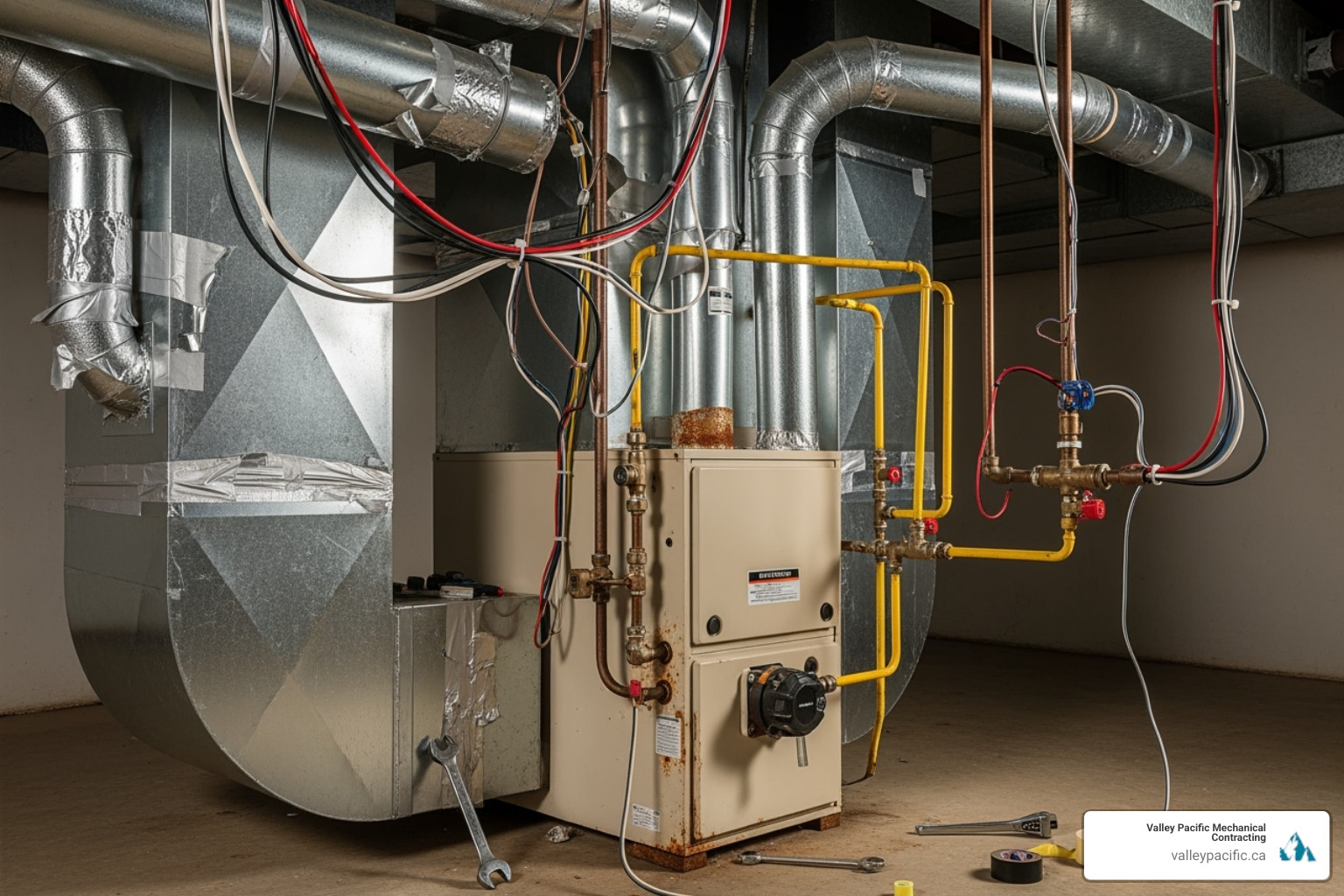
Immediate Safety Dangers
Unlicensed work on your HVAC system creates immediate safety hazards. Without proper training, individuals are experimenting with your home's most dangerous components.
- Improper Gas Line Connections: This is the most terrifying risk, potentially leading to explosive gas leaks or deadly carbon monoxide poisoning.
- Faulty Electrical Work: HVAC systems draw significant power. Incorrect wiring creates a serious fire hazard that may not be apparent until it's too late.
- Refrigerant Leaks: Mishandling refrigerants is illegal, harmful to the environment, and can pose health risks to your family.
These issues are not theoretical; they are real threats. Strange smells or sounds after a repair could be signs your HVAC system may fail soon or indicate imminent danger.
Insurance and Liability Nightmares
Hiring an unlicensed technician creates a legal and financial minefield. Your homeowner's insurance policy can deny claims for damage caused by unpermitted or unlicensed work. If a fire starts from faulty wiring, you could be left with the entire bill.
Furthermore, you become liable for any accidents on your property. Licensed HVAC technicians carry their own liability and workers' compensation insurance. If an unlicensed person is injured while working in your home, they can sue you directly, and your insurance likely won't cover it.
The Hidden Costs of "Cheap" Repairs
That initial "deal" from an unlicensed worker quickly becomes expensive. They often use substandard parts that fail quickly, leading to repeat service calls. Without proper diagnostic tools, they may make incorrect diagnoses, fixing the wrong thing while the real problem gets worse.
This cycle of poor workmanship and repeat visits is frustrating and costly. Worse, it accelerates your system's decline, leading to premature failure and forcing you to pay for a full replacement years ahead of schedule. When a licensed professional is finally called for HVAC Repair in Maple Ridge, BC, the job is often more complex and expensive because they must first undo the previous mistakes. The "too good to be true" price was just that.
How to Verify a Technician's Credentials
Don't just take a technician's word that they're qualified. Verifying credentials is a straightforward step that offers immense peace of mind. An informed homeowner is a safe homeowner, and a few minutes of due diligence can save you from years of headaches.

Ask for Proof and Check Online
A reputable professional will expect you to ask for their credentials and will provide them without hesitation. If they become defensive, that's a major red flag.
- Request License Numbers: Ask for the company's contractor license number and the technician's individual license number.
- Check Public Registries: In British Columbia, use the contractor search tool on the Technical Safety BC website to verify credentials in real time: Technical Safety BC contractor search. You can find a licensed contractor in BC with just a few clicks.
- Verify Insurance: Ask for proof of general liability insurance and workers' compensation coverage. This protects you from liability if an accident occurs on your property.
- Look for a Permanent Address: A stable company with a physical business address is more accountable than one operating only from a mobile phone.
Look for Professional Affiliations
Beyond licensing, professional affiliations indicate a company's commitment to high standards and customer satisfaction.
- HRAI Membership: The Heating, Refrigeration and Air Conditioning Institute of Canada (HRAI) is a national trade association whose members are committed to ethical practices. Learn more at HRAI.
- Better Business Bureau (BBB) Rating: A strong BBB rating shows a company's dedication to resolving customer issues. Check the BBB.
- NATE-Certified Technicians: This voluntary certification demonstrates advanced, proven expertise. See NATE.
These affiliations show that a business is invested in its people and its customers. We're proud of our affiliations, and you can learn more about our company and our commitment to excellence.
Final Verification Steps
When checking a license, confirm it has an active status and hasn't expired. Ensure the technician's license is associated with the company you're hiring. Finally, make sure the license covers the specific work you need done (e.g., a gas fitter license for a furnace). A fully qualified licensed HVAC technician for your specific HVAC services in Langley ensures the job is done right the first time.
Frequently Asked Questions about Licensed HVAC Technicians
Understanding what licensed HVAC technicians do and what their credentials mean helps you make safer decisions for your home. Here are answers to some common questions.
What is the difference between an HVAC license and a certification?
A license is a mandatory legal requirement issued by a government body like Technical Safety BC. It proves a technician has met training and exam requirements to work safely on gas lines, electrical systems, and refrigerants. Without it, the work is illegal.
A certification is typically voluntary and awarded by professional organizations (like NATE) to show a higher level of expertise in a specific area. A license is required to work legally; a certification is a mark of advanced skill.
Can a general handyman legally work on my furnace or air conditioner?
No. A handyman can perform only the most basic tasks, like changing an air filter. Any work involving gas lines, electrical connections, or refrigerants legally requires a specific license (e.g., Gas Fitter, Refrigeration Mechanic). Letting an unlicensed person work on your system is dangerous, illegal, and can void your home insurance coverage for related damages.
Why can't I find a contractor in the online registry?
If you can't find a contractor in an official registry like Technical Safety BC's, there could be a few reasons:
- Incorrect Name: You may have a typo or be searching for a brand name instead of the legal business name.
- Licensed Under a Different Name: The technician may be licensed under a parent company. Ask for the exact registered name or contractor license number.
- They Are Not Licensed: This is a serious red flag. If a company cannot provide verifiable credentials, you should not hire them.
We are always transparent about our credentials. Whether you need HVAC Services Maple Ridge or are looking at our HVAC Services Coquitlam Guide, we will gladly share our licensing information.
Your Assurance of Quality and Safety
When you hire an HVAC technician, you're trusting them with your family's safety and a significant home investment. As this guide has shown, licensing is the key difference between a qualified professional and someone merely claiming to be one.
Licensing isn't just paperwork. It is your guarantee of safety, competency, and accountability. It ensures the technician can legally and safely work on gas lines, electrical systems, and refrigerants. Licensed work protects your warranty, meets building codes, and prevents dangerous hazards like carbon monoxide leaks and electrical fires.
The choice between licensed and unlicensed work is a choice between peace of mind and unnecessary risk. Don't learn the hard way that a "bargain" can lead to a safety hazard or an insurance nightmare. There are no shortcuts to quality and safety.
For a headache-free experience with fully licensed and insured experts in Langley, Maple Ridge, Mission, and across the Lower Mainland, trust Valley Pacific Mechanical. Our 30+ years of expertise ensure your heat pump installation in Langley, BC or any of our other services is done right, every time. We deliver the safety and reliability your family deserves.
Ready for professional service you can trust? We're here 24/7 for emergencies. Contact us today to keep your home comfortable, safe, and efficient.
Why Natural Gas Emergency Response Matters
When an emergency gas leak occurs, every second counts. Natural gas is highly flammable, and even a small leak can lead to dangerous consequences including fires, explosions, or health risks from exposure. Over 189 million Americans use natural gas in their homes, making gas leak preparedness essential for homeowners everywhere.
If you suspect a gas leak right now:
- Evacuate immediately - Get everyone out of the building
- Avoid all sparks - Don't use phones, lights, or electrical devices
- Call for help - Dial 911 from a safe distance away from the leak
Natural gas in its pure form is odorless and colorless. That's why utility companies add a chemical called mercaptan, which creates the distinctive "rotten egg" smell that alerts you to potential leaks. This odorant is your first line of defense in detecting a dangerous situation.
The key to surviving a gas emergency isn't just knowing what to do - it's knowing what not to do. Simple actions like flipping a light switch or using your cell phone near a leak can create the spark that turns a manageable situation into a disaster.
Understanding how to respond quickly and safely can protect your family, your home, and your neighbors. This guide will walk you through everything you need to know about recognizing, responding to, and preventing gas leaks.

Emergency gas leak terms made easy:
Recognizing the Signs of a Gas Leak
Your senses are your best early warning system when it comes to detecting an emergency gas leak. While some leaks announce themselves loudly, others whisper their presence through subtle clues. The good news? Once you know what to look for, listen for, and smell for, you'll be well-equipped to spot trouble before it becomes dangerous.

The Telltale Smell: What is Mercaptan?
If you've ever caught a whiff of something that smelled like rotten eggs around your home, your nose might have been doing its job perfectly. Natural gas in its pure form is completely odorless and invisible - which would make leaks nearly impossible to detect. That's where mercaptan comes to the rescue.
Mercaptan is a harmless chemical that utility companies add to natural gas specifically to give it that distinctive sulfur smell. It's the same smell you might notice near rotten eggs, and it's intentionally unpleasant so you can't ignore it. Why utilities add an odorant to natural gas is simple: this smell could save your life.
The stronger the rotten egg odor, the more serious the potential leak. If you detect this smell anywhere in or around your home, especially if it seems to be getting stronger, treat it as an emergency gas leak situation and take immediate action.
Visual and Auditory Clues
Your nose isn't the only detective tool you have. Gas leaks often leave behind visual and auditory calling cards that can alert you to danger.
Listen for unusual sounds around your gas appliances and meter. A hissing or whistling noise coming from your gas lines, meter, or appliances - even when they're turned off - often signals gas escaping under pressure. These sounds are particularly noticeable during quiet moments and shouldn't be dismissed as normal household noise.
Keep an eye out for bubbles in unexpected places. If you notice bubbles forming in standing water, puddles, or even in your toilet bowl without explanation, underground gas might be finding its way to the surface. It's nature's way of showing you where gas is escaping from buried pipes.
Check your landscape regularly, especially around your gas meter and along the path where gas lines run to your home. Gas leaking from underground pipes can suffocate plant roots, creating patches of dead or dying vegetation even when surrounding plants are thriving.
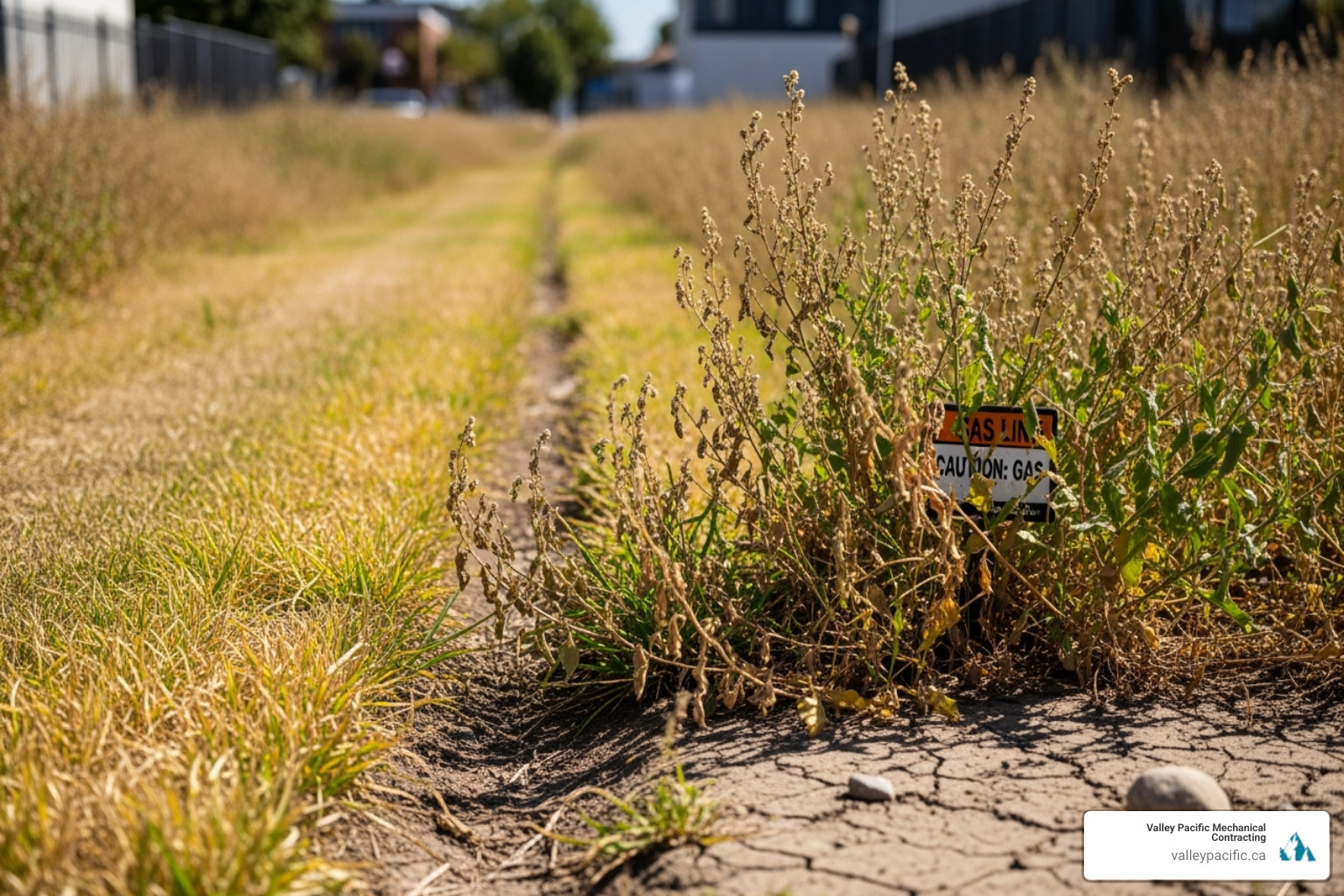
Visible damage to gas lines is an obvious red flag. Dents, corrosion, or any physical damage to your gas meter or visible piping should be reported immediately, even if you don't smell gas.
Physical Symptoms of Gas Exposure
Here's something that catches many people off guard: you might feel the effects of a gas leak before you smell it. While natural gas isn't toxic, it displaces oxygen in the air around you. When your body doesn't get enough oxygen, it lets you know through some pretty uncomfortable symptoms.
Headaches and dizziness are often the first signs, followed by fatigue that seems to come from nowhere. You might experience nausea, irregular breathing, or chest pains. Some people notice memory problems, blurred vision, or difficulty concentrating - almost like a mental fog settling in.
These symptoms are remarkably similar to what you'd experience with carbon monoxide poisoning, since both situations involve oxygen deprivation. Here's the key clue: if these symptoms improve when you leave your home or move away from gas appliances, you might be dealing with an emergency gas leak.
Never ignore these warning signs, especially if multiple family members are experiencing them simultaneously. In severe cases, gas exposure can lead to loss of consciousness or suffocation. If you suspect gas exposure is causing health symptoms, evacuate immediately and seek medical attention after calling for help from a safe location.
Your Immediate Emergency Gas Leak Response Plan
When you suspect an emergency gas leak, your response needs to be swift and methodical. There's no time for second-guessing – every moment counts when dealing with a potentially explosive situation. The key is following a clear plan: evacuate everyone, create ventilation as you leave, and report the emergency from a safe distance.
Think of it like a fire drill, but with even higher stakes. Your goal is simple: get everyone to safety, prevent ignition, and let the professionals handle the rest.
Step 1: Evacuate the Area Immediately
Leave the building right now. This isn't the time to grab your phone charger or check on the stove. As soon as you detect that telltale rotten egg smell or any other signs of a gas leak, your only priority is getting everyone out safely.
Alert others as you move through the building. If you're in an apartment complex or office building, knock on doors and warn your neighbors. In larger buildings, pulling the fire alarm can notify everyone at once and trigger the evacuation procedures that people already know.
Take the stairs, never the elevator. Elevators can trap you if the power goes out, and the electrical components could potentially create a spark. Stairs are always your safest route during any emergency.
Bring your pets with you. They're just as vulnerable to gas exposure as humans, and you won't want to leave them behind or risk going back inside later.
Once you're outside, move to a safe distance – far enough that you can no longer smell the gas. If you can still detect that sulfur odor, you're too close. Keep moving until the air smells normal again.
Step 2: Ventilate, But Don't Linger
As you're making your way out, open doors and windows if you can do so quickly and safely. This natural ventilation helps disperse the gas and reduce the concentration that could lead to an explosion.
The key word here is quickly. Don't spend time opening every window in the house – just get what you can on your way out. Do not go back inside once you've exited, even if you forgot to open a particular window. Your safety is worth more than anything you might have left behind.
Fresh air moving through the space is your friend, but don't risk your life trying to create the perfect cross-breeze.
Step 3: Report the Leak from a Safe Location
Once everyone is safely away from the building, it's time to call for help. Call 911 first – they're equipped to handle any emergency gas leak and will dispatch the right emergency services, including firefighters who are trained for these exact situations.
After you've contacted 911, call your gas utility company. Here in British Columbia, that means calling FortisBC's emergency line. They have specialized equipment and expertise to locate and repair gas leaks safely.
When you call, provide your exact location and describe what you noticed – the smell, any sounds you heard, or visual signs you observed. The more information you can give them, the better they can respond.
Make these calls from a safe distance – never from inside the building or anywhere you can still smell gas. Even your cell phone can create a tiny spark, and when gas is involved, even the smallest ignition source can be dangerous.
This isn't a situation where you wait to see if it gets better. Professional emergency responders and utility workers are available 24/7 for exactly these situations. Let them do what they're trained to do while you focus on keeping everyone safe.
Critical "Don'ts": How to Avoid Igniting a Gas Leak
When you're dealing with a suspected emergency gas leak, what you don't do can literally save your life. Natural gas is incredibly flammable, and it doesn't take much to set it off. Even the tiniest spark - smaller than you might imagine - can trigger an explosion powerful enough to level a home and cause devastating injuries or death.
Think of natural gas like a sleeping giant. It's harmless when contained properly, but when it escapes and accumulates, it becomes incredibly dangerous. Your job is to avoid waking that giant with any kind of spark or ignition source.

[LIST] of Actions to Avoid During a Suspected Emergency Gas Leak
Here are the critical actions you must avoid during an emergency gas leak:
Do not use light switches, phones, or any electronics. This is probably the hardest rule to follow because our instinct is to turn on lights or grab our phones. But electrical switches create tiny arcs when flipped, and even your cell phone can generate static electricity. Whatever lights are on should stay on, and whatever is off must stay off. Yes, this means no garage door openers, computers, or even that innocent-looking doorbell.
Do not smoke, light matches, or create any flame. This might seem obvious, but in stressful situations, people sometimes act on autopilot. Any open flame, even a tiny match or lighter, is like offering a direct invitation for disaster.
Do not start a vehicle parked nearby. Your car's ignition system is designed to create sparks - that's how it works normally. But during a gas leak, that same helpful spark becomes incredibly dangerous. If you suspect an outdoor leak, keep all vehicles parked and turned off.
Do not try to locate the source of the leak yourself. We get it - you want to know where the problem is coming from. But playing detective during a gas emergency puts you at serious risk. You could accidentally create a spark, or expose yourself to dangerous levels of gas. Leave the investigating to the professionals who have the right equipment and training.
Do not attempt to shut off valves on appliances or the main line unless you are trained and it is safe. While it's smart to know where your gas shut-off valve is located for general preparedness, trying to operate it during an active leak can sometimes create more problems. If the valve is located in the danger zone or you're not completely confident about how to operate it safely, wait for the professionals.
Do not re-enter the building until cleared by professionals. No matter how badly you want to grab your wallet, check on something, or turn off an appliance, stay out. Only return when the fire department or your gas utility company has thoroughly inspected the area, confirmed the leak is fixed, and given you the official all-clear.
These aren't just suggestions - they're your lifeline during a gas emergency. Following these "don'ts" eliminates the ignition sources that could turn a manageable situation into a tragedy.
Prevention and Long-Term Gas Safety
The best way to handle an emergency gas leak is to prevent one from happening in the first place. Think of gas safety like maintaining your car - a little attention now saves you from big problems later. With some smart habits and regular check-ups, you can keep your family safe and your home secure.
Regular Appliance and HVAC System Checks
Your gas appliances work hard for you every day, but they need a little TLC to stay safe. Most gas leaks actually start with appliances that haven't been properly maintained, which makes regular inspections your best friend.
Annual professional inspections are like getting a physical for your home's gas systems. We recommend having a certified technician check all your gas-powered equipment - your furnace, water heater, gas stove, and any other gas appliances - at least once a year. These experts know exactly what to look for and can spot potential problems before they become dangerous situations. Our HVAC Preventative Maintenance Tips can help you understand what goes into keeping your systems running safely and efficiently.
Here's something you can check yourself: take a look at your gas stove flames. A healthy gas stove burns with a clean blue flame. If you see orange, yellow, or red flames, that's your stove telling you something's wrong. These colors mean the gas isn't burning completely, which can create carbon monoxide and indicate other safety issues. When you notice unusual flame colors, it's time to call in a professional.
Your furnace also gives you clues about its health. Watch for Signs your furnace needs repair like strange noises, uneven heating, or higher energy bills. These symptoms often point to issues that could affect gas safety.
Don't forget to inspect visible gas lines and connections around your home. Look for any dents, rust, or damage to the pipes and fittings you can see. If something looks off, trust your instincts and have it checked out.
Know Your Home and Prepare for an Emergency Gas Leak
Being prepared isn't about being paranoid - it's about being smart. The more you know about your home's gas system, the better you can protect your family.
Find your main gas shut-off valve before you need it. It's usually located near your gas meter outside your home, and it's one of the most important things to know about your property. While we generally recommend leaving valve operation to professionals during an emergency, knowing where it is can be valuable information to share with emergency responders.
Create a family emergency plan that everyone understands. Designate meeting spots outside your home, make sure everyone knows the evacuation routes, and keep emergency contact numbers handy. Practice your plan occasionally - not to scare anyone, but so everyone feels confident about what to do.
If you're planning any digging projects around your property, always Call 811 before you dig. Underground gas lines run throughout neighborhoods, and hitting one with a shovel or equipment can cause serious leaks and explosions. This free service marks utility lines before you start your project, keeping everyone safe.
In earthquake-prone areas like the Lower Mainland, securing large gas appliances like water heaters to wall studs prevents them from toppling during seismic activity. A fallen water heater can rupture gas lines and create immediate danger.
Installing and Maintaining Safety Detectors
Technology gives us extra eyes and ears to watch for danger, even when we're sleeping or away from home.
Natural gas detectors act like smoke alarms for gas leaks. These devices sound an alarm when they detect liftd levels of natural gas in your home. Consider installing them near gas appliances and in basements where gas might accumulate. They're especially valuable in areas where you might not immediately smell a leak.
Carbon monoxide detectors don't detect natural gas, but they're crucial for overall safety with gas appliances. When gas appliances malfunction, they can produce deadly, odorless carbon monoxide instead of burning cleanly. Install carbon monoxide detectors on every level of your home, especially near sleeping areas where you'd be most vulnerable.

Test your detectors regularly and replace batteries according to the manufacturer's schedule. A detector with a dead battery is like having no detector at all. Set reminders on your phone or mark your calendar - it's too important to leave to memory.
For the safest and most efficient operation of your gas systems, consider Professional installation of HVAC systems and regular maintenance by certified professionals. Proper installation and ongoing care create the foundation for years of safe, reliable service.
Frequently Asked Questions about Gas Leaks
When it comes to emergency gas leak situations, we understand that homeowners often have specific questions about what to expect and how to handle different scenarios. Let's address the most common concerns we hear from families in Mission, Maple Ridge, and Langley.
What is the difference in response for an indoor vs. outdoor gas leak?
While your basic response remains the same for any emergency gas leak - get out, stay out, and call for help - the urgency and specific risks do vary between indoor and outdoor situations.
Indoor gas leaks are your highest priority emergency. Gas builds up quickly in enclosed spaces, creating a much more concentrated and dangerous situation. The risk of explosion or serious health effects increases rapidly when gas can't disperse naturally. You need to evacuate immediately and get everyone out of the building as fast as possible.
Outdoor gas leaks still require serious attention, but they're generally less immediately dangerous because the gas can dissipate into the open air. However, don't let this fool you into thinking they're harmless. Gas from outdoor leaks can seep into basements, crawl spaces, or storm drains. It can also travel along underground utilities and pop up in unexpected places.
For both situations, move to a safe distance where you can no longer smell the gas, avoid any potential ignition sources, and call 911 plus your gas utility company. The key difference is that indoor leaks require immediate evacuation, while outdoor leaks give you a bit more time to safely clear the area.
When is it safe to return to my home after a gas leak?
This is one of the most important questions we get, and the answer is straightforward: wait for the official all-clear from the professionals.
Your nose isn't reliable enough to make this critical safety decision. After being exposed to the mercaptan smell for a while, your sense of smell can become less sensitive to it. You might think the gas has cleared when dangerous levels are still present.
Emergency responders and utility technicians use specialized gas detection equipment that can measure exact concentrations in the air. They'll test multiple areas of your home, confirm that the leak source has been properly repaired, and ensure that any accumulated gas has completely dissipated.
Only after they've completed their safety checks and given you the green light should you re-enter your home. It might feel frustrating to wait, especially if you're worried about pets or belongings inside, but this patience could literally save your life.
Who is responsible for repairing the gas line?
Understanding who handles gas line repairs depends entirely on where the problem is located, and this can affect both your safety response and your wallet.
Your gas utility company takes care of everything from the main gas line in the street up to and including your gas meter. If you smell gas near your meter or notice dead vegetation in your yard along the gas line route, this is typically their responsibility to investigate and repair.
As the homeowner, you're responsible for all the gas piping that runs from your meter into your home and connects to your appliances. This includes the lines feeding your furnace, water heater, gas stove, fireplace, and any other gas-powered equipment inside your house.
When you have an emergency gas leak in your home's internal gas lines, you'll need a qualified, licensed gas technician to handle the repair safely. Our certified team at Valley Pacific Mechanical Contracting has the expertise to diagnose and fix these issues properly. Whether you need furnace repair in Maple Ridge, BC or gas line work anywhere in our service area, we're equipped to restore your home's safety quickly and effectively.
The important thing during any gas emergency is to let the professionals determine who's responsible for what - your immediate job is simply to get everyone to safety and make the necessary calls.
Conclusion: Your Safety Is the Top Priority
When it comes to an emergency gas leak, there's no room for hesitation or guesswork. Every action you take—or don't take—can mean the difference between a manageable situation and a devastating tragedy. The knowledge you've gained here isn't just information; it's your family's lifeline when seconds count.
The three essential steps we've covered form your safety foundation: Get Out, Stay Out, Call Out. These aren't just suggestions—they're your emergency roadmap. Get everyone out immediately, stay away from the area until professionals give the all-clear, and call for help from a safe distance. It's that simple, and it could save your life.
But your responsibility doesn't end with emergency response. The best emergency gas leak is the one that never happens. Regular maintenance of your gas appliances, annual HVAC system inspections, and staying alert to warning signs are your first line of defense. When you smell that distinctive rotten egg odor, hear unusual hissing sounds, or notice dead vegetation near gas lines, you're equipped to act decisively.
You don't have to handle gas-related issues alone. Professional help is available 24/7 for emergencies, and regular maintenance visits can catch problems before they become dangerous. Whether it's a routine inspection or an urgent repair, qualified technicians have the training and equipment to keep your home safe.
At Valley Pacific Mechanical Contracting, we understand that your family's safety comes first. Our certified professionals bring over 30 years of expertise to every call, whether it's routine maintenance or emergency service. We're here when you need us most, serving Mission, Maple Ridge, Langley, Pitt Meadows, and Coquitlam with the reliable, headache-free experience you deserve.
For peace of mind and expert handling of your home's heating and gas appliance systems, trust our certified professionals for all your expert heating and gas line services. Because when it comes to natural gas safety, there's no substitute for professional expertise and prompt, reliable service.
Why Professional Installation Makes All the Difference
Condensing boiler installation requires careful planning and expert execution to achieve the high efficiency these modern systems are designed for. Unlike older boiler types, condensing boilers capture heat from water vapor in exhaust gases, achieving efficiency ratings of 90% or higher - but only when properly installed.
Key Installation Requirements for Condensing Boilers:
- Direct venting system - PVC or CPVC pipes for cooler exhaust gases
- Condensate drain - Acidic water byproduct needs proper disposal
- Specific clearances - 18" front access, proper wall mounting requirements
- Low return temperatures - System must operate below 55°C for optimal condensing
- Professional assessment - Gas, electrical, and plumbing connections require certified technicians
Starting January 1, 2025, all commercial boilers in apartment and condo buildings must have an efficiency rating of 90% or higher, making condensing boilers the new standard. This shift reflects their superior performance - they can reduce operating costs by up to a third compared to older gas boilers.
The installation process involves more than just connecting pipes. Condensing boilers create acidic condensate that needs neutralization, require specific venting materials due to cooler exhaust temperatures, and must be sized and controlled properly to maintain their condensing mode of operation.
A proper installation by qualified technicians ensures your new boiler operates at peak efficiency, prevents costly callbacks, and maintains manufacturer warranties. The complexity of gas, electrical, and plumbing connections - combined with strict building codes - makes professional installation essential for both safety and performance.
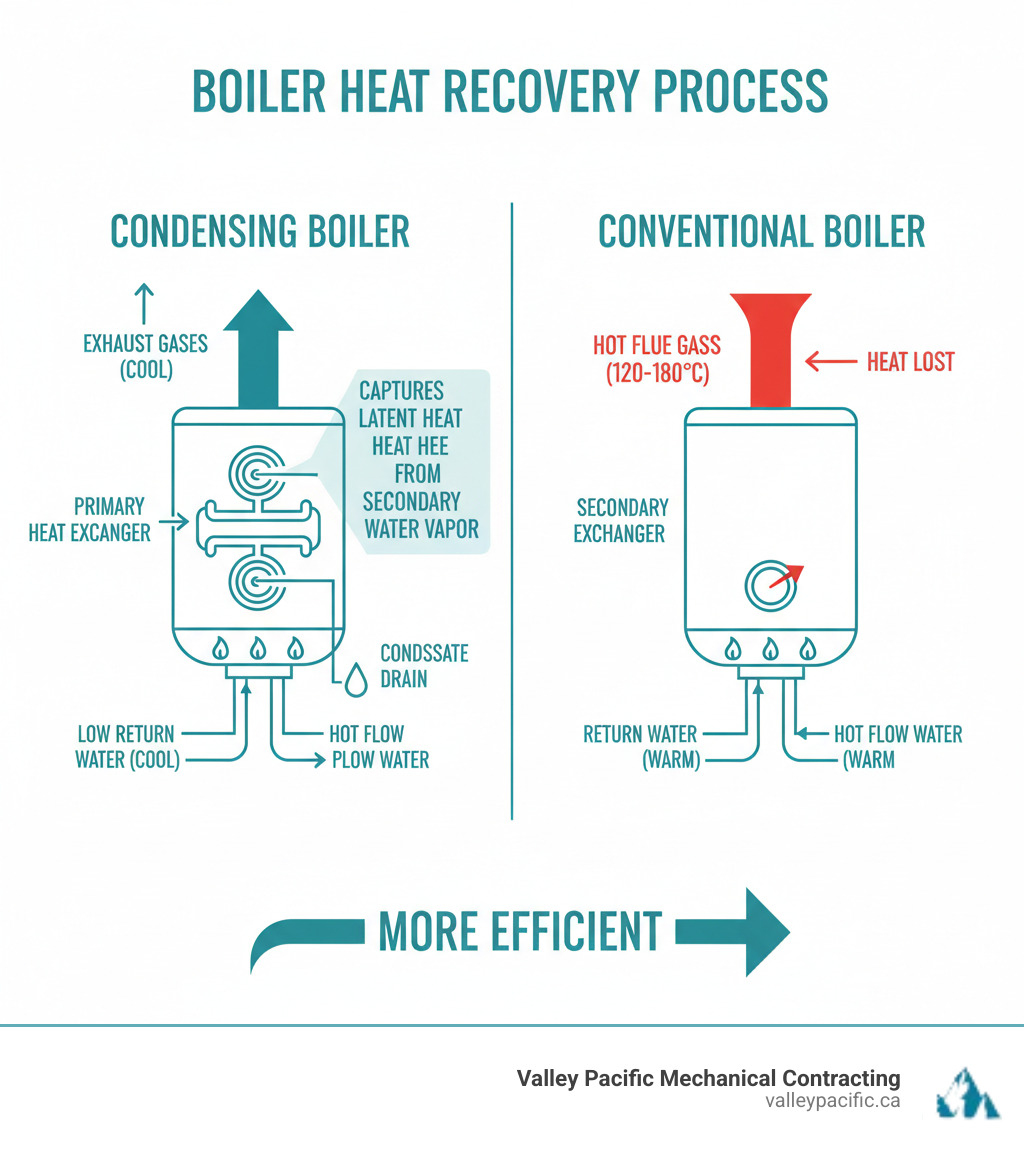
Quick Condensing boiler installation terms:
Understanding Condensing vs. Non-Condensing Boilers
Understanding the difference between condensing and non-condensing boilers is simple: one captures valuable heat that the other wastes.
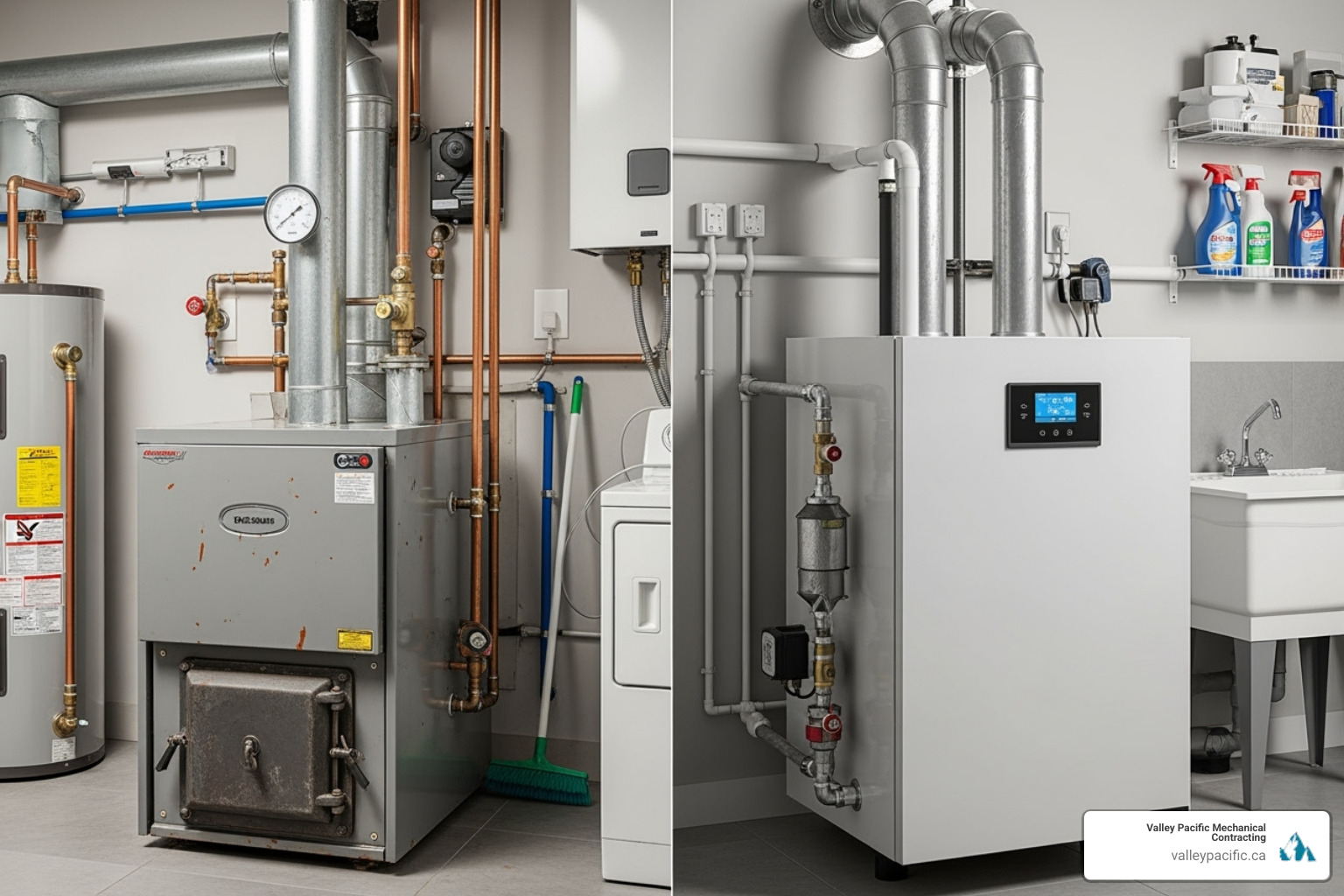
Traditional non-condensing boilers burn fuel to heat water and send hot exhaust gases straight up the chimney, losing valuable heat energy. These older systems typically achieve 70-85% efficiency, meaning up to 30% of your heating costs are wasted. Their hot exhaust requires heavy-duty steel venting.
Condensing boiler installation uses a smarter approach. These systems capture heat from exhaust gases by cooling them until the water vapor inside condenses back into liquid, releasing even more heat. This recovery process allows them to achieve 90% efficiency or higher. Their cooler exhaust permits the use of flexible venting materials like PVC, and their compact, often wall-mounted design offers more placement options.
Here's how they stack up:
| Feature | Non-Condensing Boilers | Condensing Boilers |
|---|---|---|
| Efficiency (AFUE) | 70-85% | 90-99% |
| Venting | High-temperature (steel) chimney/flue | Low-temperature (PVC, CPVC, PP, SS) direct vent, often through wall or roof |
| Condensate Drain | Not required | Required for acidic liquid byproduct |
| Size/Footprint | Typically larger, floor-standing | Often compact, wall-mounted |
How Condensing Boilers Achieve Superior Efficiency
The key is latent heat recovery. When fuel burns, it creates hot exhaust containing water vapor. Old boilers waste this vapor and its heat up the flue. Condensing boilers use a secondary heat exchanger to cool the exhaust gases below their dew point, causing the water vapor to condense. This process releases latent heat, which is used to pre-heat the return water before it reaches the main burner. The burner then works less, boosting efficiency.
As a result, many condensing boilers earn the ENERGY STAR® label with ratings of 95% AFUE or higher. To achieve this, return water temperatures must be kept low—ideally 55°C (131°F) or below—to ensure condensation occurs.
The New Standard for Boiler Installations
The industry is shifting to high-efficiency systems. Starting January 1, 2025, new regulations mandate that commercial boilers in apartment and condo buildings achieve 90% efficiency or higher, effectively phasing out atmospheric boilers for these uses. This move is both environmentally and economically sound, as condensing boilers reduce carbon footprints and can cut heating costs by up to a third.
For property owners, this means planning ahead. Preparing your home for a new boiler is key to meeting these new standards. Modern condensing boilers not only meet but exceed these regulations, providing reliable, efficient heating.
Key Pre-Installation Considerations
A successful condensing boiler installation begins long before the unit is unpacked. A comprehensive site assessment is crucial for identifying and solving potential challenges upfront. We examine your current heating system, measure available space, evaluate venting routes, and assess combustion air quality to ensure seamless integration with your existing plumbing and electrical systems. This planning phase is detailed in our professional boiler replacement process guide.
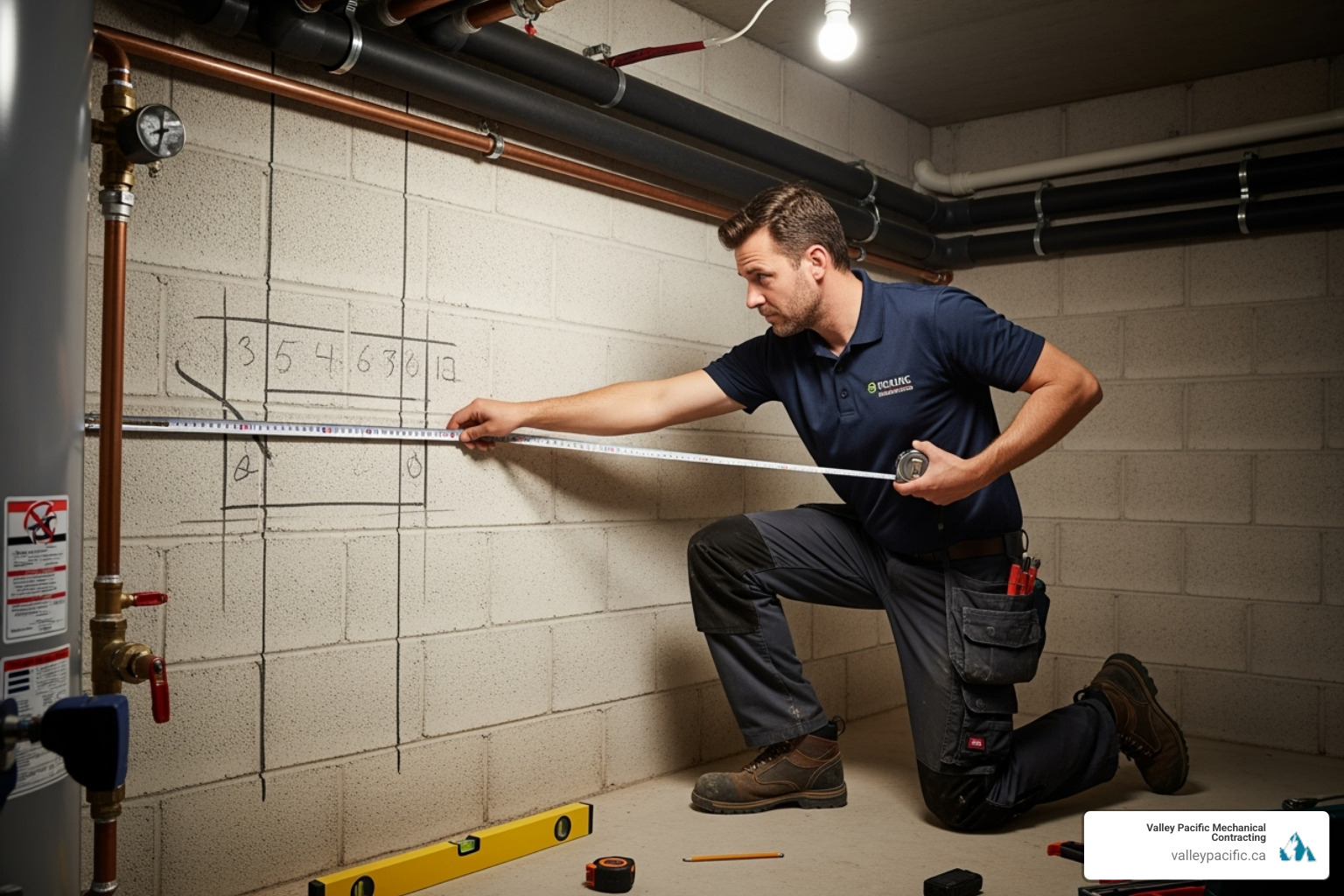
Choosing the Right Location
Finding the right spot for your new boiler involves balancing several factors. Though compact and often wall-mounted, these units require specific clearances for safety and service: typically 18 inches in front, 14 inches at the top, 12 inches at the bottom, and 2 inches on the sides. Many can be installed with zero rear clearance, offering flexibility.
Location restrictions are key. Boilers must be installed indoors. In a garage, they must be mounted at least 18 inches above the floor and protected from vehicles. Closet installations are possible but require proper ventilation. We also consider noise, placing units away from bedrooms for better comfort.
A crucial, often-overlooked factor is proximity to a suitable drain. Convenient drain access for the acidic condensate simplifies installation and reduces costs.
Venting and Combustion Air Requirements
Condensing boilers offer flexible venting options. Unlike traditional boilers needing a chimney, they use a versatile direct vent system. As Category IV appliances, they have positive vent pressure and cool exhaust, allowing for affordable venting materials like PVC, CPVC, polypropylene, or stainless steel.
The direct vent system is a sealed design that draws combustion air from outside and exhausts flue gases through dedicated pipes, improving safety. This also allows for flexible placement, with vent lengths up to 150 feet possible.
Clean combustion air is critical. Sensitive condensing boilers can be damaged by airborne contaminants. We route intake pipes away from sources like:
- Laundry products (bleach, detergents, fabric softeners)
- Paint thinners and solvents
- Cleaning chemicals
- Adhesives and glues
- Antifreeze
- Permanent wave solutions or pool chemicals
Our technicians ensure your system is positioned to receive clean air for optimal performance and longevity.
The Professional Condensing Boiler Installation Process
After planning, the physical condensing boiler installation begins. This complex process requires qualified technicians to manage intricate gas, water, and electrical connections, plus specialized venting and drainage. A single mistake can cause safety hazards or reduce efficiency. Our systematic approach follows proven procedures to ensure your new boiler operates safely and effectively from day one.
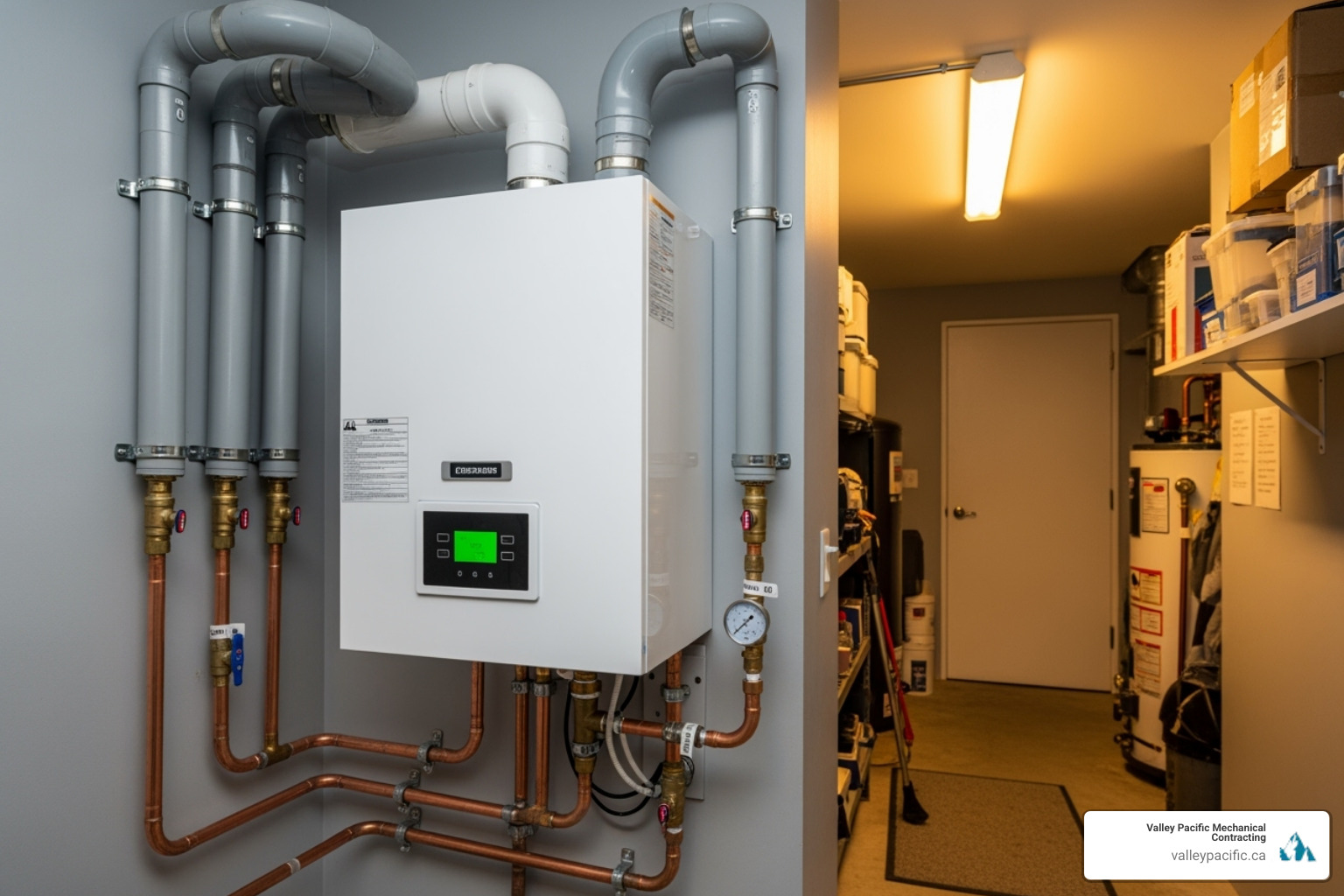
Key Steps in a Condensing Boiler Installation
A successful condensing boiler installation involves several key steps:
- System Flushing: We thoroughly flush the existing heating system to remove sediment and debris that could damage the new boiler's heat exchanger.
- Piping Configurations: We connect the boiler to the water loops, using primary/secondary loops or direct piping to ensure proper flow rates for both the central heating (CH) loop and domestic hot water (DHW) loop.
- Water Connections: We link the boiler to the water supply and heating system, installing backflow preventers and expansion tanks.
- Gas Supply Connection: The gas line is correctly sized and connected according to code, followed by rigorous leak testing.
- Electrical Wiring: We connect the boiler to its power supply and all low-voltage controls like thermostats and sensors.
- Venting System Installation: Approved PVC or CPVC pipes are routed for air intake and exhaust per manufacturer and local codes.
- Condensate Drainage & Testing: We set up the drainage system and perform comprehensive tests to ensure safe, correct operation. Our team provides expert boiler installation in Maple Ridge BC and throughout the Lower Mainland.
Managing Condensate: A Critical Step
Condensing boilers produce condensate, a slightly acidic liquid (pH 3-5) that requires careful management to prevent corrosion of drain pipes.
We install a condensate drain using acid-resistant PVC, directing it to a floor drain or sink. For disposal into municipal sewers, we often add neutralization kits that use alkaline materials to raise the condensate's pH to a safe level. If gravity drainage isn't an option, a condensate pump is installed.
We also focus on preventing frozen condensate lines, which can shut down your boiler. This is done by routing pipes through heated spaces, insulating them, or using heat trace cables. If you notice a leak, our guide on boiler leaking water can help.
Essential Safety Components
Every condensing boiler installation includes essential safety components to protect your home and family.
- Pressure Relief Valves (PRV): Automatically release excess pressure if it exceeds safe limits (typically 30 psi), preventing damage to the boiler and pipes.
- Expansion Tanks: Accommodate the expansion of water as it heats, maintaining safe system pressure.
- Low Water Cut-Off: Shuts down the boiler if water levels drop too low, protecting the heat exchanger from overheating.
- Backflow Preventers: Ensure that heating system water cannot contaminate your potable drinking water supply.
- Air Elimination Devices: Continuously remove trapped air from the system to prevent noise, improve efficiency, and reduce corrosion.
Promptly addressing boiler pressure issues is crucial for maintaining safety and performance.
Optimizing and Maintaining Your New Boiler
A new condensing boiler installation is just the beginning. Proper settings and regular care are needed to maintain the efficiency and comfort you invested in. Modern condensing boilers are reliable when maintained, and our boiler repair Langley guide can help with any issues.
Achieving Peak Performance with Proper Controls
A condensing boiler's efficiency depends on keeping the return water temperature low (ideally below 55°C or 131°F) to enable condensation. We use several controls to achieve this:
- Outdoor Reset Controls: Automatically adjust the boiler's operating temperature based on the weather, running cooler on mild days and hotter in deep winter for optimal efficiency.
- Modulating Burners: Instead of a simple on/off cycle, these burners adjust their output to precisely match your home's heating demand, preventing energy waste and temperature swings.
- Smart Thermostats: Learn your routines to optimize heating schedules, pre-heating your home when needed and saving energy when you're away.
Ensuring Longevity with Water Quality and Maintenance
Proper water quality is crucial for the boiler's heat exchanger. Poor chemistry can cause scale buildup or corrosion, reducing efficiency and lifespan. We monitor water chemistry (hardness, pH 6.5-8.5, minerals) for both the central heating (CH) and domestic hot water (DHW) loops, recommending scale prevention where needed.
Annual professional servicing is essential. Our technicians inspect combustion, clean the heat exchanger, and test safety devices to catch small issues early.
Modern boilers have built-in freeze protection, activating the pump and burner at low temperatures to prevent damage. We also ensure the rest of your system is protected with proper insulation. If you notice pressure changes, our guide on what to do when boiler pressure drops can help.
Frequently Asked Questions about Condensing Boiler Installation
After thirty years of helping Lower Mainland homeowners upgrade their heating systems, we've heard just about every question you can imagine about condensing boiler installation. Here are the ones that come up most often during our consultations.
Is a combi-boiler the same as a condensing boiler?
No, they are different concepts that often overlap.
- "Condensing" describes how a boiler works: it uses technology to capture extra heat from exhaust for 90%+ efficiency.
- "Combi" (combination) describes what a boiler does: it provides both central heating and instant hot water from a single unit.
While most new combi-boilers are condensing, not all condensing boilers are combis. Other options include:
- System boilers: Work with a separate hot water tank, ideal for homes with high hot water demand.
- Regular (heat-only) boilers: A traditional setup that heats radiators and uses a separate hot water cylinder.
We help you choose the right type for your home's needs. If you have issues, see our guide on troubleshooting no hot water from boiler.
How does high elevation affect a condensing boiler installation?
Higher elevations in the Lower Mainland present unique challenges for a condensing boiler installation. The air is thinner at altitude, meaning there is less oxygen available for combustion. This disrupts the required fuel-to-air ratio for safe and efficient operation.
To compensate, manufacturers provide de-rating instructions that require reducing the boiler's maximum output. For example, a boiler's capacity might be reduced by 10% at 3,000 feet. This precise adjustment must be performed by a qualified technician familiar with high-elevation installations to ensure your boiler runs safely and efficiently.
What happens if my old boiler is removed from a shared chimney?
This is a common situation in older buildings with shared chimney systems. Removing an old boiler changes the venting dynamics for the remaining appliances.
We first properly seal the opening left by the old boiler. More importantly, a professional must inspect the other appliances (like a water heater) still using the chimney to ensure they continue to vent safely with proper draft. While your new condensing boiler will have its own modern, dedicated direct-vent system, we ensure the shared chimney remains safe for any other connected appliances.
Conclusion
The shift towards high-efficiency condensing boilers represents more than just a technological upgrade—it's a smart investment in your comfort, your wallet, and our environment. With their remarkable ability to achieve efficiencies of 90% or higher, these systems deliver substantial benefits that you'll notice from day one: lower energy bills, a reduced carbon footprint, and that reliable, consistent warmth that makes a house feel like home.
The upcoming regulations requiring 90% efficiency for commercial installations starting in 2025 aren't just bureaucratic red tape—they're recognition that condensing boilers have become the gold standard for heating. When regulations catch up to technology, you know you're making the right choice.
But here's the thing: all those impressive efficiency numbers and environmental benefits only matter if your condensing boiler installation is done right. This isn't a weekend DIY project or a job for just any contractor. From understanding the intricate dance of latent heat recovery to properly managing that acidic condensate, from ensuring your venting meets strict safety codes to calibrating controls for peak performance—every detail matters.
That's where the difference between a good installation and a great one becomes crystal clear. A poorly installed condensing boiler might still heat your home, but it won't deliver the efficiency you paid for, and it certainly won't give you the peace of mind you deserve.
At Valley Pacific Mechanical Contracting, we've built our reputation on one simple promise: providing a truly headache-free experience for all your heating needs. With over 30 years of hands-on expertise serving the Lower Mainland and our 24/7 emergency service, our certified technicians approach every condensing boiler installation with the precision and care it demands. We don't just install equipment—we create heating solutions that work flawlessly for years to come.
Whether you're in Langley, Maple Ridge, Mission, Pitt Meadows, Coquitlam, or anywhere across the Lower Mainland, we're here to ensure your investment in high-efficiency heating pays dividends in comfort and savings. Because when it comes to keeping your family warm, you shouldn't have to worry about whether it was done right.
Ready to experience the difference that professional installation makes? For expert condensing boiler installation in Langley and the surrounding Lower Mainland, contact our team today!
Why Reliable Boiler Heating Matters in Langley, BC
When your home's heating system fails during the colder months, finding quality boiler repair langley bc service is essential. A warm, comfortable home isn't a luxury—it's a necessity.
Quick Answer for Boiler Repair in Langley, BC:
- Signs you need repair: No heat, strange noises, leaking water, low pressure, pilot light issues
- Common services: Leak detection, pressure adjustments, thermostat repair, valve replacement
- When to call: Immediately for gas smells or major leaks; same-day for no heat
- Professional help: Look for gas-ticketed, licensed technicians with local Langley experience
Nothing disrupts your routine like a cold shower or a chilly house on a rainy Langley morning. Boilers typically last around 15 years, but even well-maintained systems can have issues.
Whether you're facing inconsistent heating, unusual sounds, or a complete breakdown, this guide will help you steer boiler repair in Langley, from spotting warning signs to choosing the right professional.
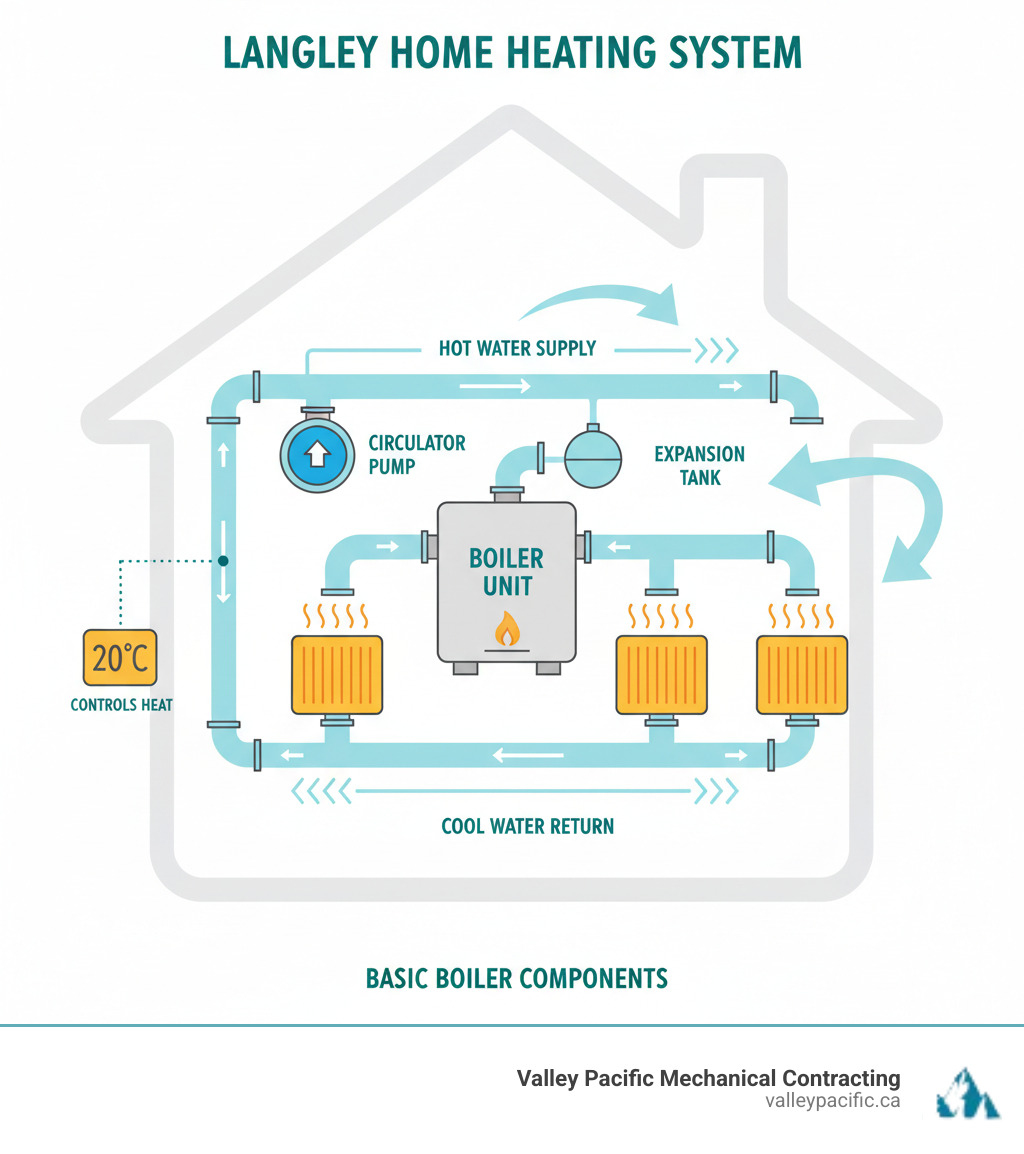
Boiler repair langley bc word list:
Telltale Signs Your Boiler Needs Repair
Your boiler provides clear warning signs when it needs attention. Recognizing them early can help you avoid a complete breakdown on the coldest day of the year.
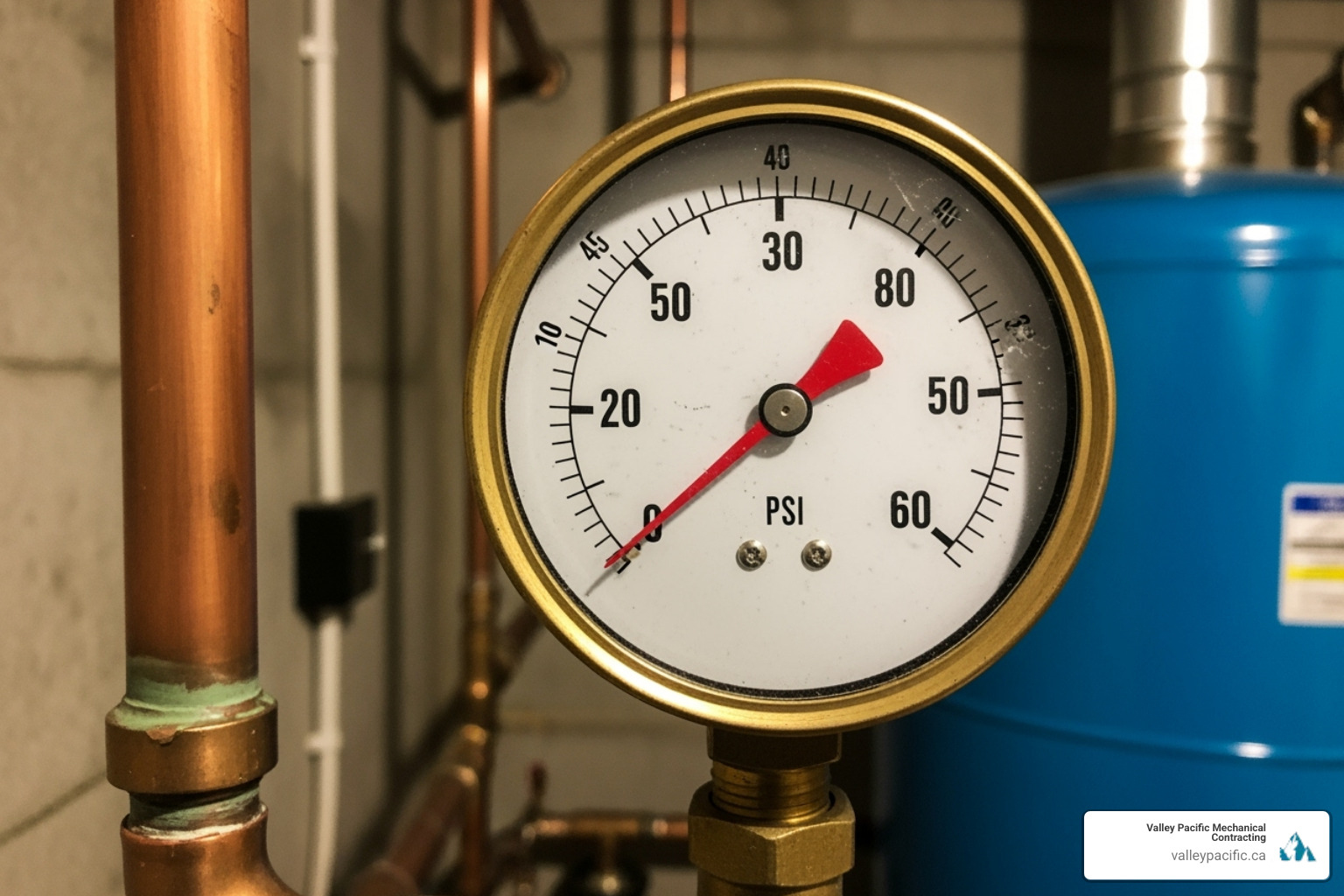
No heat or hot water is the most obvious red flag. If the thermostat is up but nothing happens, your boiler is struggling. This could be a thermostat issue, a circulation pump failure, or air in the pipes. For hot water specifics, see our guide on Troubleshooting No Hot Water From Boiler.
Strange noises like banging, kettling, whistling, or gurgling are never good. They can indicate limescale buildup, trapped air, low water pressure, or a broken pump.
Water leaking from your boiler requires immediate attention to prevent costly water damage. Even small drips can signal internal corrosion or faulty seals. Our article on Boiler Leaking Water explains what different leaks mean.
Low pressure on the gauge (typically below 1 bar) often points to a leak or a faulty expansion vessel. Understanding Boiler Pressure Issues and knowing What to Do When Boiler Pressure Drops is key.
Pilot light problems in older models, like the light going out or turning yellow, indicate a fault. This could be a thermocouple issue, as detailed in our Boiler Pilot Light guide.
Unusual smells, especially a sulfur or "rotten egg" odor, signal a potential gas leak. This is an emergency; leave your home immediately and call for boiler repair langley bc services from a safe location.
Frequent cycling (turning on and off in short bursts) wastes energy and stresses your system. It may be caused by an oversized boiler, a faulty thermostat, or circulation problems.
Catching these signs early is crucial. A boiler is a complex system, not a DIY project. When you notice these warnings, call certified boiler repair langley bc professionals.
Comprehensive Boiler Repair Langley BC Services
When your boiler fails on a chilly Langley morning, you need a complete solution. Our boiler repair langley bc services are designed to get your home warm and comfortable again, headache-free.
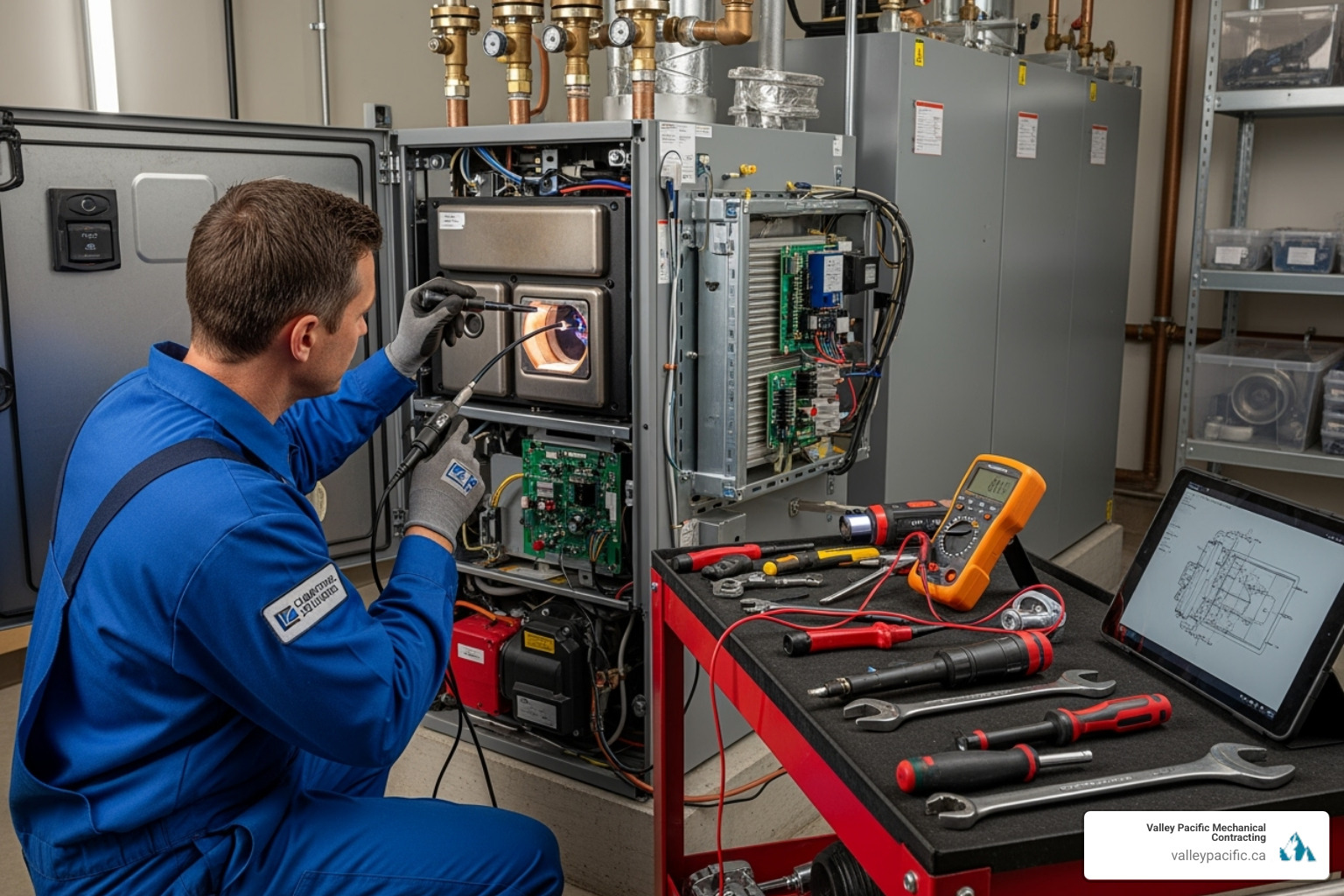
We combine expert diagnostics, precise component repair, and thorough system testing to do the job right the first time. The best part? We stock our trucks to complete 93% of repairs on the spot, so you aren't left waiting for parts.
Diagnosing and Fixing Common Boiler Problems
Our experienced technicians can diagnose any issue, from a mysterious drip to a complete shutdown.
- Leak detection and pipework repair: We use advanced techniques to find and fix even the most elusive leaks, preventing water damage.
- Valve replacement: We replace worn-out zone, control, and other critical valves that manage water flow and pressure.
- Pressure adjustments: We don't just adjust the gauge; we find the root cause of pressure drops. If this is a recurring issue, see our guide on What to Do When Boiler Pressure Drops.
- Thermostat repair: We diagnose and repair or replace faulty thermostats to ensure your home maintains a consistent temperature.
- Control module service: We troubleshoot your boiler's electronic "brain" to resolve erratic behavior or shutdowns.
- Circulator pump replacement: If your radiators are cold while the boiler is running, the circulator pump may have failed. We can replace it to restore heat distribution.
Servicing All Major Boiler Brands and Types
We service all major brands and types found in Langley homes. Whether you have a gas boiler, electric boiler, or a high-efficiency model, our technicians have the expertise. We understand the unique characteristics of combi-boilers (heating and hot water) and system boilers (with a separate hot water cylinder). Our expertise covers Viessmann, Navien, Super Hot, Slant Fin, Laars, Weil McLain, Burnham, and more. Learn more about Viessmann boilers and why we recommend quality brands.
What to Expect During a Professional boiler repair langley bc Service Call
Our service process is transparent and stress-free.
- Initial Consultation: We listen to the details of the problem to come prepared.
- Safety Inspection: We check for immediate hazards first—your safety is non-negotiable.
- System Diagnosis: Our technicians systematically check components to find the root cause.
- Clear Explanation: We explain the problem and your options in plain English before starting work.
- Efficient Repair: We work quickly and precisely, using quality replacement parts.
- Post-Repair Testing: We test all functions to ensure your boiler is operating safely and efficiently.
- Tidy Workspace: We clean up completely, respecting your home.
The result is prompt, expert service with fair pricing and no surprises—the headache-free experience we promise.
The Crucial Role of Boiler Maintenance
Most boiler breakdowns are preventable. Imagine your boiler failing in the middle of a Langley January—a scenario easily avoided with regular maintenance.
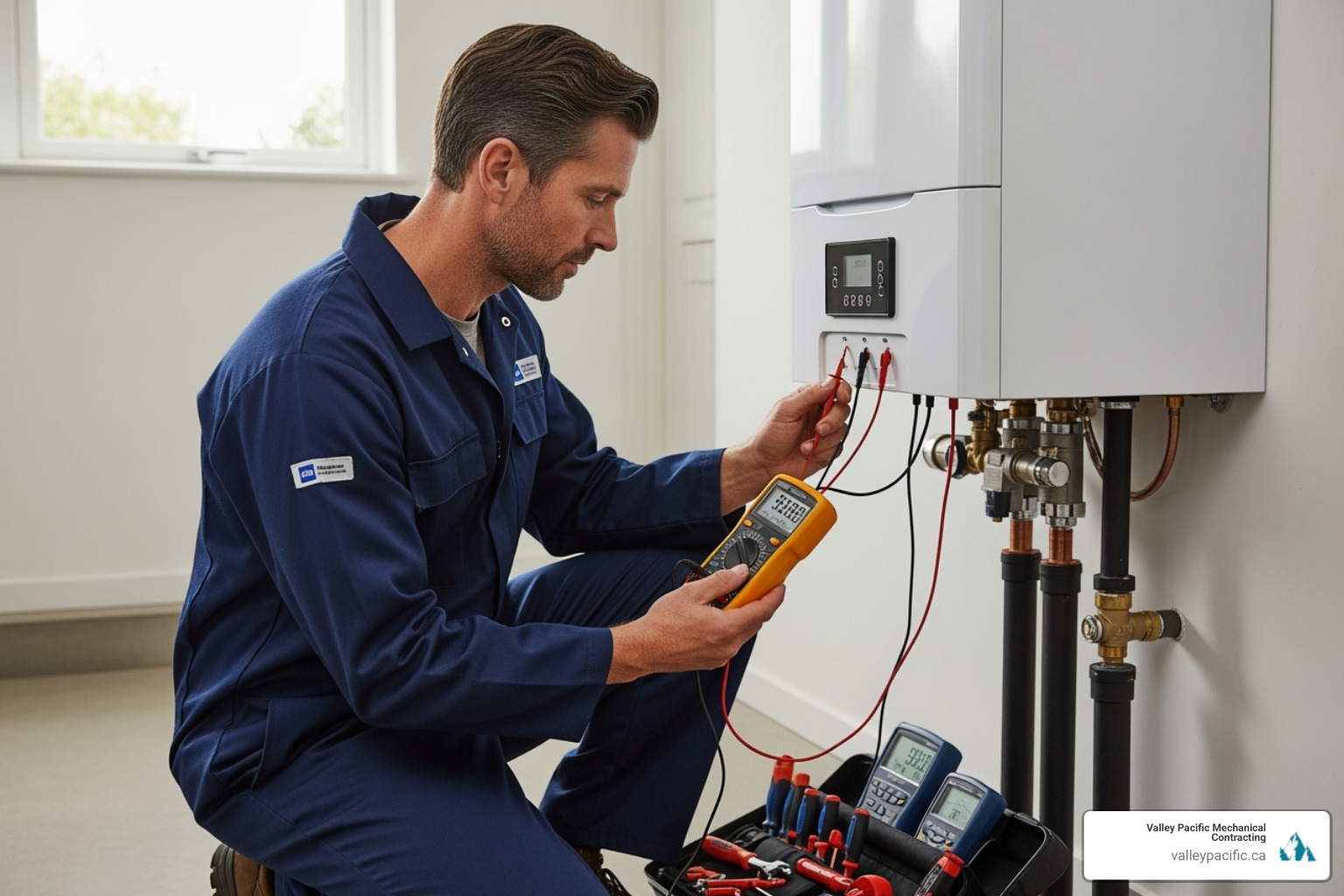
Think of it like an oil change for your car; your boiler works hard and needs routine attention to run flawlessly. Prevention is better than cure, saving you from emergency boiler repair langley bc calls, keeping your system safe, and saving you money.
Why Regular Maintenance is a Smart Investment
Annual boiler maintenance is a financial decision that pays dividends.
- Safety First: A technician checks for hazards like carbon monoxide leaks, which are invisible and odorless, making professional inspections essential for your family's wellbeing.
- Lower Energy Bills: A well-tuned boiler runs more efficiently, using less energy to heat your home.
- Fewer Breakdowns: Technicians spot worn components and minor issues before they cause a system failure, saving you from stress and emergency calls.
- Longer Lifespan: Regular maintenance can help your boiler last well beyond its typical 15-year lifespan, protecting your investment.
- Warranty Protection: Many manufacturers require annual professional maintenance to keep your warranty valid. For local services, see our guide on HVAC Maintenance Langley.
What's Included in an Annual Boiler Tune-Up?
Our comprehensive tune-up is a complete physical for your heating system. Key steps include:
- Thorough Visual Inspection: We examine the entire system for signs of wear, damage, or corrosion.
- Leak and Corrosion Checks: We inspect all pipes, valves, and fittings for leaks and rust.
- Safety Control Testing: We test the pressure relief valve, high-limit switches, and automatic shut-offs.
- Burner and Heat Exchanger Cleaning: We remove buildup that harms efficiency and inspect the heat exchanger for cracks.
- Flue and Ventilation Check: We ensure combustion gases are venting properly and the boiler has adequate air supply.
- System Pressure and Water Quality Test: We confirm the boiler is operating within the correct pressure range and check for sediment.
- Final Calibration: We calibrate the thermostat and inspect the circulator pump to ensure all parts work in harmony.
Ask about FortisBC maintenance rebates to help offset the cost, making this smart investment even more affordable.
Repair or Replace? Making the Right Decision for Your Langley Home
Should you invest in another boiler repair langley bc service, or is it time to replace your system? It's a tough decision involving your budget and your family's comfort. After three decades in the business, we've helped countless Langley families with this exact dilemma. Here are the key factors to help you make the smartest choice.
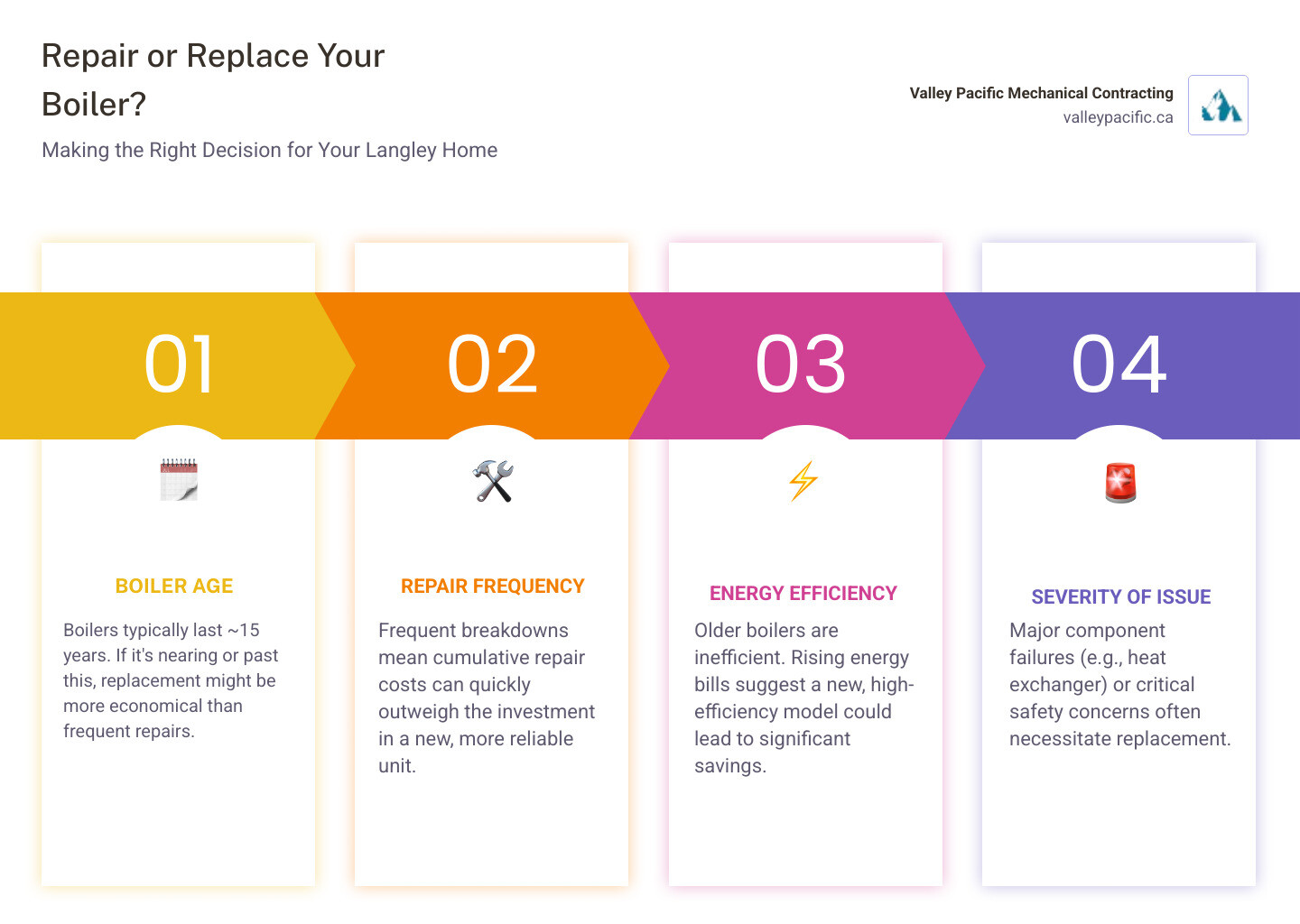
Key Factors to Consider
- Boiler's Age: Most boilers last about 15 years. If your system is older and needs a major repair, replacement often makes more financial sense (the 15-year rule).
- Frequency of Repairs: Are you calling for repairs every few months? If repair bills are piling up, you're essentially making payments on a new boiler without getting one.
- Rising Energy Costs: Older boilers are less efficient. If your heating bills are climbing despite consistent usage, your boiler is likely working too hard.
- Major Component Failure: A failed heat exchanger is a costly repair, often approaching the price of a new unit. In this case, investing in a new system with a full warranty is the better option.
- Safety Concerns: Major water leaks or potential carbon monoxide issues should always lead to replacement. Your family's safety is not worth the risk.
The Benefits of a New Boiler Installation
Replacing your old system is an investment in your home's future.
- Long-Term Energy Savings: Modern high-efficiency boilers can significantly slash your heating bills.
- Improved Reliability and Peace of Mind: A new system means no more worrying if your heat will work on a cold night.
- Improved Home Comfort: Enjoy more consistent heating throughout your house, eliminating frustrating hot and cold spots.
- Modern Smart Controls: Integrate your new boiler with smart thermostats for precise control and additional energy savings.
- Dual Functionality: Many new combi-boilers handle both home heating and hot water in one efficient unit, saving space and money.
If you're considering replacement, our guide to Boiler Installation Langley BC and our Professional Boiler Replacement Process can help you explore your options.
Finding a Reputable Boiler Repair Company in Langley
When your heating fails, you need a trustworthy partner. The right boiler repair langley bc professional combines local expertise, proper certifications, and a solid reputation.
Why Choose a Local and Certified boiler repair langley bc Expert?
Choosing a local expert offers significant advantages. Local knowledge means we understand Langley's climate and building codes, while faster response times get us to your door sooner in an emergency. Our reputation is built right here, ensuring community accountability on every job.
For your safety, always choose gas-ticketed technicians certified by Technical Safety BC. Our company is also fully licensed and insured with $5,000,000 liability coverage to protect your home. With over 30 years of expertise, we deliver top-notch work and build lasting customer relationships.
Emergency Boiler Repair: What You Need to Know
Boiler emergencies don't keep business hours, which is why 24/7 availability is essential. Know when to make an emergency call:
- No Heat in Winter: This is always an emergency. Your family's health and comfort depend on a warm home.
- Suspected Gas Leak: If you smell sulfur or rotten eggs, evacuate immediately. Do not use phones or flip switches inside. From a safe location, call your gas utility and then a certified technician.
- Major Water Leaks: A significant leak can cause extensive property damage. If possible, turn off your water supply safely and call for emergency service right away.
We offer 24/7 emergency service because we know these problems can't wait. For more on our services, visit our HVAC Services Langley page.
Frequently Asked Questions about Boiler Repair
When your boiler acts up, questions are natural. With over 30 years in the business, we've compiled answers to the most common questions homeowners ask about boiler repair langley bc.
How often should my boiler be serviced?
Annual service is recommended, ideally in late summer or early fall before the heating season begins. This ensures safety, efficiency, and helps prevent unexpected breakdowns, giving you peace of mind all winter.
Can a boiler be used to heat my home's water too?
Yes, modern combination (combi) boilers are designed for both central heating and domestic hot water. They heat water on demand, eliminating the need for a separate hot water tank and saving space and energy.
What does a sulfur or rotten egg smell near my boiler mean?
This indicates a potential natural gas leak and is a serious emergency. The smell is added to gas to make leaks detectable. You must act immediately:
- Get everyone out of the house.
- Do not use phones, flip light switches, or do anything that could create a spark.
- From a safe location, call your gas utility provider first, then call us for 24/7 emergency boiler repair langley bc service.
Gas leaks require immediate professional attention. Your safety is the top priority.
Your Partner for a Warm and Comfortable Home
When you're dealing with no heat, strange noises, or a surprise cold shower, a boiler problem can quickly disrupt your life. You don't have to face these challenges alone.
Professional boiler repair langley bc service is the key to turning a major headache into a minor inconvenience. From sudden system breakdowns to routine maintenance and complete system upgrades, having the right team on your side ensures your home stays warm and safe.
At Valley Pacific Mechanical, we understand that your boiler is what keeps your family comfortable. With over 30 years of expertise in Langley and the Lower Mainland, our certified and licensed technicians don't just fix problems—they provide peace of mind. We deliver a truly "headache-free" experience with clear communication and repairs done right the first time.
Heating emergencies don't wait, which is why we offer 24/7 emergency service. We're here when you need us most, day or night. Our goal is to build lasting, trusting relationships with every customer.
Don't let a faulty boiler leave you in the cold. Contact us for all your boiler repair and service needs and experience the difference our expertise makes.
Why Your Home's Air Quality Depends on Proper Filter Maintenance
Furnace filter replacement service is crucial for your family's health and your HVAC system's efficiency. Many homeowners don't realize that indoor air can be up to 5 times more polluted than outdoor air, according to the Environmental Protection Agency.
What a furnace filter replacement service includes:
- Professional assessment of your current filter
- Correct filter selection for your home's needs
- Proper installation for optimal airflow
- System inspection to identify potential issues
- Scheduled reminders for future replacements
Your furnace filter is the first line of defense against dust, pollen, pet dander, and other airborne particles. When it clogs with debris, your HVAC system works harder, energy bills can increase by 5-15%, and your home's air quality deteriorates.
Regular filter replacement isn't just about equipment maintenance—it's about creating a healthier living environment.
A dirty filter forces your furnace to work overtime, increasing heating costs and reducing its lifespan. Professional services ensure you get the right filter, proper installation, and peace of mind.
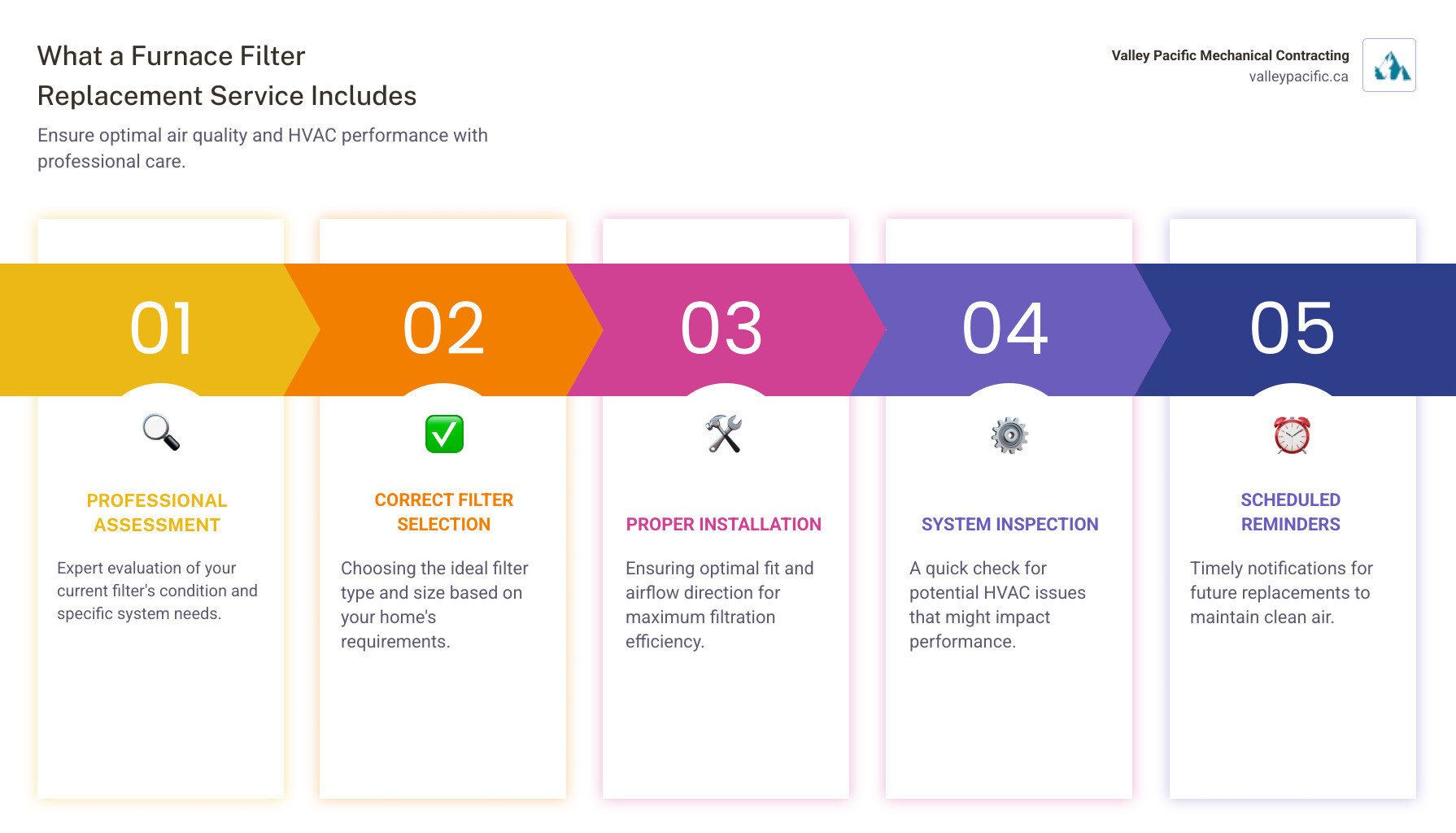
Common furnace filter replacement service vocab:
The Unsung Hero: Understanding Your Furnace Filter
Your furnace filter works quietly behind the scenes, protecting both your family's health and your HVAC investment. This humble component is crucial for keeping your home comfortable and your air clean.
As air is pulled into your HVAC system, it passes through the filter, which acts as a protective barrier. It catches unwanted particles before they can circulate through your home.
Protecting your HVAC system is one of the filter's most important jobs. Without it, dust and debris would coat sensitive internal parts like the blower motor and heat exchanger. This buildup forces your system to work harder, leading to inefficiency and breakdowns.
Your filter is also your first line of defense against indoor air pollution. The Environmental Protection Agency has found that indoor air can be up to five times more polluted than outdoor air, a sobering fact given how much time we spend inside.
By trapping pollutants like dust, pet dander, and pollen, your filter helps create a healthier environment, especially for those with allergies or respiratory issues. Every time your system runs, it's cleaning your home's air.
A proper furnace filter replacement service ensures you have the right filter for your needs, leading to better air quality, lower energy bills, and fewer surprise repairs.
For more insights on home comfort, check out our guide on HVAC Services for Home Comfort. You can also explore information on indoor air quality from the Environmental Protection Agency.
The bottom line: Your furnace filter is a small part that plays a huge role in keeping your family breathing easy and your HVAC system running smoothly.
Telltale Signs: When to Replace Your Furnace Filter
When your furnace filter is overdue for a change, your home will give you clear signals. Recognizing these signs early can prevent bigger, more expensive problems.
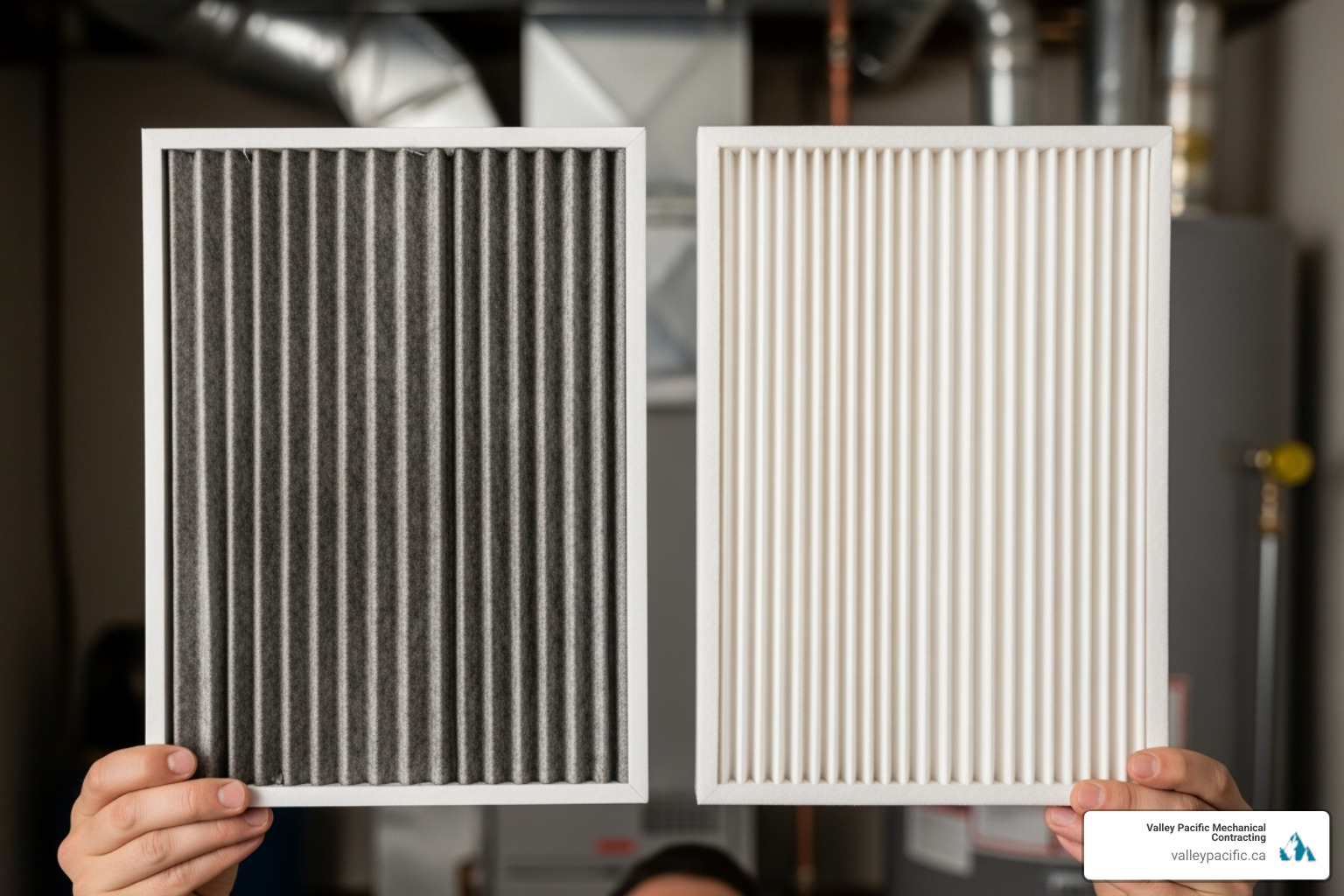
- More Frequent Dusting: If you notice dust accumulating faster than usual, your filter is likely full and no longer trapping airborne particles.
- Reduced Airflow: Hold your hand up to a vent. If the airflow feels weak, a clogged filter is probably restricting it, forcing your system to work overtime.
- Unpleasant Odors: A musty smell when your system turns on can indicate that mold and bacteria are growing on a dirty filter.
- Higher Energy Bills: A clogged filter makes your furnace work harder, which can increase energy use by 5-15% and lead to a surprise on your utility bill.
- System Working Harder: If your furnace runs in long cycles or turns on and off frequently (short cycling), a dirty filter could be the cause. This is inefficient and hard on your equipment, as explained in our article on Furnace Short Cycling: Signs and Solutions.
- Overheating: In extreme cases, a severely restricted filter can cause your furnace to overheat and trigger a safety shutoff. This is a clear sign you need a furnace filter replacement service.
- Visual Inspection: The simplest check is to pull out the filter. If it's gray, caked with debris, or you can't see light through it, it's time for a change.
Catching these warning signs early can prevent the more serious issues outlined in our Signs Your HVAC System May Fail Soon article.
A Guide to Furnace Filter Types and Ratings
Choosing the right furnace filter is simpler once you understand the basics of types and ratings.

- Disposable Fiberglass Filters: These are the most basic, budget-friendly option. They protect your furnace from large debris like dust and lint but do little to improve air quality.
- Pleated Filters: A significant step up, these filters use pleated paper or polyester to create more surface area for trapping smaller particles like pollen, pet dander, and mold spores.
- Washable/Reusable Filters: An eco-friendly choice, these have a permanent frame and a filter you can wash and reuse. They require regular cleaning and must be completely dry before reinstallation to prevent mold.
- Electrostatic Filters: These use self-charging fibers to attract and trap airborne particles like a magnet. They offer good filtration without severely restricting airflow.
- HEPA Filters: High-Efficiency Particulate Air filters capture 99.97% of particles 0.3 microns or larger. However, their density can restrict airflow and may require HVAC system modifications.
Decoding MERV: What the Rating Means for Your Home
Every filter has a MERV rating (Minimum Efficiency Reporting Value) from 1 to 16, which indicates its effectiveness at capturing particles.
- MERV 1-4: Basic protection, catching large particles like carpet fibers.
- MERV 5-8: Good filtration for most homes, trapping smaller particles like mold spores and pet dander. A MERV 8 filter is often the sweet spot between effectiveness and airflow.
- MERV 9-12: High-efficiency filters that capture even smaller particles, great for improving general air quality.
- MERV 13-16: Superior filtration, removing microscopic particles like bacteria, viruses, and smoke. A MERV 13 removes about 75% of allergenic particles down to 0.3 microns.
It's crucial to balance filtration with airflow. A higher MERV rating means better filtration but also more airflow resistance, which can strain your furnace. The key is finding the right balance for your system.
Choosing the Right Filter for Your Household
- Standard Homes: A MERV 8 pleated filter is usually sufficient for homes without pets or allergy sufferers.
- Homes with Pets: A MERV 11 or 13 filter is recommended to capture the tiny dander particles that pets shed.
- Households with Allergies/Asthma: A MERV 13 or higher filter can dramatically reduce airborne allergens like pollen and mold spores.
- Special Situations: For homes with smokers or in high-pollution areas, a MERV 13 or 16 filter may be necessary. Always consult a professional to ensure your system can handle the increased resistance.
Before upgrading, check your furnace manufacturer's recommendations. A professional furnace filter replacement service can help you choose the best option. For more guidance, see our guide: How Do I Choose the Right Furnace for My Home in Pitt Meadows, BC.
The Benefits of a Professional Furnace Filter Replacement Service
While changing a furnace filter seems simple, a professional furnace filter replacement service offers benefits that go beyond a basic swap.
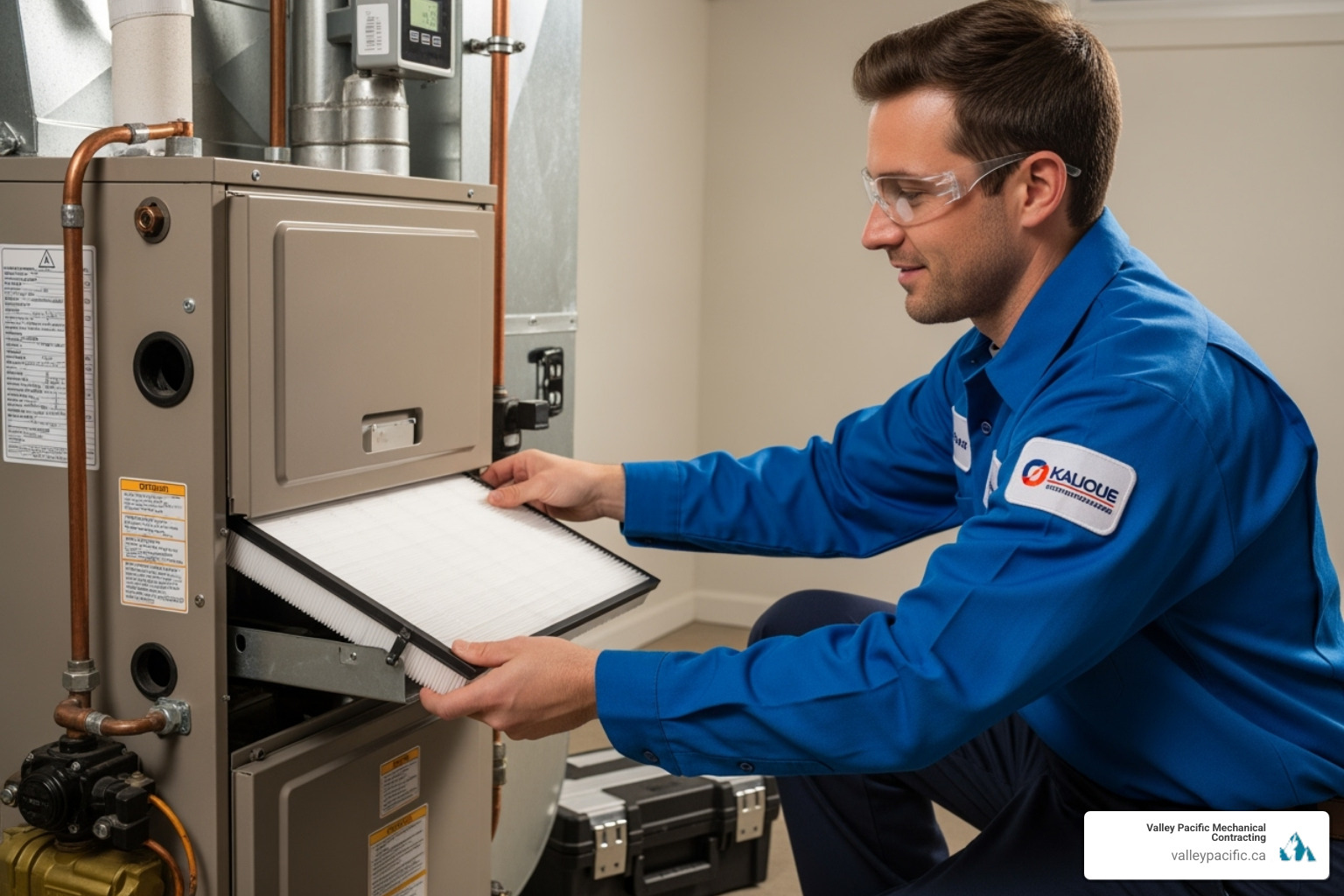
- Convenience and Consistency: Life gets busy, and it's easy to forget this task. Scheduled service means you never have to remember dates or make trips to the hardware store.
- Correct Filter Size and Type: A technician takes the guesswork out of choosing the right filter, matching it to your system and your home's specific needs (e.g., pets, allergies).
- Opportunity for System Inspection: While changing the filter, a trained eye can spot early signs of trouble, like a small leak or an unusual motor sound. This proactive approach, detailed in our HVAC Preventative Maintenance Tips, can save you from expensive emergency repairs.
- Optimized Airflow and Efficiency: Professional installation ensures the filter is seated correctly and facing the right direction, maximizing its effectiveness.
- Peace of Mind: You can rest easy knowing your family is breathing cleaner air and your HVAC system is running as efficiently as possible.
DIY vs. Hiring a Furnace Filter Replacement Service
Here's a quick comparison of doing it yourself versus hiring a professional:
| Factor | DIY Furnace Filter Replacement | Professional Furnace Filter Replacement Service |
|---|---|---|
| Time | Quick task, but requires shopping trips and remembering | Completely hands-off – we handle everything |
| Expertise | You're on your own figuring out filter types and ratings | Expert guidance ensures perfect match every time |
| Consistency | Easy to forget or postpone when life gets hectic | Scheduled service keeps you on track automatically |
| System Check | Limited to what you can see and remember to look for | Professional eye catches potential issues early |
| Long-term Benefits | Saves labor costs upfront | Extends system life and prevents costly repairs |
The DIY route works if you're diligent, but for a "set it and forget it" approach, professional service is invaluable.
What to Expect from Our Service
When you schedule a service with us, you get a truly headache-free experience. Many clients integrate it into our comprehensive Maintenance Plan.
- Assessment: Our technician assesses your current filter and discusses any household changes (new pets, allergies) to select the perfect replacement.
- Safe Replacement: We turn off the furnace, locate and remove the old filter, and install the new one, ensuring correct airflow direction and a secure fit.
- System Check: We restart your system to check for proper operation and airflow, catching small issues before they become big problems.
- Recommendations: We'll share any recommendations to improve your comfort and system efficiency.
This thorough process ensures your furnace filter replacement is done right every time.
Frequently Asked Questions about Furnace Filter Replacement
Here are answers to the most common questions we hear about furnace filter replacement service.
How often should I really change my furnace filter?
The general rule is every 30 to 90 days, but the ideal frequency depends on several factors:
- Filter Type: Thin, 1-inch filters often need changing every 30-60 days, while thicker 4- or 5-inch pleated filters can last 3-6 months.
- Pets: Homes with pets that shed require more frequent changes, typically every 30-45 days, to handle the extra dander.
- Allergies/Asthma: If anyone in your home has respiratory issues, changing the filter every 30-60 days can significantly improve comfort, especially during peak pollen seasons.
- Local Air Quality: Living near construction, busy roads, or areas with wildfire smoke means your filter works harder and will need to be replaced more often.
Our best advice is to check your filter monthly. If you can't see light through it, it's time for a change.
Can a dirty filter damage my furnace?
Yes, a dirty filter is one of the most common and preventable causes of furnace damage. Here's how:
- Restricted Airflow: A clogged filter forces your furnace to work much harder to pull in air. This strains components, especially the blower motor, leading to premature wear and failure. See the warning signs in our guide on Furnace Blower Motor Repair: Signs.
- Overheating: Without proper airflow to dissipate heat, your furnace can overheat. This triggers safety switches that shut the system down, leaving you without heat.
- Financial Impact: A struggling system uses more energy, increasing bills by 5-15%. It also leads to expensive repairs and can shorten the lifespan of your entire furnace.
Regular filter replacement is the simplest way to prevent these costly problems and protect your investment.
Is a higher MERV rating always better?
Not necessarily. While a higher MERV rating means the filter can trap smaller particles, it's not always the best choice.
- The Catch: High-MERV filters (MERV 13+) are much denser. This density creates significant airflow resistance, forcing your furnace to work harder.
- System Strain: Many HVAC systems, especially older ones, are not designed to handle the resistance of a high-MERV filter. Using one can lead to the same problems as a dirty filter: an overworked blower motor, reduced airflow, and potential damage.
- The Sweet Spot: For most homes, a filter with a MERV rating between 8 and 11 provides an excellent balance of air filtration and healthy airflow. A MERV 13 may be appropriate for severe allergies, but only if your system can handle it.
A professional can assess your HVAC system and air quality needs to recommend the right MERV rating for your home, ensuring clean air without compromising your equipment's health.
Breathe Cleaner Air with Expert Help
Caring for your furnace filter is an investment in your family's health and your home's comfort. We've seen how this small component works tirelessly to protect your HVAC system and the air you breathe.
The benefits of a proper furnace filter replacement service are clear: better health from cleaner air, improved system efficiency, and significant energy savings. Most importantly, consistent and correct filter replacement helps prevent unexpected and costly breakdowns.
Regular filter maintenance is a small investment that can save you hundreds or even thousands in future repair bills. It's a simple action with big results.
For homeowners in Langley, Maple Ridge, and Mission, Valley Pacific Mechanical Contracting provides headache-free HVAC solutions. With over 30 years of expertise and our Daikin Comfort Promise, we take the guesswork out of furnace maintenance.
Whether you need help with a long-neglected filter, want advice on the right filter type, or are considering a system upgrade, we're here to help. Don't let a dirty filter compromise your comfort or strain your HVAC system.
Ready to breathe easier? Contact our team today for a system check-up, expert filter guidance, or to explore our high-efficiency furnace installation in Langley, BC options. Your lungs and your wallet will thank you.
Your Ultimate Guide to Air Conditioning Service in Langley
AC service Langley is essential for staying comfortable during the Fraser Valley's hot summers. Whether you need routine maintenance, emergency repairs, or a new system, choosing the right provider impacts your home's comfort and energy efficiency.
What AC Service Langley Includes:
- Emergency repairs for units that won't turn on or cool properly
- Annual maintenance to prevent breakdowns during heatwaves
- System installations for central AC and ductless mini-splits
- Tune-ups to improve efficiency and lower energy bills
- 24/7 support from local, licensed technicians
Langley's climate puts serious demands on AC systems. Hot summers mean your air conditioner works harder than in many other regions. Without proper maintenance, even newer units can struggle, leading to higher energy bills and uncomfortable indoor temperatures.
Local AC service providers understand these unique challenges. Their expertise is crucial when your AC breaks down on the hottest day of the year. The key is being proactive. Regular maintenance prevents most major breakdowns, while knowing the warning signs helps you address problems before they become expensive emergencies.
Recognizing the Telltale Signs: When Your AC Needs Repair
When your AC isn't working, it's usually sending warning signs. Recognizing them early can save you from bigger headaches.
The most common red flags include inadequate cooling and weak airflow from your vents. If your AC runs constantly but can't cool your home, something is wrong. Other signs are unexplained rising energy bills and high humidity levels that leave your home feeling clammy. These issues tend to get worse, especially during Langley's heat waves. If you're unsure about the severity, our guide can help: How Do I Know If My AC Needs Immediate Repair or Just Maintenance.
Strange Noises and Smells
Unusual sounds or odors are your AC's call for professional AC service Langley.
- Grinding sounds often indicate worn-out motor bearings, which can lead to motor failure.
- Squealing or screeching can point to fan belt or fan motor problems.
- Constant clicking may signal electrical or thermostat issues.
- Musty odors usually mean mold or mildew is growing in your system, affecting your air quality.
- Burnt smells are a serious concern, suggesting electrical problems. Turn off your AC immediately and call for help.
- Chemical smells can signal a refrigerant leak that needs professional attention.
Don't let these warning signs become expensive emergencies. Our article on Addressing AC Foul Odours offers more insight.
Visible AC Problems
Sometimes, your AC shows you the problem directly.
- Water leaks around your unit are a common issue. Puddles near indoor components often mean a clogged condensate drain line, which can lead to water damage and mold. Our Troubleshooting AC Water Leaking guide can help you understand the cause.
- Ice or frost on the coils is a serious sign that your system isn't absorbing heat properly. This could be due to low refrigerant, a clogged filter, or a fan issue. If you see ice, turn the unit off and call a professional. Learn more in our guide, Why Is My AC Unit Freezing Up.
- Outdoor unit issues like a non-spinning fan or visible damage require a professional diagnosis. While you can clear away debris yourself, mechanical or electrical problems need an expert.
The Power of Prevention: AC Maintenance in the Fraser Valley
In the Fraser Valley, where temperatures can spike unexpectedly, preventive AC maintenance is key. AC service Langley isn't just about fixing problems—it's about stopping them before they start. Regular maintenance is crucial, especially given Langley's humid summers, which put extra strain on your system.
Preventive care helps you avoid mid-heatwave breakdowns, saves money through improved efficiency, and extends your system's lifespan. A well-maintained AC runs more efficiently, lowering utility bills and delaying the need for a costly replacement. If you're already facing issues in extreme heat, our guide on AC Not Cooling During Heatwaves can help.
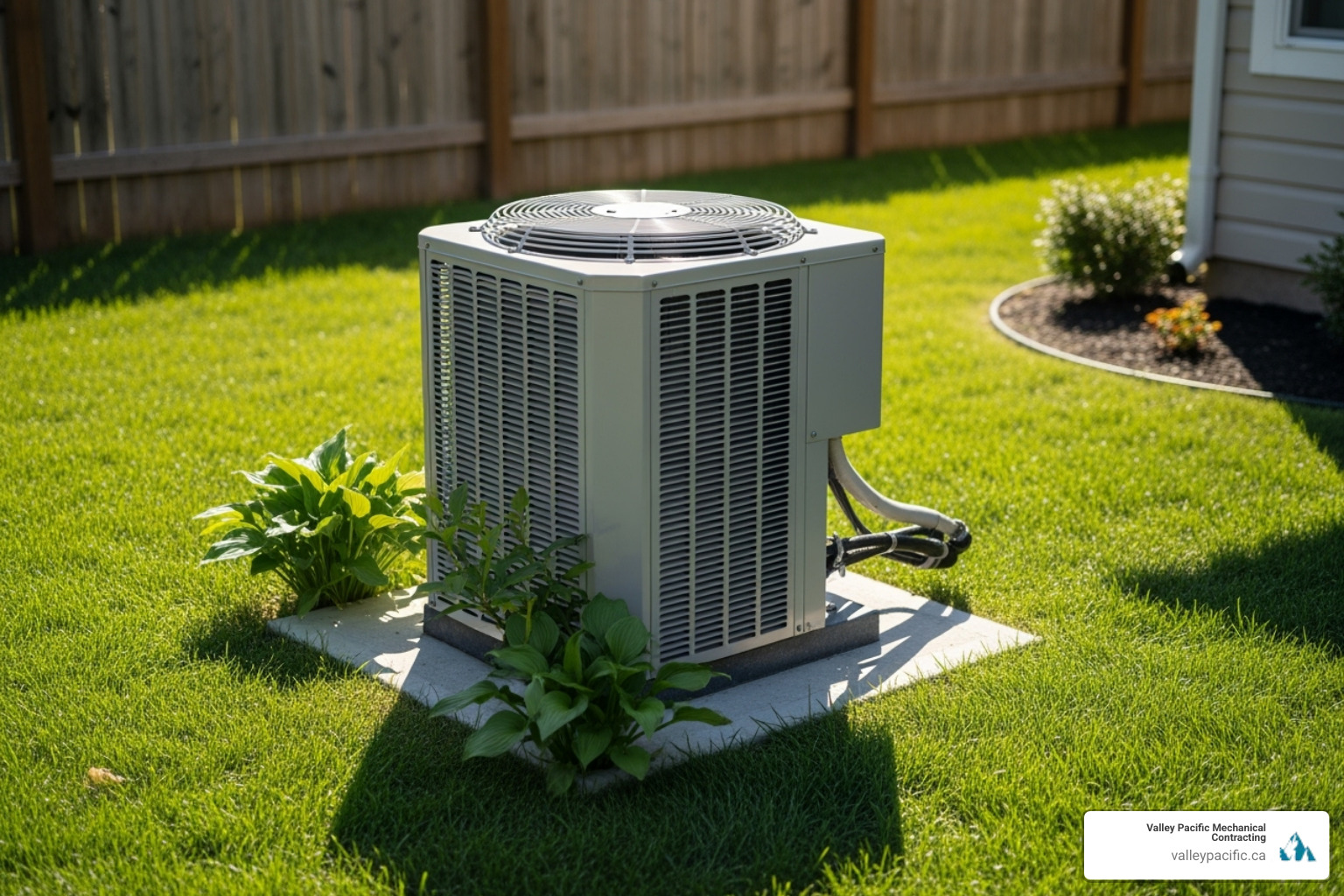
DIY Maintenance Homeowners Can Do
While professional service is essential, a few simple DIY tasks can improve your AC's performance between visits.
- Change or clean your air filters every one to three months. A dirty filter restricts airflow, forcing your system to work harder.
- Keep your outdoor unit clear of leaves, grass, and debris. Ensure at least two feet of clear space around the unit for proper airflow.
- Check your thermostat settings to ensure it's on "cool" and the fan is set to "auto" for best efficiency.
- Ensure all vents are open and unblocked by furniture or curtains to maintain proper airflow.
For more tips, see our guide on HVAC Preventative Maintenance Tips.
Why Professional Tune-Ups Are Essential
DIY maintenance is helpful, but it can't replace a professional tune-up. Our technicians perform a comprehensive system inspection to spot potential issues early.
Key professional tasks include:
- Cleaning coils and fins: Dirty coils prevent efficient heat transfer. We clean them thoroughly without causing damage.
- Checking refrigerant levels: Low refrigerant indicates a leak and can damage your compressor. We can find and repair leaks.
- Inspecting electrical components: We tighten connections and check for worn wiring to ensure safe operation.
- Ensuring optimal performance and safety: We calibrate the thermostat, test motors, and verify safety controls are working correctly.
A professional tune-up is an investment in your home's comfort, helping your AC run efficiently and reliably through Langley's hottest days.
Your Guide to Professional AC Service Langley
Finding the right professional for AC service Langley is crucial for a worry-free experience. A reliable provider offers local expertise, 24/7 emergency services, and service guarantees, changing a stressful breakdown into a smooth resolution. Technicians familiar with Langley's climate can diagnose issues more effectively. Knowing help is a phone call away, especially during a heatwave, provides significant peace of mind. For a look at available services, you can explore local HVAC services.
How to Choose the Right Provider for AC Service Langley
When selecting a provider, focus on these key indicators of quality:
- Experience and Licensing: Look for companies with years of experience serving the community. Ensure they are fully licensed and insured for your protection.
- Customer Reviews and Reputation: Positive reviews reveal a company's commitment to punctuality, communication, and quality work. You can also check their Better Business Bureau (BBB) rating to verify their reputation.
- Local Knowledge: Technicians who understand Langley's building codes and weather patterns provide more targeted solutions.
- Transparent Communication: A good technician explains the problem and your options clearly, without technical jargon.
Common Systems Covered by AC Service Langley
Professional technicians are equipped to service all modern cooling solutions.
- Central Air Conditioners: Ideal for homes with existing ductwork, these systems provide efficient whole-home cooling.
- Ductless Mini-Split Systems: A flexible and efficient option for homes without ducts, offering zoned cooling.
- Heat Pumps: These versatile systems provide both heating and cooling, making them a popular choice for year-round comfort. Our Heat Pump Service Langley Guide has more details.
- System Integration with Furnaces: Many homes can add central AC by integrating it with an existing furnace and ductwork.
Whether you need maintenance or a repair, professionals can handle your specific system. Learn more about common issues on our AC repair in Langley page.
Repair or Replace? Making the Smart Choice for Your Home
Deciding whether to repair or replace your AC is a major decision for any homeowner. It involves balancing short-term costs with long-term benefits like energy efficiency and reliability. The age of your unit is a primary factor; systems over 10-15 years old are often less efficient and more prone to failure than modern units.
Here's a quick comparison to guide your AC service Langley decision:
| Factor | Repair | Replace |
|---|---|---|
| Age of Unit | Best for units under 10 years old | Recommended for units 10-15+ years old |
| Cost | Lower upfront cost | Higher upfront investment |
| Efficiency | Maintains existing (often lower) efficiency | Significant energy efficiency improvement |
| Warranty | Short-term on the specific repair | Full manufacturer's warranty |
| Refrigerant | May use older, expensive R-22 | Uses modern, eco-friendly refrigerants |
A common guideline is the "50% rule": if a repair costs more than half the price of a new system, replacement is usually the more financially sound choice, especially considering the improved efficiency and warranty of a new unit.
Key Signs You Need a New AC Installation
Your AC will often show clear signs that it's time for a replacement.
- Age: If your unit is over 10-15 years old, its technology is outdated and less efficient.
- Frequent Repairs: If you're calling for service multiple times a season, the costs can add up quickly, indicating a failing system.
- R-22 Refrigerant: Older systems using R-22 refrigerant are expensive to repair due to the phase-out of this substance.
- Poor Performance: Inconsistent cooling or hot spots in your home suggest the system can no longer meet your needs.
- Rising Energy Bills: An inefficient AC consumes more power to do the same job, increasing your monthly costs.
Our guide on the Signs You Need a New AC Installation provides more detail.
Features to Look for in a New, Energy-Efficient AC
When replacing your AC, look for modern features that improve comfort and reduce operating costs.
- High SEER Ratings: The Seasonal Energy Efficiency Ratio (SEER) measures efficiency. Look for systems with a SEER rating of 16 or higher for optimal performance and lower utility bills.
- Variable-Speed Technology: Unlike single-speed systems, variable-speed units adjust their output to match your home's cooling needs, providing more consistent temperatures, better humidity control, and quieter operation.
- Smart Thermostat Compatibility: Integrate your AC with a smart thermostat for automated scheduling, remote control, and energy usage reports.
- Proper System Sizing: An improperly sized unit will operate inefficiently. A professional load calculation is essential to ensure your new system is perfectly matched to your home. Learn more about Why AC Sizing Matters for Installation.
We offer systems backed by the Daikin Comfort Promise, known for reliability and efficiency. For installation services, visit our AC Installation Langley BC page.
Frequently Asked Questions about AC Service in Langley
Here are answers to some of the most common questions we receive about AC service Langley.
How often should I have my AC serviced?
We recommend servicing your AC annually. A pre-season tune-up in the spring is ideal to ensure your system is clean, efficient, and ready for summer. Annual service prevents breakdowns during heatwaves, improves efficiency to lower your energy bills, and catches small issues before they become expensive repairs.
What is the main benefit of choosing a local Langley HVAC company?
Choosing a local provider offers several key advantages:
- Faster response times: Local technicians can get to you quickly, especially for emergencies.
- Familiarity with local climate challenges: We understand how Langley's humidity and temperature swings affect AC systems.
- Community accountability: As a local business, our reputation is built on serving our neighbors well.
- Knowledge of regional building codes: We ensure all work is compliant and safe.
Can I add air conditioning to my home if it only has a furnace?
Yes, it is entirely possible to add AC to a home with only a furnace.
If your home has existing ductwork, a central air conditioning unit can often be integrated with your furnace's blower system. If you don't have ductwork, ductless mini-split systems are an excellent, efficient alternative. A professional assessment is required to determine the best solution for your home's layout and cooling needs. We can help you decide between central AC and ductless options.
Ensure Your Comfort with Expert AC Service
When summer heat arrives in Langley, your home should be a cool refuge. This guide has covered the essentials of AC service Langley, from recognizing warning signs to deciding between repair and replacement. Strange noises, smells, or leaks are your AC's call for help.
Proactive maintenance is the best way to prevent breakdowns, manage energy bills, and extend your system's lifespan. While DIY tasks help, they don't replace a professional tune-up. When choosing a provider, local expertise is key. At Valley Pacific Mechanical Contracting, our 30+ years of experience means we understand Langley's climate and your cooling needs. We are committed to a headache-free experience, offering 24/7 emergency service and the Daikin Comfort Promise on our installations.
Don't wait for a breakdown. Investing in a qualified expert for your AC service is an investment in your comfort and peace of mind.
Ready to stay cool all summer? Schedule your professional AC service in Langley today and let our experienced team handle your home comfort needs.
Why Langley Homeowners Are Choosing Heat Pumps for Year-Round Comfort
Langley heat pump installation is rapidly becoming the smart choice for homeowners seeking efficient, year-round heating and cooling from a single, integrated system. If you're considering an upgrade, partner with a trusted local expert. With over 30 years of experience serving the Lower Mainland, Valley Pacific Mechanical Contracting offers the expertise and reliability you need, backed by the Daikin Comfort Promise for total peace of mind.
Here's a quick overview of what makes a heat pump installation in Langley so appealing:
Significant Government Rebates: Homeowners can take advantage of substantial financial incentives to make the switch more affordable. Key programs include:
- The CleanBC Better Homes Energy Savings Program, which can provide significant funding.
- Rebates for switching from fossil fuel systems (like natural gas, oil, or propane) to an electric heat pump.
- Potential municipal top-ups that add even more savings.These programs are designed to help British Columbians reduce their energy consumption and carbon footprint. For the latest details on eligibility and amounts, it's a good idea to check with local utility providers like FortisBC.
Quick and Professional Installation: For most homes, a complete heat pump installation can be completed in just one to two days, especially if you have existing ductwork. The complexity of the system and any necessary modifications can affect the timeline, but a professional team ensures a smooth and efficient process.
If you're tired of managing separate heating and cooling systems—or dealing with the high energy bills from an aging furnace—a heat pump is the ideal solution. These innovative systems function like a two-way air conditioner. They cleverly pull heat from the outside air to warm your home in the winter and reverse the process to efficiently cool it during the summer.
The moderate climate in Langley is perfectly suited for heat pump technology. Unlike colder regions that may require more robust backup systems, Langley's mild winters allow modern heat pumps to operate at peak efficiency for most of the year. This can lead to a reduction in your energy bills by up to 50% while providing consistent, comfortable temperatures day in and day out. With government rebates potentially covering a large portion of the installation costs, there has never been a better time to upgrade.
As one local homeowner shared: "It's wonderful knowing we’ve reduced our carbon footprint while enjoying a more efficient heating system. Plus, we’re heating specific parts of our house much better than before."
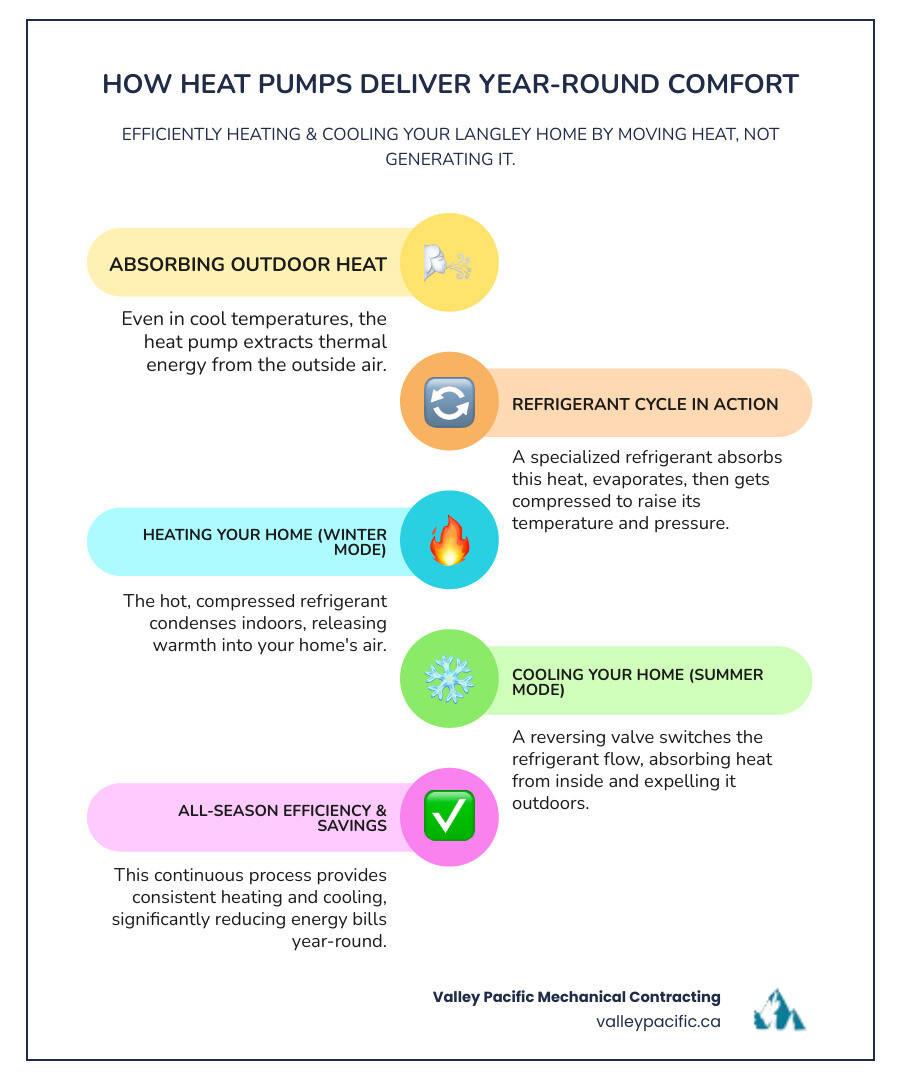
Basic Langley heat pump installation vocab:
Why a Heat Pump is the Smart Choice for Your Langley Home
When you're considering upgrading your home's comfort system, a Langley heat pump installation isn't just another appliance purchase – it's an investment in your family's comfort, your wallet, and the environment. We've seen how these remarkable systems transform homes across the Lower Mainland, and the benefits are truly impressive.

Let's start with what matters most to homeowners: energy savings. Heat pumps can slash your energy bills by up to 50% compared to traditional heating systems. If you opt for a hybrid system that combines a heat pump with your existing furnace, you could see savings reach an incredible 65%. Imagine opening your utility bill and actually smiling for once!
This efficiency comes from a brilliant principle – heat pumps don't burn fuel to create heat. Instead, they move existing heat from one place to another, using electricity at incredibly efficient rates. In ideal conditions, a quality heat pump can move up to 300% more energy than it consumes. Even the most efficient gas furnaces max out at about 95% efficiency, which suddenly doesn't look so impressive.
Dual functionality is another game-changer. With a heat pump, you get both heating and cooling from one sleek system. No more juggling separate furnace and air conditioning units, no more competing warranties or service calls. It's like having a Swiss Army knife for home comfort – one tool that handles everything beautifully.
The environmental benefits are substantial too. By using electricity to move heat rather than burning fossil fuels, heat pumps produce significantly fewer greenhouse gas emissions. With carbon taxes projected to climb from $50 per tonne in 2022 to $170 per tonne by 2030, choosing electric heating isn't just environmentally conscious – it's financially smart.
But here's what really gets homeowners excited: the consistent comfort. Many modern heat pumps feature variable-speed compressors that make subtle, continuous adjustments to maintain your desired temperature. This eliminates the jarring on-and-off cycles of traditional furnaces, preventing those annoying hot and cold spots. Instead, you get a gentle, steady stream of conditioned air. They also continuously circulate and filter your air, which not only maintains temperature but also creates better indoor air quality for your family.
Safety is another major advantage. Unlike gas furnaces, heat pumps pose no risk of carbon monoxide leaks because they don't burn any fuel. For families with young children or elderly relatives, this peace of mind is invaluable.
For more insights into making the right choice for your home, check out our detailed guide on reasons to consider heat pump installation and learn about the benefits of a residential heat pump system.
How Heat Pumps Provide Efficient Heating and Cooling
The magic of heat pumps lies in a fascinating principle called heat transfer. Instead of burning fuel to create heat from scratch, these clever systems move existing heat from one place to another. It's like having a heat magnet that can work in both directions.
At the heart of this process is the refrigerant cycle. A special fluid circulates through your system, absorbing and releasing heat as it changes between liquid and gas states. This refrigerant acts as a thermal courier, constantly moving energy where you need it most. As it flows through the indoor and outdoor coils, it undergoes pressure and temperature changes that allow it to either absorb heat from the air or release it.
The reversing valve is the component that makes the dual heating and cooling possible. This ingenious piece of engineering allows your heat pump to switch directions depending on the season.
During winter heating mode, your outdoor unit becomes a heat collector. Even when it's chilly outside, there's still heat energy in the air – and your heat pump extracts it. The refrigerant absorbs this outdoor heat, gets compressed to increase its temperature even more, then releases that warmth into your home through the indoor unit.
In summer cooling mode, the process flips. Your indoor unit absorbs heat and humidity from your home's air, while the outdoor unit releases that unwanted heat outside. It's essentially the same process your refrigerator uses, just scaled up for your entire home.
This year-round performance means you get consistent comfort no matter what Mother Nature throws at you. Whether it's a sweltering July day or a crisp February morning, your heat pump adapts to keep your family comfortable.
Comparing Heat Pumps to Traditional HVAC Systems
When weighing your options for home comfort, understanding how heat pumps stack up against traditional systems helps you make the best decision for your Langley home.
| Feature | Heat Pumps | Furnaces | Air Conditioners |
|---|---|---|---|
| Energy Efficiency | Highly efficient, moving up to 300% more energy than they consume. Top models achieve 20+ SEER and 10+ HSPF ratings. | Even high-efficiency gas furnaces typically reach only 96% AFUE, with older models as low as 80% AFUE. | Provide cooling efficiency similar to heat pumps but require separate heating systems. |
| Features | Dual heating and cooling functionality, smart thermostat integration, zoning capabilities, and precise temperature control. | Heating only, often requiring separate AC units. Some offer multi-stage heating for improved comfort. | Cooling only, requiring separate heating systems. May include variable speed fans and smart controls. |
| Environmental Impact | Lower greenhouse gas emissions due to electricity use and heat transfer principles rather than fuel combustion. | Burn fossil fuels, contributing to greenhouse gas emissions despite improved efficiency in modern models. | Use refrigerants with potential environmental impact but don't directly burn fossil fuels. |
| Safety | No risk of carbon monoxide leaks since they don't burn fossil fuels. Generally very safe operation. | Risk of carbon monoxide leaks if heat exchangers crack or flue pipes fail, requiring regular safety inspections. | Generally safe with no carbon monoxide risk, though refrigerant leaks can occur. |
| Lifespan | Typically 10-20 years with proper maintenance and regular service. | Usually 15-20 years, though this varies significantly based on fuel type and maintenance quality. | Generally 10-15 years, depending on usage patterns and maintenance schedules. |
The efficiency ratings tell a compelling story. While a premium gas furnace might achieve 96% efficiency, heat pumps routinely deliver 300% efficiency or higher. That's not a typo – they actually move more energy than they consume by harvesting heat from the outdoor air.
Long-term benefits extend beyond just efficiency numbers. By combining heating and cooling into one unit, heat pumps eliminate the need to purchase, install, and maintain two separate systems. This consolidation simplifies everything: you have one warranty to track, one service provider to call, and one system to learn. Over the lifespan of the equipment, this reduces potential points of failure and streamlines your annual maintenance, saving you both time and hassle.
For homeowners concerned about indoor air quality, heat pumps offer continuous air circulation and filtration. Unlike furnaces that only filter air when the heat is on, a heat pump's fan can run independently to keep air moving, capturing more dust, pollen, and other allergens. This constant circulation also helps maintain steady comfort levels throughout your home.
To learn more about optimizing your overall home comfort system, explore our guide to HVAC system checks and find how proper maintenance keeps everything running smoothly.
Why Professional Daikin AC Installation Matters
Daikin AC installation requires careful planning and expert execution to ensure your system delivers optimal comfort and energy efficiency for years to come. While Daikin systems are renowned for their reliability and advanced inverter technology, proper installation is critical to open uping their full potential.
Key Steps in Professional Daikin AC Installation:
- Pre-installation site inspection - Energy audit and load calculation
- System selection - Choosing between ductless, mini-split, or ducted systems
- Proper placement - Indoor and outdoor unit positioning with adequate clearances
- Essential connections - Refrigerant lines, electrical wiring, and drainage systems
- System commissioning - Vacuum testing, refrigerant charging, and trial operation
- Final walkthrough - Operation demonstration and warranty registration
The installation process typically takes 4 to 8 hours, depending on system complexity and your home's specific requirements. Professional installation ensures your Daikin system operates at peak efficiency while maintaining warranty coverage.
Daikin offers several system types to meet different home needs. Ductless mini-splits are perfect for homes without existing ductwork, while multi-zone systems provide independent temperature control for different areas. Ducted systems work well with existing HVAC infrastructure for whole-home comfort.
The key to a successful installation lies in proper preparation, including ensuring adequate spacing around units, securing appropriate electrical connections, and following manufacturer specifications for refrigerant line installation and insulation.
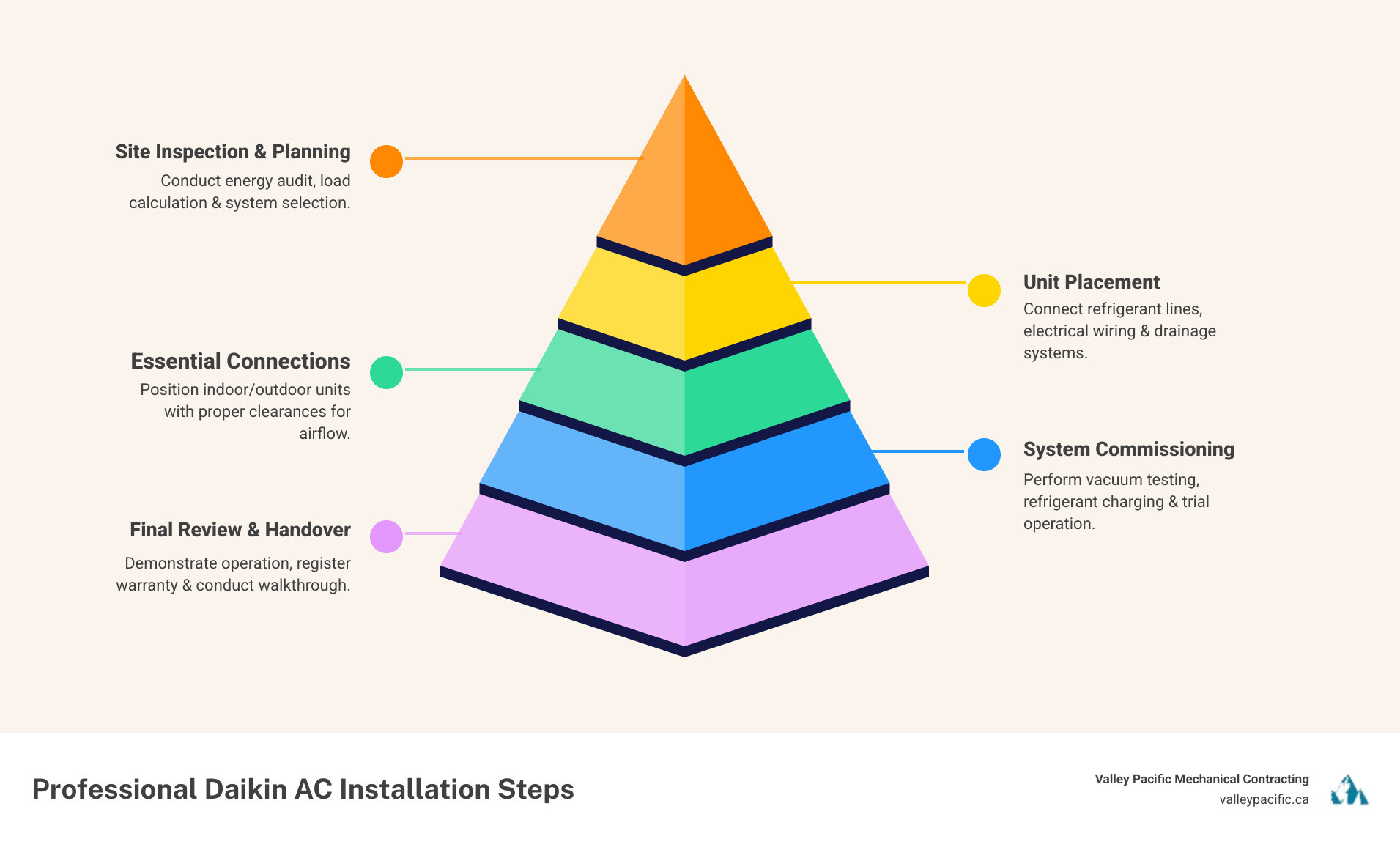
Daikin ac installation glossary:
Understanding Your Daikin AC Options
Choosing the right Daikin AC installation for your home ensures you get the comfort and efficiency you need. Daikin offers an impressive range of systems for every type of home, from older houses without ductwork to modern spaces requiring precise temperature control. The key is to match your home's unique needs with the perfect solution, which is why proper sizing is crucial. Learn more in our guide on Why AC Sizing Matters for Installation.
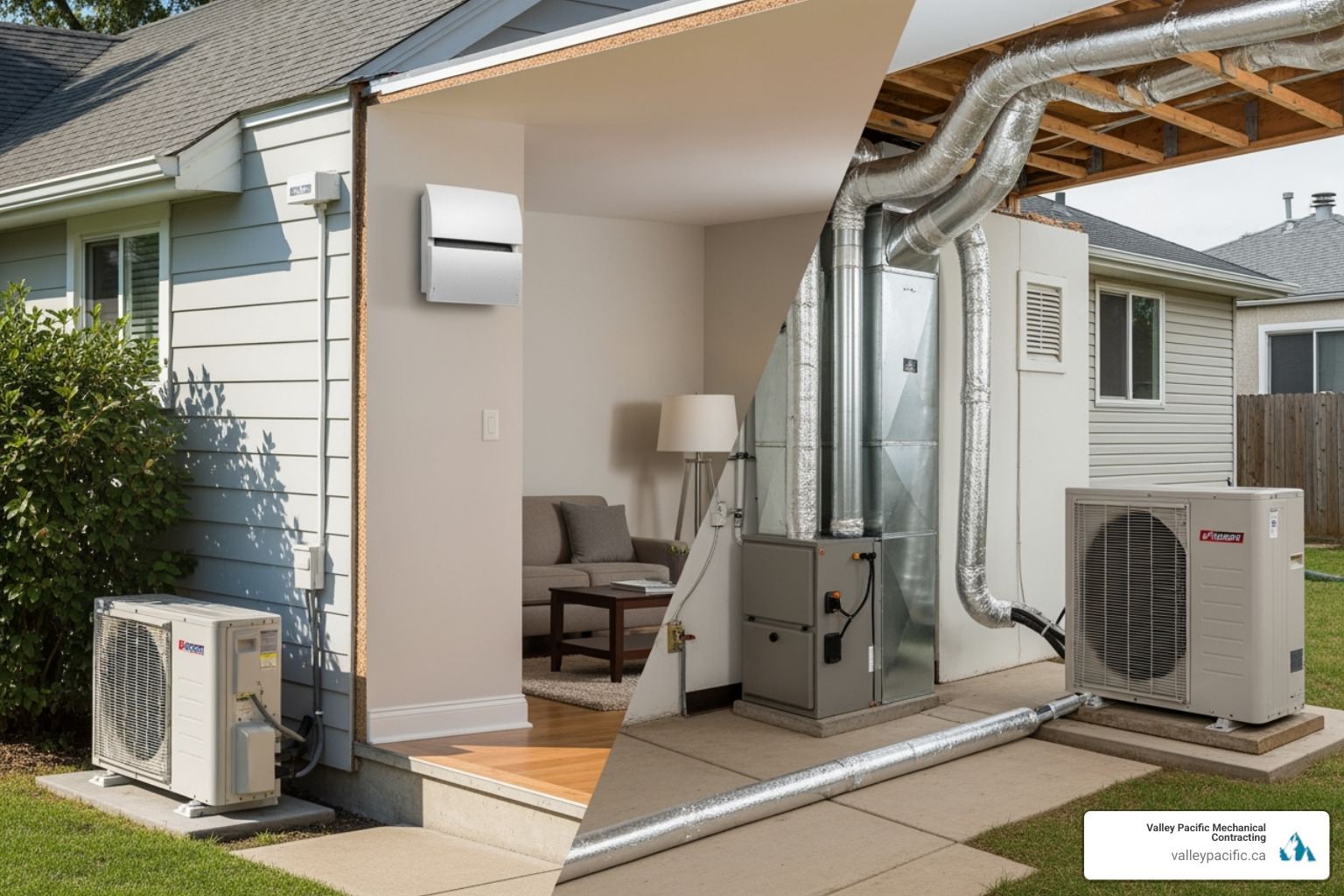
Types of Daikin AC Systems
Daikin offers several Daikin AC installation options to deliver comfort throughout your home.
Ductless mini-split systems are champions of flexibility, ideal for homes without existing ductwork. An outdoor unit connects to indoor wall-mounted units, providing excellent zone control. Many also function as efficient heaters, offering a secure and cost-effective alternative to baseboard heaters and window units.
Multi-zone systems expand on the mini-split concept, allowing one outdoor unit to power up to eight indoor units, each with independent control. This is perfect for families with different temperature preferences, enabling you to cool only the rooms you're using.
For homes with ducted systems, Daikin's central air solutions integrate with your existing ductwork for consistent, whole-home comfort. They are an excellent choice for larger homes needing even temperatures throughout.
Variable Refrigerant Volume (VRV) systems are Daikin's most advanced technology. Often used commercially, they are also ideal for large homes with complex needs, offering sophisticated and precise efficiency.
If you're considering an upgrade, our HVAC System Upgrades Complete Guide can help guide the process.
Key Features and Energy-Saving Benefits
Daikin's smart technology translates into real comfort and energy savings.
Inverter technology is a key feature. Unlike traditional systems that are either on or off, Daikin's inverter smoothly adjusts compressor speed to match your home's needs. This eliminates temperature swings and reduces energy consumption.
The heat pump capabilities in many Daikin systems provide year-round comfort, efficiently heating your home by pulling heat from the outside air, even in cold weather. For maintenance tips, see our Daikin Heat Pump Service guide.
Variable Refrigerant Volume (VRV) technology maximizes efficiency by delivering the precise amount of refrigerant each zone requires, eliminating waste. As noted in studies like The ASHRAE HQ Building comparison, these advances offer significant energy savings.
Smart thermostats like the Daikin One+ allow you to control your system from your phone, set schedules, and save energy when you're away. Some models also integrate with air quality sensors for improved comfort.
These technologies work together to create a system that is both comfortable and economical.
Preparing Your Home for a Professional Daikin AC Installation
Properly preparing your home is the secret to a smooth, headache-free Daikin AC installation. Before our certified technicians arrive, some important groundwork ensures your new system will perform beautifully for years. If you're unsure about needing a new system, our guide on Signs You Need a New AC Installation can help you decide.
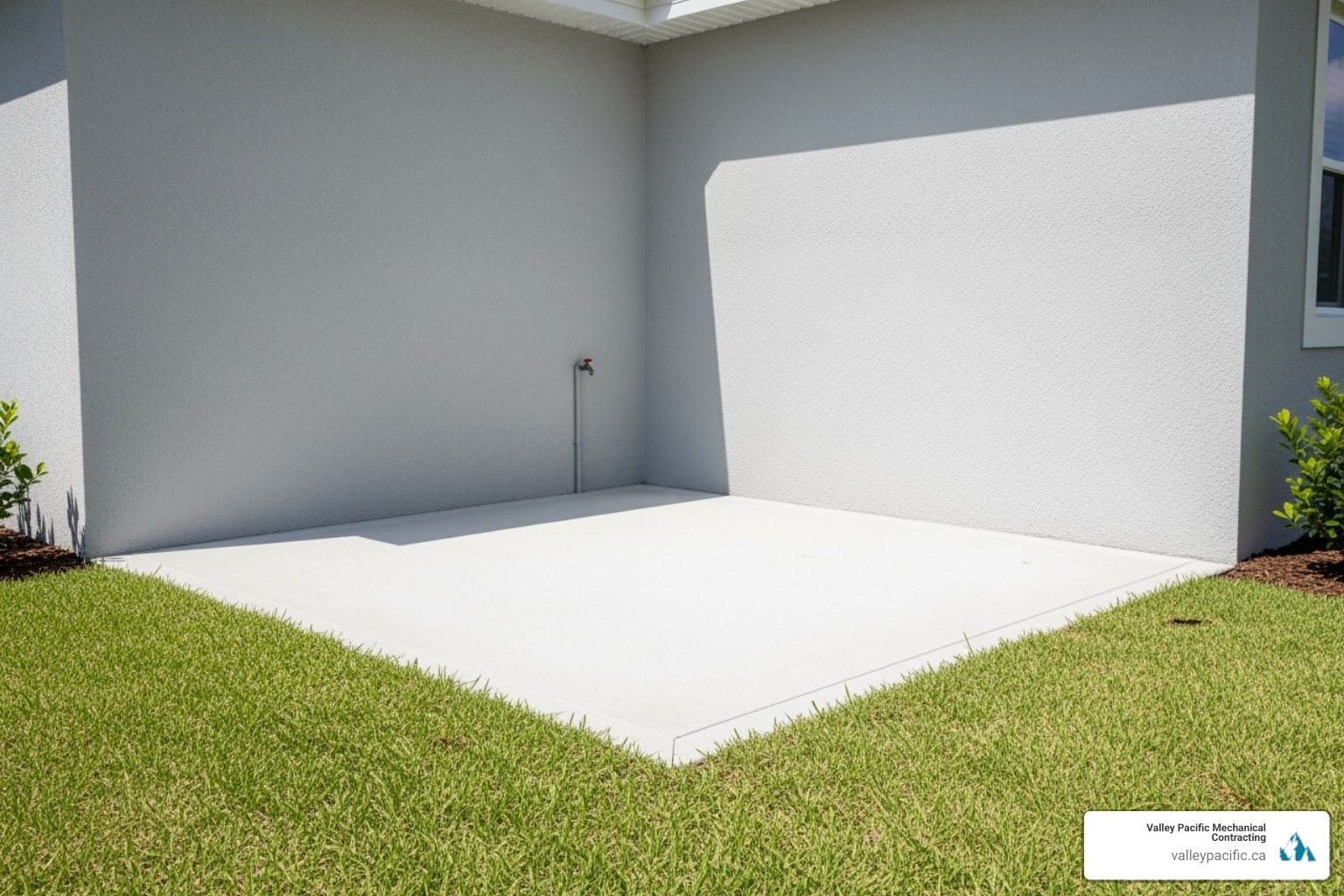
The Pre-Installation Site Inspection
The pre-installation site inspection is a detailed assessment to ensure your new Daikin system is perfectly matched to your home.
The home energy audit and load calculation is the foundation. We measure your home's heating and cooling needs by examining square footage, insulation, windows, and sun exposure. This prevents installing an improperly sized system that is inefficient or ineffective.
For homes with existing ductwork, our ductwork assessment checks for leaks, blockages, and insulation issues that could impact efficiency.
Choosing the right unit locations is also critical. Indoor units are placed to maximize air circulation, away from heat sources and electronics, typically high on a wall (1.8 to 2.5 meters from the floor). Outdoor units require a flat, stable surface with good ventilation, positioned to minimize noise and ensure safety, while being at least 3 cm above ground for drainage.
For timing insights, read our article on When to Install a New AC System.
Ensuring Proper Spacing and Clearances
Proper spacing is critical for your Daikin unit's long-term performance.
Indoor unit placement must follow Daikin's manufacturer specifications for clearances from walls, ceilings, and furniture. This ensures unrestricted airflow for even air distribution and prevents the unit from overworking.
The outdoor unit foundation and airflow requirements are just as important. It needs a strong, level foundation to prevent vibration and generous clearance on all sides for proper airflow.
Preventing overheating is a key goal. Inadequate ventilation space forces the outdoor unit to work harder, consume more energy, and risk system failure. Obstructions like walls, fences, or dense vegetation must be avoided. Getting these details right is essential for reliable, efficient performance.
The Professional Daikin AC Installation Process
Installation day has arrived, and you're about to experience why our Daikin AC installation process sets the standard for comfort and professionalism in the Lower Mainland. Our certified technicians arrive with decades of expertise and a commitment to making your experience as smooth as possible. For more details about our comprehensive air conditioning services, visit our Air Conditioning page.
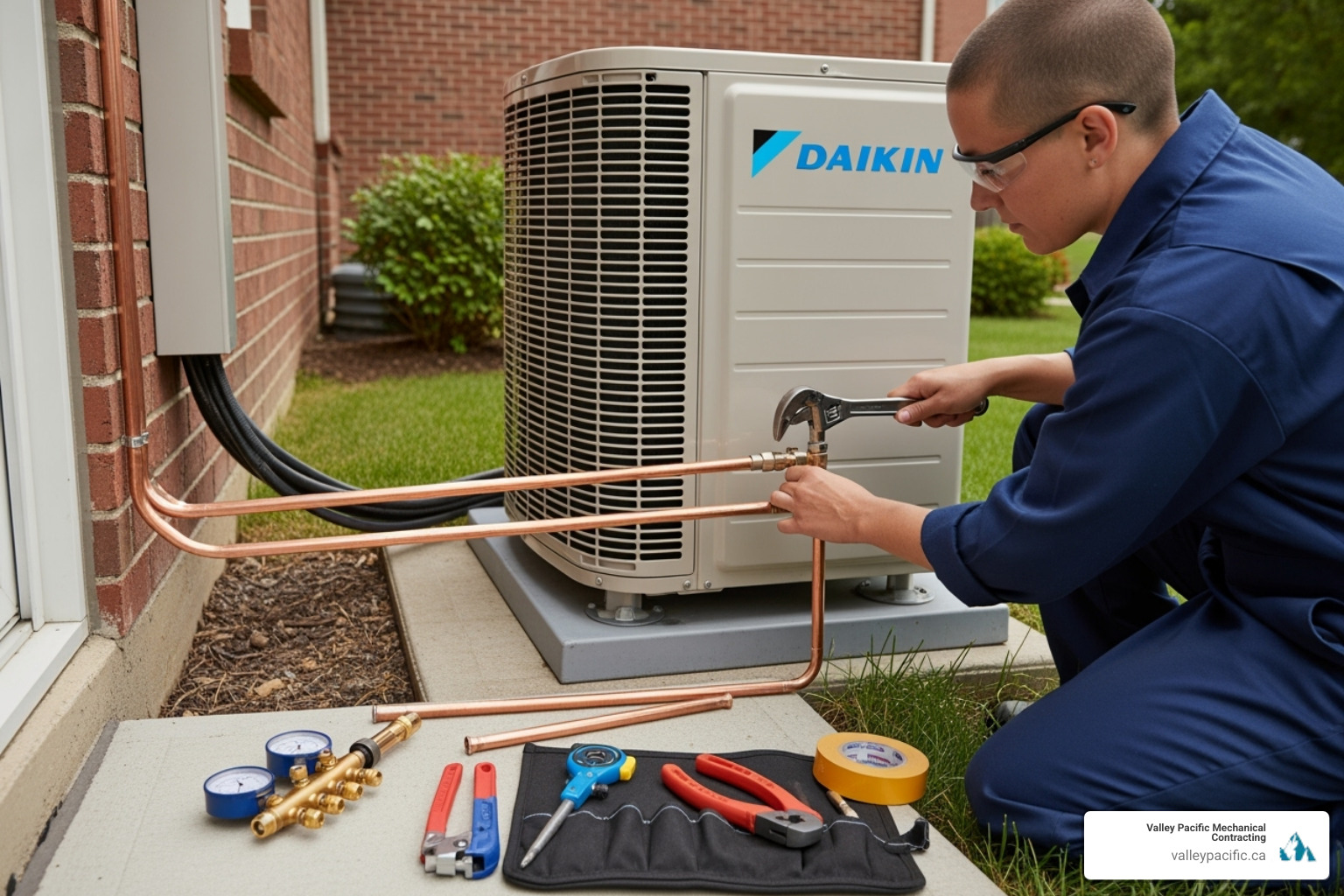
What to Expect During Your Daikin AC Installation
When our team arrives for your Daikin AC installation, you can expect professionalism and expertise. Our arrival of technicians is punctual and organized; we'll review the installation plan with you and answer any questions.
Protecting your home is a top priority. We lay down protective coverings to keep your floors and work areas clean, treating your home with respect.
The installation timeline is typically 4 to 8 hours, depending on system complexity. We work efficiently to get the job done right the first time.
After the physical installation, system testing begins. We run comprehensive trial operations, testing cooling and heating modes, verifying airflow, and ensuring all functions respond correctly.
The day concludes with a thorough walkthrough. Our technician will demonstrate your new system's features and answer your questions, ensuring you feel confident operating your new Daikin system.
Key Steps in a Ductless Daikin AC Installation
A ductless Daikin AC installation follows a precise sequence our technicians have perfected.
Mounting the indoor unit involves securely fastening the air handler to the pre-selected wall on a mounting plate, ensuring it is perfectly level for optimal air distribution.
Drilling for line sets is done with precision. We create a single, carefully positioned hole through the exterior wall with a slight downward slope to the outside. This accommodates refrigerant lines, wiring, and the condensate drain while preventing water entry.
Placing the outdoor unit on its prepared foundation is next, ensuring it is level and has proper clearances for airflow.
The most critical phase is connecting refrigerant, electrical, and drainage lines. Refrigerant lines are cut, flared, and tightened with torque wrenches to prevent leaks. Electrical connections follow safety codes, and drain lines are installed with a continuous downward slope.
System vacuum and charging completes the process. We vacuum the refrigerant circuit to eliminate air and moisture—a vital step for system longevity—before charging it with the correct amount of refrigerant per Daikin's specifications.
Essential Connections Explained
Three types of connections are the backbone of a successful Daikin AC installation, each requiring expert attention.
Electrical wiring needs a dedicated circuit matching the unit's power requirements. Our technicians ensure all connections are secure, grounded, and compliant with local codes, including specific configurations for smart thermostats like the Daikin One+, as detailed in the Daikin One+ Unitary Installation Guide.
Refrigerant lines carry refrigerant between units. Proper installation prevents leaks and ensures peak efficiency. This involves creating perfect flare connections, tightening fittings to exact torque specifications, and insulating both lines to prevent energy loss. We evacuate the circuit to remove air and moisture before charging it with the correct refrigerant (typically R32 or R410A).
Condensate drain installation is crucial for preventing water damage. As the system removes humidity, it produces water that must be drained away. We install drain lines with a continuous downward slope and proper insulation to prevent leaks, condensation, and mold growth.
Post-Installation: Care and Common Questions
After your Daikin AC installation is complete, proper care will ensure your new system runs at peak efficiency for years. A little basic maintenance goes a long way in keeping everything running smoothly. For comprehensive guidance, check out our HVAC Services for Home Comfort.
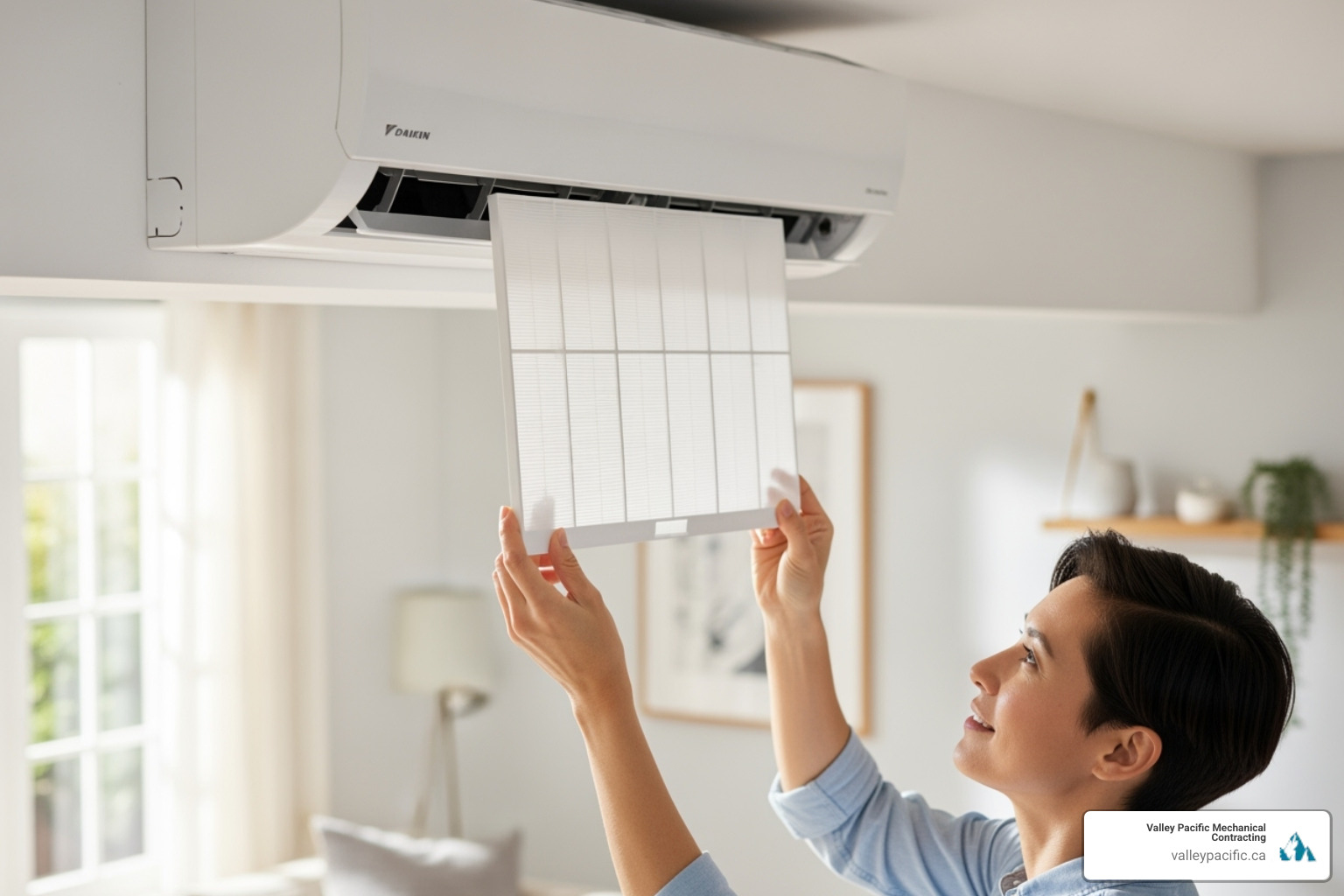
Initial System Checks and Operation
After your Daikin AC installation, our technicians ensure you're comfortable with your new system.
Trial operation involves testing both cooling and heating modes, fan speeds, and louver movements to confirm proper function.
Checking airflow is also crucial. We verify strong, even airflow from the indoor unit and ensure the outdoor fan is unobstructed.
Remote control setup can be confusing, so we walk you through all the buttons, modes, and settings. We'll make sure you can operate your system confidently.
Registering your warranty is essential to validate your manufacturer coverage. We will guide you through this process and show you how to access Daikin's support network, including their Find Contractors | HVAC Installation & Service - Daikin Comfort resource.
Troubleshooting Common Post-Installation Issues
Even with a perfect Daikin AC installation, minor issues can occur. Most are simple to resolve.
Unit not turning on: Check your circuit breaker, ensure the power cord is plugged in, and check the remote's batteries. Daikin units have a 3-minute safety delay after power interruptions.
Insufficient cooling or heating: This is often due to airflow restrictions. The main culprit is dirty filters; clean or replace them every 1-3 months. Also, ensure nothing is blocking the indoor or outdoor units and verify your temperature settings.
Water leakage: This is usually a drainage issue, like a clogged or improperly sloped condensate line. Improperly insulated drain pipes can also cause condensation drips. These issues typically require professional service.
Unusual noises: Many sounds, like flowing water or crackling plastic, are normal. However, if you hear grinding, squealing, or loud banging, turn off the unit and call for service immediately.
Daikin error codes: These diagnostic codes appear on the display to indicate a specific problem. If you see an error code, write it down and contact us. We can often diagnose the issue over the phone.
Our team at Valley Pacific Mechanical Contracting is always here to help with any concerns after your Daikin AC installation.
Frequently Asked Questions about Daikin AC Systems
After completing thousands of Daikin AC installations across the Lower Mainland, we've heard just about every question homeowners have about these reliable systems. Here are the answers to the most common questions.
What are the most common problems reported with Daikin air conditioners?
While Daikin systems are reliable, a few common issues can arise, most of which are preventable.
Refrigerant leaks can develop over time, reducing cooling efficiency.
Dirty or clogged filters are a frequent cause of problems, as they restrict airflow and force the system to overwork.
Electrical issues like blown fuses or tripped circuit breakers can also occur, often due to power surges.
The good news is that regular maintenance prevents most of these issues. Cleaning or replacing filters every 1-3 months is the most important step you can take. Annual professional service will catch small problems before they become major repairs.
How long does a typical Daikin AC installation take?
Most Daikin AC installation projects are completed in a single day. A standard residential installation typically takes between 4 to 8 hours.
The exact time depends on several factors. Ductless mini-split systems are often quicker, while multi-zone systems with multiple indoor units take longer. Ducted central air systems can vary; installations using existing ductwork are straightforward, but those requiring modifications may take longer.
The complexity of your home's layout, such as access for line sets and electrical work, also affects the timeline. We provide a realistic timeframe during our pre-installation consultation so you know exactly what to expect.
Where can I find official manuals for my Daikin AC?
Daikin makes it easy to find official documentation for their systems. Daikin's official website has a comprehensive resource center with installation manuals, operation guides, and troubleshooting documents for nearly all models, including discontinued ones.
Look for the "Resource Center" or "After Sales Service" sections for downloadable PDFs. These portals cover everything from single-zone ductless systems to multi-zone and VRV systems.
While some information is technical, the operation guides are user-friendly. If you have trouble finding a manual or need help, contact us. We keep common manuals on hand and are happy to assist our clients.
Your Partner for a Perfect Daikin Installation
When it comes to your Daikin AC installation, choosing the right partner makes all the difference between a stressful experience and a smooth one. At Valley Pacific Mechanical Contracting, we've built our reputation on delivering exactly what every homeowner wants: a "headache-free" experience from start to finish.
Our commitment to excellence begins with the Daikin Comfort Promise. This isn't just marketing speak – it's our guarantee that your installation will meet the highest standards of quality and performance. We know that inviting contractors into your home can feel overwhelming, which is why we've designed our process to be as seamless and transparent as possible.
With over 30 years of expertise in the HVAC industry, our certified technicians have seen it all. We've installed countless Daikin systems throughout the Lower Mainland, and each installation has taught us something new about delivering exceptional service. Whether you're in Mission, Maple Ridge, Langley, Pitt Meadows, or Coquitlam, our team brings the same level of professionalism and attention to detail to every job.
What sets us apart is our understanding that your comfort doesn't end when we pack up our tools. That's why we offer 24/7 emergency service – because air conditioning problems don't wait for convenient business hours. When you choose us for your Daikin AC installation, you're not just getting a one-time service; you're gaining a long-term partner who's always there when you need us.
Our expert technicians don't just install your system and leave. We take the time to walk you through every aspect of your new Daikin AC, ensuring you feel confident operating it and know exactly who to call if questions arise. From the initial consultation where we assess your home's unique needs, through the careful installation process, to the final demonstration of your system's features – we're with you every step of the way.
For a seamless and professional Daikin AC installation in Langley, Maple Ridge, or Mission, trust our certified experts to ensure your system runs perfectly from day one. Explore our full range of Services and let us help you create the perfect climate in your home. Contact us for your air conditioning installation in Langley, BC today!
Why Modern Buildings Need Mechanical System Upgrades
Mechanical system upgrades involve replacing or improving the heating, ventilation, air conditioning, and water heating equipment in your building to achieve better efficiency, comfort, and performance. These upgrades go far beyond simple repairs - they're about changing how your building operates.
Key mechanical system upgrade options include:
- Heat pump installations - Modern heat pumps for both space and water heating
- Smart thermostats and controls - Automated systems that learn and optimize performance
- Advanced ventilation systems - Heat recovery ventilators (HRV) and energy recovery ventilators (ERV)
- Integrated mechanical systems - Single units that combine heating, cooling, and water heating
- All-electric solutions - Future-proofing systems that eliminate fossil fuel dependence
- Ductwork and infrastructure improvements - Properly sealed and insulated distribution systems
Modern buildings demand more than basic heating and cooling. Today's mechanical systems must deliver consistent comfort, healthy indoor air quality, and energy efficiency while reducing environmental impact.
The shift toward high-efficiency, all-electric solutions isn't just a trend - it's driven by real benefits. Research from the American Council for an Energy-Efficient Economy (ACEEE) shows there's potential for $4.3 billion in annual energy savings from upgrading mechanical systems in multifamily housing alone. These systems also improve building performance through better temperature control, humidity management, and air filtration.
Whether you're dealing with an aging system that breaks down frequently, sky-high energy bills, or simply want to future-proof your property, mechanical system upgrades offer a path to reliable, efficient operation that pays dividends for years to come.
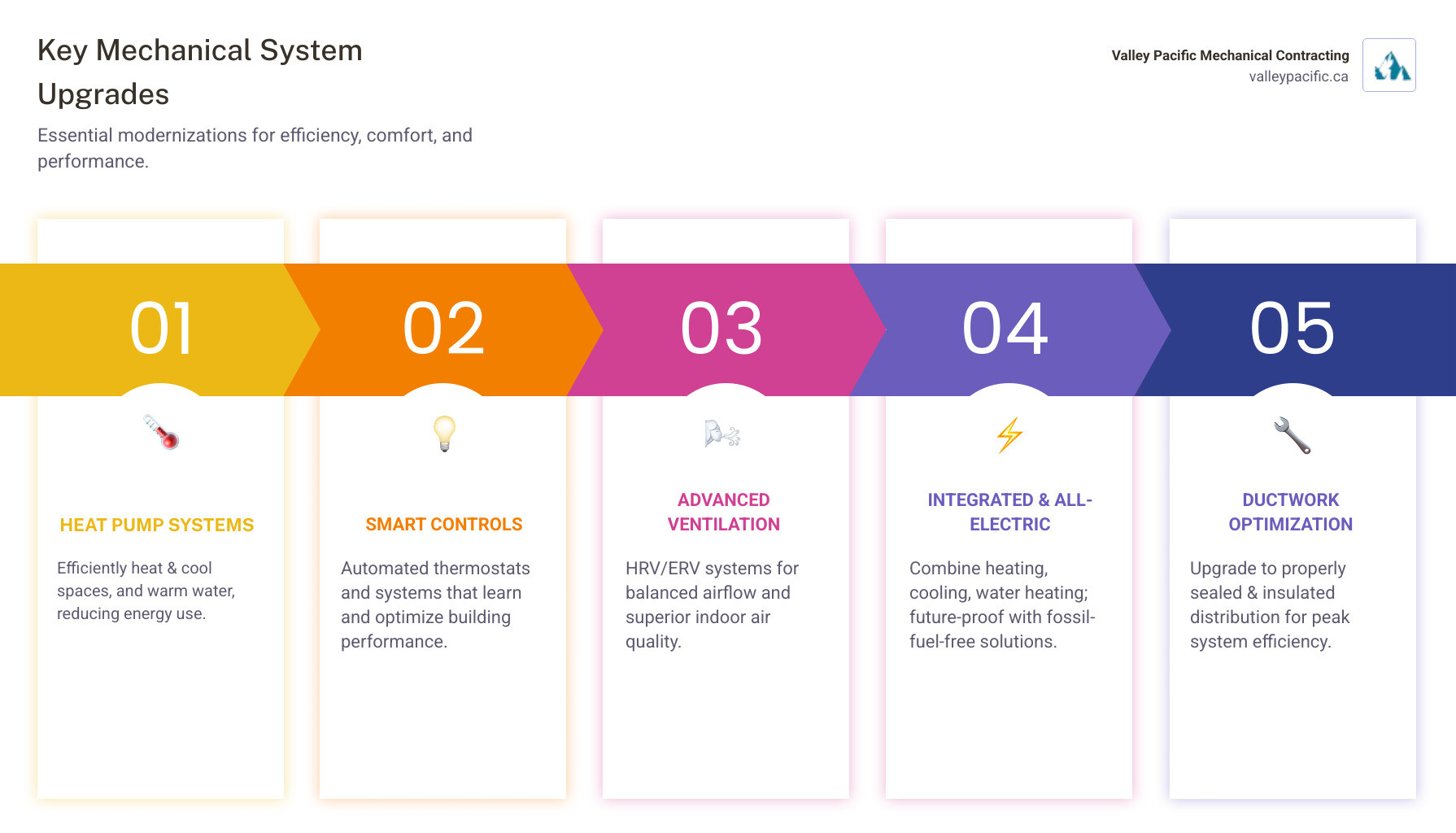
Common Mechanical system upgrades vocab:
The Compelling Case for Upgrading Your Mechanical System
Picture your ideal building environment: comfortable temperatures year-round, fresh clean air, and energy bills that don't make you wince. That's exactly what mechanical system upgrades deliver, and the benefits extend far beyond what you might expect.
The change we see in our clients' properties is remarkable. Modern mechanical systems don't just fix problems - they revolutionize how buildings operate. The energy savings alone can be staggering. Research shows that upgrading mechanical systems in multifamily housing could generate $4.3 billion in annual energy savings across certain climate zones. While that's a massive number, what matters more is how those savings show up in your monthly bills.
But the cost benefits are just the beginning. These upgrades deliver improved comfort that you'll notice immediately - no more battling with thermostats or dealing with rooms that are always too hot or too cold. The healthier indoor air quality is equally impressive, with advanced filtration systems removing pollutants, allergens, and other airborne irritants that can affect your family's well-being.
There's also the increased property value to consider. Modern, efficient mechanical systems are attractive to buyers and tenants alike. Plus, choosing high-efficiency systems demonstrates environmental responsibility - something that matters more to people every day.
For a deeper dive into all these advantages, check out our HVAC System Upgrades Complete Guide.
Improved Energy Efficiency and Performance
Here's where mechanical system upgrades really shine: the dramatic boost in energy efficiency. Older systems were built when energy was cheap and environmental concerns weren't top priorities. Today's equipment is engineered to deliver maximum comfort with minimum energy use.
The reduced utility bills are usually the first thing our clients notice. Modern systems are smart - they learn your patterns, adapt to weather conditions, and optimize performance automatically. This translates to lower operational costs over the system's entire lifespan.
Optimal performance means your system works smarter, not harder. Instead of cycling on and off constantly, newer equipment maintains steady, comfortable conditions. This gentle operation extends system lifespan significantly, meaning you won't be shopping for replacements as often.
There's also the matter of meeting modern energy codes. Whether you're renovating or building new, current codes demand higher efficiency standards. Upgrading ensures you're compliant and future-ready. Our Custom HVAC Services for Homes can help you steer these requirements while maximizing your system's potential.
Improved Occupant Comfort and Health
The comfort improvements from mechanical system upgrades are immediately noticeable, but the health benefits are equally important. We spend most of our time indoors, so the quality of that environment directly impacts our daily lives.
Consistent temperatures throughout your space eliminate those frustrating hot and cold spots. No more bundling up in the living room while the bedroom feels like a sauna. Modern systems deliver even, comfortable temperatures in every room.
Better humidity control prevents the extremes that cause problems. Too dry, and you'll deal with static electricity, dry skin, and respiratory irritation. Too humid, and you risk mold growth and that sticky, uncomfortable feeling. Upgraded systems maintain that perfect middle ground.
The improved indoor air quality (IAQ) is where these systems really protect your health. Advanced filtration of pollutants captures dust, pollen, pet dander, and even microscopic particles that older systems miss completely. This creates a cleaner, healthier environment for everyone, especially family members with allergies or asthma.
Don't overlook the reduced noise levels either. Modern equipment operates much more quietly than older systems, creating a more peaceful indoor environment. Learn more about how we prioritize comfort in our HVAC Services for Home Comfort approach.
Key Components and Trends in Modern Mechanical System Upgrades
The world of mechanical system upgrades is changing fast, and honestly, it's pretty exciting. We're seeing innovations that would have seemed like science fiction just a few years ago become everyday solutions for homeowners and businesses.

The biggest shift we're witnessing is the move toward all-electric solutions. Buildings are ditching their gas furnaces and oil boilers in favor of electric systems that can do it all. This isn't just about being trendy - it's about preparing for a future where clean electricity powers everything in your home or business.
Multifunctional equipment is another game-changer. Instead of having separate units for heating, cooling, and water heating scattered around your property, modern systems can handle multiple jobs from one compact unit. It's like having a Swiss Army knife for your building's comfort needs.
We're also seeing Integrated Mechanical Systems (IMS) become the new standard. These clever systems combine space heating, water heating, and ventilation into one coordinated package. The result? Better performance, less space needed, and easier maintenance.
The industry is also getting serious about environmental responsibility with low Global Warming Potential (GWP) refrigerants. These newer refrigerants do the same job as older ones but with a much smaller environmental footprint. It's part of the broader decarbonization movement that's reshaping how we think about building systems.
The Central Role of Heat Pumps
If there's one technology that's absolutely revolutionizing mechanical system upgrades, it's the heat pump. These remarkable machines are changing how we think about both space heating and water heating.
Here's what makes heat pumps so special: instead of burning fuel to create heat, they simply move heat from one place to another. Even on cold winter days, there's heat in the outside air that heat pumps can capture and bring inside. It's like having a heat magnet for your home.
High-efficiency operation is where heat pumps really shine. They can deliver three to four times more heating energy than the electrical energy they consume. That's efficiency you can feel in your comfort and see in your energy bills.
Air-to-air heat pumps are perfect for homes with existing ductwork, providing both heating and cooling through your current system. Air-to-water heat pumps are ideal for radiant heating systems or domestic hot water. Both options offer incredible versatility and efficiency.
Water heating deserves special mention here. Since water heating is typically the second-largest energy user in most buildings, upgrading to a heat pump water heater can make a huge difference. These units work great in semi-conditioned spaces like basements or attached garages, actually helping to condition those areas while they work.
If you're considering this upgrade, our team specializes in Heat Pump Installation Maple Ridge BC and can help you choose the perfect system for your needs.
Advanced Ventilation and Smart Controls
Great mechanical system upgrades aren't just about temperature - they're about the quality of air you breathe every day. That's where advanced ventilation and smart controls become essential.
Heat Recovery Ventilators (HRV) and Energy Recovery Ventilators (ERV) are brilliant pieces of technology. They continuously bring fresh outdoor air into your building while exhausting stale indoor air. The magic happens in the heat exchanger, where these systems capture heat from the outgoing air and transfer it to the incoming fresh air. You get fresh air without wasting energy.
Balanced ventilation ensures your building maintains proper air pressure while providing consistent fresh air throughout every room. No more stuffy bedrooms or drafty hallways.
Smart thermostats take control to a whole new level. These intelligent devices learn your schedule, adapt to your preferences, and can even suggest ways to save energy. Some of our clients love being able to adjust their home's temperature from their phone while they're still at work.
System automation ties everything together, ensuring your heating, cooling, and ventilation work in perfect harmony. The system makes adjustments automatically, so you stay comfortable while using the least amount of energy possible.
To explore all the ventilation and control options available for your building, check out our complete range of Services.
The Rise of Integrated and All-Electric Systems
The future of mechanical system upgrades is definitely integrated and all-electric, and we're seeing this change happen right now across the Lower Mainland.
Integrated Mechanical Systems (IMS) represent the ultimate in efficiency and convenience. Instead of having separate systems for heating, cooling, water heating, and ventilation, IMS combines heating, cooling, and water heating into one coordinated package. This approach offers several advantages: better material and energy efficiency, a reduced footprint that frees up valuable space in your home or building, and streamlined maintenance.
All-electric solutions are becoming the smart choice for property owners who want to future-proof their buildings. As our electrical grid becomes cleaner and policies increasingly favor renewable energy, all-electric systems position your property at the forefront of this transition. You'll be ready for whatever changes come next, whether that's new environmental regulations or incentives for clean energy adoption.
Future-proofing buildings isn't just about meeting today's needs - it's about making sure your investment continues to serve you well for decades to come. All-electric, integrated systems offer the flexibility and efficiency that tomorrow's buildings will require.
While the trend is clearly moving toward heat pumps and all-electric solutions, we understand that some properties still benefit from traditional heating methods. That's why we continue to offer expert Boiler Installation Maple Ridge BC for clients who need these reliable heating solutions.
Planning Your Retrofit: A Step-by-Step Guide
Planning mechanical system upgrades might feel overwhelming at first, but we've found that breaking it down into clear steps makes the whole process much more manageable. Think of it like renovating your kitchen – you wouldn't just start ripping out cabinets without a plan, right?
The key to a successful retrofit is understanding where you're starting from and where you want to end up. This means taking a hard look at your existing systems, figuring out what's working (and what definitely isn't), and then mapping out a path to get you to your long-term goals.
We always recommend starting with a professional consultation. After three decades in this business, we've seen too many well-intentioned upgrades go sideways because someone skipped this crucial first step. A good professional will help you see possibilities you might not have considered and steer you away from costly mistakes.
The planning phase is also where we talk about your long-term goals for the building. Are you looking to slash energy bills? Improve comfort? Future-proof against rising utility costs? Maybe all three? These conversations shape every decision that follows. And once your new system is humming along perfectly, our HVAC Preventative Maintenance service keeps it that way for years to come.
Step 1: Assessing Your Existing HVAC System
Before we can chart a course forward, we need to know exactly what we're dealing with. Assessing your existing system is like getting a thorough health check-up – sometimes the problems are obvious, but often the most serious issues are hiding beneath the surface.
The signs of an outdated system are usually pretty clear once you know what to look for. If you're calling for repairs more than twice a year, that's your system waving a white flag. High energy bills that seem to climb every month? That's another red flag. And if you're dealing with poor performance – rooms that are always too hot or too cold, a system that sounds like a freight train, or air that feels stuffy no matter what you do – it's time for a change.
But here's where a professional evaluation really pays off. We dig deeper than the obvious symptoms. We'll analyze your energy consumption patterns over the past few years, looking for trends that tell the real story of your system's health. We check things like ductwork integrity, refrigerant levels, and electrical connections – the kinds of details that can make or break a system's efficiency.
This comprehensive assessment becomes the foundation for everything that follows. Whether we're looking at an air conditioning unit that's limping through another summer or a heating system that's seen better days, understanding its current condition helps us design the perfect upgrade plan. When it's time to move forward, we're ready to help with expert AC Installation in Maple Ridge BC and beyond.
Step 2: The Importance of Proper Sizing and Design for Mechanical System Upgrades
Here's where things get really interesting – and where we see a lot of people make expensive mistakes. Proper sizing and design isn't just important for mechanical system upgrades; it's absolutely critical. Get this wrong, and even the most advanced, efficient equipment will disappoint you.
Think of it this way: you wouldn't try to heat your entire house with a space heater, and you wouldn't use an industrial furnace in a small apartment. The same principle applies to all HVAC equipment, just with more nuance.
| System Sizing | Efficiency | Comfort | Lifespan |
|---|---|---|---|
| Undersized | Low (constant run) | Poor (struggles) | Shortened |
| Oversized | Low (short-cycling) | Uneven, poor dehumidification | Shortened |
| Properly Sized | High | Excellent (consistent) | Extended |
An undersized system is like asking a marathon runner to sprint the entire race – it'll give everything it's got, but it won't last long. The system runs constantly, struggles to maintain comfortable temperatures, and burns out prematurely from the constant strain.
An oversized system might seem like a good idea (bigger is better, right?), but it creates its own problems. It heats or cools spaces too quickly, then shuts off before it can properly remove humidity. This creates an uncomfortable, clammy feeling and wastes energy through constant cycling on and off.
The sweet spot is a properly sized system that matches your building's exact needs. We use detailed load calculations that consider everything from your insulation levels and window types to how many people typically occupy the space. This precision approach avoids energy waste, ensures optimal comfort, and extends your system's lifespan significantly.
When we're planning a Furnace Installation in Maple Ridge BC, getting the sizing right from the start means years of reliable, efficient operation ahead.
Step 3: Selecting the Right System and Infrastructure
Now comes the fun part – choosing the perfect system for your specific situation. This is where all that assessment and planning work really pays off, because we're not just picking equipment; we're designing a complete solution.
Your building size and layout are huge factors in this decision. A sprawling ranch-style home has very different needs than a compact two-story house or a busy commercial space. We consider how air flows through your building, where the best equipment locations are, and how to deliver consistent comfort to every corner.
Occupancy patterns matter more than most people realize. A family home that's empty during the day has different requirements than a busy office or a restaurant kitchen. We design systems that match how you actually use your space, not some theoretical ideal.
Your energy efficiency goals also shape everything we recommend. Maybe you want solid, reliable performance at a reasonable operating cost. Or perhaps you're aiming for the highest efficiency possible, looking toward net-zero energy consumption. Both are great goals – they just lead to different equipment choices.
But selecting the right equipment is only half the battle. Most mechanical system upgrades require some infrastructure improvements to really shine. Ductwork upgrades are often essential – there's no point installing a super-efficient heat pump if half the conditioned air leaks out through old, poorly sealed ducts.
Electrical system upgrades are increasingly important as we move toward all-electric solutions. Modern heat pumps and other efficient equipment often need more robust electrical service than older systems. We make sure your electrical panel and wiring can handle the upgrade safely and reliably.
Sometimes insulation improvements make the biggest difference of all. Better insulation reduces the load on your new system, letting it operate more efficiently and last longer. It's like putting on a warm coat before going outside – your heating system doesn't have to work nearly as hard.
Our team provides comprehensive HVAC Services in Langley and throughout the Lower Mainland, handling every aspect of these complex upgrades with the expertise that comes from over 30 years in the business.
Navigating Specific Upgrade Scenarios
Every building tells its own story, and mechanical system upgrades need to honor that narrative. What transforms a sleek new office building might completely overwhelm a charming century-old home. We've learned that cookie-cutter solutions simply don't work when it comes to mechanical systems.
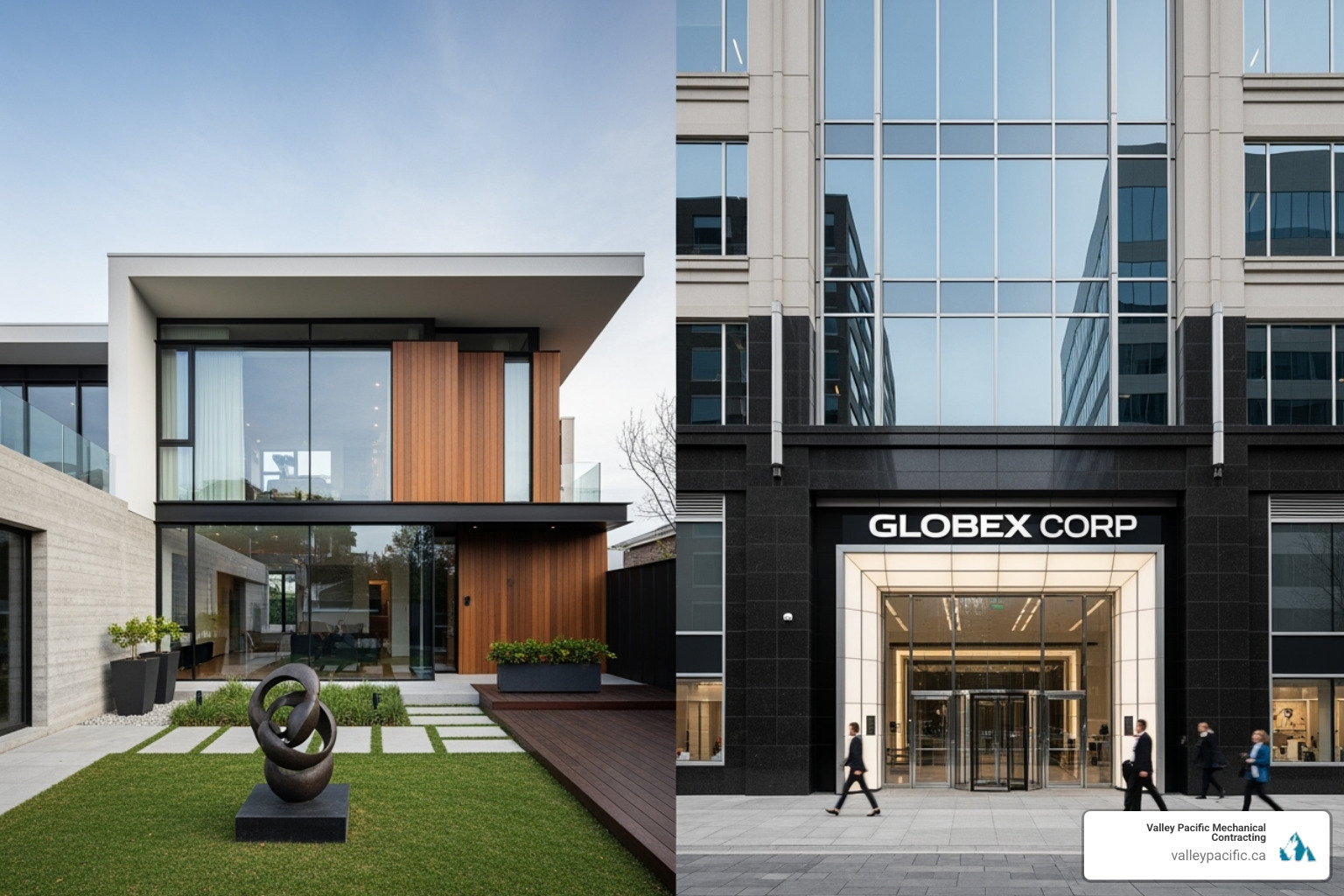
That's why we approach each project with fresh eyes, considering the unique challenges and architectural character of your property. Whether we're working on a busy restaurant or a quiet family home, our goal remains the same: delivering custom solutions that work beautifully with your building, not against it.
The beauty of modern mechanical system upgrades lies in their flexibility. Today's technology offers creative ways to solve even the trickiest installation challenges while preserving what makes your building special.
Commercial vs. Residential Mechanical System Upgrades
The world of mechanical system upgrades splits into two very different territories when we compare commercial and residential applications. It's like comparing a symphony orchestra to a jazz quartet - both create beautiful music, but they require completely different approaches.
Commercial systems operate on an entirely different scale. We're talking about system scale and complexity that can serve hundreds of people simultaneously. A typical office building might need to maintain comfort for varying occupancy patterns throughout the day - packed meeting rooms in the morning, quiet individual workspaces in the afternoon.
The IAQ requirements for commercial spaces often demand specialized solutions. Think about a busy restaurant kitchen or a medical clinic - these environments need robust ventilation systems that can handle specific air quality challenges. Commercial equipment also needs the durability to run continuously, often 24/7, without missing a beat.
Residential upgrades, on the other hand, focus on creating that perfect home environment. We're designing systems for families who want consistent comfort, quiet operation, and personalized control over their living spaces. The scale is smaller, but the attention to detail is just as important.
Our Residential services focus on creating comfortable, efficient homes, while our Commercial solutions tackle the complex demands of business environments. Each requires its own expertise and approach.
Challenges in Older and Historic Buildings
Working with older and historic buildings is where mechanical system upgrades become truly creative problem-solving. These beautiful structures weren't designed with modern HVAC systems in mind, which means we need to think outside the box.
Space constraints are usually our biggest puzzle. That gorgeous Victorian home or classic brick warehouse simply doesn't have room for bulky modern ductwork. We've become experts at finding creative solutions that work within these limitations.
Preserving architectural integrity is sacred to us. Nobody wants to see beautiful crown molding destroyed or neat facades marred by unsightly equipment. We work carefully to integrate new technology while maintaining the character that makes these buildings special.
Sometimes this means using mini-ducts that can snake through existing wall cavities without major demolition. Other times, we recommend split systems that provide excellent comfort with minimal impact on the building's structure. Each historic building presents its own unique set of challenges, and we love finding neat solutions.
The key is integrating new technology in ways that feel natural to the building. We've successfully upgraded everything from heritage homes to century-old commercial buildings, proving that you don't have to choose between modern comfort and historic charm.
For projects requiring this level of specialized care, our team brings decades of experience to HVAC Services Pitt Meadows and throughout the Lower Mainland.
Conclusion
Throughout this guide, we've finded just how transformative mechanical system upgrades can be for any building. From the impressive potential of $4.3 billion in annual energy savings to the day-to-day benefits of consistent temperatures and cleaner air, these improvements touch every aspect of how your building performs.
The technology driving these changes is genuinely exciting. Heat pumps are revolutionizing both space and water heating with incredible efficiency. Smart thermostats learn your habits and optimize comfort while you sleep. Advanced ventilation systems like HRVs and ERVs bring in fresh air without wasting the energy you've already spent conditioning your indoor environment.
The future is definitely efficient and integrated. We're moving toward all-electric solutions that eliminate fossil fuel dependence while reducing environmental impact. Integrated Mechanical Systems are combining multiple functions into single, space-saving units. These aren't just trends – they're practical solutions that make buildings work better for everyone inside them.
Taking the next step doesn't have to be overwhelming. With proper assessment, thoughtful planning, and the right professional guidance, upgrading your mechanical systems becomes a straightforward process that delivers lasting benefits.
At Valley Pacific Mechanical, we've spent over 30 years perfecting what we call a headache-free experience. We understand that your building's comfort systems should work seamlessly in the background, keeping you comfortable without constant worry about repairs or sky-high energy bills. Our comprehensive Mechanical Installations approach means we handle everything from initial assessment to final testing.
Whether you're in Mission, Maple Ridge, Langley, or anywhere in the Lower Mainland, our team is ready to help. For expert guidance on upgrading your system in HVAC Services Mission or HVAC Services Maple Ridge, contact our team today.
Ready to harness the efficiency of modern heat pump technology? Start your heat pump installation in Langley today and find what truly efficient heating and cooling feels like. Your future self – and your energy bills – will thank you.
Why Backflow Prevention Testing Protects Your Home's Water Supply
Backflow prevention testing is a mandatory annual inspection that ensures devices protecting your water supply from contamination are working properly. Here's what you need to know:
Key Testing Requirements:
- Annual testing required by municipal codes
- Certified tester must perform the inspection
- Property owners are responsible for scheduling and paying for tests
- Failed devices must be repaired immediately and re-tested
- Test reports must be submitted to your local water authority
- Non-compliance can result in fines or water service disconnection
Most homeowners don't think about their water supply until something goes wrong. But hidden within your plumbing system, specialized devices work around the clock to prevent contaminated water from flowing backward into your clean drinking water.
Backflow occurs when water flows in the wrong direction - bringing fertilizers from your sprinkler system, chemicals from your boiler, or other contaminants directly into the water you drink and cook with. In 2005, a car wash substance contaminated the water supply for 30,000 residents in Stratford, Ontario - an incident that could have been prevented with properly functioning backflow prevention devices.
These mechanical devices contain springs, seals, and moving parts that can wear out, get clogged with debris, or be accidentally bypassed. That's why testing is legally required - typically once per year - to verify they're still protecting your family and your community.
The testing process is straightforward but must be done by a certified professional. They'll connect specialized gauges to your device, monitor pressure changes, and provide you with official documentation for your municipal water authority.
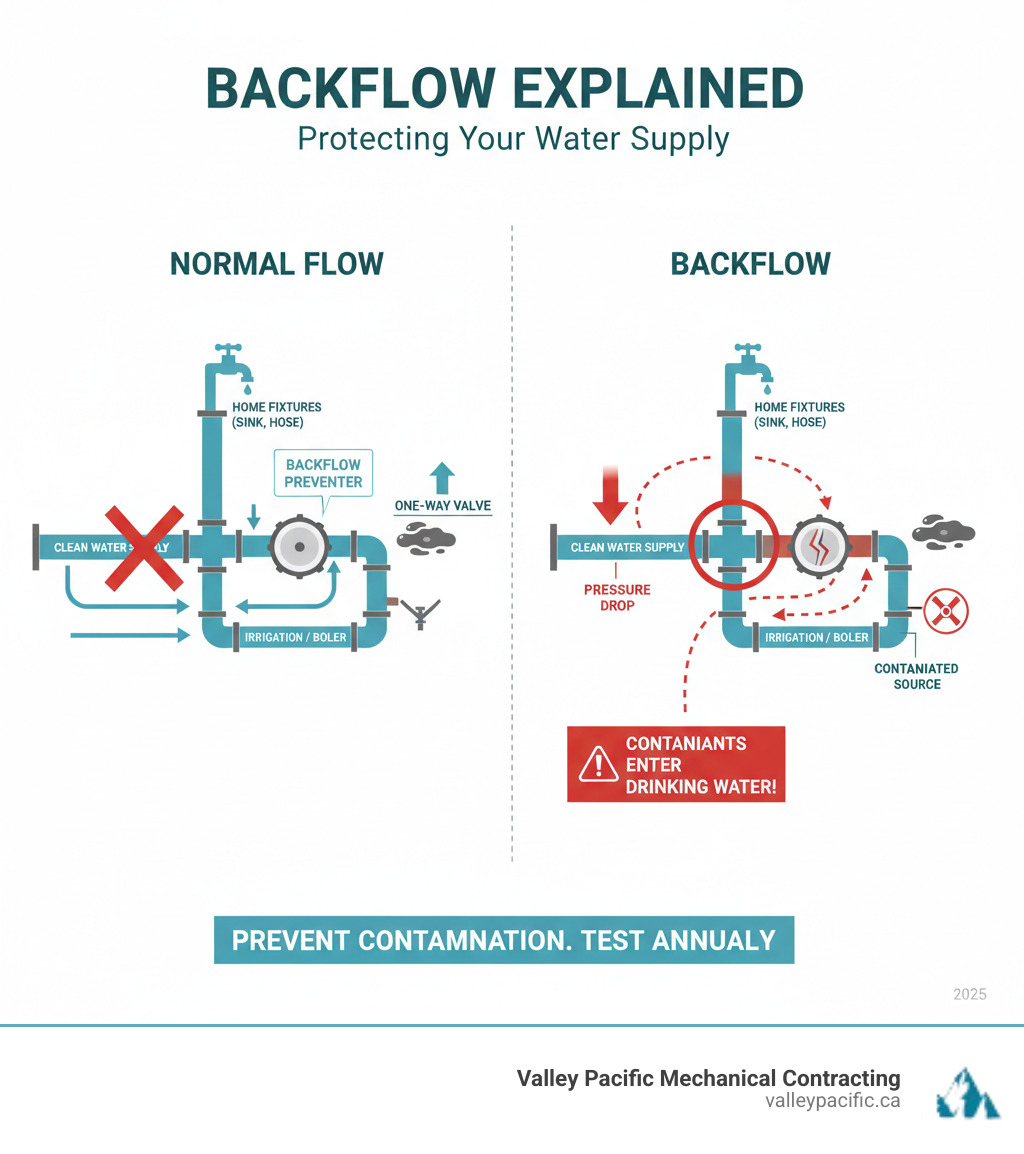
Know your backflow prevention testing terms:
Understanding Backflow: A Threat to Your Water Supply
Picture this: you turn on your kitchen tap expecting fresh, clean water, but instead get a nasty surprise. While this scenario might sound like something out of a horror movie, it's exactly what can happen when backflow occurs in your home's plumbing system.
Backflow is simply water flowing in the wrong direction – instead of clean municipal water flowing into your home, contaminated water from your property flows backward into the public water supply or other clean water lines in your house. Think of it like a river suddenly reversing course and flowing uphill.
This reverse flow becomes dangerous when there's what experts call a cross-connection – any physical link between your drinkable water supply and a non-drinkable source. Your garden hose sitting in a bucket of fertilizer water is a perfect example. Under the right conditions, that contaminated water can get sucked right back into your drinking water system.
The health risks are no joke. Contaminants can include pesticides from your sprinkler system, chemicals from industrial processes, human waste from sewer lines, or bacteria and viruses that can make your entire family sick. In some cases, entire communities have been affected when backflow contaminated the public water system.
That's why protecting potable water safety isn't just about your household – it's about being a good neighbor and protecting everyone's health. For more detailed information on cross-connection control, the EPA provides an in-depth guide that covers all the technical details.
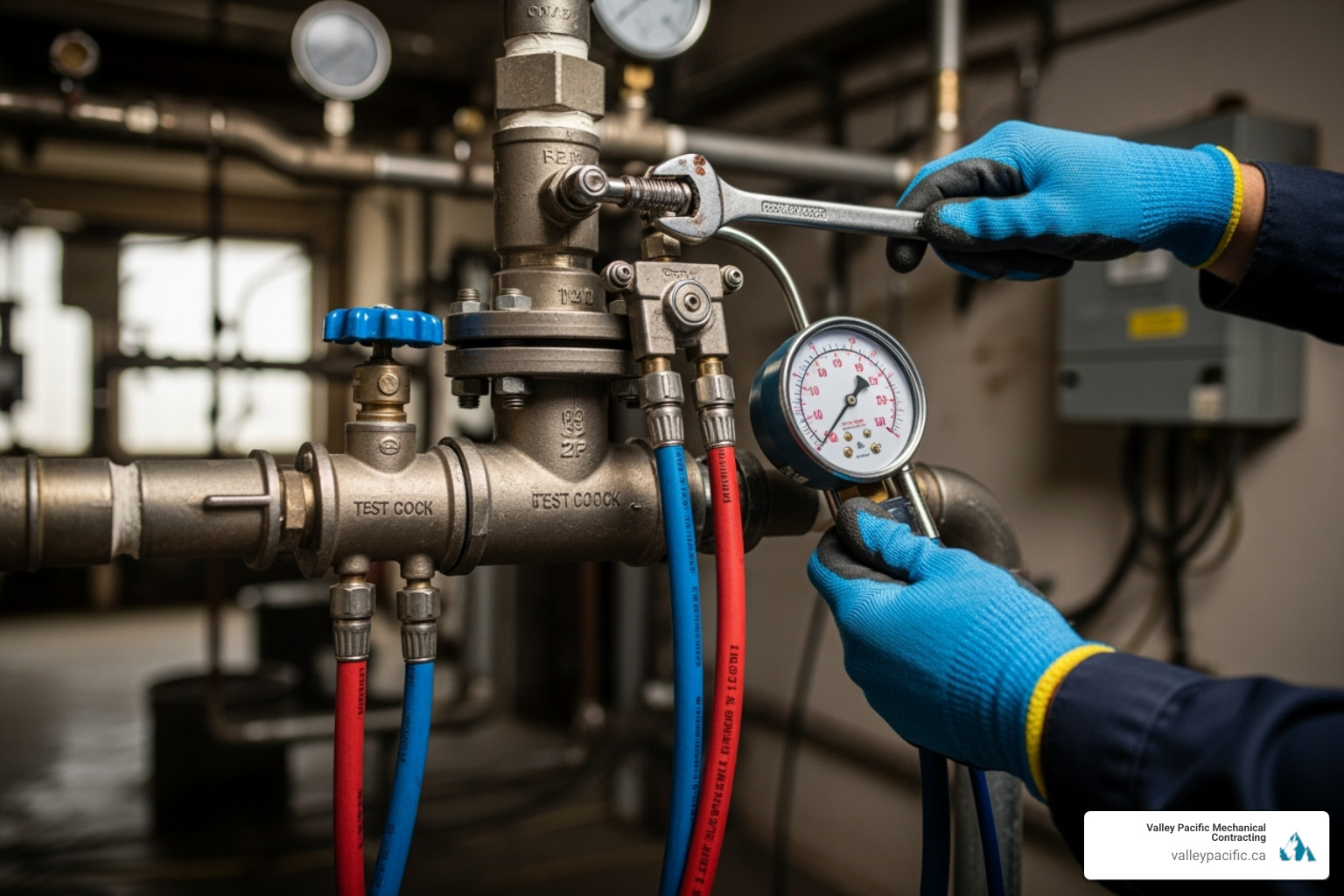
The Common Causes of Backflow
Backflow doesn't just happen randomly – it's usually caused by sudden changes in water pressure that create the perfect storm for contamination. There are two main culprits you should know about.
Back-siphonage happens when there's a sudden drop in pressure in your main water supply, creating a vacuum effect. It's like when you're drinking through a straw and accidentally suck too hard – whatever's at the other end comes rushing up. Water main breaks are a common cause, as they can drastically reduce pressure in nearby lines. Firefighting operations also create this problem when fire hydrants draw massive amounts of water quickly, causing negative pressure in the system.
Back-pressure works the opposite way – it occurs when the pressure inside your home's plumbing becomes higher than the pressure from the municipal supply. Instead of being sucked backward, contaminated water gets pushed into your clean water lines.
Boiler systems are frequent offenders here, especially when they have malfunctioning pressure relief valves or issues with thermal expansion. When water heats up, it expands, and in a closed system, this can create serious pressure buildup. Lift piping – water lines that go to higher elevations in your home – can also create enough pressure to cause problems.
The good news? Understanding these pressure changes helps explain why backflow prevention testing is so important for keeping your water safe. For more information about preventing various water system failures in your home, check out our guide on preventing water system failures.
The Role of Backflow Prevention Devices
Think of backflow prevention devices as the unsung heroes of your plumbing system. These specialized guardians work silently behind the scenes, making sure water only flows in the right direction – away from contamination sources and toward your clean drinking water.
The most effective approach is called premise isolation. This means installing a backflow prevention device right at your property's main water connection. It's like having a security checkpoint that protects the entire public water supply from anything that might go wrong on your property.
But not all properties face the same risks. That's why these devices are selected based on hazard levels – essentially how dangerous the potential contamination could be.
Minor hazard situations might just affect how your water tastes or looks, but won't make you sick. Think of a cross-connection that could add harmless minerals to your water supply.
Moderate hazard involves substances that could cause minor health issues or be a nuisance, but aren't likely to seriously harm anyone. This might include certain non-toxic chemicals or additives.
Severe hazard is the big concern – any contamination that could seriously threaten public health. This includes industrial facilities, hospitals, dental offices, car washes, and properties with chemical fire suppression systems. Even your home's irrigation system falls into this category because of fertilizers and pesticides.
The goal is system protection that matches the risk level. A minor hazard doesn't need the same heavy-duty protection as a severe one. Getting this match right is crucial for keeping everyone's water safe.
Our experienced team at Valley Pacific Mechanical understands these requirements inside and out. We provide expert guidance and professional installation as part of our comprehensive Plumbing Services in Maple Ridge BC.
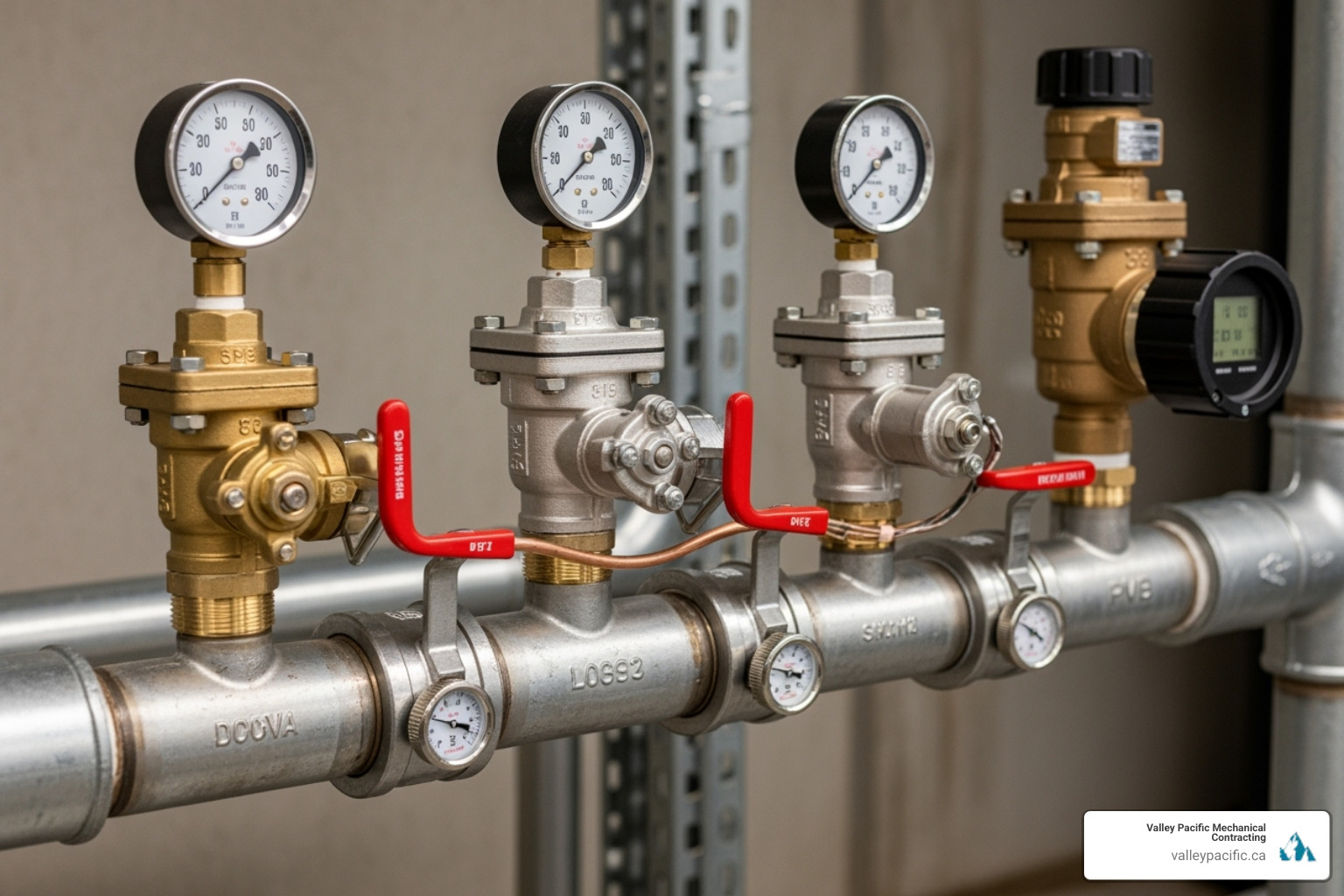
Types of Backflow Preventers
When it comes to choosing the right backflow preventer, it's all about matching the device to your specific needs. Each type has its strengths and is designed for particular situations.
The Reduced Pressure Principle Assembly (RP) is like the premium security system of backflow prevention. This robust device features two independent check valves with an automatic pressure relief valve sitting between them, plus shut-off valves on both ends. If either check valve fails, that relief valve immediately opens and dumps water to the ground – a clear sign something's wrong. RPs are required for severe hazard applications because they're incredibly reliable and can handle the toughest conditions.
The Double Check Valve Assembly (DCVA) is the workhorse for moderate hazard situations. It has two independent check valves and shut-off valves, but no relief valve. This makes it effective against both back-pressure and back-siphonage, though it can't handle extreme pressure situations like an RP can. It's a solid choice when the contamination risk isn't life-threatening.
Pressure Vacuum Breakers (PVB) are commonly seen on sprinkler systems and are specifically designed to prevent back-siphonage. They have a spring-loaded check valve and an air inlet valve that opens when pressure drops, breaking any vacuum that could suck contaminated water backward. However, PVBs aren't suitable when there's risk of back-pressure or when the device needs to be under constant pressure.
The Air Gap is beautifully simple – it's literally an open space between your water supply pipe and any potential contamination source. Picture the gap between your kitchen faucet and the sink rim. Since there's no physical connection, backflow is impossible. Air gaps need no testing and never fail, but they're not practical for every application.
Proper device selection isn't guesswork – it's determined by local plumbing codes, your specific application, and the assessed hazard level. That's why backflow prevention testing by certified professionals is so important to ensure these devices continue protecting your water supply year after year.
The Essentials of Backflow Prevention Testing
Think of your backflow prevention device like the brakes on your car. You trust them to work when you need them, but would you drive for years without having them checked? That's essentially what happens when property owners skip their backflow prevention testing.
These mechanical devices work hard behind the scenes, but they're not invincible. Springs lose their tension, seals crack over time, and debris can sneak in and jam up the works. What looks fine from the outside might be completely compromised on the inside.
Regulatory compliance isn't just red tape – it's a lifeline for our community's water supply. Municipal by-laws across the Lower Mainland mandate regular testing because water quality protection is serious business. The public health mandate behind these rules comes from real-world disasters where contaminated water made entire communities sick.
The consequences of non-compliance can hit you where it hurts. We're talking about hefty fines that can run into thousands of dollars. Even worse? Your municipality can order a complete water supply shut-off until you get compliant. Imagine explaining to your family why there's no water for showers, cooking, or even flushing toilets – all because of a skipped test.
For property owners who want to understand their obligations better, Ontario provides A guide to backflow prevention programs that breaks down the requirements clearly.
Why is Backflow Prevention Testing Necessary?
Here's the reality: device failure happens more often than you'd think. Those precision-engineered check valves and relief valves? They're constantly battling water pressure, temperature changes, and whatever debris comes through your pipes.
Worn parts are inevitable. Seals deteriorate, springs weaken, and moving components can stick or break entirely. Debris fouling is another silent killer – a small piece of rust or sediment can prevent a valve from closing properly, leaving your water supply vulnerable.
The annual requirement isn't arbitrary. It's based on decades of research showing that mechanical devices need regular check-ups to keep functioning reliably. Ensuring proper function through testing catches problems before they become disasters.
But beyond the mechanics, there's a bigger picture. This is your legal obligation as a property owner, and it's about protecting community water for everyone. When your device fails, it's not just your family at risk – it's your entire neighborhood's water supply that could become contaminated.
Think of backflow prevention testing as insurance for your peace of mind. It's a small annual investment that protects something irreplaceable – the safety of the water you and your community depend on every day.
The Backflow Testing Process: What to Expect
When it's time for your annual backflow prevention testing, you might be wondering what exactly happens during this process. Don't worry – it's more straightforward than you might think, and our certified technicians at Valley Pacific Mechanical handle everything to give you that headache-free experience we're known for.
The first thing to know is that this isn't a job you can tackle yourself. Certified testers are required by law, and they need specialized training and equipment to perform these tests properly. We've invested in the proper certification and professional-grade test kits to ensure your testing meets all municipal and provincial standards throughout the Lower Mainland.
Here's what you can expect when we arrive at your property. Our technician will start by locating your backflow prevention device – it's usually installed near your water meter or at specific cross-connection points like where your irrigation system connects. Once we've found it, we'll connect our specialized test kit equipped with pressure gauges to the device's test cocks. These gauges let us measure the pressure differentials across all the internal components of your backflow preventer.
The actual testing involves systematically opening and closing valves while monitoring those gauges. We're checking to make sure the check valves and relief valve (if your device has one) are holding pressure and operating exactly as the manufacturer intended. Think of it like giving your device a thorough physical exam – we're making sure every part is doing its job to prevent backflow effectively.
Now, here's the part that catches some homeowners off guard: we'll need to temporarily shut off your water during the test. But before you panic about being without water all day, know that this usually only takes about 30 minutes. We work efficiently to minimize any disruption to your daily routine, and since we don't drain the system, there's no waiting around for lines to refill afterward.
Once the test is complete, we handle all the documentation for you. We'll fill out the official Test & Maintenance Report that records whether your device passed or failed and notes any repairs that might be needed. This paperwork is crucial for regulatory compliance, and we'll submit it directly to your local water authority – no extra work for you.
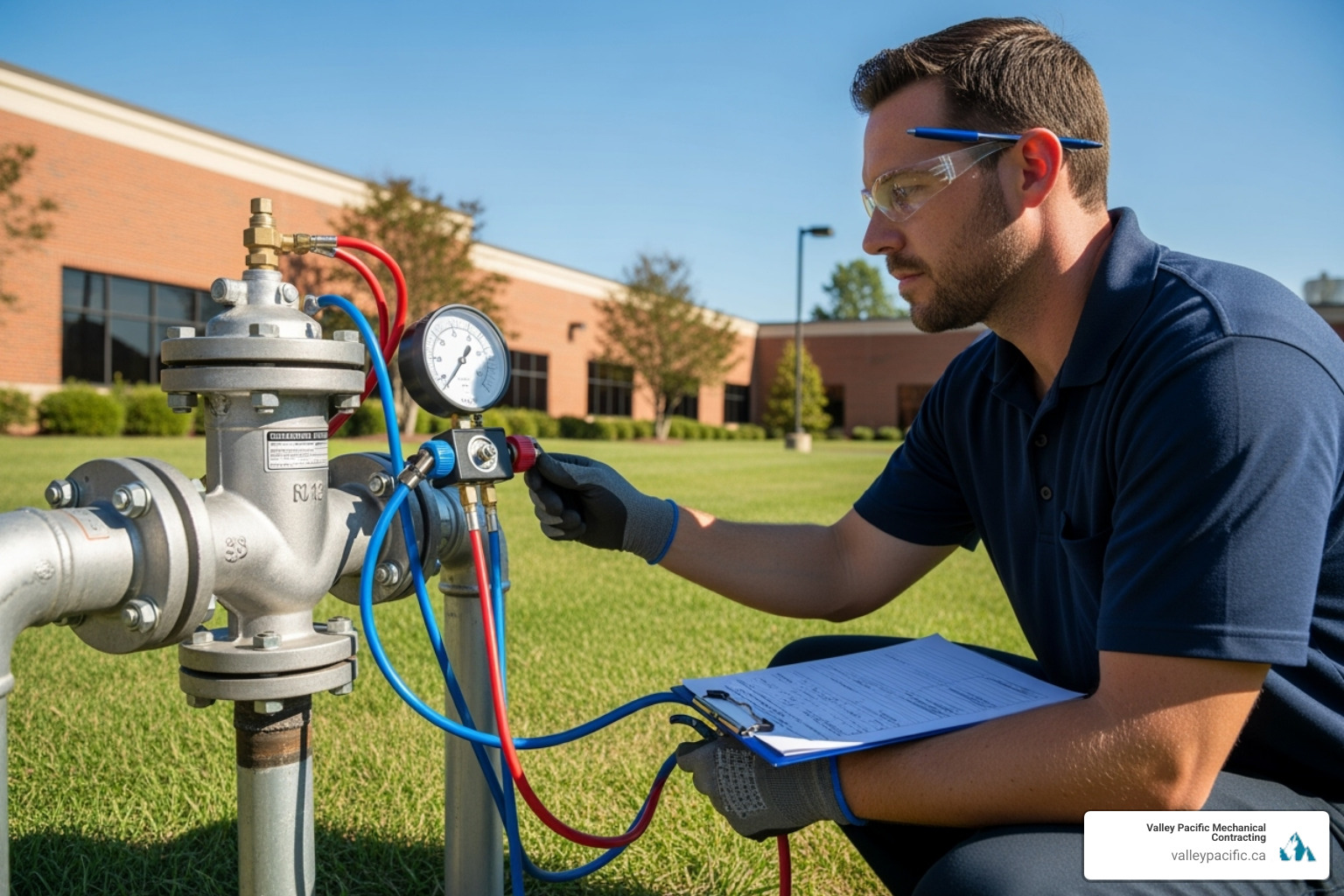
How often is backflow prevention testing required?
The simple answer is annually – most municipal codes and water authorities throughout the Lower Mainland require backflow prevention testing once every year. But that's not the only time your device needs attention.
Upon installation of any new backflow prevention device, testing is mandatory. This ensures your device was installed correctly and is protecting your water supply from day one. Similarly, after repairs or maintenance work, your device must be re-tested to verify everything is working properly again.
If your device ever needs to be moved or relocated for any reason, that triggers another testing requirement. Manufacturer instructions also play a role – they often specify their own testing intervals that must be followed alongside municipal requirements.
The key thing to remember is that your municipal code is the final authority on testing frequency. Whether you're in Langley, Maple Ridge, Coquitlam, or anywhere else in the Lower Mainland, it's worth checking with your local water provider to confirm their specific requirements. While annual testing is the standard, some municipalities might have slightly different rules based on your property type or risk level.
Who is responsible for backflow prevention testing?
This one's crystal clear: the property owner is responsible. That means if you own the property, the buck stops with you when it comes to backflow prevention testing.
While Valley Pacific Mechanical provides the certified testers and handles the actual testing process and documentation, you as the property owner need to make sure it happens. This means hiring certified testers like us to perform the annual inspection, and ensuring that all the proper reports get submitted to your water authority.
Maintaining records is another part of your responsibility. Even though we typically handle submitting the Test & Maintenance Report directly to the water authority, you should keep copies of all test reports and maintenance records for your own files. This documentation proves you're staying compliant with local regulations.
This responsibility applies whether you own a single-family home with an irrigation system, a multi-residential building, or a commercial property. The bottom line is that protecting the community's water supply starts with individual property owners taking care of their backflow prevention devices – and that's where we come in to make the whole process as smooth as possible for you.
Frequently Asked Questions about Backflow Prevention
When it comes to backflow prevention testing, we get a lot of questions from homeowners across the Lower Mainland. Let's clear up some of the most common concerns we hear about.
Do I need a backflow preventer for my lawn irrigation system?
Yes, absolutely. This is one of the most common requirements, and for good reason. Your lawn irrigation system is what we call a high-risk cross-connection, and here's why that matters.
Think about what happens to the water sitting in your sprinkler lines. It's not moving constantly like the water in your kitchen tap. Instead, it sits there, potentially picking up fertilizers and pesticide contamination from your lawn treatments. If you've got pets or wildlife in your yard, there could be other unpleasant surprises mixed in too.
Now imagine what happens during a water main break or when the fire department is using hydrants nearby. The sudden pressure drop can create a vacuum effect, pulling all that contaminated water back through your pipes. Without a backflow preventer, those chemicals and contaminants could end up in your drinking water - or worse, in the public water supply affecting your entire neighborhood.
Most municipal codes specifically require backflow prevention devices on irrigation systems. It's not just about protecting your home's water supply; it's about being a responsible member of your community and protecting the public water system we all depend on.
What happens if my device fails the test?
Nobody likes to hear their device has failed, but it's actually better to find out during testing than to find it when contamination has already occurred. When your backflow preventer fails its test, here's what needs to happen next.
First, don't panic. The certified tester will explain exactly what went wrong - maybe a check valve isn't sealing properly, or a relief valve is stuck. These are mechanical devices with moving parts, and like your car or furnace, they occasionally need attention.
Immediate repair is required - this isn't something you can put off until next month. The device needs to be fixed or replaced right away because it's no longer protecting your water supply. Our team at Valley Pacific can handle these repairs promptly, often the same day.
Once the repair is complete, re-testing is required to make sure everything is working correctly. Think of it like a follow-up appointment after medical treatment - we need to confirm the fix was successful. Only after the device passes this second test can we submit a passing report to your local water authority.
The key is acting quickly. Delays can lead to fines or even water service interruption until the problem is resolved. That's why we offer 24/7 emergency service - because protecting your water supply can't wait for regular business hours.
How do local backflow programs vary?
Here's where things get interesting - and sometimes a bit confusing. While every municipality wants to protect drinking water, they don't all go about it in exactly the same way.
Municipal by-laws vary significantly, even here in the Lower Mainland. Langley might have different requirements than Maple Ridge, and Mission could have its own unique approach. What stays consistent is the goal: keeping contaminated water out of the clean supply.
Reporting procedures can be quite different too. Some cities use online systems where test results get uploaded directly, while others prefer traditional paper submissions. The timelines for compliance, the specific forms required, and even the penalties for non-compliance can vary from one community to another.
Hazard level definitions might seem straightforward, but different municipalities can have their own interpretations of what constitutes a severe versus moderate risk. A facility that's classified one way in Coquitlam might be viewed differently in another city.
The bottom line? Check with your local water authority for the specific requirements in your area. Our technicians are familiar with regulations across all the communities we serve, so we can help guide you through your local compliance process and make sure you're meeting all the right requirements.
Don't let the variations worry you though - the fundamentals of backflow prevention testing remain the same everywhere. It's really just the paperwork and timelines that differ.
Conclusion
When you turn on your kitchen faucet tomorrow morning, clean water will flow out like it always does. But behind that simple act lies an intricate system of pipes, pressure, and protection that most of us never think about. Backflow prevention testing is one of those invisible safeguards that keeps working quietly in the background, making sure the water coming out of your tap is as pure as it should be.
Think of it this way: your backflow preventer is like a security guard for your water supply. Just like you'd want to make sure your security system is working properly, these devices need their annual check-up to ensure they're still doing their job. It's not just about following the rules – though those municipal bylaws exist for good reason. It's about protecting your water supply and knowing that every glass of water you pour is safe for your family.
The beauty of proactive maintenance is that it prevents problems before they start. A failed backflow device isn't something you want to find during an emergency. By staying on top of your testing schedule, you're buying yourself peace of mind and avoiding the headache of dealing with contaminated water or, worse yet, having your water service shut off.
As a property owner, this responsibility might feel like just another item on your to-do list. But when you consider that you're helping protect not just your own family but your entire community's water supply, it becomes something bigger. It's about being a good neighbor and doing your part to keep everyone safe.
At Valley Pacific Mechanical, we understand that dealing with municipal requirements and technical testing can feel overwhelming. That's exactly why we focus on providing a headache-free experience for all our clients across the Lower Mainland. Our certified technicians handle everything from the actual testing to submitting the paperwork to your local water authority, so you can check this important task off your list without the stress.
Whether you need backflow prevention testing in Maple Ridge, plumbing repairs in Langley, or any other mechanical service, we bring the same commitment to quality and customer care that we've built over 30+ years in business. We're here when you need us, with 24/7 emergency service and the expertise to get things done right the first time.
For professional and reliable home mechanical services, from plumbing to HVAC, contact Valley Pacific. Learn more about our expert heat pump services in Langley, BC and ensure your home systems are running smoothly.
Why Boiler System Maintenance is Essential for Your Home
Boiler system maintenance is key to keeping your heating system running safely, efficiently, and reliably. Just as your car needs regular tune-ups, your boiler requires consistent care to perform at its best.
Essential Boiler Maintenance Tasks:
- Annual professional service: Cleaning, tuning, and safety checks.
- Monthly homeowner checks: Visual inspections for leaks and unusual sounds.
- Quarterly tasks: Bleeding radiators and checking water pressure.
- Immediate attention: Addressing warning signs like yellow flames or pilot light issues.
Your boiler works hard to keep your home comfortable. With proper maintenance, a residential boiler can last 25 to 30 years. However, neglected boilers pose greater safety risks and may not reach their full 15-year average lifespan.
When maintenance is neglected, boilers can develop dangerous carbon monoxide leaks, experience costly breakdowns, and waste energy. High-efficiency systems maintain AFUE ratings between 90-98%, while neglected older models can drop to just 56-70% efficiency.
Regular maintenance protects your family's safety, your wallet, and your peace of mind. Understanding proper boiler care is crucial for every homeowner.

Terms related to Boiler system maintenance:
Why Regular Boiler Maintenance is a Smart Investment
Proactive boiler system maintenance is a smart investment that pays dividends in comfort, safety, and savings. Skipping it can lead to expensive surprises, higher bills, and dangerous situations. Let's explore why this investment will save you headaches down the road.
Boost Efficiency and Lower Your Energy Bills
When soot builds up on the heat exchanger or scale from hard water creates a barrier, your boiler is forced to work overtime. This buildup acts as unwanted insulation, preventing efficient heat transfer and wasting fuel.
A high-efficiency boiler system with regular cleaning and tuning can maintain an Annual Fuel Utilization Efficiency (AFUE) rating of over 90%. In contrast, older, unmaintained models can drop to a disappointing 56-70% efficiency. If your boiler is only 60% efficient, you're throwing away 40 cents of every dollar spent on heating fuel. Regular boiler system maintenance ensures optimal heat transfer and combustion, keeping your energy bills reasonable.
The Critical Role of Safety in Boiler System Maintenance
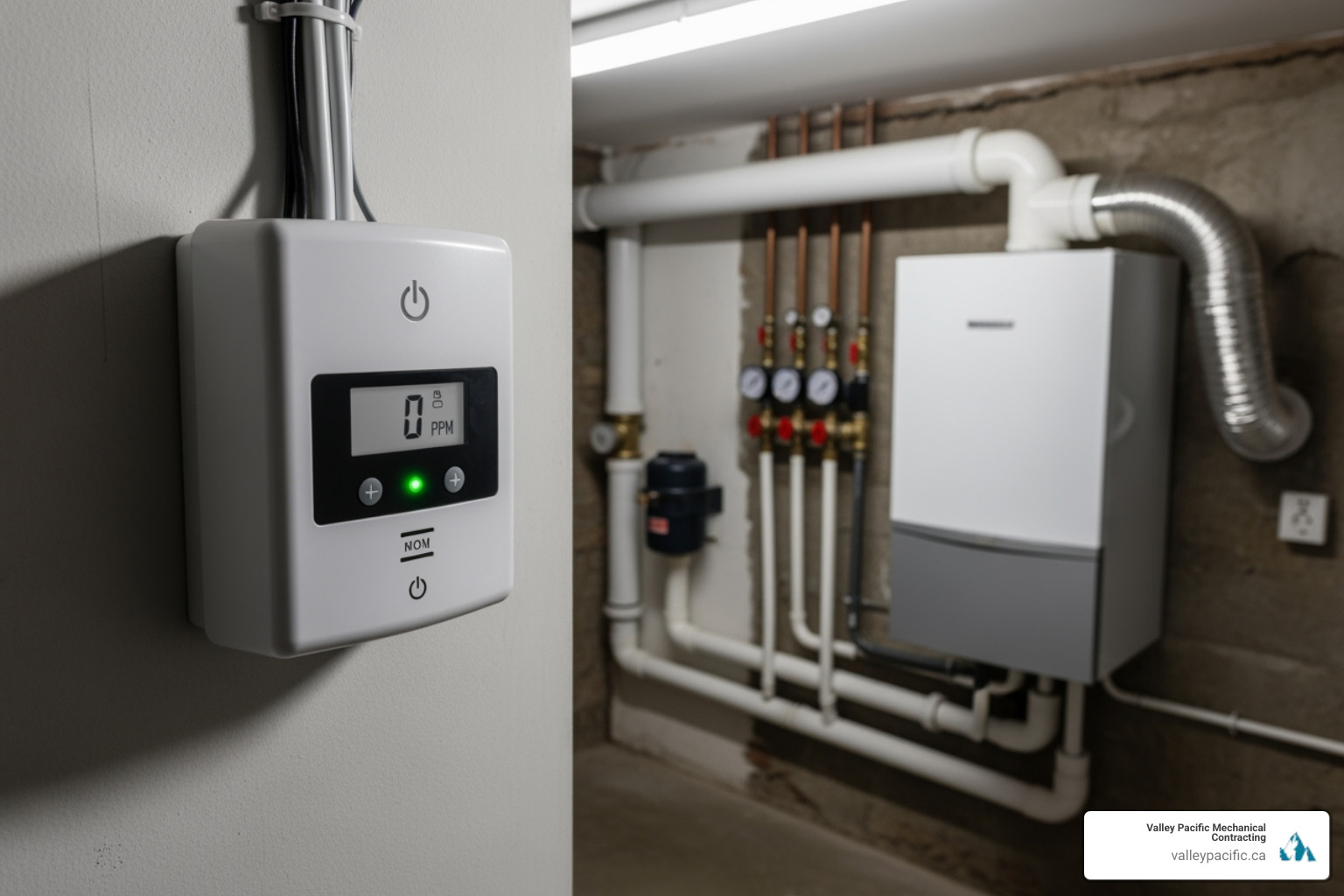
Safety is the most important reason for regular maintenance. A faulty boiler can leak deadly carbon monoxide (CO) gas, an invisible, odorless threat.
During a professional service, a technician checks for proper ventilation to ensure dangerous gases are safely routed outside. They inspect the burner for signs of incomplete combustion, the primary cause of CO production.
Testing safety mechanisms like pressure relief valves and controls is also critical to prevent dangerous pressure buildup. The technician will also look for gas and water leaks that can escalate into major hazards.
Boilers that don't receive proper care pose greater safety risks and often don't reach their expected 15-year lifespan. Investing in regular boiler system maintenance protects your heating system and your family's safety.
A Homeowner's Guide to Boiler Components and Water Quality
Understanding your boiler's basic parts helps you spot trouble early. Knowing the fundamentals of boiler system maintenance empowers you to catch small problems before they become expensive headaches.
Understanding Your Boiler's Anatomy
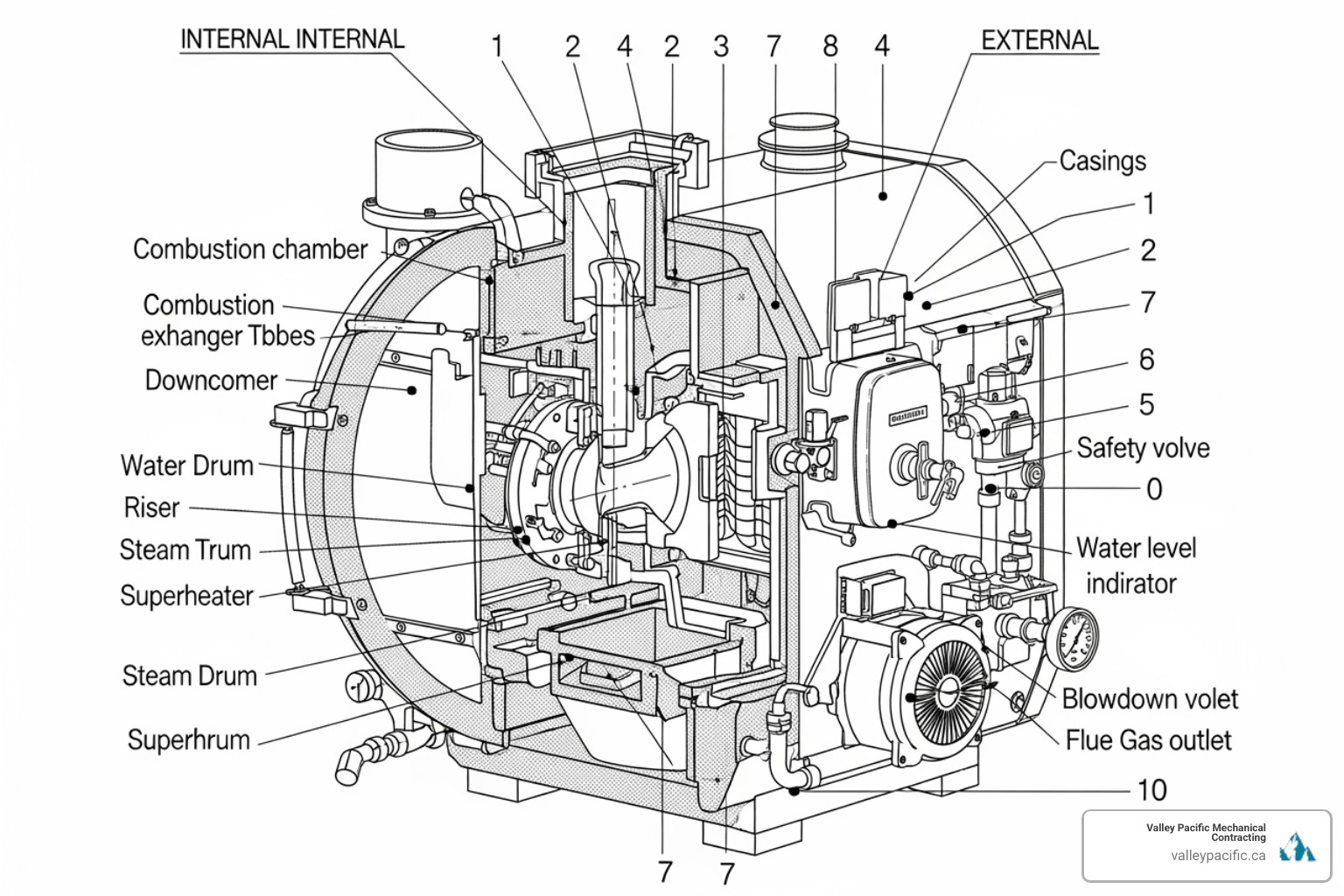
Most boilers share the same essential components:
- The heat exchanger transfers heat from the fuel to the water. Buildup here reduces efficiency.
- The burner burns gas or oil to create heat. A clean burner ensures efficient combustion.
- The circulating pump moves heated water through your system, whether to radiators or radiant tubing embedded in the floor.
- The pressure gauge is a vital safety monitor, showing if the system is operating within safe limits.
- Safety valves release pressure if it builds up beyond a safe level, preventing damage.
- The vents or flues are the exhaust system, safely removing combustion gases like carbon monoxide. A blockage is a serious safety hazard.
Best Practices for Boiler Water Treatment
Poor water quality is a sneaky threat to your boiler.
Hard water is the most common culprit, causing scale buildup on the heat exchanger. This forces your system to work harder and burn more fuel. Corrosion from untreated water can eat away at metal components, leading to leaks and a boiler leaking water.
Proper water treatment can prevent these issues. Regular system flushing removes sediment and sludge. For homes with hard water, chemical water treatment can prevent scale and neutralize corrosive elements. Professional water quality monitoring allows a technician to test your water and recommend the right approach for your system.
The Ultimate Boiler System Maintenance Checklist
A structured approach to boiler maintenance ensures nothing gets overlooked. This includes simple DIY checks and comprehensive professional servicing.
DIY Boiler Maintenance Tasks for Homeowners
While professional annual servicing is essential, you can perform simple checks between visits to spot minor issues early.
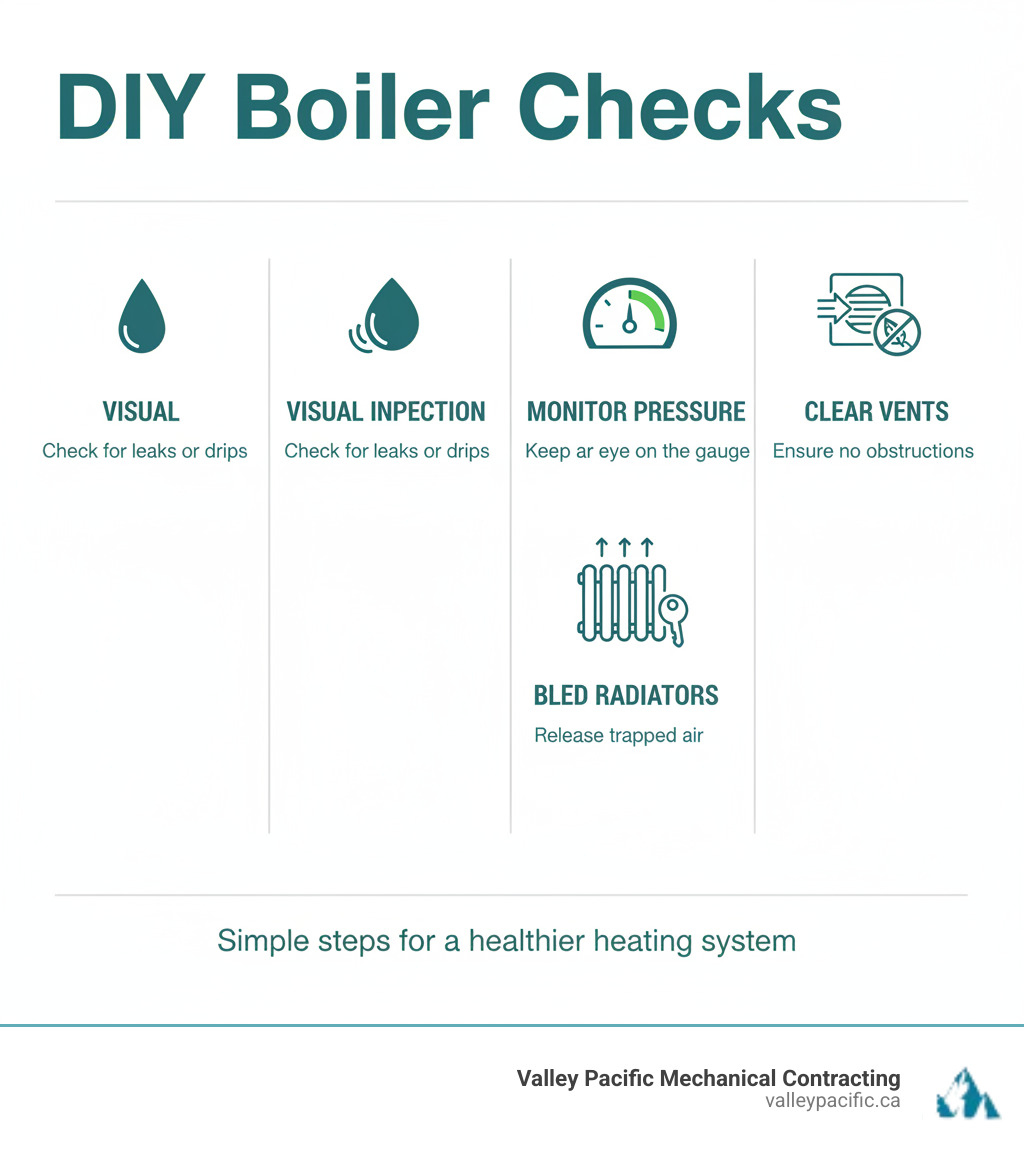
- Visual inspections: Monthly, look for water drips or puddles around the boiler, pipes, and radiators.
- Check the pressure gauge: Ensure the pressure is within the normal range for your system. If it's consistently too low or high, it needs attention. Learn what to do when boiler pressure drops.
- Bleed radiators: If radiators are cold at the top, release trapped air with a radiator key to restore even heating.
- Keep vents clear: Ensure the area around your boiler and any external vents are free of obstructions to maintain proper airflow and prevent CO buildup.
- Listen for unusual noises: Banging, whistling, or gurgling can indicate scale buildup or pump issues.
- Check the flame color: A healthy gas boiler flame is blue. Yellow or orange flames suggest a combustion problem that needs immediate professional attention.
What to Expect from a Professional Boiler Service
A professional service addresses issues you can't handle on your own.
A professional boiler system maintenance service includes:
- Thorough cleaning: Removing efficiency-robbing soot and scale from fireside and waterside surfaces.
- Burner tuning: Using specialized equipment to fine-tune the burner for optimal, clean, and safe combustion.
- Control and sensor calibration: Testing thermostats, pressure limits, and temperature sensors for accuracy.
- Safety testing: Verifying that all safety interlocks, such as low water cut-offs and pressure relief valves, are functioning correctly.
- Component inspection: Lubricating moving parts, checking electrical connections, and identifying worn components.
- Flue gas analysis: Testing combustion efficiency and safety to identify any carbon monoxide concerns.
After the service, you'll receive a detailed report with findings and recommendations. Many homeowners opt for service agreements for scheduled maintenance and priority access to expert help, like our Boiler Repair Langley Guide.
Red Flags: When Your Boiler Needs Immediate Attention
Your boiler often sends signals before it fails. Recognizing these red flags can be the difference between a simple repair and a costly emergency breakdown.
- Unusual Noises: Banging (kettling from scale buildup), whistling (trapped air), or gurgling (low water pressure) are signs of trouble.
- Leaks or Dripping: Any water pooling near the unit can signal a failing seal or corroded pipe and should be addressed immediately. See our guide on a boiler leaking water.
- Pressure Problems: If your gauge shows pressure that is consistently too low or too high (most systems are 1-1.5 bar), there is an underlying issue. Boiler pressure issues affect both efficiency and safety.
- Pilot Light Issues: A pilot light that goes out or burns yellow/orange instead of blue indicates a combustion problem and potential carbon monoxide risk.
- Lack of Heat: If you have cold radiators or no hot water from your boiler, it's a clear sign of a problem requiring professional attention.
- Increased Energy Bills: A sudden spike in bills can mean your boiler has lost efficiency due to internal buildup or worn parts.
- Unpleasant Odors: Smells of gas, metal, or burning are serious. Turn off the system, ventilate the area, and call for emergency service.
Deciding to Repair or Replace Your Boiler
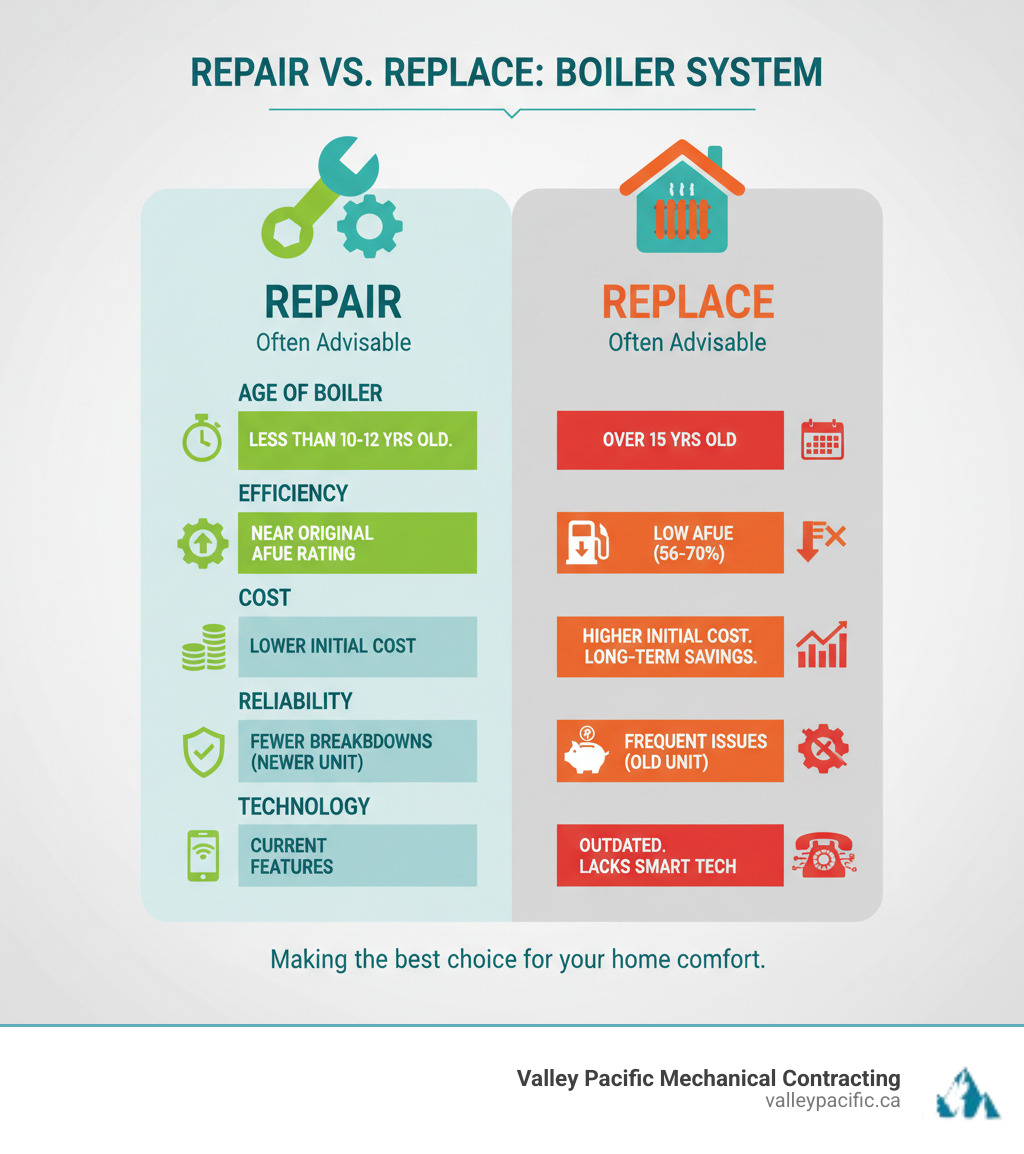
When faced with a major issue, consider these factors to decide between repair and replacement:
- Age: Repairs often make sense for boilers under 10-12 years old. For systems over 15 years, replacement is often more attractive.
- Efficiency: If your older boiler's efficiency has dropped significantly, a new high-efficiency unit can pay for itself in energy savings.
- Cost of Repairs: If a repair costs more than 50% of a replacement, or if you need frequent service calls, an upgrade is likely the better investment.
- Parts Availability: Parts for older systems can be hard to find and expensive.
- Safety: If your boiler has ongoing safety issues like CO risks, replacement is essential.
A professional can help you weigh these factors and guide you through the professional boiler replacement process. A new boiler is a larger upfront investment, but improved efficiency and reliability often make it the smarter long-term choice, simplifying future boiler system maintenance.
Understanding Boiler Inspections and Safety Standards
Beyond regular boiler system maintenance, different inspections ensure your system operates safely and legally.
Service inspections are part of your routine maintenance plan, conducted by qualified professionals like our team. We take a proactive look at your boiler's operational components, checking efficiency and overall health to catch potential issues before they become major problems. These are typically performed annually.
Jurisdictional inspections (or "state inspections") are often required by law, especially for commercial and industrial facilities. Conducted by state-authorized inspectors, their mission is to ensure your boiler meets specific safety codes and regulations set by organizations like the American Society of Mechanical Engineers (ASME) and the Occupational Health and Safety Administration (OSHA).
The key difference is that service inspections focus on efficiency and proactive care, while jurisdictional inspections focus on public safety and legal compliance. We help our commercial clients stay ready for both types of inspections, ensuring they meet all required safety standards.
Frequently Asked Questions about Boiler Maintenance
Here are answers to the most common questions we hear from homeowners about boiler care.
How often should I have my residential boiler serviced?
We highly recommend professional boiler system maintenance once a year, every year. The ideal time is late summer or early fall, before the heating season begins. This allows any potential issues to be addressed before you need reliable heat and helps you avoid competing with emergency calls during busy winter months.
What is the biggest safety risk if I neglect my boiler?
Carbon monoxide (CO) poisoning is the most serious danger. CO is a colorless, odorless, and potentially fatal gas that can be produced by a poorly maintained boiler with combustion or ventilation problems. Other risks include gas leaks and, in rare cases, pressure system failures. Regular professional boiler system maintenance ensures proper combustion and tests safety controls to prevent these hazards.
Can I save money by doing all the maintenance myself?
While DIY tasks like visual inspections are valuable, attempting complex boiler system maintenance yourself is risky. Tasks like burner tuning, gas pressure adjustments, and safety control testing require specialized training and tools to be performed safely. Improper maintenance can create dangerous situations, void your boiler's warranty, and lead to more expensive emergency repairs. For reliable service, including expert boiler repair in Coquitlam, it's best to trust a certified professional.
Conclusion: Partner with a Pro for Peace of Mind
Regular boiler system maintenance is one of the smartest investments for your home's comfort, safety, and budget. A little attention now prevents big headaches later. By performing simple monthly checks and scheduling a crucial annual professional service, you ensure your boiler runs efficiently, lasts longer, and keeps your family safe from dangers like carbon monoxide leaks.
The peace of mind from knowing your heating system is in expert hands is priceless. At Valley Pacific Mechanical, we've provided that 'headache-free' experience for over 30 years across Mission, Maple Ridge, Langley, and the Lower Mainland. Our certified technicians know what it takes to keep your boiler running smoothly.
Don't wait for a breakdown to act. We're here 24/7 for emergencies, but our goal is to help you avoid them through proper maintenance.
Ready to give your boiler the expert attention it deserves? Schedule your boiler installation in Langley or book a maintenance service with our experienced team today. Let's work together to keep your home warm and safe.
Why Modern Homes Need Advanced HVAC Solutions
Residential HVAC solutions have evolved far beyond basic furnaces and air conditioners. Today's homeowners can choose from smart thermostats, ductless mini-splits, geothermal systems, and hybrid technologies that deliver precise comfort while reducing energy costs by up to 20% compared to conventional systems.
Quick Overview of Residential HVAC Options:
- Ducted Systems: Traditional furnaces and central AC for whole-home coverage
- Heat Pumps: All-in-one heating and cooling with high efficiency ratings
- Ductless Mini-Splits: Targeted comfort for specific rooms without ductwork
- Smart Technology: Wi-Fi thermostats, zoning systems, and automated controls
- Specialty Systems: Geothermal, hydronic, and hybrid dual-fuel options
The HVAC industry has transformed dramatically. Smart connectivity, variable-speed technology, and advanced air quality features are now standard in many systems. Whether you're dealing with hot and cold spots, high energy bills, or planning a renovation, there's likely an innovative solution designed for your specific situation.
Modern systems also integrate seamlessly with smart home technology. Apps like LG ThinQ® and Carrier Smart Thermostats allow homeowners to control their comfort from anywhere while providing dealers with data to improve service quality.
The move toward sustainability has introduced options like air-to-water heat pumps, solar integration, and systems that qualify for federal tax credits up to $2,600. These aren't just environmental benefits - they translate to real savings on monthly utility bills.
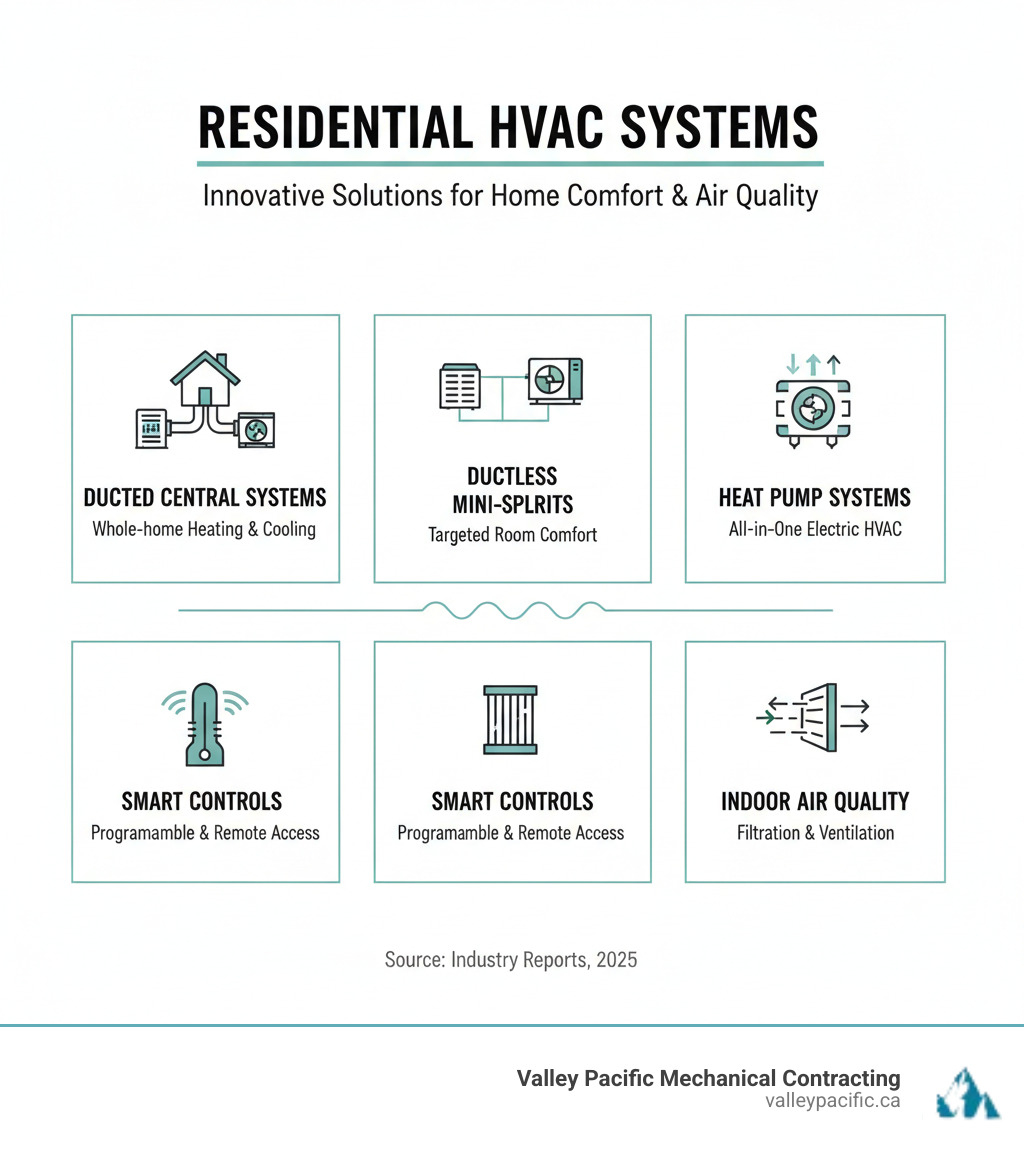
Residential HVAC solutions definitions:
Understanding the Core Types of Residential HVAC Systems
Finding the perfect residential HVAC solutions for your home can feel overwhelming at first, but it doesn't have to be! Think of it like choosing the right outfit for the weather - you need something that fits your specific situation. Whether you're dealing with the damp winters in Mission or those surprisingly warm summer days in Pitt Meadows, each type of HVAC system has its own personality and strengths.
The beauty of today's HVAC world is choice. You're not stuck with whatever your neighbor has or what was popular decades ago. Let's walk through the main players in the residential HVAC solutions game and see which one might be your perfect match.
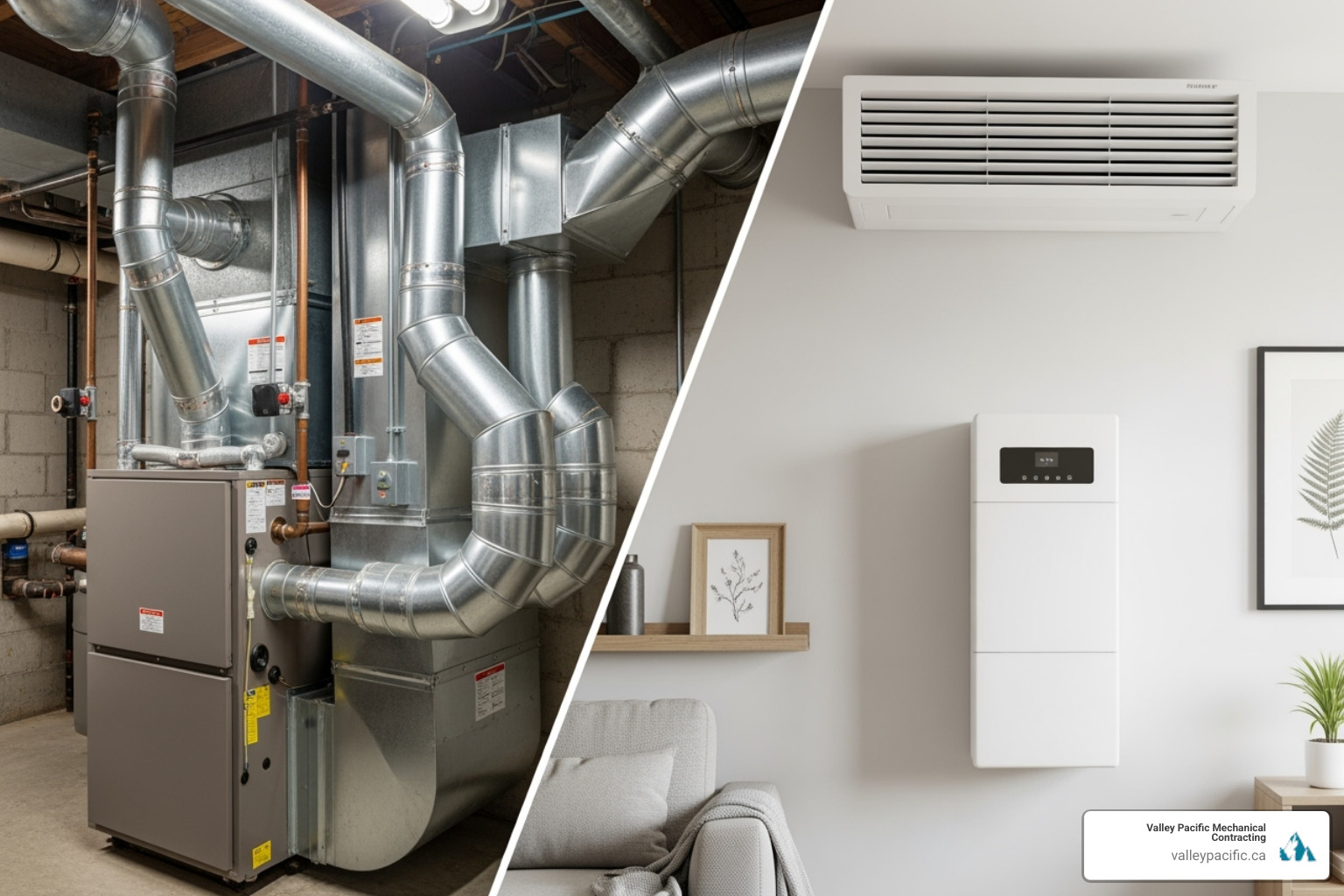
Traditional Ducted Systems: Furnaces and Central AC
Let's start with the classics - the tried-and-true forced-air systems that have been keeping families comfortable for generations. These are your furnaces paired with central air conditioners, working together like a well-rehearsed dance team through your home's existing ductwork.
Your furnace is essentially your home's heat factory. Gas furnaces burn natural gas to create warmth, while electric furnaces use electrical resistance heating. Both push heated air through a network of ducts that snake through your walls, delivering whole-home coverage that reaches every corner of your living space.
When summer rolls around, your central air conditioning units take center stage. They work hand-in-hand with your furnace's blower system, using the same ductwork to circulate cool, dehumidified air throughout your home. It's like having a gentle breeze flowing through every room, maintaining consistent comfort from your basement rec room to your upstairs bedrooms.
The real advantage here is simplicity and coverage. If you already have ductwork in place, these systems can provide reliable climate control for your entire home without any major construction headaches.
Ready to explore your options? Check out our detailed guides on furnace installation and AC installation to see what might work for your Maple Ridge home.
All-in-One Heat Pump Solutions
Here's where things get really interesting! Heat pumps are like the Swiss Army knives of residential HVAC solutions - they handle both heating and cooling in one incredibly efficient unit. Instead of creating heat from scratch, they're masters of energy transfer, moving heat from one place to another.
During winter, air-source heat pumps work their magic by extracting heat from the outside air (yes, even when it's chilly!) and bringing it inside. Come summer, they flip the script and pull heat out of your home, releasing it outdoors. It's like having a reversible jacket for your house!
For homeowners who want to take efficiency to the next level, geothermal systems tap into the earth's natural, steady underground temperature. These systems use buried loops to exchange heat with the ground, providing incredibly consistent and eco-friendly heating and cooling year-round.
What makes heat pumps so appealing is their high efficiency ratings and versatility. They're perfect for homeowners who want one system to handle everything while keeping energy bills in check and reducing their environmental footprint.
Thinking a heat pump might be your perfect match? Find the reasons to consider a heat pump and learn more about heat pump installation for your Langley home.
Ductless Mini-Split Systems
Sometimes ductwork just isn't in the cards - and that's perfectly okay! Ductless mini-split systems are the flexible, adaptable solution that brings zoned comfort exactly where you need it. Picture this: an outdoor compressor connected to sleek indoor air handlers mounted on your walls, each one giving you complete individual room control.
These systems are absolute game-changers for older homes that never had ductwork, new additions where extending ducts would be a nightmare, or any situation where you want precise control over different areas of your home. Want to keep the living room cozy while letting the unused guest room stay cooler? No problem!
The installation process is refreshingly simple compared to traditional systems. No major construction, no tearing up walls - just strategic placement of indoor units connected to the outdoor compressor. They're also whisper-quiet and incredibly energy-efficient since you're only conditioning the spaces you're actually using.
If you're tired of playing hot-and-cold zone roulette in your home, learn how to solve HVAC hot and cold spots with these versatile systems.
Specialized Hydronic and Boiler Systems
For those who appreciate the gentle, enveloping warmth that feels like a cozy hug, hydronic heating systems offer something truly special. These systems create radiant heat by circulating hot water through underfloor heating, classic radiators, or sleek baseboard heaters.
At the heart of these systems are boilers that heat water for circulation throughout your home. The result is even heat distribution that doesn't create drafts or dry out your air like forced-air systems can. It's the kind of warmth that makes you want to walk barefoot on heated floors during those chilly Lower Mainland mornings.
Many homeowners love hydronic systems for their quiet operation and the way they maintain comfortable humidity levels. Plus, they're incredibly durable and can work beautifully with renewable energy sources for environmentally conscious heating.
If this traditional yet highly effective approach to home heating sounds appealing, we'd be happy to discuss boiler installation options for your Pitt Meadows home.
Key Factors in Choosing the Right HVAC System
Selecting the perfect residential HVAC solutions for your home isn't something you should rush into. It's a decision that'll affect your daily comfort, monthly energy bills, and home value for many years ahead. Every home is unique, which is why we never recommend a cookie-cutter approach. Your home's specific needs, your family's lifestyle, and your long-term goals all play important roles in finding the right fit.
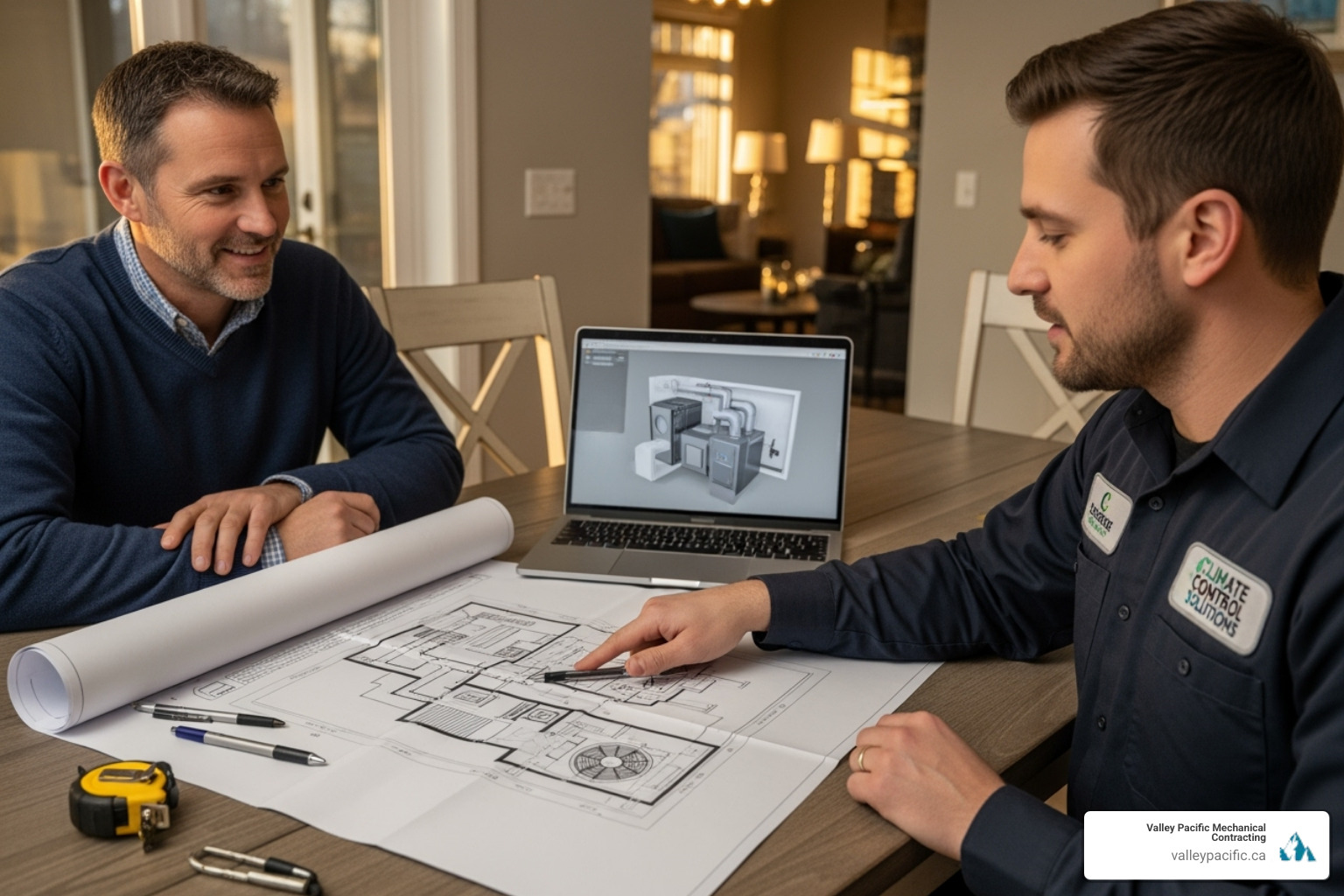
Assessing Your Home's Needs
Think of your home as having its own personality - and just like people, no two homes are exactly alike. The square footage is obviously important, but it's just the starting point. A system that's too small will run constantly trying to keep up, while one that's too large will short-cycle, wasting energy and creating uneven temperatures.
Your home's age tells us a lot about what we're working with. Those charming older homes in Mission or Coquitlam often have character, but they might also have less insulation or single-pane windows that let heat escape in winter and creep in during summer. Newer homes typically have better insulation and more efficient windows, which means the HVAC system doesn't have to work as hard.
The difference between new construction and retrofit projects is huge. With new builds, we can design everything from scratch - perfect ductwork placement, ideal equipment locations, the works. Retrofitting an existing home? That's where we get creative. Sometimes adding ductwork isn't practical, making ductless systems a brilliant solution.
We believe every home deserves a custom approach, which is why our custom HVAC services for homes focus on understanding your specific situation before recommending any system.
Climate Considerations and Efficiency Goals
Living in the Lower Mainland means we get the best of both worlds - and sometimes the worst. Those chilly winter mornings in Maple Ridge require solid heating, while those surprisingly warm summer days in Langley call for reliable cooling. Your residential HVAC solutions need to handle both seasons like a champ.
Here's where those efficiency ratings become your best friend. SEER ratings tell you how efficiently your air conditioner or heat pump cools your home. HSPF ratings measure heating efficiency for heat pumps. AFUE ratings show how well furnaces convert fuel into heat. Higher numbers mean better efficiency and lower energy bills.
ENERGY STAR® certification isn't just a fancy sticker - it's your guarantee that the system meets strict efficiency guidelines. These systems can slash your energy costs compared to older, less efficient units. The upfront investment in a high-efficiency system pays for itself through reduced monthly bills and improved comfort.
Getting the sizing right is crucial too. We can help you figure out what size AC unit your home needs to maximize both comfort and efficiency.
Leveraging Rebates and Financial Incentives
Nobody likes surprises when it comes to home improvement costs, which is why we always help our clients explore every available incentive. The good news? There are often excellent opportunities to reduce the financial impact of upgrading your HVAC system.
Federal tax credits can be substantial - some high-efficiency systems qualify for credits up to $2,600. Provincial rebates add another layer of savings, and manufacturer promotions can sweeten the deal even further. These aren't small amounts we're talking about - they can make a real difference in your project budget.
The key is choosing systems that qualify for these programs. High-efficiency equipment typically offers the best incentive opportunities, which means you're saving money both upfront through rebates and long-term through lower energy bills.
We stay current on all available programs so we can guide you toward residential HVAC solutions that maximize your savings. Check out our current promotions and learn more about how to save on energy costs with the right system choice.
The Rise of Smart and Efficient Residential HVAC Solutions
The world of residential HVAC solutions has transformed dramatically in recent years, bringing us technologies that seemed like science fiction just a decade ago. Today's systems don't just heat and cool your home - they learn your habits, adapt to your lifestyle, and even help you breathe cleaner air. It's an exciting time to be a homeowner in the Lower Mainland!

Smart Thermostats and Home Connectivity
Remember the old round thermostats your grandparents had? Those days are long gone! Today's smart thermostats are like having a personal assistant dedicated to your home's comfort. These Wi-Fi enabled devices put complete control right in your pocket, whether you're relaxing at home in Maple Ridge or stuck in Vancouver traffic.
The beauty of smart thermostats lies in their remote access capabilities. Through simple smartphone apps, you can adjust your home's temperature, check energy usage, and even get alerts when it's time for maintenance - all from wherever you happen to be. No more coming home to a freezing house because you forgot to adjust the thermostat before leaving!
But here's where it gets really clever: many of these systems feature learning algorithms that actually study your daily routines. They notice when you typically leave for work, when you come home, and what temperatures you prefer at different times. Over time, they start making these adjustments automatically, ensuring your home is perfectly comfortable when you need it while saving energy when you don't.
Some advanced systems even create a stronger connection between you and your HVAC service provider. With your permission, these smart devices can share system data with us, allowing for more proactive and reliable service. Think of it as your system giving us a heads-up before small issues become big headaches. If you're curious about upgrading to this intelligent technology, learn more about smart thermostats and how they can transform your daily comfort.
Innovations in Energy Efficiency for residential HVAC solutions
While smart controls grab the headlines, some of the most impressive advances in residential HVAC solutions are happening behind the scenes with the core technology itself. These innovations are quietly revolutionizing how efficiently our homes stay comfortable.
Variable-speed technology is perhaps the biggest game-changer we've seen. Traditional systems operate like a light switch - they're either running full blast or completely off. Variable-speed motors, however, can adjust their output precisely to match your home's exact heating or cooling needs at any given moment. This means more consistent temperatures throughout your home, whisper-quiet operation, and significantly lower energy bills. It's like having a system that knows exactly how much effort to put in, rather than always giving 100%.
Multi-stage operation works on a similar principle, allowing systems to run at different capacity levels - perhaps 60% on a mild day or 100% during extreme weather. This flexibility means your system can run longer cycles at lower intensities, providing much more even temperatures and better humidity control than the old all-or-nothing approach.
Zoning systems take efficiency to the next level by dividing your home into different temperature zones, each with its own thermostat and controlled airflow. Imagine being able to keep your home office cool during the day while not wasting energy cooling unused bedrooms. It's particularly valuable for larger homes or families with different comfort preferences.
For those seeking the ultimate in efficiency, hybrid dual-fuel systems combine an electric heat pump with a gas furnace. The system intelligently switches between the two based on outdoor temperatures and energy costs, always choosing the most efficient option. This smart approach delivers both reduced energy consumption and consistent comfort year-round.
The Critical Role of Indoor Air Quality (IAQ) in modern residential HVAC solutions
Here's something that might surprise you: the air inside your home can be up to five times more polluted than outdoor air. Since we spend about 90% of our time indoors, modern residential HVAC solutions are increasingly focused on not just temperature control, but creating truly healthy living environments.
Advanced air purification goes far beyond basic dust filtering. Today's systems can remove microscopic threats like bacteria, viruses, and volatile organic compounds (VOCs) that traditional filters miss entirely. Some cutting-edge systems feature filters capable of capturing particles smaller than what the human eye can see - we're talking about protection at the molecular level.
Humidity control plays a crucial role in both comfort and health. Too much humidity creates a breeding ground for mold and makes your home feel stuffy and uncomfortable. Too little humidity leads to dry skin, static electricity, and can actually make you more susceptible to respiratory infections. Modern HVAC systems can integrate whole-home humidifiers or dehumidifiers to maintain that perfect balance automatically.
Perhaps most importantly, ventilation systems like Energy Recovery Ventilators (ERVs) and Heat Recovery Ventilators (HRVs) ensure a constant supply of fresh outdoor air while expelling stale indoor air. The brilliant part? They transfer heat and moisture between the incoming and outgoing air streams, so you get fresh air without losing energy or comfort. It's like opening your windows for fresh air without the energy penalty.
These indoor air quality improvements create healthier living environments, reduce allergens, and help prevent issues like mold growth. For homeowners dealing with allergies or simply wanting the cleanest possible air for their families, these technologies are truly life-changing. Find more about improving your home's air with our spring air quality solutions guide.
Frequently Asked Questions about Residential HVAC
We get it – choosing the right residential HVAC solutions can feel overwhelming with all the options available today. Over our 30+ years serving homeowners throughout the Lower Mainland, we've heard just about every question you can imagine. Here are the ones that come up most often, along with the straight answers you're looking for.
What is the main difference between a furnace and a heat pump?
This is probably our most common question, and it's a great one! The fundamental difference comes down to how they create warmth for your home. A furnace generates heat by burning fuel (like natural gas) or using electricity – think of it like a giant space heater for your whole house.
A heat pump, on the other hand, is more like a heat magician. It doesn't create heat; instead, it moves heat from one place to another. During winter, it pulls heat from the outside air (yes, even when it's cold outside!) and transfers it inside. When summer arrives, it reverses the process, pulling heat from your home and releasing it outside, just like an air conditioner.
Here's what makes heat pumps special: they provide both heating and air conditioning in a single, highly efficient unit. Since they're moving heat rather than creating it, they're generally much more energy-efficient than traditional furnaces, especially in our moderate Lower Mainland climate.
Are ductless mini-splits a good option for an entire house?
Absolutely! This misconception comes up a lot – people think ductless systems are only for single rooms, but that's not the case at all. Multi-zone ductless mini-split systems can effectively heat and cool an entire home, and they do it beautifully.
Here's how it works: you have one outdoor unit connected to multiple indoor units throughout your house. Each indoor unit can be controlled independently, giving you customized temperature control in different rooms or "zones." This means your teenager can keep their room cool while you stay cozy in the living room – no more thermostat battles!
This zoned approach often increases efficiency because you're only conditioning the spaces you're actually using. They're particularly fantastic for homes without existing ductwork, additions where extending ducts would be a nightmare, or even new constructions where you want that precise room-by-room control.
How important is regular HVAC maintenance?
We can't stress this enough – regular maintenance is absolutely crucial for efficiency, longevity, and safety. Think of it like getting regular oil changes for your car. You wouldn't skip those and expect your vehicle to run perfectly, right?
An annual HVAC system check ensures your system runs at peak performance, prevents those costly middle-of-winter breakdowns that nobody wants to deal with, maintains good air quality for your family, and keeps your warranties valid.
During a maintenance visit, we clean components, check for wear and tear, ensure everything is calibrated correctly, and catch small issues before they become expensive problems. It's one of those "ounce of prevention is worth a pound of cure" situations that really pays off in the long run. Plus, a well-maintained system runs more efficiently, which means lower energy bills – and who doesn't want that?
Conclusion: Investing in Your Home's Future Comfort
The journey through modern residential HVAC solutions reveals just how much the industry has transformed. What once meant choosing between a basic furnace or air conditioner has evolved into a rich landscape of possibilities - from energy-sipping heat pumps and precise ductless mini-splits to intelligent systems that learn your habits and specialized hydronic heating that wraps your home in gentle warmth.
These aren't just fancy upgrades; they're smart investments in your daily comfort and your home's future. Modern HVAC systems deliver significant energy savings that show up in your monthly bills, provide precise temperature control that eliminates those annoying hot and cold spots, and create healthier indoor air for your family to breathe. When you add smart thermostats and home connectivity into the mix, your heating and cooling system becomes truly responsive to how you actually live.
The long-term benefits extend beyond comfort. High-efficiency systems often qualify for federal tax credits and provincial rebates, making advanced technology more accessible. Your home's value increases, and you'll enjoy the peace of mind that comes with a reliable, professionally designed system.
We know that sorting through all these options can feel overwhelming - and that's exactly where professional guidance makes all the difference. At Valley Pacific Mechanical, we've spent over 30 years helping homeowners across the Lower Mainland find their perfect comfort solution. From Mission to Maple Ridge to Langley, we've seen every type of home and every comfort challenge.
Our approach centers on comprehensive system design custom specifically to your home, your family's needs, and your budget. We believe in providing a truly headache-free experience from that first consultation through years of reliable service. Whether you're planning new construction, dealing with an aging system, or simply want to improve your home's efficiency, we're here to guide you toward optimal comfort.
Ready to explore what modern comfort can do for your home? Explore specialized heating solutions and find how the right residential HVAC solutions can transform your living space into the comfortable haven you deserve.
Understanding the Forced Air Furnace Installation Journey
Forced air furnace installation is a complex process that ensures your home receives comfortable, evenly distributed warmth. It involves everything from gas line connections to calibrating the final system for optimal performance.
Key Steps in Forced Air Furnace Installation:
- Home Assessment - Load calculations and proper sizing
- Old Unit Removal - Safe disconnection of gas, electrical, and ductwork
- New Furnace Setup - Leveling, positioning, and connecting to existing systems
- Utility Connections - Gas lines, electrical wiring, and venting installation
- Commissioning - Testing airflow, pressure, and safety controls
- Final Walkthrough - System education and maintenance guidance
A forced air furnace works by drawing cold air through return ducts, heating it in a heat exchanger, and using a blower fan to push the warmed air through supply ducts to every room. This cycle of comfort depends entirely on proper installation.
Research shows that new furnaces often suffer up to a 30% reduction in performance as a result of improper installation. This means a rushed job can cost you hundreds of dollars annually in higher energy bills.
Professional installation is about ensuring your family's safety, maximizing energy efficiency, and protecting your investment for the next 15-20 years.
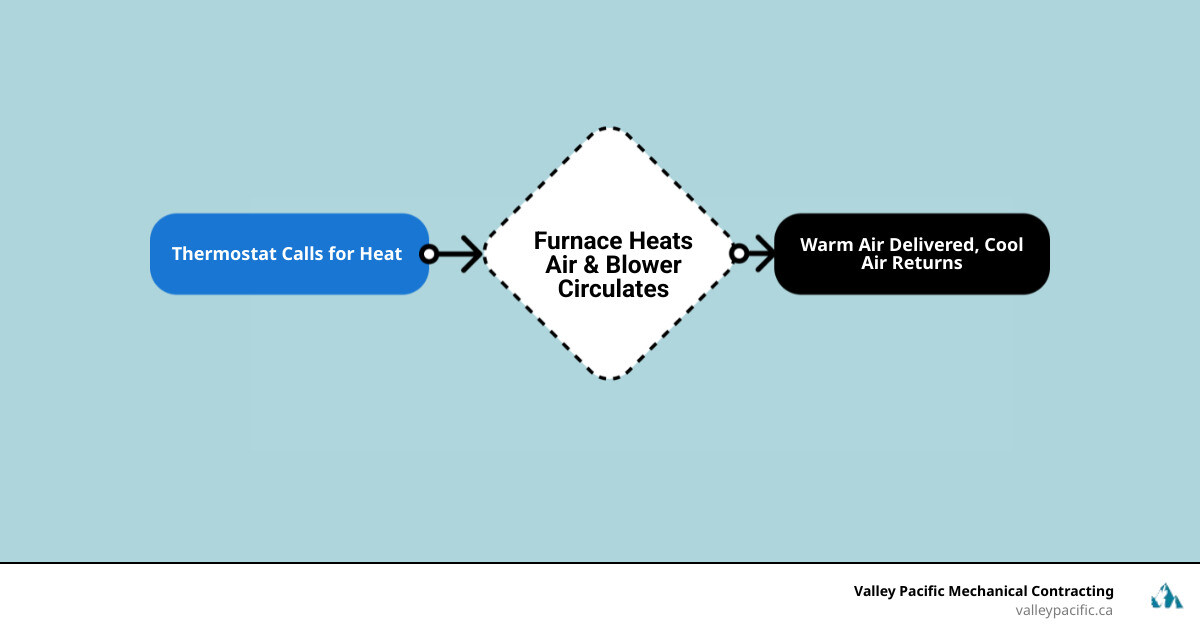
Must-know forced air furnace installation terms:
Preparing for Your New Furnace: Sizing, Selection, and Efficiency
Thoughtful preparation for your forced air furnace installation is the key to a smooth process and long-term satisfaction. A quality installation starts long before any tools are used.
We begin with a thorough home assessment to understand your home's unique heating needs. This includes a load calculation, where we examine everything from insulation and window quality to ceiling height and sun exposure. This ensures we size the furnace correctly.
Sizing the furnace is critical. An undersized unit will struggle to heat your home, while an oversized unit will cycle on and off frequently, leading to uneven temperatures and wasted energy. The quality of your insulation and windows directly impacts the furnace size you need. A well-insulated home may require a smaller, more efficient unit. If you're wondering about specifics, see our guide on How Do I Choose the Right Furnace for My Home in Pitt Meadows, BC. If your current system is aging, learn the warning signs in HVAC System May Fail Soon: Signs.
Let's talk about the AFUE rating (Annual Fuel Utilization Efficiency). A furnace with an 85% AFUE rating converts 85 cents of every dollar you spend on fuel into heat. Today's minimum standard is 80% AFUE, but high-efficiency models can reach 95% or higher. The benefits of high-efficiency furnaces include lower monthly bills, quieter operation, more consistent heating, and a smaller environmental footprint.
Choosing the Right Type of Furnace
You have several excellent options when it comes to fuel sources.
| Furnace Type | Fuel Source | Operating Principle | Best Climate Use |
|---|---|---|---|
| Gas Furnace | Natural Gas or Propane | Burns fuel in a combustion chamber, heating a heat exchanger. A blower then circulates warm air through ducts. | Ideal for colder climates with access to natural gas lines. |
| Electric Furnace | Electricity | Uses electric heating elements to warm air, which is then distributed by a blower. | Suitable for milder climates or homes without gas access. Can be costly to operate in very cold regions. |
| Heat Pump | Electricity | Transfers heat from outside air (or ground) into the home in winter, and reverses the process for cooling in summer. Can be paired with a furnace for hybrid systems. | Highly efficient in moderate climates. May require supplementary heating (often from a furnace) in very cold temperatures. |
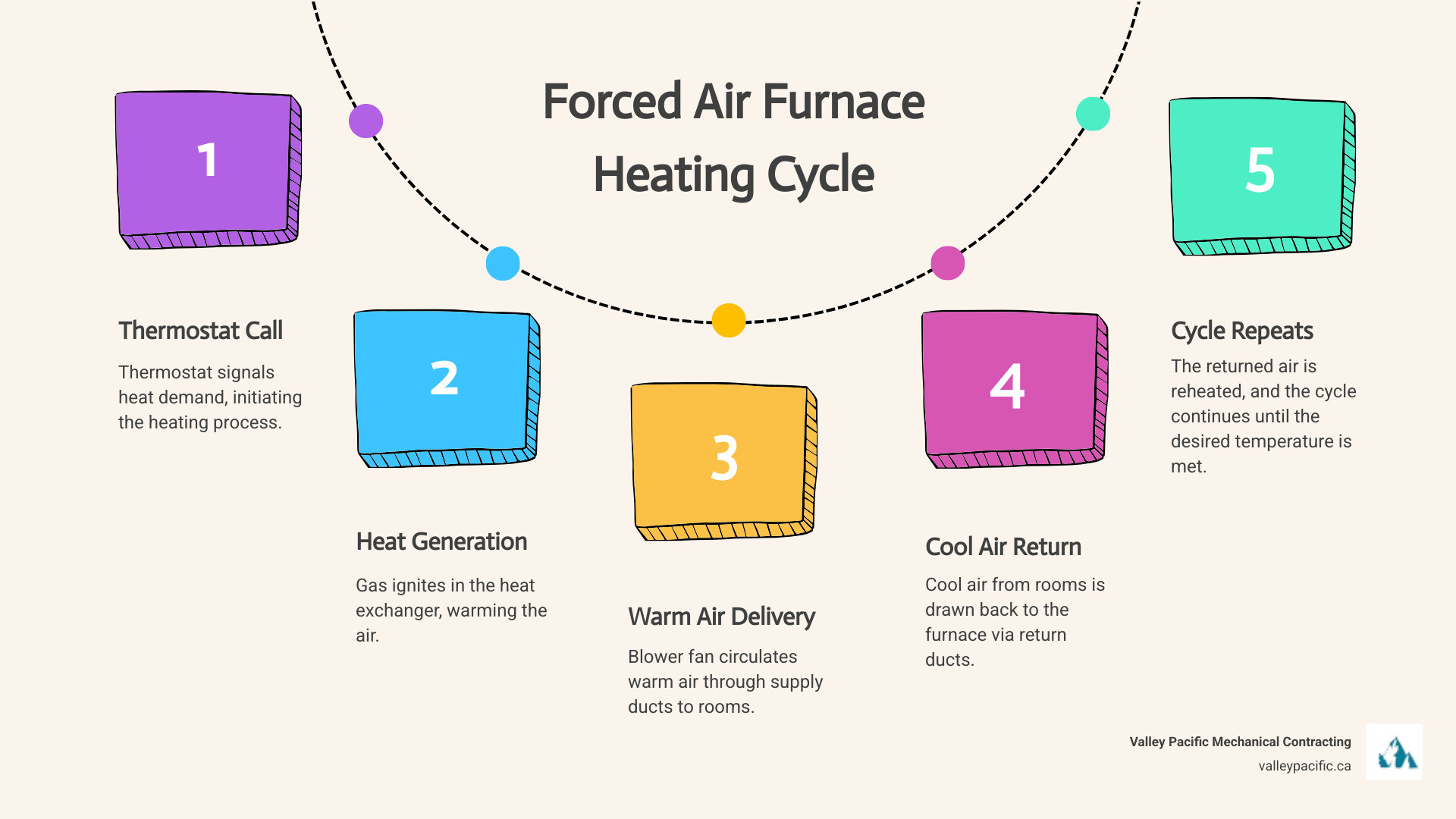
Natural gas furnaces are the most popular choice in the Lower Mainland, offering reliable and efficient heat. Propane systems are a great alternative for rural homes without natural gas access. Electric furnaces are clean and quiet, working well in milder climates. Hybrid systems combine a heat pump with a furnace, intelligently switching between the two for maximum efficiency.
Understanding AFUE and Energy Savings
Annual Fuel Utilization Efficiency (AFUE) is your furnace's energy report card. A 95% AFUE furnace converts 95% of its fuel into heat, with only 5% lost. Compared to older furnaces with 60-70% efficiency, the difference is significant.
The long-term savings from a high-efficiency unit can be substantial, paying back the initial investment through lower monthly bills over its 15-20 year lifespan. Also, look for government rebates and incentives, which can help offset the cost of upgrading to a more efficient system. We can help you identify available programs.
For more insights into forced air systems, this trusted resource provides excellent information.
The Professional Forced Air Furnace Installation Process Step-by-Step
A professional forced air furnace installation transforms your home's comfort for the next 15-20 years. Our process is designed to be a headache-free experience, prioritizing your home's safety and your new furnace's performance from day one. We follow strict safety protocols and treat your home with the utmost care.
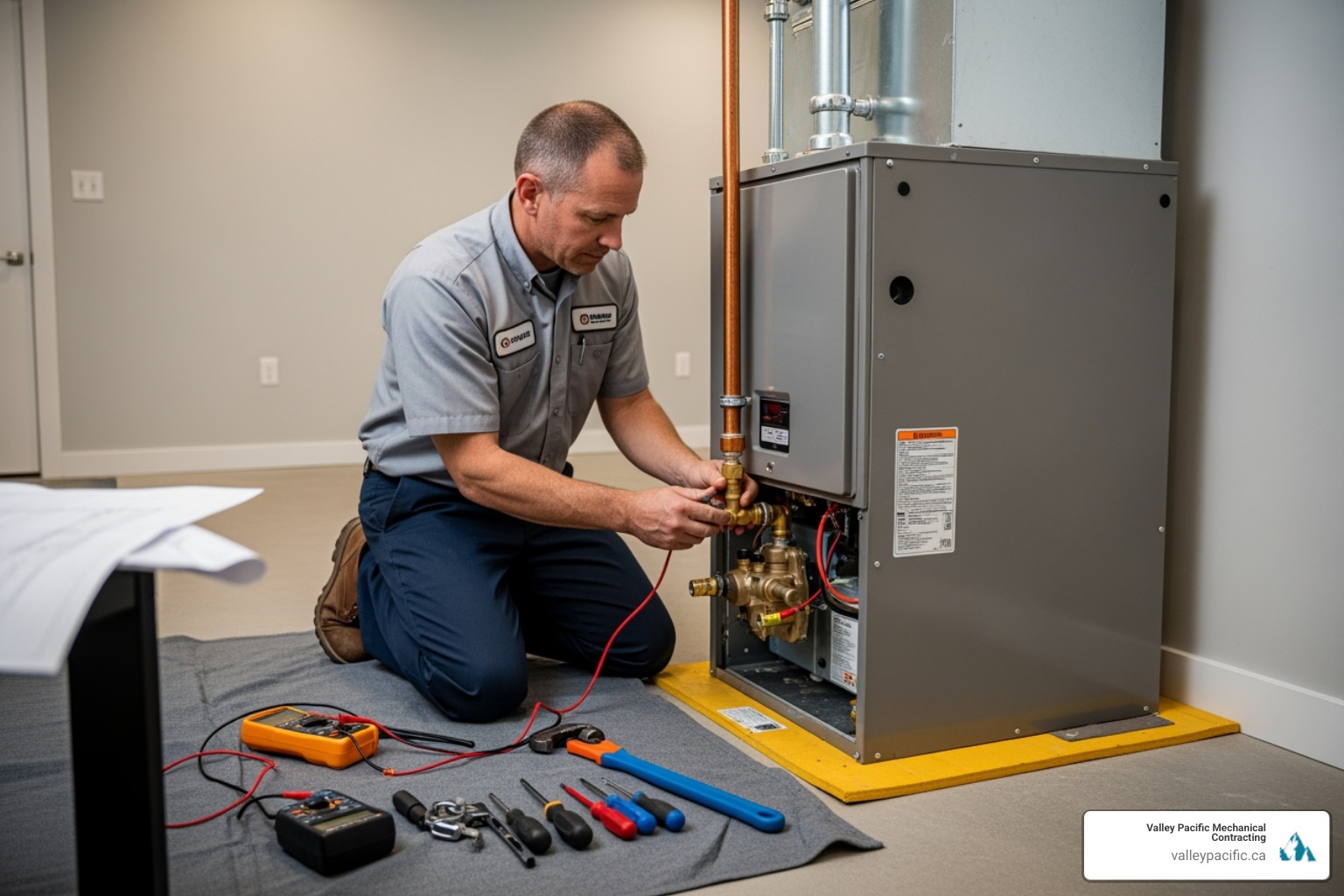
Step 1: Safe Removal of the Old Unit
A successful forced air furnace installation begins with the safe removal of your old system. Our certified technicians start by shutting off power at the circuit breaker and closing the main gas supply valve to prevent accidents. We then methodically disconnect gas lines, electrical wiring, and thermostat connections. After detaching vent pipes and ductwork, we remove the old furnace and clean the installation area, preparing a fresh space for your new unit.
Step 2: Setting the New Furnace and Ductwork Connection
Next, we prepare the space for your new furnace, ensuring it is level and stable. The unit is placed on specialized isolation pads to minimize noise and vibration while preventing rust from moisture. Connecting the new furnace to your existing ductwork is a critical step. We ensure every connection is secure and properly sealed with high-quality mastic or foil tape. This prevents air leaks, which can significantly reduce your system's efficiency. For more tips, see our Furnace Installation Homeowner Essentials guide. To learn more about duct sealing, This Old House offers excellent guidance.
Step 3: Venting, Drains, and Utility Hookups
This step requires technical precision. High-efficiency furnaces (90%+ AFUE) need specialized PVC vent pipes to handle acidic condensate. We install these pipes with the proper slope (typically 1/4 inch per 4 feet) to ensure condensate drains correctly to the furnace and out through a dedicated PVC drain line into your home's plumbing. Gas line connections are secured and rigorously leak-tested for your family's safety. Finally, we connect the electrical supply and integrate your thermostat for seamless communication with the new system.
Step 4: Commissioning – The Critical Final Check
Commissioning is the final phase that guarantees your new furnace operates safely, efficiently, and at peak performance. Research shows that only 46% of important installation criteria were in compliance with best practices in typical installations, which is why our commissioning process is non-negotiable. We conduct several critical tests:
- Static Pressure Test: Measures airflow resistance in your ductwork.
- Temperature Rise Check: Confirms the furnace heats air to manufacturer specifications.
- Airflow Verification (CFM): Ensures proper air volume reaches every room.
We also adjust gas pressure for optimal combustion and test every safety control. This detailed process prevents common issues like uneven heating, high utility bills, and shortened equipment life. For ongoing peace of mind, we recommend regular HVAC System Checks.
Why Professional Installation is Non-Negotiable
While the DIY route for a forced air furnace installation might seem tempting, it's a complex job involving natural gas lines, high-voltage electricity, and venting systems that directly impact your family's safety. This isn't a simple home repair; it's a task for certified professionals.
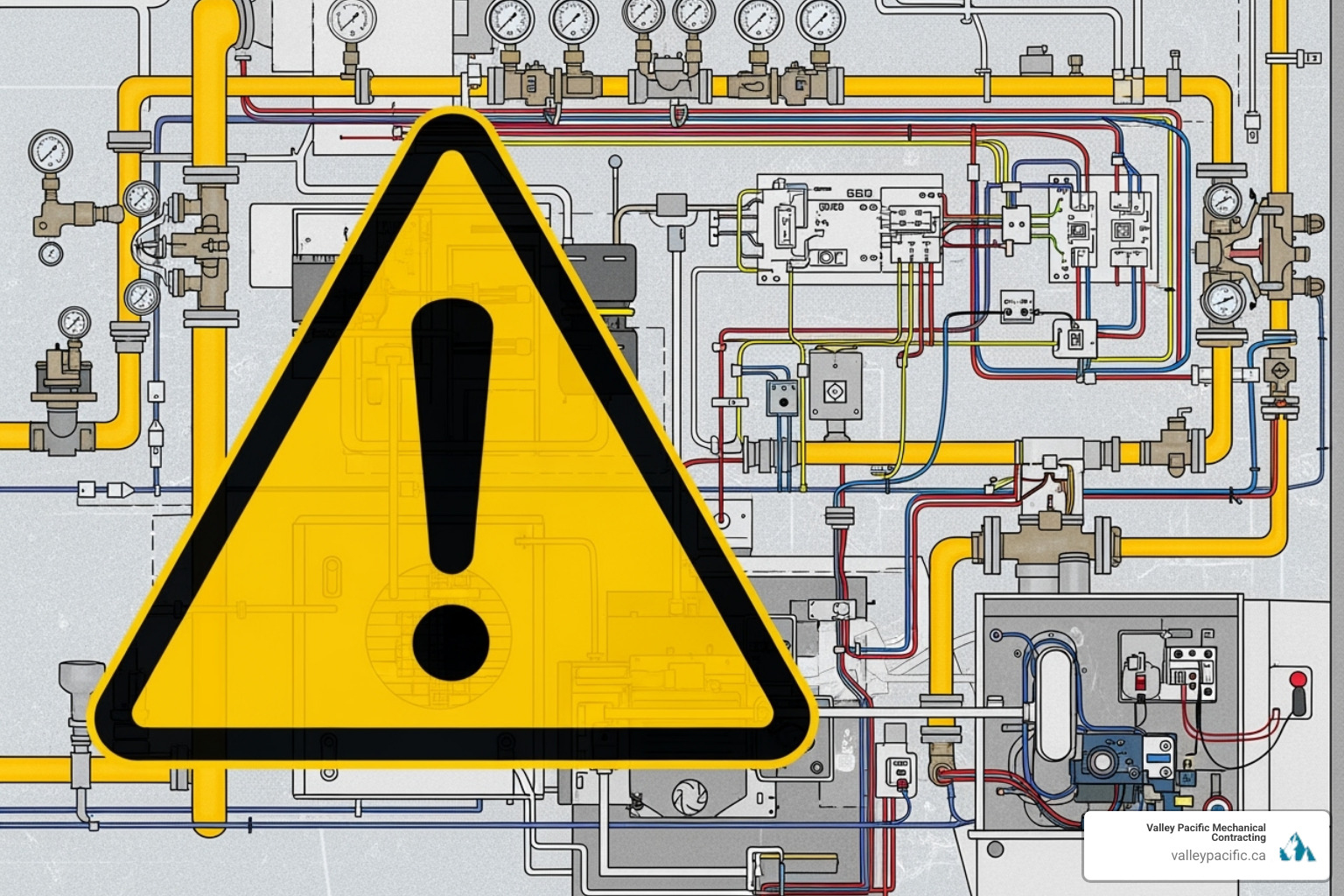
Research shows that improper installation can lead to a 30% reduction in performance and 10-30% higher utility bills for the life of your system. An improperly installed unit will also work harder and break down sooner. What seems like a cost-saving measure can cost you thousands in the long run. A professional forced air furnace installation is an investment that pays for itself through reliable performance, energy savings, and peace of mind.
The Dangers of DIY Forced Air Furnace Installation
Attempting a furnace installation yourself is genuinely dangerous. Here are the primary risks:
- Gas Leaks: An improperly sealed gas line connection is a serious fire or explosion hazard.
- Electrical Hazards: Incorrect wiring can cause electrical shorts, damage your new furnace, or lead to a house fire.
- Carbon Monoxide: Improper venting, especially with high-efficiency units, can lead to the buildup of deadly carbon monoxide gas in your home.
- Voided Warranties: Most manufacturers require professional installation to keep the warranty valid. A DIY job could leave you without coverage.
- Code Violations: DIY installations often fail to meet local building codes, which can cause issues when selling your home or with insurance claims. For professional help, contact us for Furnace Repair in Maple Ridge, BC.
Signs of a Quality Forced Air Furnace Installation
A quality installation has several clear indicators:
- A Level Unit with Sealed Connections: The furnace should sit perfectly level, and all ductwork connections must be sealed with mastic or foil tape, not standard duct tape.
- Neat Wiring and Piping: Electrical wires, gas lines, and vent pipes should be cleanly routed, secured, and clearly labeled.
- Proper Venting Slope: For high-efficiency models, PVC vent pipes must have a consistent downward slope to allow for proper condensate drainage.
- A Detailed Commissioning Report: This report documents the system's performance tests (static pressure, temperature rise, etc.) and proves it was optimized for your home.
- Homeowner Walkthrough and Education: The installer should explain how your new system works, demonstrate filter changes, and answer all your questions.
Life After Installation: Maintenance and Longevity
After your forced air furnace installation, proper care ensures your new system serves you faithfully for its full 15-20 year lifespan. A quality installation is the best start, but regular maintenance is what guarantees decades of reliable service, lower energy bills, and fewer breakdowns.
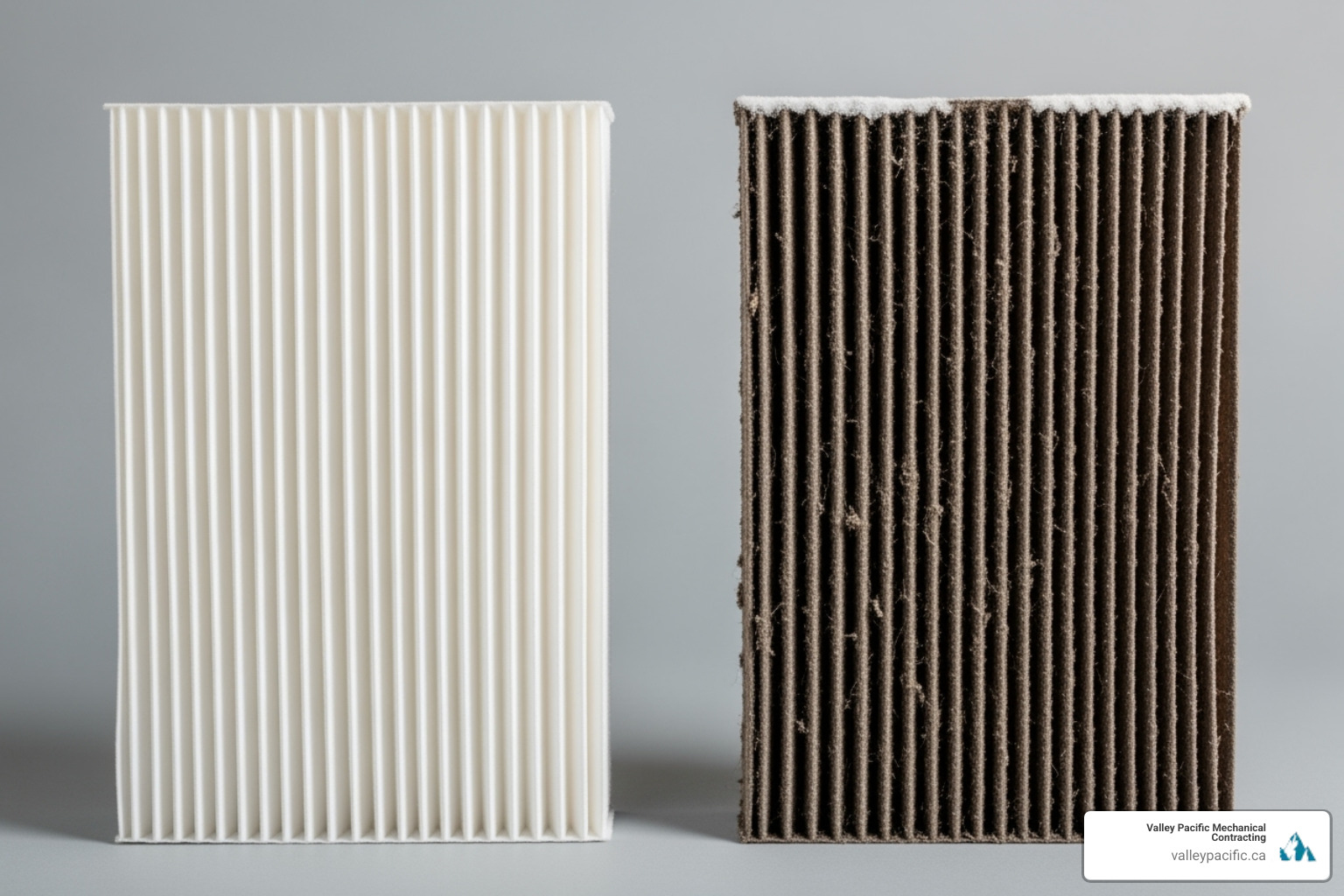
The average life expectancy of a new gas furnace is 15 years, largely as a result of varying levels of installation quality. A properly installed and maintained system can easily last 20 years or more.
Essential Furnace Maintenance for Homeowners
Some of the most important maintenance tasks are simple and can be done by you:
- Replace Air Filters: A dirty filter restricts airflow, forcing your furnace to work harder. Check your filter monthly and replace it every 1-3 months.
- Keep Registers Clear: Ensure furniture, rugs, or curtains are not blocking supply vents or return air grilles.
- Check the Thermostat: Ensure it's set correctly and replace batteries in digital models as needed.
For more guidance, explore our HVAC Preventative Maintenance resources. When you need professional support, we offer complete Furnace Services in Maple Ridge, BC.
The Importance of Annual Professional Tune-Ups
An annual professional tune-up is like a physical for your furnace. Our certified technicians perform safety inspections, clean internal components like burners and the heat exchanger, lubricate moving parts, and conduct efficiency testing. This catches small issues before they become big problems and maintains the peak performance your quality forced air furnace installation made possible. A well-maintained system runs quieter, heats more evenly, and keeps energy bills low.
Ready to schedule a tune-up? Contact us for expert Heating Service in Maple Ridge, BC.
Frequently Asked Questions about Forced Air Furnaces
Here are answers to common questions we receive about forced air furnace installation and operation.
How does a furnace interact with my thermostat and ductwork?
Think of your heating system as a team:
- The Thermostat (The Brain): It monitors your home's temperature and tells the furnace when to turn on.
- The Furnace (The Heart): It receives the signal, creates heat, and the blower fan pushes the warm air into the ducts.
- The Ductwork (The Circulatory System): It delivers warm air to every room and brings cooler air back to the furnace to be reheated.
When these three components are properly integrated through a quality forced air furnace installation, you get consistent, efficient comfort.
What are common furnace installation problems to avoid?
These preventable mistakes are the most common issues we see:
- Improper Sizing: A furnace that is too large or too small will waste energy and provide poor comfort.
- Leaky Ductwork: Unsealed connections allow heated air to escape into walls or attics, wasting money.
- Incorrect Venting: This can be dangerous, potentially causing moisture damage or carbon monoxide leaks.
- Skipping Commissioning: Without this final calibration step, your furnace may never achieve its rated efficiency.
- Choosing an Unqualified Installer: This is the root cause of most problems. Always work with licensed, experienced professionals to protect your investment and your family's safety.
Can a forced air system also provide air conditioning?
Yes! This is a major benefit of a forced air system. The furnace's blower and ductwork can be shared with a central air conditioning system. An evaporator coil is installed with the furnace, and in the summer, the same blower fan circulates cool, dehumidified air throughout your home. This integrated approach provides year-round climate control using a single, efficient system.
To learn more about our comprehensive heating and cooling solutions, check out our full range of Services.
Your Partner for a Headache-Free Furnace Installation
Your forced air furnace installation is a long-term investment in your family's comfort, safety, and energy efficiency. From the initial load calculation to the final commissioning tests, every step is crucial for ensuring reliable warmth for the next 15-20 years.
A professional installation prevents the issues that can slash your furnace's efficiency by up to 30% and lead to higher utility bills. More importantly, it gives you peace of mind.
At Valley Pacific Mechanical Contracting, we have been perfecting forced air furnace installation for over 30 years across the Lower Mainland, including Mission, Maple Ridge, and Langley. Our certified technicians craft heating solutions, not just install equipment. Every connection is tested for safety, every seal is checked for efficiency, and every control is verified to protect your home.
We are committed to delivering a truly headache-free experience, backed by our 24/7 emergency service and the Daikin Comfort Promise. The long-term value of professional work is realized through lower energy bills, safe operation, and decades of reliable service.
Ready to transform your home's comfort with a professional forced air furnace installation? We're here to guide you every step of the way.
Schedule Your Professional Forced Air Furnace Installation in Langley, BC and experience the Valley Pacific difference today!
Why Shower Valve Replacement Is Essential for Your Home
Shower valve replacement is a common plumbing repair that can solve frustrating issues like sudden temperature changes or a persistent drip that wastes water. A new valve can transform your daily shower from an annoyance into a pleasure.
Quick Answer: Essential Steps for Shower Valve Replacement
- Turn off water supply at the main valve or shower shutoffs
- Remove old trim (handle, escutcheon plate)
- Access the valve by cutting a wall opening if needed
- Disconnect old valve from supply lines
- Install new valve and reconnect plumbing
- Test for leaks before closing up the wall
- Install new trim and restore the wall surface
Most shower valve replacements take 2-4 hours and require intermediate plumbing skills, including potentially soldering copper pipes.
The valve hidden behind your wall is the heart of your shower system. It controls water flow, mixes hot and cold water, and includes safety features to prevent scalding. A failing valve can cause drips, stiff handles, or dangerous temperature swings.
Modern shower valves offer consistent water pressure, precise temperature control to prevent scalding, and reliable operation that can last for over a decade with proper maintenance.
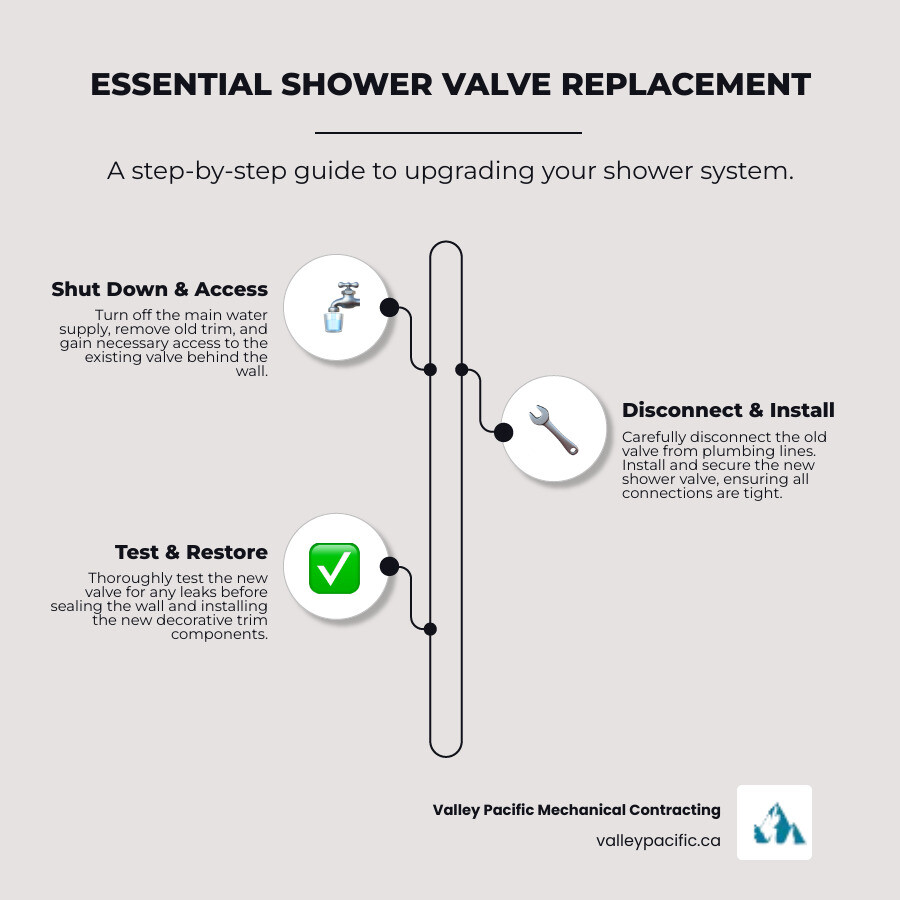
Shower valve replacement terms to remember:
Understanding Your Shower System
Your shower valve is the component hidden in the wall that blends hot and cold water to the perfect temperature. Modern valves do more than just mix water; they act as safety guards, preventing shocking temperature spikes. They manage water flow control and water temperature regulation, often with built-in anti-scald protection. This feature maintains your chosen temperature even when a toilet is flushed or a dishwasher starts elsewhere in the house.
In a shower-only system, the valve focuses on temperature and pressure. For a tub/shower combo, the valve also includes a diverter to switch water flow between the tub spout and the showerhead. Understanding this is key when planning a shower valve replacement.
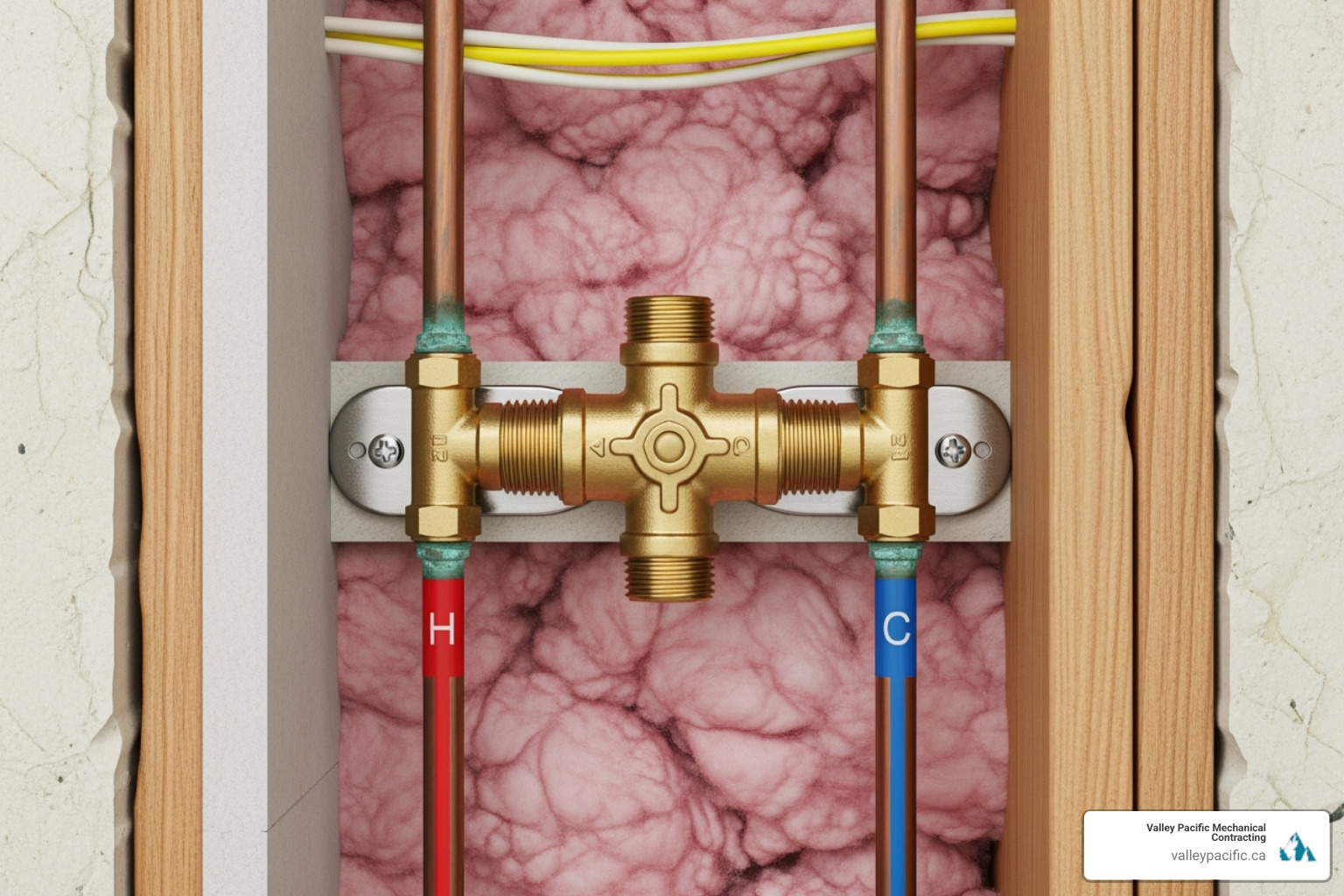
Key Signs You Need a Shower Valve Replacement
Your shower valve works hard and will eventually show signs of wear. Catching these signs early can prevent bigger problems and water damage.
- Dripping Faucet: A constant drip from the showerhead when it's off means you have worn internal seals or a failing cartridge. This wastes water and increases your utility bills.
- Stiff Handle: If the handle is hard to turn, it's a sign of mineral buildup, corrosion, or worn internal parts. Adjusting your shower should be effortless.
- Sudden Temperature Changes: If water temperature fluctuates wildly from hot to cold, the valve's pressure-balancing system is failing. This is a safety hazard, especially for children and the elderly.
- Low Water Pressure: A clogged or failing shower valve can restrict water flow, turning your shower into a disappointing trickle.
- Visible Corrosion: Rust or mineral deposits on the handle or trim plate often indicate that the hidden components behind the wall are also deteriorating.
- Strange Noises: Humming, whistling, or banging sounds when you use the shower can point to loose parts or other mechanical issues that a shower valve replacement can fix.
Addressing these issues promptly can prevent a minor annoyance from becoming a major plumbing emergency.
Types of Shower Valves and How to Choose
Choosing the right valve is simpler when you understand the main types available.
Pressure-balancing valves are the most common type in modern homes. They automatically adjust to pressure changes to maintain a consistent water temperature, preventing scalding when water is used elsewhere.
Thermostatic mixing valves are a premium option that allows you to set an exact temperature. They automatically adjust the hot and cold water mix to maintain that temperature, offering superior safety and convenience.
Diverter valves are necessary for tub/shower combinations. They direct water flow between the tub faucet and the showerhead. When replacing a valve in a combo unit, ensure the new one has an integrated diverter or is compatible with a separate one.
Transfer valves are used for custom showers with multiple outlets, like body sprays or rain showerheads. They allow you to direct water to different fixtures simultaneously or individually.
Universal valve bodies offer flexibility for future upgrades. They accept different types of cartridges, allowing you to change your shower's trim and function without another full shower valve replacement.
Understanding the difference between rough-in kits and trim kits is crucial. The rough-in kit is the valve body installed behind the wall. The trim kit includes the visible parts like the handle and decorative plate. If the valve body is failing, you'll need a complete rough-in shower valve replacement.
Your choice will depend on your budget, desired features, and existing plumbing. Modern building codes often require specific safety features. For guidance, you can learn more about plumbing codes and standards or consult a professional to ensure your installation is compliant.
Your Step-by-Step Guide to Shower Valve Replacement
A shower valve replacement is a manageable DIY project for those with some plumbing experience, but preparation and safety are key. This project is about creating a safer, more comfortable shower experience.
Safety is your top priority. Always wear safety glasses and work gloves. The first and most critical step is shutting off your water supply. Look for dedicated shut-off valves for the shower; if you can't find them, turn off your home's main water supply. After shutting off the water, open a faucet on a lower level to drain the pipes.
Accessing the valve usually requires cutting an opening in the wall. A 12x12-inch opening on the wall opposite the shower is often recommended for adequate workspace. If you have an older home, consider having the wall material tested for asbestos before cutting.
While this can be a DIY project, be honest about your skill level. If you're not comfortable soldering copper pipes, it's wise to call professionals like us at Valley Pacific Mechanical Contracting.

Gathering Your Tools and Materials
Gathering all your tools and materials beforehand will prevent mid-project trips to the hardware store. Lay down a blanket to protect your tub or shower base.
Your essential toolkit should include:
- Adjustable and pipe wrenches
- Phillips and flathead screwdrivers
- Allen wrench set
- Plumber's tape (Teflon tape)
- Pipe cutter
- Soldering torch, lead-free solder, and flux (for copper pipes)
- The new shower valve and trim kit
- Towels and a bucket
- Safety glasses and work gloves
- Needle-nose pliers
- Utility knife
- Caulk and a caulk gun
The Replacement Process: From Old to New
With your water off and lines drained, you can begin the replacement.
- Remove the Old Trim: Locate and remove the screws on the handle, which are often hidden under a decorative cap. You may need an Allen wrench for set screws. Unscrew the escutcheon (trim plate), cutting through old caulk if necessary.
- Access and Disconnect the Old Valve: After cutting your access panel, identify the connections to the hot and cold supply lines, showerhead, and tub spout. For threaded connections, use wrenches to unscrew them. For soldered copper, heat the joint with a torch until the solder melts and you can pull the valve free. Be careful not to damage surrounding materials.
- Install the New Valve: Securely mount the new valve body at the correct depth so the trim will sit flush against the finished wall. Connect the water lines. For PEX piping, use thread tape and ensure crimp fittings are secure. For copper, clean, flux, and solder each joint. Remove any plastic or rubber parts from the valve before soldering.
- Test for Leaks: This is a critical step. Slowly turn the water supply back on and carefully inspect every connection for drips. A paper towel can help detect even the smallest leak. If you find one, turn the water off, drain the lines, and fix the connection.
- Install New Trim and Repair Wall: Once you're leak-free, install the new cartridge, escutcheon plate, and handle. Apply a bead of caulk around the plate for a watertight seal. Install the new showerhead and tub spout, using plumber's tape on all threaded connections. Finally, repair the access hole in your wall, then patch, prime, and paint.
After the Installation: Troubleshooting Common Issues
After your shower valve replacement, perform post-installation checks by running the shower and testing the temperature controls. Minor issues are common and often have simple fixes.
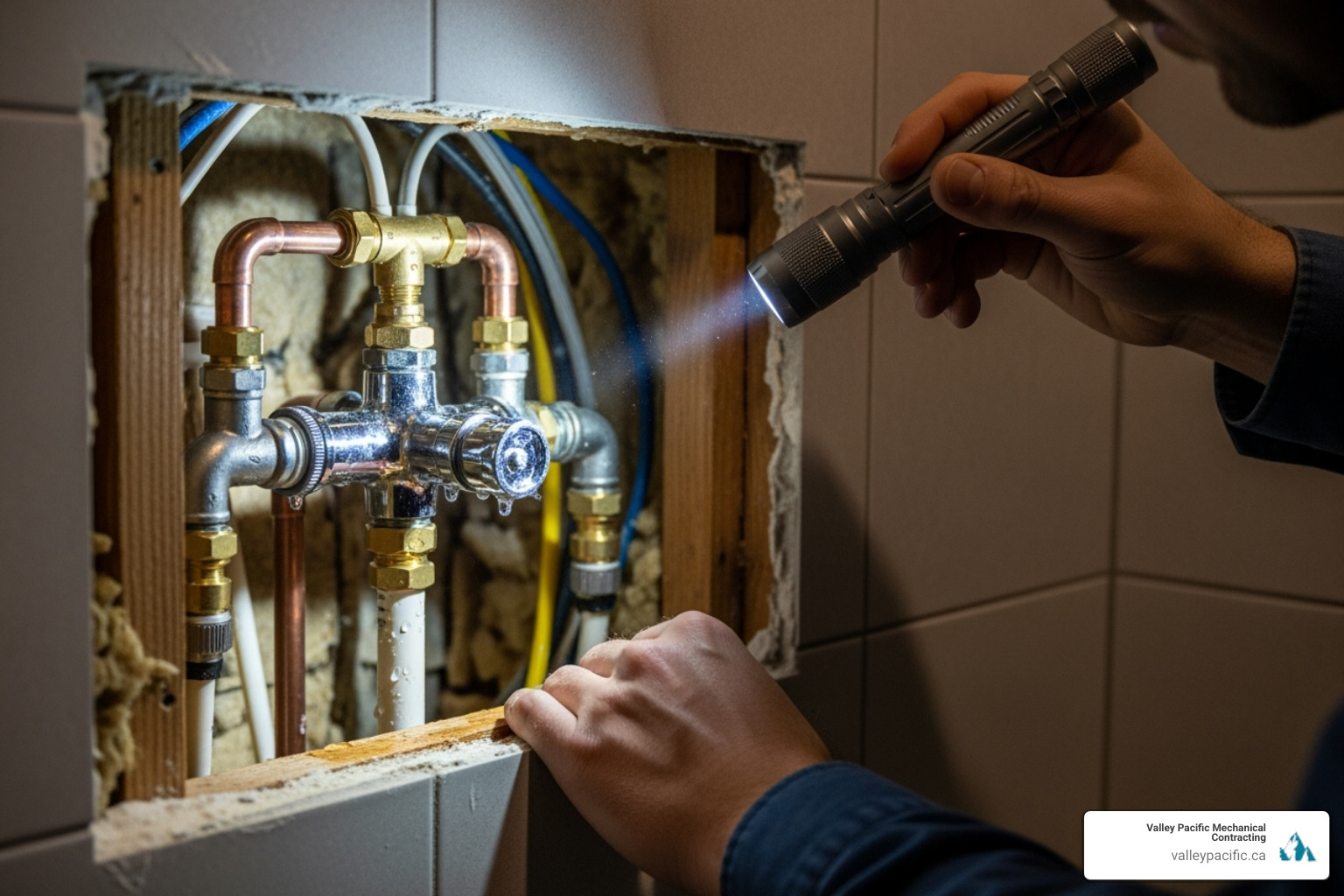
Common Issues After a Shower Valve Replacement
Most post-installation challenges have straightforward solutions.
- Low Pressure: This is often caused by shut-off valves that aren't fully open or debris lodged in the new cartridge or showerhead. Check your valves first, then remove and clean the showerhead.
- Leaks from Connections: Most leaks come from connections that need more tightening or improperly seated seals. Turn off the water, then check that threaded connections are snug (but not over-tightened) and that O-rings are seated correctly. A leaky solder joint may need to be reheated and have more solder applied.
- Incorrect Hot/Cold Orientation: If your hot and cold are reversed, the cartridge was likely installed backward. Turn off the water, remove the trim, and reorient the cartridge according to the manufacturer's instructions.
- Diverter Not Working: If water comes from both the tub spout and showerhead, check that the diverter mechanism moves freely and is not blocked by debris.
- Strange Noises: Humming or whistling can indicate loose components. Ensure the valve is securely mounted and all fasteners are tight.
If these steps don't solve the problem, it's time to call a professional.
Maintaining Your New Shower Valve
With simple maintenance, your new valve will provide years of reliable service.
- Regular Cleaning: Prevent mineral buildup by cleaning your showerhead and trim regularly. Soaking the showerhead in vinegar can dissolve deposits. Use mild cleaners on the trim to protect the finish.
- Check for Leaks: Periodically inspect around the trim plate for any signs of moisture. Catching small drips early prevents bigger problems.
- Check the Cartridge: The cartridge is the most likely part to wear out, especially with hard water. If you notice temperature control or flow issues, the cartridge is the first thing to check.
- Avoid Harsh Chemicals: Strong drain or tile cleaners can damage the internal seals and external finish of your valve and trim. Use them with care.
Frequently Asked Questions about Shower Valves
With over 30 years of experience, we've answered many questions about shower valve replacement. Here are some of the most common.
What is a shower diverter valve?
A shower diverter valve directs water to either the tub spout or the showerhead in a tub/shower combo. It's typically a lever on the tub spout or a separate knob on the wall. A failing diverter is a common issue, often resulting in water coming from both outlets simultaneously. This is an important consideration during a shower valve replacement for a combination unit.
What's the difference between a pressure-balancing and a thermostatic valve?
This is a key question about safety and performance.
- Pressure-balancing valves react to changes in water pressure. If a toilet flush causes cold water pressure to drop, the valve automatically reduces hot water flow to prevent scalding. They are an affordable and effective safety feature.
- Thermostatic valves react to temperature. You set a precise temperature, and the valve constantly adjusts the hot and cold water mix to maintain it, regardless of pressure changes. They offer the ultimate in comfort and safety at a higher price point.
Both are excellent upgrades that prevent scalding.
Can I replace just the shower valve cartridge?
Yes, in many cases, you can solve issues like drips or a stiff handle by simply replacing the shower valve cartridge. This internal component controls water flow and temperature and is often the first part to wear out. It's a much simpler and less invasive repair than replacing the entire valve body.
The key is to find an exact match for your valve's brand and model, as cartridges are not interchangeable. Take the old one to a plumbing supply store to ensure you get the right part.
A full shower valve replacement is the better choice if the valve body itself is corroded, if you're upgrading from an old two-handle system, or if you want to install a different type of valve (like a thermostatic one).
Conclusion: When to Call a Professional
While a shower valve replacement can be a DIY project, it's important to know when to call a professional. Unexpected issues like corroded pipes or the need for soldering can make the job complex. A mistake can lead to costly water damage behind your walls, turning a weekend project into a major repair.
If you encounter complications, lack the proper tools, or simply feel uncomfortable with any step, calling an expert is the smart choice. The risk of a poorly installed valve and subsequent leaks is not worth it.
At Valley Pacific Mechanical Contracting, we offer headache-free plumbing solutions backed by over 30 years of experience. Our licensed plumbers serve homeowners throughout Langley, Mission, Maple Ridge, Pitt Meadows, and Coquitlam, ensuring your shower valve replacement is done right the first time. We have the expertise and specialized tools to handle any challenge, giving you peace of mind.
We also provide 24/7 emergency service in Langley, Mission, and Maple Ridge for urgent plumbing problems. Don't let a faulty shower valve disrupt your home. Contact us for a professional assessment and reliable service.
More info about our plumbing services
Your Go-To Guide for Coquitlam Heat Pump Repair
Need Coquitlam heat pump repair right now?Here's how to get help quickly:
- Contact a local expert: Call Valley Pacific Mechanical Contracting for immediate service.
- Explain the problem: Describe what's happening with your heat pump.
- Schedule a visit: Get an experienced technician to your home fast.
When your home comfort depends on your system, understanding Coquitlam heat pump repair is key. Heat pumps are amazing. They keep your Coquitlam home warm in winter and cool in summer. This means year-round comfort for your family.
Heat pumps are also very efficient. They help save energy and are better for the environment. But even the best systems can have problems. When they do, you need quick, reliable help.
Ignoring small issues can lead to bigger, more costly repairs. This guide will show you what signs to watch for. It will also help you understand why expert repair matters. Getting professional help means your home stays comfortable, and your system runs smoothly.
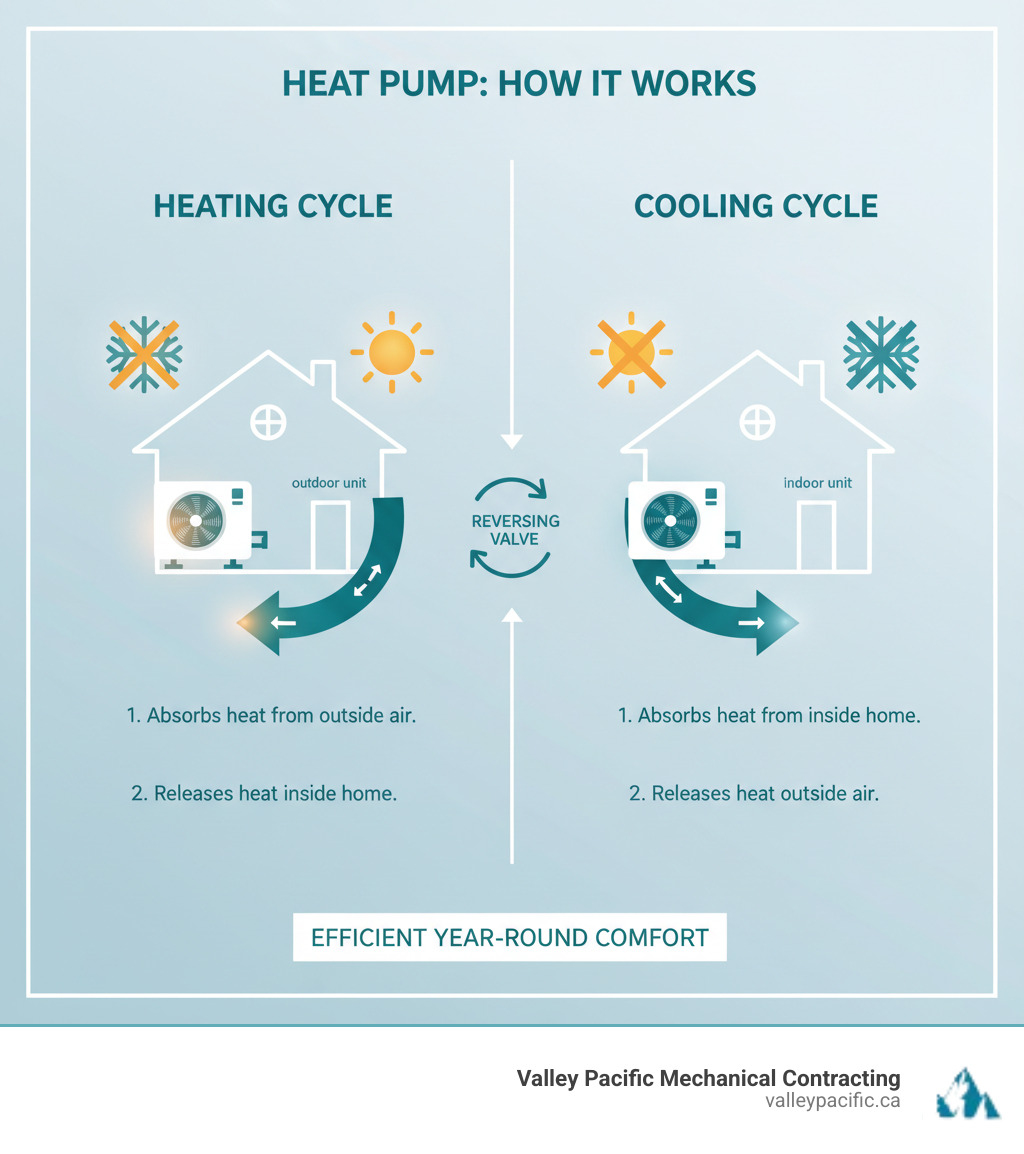
Telltale Signs Your Heat Pump Needs Repair
Even the most reliable heat pumps, which work so hard to keep your Coquitlam home cozy all year, can sometimes run into a snag. Knowing what to look and listen for can make a big difference! Catching small issues early helps you avoid bigger, more expensive problems down the road. Our friendly team at Valley Pacific Mechanical Contracting has seen it all, and we’re always here to help you figure out when it’s time to call in the pros for Coquitlam heat pump repair.
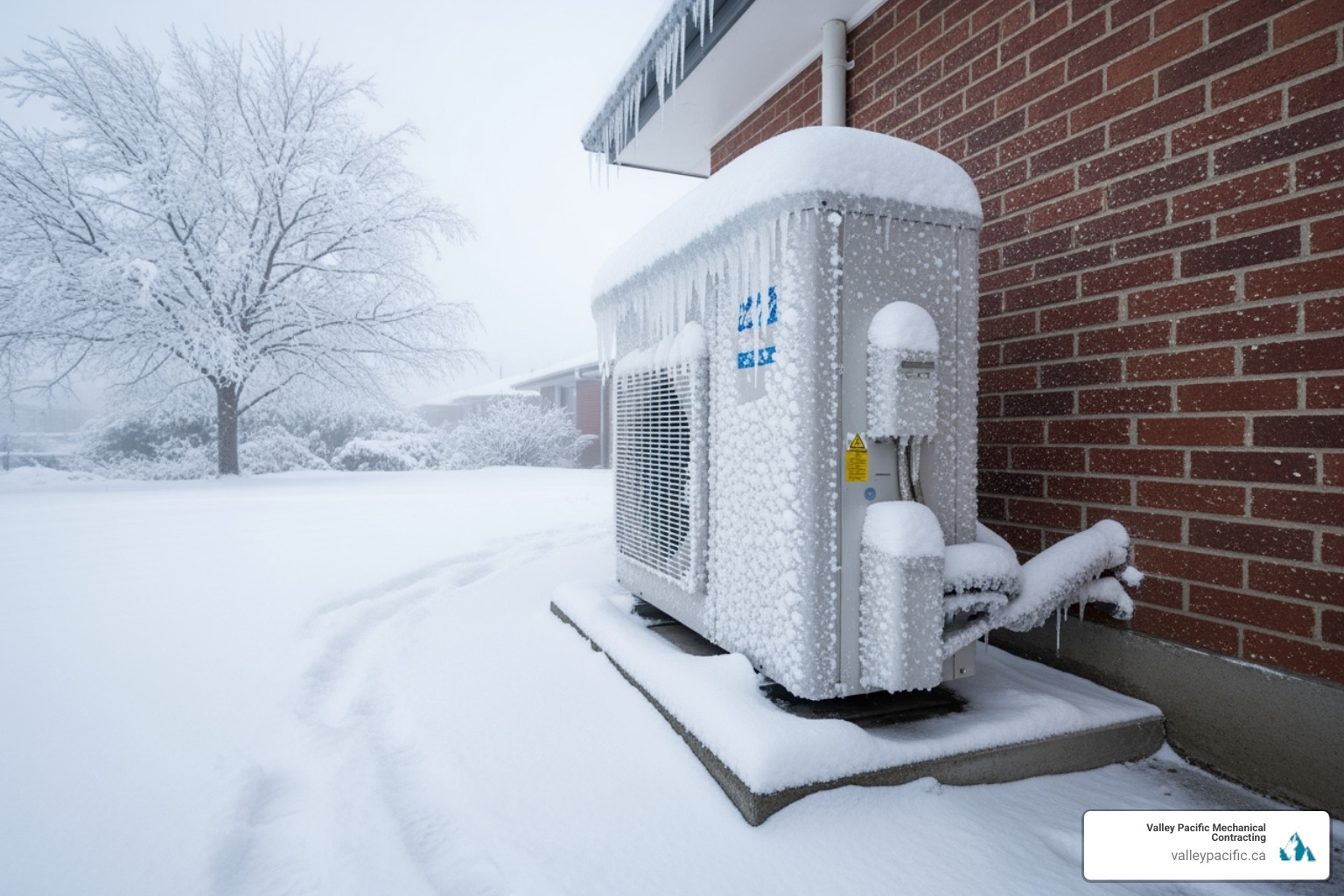
You might notice some clear signs that your heat pump is struggling. Things like strange noises, your home not getting as warm or cool as it should, or the system turning on and off too often (we call this frequent cycling) are all big clues. An unexpected jump in your energy bills can also be a hint. Keep an eye out for uneven temperatures from room to room, or if the air coming from your vents feels weak. These are all clear signals that your system needs a little TLC. Want to dive deeper into these signs? Check out our guide on Signs Your Heat Pump Needs Repair.
Common Noises and What They Mean
Your heat pump works hard, but it shouldn't sound like a noisy orchestra! While some gentle hums are normal, certain sounds can be a real cry for help. Understanding these noises early can save you a lot of future headaches.
If you hear grinding sounds, it often points to an issue with the motor bearings. This can mean they're wearing out, which is a serious problem that needs quick attention to prevent more damage. If your heat pump sounds like it's grinding, please reach out to our experts right away. You can learn even more about this in our article on Heat Pump Grinding Noises Causes.
A squealing or screeching noise usually means there's a loose or worn-out belt (especially in older models) or a problem with the indoor fan motor. It's an annoying sound that signals something is wearing down. When you hear banging or clanking, it could be anything from a loose part inside the unit to a more serious issue with the compressor itself. Often, it means something has come loose and is hitting other components.
Finally, a hissing noise might be a sign of a refrigerant leak. This is a serious concern because it makes your system less efficient and can even damage the compressor. If you suspect a leak, professional help is needed to find and fix it, and then refill the refrigerant. Our expert technicians are super skilled at figuring out exactly what's causing any unusual sound and getting your system back to its quiet, efficient self.
Performance Issues to Watch For
Beyond the strange noises, there are several performance issues that can tell you your heat pump needs a helping hand:
Have you noticed your system blowing cool air in heat mode? If your heat pump is set to warm your home but is sending out chilly air instead, it might be a problem with the reversing valve, which controls whether your system heats or cools.
Another key sign is if your system isn't dehumidifying effectively. In cooling mode, heat pumps also help remove moisture from your home. If your house feels unusually damp or sticky, even when the AC is running, your heat pump might not be working its best. Sometimes, a unit that's too big can also turn on and off too often, not giving it enough time to properly dry the air.
If your thermostat isn't responding or isn't accurately showing or controlling your home's temperature, the issue could be with the thermostat itself or how it's communicating with your heat pump.
Lastly, watch out for ice buildup on coils. While a little frost is normal in colder months (thanks to the defrost cycle!), a lot of ice on your outdoor unit's coils is a big red flag. This often means there's a problem with the defrost cycle, low refrigerant levels, or even blocked airflow. Ignoring this can lead to serious damage. For more on this, take a look at Why is My Heat Pump Not Defrosting.
Inconsistent heating or cooling, air that doesn't flow as strongly as it should, and any general changes in how your system performs are all important warning signs. Dealing with these quickly is super important to keep your system running efficiently and to help it last longer!
The Advantages of Professional Coquitlam Heat Pump Repair
When your heat pump starts acting a little funny, it’s natural to wonder if you can fix it yourself. But trust us, for something as important as your home’s comfort, calling in the pros for Coquitlam heat pump repair is always the smartest move. Here at Valley Pacific Mechanical Contracting, we bring a whole lot more than just tools to your door. We bring true local expertise and a commitment to providing a "headache-free" experience.
We live here too, so we understand exactly how Coquitlam's unique weather patterns can affect your heat pump. This local expertise helps us troubleshoot faster and find custom solutions that really work for our climate. And when you need help fast, especially in an emergency, our 24/7 emergency service means we're always ready. You won't be left out in the cold – or the heat!
Plus, there's the peace of mind that comes with accountability. When you choose a professional, you're choosing someone who stands behind their work. We don't just guess; we use proper diagnostic tools to pinpoint the exact problem. This means accurate, lasting repairs, not just temporary fixes. Our comprehensive inspections ensure we fix the root cause, leading to more efficient solutions. This helps your heat pump operate at peak efficiency, saving you on energy costs and keeping your home comfortable year-round.
To dive deeper into why expert service makes all the difference, check out our article on Expert Heat Pump Repair Services. And for general HVAC repair insights in our beautiful area, our HVAC Repair Coquitlam page is a handy resource.
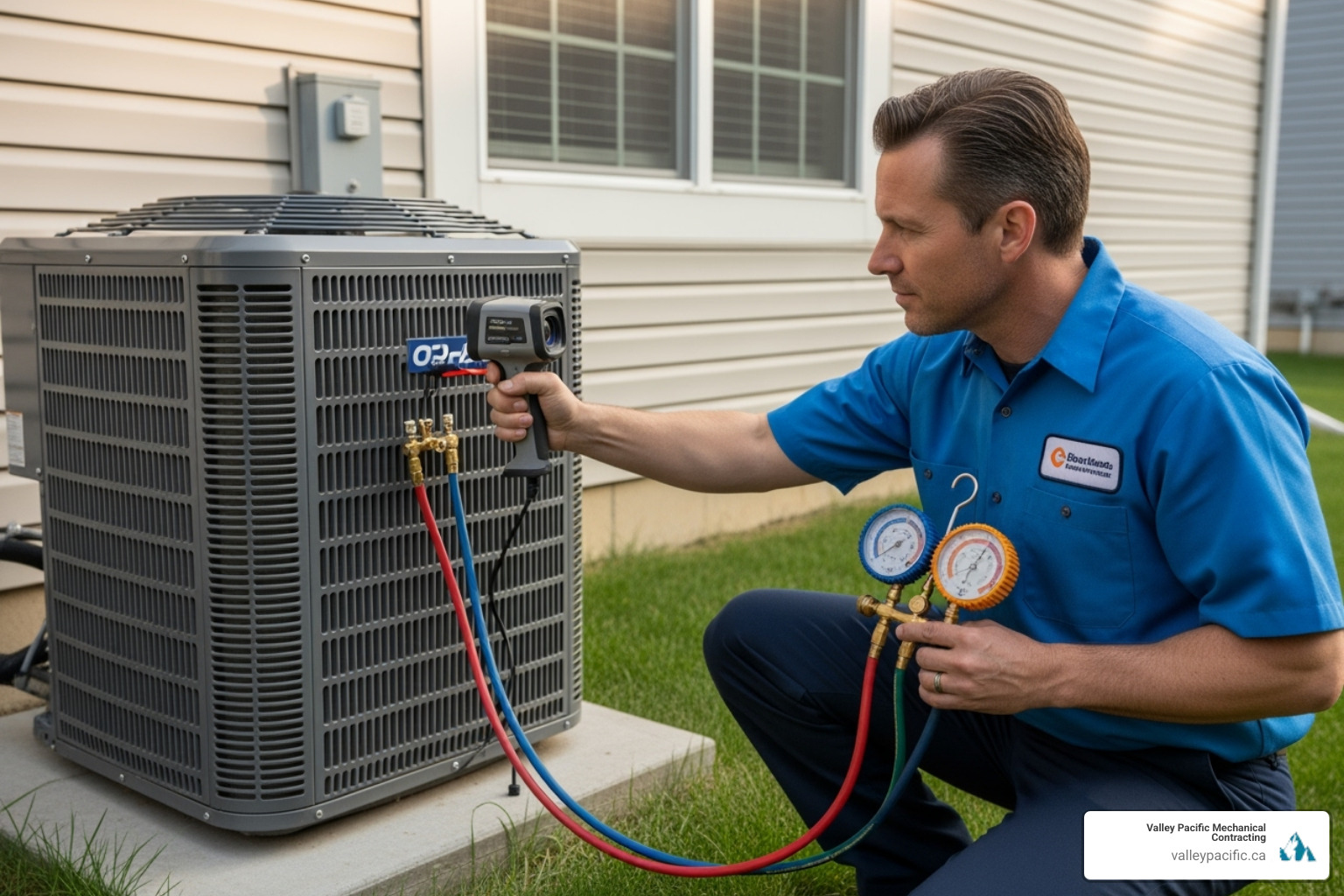
Choosing the Right Local Repair Service
Picking the right team for your Coquitlam heat pump repair is a big decision. You want someone you can truly rely on. Here’s what to look for when making your choice:
First off, years of experience really count. Our team has proudly served the Lower Mainland for over 30 years, including our wonderful Coquitlam community. That's a lot of heat pumps fixed, and a lot of happy homeowners!
Next, what do your neighbours say? Positive customer reviews are like gold. We're so proud of what our Coquitlam residents share about their experiences with us, showing our commitment to you.
You also need a team that can handle anything. Look for service for all makes and models. Whether you have a popular Daikin system or another brand, central or mini-split, our technicians are skilled and ready to help.
And let's be honest, you want a headache-free experience. From your first call to the final repair, we aim for clear communication and getting the job done right the first time, every time.
Finally, always make sure you're working with licensed and certified technicians. This means they have the proper training and follow all the best safety and quality standards. You can even find a licensed contractor in your area to double-check. We're here to make sure your heat pump is in the best hands possible.
Why Heat Pumps Excel in Coquitlam's Climate
Living in Coquitlam means enjoying some of the best weather in Canada. Our mild winters and comfortable summers create the perfect conditions for heat pump technology to really shine. If you're considering a heat pump or already have one that needs Coquitlam heat pump repair, understanding why these systems work so well here will help you appreciate their value.
Heat pumps are incredibly clever machines. Instead of burning fuel to create heat, they simply move heat from one place to another. During winter, they pull warmth from the outdoor air (yes, even when it feels freezing to us!) and bring it inside. When summer arrives, they flip the process, taking heat from your home and sending it outside. It's like having a heating system and air conditioner rolled into one efficient package.
BC's mild climate is practically made for heat pump technology. Unlike harsher climates where systems struggle in extreme cold, Coquitlam's temperatures allow heat pumps to operate efficiently year-round without constantly relying on backup heating. This means consistent comfort for your family and better energy bills for you.
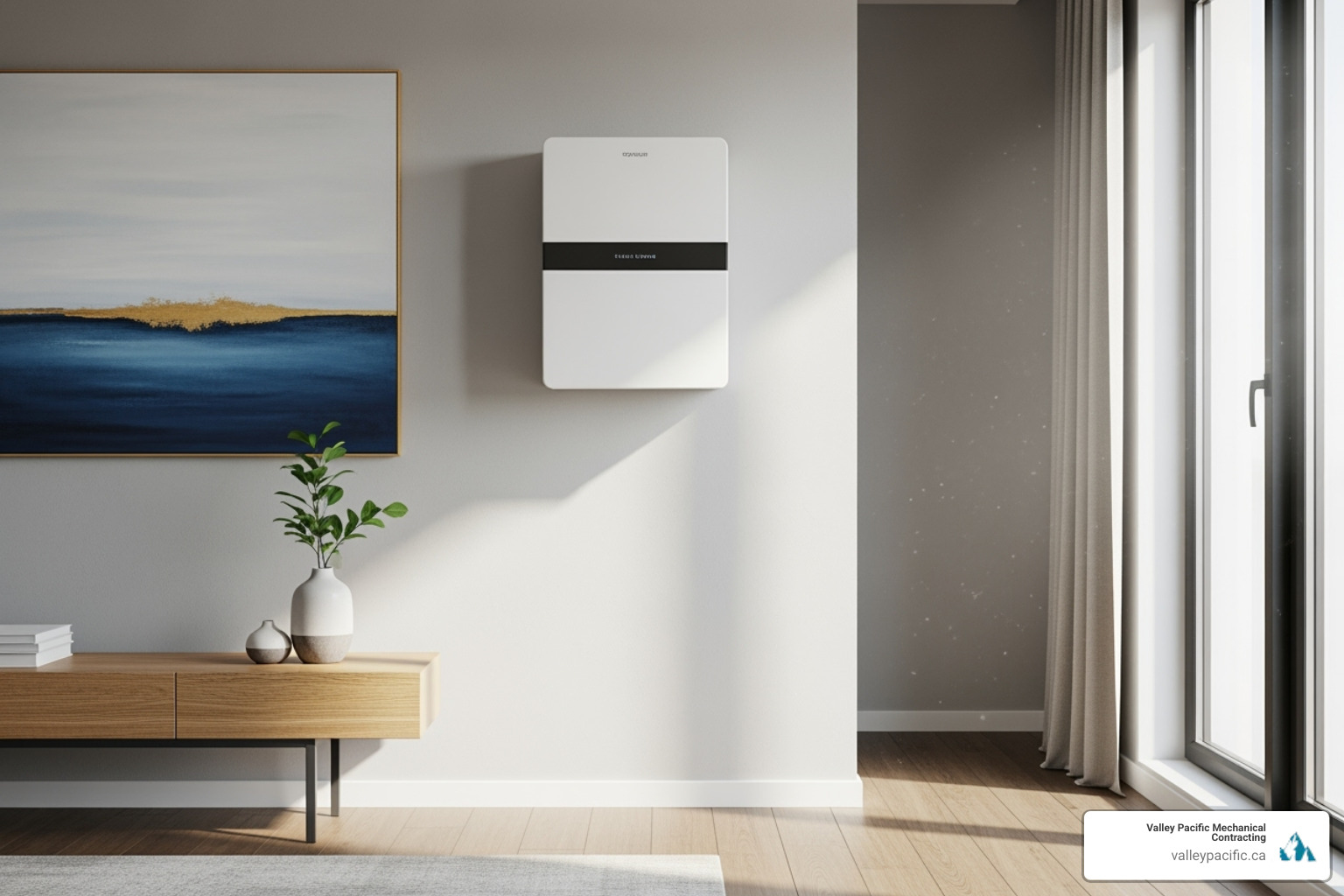
The environmental benefits make heat pumps even more appealing for Coquitlam residents. BC Hydro provides over 93% carbon-free electricity to our community, which means your heat pump runs on clean energy. By choosing electricity over fossil fuels, you're actively reducing your carbon footprint while keeping your home comfortable. It's a win-win situation that aligns perfectly with BC's sustainability goals.
For more insights on why these systems are such a smart choice, take a look at our guide on Consider Heat Pump Installation Reasons. And if you're curious about how heat pumps handle both heating and cooling duties, our Heat Pump AC page has all the details.
Popular Heat Pump Types for Local Homes
When it comes to choosing the right heat pump for your Coquitlam home, you have some excellent options that work beautifully in our climate.
Air-source heat pumps are the most popular choice for good reason. These systems transfer heat between your home and the outside air, making them highly effective in our mild weather. They work with your existing ductwork through a central ducted system, using a clever reversing valve to switch between heating and cooling modes. If your home already has ducts, this is often the most straightforward option.
Ductless mini-split systems are perfect for homes that don't have existing ductwork, or when you want independent temperature control in specific areas. These versatile systems have been used worldwide for over 50 years and are becoming increasingly popular in Coquitlam. A single outdoor unit can provide comfort for one room, or with multi-zone setups, you can heat and cool up to five different rooms independently. They're incredibly efficient and give you precise control over your comfort.
Central ducted systems offer whole-home comfort by connecting to your existing ductwork or a new air handler. These systems are designed to work efficiently even during our cooler months, providing clean, comfortable heat throughout your entire home.
The key to getting the most from any heat pump is choosing the right size and type for your specific home. Factors like your home's size, existing ductwork, and energy efficiency goals all play a role in finding the perfect match. Our experienced team can help you steer these choices, ensuring you get optimal performance and maximum comfort from your investment.
From Repair to Prevention: Maintaining Your Heat Pump's Health
Think of your heat pump like your car – it runs better and lasts longer when you take good care of it. The best Coquitlam heat pump repair is the one you never need because you stayed ahead of problems with regular maintenance.
Regular maintenance isn't just about keeping things running smoothly today. It's your shield against those middle-of-the-night breakdowns when the temperature drops unexpectedly. When you invest in preventive care, you're actually preventing costly breakdowns that always seem to happen at the worst possible times.
There's another bonus you might not have considered: extending your system's lifespan. A well-maintained heat pump can serve your family faithfully for many more years than one that's neglected. Plus, regular cleaning and filter changes mean improved indoor air quality for everyone in your home.
We recommend annual maintenance visits, ideally before the busy heating or cooling seasons begin. This timing ensures your system is ready to handle whatever Coquitlam's weather throws at it. For practical guidance throughout the year, check out our Seasonal Heat Pump Maintenance Tips and our comprehensive Heat Pump Service Langley Guide.
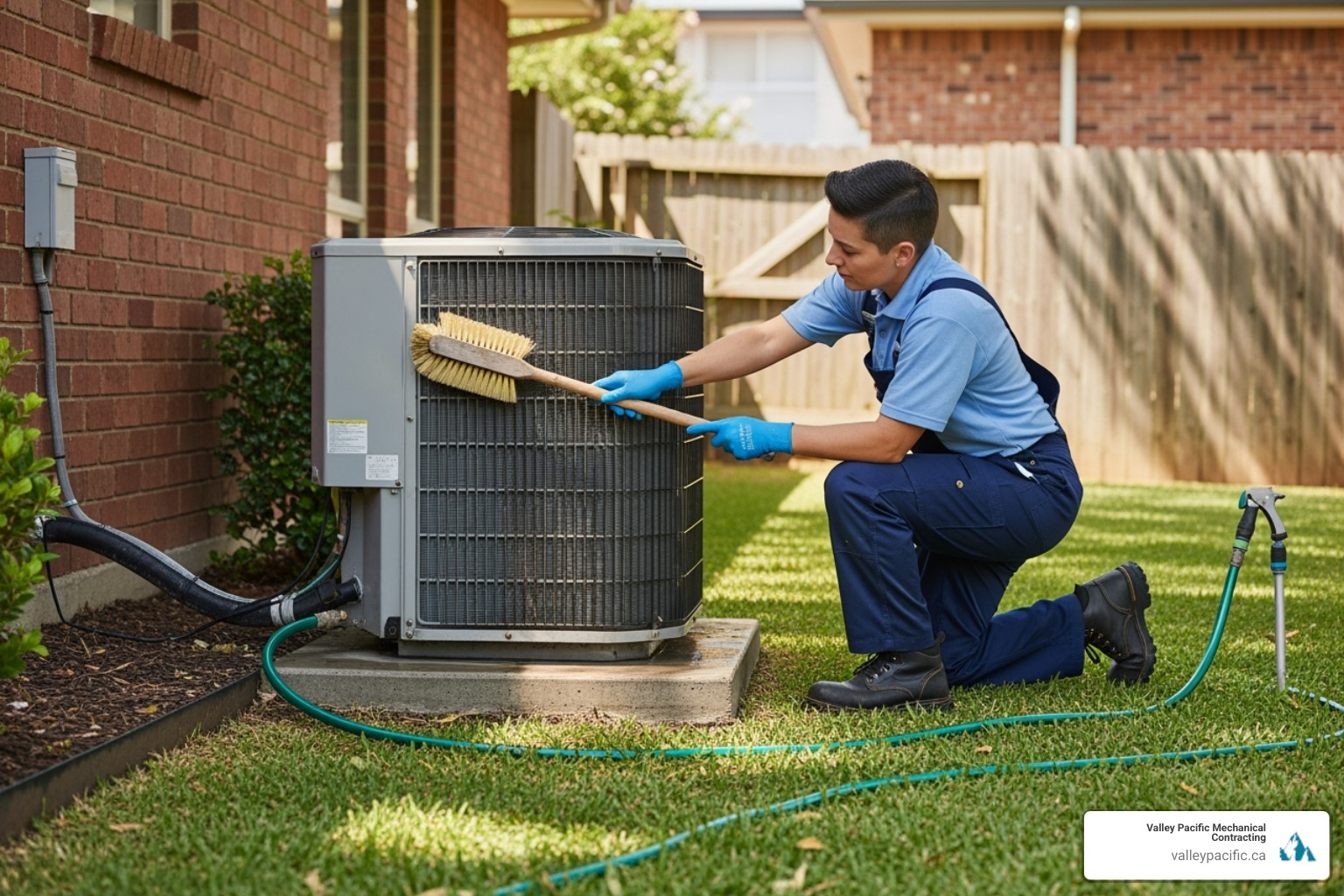
Ensuring Energy Efficiency After a Coquitlam Heat Pump Repair
After completing your Coquitlam heat pump repair, our work isn't done. We believe in restoring your system to peak performance, not just getting it limping along again. This comprehensive approach means better comfort and lower energy bills for you.
Professional testing is our first step after any repair. We put your system through its paces in both heating and cooling modes, making sure everything works as smoothly as the day it was installed. No shortcuts here – we want to be absolutely certain your heat pump is ready for whatever comes next.
System calibration comes next, where we fine-tune all the components to work together harmoniously. Think of it like tuning an orchestra – every part needs to be perfectly synchronized. We adjust fan speeds, temperature sensors, and other settings to optimize both performance and energy efficiency.
Cleaning coils and filters might sound basic, but it's incredibly powerful. Dirty coils and clogged filters are like trying to breathe through a straw – everything has to work harder. We thoroughly clean both indoor and outdoor coils and ensure your filters are fresh. This simple step often delivers dramatic improvements in airflow and efficiency.
Checking refrigerant levels is critical because your heat pump is very particular about having just the right amount. Too little refrigerant and your system struggles to heat or cool effectively. Too much can actually damage components over time. We verify and adjust levels to match the manufacturer's exact specifications.
Finally, we share homeowner tips because we want you to succeed between our visits. Our technicians will show you simple things you can do to keep your system happy, like when to change filters and how to keep the outdoor unit clear of debris. These small actions can make a huge difference in your system's performance and longevity.
Frequently Asked Questions about Heat Pump Repair
When it comes to Coquitlam heat pump repair, we get asked the same questions time and time again. That's totally understandable – your heat pump is a significant investment in your family's comfort, and you want to know how to take care of it properly. Let's explore the most common concerns we hear from homeowners like you.
How often does a heat pump need to be serviced?
Here's the golden rule: schedule professional maintenance at least once a year. Think of it like getting a check-up at the doctor – prevention is always better than waiting for something to go wrong.
The timing matters too. We recommend booking your service in late spring if you're preparing for the cooling season, or early fall if you're getting ready for those chilly Coquitlam winters. This proactive approach ensures your system is ready when you need it most.
Regular maintenance isn't just about keeping your system happy (though it definitely does that!). It's often required to keep your warranty valid, which protects your investment. Plus, annual service prevents those unexpected breakdowns that always seem to happen on the hottest or coldest days of the year.
The benefits are pretty impressive: your system runs more efficiently, lasts longer, maintains better indoor air quality, and saves you money on energy bills. It's really a win-win situation.
Can I do any heat pump troubleshooting myself before calling for a repair?
Absolutely! We love it when homeowners take an active role in caring for their systems. Before you call us for Coquitlam heat pump repair, there are several simple checks you can do that might solve the problem right away.
Start with your thermostat settings. It sounds basic, but you'd be surprised how often the issue is just a thermostat set to the wrong mode or temperature. If you have a smart thermostat, make sure it's connected to Wi-Fi and the app is up to date. Don't forget to check those batteries too!
Next, check your power switches and breakers. Make sure the power switches for both your indoor and outdoor units are turned on, and verify that no circuit breakers have tripped. Sometimes the solution really is that simple – just flip a switch and you're back in business.
Your air filters deserve special attention. A clogged filter can make your heat pump work much harder than it should, or even cause it to shut down completely. Check your filter, and if it's dirty, replace it. Wait about 10 minutes after changing it, then try restarting the unit. We recommend changing 1-inch filters every few months and 6-inch filters every six months to a year.
Finally, take a look at your outdoor unit. Clear away any leaves, dirt, or debris that might be blocking the coils or fan. Your heat pump needs room to breathe, just like you do!
These simple steps can often save you a service call for minor issues. But if you've tried these troubleshooting steps and your system still isn't working properly, that's when it's time to call in our professional team.
How long does a heat pump typically last in BC?
In British Columbia's mild climate, a well-maintained heat pump typically lasts about 15 years. But here's the exciting part – with proper care and maintenance, many units can keep running efficiently for 20 years or even longer.
Several factors influence how long your heat pump will serve your family. Quality installation is crucial – a properly sized and installed unit operates more efficiently and experiences less wear and tear over its lifetime. This is why choosing experienced professionals like our team at Valley Pacific Mechanical Contracting makes such a difference.
Regular maintenance is absolutely critical for longevity. Those annual service appointments we talked about earlier? They're not just nice to have – they're essential for keeping your system running smoothly year after year. During these visits, we clean components, calibrate settings, and catch small issues before they become big problems.
Your usage patterns matter too. How often you use your heat pump and how you set your thermostat can impact its lifespan. System sizing is another crucial factor that many homeowners don't think about. A heat pump that's too large will cycle on and off too frequently, which reduces its lifespan and fails to properly remove humidity from your home. On the flip side, a unit that's too small will struggle to maintain comfortable temperatures, leading to increased energy use and unnecessary strain on the components.
BC's mild climate is actually favorable for heat pump longevity, though extreme weather events can occasionally put extra stress on the system.
As your heat pump approaches that 15-year mark, keep an eye out for signs it might be time for a replacement: frequent breakdowns, reduced efficiency, and steadily rising energy bills. When that time comes, our experienced team can help you assess your current system and guide you toward the best solution for your home and family.
Your Partner for Reliable Coquitlam Heat Pump Repair
Your heat pump works hard to keep your Coquitlam home comfortable year-round. We've covered the warning signs that signal trouble, from strange noises to ice buildup. We've explored why professional repair makes such a difference, and how heat pumps thrive in our mild BC climate. Most importantly, we've shown how regular maintenance can prevent small issues from becoming big headaches.
The key takeaway? Don't wait when your heat pump starts acting up. Those unusual sounds or inconsistent temperatures aren't going to fix themselves. In fact, ignoring them often leads to more extensive damage and bigger repair bills. Your family's comfort depends on a system that works reliably, especially during those chilly winter nights or hot summer days.
That's where Valley Pacific Mechanical Contracting comes in as your trusted partner for Coquitlam heat pump repair. We've been serving the Lower Mainland for over 30 years, and we understand exactly how our local climate affects your heat pump's performance. Our certified technicians arrive with the right tools and expertise to diagnose problems accurately the first time.
What sets us apart is our commitment to a truly headache-free experience. We explain what's wrong in plain language, show you exactly what we're doing, and make sure your system is running at peak efficiency before we leave. Whether it's a midnight emergency or routine maintenance, our 24/7 service means we're here when you need us most.
We're also proud to stand behind the Daikin Comfort Promise, ensuring you receive top-tier products and service that you can count on. From Coquitlam to Maple Ridge, Langley, Pitt Meadows, and Mission, homeowners trust us to keep their heat pumps running smoothly.
Don't let heat pump troubles leave your family uncomfortable. If you've noticed any of the warning signs we've discussed, or if it's been a while since your last maintenance visit, give us a call. We're here to ensure your heat pump delivers the reliable, efficient comfort your home deserves.
Learn more about expert heat pump services and find why so many Coquitlam families choose Valley Pacific as their go-to HVAC partner.
Why Professional HVAC Services Matter for Pitt Meadows Homeowners
HVAC services Pitt Meadows residents rely on include heating system installation, air conditioning maintenance, heat pump services, and indoor air quality solutions. Experienced local companies provide comprehensive residential and commercial HVAC support throughout the Fraser Valley.
Key HVAC Services Available in Pitt Meadows:
- Heating Systems: Furnace installation, repair, and maintenance
- Cooling Solutions: Air conditioning installation and repair services
- Heat Pumps: Installation and servicing of energy-efficient heat pump systems
- Emergency Services: 24/7 repair support for heating and cooling breakdowns
- Indoor Air Quality: Air filtration and ventilation improvements
- Maintenance Plans: Regular tune-ups to prevent costly breakdowns
Your home should be a cozy refuge during Pitt Meadows' chilly winters and a cool escape during warm summer days. But when your HVAC system acts up—making strange noises, failing to heat or cool properly, or driving up your energy bills—that comfort disappears fast.
The good news? Pitt Meadows has experienced HVAC professionals ready to restore your year-round comfort. Companies with decades of local experience understand what systems work best in our Fraser Valley climate.
This guide walks you through everything you need to know about finding reliable HVAC services in Pitt Meadows. From understanding your system's needs to choosing the right contractor, we'll help you make informed decisions to keep your home comfortable for years to come.
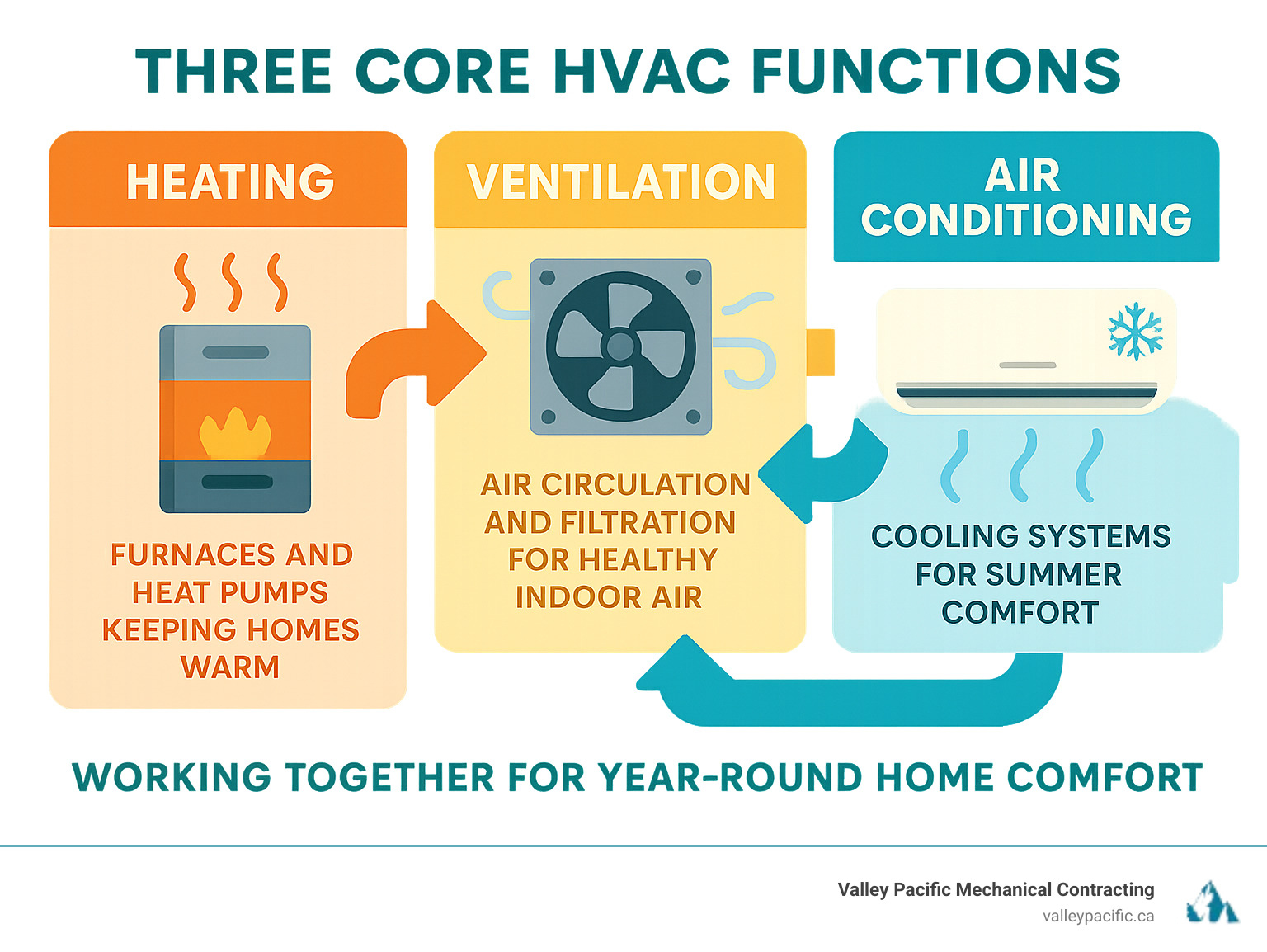
Hvac services pitt meadows helpful reading:
Understanding Pitt Meadows' Climate and Your HVAC Needs

Living in Pitt Meadows means experiencing Fraser Valley weather, from mild, rainy winters to warm, dry summers. This unique climate requires your HVAC system to be a real workhorse, providing heat on damp February days and cooling when July temperatures soar. Understanding these climate-specific HVAC needs helps you choose systems that work efficiently year-round, keeping energy bills reasonable while maintaining a perfect indoor environment.
Energy efficiency is key in our climate, as your system will operate in both heating and cooling modes. A well-matched system designed for Fraser Valley conditions pays for itself through lower utility bills and fewer repairs.
Popular Heating and Cooling Systems
Several systems are popular among Pitt Meadows homeowners, each with unique benefits.
Heat pumps are a top choice in the Fraser Valley. These all-in-one units provide both heating and cooling by moving heat, making them incredibly efficient for our mild winters. If you're curious about heat pump options, our Heat Pump Service Pitt Meadows BC team can help.
High-efficiency furnaces remain the reliable workhorses of home heating. Modern models are far more efficient than older units, providing steady, dependable heat during long, damp winter months. We offer complete Furnace Installation Pitt Meadows BC services for new builds and upgrades.
Central air conditioners have become essential as our summers get warmer. These units cool your entire home evenly, ensuring comfort even on the hottest days. Our AC Installation Pitt Meadows BC service helps families prepare for summer.
Ductless mini-splits offer flexibility for homes without existing ductwork or for targeted climate control in specific areas, like a home office or basement suite.
Boilers provide luxurious, even warmth that radiates through your home without the air movement of forced-air systems, a favorite for many homeowners.
Matching the System to Your Home
Choosing the right HVAC system is about finding what works best for your home and family. We consider several key factors:
- Home size is crucial. A system that's too small will run constantly, while one that's too large will cycle inefficiently and waste energy.
- Insulation levels affect how hard your HVAC system must work. A well-insulated home can use a smaller, more efficient system.
- Budget considerations are important. We focus on long-term value and work with you to find options that fit your financial situation.
A properly sized, efficient system matched to your home leads to long-term savings through lower energy bills and fewer repairs. If you're considering heating options, our guide on How Do I Choose the Right Furnace for My Home in Pitt Meadows BC can help. The goal is to find the sweet spot where your system handles Pitt Meadows' climate efficiently while fitting your home's unique needs. That's where professional hvac services Pitt Meadows expertise makes the difference.
Your Guide to Professional HVAC Services in Pitt Meadows
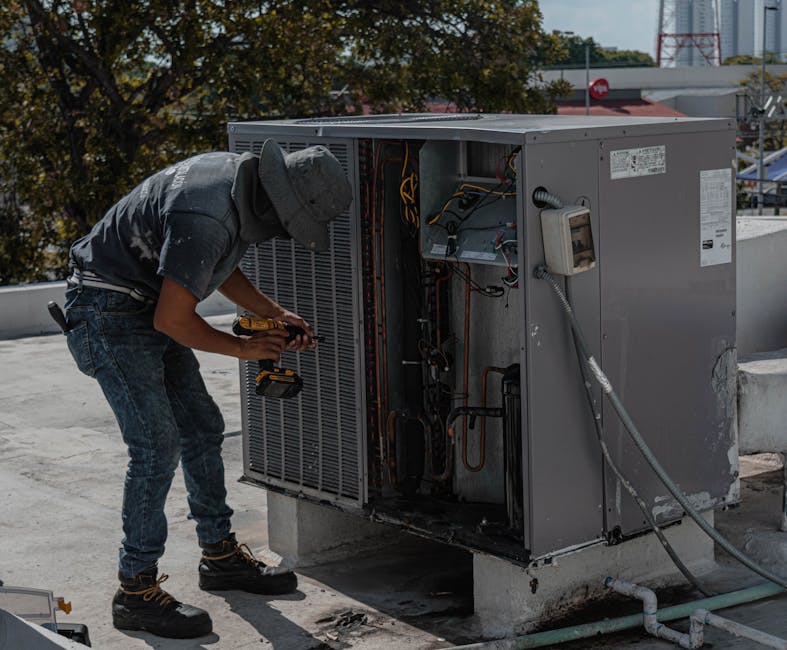
Finding reliable HVAC services Pitt Meadows homeowners can trust is key to year-round comfort. Professional services ensure your heating, cooling, and ventilation systems work when you need them most for both residential and commercial properties.
At Valley Pacific Mechanical Contracting, our 30+ years of experience have perfected a "headache-free experience," providing comprehensive solutions without the stress. Our essential services cover four key areas: Installation, Repair, Maintenance, and Indoor Air Quality improvements.
Installation and Replacement
A proper installation is crucial for a new HVAC system. We handle everything from new construction installation to system upgrades, replacing old, inefficient units with modern, energy-efficient models that lower your monthly bills. Our services cover a full range of solutions, including expert Boiler Installation Pitt Meadows BC, AC Installation Pitt Meadows BC, and Heat Pump Installation Pitt Meadows BC.
Repair and Emergency Services
HVAC problems rarely happen at convenient times. That's why we offer 24/7 emergency response for issues like thermostat problems, refrigerant leaks, or strange noises. When your system fails, you need fast, reliable service. Our technicians handle everything from emergency Furnace Repair Pitt Meadows BC and urgent AC Repair Pitt Meadows BC to specialized Boiler Repair Pitt Meadows BC.
Proactive Maintenance for Peak Performance
The secret to avoiding emergency repairs is regular maintenance. A small amount of attention now prevents big problems later.
- Improved efficiency: A well-maintained system works less hard, lowering your energy bills.
- Extended lifespan: Regular care helps your furnace, AC, or heat pump reach its full potential lifespan.
- Fewer breakdowns: Maintenance catches small issues before they become expensive disasters.
- Better air quality: Clean filters and systems mean healthier air for your family.
Our comprehensive AC Service Pitt Meadows BC keeps your cooling system at its best. Learn more in our guide on HVAC Services for Home Comfort.
Recognizing When Your System Needs Attention

Your HVAC system usually works quietly in the background, but it will give you signals when something is wrong. Recognizing these signs early can help you avoid major headaches and costly repairs. Many HVAC services Pitt Meadows calls could be prevented if homeowners spot these warnings sooner.
Telltale Signs of HVAC Trouble
Be on the lookout for these common red flags that indicate your HVAC system needs professional attention:
- Insufficient heating or cooling: The system runs constantly but can't reach the set temperature.
- Poor airflow: Weak or no air coming from the vents can signal a blower issue or duct blockages.
- Unusual noises: Grinding, squealing, or rattling sounds are calls for help and suggest mechanical problems.
- Unpleasant odors: Musty smells may indicate mold, while burning odors could signal dangerous electrical issues.
- Rising energy bills: A sudden spike in your utility costs often means your system is working inefficiently.
- Frequent cycling: The system turning on and off more than usual puts extra wear on components and wastes energy.
Understanding Your HVAC System's Lifespan
Every HVAC system has a limited lifespan. Knowing the average can help you plan for a future replacement.
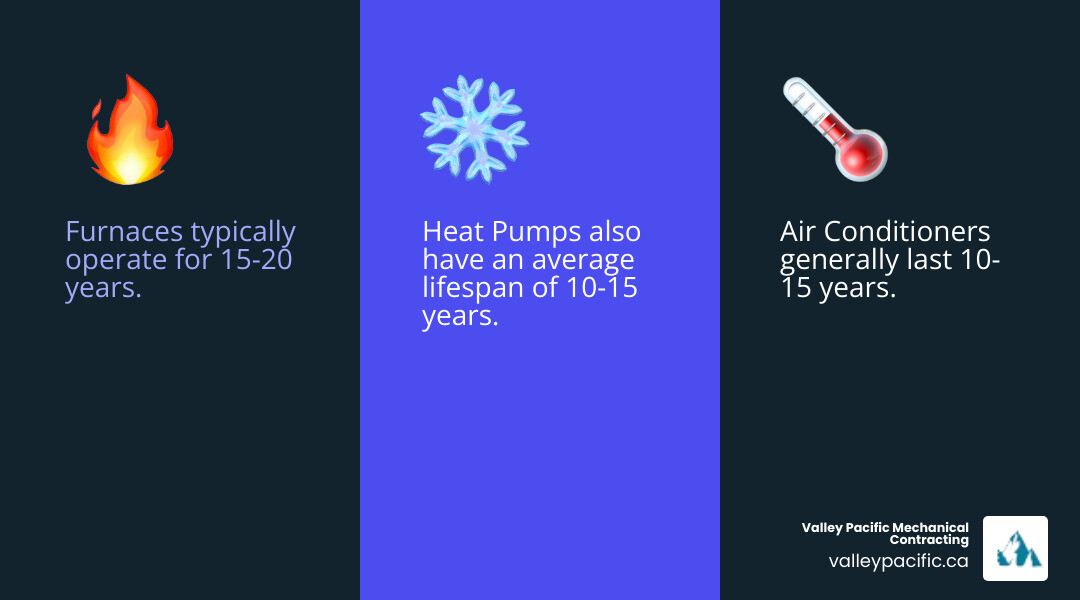
- Furnaces: Typically last 15-20 years.
- Air Conditioners & Heat Pumps: Usually last 10-15 years.
These are just averages. The actual lifespan depends heavily on factors like the quality of installation, regular maintenance, and your home's insulation. As your system ages and shows signs of trouble, a professional can help you decide whether a repair or replacement is the smarter long-term investment.
| System Type | Average Lifespan (Years) |
|---|---|
| Furnaces | 15-20 |
| Air Conditioners | 10-15 |
| Heat Pumps | 10-15 |
Choosing the Right HVAC Provider in Pitt Meadows
Finding the right HVAC services Pitt Meadows provider is about finding a partner you can trust with your family's comfort. You want a company that combines technical know-how with genuine care, making the experience as smooth as possible.
At Valley Pacific Mechanical Contracting, we've built our 30-year reputation on delivering a headache-free experience. We understand that choosing an HVAC provider is about more than just fixing equipment; it's about trust.
What to Look for in a Company Providing HVAC Services in Pitt Meadows
When evaluating HVAC contractors, look for these key factors:
- Years of Experience: A long-standing company has the expertise to handle any problem efficiently.
- Licensing and Certification: This is non-negotiable. Ensure your technicians are properly trained and legally authorized. You can check a contractor's license with Technical Safety BC to verify their credentials.
- Positive Customer Reviews: Real feedback from neighbors tells you about a company's reliability, punctuality, and communication.
- Warranties and Guarantees: Solid warranties on parts and labor show a company stands behind its work.
- Comprehensive Services: A provider who can handle everything from maintenance to emergency repairs and installations is ideal.
The Local Advantage for Your HVAC Services in Pitt Meadows
Choosing a local HVAC provider offers significant advantages:
- Understanding of Local Climate: Local contractors know how Pitt Meadows' weather affects heating and cooling needs, helping them recommend the best systems.
- Knowledge of Local Building Codes: They ensure every installation meets municipal standards, avoiding potential inspection issues.
- Faster Emergency Response: Local companies can reach you much quicker during an emergency. Our 24/7 service means help is always nearby.
- Community Accountability: Local businesses are invested in their community's reputation and provide a higher level of care.
To learn more about our commitment to the Pitt Meadows community, visit our About Us page and see why so many local families trust us.
Frequently Asked Questions about Pitt Meadows HVAC
Here are answers to some of the most common questions we receive from Pitt Meadows homeowners about their home comfort systems.
What's the difference between an HVAC system and an AC unit?
Though often used interchangeably, these terms are different. HVAC stands for Heating, Ventilation, and Air Conditioning. It's the complete system that manages your home's climate year-round, including your furnace or heat pump, ventilation, and air conditioner.
An AC unit is just one component of the larger HVAC system—the part responsible for cooling your home during the summer. When you need hvac services Pitt Meadows, you're looking for support for your entire comfort system, not just the air conditioner.
How can I make my HVAC system more energy-efficient?
Improving your system's efficiency is great for your wallet and the environment. Here are a few straightforward tips:
- Schedule regular maintenance: A clean, well-adjusted system runs more efficiently.
- Change air filters routinely: A clean filter (changed every 1-3 months) reduces strain on your system.
- Use a smart thermostat: Automatically adjust temperatures when you're away to save energy.
- Seal air leaks: Ensure your ductwork is properly sealed to prevent conditioned air from escaping.
- Upgrade when ready: If your system is old, upgrading to a high-efficiency model offers significant long-term savings.
Why is regular HVAC maintenance so important?
Regular maintenance is a small investment that saves you hassle and money. Key benefits include:
- Extends system lifespan: Annual tune-ups help your equipment last longer.
- Improves energy efficiency: A clean system uses less energy, lowering your utility bills.
- Prevents breakdowns: Technicians can spot and fix minor issues before they become major emergencies.
- Ensures safety: Professionals check for potential hazards like gas leaks or ventilation problems.
- Maintains healthy air quality: Clean filters and components mean cleaner air for your family.
Your Partner for Home Comfort in Pitt Meadows
Achieving year-round comfort in Pitt Meadows is straightforward with the right approach. This guide has covered the essentials: understanding our climate's impact on your HVAC needs, recognizing warning signs from your system, and choosing a trusted professional.
Key takeaways:
- Pitt Meadows' climate requires a robust HVAC system to handle both mild, rainy winters and warm, dry summers.
- Proactive maintenance is crucial to extend your system's life, improve efficiency, and prevent costly breakdowns.
- Choosing a qualified local professional who understands local codes and climate patterns ensures peace of mind.
For a headache-free experience from a team with over 30 years of expertise, consider Valley Pacific Mechanical Contracting. We are committed to ensuring your home remains a comfortable sanctuary, no matter the weather.
Ready to take the next step? Contact Us today to discuss your needs, or Get in touch for expert HVAC Services Pitt Meadows and let us show you what truly professional hvac services Pitt Meadows homeowners can count on.
Why Every Homeowner Needs to Know About Sewer Line Inspection
Sewer line inspection is a diagnostic process using specialized cameras to examine your home's sewer pipes. This non-destructive method helps identify blockages, damage, and other issues before they become messy and expensive emergencies.
Quick Answer for Homeowners:
- What it is: A video camera inspection of your sewer pipes.
- When you need it: For recurring drain problems, before buying a home, or for routine maintenance.
- What it finds: Root intrusion, cracks, blockages, collapsed sections, and pipe deterioration.
- Your responsibility: The sewer line from your house to the city connection point.
Many homeowners don't realize they are responsible for maintaining the entire sewer line from their house to the city connection. When this hidden system fails, repairs can be catastrophic and lead to substantial, unexpected bills. Stories abound of old pipes collapsing and causing extensive damage, resulting in major repair work.
Fortunately, modern sewer camera technology eliminates the guesswork. As industry experts note, video cameras are invaluable tools that provide real-time visual evidence of what's happening inside your pipes.
Think of a sewer line inspection as affordable insurance against a huge surprise. A small investment today can help you identify problems early when they're manageable, rather than waiting for an emergency that could lead to major expenses.

Explore more about Sewer line inspection:
Why a Sewer Line Inspection is a Homeowner's Best Friend
Your home's sewer line works tirelessly to carry waste away. But when this underground system fails, it can cause a major disruption. What catches many homeowners off guard is that you own and are responsible for the entire sewer line from your house to the city connection point. When problems arise on your property, the repair is your responsibility, and it can be a significant, unexpected expense.
This is why a sewer line inspection is so valuable. It provides a look inside your hidden pipes, allowing you to catch small problems before they become financial disasters. Proactive maintenance is always better than a messy and costly emergency response.
For comprehensive plumbing care that keeps your system running smoothly, check out our Plumbing Services in Maple Ridge BC.
The Importance of a Professional Sewer Line Inspection Before Buying a Home
Imagine buying your dream home, only to have sewage back up into your bathtub shortly after moving in. This scenario is all too common, especially with older homes. A sewer line inspection should be a standard part of your home-buying checklist.
For buyers, an inspection provides negotiating power. If the camera reveals issues like tree roots or failing pipes, you can ask the seller to make repairs or adjust the price. It also helps you avoid inheriting expensive problems. Older homes may have sewer lines made from materials now known to be problematic, such as clay pipes that crack easily or Orangeburg pipes (wood fiber and tar) that are prone to collapse.
Getting an inspection before you buy isn't just due diligence—it's smart financial protection against unwelcome surprises.
How Inspections Safeguard Your Property Value
Your sewer system's health directly impacts your property's value. Regular inspections help in several ways:
- Preventing sewage backups: A sewage flood can cause immense damage, create health hazards, and lead to lingering odors, all of which harm your home's value.
- Protecting your landscaping: Leaking sewer lines can create soggy patches, kill plants, and even cause sinkholes in your yard.
- Avoiding foundation damage: Water from a broken sewer line can saturate the soil around your foundation, leading to shifting, cracks, and the potential for extremely costly repairs.
- Ensuring system longevity: Catching minor issues like small cracks early can prevent a complete pipe collapse down the road, extending the life of your system.
An inspection provides peace of mind, knowing your home's hidden plumbing is in good shape and your investment is protected.
Decoding the Signs: When to Schedule an Inspection
Your home often provides warning signs when the sewer line has a problem. Listening to these signs can help you avoid a major plumbing emergency.

Schedule an inspection if you notice any of the following:
- Slow Drains: If multiple drains in your house are slow, not just one, it points to a potential blockage in the main sewer line.
- Multiple Clogged Fixtures: When your toilet, shower, and sinks are all clogged at once, the problem is almost certainly in the main line.
- Gurgling Sounds: Strange gurgling noises from toilets or drains when you use them indicate trapped air trying to get past a blockage.
- Foul Odors: Sewage-like smells from your drains mean waste isn't flowing away properly and sewer gases may be entering your home.
- Sewage Backup: If sewage backs up into your tubs or showers, the line is completely blocked. This is an emergency that requires immediate attention.
- Soggy Patches in the Yard: Unusually green or wet spots on your lawn can signal a leaking sewer line underground.
- Unexplained Pest Problems: Rodents and insects can enter your home through cracks in a damaged sewer pipe.
- Before a Major Renovation: Planning a new deck, addition, or major landscaping? Inspect your sewer line first to know its location and condition, preventing accidental damage.
Don't wait for a catastrophic failure. These warning signs are your cue to get your sewer line checked before a small problem becomes a disaster.
The Modern Sewer Line Inspection Process
Gone are the days of digging up your yard to diagnose a sewer problem. Modern sewer line inspection is a non-destructive, highly accurate process that eliminates guesswork and provides a real-time diagnosis.

At Valley Pacific, we use sophisticated tools to get a clear picture of your sewer system's health. This approach allows us to pinpoint issues precisely, leading to targeted and effective solutions without unnecessary digging.
How is a Sewer Line Inspection Performed?
The process is surprisingly straightforward and minimally invasive:
- Locate Access: Our technician finds an access point to your sewer line, typically a cleanout pipe in your basement, crawl space, or yard. If needed, we can access the line by temporarily removing a toilet.
- Insert Camera: A high-resolution waterproof camera on a flexible rod is inserted into the pipe. This specialized camera can steer the twists and turns of your plumbing.
- View Live Video: The camera sends a real-time video feed to a monitor, allowing you and the technician to see the inside of your pipes. We can identify blockages, cracks, root intrusion, and other damage as the camera moves through the line.
- Pinpoint Problems: If an issue is found, a transmitter in the camera head allows us to determine its exact location and depth from the surface. This precision minimizes disruption during repairs.
- Record Findings: The entire inspection is digitally recorded. This video serves as a detailed record for analysis, insurance purposes, and future reference.
Note: If the line is completely blocked, it may need to be cleared before the camera can pass through for a proper inspection.
Latest Technologies: From Cameras to Drones
Sewer inspection technology has evolved dramatically. For residential inspections, video cameras are essential, providing unparalleled accuracy and concrete evidence of any issues. The saved footage ensures transparency and helps in planning effective repairs.
In the wider world of infrastructure, advanced drone inspections are revolutionizing how large municipal sewer systems are maintained. While home sewer lines are too small for today's drones, the principle is the same: using technology to gain precise visual data. The American Society of Civil Engineers highlights the importance of such regular inspections for maintaining infrastructure integrity at all scales.
At Valley Pacific, we stay current with these advances to provide the most accurate diagnosis for your home. You deserve clear answers about your hidden plumbing systems.
Common Culprits: What an Inspection Can Uncover
A sewer line inspection acts like an underground detective, uncovering a range of issues from minor annoyances to major structural failures. Here are some of the most common culprits we find:
- Tree Root Intrusion: A leading cause of sewer problems. Roots seek moisture and can invade pipes through the smallest cracks, causing blockages and eventually shattering the pipe as they grow.
- Broken or Collapsed Pipes: Over time, pipes can break or collapse due to shifting soil, corrosion, or age. This can lead to a complete blockage and serious property damage.
- Misaligned or Offset Pipes: When pipe sections separate or shift, they create a ledge that catches debris and leads to chronic backups.
- Bellied or Sunken Sections: Low spots or "bellies" can develop in the line, causing waste and water to pool instead of flowing away. This leads to recurring blockages and pipe deterioration.
- Grease and Sludge Buildup: Cooking grease, soap, and other debris can build up on pipe walls over time, narrowing the passage and eventually causing a complete blockage.
- Foreign Object Obstructions: We've found everything from children's toys to construction debris lodged in sewer lines, causing an immediate stoppage.
- Pipe Corrosion: Older cast iron or galvanized steel pipes can rust from the inside out. This creates rough surfaces that snag debris and can lead to leaks or total pipe failure.
Identifying these problems early is key to preventing an emergency. If we find burst or damaged pipes, we are equipped to provide comprehensive solutions, including specialized Burst Pipe Repair services.
Understanding Backflow and How to Prevent It
While a sewer inspection checks wastewater flowing out, it's also crucial to consider backflow—the reversal of water flow. This can introduce contaminants into your clean drinking water supply, posing a serious health risk.
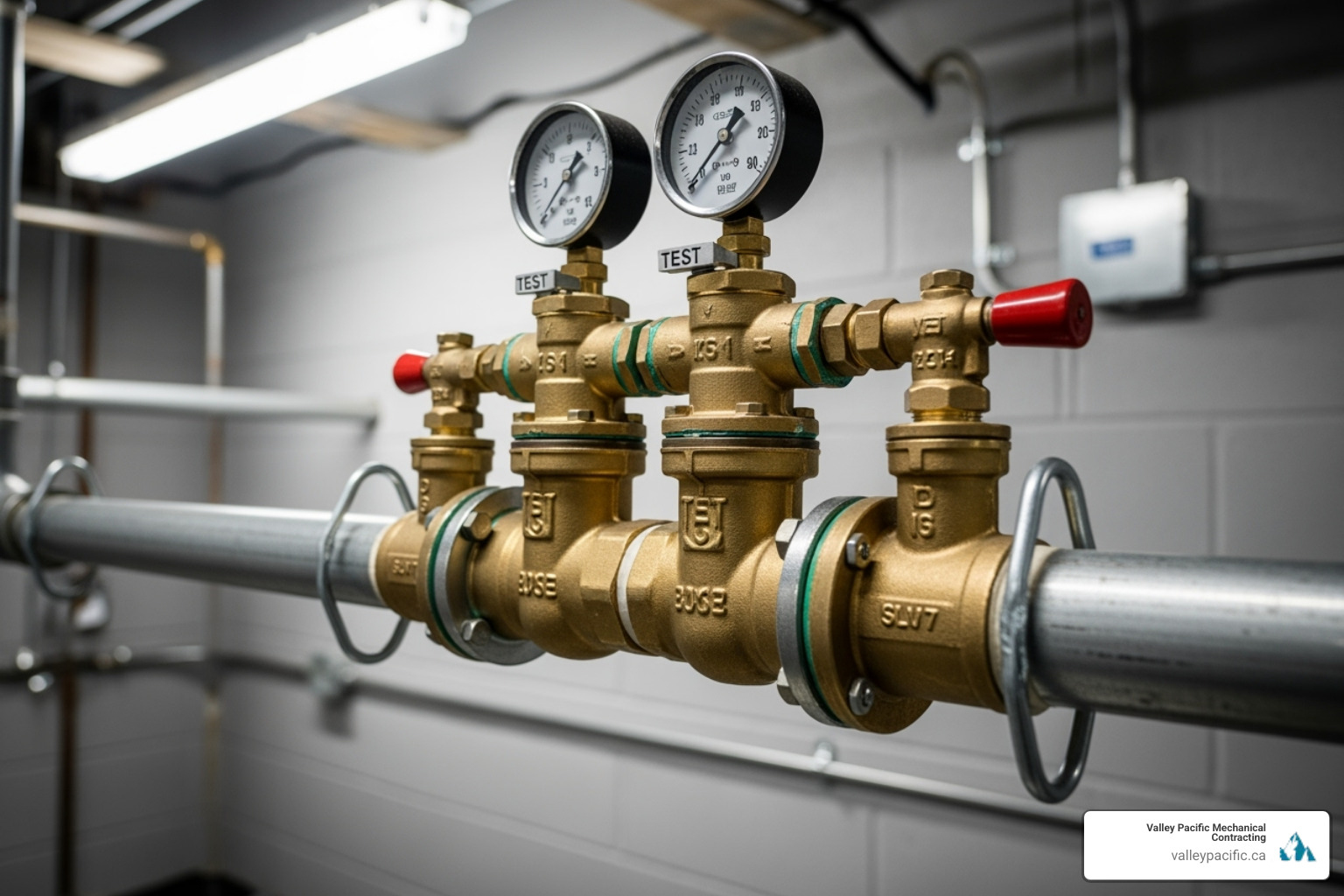
Backflow occurs when non-potable water reverses direction and enters your clean water lines. The contamination risks are significant, as this can introduce harmful bacteria, chemicals, and other pollutants into the water you drink and use daily.
Backflow is typically caused by one of two conditions:
- Backpressure: Occurs when the pressure in a non-potable system (like a boiler or irrigation system) becomes greater than the pressure in your drinking water supply, forcing contaminated water backward.
- Backsiphonage: A drop in water pressure in the main supply line—often due to a water main break or firefighting efforts—creates a vacuum that can suck contaminated water from a hose or other source into your plumbing.
Fortunately, backflow prevention devices are designed to stop this. These mechanical valves are installed on your plumbing system to ensure water flows in only one direction. Different types exist for various applications, from simple vacuum breakers on outdoor faucets to more complex assemblies for irrigation systems and commercial properties.
These devices are not "set and forget." They contain mechanical parts that can wear out or fail. Annual testing by a certified professional is essential to ensure they are functioning correctly and protecting your water supply. In many areas, this testing is required by local regulations.
Protecting your family's water supply is a top priority. Just as we ensure your HVAC systems provide reliable comfort, we help keep your water systems safe. For comprehensive home comfort solutions, explore our HVAC Services for Home Comfort.
Frequently Asked Questions about Sewer Inspections
Dealing with underground plumbing can feel overwhelming. Here are answers to some common questions about sewer line inspections.
How long does a video camera inspection take?
A typical residential inspection is quick, usually taking 30 to 60 minutes. The exact time depends on factors like the length and condition of the pipe, as well as the accessibility of a cleanout point. A clear, short line may take less time, while a longer line with significant blockages will require more careful examination.
What happens if a problem is found during the inspection?
Finding a problem early is a good thing! If an issue is finded, we provide a detailed diagnosis and a copy of the recorded video footage. This gives you visual proof of the problem.
We then walk you through all available repair options, explaining the pros and cons of each. Solutions can range from simple drain cleaning to more advanced repairs. For many issues, we offer modern trenchless methods like pipe lining or pipe bursting, which are less invasive than traditional digging. If excavation is necessary for a severe collapse, we'll explain the process clearly. Our goal is to give you the information you need to make a confident decision.
What to Expect During Your Sewer Line Inspection?
When you schedule an inspection with Valley Pacific, our process is transparent and stress-free:
- Arrival: Our professional technician will arrive on time with all necessary equipment.
- Access: We'll locate the best access point, usually a cleanout pipe. If one isn't available, we may need to temporarily remove a toilet, which we will reinstall afterward.
- Inspection: We run the high-resolution camera through your sewer line. We encourage you to watch the monitor with us to see the condition of your pipes in real-time.
- Assessment: After the inspection, we provide a complete assessment of our findings, show you any problem areas on the video, and discuss our professional recommendations.
We are committed to ensuring you understand the health of your plumbing system, delivering on our headache-free promise.
Your Partner in Proactive Plumbing Maintenance
Your home's sewer system is a silent workhorse, but when it fails, the results can be disastrous and costly. A sewer line inspection is a simple, powerful tool that gives you a clear view of this hidden infrastructure, allowing you to address issues proactively.
Regular inspections put you in control, helping you protect your property value, prevent messy backups, and avoid the stress and expense of a plumbing emergency. It's one of the smartest investments you can make in your home.
At Valley Pacific Mechanical Contracting, we have over three decades of experience helping homeowners in Mission, Maple Ridge, and Langley manage these challenges. We know plumbing problems don't keep business hours, which is why we offer 24/7 emergency service and stand by our "headache-free" experience promise.
Our team acts as your trusted advisor, explaining our findings clearly and guiding you toward the best solution for your home. We provide the information and expertise you need to make confident decisions about your property.
Don't wait for a warning sign to become a crisis. Take charge of your home's hidden plumbing today and enjoy the peace of mind that comes with knowing your system is in good hands.
Ready to take a proactive step? While you're focused on home maintenance, remember we're also your local climate control experts. You can Schedule your heat pump installation in Langley, BC with us for year-round comfort.
Why Every Homeowner is Talking About Tankless Water Heaters
A tankless water heater heats water on demand using a heat exchanger, eliminating the need for a storage tank and providing continuous hot water while reducing energy consumption through the elimination of standby heat losses.
Key advantages of tankless systems:
- On-demand heating - Hot water whenever you need it
- Space-saving design - Wall-mounted units free up floor space
- Energy efficiency - No standby heat loss like traditional tanks
- Longer lifespan - Typically 20+ years vs. 10-15 years for tank heaters
- Endless supply - Never run out during back-to-back showers
Main considerations:
- Higher upfront installation requirements
- Flow rate limitations during simultaneous use
- Potential home upgrades (gas lines, venting, electrical)
Frustrations like cold showers or a flooded basement from a failed tank heater are leading more homeowners to explore tankless options. While traditional heaters constantly reheat a large tank of water, tankless water heaters heat water instantly as it flows, using energy only on demand. This key difference impacts your utility bills, available space, and daily convenience. Choosing the right system means matching the technology to your household's needs, infrastructure, and long-term goals.
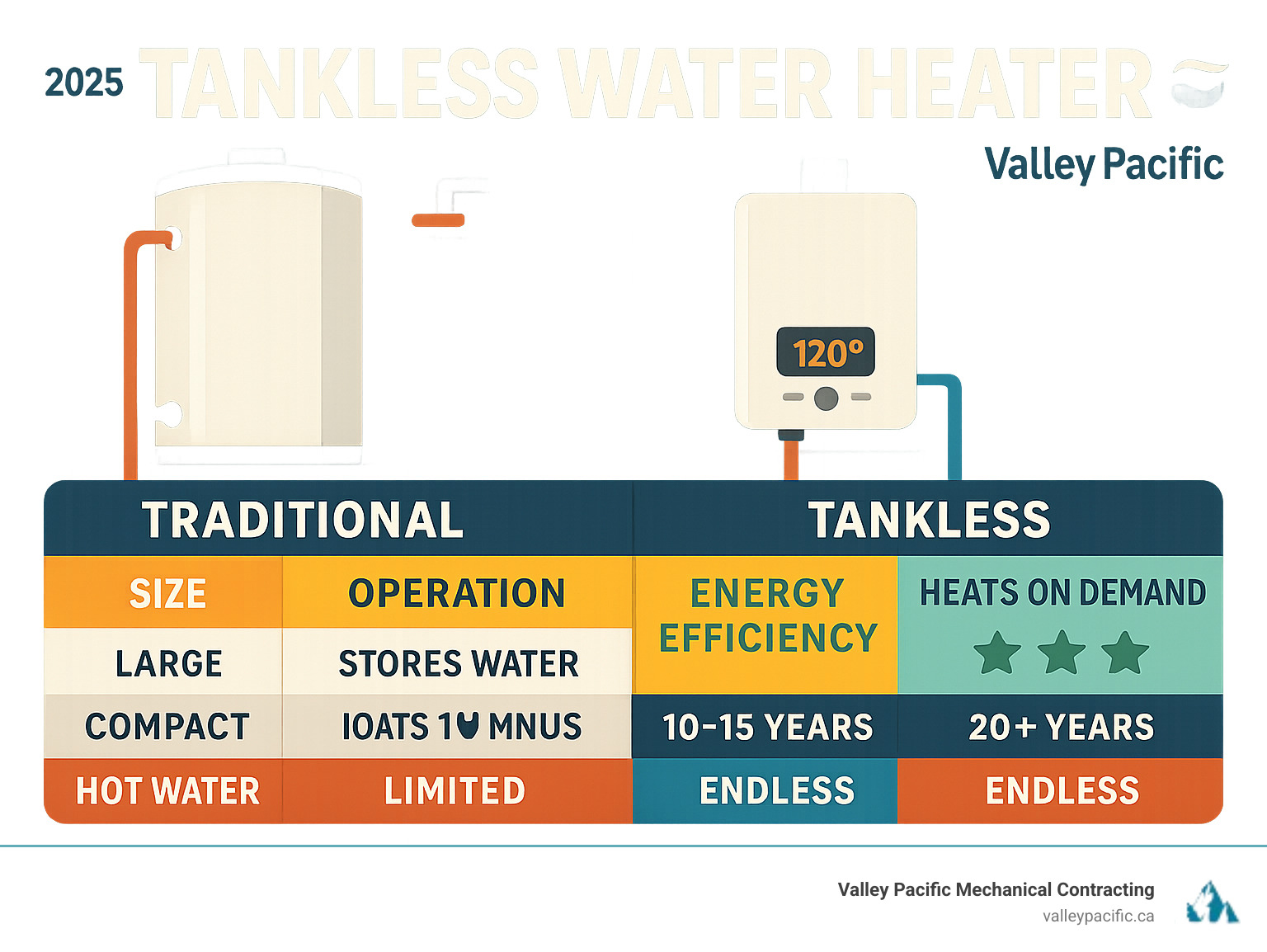
Tankless water heater terms at a glance:
Understanding Your Hot Water: Tank vs. Tankless Heaters

Your home's water is heated by one of three main systems: the traditional storage tank, the modern tankless water heater, or the eco-friendly heat pump water heater. A traditional storage tank keeps 40-80 gallons of water constantly hot, leading to standby heat loss from reheating unused water. A tankless water heater takes a different approach, heating water instantly on demand. Then there's the heat pump water heater, which cleverly moves heat from the surrounding air into the water, making it incredibly energy-efficient.
Here's how these three stack up against each other:
| Feature | Storage Tank | Tankless Water Heater | Heat Pump |
|---|---|---|---|
| Energy Use | High standby loss, heats continuously | No standby loss, heats on demand | Very efficient, uses ambient heat |
| Lifespan | 10-15 years | 20+ years | 10-15 years |
| Space | Bulky floor unit | Compact wall-mounted | Large, needs conditioned space |
| Hot Water Supply | Limited by tank size | Continuous flow (when sized right) | Limited by tank, slower recovery |
How a Tankless Water Heater Works
A tankless water heater works on an instant response system. When you turn on a hot tap, a flow sensor activates a powerful heat source—either a gas burner or an electric element. This heats a heat exchanger that warms the water as it passes through. The unit modulates its power to maintain a consistent temperature and shuts off instantly when the tap is closed. Gas models use a sealed venting process to safely exhaust fumes.
Key Differences from Traditional Tanks
The operational differences between tankless and tank heaters significantly impact your home. Energy consumption is the biggest differentiator. By eliminating standby loss, tankless water heaters are 8-34% more energy-efficient, depending on your household's water usage. In terms of lifespan, tankless units typically last over 20 years, far exceeding the 10-15 year lifespan of traditional tanks. The physical footprint is another major advantage; compact, wall-mounted tankless units free up valuable floor space. However, there's a trade-off in hot water capacity. A tankless heater provides an endless supply but is limited by its flow rate (GPM). Simultaneous use of multiple hot water fixtures can strain the system if it's not sized correctly.
Choosing Your Ideal Tankless Water Heater: A Sizing and Selection Guide
Choosing the right tankless water heater is about matching the unit to your home's specific needs. Sizing isn't about tank volume; it's about calculating your peak hot water demand. Factors include how many fixtures run simultaneously and even your local climate, as colder groundwater requires more heating power.

In the Lower Mainland, we're fortunate to have relatively moderate groundwater temperatures, but winter can still bring some chilly surprises that affect your tankless water heater's performance.
How to Size Your New Tankless Water Heater
Sizing a tankless water heater involves two key calculations: flow rate and temperature rise.
1. Calculate Peak Flow Rate (GPM): Add up the GPM of all fixtures you might use at the same time during your busiest period.
- Showerheads: 1.5 to 2.5 GPM
- Kitchen faucets: 1.5 to 2.2 GPM
- Bathroom faucets: 0.5 to 1.5 GPM
- Dishwashers: 1.0 to 2.5 GPM
- Washing machines: 1.5 to 3.0 GPM
- Bathtub fillers: 4.0 GPM or higher
For example, a peak scenario of a shower (2.0 GPM) and a dishwasher (1.5 GPM) would require a unit that can handle at least 3.5 GPM.
2. Determine Temperature Rise: This is the difference between the incoming cold water temperature and your desired hot water output (typically 120°F). In winter, with 50°F groundwater, you'd need a 70°F temperature rise.
You then match your required GPM and temperature rise to a unit's specifications. Higher BTU ratings provide more heating power for higher demand and colder climates. Also, note that some units require a minimum flow to activate, which may be an issue with ultra-low-flow fixtures.
Gas vs. Electric: Which Fuel Source is Right for You?
The choice between gas and electric often depends on your home's existing utilities.
Natural gas units are the workhorses for tankless systems, offering higher flow rates ideal for larger families and cold climates. They are highly efficient but often require upgrading your gas line to meet their high BTU demand (up to 199,000 BTU). Propane offers similar performance for homes without natural gas service.
Electric tankless water heaters are a great solution where gas is unavailable or venting is difficult. Installation is simpler, but they typically have lower flow rates than gas units and require significant electrical power, often needing dedicated 240V circuits and a panel upgrade. For high-demand homes, multiple electric units may be necessary.
Condensing vs. Non-Condensing Technology
When looking at gas-fired tankless water heaters, you'll choose between condensing and non-condensing models.
Non-condensing units are simpler and less expensive upfront but are less efficient (around 0.82 UEF). They vent extremely hot exhaust, requiring costly stainless steel venting.
Condensing units are the efficiency champions (0.95+ UEF) and our usual recommendation. They use a secondary heat exchanger to capture more heat from the exhaust. This cools the gases enough to allow for inexpensive PVC venting, which helps offset the higher unit cost. While they require a condensate drain, the long-term energy savings and cheaper venting make them the superior investment for most homeowners.
Installation and Performance: What to Expect from Your System
Proper installation is critical for a tankless water heater and is not a DIY project. A licensed professional is essential for handling the complex plumbing, gas, venting, and electrical work.
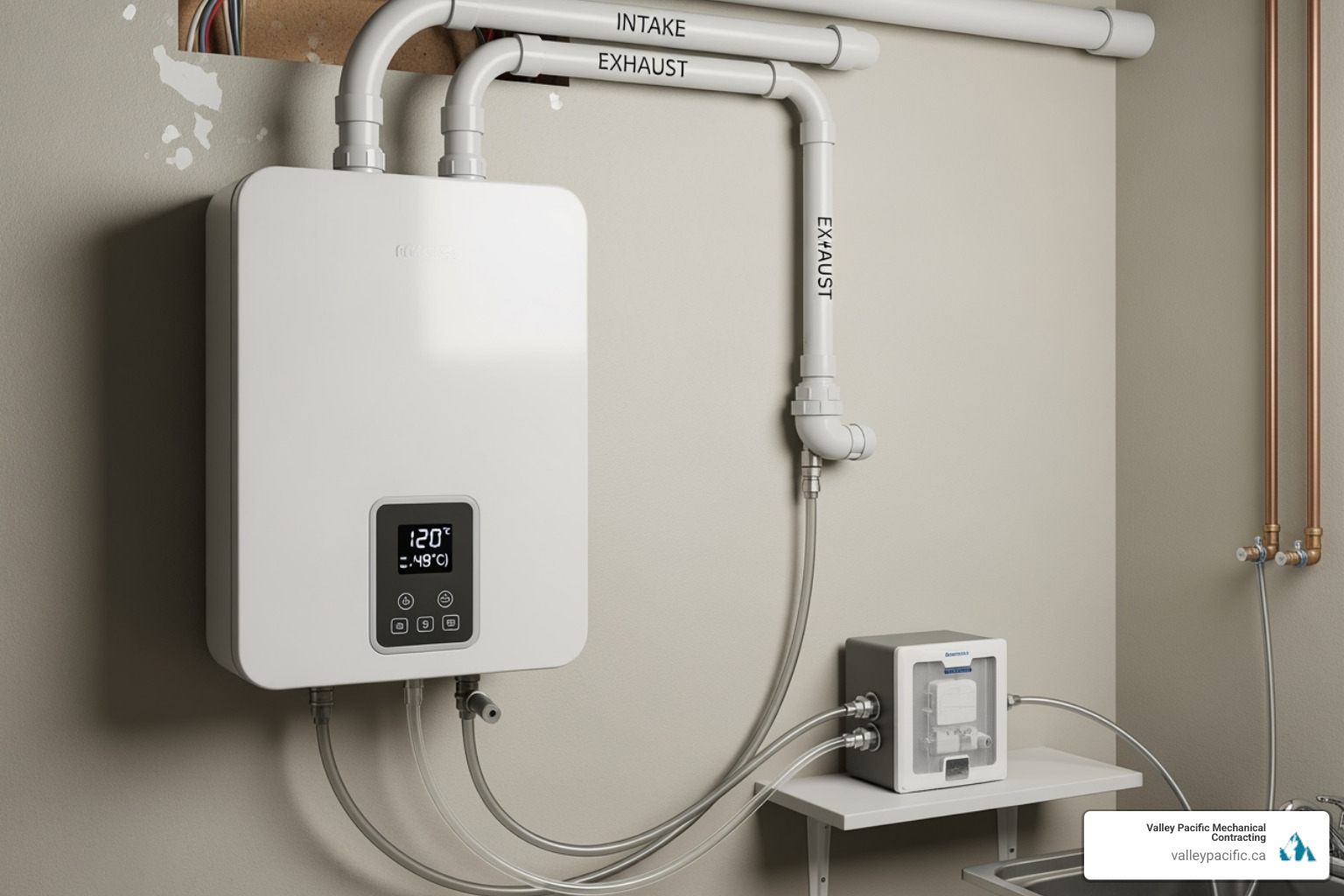
Your home may need several upgrades:
- Gas Line Upsizing: Tankless units have high BTU demands that often require a larger gas line.
- Electrical Circuits: Even gas models need electricity for their controls, and electric models require dedicated high-amperage circuits.
- Venting: Requirements depend on the model. Condensing units can use PVC piping, while non-condensing units need expensive metal venting.
- Condensate Drain: Condensing models produce acidic condensate that requires a proper drain.
- Combustion Air: Gas units need adequate fresh air for safe operation.
For homeowners dealing with more complex mechanical systems, our team brings over 30 years of expertise to ensure everything works seamlessly together. More info about our boiler installation services.
Hot Water Recirculation Explained
A recirculation system solves the common complaint of waiting for hot water in larger homes. It keeps hot water in the pipes, providing it almost instantly. Options include dedicated return lines for maximum efficiency or crossover valves that use existing cold water lines as a budget-friendly alternative. Demand-based controls (timers, buttons, smart controls) activate the system only when needed, saving energy. The comfort and water conservation benefits are significant, especially when pipes are well-insulated.
Common Performance Considerations
Understand these common traits of tankless systems:
- "Cold water sandwich": A brief burst of cold water may occur when you quickly turn a tap off and on again.
- Minimum flow rate: The unit needs a certain flow (e.g., 0.5 GPM) to activate, which can be an issue for some low-flow fixtures.
- Simultaneous use: Exceeding the unit's GPM capacity by running too many fixtures at once can cause water temperature to drop. Proper sizing prevents this.
- Noise levels: Gas units produce some fan and burner noise. Placement is key to minimizing sound.
- Power outages: Even gas units need electricity to operate. A battery backup or generator is required for hot water during an outage.
Long-Term Value: Maintenance, Lifespan, and Efficiency
A tankless water heater is a long-term investment, with an expected lifespan of over 20 years—often double that of a traditional 10-15 year tank heater. This durability is backed by long manufacturer warranties, typically 10-15 years on the heat exchanger.
However, longevity depends on maintenance and water quality. Hard water can cause mineral scale to build up in the heat exchanger, reducing efficiency and causing damage. For homes with hard water, a water softener is an essential part of protecting your investment. The U.S. Department of Energy confirms that you can save on energy costs with a tankless water heater, with significant annual savings possible depending on usage.
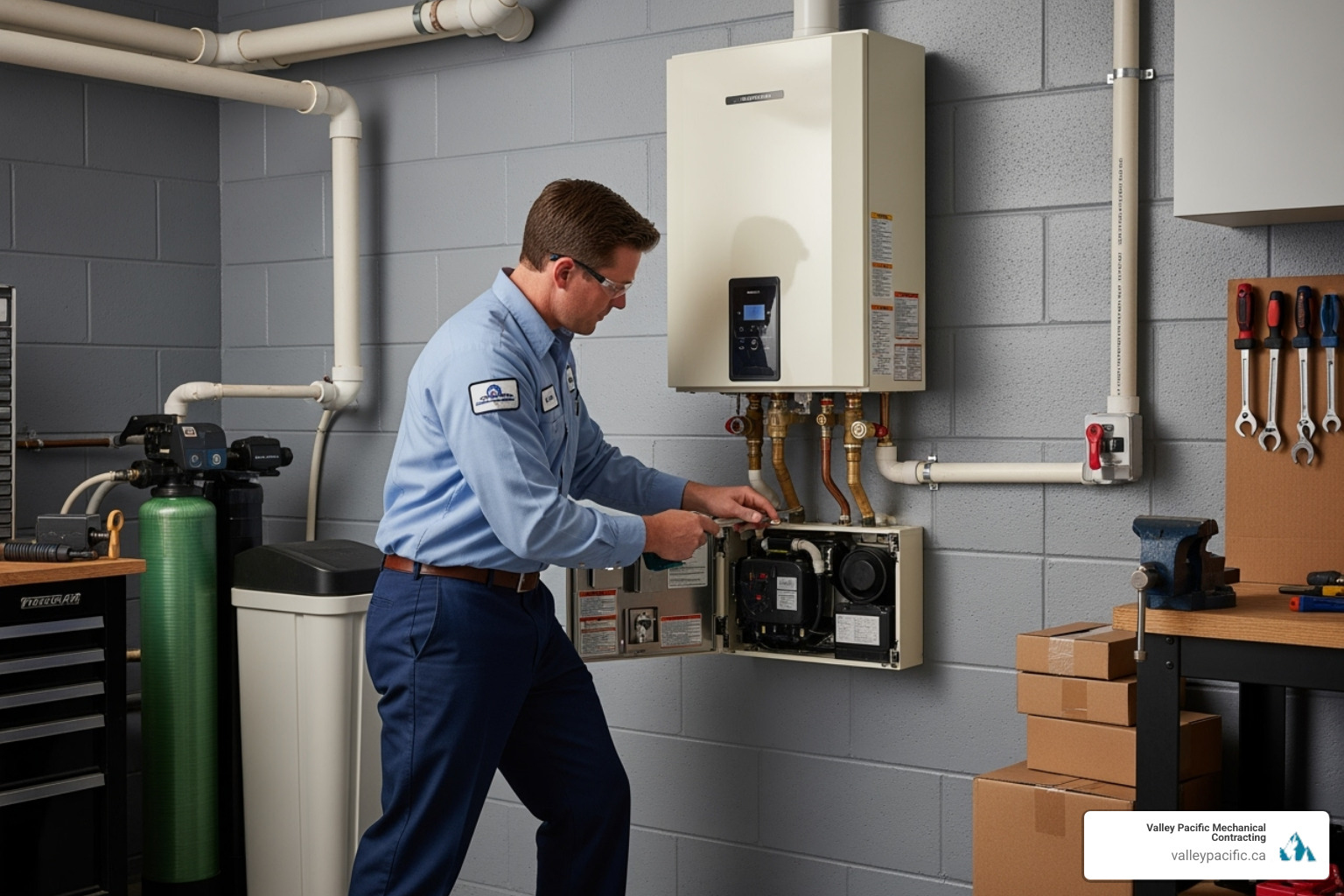
Essential Maintenance for Your Tankless System
To ensure a long life for your tankless water heater, regular maintenance is key.
- Annual Descaling: This is the most critical task. Flushing the heat exchanger with a descaling solution removes mineral buildup (scale), which is vital in areas with hard water. While DIY kits are available, professional service is recommended.
- Clean Intake Filters: Periodically check and clean the sediment filter on the cold water inlet to ensure proper flow and protect the unit.
- Inspect Vents and Connections: Regularly check that all water, gas, and vent connections are secure and that the vent path is clear of obstructions.
Understanding Efficiency and Savings
Modern efficiency is measured by the Uniform Energy Factor (UEF)—a higher rating means greater savings. Tankless water heaters save money by eliminating standby heat loss and only using energy when you need hot water. You can increase savings further by insulating your hot water pipes, which reduces heat loss as water travels to your faucet. Realistic savings depend on your water usage, energy costs, and the efficiency of your old system.
Frequently Asked Questions About Water Heaters
Over our 30+ years serving the Lower Mainland, we've heard just about every water heater question imaginable. These are the questions that come up time and again.
Are rebates or tax credits available for upgrading my water heater?
Yes, significant rebates and tax credits are often available for high-efficiency water heaters. Start by looking for ENERGY STAR certified models. Check for current incentives from your local utility provider, like FortisBC, and provincial programs such as CleanBC. These programs can often be combined for greater savings. Crucially, always confirm that your chosen model is eligible for the rebate before you purchase it.
Will a tankless water heater work with a well system?
Yes, but your well must provide consistent water pressure and a sufficient flow rate (typically over 0.4 GPM) for the unit to operate correctly. Because well water can contain sediment, installing a sediment filter before the heater is essential to prevent clogs. We also recommend testing for water hardness, as a water softener may be needed to prevent scale buildup. A professional assessment of your well system is the best way to ensure compatibility.
What are the environmental benefits of different water heaters?
Your water heater choice has a real environmental impact.
- Traditional Tank Heaters: These are the least efficient due to constant standby heat loss, which wastes energy.
- Tankless Water Heaters: By heating water only on demand, they significantly reduce energy consumption. Their longer lifespan (20+ years) also means less landfill waste.
- Heat Pump Water Heaters: These are the most environmentally friendly, especially when powered by clean electricity like BC's hydro power. They move heat from the air to the water, making them exceptionally efficient.
A high-efficiency tankless water heater is a major environmental upgrade over a traditional tank, and a heat pump model can be even greener.
Your Partner for Endless Hot Water in the Lower Mainland
Switching to a tankless water heater offers long-term comfort and efficiency, including endless hot water, energy savings, and more space. However, these benefits depend entirely on proper sizing and expert installation. An incorrectly sized unit can lead to lukewarm showers, while improper installation can cause serious safety and performance issues.
That's where Valley Pacific Mechanical Contracting makes the difference. For over 30 years, we've provided homeowners throughout Mission, Maple Ridge, Langley, Pitt Meadows, and Coquitlam with expert guidance. We don't just sell you a unit; we assess your home's infrastructure and your family's water usage to recommend the perfect system.
Our certified technicians handle every detail, from gas line upgrades to flawless venting, ensuring your tankless water heater performs perfectly. With our 24/7 emergency service and "headache-free" approach, you get the peace of mind that comes from three decades of expertise.
Ready to explore how a tankless water heater could transform your home's hot water experience? For expert advice on the best heating solution for your home, explore our heat pump services and find how we're helping Lower Mainland families create more comfortable, efficient homes every day.
Understanding What Makes Boiler Heating Systems Different
A boiler heating system heats water and circulates it through pipes to radiators, baseboards, or radiant floor systems. Unlike furnaces that blow hot air, boilers provide comfortable radiant heat by warming objects directly, resulting in a more even and pleasant warmth.
Key Features of Boiler Heating Systems:
- Heat Medium: Uses hot water or steam.
- Distribution: Circulates through pipes to radiators or radiant flooring.
- Efficiency: Modern units achieve 90-98.5% AFUE ratings.
- Comfort: Provides even, quiet heat without drafts.
- Air Quality: Less dust and allergens are spread due to no ductwork.
- Fuel Options: Natural gas, oil, propane, or electricity.
Boilers are generally more energy-efficient than furnaces because water holds heat better than air. This efficiency, combined with superior comfort and air quality, makes boilers an attractive option for reliable, long-term heating.
While the average boiler lifespan is around 15 years, a well-maintained cast iron boiler can last 20 years or more. This guide will walk you through everything you need to know about these dependable heating systems.

Understanding Your Boiler Heating System: Components and Operation
Boilers and furnaces are the two main home heating options, but they work very differently. Furnaces heat air and push it through ducts (forced-air), which can circulate dust and dry out the air. A boiler heating system heats water and sends it through pipes to radiators or floors.
This creates radiant heat, which warms objects directly for a more even, comfortable warmth, similar to the heat from a sunny window. This method results in less airborne dust and better indoor humidity levels.
| Feature | Boiler Heating System | Furnace Heating System |
|---|---|---|
| Heat Medium | Hot water or steam | Air |
| Distribution | Pipes to radiators, baseboards, radiant floors | Ducts to vents |
| Heat Type | Radiant heat (warms objects) | Convective heat (warms air) |
| Air Quality | Less dust/allergens circulated | Can circulate dust/allergens |
| Humidity | Generally maintains better humidity | Can dry out air (may need humidifier) |
| Noise Level | Often quieter | Can be noisy (fan, ducts) |
| AC Integration | Requires separate AC system (ductless or new ducts) | Central AC often integrates with existing ducts |
How a Boiler Heats Your Home
A boiler heating system operates in a continuous closed loop. When your thermostat calls for heat, the boiler fires up, heating water to a set temperature (typically 145-190°F). A circulator pump then pushes this hot water through pipes to radiators, baseboard heaters, or radiant floor tubing. As the water releases its heat into your rooms, it cools and flows back to the boiler to be reheated. The thermostat and an aquastat (which measures water temperature) work together to maintain your desired comfort level.
Key Components of a Modern Boiler Heating System
Several key parts work together to keep your home warm and safe:
- Heat Exchanger: The core of the boiler where heat from the burners is transferred to the water.
- Burners: Create the flame that heats the water, using natural gas, oil, or propane.
- Circulator Pump: Pushes hot water through the pipes to your heat emitters and back to the boiler.
- Expansion Tank: Safely absorbs the extra volume of water as it heats up and expands, maintaining stable pressure.
- Pressure Relief Valve: A safety device that automatically releases pressure if it gets too high.
- Venting System: Safely removes combustion gases from your home. High-efficiency boilers use PVC pipes, while older models use metal flues.
- Controls: The thermostat, aquastats, and safety switches that manage the entire system. For more details, you can find more info about boiler components on our main boiler page.
Heat Distribution Methods
Boilers can deliver warmth through several types of heat emitters:

- Radiators: Classic cast-iron units that provide gentle, radiant warmth, common in older homes.
- Baseboard Heaters: Discreet units that run along walls, containing finned pipes that transfer heat to the room.
- Radiant Floor Heating: Tubing installed under the floor turns the entire surface into a gentle, even heat source. This is considered the peak of heating comfort. You can learn more about radiant heating from the Radiant Panel Association.
- Fan-Coil Units: These units use a fan to blow air over a hot water coil, providing faster heat delivery. They are less common in homes.
Types of Boilers and Fuel Sources
Choosing the right boiler heating system involves deciding on the boiler type and fuel source. These choices impact efficiency, operating costs, and your home's environmental footprint. Common fuels include natural gas, oil, propane, and electricity.
Conventional, System, and Combi Boilers
Boiler types are mainly defined by how they handle domestic hot water.

- Conventional (Regular) Boilers: Found in older homes, these use a cold water storage tank and a separate hot water cylinder. They are great for large homes with multiple bathrooms, as they can supply hot water to several taps at once.
- System Boilers: These connect directly to the water mains (no cold water tank) but still use a hot water cylinder to store heated water. They provide strong water pressure and are suitable for homes with high hot water demand.
- Combination (Combi) Boilers: The most popular modern choice, these compact units provide both heating and instant hot water, eliminating the need for storage tanks. They are ideal for smaller homes with one or two bathrooms. You can Learn about tankless water heating technology to understand this on-demand approach.
Condensing vs. Non-Condensing Technology
Modern boilers are far more efficient at using heat from combustion.
- Non-condensing boilers are older designs with efficiency ratings around 80-84% AFUE. They lose a significant amount of heat through hot exhaust gases vented outside.
- Condensing boilers are high-efficiency units (90%+ AFUE) that use a secondary heat exchanger to capture extra heat from exhaust gases. This process cools the exhaust enough for water vapor to condense, releasing latent heat that would otherwise be wasted. Their cooler exhaust allows for venting with PVC pipes.
Upgrading to a condensing boiler is a great way to lower energy bills and reduce your carbon footprint.
Impact of Different Fuel Sources
The fuel you choose affects your monthly bills and convenience.
- Natural Gas: Typically the most economical and convenient option if available. It burns cleanly and requires no on-site storage.
- Heating Oil: A reliable alternative for homes without gas access. It requires an external storage tank and regular deliveries.
- Propane: Similar to oil, it's a clean-burning fuel for homes off the gas grid, stored in a tank on your property.
- Electricity: Electric boilers are highly efficient (95-100%) but electricity is often more expensive per unit of heat, making them less economical for primary heating in many areas.
Boiler Efficiency, Maintenance, and Safety
A well-maintained boiler heating system is efficient, long-lasting, and safe. Understanding efficiency ratings, maintenance needs, and safety protocols is key for any homeowner.
Understanding Boiler Efficiency (AFUE)
Annual Fuel Utilization Efficiency (AFUE) measures how much fuel a boiler converts into usable heat. A higher AFUE percentage means less wasted energy and lower bills.
- Low-Efficiency Systems: AFUE of 56% to 70% (often found in older boilers).
- Mid-Efficiency Systems: AFUE of 80% to 83%.
- High-Efficiency Systems: AFUE of 90% to 98.5%. These condensing boilers offer significant energy savings and a reduced environmental impact. Upgrading from 56% to 90% AFUE can save 1.5 tons of CO2 emissions annually for a gas system.
While you can't easily retrofit an old boiler for higher efficiency, replacing it with a modern unit is a smart investment. We can guide you through the Professional boiler replacement process.
Essential Boiler Maintenance
Regular care is vital for your boiler heating system to operate safely and efficiently.
- Annual Professional Service: A qualified technician should inspect, clean, and tune your boiler yearly. This includes checking vents, the heat exchanger, controls, and combustion efficiency.
- Pressure Checks: Ensure the boiler's pressure gauge is in the recommended range. If pressure drops, you may need to add water. See our guide on What to do when boiler pressure drops.
- Bleeding Radiators: Release trapped air from radiators to eliminate cold spots and improve heat distribution.
- Safety Checks: Annual service includes testing safety components like the pressure-relief valve to ensure they function correctly.
Common Boiler Problems and Safety Concerns
Even well-maintained boilers can have issues. Knowing common problems and safety risks is important.
Common Boiler Issues:
- Pump or Electrical Failure: A failed circulator pump or control board can stop the system from heating.
- Air in the System: Can cause banging or gurgling noises ("kettling") and cold spots.
- Low Water Pressure: May cause the boiler to shut down as a safety precaution.
- Leaks: Can cause water damage and indicate a problem with a seal or component.
- Mineral Buildup: Limescale on the heat exchanger reduces efficiency and can cause noise. For issues like no hot water, see our Troubleshooting no hot water from your boiler guide.
Safety Considerations:The most critical risk with fuel-burning boilers is carbon monoxide (CO) poisoning. CO is a colorless, odorless gas from incomplete combustion.
- Install CO Alarms: Have working carbon monoxide alarms on every level of your home, especially near bedrooms.
- Ensure Proper Venting: Keep the boiler's flue clear of obstructions to prevent exhaust from backing up into your home.
- Use Professionals: Always hire qualified technicians for installation, repairs, and maintenance to ensure all safety measures are correctly handled.
Upgrading or Replacing Your Boiler System
Even the most reliable boiler heating system won't last forever. Knowing when to repair versus replace can save you from future headaches and high energy bills. While a well-maintained boiler can last 15-20 years, there are clear signs it's time for an upgrade.
When to Consider a Boiler Replacement
Look for these telltale signs that your boiler is nearing the end of its life:
- Age: If your boiler is over 15 years old, it's likely far less efficient (56-70% AFUE) than modern units.
- Frequent Repairs: If you're calling for service every year, the repair costs can quickly add up. A major component failure, like a heat exchanger, often makes replacement more economical. If you're in Coquitlam, we provide expert Boiler Repair Coquitlam services.
- Rising Energy Bills: An unexplained increase in your heating costs often signals declining efficiency.
- Poor Performance: If your boiler struggles to heat your home evenly or keep up during cold snaps, it may be losing capacity or be improperly sized.
Factors for Choosing a New Boiler
Selecting a new boiler heating system requires careful consideration to ensure years of comfort and efficiency.
- Proper Sizing: A professional heat loss calculation is essential. An oversized boiler wastes energy by short-cycling, while an undersized one will struggle to keep you warm.
- Fuel Type: Natural gas is often the most economical choice where available. Oil and propane are great alternatives for homes off the gas grid.
- AFUE Rating: A high-efficiency condensing boiler (90%+ AFUE) will significantly lower your monthly bills and environmental impact.
- Sealed Combustion: Modern high-efficiency boilers draw combustion air from outside and vent directly outdoors, making them safer and more efficient.
- Home Size and Hot Water Needs: These factors determine whether a compact combi boiler is sufficient or if a system boiler with a storage tank is better for your family's needs. Our guide on Preparing your home for a new boiler can help you understand the process.
Pros and Cons of a Boiler Heating System
Boilers offer unique advantages but also have considerations compared to other systems.
Pros:
- Superior Comfort: Radiant heat provides even, consistent warmth without drafts or dry air.
- Quiet Operation: With no blowers or air rushing through ducts, boiler systems are nearly silent.
- Energy Efficiency: Modern condensing boilers are highly efficient (90-98.5% AFUE), and no heat is lost through ductwork.
- Better Indoor Air Quality: Boilers don't circulate dust, pollen, or other allergens.
- Durability: Well-maintained boilers often outlast furnaces, with some models lasting 20+ years.
Cons:
- Higher Installation Cost: Upfront costs can be higher, especially if new piping is required.
- No AC Integration: Air conditioning requires a separate system, such as ductless mini-splits or a dedicated ducted system.
- Slower Response Time: Radiant heat takes longer to warm up a cold room compared to forced air.
- Potential for Water Damage: As with any plumbing system, leaks are a risk, though rare with proper maintenance.
Frequently Asked Questions about Boiler Systems
Here are answers to the most common questions we hear about boiler heating systems.
How often does my boiler need to be serviced?
Annual maintenance is crucial. Just like a car, your boiler needs a yearly check-up to ensure it runs safely, efficiently, and reliably. A qualified technician should perform this service before the heating season begins to clean components, test safety controls, and prevent unexpected breakdowns. If you're in the Maple Ridge area, you can Schedule your boiler repair in Maple Ridge BC with our team.
What do strange noises from my boiler mean?
Banging, whistling, or gurgling noises (known as "kettling") are a sign of a problem. The most common causes are trapped air in the system, low water pressure, or limescale buildup on the heat exchanger. While bleeding radiators might help, persistent noises require a professional to diagnose and fix the underlying issue before it worsens.
Can I add air conditioning to my boiler-heated home?
Yes, but it requires a separate system. Boilers use hot water in pipes, while central AC uses cool air in ducts. The two systems are not compatible. To add cooling, your best options are installing a separate ductwork system for central air or using highly efficient and popular ductless mini-split air conditioners. Many homeowners enjoy the combination of radiant boiler heat in winter and targeted mini-split cooling in summer.
Conclusion
We hope this guide has clarified the benefits of a boiler heating system. From the superior comfort of radiant heat to the outstanding efficiency of modern condensing units, boilers offer a reliable and quiet solution for home heating. They provide better indoor air quality by not circulating dust and can last for 20 years or more with proper care.
While installation can be more involved and AC requires a separate system, many homeowners find the long-term benefits of quiet, consistent warmth are well worth it. For homeowners in Langley, Maple Ridge, and Mission, a well-maintained boiler is the key to a comfortable and efficient home.
Valley Pacific Mechanical Contracting brings over 30 years of expertise to every job. We are committed to providing a 'headache-free' experience with 24/7 emergency service.
Contact us for your boiler installation in Langley, BC and let our experienced team help you enjoy the best comfort and reliability of a modern boiler heating system.
Your Guide to a Warm and Safe Home in Mission
Furnace repair Mission BC is critical when your heating system fails. A malfunctioning furnace is not just uncomfortable; it can be dangerous, posing risks from freezing temperatures and carbon monoxide exposure.
Quick Answer for Furnace Repair in Mission BC:
- Emergency Service: 24/7 availability for urgent repairs
- Licensed Professionals: Certified gas fitters and insured technicians
- Common Signs: No heat, strange noises, odd smells, high energy bills
- Safety Priority: Carbon monoxide and gas leak testing included
- All Brands: Service for gas and electric furnaces of all makes and models
When temperatures drop in Mission, BC, a reliable furnace is essential for your family's safety and comfort.
Most furnace problems can be repaired quickly by qualified professionals. Annual furnace maintenance is the key to an efficient and safe furnace, preventing breakdowns and increasing reliability.
The Safety Authority of BC recommends annual service to improve longevity, efficiency, reliability, and safety.
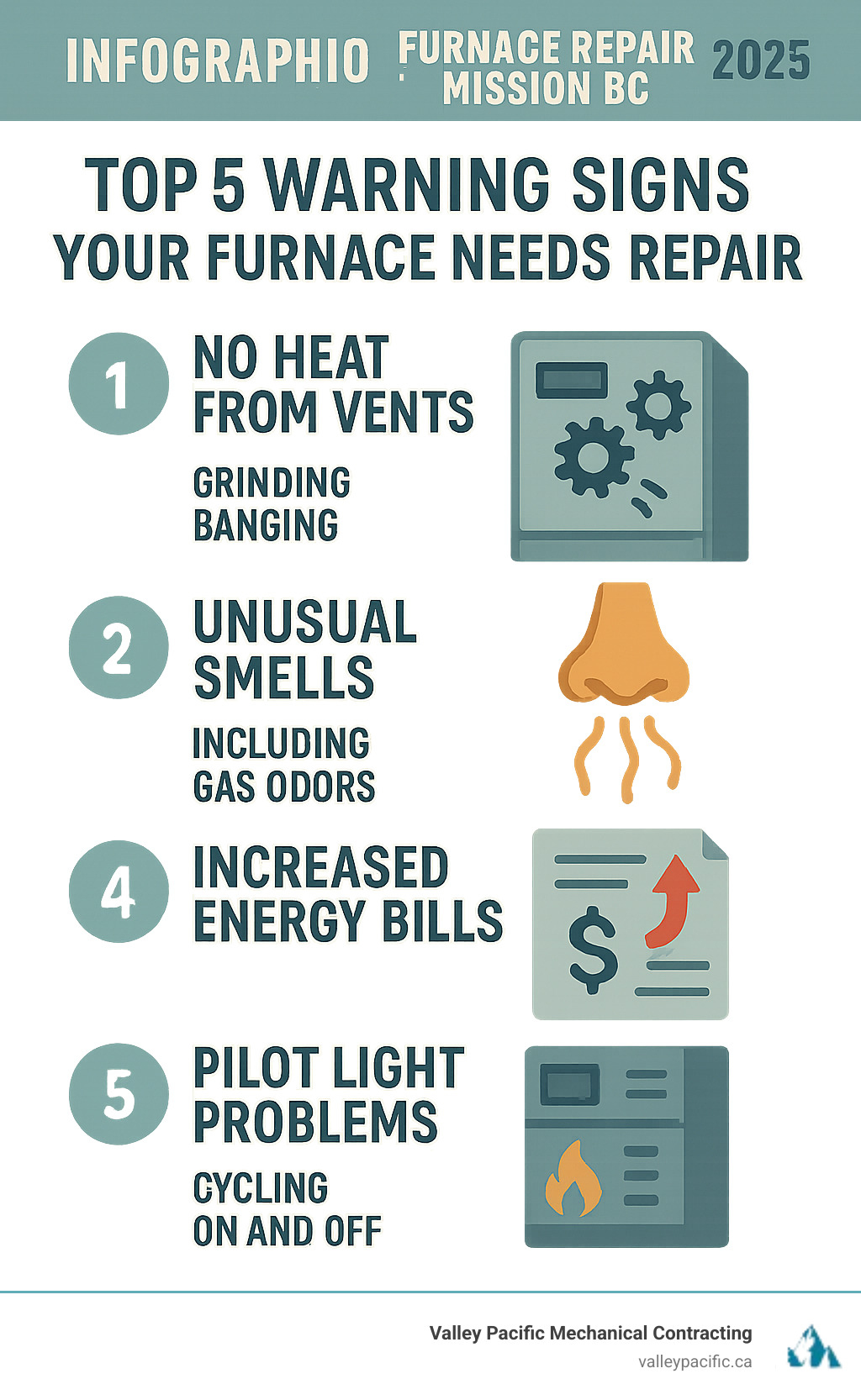
Furnace repair Mission BC terms to know:
Is Your Furnace Trying to Tell You Something? Key Warning Signs
Your furnace has its own way of asking for help, and learning its language can save you from bigger headaches and repair bills. When your heating system acts up, it's signaling a need for furnace repair Mission BC.
Inconsistent heating, where some rooms are hot and others are cold, indicates airflow or distribution issues that need attention.
Unusual noises require immediate attention. Banging can point to ignition issues, squealing often means a worn fan belt, and grinding suggests blower motor problems.
Strange smells should never be ignored. A rotten-egg odor signals a gas leak; evacuate immediately and call for emergency service. Metallic or burning smells often indicate electrical problems.
Rising energy bills often mean your furnace is losing efficiency due to dirty filters or failing components, causing it to burn more fuel.
Thermostat troubles can cause frequent cycling or constant running. The thermostat may be the culprit, or it could be signaling a deeper furnace issue.
For older gas furnaces, pilot light problems are a serious concern. A pilot light that won't stay lit or burns yellow instead of blue can indicate dangerous carbon monoxide production.
Little to no airflow or a constantly running blower fan are clear signals your furnace needs professional attention for furnace repair Mission BC.
Catching these warning signs early can turn a major breakdown into a simple fix. For comprehensive information about our heating, cooling, and air quality solutions, visit our HVAC services page.
Common Issues Requiring Furnace Repair Mission BC
Our technicians often find a handful of common, fixable culprits behind furnace troubles, many of which are preventable with regular maintenance.
Faulty thermostats are a common and simple fix. What seems like a major furnace problem can be a miscalibrated or broken thermostat, which we always check first.
Dirty filters force your furnace to work harder by restricting airflow. This leads to overheating, poor performance, and higher energy bills.
Cracked heat exchangers are one of the most serious issues in furnace repair Mission BC. This component transfers heat, and a crack can leak dangerous carbon monoxide into your home. Our annual maintenance includes a thorough inspection.
Blower motor failure results in little to no airflow. You might hear strange noises before it fails or notice poor air circulation.
Ignition system problems prevent your furnace from producing heat. When components like the ignitor or flame sensor fail, your furnace can't light. Our technicians carry common parts for quick repairs.
Clogged vents and ducts restrict airflow and cause uneven heating. This can be due to closed registers or blockages within the ductwork that need professional attention.
Experienced technicians can quickly identify which of these common issues is affecting your system and restore comfort to your home.
Comprehensive Furnace Services in Mission, BC
When you need furnace repair Mission BC, you want the problem fixed right the first time. At Valley Pacific Mechanical, we get to the heart of the issue quickly.
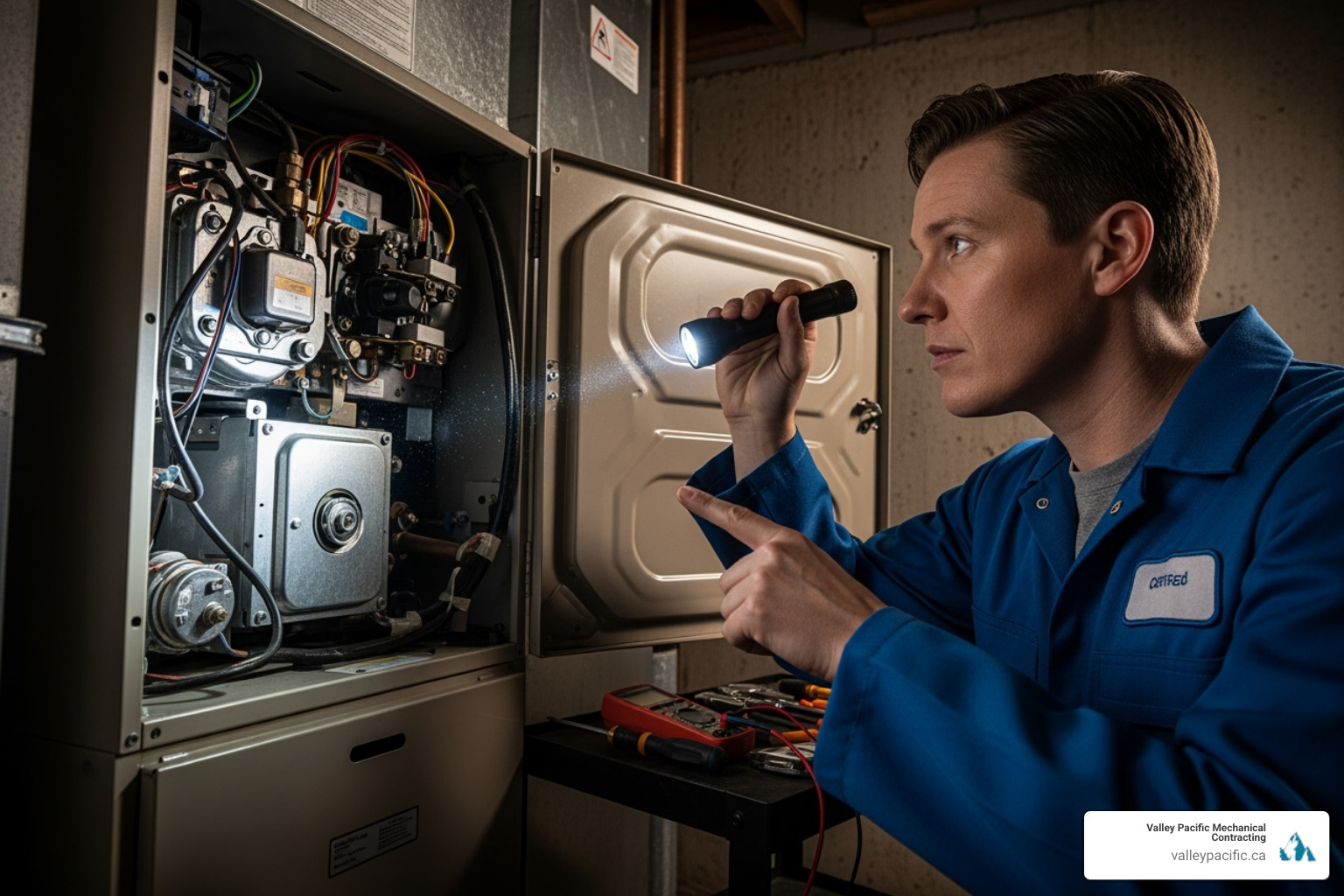
Our approach goes beyond a quick patch. We start with thorough diagnostics to understand the full scope of the problem before starting treatment.
Every service call includes a complete component check to identify wear and tear and prevent future breakdowns. This isn't just about fixing today's issue; it's about preventing tomorrow's emergency.
Safety inspection is our top priority on every call. We also perform efficiency testing to ensure your furnace runs optimally, keeping energy bills down.
The Safety Authority of BC recommends annual service, and we agree. Regular maintenance is your best defense against unexpected breakdowns and dangerous situations like carbon monoxide leaks.
What a Professional Furnace Inspection Includes
Our certified technicians use a systematic approach to cover every aspect of your heating system, ensuring we find the root cause of the problem.
Heat exchanger inspection is critical, as a crack can leak deadly carbon monoxide. We use specialized equipment to find even hairline fractures.
Burner cleaning is essential. Dirty or misaligned burners cause inefficient operation and uneven heating. We clean and adjust them for optimal performance.
Our blower motor check includes testing amperage, listening for strange sounds, and lubrication. Catching issues early can prevent a complete failure and a more expensive repair.
Electrical connections can loosen over time, creating a fire hazard. We inspect and tighten all wiring to ensure safety and performance.
Thermostat calibration ensures your system responds accurately. A miscalibrated thermostat can cause short cycling and high energy bills. We test and adjust it for perfect operation.
Air filter replacement happens during every service call because a dirty filter restricts airflow, reduces air quality, and can cause the system to overheat.
Safety control testing verifies that built-in safety switches will function correctly to shut down the system in dangerous conditions.
Our gas pressure check confirms your furnace receives the correct fuel amount for safe, efficient operation. Incorrect pressure can cause poor heating or dangerous conditions.
This comprehensive approach provides peace of mind, knowing your furnace is safe, efficient, and reliable.
The Big Decision: Repair or Replace Your Furnace?
Every homeowner eventually faces the decision: repair or replace their aging furnace. The choice between furnace repair Mission BC and replacement isn't always simple, but key factors can guide you.
| Factor | Furnace Repair | Furnace Replacement |
|---|---|---|
| Age of Unit | Ideal for furnaces less than 10-15 years old. | Recommended for furnaces 15-20+ years old. |
| Frequency of Repairs | Occasional, minor repairs are manageable. | Frequent, costly repairs indicate replacement is due. |
| Energy Efficiency (AFUE) | Maintains existing efficiency, which may be low. | Offers significant efficiency improvements (90%+ AFUE). |
| Long-Term Savings | Short-term savings, but potential for future breakdowns. | Higher upfront cost, but long-term energy and repair savings. |
| Safety | Repair addresses specific safety issues (e.g., gas leaks). | New systems come with modern safety features. |
There's no single answer, so we assess each situation individually, considering your needs, budget, and long-term goals.
Deciding Between Furnace Repair Mission BC and Replacement
Here are some practical guidelines for making the decision.
The age factor is critical. Most furnaces last 15 to 20 years. If your system is over 15 years old, replacement often makes more financial sense than costly repairs.
The "50% rule" is a helpful guideline: if a repair costs 50% or more than a new furnace, replacement is usually the better investment for long-term reliability.
Energy efficiency offers significant savings. Older furnaces may have an AFUE (Annual Fuel Utilization Efficiency) rating of 60-70%, while modern high-efficiency systems reach 90% or higher, drastically cutting utility bills.
Frequent breakdowns are a clear sign your system is failing. Calling for service multiple times a season means it's likely time for a replacement to ensure reliable heat during Mission's cold snaps.
Peace of mind is a major benefit of replacement. A new furnace offers reliability, modern features, and a comprehensive warranty, ensuring your family's comfort on the coldest nights.
Rebates and incentives through FortisBC and other programs can significantly reduce replacement costs for high-efficiency systems.
We will assess your current system and provide clear recommendations for your situation, whether it's a targeted repair or a new installation. For those ready to explore new options, visit Learn about new installations.
Why Choose a Local Pro for Furnace Repair Mission BC?
When your furnace fails in a Mission winter, you need a local professional. Choosing a local team for furnace repair Mission BC means partnering with experts who have a stake in your community's safety and satisfaction.
With over 30 years serving Mission, Valley Pacific Mechanical has local expertise that matters. Our technicians understand how our unique climate and local housing stock affect heating systems, from damp winters to the challenges in older homes.
Faster response times are crucial in an emergency. As a local company, our 24/7 emergency service gets us to your door quickly. Our stocked vans mean we can often complete the repair on the first visit.
Choosing local means accountability. Mission is our home, and our reputation is built on the trust of our neighbors. We stand behind our work with pride.
All our technicians are licensed gas fitters and insured technicians, meeting the strict requirements of The Safety Authority of BC. This ensures every repair is handled by qualified professionals who put your family's safety first.
The Importance of Annual Maintenance for Safety and Efficiency
Annual furnace maintenance is essential preventative care. It's the best way to catch small issues before they become major problems and avoid unexpected failures.
Carbon monoxide safety is the most critical aspect of maintenance. A cracked heat exchanger or improper venting can be deadly. Our technicians perform thorough safety checks, including CO testing and heat exchanger inspections.
Gas leak prevention is another vital component. Our licensed gas fitters inspect all connections and test the system's integrity to prevent dangerous leaks.
Regular maintenance improves system longevity. A well-maintained furnace can last 20 years or more, while a neglected one may fail in half that time. We clean, lubricate, and replace worn parts to keep it running as intended.
Lower energy bills are an immediate benefit of maintenance. A clean, efficient furnace works less hard, saving you money on utility bills.
Maintenance also leads to improved air quality. By cleaning the system and replacing the filter, we reduce the circulation of dust and allergens, which is vital for those with allergies or respiratory issues.
We offer comprehensive maintenance plans to keep your furnace running safely and efficiently. Explore our maintenance plan to see how simple it is to protect your investment.
Frequently Asked Questions about Furnace Repair
Homeowners often have questions about furnace repair Mission BC. Here are straight answers to some of the most common concerns.
What furnace brands do you service?
The short answer is: we service them all. Our certified technicians have the expertise to repair any brand of gas or electric furnace.
We service popular brands like Carrier, Lennox, and Bryant, as well as older or less common models from manufacturers like KeepRite, Ruud, and American Standard. Our technicians have the knowledge to diagnose and repair any system.
Our fully stocked service vans carry parts for most major brands, allowing us to complete most repairs in a single visit, regardless of your furnace model.
How can I ensure my furnace is safe?
Furnace safety is the most important consideration, especially with gas furnaces and the risk of carbon monoxide. Prevention is key.
Regular professional maintenance is your best defense. Our licensed gas fitters conduct thorough safety inspections, checking for gas leaks, inspecting the heat exchanger for cracks, and performing combustion analysis to ensure clean, safe operation.
We also perform a venting spillage test to confirm that combustion byproducts are safely exiting your home. The Safety Authority of BC strongly recommends this annual service for safety.
In addition to professional service, install carbon monoxide detectors on every level of your home, especially near bedrooms. Also, learn to recognize the signs of a gas leak (rotten-egg smell) or CO exposure (headaches, nausea).
If you ever suspect a gas leak or carbon monoxide issue, evacuate immediately and call 911, then call us once everyone is safe.
Are emergency furnace repair services available in Mission?
Absolutely. Heating emergencies don't wait for business hours. Our 24/7 emergency furnace repair Mission BC service is available any time, day or night, including holidays.
When you call with an emergency, our goal is to arrive quickly with a fully stocked van. This allows us to diagnose and repair your system on the first visit, restoring your heat and safety.
Get Your Furnace Fixed Right and Stay Warm
A reliable furnace keeps your Mission home cozy and safe during the winter. At Valley Pacific Mechanical, our furnace repair Mission BC services ensure your system provides that essential warmth. We know your furnace is more than equipment; it's central to your family's comfort.

Furnace problems can be overwhelming, which is why we deliver a headache-free experience. You can expect straightforward, honest service to get your heating back on track without confusion or surprises.
With 30+ years of expertise in the Lower Mainland, our technicians can diagnose any issue quickly and provide lasting solutions. We don't just patch problems; we fix them right the first time.
Our commitment to quality is backed by the Daikin Comfort Promise, reflecting our dedication to superior heating solutions that meet the highest standards of performance and reliability.
Whether you're dealing with strange noises, uneven heating, or a complete breakdown, our expert team is ready to restore comfort to your Mission home. We're equipped to handle emergencies with our 24/7 emergency service, ensuring you're never left in the cold.
Beyond furnace repairs, we're your complete heating partner, offering the same expert care for all home heating systems.
Ready to experience the Valley Pacific Mechanical difference? Don't let heating problems disrupt your family's comfort. Contact us today and let our skilled technicians get your furnace running smoothly again. For all your heating system needs, including boiler services, visit Contact us for your boiler and heating needs to connect with our team.
Understanding the Heart of Your Furnace: Blower Motor, Flame Sensor, and Pressure Switch
Furnace blower motor replacement is a common repair, but it's often related to two other key parts. Your furnace's reliability depends on three critical components working in harmony: the blower motor, the flame sensor, and the pressure switch.
Quick Answer for Furnace Blower Motor Replacement:
- Average lifespan: 10-20 years with proper maintenance
- Common signs: No airflow, grinding sounds, burning smell, short cycling
- Professional job: Requires electrical work and specialized tools
- Typical process: Power off → remove panels → disconnect wiring → replace motor → test system
- Also check: Flame sensor and pressure switch during service call
The blower motor is the heart of your forced-air system, pulling air through return ducts, pushing it past the heat exchanger, and sending warm air through your vents. A failing motor stops your heating system in its tracks.
Meanwhile, the flame sensor is a safety guard that shuts the furnace down if it doesn't detect a flame, and the pressure switch verifies proper airflow before the gas valve opens. Understanding how these parts interact helps you spot problems early. While DIY repairs are tempting, these components involve gas and electrical systems that require professional expertise for safe replacement.

If one of these components falters, your home comfort suffers. Knowing their roles is key to maintaining a cozy environment. For a deeper dive into how our HVAC services can improve your home comfort, explore our comprehensive guide on HVAC Services for Home Comfort.
Telltale Signs Your Furnace Components Are Failing
Knowing what to look and listen for can help you catch furnace problems before they lead to a total breakdown and a cold home.

Symptoms of a Failing Blower Motor
A failing blower motor rarely goes quietly. The most obvious sign is weak airflow or no air coming from your vents. Even if the furnace kicks on, you'll feel little air circulation.
Other common symptoms include:
- Grinding or screeching sounds: These noises usually indicate worn-out motor bearings, which can lead to complete motor failure if ignored.
- Burning smell: This could signal an overheating motor or compromised wiring and requires immediate professional attention.
- Increased energy bills: A struggling motor works harder and draws more power, causing your utility costs to rise unexpectedly.
- Short cycling: The furnace turns on and off repeatedly. This can happen when an overworked motor triggers safety shutdowns. Learn more in our guide on Furnace Short Cycling Signs & Solutions.
In some cases, a failed motor prevents the furnace from starting its heating cycle at all, requiring a furnace blower motor replacement.
Indicators of a Faulty Flame Sensor
The flame sensor's job is to confirm a flame is present before allowing gas to flow. If it fails, you may notice:
- Furnace starts then shuts off: The most common symptom is the furnace running for a few seconds before shutting down because the sensor can't detect the flame.
- Dirty or corroded sensor: Soot and debris can build up on the sensor rod, preventing it from working correctly. Often, a simple cleaning solves the issue.
- Clicking sounds without ignition: The igniter may try to light the burners, but the system shuts down when the sensor fails to confirm ignition.
Clues Your Pressure Switch is Bad
The pressure switch ensures exhaust gases are venting properly. If it's faulty, your furnace won't start at all. You'll hear the inducer motor run, but the burners will never light. Modern furnaces often display error codes on the control board that point to a pressure switch problem. You might also hear a clicking noise without ignition as the furnace repeatedly tries and fails to start. Our Furnace Circuit Board Repair guide can help you understand these error messages.
A Homeowner's Guide to Furnace Blower Motor Replacement
Understanding the steps of a furnace blower motor replacement helps you know what to expect from a professional service call. While this job should always be left to certified technicians due to electrical and gas system risks, knowing the process can give you confidence.
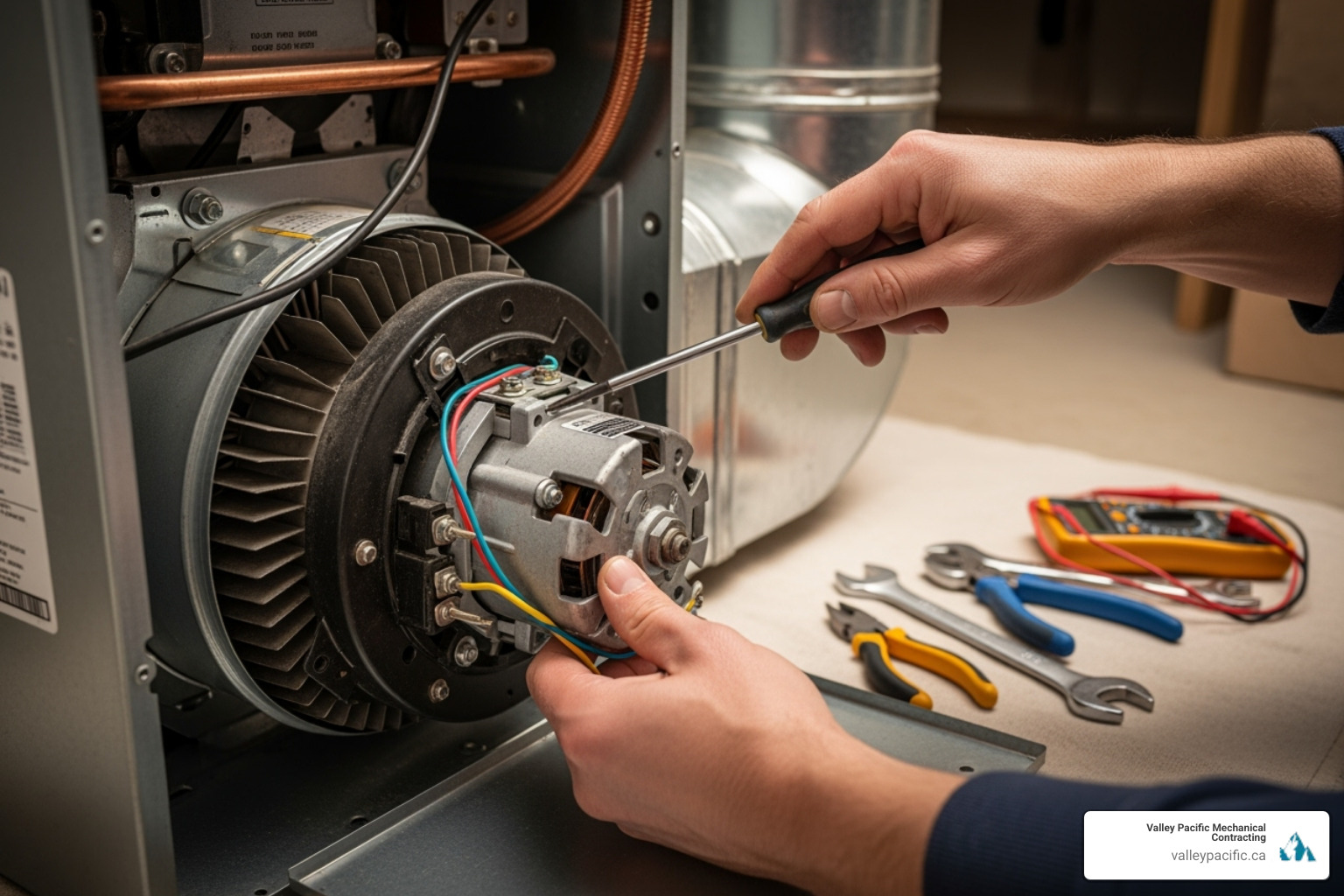
Understanding the Professional Process for a Furnace Blower Motor Replacement
Our expert technicians follow a precise process for every furnace blower motor replacement:
- Safety First: Power is shut off at the circuit breaker, and the gas supply is closed.
- Access and Documentation: The furnace access panels are removed, and all wiring is photographed to ensure correct reassembly.
- Disassembly: The technician disconnects the wiring from the control board and slides out the entire blower assembly.
- Motor Removal: The old motor is detached from the blower wheel and housing. Specialized tools like hub pullers may be used if parts are seized.
- New Motor Installation: The new motor is installed, ensuring its rotation direction is correct. The blower wheel is reattached and centered according to manufacturer specifications.
- Reassembly and Testing: The blower assembly is reinstalled, wires are reconnected, and panels are secured. Power and gas are restored, and the system is thoroughly tested for quiet, safe, and efficient operation.
Our team adheres to the highest professional standards. You can always find a licensed contractor to verify credentials.
A Note on Flame Sensor and Pressure Switch Replacement
Compared to a motor replacement, servicing a flame sensor or pressure switch is less complex but equally important for safety.
- Flame Sensor Service: Often, the sensor just needs cleaning to remove carbon buildup. A technician can gently clean the rod with fine sandpaper. If it's faulty, replacement is a simple task involving one wire and a mounting screw.
- Pressure Switch Service: A technician first inspects the connected rubber hose for clogs or cracks. If the switch itself has failed, it's an easy component to replace, involving a few wires, a hose, and mounting screws.
Whether you need simple maintenance or complex repairs like Furnace Repair Pitt Meadows BC, our team ensures every safety device works perfectly.
Blower Motor Essentials: Types, Lifespan, and Maintenance
Understanding your furnace's blower motor and how to maintain it can significantly impact your system's efficiency and longevity.

Comparing Single-Speed and Variable-Speed Motors
For a furnace blower motor replacement, you'll typically choose between two types:
- Single-speed motors: These traditional motors operate at one speed: full blast. They are effective but less energy-efficient and can create noticeable temperature swings and noise.
- Variable-speed motors: These modern motors adjust their speed based on your home's heating needs. They provide better energy efficiency, improved air quality through consistent filtration, and much quieter operation.
Extending the Life of Your Furnace Components
With proper care, a blower motor can last 10-20 years. Regular maintenance is key to maximizing its lifespan and preventing breakdowns.
- Change Air Filters Regularly: This is the most important task. A dirty filter restricts airflow, forcing the motor to work harder and risk overheating. Change filters every 1-3 months.
- Keep the Blower Wheel Clean: Dust buildup on the blower wheel's fins reduces efficiency and strains the motor. This should be cleaned during professional maintenance.
- Schedule Annual Inspections: A qualified technician can spot and fix small issues before they become major problems. Our HVAC Preventative Maintenance services ensure your entire system runs smoothly.
When a replacement is needed, it's crucial that the new motor's specifications (horsepower, voltage, and RPM) perfectly match your furnace's requirements for safe and effective operation.
Understanding the Heart of Your Furnace: Blower Motor, Flame Sensor, and Pressure Switch
Furnace blower motor replacement is a common repair, but your furnace's health also depends on the flame sensor and pressure switch. These three components must work together for safe and efficient heating.
Quick Answer for Furnace Blower Motor Replacement:
- Average lifespan: 10-20 years with proper maintenance
- Common signs: No airflow, grinding sounds, burning smell, short cycling
- Professional job: Requires electrical work and specialized tools
- Typical process: Power off → remove panels → disconnect wiring → replace motor → test system
- Also check: Flame sensor and pressure switch during service call
The blower motor circulates heated air through your home. The flame sensor is a safety device that confirms combustion is occurring, while the pressure switch verifies that the system is venting properly before ignition. A failure in any one of these parts can cause your entire heating system to stop working.
Understanding their functions helps you identify issues early. Due to the involvement of gas and electrical systems, repairs and replacements should be handled by a qualified HVAC technician. To learn more about improving your home's heating, see our guide on HVAC Services for Home Comfort.
Telltale Signs Your Furnace Components Are Failing
Learning to interpret your furnace's warning signs—from strange noises to a lack of warmth—can help you address issues before they cause a complete breakdown.
Symptoms of a Failing Blower Motor
A failing blower motor often signals its decline through the following symptoms:
- Weak Airflow or No Air from Vents: The most obvious sign. If the furnace runs but little air circulates, the motor may be failing.
- Grinding or Screeching Sounds: These noises often indicate worn-out motor bearings, a problem that can lead to a seized motor if ignored.
- Burning Smell: An electrical burning odor can mean the motor is overheating, a serious issue that requires immediate attention.
- Increased Energy Bills: A struggling motor uses more power to move air, leading to a sudden spike in your utility costs.
- Furnace Short Cycling: The furnace turns on and off in quick succession, often because an overheating motor is tripping a safety switch. Learn more about Furnace Short Cycling Signs & Solutions.
- Furnace Fails to Power Up: A completely failed motor can prevent the furnace from starting its heating cycle.
Indicators of a Faulty Flame Sensor
The flame sensor is a safety device that confirms the presence of a flame. If it's faulty, you may notice:
- Furnace Starts Then Shuts Off Quickly: This is the classic symptom. The furnace ignites, runs for a few seconds, then shuts down because the sensor fails to detect the flame.
- Dirty or Corroded Sensor Rod: Soot buildup can prevent the sensor from working. Often, a professional cleaning is all that's needed.
- Clicking Sounds Without Ignition: The furnace tries to light but shuts down when the sensor doesn't confirm ignition.
Clues Your Pressure Switch is Bad
The pressure switch ensures exhaust is venting safely. A bad switch will prevent the furnace from igniting.
- Furnace Won't Start at All: The inducer motor may run, but the burners never light because the switch won't give the all-clear.
- Error Code on Control Board: Modern furnaces often display an error code pointing directly to a pressure switch fault. Our guide to Furnace Circuit Board Repair can help decode these messages.
- Condensate Line Blockage: In high-efficiency furnaces, a clogged drain line can cause a pressure switch fault.
A Homeowner's Guide to Furnace Blower Motor Replacement
While a furnace blower motor replacement requires a certified professional due to electrical and gas safety risks, understanding the process can help you know what to expect. This section outlines the typical steps our technicians take.
Understanding the Professional Process for a Furnace Blower Motor Replacement
Our technicians follow a meticulous process to ensure a safe and effective furnace blower motor replacement:
- Safety First: The technician cuts power to the furnace at the circuit breaker and closes the gas valve.
- Access and Documentation: The furnace's access panels are removed, and photos are taken of the wiring to ensure correct reassembly.
- Disassembly: Wires to the motor and control board are disconnected, and the entire blower assembly is slid out of the furnace cabinet.
- Motor Removal: The old motor is detached from the blower housing and wheel. Specialized tools may be needed if the wheel is seized on the motor shaft.
- New Motor Installation: The new motor is secured in the housing, ensuring the rotation direction is correct for proper airflow. The blower wheel is reattached and centered.
- Reassembly and Testing: The assembly is reinstalled, wiring is reconnected, and panels are secured. The technician then restores power and gas and tests the furnace to ensure it runs quietly and efficiently.
We adhere to the highest standards, which you can verify by checking for a Find a licensed contractor link.
A Note on Flame Sensor and Pressure Switch Replacement
Servicing a flame sensor or pressure switch is typically simpler but still requires a professional.
- Flame Sensor Service: Often, a sensor just needs cleaning to remove carbon buildup. If it's faulty, replacement is a quick part swap.
- Pressure Switch Service: A technician will first check the connected hose for blockages. If the switch itself has failed, it is easily replaced.
Our team ensures all safety devices function perfectly. For any furnace repair needs, including Furnace Repair Pitt Meadows BC, we are ready to help.
Blower Motor Essentials: Types, Lifespan, and Maintenance
Understanding your blower motor type and its maintenance needs is key to your furnace's efficiency and longevity.
Comparing Single-Speed and Variable-Speed Motors
When considering a furnace blower motor replacement, you'll encounter two main types that impact comfort, energy use, and air quality.
| Feature | Single-Speed Motors | Variable-Speed Motors |
|---|---|---|
| Energy Efficiency | Operates at full capacity, consuming more power. | Adjusts speed based on heating needs, saving energy. |
| Air Quality | Less consistent air filtration since the fan is on or off. | Continuous, low-speed operation improves air filtration. |
| Noise Level | Louder due to constant high-speed operation. | Quieter operation, especially at lower speeds. |
Upgrading to a variable-speed motor can offer significant long-term benefits, including more consistent temperatures and better humidity control. When a replacement is necessary, our technicians ensure the new motor's horsepower (HP), voltage, and RPM specifications precisely match your furnace's requirements.
Extending the Life of Your Furnace Components
The average lifespan of a blower motor is 10 to 20 years. Proper care can help it reach or exceed that range.
- Regular Maintenance: Annual tune-ups are the best way to keep your system running efficiently and prevent unexpected breakdowns.
- Air Filter Changes: A clogged air filter forces the motor to work harder and overheat. Change your filter every 1-3 months to protect your motor.
- Cleaning the Blower Wheel: During maintenance, we clean the blower wheel (or squirrel cage) to remove debris that can cause imbalance and strain the motor.
- Annual Inspections: Our comprehensive inspections identify wear and tear, electrical issues, and other potential problems before they escalate.
For a complete overview of our preventative plans, visit our HVAC Preventative Maintenance page.
Frequently Asked Questions about Furnace Repair
Here are answers to common questions we hear from homeowners about furnace blower motor replacement and related repairs.
Is it worth replacing a furnace blower motor?
In most cases, yes. If your furnace is under 15 years old and otherwise in good condition, a furnace blower motor replacement is a cost-effective solution that can restore your system's performance for years to come. It's much less expensive than a full furnace replacement. Upgrading to a more efficient variable-speed motor can also lower your energy bills.
However, if your furnace is approaching 20 years old and has multiple failing components, a full replacement might be a better long-term investment. We can help you decide what makes the most sense for your home. Learn more at our Furnace Replacement Maple Ridge BC page.
How do I test my furnace blower motor?
While a professional diagnosis is always best, you can perform a few simple checks. First, switch your thermostat's fan setting from "Auto" to "On." Go to your vents and check for airflow. If it's weak or non-existent, there may be a problem. Next, listen for unusual sounds like grinding, screeching, or loud humming, which often indicate failing motor bearings.
These checks are only a starting point. A professional technician can perform a comprehensive HVAC System Check to accurately diagnose the issue.
What happens if a furnace blower motor goes out?
A failed blower motor means no air circulation. Your furnace may generate heat, but it has no way to distribute it through your home. This leads to several problems:
- Overheating Risk: Without airflow, the heat exchanger can overheat, causing the furnace's safety switches to shut the system down repeatedly.
- System Shutdown: Most modern furnaces will not operate at all if the blower motor isn't working, to prevent further damage.
- No Heating or Cooling: A dead blower motor means your HVAC system cannot heat or cool your home until the motor is replaced.
If you're experiencing a furnace failure, don't wait. We offer 24/7 emergency service. For immediate help, visit our Heating Repair Maple Ridge BC page.
Keep Your Home Comfortable with Professional Furnace Service
At Valley Pacific Mechanical Contracting, we know a reliable furnace provides both comfort and peace of mind. For over 30 years, we've provided expert furnace service to homeowners in Mission, Maple Ridge, Langley, and Coquitlam.
Whether you need a furnace blower motor replacement or a simple tune-up, our goal is a headache-free experience. We offer clear explanations, upfront communication, and the Daikin Comfort Promise to guarantee your satisfaction. Furnace problems don't keep business hours, which is why we offer 24/7 emergency service to ensure you're never left in the cold.
From routine maintenance to emergency repairs, our expert technicians are ready to keep your home warm and comfortable. Ready for reliable, professional service? Schedule your furnace installation in Langley BC today or call us for any heating repair needs.
Why Heat Pump Maintenance Matters for Your Home
Heat pump maintenance is key to keeping your system running efficiently, saving you money on energy bills and ensuring year-round comfort. Here’s a quick overview:
DIY Tasks:
- Monthly: Check and replace air filters.
- Seasonally: Clear debris from the outdoor unit, clean coils, and check condensate drains.
Professional Service:
- Schedule annual inspections for deep cleaning, electrical checks, and system efficiency tests.
Regular maintenance can boost your heat pump's energy efficiency by 10-25%. A well-maintained system with a high coefficient of performance (COP) is far more efficient than alternatives like electric baseboard heaters.
Without proper care, dust and debris build-up, refrigerant levels can drop, and parts wear out faster. This leads to higher energy bills, poor air quality, and unexpected breakdowns. While many tasks are simple for homeowners, professional technicians are essential for annual tune-ups to handle the more complex work.
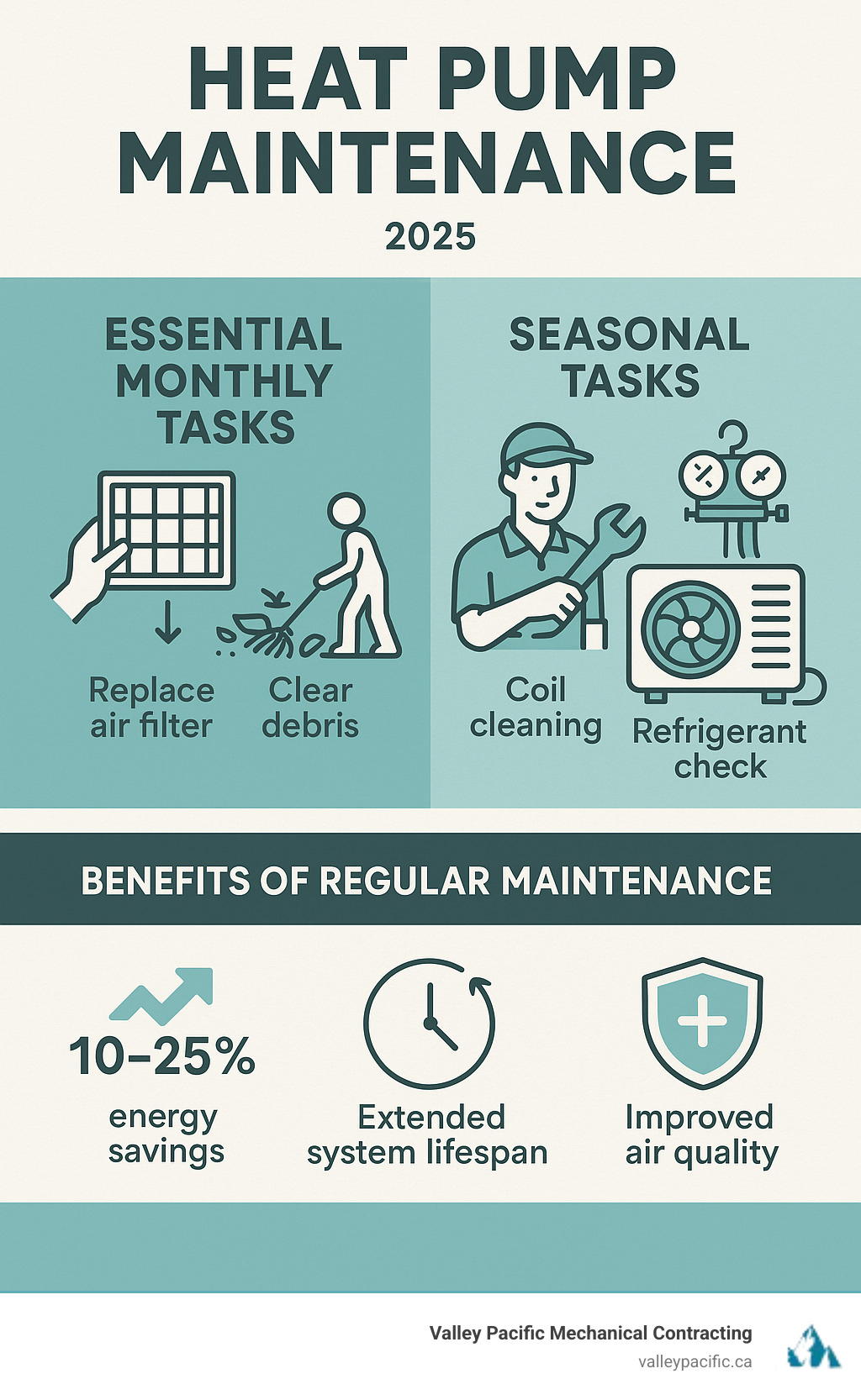
Why Regular Maintenance is Non-Negotiable
Your heat pump works hard every day, switching between heating and cooling. Like a car, it needs consistent care to perform its best. Heat pump maintenance is essential for protecting your investment and keeping your home comfortable.
A well-maintained heat pump can be 10-25% more energy-efficient than a neglected one, leading to significant savings on your utility bills. Regular care delivers several key benefits:
- Lower Energy Bills: A clean, efficient system uses less power. Its Coefficient of Performance (COP) remains high, meaning it produces more heat or cooling for every unit of electricity consumed. When filters clog or coils get dirty, the system works harder, and your bills go up.
- Longer Equipment Lifespan: Proactive maintenance prevents wear and tear, extending the life of your heat pump.
- Improved Air Quality: Clean filters are crucial for trapping dust, allergens, and pollutants. This is especially important for households with allergies or asthma, as it leads to cleaner air and easier breathing.
- Consistent Comfort: A well-maintained system provides even temperature control and manages humidity levels, eliminating hot and cold spots.
- Fewer Breakdowns: Regular tune-ups catch small issues before they become costly emergency repairs. Think of it as insurance for your comfort. If you do need help, our Expert Heat Pump Repair Services are available.
If you're considering a new system, learn more about the Consider Heat Pump Installation Reasons. For residents in Maple Ridge, our Heat Pump AC Services Maple Ridge BC team can help optimize your system's performance.
Your DIY Maintenance Checklist
While professional tune-ups are essential, several DIY tasks can keep your system running smoothly. These simple steps can significantly impact your heat pump's efficiency and lifespan.
Safety First: Always turn off the power to your heat pump at both the thermostat and the circuit breaker before performing any maintenance. Consult your owner's manual for model-specific instructions.
For more tips custom to our local climate, see our Seasonal Heat Pump Maintenance Tips.
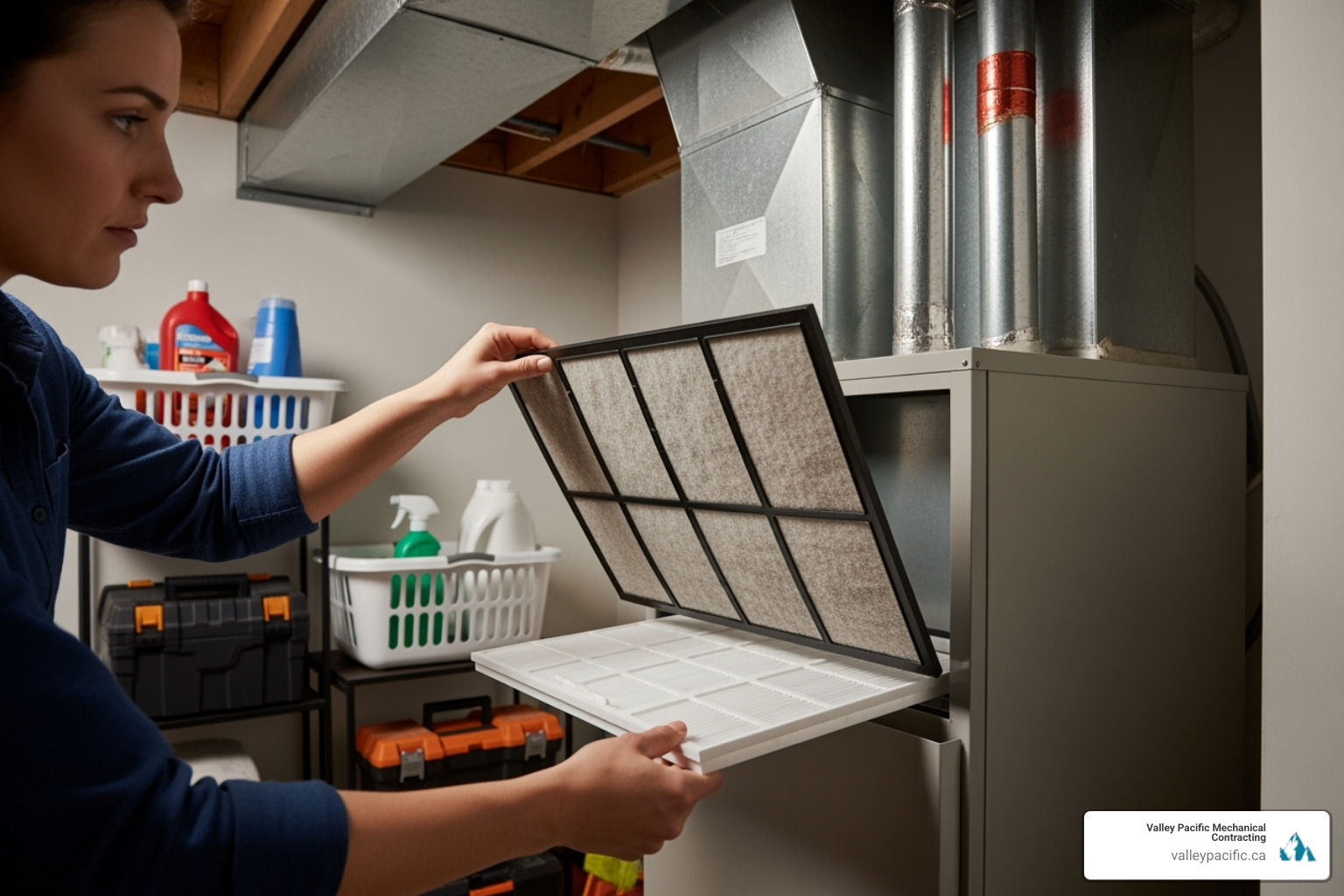
How Often to Clean or Replace Heat Pump Filters
Your heat pump's filter traps dust, pet hair, and pollen, protecting the system's inner components. Different filter types exist, including disposable fiberglass or pleated filters and reusable washable ones. Look at the MERV rating (Minimum Efficiency Reporting Value) to gauge filtration effectiveness—a higher number means cleaner air. You can learn more about MERV ratings to choose the right one for your home.
Check your filter monthly. You may need to replace it every month during heavy use seasons or every three months in milder weather. If you can't see light through it, it's time for a change. A dirty filter restricts airflow, forcing your system to work harder, which increases energy bills and can cause it to overheat or freeze. When installing a new filter, ensure the airflow arrow points toward the unit and it fits snugly. For specific advice on Daikin systems, contact our Daikin Heat Pump Service team.
Ensuring Proper Airflow for Your Heat Pump
Proper airflow is critical for your heat pump's efficiency. Both indoor and outdoor units need to "breathe" without obstruction.
Outdoor Unit: Regularly clear leaves, grass, and debris from around the unit. Maintain at least 18 inches of clearance on all sides for plants and other objects. For tips on placement, see our guide on Best Locations for Heat Pump Placement. In winter, gently brush away snow. If ice forms, don't chip it off; turn the unit off to let it melt or carefully pour lukewarm water over it, avoiding electrical parts.
Indoor Vents: Ensure supply and return vents are not blocked by furniture, rugs, or curtains. Good airflow is key to distributing conditioned air. In rooms with closed doors, consider solutions like jumper ducts or undercutting doors to improve circulation.
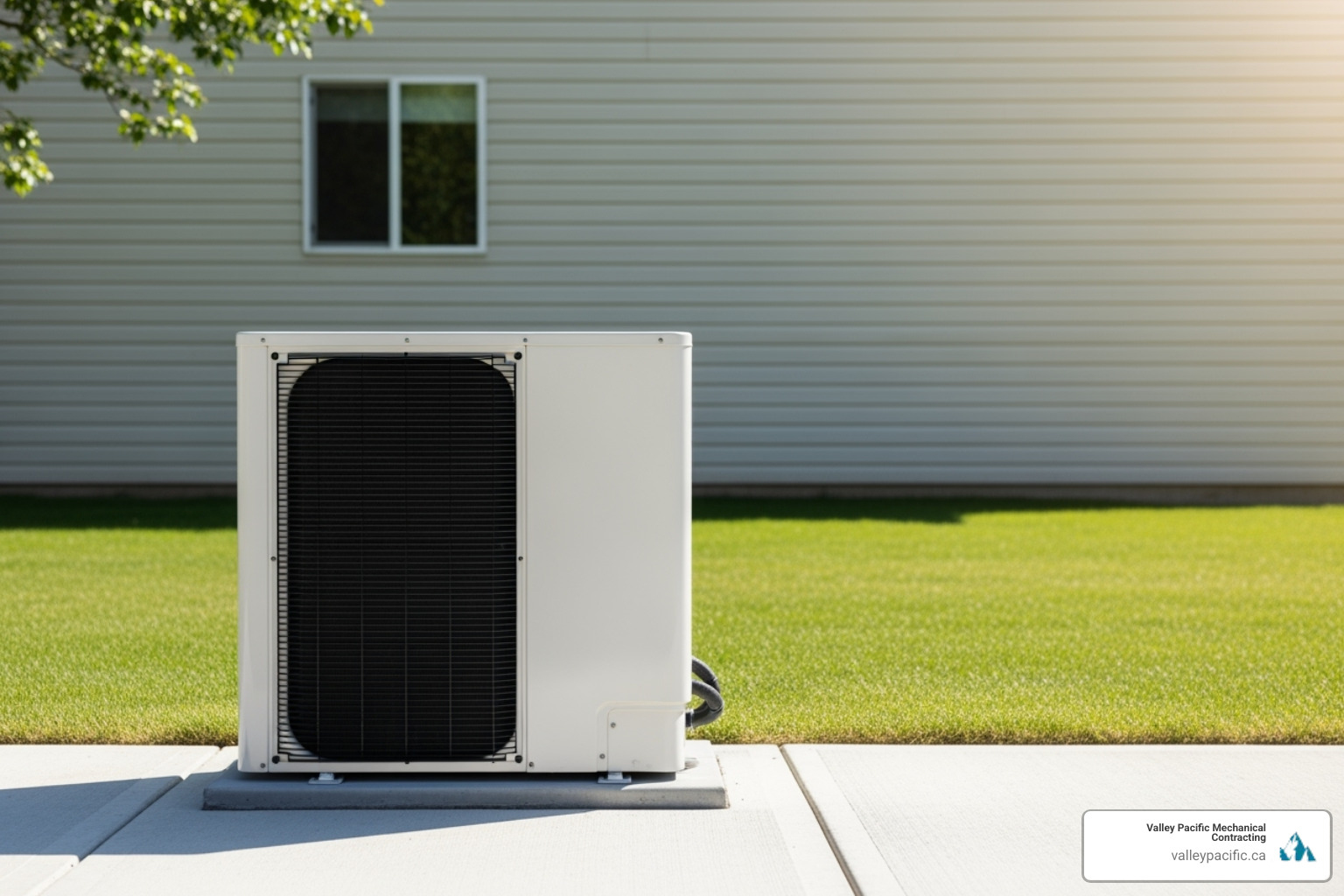
Cleaning Coils and Condensate Drains
Clean coils are essential for efficient heat transfer and lower energy bills.
Outdoor Coil: After turning off the power, you can gently rinse the outdoor coil with a garden hose. For stubborn dirt, use a soft brush. Specialized coil cleaners can be used, but follow the instructions carefully.
Indoor Coil: The indoor coil is harder to access and is best cleaned by a professional. You can vacuum any visible dust in the area, but deep cleaning requires an expert.
Condensate Drain: This drain removes moisture your system collects. To prevent clogs from algae and mold, periodically flush the line with a vinegar and water solution. Watch for warning signs like standing water near the indoor unit, musty smells, or water stains, as these indicate a clog that needs immediate attention to prevent water damage.
The Professional Heat Pump Maintenance Checklist
While DIY tasks are helpful, some heat pump maintenance requires a trained professional. We recommend a professional tune-up at least once a year, though bi-annual service (spring and fall) is ideal for peak performance and maintaining warranty coverage. Certified technicians, like those recognized by DOE's Heat Pump Programs, can spot issues you might miss, preventing costly problems. For year-round care, consider our Comprehensive Heat Pump Service Plans.

What a Technician Inspects During a Tune-Up
During a professional heat pump maintenance visit, a technician performs a comprehensive inspection, including:
- Refrigerant Levels: Checking for the correct charge is crucial for performance. Low levels indicate a leak that needs professional repair.
- Electrical Connections: Tightening all connections and inspecting capacitors and contactors for safety and proper function.
- Motor Lubrication: Ensuring all moving parts operate smoothly to reduce friction and wear.
- Blower Components: Deep cleaning the blower wheel and assembly to ensure proper airflow.
- Thermostat Calibration: Verifying the thermostat is accurate to prevent energy waste.
- Defrost Cycle: Testing this function is essential for winter operation to prevent ice buildup.
- Ductwork Inspection: Checking for leaks that waste energy and reduce comfort.
- Coil and Condensate Drain Cleaning: Performing a deep clean of coils and ensuring the condensate drain is clear to prevent water damage.
Maintenance for Different Heat Pump Types
Different heat pump types have unique maintenance needs. A professional service will address the specific requirements of your system.
| Heat Pump Type | Key Maintenance Focus |
|---|---|
| Air-Source | Outdoor unit care, defrost cycle, coil cleaning. |
| Geothermal | Indoor unit care, pump and fluid level checks. |
| Ducted | Ductwork sealing, airflow balancing, filter maintenance. |
| Ductless | Cleaning individual head units, filters, and drains. |
- Air-source systems require diligent outdoor unit care due to weather exposure.
- Geothermal systems need professional checks of the ground loop's circulating pump and fluid levels.
- Ducted systems benefit from duct inspections to find and seal leaks.
- Ductless mini-splits need each indoor head cleaned professionally to prevent mold and maintain efficiency.
For expert care custom to your system in Maple Ridge, contact our Heat Pump Service Maple Ridge BC team.
Telltale Signs Your Heat Pump Needs Attention
Your heat pump will often signal when it needs attention. Recognizing these warning signs early can help you avoid expensive repairs. For a detailed list, see our guide on Signs Your Heat Pump Needs Repair. Key signs include:
- Unusual Noises: Grinding, rattling, or squealing sounds can indicate worn or loose parts.
- Poor Performance: If the system struggles to heat or cool evenly, it could be due to low refrigerant or airflow problems.
- Short Cycling: Frequent on-and-off cycles put major stress on the system and waste energy.
- Rising Energy Bills: A sudden spike in costs often means your heat pump is working inefficiently.
- Ice Buildup: Thick ice on the outdoor unit or refrigerant lines signals a serious issue.
- Strange Odors: Musty or burning smells require immediate professional diagnosis.
Common Heat Pump Issues and How to Address Them
Many common heat pump issues stem from neglected heat pump maintenance. Here are a few frequent problems:
- Frozen Coils: Often caused by dirty filters, blocked airflow, or low refrigerant. A malfunctioning defrost cycle is another culprit. Learn more about Why is my Heat Pump not Defrosting.
- Refrigerant Leaks: Signs include hissing sounds, ice on refrigerant lines, and poor performance. This repair requires a certified technician.
- Faulty Reversing Valve: This causes the system to get stuck in heating or cooling mode.
- Compressor Issues: Grinding noises or difficulty starting can signal a problem with the compressor, the heart of your system. Preventive maintenance is key to avoiding this serious issue.
- Electrical Problems: Beyond checking your breaker, electrical issues should always be handled by a professional.
Your system may also display diagnostic messages. Learn to decipher them by Understanding Heat Pump Error Code.
When to Call for Professional Heat Pump Repair
Knowing when to call a professional is key to protecting your investment and your safety. Call for help when you encounter:
- Persistent Problems: If basic DIY troubleshooting (like changing filters or clearing debris) doesn't fix the issue.
- Safety Concerns: Immediately call a pro for burning smells, tripped breakers, or loud mechanical noises.
- Complex Electrical Work: Anything beyond checking the circuit breaker requires a trained technician.
- Refrigerant Handling: Refrigerant leaks must be handled by a certified professional.
If you feel uncertain about a repair, it's always best to call an expert. Our team provides safe and efficient service. For local assistance, contact our Heat Pump Repair Langley BC or Heat Pump Repair Pitt Meadows BC teams.
Frequently Asked Questions about Heat Pump Care
We get a lot of questions about heat pump maintenance. Here are answers to some of the most common ones:
How often should a heat pump be professionally serviced?
We recommend professional service at least once a year. An annual tune-up is crucial for efficiency, preventing breakdowns, and extending your system's lifespan. For optimal performance, consider bi-annual servicing: one visit in the spring for cooling season prep and another in the fall for heating. Regular professional maintenance is also often required to keep your manufacturer's warranty valid.
Can I perform all heat pump maintenance myself?
While homeowners can and should perform simple heat pump maintenance tasks like changing air filters and clearing debris from the outdoor unit, some jobs are best left to professionals. Tasks involving refrigerant, electrical connections, and internal motors require specialized tools and training. Attempting these complex repairs yourself can be dangerous, cause more damage, and may void your warranty. It's always safest to leave technical work to certified technicians.
What happens if I neglect my heat pump?
Neglecting your heat pump leads to a snowball of problems. You can expect:
- Reduced Efficiency and Higher Bills: A dirty, unmaintained system works harder, consuming more energy and increasing your utility costs.
- Poor Indoor Air Quality: Clogged filters fail to remove dust and allergens from your home's air.
- Unexpected Breakdowns: Neglect increases the likelihood of system failure, often during extreme weather when you need it most.
- Shortened Lifespan: A neglected heat pump may only last 8-10 years instead of the typical 15-20, forcing a premature and costly replacement.
Regular heat pump maintenance is a small investment that prevents these major headaches and pays for itself in savings and reliability.
Conclusion
Regular heat pump maintenance is your key to year-round comfort, lower energy bills, and a longer-lasting system. As we've covered, a combination of simple DIY tasks and professional service is the most effective approach.
Simple steps like monthly filter changes and keeping the outdoor unit clear make a huge difference. Paired with annual professional tune-ups, this proactive care helps you avoid the stress and expense of emergency repairs. A well-maintained heat pump is 10-25% more efficient, saving you money while providing cleaner air and more consistent comfort.
While DIY maintenance is important, complex tasks involving electrical or refrigerant systems should always be left to experienced professionals for safety and effectiveness.
For expert service in Langley, Maple Ridge, and Mission, trust the team at Valley Pacific Mechanical Contracting. We're committed to providing a "headache-free" experience to keep your system running smoothly.
Ready to give your heat pump the professional care it deserves? Schedule your professional heat pump service today and enjoy reliable comfort all year long.
Why Heat Pump Installation in Maple Ridge is Your Best HVAC Investment
Heat pump installation Maple Ridge homeowners are choosing provides an all-in-one solution for year-round comfort. These advanced systems offer both heating and cooling from a single unit, making them ideal for British Columbia's varied climate.
Quick Guide to Heat Pump Installation in Maple Ridge:
- Types Available: Ductless mini-splits, ducted systems, and hybrid dual-fuel options
- Professional Installation Required: Licensed technicians ensure proper setup and code compliance
- Government Rebates: Up to $21,000 available through CleanBC programs
- Energy Savings: Heat pumps are 2-5 times more efficient than gas furnaces
- Lifespan: 15+ years with proper maintenance
- Best For: Homes wanting efficient heating, cooling, and reduced energy bills
Maple Ridge's mild winters and warm summers make it perfect for heat pump technology. Modern systems work efficiently even on the coldest days, while providing excellent cooling during summer heat waves.
Heat pumps extract warmth from outdoor air and transfer it inside during winter. In summer, they reverse this process to cool your home. This dual functionality eliminates the need for separate heating and cooling systems.
The technology has advanced significantly in recent years. Today's cold-climate heat pumps maintain their efficiency even when temperatures drop well below freezing - perfect for Canadian winters.
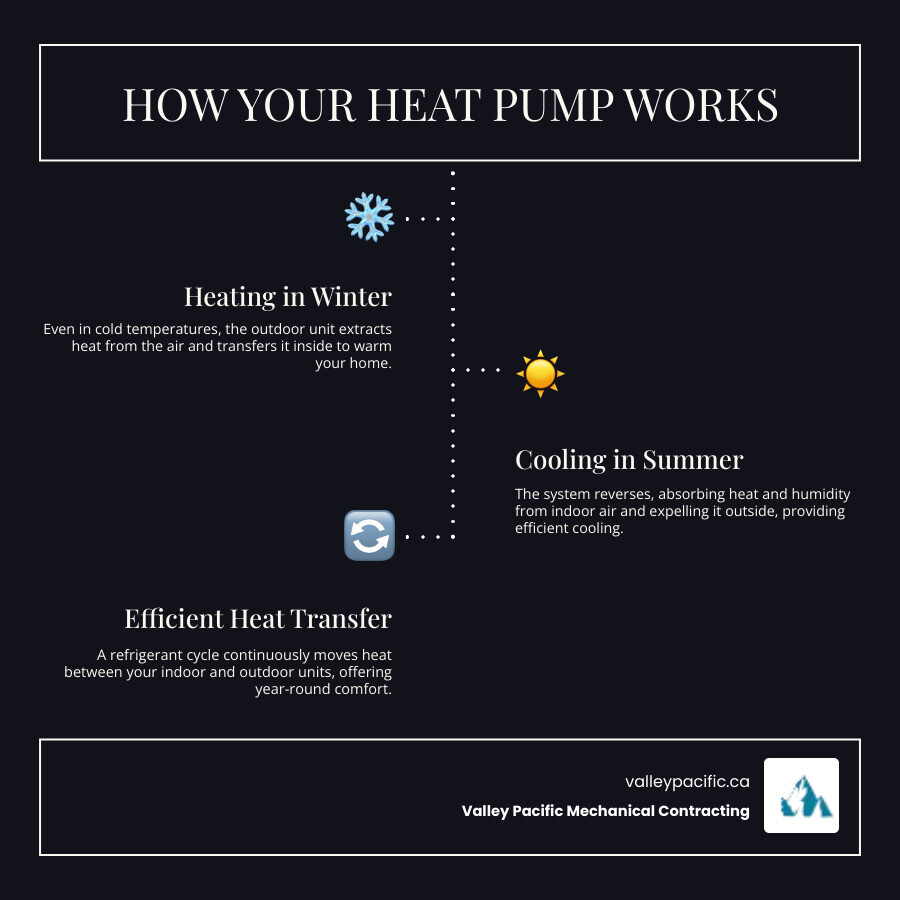
Why a Heat Pump is the Smart Choice for Your Maple Ridge Home
When you're looking at heating and cooling options for your Maple Ridge home, heat pump installation Maple Ridge homeowners are choosing makes perfect sense. It's not just another HVAC upgrade - it's a smart investment that pays dividends in comfort, savings, and peace of mind.
Think about it: wouldn't it be nice to have one system that handles everything? Heat pumps offer exactly that - dual functionality that provides both heating and cooling from a single unit. No more juggling separate systems or wondering if your old furnace will make it through another winter.
The energy savings alone make heat pumps compelling. These systems are incredibly efficient, using 2-5 times less energy than traditional gas furnaces. That efficiency translates directly to lower utility bills and a reduced carbon footprint - something we can all feel good about.
But here's what really gets homeowners excited: the consistent home comfort. Heat pumps don't just blast hot or cold air - they maintain steady, even temperatures throughout your home. It's the kind of comfort that makes you appreciate coming home every day.
For a deeper dive into why heat pumps might be perfect for your situation, check out these Consider Heat Pump Installation Reasons.
Improved Energy Efficiency
Here's where heat pumps really shine. Unlike your old furnace that burns fuel to create heat, heat pumps simply move heat from one place to another. It's like having a heat magnet - in winter, they pull warmth from outside air (yes, even when it's cold!) and bring it inside. In summer, they reverse the process.
This heat transfer process requires far less energy than generating heat from scratch. The result? Lower energy consumption that shows up immediately on your utility bills. Many homeowners see their heating and cooling costs drop by 50% or more after switching to a heat pump.
The high-efficiency operation means you get more bang for your buck. Every dollar you spend on electricity delivers 2-3 times more heating or cooling compared to traditional systems. It's simple math that adds up to real savings month after month.
Want to learn more about how efficient HVAC systems can transform your home? Visit our HVAC Services in Maple Ridge page for more information.
Year-Round Comfort in a Single System
The beauty of a heat pump is its seamless switching between seasons. When winter arrives, your system automatically provides reliable heating. When summer heat waves hit, it effortlessly transitions to powerful cooling. No manual switching, no separate systems to maintain - just consistent comfort.
During those cold Maple Ridge winters, your heat pump keeps every room comfortably warm. Come summer, the same system delivers refreshing cool air throughout your home. Many systems even include dehumidification capabilities, removing excess moisture for that perfect indoor atmosphere.
This all-in-one HVAC solution simplifies your life while delivering year-round comfort you can count on. No more worrying about whether your air conditioner will work when the first heat wave hits, or if your furnace will start up when temperatures drop.
For all your cooling needs throughout the year, our team provides comprehensive Heat Pump AC Services Maple Ridge BC to keep you comfortable in every season.
Understanding How Heat Pumps Work
Think of a heat pump as nature's ultimate recycling machine - it doesn't create heat from scratch like your old furnace. Instead, it's constantly moving heat from one place to another, which is exactly why it's so incredibly efficient!
The magic happens through a clever dance between refrigerant, outdoor units, and indoor units. During winter, your heat pump's outdoor unit acts like a heat detective, finding warmth in the outside air (yes, even when it's freezing!). The refrigerant absorbs this heat and carries it indoors, where your indoor unit releases that cozy warmth throughout your home.
When summer rolls around, the system flips its role thanks to something called a reversing valve. Now your indoor unit becomes the heat collector, pulling warmth from your home's air, while the outdoor unit expels that heat outside. It's essentially the same process your refrigerator uses, just scaled up for your entire house!
This brilliant heat transfer process is exactly why heat pumps are highly efficient compared to other systems. They're not working harder - they're working smarter.

Key Efficiency Ratings: SEER and HSPF
When you're considering heat pump installation Maple Ridge, you'll encounter two important efficiency ratings that directly impact your comfort and savings. Don't worry - these aren't just technical mumbo jumbo!
SEER (Seasonal Energy Efficiency Ratio) measures how well your heat pump cools your home throughout an entire cooling season. Think of it as your system's report card for summer performance. The higher the SEER rating, the less electricity your heat pump uses to keep you cool. For rebate eligibility, we typically look for SEER ratings of 16 or higher.
HSPF (Heating Seasonal Performance Factor) does the same thing, but for heating efficiency over a full heating season. A higher HSPF means your heat pump is more efficient at keeping you warm while using less electricity. Most rebate programs require an HSPF rating of 8.6 or higher.
These ratings aren't just numbers - they're your roadmap to long-term savings and rebate eligibility. Pair your efficient heat pump with a smart thermostat and you'll maximize both comfort and efficiency.
Performance in British Columbia's Climate
Here's the question we hear most often: "Do heat pumps really work when it's freezing outside?" Absolutely! Modern cold-climate heat pumps have come a long way from their earlier cousins.
Today's advanced technology allows heat pumps to extract warmth from surprisingly cold air - we're talking well below freezing temperatures. These aren't your grandfather's heat pumps that struggled when winter arrived. Modern technology advancements mean your heat pump will provide reliable heating on cold days, even during those typical Canadian winter snaps.
When Maple Ridge experiences one of its summer heat waves, your heat pump seamlessly switches gears to provide efficient cooling that keeps your home comfortable. This versatility makes heat pumps perfectly suited for British Columbia's diverse climate - from winter chills to summer scorchers, your system has you covered year-round.
Your Guide to Heat Pump Installation in Maple Ridge
Planning your heat pump installation Maple Ridge journey doesn't have to feel overwhelming. We're here to guide you through every step, from selecting the perfect system for your home to ensuring a flawless installation that keeps you comfortable for years to come.
The beauty of modern heat pump technology is that there's truly a solution for every home. Whether you live in a cozy bungalow, a sprawling family home, or something in between, we'll work closely with you to find the ideal match. We consider everything from your home's size and layout to your existing ductwork and specific comfort preferences. After all, no two homes are exactly alike, and your heating and cooling solution shouldn't be cookie-cutter either. For optimal performance, we also carefully consider the Best Locations for Heat Pump Placement around your property.
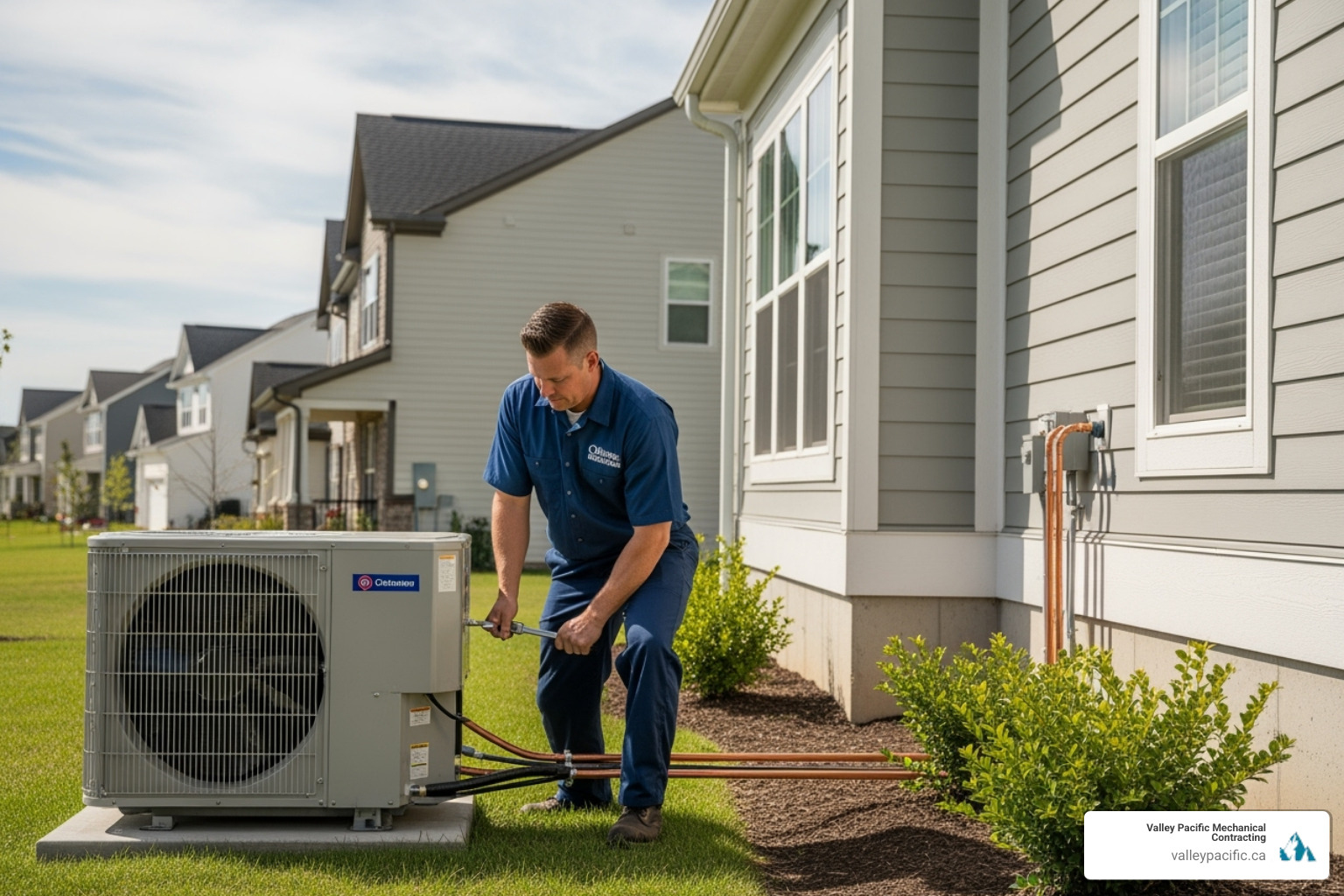
Types of Heat Pumps for Your Home
When it comes to choosing the right heat pump for your Maple Ridge home, you have several excellent options. Let's break them down in simple terms so you can make an informed decision.
Air-source heat pumps are by far the most popular choice for homeowners, and for good reason. These systems work by transferring heat between the outdoor air and your indoor space. Don't let the word "air" fool you - modern cold-climate air-source heat pumps are absolute champions at extracting warmth from surprisingly cold outdoor temperatures. They're also typically the most budget-friendly option for installation, making them an excellent starting point for most families.
For those looking for the ultimate in efficiency, geothermal heat pumps tap into the earth's stable underground temperatures. While they require more extensive installation work involving ground loops, they offer incredibly consistent performance year-round. The earth maintains relatively steady temperatures below the surface, which means these systems don't have to work as hard during extreme weather.
Now, here's where things get interesting with your installation options. Ductless mini-split systems are perfect if your home doesn't have existing ductwork or if you want to add comfort to specific areas like a new addition or home office. Each indoor unit gives you individual control over that space's temperature, which can lead to significant energy savings. The installation is typically less invasive since we don't need to modify your home's ductwork. However, you will see the indoor units mounted on your walls.
On the other hand, ducted systems work beautifully with your existing ductwork, delivering consistent comfort throughout your entire home just like a traditional furnace and air conditioner would. If you already have ducts in place, this option provides seamless whole-home comfort from a single central system.
For homeowners who want the best of both worlds, hybrid dual-fuel systems combine a heat pump with your existing gas furnace. The heat pump handles most of your heating and all of your cooling needs, but when temperatures drop to extreme lows, the system automatically switches to your gas furnace for backup heat. This gives you maximum efficiency most of the time with reliable backup when you need it most.
Choosing a Qualified Installation Company
Here's something we can't stress enough: the quality of your installation matters just as much as the quality of your equipment. A properly installed heat pump will run efficiently, last longer, and keep your family comfortable year after year. But a poor installation? That's a recipe for headaches, higher energy bills, and premature equipment failure.
That's why choosing the right installation company is absolutely crucial for your heat pump installation Maple Ridge project. You want to work with licensed and insured technicians who know what they're doing and stand behind their work.
Our team brings over 30 years of expertise to every installation, and all of our Red Seal HVAC certified technicians are bonded, insured, and work directly with the BC Safety Authority. This means every installation meets the highest industry standards and local codes - no shortcuts, no compromises.
What really sets us apart is our deep understanding of Maple Ridge's unique climate and housing styles. We've been serving the Lower Mainland for decades, so we know exactly what works best in your neighborhood. From dealing with coastal moisture to handling those occasional cold snaps, we've seen it all and know how to ensure your system performs flawlessly.
Before you commit to any contractor, we always recommend that you Verify your contractor is licensed with Technical Safety BC. It's a simple step that protects you and ensures you're working with qualified professionals.
And remember, our relationship doesn't end when the installation is complete. Should you ever need assistance down the road, our HVAC Repair Maple Ridge BC services are always here to keep your system running smoothly.
Rebates, Maintenance, and When to Upgrade
Making the switch to a heat pump becomes even more attractive when you consider the substantial government incentives available to Maple Ridge homeowners. These programs are specifically designed to make energy-efficient heating and cooling more accessible and affordable for families like yours.
The CleanBC Better Homes Energy Savings Program offers remarkable support, with rebates of up to $21,000 for heat pump installations. This generous program focuses on helping low- and middle-income households make the transition to electric heat pumps and other efficiency upgrades. Additionally, the CleanBC Better Homes and Home Renovation Rebate Program provides up to $6,000 when you're switching from fossil fuel systems like natural gas, oil, or propane, and up to $2,000 when upgrading from electric or wood heating systems to a heat pump.
What makes it even better is that some municipalities offer additional top-ups to boost your savings further. We work closely with these rebate programs to help our customers steer the application process and maximize their available incentives. You can explore all the current offerings on the CleanBC Better Homes website.

Signs It's Time for a New Heat Pump Installation in Maple Ridge
Even the most reliable heat pump won't run forever, and knowing when yours is ready for retirement can save you from uncomfortable surprises and climbing energy bills. We've helped countless Maple Ridge homeowners recognize these telltale signs that it's time for a heat pump installation Maple Ridge upgrade.
Age is often the first indicator - if your unit is 10-15 years old or more, it's likely far less efficient than today's models. While a typical heat pump can last around 15 years, the energy savings from a modern replacement often justify the upgrade even before complete failure.
Frequent repair calls are another clear signal. When you find yourself on a first-name basis with your repair technician, or when individual repair bills start adding up, it's usually more economical to invest in a new system rather than continually patching up an aging one.
Rising energy bills without changes to your usage habits often point to declining efficiency. Your heat pump is working harder and using more electricity to achieve the same comfort levels it once delivered effortlessly.
Strange noises or unusual odors coming from your system are red flags that shouldn't be ignored. Grinding, squealing, persistent banging, or burning smells typically indicate that internal components are failing or serious issues are developing.
Inconsistent temperatures throughout your home - some rooms too hot, others too cold, or difficulty maintaining your desired temperature setting - suggest your system's performance is compromised. This could signal a failing compressor or other critical components.
If any of these issues sound familiar, we'd be happy to assess your current system. Sometimes a simple repair is all that's needed, but often a new installation proves to be the smartest long-term investment. For more detailed troubleshooting guidance, check out our article on Signs Your Heat Pump Needs Repair.
Essential Maintenance for Longevity
Think of heat pump maintenance like taking care of your car - a little regular attention goes a long way toward keeping everything running smoothly and extending its life. A well-maintained heat pump can easily reach or exceed its expected 15-year lifespan while maintaining peak efficiency.
There are several simple tasks you can handle yourself to keep your system happy. Cleaning or replacing your air filters is the most important thing you can do - we recommend checking them monthly and changing them every 1-3 months depending on usage. A clogged filter is like trying to breathe through a straw; it restricts airflow and forces your system to work much harder.
Keeping your outdoor unit clear of debris is equally important. Leaves, grass clippings, and dirt can accumulate around the coils and fins, blocking proper airflow. A quick check every few weeks and maintaining at least two feet of clear space around the unit will keep things running efficiently.
Don't forget about your indoor vents either - make sure they're not blocked by furniture, curtains, or rugs that might restrict airflow throughout your home.
While these DIY tasks are helpful, nothing replaces the value of annual professional maintenance. Our certified technicians perform comprehensive tune-ups that include inspecting and cleaning coils, checking refrigerant levels, testing electrical connections, and verifying that everything is operating as it should. This annual service helps us catch small issues before they become expensive problems, maintains your system's efficiency, and keeps your warranty valid.
Regular maintenance isn't just about preventing breakdowns - it's about ensuring your heat pump continues to deliver the comfort and energy savings you invested in. For seasonal care tips throughout the year, visit our guide on Seasonal Heat Pump Maintenance Tips.
Frequently Asked Questions about Heat Pump Installation
We get lots of questions from Maple Ridge homeowners considering heat pump installation. Here are the answers to the most common ones we hear during our consultations!
Do heat pumps work well in cold weather?
This is probably the number one question we get, and we completely understand why! The short answer is yes – modern cold-climate heat pumps are absolute game-changers when it comes to handling Canadian winters.
Gone are the days when heat pumps struggled once the temperature dropped. Today's advanced technology allows these systems to extract heat from outdoor air even when it's well below freezing. We're talking about reliable heating performance even when the thermometer hits -15°C or lower!
The secret lies in the engineering improvements over the past decade. Modern heat pumps use variable-speed compressors and improved refrigerants that keep working efficiently in conditions that would have stumped older models. Your Maple Ridge home will stay cozy and warm throughout even our chilliest winter nights, without needing backup heating in most cases.
Can a heat pump replace my furnace and air conditioner?
Absolutely! This is one of our favorite things about heat pumps – they're true multitaskers. Think of it as getting two systems for the space of one.
A single heat pump handles both your heating needs in winter and your cooling needs in summer. No more juggling separate furnace and air conditioning maintenance schedules or worrying about one system breaking down while the other works fine. The beauty is in the simplicity – one system, one installation, one set of maintenance requirements.
This dual functionality also means you'll free up valuable space in your home. No need for both a furnace and an outdoor AC unit. Your heat pump's outdoor unit does all the heavy lifting year-round, while the indoor components (whether ducted or ductless) deliver perfectly conditioned air to every room.
What is the typical lifespan of a heat pump?
With proper care and professional installation, you can expect your quality heat pump to serve your family faithfully for 15 years or more. We've seen well-maintained units go strong for even longer!
The key to maximizing your heat pump's lifespan lies in three main areas: professional installation (which we always provide), regular maintenance (including those monthly filter changes we mentioned earlier), and annual professional tune-ups. When you treat your heat pump well, it returns the favor with years of reliable, efficient comfort.
Think about it this way – over 15+ years, your heat pump will cycle through thousands of heating and cooling seasons. That's a lot of comfort and energy savings! The units we install today are built to higher standards than ever before, so with Valley Pacific's expert installation and your commitment to basic maintenance, you're looking at a long-term investment that pays dividends year after year.
Your Local Experts for a Flawless Installation
When you choose heat pump installation Maple Ridge, you're making an investment that delivers on multiple fronts. You'll enjoy superior energy efficiency that can cut your heating and cooling costs significantly. Your home will maintain comfortable temperatures year-round, whether it's a chilly February morning or a sweltering August afternoon. Plus, you'll reduce your environmental impact while increasing your home's value.
The technology is impressive, the benefits are clear, but here's what really matters: none of it works without proper installation. A heat pump is only as good as the team that installs it. Poor installation can turn even the most advanced system into a source of frustration, inefficiency, and costly repairs.
That's exactly where Valley Pacific Mechanical Contracting makes all the difference. We've been perfecting our craft for over 30 years, serving homeowners throughout the Lower Mainland with the kind of expertise that only comes from decades of hands-on experience. We know Maple Ridge homes, we understand the local climate challenges, and we've seen every installation scenario you can imagine.
Our approach is simple: we believe you deserve a headache-free experience from start to finish. That means clear communication during your consultation, transparent recommendations based on your home's specific needs, and meticulous installation work that gets it right the first time. Our certified technicians don't just install your heat pump – they optimize it for your unique situation, ensuring maximum efficiency and comfort.
We stand behind our work with confidence. Our 24/7 emergency service means you're never left in the cold (or heat) if something unexpected happens. And with the Daikin Comfort Promise backing our installations, you can rest easy knowing your investment is protected long after we've finished the job.
Ready to experience the comfort, efficiency, and peace of mind that comes with professional heat pump installation Maple Ridge? Your home deserves the best, and we're here to deliver it.
Contact us for your professional heat pump installation in Maple Ridge today!
Why hvac services maple ridge Are Essential for Your Home Comfort
HVAC services Maple Ridge residents need most include:
- Heating Services: Furnace repair, installation, and maintenance; boiler services; heat pump installation
- Cooling Services: Air conditioning repair, installation, and maintenance; ductless mini-split systems
- Essential Maintenance: Annual tune-ups, filter replacements, system inspections
- Emergency Repairs: 24/7 availability for heating and cooling breakdowns
- Indoor Air Quality: Ventilation improvements, air purification systems, smart thermostats
Living in Maple Ridge means dealing with mild, wet winters and warm, dry summers - weather patterns that put unique demands on your home's heating and cooling systems. Your HVAC system works year-round to keep your family comfortable, whether it's fighting off the damp chill of a February morning or providing relief during those hot July afternoons.
Most Maple Ridge homes rely on their HVAC systems every single day. When your furnace breaks down on the coldest night of winter, or your air conditioner fails during a summer heatwave, you need fast, reliable service from experienced professionals who understand local conditions.
The Fraser Valley's climate creates specific challenges for heating and cooling equipment. High humidity in winter can strain heating systems, while dry summer heat puts extra pressure on air conditioning units. That's why choosing the right HVAC services and maintaining your equipment properly isn't just about comfort - it's about protecting your investment and ensuring your system works when you need it most.
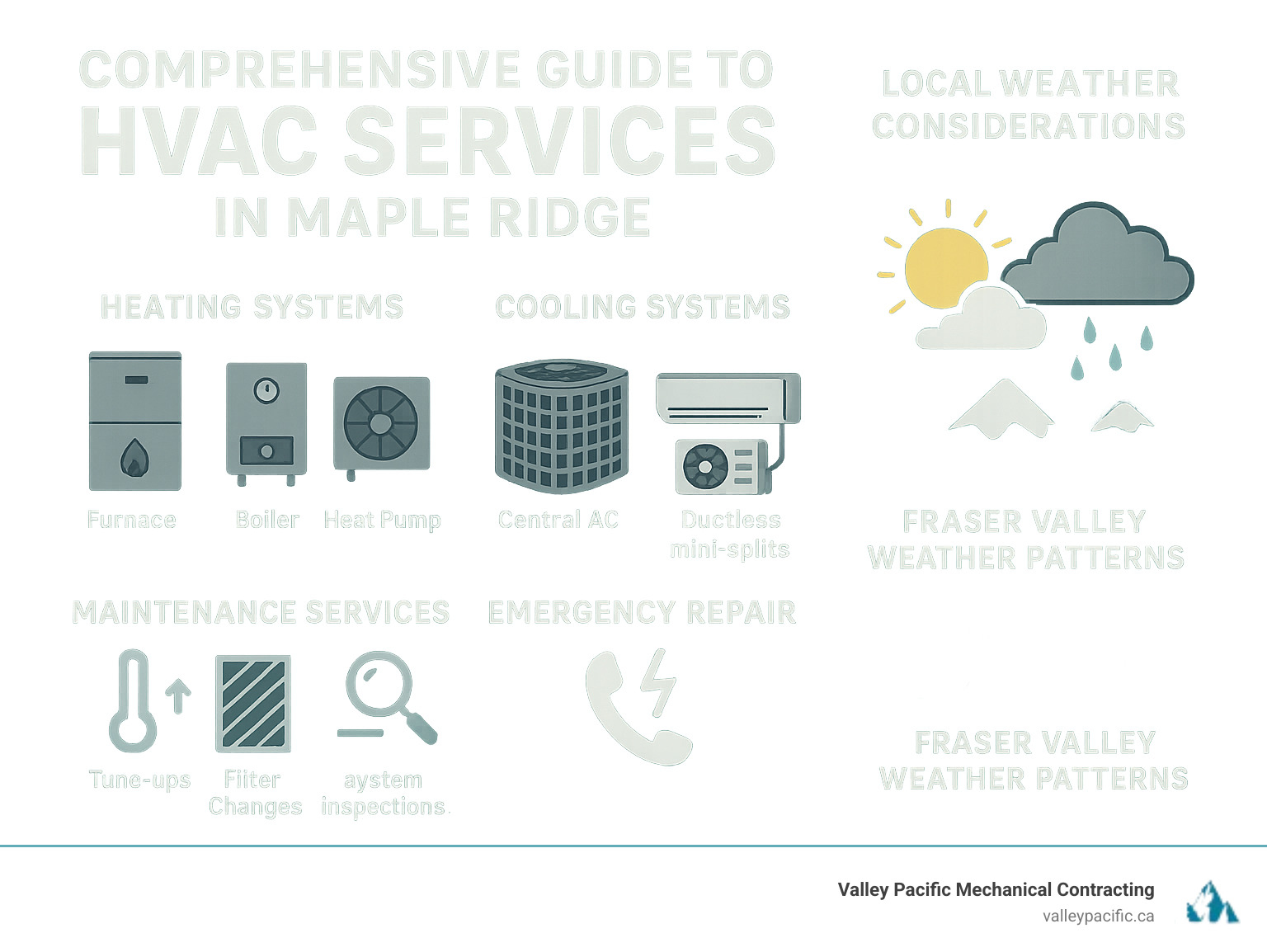
How Maple Ridge's Climate Impacts Your HVAC Needs
Living in Maple Ridge means your HVAC system faces a unique challenge that many other regions don't deal with - it never really gets a break. Our beautiful Fraser Valley location gives us mild, wet winters that can make your home feel surprisingly chilly, especially when that dampness creeps in. Then summer arrives with warm, dry conditions that can push temperatures high enough to make air conditioning feel like a lifesaver rather than a luxury.
This year-round demand puts real stress on your heating and cooling equipment. During those soggy February days, your heating system works overtime to combat not just the cold, but the humidity that makes everything feel more uncomfortable. Come July, your air conditioner is battling dry heat that seems to bake right through your walls.
What makes Maple Ridge's climate particularly challenging is how it affects system efficiency. High winter humidity can strain heating components, while our dry summer heat pushes cooling systems harder than they'd work in more moderate climates. Without proper maintenance and the right equipment, you'll notice decreased comfort and those dreaded higher energy bills.
The good news? Understanding these local conditions helps us provide hvac services Maple Ridge homeowners actually need, not just generic solutions that work "somewhere else."

Suitable HVAC Systems for Local Homes
Given our unique Fraser Valley climate, certain systems just make more sense for Maple Ridge homes. Heat pumps are absolutely fantastic for our area - they're like the Swiss Army knife of HVAC equipment. These versatile systems heat your home in winter by extracting warmth from outside air (yes, even when it feels freezing!), then flip the script in summer to keep you cool. It's this dual functionality that makes them so cost-effective year-round. For detailed information about maintaining these efficient systems, check out our heat pump services.
High-efficiency furnaces remain the reliable backbone for many local homes, especially during our coldest snaps or as part of a dual-fuel setup. Modern furnaces are engineered to squeeze every bit of warmth from their fuel while keeping energy consumption low - perfect for those damp winter months when you need consistent, powerful heating. Our comprehensive furnace services ensure your system delivers reliable warmth when you need it most.
For our warm, dry summers, a dependable air conditioner isn't just about comfort - it's about maintaining good indoor air quality too. Today's AC units don't just cool; they filter and dehumidify your air, creating a healthier home environment. Professional installation makes all the difference in performance, which is why our AC installation service focuses on getting your system right from day one.
Ductless mini-splits offer incredible flexibility, especially if you're dealing with an older home without existing ductwork or want to add comfort to a specific area. These systems let you control temperature room by room, so you're not wasting energy cooling the guest bedroom nobody's using. They're particularly popular for home additions, converted garages, or businesses that need targeted climate control.
Your Guide to Common HVAC Services in Maple Ridge
When it comes to keeping your Maple Ridge home comfortable year-round, there's more to consider than just your furnace and air conditioner. HVAC services Maple Ridge homeowners rely on include everything from emergency repairs on those unexpectedly cold nights to regular maintenance that prevents problems before they start.
Think of your home's comfort systems like a well-orchestrated team. Your heating keeps you cozy during those damp Fraser Valley winters, your cooling system provides relief during summer heat waves, and your ventilation ensures the air you breathe is clean and fresh. When one player isn't performing well, the whole team suffers - and so does your family's comfort.
We provide comprehensive services for both residential and commercial clients, understanding that every home and business has unique needs. Whether you need a quick repair, a complete system installation, or ongoing maintenance to keep everything running smoothly, our goal is to deliver that headache-free experience you deserve.
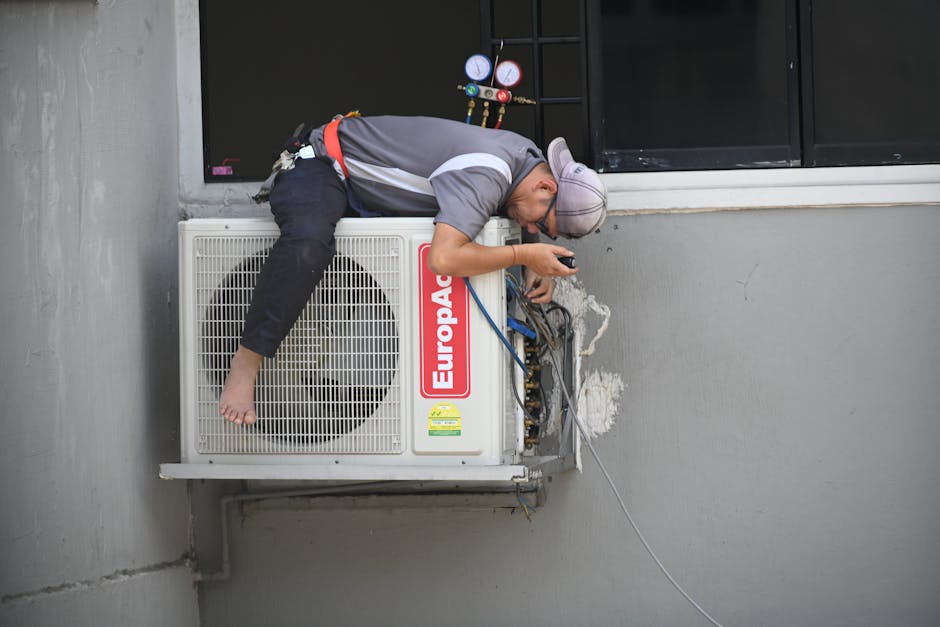
Heating System Services
Your heating system works hardest during Maple Ridge's mild but persistently damp winters. When temperatures drop and humidity rises, you need reliable warmth that doesn't quit on you when you need it most.
Furnace repair is often our most urgent service call. Nothing gets your attention quite like a furnace that stops working on the coldest night of the year. We diagnose everything from simple issues like dirty filters and thermostat problems to more complex electrical or mechanical failures. Our technicians understand that heating emergencies can't wait, which is why we offer prompt, reliable service to get your warmth restored quickly. For immediate assistance with heating problems, visit our Furnace Repair Maple Ridge BC page.
Furnace installation is about more than just swapping out old equipment. Whether you're replacing an aging, inefficient unit or installing heating in new construction, we help you choose the right size and type of furnace for your specific home. Proper installation ensures optimal performance, energy efficiency, and years of reliable service. Learn more about our installation process on our Furnace Installation Maple Ridge BC page.
Boiler repair requires specialized knowledge since these systems provide consistent, radiant heat through hot water or steam. When your boiler develops issues, our experienced technicians can diagnose and repair problems efficiently, restoring that comfortable, even warmth throughout your home. For detailed information on repairs, check out our Boiler Repair Maple Ridge BC page.
Heat pump maintenance keeps these versatile systems running efficiently for both heating and cooling seasons. Regular tune-ups include thorough inspections, cleaning, and adjustments that extend your system's lifespan while maintaining peak energy efficiency.
Cooling System Services
Maple Ridge summers can surprise you with their intensity. When those warm, dry days arrive, you want cooling systems that respond quickly and keep your home comfortable without breaking the bank on energy bills.
AC repair addresses those frustrating moments when your air conditioner isn't cooling effectively, starts making strange noises, or cycles on and off constantly. Our expert technicians quickly identify the root cause and provide efficient, lasting repairs that restore your comfort. Get help with your cooling issues on our AC Repair Maple Ridge BC page.
AC installation can transform your home's summer comfort and energy efficiency. We guide you through selecting a system that perfectly matches your home's size, layout, and cooling needs. Professional installation ensures your new system operates at peak performance from day one.
AC maintenance prevents those unexpected breakdowns that always seem to happen during heat waves. Our comprehensive tune-ups include cleaning coils, checking refrigerant levels, inspecting electrical components, and ensuring everything functions correctly. For complete cooling system care, visit our AC Service Maple Ridge BC page.
Heat pump services provide integrated heating and cooling solutions that are particularly well-suited to our climate. These efficient systems deliver reliable cooling throughout summer while preparing to switch seamlessly to heating mode when temperatures drop.
Other Essential Services
Beyond basic heating and cooling, modern home comfort involves smart technology, clean air, and integrated systems that work together seamlessly.
Smart thermostats bring your home into the 21st century with intelligent temperature control. These devices learn your family's preferences, optimize energy use automatically, and let you adjust settings remotely from your phone. The convenience and potential energy savings make them a popular upgrade. Learn how to modernize your home's climate control on our Smart Thermostats Maple Ridge BC page.
Indoor air quality improvements address the reality that indoor air can sometimes be more polluted than outdoor air. We offer solutions including advanced filtration systems, humidifiers, dehumidifiers, and ventilation upgrades that reduce allergens, dust, and other pollutants, creating a healthier living environment for your family.
Ventilation ensures proper fresh air circulation and prevents moisture buildup that can lead to mold and other air quality issues. We assess your home's specific ventilation needs and install or upgrade systems accordingly.
Plumbing services integrate naturally with many comfort systems since hot water tanks, gas lines for furnaces, and drainage systems all connect to your home's overall mechanical systems. We provide comprehensive plumbing solutions including toilet repair, drain cleaning, sink and faucet repair, water heater services, gas line installations, and sump pump services. This integrated approach means we can often address related issues efficiently during a single visit. Find out more about our comprehensive offerings on our Plumbing Services in Maple Ridge BC page.
Signs Your HVAC System Needs Professional Attention
Your HVAC system often gives warning signs before a small issue becomes a major breakdown. Paying attention to signals like unexplained high energy bills or reduced performance allows for simpler, less expensive fixes. Ignoring them can lead to a complete system failure when you need it most. Catching problems early is key to avoiding emergency repairs.

Telltale Signs for Repair or Replacement
Your HVAC system has several ways of telling you it needs attention:
- Strange noises like banging, rattling, or squealing mean something's loose, worn out, or struggling inside your system
- Unusual smells - burning odors suggest electrical problems, musty smells point to mold in your ducts, and that distinctive "rotten egg" smell means you need to evacuate immediately and call for emergency service
- Weak airflow from your vents or uneven air distribution between rooms
- Inconsistent temperatures where some rooms feel like saunas while others feel like refrigerators
- Frequent cycling when your system turns on and off constantly instead of running steady cycles
- System age of 15+ years - even well-maintained systems start showing their age and becoming less reliable
If you notice multiple symptoms, it's time to call for professional hvac services maple ridge residents trust.
When to Repair vs. When to Replace
Deciding whether to repair or replace your system depends on its age, the cost of the repair, and long-term efficiency.
Repair is often best for younger systems (under 10-15 years) with minor issues like a faulty thermostat or simple electrical problem. These fixes are usually affordable and extend the life of a well-maintained unit.
Replacement is the smarter option for older systems (15+ years) facing major component failures, such as a dead compressor or cracked heat exchanger. The cost of these repairs can be significant, and modern systems offer energy savings that help offset the investment.
Our team provides honest advice to help you make the best choice for your home and budget. We'll never push for a replacement if a simple repair will solve the problem. For expert guidance on your specific situation, visit our HVAC Repair Maple Ridge BC page to learn more about our diagnostic and repair services.
Choosing a Reliable HVAC Contractor in Maple Ridge
Finding the right HVAC contractor can feel overwhelming, but it doesn't have to be. When your furnace decides to quit on the coldest night of the year or your air conditioner gives up during a summer heatwave, you need someone you can trust completely. The right contractor isn't just about fixing what's broken - they're your partner in keeping your home comfortable, safe, and energy-efficient year-round.
Professional service makes all the difference. When an experienced technician works on your system, they follow strict safety standards and manufacturer specifications. This attention to detail protects your family's safety, extends your equipment's lifespan, and ensures everything works exactly as it should. A skilled contractor also spots potential problems before they become expensive emergencies.

Key Factors for Your hvac services maple ridge Provider
When you're evaluating contractors, some factors matter more than others. Licensing and certification should be your first checkpoint. Every technician who works on your system should be fully licensed and certified - this isn't just paperwork, it's proof they know what they're doing. Look for Red Seal HVAC certified technicians, which represents the gold standard in our industry. You can always verify licenses through Technical Safety BC to make sure everything checks out.
Insurance and bonding protects you from unexpected problems. If something goes wrong during a service call, proper insurance means you won't be left holding the bill. Any reputable contractor will gladly show you their insurance certificates.
Years of experience tells you a lot about a company's track record. Here in the Fraser Valley, established contractors understand our unique climate challenges. They've seen it all - from furnaces struggling with our damp winters to air conditioners working overtime during those surprise heat waves. This local knowledge makes a huge difference in the quality of service you receive.
Positive customer reviews give you the real story. When you read reviews, look for patterns. Do customers consistently mention friendly service, clear communication, and problems solved the first time? These details matter more than flashy marketing promises.
What Sets a Great Contractor Apart
Some contractors do the bare minimum, while others go above and beyond. 24/7 emergency service separates the good from the great. HVAC emergencies don't wait for business hours, and neither should your contractor. When your heat goes out at midnight in February, you need someone who answers the phone and shows up ready to help.
Upfront communication means no surprises. A great contractor explains what's wrong, what needs to be done, and what it will involve before any work starts. They keep you informed throughout the process and even send photos of the technician who's coming to your home, so you know exactly who to expect.
Satisfaction guarantees show a contractor stands behind their work. Programs like the Daikin Comfort Promise demonstrate real confidence in service quality. If something isn't right, they'll make it right - no arguments, no excuses.
Expertise with local climate makes practical sense. Maple Ridge's mild, wet winters and warm, dry summers create specific challenges for HVAC equipment. A contractor who understands these conditions can recommend the best systems for your home and provide maintenance advice that actually works in our climate.
Navigating Rebates and Incentives
Energy-efficient HVAC upgrades often qualify for government rebates and incentives, which can significantly reduce your upfront investment. These programs encourage homeowners to choose more sustainable heating and cooling solutions, making comfort and efficiency more affordable.
The best contractors stay current on available programs and can guide you through the application process. FortisBC rebates are one example of how upgrading to high-efficiency equipment can put money back in your pocket. A knowledgeable contractor will identify which upgrades qualify for rebates and handle the paperwork, ensuring you receive every benefit you're entitled to. This support transforms what could be a confusing process into a straightforward path to savings.
Frequently Asked Questions about HVAC in Maple Ridge
As trusted hvac services Maple Ridge providers, we hear the same questions from homeowners time and again. It's completely natural to wonder about your heating and cooling system - after all, it's one of the most important (and expensive) systems in your home! Let's tackle the most common concerns we encounter.
What are the benefits of regular HVAC maintenance?
Think of HVAC maintenance like taking your car in for regular oil changes - it's that simple preventive step that keeps everything running smoothly. When you invest in regular maintenance, you're actually preventing breakdowns before they happen. Our seasonal tune-ups catch those small issues that could turn into major headaches (and major expenses) if left alone.
Regular maintenance also extends your system's lifespan significantly. A well-cared-for air conditioning unit can keep you cool for 15-20 years, while a neglected one might give up after just 8-10 years. That's a pretty expensive difference!
Your wallet will thank you for another reason too - improved energy efficiency. A clean, well-tuned system doesn't have to work as hard to heat or cool your home, which means lower energy bills month after month. We've seen homeowners save hundreds of dollars annually just by keeping up with basic maintenance.
Don't forget about maintaining air quality either. During maintenance visits, we clean filters and coils, removing dust, allergens, and other nasties that can circulate through your home. This is especially important in Maple Ridge, where our damp winters can encourage mold growth in neglected systems.
Most importantly, regular maintenance ensures safety. For gas furnaces and boilers, this isn't just about comfort - it's about protecting your family from potential carbon monoxide leaks and other safety hazards.
What are the most common HVAC problems?
After 30+ years in the business, we've seen it all - and honestly, most problems are pretty predictable. Clogged filters top the list by a mile. It's amazing how such a simple, inexpensive component can cause so much trouble when ignored. A dirty filter restricts airflow, makes your system work harder, and can even cause it to overheat and shut down.
Thermostat malfunctions come in second. Sometimes it's as simple as dead batteries, but other times the thermostat itself goes haywire, leaving you with rooms that are too hot, too cold, or a system that won't turn on at all.
For air conditioners and heat pumps, refrigerant leaks are a common culprit behind poor cooling performance. Low refrigerant doesn't just mean less cooling - it can actually damage your compressor, turning a moderate repair into a major replacement.
Electrical issues pop up regularly too, from faulty capacitors to tripped breakers. These problems can prevent your system from starting or cause it to run erratically. Finally, drainage problems - especially clogged condensate drains - can lead to water damage in your home if not addressed quickly.
What should I do if my HVAC system stops working?
Before you panic (we know, easier said than done when it's the hottest day of summer or coldest night of winter), try these simple steps. First, check your thermostat settings - make sure it's set to the right mode and temperature. If it uses batteries, pop in fresh ones. You'd be surprised how often this solves the problem!
Next, inspect your circuit breaker. Head to your electrical panel and look for any tripped breakers. If you find one, flip it completely off, then back on. Sometimes a power surge or overload can trip the breaker, cutting power to your system.
Take a look at your filter too. A severely clogged filter can actually cause your system to shut down as a safety measure. If it looks like it's seen better days, replace it right away.
For air conditioners and heat pumps, check your outdoor unit. Make sure it's not buried under leaves, branches, or other debris, and that the fan can spin freely.
If none of these steps bring your system back to life, that's when it's time to call us for professional diagnosis. We're available 24/7 because we know HVAC emergencies don't wait for convenient times. Our experienced technicians can quickly identify what's wrong and get your comfort restored - that's our promise to provide a truly headache-free experience.
Your Partner for Year-Round Comfort in Maple Ridge
Living comfortably in Maple Ridge year-round doesn't have to be a constant worry about whether your heating will work on the coldest winter night or if your air conditioner will keep up during those unexpected summer heatwaves. The key takeaways we've covered - from understanding how our unique Fraser Valley climate affects your HVAC system to recognizing the early warning signs of trouble - all point to one essential truth: proactive HVAC care makes all the difference.
When you stay ahead of maintenance needs, choose the right systems for our local weather patterns, and work with experienced professionals who understand Maple Ridge homes, you're not just maintaining equipment - you're investing in your family's comfort and peace of mind. Regular tune-ups catch small issues before they become expensive emergencies, and having a trusted contractor means you're never left wondering who to call when something goes wrong.
The importance of choosing a trusted partner for your hvac services maple ridge needs cannot be overstated. Your HVAC system is one of the most significant investments in your home, and it deserves care from professionals who understand both the technology and the local conditions that affect its performance.
Finding the Best hvac services maple ridge
At Valley Pacific Mechanical Contracting, we've built our reputation on delivering exactly what Maple Ridge homeowners need most: a completely headache-free experience when it comes to heating, cooling, and indoor air quality. With over 30 years of expertise in the HVAC industry, we've seen every type of system, weather challenge, and home comfort situation our local climate can throw at us.
What sets us apart isn't just our technical knowledge - it's our commitment to being there when you need us most. Our 24/7 emergency availability means that whether your furnace decides to quit on a Sunday evening in January or your air conditioner stops working during the hottest day of summer, help is just a phone call away.
We stand behind every job with our Daikin Comfort Promise, ensuring that if you're not completely satisfied with our work, we'll make it right. This isn't just about fixing equipment - it's about ensuring your home remains the comfortable sanctuary your family deserves, regardless of what's happening with the weather outside.
Ready to experience the difference of working with a team that truly understands Maple Ridge homes and puts your comfort first? Don't wait for an emergency to find out why so many of your neighbors trust us with their home comfort needs. Book your AC installation today and find what a truly headache-free HVAC experience looks like.
Why Mini Split Installation Has Become a Popular DIY Project
Mini split installation is gaining popularity among homeowners who want efficient heating and cooling without the complexity of ductwork. These ductless systems offer zone-controlled comfort and can significantly reduce energy bills compared to traditional HVAC systems.
Quick Answer for Mini Split Installation:
- Plan your system - Choose single-zone or multi-zone based on your needs
- Mount the indoor unit - Secure the mounting bracket to wall studs at least 6 feet high
- Install the outdoor unit - Place on level concrete pad or wall bracket with proper clearance
- Drill the line set hole - Create a 3.5" hole angled slightly downward for drainage
- Connect the components - Run refrigerant lines, electrical wiring, and drain tubing
- Test and seal - Check for leaks, release refrigerant, and seal wall penetration
The appeal of DIY mini split installation is clear from the research: while professional installation can be expensive, DIY systems come pre-charged with refrigerant and include quick-connect line sets. As one experienced installer noted, "A mini split is 2 hours with a helper max" for the basic installation.
However, most mini split failures are due to installation errors, making proper technique crucial. Indoor units typically weigh 40-50 pounds, while outdoor condensers weigh around 80 pounds, requiring careful handling and proper support.
The key advantage of mini splits is their simplicity compared to traditional systems. They require only a small hole through your wall instead of extensive ductwork, and modern DIY kits eliminate the need for professional refrigerant charging.
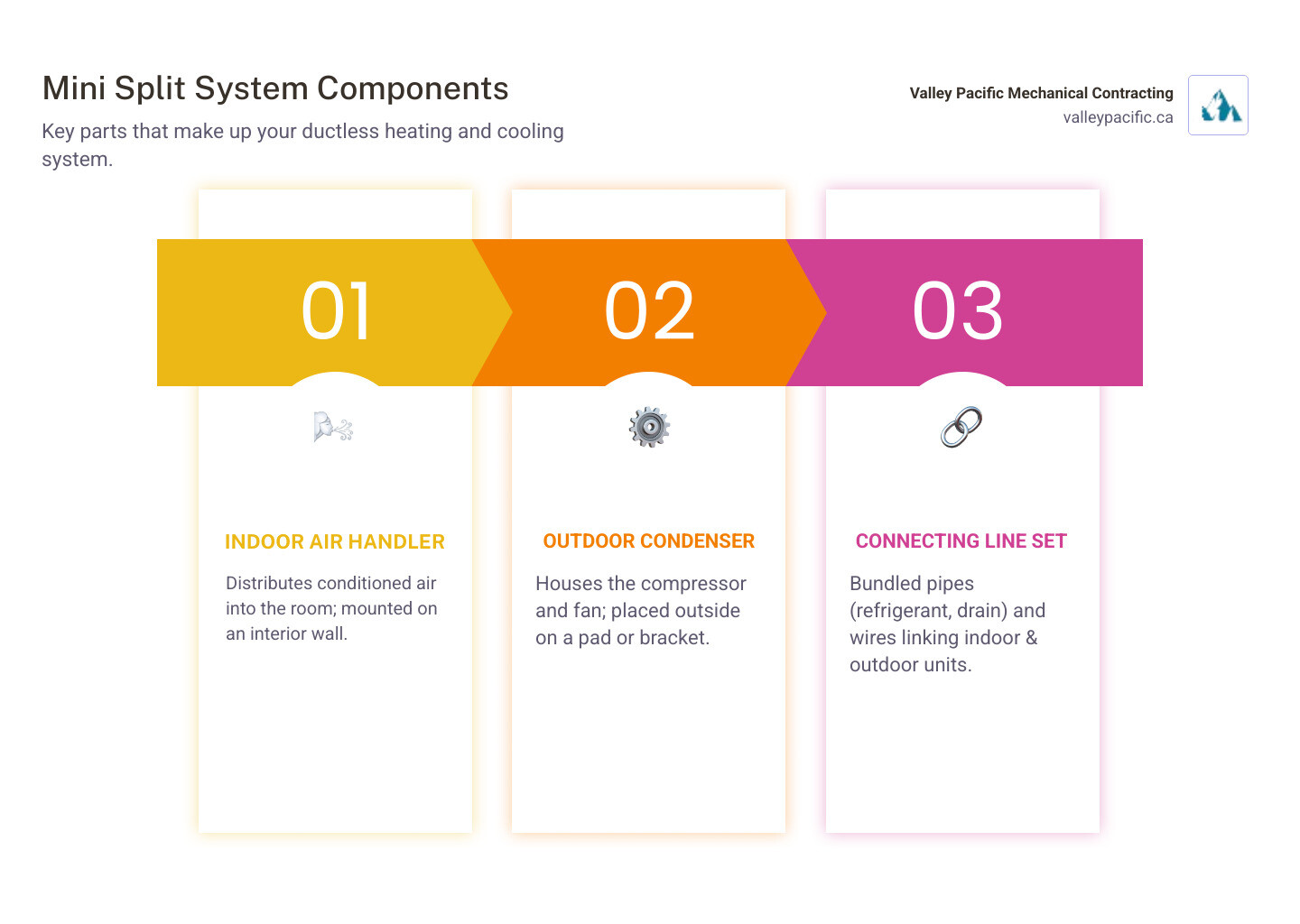
Preparation: Planning Your Installation
Before starting your mini split installation, careful planning is key. This ensures you choose the right system and prepare your space for a smooth setup.
Mini-split systems come in a few varieties, primarily categorized by how many indoor units they support:
- Single-zone systems: These are designed to heat or cool one specific area, like a single room, an addition, or a garage. They consist of one indoor air handler connected to one outdoor condenser unit. These are generally the simplest for DIY mini split installation.
- Multi-zone systems: These systems allow you to connect two or more indoor air handlers to a single outdoor condenser. This is ideal for controlling temperatures independently in different rooms or zones of your home. While more complex, they offer incredible flexibility.
Next, consider sizing. It’s crucial to select a unit with the correct British Thermal Unit (BTU) output for your space. An undersized unit won't be effective, while an oversized one can cycle too frequently, leading to inefficiency and discomfort. We recommend checking out our guide on What Size AC Unit Does Home Need for detailed calculations.
Choosing the right locations for your indoor and outdoor units is equally important for performance and aesthetics.
- Indoor Unit Placement: We typically recommend mounting the indoor unit high on a wall, ideally at least six feet from the floor or about 2.1 meters. This allows for optimal air distribution throughout the room. Try to pick an exterior wall, as this simplifies routing the line set outside. Avoid areas with direct sunlight or other heat sources that could interfere with the unit's temperature sensing. Ensure there's adequate clearance (6-12 inches) on each side and from the ceiling for proper airflow and maintenance. For more insights, refer to our tips on Best Locations for Heat Pump Placement.
- Outdoor Unit Placement: The outdoor condenser unit needs a spot with good airflow, ideally with at least 12 inches of clearance on all sides. Placing it on the east or north side of your home can maximize cooling efficiency by keeping it out of direct afternoon sun. Keep it away from bedrooms or quiet areas to minimize noise, as the unit weighs about 80 pounds and can vibrate. It should be on a level surface, often a concrete pad, to ensure stability.
Safety is paramount during any mini split installation. Always turn off power to the work area before dealing with electrical connections. If you're not comfortable with electrical work, hire a licensed electrician. Lifting heavy components like the 40-50 lb indoor unit and 80 lb outdoor unit requires care, and it's always safer with a helper. Wear gloves and safety glasses to protect yourself.
Essential Tools and Materials
Having the right tools on hand is key for a successful mini split installation. Here’s what you'll need:
- Drill: A powerful drill is essential for various tasks, including drilling pilot holes and the main line set hole.
- Hole Saw (3.5"): This specific size is commonly needed for drilling the hole through your wall to accommodate the line set.
- Level: Crucial for ensuring both your indoor and outdoor units are perfectly level, which is vital for proper drainage and operation. A magnetic I-beam level can be very helpful.
- Stud Finder: To locate wall studs for securely mounting the indoor unit's bracket.
- Wrenches (including Torque Wrench): You'll need adjustable wrenches for tightening connections. A torque wrench is critical for ensuring refrigerant line connections are tightened to the manufacturer's precise specifications, preventing leaks.
- Screwdrivers: For various fasteners.
- Utility Knife: For cutting insulation, tape, and other materials.
- Caulk/Sealant: To seal the wall penetration after running the line set, preventing drafts and moisture intrusion. Geocell tri-polymer sealant or low-pressure foaming sealant are good options.
- Line Set Cover: These protective channels cover the exterior refrigerant lines and electrical wiring, providing a clean, professional finish and protecting the lines from weather and damage.
- Additional Items: You might also need electrical tape, PVC pipe (for wall sleeve), a concrete pad (if not wall-mounting the outdoor unit), and rubber pads (to reduce outdoor unit vibration).
The Step-by-Step Mini Split Installation Guide
Now that we've planned and gathered our tools, let's get to the hands-on part of your mini split installation. This section provides a detailed walkthrough for the physical placement and mounting of the main components.
Mounting the Indoor Air Handler
The indoor air handler is the part of your mini-split system that circulates conditioned air inside your home. Proper mounting is crucial for its performance and to prevent issues like water leaks.
- Locate the Mounting Plate: Your indoor unit will come with a metal mounting plate. This plate is what you'll attach to the wall first.
- Choose Your Spot: We've already picked the ideal location during planning (high on an exterior wall, away from heat sources, with proper clearances). Now, we need to ensure the wall itself is suitable.
- Locate Wall Studs: Use your stud finder to locate the wall studs. It's best practice to secure the mounting bracket directly to at least two studs for maximum stability. If hitting studs isn't possible, use heavy-duty hollow drywall anchors rated for the weight of the unit, but direct stud mounting is always preferred.
- Position and Level the Bracket: Hold the mounting plate against the wall in your chosen spot. Use your level to ensure it is perfectly horizontal. An air handler mounted out of level will not drain properly, leading to potential leaks and malfunction. Mark the drill points through the holes in the bracket.
- Secure the Bracket: Drill pilot holes at your marked points. Then, use appropriate screws (e.g., cabinet screws or lag screws with washers) to securely fasten the mounting plate to the wall. Double-check with your level after securing it.
- Quick tip: The indoor air-handling unit typically weighs between 40-50 lbs, so a secure mount is essential!
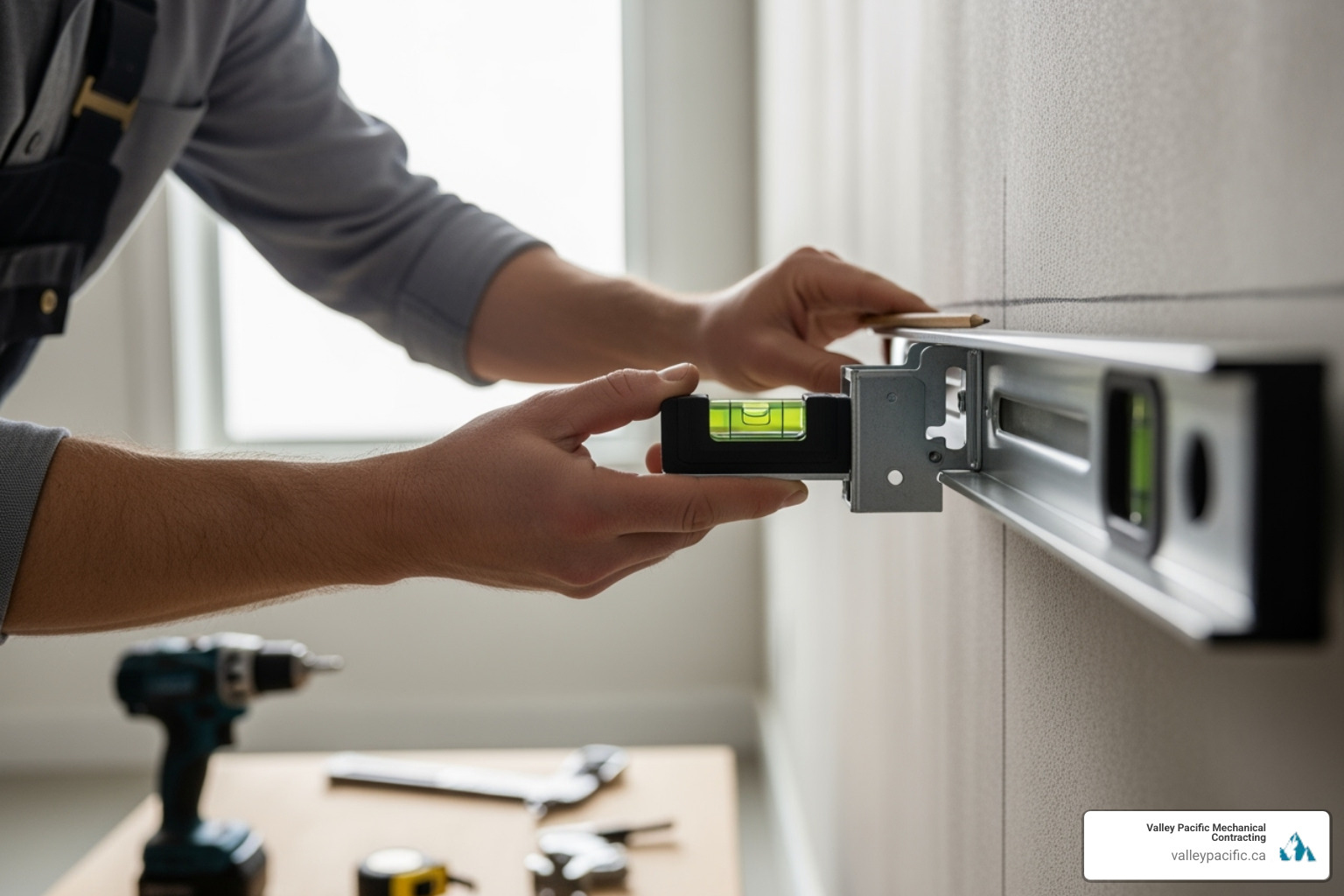
Drilling the Line Set Hole
This step creates the pathway for the refrigerant lines, electrical wiring, and condensate drain line to pass from the indoor unit to the outdoor unit. This is often described as the most stressful part of the DIY process, but with care, it's manageable.
- Choose the Spot: On the mounting plate, there will be a designated area or template indicating where the line set should exit the wall. This is usually behind the indoor unit.
- Drill a Pilot Hole: From inside, drill a small pilot hole through the wall at the center of your chosen line set exit point. This will help you verify the exact location on the outside and check for any hidden obstructions.
- Check for Obstructions: Before drilling the larger hole, use a metal probe or even a bent coat hanger through your pilot hole to check for any wires, pipes, or ducts inside the wall cavity. You definitely don't want to hit anything crucial!
- Using a Hole Saw: Attach your 3.5" hole saw bit to your drill. From the inside, carefully drill the main hole through your interior wall.
- Angling Downward for Drainage: Critically, drill the hole at a slight downward angle (e.g., 2-3 degrees) from the inside to the outside. This ensures proper gravity drainage for the condensate line and prevents water from entering your wall.
- Drill Exterior: Once you're through the interior wall, cut any insulation, and continue drilling through the exterior sheathing. If you have delicate siding, you can drill a smaller pilot hole from the inside out, then use the larger hole saw from the outside in to prevent cracking or splintering the siding. Drill in reverse initially to score the surface, then switch to forward.
- Wall Sleeve Installation (Optional but Recommended): Some kits include a plastic wall sleeve, or you can use a section of 2" PVC pipe. Insert this sleeve into the drilled hole. This protects the line set and provides a clean conduit.
Installing the Outdoor Condenser
The outdoor condenser unit is the powerhouse of your mini-split system. Proper placement and secure installation are vital for its longevity and efficient operation.
- Ground Pad vs. Wall Bracket: You have two main options for mounting the outdoor unit:
- Concrete Pad: The most common method is to place the unit on a dedicated concrete pad. This ensures a stable, level surface. You can purchase a pre-made pad or pour one yourself. If placing on the ground, ensure it's liftd (e.g., on concrete blocks) to prevent snow accumulation from blocking airflow.
- Wall Bracket: For areas with limited ground space or heavy snowfall, a wall-mounted bracket is an excellent alternative. We recommend using a sturdy bracket like the Optional Condenser Mounting Bracket. These brackets are designed to support the unit's weight and keep it off the ground.
- Ensuring a Level Surface: Regardless of whether you choose a pad or a bracket, the outdoor unit must be perfectly level. Use your level to confirm. This is important for the compressor's operation and proper oil return.
- Clearance Requirements: Ensure adequate clearance around the unit for proper airflow. Most manufacturers recommend at least 12 inches of clearance on all sides. For wall-mounted units, some, like MRCOOL, only require 6 inches of clearance behind the unit, but always check your specific model's manual. Insufficient clearance can cause the unit to overheat and may void your warranty.
- Mount the Unit: Carefully lift the outdoor unit onto the pad or bracket. This unit weighs about 80 pounds, so get a helper!
- Securing the Unit: Once positioned, secure the unit. If on a pad, use anchor bolts if recommended by the manufacturer. If on a wall bracket, fasten it securely to the bracket. Always use rubber pads under the unit to minimize vibration and noise.
Making the Connections and Finishing Up
With the indoor and outdoor units securely in place, the next crucial phase of your mini split installation involves connecting them. This section covers connecting the two units and finalizing the installation for a clean, professional look.
Running and Connecting the Line Set
The line set is the lifeline of your mini-split system, carrying refrigerant, electrical signals, and condensate drain water between the indoor and outdoor units. Most DIY-friendly mini-splits come with pre-charged quick-connect line sets, simplifying this step significantly.
- Bundling Lines: Take the refrigerant lines, control wires, and condensate drain tubing. Bundle them together neatly using electrical tape. Ensure the condensate drain line is at the bottom of the bundle to allow for proper gravity drainage.
- Feeding Lines Through the Wall: From inside, carefully feed the bundled line set through the hole you drilled earlier. Have a helper on the outside to gently pull and guide the lines. Ensure the plastic collar or wall sleeve stays in place within the hole.
- Bending Tubing Carefully: The refrigerant lines are copper and can kink if bent too sharply. Bend them slowly and gently to guide them from the indoor unit's connection points through the wall and down towards the outdoor unit. Avoid sharp 90-degree bends. If you have excess line set length (common with pre-charged kits), coil it horizontally next to the outdoor unit. Do not cut pre-charged lines unless you are a licensed HVAC professional, as this will release refrigerant and require professional vacuuming and charging.
- Connecting to Indoor Unit: Inside, connect the refrigerant lines, control wires, and condensate drain to their respective ports on the back of the indoor unit. Follow your manufacturer's specific instructions for these connections.
- Connecting to Outdoor Unit: Outside, connect the other end of the line set to the outdoor condenser unit. For quick-connect systems, this usually involves aligning the connectors and tightening them. For traditional flare connections (less common in DIY kits), you'll need to deburr the copper tubing, create a perfect flare, and then connect the lines.
- Using a Torque Wrench for Flare Nuts: If your system uses flare nuts, it's absolutely critical to tighten them to the manufacturer's specified torque values using a torque wrench. Under-tightening can lead to refrigerant leaks, while over-tightening can damage the flare or the valve, also causing leaks. For example, some common torque specifications are 11.8 ft/lbs for 1/4” tubing and 19 ft/lbs for 3/8” tubing.
- Final Indoor Unit Placement: Once the connections are made, carefully lift the indoor unit onto its mounting bracket. It should click or lock securely into place. Ensure it sits flush against the wall and is still level.
For more general guidance on connecting components, you can also refer to resources like How to Install a Mini-Split Air Conditioner.
Making the Electrical and Drain Connections
These connections are vital for your system's operation and safety.
- Safety Warning: Turn Off Power! Before touching any electrical wiring, ensure the power to the circuit you're working on is completely off at your home's main breaker panel.
- Connecting Control Wires: These low-voltage wires transmit signals between your indoor and outdoor units. Connect them according to the wiring diagram in your mini-split's manual. There will typically be labeled terminals on both units.
- Connecting Power Wires: Most mini-split systems require a dedicated 20-amp circuit. This means the unit needs its own circuit breaker in your electrical panel and a dedicated line running to the outdoor unit. For safety and compliance with local electrical codes, we strongly recommend hiring a licensed electrician for this step if you are not qualified. Improper electrical work is dangerous and can void warranties or lead to system failure.
- Connecting the Condensate Drain Line: The indoor unit produces condensation (water) during operation. The drain line carries this water away. Connect the drain line from the indoor unit, ensuring it has a continuous downward slope to allow gravity to drain the water away from your home's foundation. It should terminate in an appropriate drainage point, like a French drain, a designated condensate drain, or away from the house. If your indoor unit is not on an exterior wall or cannot use gravity drainage, you may need a condensate removal pump.
Testing, Sealing, and Finishing Touches
We're almost there! These final steps ensure your system is working correctly, is sealed against the elements, and looks professionally installed.
- Leak Testing (Refrigerant Lines): Even with pre-charged systems, it's wise to check for leaks at all refrigerant line connections. Mix a solution of soapy water (or use a specialized bubble leak detector like 'Big Blu'). Spray it generously over all connection points on both the indoor and outdoor units. If you see any bubbles forming, you have a leak. Tighten the connection slightly and re-test until no bubbles appear.
- Releasing Refrigerant: For DIY pre-charged systems, this involves opening the service valves on the outdoor unit. Use a hex wrench to slowly turn the valves counter-clockwise until they are fully open. You might hear a slight hiss as the refrigerant equalizes pressure throughout the system.
- Power Up and Test: Once everything is connected and sealed, turn the power back on at the breaker panel. Power up your mini-split system. Test both heating and cooling functions to ensure it's operating correctly. Check the airflow, listen for unusual noises, and verify that the remote control and any Wi-Fi features are working.
- Sealing the Wall Penetration: Go back to the hole you drilled through the wall. From the outside, use caulk, sealant, or low-pressure foaming sealant to thoroughly seal around the line set where it exits the wall. This prevents air leaks, moisture intrusion, and pest entry. If you used a wall sleeve, seal around the sleeve as well.
- Installing a Line Set Cover: For a clean, protected finish, install a decorative Line Set Cover over the exterior refrigerant lines, electrical wiring, and drain line. These covers come in sections and can be screwed to your siding, protecting the lines from UV damage and physical impact. They are often paintable to match your home's exterior.
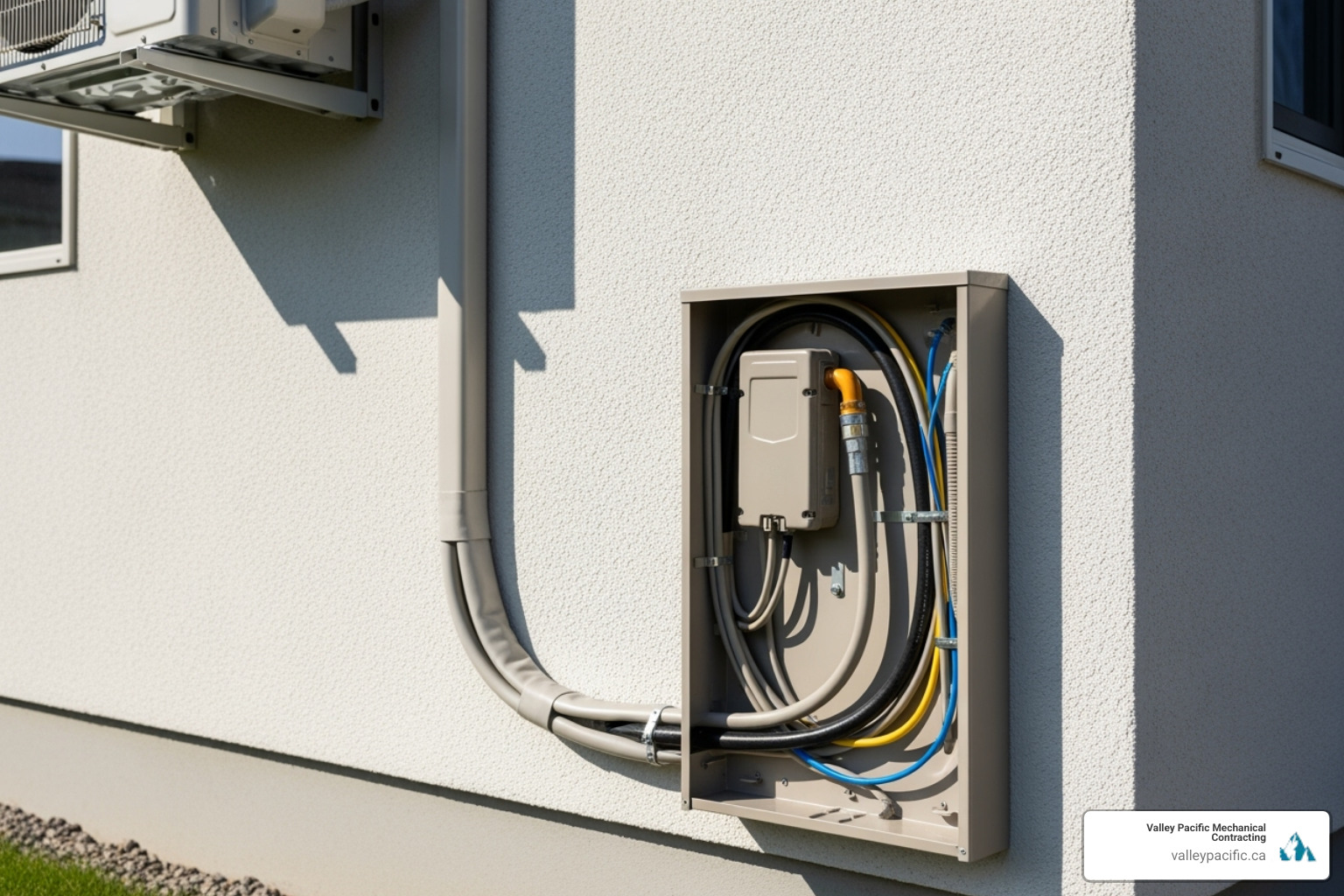
DIY Pitfalls and When to Hire a Professional
While the appeal of saving money on mini split installation by doing it yourself is strong, it's important to be aware of the potential challenges and when professional help is truly advisable.
| Feature | DIY Installation | Professional Installation |
|---|---|---|
| Warranty | Often voided if not installed by licensed professional | Typically maintained; provides peace of mind |
| Safety | Risks of electrical shock, refrigerant burns, injury | Ensured by trained technicians and proper equipment |
| Time | Can take a weekend or more for a handy homeowner | Usually completed in a few hours by experienced pros |
| Expertise | Requires significant research and attention to detail | Guaranteed by certified HVAC technicians |
| Tools | Requires purchase/rental of specialized tools | Technicians arrive with all necessary specialized tools |
| Permits | Homeowner responsible for obtaining permits/inspections | Professional handles necessary permits and inspections |
| Performance | Risk of reduced efficiency or early failure | Optimized performance and longevity |
Common DIY Mistakes
We've seen it all, and many mini-split failures stem from common DIY errors:
- Kinked Lines: Bending the copper refrigerant lines too sharply can cause kinks, restricting refrigerant flow and severely impacting performance. This damage is often irreparable without replacing the entire line set.
- Refrigerant Leaks: This is a big one. Improperly tightened flare connections (too loose or too tight), damaged flares, or incorrect vacuuming procedures (for non-DIY units) lead to refrigerant leaks. Refrigerant loss means your unit won't cool or heat effectively and can be harmful to the environment. Releasing refrigerant into the atmosphere can severely burn your skin.
- Improper Electrical Work: Incorrect wiring can damage the unit, pose fire hazards, or lead to electrical shock. Mini-splits require a dedicated circuit, and if you're not a licensed electrician, this step is best left to one.
- Improper Drainage: If the indoor unit isn't level or the drain line doesn't have a continuous downward slope, water can back up, leading to leaks inside your home.
- Poor Unit Placement: Ignoring clearance requirements for the outdoor unit can lead to overheating and reduced efficiency.
Warranty Considerations
This is a critical point. While DIY mini-split systems like MRCOOL are designed for self-installation, some manufacturers, even MRCOOL, may only honor their full warranty if the product was professionally installed by a licensed HVAC contractor. Always check the warranty terms before starting your mini split installation.
Benefits of Professional Service
When is it advisable to hire a professional?
- Complex Installations: For multi-zone systems, or if your home has unique structural challenges, a professional installation ensures all components are correctly integrated.
- Peace of Mind: Knowing your system is installed correctly, safely, and efficiently by experts provides invaluable peace of mind. Professionals ensure peak performance and longevity.
- Warranty Protection: As discussed, professional installation often ensures your manufacturer's warranty remains valid.
- Safety and Code Compliance: Licensed professionals are familiar with local building codes, electrical codes, and safety regulations, ensuring your installation is compliant and safe.
- Refrigerant Handling: For non-DIY pre-charged units, professionals have the specialized equipment to vacuum the lines and charge the system correctly, which is crucial for efficiency and avoiding leaks.
If you notice issues like unusual noises or poor performance after installation, these could be Signs your heat pump needs repair and a professional should be consulted.
Ongoing System Maintenance
Once your mini-split is installed, whether by you or a professional, regular maintenance is key to its efficiency and lifespan.
- Cleaning Air Filters: We recommend cleaning or replacing your indoor unit's air filters monthly, especially during peak usage seasons. Dirty filters restrict airflow, reduce efficiency, and can lead to system strain.
- Clearing Debris from Outdoor Unit: Keep the outdoor condenser unit clear of leaves, grass clippings, snow, and other debris. Obstructions can hinder airflow and reduce efficiency.
- Checking for Unusual Noises: Pay attention to any new or unusual sounds coming from either unit. These can be early indicators of a problem.
- Scheduling Annual Service: Just like a car, your mini-split benefits from professional tune-ups. We offer Comprehensive Heat Pump Service Plans that ensure your system is running optimally. Our experts can catch minor issues before they become major problems. For more tips on keeping your system in top shape, check out our Seasonal Heat Pump Maintenance Tips.
Conclusion
Starting on a DIY mini split installation can be a rewarding project, offering the satisfaction of personal accomplishment and the immediate benefits of improved home comfort and energy efficiency. We've walked through the planning, mounting, connecting, and finishing touches, highlighting the critical steps and common pitfalls.
While modern DIY mini-splits have made the process more accessible, it's clear that attention to detail, adherence to safety protocols, and understanding the system's requirements are paramount. The ability to control individual zones, eliminate bulky ductwork, and enjoy significant energy savings makes mini-splits an excellent choice for many homeowners.
However, for a truly guaranteed 'headache-free' experience and to protect your significant investment, professional installation remains the best choice. Our team at Valley Pacific Mechanical Contracting brings over 30 years of expertise to every mini split installation in the Lower Mainland, including Langley BC, Pitt Meadows BC, Maple Ridge BC, and Mission BC. We offer 24/7 emergency service and are committed to the Daikin Comfort Promise, ensuring your system is installed correctly and efficiently from day one.
If you're considering a mini-split system and prefer the peace of mind that comes with expert service, don't hesitate to reach out. We're here to help you achieve optimal home comfort. Learn more about our services or schedule a consultation for Heat Pump Installation Langley BC.
Why Exhaust Fan Issues Affect Every Homeowner
Exhaust fan repair is one of those household tasks that can seem intimidating, but many common problems have surprisingly simple fixes. Whether you're dealing with a noisy bathroom fan that sounds like a freight train or a kitchen exhaust that barely moves air, these issues are more than just minor annoyances.
Common exhaust fan problems homeowners face:
- Noisy operation - grinding, rattling, or humming sounds
- Poor ventilation - steam not clearing, weak airflow
- Electrical issues - fan won't turn on or runs intermittently
- Visible buildup - dust, grime, and debris accumulation
- Vibrations - loose components causing movement
Your home's exhaust fans play a crucial role in maintaining healthy indoor air quality. They remove moisture from bathrooms, eliminate cooking odors from kitchens, and prevent the buildup of harmful pollutants. When these systems malfunction, the effects ripple through your entire living space.
Without proper ventilation, you'll likely experience:
- Foggy mirrors that won't clear
- Lingering odors throughout the house
- Mold and mildew growth
- Peeling paint and wallpaper
- Higher humidity levels
Research shows that bathroom fans typically last 5 to 10 years, but poor maintenance can shorten their lifespan significantly. The good news? Many exhaust fan problems stem from simple issues like dust buildup, loose screws, or clogged airways - all things you can address yourself.
Before you call a professional, there are several DIY fixes that can restore your exhaust fan's performance and save you money. With basic tools and a safety-first approach, you can tackle the most common exhaust fan repairs in under an hour.
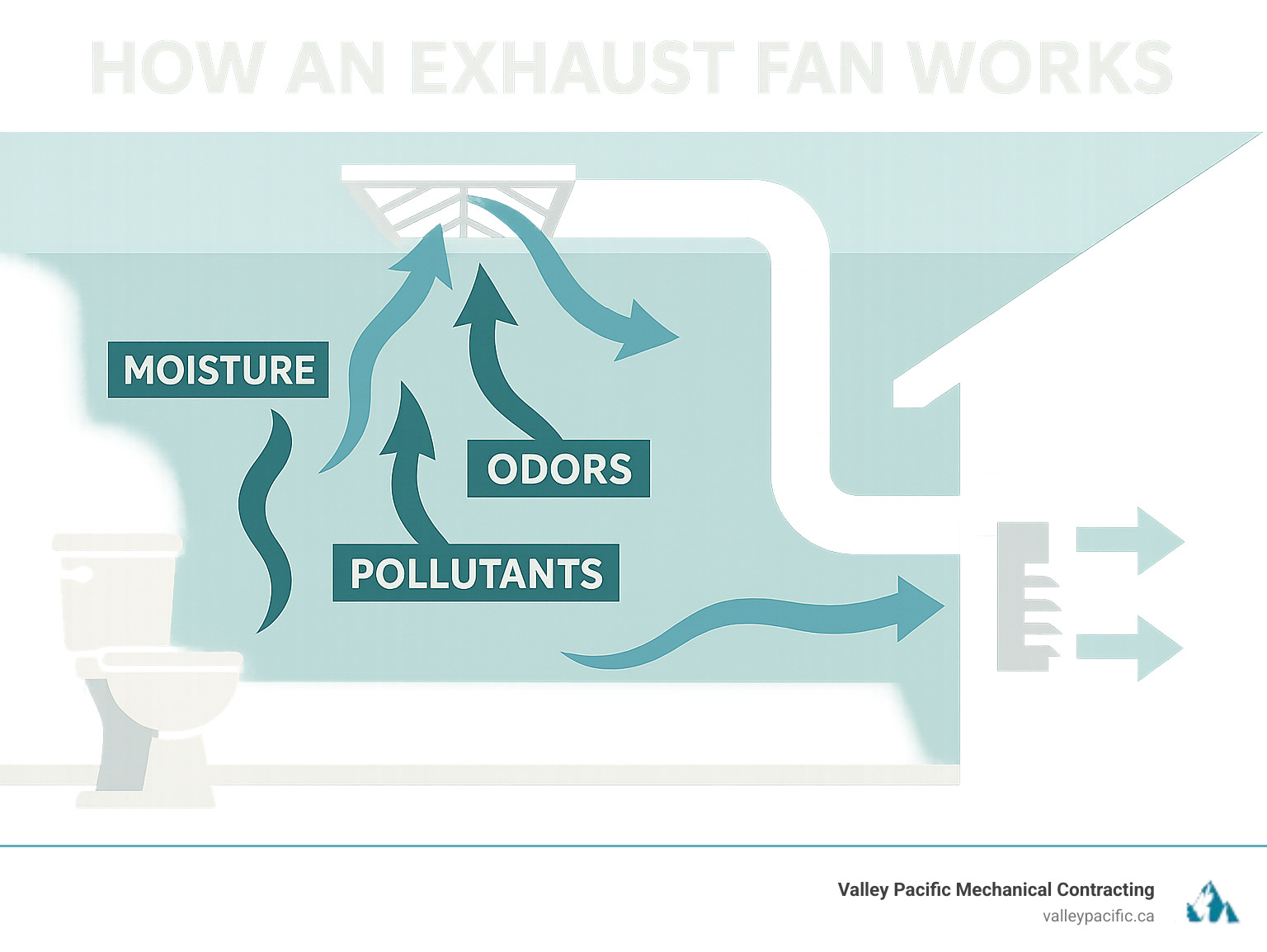
Is Your Exhaust Fan Crying for Help? Common Signs and Symptoms
Picture this: you're enjoying a hot shower, but when you step out, the bathroom feels like a sauna and the mirror is completely fogged up. Or maybe you're cooking dinner and notice that grinding noise coming from the kitchen exhaust fan has gotten so loud it's drowning out your favorite cooking show. Sound familiar?
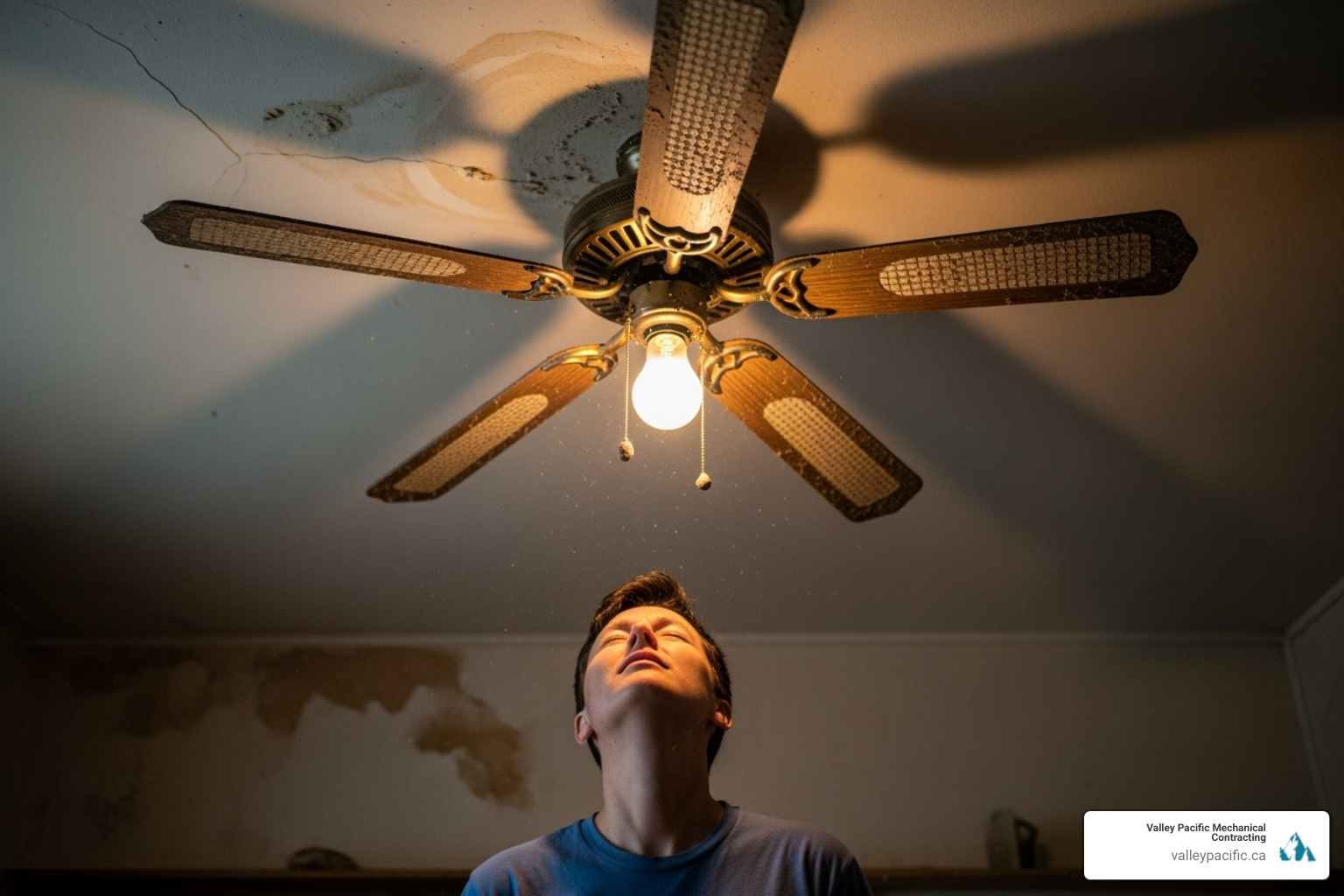
These everyday annoyances are actually your exhaust fan's way of asking for help. Learning to recognize these warning signs early can save you from bigger headaches down the road and help you determine whether you need a simple cleaning or more involved exhaust fan repair.
Unusual noises are often the first red flag homeowners notice. A healthy exhaust fan should hum quietly in the background - think about the gentle sound of a refrigerator. But when your fan starts grinding, rattling, or humming loudly enough to interrupt conversations, something's definitely wrong. These sounds usually mean dust has built up around the motor, the fan blades are hitting something they shouldn't, or internal parts are wearing out.
The most telling sign of trouble is weak or no suction. Here's a simple test: turn on your fan and hold a piece of tissue paper near the grille. If it doesn't get pulled toward the fan, you've got a problem. When steam doesn't clear from your bathroom or cooking odors linger in the kitchen, your fan isn't doing its job of moving air effectively.
Electrical issues can be particularly frustrating. Maybe your fan won't turn on at all, or it works fine one day and refuses to start the next. This intermittent power problem often points to loose connections, a faulty wall switch, or a motor that's overheating and shutting itself off as a safety measure.
Don't overlook the obvious signs either. Take a moment to actually look at your fan - is there visible dust and grime buildup coating the grille? This isn't just an eyesore; it's like trying to breathe through a clogged straw. The fan has to work much harder to pull air through all that debris, which can lead to motor burnout.
Finally, pay attention to vibrations. If your ceiling fan is shaking or wobbling when it runs, loose screws or an unbalanced motor could be the culprit. Left unchecked, these vibrations can damage both the fan and your ceiling.
Recognizing these signs early means you can often fix the problem with some basic maintenance before it turns into a major repair job. Your ventilation system works hard to keep your home comfortable and healthy - a little attention when it starts crying for help goes a long way.
Your Step-by-Step Guide to DIY Exhaust Fan Repair
When it comes to exhaust fan repair, there's one rule that trumps all others: safety first. I can't stress this enough – working with electrical appliances requires respect for the power flowing through your home's wiring. Before you even think about touching that fan, we need to cut the power completely.
Head over to your electrical panel (you'll usually find it tucked away in the basement, utility room, or garage). Look for the circuit breaker that controls your fan – it might be labeled "bathroom," "kitchen," or simply match the room you're working in. Flip that switch to the "off" position, then double-check by trying the fan switch in the room. No hum, no movement? Perfect! You're ready to work safely.
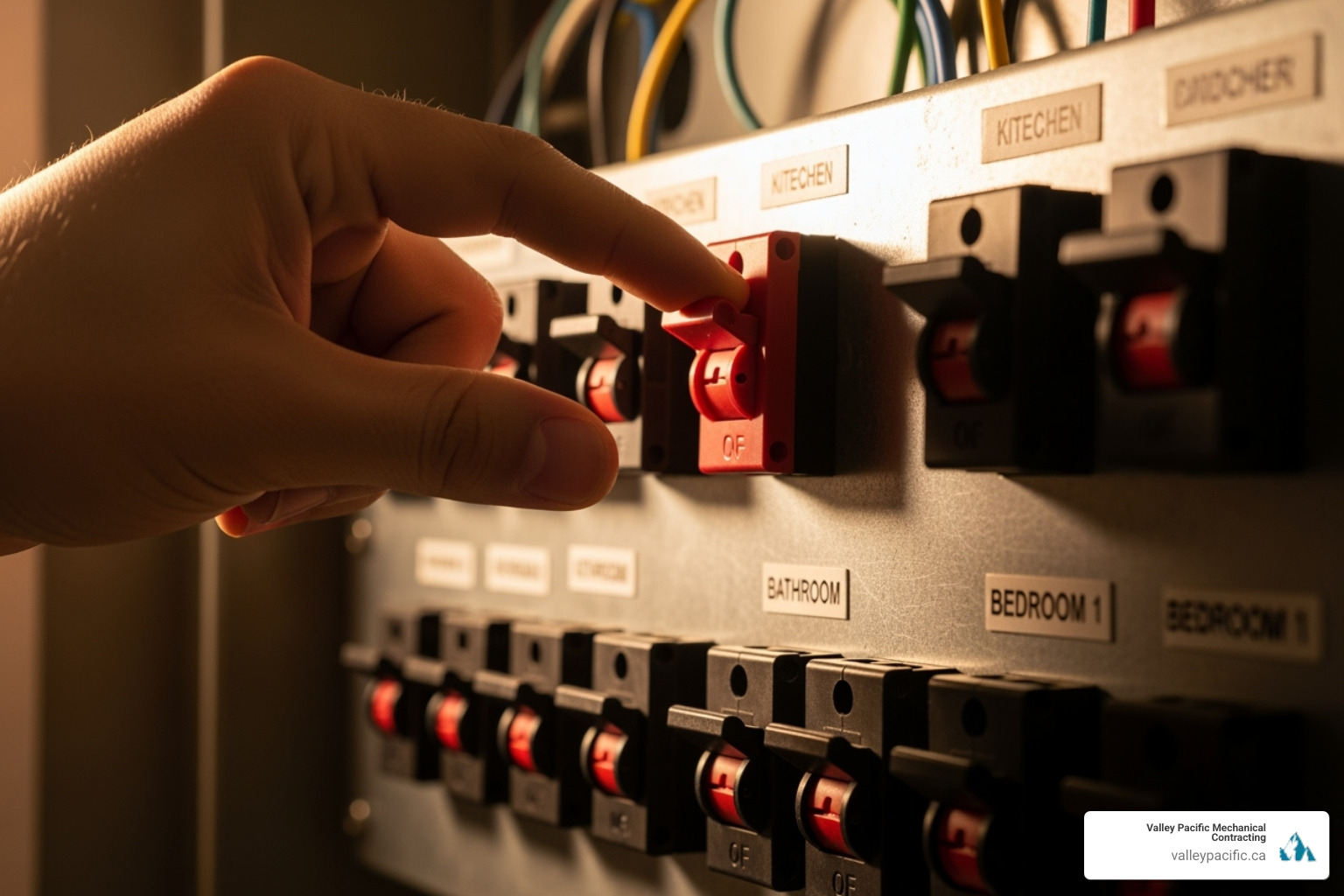
The beauty of most exhaust fan repair projects is that they don't require a toolbox full of expensive equipment. You probably already have everything you need: a screwdriver (Phillips head works for most fans), a vacuum with a brush attachment for tackling dust buildup, some soft cloths, and mild soap for cleaning. Throw in some work gloves and safety glasses, and you're equipped to handle the majority of fan problems.
Tackling a Noisy Fan: The Cleaning and Tightening Fix
That grinding, rattling symphony coming from your ceiling? Nine times out of ten, it's simply a cry for cleaning. Dust, lint, and kitchen grease love to accumulate on fan components, throwing everything off balance and creating those annoying noises.
Start by removing the fan cover – most are held by spring clips that you can gently pull down, or a few screws that are easy to spot. Take that cover to the sink and give it a proper wash with mild soap and water. You'll be amazed at what comes off!
Now for the satisfying part: cleaning the fan blades and blower wheel. Use your vacuum's brush attachment to gently remove all that accumulated grime from the blades and motor housing. The blower wheel (that squirrel-cage looking component) deserves special attention – those little fins between the cage can harbor surprising amounts of dust that seriously impacts airflow. A soft brush or cloth with mild soapy water works wonders here.
While you're in there, check for loose components by gently wiggling the fan blades and motor assembly. Any movement means loose screws that need tightening. It's remarkable how much quieter a fan becomes when everything is properly secured and clean.
Simple electrical exhaust fan repair: When the Fan is Dead
A completely silent fan often points to an electrical hiccup, but don't panic – many of these issues have surprisingly simple solutions. We're working with the power off, so take your time and be methodical.
Start by checking the wall switch. Does it feel loose or fail to click properly? A faulty switch is more common than you'd think. If the switch seems fine, move on to inspecting the motor itself. Look for obvious signs of trouble: burn marks, melted wires, or that distinctive electrical burning smell. If you spot any of these, it's time to call in the professionals.
Many motors have a thermal overload protector – a small button (often red) that pops out when the motor gets too hot. If you see one that's popped out, try pushing it back in to reset it. Sometimes that's all it takes!
Finally, verify that electrical connections are secure. Vibrations and age can loosen wire connections over time. Gently check that all wires are properly connected and terminal screws are snug. It's amazing how often a loose connection is the culprit behind a "dead" fan.
Boosting Performance: A guide to exhaust fan repair for weak suction
A fan that spins but barely moves air is like having a car with a clogged air filter – it's working hard but not accomplishing much. Weak suction usually means something is blocking the airflow path, and clearing these blockages can dramatically improve performance.

Deep cleaning the fan housing and motor goes beyond just the visible parts. Use your vacuum's crevice tool to reach every corner of the housing, paying special attention to the area around the motor and the duct opening. Kitchen fans often accumulate significant grease buildup that can be carefully scraped away before wiping with a degreasing cleaner.
Next, check for blockages in the duct opening where air enters the ductwork leading outside. Bird nests, excessive lint, or other debris can seriously restrict airflow. If you can safely reach any visible blockages, remove them carefully. For deeper obstructions within the duct run itself, professional help might be needed.
Don't forget the backdraft damper – that small flap designed to open when the fan runs and close when it's off. This damper can stick shut due to dust, rust, or broken hinges, severely limiting airflow. It should swing open easily when pushed. If it's jammed, cleaning the hinges or removing built-up debris usually solves the problem.
By ensuring a clear path from the fan grille all the way to the exterior vent, you'll restore your exhaust fan's ability to effectively remove moisture and odors while reducing strain on the motor.
Repair or Replace? Making the Smart Choice
So you've rolled up your sleeves, tackled the cleaning, tightened those screws, and maybe even reset a thermal switch or two. But your exhaust fan is still giving you grief. Or perhaps you're staring up at a fan that's been faithfully (if noisily) serving your family for over a decade, wondering if it's time to say goodbye. This is where the rubber meets the road in exhaust fan repair decisions.
The truth is, sometimes the kindest thing you can do for both your wallet and your sanity is to let that old fan retire gracefully. But how do you know when you've crossed that line from "fixable" to "replaceable"?
Age is often the biggest tell-tale sign. Most bathroom and kitchen exhaust fans have a lifespan of about 5 to 10 years, depending on how hard they've been working and how well they've been maintained. If your fan is pushing past that decade mark, even a successful repair might just be buying you a few more months of peace before the next breakdown.
Frequent breakdowns are another red flag. Are you finding yourself up on that stepladder every few months, cleaning, adjusting, or coaxing your fan back to life? That's your fan's way of telling you it's ready for retirement. As one industry expert puts it, "a brand-new fan is sure to satisfy, while the old fan, even when repaired, is unlikely to" deliver the performance you really need.
Let's talk numbers for a moment, because performance metrics matter more than you might think. Your fan's airflow capacity is measured in CFM (Cubic Feet per Minute), and if your current fan isn't moving enough air, no amount of cleaning will fix that fundamental shortcoming. Ontario's building codes require at least 50 CFM for each toilet, urinal, or shower in a bathroom, while kitchens need a minimum of 100 CFM. The Home Ventilation Institute suggests 1 to 1.5 CFM per square foot of bathroom floor space for optimal performance.
Then there's the noise factor, measured in sones. If your fan sounds like it's preparing for takeoff every time you flip the switch, you're probably dealing with an older model that was chosen more for price than performance. Here's something that might surprise you: modern bathroom fans can be three times more powerful than older models while being three times quieter! While building codes allow up to 3.5 sones, most homeowners find that fans rated at 1 to 2 sones provide blissfully quiet operation.
Upgrading to modern, energy-efficient models brings benefits that go far beyond just quieter operation. Today's fans are smarter, more durable, and often include features like humidity sensors, timers, and LED lighting. They're designed to move more air while using less energy, which means better ventilation and lower utility bills.
| Consideration | DIY Repair | Professional Replacement |
|---|---|---|
| Best for | Fans under 7 years with minor issues | Fans over 10 years or frequent problems |
| Time investment | Quick fixes (under an hour) | Professional installation (few hours) |
| Performance gain | Restores original function | Significant improvement in airflow and quiet operation |
| Long-term value | Good for extending current lifespan | Excellent for major upgrades and reliability |
Visible damage to the fan housing - cracks, rust, or water damage - usually signals that you're beyond simple exhaust fan repair territory. These issues often indicate deeper problems that cleaning and tightening won't solve.
The bottom line? If your fan is young and just needs some TLC, those DIY fixes we covered earlier can work wonders. But if you're dealing with an older fan that's become a regular maintenance headache, or if you're craving the quiet efficiency of modern technology, replacement often delivers better long-term value than repeatedly patching up an aging system.
Proactive Care: How to Prevent Future Fan Failures
We've covered how to bring a struggling exhaust fan back to life, but what about keeping it happy and healthy in the long run? Just like any other appliance in your home, a little preventative maintenance goes a long way. Proactive care is the best exhaust fan repair strategy because it helps you avoid issues before they even start!

Think of your exhaust fan like a trusted friend who works tirelessly behind the scenes. A little attention now and then keeps that friendship strong and prevents those awkward moments when they suddenly stop working in the middle of your morning shower.
The cornerstone of preventative maintenance is establishing a regular cleaning schedule. Mark your calendar for every 6-12 months – it's honestly that simple. This routine maintenance will help prevent dust buildup on the grille, blades, and most importantly, the blower wheel. A clean fan moves air more efficiently, puts less strain on its motor, and operates much more quietly. It's amazing how much difference a simple cleaning can make!
Listen for new noises as you go about your daily routine. Your fan has its own "normal" sound, and you'll quickly notice when something changes. Those new squeaks, rattles, or unusual hums aren't just annoying – they're your fan's way of asking for help. Addressing a minor noise early (like tightening a loose screw or clearing some dust) can prevent it from turning into a major headache later.
Proper usage makes all the difference in your fan's lifespan. In bathrooms, run the fan during your shower and for at least 15-20 minutes afterward. This gives your fan enough time to clear all that humidity from the room, preventing mold and mildew from setting up shop. For kitchen fans, flip that switch whenever you're cooking, especially when there's steam, smoke, or strong odors involved. Don't be shy about using it – that's what it's there for!
Here's something many homeowners forget: checking the exterior vent cap for blockages. Your exhaust fan works hard to push air outside through a cap on your roof or exterior wall. Over time, these caps can get clogged with lint, leaves, or even become home to unwanted guests. Rodents are responsible for more than 25% of HVAC system failures in Canada, so a yearly inspection of your exterior vent can save you from bigger problems down the road.
By weaving these simple preventative maintenance tips into your home care routine, you're setting yourself up for years of reliable performance. Your exhaust fan will continue providing the fresh air and healthy environment your home deserves, and you'll avoid those surprise repair moments that always seem to happen at the worst possible times.
Conclusion: Your Home, Healthier and Happier
Congratulations! You've just learned how to tackle the most common exhaust fan repair challenges that homeowners face. By taking on these DIY fixes yourself, you're not just saving money on service calls – you're also taking control of your home's health and comfort.
Think about it: a properly functioning exhaust fan is like having a silent guardian working around the clock. It whisks away moisture before it can settle into your walls, eliminates cooking odors before they permeate your furniture, and keeps your indoor air fresh and breathable. When you fix that noisy, struggling fan, you're directly improving your home environment in ways that benefit your entire family.
The satisfaction of hearing your bathroom fan purr quietly again, or watching steam clear from your mirror in minutes instead of hours, is genuinely rewarding. Plus, you now have the knowledge to spot early warning signs and prevent small issues from becoming big, expensive problems.
However, we want to emphasize the importance of knowing your limits. While cleaning a dusty fan or tightening loose screws is well within most homeowners' capabilities, some situations definitely call for professional expertise. When professional help is necessary includes complex electrical issues beyond a simple switch replacement, motor replacements, persistent ductwork problems, or any time you feel uncertain about the safety of a repair.
At Valley Pacific Mechanical Contracting, we've been helping Lower Mainland homeowners create healthier, more comfortable living spaces for over 30 years. We understand that your home is your sanctuary, and every component – from the smallest exhaust fan to your entire HVAC system – plays a role in keeping it that way.
Whether you're in Mission, Maple Ridge, Langley, Pitt Meadows, or Coquitlam, our team is ready to step in when DIY reaches its limits. We pride ourselves on providing that 'headache-free' experience, and our 24/7 emergency service means we're there when unexpected issues arise.
Your journey toward better home comfort doesn't have to stop with exhaust fan repair. For comprehensive home comfort solutions, explore our heat pump services in Langley, BC. After all, your home deserves to be a place where you can breathe easy and feel completely comfortable.
Why Your Boiler Pilot Light is Critical for Home Heating
A boiler pilot light is a small, continuously burning flame that ignites your boiler's main burner to produce heat and hot water for your home. When this tiny flame goes out, your entire heating system stops working, leaving you without heat or hot water.
Quick Answer: What You Need to Know About Boiler Pilot Lights
- Purpose: Small flame that lights the main gas burner
- Location: Usually found behind an access panel near the bottom of your boiler
- Signs it's out: No heat, no hot water, no visible blue flame
- Safety first: Never attempt relighting if you smell gas
- When to call a pro: If pilot won't stay lit or keeps going out
Nothing beats the feeling of a hot shower after a long day. But when your boiler's pilot light goes out, you're suddenly stuck with an icy cold deluge and no heat in your home.
The pilot light serves as the ignition source for your boiler's main burner. When it's working properly, you'll see a steady blue flame about the size of your thumbnail. This flame stays lit 24/7 on older boiler systems, ready to ignite the main burner whenever your thermostat calls for heat.
Modern boilers often use electronic ignition systems instead of standing pilot lights, but many homes in the Lower Mainland still rely on the traditional pilot light design. Understanding how your system works can help you troubleshoot heating problems and know when it's safe to attempt a DIY fix versus calling a professional.
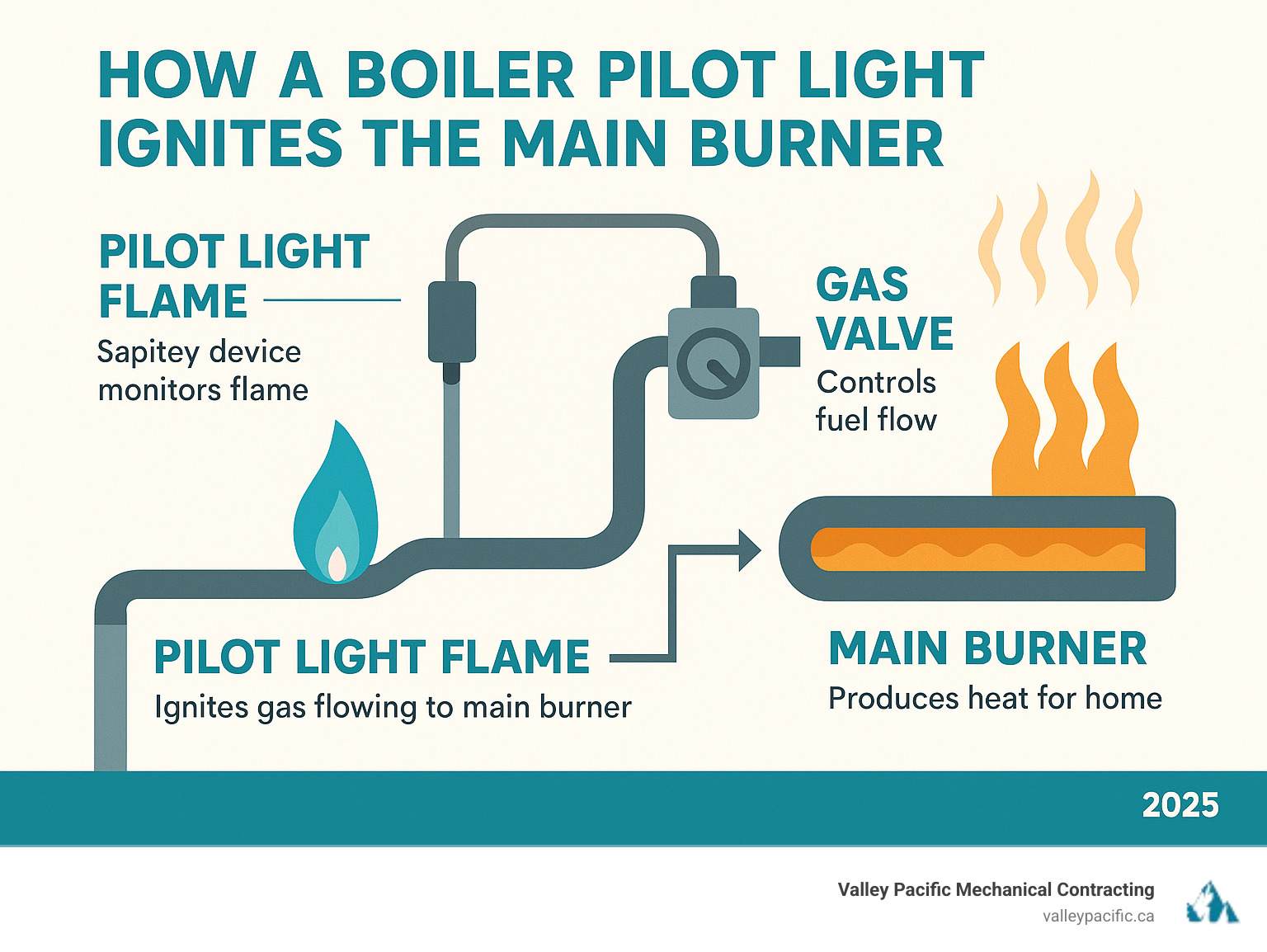
Understanding Your Boiler's Ignition System
Your boiler's ignition system is a complex interplay of gas, flame, and safety mechanisms working to keep your home warm. Understanding how this system works is practical, as heating and cooling costs can make up about 43% of your total energy bill according to ENERGY STAR. Keeping your ignition system running smoothly can save you money and headaches.
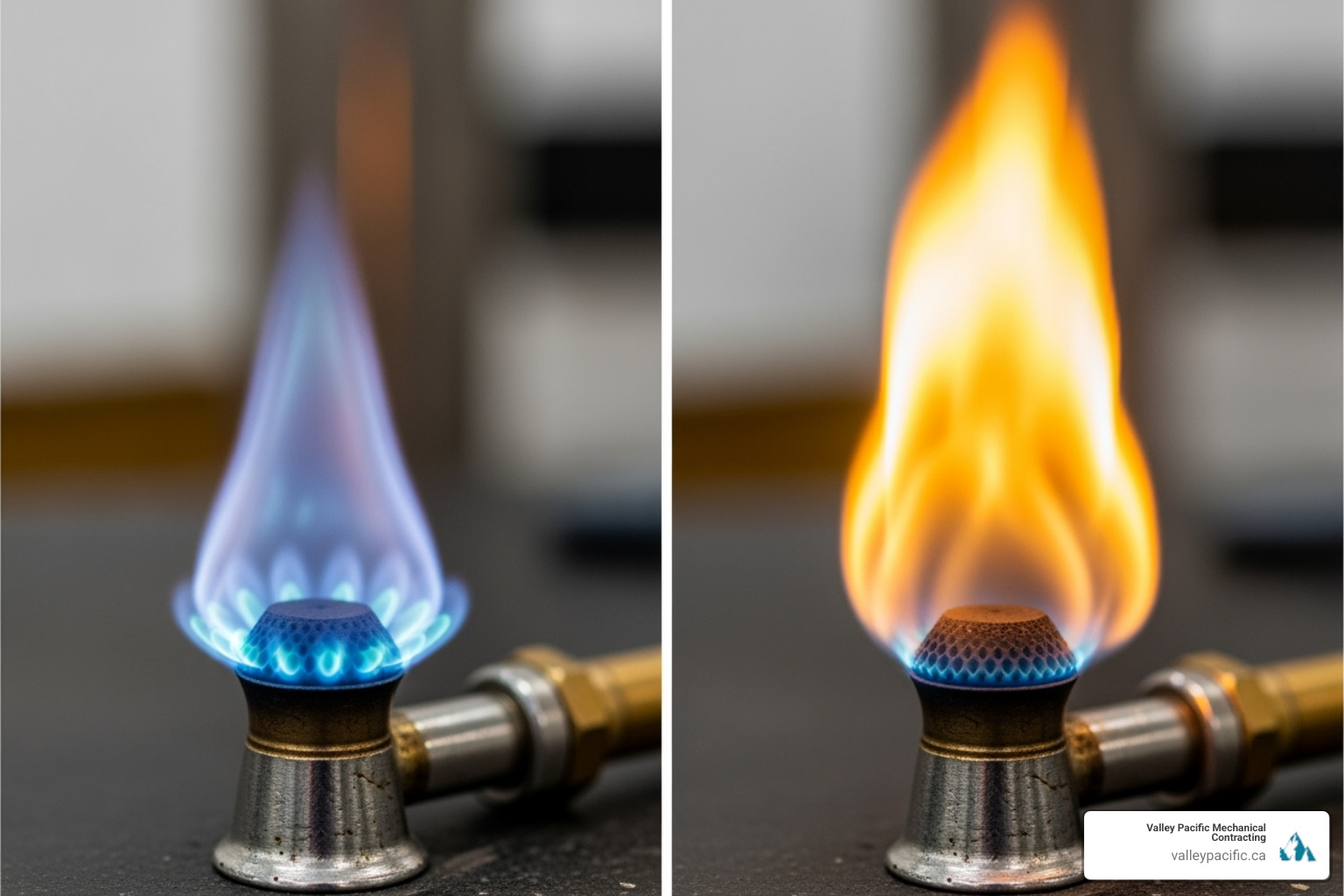
What is a Boiler Pilot Light and Why Is It Important?
Think of your boiler pilot light as the faithful guardian of your home's warmth. This small, continuous flame—about the size of your thumbnail—burns 24/7 in older boiler systems. When your thermostat signals for heat, the main gas valve opens, and the pilot light ignites the gas flowing to the burner. This action creates the heat that warms your home and provides hot water.
A typical pilot light burns about 600 BTUs of gas per hour, which adds up to roughly 432,000 BTUs per month and can make a noticeable dent in your gas bill. For older boiler systems, however, this continuous burn is necessary for reliability, as there's no other way to ignite the main burner when you need heat.
The Role of the Thermocouple
Beside the pilot flame sits the thermocouple, a crucial safety device. This slender copper rod heats up from the pilot light and generates a tiny electrical signal that tells your boiler's gas valve it is safe to stay open.
If the boiler pilot light goes out, the thermocouple cools down and stops sending its signal. Within seconds, the gas valve automatically shuts off all gas flow, preventing a dangerous gas buildup in your home.
When homeowners call us about a pilot light that won't stay lit, a faulty thermocouple is often the culprit. It might be dirty or knocked out of position, preventing it from properly detecting the pilot flame.
Manual vs. Automatic Pilot Light Systems
Not all boiler ignition systems are created equal. Your home likely has one of two types, and knowing which one can save you time and frustration.
Manual pilot systems (also called standing pilot systems) are found in older boilers. They keep a pilot flame burning around the clock. If the pilot goes out, you must manually relight it following specific safety steps.
Automatic ignition systems are found in newer boilers. Instead of a constant pilot, they use a spark igniter or a hot surface igniter to light the main burner on demand. When the thermostat calls for heat, the igniter fires up, lights the burner, and then shuts off.
The biggest difference is energy efficiency. Automatic systems don't waste gas on a constant pilot light and are more convenient, often resetting with a simple power cycle instead of manual relighting.
If you're not sure which system you have, look at your boiler. A small, constant blue flame indicates a manual system. No visible flame when the boiler isn't running means you have automatic ignition.
Common Reasons Your Boiler Pilot Light Goes Out
Finding your boiler pilot light has gone out again, leaving you without heat or hot water, can be frustrating. Understanding why this happens can save you from repeated cold showers. Several common culprits are usually behind a vanishing pilot light. Sometimes it's a simple fix, while other times it signals a deeper issue that needs professional attention, and may be connected to boiler pressure issues.
Strong drafts are a straightforward reason a pilot light goes out. A gust of wind can blow out the flame, especially if the boiler is in a drafty area. Flue pipe issues, like a loose or cracked pipe, can create a path for drafts. Poor ventilation can also create air currents that extinguish the flame.
A dirty pilot orifice is another frequent troublemaker. This tiny opening controls gas flow to the pilot light, but it can get clogged with soot and debris. This restricts gas flow, creating a weak, flickering flame that's easily extinguished. A yellow or orange flame instead of a crisp blue one is a telltale sign of soot buildup and gas flow obstruction.
Your thermocouple—that safety sensor we discussed earlier—can also be the culprit. If it's dirty, bent, or worn out, it stops detecting the pilot flame correctly. A faulty thermocouple will signal the gas valve to shut off the gas supply, even when the pilot is lit, causing it to go out repeatedly.
Gas supply problems can starve the pilot light of fuel. Low gas pressure from the utility, a faulty gas regulator, or a kinked gas line can interrupt the necessary steady flow. If other gas appliances are also having issues, it points to a broader supply problem.
Sometimes the issue is the gas valve itself. This component controls gas flow to both the pilot and main burner. If it's failing, it might not supply enough gas to keep the pilot lit or may shut off intermittently. These valves eventually wear out and require replacement.
External factors like weather changes or gas company maintenance can also cause the pilot to go out. If your boiler pilot light goes out rarely, it's likely not a major concern. However, if it happens regularly, an underlying issue probably needs addressing.
How to Safely Relight Your Boiler Pilot Light
If your heat's out and you suspect the boiler pilot light is the culprit, you can often relight it yourself. However, safety is paramount when working with gas appliances.

Before you start, familiarize yourself with the gas control knob, which typically has three positions: OFF, PILOT, and ON. This knob is key to safely relighting your system.
Essential Safety Precautions
Your safety comes first. Before you do anything, you must make sure it's safe to proceed.
The most critical step is to smell for gas. Natural gas has a distinct "rotten egg" odor added for safety. Sniff around your boiler. If you smell gas, even faintly, stop immediately.
If you smell gas: don't touch any electrical switches, don't use your phone inside, and don't light anything. Evacuate everyone from the house. Once safely outside, call your gas utility company and a qualified HVAC professional.
If you don't smell gas, you can proceed. First, find your boiler's manual for model-specific instructions (most are available online). Ensure good ventilation by opening windows or doors. For automatic ignition systems, turn off the electrical power at the circuit breaker to prevent accidental ignition.
Step-by-Step Guide for a Manual Boiler Pilot Light
If you have a manual system and there's no gas smell, follow these steps to get your heat back on.
First, turn the gas control knob to OFF. This is a crucial safety step.
Next, wait 10 to 15 minutes. This allows any residual gas in the pilot line to dissipate safely.
While waiting, locate the pilot light assembly. You may need to remove an access panel, and a flashlight will help. The pilot is a small opening near the bottom of the boiler.
After waiting, turn the knob to PILOT and press and hold it down firmly. This allows a small amount of gas to flow.
While holding the knob, use a long lighter or match to ignite the pilot flame. Hold the flame at the pilot opening until a small, steady blue flame appears. Some boilers have a built-in igniter button to press instead.
Once the pilot is lit, keep holding the gas control knob down for at least 30 to 60 seconds. This gives the thermocouple time to heat up and keep the gas valve open.
Slowly release the gas control knob. The pilot flame should stay lit. If it goes out, repeat the process. It may take a couple of tries.
Finally, turn the knob from PILOT to ON. Replace any access panels, turn up your thermostat, and listen for the main burner to ignite.
How to Reset an Automatic Ignition System
Resetting an automatic electronic ignition system is much simpler since there's no standing pilot to light.
Turn off the electrical power to your boiler at the main switch or circuit breaker.
Wait about 5 to 10 minutes for the system to reset and clear any safety lockouts.
Turn the power back on and listen. You should hear clicking as the electronic igniter sparks, followed by the whoosh of the main burner lighting.
If nothing happens, check the display panel for error codes. Your manual will help you decode these messages.
If your pilot light still won't light or stay lit after these steps, it's time to call a professional.
When to Call a Professional for Boiler Repair
While relighting a boiler pilot light can be a DIY task, some situations are best left to the experts.
At Valley Pacific Mechanical Contracting, we understand that boiler problems never happen at convenient times. That's why we're here to provide that headache-free experience you deserve, whether you need Boiler Repair Maple Ridge BC, Boiler Repair Langley BC, or Boiler Repair Pitt Meadows BC.

Persistent boiler pilot light problems usually signal deeper issues that require expert diagnosis. It's important to recognize the signs that you need professional help.
Signs You Need an Expert
It's normal for a pilot light to go out occasionally, but if it becomes a recurring problem, your boiler is trying to tell you something.
When the pilot simply refuses to light, even after you've followed the relighting steps, you're likely dealing with a gas supply issue or a faulty component. Trying the same steps repeatedly won't fix a problem that requires diagnostic tools and replacement parts.
If your pilot lights but won't stay lit, you're probably looking at a faulty thermocouple. While the part isn't expensive, proper installation requires the right tools and expertise.
Frequent outages—more than once every few months—indicate an ongoing problem that won't resolve itself, such as a dirty pilot orifice, draft issues, or a failing gas valve. Our technicians can identify and fix the root cause.
A yellow or wavering flame instead of a crisp blue one signals incomplete combustion. This can mean your boiler is producing carbon monoxide, a colorless, odorless, and potentially deadly gas. If you see a yellow flame, get everyone out and call us immediately. Incomplete combustion can also release volatile organic compounds (VOCs) into your home's air.
The smell of gas is always an emergency. Evacuate immediately and call your gas utility company first, then us. We provide 24/7 emergency service because these situations can't wait.
If you simply feel unsure or uncomfortable with the process, call for backup. There's no shame in it. We'd much rather you call us for something simple than risk your safety.
Our team brings over 30 years of experience to every call. We're equipped with the tools and parts to get your system running safely and efficiently. Professional diagnosis often saves time, money, and stress in the long run.
Frequently Asked Questions about Boiler Pilot Lights
Homeowners often have questions about their boiler pilot lights. This small flame is crucial for keeping your home warm and comfortable. Here, we answer some of the most common questions we've received over our 30+ years in business.
Is it dangerous if my boiler pilot light keeps going out?
Yes, a boiler pilot light that frequently goes out is a cause for concern and can pose safety risks. It indicates an underlying problem, such as a faulty thermocouple, a dirty pilot orifice, or draft issues. Ignoring these problems can lead to more expensive repairs.
The primary safety concern is the potential for unburned gas to accumulate if the safety system fails, creating an explosion risk. There's also the carbon monoxide risk. A struggling pilot light often burns with a yellow or orange flame, indicating incomplete combustion and the production of carbon monoxide, a colorless and odorless gas that can be fatal.
Practically, no heat in cold weather can lead to frozen pipes. If your pilot light goes out more than once every few months, it's time for a professional inspection to get to the root of the problem.
How do I clean a dirty pilot light orifice?
A dirty pilot orifice is a common cause of pilot light problems. Soot and debris buildup in this tiny opening can create a weak or misdirected flame that is easily blown out.
The pilot orifice is incredibly small, and when clogged, it restricts gas flow and disrupts proper combustion.
While you might be tempted to clean it yourself with a thin wire or needle and canned air, we advise against it. This is tricky work that requires precision.
Safety warning: The orifice is precisely calibrated. Even slight damage can create dangerous combustion issues or gas leaks. What seems like a simple cleaning can become a safety hazard if not done correctly.
Professional cleaning is recommended. Our technicians have the right tools and expertise to clean the orifice without damaging it, ensuring your boiler pilot light burns safely and efficiently. The peace of mind is worth the service call.
What is the difference between a boiler and a furnace pilot light?
While both appliances can use pilot lights for the same core function—igniting the main burner—there are appliance-specific design differences.
The fundamental job is identical: the small flame provides ignition when your thermostat calls for heat.
The differences are in different locations and different components based on each appliance's design. Boilers heat water, while furnaces heat air, so their pilot assemblies may be positioned differently and use slightly different gas valve configurations.
What's most important is that you always follow manufacturer instructions for your specific unit. The manual for your appliance is your best guide for safe operation and troubleshooting.
Whether you have a boiler or furnace pilot light issue, our experienced team knows both systems. We've been working with heating equipment in the Lower Mainland for over three decades and can handle any issue.
Conclusion: Keeping Your Home Warm and Safe
When your boiler pilot light goes out on a cold winter evening, it can feel like your entire world has come to a standstill. No heat, no hot water, and suddenly that cozy home becomes a very uncomfortable place. But as we've explored together, understanding this small but mighty flame can make all the difference between panic and confidence.
We've walked through the essential steps: recognizing when your pilot light has gone out, understanding why it happens, and knowing how to safely get it burning again. That tiny blue flame is your boiler's ignition source, working hand-in-hand with the thermocouple safety device to keep your home warm and your family safe.
Safety always comes first. If you ever detect that telltale rotten egg smell of gas, don't hesitate—evacuate immediately and call your utility company. Some situations simply aren't worth the risk of a DIY approach.
For those persistent problems we discussed—pilot lights that won't stay lit, yellow or wavering flames, or frequent outages—these are clear signals that professional maintenance is needed. A qualified technician can diagnose underlying issues like faulty thermocouples, dirty pilot orifices, or gas supply problems that might not be obvious to the untrained eye.
At Valley Pacific Mechanical Contracting, we understand how frustrating heating problems can be. That's why we're committed to providing that headache-free experience you deserve. Our team brings over 30 years of expertise to every service call, whether it's a middle-of-the-night emergency or routine maintenance.
We serve homeowners throughout the Lower Mainland, from Mission to Maple Ridge to Langley, with 24/7 emergency service because we know heating problems don't wait for business hours. Plus, we stand behind our work with the Daikin Comfort Promise, ensuring your complete satisfaction.
Don't let a stubborn boiler pilot light leave you in the cold. When you need reliable, professional service you can trust, get reliable boiler service in Langley and the surrounding areas. We're here to keep your home warm, safe, and comfortable all year round.
Why Preventative HVAC Maintenance is Your Best Investment
Preventative HVAC maintenance is the proactive care and scheduled upkeep of your heating, ventilation, and air conditioning systems to prevent breakdowns, optimize performance, and extend equipment life. As Benjamin Franklin wisely said, "An ounce of prevention is worth a pound of cure" - and this couldn't be more true for your home's HVAC system.
Key Benefits of Preventative HVAC Maintenance:
- Energy Savings: Up to 30% reduction in energy costs
- Extended Lifespan: Well-maintained systems last 15-20 years vs. 10 years for neglected ones
- Cost Savings: Save $4 for every $1 spent on maintenance (EPA data)
- Better Air Quality: Removes dust, mold, and pollutants
- Reliability: Prevents costly emergency breakdowns during extreme weather
Picture this: it's the middle of a sweltering summer day, and your air conditioner suddenly stops working. Or imagine a frigid winter night when your furnace decides to call it quits. These scenarios aren't just uncomfortable - they're expensive emergencies that could have been prevented.
The truth is, your HVAC system works hard year-round to keep your family comfortable. Without regular care, dust accumulates, parts wear down, and small problems become major headaches. But with simple preventative maintenance, you can avoid these costly surprises while enjoying lower energy bills and cleaner air.
Regular maintenance involves both simple tasks you can do yourself (like changing filters) and professional tune-ups that catch problems before they become disasters. It's a small investment that pays huge dividends in comfort, savings, and peace of mind.
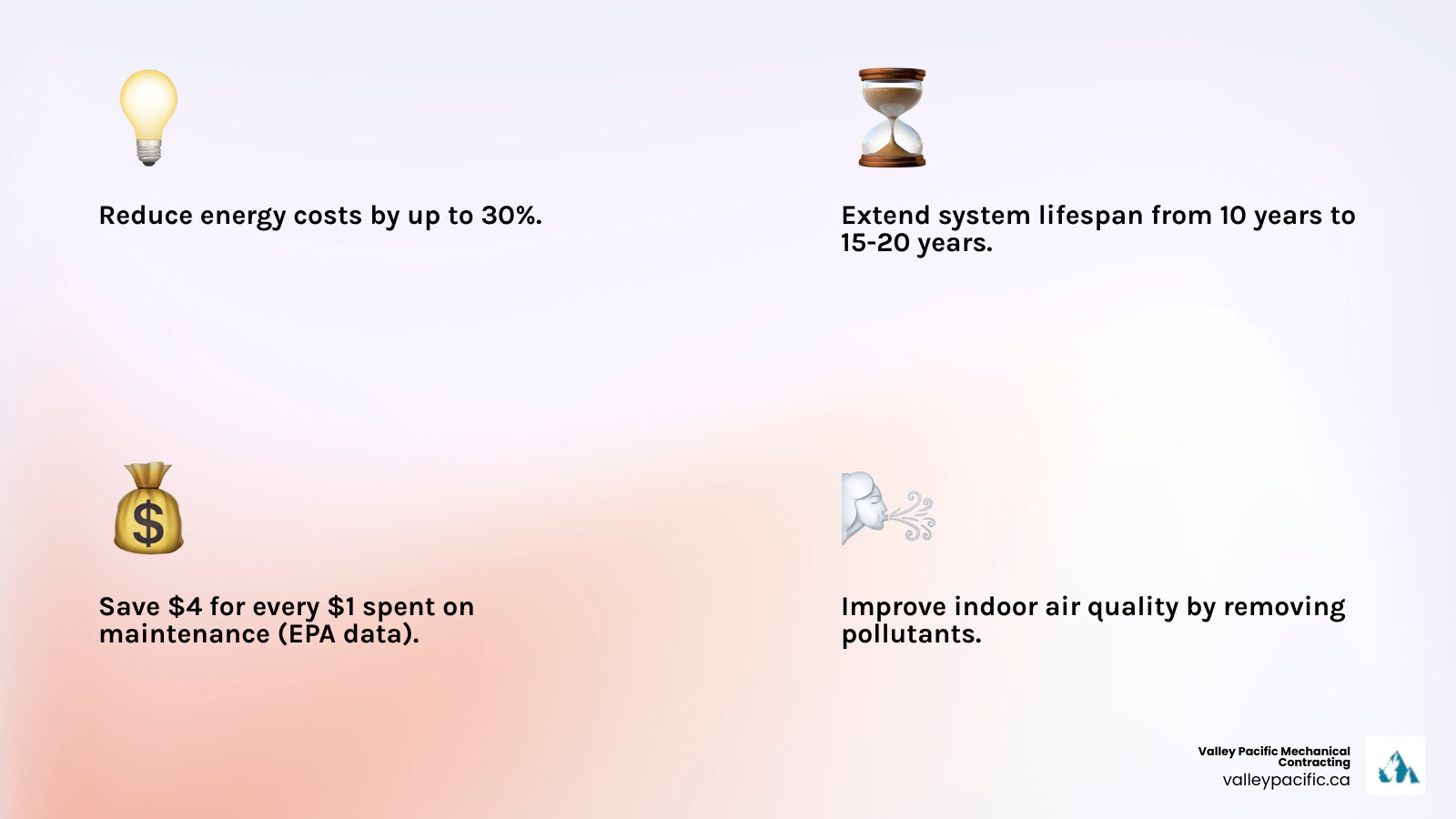
The Undeniable Benefits of Regular HVAC Maintenance
Your HVAC system works tirelessly to keep you comfortable, but it needs regular attention to thrive. While it's easy to forget about it until something goes wrong, preventative HVAC maintenance is one of the smartest moves a homeowner can make. It's not just about avoiding disasters; it's about open uping benefits that improve comfort, save money, and provide peace of mind.
Let's explore why being proactive about your HVAC care is one of the smartest moves you can make as a homeowner in the Lower Mainland.
Slash Energy Bills and Boost Efficiency
Preventative HVAC maintenance puts real money back in your pocket. According to the U.S. Department of Energy findings on energy savings, a well-maintained system can reduce your energy costs by up to 30%.
This happens because a clean, tuned system doesn't have to work overtime to keep you comfortable. A dirty air filter, for example, restricts airflow, forcing the system to use more energy. Clean coils, lubricated parts, and calibrated components ensure it runs like a well-oiled machine.
As a bonus, an efficient system shrinks your carbon footprint by using less energy, which is a win for your wallet and the planet.
Extend Your System's Lifespan and Protect Your Investment
Your HVAC system is a major investment, and preventative HVAC maintenance protects it. Well-maintained systems can last 15 to 20 years, compared to just 10 years for neglected ones, according to insights on HVAC system lifespan. That's a potential decade of extra service.
Another crucial benefit is warranty protection. Most manufacturers require proof of regular professional maintenance to keep your warranty valid. Skipping tune-ups could mean paying for repairs that should have been covered. Our Comprehensive Heat Pump Service Plans help you meet these requirements.
Maintenance is insurance for your investment, ensuring you get the full lifespan your system was designed for.
Breathe Cleaner, Healthier Air
Your HVAC system is the guardian of your indoor air quality, and preventative HVAC maintenance is key to keeping that air clean. According to The U.S. Environmental Protection Agency on indoor air quality, indoor air can be two to five times more polluted than outdoor air.
A maintained system filters out dust, allergens, mold spores, bacteria, and other pollutants. Without it, clogged filters and dirty coils can circulate these contaminants, triggering respiratory issues and worsening allergies.
Regular maintenance ensures fresh filters capture particles and clean coils prevent mold growth. Learn more with our Spring Air Quality Solutions for HVAC System.
Avoid Costly Emergency Breakdowns
Nobody wants their AC to fail on the hottest day of summer or their furnace to quit on a freezing night. These expensive, stressful emergencies are often avoidable. Preventative HVAC maintenance catches small issues—like worn belts, dirty components, or low refrigerant—before they become major problems.
In contrast, emergency repairs almost always cost more due to urgent scheduling and more extensive damage. The EPA estimates that you can save $4 for every $1 spent on maintenance by preventing these costly calls.
While we're ready to help with HVAC Repair in Maple Ridge, BC, we'd rather help you avoid emergencies. Regular maintenance means reliability when you need it most.
Your Simple DIY Preventative HVAC Maintenance Checklist
While professional tune-ups are essential, several simple DIY tasks can keep your system running smoothly between visits. These steps help maintain efficiency, improve air quality, and flag potential issues. It's teamwork: you handle the basics, and we'll handle the rest.
Monthly Tasks for Peak Performance
Making a few simple checks each month can significantly impact your system's performance and longevity.
- Change or Clean Air Filters: This is the most important DIY task. A dirty filter restricts airflow, forcing your system to work harder, which wastes energy and causes wear. Check your filter monthly and replace it every 1-3 months (more often if you have pets or allergies). For reusable filters, wash according to manufacturer instructions and dry completely before reinserting.
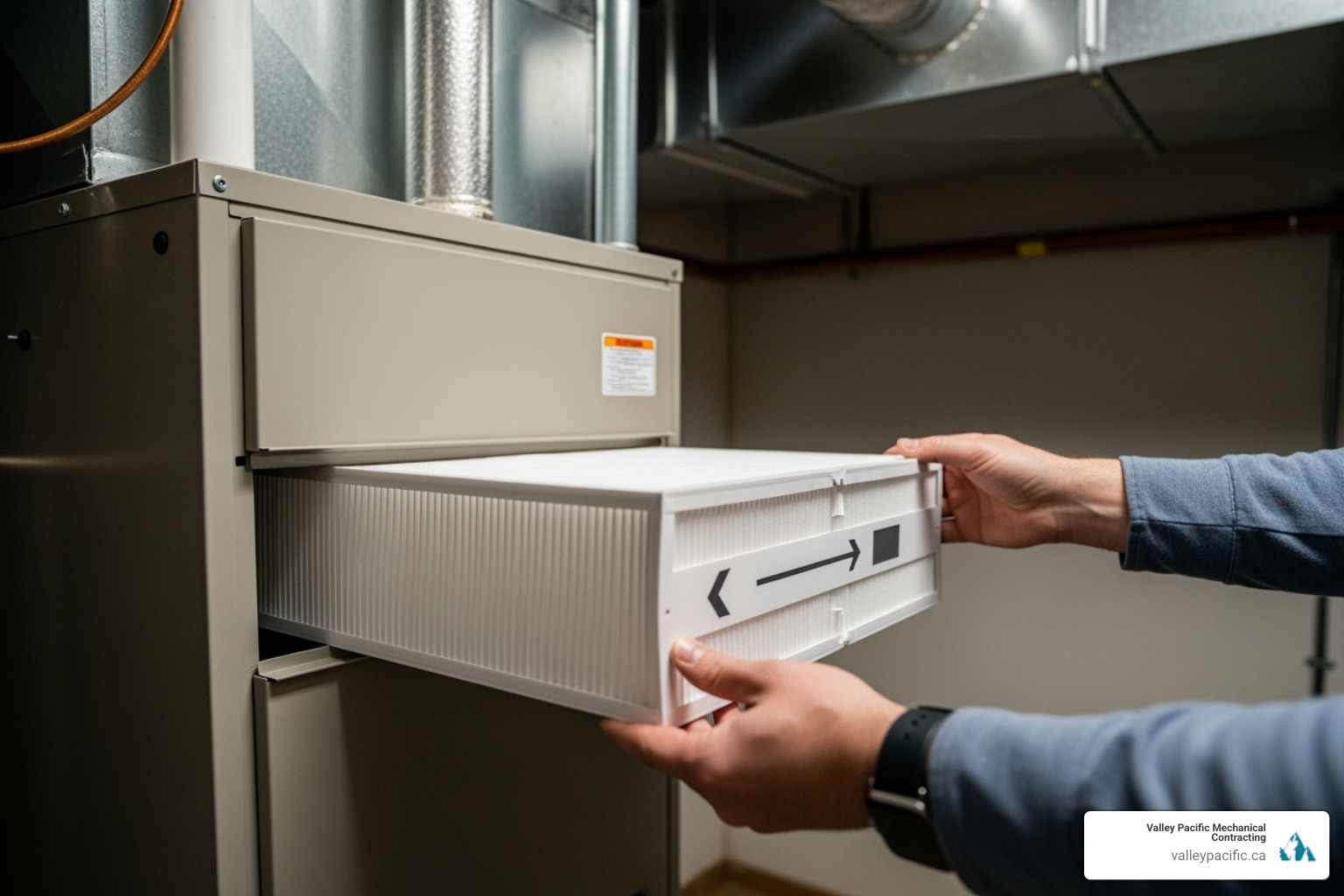
Inspect Air Vents and Clear Registers: Ensure all air vents and registers are clear of obstructions like furniture, drapes, or rugs. Blocked vents reduce efficiency and cause uneven temperatures. Avoid closing more than 20% of your vents, as this can restrict airflow and damage your system.
Remove Debris from Outdoor Unit: Your outdoor unit is exposed to the elements. Regularly clear away leaves, grass clippings, and other debris that can block airflow and reduce efficiency. Maintain at least two feet of clearance around the entire unit.
Trim Vegetation: Trim back shrubs, bushes, or grass growing within two feet of your outdoor unit. Dense vegetation can impede airflow and reduce efficiency.
Seasonal Checks and Smart Tech
Beyond the monthly routine, a few seasonal checks can further improve your system's efficiency and reliability.
Test System Before Peak Season: Before peak seasons, test your system. Turn on the AC in spring and the heat in fall. Listen for unusual noises and check for strong airflow and correct temperature output. Catching issues early prevents emergency breakdowns. See our Seasonal Heat Pump Maintenance Tips for more advice.
Check Condensate Drain Line: The condensate drain line removes moisture but can clog with algae or debris, causing water damage or system shutdowns. Periodically check the drain pan near the indoor unit for standing water and ensure the line is clear.
Program Thermostat for Savings: Use your programmable or smart thermostat to save energy. Setting it back 10-15 degrees for 8 hours a day can significantly cut costs. For optimal efficiency, we recommend 78°F for cooling and 68°F for heating when you're home, and adjusting it when you're away.
Smart Thermostat Benefits: Smart thermostats are a great tool for preventative HVAC maintenance. Beyond remote control, they can learn your habits, optimize energy use, and send alerts for filter changes or potential mechanical issues. This provides an early warning before a breakdown occurs, helping your system perform its best.
When to Call the Pros: A Professional Tune-Up
While DIY tasks are important, your HVAC system also needs an expert touch. Just as you'd hire a mechanic for an engine rebuild, preventative HVAC maintenance requires a trained professional for certain tasks. Some components require specialized tools and technical knowledge. Professional tune-ups are essential for keeping your system running safely, efficiently, and reliably.
What to Expect from a Professional Preventative HVAC Maintenance Visit
When our Valley Pacific Mechanical team arrives for a professional preventative HVAC maintenance visit, we conduct a thorough, systematic inspection of every critical component to ensure your system is healthy and functioning properly.
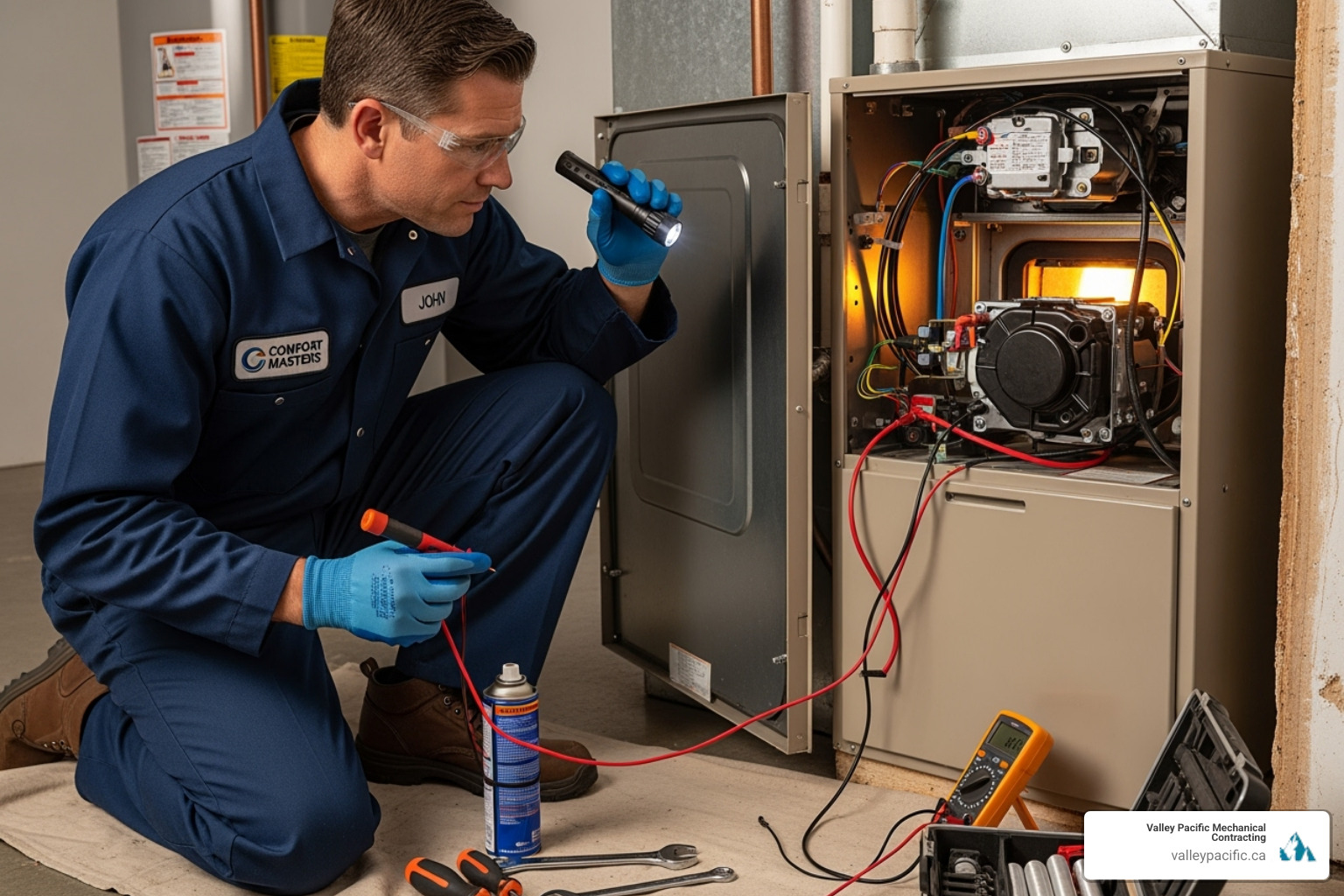
Our comprehensive inspection, which follows guidelines from sources like ENERGY STAR, includes:
- Inspecting thermostat settings for proper calibration and programming.
- Tightening all electrical connections to prevent hazards and inefficiency.
- Lubricating all moving parts to reduce friction and noise.
- Inspecting the condensate drain to prevent clogs and water damage.
- Checking all system controls for proper heating and cooling cycles.
- Cleaning evaporator and condenser coils to improve efficiency.
- Checking refrigerant levels and inspecting for leaks (for AC systems).
- Inspecting gas connections, pressure, and the heat exchanger for safety (for gas furnaces).
- Cleaning and adjusting blower components to ensure proper airflow, which can improve efficiency by up to 15%.
Whether you need AC Services in Maple Ridge, BC or other system care, our goal is a "headache-free" experience.
How Often Should You Schedule Professional Preventative HVAC Maintenance?
Consistency is key for preventative HVAC maintenance. Your system needs regular care to perform its best, not just a tune-up when something is already wrong. We recommend a bi-annual maintenance schedule:
- A spring tune-up prepares your air conditioning system for summer, preventing failures during heat waves.
- A fall tune-up ensures your furnace or heat pump is ready for winter.
This twice-yearly approach addresses potential issues before peak seasons, maintaining efficiency and preventing breakdowns. This schedule is especially critical for heat pumps, which work year-round. Sticking to a schedule, like with our Maintenance Plan, catches small issues before they become expensive problems. Whether you need Furnace Services in Maple Ridge, BC or heat pump care, we provide the expertise your system deserves.
Red Flags: Telltale Signs Your HVAC System Needs Attention
Even well-maintained HVAC systems can show signs of distress. Recognizing these red flags early can save you from a complete breakdown and costly repairs.

Your HVAC system should operate quietly in the background. When you notice the following, it's time to pay attention:
Unusual Noises: Grinding or squealing often indicates worn motor bearings or a fan belt issue. Banging or clanking can mean a loose part or a failing compressor. Excessive clicking points to electrical problems.
Strange Odors: Never ignore strange odors. A burning smell signals dangerous electrical problems; turn off the system and call a pro immediately. Musty smells suggest mold or mildew in the system, affecting air quality. A sulfur or rotten egg smell from a gas furnace indicates a potential gas leak—an emergency. Evacuate, then call your gas provider and emergency services.
Weak Airflow: If airflow from your vents is weak, your system is struggling. The cause could be a simple clogged filter, or a more serious issue like blocked ductwork or a failing fan motor.
Inconsistent Temperatures: If some rooms are hot while others are cold, or the system runs constantly without reaching the set temperature, it's a sign of a problem. This could be due to duct leaks, poor insulation, or an issue with the unit itself.
Sudden Spike in Utility Bills: An unexplained spike in your utility bills often points to an inefficient HVAC system. It's working overtime to maintain comfort, which increases your energy costs.
Catching these signs early allows you to address problems before they become emergencies. Preventative HVAC maintenance includes being alert to these signals. If you notice any of these red flags, don't wait. Our team provides reliable HVAC Services in Langley and throughout the Lower Mainland to diagnose and fix issues quickly.
Frequently Asked Questions about HVAC Maintenance
We love chatting with homeowners about their HVAC systems, and over the years, we've noticed the same questions come up again and again. Let's tackle the big questions we hear most often.
Can preventative maintenance really save me money?
Yes! The money-saving benefits of preventative HVAC maintenance are significant.
- Lower Energy Bills: An efficient system uses less energy, potentially saving you up to 30% on heating and cooling costs.
- Fewer Repairs: The EPA estimates that for every $1 spent on maintenance, you save about $4 on emergency repairs. Catching small issues early prevents them from becoming expensive emergencies.
- Longer Lifespan: Regular care can add 5 to 10 years to your system's life, saving you thousands in premature replacement costs. It's one of the smartest financial decisions for your home.
Does my brand-new HVAC system still need maintenance?
Absolutely. Most manufacturers require proof of annual professional maintenance to keep your warranty valid. Without it, you could be paying for repairs that should have been covered. Even new systems can have minor installation issues that a technician can correct. Starting a maintenance routine from day one ensures your system operates at peak efficiency and protects your investment from the very beginning.
What is the single most important DIY maintenance task?
Without a doubt, it's to change or clean your air filter regularly. A clogged filter is the number one cause of inefficiency and strain on your system. It forces the unit to work harder, leading to higher energy bills and premature wear. Check your filter monthly and replace it every 1-3 months (more often if you have pets or allergies). This simple, two-minute task has an enormous impact on your system's performance, efficiency, and your home's comfort.
A Proactive Approach to Year-Round Comfort
Taking care of your HVAC system doesn't have to be overwhelming or complicated. Think of it like tending a garden – a little regular attention keeps everything thriving, while neglect leads to problems that are much harder (and more expensive) to fix later.
The beauty of preventative HVAC maintenance lies in its simplicity. It's really about combining two straightforward approaches: the simple DIY tasks you can handle yourself and the professional expertise that ensures everything runs smoothly behind the scenes.
Your monthly filter changes, seasonal system tests, and keeping debris away from your outdoor unit might seem like small things, but they're actually powerful tools for protecting your investment. These simple habits form the foundation of system reliability – and they take just minutes of your time each month.
When you pair your diligent home care with our professional tune-ups, something wonderful happens: your HVAC system becomes virtually invisible. It quietly does its job, keeping your family comfortable without drama, surprise breakdowns, or sky-high energy bills. That's what we call a truly headache-free experience.
At Valley Pacific Mechanical, we've spent over 30 years perfecting this two-pronged approach to HVAC care. We're not just here when things go wrong – we're your partners in making sure they rarely do. Whether you're in Mission, Maple Ridge, Langley, Pitt Meadows, or Coquitlam, our team understands the unique challenges of Lower Mainland weather and how to keep your system ready for whatever Mother Nature throws our way.
The truth is, your HVAC system wants to serve you well for years to come. With consistent care and attention, it absolutely will. Don't wait for warning signs or emergency situations to think about maintenance. A proactive approach means you're always one step ahead, enjoying reliable comfort and peace of mind throughout every season.
Ready to make preventative HVAC maintenance part of your home care routine? Our comprehensive Maintenance Plan takes the guesswork out of scheduling and ensures your system gets the professional attention it deserves. And if you're interested in exploring all the ways we can keep your home comfortable year-round, learn more about our comprehensive heating solutions and find how the right equipment paired with proper care creates the perfect recipe for lasting comfort.
Your future self will thank you for the small investment you make today in your system's health and longevity.
When Your Furnace Leaves You Cold: Understanding Pilot Light Problems
Furnace pilot light repair is one of the most common heating issues homeowners face. If your furnace isn't producing heat or you can't see the small flame in the pilot assembly, you're likely dealing with a pilot light that's gone out.
Quick Answer for Furnace Pilot Light Repair:
- Turn off the gas control knob and wait 5 minutes
- Switch the knob to "PILOT" position
- Press and hold the reset button while lighting the pilot opening with a long lighter
- Hold the button for 30-60 seconds after ignition
- Release the button and turn knob to "ON"
- Call a professional if the pilot won't stay lit or you smell gas
Feeling room-temperature air from your vents instead of cozy warmth is a common winter frustration. Often, the cause is a furnace pilot light that has gone out.
A pilot light is a small, continuously burning flame that serves as an ignition source for your furnace's main burners. When it goes out—whether from drafts, dirt buildup, or equipment wear—your entire heating system shuts down as a safety measure.
While relighting a pilot light is often a straightforward DIY task, it's important to understand when the problem signals a deeper issue requiring professional attention. Situations like persistent gas odors or repeated pilot light failures should always be handled by an expert.

Understanding Your Furnace Pilot Light
Your furnace's pilot light is a small, continuously burning flame that acts as the ignition source for the main burners. When your thermostat calls for heat, the pilot light ignites the gas flowing to the burners, warming your home. Without it, your furnace cannot produce heat.
The pilot light system also includes a key safety feature: the gas safety valve. This valve works with the thermocouple, a copper rod that sits in the pilot flame. As long as the thermocouple senses heat, it signals the gas valve to stay open. If the flame goes out, the thermocouple cools and immediately tells the valve to shut off the gas supply, preventing a dangerous gas leak.
Newer furnaces often use electronic ignition systems, which create a spark or heat only when needed, making them more energy-efficient. However, many reliable older furnaces in the Lower Mainland still use standing pilot lights that have been faithfully heating homes for decades.
Signs of a Pilot Light Problem
Your furnace will usually give clear hints when there's a problem with the pilot light.
- No flame visible: The most obvious sign is the absence of the small blue flame in your pilot assembly.
- Furnace won't turn on: Your furnace may click or whir but will fail to produce heat if the pilot is out.
- Weak or flickering flame: A healthy pilot flame is strong and steady. A weak or dancing flame indicates a problem.
- Yellow or orange flame: A healthy flame is mostly blue. A yellow or orange flame signals dirt buildup or poor combustion, which can create dangerous carbon monoxide.
- Soot buildup: Black, sooty residue around the pilot assembly indicates incomplete combustion and can block the flame.
- Gas smell: The "rotten egg" smell of gas near your furnace is a serious warning. Evacuate immediately and call your gas company. Do not attempt a DIY repair.
What Causes a Pilot Light to Go Out?
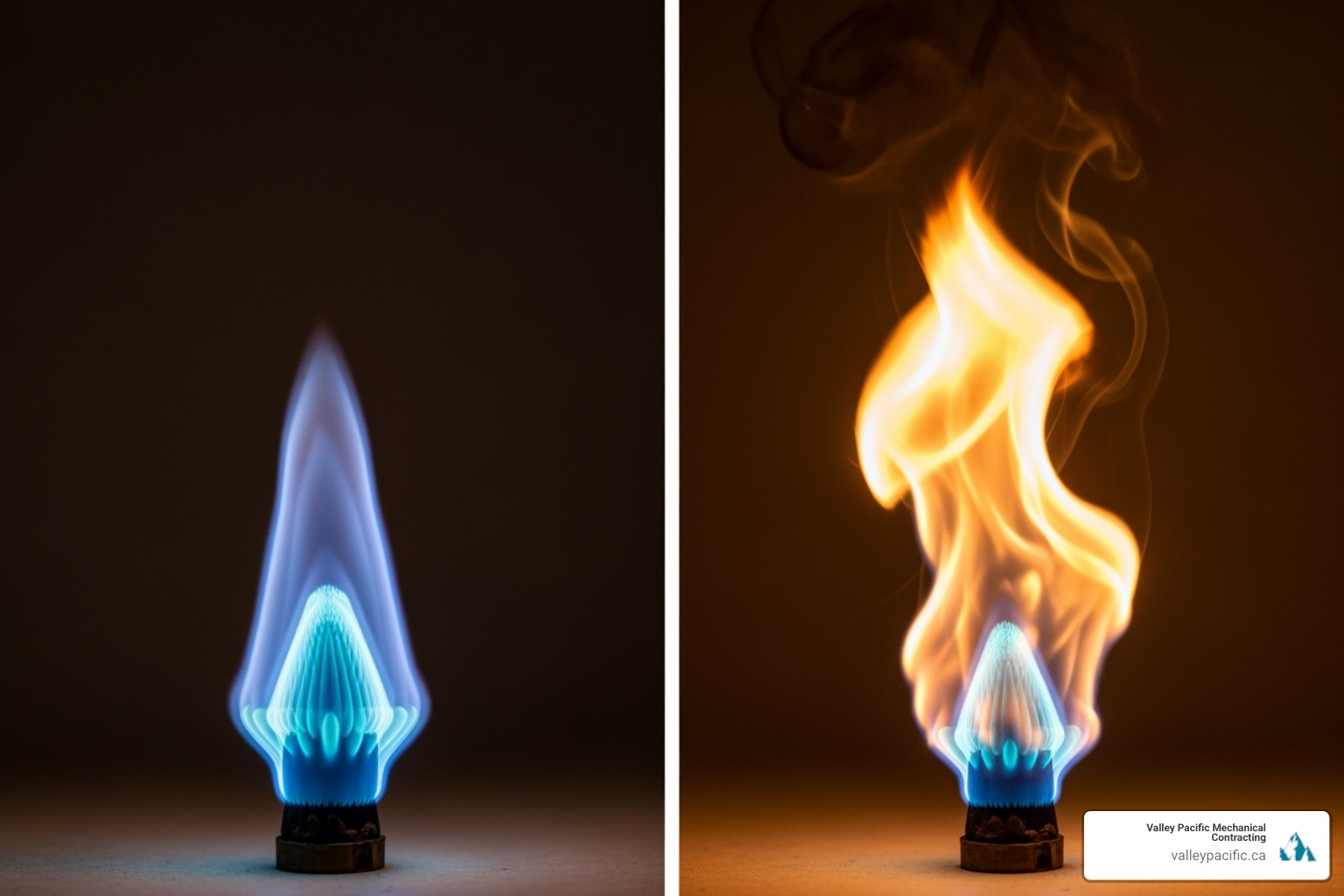
- Strong drafts: Drafts from open windows, doors, or even poorly sealed ductwork can blow out the pilot light.
- Dirty pilot orifice: The tiny opening (orifice) or clogged gas tube that supplies gas to the pilot can get blocked with dust and debris, starving the flame of fuel.
- Faulty thermocouple: A worn-out or misaligned thermocouple may not sense the flame's heat, causing it to shut off the gas supply even when the pilot is lit.
- Gas supply issues: Problems like a kinked gas line, a partially closed valve, or low pressure from your utility company can prevent the pilot from staying lit.
- Worn-out components: After years of service, parts of the pilot light assembly can simply wear out.
Step-by-Step Guide to Furnace Pilot Light Repair
A DIY furnace pilot light repair can often restore warmth to your home quickly. Before you begin, always consult your owner's manual for model-specific instructions. You will need a long-handled lighter and a flashlight.
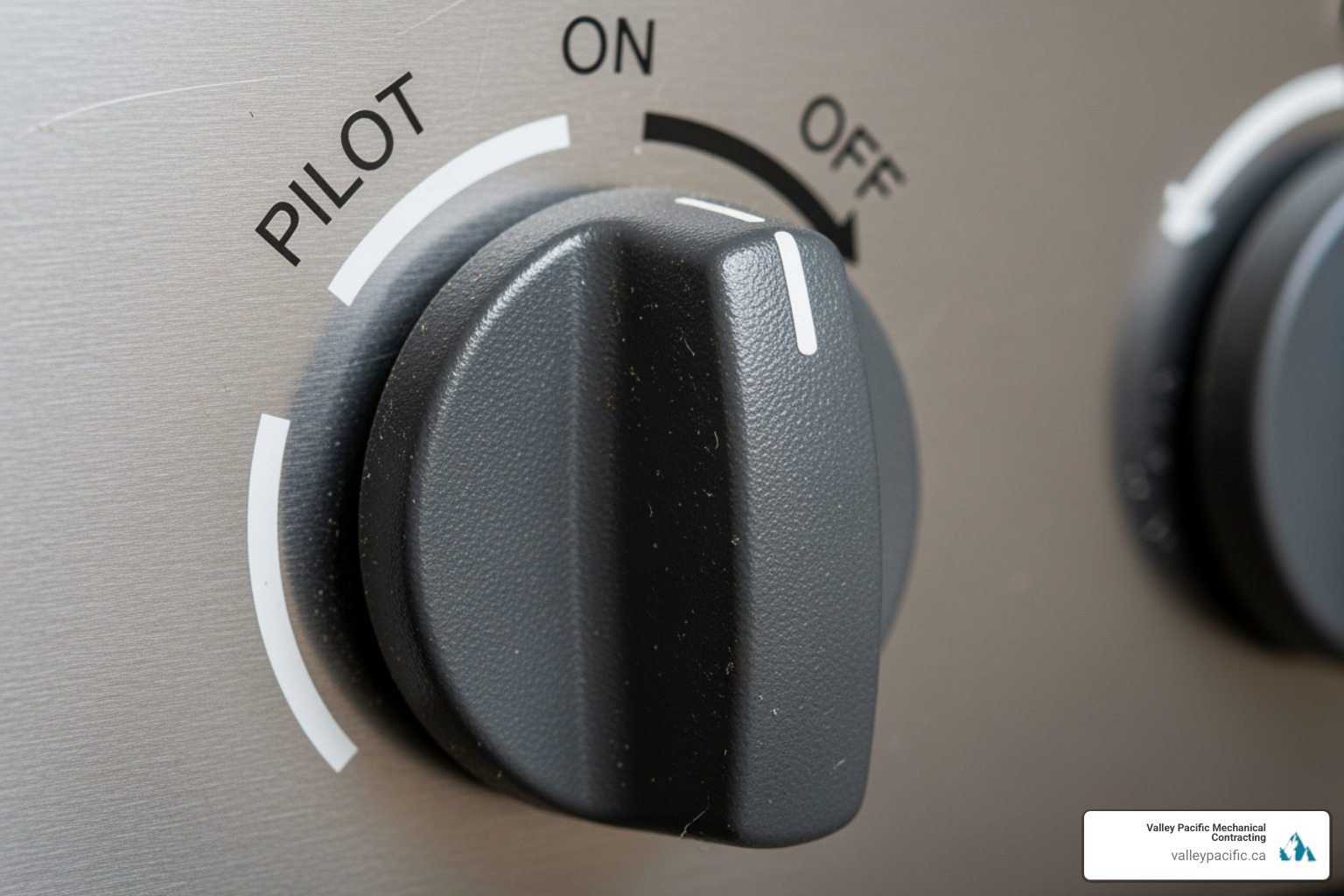
Safety First: Precautions for DIY Furnace Pilot Light Repair
Safety must be your top priority when working with gas appliances. Skipping safety steps is not worth the risk.
First, smell for gas near the furnace. If you detect the "rotten egg" odor of natural gas, this is an emergency.
If you smell gas, evacuate the house immediately. Do not use any electronics, touch light switches, or create any sparks. From a safe distance outside, call 911 or your gas company. Do not re-enter your home until a professional has declared it safe. This is critical for preventing explosions and potential carbon monoxide poisoning.
For a standard relighting procedure where you do not smell gas:
- Turn off the electrical power to your furnace at the switch on or near the unit.
- Ventilate the area by opening nearby windows or doors to help dissipate any residual gas.
- Keep ignition sources away from the work area.
- Always use a long-handled lighter to keep your hand a safe distance from the pilot assembly.
If you feel uncertain at any point, stop and call a professional. We are available 24/7 for emergencies.
How to Safely Relight Your Pilot Light
With safety covered, follow these steps to relight your pilot light.
- Locate the pilot light assembly at the bottom of your furnace, usually behind a removable access panel. You will find a control knob marked "ON," "OFF," and "PILOT."
- Turn the gas knob to "OFF" and wait a full five minutes. This critical step allows any unburned gas to dissipate safely.
- Turn the knob to the "PILOT" position. This allows gas to flow only to the pilot opening.
- Press and hold the reset button (usually red or black) while bringing the flame of your long-handled lighter to the pilot opening. The pilot should ignite.
- Continue holding the reset button for 30-60 seconds after the pilot lights. This allows the thermocouple to heat up and signal that a flame is present. Releasing the button too soon will cause the pilot to go out.
- Slowly release the reset button. The pilot flame should remain lit. If it goes out, repeat the process, holding the button for a bit longer on the second attempt.
- Turn the control knob to "ON." The main burners should ignite, and you should feel warm air from your vents shortly. Replace the access panel.
If the pilot will not stay lit after a few attempts, it likely indicates an underlying problem that requires professional service.
Troubleshooting: What If the Pilot Light Won't Stay Lit?
If your pilot light won't stay lit after following the relighting procedure, or if it goes out repeatedly, it indicates a more complex issue. These problems are your furnace's way of signaling that a component needs attention. This often requires professional Furnace Repair Maple Ridge BC.
A Dirty or Malfunctioning Thermocouple
A faulty thermocouple is the most common reason a pilot light won't stay lit. This safety sensor sits in the pilot flame. When it's hot, it generates a small electrical current that keeps the gas valve open. If the flame goes out, the thermocouple cools, the current stops, and the valve shuts off gas.
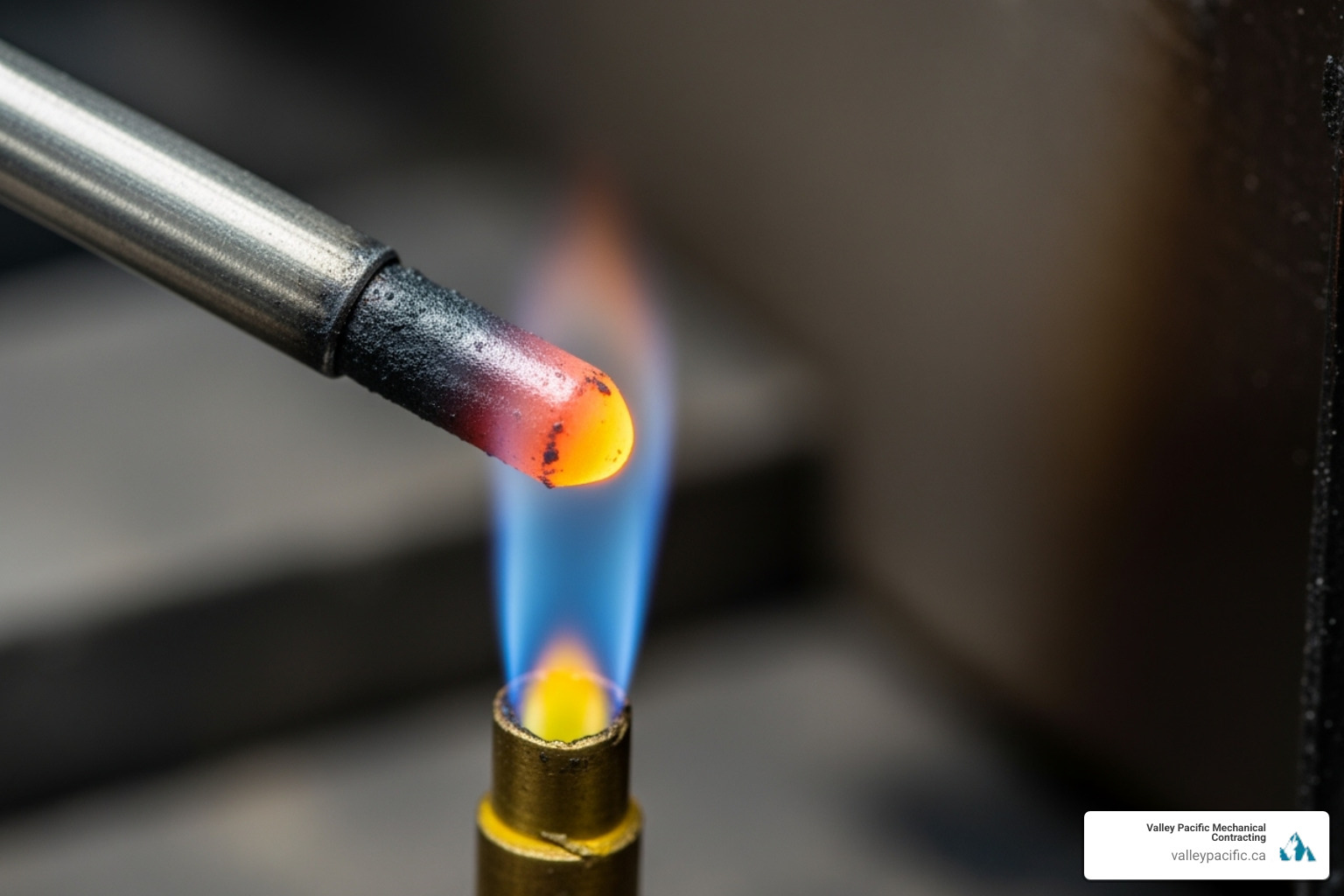
Signs of a bad thermocouple include a pilot that goes out as soon as you release the reset button. Sometimes, soot cleaning can fix the issue. You can gently clean the soot off the thermocouple rod with fine-grit emery cloth, but be careful as the component is delicate.
Misalignment is another common problem. The thermocouple must be properly positioned in the flame. If cleaning and repositioning don't work, the thermocouple likely needs professional replacement. Proper installation is critical for safety.
Drafts and Airflow Issues
Airflow issues can also extinguish a pilot light. Check for air leaks or drafts from nearby windows, doors, or unsealed vents.
A cracked heat exchanger is a serious safety hazard that can disrupt airflow and leak dangerous gases into your home. This requires immediate professional evaluation.
Improper ventilation can cause backdrafting, where exhaust gases are pulled back into the furnace area, extinguishing the pilot and creating a carbon monoxide risk. Securing the area by ensuring vents are not blocked and the room is not excessively drafty can sometimes solve the problem.
When DIY Furnace Pilot Light Repair Isn't Enough
Know when to stop a DIY repair and call a professional for your safety. Contact an expert for Heating Repair Maple Ridge BC in these situations:
- Repeated failures: If the pilot light repeatedly goes out, it's a sign of an underlying problem that needs a professional diagnosis.
- Persistent yellow flame: A yellow flame, even after cleaning, indicates incomplete combustion and a potential carbon monoxide risk.
- Visible damage to components: Any visible damage to gas lines, valves, or fittings requires professional repair.
- Hissing sounds: This likely indicates a gas leak. Evacuate and call for professional help immediately.
- If you feel unsure: Trust your instincts. If you are uncertain at any point, it is always safest to call a professional.
Prevention, Maintenance, and Modern Alternatives
The best way to handle furnace pilot light repair is to prevent the problem from happening in the first place. Regular maintenance is key to your furnace's longevity, efficiency, and safety. This is where professional Furnace Services Maple Ridge BC become invaluable.
The Role of Regular Furnace Maintenance
Your furnace requires annual tune-ups to run reliably, especially before the heating season begins. During a professional tune-up, a technician will perform critical tasks like:
- Cleaning the pilot assembly: Removing soot and debris prevents one of the most common causes of pilot light failure.
- Checking gas pressure: Ensuring the correct fuel supply for safe and efficient operation.
- Inspecting for wear: Catching worn-out parts like the thermocouple before they fail.
This comprehensive maintenance optimizes overall performance, leading to lower energy bills and an extended furnace life.
Upgrading to a Modern Furnace
If you have an older furnace with a standing pilot light, upgrading to a modern unit can be a smart long-term solution. Modern furnaces use electronic ignition systems (like an intermittent pilot or hot surface ignitors) that only create a flame when heat is needed. This eliminates pilot light problems entirely.
The efficiency gains are significant. While older furnaces may operate at 50-70% efficiency, modern ENERGY STAR models can reach AFUE ratings of 94% to 98.5%. This means more of your money goes toward heating your home. You can explore these options at ENERGY STAR models.
The long-term savings are substantial, as you eliminate the wasted gas from a constantly burning pilot light, leading to lower utility bills.
If your furnace is over 15-20 years old, requires frequent repairs, or your energy bills are rising, it may be time to consider an upgrade. We can help you assess whether a replacement makes sense for your home in Mission, Langley, Pitt Meadows, Coquitlam, or anywhere else we serve in the Lower Mainland.
Frequently Asked Questions about Pilot Light Issues
Here are answers to the most common questions we receive about furnace pilot lights from homeowners across the Lower Mainland.
Why does my furnace pilot light keep going out?
This is the most common issue we see. The top three causes are:
- A faulty or dirty thermocouple: The safety sensor that detects the flame may be unable to do its job, causing it to shut off the gas.
- A clogged pilot orifice: Dirt and debris can block the tiny opening for gas, leading to a weak flame that easily goes out.
- Strong drafts: Airflow from open windows, doors, or ventilation issues can blow out the flame.
Repeated outages signal an underlying problem that requires a professional.
What does a healthy pilot light flame look like?
A healthy pilot flame is strong, steady, and mostly blue, with a small yellow tip. A weak, flickering, or mostly yellow/orange flame indicates a problem, such as dirt, an improper fuel mixture, or low gas pressure. This is a potential safety issue, as it can produce carbon monoxide, and should be addressed.
Is it safe to relight a pilot light myself?
Yes, it is generally safe for a homeowner to relight a pilot light, provided you carefully follow all safety procedures. This includes turning off the gas, waiting five minutes for any gas to dissipate, ensuring good ventilation, and using a long-handled lighter.
However, you should always call a professional instead if:
- You smell gas at any point.
- You are uncomfortable or uncertain about the process.
- The pilot light will not stay lit after one or two attempts.
Your safety is the top priority. We offer 24/7 emergency service precisely because we know heating problems don't wait for business hours.
Your Local Experts for Reliable Heating
When your furnace pilot light repair needs go beyond a simple DIY fix, you need professionals who understand that heating problems don't wait for convenient moments. A pilot light that repeatedly goes out isn't just frustrating – it's often your furnace's way of telling you something more serious needs attention.
At Valley Pacific Mechanical Contracting, we've been solving heating puzzles for over 30 years across the Lower Mainland. Our certified technicians have seen every type of pilot light problem imaginable, from stubborn thermocouples that refuse to cooperate to mysterious drafts that seem to blow out flames at the worst possible moments.
What sets us apart is our commitment to making your heating experience truly headache-free. We know that when your furnace stops working on a freezing February night, you need help immediately – not during regular business hours. That's why we offer 24/7 emergency service to homeowners in Mission, Maple Ridge, Langley, Pitt Meadows, and Coquitlam.
Whether you're dealing with a pilot light that won't stay lit, considering an upgrade from your older furnace to a modern system with electronic ignition, or simply want the peace of mind that comes with professional maintenance, we're here to help. Our Daikin Comfort Promise ensures you receive quality service custom specifically to your home's unique heating needs.
Sometimes the best solution isn't repairing an aging system, but investing in the efficiency and reliability of a new furnace. If you're ready to say goodbye to pilot light problems forever, contact us for expert furnace installation in Langley, BC or any of our comprehensive heating services. We're here to keep your home warm, safe, and comfortable all winter long.
The furnace blower motor plays a key role in keeping Maple Ridge homes warm during the colder months. It is responsible for pushing heated air through your home’s ductwork and into every room. When it is working properly, the airflow feels smooth, controlled, and consistent. But when the blower motor begins to fail, it can affect your entire heating system and leave your living space cold and uncomfortable.
Homeowners often mistake blower motor issues for a dirty filter or a faulty thermostat. While those are possible causes, blower motor failure is a pattern that shows up over time with some clear signs. Sudden changes in temperature, poor airflow, and new noises from the furnace can all point to a deeper mechanical issue. Knowing what to listen for and what to look out for can make the difference between a small furnace repair in Maple Ridge and an unexpected system shutdown.
Understanding the Furnace Blower Motor
A furnace does not just heat the air. It also needs a way to move that heated air throughout your home. That job falls to the blower motor. It powers a fan that sends warm air into your ducts and through your vents. Whether you have a single-stage, two-stage, or variable-speed model, the blower motor is working every time your furnace kicks on.
The airflow you feel coming from the vents is directly tied to how well this part is operating. If the motor is starting to wear out or getting stuck, you will notice parts of your home becoming cooler than others, or airflow slowing down even when the furnace is running. This is more than just an inconvenience. A weak blower motor can make your energy bills creep up as the system works harder to meet your temperature setting.
It also impacts overall system safety. If the motor fails entirely, your furnace may overheat, which can lead to more parts burning out or the entire system shutting down as a protective measure. As fall progresses in Maple Ridge and you rely on your furnace more, these risks become harder to ignore. Something as simple as a dusty ventilation system or a slight resistance in the fan’s movement can lead to major trouble if left unchecked.
Common Signs You May Need Furnace Blower Motor Repair
No one wants their furnace to quit during a chilly night in Maple Ridge, but furnaces do not typically stop working without warning. The blower motor often gives signs that it needs attention before it reaches the point of complete breakdown. Paying attention to these signs early can help you avoid bigger repairs down the road.
Here are some common symptoms that suggest it is time to schedule furnace repair in Maple Ridge:
- Unusual noises: Grinding, squealing, or rattling sounds from the furnace area can indicate worn bearings or loose parts inside the blower motor.
- Weak airflow: If you notice less air coming from your vents, even when the furnace is running, the blower motor might be running slow or struggling to turn the fan.
- Inconsistent temperatures: One room may feel comfortable while another is chilly. This uneven heating often traces back to poor air movement.
- Frequent system shutdowns: Some furnaces will shut down during a cycle to prevent overheating. A worn blower motor can cause this to happen regularly, leaving your home colder than expected.
- High power bills: A blower motor that struggles to start or runs inefficiently can draw more power than usual, even though your usage habits have not changed.
It is common for homeowners to chalk these symptoms up to age or wear and tear elsewhere in the system. But ignoring them could allow a minor part issue to grow into a full system failure. If any of the signs above sound familiar, it is time to call on our technicians and schedule an inspection. A fast, accurate repair can get your blower motor back on track before heating season hits full swing.
Troubleshooting Tips for Homeowners in Maple Ridge
When a furnace shows signs of trouble, many homeowners naturally want to check things themselves before reaching out for furnace repair in Maple Ridge. While it is always best that our professionals handle HVAC service, you can still perform a few safe and simple steps to help narrow down the issue.
Start with these troubleshooting tips:
- Check your furnace filter. A clogged filter can restrict airflow, putting strain on the blower motor.
- Make sure your thermostat is set correctly and has working batteries.
- Look at your vents. Make sure furniture or curtains are not blocking them and that each register is open.
- Listen for unusual sounds such as rattling or squealing. These can point to internal motor problems.
- Inspect your home’s air return grilles for any buildup of dust or pet hair.
If you have checked those areas and the problem continues, or the furnace shuts off during heating cycles, it could be something inside the motor or electrical components. At that stage, it is smart to stop troubleshooting and schedule a visit from our technicians. Attempting to open or repair the blower motor alone can lead to more damage or safety issues. Something as simple as a misaligned fan blade can lead to noise and heat buildup. It is always safer to let trained technicians handle the deeper diagnostics and repairs.
Why Timely Furnace Repair Matters
Delaying furnace repair when the blower motor is failing can quietly create new problems. When a motor runs harder than it should, parts wear out faster. You may notice other components begin to show signs of stress, like the limit switch or heat exchanger. These issues often stack up and lead to higher repair costs.
Another concern is long-term energy use. A blower motor that stalls or takes longer to cycle up uses more power than usual. And since it impacts airflow, it might cause the thermostat to run longer to reach your set room temperature. That adds up on monthly heating bills, especially as the colder temperatures deepen through fall.
Getting service promptly also protects comfort. In Maple Ridge, heating problems get noticed quickly as daily temperatures drop. That brief window between fall and early winter is the best time to fix minor furnace issues before they grow into expensive emergencies.
Keep Your Home Warm and Your System Running Smoothly
The condition of your furnace blower motor can make a noticeable difference in how warm and comfortable your home feels once cooler weather sets in. If airflow is weak or heat distribution seems uneven, do not assume the rest of your system is working fine. Those small clues often point to a blower issue that is just beginning.
Scheduling routine inspection and maintenance can prevent sudden failures and help spot problems early. It is easier to address a noisy fan or weak motor now rather than wait until your system stops working altogether. Paying attention to signs like strange noises, airflow changes, or repeated shutoffs gives you time to take action before indoor temperatures become a concern.
If your home is experiencing uneven temperatures or unusual furnace noise, addressing the issue early can help you avoid unexpected breakdowns. Timely furnace repair in Maple Ridge can restore reliable comfort and keep your system running efficiently. Trust Valley Pacific Mechanical Contracting Ltd for expert solutions, and for a quick estimate or to book a service visit, please contact us today.
Your First Line of Defense Against a Flooded Basement
Sump pump repair is often an urgent need when a basement's first line of defense against flooding has failed. Here's what you need to know right away:
Common Sump Pump Problems & Quick Solutions:
- Won't turn on - Check power, GFCI outlet, and float switch
- Runs constantly - Inspect float switch and check valve
- Strange noises - Clean debris, check for worn bearings
- Cycles too frequently - Adjust float switch, verify check valve
- Visible rust or corrosion - Consider replacement if extensive
Many homeowners don't think about sump pump maintenance until they're standing ankle-deep in a flooded basement. Your sump pump works silently to remove groundwater, preventing thousands of dollars in damage to your home's foundation, flooring, and belongings.
The typical lifespan of a sump pump is between 7 to 10 years, but proper maintenance can extend this significantly. Well-maintained pumps last longer with regular care.
When your pump acts up, quick action can mean the difference between a simple repair and a costly basement flood. Knowing the warning signs and when to call a professional will save you time and money.
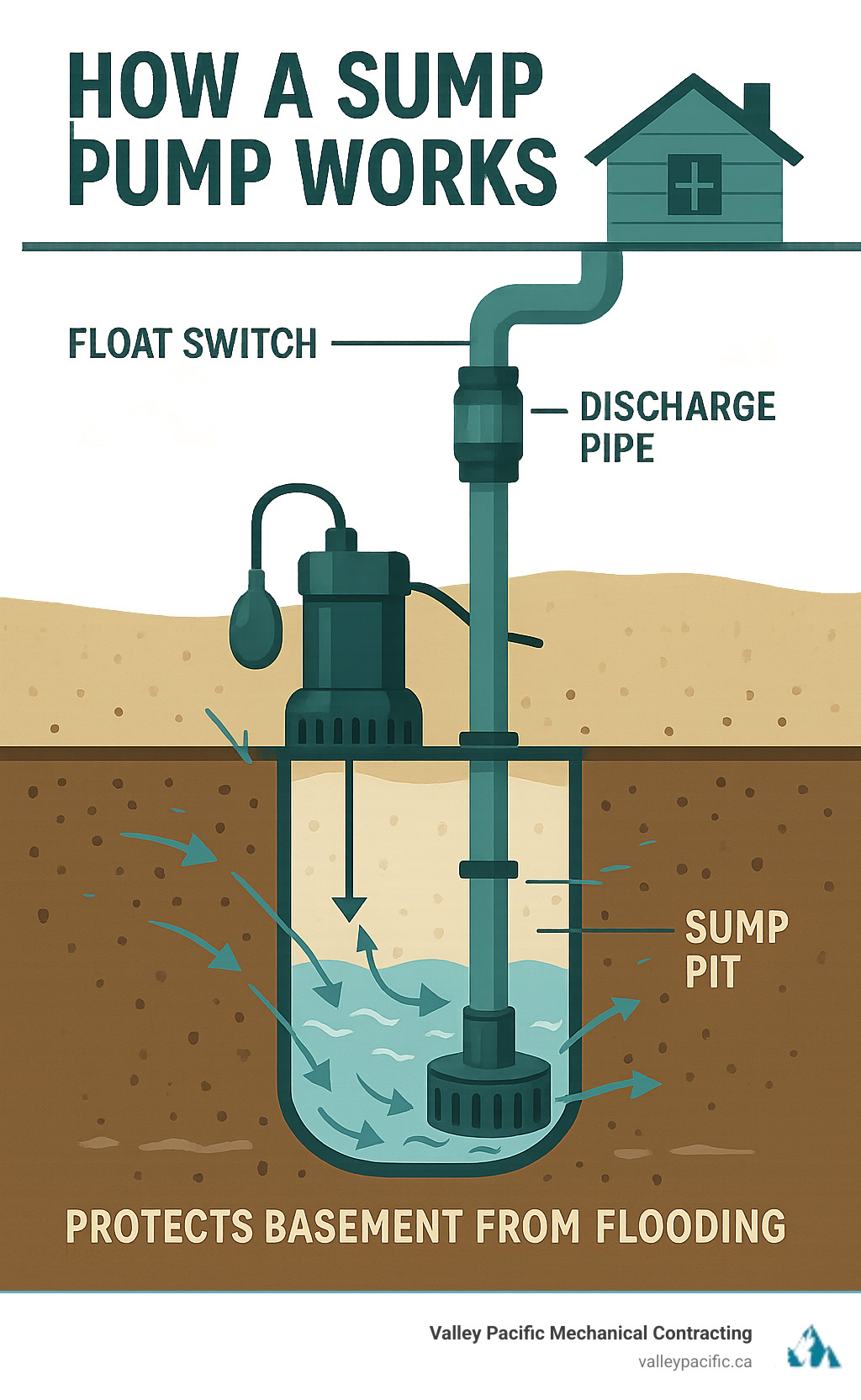
Is Your Sump Pump Crying for Help? 7 Telltale Signs of Failure
Your sump pump quietly protects your home, but it will show warning signs when something is wrong. Recognizing these signs can prevent a basement flooding disaster.
Strange noises are often the first cry for help. If your pump suddenly makes grinding or rattling noises, pay attention. These sounds often mean a bent impeller, worn bearings, or stuck debris. Ignoring them can lead to bigger problems.
During monthly checks, look for visible rust on the pump. While minor rust is normal, extensive corrosion can compromise the pump's effectiveness.
Pay attention to the pump's cycle. A pump that's running constantly is working too hard and heading for burnout. Conversely, if your pump cycles infrequently during heavy rains, it might not be keeping up with the incoming water.
Excessive vibration is another red flag that something is mechanically wrong. Also, don't ignore musty odors in your basement; even without visible water, they can signal that your pump isn't managing moisture properly.
If you're noticing any of these warning signs, our team at Valley Pacific is here to help with professional plumbing services in Maple Ridge BC to keep your basement dry and your mind at ease.
The Pump Runs Non-Stop
When your sump pump runs constantly, it needs immediate attention. A pump that never stops is working too hard and is at risk of burning out.
The most common culprit is float switch issues. This device tells the pump when to start and stop. If it's stuck in the "on" position or tangled, the pump will run even when the pit is dry.
Sometimes the issue is that the pump is simply undersized for the job. It can't keep up with the amount of water it needs to handle, so it runs continuously.
Check valve failure is another problem. This valve prevents water from flowing back into the pit after being pumped out. If it fails, water keeps returning, forcing the pump to run constantly.
In some cases, you might have an unusually high water table. While not a pump failure, this puts tremendous strain on your system and increases your motor burnout risk.
The Pump Won't Turn On
It's panic-inducing to see water rise in your sump pit while your pump won't start. When this happens, time is not on your side.

Start with the basics: power loss. Check if the pump is plugged in and the outlet is working. Storms can cause tripped breakers or trip the GFCI outlet, which cuts power when it detects a fault.
A jammed float switch is a frequent reason pumps won't activate. The switch must move freely with the water level. If it's stuck, tangled, or blocked by debris, it can't activate the pump.
Check for a clogged intake as well. Dirt or debris can block the pump's intake screen, preventing water from entering. The pump won't be effective with a blocked intake.
The most serious scenario is motor failure. When motors burn out from age or overwork, a full replacement is usually more cost-effective than a sump pump repair.
The Pump Cycles Too Frequently
If your pump turns on and off too often, it's "short-cycling." This constant starting and stopping wears out the motor much faster.
Incorrect float switch adjustment is often the culprit. If the float is set too low, the pump activates with very little water, causing it to turn on and off repeatedly as the pit refills.
A missing or broken check valve allows water to flow back into the pit after the pump shuts off, forcing it to restart.
An undersized sump pit also causes frequent cycling. The small pit fills rapidly, forcing the pump to run more often, which puts stress on the system and shortens its lifespan.
Your Guide to Sump Pump Repair: Troubleshooting Common Failures
When your sump pump acts up, it's understandable to feel a sinking feeling. The good news is that many sump pump repair issues can be diagnosed and fixed with basic troubleshooting before you call a professional.
Before we dive in, let's talk safety. Always turn off the power at the circuit breaker before touching your sump pump. Water and electricity are a dangerous mix, so your safety is paramount.
Understanding your pump type is the first step in troubleshooting. Different pump types have their own quirks.
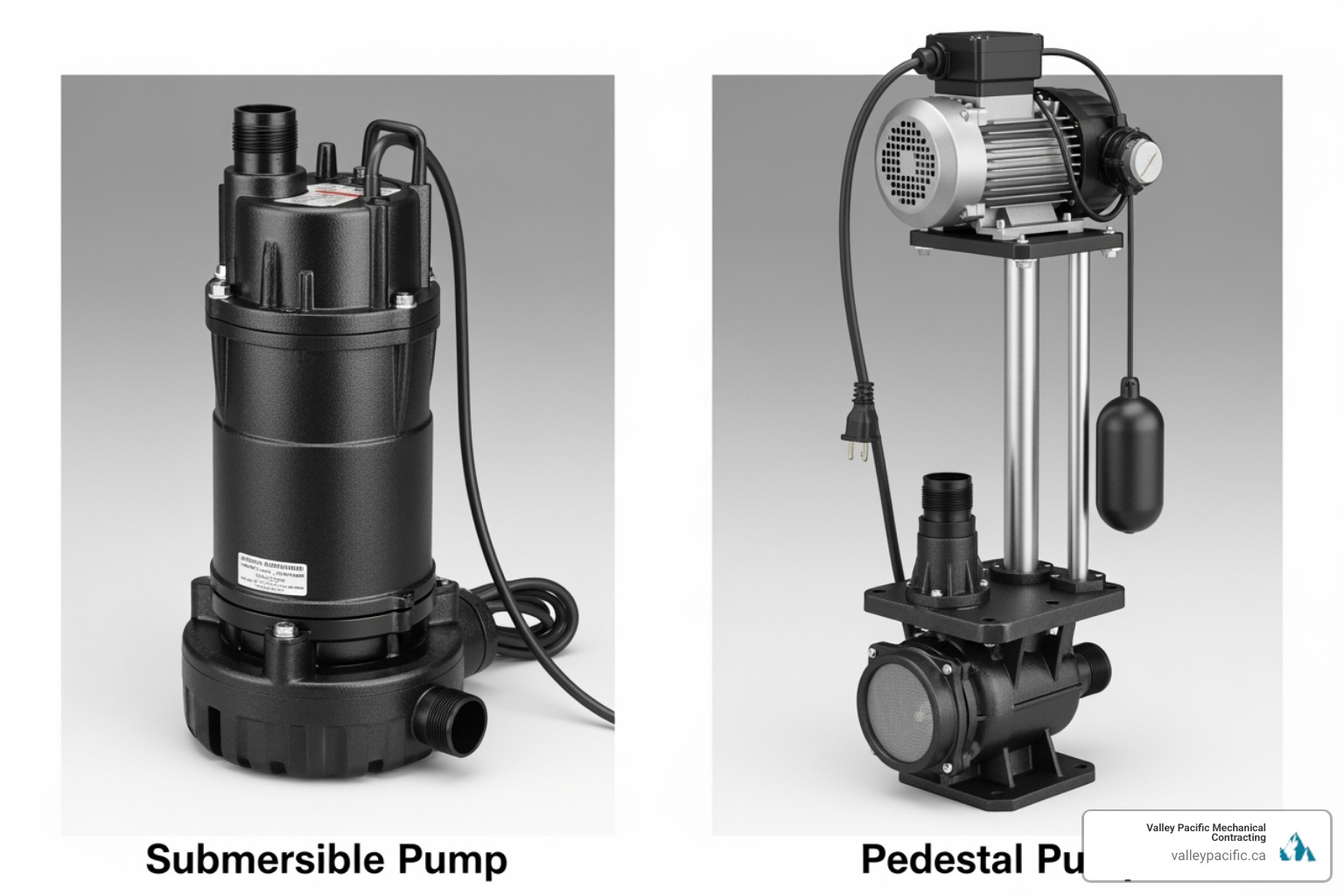
Comparing Submersible vs. Pedestal Sump Pumps
The two main types of sump pumps have different strengths and common issues. Knowing your pump type helps you identify problems and approach repairs correctly.
| Feature | Submersible Sump Pumps | Pedestal Sump Pumps |
|---|---|---|
| Placement | Entirely submerged in the sump pit | Motor sits above the sump pit, pump is at the bottom |
| Noise Level | Generally quieter, as water dampens motor noise | Louder, as the motor is exposed to air |
| Lifespan | Often shorter due to constant water exposure and heat | Can be longer if well-maintained, motor is cooler |
| Common Problems | Seal failure, motor overheating, debris clogging | Float switch issues (more exposed), impeller clogs |
| Ideal Use Cases | Basements where noise reduction is a priority, smaller pits | Basements with very deep pits, longer lifespan desired, budget-friendly |
Submersible pumps are submerged, making them quiet but susceptible to moisture and heat. Pedestal pumps have an exposed motor, making them noisier but easier to service.
DIY Sump Pump Repair: What You Can Safely Handle
Many homeowners can handle basic sump pump repair work themselves. With patience, you can save money on a service call.
Float switch problems are often easy fixes. If your pump won't turn on or runs constantly, check the float switch. Ensure it can move freely, untangling it if needed. Adjusting the float switch can also prevent short-cycling.
Debris removal is a key maintenance step. After turning off the power, lift the pump out of the pit. You'll likely find leaves, dirt, and small stones. Use a garden hose to rinse the pump, focusing on the intake screen and impeller. A plastic scraper can remove stubborn buildup.
Cleaning the pit is also important. Sediment settles in the pit over time. Use a wet-dry vacuum to clean it out, giving your pump a clean environment.
Discharge line clogs can disable your pump. Check the exterior discharge pipe for blockages like leaves or ice. Clear visible obstructions, but call a professional for deep clogs.
Testing your pump after maintenance is crucial. Pour five gallons of water into the pit. The pump should turn on, pump the water out, and shut off. If it doesn't, further investigation is needed.
When to Call for Professional Sump Pump Repair
While DIY repairs are satisfying, some situations require professional expertise. Knowing when to call an expert can prevent bigger problems.
Motor issues are usually beyond DIY repair. If the pump won't run after basic checks or you smell something burning, the motor has likely failed. Replacement is usually more cost-effective than repair.
Electrical problems like faulty wiring or internal issues require a professional due to safety risks. Our licensed technicians can safely diagnose these complex problems.
Bearing replacement and other internal mechanical issues often signal the end of a pump's life. Grinding noises or excessive vibration point to problems that require specialized tools and expertise.
Major leaks from the pump housing or cracked seals need professional assessment to prevent future flooding.
When DIY troubleshooting fails or you're not comfortable with the repair, professional help ensures the job is done right. A malfunctioning pump leaves your home vulnerable to costly water damage—it's not worth the risk.
Our team at Valley Pacific Mechanical Contracting offers comprehensive Sump Pump Repair Services throughout the Lower Mainland. We're here when you need us most.
Proactive Protection: Sump Pump Maintenance and Testing
An ounce of prevention is worth a pound of cure, especially for your sump pump. Regular maintenance and testing extend your pump's lifespan and help you avoid a flooded basement.
Your sump pump sits ready to act when needed, but it requires regular care to perform its best. A well-maintained pump can last 10 years or more, while a neglected one might fail in half that time.

Sump pump maintenance is straightforward work that prevents expensive emergencies. Seasonal checks and testing are an insurance policy against water damage, ensuring your home is ready for any weather.
Your Annual Maintenance Checklist
Spring and fall are the perfect times for maintenance, as they bring the heaviest rainfall and snowmelt. You want your pump ready before the weather gets rough.
Start by testing the pump. Ensure it's plugged in, then pour about 5 gallons of water into the pit. The pump should activate, pump the water out, and shut off. If it struggles or fails to start, you've caught a problem early.
Always unplug the pump before any hands-on work. Once disconnected, lift the pump out for cleaning. Use a garden hose to rinse dirt and debris from the intake screen and impeller. A plastic scraper can remove stubborn grime. Here's a detailed guide on cleaning your sump pump that walks you through the process.
Don't forget about the sump pit itself. A wet-dry vacuum quickly removes sludge and debris from the bottom of the pit.
Give everything a good visual inspection. Test the float switch to ensure it moves freely. Check the inlet screen for damage. Replace any worn or damaged parts now to prevent failure during a storm.
Check your discharge area to ensure water can flow freely. The exit point outside should be clear of leaves, dirt, or ice. Ensure the discharge pipe directs water at least 20 feet from your foundation to prevent it from seeping back. Also, verify the check valve works, allowing water to flow only one way.
Most modern pumps have sealed bearings that don't need lubrication, but if you have an older model, consult your manual to see if any parts need oil.
This proactive care is what we help homeowners with every day. Our comprehensive Maintenance Plan takes the guesswork out of keeping your sump pump and other critical home systems in peak condition.
How Often to Test Your Sump Pump
Beyond the annual inspection, test your pump at least twice a year, ideally in spring and fall when rainfall is heaviest.
Before any major storm, take five minutes to run a quick test. You don't want to find a failed pump during a flood. The simple "pouring water method" is a quick and effective test.
Pre-storm testing has saved countless homeowners from flooded basements. A quick test before a storm provides peace of mind or alerts you to problems with enough time to fix them. This small habit can prevent huge headaches.
If a test reveals any sump pump repair needs, address them immediately. A struggling pump will likely fail when you need it most.
Frequently Asked Questions about Sump Pump Repair
We often hear the same questions about sump pump repair. It's a component you don't think about until it fails. Let's address common concerns to help you make informed decisions about your home's flood protection.
What is the average lifespan of a sump pump?
Most sump pumps last 7 to 10 years. However, this varies. Well-maintained pumps can last over 12 years, while neglected ones may fail after just 5.
Several factors affect how long your pump will last. The pump's quality and frequency of use are key. An undersized budget pump will burn out faster than a properly sized, quality unit. A pump that runs often works harder and wears out sooner.
Maintenance makes a massive impact. Regular cleaning, repairs, and testing can significantly extend your pump's life, much like regular oil changes for a car.
Some experts suggest proactive replacement every 10 years. Consider the cost of proactive replacement versus dealing with a flooded basement when an old pump fails during a storm.
How much does sump pump repair cost?
This is a common question, but the cost depends entirely on the problem.
Cost factors vary based on the issue. A simple problem like a clogged intake or stuck float switch is a minor fix many homeowners can handle themselves, costing only their time.
For a burnt-out motor, major electrical problems, or extensive corrosion, repair costs can be high. Often, a full major component replacement is more economical than rebuilding an old pump.
The repair versus replacement decision depends on the pump's age and the problem's extent. If an 8-year-old pump needs a new motor, a new unit with a warranty is often the better investment. Our professional service fees are transparent, and we'll help you choose the best option for your budget.
Should I get a battery backup for my sump pump?
A battery backup is one of the smartest investments you can make. Power outages often happen during storms, exactly when you need your pump most.
During a storm, a power outage can disable your electric pump, leaving your basement vulnerable to flooding precisely when you need protection most.
Battery backup systems and water-pressure-powered backups are the two main types. Battery systems are common and run for hours, while water-powered backups use your home's water pressure to operate as long as you have municipal water.
The added security and peace of mind are invaluable. A battery backup can save your basement during power outages. It's a small investment compared to the cost and stress of a flooded basement.
Think of it as insurance for your insurance: the backup protects you when the primary pump can't.
Keep Your Basement Dry with Expert Help
Your sump pump is the unsung hero protecting your basement from water damage. When it fails, the stress is overwhelming. A flooded basement is a nightmare, often preventable with timely sump pump repair.
For over 30 years, Valley Pacific Mechanical Contracting has helped homeowners in the Lower Mainland, from Mission to Langley, stay dry. Our technicians understand our region's unique weather and groundwater challenges.
We know that sump pump emergencies don't follow a 9-to-5 schedule. Pumps often fail when you least expect it, like during heavy rains at night. That's why we offer 24/7 emergency service, so your peace of mind doesn't have to wait.
Our approach is simple: quick diagnosis, clear options, and efficient repairs. We provide reliable, headache-free service with no jargon or surprise fees, from people who care about keeping your basement dry.
Our skilled team has seen it all, from strange noises to complete failures. We'll assess if you need a simple repair or if it's time for a replacement, always considering your home's needs and your budget.
Don't wait until you're standing in water to take action. Proactive maintenance and timely repairs are your best defense against costly basement flooding.
Why Residential Heat Pumps Are Revolutionizing Home Comfort
A residential heat pump is an all-in-one heating and cooling system that transfers heat rather than generating it, making it up to 75% more energy-efficient than traditional electric heating systems. Here's what makes heat pumps special:
Key Benefits:
- Year-round comfort - provides both heating and cooling
- Energy efficient - reduces electricity use by up to 75% compared to electric resistance heating
- Environmentally friendly - no fossil fuel burning required
- Cost-effective - lower operating costs than traditional systems
- Reliable - works effectively even in cold climates like BC's Lower Mainland
How It Works:Heat pumps operate like a refrigerator in reverse. In winter, they extract heat from outside air (even when it's cold) and transfer it inside. In summer, they reverse the process to cool your home.
If you're tired of high energy bills from separate heating and cooling systems, heat pumps offer a smart solution. They're particularly well-suited for BC's moderate climate, where temperatures rarely drop to extremes.
Modern heat pumps can extract significant heat even at -18°C, containing 85% of the heat available at 21°C. This means reliable heating performance throughout most Canadian winters.
The technology has advanced dramatically. Today's cold climate heat pumps work efficiently down to -22°F (-30°C), making them viable alternatives to furnaces in most regions.
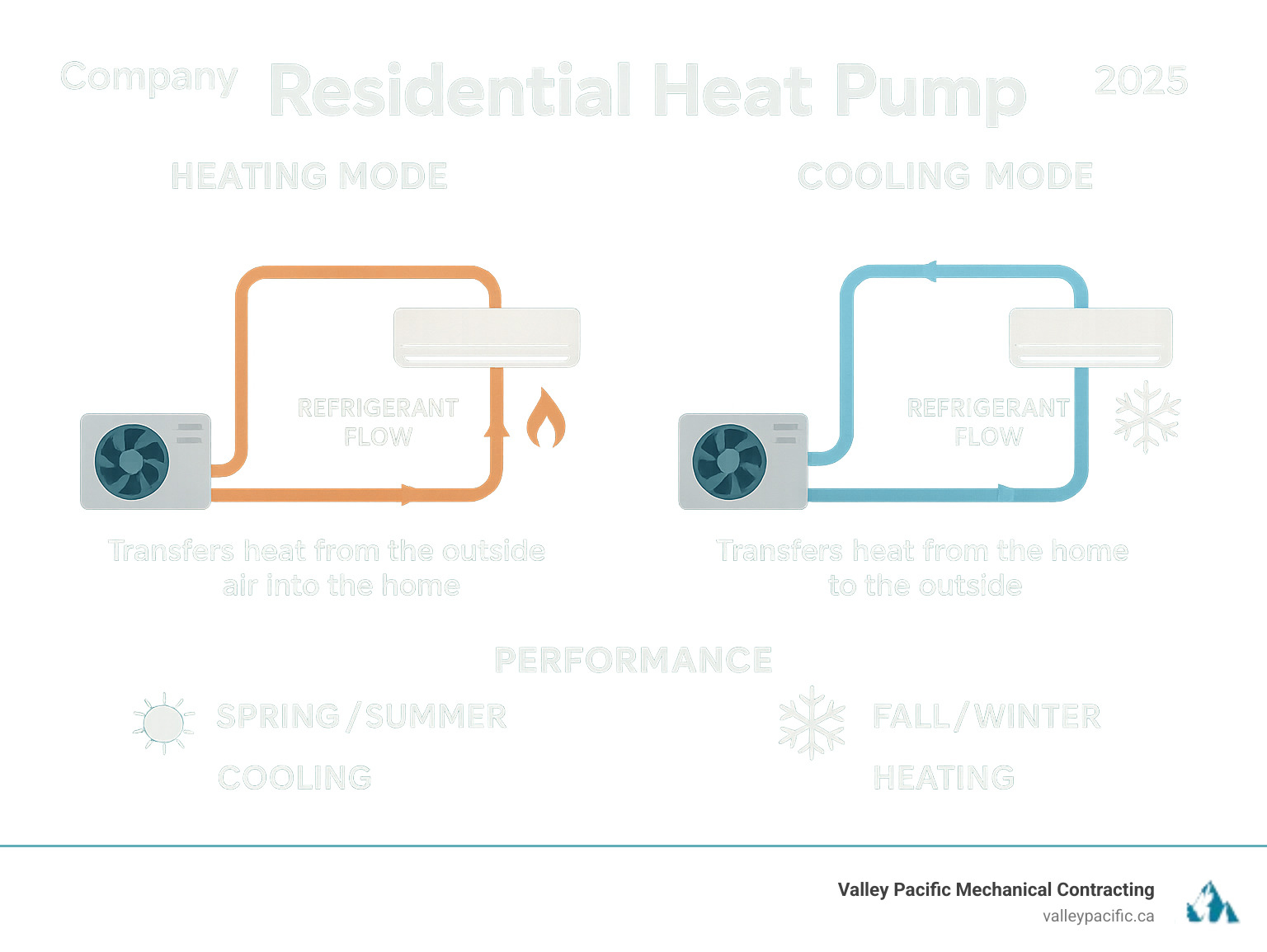
What is a Residential Heat Pump and How Does It Work?
Picture this: you have one system that keeps you cozy in winter and cool in summer, all while using less energy than your old furnace and air conditioner combined. That's the beauty of a residential heat pump – it's like having a temperature wizard that moves heat around instead of creating it from scratch.
The secret behind this magic lies in something called the refrigeration cycle. It's the same principle that keeps your fridge cold, but heat pumps are smart enough to work in reverse. Instead of burning fuel to make heat, they simply transfer heat from one place to another – and they're incredibly good at it.
Here's how the dance works: refrigerant (a special liquid) flows through your system, picking up heat from one location and dropping it off somewhere else. The outdoor unit sits outside your home, while the indoor unit (also called an air handler) lives inside, usually in your basement or utility room.
The real star of the show is the reversing valve – think of it as a traffic director for heat. In heating mode, it tells the system to grab heat from outside air (yes, even when it's freezing!) and bring it indoors. When you switch to cooling mode, it flips the script and moves heat from inside your house to the great outdoors.
What makes this so efficient? Instead of creating heat, your heat pump just moves it around. This clever approach means modern systems can reduce your electricity use for heating by up to 75% compared to electric baseboard heaters. Thanks to advancements in air-source heat pump technology, these systems now work beautifully even in our Lower Mainland winters.
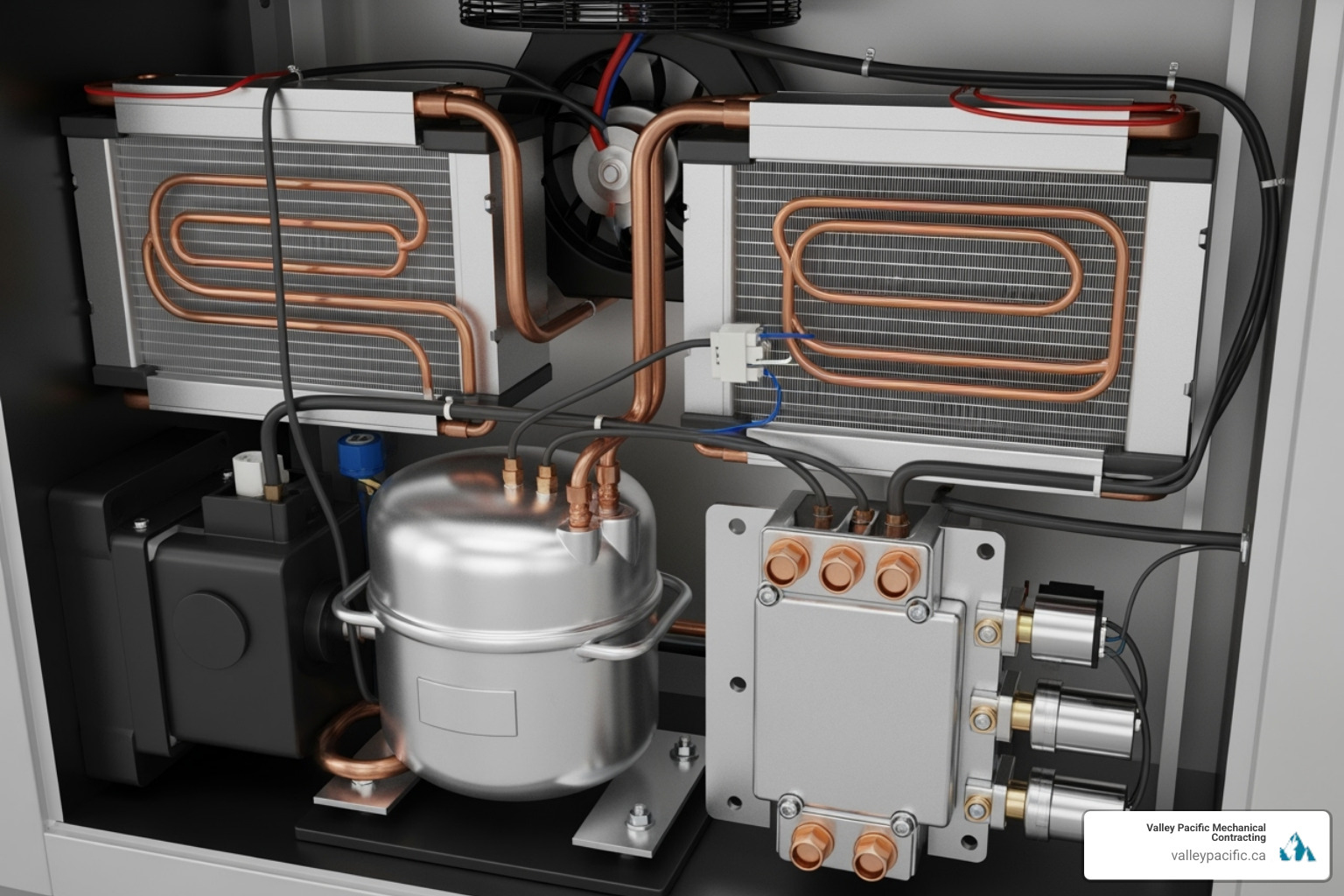
The All-in-One Residential Heat Pump Solution
Remember the days of juggling a furnace and an air conditioner? A residential heat pump puts an end to that complexity by delivering year-round comfort in one neat package. It replaces your furnace in winter and replaces your air conditioner in summer – talk about simplifying your life!
But wait, there's more. Your heat pump also handles dehumidification during those sticky summer months, pulling excess moisture from your air better than traditional AC units. This means you'll feel comfortable at higher temperatures, which translates to lower energy bills.
The best part? You'll enjoy consistent temperature throughout your home. No more hot spots in the living room or chilly corners in the bedroom. Your heat pump works steadily to maintain the perfect climate in every room.
Advanced Heat Pump Technologies
Today's residential heat pumps are light-years ahead of older models, packed with smart features that make them more efficient and comfortable than ever. Variable-speed compressors are game-changers – instead of running at full blast or not at all, they adjust their speed to match exactly what your home needs. Think of it like cruise control for your comfort system.
Inverter technology is the brain behind this smooth operation. An inverter heat pump eliminates the wasteful stop-and-start cycles of older units. Instead, it runs longer at lower speeds, sipping energy while keeping your home perfectly comfortable.
Modern smart thermostats take control to the next level. You can adjust your temperature from anywhere, monitor your energy use, and even get alerts if something needs attention. Many offer two-way communication with your heat pump, optimizing performance automatically. For troubleshooting and advanced features, you can Visit the Support Page of compatible systems.
These technologies work together to create a residential heat pump system that's quieter, more efficient, and smarter than anything available just a few years ago.
Types of Heat Pumps and Their Benefits
When we talk about residential heat pumps, we're actually referring to a family of systems, each designed to leverage different heat sources for optimal performance. The primary types are air-source, ground-source, and dual-fuel (hybrid) systems, each offering unique benefits. However, they all share the overarching advantages of significant energy savings and environmental benefits.
Heat pumps are champions of efficiency because they don't create heat; they move it. This simple principle translates into substantial energy savings. In fact, heat pumps can reduce your electricity use for heating by up to 75% compared to electric resistance heating. Beyond your wallet, this also means a lower carbon footprint for your home, contributing to a healthier planet.
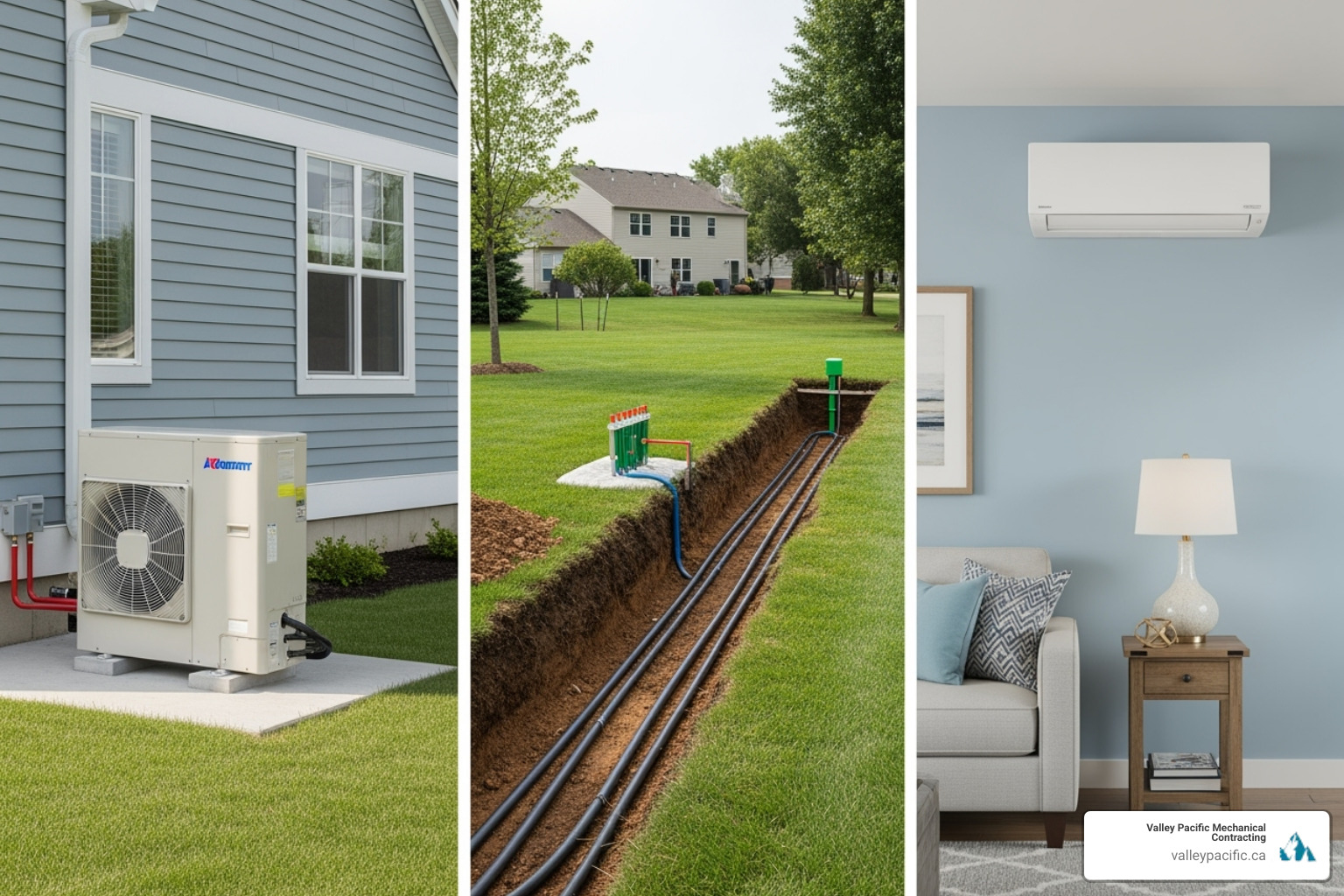
Air-Source Heat Pumps
Air-source heat pumps are the most common type of residential heat pump we encounter, and for good reason. They are versatile, efficient, and typically easier to install than ground-source systems. They work by transferring heat between the air inside your home and the air outside.
Within the air-source category, you'll find:
- Ducted Systems: These are the most direct replacements for traditional central furnaces and air conditioners. They use your home's existing ductwork to distribute heated or cooled air throughout the house. If you're considering a new AC installation, it's worth exploring the benefits of a heat pump AC, as it offers both cooling and heating capabilities. You can learn more about Heat Pump AC options. If you're seeing Signs You Need a New AC Installation, a heat pump could be a superior upgrade.
- Ductless Mini-Splits: These systems are ideal for homes without existing ductwork, additions, or for zoning specific areas. Instead of a central unit, they consist of an outdoor compressor/condenser unit connected to one or more indoor air-handling units via a small conduit. Each indoor unit can control the temperature of a specific room or zone, offering incredible flexibility and energy savings. They differ significantly from central ducted systems by providing highly localized heating and cooling without the need for extensive duct installation.
The key difference between an air-source heat pump and a central air conditioner is the heat pump's ability to reverse its cycle. While a central AC only cools by moving heat out of your home, an air-source heat pump can do that and reverse the process to bring heat into your home during colder months.
Ground-Source (Geothermal) Heat Pumps
Often considered the pinnacle of heat pump technology, ground-source heat pumps, also known as geothermal systems, leverage the stable temperatures found just a few feet below the earth's surface. Unlike air, the ground maintains a relatively constant temperature year-round, making it an incredibly efficient heat source or sink.
- Stable Ground Temperature: Regardless of extreme air temperatures above ground, the earth below remains at a consistent temperature (typically between 7-18°C or 45-65°F). Geothermal heat pumps tap into this stable reservoir, leading to extremely high efficiencies.
- High Efficiency: Because they don't have to contend with wide temperature swings like air-source units, geothermal heat pumps are exceptionally efficient. High-efficiency geothermal heat pumps, like ENERGY STAR-certified heat pumps, use 61% less energy than a standard model.
- Higher Upfront Cost: The main drawback of geothermal systems is their initial installation cost, which can be several times that of an air-source system due to the excavation and installation of underground piping (ground loops).
- Long Lifespan: Despite the higher upfront cost, geothermal systems boast an impressive lifespan. The indoor components can last up to 20-25 years, while the underground ground loops can last 50 years or more, making them a long-term investment in comfort and savings.
Dual-Fuel (Hybrid) Systems
For homeowners in regions with colder winters, where temperatures can occasionally dip below what an air-source heat pump can efficiently handle, a dual-fuel or hybrid heat pump system offers the best of both worlds.
- Heat Pump with Furnace: This system combines a high-efficiency electric heat pump with a traditional fossil-fuel furnace (usually natural gas or propane).
- Automatic Switching: The system is intelligently designed to automatically switch between the heat pump and the furnace based on outdoor temperatures. The heat pump handles most of the heating in milder weather, leveraging its superior efficiency. When temperatures drop below a certain point (the "balance point"), the system automatically switches to the furnace, which can provide more intense heat more economically in extreme cold.
- Cold Climate Solution: This setup is an excellent cold climate solution, ensuring consistent comfort even on the coldest days while maximizing efficiency throughout the rest of the year. It allows homeowners to enjoy the benefits of a heat pump's energy efficiency for the majority of the heating season, with the reliability of a furnace as a backup. If you're weighing your heating options, these systems give you solid Consider Heat Pump Installation Reasons.
How to Choose the Right Heat Pump for Your Home
Choosing the perfect residential heat pump for your home might feel overwhelming at first, but it doesn't have to be. Think of it like finding the right pair of shoes – you need something that fits your space, suits your lifestyle, and works within your budget. The good news is that we're here to guide you through every step of the process.
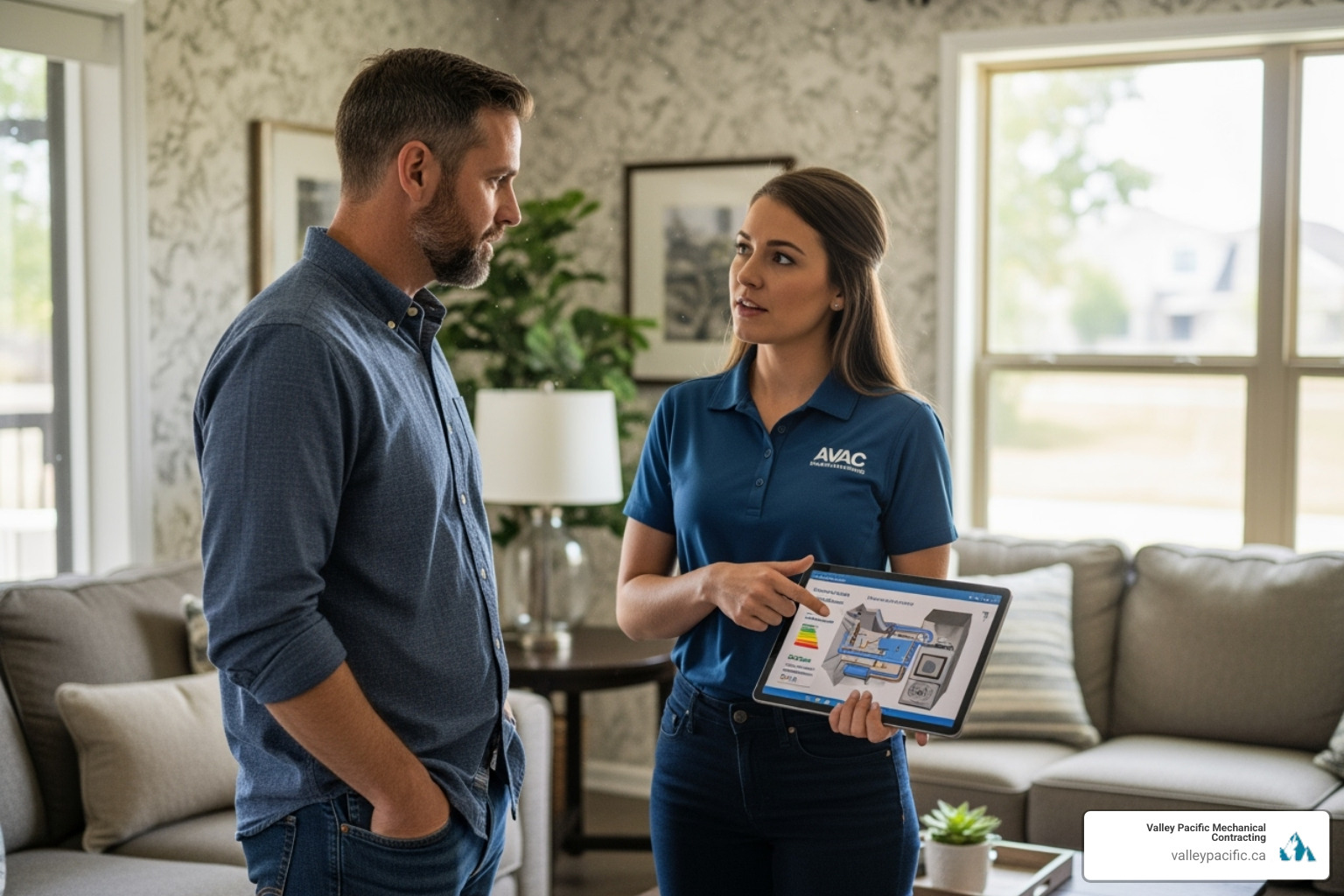
When we visit your home for a consultation, we look at several key factors to ensure you get the right system. Home size and layout are crucial – a larger home needs more heating and cooling capacity, while an open-concept layout distributes air differently than a home with many separate rooms.
Your home's insulation and air sealing quality makes a huge difference too. A well-insulated home stays comfortable with a smaller, more efficient heat pump, which means lower operating costs for you. We often find that homes with poor insulation benefit from upgrades before installing a new system.
Local climate is another important consideration. While BC's Lower Mainland has a moderate climate that's perfect for heat pumps, we still need to account for those occasional cold snaps. Understanding your area's temperature patterns helps us recommend whether a standard air-source unit will do the job or if a dual-fuel system makes more sense.
Budget considerations go beyond just the initial purchase price. We help you understand the complete picture – installation costs, long-term operating savings, and available rebates. Sometimes spending a bit more upfront on a high-efficiency model pays for itself through energy savings.
The condition of your existing ductwork also plays a role. If your ducts are in good shape, a ducted system might be the most cost-effective option. If not, ductless mini-splits could actually save you money while providing better comfort control.
Finally, we discuss your desired features. Do you want smart thermostat integration for remote control? Is quiet operation important because your bedroom is near the outdoor unit? These preferences help us narrow down the perfect match.
Understanding Efficiency: SEER2 and HSPF2 Ratings
Here's where things get a bit technical, but don't worry – we'll break it down in simple terms. When you're shopping for a residential heat pump, you'll see ratings called SEER2 and HSPF2. These numbers are like fuel economy ratings for cars – they tell you how efficiently your heat pump will operate.
SEER2 (Seasonal Energy Efficiency Ratio 2) measures how efficiently your heat pump cools your home during summer. Think of it as miles per gallon, but for cooling. The higher the SEER2 number, the less electricity your system uses to keep you comfortable on hot days.
HSPF2 (Heating Seasonal Performance Factor 2) does the same thing for heating performance during winter months. Again, higher numbers mean better efficiency and lower energy bills.
These updated ratings became the standard in January 2023, and they're more accurate than the old ratings because they reflect real-world conditions better. The Department of Energy now requires split system heat pumps to have a SEER2 of at least 14.3, and heating efficiency must meet an HSPF2 of 7.5 or higher.
When we recommend high-efficiency heat pumps, we're looking for units that exceed these minimum standards. Yes, they cost a bit more upfront, but the energy savings add up quickly. It's like choosing an efficient car – you spend less on fuel every month.
Choosing a Residential Heat Pump for Your Climate
Living in BC's Lower Mainland gives you a real advantage when it comes to heat pump performance. Our moderate climate is honestly ideal for this technology. Most of the year, temperatures stay within the sweet spot where heat pumps operate at peak efficiency.
The beauty of our climate is that an air-source residential heat pump can handle the vast majority of your heating needs beautifully. Even when it's chilly outside, there's still plenty of heat in the air for a modern heat pump to extract and bring into your home.
For those occasional cold snaps we get in the Lower Mainland, today's heat pumps are far more capable than older models. Modern cold climate heat pumps can work efficiently even when temperatures drop well below freezing. However, if you live in an area that experiences extended periods of very cold weather, we might recommend a dual-fuel system that pairs your heat pump with a backup heating source.
The ENERGY STAR Cold Climate label identifies heat pumps specifically designed for colder regions. These units maintain their efficiency down to -22°F (-30°C), which is far colder than we typically see in our area.
What makes BC particularly great for heat pumps is that you get advantages in cold weather without dealing with disadvantages in extreme cold. You'll enjoy efficient, comfortable heating throughout our mild winters, with reliable performance even on our coldest days.
Cost and Available Incentives
Let's talk about the financial side of things – because we know that's a big part of your decision. The cost of a residential heat pump involves three main components: what you pay upfront, installation costs, and what you'll spend on energy over the years.
While the initial investment might be higher than a basic furnace, heat pumps typically cost less to operate thanks to their incredible efficiency. Think of it like buying a hybrid car – you might pay more initially, but you save money every month on fuel.
Here's how heat pumps generally compare to traditional heating and cooling systems:
| Cost Factor | Heat Pump | Traditional Furnace + AC System |
|---|---|---|
| Upfront Cost | Moderate to Higher | Moderate |
| Operating Cost | Lower (due to high efficiency) | Higher |
| Lifespan | Average (15 years, with proper maintenance) | Average (15-20 years for furnace, 10-15 for AC) |
| Environmental Impact | Very Low (no fossil fuel combustion) | Higher (combusts fossil fuels) |
The really exciting news is the rebates available right now. BC Hydro offers rebates of up to $2,500 when you replace electric heating with a qualifying heat pump. For some whole-home systems and income-qualified households, rebates can be even higher.
FortisBC also provides substantial rebates for homes currently heated with electricity, often worth thousands of dollars depending on your system size and coverage. The CleanBC programs add another layer of support through the Better Homes and Home Renovation Rebate Program.
These incentive programs change regularly, and new ones pop up throughout the year. That's why we always check for the latest rebates when we provide your quote – we want to make sure you get every dollar of savings available to you.
Installation, Maintenance, and Lifespan
Getting your residential heat pump installed and keeping it running smoothly isn't rocket science, but it does require the right expertise and consistent care. Think of it like getting a new car – you want a skilled mechanic to set everything up properly, and then you need to keep up with regular maintenance to ensure it serves you well for years to come.
Professional installation is absolutely critical for your heat pump's success. We've seen too many homeowners struggle with systems that were poorly sized or incorrectly installed by inexperienced technicians. An undersized unit will work overtime trying to keep up with your home's needs, while an oversized system will constantly cycle on and off, wasting energy and creating uncomfortable temperature swings.
Our experienced team takes the guesswork out of installation by carefully analyzing your home's unique characteristics – square footage, insulation quality, window placement, and even how your family uses different spaces. We also consider the Best Locations for Heat Pump Placement to ensure optimal performance while keeping your outdoor unit positioned for both efficiency and curb appeal.
Regular maintenance is where many homeowners either excel or fall short, and it makes all the difference in your system's performance and longevity. Your heat pump works hard year-round, so it deserves some attention to keep running at its best.
Filter changes are the simplest yet most important task you can handle yourself. Clean filters mean better airflow, improved indoor air quality, and lower energy bills. We recommend checking your filters monthly – if they look dirty or clogged, it's time for a change. Depending on your household (pets, allergies, dust levels), you might need to replace them every 1-3 months.
Annual service is where our professional maintenance really shines. During these comprehensive check-ups, we inspect your system from top to bottom – cleaning coils, checking refrigerant levels, testing electrical connections, and catching potential problems before they turn into expensive repairs. Our Seasonal Heat Pump Maintenance Tips can help you stay on top of basic care between our visits.
Expected Lifespan and Common Repairs
A well-cared-for residential heat pump should provide reliable comfort for an average of 15 years, though many of our customers enjoy even longer service lives with proper maintenance. The key factors that influence how long your system lasts include the quality of installation, consistent maintenance, your local operating conditions, and the overall unit quality.
Regular maintenance has the biggest impact on longevity. Systems that receive annual professional service and regular filter changes consistently outlast those that are neglected. It's really that simple – a little care goes a long way.
Even the most reliable heat pumps can experience occasional issues, and we're here to help when they do. Refrigerant leaks are among the most common problems we encounter. If your system isn't heating or cooling as effectively as it used to, low refrigerant might be the culprit.
Defrosting problems can occur during colder weather when ice builds up on the outdoor coil. Your heat pump has a built-in defrost cycle to handle this naturally, but sometimes this system needs attention. Other common issues include general wear and tear on components like capacitors, fan motors, or compressors – all normal parts of a system's aging process.
If you notice unusual noises, reduced performance, or higher energy bills, these could be Signs Your Heat Pump Needs Repair. Don't wait until a small problem becomes a big headache – we provide prompt, professional Heat Pump Repair Mission BC and throughout the Lower Mainland.
The bottom line? With proper installation and regular care, your residential heat pump will provide years of efficient, reliable comfort while keeping your energy bills in check.
Conclusion
As we wrap up our journey through residential heat pumps, it's clear these remarkable systems are more than just another heating and cooling option – they're a game-changer for modern home comfort. We've finded how these clever devices work by transferring heat rather than creating it, making them incredibly energy efficient while delivering year-round comfort that keeps your home perfectly cozy in winter and refreshingly cool in summer.
The numbers speak for themselves. With the ability to reduce your heating electricity use by up to 75% compared to traditional electric systems, heat pumps offer substantial long-term savings that add up month after month, year after year. But it's not just about your wallet – it's about making a positive impact on our environment too. By choosing a heat pump, you're reducing your carbon footprint and contributing to a cleaner, greener future for British Columbia.
Whether you're drawn to the versatility of air-source systems, the incredible efficiency of geothermal units, or the reliability of dual-fuel setups, there's a heat pump solution that's perfect for your home and budget. The advanced technologies we've explored – from variable-speed compressors to smart thermostats – ensure you'll enjoy precise temperature control, whisper-quiet operation, and maximum efficiency.
For a headache-free experience from consultation to installation in the Lower Mainland, trust the experts at Valley Pacific Mechanical Contracting. With over 30 years of expertise and a commitment to the Daikin Comfort Promise, we provide comprehensive HVAC services, including professional heat pump installation, maintenance, and repair. Whether you're in Langley, Pitt Meadows, Maple Ridge, Mission, or Coquitlam, we're here to ensure your home stays perfectly comfortable, year-round.
The transition to efficient, smart home comfort has never been easier. Ready to experience the benefits of a residential heat pump for yourself? Get a professional heat pump installation in Maple Ridge or contact us today to learn more about our services in your area!
Why Coquitlam Homeowners Need Reliable HVAC Services
Finding quality hvac services coquitlam residents can trust is essential for year-round comfort in your home. Whether you're dealing with a broken furnace in January or need air conditioning repairs during a summer heat wave, having a reliable contractor makes all the difference.
Top HVAC Services Available in Coquitlam:
- Furnace installation, repair, and maintenance (15-20 year average lifespan)
- Air conditioning services including installation and emergency repairs
- Heat pump installation and servicing for year-round efficiency
- Boiler repair and replacement for hot water and heating
- Indoor air quality improvements with filtration and purification systems
- 24/7 emergency HVAC services for urgent breakdowns
- ENERGY STAR upgrades with FortisBC rebate assistance
Coquitlam's unique climate creates specific challenges for your HVAC system. The region experiences both humid summers that strain air conditioners and cold winters that put heavy demands on heating systems. Regular maintenance can reduce energy consumption by up to 15%, helping you save hundreds of dollars annually on utility bills.
The key to avoiding costly emergency repairs is finding a licensed and insured HVAC contractor who understands local conditions. With furnaces lasting 15-20 years and air conditioners running 10-15 years, choosing the right professional for installation and maintenance protects your long-term investment.
As one Coquitlam homeowner shared after an emergency furnace repair: "Nothing puts a damper on your day quite like your heating or air conditioning going out." This is why having a trusted HVAC partner before you need one is so important.
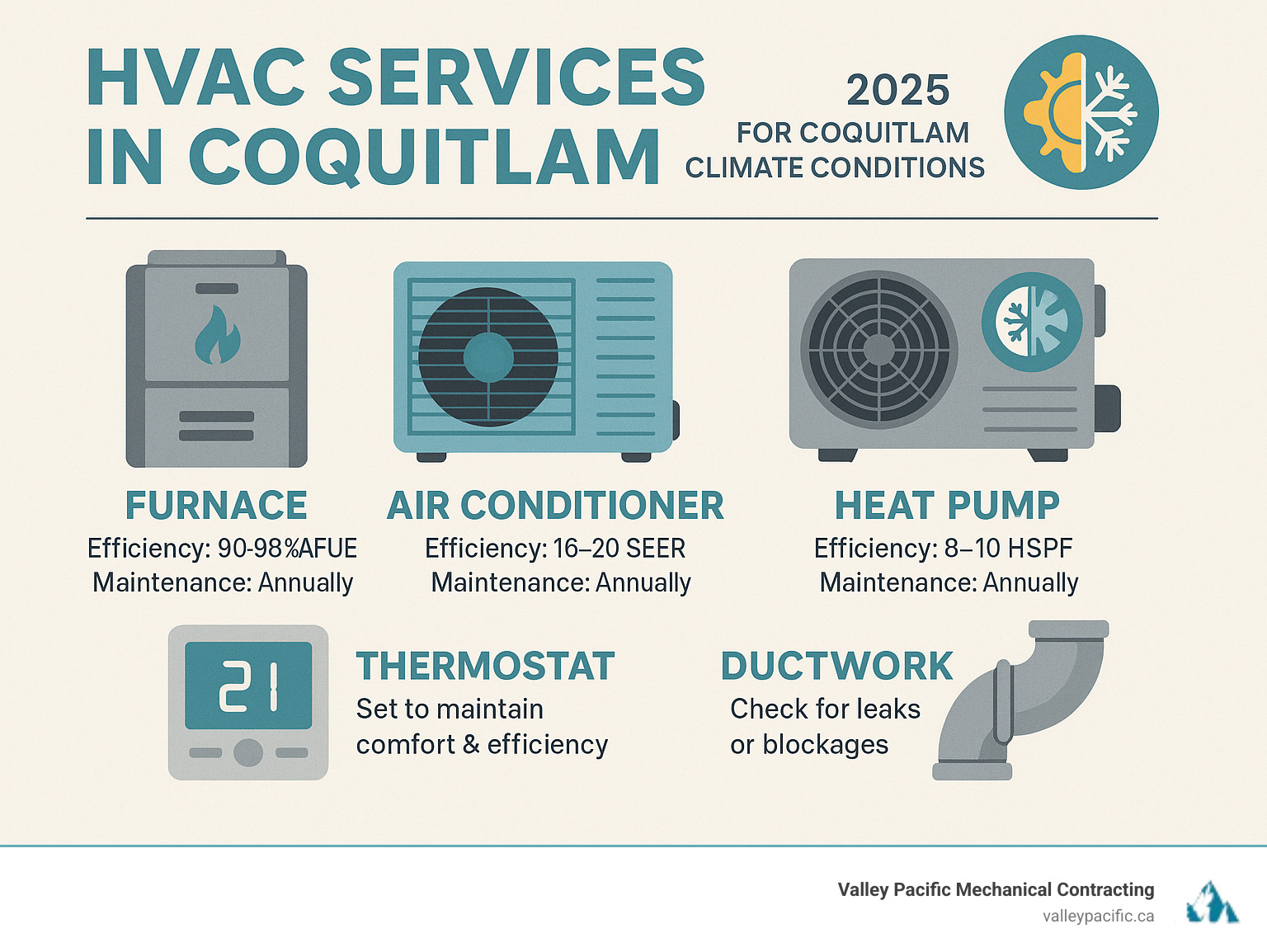
Understanding Your Home's HVAC System in Coquitlam

Your home's HVAC system is your climate guardian, keeping the air flowing and the temperature comfortable. In Coquitlam, with its sweltering summers and cold winters, understanding your system is key to saving money and avoiding discomfort. A smooth-running system is easy to ignore, but a struggling one makes itself known at the worst times, like 2 AM on a holiday weekend when hvac services coquitlam contractors are harder to reach.
Common HVAC Systems and Their Lifespans
Every Coquitlam home is unique, and so are its HVAC systems. Here are the most common types and their expected lifespans:
- Furnaces: The workhorses of Canadian heating, gas furnaces provide powerful heat and last 15-20 years with proper care.
- Air Conditioners: Central AC units keep you cool during summer heatwaves and typically last 10-15 years.
- Heat Pumps: These energy-efficient systems handle both heating and cooling, with a lifespan of 10-15 years. They are a smart choice for our moderate climate.
- Boilers: Providing even, comfortable heat, boilers are known for their longevity, often lasting 20+ years with proper maintenance.
- Ductless Mini-Splits: Ideal for homes without ductwork, these compact units heat and cool specific zones and last 10-15 years.
The secret to reaching these lifespans? Quality installation and regular maintenance. A well-installed system that receives annual tune-ups will consistently outlast one that's neglected.
How Coquitlam's Climate Impacts Your System
Living in Coquitlam presents unique challenges for your HVAC system. Our coastal proximity means high humidity, forcing your AC to work as a dehumidifier. The seasonal temperature swings and constant cycling between heating and cooling put significant stress on equipment.
This increased usage pattern means components wear out faster, making regular maintenance even more critical to ensure your system is ready for any surprise cold snap or heat wave.
Comprehensive HVAC Services Coquitlam Residents Can Trust
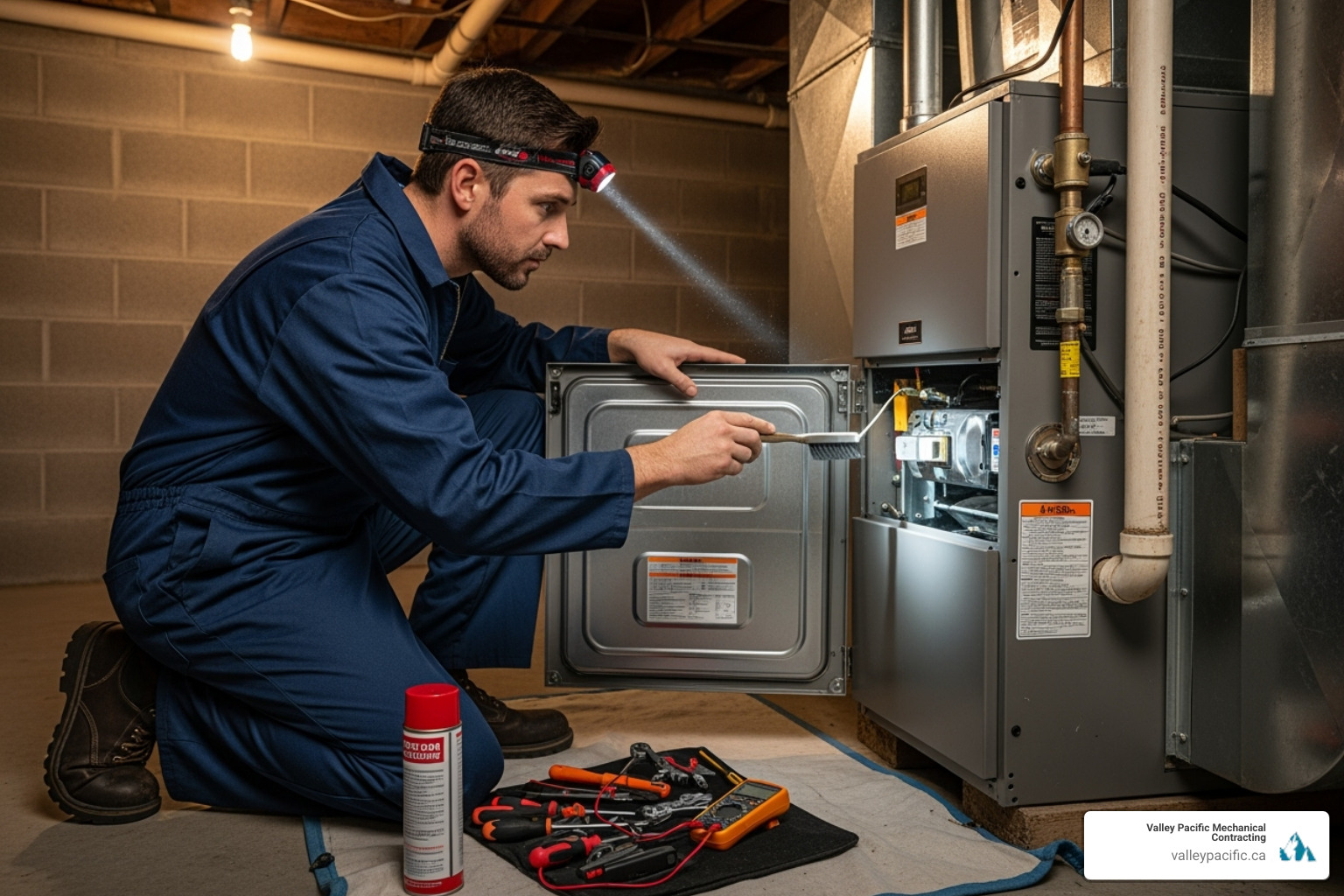
When your heating or cooling fails, you need hvac services coquitlam homeowners can count on. Your comfort, energy bills, and air quality are too important to leave to chance. At Valley Pacific Mechanical Contracting, our 30+ years of experience are dedicated to creating a healthy, efficient home environment for your family.
Primary HVAC Services Offered
Whether you need an emergency fix or a planned upgrade, our services cover all your home comfort needs.
- Installation: We correctly size and install new systems, from furnaces to heat pumps, and help you steer energy rebates to reduce upfront costs.
- Repair: Our team diagnoses and fixes all makes and models of HVAC equipment, handling everything from minor noises to complete system failures. We bring expertise from AC Repair Pitt Meadows BC and Furnace Repair Pitt Meadows BC to every Coquitlam home.
- Maintenance: Regular tune-ups keep your system at peak efficiency, preparing your AC for summer and your furnace for winter.
- Boiler Services: We offer specialized repair and servicing for boiler systems, handling both radiant heat and hot water issues. Learn more about our Boiler Repair Pitt Meadows BC services.
The Benefits of Regular HVAC Maintenance
Regular maintenance can reduce your energy consumption by up to 15%, saving you money monthly. Key benefits include extended equipment lifespan, fewer breakdowns, improved safety (by checking for gas or carbon monoxide leaks), and improved comfort by eliminating hot and cold spots. The cost of maintenance is far less than an emergency repair and pays for itself in savings.
Improving Indoor Air Quality (IAQ)
The air inside your home can be more polluted than outdoor air. We improve your indoor air quality (IAQ) with:
- Air Filtration Systems: Capture allergens, dander, and pollutants.
- Humidifiers: Maintain optimal humidity levels (30-50%) for comfort and to protect wood furnishings.
- UV Air Purifiers: Kill airborne bacteria, viruses, and mold spores.
- Duct Cleaning: Removes accumulated dust and debris from your ductwork.
These improvements can reduce allergy symptoms and create a healthier living environment.
Is It Time for a Repair or a Full Replacement?
Deciding whether to repair or replace an aging HVAC system is a common challenge for homeowners. There's no single right answer, as it involves balancing upfront costs with long-term savings. We're here to provide an honest assessment to help you make an informed decision that offers the best value for your home.
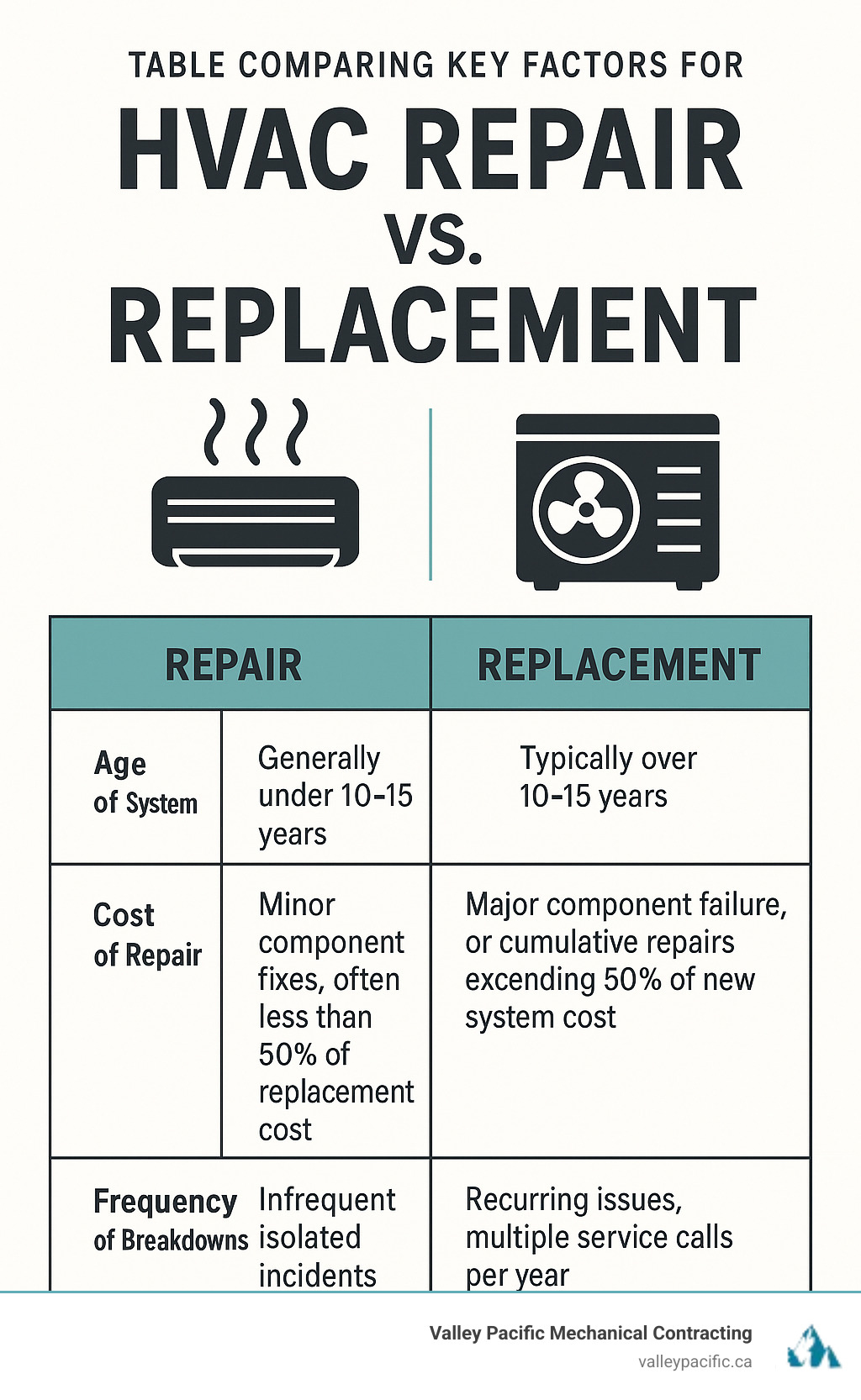
| Factor | Repair | Replacement |
|---|---|---|
| Age of System | Generally under 10-15 years | Typically over 10-15 years |
| Cost of Repair | Minor component fixes, often less than 50% of replacement cost | Major component failure, or cumulative repairs exceeding 50% of new system cost |
| Frequency of Breakdowns | Infrequent, isolated incidents | Recurring issues, multiple service calls per year |
| Energy Efficiency | Remains at existing efficiency level, may slightly improve after repair | Significantly improved with new, higher-efficiency models |
Telltale Signs of a Malfunctioning HVAC System
Your system will often signal problems before a complete failure. Watch for these signs:
- Strange Noises: Grinding, squealing, or banging sounds point to mechanical issues.
- Unusual Smells: A burning smell can mean electrical problems, while a rotten egg odor near a gas furnace indicates a potential gas leak. Evacuate and call for help immediately if you smell gas.
- Weak Airflow & Inconsistent Temperatures: Clogged filters, leaky ducts, or a failing blower motor can cause poor air distribution.
- Higher Energy Bills: A sudden spike in utility costs suggests your system is working inefficiently.
- Leaks or Moisture: Moisture around your unit can signal drainage or refrigerant issues.
Deciding Between Furnace Repair and Replacement
When your furnace fails, use these guidelines to decide between repair and replacement:
- Age vs. Cost: If your furnace is over 15-20 years old and needs a major repair, replacement is often more sensible.
- The 50% Rule: If a repair costs 50% or more than a new unit, replacement is usually the better investment.
- Warranty Status: Check if your system is still under warranty, as this can significantly lower repair costs.
- Energy Efficiency: Newer ENERGY STAR models can save you hundreds annually in wasted energy compared to an older unit.
- Future Repairs: If your system needs frequent service calls, a new unit provides reliability and peace of mind.
Emergency HVAC Services in Coquitlam: When to Call
Some problems can't wait. We offer 24/7 emergency hvac services coquitlam residents depend on for critical situations:
- No heat in winter or no cooling in extreme heat.
- Electrical issues like burning smells or tripping breakers.
- Suspected gas leaks. If you smell gas, evacuate your home immediately, then call for emergency help and contact us.
- Carbon monoxide detector alerts. This is a life-threatening emergency. Evacuate first, then call for help.
How to Choose the Best HVAC Contractor
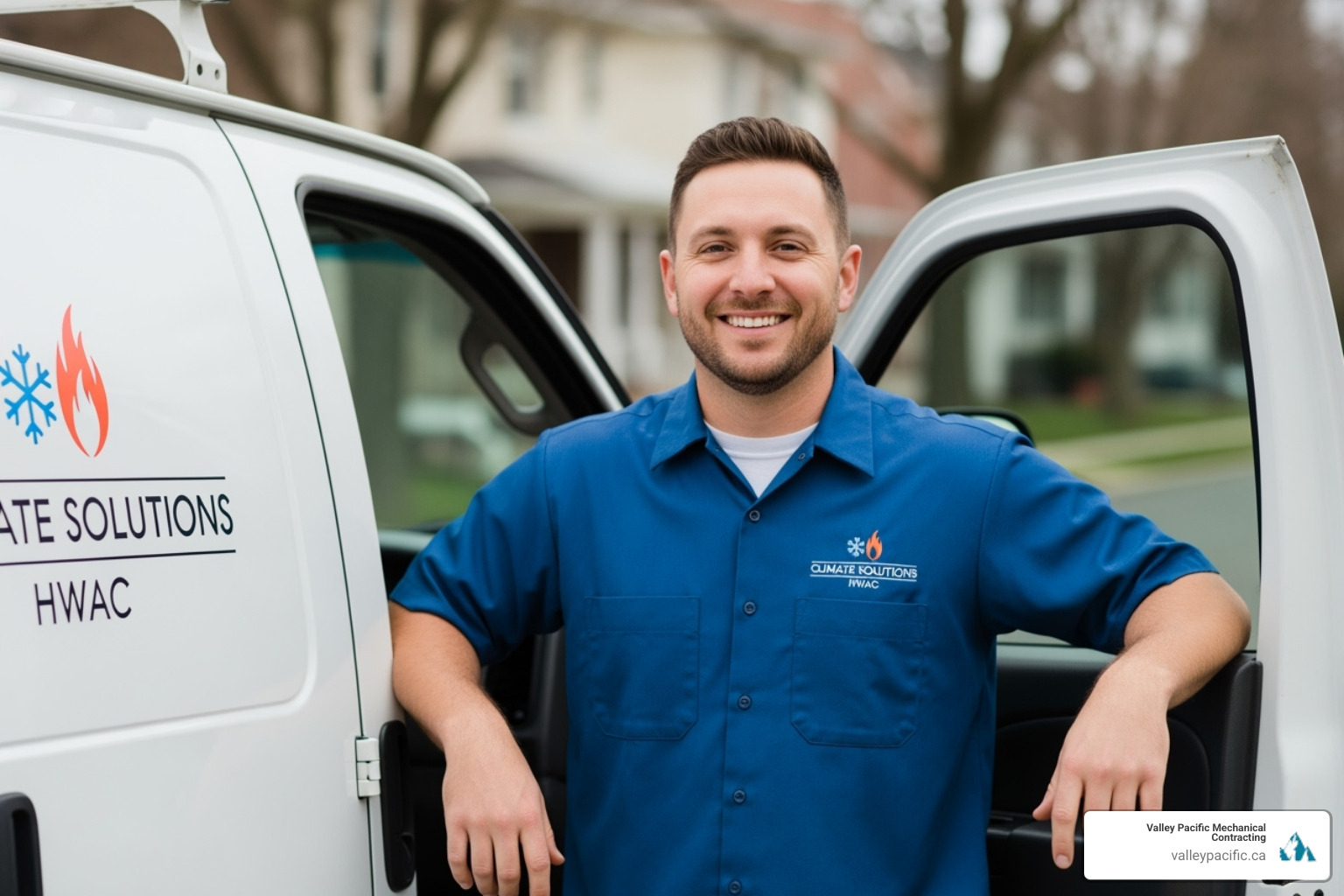
Choosing the right contractor for hvac services coquitlam homeowners need is about finding a long-term partner for your home's comfort. You need someone experienced, trustworthy, and available for emergencies. To avoid contractors who overpromise and underdeliver, it's important to know what to look for.
Key Factors for Choosing HVAC Services in Coquitlam
When vetting professionals, consider these factors:
- Experience and Expertise: A contractor with 30+ years in business has proven their reliability and skill.
- Local Reviews and Testimonials: Check Google, Facebook, and Homestars to see what your neighbors are saying.
- Range of Services: A contractor who handles installation, repair, and maintenance can provide unbiased advice.
- Emergency Availability: 24/7 service shows a commitment to your comfort, not just a 9-to-5 job.
The Importance of Licensed and Insured Professionals
Working on gas appliances requires certified professionals for your safety. Ensure your contractor has:
- Technical Safety BC Certification: This is mandatory proof of training for anyone working on gas appliances. You can verify licenses at Technical Safety BC.
- Gas-Fitter Licenses: This specialized training is required for anyone working on gas lines.
- Liability Insurance: This protects you and your home from accidental damage during the job.
Licensed professionals also ensure all work is up to local building codes, which is crucial for safety, insurance, and home resale value.
Opening up Rebates and Understanding Estimates
A professional estimate should be clear and comprehensive. Look for:
- Transparent, Itemized Pricing: The estimate should break down labor and equipment costs so you know what you're paying for.
- FortisBC Rebate Assistance: A knowledgeable contractor will identify available rebates for energy-efficient upgrades and help you with the application.
- ENERGY STAR Products: These high-efficiency systems lower your energy bills, often paying for the initial cost difference within a few years.
- Financing Options: Reputable contractors may offer financing to make major investments more manageable.
Frequently Asked Questions about HVAC in Coquitlam
As experienced hvac services coquitlam providers, we've noticed that homeowners often have similar concerns about their heating and cooling systems. Over our 30+ years in the business, these questions come up time and time again. Let's address the most common ones.
How often should I service my HVAC system?
We recommend annual maintenance for furnaces (in the fall) and air conditioners (in the spring). Heat pumps, which work year-round, should be serviced twice a year—once in spring and once in fall. Between professional visits, change your filters every 3-6 months (more often if you have pets or allergies). Regular service prevents major breakdowns and keeps your system running efficiently.
How can I make my HVAC system more energy-efficient?
Boosting your system's efficiency is easier than you might think:
- Get Regular Maintenance: A clean, tuned system uses less energy.
- Use a Programmable or Smart Thermostat: Automatically adjust temperatures when you're away or asleep.
- Seal Air Leaks: Use caulk or weatherstripping around windows and doors.
- Ensure Proper Insulation: Good insulation in your attic and walls helps maintain stable temperatures.
- Upgrade to ENERGY STAR Models: If your system is old, a modern, high-efficiency unit offers significant long-term savings.
What is the average lifespan of a furnace or air conditioner?
Furnaces typically last 15-20 years, while air conditioners and heat pumps last 10-15 years. Longevity depends on the quality of the original installation, Coquitlam's climate, and most importantly, regular maintenance. A well-maintained system will significantly outlast a neglected one. If your system is approaching these age ranges and requires frequent repairs, it's time to consider a replacement.
Conclusion
Your year-round comfort in Coquitlam is essential, and your home should be a sanctuary from seasonal temperature extremes. The key takeaways are simple: proactive maintenance is your best defense against breakdowns and high energy bills, saving up to 15% on energy consumption. Recognizing warning signs early allows you to address issues before they become emergencies.
Most importantly, choosing a certified professional with proper Technical Safety BC licensing isn't just about quality work—it's about your family's safety. Don't wait for a complete system failure before seeking help.
For a truly 'headache-free' experience from a contractor with over 30 years of expertise and 24/7 emergency availability, consider the comprehensive hvac services coquitlam residents have trusted for decades. Valley Pacific Mechanical Contracting delivers the Daikin Comfort Promise, ensuring you receive the highest standards of product quality and customer satisfaction.
Your comfort shouldn't be left to chance. Take a proactive step today toward a more comfortable, energy-efficient, and reliable home.
Why Every Drop Counts: The Real Cost of a Dripping Faucet
Faucet leak repair is a common and rewarding DIY project. Here's what you need to know:
Quick Fix Guide:
- Turn off water supply valves under the sink
- Remove the handle (method depends on faucet type)
- Replace worn parts - washers, O-rings, or cartridges
- Clean mineral buildup from valve seats
- Reassemble carefully without overtightening
- Test for leaks before calling it done
That constant drip, drip, drip isn't just annoying—it's costly. A small faucet leak can waste over 1,000 gallons of water per year, which is money literally going down the drain.
The good news? Most faucet leaks are caused by simple worn-out parts like a deteriorated rubber washer, a damaged O-ring, or a faulty cartridge. These repairs typically cost under $20, take less than an hour, and require only basic tools.
A leaky faucet is a constant reminder of wasted water and money. With the right approach, you can stop that drip and gain the satisfaction of fixing it yourself.
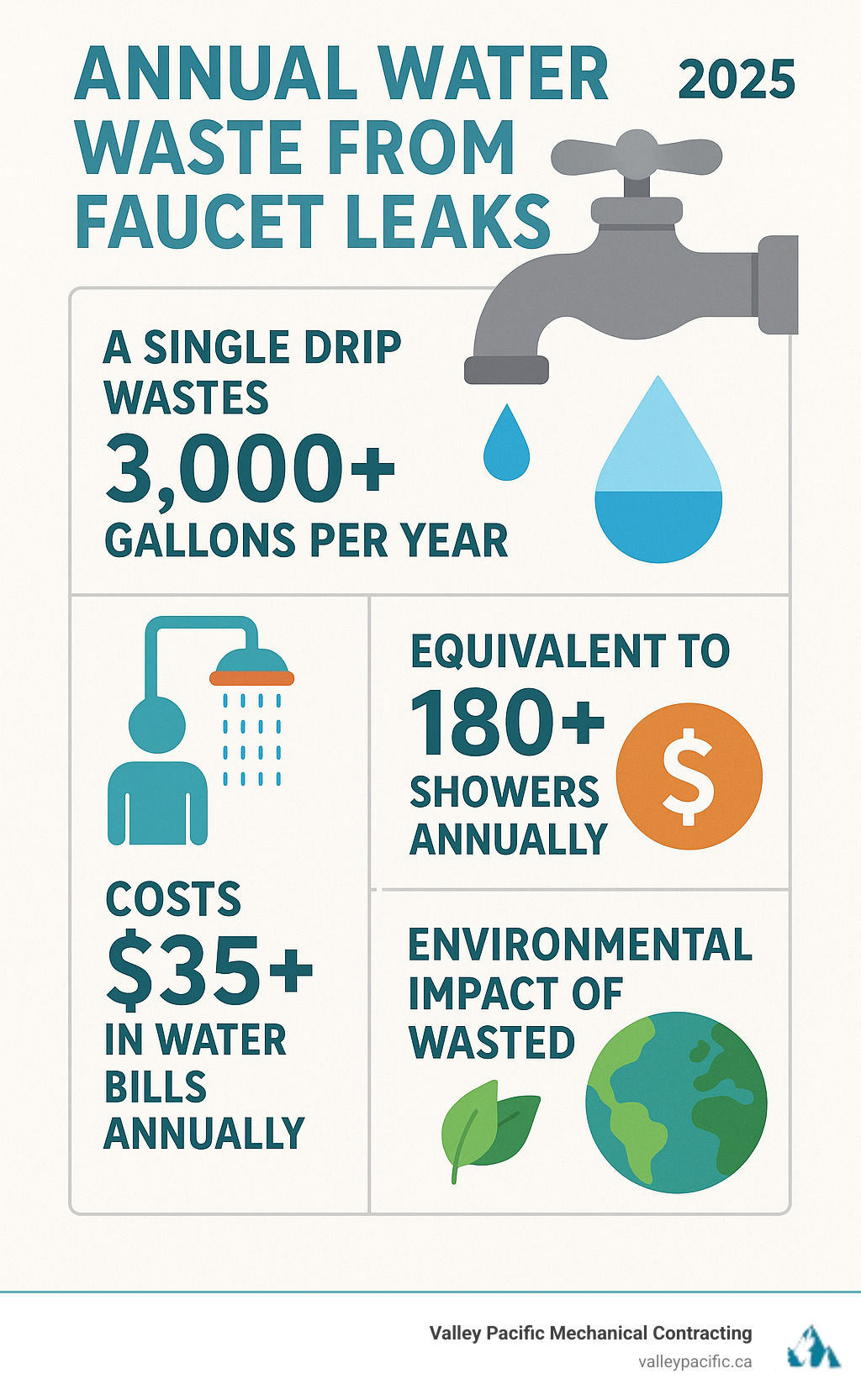
Understanding Your Faucet and the Leak
Before grabbing your tools, understanding what causes a leak and your faucet type is key to a smooth faucet leak repair.
Common Causes of a Leaky Faucet
That annoying drip is usually the result of normal wear and tear on your faucet's internal parts, which deal with constant water pressure and mineral deposits day after day.
- A worn-out washer or O-ring is the most common culprit. These rubber seals create a watertight barrier but can harden, crack, or wear out over time, causing a persistent drip.
- A corroded valve seat is another frequent issue. This is the surface where the washer sits to stop water flow. Mineral deposits from hard water can create a rough surface that prevents a proper seal.
- In newer, single-handle faucets, a faulty cartridge is often the cause. These cylindrical components control water flow and temperature, and their internal seals can deteriorate.
- Mineral deposits from hard water can also interfere with smooth operation and proper sealing. Sometimes, a good cleaning is all that's needed.
Identifying Your Faucet Type
Knowing your faucet type is crucial, as each has a different repair approach.
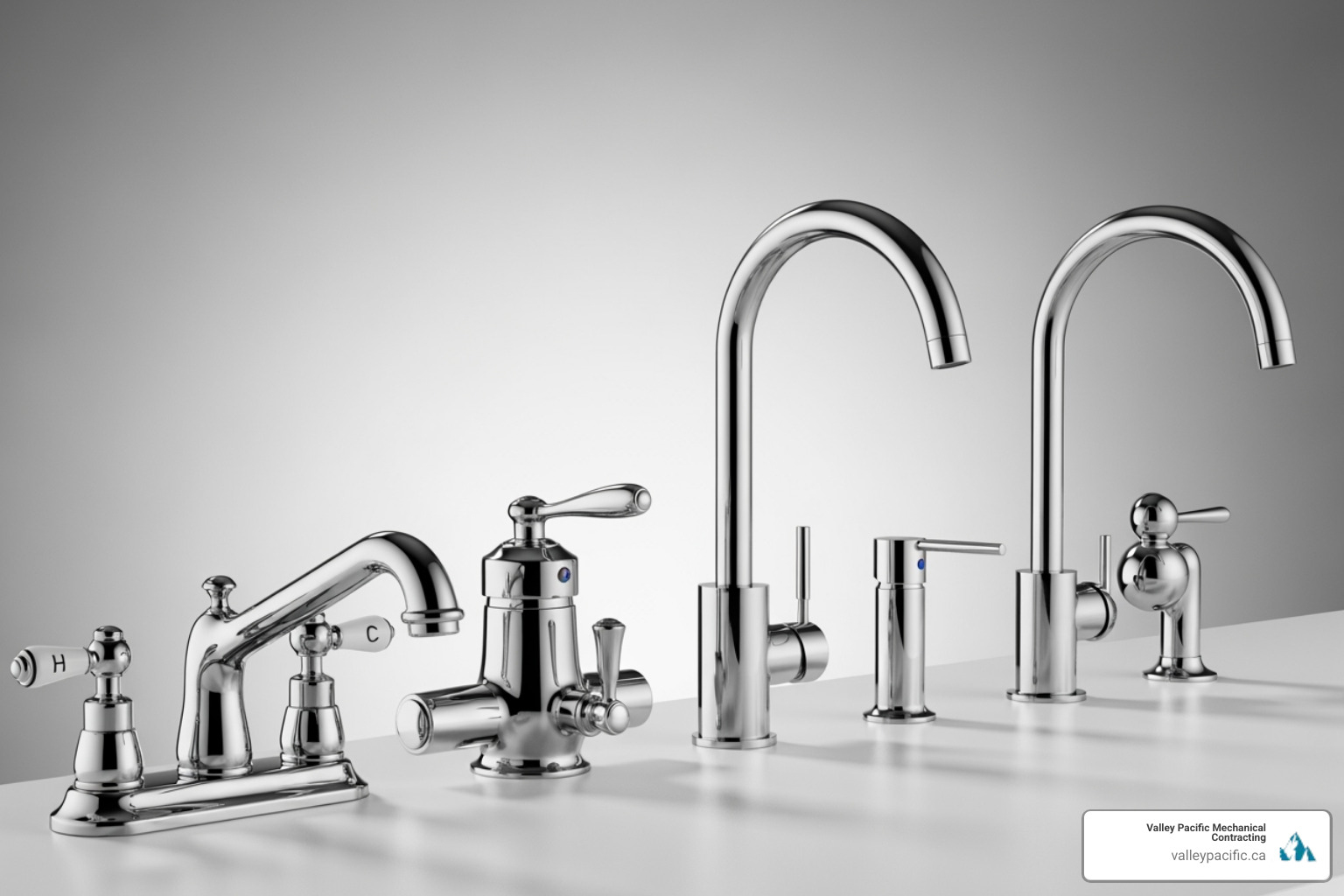
- The compression faucet has two separate handles for hot and cold water. These use a rubber washer that gets compressed against a valve seat to stop water flow and may need more frequent washer replacements.
- Cartridge faucets come in single-handle and two-handle versions and use a cylindrical cartridge to control water. They are generally reliable and operate smoothly.
- The ceramic disk faucet is a durable, modern single-handle design. It uses two ceramic disks that slide against each other and is designed to be virtually drip-free.
- Ball-type faucets are single-handle faucets, often found in kitchens, with a rotating ball mechanism. They have more moving parts that can require attention.
Pinpointing the Source of the Leak
Where your leak is happening can tell you what's wrong inside.
- A leak from the spout when the faucet is off usually points to a problem with the main sealing mechanism. In compression faucets, it's typically a worn seat washer; for other types, it's the cartridge or internal seals.
- Water seeping from the handle base usually indicates a problem with the O-rings or the stem assembly, which is common in cartridge faucets.
- A leak from under the sink means you should check the supply line connections and any pull-out spray hoses. The issue might be the connections, not the faucet itself.
- Noting if the leak is hot or cold water can help you identify which side of a two-handle faucet needs repair.
Understanding these leak patterns saves time. For more comprehensive information about water leak detection throughout your home, more info about water leak detection can help you spot other potential issues.
Gearing Up for Your Faucet Leak Repair
Proper preparation is the key to a smooth and successful faucet leak repair.
Essential Tools and Materials
The beauty of faucet leak repair is that you don't need a garage full of expensive tools. Most of what you'll need might already be in your toolbox.
- Adjustable wrench and a set of pliers (slip-joint, needle-nose).
- Phillips and flat-head screwdrivers and an Allen wrench set.
- Rags or towels for cleanup and protecting surfaces.
- Plumber's grease (silicone-based) for lubricating new O-rings and threads.
- Replacement parts (washers, O-rings, or a cartridge) specific to your faucet.
- You might also need penetrating oil for corroded parts or a valve-seat dresser for compression faucets.
Pre-Repair Preparation Steps
These simple steps will prevent major headaches and water messes.
Shut off the water supply first. Turn the hot and cold water valves under the sink clockwise until they're completely closed. If you can't find these or they don't work, you'll need to turn off your home's main water supply.
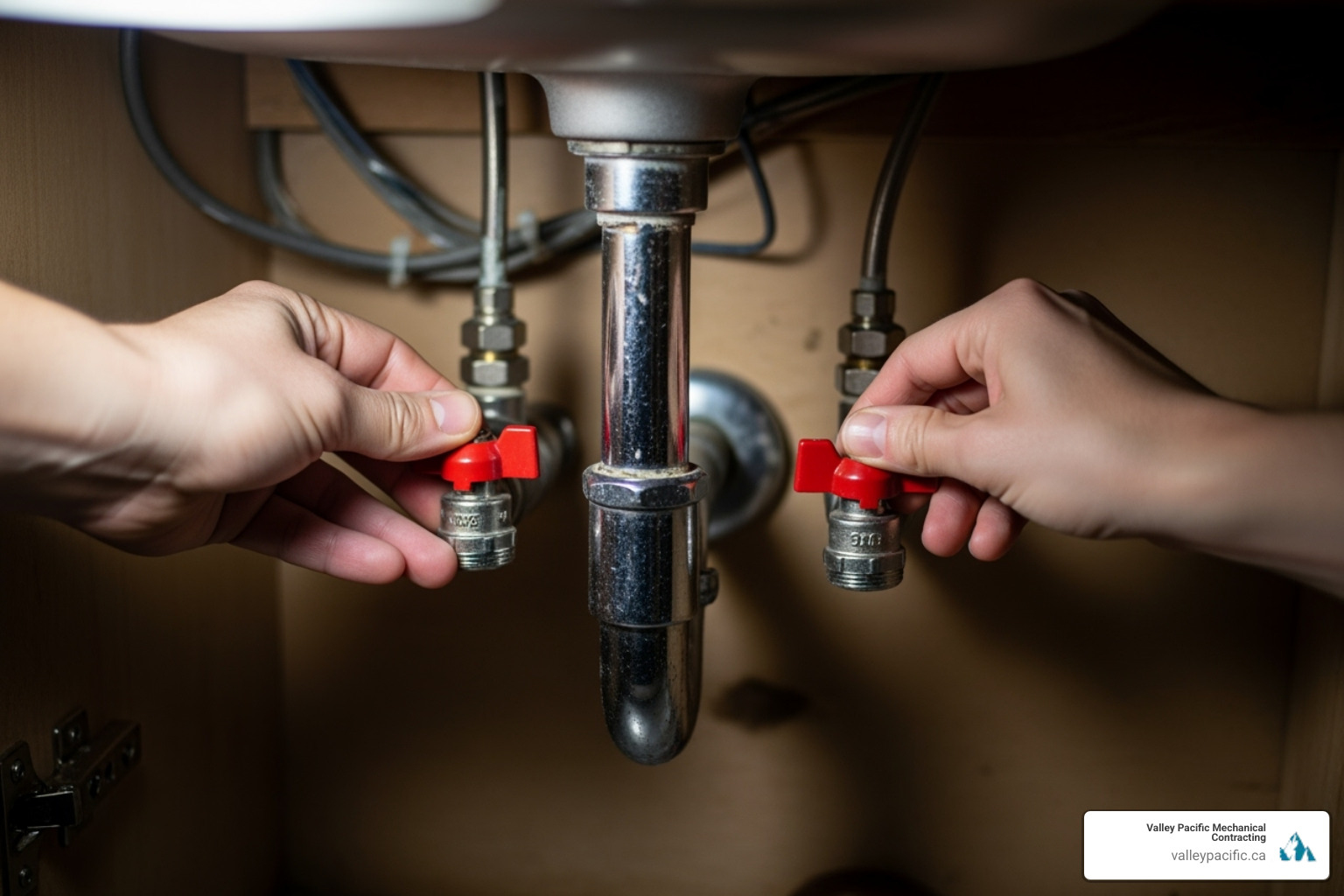
Once the water is off, drain any remaining water by turning on the faucet. Next, plug the sink drain with a stopper or rag to prevent losing small screws and washers.
Finally, protect your surfaces with rags in the sink basin and on the countertop. Wrap shiny faucet parts with tape before gripping them with a wrench to prevent scratches.
Finding the Right Replacement Parts
Getting the wrong replacement part is a common mistake that will prevent a successful repair.
The foolproof method is to take the old parts to the store with you. Remove the worn washer, O-ring, or cartridge and bring it to your local hardware store. The staff can help you find an exact match for size and material.
If you know your faucet model number, you can often find detailed parts diagrams on the manufacturer's website. Look for the model number on the original packaging, a sticker under the sink, or etched into the faucet body.
Stick with genuine replacement parts when possible. They are designed specifically for your faucet and typically last longer, ensuring your faucet leak repair is successful for years to come.
Step-by-Step: How to Fix a Leaky Faucet
Now for the actual faucet leak repair. Each faucet type has its own repair process, so follow the steps for your specific situation.
Repairing a Compression Faucet (Washer & Seat)
These classic faucets have separate hot and cold handles. A dripping spout usually means a worn washer.
First, remove the handle by prying off the decorative cap and unscrewing the handle screw. Next, use an adjustable wrench to unscrew the packing nut below the handle, then pull the entire stem assembly straight out. At the bottom of the stem, you'll find the seat washer held by a screw. Unscrew it and replace it with an exact match. While you're there, check the O-ring around the stem and replace it if it's worn, coating the new one with plumber's grease. Finally, inspect the valve seat inside the faucet body. It should be smooth; clean any mineral buildup or use a valve-seat dresser if it's pitted. Reassemble everything in reverse order, being careful not to overtighten. For additional guidance, you can find helpful resources like this one: Learn more about faucet leak repair steps.
Fixing a Cartridge Faucet
Common in single-handle designs, these leaks are usually caused by the cartridge itself.
Getting the handle off can require some detective work; look for a set screw on the side or under a decorative cap. Once the screw is removed, the handle should pull off. You'll then see the retaining mechanism—a nut, clip, or screws—holding the cartridge. Remove it carefully. Now, pull out the old cartridge firmly, using pliers if it's stubborn.
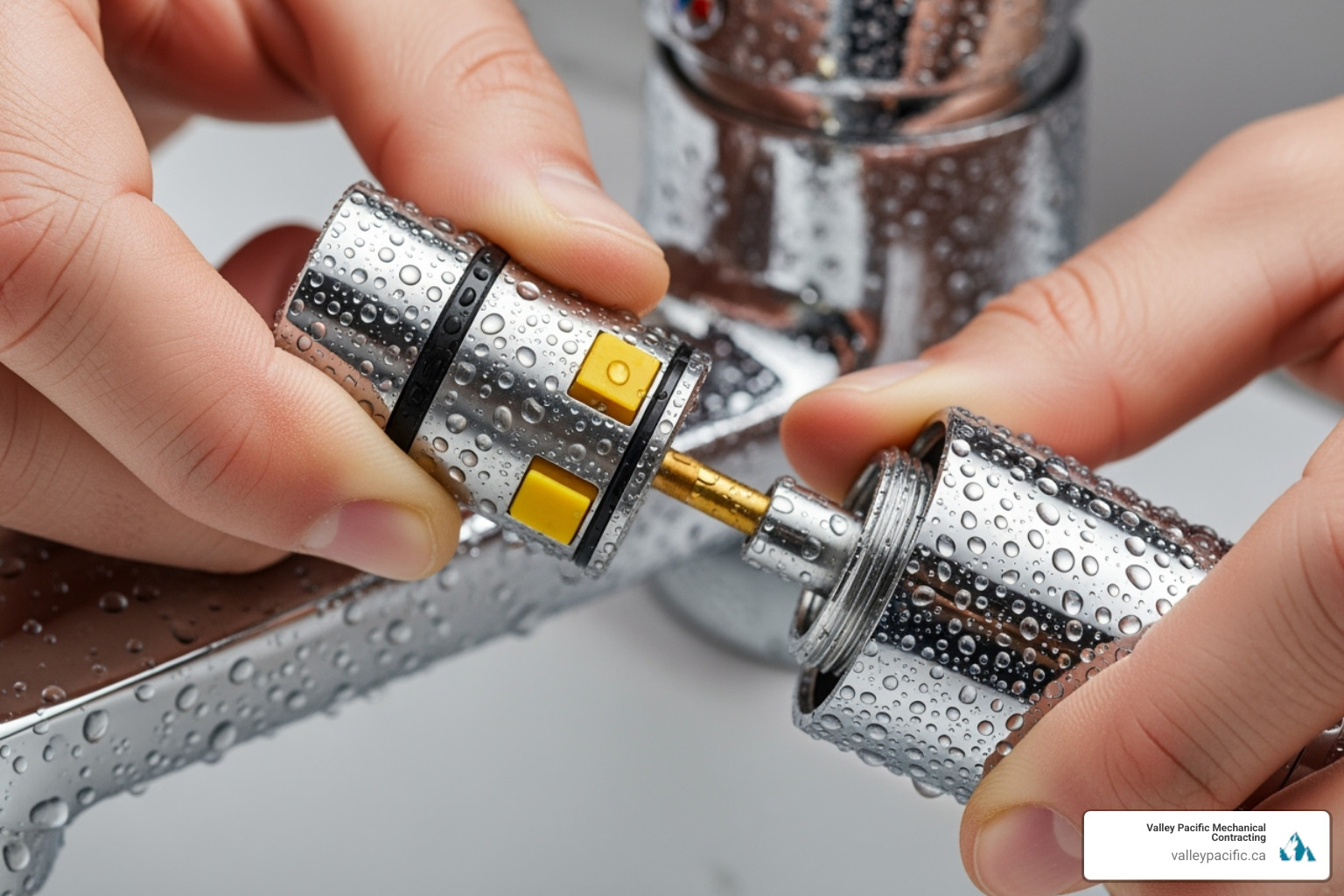
Before installing the new one, inspect any O-rings in the housing and replace if worn. Installing the new cartridge requires careful alignment; look for tabs or notches to ensure it goes in correctly. Push it firmly into place, replace the retaining hardware, and reattach the handle.
Mending a Ceramic Disk Faucet
These durable faucets usually leak due to worn seals, not the disks themselves.
Start by removing the handle and cap. There's typically a set screw hiding under a decorative cap. Once the handle is off, unscrew or lift off the dome-shaped escutcheon cap. The ceramic disk cylinder is held in place by mounting screws; remove these and lift out the cylinder. Look for the neoprene seals inside the cylinder or beneath it. These small seals are usually the source of leaks; gently pry out the old ones and replace them. While it's apart, clean the cylinder openings thoroughly with white vinegar to remove mineral deposits. Reassemble with care, ensuring proper alignment before tightening the screws.
Stopping a Ball-Type Faucet Leak
These single-handle kitchen faucets have more moving parts, but the repair is straightforward.
Remove the handle by finding the set screw, usually hidden under a cap. Next, use pliers (wrapped in a rag to protect the finish) to unscrew the cap and collar. Carefully lift out the cam and ball assembly. The crucial step is replacing the seats and springs inside the faucet body. Use needle-nose pliers to remove the small rubber seats and springs. To install the new ones, place a spring and seat on the tip of a pencil and lower them into position. When reinstalling the ball, make sure its slot aligns with the tab inside the faucet body. Replace the cam and cap, tighten by hand, then gently with pliers.
Finishing Touches and Pro Tips
You're in the home stretch! These final steps and expert tips will help ensure your faucet leak repair is successful and stands the test of time.
Reassembling Your Faucet Correctly
Think of reassembly like solving a puzzle in reverse - everything needs to go back exactly where it came from, but with a few key considerations that separate amateur fixes from professional-quality repairs.
Reverse the disassembly order you followed earlier, but don't rush through this step. Take your time to ensure each component fits snugly in its proper place. This methodical approach prevents the frustration of having to start over.
Here's where many DIYers go wrong: don't overtighten anything! While you want connections to be snug and watertight, overtightening is one of the fastest ways to create new problems. Stripped threads, cracked plastic components, and deformed washers can all result from being too aggressive with your wrench. The golden rule? Tighten until snug, then give it just a small extra turn.
Apply plumber's grease generously to new O-rings, rubber washers, and any internal moving parts. This isn't just about lubrication - it helps components seat properly and extends their lifespan significantly. A thin coat on threads also makes future repairs much easier.
Pay special attention to checking the alignment of parts like cartridges, ceramic disks, and ball assemblies. These components have specific tabs, slots, or keyways that must line up perfectly with the faucet body. Improper alignment is like trying to force the wrong puzzle piece - it might seem to fit, but it won't function correctly.
Tips for a Lasting Faucet Leak Repair
We want this faucet leak repair to be your last for a long time! These professional insights can make the difference between a quick fix and a permanent solution.
Using exact replacement parts cannot be overstated. Even parts that look "close enough" can fail quickly or cause new leaks. The few extra minutes spent ensuring you have the right component will save you hours of frustration later.
Clean all components thoroughly before reassembly. Those mineral deposits and that grimy buildup aren't just unsightly - they prevent new seals from creating perfect contact. A small brush, an old toothbrush, and white vinegar work wonders. Think of it as giving your faucet a fresh start.
While you have everything apart, inspect other components for signs of wear, corrosion, or pitting. If something looks questionable, replacing it now saves you from another repair session in a few months. It's like changing your car's air filter while you're already under the hood.
Test thoroughly for several minutes after reassembly. Don't just turn the water on for a quick check - run the faucet for several minutes, cycling it on and off, testing both hot and cold water. Watch closely for any drips or seepage around the handle and spout. Sometimes leaks take a few minutes to appear as water pressure builds up in the system.
When to Call a Professional Plumber
While faucet leak repair is often a rewarding DIY project, knowing when to call in the pros can save you time, money, and potential water damage.
Persistent leaks after repair are a clear signal that something more complex is happening. You might be dealing with a cracked faucet body, damage to internal components that aren't easily accessible, or issues with your home's water pressure that extend beyond the faucet itself.
Extensive corrosion or damage finded during disassembly often means you're looking at replacement rather than repair. Severely corroded components, stripped screws that won't come out, or a faucet body that's seen better days might be beyond a DIY fix.
If you're uncomfortable with the project at any point, there's no shame in calling for backup. A botched repair can lead to water damage, burst pipes, or other costly problems that far exceed the cost of professional service.
Intricate plumbing arrangements or custom faucets sometimes require specialized knowledge and tools that aren't worth purchasing for a one-time repair. Some older or high-end faucets have unique designs that can puzzle even experienced DIYers.
Signs you need a pro include leaks affecting other parts of your plumbing system, dealing with very high water pressure, or suspecting hidden pipe damage. These situations often require diagnostic skills and tools beyond typical homeowner resources.
For residents in the Lower Mainland dealing with complex plumbing issues, Valley Pacific Mechanical Contracting brings over 30 years of expertise to every job. We offer 24/7 emergency service and specialize in providing a headache-free experience for homeowners in Mission, Maple Ridge, Langley, Pitt Meadows, and Coquitlam. Learn more about our plumbing services in Maple Ridge BC.
Frequently Asked Questions about Faucet Leaks
We've covered the nuts and bolts of faucet leak repair, but let's tackle some questions that homeowners ask us all the time. These answers might just surprise you!
How much water does a leaky faucet really waste?
That innocent little drip is actually a sneaky water thief! A single drip per second can waste over 3,000 gallons per year, which is enough water for more than 180 showers. Just imagine - that's like taking a shower every other day for an entire year, all from one tiny drip!
Here's what really gets us: most people think a slow drip isn't worth worrying about. But that steady trickle can add $35 or more to your annual water bill. Multiply that by a few leaky faucets around the house, and you're looking at real money going straight down the drain.
Beyond your wallet, there's the environmental impact. Water is precious, and wasting thousands of gallons annually affects our local water supply and conservation efforts. It's one of those small fixes that makes a big difference.
What is the most common reason a faucet starts dripping?
Nine times out of ten, it's simply worn-out internal parts doing what old parts do - giving up! Think of it like the tires on your car - they work great until they don't.
In older compression faucets with separate hot and cold handles, the rubber washer is usually the culprit. These little rubber seals get hard and cracked over time, losing their ability to create that perfect watertight seal against the valve seat.
For modern single-handle faucets, we typically see issues with deteriorated O-rings or a faulty cartridge. The cartridge is like the heart of your faucet - when it starts failing, you'll notice leaks around the handle or inconsistent water flow.
What causes this wear? Just normal life! Constant water pressure, mineral deposits from hard water, and daily use all take their toll. The good news? These parts are designed to be replaced, and most faucet leak repair jobs are totally doable for the average homeowner.
Is it a good idea to replace the whole faucet instead of repairing it?
Sometimes throwing in the towel and getting a shiny new faucet is actually the smarter move! Replacement makes sense when your faucet is old, severely corroded, or if you've tried multiple repairs without success.
Here's our rule of thumb: if the faucet body itself is damaged, if you're dealing with extensive mineral buildup that won't clean off, or if the finish is beyond saving, replacement is probably your best bet. A new faucet can also improve water efficiency and give your kitchen or bathroom a fresh, updated look.
But don't rush to replace if you haven't tried a simple repair first! Most leaks are caused by inexpensive parts that cost under $20 to replace. If your faucet is relatively new and in good shape overall, faucet leak repair is usually the way to go.
The sweet spot? If you're planning a kitchen or bathroom renovation anyway, that's the perfect time to upgrade to a more efficient, stylish model. Otherwise, a quick repair will likely solve your dripping problem and save you money.
Conclusion
There's something deeply satisfying about silencing that annoying drip, drip, drip once and for all. Faucet leak repair isn't just about stopping the noise - it's about taking control of your home's efficiency and putting money back in your pocket.
By now, you've learned that most faucet leaks come down to simple worn-out parts that cost just a few dollars to replace. Whether you're dealing with a stubborn compression faucet from the 1980s or a sleek modern cartridge design, the principles remain the same: identify your faucet type, locate the source of the leak, and replace the right parts.
The best part? You've just saved yourself a service call and gained valuable DIY skills. Every time you turn that handle and hear blessed silence instead of dripping, you'll feel that little surge of pride that comes with fixing something yourself.
But let's be honest - not every plumbing project is a perfect DIY candidate. If you've followed our steps and that leak is still mocking you, or if you finded more extensive damage during your repair, there's no shame in calling for backup. Sometimes the most efficient solution is letting someone with three decades of experience handle the headache for you.
For homeowners in Mission, Maple Ridge, Langley, Pitt Meadows, or anywhere else in the Lower Mainland, our team at Valley Pacific Mechanical Contracting specializes in turning plumbing frustrations into headache-free experiences. We're available 24/7 because we know plumbing problems don't wait for business hours. Learn more about our plumbing services in Maple Ridge BC.
While you're thinking about home efficiency improvements, don't forget that your heating and cooling system might need some attention too. A well-maintained home is an efficient home, and we can help with that as well. You can explore our heat pump installation services in Langley, BC to keep your entire home running smoothly year-round.
Whether you tackle the next drip yourself or give us a call, you're making a smart choice for your home and your wallet. Here's to dry faucets and lower water bills!
Why HVAC System Upgrades Are Essential for Modern Homes
HVAC system upgrades can transform your home's comfort, slash energy bills, and boost property value. If you're dealing with rising utility costs, inconsistent temperatures, or frequent breakdowns, strategic upgrades offer a clear path to a healthier, more efficient home. Your HVAC system accounts for nearly half of your energy bills, so when it's outdated, you're losing money to poor performance.
Key upgrades prevent problems and improve your quality of life:
- Heat Pump Installation: Provides both heating and cooling with up to 20% lower energy costs.
- Smart Thermostats: Automatically adjust temperatures and can be controlled remotely.
- Advanced Air Purification: HEPA filters capture 99.97% of airborne particles.
- Ductwork Sealing: Prevents up to 30% energy loss from leaky ducts.
- Zoning Systems: Allow room-by-room temperature control.
- Energy Recovery Ventilators: Bring in fresh air while maintaining energy efficiency.
Many of these upgrades work together, creating a comprehensive system that's greater than the sum of its parts.
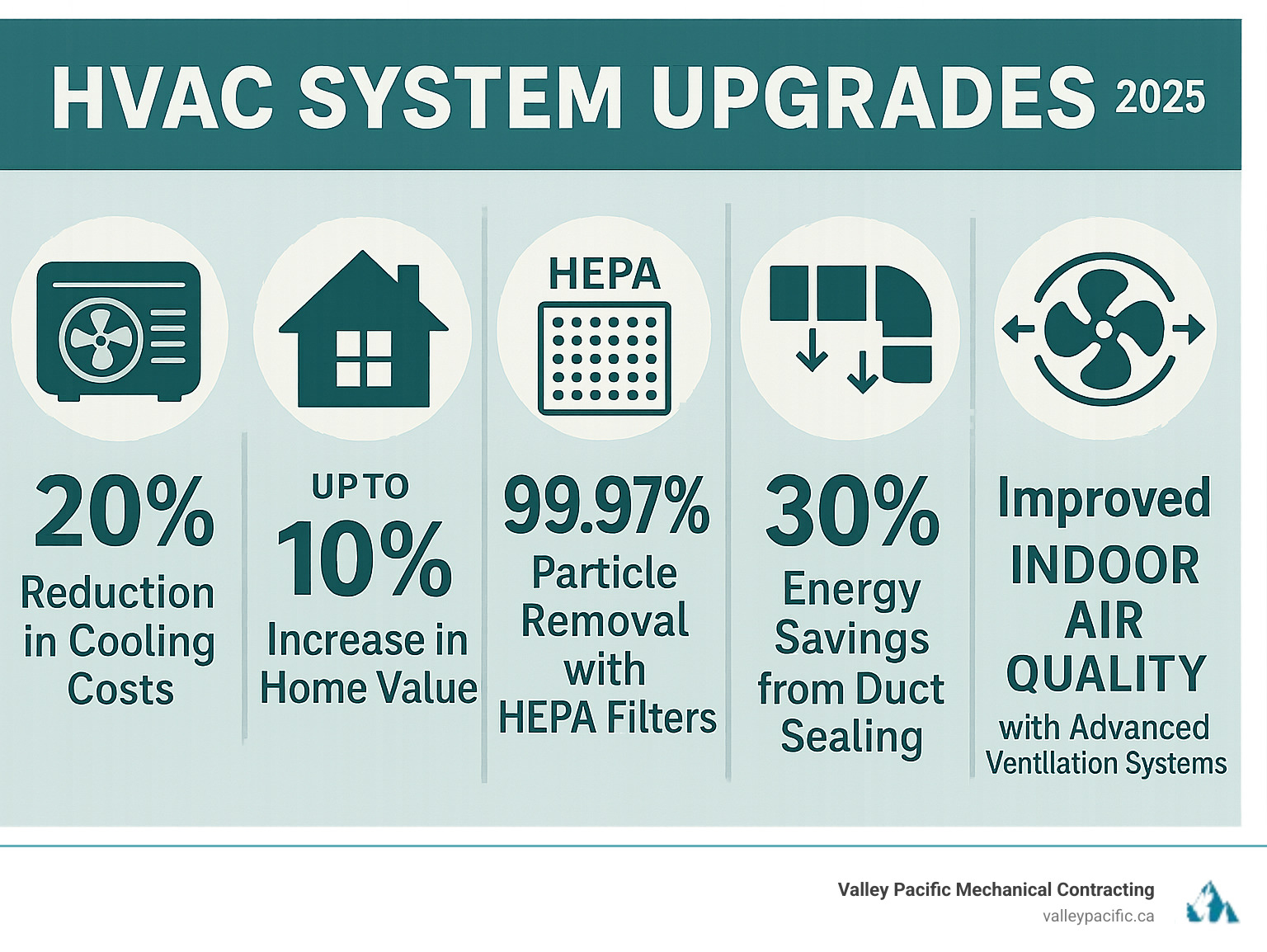
Why Upgrade Your HVAC System? The Triple-Win for Your Home
Considering HVAC system upgrades is a triple-win for your home, delivering improved comfort, significant savings, and better health. An outdated system leads to uncomfortable temperatures, high energy bills, and poor air quality. Modern upgrades solve these problems simultaneously, making a noticeable difference if you're seeing Signs You Need a New AC Installation or trying to Solve HVAC Hot and Cold Spots.
Improved Comfort and Livability
Modern HVAC systems provide consistent temperatures in every room by using variable-speed motors and intelligent controls to eliminate hot and cold spots. Proper humidity control is another game-changer, maintaining around 50% humidity to prevent the sticky feeling of summer and the dry air of winter. Plus, the quieter operation of new units creates a more peaceful home environment. Our team specializes in HVAC Services for Home Comfort that deliver these improvements.
Significant Energy Savings and ROI
Since your HVAC system accounts for about half of your home's energy use, upgrades lead to lower utility bills. High-efficiency systems can cut cooling costs by up to 20%. Look for ENERGY STAR certified products and take advantage of financial incentives like Federal tax credits and our Promotions. These upgrades also reduce your carbon footprint and can increase your home's value by up to 10%, offering a strong return on investment.
A Boost to Indoor Air Quality (IAQ)
Indoor air can be far more polluted than outdoor air. Modern HVAC system upgrades are your first line of defense. Advanced filtration with HEPA filters captures 99.97% of airborne particles like dust, pollen, and dander. Ventilation systems like HRVs and ERVs bring in fresh air efficiently, while proper humidity control helps with mold prevention. As noted by the US EPA, cleaner air improves everything from sleep to cognitive function.
Top HVAC System Upgrades for Modern Homes
HVAC system upgrades are smart investments that make your home work better for you. Today's technology, from efficient heat pumps to smart controls, integrates seamlessly into your lifestyle. Explore our Services to find the perfect fit for your home.

Switch to a High-Efficiency Heat Pump
A high-efficiency heat pump is one of the most impactful upgrades, providing both heating and cooling in a single, efficient unit. Instead of creating heat, it moves it—transferring warmth inside in the winter and drawing heat out in the summer. This process is highly energy-efficient, lowering utility bills and your carbon footprint. Modern heat pumps are reliable even in the Lower Mainland's freezing temperatures, making them an excellent choice. We offer Expert Heat Pump Repair Services and professional Heat Pump Installation Langley BC.
Integrate Smart Thermostats and Zoning
Smart thermostats act as a personal climate assistant, connecting to Wi-Fi so you can control your home's temperature from anywhere via a smartphone app. Their learning algorithms automatically optimize comfort and energy use based on your routine. For ultimate control, zoning systems divide your home into different temperature zones. This room-by-room control eliminates hot and cold spots and reduces wasted energy by only conditioning the spaces you're using.
Improve Air Quality with Ventilation and Purification
Modernize your home's breathing environment with air quality upgrades. Air exchangers (HRVs and ERVs) provide a continuous supply of fresh air without wasting energy. For filtration, HEPA filters capture 99.97% of airborne particles, while UV light purifiers neutralize bacteria and viruses in your ductwork. Whole-home dehumidifiers and humidifiers maintain optimal moisture levels for comfort and health. Our team can design Custom HVAC Services for Homes to meet your specific air quality needs.
The Upgrade Process: From Planning to Payoff
A successful HVAC system upgrade begins with a professional assessment to determine your home's unique needs. Proper system sizing is crucial for performance, and our technicians use industry-standard calculations to match the new equipment to your home. We manage the process to be headache-free, from installation to setting you up with a Maintenance Plan to protect your investment. Ready to start? Request a Quote to discuss your options.
When to Repair vs. When to Replace
Deciding whether to repair or replace your system is a key decision. Replacement is often the smarter choice if your system is over 10-15 years old, you're facing frequent or expensive repairs, or your energy bills are steadily rising. Another major factor is the use of obsolete R-22 refrigerant, which is being phased out and makes repairs costly. If you see multiple HVAC System May Fail Soon: Signs, it's time to consider replacement.
Retrofitting: A Cost-Effective Alternative
Retrofitting offers a smart middle ground, allowing you to upgrade key components without a full replacement. Duct sealing and insulation is a high-impact retrofit, as leaky ducts can waste up to 30% of your conditioned air. Other options include adding new components like smart thermostats or air purifiers to your existing system. Retrofitting is especially beneficial for older buildings where a full overhaul may be disruptive. The Department of Energy highlights the significant potential of these projects.
Financial and Environmental Considerations of HVAC system upgrades
Upgrades are a sound financial strategy. The return on investment (ROI) comes from lower utility bills, with high-efficiency systems often paying for themselves over time. In BC, substantial rebates from programs on the CleanBC Better Homes website can offset initial costs. Modern systems also use environmentally friendly refrigerant types like R-454B, reducing your carbon footprint. We offer flexible Financing to make your project manageable.
Why Upgrade Your HVAC System? The Triple-Win for Your Home
HVAC system upgrades deliver a powerful "triple-win" for your home: dramatically improved comfort, significant energy savings, and healthier indoor air. An outdated system wastes energy and provides subpar performance, but modern technology works smarter to prevent problems and improve your living space.
Key upgrades include:
- Heat pump installation: Delivers efficient heating and cooling, cutting energy costs.
- Smart thermostats: Learn your routine to automate temperature adjustments.
- Advanced air purification: Uses HEPA filters to capture 99.97% of airborne allergens.
- Ductwork sealing: Prevents up to 30% of conditioned air from being wasted.
- Zoning systems: Provide personalized, room-by-room temperature control.
- Energy recovery ventilators: Supply fresh air without sacrificing energy efficiency.
These upgrades work together to increase your property value by up to 10% and are the ideal solution if you're experiencing Signs You Need a New AC Installation or trying to Solve HVAC Hot and Cold Spots.
Why Upgrade Your HVAC System? The Triple-Win for Your Home
Investing in HVAC system upgrades is a "triple-win" that delivers improved comfort, significant energy savings, and better indoor air quality. Your HVAC system can account for nearly half of your energy bill, and an outdated unit wastes money while struggling to perform. Upgrades not only lower utility costs but also provide consistent temperatures, optimal humidity, and the peace of mind that comes with a reliable system. If you're dealing with issues like those in Signs You Need a New AC Installation or trying to Solve HVAC Hot and Cold Spots, it's time to consider a fresh start.
Improved Comfort and Livability
Modern HVAC system upgrades deliver precision comfort. Consistent temperatures are maintained by advanced variable-speed motors, eliminating hot and cold spots. Integrated humidity control keeps your home comfortable year-round, preventing mold growth and dry winter air. Furthermore, today's units offer whisper-quiet operation, contributing to a more peaceful home. We provide HVAC Services for Home Comfort that transform your living space.
Significant Energy Savings and ROI
Upgrades offer a substantial return on investment. High-efficiency models can cut cooling costs by up to 20% and overall energy use by 30%, leading to hundreds of dollars in annual savings. Look for ENERGY STAR certified products and take advantage of Federal tax credits and our Promotions to offset the initial cost. An upgraded system can also increase your home's value by up to 10%.
A Boost to Indoor Air Quality (IAQ)
Indoor air can be up to five times more polluted than outdoor air. Advanced filtration with HEPA filters captures 99.97% of airborne particles, including dust, pollen, and pet dander. Air exchangers (HRVs and ERVs) provide improved ventilation by bringing in fresh air while recovering energy. This, combined with humidity control, reduces pollutants and the risk of mold, leading to improved sleep and overall well-being for your family, a fact supported by research from the US EPA.
Top HVAC System Upgrades for Modern Homes
Modern HVAC system upgrades offer significant advancements in comfort, efficiency, and air quality. These intelligent systems are designed to integrate seamlessly into your life, making your home smarter and more responsive. Explore our Services to find the perfect upgrades for your home.
Switch to a High-Efficiency Heat Pump
The switch to a high-efficiency heat pump is a major energy-saving upgrade. This versatile system provides both heating and cooling by transferring heat rather than creating it. In winter, it moves heat indoors, and in summer, it moves heat outdoors. This process is highly efficient, leading to lower energy bills and a smaller carbon footprint. Modern heat pumps are effective even in the Lower Mainland's colder temperatures, making them an ideal year-round solution. We offer Expert Heat Pump Repair Services and specialized Heat Pump Installation Langley BC.
Integrate Smart Thermostats and Zoning
Smart thermostats offer Wi-Fi connectivity, allowing you to control your home's temperature remotely via a smartphone app. They learn your daily patterns to optimize energy use automatically. Paired with a zoning system, which divides your home into independently controlled temperature zones, you can eliminate hot and cold spots and significantly reduce wasted energy. This targeted approach provides personalized comfort and maximum efficiency.

Improve Air Quality with Ventilation and Purification
Improving indoor air quality (IAQ) is crucial for your health. Air exchangers (HRVs and ERVs) continuously supply fresh, filtered air while recovering energy from outgoing air. For purification, HEPA filters capture 99.97% of particles, while UV light purifiers neutralize germs like bacteria and viruses. Whole-home dehumidifiers and humidifiers maintain balanced humidity, which is vital for comfort and preventing mold. Our team provides Custom HVAC Services for Homes to create a healthier indoor environment.
The Upgrade Process: From Planning to Payoff
Starting on HVAC system upgrades is a smooth journey with the right guidance. The process starts with a professional assessment of your home's needs and current system. Proper system sizing is critical to ensure optimal performance and efficiency from day one. Our goal is a "headache-free" experience, from planning to professional execution. Ready to begin? Request a Quote to explore your options.
When to Repair vs. When to Replace
Deciding whether to repair or replace is a critical step. The following table can help guide your decision:
| Factor | Consider Repair | Consider Replacement |
|---|---|---|
| System Age | Under 10 years | 15+ years |
| Repair Cost | Less than 50% of replacement cost | More than 50% of replacement cost |
| Energy Bills | Stable or decreasing | Rising steadily |
| Breakdowns | Occasional, minor issues | Frequent, major problems |
| Efficiency | Still meets modern standards | Significantly below current ratings |
| Refrigerant Type | Uses modern refrigerants | Uses obsolete R-22 refrigerant |
If you're experiencing frequent breakdowns or have a system using obsolete R-22 refrigerant, replacement is often the most cost-effective choice. Check for other HVAC System May Fail Soon: Signs.
Retrofitting: A Cost-Effective Alternative
Retrofitting improves performance without a full replacement. Duct sealing and insulation is one of the most effective retrofits, as leaky ducts can waste up to 30% of conditioned air. Other options include adding new components like smart thermostats or upgrading controls to modernize an older system's capabilities. This approach is ideal for older buildings where a full overhaul is impractical, as noted by the Department of Energy.
Financial and Environmental Considerations of HVAC System Upgrades
Upgrades benefit both your wallet and the environment. The return on investment (ROI) comes from long-term energy savings. BC rebates, found on the CleanBC Better Homes website, can significantly reduce upfront costs. Modern systems also use cleaner fuel sources and environmentally friendly refrigerant types like R-454B, lowering your carbon footprint. Our Financing options can help make your project affordable.
Why Upgrade Your HVAC System? The Triple-Win for Your Home
Think of HVAC system upgrades as a complete home makeover, delivering three powerful benefits at once: dramatically improved comfort, serious energy savings, and cleaner, healthier air. If your system is over 10-15 years old, it's likely an energy hog that drives up utility bills while providing inconsistent comfort. Modern systems are designed to deliver superior performance while using far less energy.
Upgrades eliminate temperature battles, solve humidity problems, and reduce the chance of unexpected breakdowns. If you're already dealing with Signs You Need a New AC Installation or trying to Solve HVAC Hot and Cold Spots, upgrading is a necessary step.
Improved Comfort and Livability
Modern HVAC system upgrades deliver precision comfort. They use variable-speed motors and zoning systems to maintain consistent temperatures, eliminating hot and cold spots. Advanced humidity control maintains an optimal 50% relative humidity, preventing both sticky summer air and dry winter conditions. Plus, the quiet operation of new units creates a more peaceful home. We provide HVAC Services for Home Comfort to make your home a true sanctuary.
Significant Energy Savings and ROI
As your home's biggest energy user, upgrading your HVAC system is a smart financial move. Energy-efficient models can cut cooling costs by up to 20%, and retrofits can reduce overall energy use by 30%. Always look for ENERGY STAR certified products and take advantage of Federal tax credits and our Promotions. An upgrade can also boost your home's value by up to 10%, making it a win-win investment.
A Boost to Indoor Air Quality (IAQ)
Indoor air can be far more polluted than outdoor air. Modern systems actively clean your air with HEPA filters that capture 99.97% of airborne particles, including dust, pollen, and viruses. Air exchangers (HRVs/ERVs) bring in fresh, filtered air efficiently. This, combined with proper humidity control, prevents mold growth and creates a healthier environment, which the US EPA notes can improve cognitive function and sleep.
Top HVAC System Upgrades for Modern Homes
Modern HVAC system upgrades redefine home climate control with significant advancements in comfort and efficiency. From cutting-edge heat pumps to intelligent controls, these upgrades integrate seamlessly into your life. Explore our Services to find the perfect fit for your home.
Switch to a High-Efficiency Heat Pump
A high-efficiency heat pump is a versatile, energy-saving upgrade that provides both heating and cooling. It works by transferring heat—moving it inside during winter and outside during summer—which is far more efficient than burning fuel. This results in lower energy bills and a reduced carbon footprint. Modern heat pumps are highly effective in the Lower Mainland climate, making them an ideal choice for year-round comfort. We offer Expert Heat Pump Repair Services and specialized installation, including Heat Pump Installation Langley BC.
Integrate Smart Thermostats and Zoning
Smart thermostats provide ultimate convenience and efficiency. With Wi-Fi connectivity, you can control your home's temperature from anywhere using a smartphone app. They also feature learning algorithms that automatically adjust settings to save energy based on your routine. When combined with a zoning system, you can set different temperatures for different areas of your home, eliminating hot and cold spots while reducing wasted energy.
Improve Air Quality with Ventilation and Purification
Upgrading your home's ventilation and purification systems is essential for health. Air exchangers (HRVs and ERVs) continuously bring in fresh outdoor air while recovering energy from the outgoing air. For purification, we offer several solutions:
- HEPA Filters: Capture 99.97% of airborne particles like dust, pollen, and dander.
- UV Light Purifiers: Use ultraviolet energy to neutralize bacteria, viruses, and mold spores in your ductwork.
- Whole-Home Dehumidifiers/Humidifiers: Maintain optimal humidity levels for comfort and to prevent issues like mold growth or dry skin.
Our team can design Custom HVAC Services for Homes to meet your specific air quality needs.
The Upgrade Process: From Planning to Payoff
HVAC system upgrades are a smooth process with our 30+ years of expertise. It begins with a professional assessment to evaluate your home's needs and ensure proper system sizing for peak efficiency. We manage every step to provide a "headache-free" experience. Request a Quote to get started.
When to Repair vs. When to Replace
Repair vs. Replacement: Making the Right Call
| Factor | Consider Repair | Consider Replacement |
|---|---|---|
| System Age | Under 10 years old. | 10-15 years or older. |
| Repair Cost | Less than 30% of new system cost. | Exceeds 50% of new system cost. |
| Energy Bills | Stable utility costs. | Unexplained increase in energy bills. |
| Frequency of Breakdowns | Infrequent, isolated issues. | Frequent breakdowns, indicating HVAC System May Fail Soon: Signs. |
| Refrigerant Type | Uses modern refrigerants (e.g., R-410A). | Uses obsolete R-22 refrigerant. |
If your system is aging and requires frequent, costly repairs, replacement is usually the more economical long-term solution.
Retrofitting: A Cost-Effective Alternative
For older buildings, retrofitting is a smart alternative to a full replacement. This approach involves strategic upgrades to your existing system. Duct sealing and insulation is highly effective, as leaky ducts can waste over 30% of your system's output. Other impactful retrofits include adding upgraded controls like smart thermostats, installing energy recovery ventilators (ERVs), or adding variable-frequency drives (VFDs) to fan motors. As the Department of Energy notes, retrofits can significantly reduce energy use while improving air quality.
Financial and Environmental Considerations of HVAC system upgrades
What's good for your energy bills is often good for the environment. The return on investment (ROI) from an upgrade comes from long-term utility savings and an increase in home value. Rebates from programs on the CleanBC Better Homes website and our Financing options make upgrades more accessible. Environmentally, modern systems use cleaner fuel sources and eco-friendly refrigerants like R-454B, which have a much lower global warming potential than phased-out refrigerants like R-22.
Frequently Asked Questions about HVAC Upgrades
We've heard every question about HVAC system upgrades over our 30+ years in business. Here are answers to the most common concerns.
What are the most significant energy-saving HVAC upgrades?
The upgrades with the biggest impact on your energy bills include:
- High-Efficiency Heat Pumps: They move heat rather than creating it, making them incredibly efficient for both heating and cooling.
- Smart Thermostats: These devices learn your schedule and optimize energy use automatically, so you're not heating or cooling an empty home.
- Ductwork Sealing: Leaky ducts can waste up to 30% of your conditioned air. Sealing them provides an immediate and significant return.
- Variable-Speed Motors: Unlike older motors that run at full blast, these adjust their speed to match your home's needs, saving energy.
- Zoning Systems: These allow you to heat or cool only the rooms you're using, preventing wasted energy in unoccupied spaces.
How do I know which HVAC upgrades are right for my home?
Choosing the right upgrade depends on several factors, which is why we always start with a professional assessment. We consider your home's age and layout, its insulation, your existing system, and your local climate. Your budget, ROI goals, and personal comfort priorities—such as eliminating hot spots or improving air quality for allergies—are also key. Our team evaluates all these elements to recommend a solution custom to you. Understanding Furnace Installation Essentials for Homeowners can also help you prepare.
How long does an HVAC system upgrade take?
The timeline for HVAC system upgrades varies. A simple smart thermostat installation may take a few hours, while a full system replacement typically takes 1-3 days. More complex projects involving significant ductwork modifications or new refrigerant lines could take up to 5 days. The timeline depends on system complexity, your home's layout, and any necessary permits. We provide a clear schedule upfront so you know exactly what to expect and work efficiently to minimize disruption.
Conclusion: A Healthier, More Efficient Home Awaits
Investing in HVAC system upgrades is one of the most impactful decisions you can make for your home, improving comfort, efficiency, and health. Upgrades like energy-efficient heat pumps, smart thermostats, and advanced air purification work together to transform your living space, lower your energy bills, and provide cleaner air for your family.
At Valley Pacific Mechanical Contracting, we've helped homeowners across the Lower Mainland make these beneficial changes for over 30 years. We are committed to a headache-free experience, from the initial consultation to long-term performance. Our work is backed by the Daikin Comfort Promise and 24/7 emergency service, because your comfort is our priority.
Whether you're tired of high energy bills or an unreliable system, we're here to help design the upgrade that makes the most sense for you. A healthier, more efficient home is achievable.
Ready to take the next step? Keep your system in top shape with our Maintenance Plan. If you're interested in heat pump solutions, Contact us for your heat pump service needs in Langley, BC.
When the temperature drops in Mission, a working furnace isn't just for comfort—it’s something you rely on. Whether it’s early in the fall or the cold has already settled in, most homeowners count on their heating system to work without any issues. So when the furnace suddenly won’t ignite, it can throw off your entire day. It’s frustrating, especially when you're left in a cold house without a clear reason why it’s happening.
The good news is that this is a common issue with a wide range of causes—some simple, others more technical. Spotting the early warning signs or understanding what's behind the problem can help you make the right next steps. Here are a few reasons your furnace might not be starting, and what Mission homeowners should look out for when it seems like the heating system is refusing to do its job.
Lack Of Power Or Gas Supply
One of the first things to check when your furnace won’t ignite is whether it’s even receiving what it needs to operate. Power and gas are both necessary, and interruptions to either one can stop ignition entirely. This isn’t always linked to equipment failure—small things like a tripped breaker or closed gas valve happen more often than you’d expect.
Here are some common causes that can interrupt power or gas flow:
- A tripped circuit breaker: If the furnace has stopped suddenly and doesn’t show any signs of running (like no lights or humming), head to your breaker panel. Look for any switches that are flipped to the off position or stuck mid-point.
- A switched-off furnace switch: Furnaces usually have their own power switch, often located beside the unit. Make sure it hasn’t been turned off by accident.
- An unplugged unit: If your furnace uses a plug, double-check that it’s fully connected to the power outlet.
- Closed gas valve: If your furnace uses natural gas or propane, check the gas shut-off valve. It needs to be parallel to the gas line to allow flow.
- Gas service issues: Though rare, there may be temporary outages in your area, which can affect furnace ignition.
If none of these are the issue and you still can’t get the furnace to ignite, it’s time to let our technicians inspect the system safely and professionally.
Ignition System Problems
When furnace ignition doesn’t respond at all, even with gas and power flowing, the problem could be in the ignition system itself. Today’s residential furnaces in Mission mostly use either a hot surface igniter or an electronic spark ignition system. These parts are small but play a big role. A problem here will cause the unit to stall every time it tries to start.
Common issues related to the furnace ignition system include:
- Worn or broken igniters: These can crack with age or fail after power surges.
- Faulty sensors: Flame sensors must detect the heat from the burner. If dirty or failing, they won’t register the flame, and the system will shut down.
- Delayed ignition: This means there might be a gas buildup before ignition, often heard as a small bang when the furnace finally lights. Avoid restarting the unit before a technician checks it.
An example we often see in Mission is when the furnace lights for a few seconds, then shuts off and tries again repeatedly. That’s often tied to a dirty or failing flame sensor. While cleaning might sound easy, the sensor is sensitive and should be checked by our professionals to avoid further damage.
Getting to the root of ignition system problems takes the right tools and knowledge. Whether it’s replacing a faulty igniter or recalibrating a sensor, this isn’t something to attempt without proper training.
Thermostat Malfunctions
The thermostat might not seem like a big deal, but it’s what tells your furnace when and how long to run. If there’s an issue with communication between the thermostat and the furnace, the system won’t know it needs to ignite. It’s one of the more overlooked problems, but it can lead to noticeable heating inconsistencies inside the home.
Some signs your thermostat may not be working properly include:
- Room temperature doesn’t match the setting
- Furnace won’t start at all or turns on and off rapidly
- Display is blank or glitchy
- Battery warning or no response to user input
Before calling us in, check the thermostat’s batteries—many wall-mounted models still use them. Replace them with fresh ones and see if that helps. Also, double-check the settings. It should be set to heat, and the temperature needs to be several degrees higher than the room temperature. If it’s programmable, confirm that the schedule is correct.
Even if the power and settings look fine, internal failures can still keep the signal from reaching the furnace. If you’ve tried adjusting the settings and restarting the system without results, a malfunctioning thermostat could be the reason your furnace isn’t turning on. Our technicians can test the unit and wiring to make sure it’s working as it should.
Dirty or Clogged Filters
Air filters play a larger part in your furnace’s performance than most Mission homeowners realize. When the filter is dirty, it restricts the flow of air, which creates stress on your furnace. This can lead to overheating, and many systems include a safety switch that prevents ignition if unsafe temperature levels build up. Even if the unit does start, it may short cycle or run inefficiently.
If your furnace isn’t turning on or runs for very short cycles, one of the first things to look at is the condition of the air filter. A filter that’s grey or covered in dust needs to be replaced right away. If you can’t see any light passing through it, it’s clogged enough to impact performance.
Filters should be checked every one to three months depending on the type, household usage, and whether anyone in the home has allergies or pets. During peak heating seasons in Mission, monthly checks are recommended. Beyond improving airflow, a clean filter makes it easier for the furnace to maintain the room’s temperature and reduces wear on internal components.
Repeated ignition failure related to airflow is a sign that deeper maintenance may be overdue. If the issues return even after filter replacement, our professionals can check for other blocked components or pressure switch faults that may not be visible to the eye.
The Importance Of Regular Furnace Maintenance
Furnaces are complex systems with many interconnected parts. Regular maintenance helps catch ignition problems before they lead to full breakdowns. Something that starts with a dirty flame sensor can lead to a complete shutdown if ignored long enough. Scheduled inspections can help stop minor issues before they become major repairs.
Our technicians look at all parts of the system that can affect ignition:
- Heat exchangers
- Motors and belts
- Safety switches
- Flame sensors and igniters
- Gas pressure regulators
Many homeowners wait until the furnace completely fails, but that delay often leads to higher repair costs or full replacements. Seasonal tune-ups are a smart way to keep everything clean, tight, and within manufacturer specifications. Most notably, regular service extends the lifespan of the unit, improves efficiency, and ensures reliability when you need heat consistently through Mission’s colder months.
Keep Your Home Warm And Safe
If your furnace isn’t igniting, that’s more than a comfort issue—it affects the safety and security of your home when temperatures drop. Troubleshooting things like power, filters, or thermostat settings can be a good first step, but if those don’t fix the issue, professional help is needed to safely get to the root of the problem.
Don’t put off repairs when ignition issues keep coming back. Whether it’s an electrical fault or a gas flow concern, these systems require experienced handling. Tackling furnace issues early, especially during fall and winter in Mission, ensures your household stays warm without surprises. Many ignition problems can be avoided altogether with regular maintenance and proactive repairs by trained technicians.
Ensure your home stays safe and warm this season by addressing heating issues promptly. If you need furnace repair in Mission, trust the expertise of Valley Pacific Mechanical Contracting Ltd. Our professionals work to diagnose and repair problems quickly so your furnace performs reliably during the cold months. For a quick estimate or to book a service visit, please contact us today.
Why Quick Action Matters When Your Boiler Starts Leaking
A boiler leaking water isn't just an inconvenience - it's a sign that your heating system needs immediate attention. Whether you're seeing a small drip or finding a puddle beneath your unit, taking swift action can save you from costly repairs and potential safety hazards.
Immediate Steps for a Leaking Boiler:
- Turn off the boiler - Switch off electrical power to prevent damage
- Shut off water supply - Close the isolation valve or main water supply
- Contain the leak - Place buckets or towels to catch dripping water
- Call a professional - Contact a Gas Safe registered technician for repairs
Common causes of boiler leaks include high pressure forcing water through the pressure relief valve, corroded components from age and wear, loose pipe joints that have worked free over time, and damaged seals around internal parts.
The good news? Not every leak means you need a complete boiler replacement. Many issues can be resolved with proper diagnosis and targeted repairs. However, some problems - like a cracked heat exchanger or extensive corrosion - may signal it's time for a new system.
Safety comes first. If you smell gas, see black soot stains, or notice your pilot light burning orange instead of blue, evacuate immediately and call emergency services. These signs indicate a dangerous gas leak, not just water.
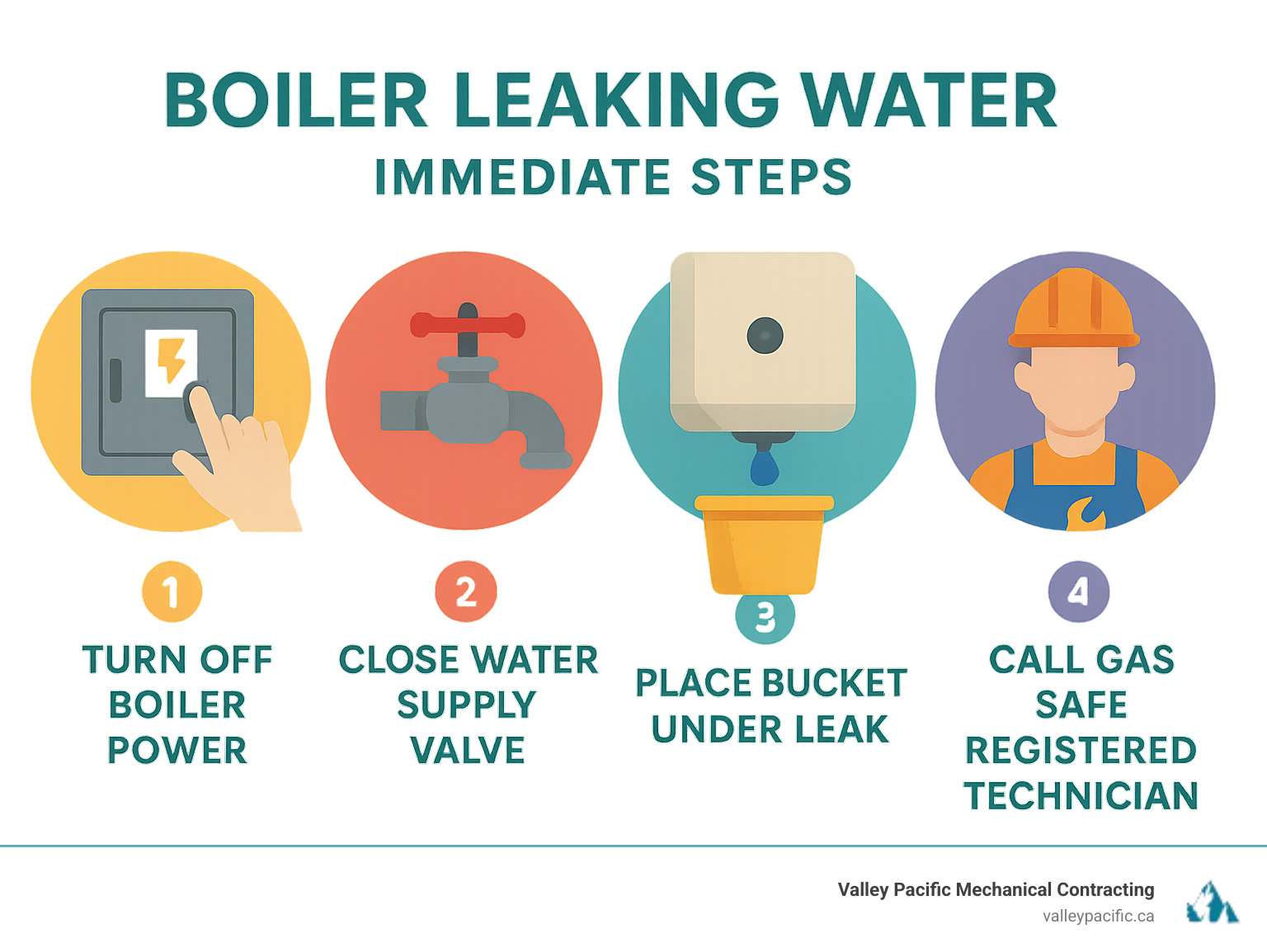
First Steps: What to Do Immediately When Your Boiler Leaks
Finding a boiler leaking water can feel overwhelming, but taking the right steps quickly makes all the difference. Your safety comes first, and that means treating this situation seriously from the moment you spot that first drip.
Water and electricity don't mix well, and when they meet near your boiler, the results can be dangerous. Electrical shock is a real risk, not to mention the potential for significant damage to your heating system. That's why your first move should always be turning off the power to your boiler at your home's electrical panel.
Next, you need to shut off the water supply to prevent the situation from getting worse. Look for the isolation valve on your boiler's incoming water line and turn it to the closed position. Can't find it? Don't worry - turning off your home's main water supply works just as well and keeps you on the safe side.
Now it's time to contain the leak as best you can. Grab whatever you have handy - buckets, towels, even old t-shirts - and start catching that dripping water. Your floors and walls will thank you later, and it gives you time to figure out your next steps without watching the puddle grow.
Is it Water or Gas? Recognizing a More Serious Danger
Here's where things get more serious. While a boiler leaking water needs attention, a gas leak is a whole different emergency. The good news is that modern boilers are designed with sealed combustion chambers that keep dangerous gases safely outside your home. But when something goes wrong, you need to know the warning signs.
Gas leaks announce themselves in several ways. That distinctive sulphur or rotten egg smell is the most obvious clue - natural gas companies add this odor specifically so you'll notice it. You might also hear hissing sounds coming from your boiler or gas lines, which means gas is escaping somewhere it shouldn't be.
Keep an eye out for black soot stains around your boiler too. These dark marks or scorch marks suggest incomplete combustion, which can be tied to gas supply problems. If your boiler has a pilot light, watch how it burns. A healthy flame burns blue, but orange or yellow flames signal trouble.
Your body can also give you warning signs. Dizziness, nausea, headaches, or unexplained fatigue when you're near the boiler could mean carbon monoxide is building up - and that's an invisible, odorless danger you can't afford to ignore.
If you suspect a gas leak, don't hesitate. Get everyone out of the house immediately, including your pets. Resist the urge to flip light switches or use your phone inside - any spark could be dangerous. If you can safely open windows and doors on your way out, do it to help ventilate the area.
Once you're at a safe distance from your home, call 911 or your local gas emergency service. Don't go back inside until emergency personnel give you the all-clear. It's better to spend a few hours somewhere else than to risk your family's safety.
For those with oil-heated boilers, watch for oil stains, pooling, or stronger-than-normal oil smells. Close the valve on your oil tank, open windows to prevent fume buildup, and call a heating professional right away.
Diagnosing the Cause of a Boiler Leaking Water
Now that you've made everything safe and contained the immediate mess, it's detective time! Finding out exactly where your boiler leaking water is coming from will help you understand what you're dealing with. Think of it like following breadcrumbs - each clue will lead you closer to the source of the problem.
Start by grabbing a flashlight and taking a careful look around your boiler. Check all the visible connections where pipes meet the unit. Look for any obvious drips or wet spots. Sometimes the leak might be coming from one place but dripping down to pool somewhere else entirely, so trace any water trails back to their starting point.
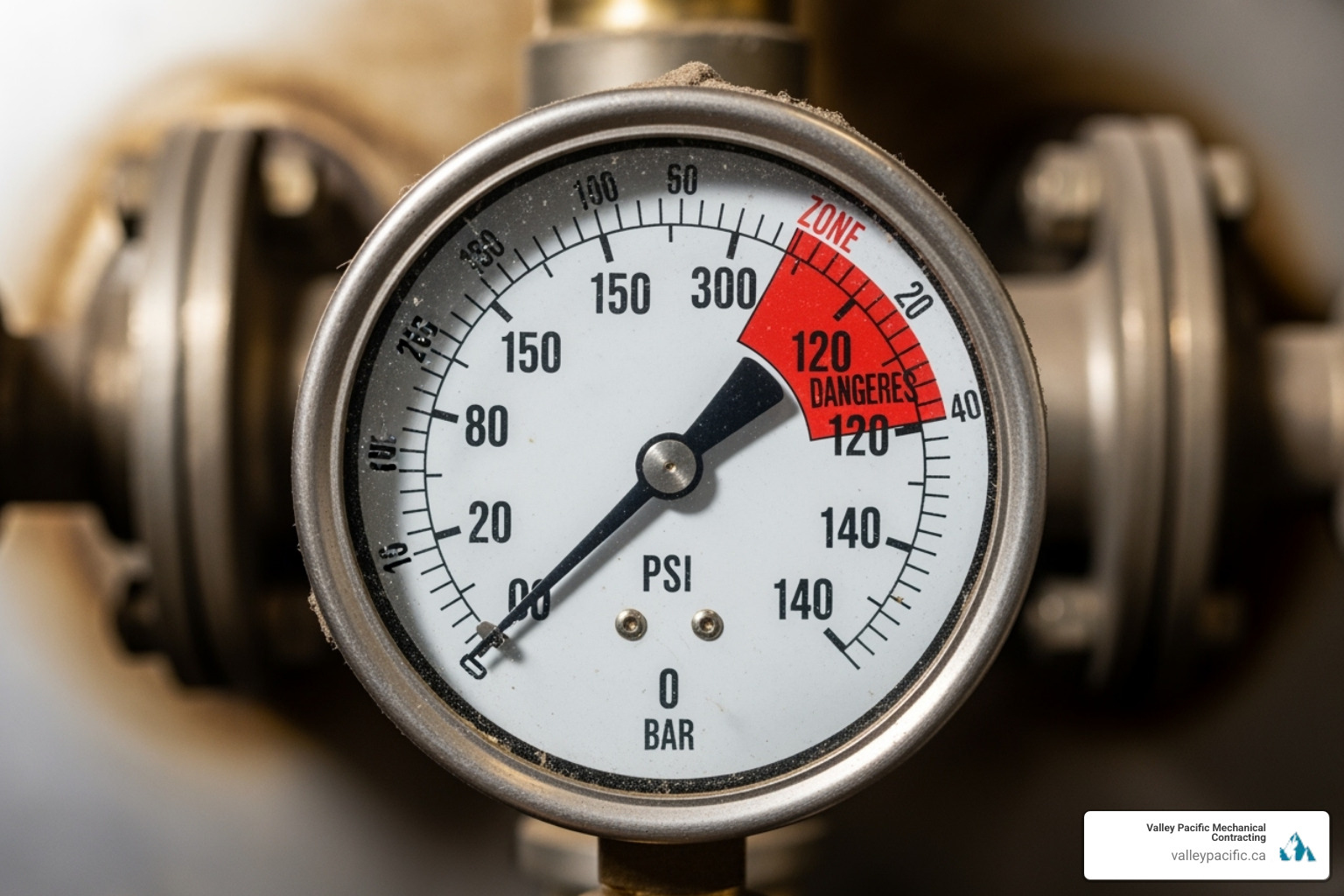
High Pressure and the Pressure Relief Valve (PRV)
Your boiler's pressure gauge is like a health monitor for your heating system. Take a look at that round dial on the front of your unit - it should show a reading between 1 and 1.5 bar, usually marked as the green zone. If that needle is pointing into the red zone, you've found your first major clue.
When pressure gets too high, your boiler's built-in safety hero steps in: the Pressure Relief Valve (PRV). This clever little device is designed to release excess water before things get dangerous. If you spot water dripping from a small pipe that leads outside from your boiler, or see moisture around the PRV itself, high pressure is likely your culprit.
What causes this pressure buildup? Sometimes it's as simple as someone accidentally overfilling the system. Other times, it could be a faulty expansion vessel that's not doing its job of absorbing pressure changes, or even a blockage somewhere in your heating system.
Here's the thing - a tiny drip from the pressure outlet pipe is sometimes normal. It's just your boiler doing its safety dance. But if you're seeing a steady stream or a growing puddle, that's when you know something needs attention. We've written about what to do when boiler pressure drops, and understanding high pressure issues is just as important for keeping your system healthy.
Corrosion and Component Failure
Let's face it - boilers aren't immortal. After about 20 years of faithful service, even the best units start showing their age. Internal corrosion is like rust's sneaky cousin, slowly eating away at seals, pipes, and other vital parts from the inside out.
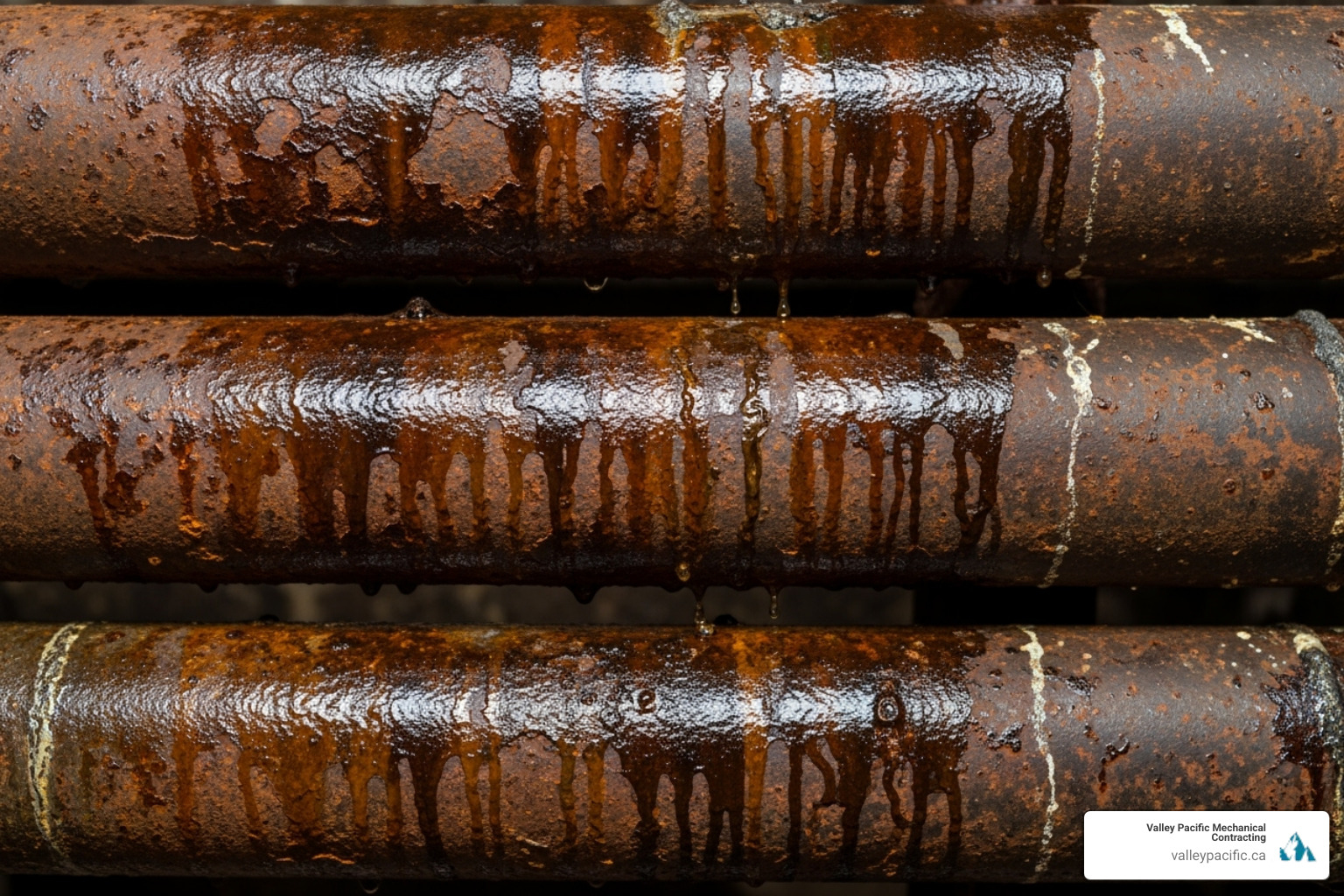
If you notice rust spots around your boiler or see discolored water when bleeding your radiators, corrosion might be behind your leak. The constant presence of water and the chemical reactions happening inside your heating system create the perfect storm for metal components to break down over time.
The heat exchanger is often the first casualty in this battle against time. This hardworking component heats all the cold water flowing through your system, but it's also vulnerable to cracks as it ages. When a heat exchanger starts failing, you'll typically see your boiler pressure dropping mysteriously, the unit cutting out more frequently, and yes - water appearing where it shouldn't be.
Pump seals are another common failure point. Your boiler's pump works tirelessly to circulate heated water throughout your home, but those rubber seals can harden and crack over time. When they fail, water finds its way out through the smallest gaps.
Major component failures like these can be expensive to repair. In fact, commercial systems facing significant damage can end up paying up to $5,000 for replacement equipment, which is why catching problems early matters so much.
Loose Joints and Worn-Out Seals
Sometimes the answer to your boiler leaking water mystery is refreshingly straightforward. Your heating system connects to your boiler through various pipe joints, and these connection points can work loose over time. Think about it - your pipes are constantly expanding when hot water flows through them and contracting as they cool down. This daily dance of expansion and contraction can gradually loosen even the most secure fittings.
If the original installation was badly sealed or if the installer took shortcuts, you might start seeing problems sooner rather than later. Vibration from the boiler's operation can also contribute to joints working loose over the years.
Degraded rubber seals are another common culprit. These small but mighty components create watertight barriers around joints and within internal parts. Unfortunately, rubber doesn't age gracefully - it becomes brittle, cracks, or simply loses its flexibility. When seals fail, even tiny gaps can let water escape.
Don't forget to check your filling loop - that's the connection that lets you add water to your system when pressure drops. If someone accidentally left it open after topping up the system, or if it's developed a fault, it can continuously feed water into your boiler. This creates a cycle where excess pressure builds up, the PRV releases water, and the filling loop keeps adding more.
How to Fix a Boiler Leaking Water: DIY vs. Professional Repair
Now that we've explored the common causes, the big question is: can you fix it yourself, or is it time to call in the cavalry? When a boiler leaking water shows up uninvited in your home, the temptation to grab your toolbox and dive in is understandable. After all, who doesn't love a good DIY victory?
But here's the thing - boilers are complex beasts that deserve respect. They're dealing with hot water, gas, electricity, and pressure all at once. It's like trying to juggle flaming torches while riding a unicycle. Some people can do it, but most of us are better off watching from a safe distance.
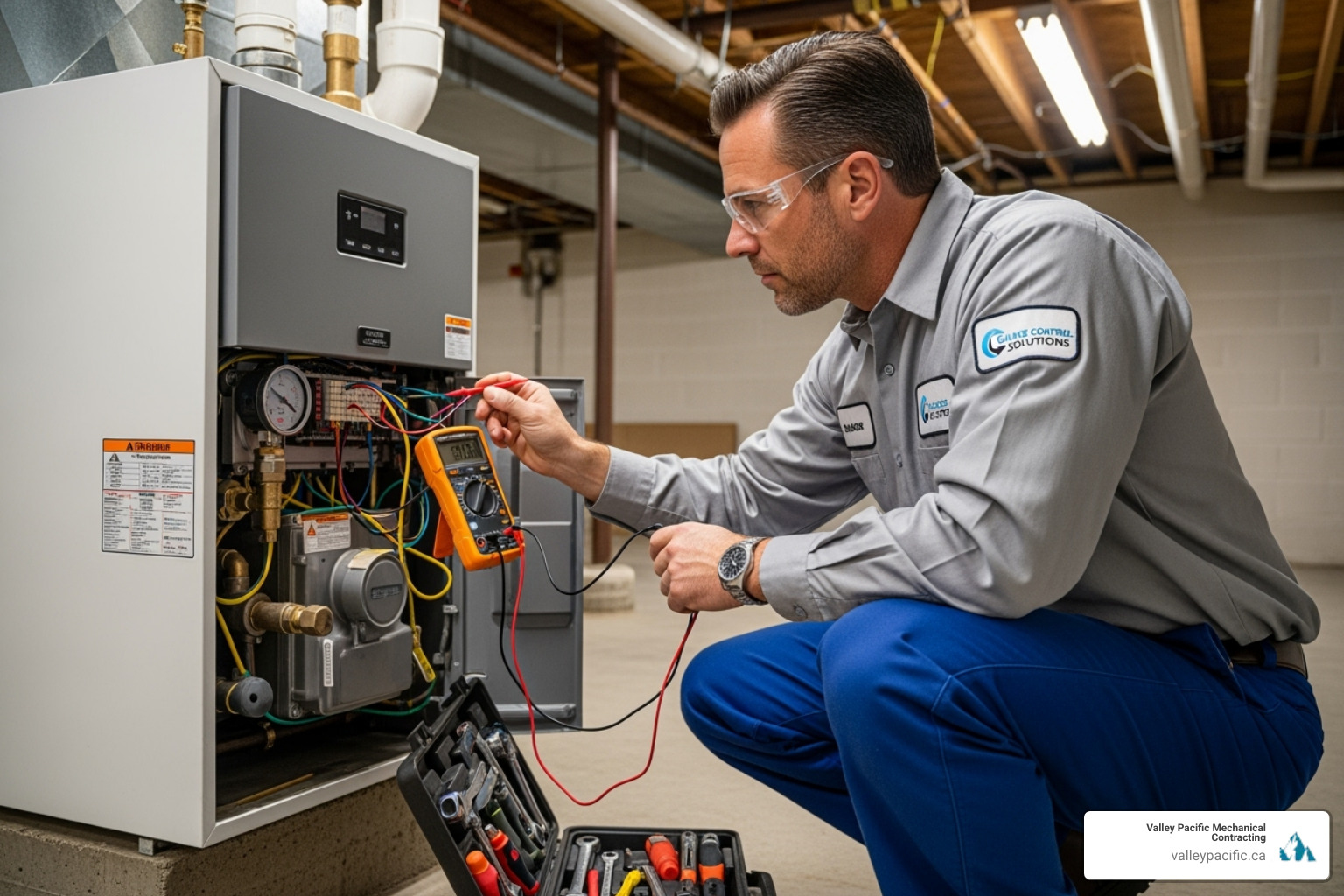
The golden rule? Unless you're a qualified and Gas Safe registered engineer, attempting internal boiler repairs isn't just risky - it's potentially dangerous and could void your warranty. Think of your boiler like a sleeping dragon. Sometimes you can tidy up around it, but you really don't want to poke it in the wrong place.
Simple DIY Fixes You Can Try
Before you throw in the towel completely, there are a few gentle approaches you can try. These are the equivalent of offering your boiler a cup of tea rather than performing surgery on it. Always make sure the power and water are off first - safety isn't negotiable.
Tightening a loose joint might be your simplest win. If you can see water dripping from a visible pipe connection, try giving it a gentle quarter-turn with a spanner. Think of it like tightening a loose lid on a jar - firm but not forceful. Dry the area thoroughly and watch to see if your leak decides to call it quits.
Bleeding radiators to lower pressure can work wonders when your pressure gauge is showing red-zone numbers. This releases trapped air and some water, potentially bringing your system back into that sweet spot of 1-1.5 bar. It's like letting a little steam out of a pressure cooker before it starts whistling.
Checking the filling loop is another simple detective move. Make sure it's firmly closed - if it's stuck open, it's like leaving a tap running into your system, causing continuous pressure buildup.
Using a bucket to catch drips isn't technically a fix, but it's an essential damage-control measure. Sometimes the best immediate solution is simply containing the problem while you figure out your next move.
The basic tools you'll need for these simple checks include a spanner, dry cloth, and bucket - nothing too fancy or intimidating.
When to Call a Professional for Boiler Repair
Here's where we need to have an honest conversation. Some boiler problems are like trying to perform brain surgery with a butter knife - technically possible, but really not advisable. Professional help becomes essential when you're dealing with internal leaks hiding inside the boiler casing, where amateur hands have no business wandering.
A faulty heat exchanger is definitely professional territory. This is complex, expensive work that requires expertise and proper tools. Similarly, damaged pump seals and other internal components need someone who knows exactly what they're doing and has the right replacement parts on hand.
Persistent high pressure that doesn't respond to radiator bleeding suggests deeper issues that need professional diagnosis. And here's the big one - any gas-related smells or issues mean you should evacuate and call emergency services immediately, then follow up with professional repair.
If the leak persists after your gentle DIY attempts, or if you're simply not confident about what you're seeing, that's your cue to step back. There's no shame in recognizing when a problem is bigger than your comfort zone.
We provide comprehensive boiler repair services throughout the Lower Mainland, including Boiler Repair Langley BC and Boiler Repair Maple Ridge BC. Our experienced technicians have seen every type of boiler leaking water scenario imaginable, and we're equipped to diagnose and fix issues safely while ensuring your system runs efficiently for years to come.
Prevention and Long-Term Solutions
Here's the truth about dealing with a boiler leaking water: the best fix is preventing it from happening in the first place. Think of it like taking your car for regular oil changes - a little maintenance goes a long way toward avoiding those dreaded roadside breakdowns.
Annual boiler servicing isn't just something your heating technician suggests to drum up business. It's genuinely your best defense against unexpected leaks and costly repairs. During a professional service, our qualified technicians inspect every component, check for those sneaky early signs of wear or corrosion, test system pressure, and make sure everything's humming along nicely. This proactive approach catches minor issues before they turn into major headaches - and major expense.
Beyond your yearly checkup, consider system flushing. Over time, your heating system accumulates sludge and debris (think of it as the heating equivalent of cholesterol in your arteries). This buildup contributes to corrosion and blockages, which can eventually lead to leaks. A powerflush or chemical flush gives your system a thorough internal cleaning, improving efficiency and reducing the risk of internal corrosion.
Installing a magnetic filter is another smart investment. These clever devices collect metallic debris before it can cause damage to your boiler - like having a bouncer at the door of your heating system.
The average boiler lifespan is roughly 20 years. With proper preventative maintenance, your boiler can reach its full potential and avoid premature failure. It's much more cost-effective to invest in regular care than to deal with emergency repairs on a cold winter night.
Is It Time to Replace Your Boiler?
Sometimes, when a boiler leaking water becomes a recurring nightmare, it's time for an honest conversation about replacement. If you're constantly dealing with leaks, or if the repair estimate makes your wallet weep, a new boiler might actually be the smarter financial choice.
Age matters. If your boiler is approaching or exceeding 15 years old, even a seemingly minor leak could signal widespread internal wear. It's like when your old car starts needing repairs every few months - at some point, you're just throwing good money after bad.
The frequency of repairs tells a story too. If you're on a first-name basis with your heating technician because they're at your house every few months, those costs add up quickly. Meanwhile, you're dealing with the stress and inconvenience of an unreliable heating system.
Here's where modern boilers really shine: energy efficiency. Newer units boast significantly higher AFUE ratings, meaning they convert more fuel into actual heat for your home. This translates to lower monthly energy bills - sometimes dramatically lower. While the upfront cost of a new boiler is higher, the long-term savings in energy consumption and avoided repair costs often make replacement the smarter financial choice.
Warranty protection is another compelling reason to consider replacement. New boilers come with comprehensive manufacturer warranties, plus installation warranties from reputable contractors. Compare that to repairing an aging system where you're essentially gambling on how long the fix will last.
We understand that replacing a boiler feels like a big decision. That's why we've developed our Professional Boiler Replacement Process to make it as straightforward and stress-free as possible. Whether you need Boiler Installation Mission BC or anywhere else in the Lower Mainland, we ensure a seamless transition to a more efficient and reliable heating system that will keep you comfortable for years to come.
Frequently Asked Questions about a Boiler Leaking Water
When you find a boiler leaking water, it's natural to have questions. We've helped countless homeowners in the Lower Mainland deal with these situations, and these are the questions we hear most often.
Can I still use my boiler if it's leaking?
Absolutely not - and we can't stress this enough. A boiler leaking water poses serious risks that go far beyond just a puddle on your floor. Water and electricity make a dangerous combination, and even a small leak can short-circuit electrical components in your boiler.
When electrical components get wet, you're looking at potential damage that could turn a simple repair into a complete system replacement. The water can also cause corrosion and rust to spread throughout your heating system, creating problems that extend far beyond the original leak.
Even if the leak seems minor, it can lead to mold growth and structural damage to your home over time. The safest approach is always to turn off the boiler immediately, shut off the water supply, and call a professional. Your safety and your home are worth more than a few hours without heat.
How much does it cost to fix a leaking boiler?
This is probably the question we get asked most, and honestly, it's like asking "how long is a piece of string?" The cost depends entirely on what's causing your boiler leaking water problem.
If you're lucky and it's just a loose joint that needs tightening, the repair might be relatively inexpensive. However, if we're dealing with a faulty heat exchanger or extensive internal corrosion, you're looking at a much more significant investment.
Simple fixes like replacing a worn seal or adjusting system pressure are on the lower end of the cost spectrum. Major component failures, such as a cracked heat exchanger or failed pump seals, require more extensive work and parts replacement.
The age of your boiler also plays a role. Older systems often need additional work to bring everything up to current standards, which can add to the overall cost. We always provide a thorough assessment and detailed quote before starting any work, so you'll know exactly what to expect.
Is a leaking boiler an emergency?
The answer depends on the severity and location of the leak, but our advice is always "better safe than sorry."
It's definitely an emergency if the leak is significant and water is pooling near electrical outlets or components. This creates an immediate risk of electrical shock or fire. Similarly, if you suspect any gas involvement - strange smells, hissing sounds, or discolored flames - evacuate immediately and call emergency services.
It's also urgent if you notice water spreading to areas where it could cause structural damage or if the leak is getting worse by the hour. Don't wait until morning if your basement is starting to flood.
For smaller, contained drips, while it's not a middle-of-the-night emergency, it still needs prompt attention. What starts as a few drops can quickly escalate into a major problem. The longer you wait, the more damage can occur, and the more expensive the eventual repair becomes.
We offer 24/7 emergency service throughout the Lower Mainland because we understand that heating problems don't always happen during business hours. When in doubt, give us a call - we'd rather help you assess the situation and give you peace of mind than have you worry all night about whether your home is safe.
Stop the Drip and Restore Your Peace of Mind
When you find a boiler leaking water, it's natural to feel that sinking feeling in your stomach. But here's the good news: you're now armed with the knowledge to handle it like a pro. We've walked through the most common culprits - from high pressure forcing water through the pressure relief valve to corroded components showing their age, loose joints that need a gentle tightening, and worn-out seals that have simply done their time.
The most important thing to remember? Safety first, always. Those immediate steps we covered - turning off the power, shutting off the water supply, and containing the leak - aren't just suggestions. They're your first line of defense against turning a manageable problem into a costly disaster.
While it's tempting to grab your toolbox and dive in, most boiler leaking water situations need the trained eye of a qualified professional. You might be able to tighten a loose joint or bleed a radiator to lower pressure, but internal leaks and component failures require specialized expertise. There's no shame in calling for backup - it's the smart move.
Think of annual servicing as insurance for your heating system. Regular maintenance, system flushing, and installing magnetic filters aren't just nice-to-haves - they're your best bet for preventing future leaks and extending your boiler's life. And when your trusty boiler starts showing its age with frequent breakdowns and rising repair bills, replacement might actually save you money in the long run.
At Valley Pacific Mechanical Contracting, we've been solving heating headaches for over 30 years across the Lower Mainland. Whether you're dealing with an emergency leak at 2 AM or planning a Boiler Installation Langley BC, our team is here to make the experience as smooth as possible. We serve Mission, Maple Ridge, Pitt Meadows, Coquitlam, and Langley with our signature headache-free approach and 24/7 emergency service.
Every drip tells a story. The sooner you listen to what your boiler is trying to tell you, the sooner you can get back to enjoying a warm, comfortable home without worrying about puddles on the floor.
Why Langley Homeowners Depend on Professional Boiler Repair Services
For boiler repair Langley needs, fast and reliable service is crucial to avoid a cold, stressful situation in your home. Here's what you need to know:
Common Signs You Need Boiler Repair:
- Strange noises (banging, whistling, or kettling sounds)
- No heat or hot water production
- Water leaks around the boiler unit
- Pilot light won't stay lit
- Low boiler pressure readings
- Frequent system cycling or shutdowns
Emergency Situations Requiring Immediate Help:
- Complete heating system failure during winter
- Suspected gas leaks (call immediately)
- Major water leaks causing property damage
- Carbon monoxide detector alarms
In British Columbia's chilly winters, a functioning boiler is essential for comfort and safety. A failing boiler can mean a sudden cold shower, a frustrating experience for any Langley homeowner.
With traditional gas boilers lasting 10-15 years and electric units up to 10 years, most homes will eventually need professional repair or replacement. The key is recognizing warning signs early and working with certified technicians who understand local safety requirements.
This guide will help you identify boiler problems, understand repair options, and choose the right professional. Knowing what to expect can save you time, money, and stress, whether it's a minor issue or a full system replacement.
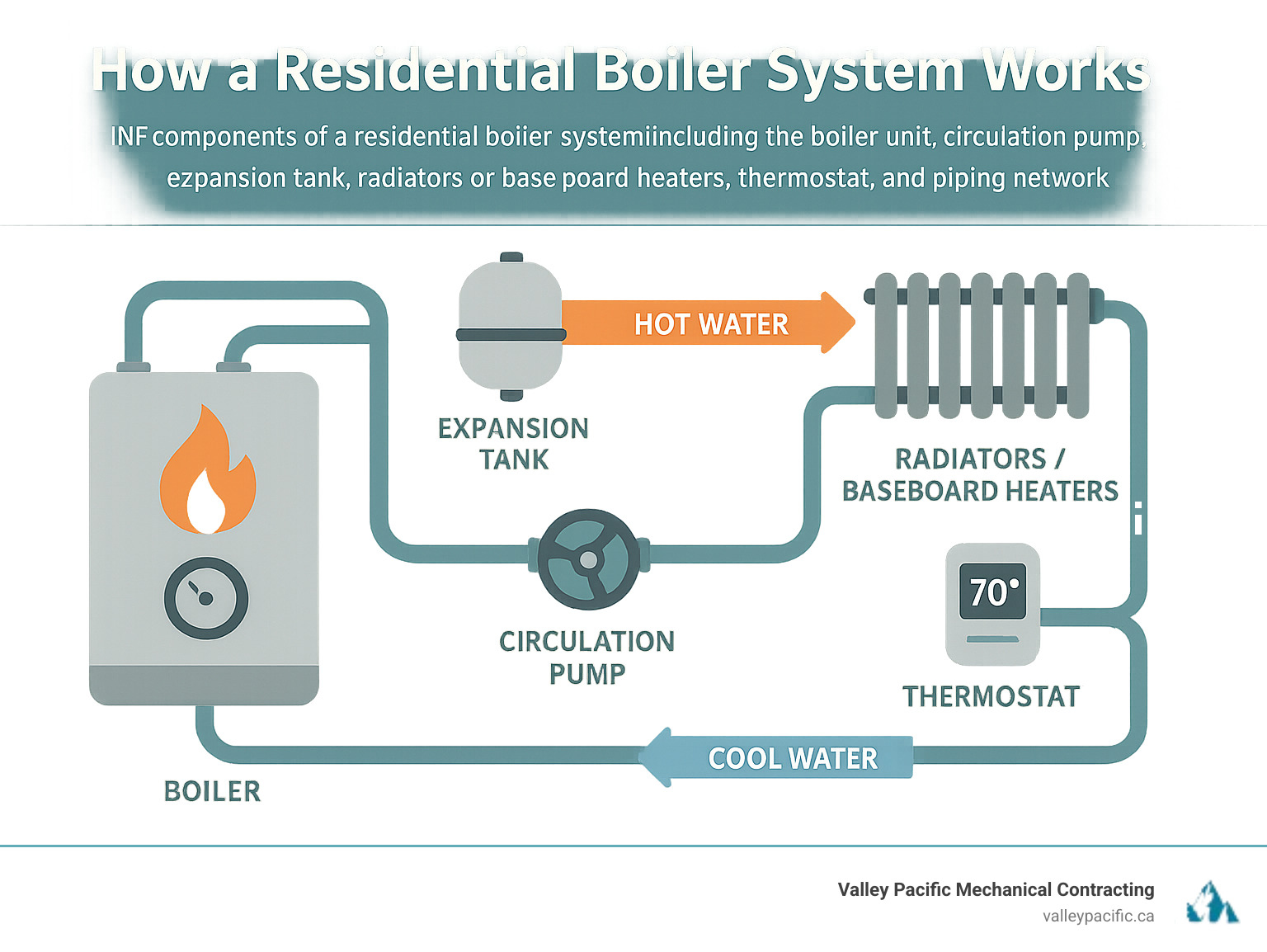
7 Telltale Signs Your Boiler Needs Immediate Attention
Your boiler is the heart of your home's heating system. Recognizing its warning signs early can prevent expensive emergencies. In Langley, we know how quickly a comfortable home can turn into an icebox when heating fails. Here are the signs that it's time to call for boiler repair Langley services.
Strange noises are often the first hint of trouble. A boiler should run quietly; if it's making a racket, pay attention.
Kettling sounds like a boiling kettle and is caused by limescale or sludge buildup on the heat exchanger. This restricts water flow, causing water to boil, steam, and pop. This inefficiency makes your system work harder and increases energy costs.
Banging noises usually point to trapped air or a faulty pump, while whistling typically means there's a blockage forcing water through a small opening.
Water leaks or pooling around your boiler should never be ignored. A leak can come from corroded pipes, loose connections, or a failing pressure relief valve. Address any leak quickly to prevent damage to your home's structure or electrical systems.
No heat or hot water is a homeowner's winter nightmare. The cause could be a faulty thermostat, broken pump, low pressure, or ignition problems. Nobody wants an arctic shower on a chilly Langley morning! For specific hot water issues, see our guide on troubleshooting no hot water from boiler.
Pilot light issues affect older boilers. A pilot light should be a steady blue flame. If it goes out, burns yellow or orange, or won't stay lit, it could indicate a faulty thermocouple or gas supply blockage. A yellow or orange flame is a major concern as it suggests incomplete combustion and a potential carbon monoxide risk.
Low boiler pressure prevents hot water from circulating properly, and the system may shut down as a safety measure. This is often caused by leaks or a faulty pressure relief valve. Our guide on what to do when boiler pressure drops explains the next steps.

Thermostat malfunctions can cause inconsistent temperatures. If the thermostat misreads temperatures or fails to communicate with the boiler, rooms may be too hot or cold. It could be simple as dead batteries, but wiring problems or unit failure require a professional.
Frequent cycling or shutdowns mean your boiler is struggling. Short cycling (constantly turning on and off) wastes energy and stresses components. Unexpected shutdowns could indicate pump failures, thermostat problems, or other breakdowns. A boiler that can't run reliably needs an immediate professional diagnosis.
Don't wait when your boiler shows these warning signs. Calling for professional help early saves money and prevents winter emergencies.
The Crucial Role of Annual Boiler Maintenance
Annual boiler maintenance is a smart investment for any Langley homeowner. Like a yearly check-up for your heating system, it prevents problems before they start. Your boiler works hard during British Columbia's winters and deserves professional attention.
Regular maintenance prevents costly breakdowns that often happen at the worst times. During an annual service, technicians spot and fix small issues like worn-out valves or sediment buildup before they become emergencies. Left unchecked, even minor sediment can disable a gas boiler.
A well-maintained boiler runs more efficiently, which means lower energy costs. Annual servicing keeps all components working at peak performance, so you're not wasting money on energy.
The most important reason for regular maintenance is safety. We perform thorough carbon monoxide checks and inspect for gas leaks, ensuring proper ventilation and that all safety mechanisms are working. The B.C. Safety Authority requires annual boiler servicing, highlighting its importance for safety.
Annual maintenance also extends your boiler's lifespan. Gas boilers typically last 10-15 years, and electric boilers around 10 years. Regular cleaning and adjustments reduce wear and tear, helping you get the most out of your investment. Our blog on How routine maintenance prevents breakdowns explains this further.
We recommend annual service for optimal performance and safety, involving a multi-point inspection custom to your boiler. Langley homeowners can also use FortisBC appliance maintenance programs for incentives.
Annual maintenance helps avoid boiler repair Langley emergencies, keeps your family safe, and saves you money. For more details, visit our Boiler Services page.
Comprehensive Boiler Repair Langley Services
When your boiler acts up, you need fast, effective solutions. Our comprehensive boiler repair Langley services are designed to restore your heating system quickly, providing a headache-free experience.
Diagnostic Services
Our approach starts with a thorough diagnostic assessment. Our licensed gas technicians use specialized tools to pinpoint the root cause of any issue, from leaks and pump failures to thermostat problems. As boilers are complex water systems, a professional diagnosis is essential.
Component Repair
Once identified, our experts can repair or replace a wide range of boiler components. Our vans are stocked with common parts, often allowing us to complete repairs in a single visit. Our expertise covers:
- Thermocouples: We check and replace faulty thermocouples, a common cause of pilot light issues.
- Circulation Pumps: We diagnose and repair pump issues that prevent proper hot water circulation.
- Zone Valves: We troubleshoot and replace faulty zone valves to restore balanced heating.
- Gas Controls: We inspect and repair gas controls to ensure safe and efficient operation.
- Expansion Tanks: We fix issues with faulty expansion tanks that cause pressure fluctuations.
- Control Boards and Relays: We handle repairs of intricate electronic components to resolve operational issues.
Leak Detection and Repair
Water leaks can lead to significant damage. Our technicians specialize in precise leak detection and repair, addressing everything from corroded pipes to faulty seals to keep your system watertight.
System Flushing
Over time, sludge and rust can build up, reducing efficiency. We offer system flushing to clear these blockages, restoring performance and extending your boiler's life.
Servicing All Boiler Types
We service and repair all makes and models of boilers, including brands like IBC Boiler, HydroTherm, Slantfin, and Laars. Our technicians are well-versed in both:
- Gas Boilers: Prevalent in Langley, we handle all aspects of gas boiler repair for safe, efficient operation.
- Electric Boilers: We are fully equipped to service and repair electric boiler systems.
We are committed to providing reliable service by certified technicians. For any boiler repair Langley needs, explore our page on Boiler Repair Langley BC.
Emergency Boiler Repair in Langley
Boiler emergencies require immediate assistance, day or night. We offer 24/7 emergency boiler repair services to Langley residents, understanding the urgency of a failed heating system during a cold winter.
- No Heat in Winter: We prioritize these calls to restore warmth to your home as quickly as possible.
- Major Water Leaks: Our emergency team can quickly stop leaks to prevent extensive property damage.
- Suspected Gas Leaks: This is a critical safety issue. If you smell gas, evacuate your home immediately and then call us for a certified gas technician.
Our commitment to a headache-free experience means we're ready to respond to your urgent calls day or night. Learn more about our broader HVAC Services Langley.
Repair vs. Replace: A Homeowner's Guide
When your boiler has issues, you face a tough decision: repair or replace? Understanding a few key factors can help you make the right choice for your home and budget.
Boiler Lifespan
The age of your boiler is a major factor. Gas boilers that are well-maintained typically last 10-15 years. Electric boilers generally have a shorter lifespan of up to 10 years. If your boiler is approaching or past these milestones, replacement is often the smarter long-term investment.
Cost-Effectiveness
This is where the math matters. A good rule of thumb is the 50% rule: if repair costs are approaching half the price of a new boiler, replacement usually makes more financial sense.
Consider your repair frequency. A single repair on a younger system is normal. However, if you require frequent boiler repair Langley services, your system is likely signaling that it's time for a replacement.
| Factor | Repair Considerations | Replacement Considerations |
|---|---|---|
| Boiler Age | Generally viable for boilers under 10-12 years old. | Strongly consider for boilers 15 years or older (past average lifespan). |
| Repair Frequency | One-off, minor repairs are usually cost-effective. | Frequent breakdowns (e.g., multiple times a year) indicate replacement is likely more sensible. |
| Repair Cost | Cost is typically less than 50% of a new boiler's price. | If repair cost approaches or exceeds 50% of replacement cost, replacing is often better. |
| Energy Efficiency | Older boilers are inherently less efficient. Repairs won't improve this significantly. | New, high-efficiency models offer significant savings on energy bills. |
High-Efficiency Models and Long-Term Savings
Modern boilers are far more advanced than older models. High-efficiency units with digital thermostats and programmable cycles improve comfort and can significantly reduce your utility bills. The energy savings from a new unit can be substantial, helping to offset the initial investment over time. You also gain the peace of mind of a reliable new system with a manufacturer's warranty.
Availability of parts is another key consideration. Parts for older models can be expensive or difficult to find. When replacement parts are costly or have long lead times, a new boiler becomes a more attractive option.
If your boiler is frequently needing repairs, is over 15 years old, or showing clear signs of decline, replacement often makes the most financial sense. Our team can assess your system and provide honest advice on whether to repair or replace.
For a look at the installation process, see our guide on the Professional Boiler Replacement Process. To explore new options, visit our Boiler Installation Langley BC page.
How to Choose a Trusted Boiler Technician in Langley
Choosing the right professional for your boiler repair Langley needs is crucial, especially during a heating emergency. With three decades of experience, we know what homeowners should look for in a trusted technician.
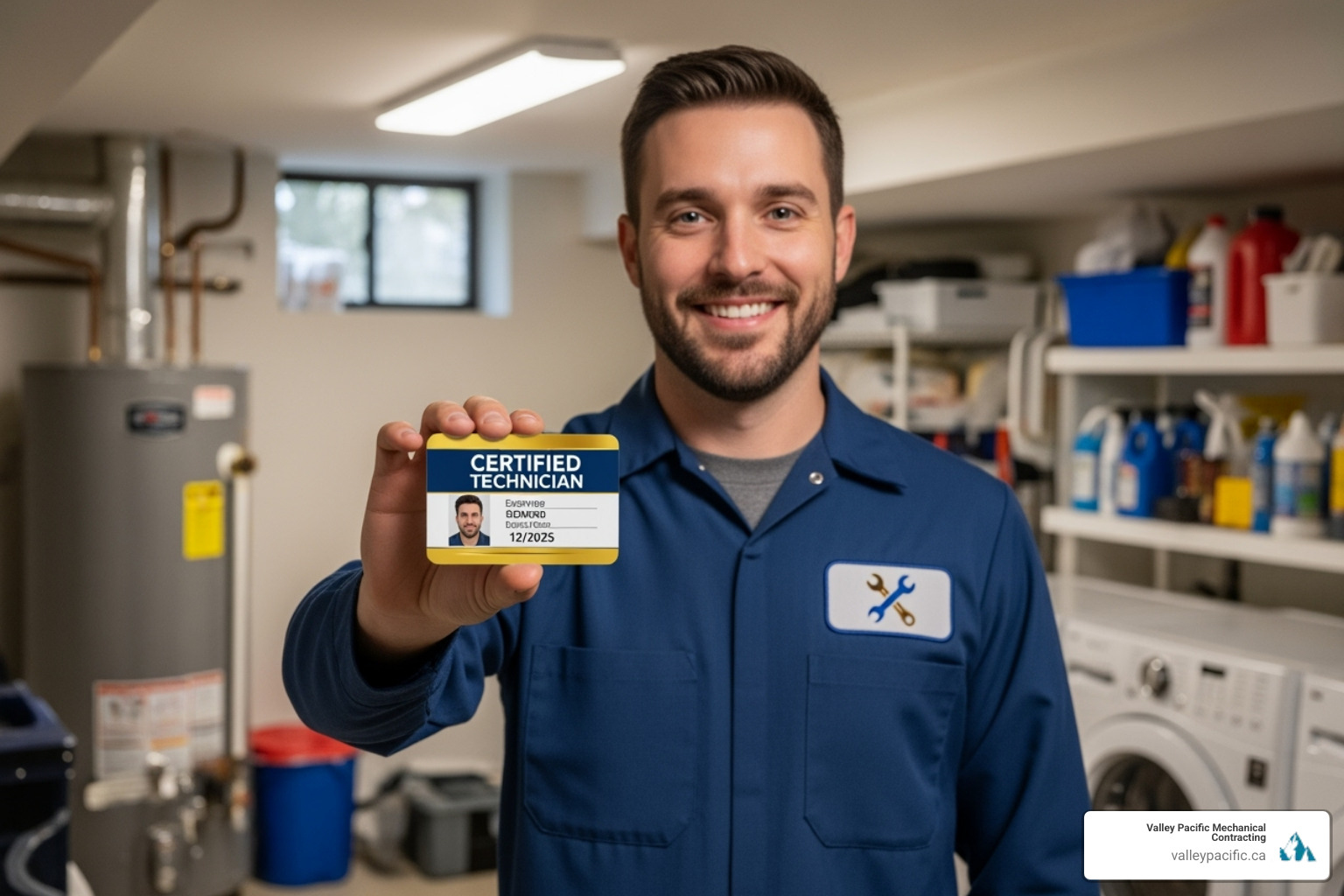
Proper licensing and certification is your first checkpoint. In British Columbia, technicians must be certified through Technical Safety BC. This certification represents rigorous training that keeps your family safe. A reputable technician will be happy to show their credentials.
Insurance and bonding protect you and the technician. We carry $5,000,000 liability insurance because we believe your home should never be at risk. A company that can't provide proof of insurance is a red flag.
Experience is invaluable, especially in an emergency. Our head plumber, Gary, brings over 30 years of hands-on expertise to every job, ensuring efficient and effective solutions for any boiler problem.
Customer reviews and reputation provide insight into a company's service quality. Check Google, Homestars, or the Better Business Bureau for feedback from other Langley homeowners on punctuality, communication, and workmanship.
Transparent pricing should be standard. You deserve a clear, detailed estimate before any work begins. We explain what needs to be done and why, so you can make an informed decision.
Guarantees and warranties show a company stands behind its work, demonstrating confidence and a commitment to your satisfaction.
Key Qualities for Boiler Repair Langley Technicians
Beyond the basics, look for these qualities:
- Red Seal certification: This represents a national standard of excellence and dedication to the trade.
- Experience with local building codes: A technician familiar with Langley's regulations ensures your repairs are safe and compliant.
- Strong diagnostic skills: The ability to quickly identify the root cause of a problem saves time and money.
- Professionalism and punctuality: This includes arriving on time, communicating clearly, respecting your home, and cleaning up after the job.
When you choose Valley Pacific Mechanical Contracting for your boiler repair Langley needs, you get all these qualities and more. We apply the same high standards to all our services, including Heat Pump Repair Langley BC, to ensure a headache-free experience.
Frequently Asked Questions about Boiler Repairs
It's natural to have questions when your boiler fails. We've answered the most common concerns from Langley homeowners to help you make informed decisions.
What factors influence the cost of a boiler repair in Langley?
Boiler repair Langley costs vary based on several factors:
- The type of repair: Simple tasks like bleeding radiators cost less than replacing major components like a heat exchanger.
- Part costs: Prices vary by boiler make and model. Parts for older systems can be more expensive and harder to find.
- Labour time: The final bill reflects the time needed for diagnosis and repair.
- System accessibility: Difficult-to-reach boilers can increase labour time.
- Emergency service fees: Calls outside of regular business hours may include additional fees for immediate response.
We provide a detailed quote before any work begins, so you get honest, upfront pricing with no surprises.
When is it more cost-effective to replace a boiler than repair it?
This is a common and important question. Here are the key indicators that replacement is more cost-effective:
- Age: If your boiler is over 15 years old, it's nearing the end of its typical lifespan (10-15 years for gas, up to 10 for electric).
- Repair Cost: If a repair costs 50% or more than a replacement, a new boiler is usually the better investment.
- Frequent Breakdowns: If you're calling for repairs multiple times a year, the cumulative cost and frustration often make replacement a smarter choice.
- Poor Energy Efficiency: Modern high-efficiency boilers can significantly lower your utility bills, with savings that help offset the initial investment.
Our team can help you weigh these factors to find the most cost-effective solution for your home.
Are there different types of boiler repair services offered?
Yes, boiler repair services are comprehensive to address the many potential issues. Our services include:
- Diagnostics: Pinpointing the root cause of the problem.
- Component replacement: Fixing or replacing parts like pumps, thermostats, and valves.
- Leak repairs: Detecting and sealing leaks to prevent water damage.
- Pressure adjustments: Restoring proper water circulation.
- Gas and electric system service: We are trained to safely service both types.
- 24/7 Emergency repairs: Rapid response for urgent issues.
We apply this comprehensive approach to all our work, including AC Repair Langley BC, to ensure quality care for any system.
Your Partner for Reliable Boiler Service in Langley
A boiler problem isn't just mechanical; it affects your home's comfort and your peace of mind. This guide has covered the key warning signs, from strange noises to a lack of hot water, helping you identify issues early.
The key takeaway is that prompt repairs and preventative maintenance are essential for keeping your family comfortable during Langley's winters. Acting quickly saves you money and stress, whether you're dealing with a minor pressure issue or deciding between repair and replacement.
Annual maintenance prevents costly breakdowns, lowers energy bills, and ensures your family's safety through vital checks for issues like carbon monoxide leaks.
At Valley Pacific Mechanical Contracting, we've provided boiler repair Langley services to Lower Mainland homeowners for over 30 years. Our experienced team knows that when your heating fails, you need a partner who delivers a truly headache-free experience.
From our 24/7 emergency response to our transparent pricing, we are committed to being there when you need us. Gary, our head plumber with over three decades of experience, leads a team of certified technicians who treat every home with the care it deserves.
Don't let a small boiler issue become a major headache. Whether you need routine maintenance, emergency repairs, or expert advice on replacement, we're here to help keep your home warm and comfortable.
Why Your Furnace Heat Exchanger is Critical to Home Safety
Furnace heat exchanger repair is one of the most serious HVAC issues you'll face as a homeowner. When your heat exchanger cracks, it creates an immediate safety hazard that can leak deadly carbon monoxide into your home.
Key Facts About Furnace Heat Exchanger Repair:
- Repair isn't possible - cracked heat exchangers must be completely replaced
- Cost range - replacement typically costs $1,500 to $6,000
- Time required - professional replacement takes 6-8 hours
- Safety risk - cracked exchangers can leak carbon monoxide, causing headaches, dizziness, or death
- Age factor - if your furnace is over 15 years old, full replacement may be more cost-effective
The heat exchanger is essentially the heart of your furnace. It's a metal component made of tubes and coils that transfers heat from the combustion process to the air that warms your home. More importantly, it acts as a critical safety barrier that keeps dangerous combustion gases like carbon monoxide separate from the air you breathe.
When this barrier fails, you're facing a potentially life-threatening situation. Research shows that about 10% of suspected cracked heat exchangers are confirmed as real cracks by professional technicians, but the consequences are so severe that every suspected crack must be taken seriously.
The decision between repairing just the heat exchanger or replacing your entire furnace depends on several factors including your furnace's age, overall condition, and the repair costs involved.
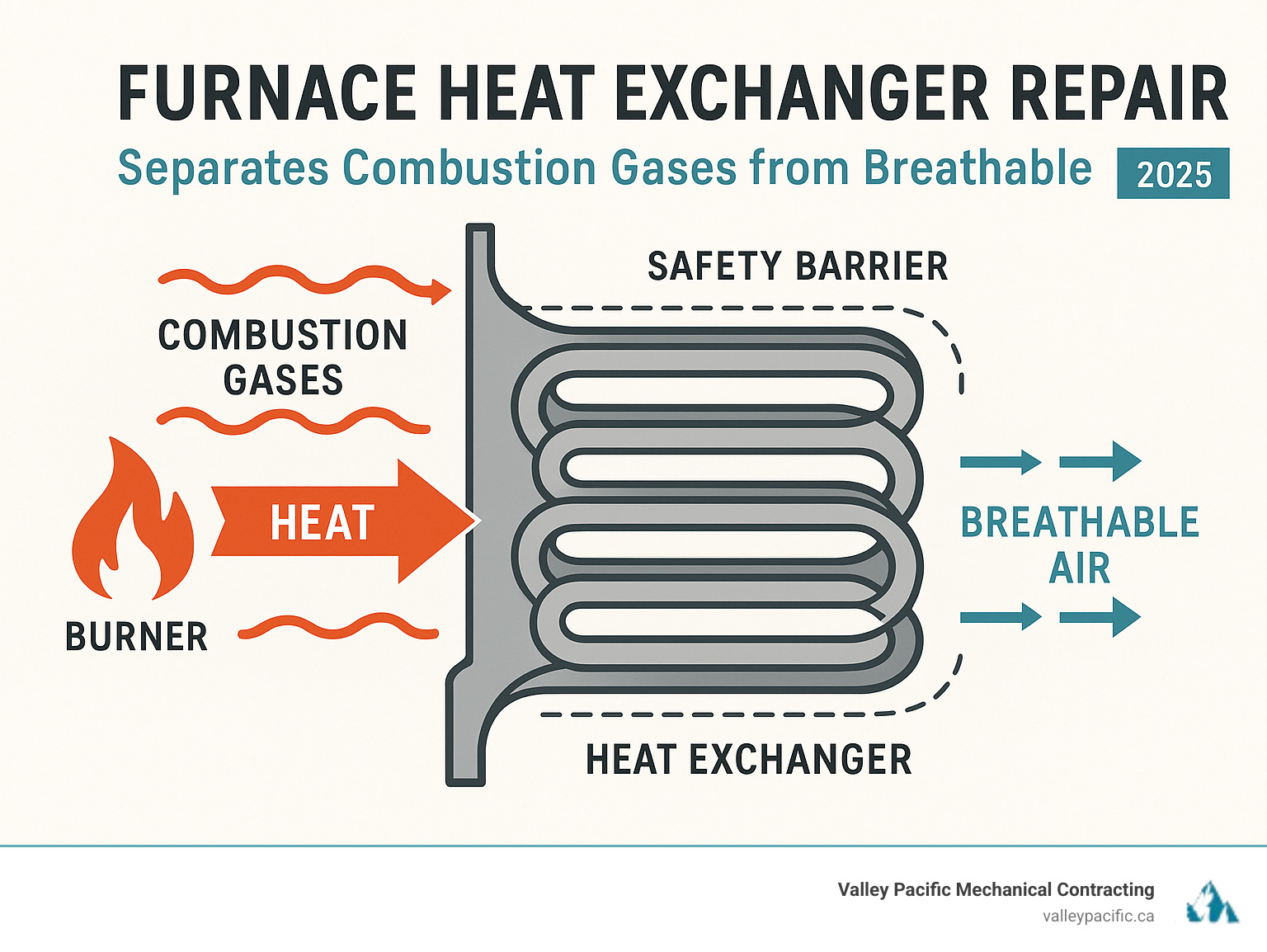
Understanding the Heart of Your Furnace: The Heat Exchanger
At the heart of your furnace is the heat exchanger, a component essential for both your comfort and safety. It's made of specially designed metal coils and tubes that handle the intense heat transfer process.
Here's how it works: Inside the combustion chamber, burning natural gas creates hot flue gases. These gases heat the exchanger's metal tubes. Simultaneously, your furnace blower pushes air from your home across the outside of these hot tubes. The air warms up and is then sent through your ducts.
The heat exchanger's most important job is acting as a critical safety barrier. It's designed to keep dangerous combustion gases completely separate from the air you breathe. The flue gases are safely vented outside, while only clean, heated air circulates through your home. This process of separating breathable air from byproducts protects your family throughout the heating season.
The Dangers of a Cracked Heat Exchanger
When a heat exchanger cracks, this protective barrier is compromised, creating a critical safety issue with potentially deadly consequences.
The biggest threat is a carbon monoxide (CO) leak. CO is an odorless, colorless, poisonous gas. When an exchanger cracks, CO can leak into your home's air supply. Carbon monoxide poisoning symptoms often mimic the flu, including headaches, dizziness, and nausea, but can quickly become fatal. The EPA's Carbon Monoxide Poisoning Guide provides detailed information on this invisible threat.
A cracked heat exchanger also creates a fire hazard. A damaged exchanger can disrupt combustion, causing "flame roll-out" where flames are pushed back toward the gas supply. This incomplete combustion also produces more carbon monoxide, worsening the danger.
A cracked heat exchanger is an immediate safety threat. Your furnace must not be operated until the problem is fixed by a qualified professional. There is no room for compromise when it comes to your family's safety.
Identifying the Problem: Warning Signs of a Cracked Heat Exchanger
A cracked heat exchanger is hidden inside your furnace, but there are several warning signs that indicate a problem. Recognizing these signs is crucial for your safety.
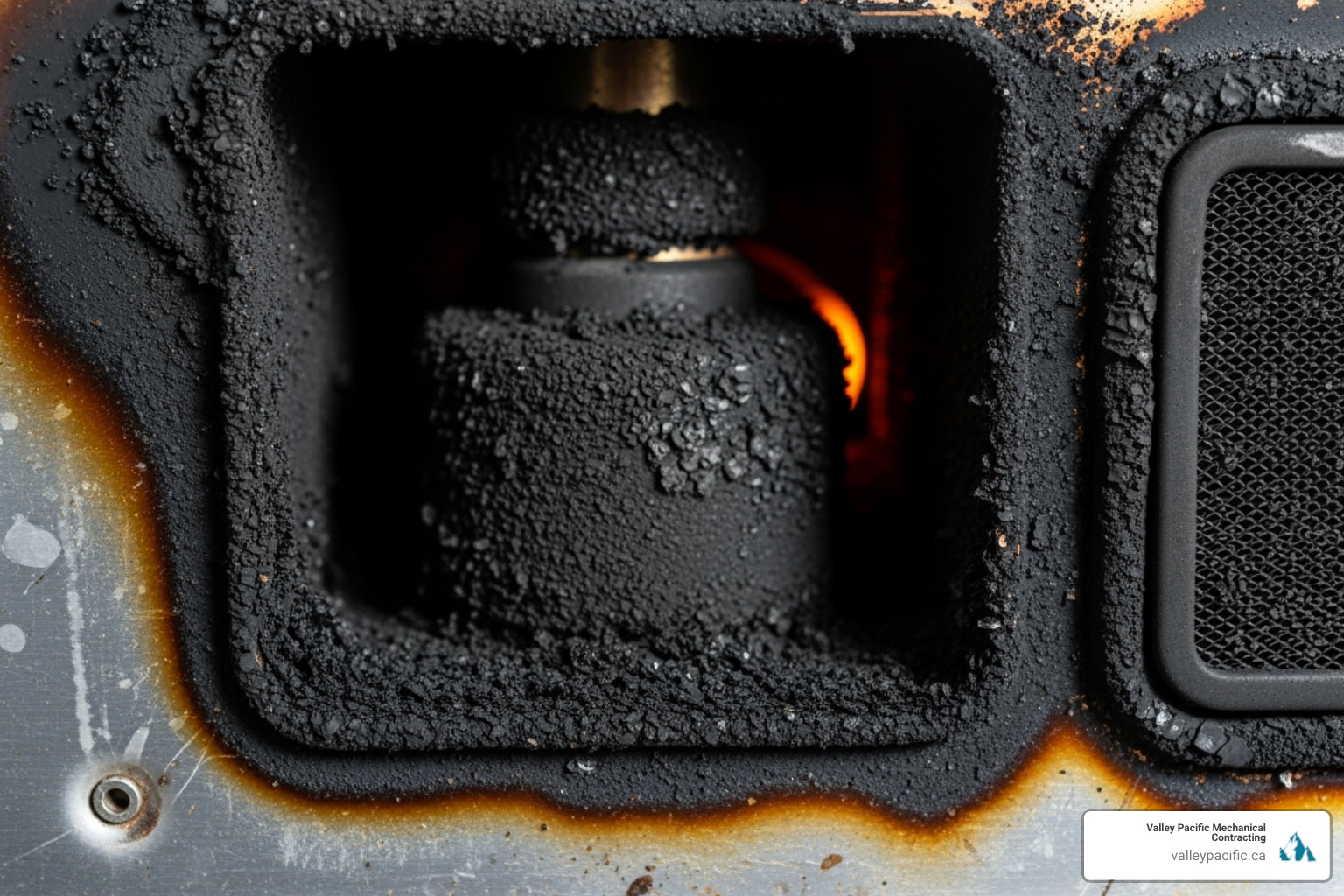
- Unusual smells: A chemical-like formaldehyde odor when the furnace starts can indicate flue gases are leaking into your air supply.
- Visible cracks or rust: While hard for homeowners to see, any visible rust or cracks on the heat exchanger are a clear red flag of weakened metal.
- Soot buildup: Black, sooty residue on or around your furnace indicates improper combustion.
- Water on the floor: Water around your furnace can sometimes signal exhaust problems from a compromised heat exchanger, though it can also have other causes.
- Abnormal flame color: Furnace flames should be steady and blue. Yellow or flickering flames suggest an improper air-to-fuel mixture, possibly due to heat exchanger damage.
- Carbon monoxide detector alarm: This is the most serious warning. If it goes off, dangerous CO levels are in your home and demand immediate action.
- Short cycling: If your furnace turns on and off rapidly, it could be overheating due to a cracked heat exchanger, triggering a safety shutdown.
- Physical symptoms: Headaches, dizziness, or nausea when the furnace is running could be signs of carbon monoxide exposure and require urgent attention.
What to Do if You Suspect a Crack
If you spot any of these signs, especially a CO alarm, act immediately.
- Turn off the furnace at its power switch and shut off the gas supply valve if you can.
- If your CO alarm sounds or anyone feels sick, evacuate now. Get everyone, including pets, out of the house.
- Once safely outside, call 911 to report a potential carbon monoxide leak.
After the immediate danger is clear, schedule a professional inspection. A cracked heat exchanger requires expert diagnosis, not a DIY fix. Our technicians use specialized equipment like a combustion analyzer test to measure CO levels and a camera inspection to visually find cracks or corrosion.
For reliable HVAC Repair Maple Ridge BC, we're here to provide an honest assessment and recommend the safest path forward. A furnace with a damaged heat exchanger can't be used until the problem is properly addressed.
The Furnace Heat Exchanger Repair vs. Replacement Decision
If a professional confirms a cracked heat exchanger, you must decide whether to replace just that part or the entire furnace. A cracked heat exchanger cannot be repaired; it must be replaced. This decision involves weighing immediate costs against long-term value, based on your furnace's age and condition.
| Factor | Heat Exchanger Replacement | Full Furnace Replacement |
|---|---|---|
| Cost | Typically ranges from $1,500-$6,000 for parts and labor | Higher upfront cost, but may include rebates and financing options |
| Furnace Age | Makes sense if furnace is under 10 years old | Better choice for furnaces over 15 years old |
| Warranty | Limited warranty on heat exchanger only | Full system warranty on all components |
| Long-Term Reliability | Other aging components may fail soon | All new components with modern reliability |
| Energy Efficiency | Maintains current efficiency levels | Significant improvement with high-efficiency models |
The age of your furnace is the most critical factor. For a furnace under 10 years old, replacing the heat exchanger might be cost-effective. For a furnace over 15 years old, full replacement is often the wiser investment. Replacing a heat exchanger in an old furnace is like putting a new engine in an old car; other aging components could fail next.
Understanding the Costs of Furnace Heat Exchanger Repair
Furnace heat exchanger repair costs are actually replacement costs, as cracks cannot be safely patched. The typical cost is $1,500 to $6,000, depending on the furnace model and labor. This is not a quick fix; it requires 6 to 8 hours of skilled labor to disassemble the furnace, install the new part, and reassemble everything safely. Most contractors provide parts and labor warranties on the replacement, but this won't cover the rest of your aging furnace components.
If you're dealing with a heat exchanger issue in the Pitt Meadows area, our team at Valley Pacific specializes in Furnace Repair Pitt Meadows BC and can provide you with an honest assessment.
When to Replace the Entire Furnace
Replacing the entire furnace is often the best choice for systems 15 to 20 years old, which is near the end of their lifespan. Investing in a major repair on an old unit can lead to a cycle of failures, where other parts like the blower motor or control board fail soon after. If you're already experiencing frequent breakdowns or poor performance like uneven heating, it's a sign your system is struggling. Modern furnaces also offer much better energy efficiency (AFUE), and the energy savings can help offset the replacement cost.
If you're ready to explore your options, our team provides comprehensive Furnace Installation Maple Ridge BC services with transparent pricing.
Understanding the Heart of Your Furnace: The Heat Exchanger
Your furnace's heat exchanger is a critical component for both heating your home and keeping it safe. Made of durable metal coils or tubes, its main job is to manage the heat transfer process within the combustion chamber.
When your furnace burns gas, it produces hot flue gases. The heat exchanger absorbs this heat. Your furnace's blower then pushes cool air from your home over the hot exchanger, warming the air before it circulates through your ducts.
Crucially, this design acts as a protective barrier, keeping harmful combustion gases separate from your breathable air. The flue gases are vented outside, ensuring only clean, warm air heats your home.
The Dangers of a Cracked Heat Exchanger
When a heat exchanger cracks, this vital safety barrier fails, creating two major dangers.
Carbon monoxide poisoning is the primary threat. CO is an invisible, odorless gas that can be fatal. A crack allows it to leak into your home's air supply. Symptoms often mimic the flu (headaches, dizziness, nausea) but can escalate quickly. For more information, consult the EPA's Carbon Monoxide Poisoning Guide.
The second danger is a fire hazard from incomplete combustion. A crack can disrupt the flame, causing "flame roll-out" and creating a fire risk. This also produces more carbon monoxide.
If your heat exchanger is cracked, your furnace is a major hazard and must not be used. Addressing furnace heat exchanger repair is a non-negotiable safety priority.
Identifying the Problem: Warning Signs of a Cracked Heat Exchanger
A cracked heat exchanger is hidden, but your furnace provides warning signs of a problem. Recognizing these symptoms is key to protecting your home and family. Look out for the following:
- Unusual Smells: A chemical odor, like formaldehyde, when the furnace starts can indicate leaking flue gases.
- Visible Cracks or Rust: While hard to see, any visible cracks or rust on the exchanger is a clear sign of a problem.
- Soot Buildup: Black soot on or around the furnace indicates incomplete combustion, a serious issue.
- Water on the Floor: While it can have other causes, water near the furnace can sometimes be related to exhaust issues from a bad heat exchanger.
- Abnormal Flame Color: Furnace flames should be blue and steady. Yellow or flickering flames suggest a combustion problem.
- Carbon Monoxide Detector Alarm: This is the most critical warning. If your CO detector goes off, dangerous levels of CO are present.
- Short Cycling: If your furnace turns on and off rapidly, it may be overheating due to a cracked heat exchanger, triggering a safety shutdown.
- Physical Symptoms in Occupants: Unexplained flu-like symptoms like headaches, dizziness, or nausea when the furnace is on are serious indicators of CO exposure. Evacuate immediately.
What to Do if You Suspect a Crack
If you observe any of these warning signs, especially a CO alarm, take immediate action.
Immediate Safety Precautions:
- Turn off the furnace: Use the power switch and, if possible, the gas supply valve.
- Evacuate if CO alarm sounds or symptoms appear: Get everyone (including pets) out of the house immediately.
- Call 911: From outside, report a potential CO leak so emergency services can verify safety.
Schedule Professional Inspection: Contact a qualified HVAC professional for a thorough inspection. This is not a DIY job.
- Professional Diagnosis: Our technicians use tools like a Combustion Analyzer Test to measure CO in the flue and a Camera Inspection to visually confirm cracks or corrosion.
- For any HVAC Repair Maple Ridge BC needs, we provide an honest assessment and recommend the safest course of action.
A furnace with a breached heat exchanger is unsafe and cannot be used until repaired. Safety is paramount.
The Furnace Heat Exchanger Repair vs. Replacement Decision
If a professional confirms a cracked heat exchanger, you face a big decision: replace the heat exchanger or the entire furnace. This choice involves weighing immediate costs against long-term reliability and peace of mind, considering the overall health of your heating system.
| Factor | Heat Exchanger Repair | Full Furnace Replacement |
|---|---|---|
| Cost | Lower upfront investment - typically ranges from $1,500 to $6,000 | Higher initial cost but includes complete system upgrade |
| Furnace Age | Makes sense for units under 10-12 years old | Recommended for furnaces 15+ years old |
| Warranty | Parts warranty on new heat exchanger plus labor warranty | Full system warranty on new equipment |
| Long-Term Reliability | Other components may fail soon after repair | Brand new system with years of reliable service ahead |
| Energy Efficiency | Maintains current efficiency levels (may be outdated) | Modern high-efficiency units can significantly reduce energy bills |
The furnace heat exchanger repair decision often hinges on your furnace's age. If your unit is under 12 years old and well-maintained, replacing just the heat exchanger can make sense. However, for a furnace over 15 years old, it's often more cost-effective to upgrade. When one major component fails on an older unit, others often follow.
Understanding the Costs of Furnace Heat Exchanger Repair
Furnace heat exchanger repair costs typically range from $1,500 to $6,000, depending on the model and labor. The job is complex, requiring 6 to 8 hours of skilled labor to disassemble the furnace, install the new part, and test for safety. You'll typically get a parts and labor warranty on the new heat exchanger, but not on the other aging components of your furnace.
For residents dealing with heating issues, our Furnace Repair Pitt Meadows BC service can help you steer these decisions with honest, professional advice.
When to Replace the Entire Furnace
If your furnace is 15 to 20 years old, it has reached its expected lifespan. At this age, when a major part like the heat exchanger fails, other components are likely not far behind. Instead of paying for a series of repairs, a full replacement may be more economical. Consider an upgrade if you're already dealing with frequent breakdowns, hot and cold spots, or rising energy bills. Modern furnaces are far more efficient (higher AFUE ratings), and the long-term energy savings can help offset the cost of a new system.
If you're leaning toward replacement, our Furnace Installation Maple Ridge BC team can help you explore your options and find a solution that fits both your budget and your home's heating needs.
The Modern Solution to a Messy Problem
Trenchless pipe repair is a method that fixes underground pipes without the need for extensive digging or excavation. Instead of tearing up your entire yard, this technology uses existing access points like cleanouts and manholes to repair or replace damaged sewer lines from the inside.
What is trenchless pipe repair?
- A no-dig solution for fixing underground pipes
- Uses specialized equipment to repair pipes from within
- Requires only small access points instead of full excavation
- Can repair or completely replace damaged sewer lines
Key benefits:
- Faster completion - Most jobs done in a day vs. weeks
- Less property damage - No destroyed landscaping or driveways
- Cost-effective - Eliminates expensive restoration costs
- Long-lasting - New repairs last 50-100 years
The thought of a broken sewer line often brings to mind images of heavy machinery tearing up a carefully maintained landscape. Traditional repairs meant digging massive trenches, destroying property, and creating weeks of chaos.
Common signs you need pipe repair:
- Frequent toilet and drain clogs
- Multiple slow drains throughout the house
- Gurgling sounds from plumbing fixtures
- Foul sewage odors indoors or outside
- Unexplained soggy or lush patches in your yard
The good news? Modern trenchless technology has transformed pipe repair from a property owner's nightmare into a streamlined, minimally invasive process. Where traditional methods once required extensive excavation and costly restoration, trenchless solutions now complete most repairs through just two small access holes.
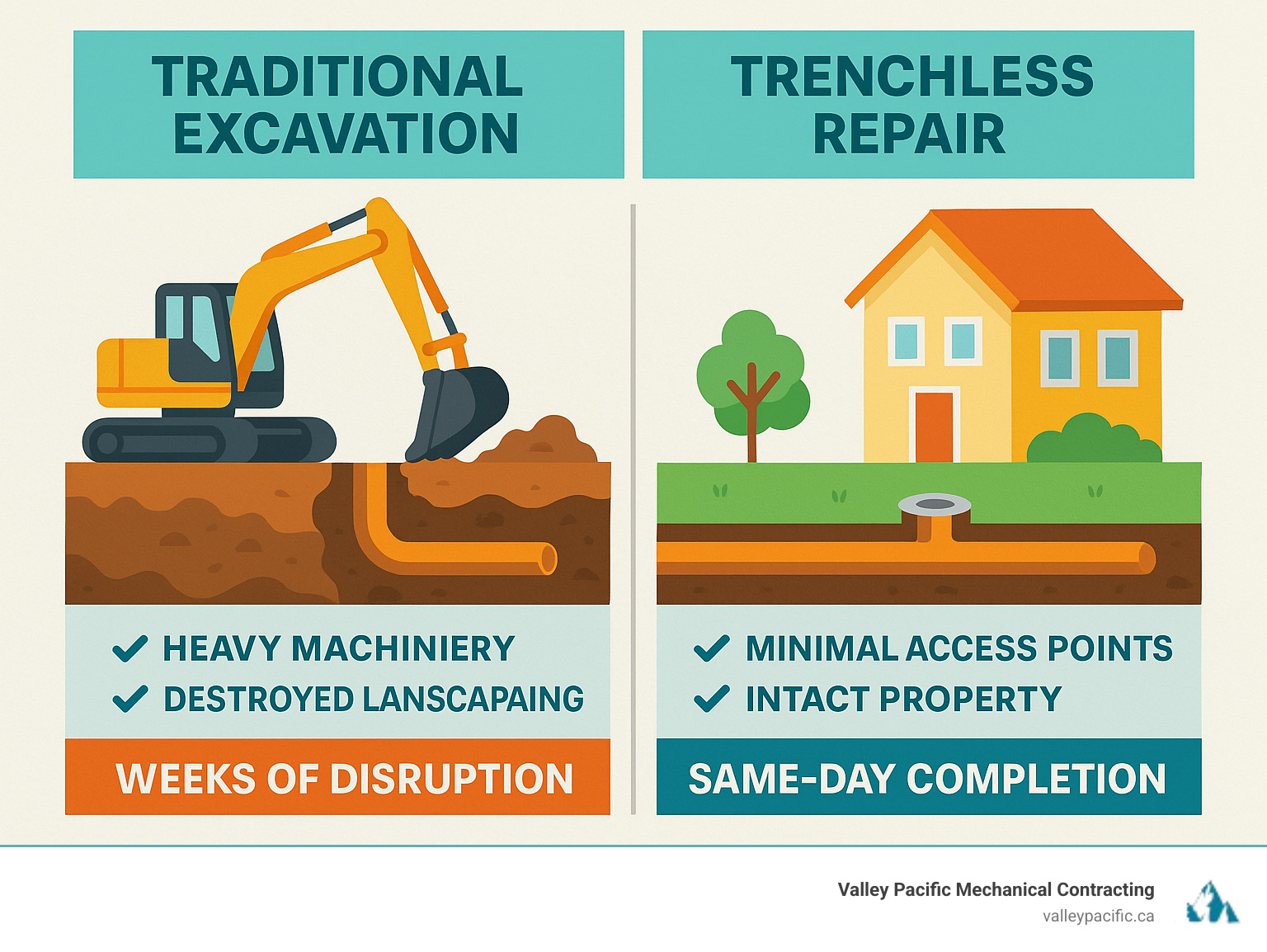
What is Trenchless Pipe Repair and How Does It Work?
When you have a sewer line issue, the thought of bulldozers tearing through your yard can be daunting. The good news is that trenchless pipe repair has changed the game. It's a method of fixing underground pipes without the mess of traditional digging. Instead of excavating your entire yard, we create one or two small access points to work from.
Using these small entry points, we can repair or replace damaged pipes from the inside out. We guide specialized equipment through your pipe system using existing access points like cleanouts. It's a precise, effective, and minimally invasive approach that works on various pipe materials, including old cast iron, clay, and PVC. If you're dealing with older piping materials, you can find more info about replacing old pipes.
Signs You Need Sewer Line Repair
Your home will signal when something is wrong with the sewer line. Recognizing these signs early can prevent a small issue from becoming a catastrophe.
- Frequent clogs or backups are a primary red flag, especially when multiple drains are affected at once.
- Multiple slow drains throughout your home suggest a problem deeper in your system than a simple clog.
- Gurgling sounds from toilets are often caused by trapped air in damaged pipes, indicating a blockage.
- Unpleasant sewage odours inside or outside your home are a clear warning sign of a leak.
- Unexplained lush or soggy spots on your lawn often indicate wastewater leaking from damaged pipes below.
The Importance of a Professional Camera Inspection
Before any repair, a professional camera inspection is essential. Think of it as an MRI for your pipes.
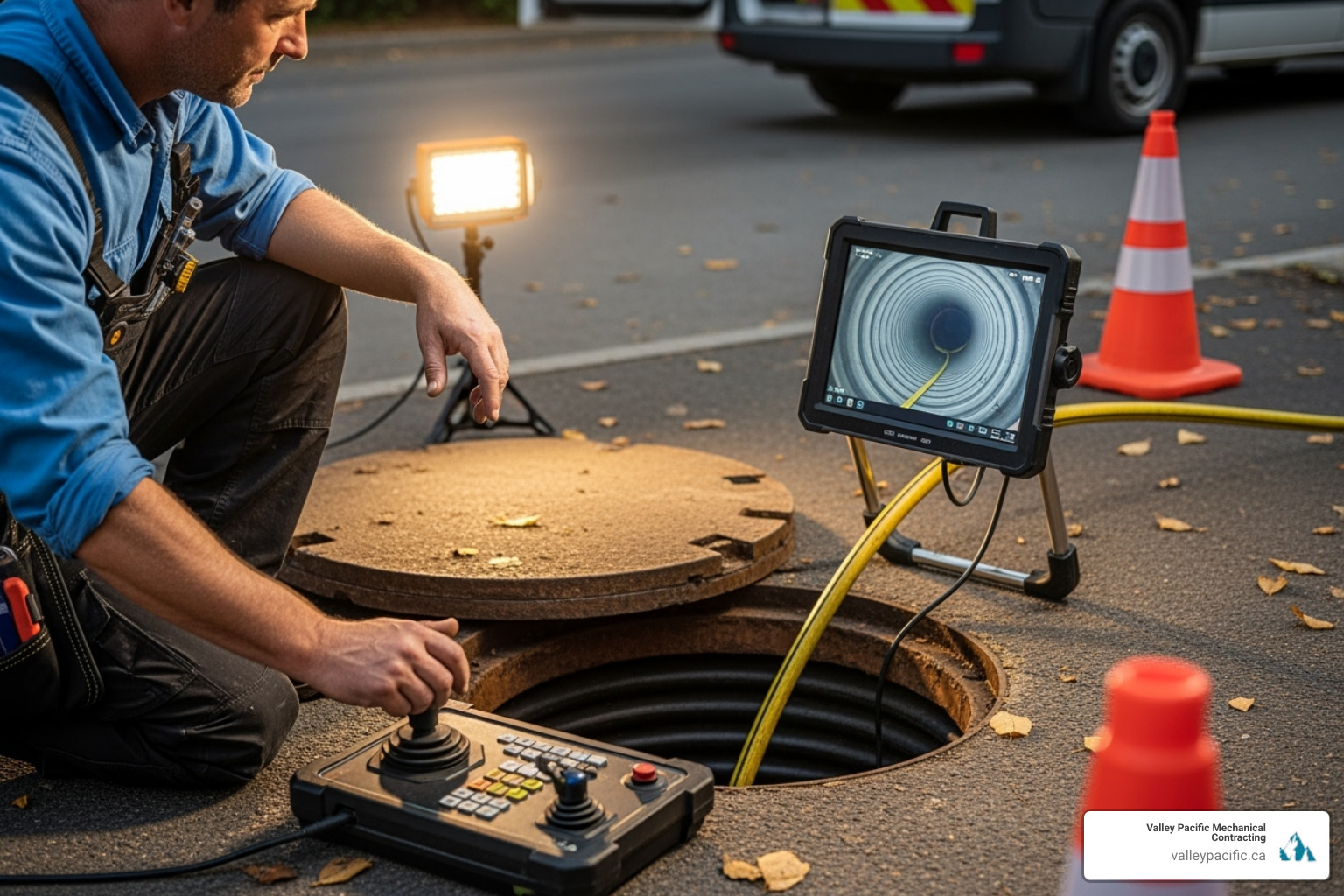
We snake a high-resolution camera through your sewer line to get a real-time view of the interior. This is crucial for several reasons:
- Pinpointing the exact problem: We can see the precise location and type of damage, ensuring the correct repair strategy is used.
- Assessing pipe condition: It gives us a complete picture of your system's health, helping us recommend the most cost-effective solution.
- Determining suitability for trenchless methods: Not all issues can be solved with trenchless repair. A camera inspection confirms if it's a viable option, preventing false expectations.
- Preventing unnecessary work: By seeing exactly what needs attention, we avoid extensive repairs when targeted fixes would suffice.
- Creating a precise repair plan: The inspection allows us to select the right method, materials, and timeline for your project, leading to better results with fewer surprises.
The Two Core Methods of Trenchless Repair Explained
Once our camera inspection reveals the problem, we choose the best trenchless pipe repair approach. The two main techniques are Pipe Lining and Pipe Bursting. One creates a new pipe inside the old one, while the other replaces it entirely, both with minimal disruption.
The Pipe Lining Process (CIPP)
Pipe lining creates a brand-new pipe directly inside your old one. This method, also known as Cured-In-Place Pipe or CIPP, is perfect for pipes with cracks, corrosion, or root intrusion that are still structurally sound.
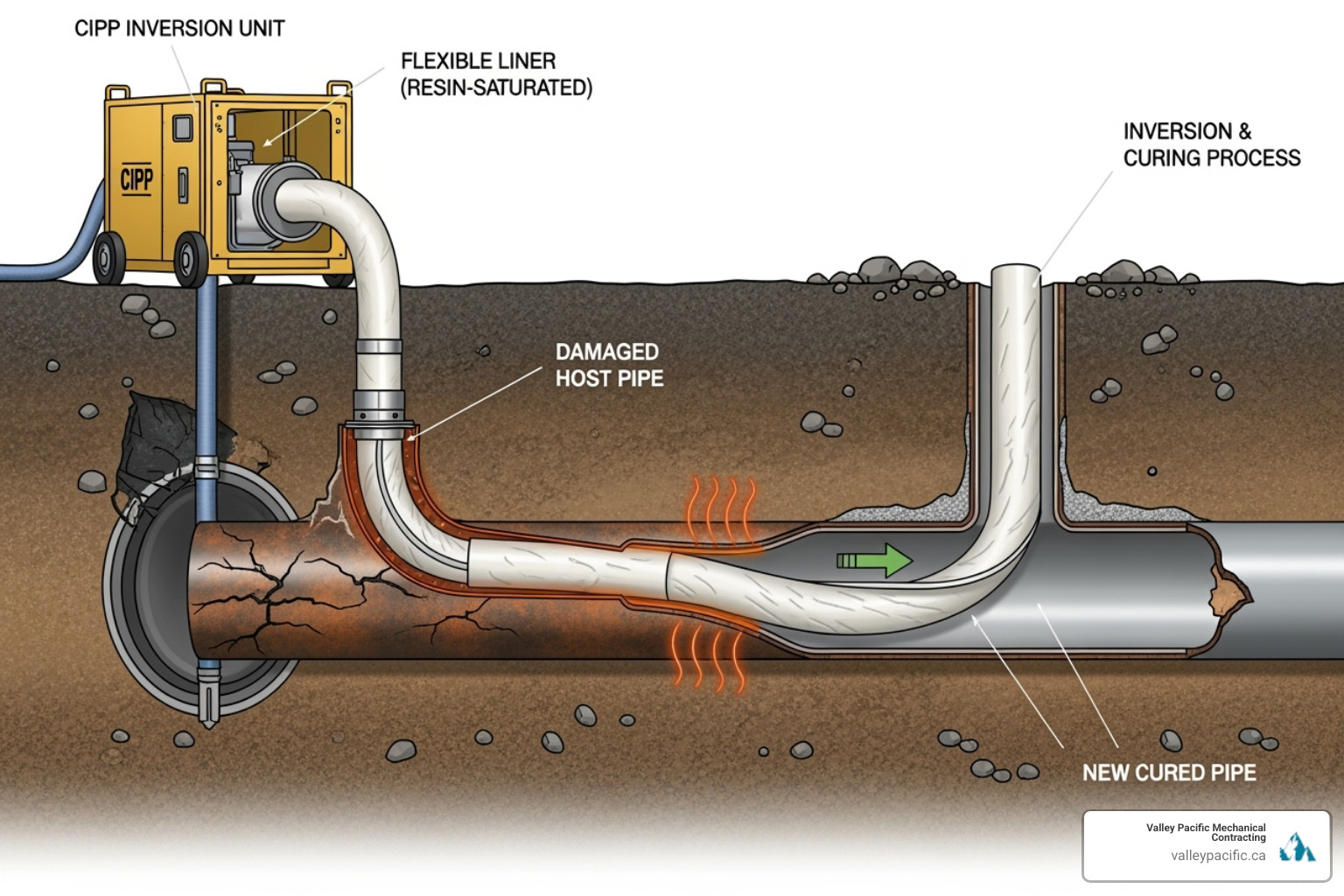
The process begins with cleaning the existing pipe using high-pressure water jetting. Then, we prepare a flexible felt liner saturated with epoxy resin. Using air or water pressure, we insert the liner into the old pipe. The liner is flexible enough to steer bends and joints.
Once positioned, the liner is inflated, and the epoxy resin is cured using hot water, steam, or UV light. This creates a seamless, joint-free pipe that is incredibly durable. The new pipe only slightly reduces the pipe's diameter but adds 50 years or more to its lifespan, with many installations lasting up to 100 years. It's a century of peace of mind from a single day's work.
The Pipe Bursting Process
When a pipe is too damaged for lining—for instance, if it has collapsed—pipe bursting is the heavy-duty solution. This method completely replaces the old pipe without extensive digging.
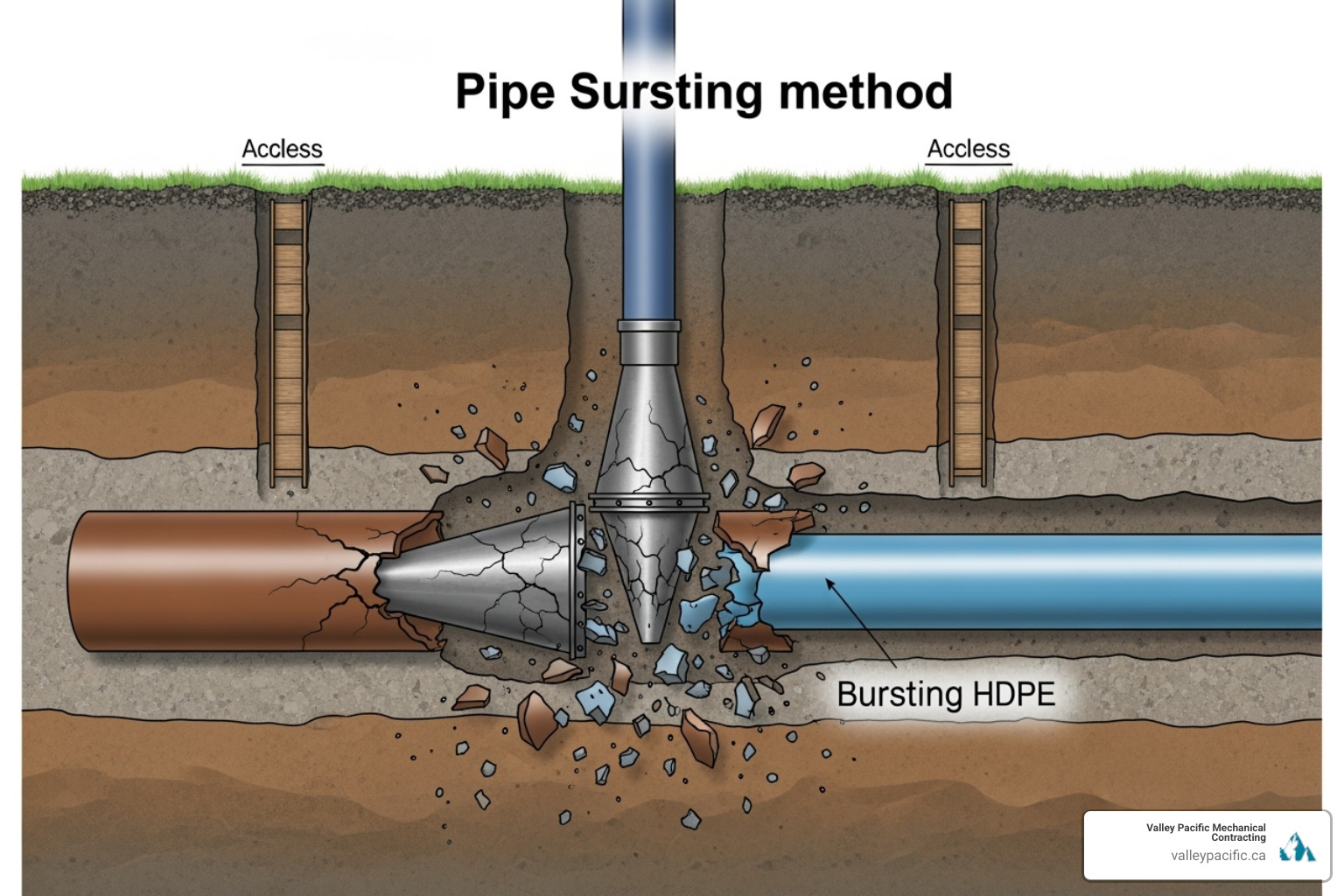
The process involves pulling a cone-shaped "bursting head" through the damaged pipe. This head fractures the old pipe, pushing the fragments into the surrounding soil. Immediately behind it, a new, durable high-density polyethylene (HDPE) pipe is pulled into place.
This method allows us to follow the path of the old pipe and even upsize the pipe diameter to improve flow capacity. The new HDPE pipe is corrosion-resistant and built to last 50 to 100 years. After connecting the new pipe and backfilling the small access holes, you have a brand-new sewer line ready for decades of service.
Trenchless vs. Traditional: A Head-to-Head Comparison
Choosing a repair method can mean the difference between a quick fix and a months-long ordeal. Trenchless pipe repair and traditional excavation are worlds apart in their impact on your property and life.
| Feature | Trenchless Pipe Repair | Traditional Excavation |
|---|---|---|
| Property Impact | Minimal; only 1-2 small access holes; preserves landscaping, driveways, patios. | Extensive; requires digging long, wide trenches; destroys landscaping, driveways, foundations. |
| Time to Complete | Hours to 1-2 days; smaller projects 3-4 hours. | Days to a week or more. |
| Cost | Potentially lower overall cost (less restoration); typically ranges from $60 to $250 per linear foot depending on factors. | Higher overall cost (significant restoration expenses); more labor-intensive. |
| Disruption | Very low; less noise, less mess, quick return to normalcy. | High; heavy machinery, significant noise, property unusable for extended periods. |
| Durability | 50-100 years lifespan; seamless, corrosion-resistant materials. | Varies by material; new joints can be weak points; susceptible to root intrusion at connections. |
| Effectiveness | Highly effective for cracks, leaks, root intrusion, full replacement. | Effective for all types of damage, but at a higher cost of disruption. |
Time and Disruption
This is where trenchless pipe repair truly excels. Most trenchless repairs are completed in hours to a single day, a stark contrast to the days or weeks required for traditional excavation. Instead of turning your property into a construction zone with long, wide trenches that destroy landscaping and driveways, trenchless methods use just one or two small access holes. Your lawn, garden, and driveway remain intact, eliminating major restoration work and costs.
Cost-Effectiveness
While the upfront cost per foot for trenchless repair might seem comparable to traditional methods, the total cost is often lower. Traditional excavation comes with significant hidden expenses for restoring your property. You'll need to pay for new landscaping, repaving driveways, and potentially repairing foundations or interior walls. Trenchless pipe repair eliminates these collateral costs. With less labor and less heavy machinery, the process is more efficient and keeps your final bill predictable.
Durability and Performance
An investment in pipe repair should be a long-term one. Trenchless pipe repair often surpasses traditional methods in durability, with a lifespan of 50 to 100 years. The new pipes are seamless and joint-free, eliminating the weak points where roots and leaks often occur in traditional pipes. The corrosion-resistant materials like HDPE and cured-in-place liners don't rust or deteriorate, ensuring reliable performance for decades. The smooth interior surface can even improve water flow compared to older, corroded pipes.
Is Trenchless Technology Right for Your Property?
Trenchless pipe repair is a solution, but it's not suitable for every situation. A thorough evaluation is necessary to determine if this innovative approach is the right fit for your specific pipe problems. The good news is that most residential and commercial sewer line issues are excellent candidates.
When is trenchless pipe repair the ideal choice?
- Pipes under structures: If your damaged sewer line runs beneath concrete driveways, basements, or building foundations, trenchless methods save you from expensive and destructive excavation.
- Preserving landscaping: For homeowners with mature landscaping, gardens, or trees, trenchless repair is a lifesaver. Minimal access points mean your outdoor spaces remain largely untouched.
- Root intrusion: Pipe lining creates a seamless, impenetrable barrier that permanently seals off entry points for tree roots without disturbing the trees themselves.
- Cracked or leaking pipes: For pipes with cracks, corrosion, or leaks that are still structurally intact, pipe lining creates a new, durable pipe within the old one.
- Speed and convenience: When you need repairs done quickly with minimal disruption, trenchless projects can be completed in hours or a day, not weeks.
Limitations: When is trenchless pipe repair not an option?
While versatile, trenchless technology has its limits. In some cases, traditional excavation is the only viable option.
- Severely collapsed pipes: If a pipe is completely crushed over a long section, there isn't enough structure left for trenchless methods to work. Traditional replacement is necessary.
- Back-pitched pipes: Sewer lines rely on gravity. If a pipe sags or slopes backward (a "belly"), trenchless repair cannot correct this fundamental grading problem. The pipe must be excavated and re-sloped.
- Incompatible materials or conditions: While rare, some unique or highly deteriorated pipe materials may not be suitable. Extremely large or small pipe diameters can also present challenges.
- Missing pipe sections: While lining can bridge minor gaps, large missing sections of pipe typically require traditional replacement to ensure a stable, continuous line.
The need for professional assessment is critical. Our technicians use advanced camera inspections to determine if trenchless repair is possible and which method will be most effective for your unique situation. Even when traditional methods are necessary, Valley Pacific Mechanical is committed to minimizing disruption. Explore our full range of services for more information.
Frequently Asked Questions about Trenchless Technology
Facing a sewer line problem brings up many questions. Trenchless pipe repair can sound futuristic, so let's address the most common questions we hear from homeowners.
How long does a trenchless repair last?
This is the best part: a professionally installed trenchless pipe repair is a long-term solution. Whether using pipe lining or pipe bursting, these repairs are built to last 50 to 100 years. Many of the materials we use come with 50-year warranties. This repair is a lasting investment in your property's infrastructure that could easily outlast your roof or furnace.
What types of pipes can be repaired with trenchless methods?
Trenchless pipe repair is incredibly versatile and works with nearly every type of pipe material found in residential and commercial properties. This includes cast iron, clay, concrete, PVC, and even old Orangeburg pipes. The suitability of trenchless repair depends more on the type and severity of the damage than the pipe material itself, which is why a camera inspection is the essential first step.
Is trenchless repair messy?
No, trenchless repair is remarkably clean and tidy. This is one of its biggest advantages. Traditional repair turns your yard into a dig site, destroying lawns and driveways. In contrast, the trenchless approach requires only one or two small access points. Your lawn, garden, and driveway remain intact. The mess is minimal, and the disruption is over in a day, not weeks.
Conclusion: A Smarter, Cleaner Pipe Repair Solution
Gone are the days when a broken sewer line meant destroying your yard. Trenchless pipe repair technology has transformed the industry, handling major repairs with surgical precision through just a couple of small access points.
Trenchless pipe repair is less invasive, preserving your landscaping, driveway, and trees. It's faster, with most jobs completed in a single day. It's also more cost-effective in the long run, as you avoid the massive expense of restoring your property. Most importantly, these repairs deliver long-lasting results, with a lifespan of 50 to 100 years, giving you genuine peace of mind.
At Valley Pacific Mechanical Contracting, we have over 30 years of experience serving the Lower Mainland. We understand that plumbing emergencies are stressful, which is why we're committed to a headache-free experience, combining cutting-edge trenchless pipe repair with decades of hands-on expertise.
Our 24/7 emergency service and Daikin Comfort Promise mean you get quality work backed by industry-leading warranties. We believe in transparent communication—no surprises, just reliable solutions.
Don't let a damaged sewer line disrupt your life. If you're seeing signs of trouble, our team is ready to help you explore if trenchless pipe repair is the right solution for you.
Ready to learn more? Learn more about our company and find out why so many residents trust us. For a comprehensive assessment, contact our experts in Langley, BC today.
Your Guide to a Comfortable and Efficient Home
Finding qualified professionals for heat pump installation maple ridge is key to getting reliable, energy-efficient heating and cooling for your home.
Quick Answer: Top 5 Ways to Find Heat Pump Installers in Maple Ridge:
- Check certifications - Verify Technical Safety BC licensing and insurance
- Review online ratings - Check Google reviews, HomeStars, and BBB scores
- Confirm local experience - Ensure they understand Maple Ridge's climate and building codes
- Compare detailed quotes - Get itemized pricing from multiple contractors
- Ask about warranties - Verify both manufacturer and workmanship guarantees
Heat pumps are ideal for Maple Ridge's moderate climate. They can reduce your energy costs by up to 50% compared to electric baseboards while providing both heating and cooling from a single unit. Modern all-climate models work efficiently even in temperatures as low as -25°C, making them perfect for BC winters.
However, maximizing these benefits depends on choosing the right installer. Poor installation can lead to reduced efficiency and higher costs, defeating the purpose of your investment.

Before You Search: Why a Heat Pump is a Smart Investment
A heat pump is the Swiss Army knife of home comfort. If you're tired of separate heating and cooling systems and their bills, a heat pump installation maple ridge homeowners are choosing is a smart solution.
Heat pumps excel in energy efficiency. Instead of creating heat, they move it. In winter, they pull warmth from the outside air; in summer, they move indoor heat outside. This process delivers 1.5 to 3 times more energy than they use, potentially reducing your heating costs by up to 50% compared to electric baseboards.
You get seamless, all-in-one heating and cooling from a single system. Maple Ridge's moderate climate is perfect for heat pumps, and modern cold-climate models handle temperatures down to -25°C. By reducing fossil fuel reliance, you also gain significant environmental benefits.
If your current system is unreliable, your bills are rising, or you have inconsistent temperatures, it's time for an upgrade. These problems only get worse and more expensive over time. Plus, a modern heat pump can increase your home value.
Ready to explore your options? Check out our comprehensive HVAC Services Maple Ridge to see how we can help transform your home's comfort.
Key Heat Pump Types for Local Homes
Choosing the right heat pump type for your Maple Ridge home makes all the difference.
Air-source heat pumps, the most popular choice, transfer heat between your home and the outside air. Modern cold-climate models are highly efficient and designed for BC's winters.
Ductless mini-splits are perfect for homes without existing ductwork. They consist of an outdoor unit connected to indoor units, allowing for room-by-room temperature control.
For homes with ducted systems, a ducted heat pump integrates with your existing vents to distribute conditioned air efficiently throughout the house.
Here's how the two most common options stack up for residential homes:
| Feature | Ducted Systems | Ductless Mini-Splits |
|---|---|---|
| Best for | Homes with existing ducts, whole-home comfort | Homes without ducts, room-by-room control |
| Installation | Works with current ductwork | Minimal home modifications needed |
| Temperature control | Whole-house or zoned with dampers | Individual room control |
| Appearance | Hidden in walls and ceilings | Indoor units are visible but sleek |
| Efficiency | High with modern models | Very high, no duct energy loss |
Factors That Influence Your Choice
Several key factors will guide your decision to ensure you get the most comfort and savings.
Your home size and layout, including square footage, ceiling height, and number of rooms, determine the required system capacity.
Good insulation levels are crucial. Better insulation means your heat pump works less, maximizing energy savings. Consider an insulation upgrade alongside your installation.
Whether you have existing ductwork is a key factor. Ducted systems use it, while ductless systems are a great alternative for homes without it.
Professional sizing calculations (load calculations) are essential. A contractor analyzes your home's specific characteristics to determine the correct system size, ensuring optimal efficiency and comfort.
SEER ratings measure cooling efficiency. Higher numbers mean lower operating costs. Look for ratings above 15 for a good balance of value and efficiency.
Want to take your home's efficiency to the next level? Consider pairing your new heat pump with Smart Thermostats Maple Ridge BC for even better control and savings.
How to Find the Best Heat Pump Installation in Maple Ridge: A 5-Step Guide
Finding the right professional for your heat pump installation maple ridge is paramount. It's about proper sizing, expert installation, and reliable support. Here are five proven ways to find the best installers in our community.
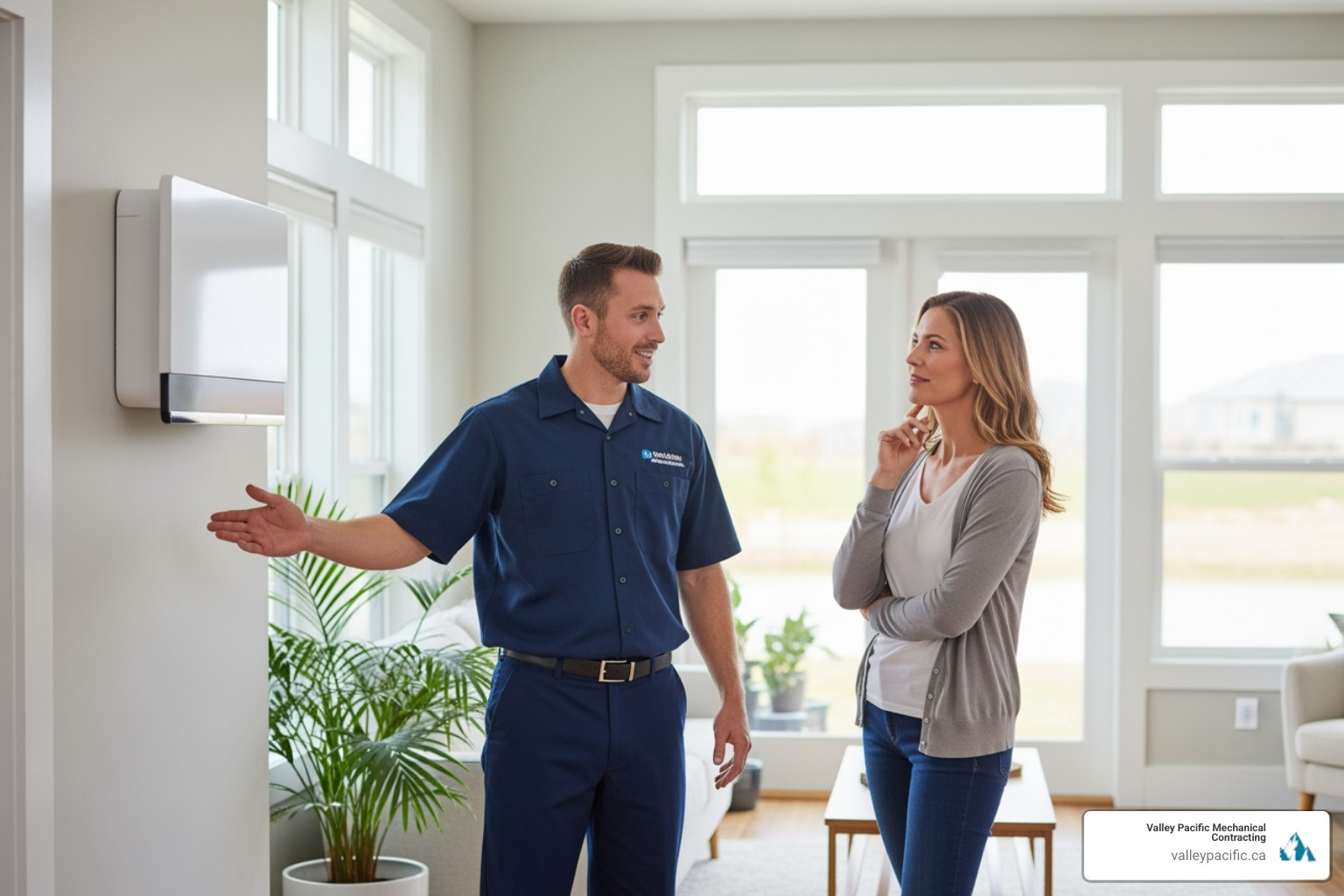
1. Check for Certifications, Licensing, and Insurance
This is your most crucial step. Proper credentials are non-negotiable for safety and quality. Here’s what to look for:
- Technical Safety BC: Contractors performing regulated work in BC must be licensed. Ask for their license number or verify it on the Find a licensed contractor website.
- Red Seal Certification: This national standard signifies a high level of competence and craftsmanship.
- Licensed Gas Contractor: Essential if your installation involves any gas connections (e.g., a hybrid system).
- WCB Coverage: This protects you from liability if a worker is injured on your property.
- Liability Insurance: This protects your property from accidental damage during installation.
A trustworthy company will gladly provide proof of these credentials.
2. Scrutinize Online Reviews and Ask for Referrals
Online reviews offer valuable insight into a company's performance and customer service.
- Google Reviews: Look for a high star rating and read reviews for recurring themes about punctuality, quality, and professionalism.
- HomeStars and BBB Ratings: These sites provide more ratings and show how companies handle complaints.
- Local Community Groups: Ask for recommendations from friends, family, and neighbours in Maple Ridge. Social media groups can also be a great source for referrals.
- Requesting Past Project Examples: A confident installer can provide testimonials that speak to their quality of work.
A few negative reviews aren't a red flag, but a pattern of similar complaints should give you pause.
3. Verify Experience with the Maple Ridge Climate
You need an installer who understands our local climate and building nuances.
- Local Expertise: A company with years of experience in Maple Ridge knows which models perform best here.
- Knowledge of Regional Building Codes: An experienced local installer will ensure your installation is compliant and safe.
- Experience with Popular Home Styles in the Area: They'll know how to handle any challenges presented by local home types.
- Proven Track Record: Look for companies with a long history of successful installations, like our 30+ years of expertise in the Lower Mainland.
4. Compare Detailed Quotes and Understand the Costs
Don't just look at the bottom line. A detailed, itemized quote is crucial.
- Request Itemized Quotes: Insist on a quote that breaks down costs for the unit, labor, materials, permits, and removal of your old system.
- Upfront Pricing: A reputable company provides clear pricing with no hidden fees.
- Average Installation Cost: Costs in BC vary. Ductless mini-split installation can range from $8,000 to $15,000, while ducted air-source systems typically fall between $14,000 and $25,000. Costs are influenced by the heat pump's size, type, brand, and installation complexity.
- Financing Options: Ask about financing to make the investment more manageable.
For a broader understanding of heating system costs, you might find our guide on Furnace Installation Maple Ridge BC helpful.
5. Inquire About the Installation Process and Warranties
Understanding the installation process and post-installation support is vital for a "headache-free" experience.
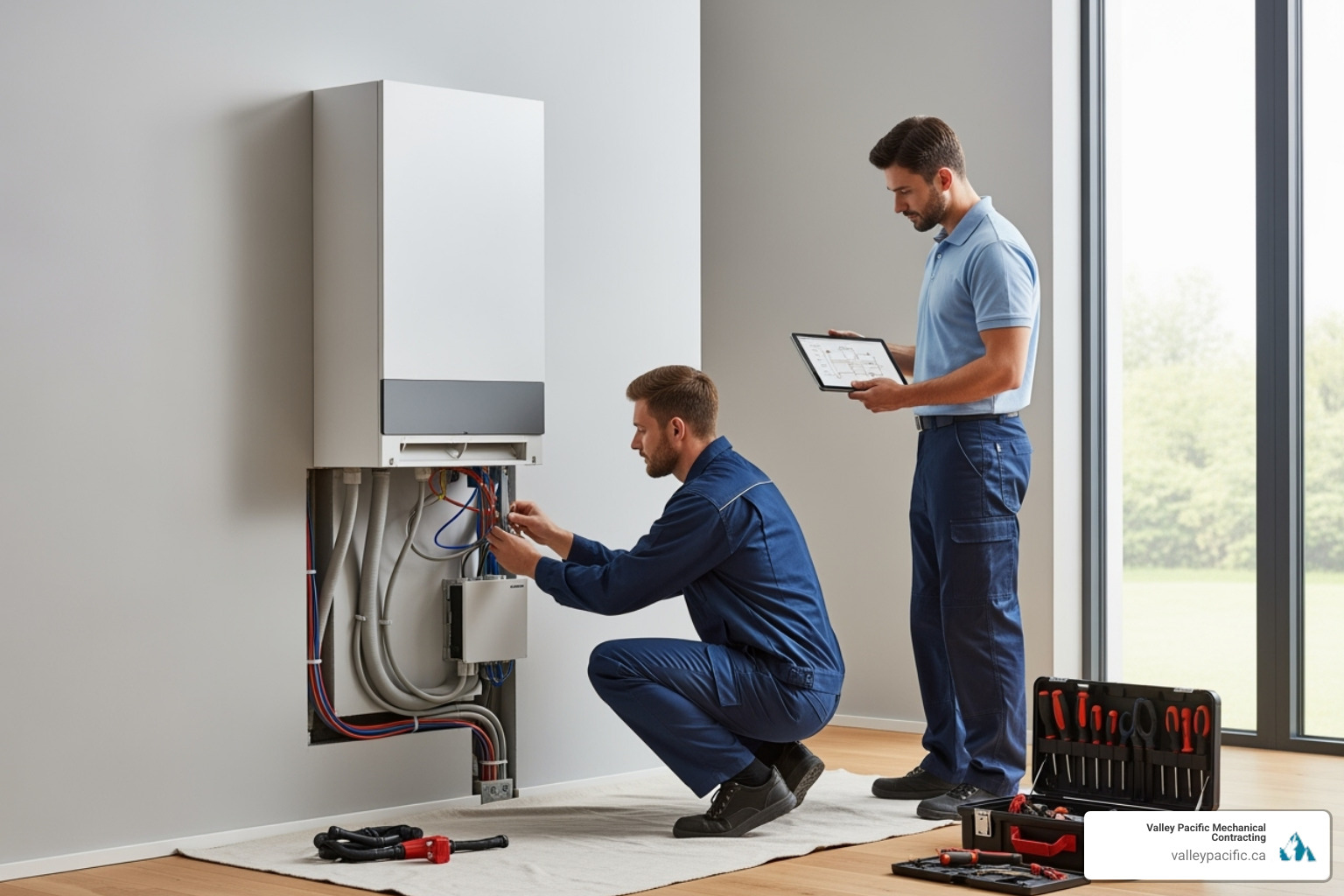
- Consultation Process: A good installer begins with a thorough home assessment and load calculation to recommend the best system for you.
- System Placement: Discuss the placement of indoor and outdoor units for optimal efficiency, aesthetics, and minimal noise.
- Installation Timeline: Most residential heat pump installation maple ridge projects take 1-2 days. Ask for a clear schedule.
- Post-Installation Cleanup: A professional team leaves your home as clean as they found it.
- Manufacturer Warranty: Understand the terms covering parts for your new unit.
- Workmanship Guarantee: A reputable installer stands behind their work with a guarantee on the installation quality. Our Daikin Comfort Promise reinforces this commitment.
After installation, consider our Heat Pump Service Maple Ridge BC options to keep your system running smoothly.
Open uping Major Savings: A Guide to Heat Pump Rebates
Installing a heat pump in Maple Ridge comes with opportunities for significant upfront savings through government rebates. These programs from provincial and federal governments make the switch to energy-efficient heating more affordable.
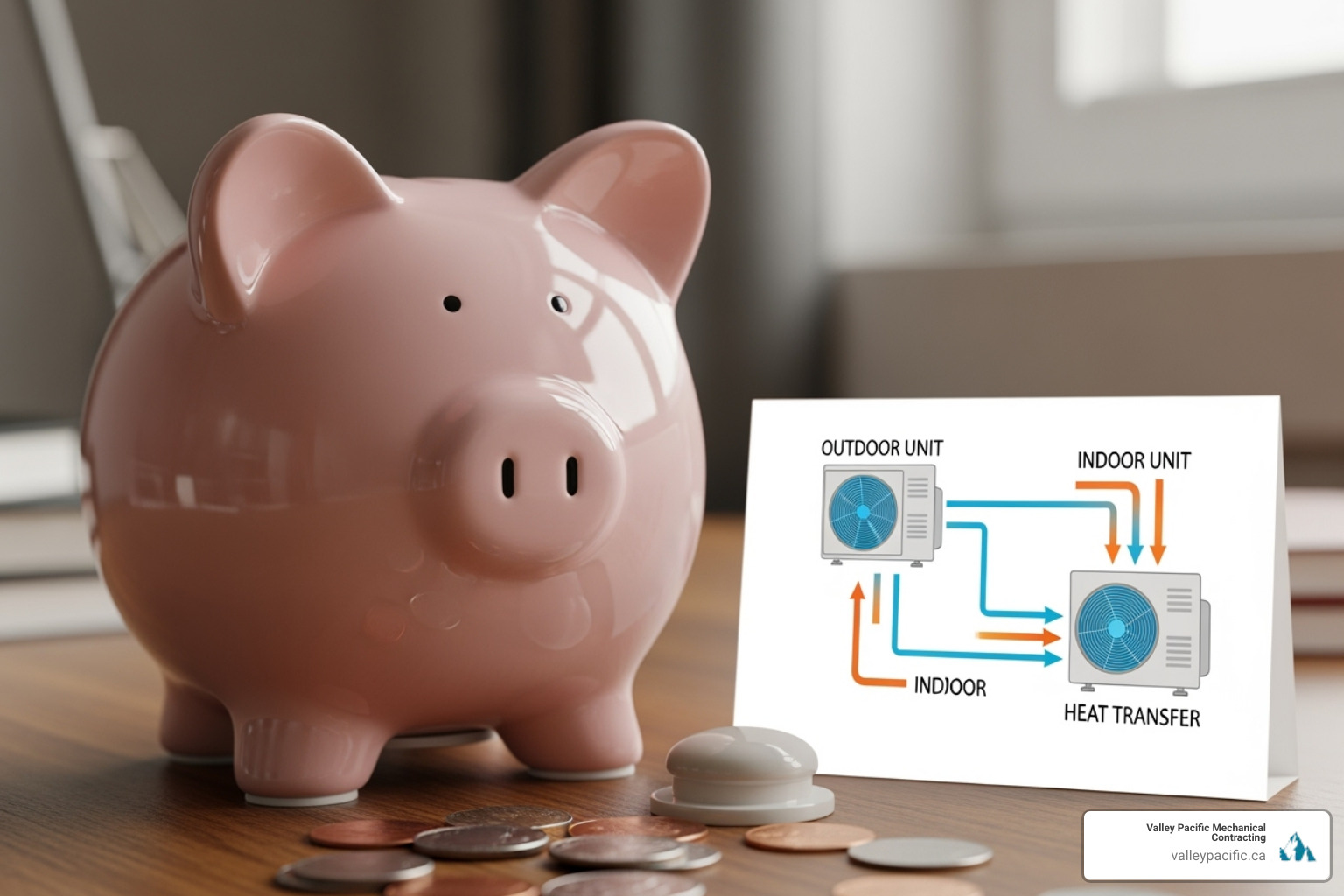
The CleanBC program is the primary source of rebates, and some municipalities offer municipal top-ups for even greater savings. Rebate eligibility often depends on your current heating system, the heat pump model you choose, and sometimes household income. Working with an experienced installer is key to maximizing savings and navigating the requirements for your heat pump installation maple ridge.
Your Guide to the CleanBC Better Homes Program
The CleanBC Better Homes program is a game-changer for homeowners in Maple Ridge looking to upgrade their heating systems.
If you're switching from a fossil fuel system (natural gas, oil, propane), the fossil fuel switching rebate offers up to $6,000. If you're upgrading from electric baseboards or wood heating, the electric system upgrade rebate provides up to $2,000.
The income-qualified program offers even more support for low- and middle-income households, with potential savings up to $21,000 for a heat pump installation.
You can explore all the details and check your eligibility on the CleanBC Better Homes website, where they break down exactly what's available.
How to Apply for Your Maple Ridge Heat Pump Rebate
The application process is straightforward with the right guidance. The journey typically starts with an energy advisor consultation for a pre-upgrade assessment. You'll then need to meet certain pre-upgrade requirements before work begins.
After your heat pump installation maple ridge is complete, you'll submit post-upgrade documentation, including invoices and installation details. An experienced installer can make this process headache-free. We have guided countless homeowners through the rebate maze successfully.
For the most up-to-date information on available rebates and detailed application instructions, visit betterhomesbc.ca. The investment you make today, combined with these generous rebates, sets you up for years of comfortable, efficient home heating and cooling.
Frequently Asked Questions about Heat Pump Installation
Over our 30+ years in the business, we've heard many questions from Maple Ridge homeowners. Here are the most common ones, with our straightforward answers.
How much can I really save on my energy bills with a heat pump in Maple Ridge?
The savings can be impressive. Heat pumps move heat rather than creating it, making them highly efficient. They can deliver 1.5 to 3 times more heat than the electricity they consume. This often leads to energy cost reductions of 50% or more compared to electric baseboards. Actual savings depend on factors like your home's insulation and your temperature settings, but most Maple Ridge homeowners see significant reductions after their heat pump installation maple ridge.
What is the typical cost for a professional heat pump installation in Maple Ridge?
Costs vary by home and system type, but here are some general ranges to help you plan. Ductless mini-split systems often range from $8,000-$15,000, while ducted air-source heat pumps are typically $14,000-$25,000+. Geothermal systems are a premium option with higher upfront costs. The final price is influenced by the system's size, brand, and installation complexity. Government rebates we discussed earlier can significantly lower your out-of-pocket cost.
How long does a heat pump installation take?
Most heat pump installation maple ridge projects take 1 to 2 days. We know you're eager to start enjoying your new system, and we work efficiently to minimize disruption. The process includes placing the outdoor and indoor units, running refrigerant and electrical lines, making any necessary ductwork modifications, and thoroughly testing the system. A professional installer will provide a clear timeline for your specific project and ensure a complete cleanup afterward.
Partner with Maple Ridge's Trusted HVAC Experts
Installing a heat pump is more than just adding equipment to your home – it's about creating a foundation for years of comfortable living and energy savings. The journey we've taken together through this guide shows just how important it is to find qualified professionals who understand both the technology and your unique needs as a Maple Ridge homeowner.
The five-step approach we've outlined – from checking credentials and insurance to understanding warranties and installation processes – gives you the confidence to make smart decisions. When you look for experience, credentials, and positive reviews, you're not just hiring an installer; you're choosing a partner for your home's comfort future.
Understanding costs and rebates empowers your decision in ways that go far beyond the initial investment. With programs like CleanBC offering substantial savings, and the long-term energy bill reductions that quality heat pump installation maple ridge provides, you're making a choice that benefits both your wallet and our beautiful community's environment.
At Valley Pacific Mechanical Contracting, we've spent over 30 years building relationships with homeowners throughout the Lower Mainland, including right here in Maple Ridge. We've seen how the right installation transforms not just comfort levels, but how families feel about their homes. Our commitment to a headache-free process means you can focus on the excitement of your new system rather than worrying about the details.
What sets us apart isn't just our decades of experience – it's our understanding that every home tells a different story. Whether you're in a cozy character home near Memorial Peace Park or a modern build in Silver Valley, we bring the same attention to detail and local expertise to every project. Our Daikin Comfort Promise ensures that your investment is protected with reliable, high-performance equipment installed with the precision that only comes from true expertise.
Ready to experience the comfort and savings that a professionally installed heat pump can bring to your Maple Ridge home? Let's start this journey together.
A grinding noise coming from your heat pump can be more than just an annoyance. For homeowners in Pitt Meadows, this sound often points to a deeper mechanical issue that should not be ignored. Heat pumps are designed to run quietly, so when one starts making sounds like grinding metal, it's a clear signal that something is wrong. Waiting too long to address the issue can eventually lead to more severe damage and system failure, which means more time without comfort and a bigger repair bill.
Many residents notice this noise for the first time when switching between cooling and heating modes during seasonal transitions. September often brings cooler nights in Pitt Meadows, and with that comes increased use of heat pumps. If yours is producing an unusual sound, it is wise to act quickly. This article covers the most common causes of a grinding noise, what you should do if you hear it, and why professional repairs are the safest way to handle the problem.
Common Reasons for Heat Pump Grinding Noises
Grinding noises in heat pumps rarely go away on their own. This type of sound usually means mechanical parts are clashing or under stress. Here are the most common reasons homeowners in Pitt Meadows run into grinding sounds with their heat pump systems:
- Debris in the fan or unit components: Leaves, twigs, or small stones can find their way into outdoor units, especially when the unit is not regularly cleaned. Once stuck in the fan blades, this debris can cause rubbing or scraping noises during operation.
- Worn-out motor bearings: Over time, the motor bearings in the compressor or fan can wear down. When that happens, the metal-on-metal motion produces a rough grinding sound that should not be ignored. Replacing bearings is not a small fix, but ignoring worn ones can quickly lead to a burnt-out motor.
- Loose or misaligned parts: Screws, panels, and supportive hardware can loosen with repeated use. As parts shift out of place, they may scrape against each other while the system runs. One example would be a misaligned fan blade grinding against its housing. Noise like this generally gets worse the longer it is left untreated.
- Refrigerant problems: If there is damage inside the compressor or leakage in the refrigerant lines, it can eventually lead to unusual sounds. With pressure building up or parts running dry, the system can start making a harsh grinding noise as components wear down unevenly.
If your system makes noise when switching on, or if it worsens during a specific setting such as cooling or heating, it can help point out the root of the problem. These issues often grow worse the longer the system continues to run in this condition.
Immediate Steps to Take When You Hear Grinding Noises
Hearing a grinding noise from your heat pump is not something to simply put up with until it stops. Ignoring it can lead to full system failure. Here is what you should do right away if you notice this sound coming from your unit in Pitt Meadows:
1. Turn off the heat pump. Powering down the system stops the parts from grinding further and helps prevent more serious internal damage.
2. Look around the outdoor unit. Check for any visible debris like branches or trash around or inside the enclosure. Do not reach inside the unit. This is just a visual inspection while the system is off.
3. Note when the sound occurs. Does it happen when switching from cooling to heating? Only when the fan turns on? These little details can help professionals identify the issue more quickly.
4. Resist the urge to open or fix anything on your own. Many problems that cause grinding are internal and require special tools or expertise to resolve. DIY solutions often make things worse and can void equipment warranties.
Grinding noises usually signal a mechanical failure somewhere in the system. Acting quickly keeps repair needs from piling up and helps protect your heat pump from everything that comes with a full shutdown.
Long-Term Solutions and Professional Repairs
Once you have shut off the heat pump and ruled out any visible blockages, it is time to deal with the source of the grinding noise. Many of the problems that cause this sound are deep inside the system and cannot be solved without the right tools or knowledge. That is when having trained professionals matters. Grinding noises often indicate wear or damage along moving parts like motors, fan assemblies, or compressors. Getting these checked early helps avoid a full breakdown.
Routine inspections can catch issues before they get worse. For example, if a technician finds that your fan motor bearings are beginning to wear, they can replace them before the damage spreads to other parts of the unit. Similarly, if internal components are loose or misaligned, those can be adjusted or tightened. In some cases, repairs might involve replacing a single part. In others, especially when compressors or multiple mechanical sections are affected, it could make more sense to look at partial or full unit replacements.
Delays can lead to more than just inconvenience. Letting grinding noises go on for weeks might result in worse problems like total compressor failure or damaged refrigerant lines. That combination can push the cost and complexity of repairs beyond what would have been needed if caught earlier. For homeowners in Pitt Meadows using their heat pumps regularly during September’s cooler nights and unpredictable temperatures, a quick turnaround saves time and money in the long run.
Maintaining Your Heat Pump for Optimal Performance
The best way to deal with heat pump issues is to prevent them. Regular maintenance goes a long way in keeping your system in good shape. This does not mean doing major repairs yourself, but there are small things homeowners in Pitt Meadows can do between professional visits.
Here are a few practical ways to keep your heat pump system running without loud, grinding interruptions:
- Change or clean filters every one to two months, depending on use. Dirty filters strain the system and can accelerate wear.
- Keep the area around the outdoor unit clean. Remove leaves, twigs, and other debris that can get sucked into the fan.
- Listen for changes in sound. If your unit suddenly becomes louder or feels different when running, it may be signaling an issue.
- Do not skip tune-ups. Professional inspections once or twice a year can catch small issues early and stop larger system failures.
- Know your system. If your unit has made more noise over time or takes longer to adjust to new thermostat settings, bring it up during a maintenance check.
These simple actions help extend the lifespan of your heat pump and catch abnormal sounds before they lead to expensive repairs. A little prevention is easier than emergency service, especially during seasonal weather changes when HVAC services are in high demand.
Protect Your Comfort and Your Investment
Grinding noises coming from your heat pump are more than a passing annoyance. They are warning signs. Acting early gives you the chance to stop damage before it leads to bigger repair challenges or full equipment replacements. What starts as a worn bearing or a few leaves stuck in the housing can snowball into serious system failure if ignored.
For homeowners in Pitt Meadows, maintaining indoor comfort is a top priority, especially during transitional months like September. If your heat pump starts making strange sounds, do not wait it out. Getting the issue diagnosed and repaired by experienced technicians saves not just the equipment but also your peace of mind. With the right support, you can rely on your heating system exactly when you need it most.
Facing ongoing issues with grinding noises from your heat pump? You may need reliable support to get your system back on track. Consider trusted heat pump repair in Pitt Meadows from Valley Pacific Mechanical Contracting Ltd. Our experienced technicians can quickly diagnose and resolve mechanical issues to restore your system's smooth operation, ensuring your home remains comfortable during variable weather. For a quick estimate or to book a service visit, please contact us today.
Why HVAC Maintenance Matters for Langley Homeowners
HVAC maintenance langley services are essential for keeping your heating and cooling systems running efficiently through Langley's humid summers and cold winters. Regular tune-ups prevent unexpected breakdowns, ensuring your family stays comfortable year-round.
Key benefits of professional maintenance include:
- Extended Lifespan: Get up to 10 more years out of your system.
- Fewer Breakdowns: Prevent up to 90% of unexpected system failures.
- Energy Savings: Improve efficiency and reduce utility bills by up to 15%.
- Peace of Mind: Avoid costly emergency repairs with proactive care.
Your HVAC system is a major investment. As local experts note, "Most HVAC systems can be expected to last 10-20 years with regular use and annual maintenance." Scheduling routine checkups is the smartest way to protect that investment and ensure your home remains a comfortable haven, no matter the season.

Why Regular HVAC Maintenance is a Smart Investment for Langley Homes
In Langley, your HVAC system works hard year-round. That's why hvac maintenance langley is one of the smartest investments for your home. Just like a car needs oil changes, your HVAC system needs regular care to perform its best.
Extend Your System's Lifespan and Prevent Breakdowns
Did you know regular maintenance can extend your HVAC system's life by up to 10 years? It also prevents up to 90% of unexpected breakdowns. That means no more furnace failures on the coldest night or AC outages during a heatwave. The peace of mind that comes from knowing your system is reliable is priceless, especially since emergency repairs are far more costly than planned maintenance.
If you're curious about what warning signs to watch for, our guide on signs your HVAC system may fail soon can help.
Boost Energy Efficiency and Lower Your Utility Bills
A well-maintained system can improve efficiency by up to 15%, which directly lowers your monthly energy bills. When a system is neglected, dirty filters and grimy coils force it to work harder, consuming more energy. Regular tune-ups ensure your furnace and air conditioner can handle Langley's climate efficiently, saving you money and reducing your carbon footprint.
Improve Indoor Air Quality and Home Comfort
Your HVAC system circulates the air your family breathes. Regular maintenance ensures this air is clean and healthy. Clean filters and components reduce dust and allergens, which is vital for family members with allergies or respiratory sensitivities. You'll also enjoy more consistent temperatures, better humidity control (a big plus in Langley's muggy summers), and a more comfortable home overall.
For more insights into how proper HVAC care transforms your living space, check out our article about HVAC services for home comfort.
What a Professional HVAC Maintenance Visit in Langley Includes
When you schedule hvac maintenance langley, you might wonder what our technicians do. We perform a thorough, systematic check to catch issues before they become expensive problems.
A Comprehensive Checklist for HVAC Maintenance in Langley
Our licensed technicians follow a detailed 21-point inspection to ensure your system is safe, efficient, and reliable. Key tasks include:
- Cleaning Coils: We clean the evaporator and condenser coils for better airflow and heat transfer.
- Checking Refrigerant: We ensure refrigerant levels are correct for optimal cooling and identify any leaks.
- Inspecting Electrical Connections: We tighten connections and check for corrosion to prevent safety hazards.
- Lubricating Moving Parts: We lubricate motors and fans to reduce wear and noise.
- Changing Air Filters: We replace dirty filters to improve airflow and air quality.
- Testing Thermostat and Controls: We calibrate the thermostat and test safety controls.
- Inspecting Ductwork: We check for leaks or blockages that waste energy.
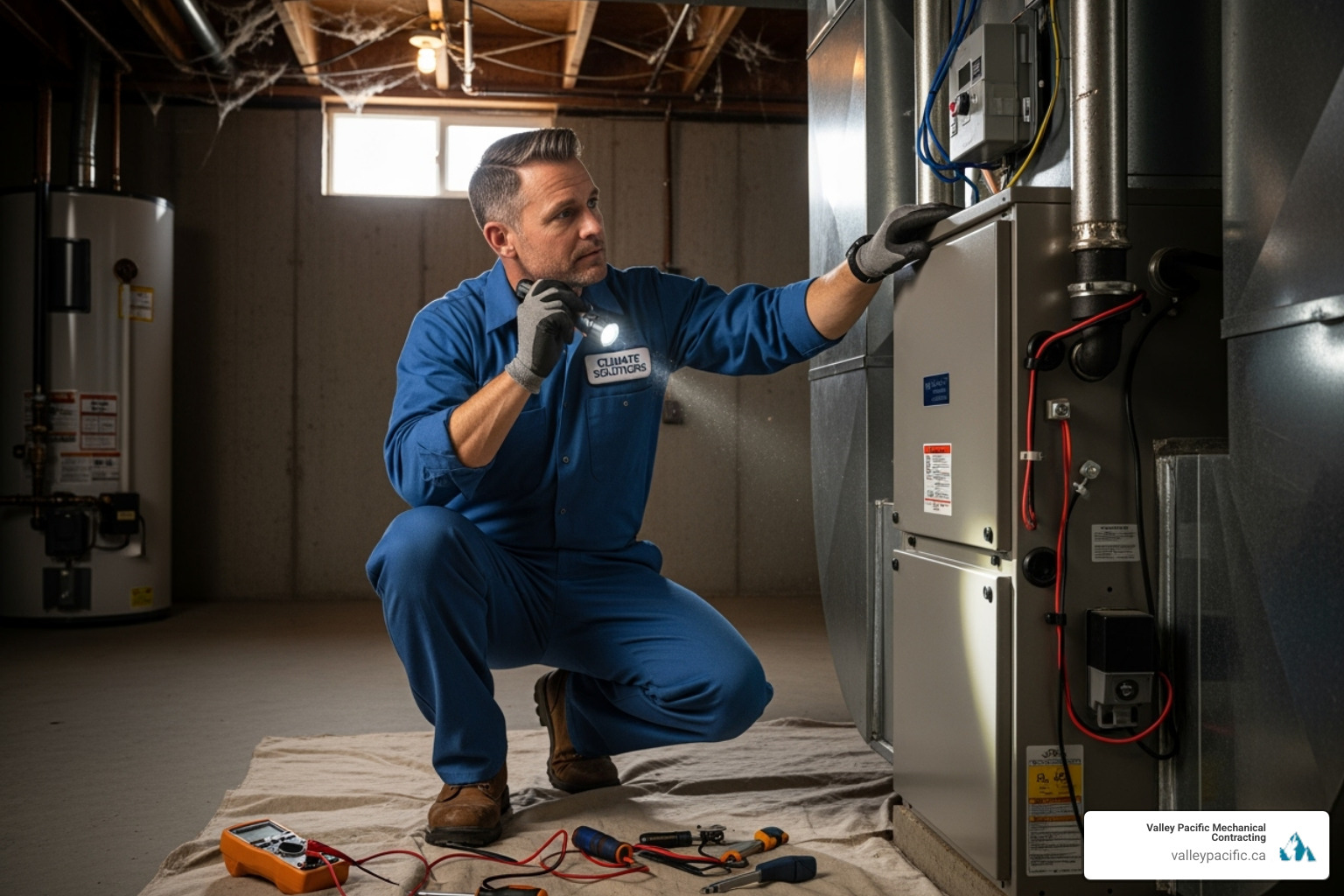
Common HVAC Equipment Serviced in Langley
With over 30 years of experience, our team can service any heating and cooling equipment in your Langley home.
- Furnaces: We keep gas and electric models running safely and efficiently. For bigger issues, see our Furnace Repair Langley BC service.
- Air Conditioners: We ensure your AC is ready for Langley's warm months. Learn about our AC Service Langley BC.
- Heat Pumps: These year-round systems need regular care. We offer expert Heat Pump Service Langley BC.
- Boilers: We provide specialized maintenance for radiant heating systems. If you need a fix, our Boiler Repair Langley BC team can help.

Maintenance vs. Repair: What's the Difference?
Understanding the difference between maintenance and repair can save you money and stress.
- Maintenance is proactive. It's a scheduled tune-up to keep your system healthy and prevent problems, much like regular exercise. It's planned, predictable, and cost-effective.
- Repair is reactive. It's an emergency fix when something has already broken. While we offer 24/7 emergency service, our goal with maintenance is to help you avoid these calls. When you do need a fix, our AC Repair Langley BC team is ready.
Regular hvac maintenance langley shifts your approach from reactive to proactive, giving you peace of mind that your system is professionally cared for.
Your Guide to Professional HVAC Maintenance in Langley
Let's cover the practical side of scheduling hvac maintenance langley, from timing and costs to choosing the right company.
How Often to Schedule HVAC Maintenance in Langley
The golden rule is to service your HVAC system at least once a year. For systems that both heat and cool, like a heat pump, bi-annual maintenance is best: one visit in the spring for cooling and another in the fall for heating. Pre-season tune-ups are the secret to avoiding breakdowns during extreme weather. A little planning goes a long way.
Understanding the Costs and Available Rebates
While maintenance has a cost, it saves money by preventing major breakdowns. The best part? You might not have to pay full price. British Columbia offers excellent programs to help homeowners with HVAC costs.
Government incentives from programs like CleanBC and FortisBC can significantly reduce your out-of-pocket expenses for maintenance and energy-efficient upgrades. We stay current on all available rebates and can help you find savings. Check out our Maintenance Plan to see how these programs can benefit you.
Choosing a Reliable HVAC Company and Maintenance Plan
Finding the right partner for your hvac maintenance langley needs is crucial for your home's comfort and safety. Look for a company that offers:
- Licensed and Insured Technicians: This is non-negotiable for your protection.
- Red Seal Certification: This Canadian standard is a mark of elite skill and safety knowledge.
- Positive Local Reviews: See what other Langley homeowners are saying.
- Transparent Pricing: No hidden fees or surprises.
- Comprehensive Maintenance Plans: These offer the best value with benefits like priority service.
At Valley Pacific, we've built our reputation on these principles for over 30 years. To partner with us for long-term peace of mind, Explore our Maintenance Plan.
Telltale Signs Your HVAC System Needs Attention
Even with regular hvac maintenance langley, issues can arise. Recognizing warning signs can save you from an emergency repair call. Here’s what to look, listen, and smell for.
Listen for Strange Noises
Your HVAC system should operate quietly. If you hear any of these sounds, it's time to call a professional:
- Banging or Clanking: Suggests a loose part, like a bolt or blower component, which can cause serious damage.
- Whistling: Often points to airflow problems from a clogged filter or blocked ductwork.
- Grinding: Typically means motor bearings need lubrication or replacement to avoid motor failure.
- Loud Buzzing: Can indicate a serious electrical issue or compressor problem.
Watch for Performance Issues
How your system feels is just as important as how it sounds. Watch for these red flags:
- Weak or Inconsistent Airflow: Could be a blower issue, blocked ducts, or a clogged filter.
- Uneven Temperatures: If some rooms are hot and others are cold, you may have duct leaks or zoning problems.
- Frequent On/Off Cycling: Short-cycling puts extra stress on your system and can be caused by thermostat issues or restricted airflow.
- Rising Energy Bills: A sudden spike in your utility costs often means your system is losing efficiency and working too hard.

Notice Unusual Smells or Leaks
Your nose can be a great diagnostic tool. Be aware of these signs:
- Musty or Dusty Odors: Often indicates mold or mildew in the ductwork or on the coils.
- Burning Smells: A serious sign of an overheating motor or electrical problem. Turn off your system and call for help immediately.
- Water Leakage: Pooling water usually means a clogged condensate drain line, which can lead to water damage.
- Frost or Ice on Coils: This is never normal and often points to low refrigerant or poor airflow. Learn more about when to call for heat pump repair.
Don't ignore these warning signs. Catching problems early is always easier and less expensive to fix.
Frequently Asked Questions about HVAC Maintenance
Here are answers to common questions from Langley homeowners about HVAC care.
Should I repair or replace my HVAC system?
Deciding whether to repair or replace can be tough. Consider these key factors:
- Age: Most systems last 10-15 years. If yours is approaching this age, replacement may be more cost-effective.
- Frequency of Repairs: If you're calling for repairs often, the costs can add up quickly, making a new system a better investment.
- Cost of Repair: If a repair costs 50% or more than a new unit, replacement is usually the smarter choice.
- Energy Efficiency: A new, high-efficiency system (with a better SEER/AFUE rating) can lower your utility bills, helping it pay for itself over time.
- Warranty: If your system is still under warranty, a repair might be the most affordable option.
We provide honest advice to help you make the best decision for your home and budget.
Can I do my own HVAC maintenance?
Yes, some simple DIY tasks are great for your system! We recommend homeowners:
- Change air filters every 3-6 months.
- Keep outdoor units clear of leaves, grass, and debris (at least two feet of clearance).
- Clean indoor vents and registers to maintain good airflow.
However, always call a professional for complex or dangerous tasks like electrical work, refrigerant handling, and internal diagnostics. Safety is paramount, and our trained technicians have the tools and expertise to do the job right.
What is a Red Seal certification and why does it matter?
A Red Seal certification is the Canadian standard of excellence for skilled trades. It means a technician has completed years of apprenticeship training and passed a rigorous exam, ensuring they have an elite level of skill and knowledge.
For homeowners, choosing a Red Seal certified technician for hvac maintenance langley guarantees:
- Expertise: The technician is highly skilled in all aspects of HVAC systems.
- Safety: They have a deep understanding of safety codes for gas lines, electricity, and refrigerants.
- Quality: You can trust that the work will be done correctly according to industry best practices.
We are proud to have Red Seal certified technicians on our team, as it's a key part of delivering the safe, headache-free experience we promise.
Conclusion: Keep Your Langley Home Comfortable Year-Round
Your HVAC system is your home's first line of defense against Langley's varied climate. As we've covered, proactive hvac maintenance langley is essential for your comfort and budget.
Regular tune-ups protect your investment by extending your system's life, reducing energy bills by up to 15%, improving indoor air quality, and preventing the vast majority of breakdowns. A well-maintained system is your ticket to year-round peace of mind, ensuring you stay cool during humid summers and warm through damp winters.
Regular maintenance is the difference between a home that's always comfortable and one where you're worried about the next breakdown.
For a headache-free experience backed by over 30 years of local expertise, trust Valley Pacific Mechanical Contracting. We understand Langley homes and what it takes to keep you comfortable.
Ready to upgrade your comfort? Schedule your AC installation in Langley today!
Why HVAC System Design Matters for Your Comfort and Wallet
HVAC system design is the science of creating heating, ventilation, and air conditioning systems for optimal comfort and energy efficiency. Proper design involves:
Key Elements of HVAC System Design:
- Load calculations - Determining exactly how much heating and cooling your space needs
- System selection - Choosing the right equipment type and size for your building
- Ductwork design - Planning air distribution for even temperatures throughout
- Integration - Coordinating with electrical, plumbing, and building structure
- Controls - Setting up thermostats, zoning, and safety systems
- Code compliance - Meeting local building standards and energy requirements
Poor HVAC design costs you money. Oversized systems waste energy and fail to remove humidity, while undersized systems run constantly without reaching comfortable temperatures. Bad ductwork creates hot and cold spots that thermostats can't fix.
Good design pays for itself. A properly designed system can use 20% less energy, last longer, and keep every room comfortable, preventing costly issues like mold and premature equipment failure.
HVAC systems are the cornerstone of building performance—they don't just control temperature, they affect your health, energy bills, and peace of mind for decades.
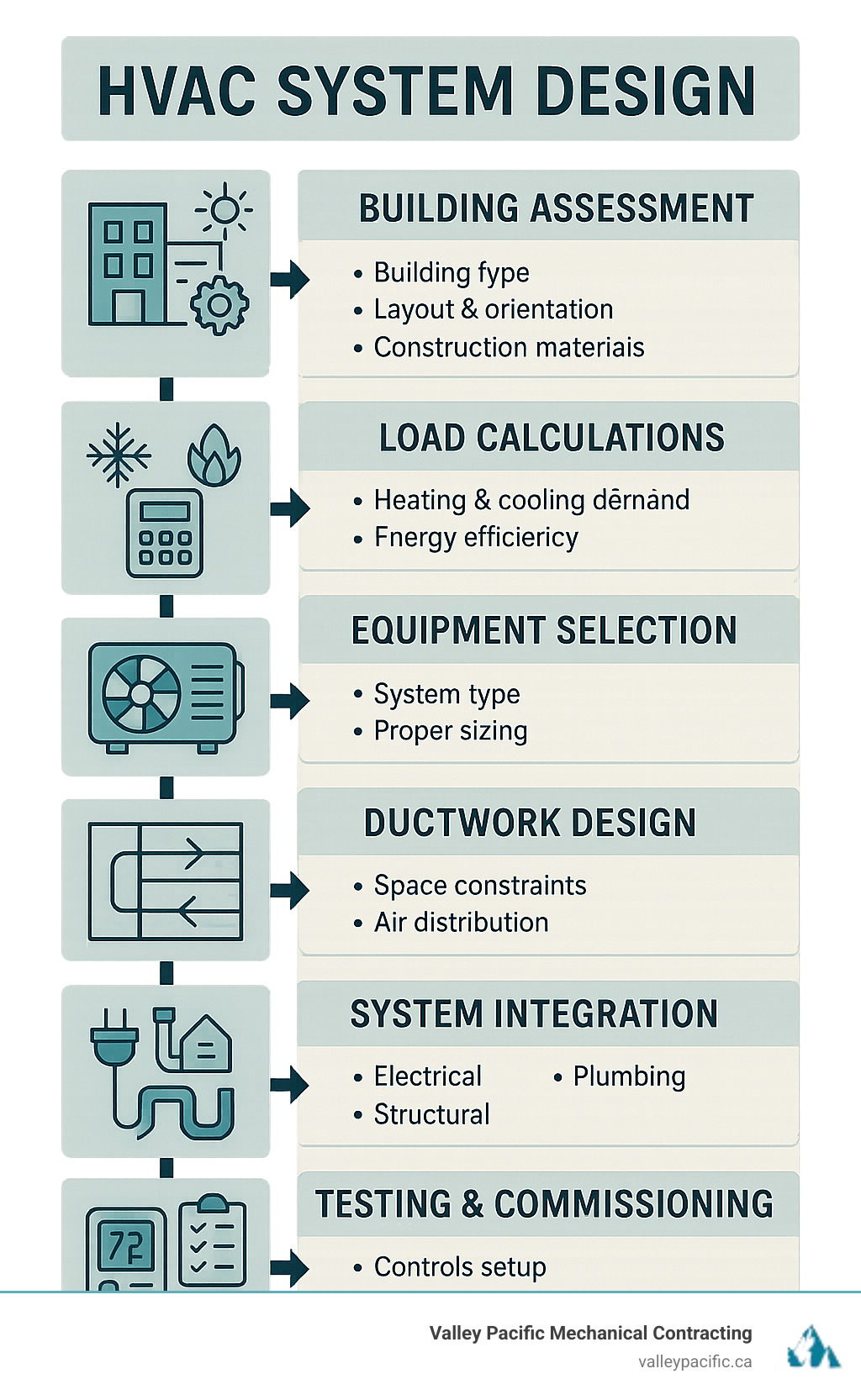
The Foundation of Professional HVAC System Design
Your home's building envelope—walls, roof, windows, and doors—is the barrier between you and the weather. Getting it right is crucial for effective HVAC system design.
Two key boundaries must align: the thermal boundary (insulation) and the pressure boundary (air sealing). When continuous, they reduce the load on your HVAC system.
R-value tells you how well your insulation resists heat flow—higher R-values mean better performance, lower energy bills, and more consistent comfort. But even the best insulation can't do its job if air is leaking around it.
Modern homes are built much tighter, which is great for energy efficiency. However, when a home is very air-tight (less than 5 Air Changes per Hour at 50 Pascals), codes require mechanical ventilation for proper Indoor Air Quality (IAQ). Fresh air is essential for your family's health and comfort.
Moisture control is one of the most important jobs your HVAC system performs. When your air conditioner runs, it pulls moisture out of the air as warm, humid air passes over the cold indoor coil, causing water vapor to condense and drain away.
This is where proper HVAC system design is critical. An oversized AC cools quickly but fails to dehumidify, leaving rooms feeling clammy. This excess moisture can lead to mold and other IAQ problems, affecting your health and your home's structure.
Key Steps in HVAC System Design Load Calculation
Skipping proper load calculations is like guessing a clothing size for a stranger—it's bound to be wrong. Contractors who guess are gambling with your home's heating and cooling needs.
ACCA Manual J is the gold standard for residential load calculations. It's precise engineering that considers every factor affecting your home's comfort.
We start with local climate data and design temperatures. But factors like building orientation are also critical—a home with large south-facing windows has vastly different cooling needs than a north-facing one.
The characteristics of your building envelope play a huge role. The R-value of your insulation, window type, and how airtight your home is all factor into the calculations. Even internal heat gains from people, lights, and appliances contribute to your cooling load.
Understanding the difference between sensible heat (air temperature) and latent heat (moisture in the air) is crucial for proper system sizing, as your AC system must handle both effectively.
For larger commercial projects, we use sophisticated software for hour-by-hour energy modeling. But whether residential or commercial, the goal is the same: finding the perfect "Goldilocks" fit for your space.
When load calculations are wrong, an oversized system cycles too frequently, leading to poor comfort and high energy bills. An undersized system runs constantly but never keeps up. If you're dealing with inconsistent temperatures, our guide on how to solve HVAC hot and cold spots might help.
The Role of Building Codes and Standards
Building codes aren't red tape; they protect you from poor workmanship and unsafe installations. They ensure every HVAC system meets rigorous safety, efficiency, and performance requirements.
ASHRAE sets the global standard for HVAC excellence, influencing everything from load calculations to energy efficiency.
ACCA Manuals provide the step-by-step methodology we use daily. Manual J guides load calculations, Manual S covers equipment selection, and Manual D ensures proper ductwork design. These are often required by local building codes.
Here in British Columbia, we work within specific BC building codes that govern ventilation requirements and energy standards. These codes specify when mechanical ventilation is required and set minimum performance standards for equipment.
Permit applications ensure that qualified professionals review designs before installation and verify that completed work meets code. This protects you from costly mistakes and ensures your system performs as designed.
With over 30 years of experience, we know that adherence to these codes and standards prevents the common pitfalls of poorly designed systems. When your HVAC system design follows these guidelines, you get the comfort, efficiency, and reliability you deserve.
The Blueprint: System Selection and Ductwork
Once we've calculated your building's exact heating and cooling needs, it's time to choose the perfect equipment and map out how we'll deliver comfortable air to every corner of your space.
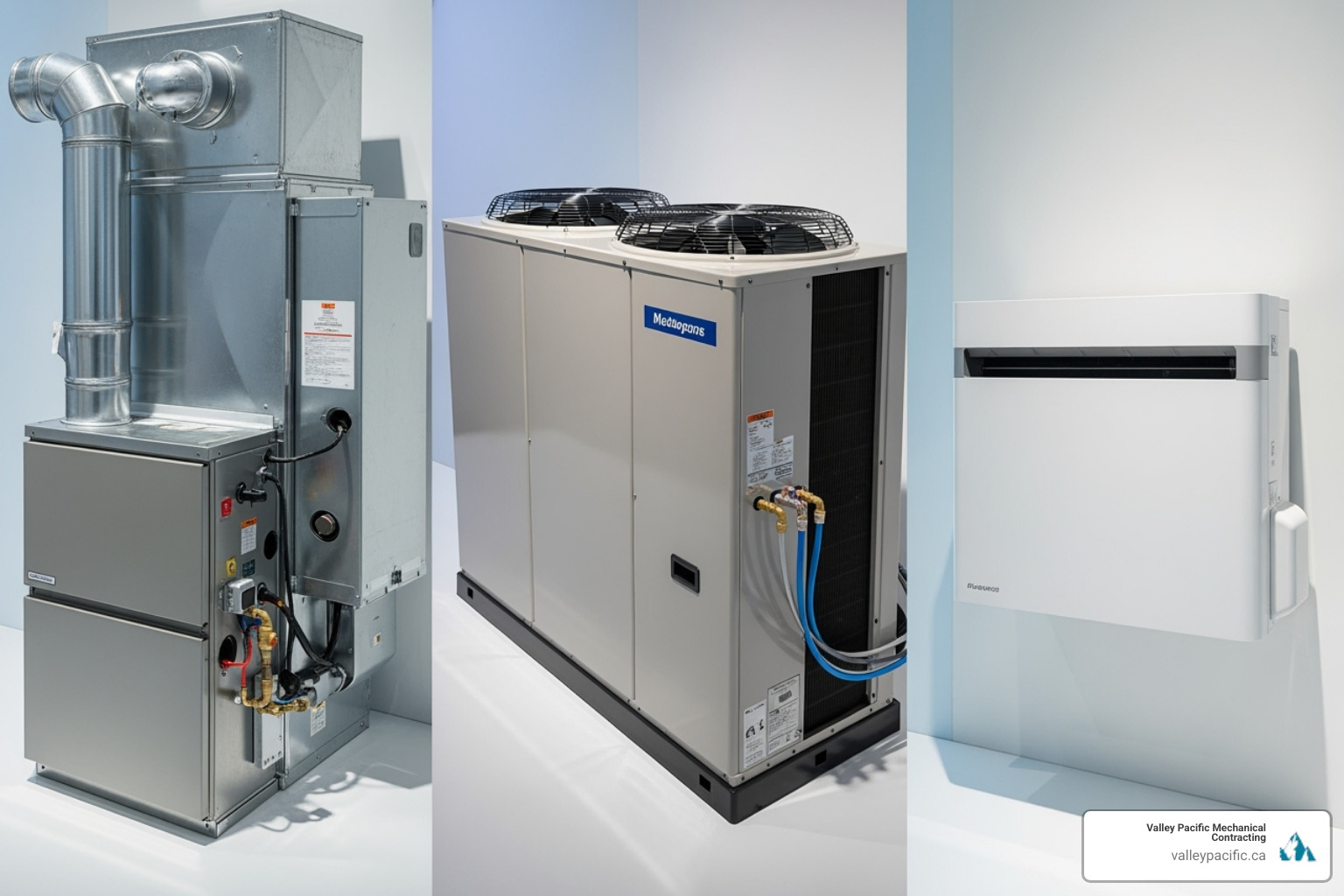
System sizing and equipment selection aren't guesswork; we follow ACCA Manual S. This standard ensures we select equipment that meets both sensible (temperature) and latent (humidity) heat loads without being oversized.
Here's the sweet spot: your chosen unit should never be more than 115% of the calculated size. An oversized system cycles on and off too frequently, leading to poor humidity control, wasted energy, and inconsistent comfort.
We also pay close attention to efficiency ratings. SEER (Seasonal Energy Efficiency Ratio) measures cooling efficiency, while HSPF (Heating Seasonal Performance Factor) does the same for heat pumps. Higher numbers mean lower energy bills.
Common Types of HVAC Systems
The world of HVAC offers something for every situation. Choosing the right system needs to fit your space, lifestyle, and budget.
| System Type | Key Features |
|---|---|
| Forced-Air Systems | The workhorses of HVAC, combining a central furnace and AC. They use ductwork for air distribution and easily incorporate filtration and humidity control. |
| Heat Pumps | Efficiency champions that move heat rather than creating it. They heat in winter by extracting it from outside air and cool in summer by reversing the process. Ideal for the Lower Mainland climate. We offer expert heat pump installation services in Maple Ridge, BC. |
| Ductless Mini-Splits | Flexible solutions for homes without ductwork or for creating independent comfort zones. Each indoor unit is controlled separately, perfect for additions or converted spaces. |
| Geothermal Systems | A long-term investment that uses the earth's stable temperature for heat exchange via buried loops. Higher upfront cost but delivers incredible efficiency and longevity. |
| Variable Refrigerant Flow (VRF) | Advanced heat pump technology allowing simultaneous heating and cooling in different zones. Incredibly versatile, but typically for larger residential or commercial buildings. |
Furnaces and air conditioners remain the backbone of many forced-air systems, running on natural gas, electricity, or oil. The key is matching the system type to your specific needs.
Designing Ductwork for Optimal Airflow
Ductwork is your home's circulatory system, delivering conditioned air to each room at the right pressure.
We use ACCA Manual D for precise ductwork engineering, eliminating guesswork by considering every bend, branch, and connection.
Duct layout is our first consideration. We map the most efficient path for your ducts, avoiding unnecessary turns and restrictions that choke airflow.
CFM calculations determine how much air each room needs. We typically work with about 400 CFM per ton of cooling capacity for the whole system, then break that down room by room based on individual loads.
Duct sizing is where the magic happens. Too small, and your system works harder, driving up costs and creating noise. Too large, and you waste money on materials. We aim for the Goldilocks zone—just right.
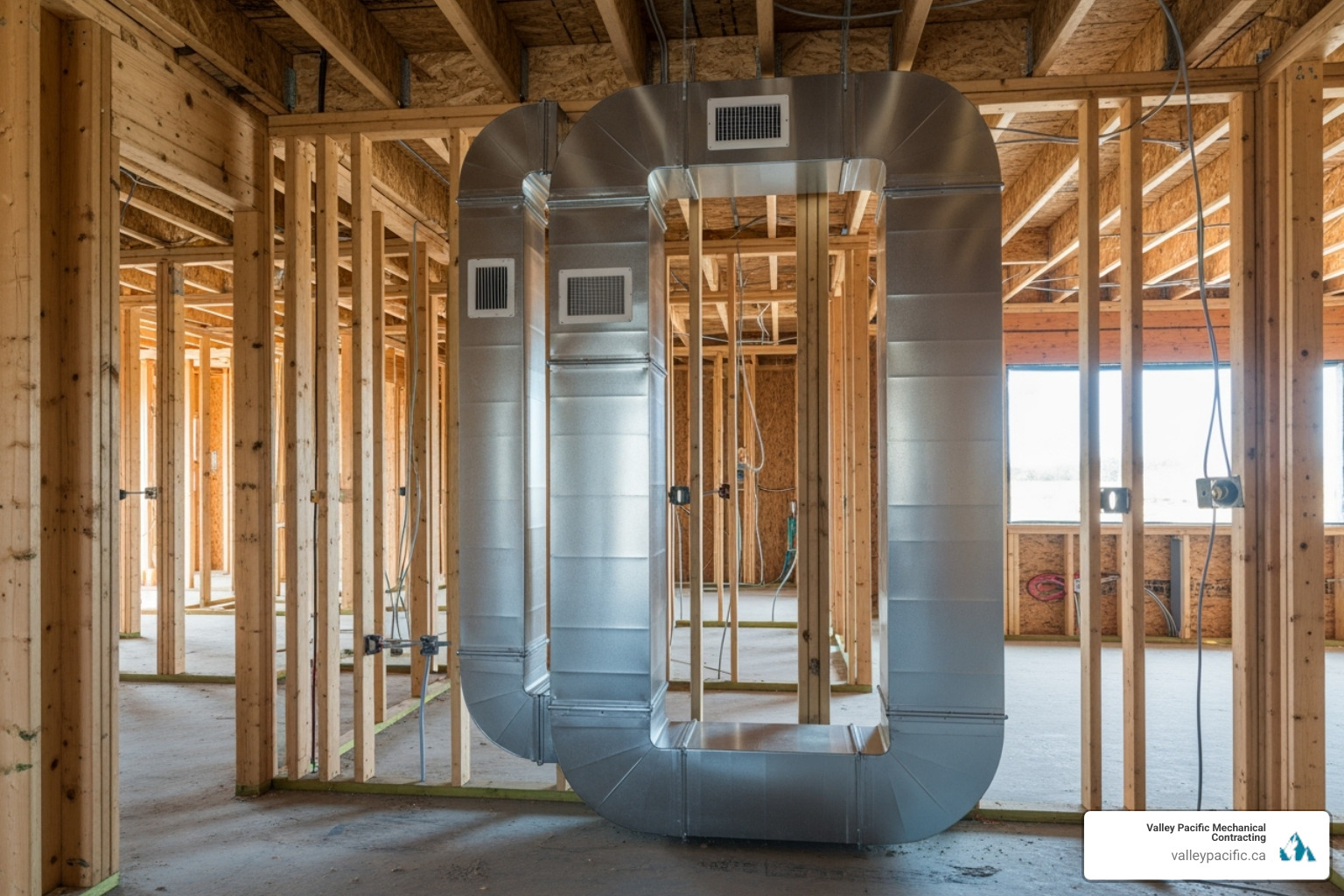
Duct sealing is a critical step. Leaky ducts can waste over 20% of your conditioned air. We use high-quality mastic sealant on every joint to prevent this loss.
We prefer round ducts when possible as they move air more efficiently. For rectangular ducts, we keep the aspect ratio close to square. Galvanized steel is our go-to material for its durability.
Every detail matters in our HVAC system design process, from installing volume control dampers to carefully calculating static pressure losses. The result is even temperatures, quiet operation, and reasonable energy bills.
Bringing it to Life: Integration, Controls, and Efficiency
Proper HVAC system design goes beyond equipment and ducts. The final phase involves seamless integration with your building for years of efficient, comfortable operation.
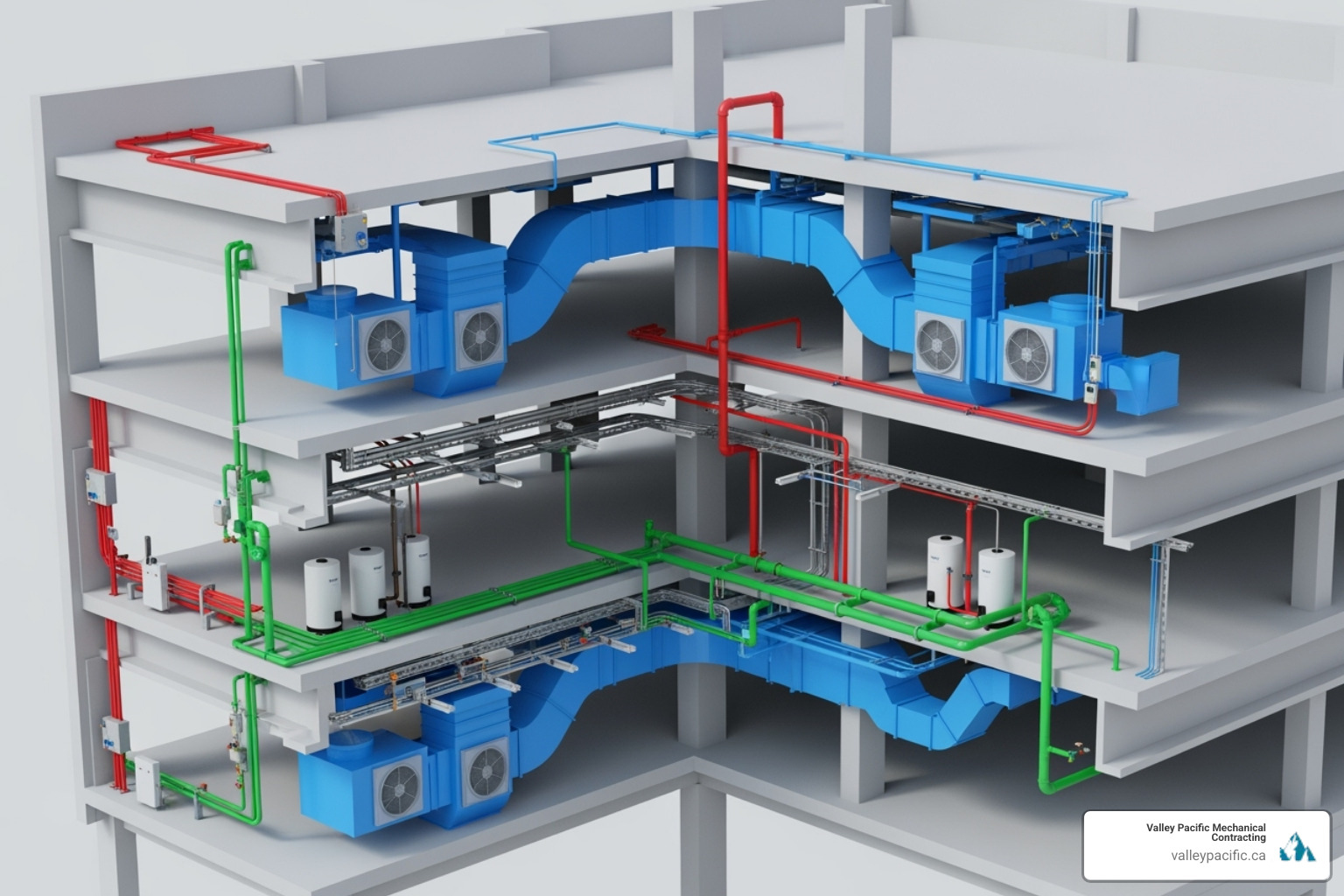
Without proper system coordination, ducts can run into structural beams or ventilation systems might not meet code. Our 30+ years of experience show that early coordination saves clients money and headaches. Catching conflicts in the design phase is far cheaper than fixing them during construction.
Energy efficiency isn't just about high-SEER equipment. It's about a system that works intelligently with your building and lifestyle. We always consider lifecycle costs—not just the upfront price, but what the system will cost in energy, maintenance, and repairs over its lifespan.
Controls, Zoning, and Smart Technology
Modern control systems transform your HVAC from a simple appliance into an intelligent comfort management system.
Thermostats have evolved. Today's smart thermostats learn your schedule, adjust automatically when you're away, and can be controlled remotely.
Zoning systems are game-changers for homes with varied comfort needs. They allow independent temperature control in different areas, so you don't have to heat or cool the entire house to make one room comfortable.
This works through damper actuators—motorized controls that direct conditioned air where it's needed.
For commercial properties, Building Automation Systems (BAS) manage complex schedules, monitor performance, and even predict maintenance needs.
Safety controls are the unsung heroes. Smoke, fire, and carbon monoxide detectors can automatically shut down or redirect your ventilation system to protect occupants during emergencies.
We believe in smart technology because it makes your life easier while saving you money. Our clients love learning about the smart thermostat benefits available in the Lower Mainland.
Integrating with Other Building Systems and New Technologies
The best HVAC system design works in concert with all other building systems.
Building Information Modeling (BIM) revolutionizes system integration. We create detailed 3D models to see how HVAC interacts with structure, electrical, and plumbing, avoiding conflicts before they happen.
Clash detection is a BIM tool that lets us virtually "walk through" your building to spot conflicts between systems, fixing them in the model, not on the construction site.
MEP (mechanical, electrical, plumbing) coordination is critical. HVAC equipment needs dedicated circuits, wiring, and plumbing connections, and all components must be accessible for maintenance.
We also respect architectural constraints, designing systems that work within your aesthetic vision.
Renewable energy integration is becoming more popular. Geothermal systems use the earth's stable temperature for incredibly efficient heating and cooling. While the upfront investment is higher, the long-term energy savings can be substantial.
Solar-assisted HVAC systems use solar energy to power components, reducing your reliance on the grid. These systems require careful planning but represent the future of sustainable design.
At Valley Pacific Mechanical Contracting, we stay current with these emerging technologies. Our HVAC system design approach ensures everything works together seamlessly, giving you the headache-free experience we're known for.
Common Pitfalls and Professional Solutions
After 30 years in the business, we've seen the costly and frustrating consequences of poor HVAC system design. It can turn a dream home or office into a source of constant problems.
The most obvious issue is poor comfort—one room is sweltering while another is an icebox. You're constantly adjusting the thermostat, but nothing helps.
Then there are the high energy bills. When your HVAC system fights poor design, it works overtime, wasting the energy you pay for.
Premature equipment failure is another painful reality. We've seen expensive systems fail years early because they were stressed by improper sizing or installation. Our guide on signs your HVAC system may fail can help you spot trouble early.
Poor indoor air quality is a serious consequence. Inadequate ventilation or moisture control can compromise your family's health, leading to stuffy air, odors, or mold growth.
Finally, there are durability concerns. Persistent humidity can lead to structural damage that costs thousands to repair.
The Consequences of Improper HVAC System Design
Let's dig into how flawed HVAC system design shows up in real life.
Oversized systems are a common mistake. Bigger isn't better in HVAC. A large AC cools too quickly and shuts off before removing humidity. This short-cycling leaves you feeling clammy and uncomfortable, even if the thermostat reading is low.
On the flip side, undersized systems run constantly, trying to keep up but never quite getting there. On peak days, your space will never reach a comfortable temperature.
Hot and cold spots are the telltale sign of poor air distribution. These temperature variations usually point to ductwork that wasn't properly sized or positioned. We've written extensively about how we solve HVAC hot and cold spots for our clients.
Noise issues can seriously impact your quality of life. When ducts are too small or fans are improperly selected, your system can produce whistling, rumbling, or annoying cycling noises.
These aren't minor inconveniences; they are symptoms of fundamental design flaws that will continue to cost you money and comfort.
Why Professional Design is Non-Negotiable
Modern HVAC system design is too complex to leave to chance. Our 30+ year reputation is built on understanding that every detail matters.
Our expertise goes beyond just knowing which equipment to install. We understand building science, thermal dynamics, and how different systems interact. This experience helps us anticipate problems before they become expensive headaches.
Code compliance isn't just about passing inspections—it's about safety and performance. We steer the web of ASHRAE standards, ACCA manuals, and BC building codes daily, ensuring your system meets or exceeds every standard.
When we design a system, we stand behind its performance. You can trust that your HVAC system will deliver consistent comfort, maintain proper humidity, and operate efficiently.
The long-term savings from professional design are substantial. An initial investment pays for itself through lower energy bills, fewer repairs, and longer equipment life. It's about buying quality once instead of paying for problems repeatedly.
Most importantly, we deliver a headache-free experience. We handle the complex coordination, manage permitting, and ensure everything works together seamlessly. You shouldn't have to be an HVAC expert to get a comfortable home or office.
Whether you need HVAC services in Maple Ridge or HVAC services in Langley, our comprehensive approach to HVAC system design ensures you get the comfort, efficiency, and peace of mind you deserve.
Conclusion
We've covered HVAC system design, from load calculations and building envelopes to ductwork, controls, and renewable energy. It's clear that creating the perfect indoor climate is both an art and a science.
Remember: great HVAC system design isn't just assembling parts. It's creating a harmonized system where every component—furnace, ducts, controls, insulation—works together perfectly for a successful result.
The holistic approach makes all the difference. When we properly use standards like ACCA Manual J, S, and D, we're setting the stage for decades of comfort. Combined with smart controls, proper system integration, and adherence to ASHRAE standards and BC building codes, you have a recipe for success.
The long-term benefits are substantial: consistent temperatures, lower energy bills, cleaner air, and longer equipment life. You'll gain peace of mind knowing your system was designed by professionals who understand the Lower Mainland climate.
At Valley Pacific Mechanical Contracting, we've been perfecting this craft for over 30 years in Mission, Maple Ridge, Langley, and throughout the Lower Mainland. We've seen what happens when corners are cut and know the satisfaction of doing things right the first time. Our commitment to a headache-free experience means you can trust us to handle every detail.
Your comfort is too important to leave to chance. Whether you're building new, renovating, or tired of an underperforming system, professional HVAC system design is your foundation for reliable comfort. For expert heat pump installation in Langley, BC, or any other HVAC service, contact our team today. Let's create something great together.
Why Langley Homeowners Are Switching to Heat Pump Solutions
Heat pump service langley has become one of the most requested HVAC services as homeowners find the incredible year-round comfort, significant energy savings, and environmental benefits these modern systems provide. In a climate like Langley's, which features mild, wet winters and warm, dry summers, a heat pump isn't just a luxuryit's a smart, efficient, and cost-effective solution for total home comfort. Whether you are considering a new installation, need a timely repair, or want to schedule routine maintenance, professional heat pump service is the key to ensuring your system operates at peak performance for years to come. Choosing a seasoned local team also means a smoother, headache-free experiencefrom permits (when required) and code compliance to transparent recommendations that match your home and budget.
A Closer Look at Heat Pump Services in Langley
Understanding the services available helps you make informed decisions about your home's heating and cooling needs.
- Professional Installation: A successful heat pump experience begins with a flawless installation. This is far more than just placing a unit outside your home. Professionals conduct a detailed load calculation to determine the exact size and capacity your home needs. They assess your existing ductwork, recommend the best placement for indoor and outdoor units to maximize airflow and minimize noise, and ensure the entire system is set up according to manufacturer specifications and local building codes for optimal, long-term performance. The crew also plans line-set routing, drain and condensate management, and appropriate snow stand/clearances for the outdoor unit to perform reliably in all seasons.
- Expert Repair: Even the most reliable systems can encounter issues. If you notice unusual noises like grinding or squealing, a sudden spike in your energy bills, poor heating or cooling performance, or a system that cycles on and off too frequently, it's time to call for repairs. Certified technicians can quickly diagnose and fix problems ranging from refrigerant leaks and sensor malfunctions to electrical issues and compressor failures. Many service calls also address defrost cycle faults, airflow restrictions, or failing contactors that can be corrected before they lead to bigger, more expensive problems.
- Preventative Maintenance: Regular tune-ups are the single best way to protect your investment. A comprehensive maintenance plan extends your system's lifespan (typically 10-20 years), prevents unexpected and costly breakdowns, and keeps it running at maximum efficiency. During a maintenance visit, a technician will clean coils, check refrigerant levels, test electrical connections, lubricate moving parts, and calibrate your thermostat. They will also verify proper defrost operation, clear condensate lines, inspect outdoor unit clearances, and confirm that airflow and static pressure match design targets.
- 24/7 Emergency Service: HVAC emergencies don't wait for business hours. Whether your heat pump fails during a winter cold snap or a summer heatwave, having access to 24/7 emergency support provides invaluable peace of mind, ensuring your family's comfort and safety are restored quickly.
- Navigating Rebates: The transition to a high-efficiency heat pump is supported by significant government incentives. Homeowners in Langley can access up to $24,000 in combined provincial and federal rebates, making the initial investment more affordable than ever. A knowledgeable service provider can help you steer the application process to maximize your savings.
Heat pumps are an ingenious solution perfectly suited for Langley's climate. They operate on a simple principle: instead of burning fuel to generate heat, they transfer existing heat energy. In the winter, they extract heat from the outdoor air and move it inside; in the summer, they reverse the process, pulling heat from your home and moving it outside. This transfer method makes them incredibly energy-efficient. If you want a deeper dive into the science behind this, see the overview on heat pumps.
Many Langley homeowners have found that proper professional service is crucial for getting the most from their heat pump investment. As one local resident shared in a testimonial, their technician "went above and beyond to ensure proper installation, even beyond what was promised." This commitment to quality ensures every component works in harmony, delivering the comfort and savings you expect.
The moderate year-round climate in southern British Columbia makes heat pumps an ideal choice. Modern all-climate models, equipped with advanced inverter technology, can efficiently extract heat from outdoor air even when temperatures plummet to -25 C, providing consistent, reliable warmth while significantly reducing your monthly energy bills. Thoughtful setuplike correct refrigerant charge, airtight duct connections, and smart thermostat integrationhelps you realize the full benefit of variable-speed operation: steadier temperatures, lower sound levels, and fewer hot and cold spots.
Simple homeowner habits also go a long way between professional visits:
- Keep at least 60 cm (about 2 ft) of clearance around the outdoor unit and gently brush away leaves or snow.
- Change or clean return air filters on schedule to maintain airflow and efficiency.
- Avoid frequently cranking the thermostat up or down; let the inverter system modulate for best comfort and savings.
- If you see ice buildup that doesnt clear after a defrost cycle, or you notice unusual smells/noises, schedule service promptly.
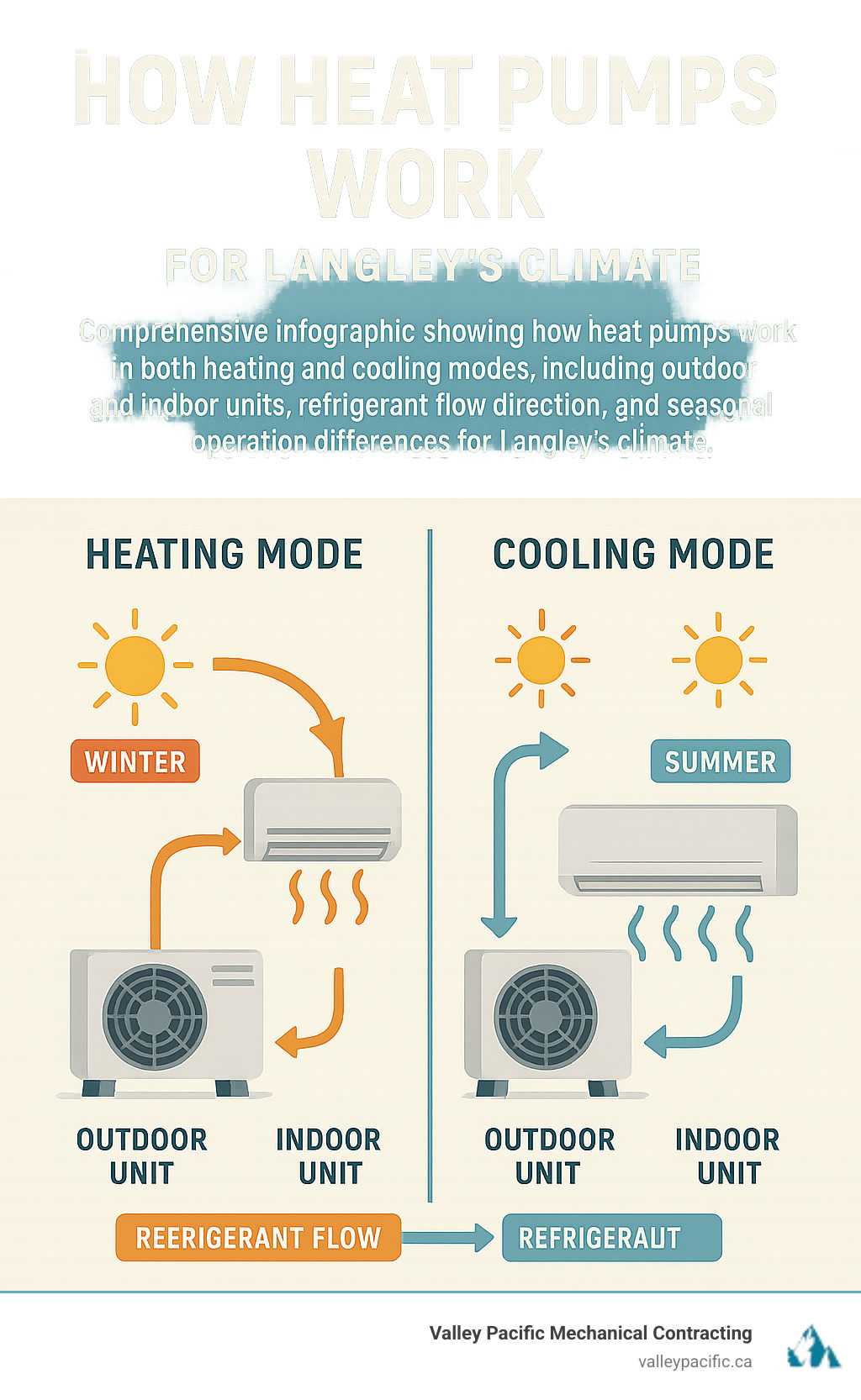
Why a Heat Pump is the Smart Choice for Your Langley Home
If you're a Langley homeowner weighing your HVAC options, the answer is becoming clearer every day: a heat pump is the smartest choice for our unique climate. Langley's moderate climate, with its mild winters and warm summers, creates the perfect operating conditions for these versatile and highly efficient systems to shine all year long.
Think about our local weather patterns. We require both reliable heating and effective cooling, but not to the extremes that many other parts of Canada demand. Heat pumps were practically designed for this balanced environment, offering a single, neat solution for year-round comfort.
What makes a heat pump so brilliant? Instead of the traditional method of burning fuel to create heat, a heat pump functions more like a heat transporter. It simply moves heat that already exists. In the winter, its advanced technology pulls ambient warmth from the outside air (yes, even when it's chilly!) and transfers it into your home. When summer arrives, the system reverses, extracting unwanted heat from inside your home and moving it outdoors, leaving you with a cool, comfortable living space. Its the ultimate two-in-one system for your house.
This clever heat-moving approach is the key to significant energy savings, which translate directly into lower utility bills month after month. Modern all-climate heat pumps can be up to 50% more efficient than conventional furnaces and air conditioners. In an era of fluctuating energy prices, that's real money staying in your pocket. To understand the metrics youll often see on product specs, check out SEER (Seasonal Energy Efficiency Ratio) for cooling and HSPF (Heating Seasonal Performance Factor) for heating.
The environmental benefits are just as compelling. By consuming less energy and eliminating the on-site combustion of fossil fuels, heat pumps produce far fewer greenhouse gas emissions than traditional furnaces. By making the switch, you are actively reducing your home's carbon footprint and contributing to a healthier planet. Its a true win-win: superior comfort thats also kind to the environment. This aligns perfectly with nationwide initiatives like the Canada Greener Homes Grant, which encourages homeowners to adopt energy-efficient upgrades.
What we love most about heat pump service langley requests is helping homeowners accept the simplicity and convenience of dual-functionality for heating and cooling. Say goodbye to juggling a separate furnace and air conditioning system, each with its own maintenance schedule and potential for failure. One streamlined heat pump handles all your comfort needs, simplifying upkeep and reducing potential headaches.
If you're curious about making the switch, our blog post on Consider Heat Pump Installation Reasons dives deeper into the advantages. You can also learn more about year-round comfort through our Heat Pump AC page.
To help you see the bigger picture, here's how heat pumps stack up against traditional systems:
| Feature | Heat Pumps | Traditional Furnace & AC |
|---|---|---|
| Efficiency | Up to 50% more efficient; moves heat rather than creates it | Less efficient; burns fuel or uses resistance heating |
| Operating Costs | Lower monthly utility bills due to high efficiency | Higher energy costs, especially with fossil fuel price fluctuations |
| Environmental Impact | Significantly lower emissions; eco-friendly operation | Higher carbon footprint from fuel combustion and energy use |
Beyond the dollars-and-cents, homeowners consistently cite practical comfort benefits that improve everyday living:
- Quieter operation thanks to variable-speed compressors and indoor fans, reducing start/stop bursts of noise.
- Better temperature stability with gentle, longer run times that minimize swings between too hot and too cold.
- Optional zoning with ductless or multi-zone systems to tailor comfort by room or floor.
- Improved indoor air quality through continuous filtration and dehumidification in summer months.
- Smart thermostat compatibility for scheduling, energy monitoring, and remote control.
The bottom line? Heat pumps offer eco-friendly operation that's perfectly matched to our local climate, delivering a level of comfort and savings that traditional systems simply can't match. By choosing a qualified installer, you ensure your system is eligible for all available rebates and performs efficiently for its entire lifespan. And because correct sizing and installation quality matter as much as the equipment itself, a professional assessment will confirm the right capacity, electrical requirements, and airflow design so you can enjoy reliable comfort through both cool, damp winters and warm, dry summers.
Why Commercial HVAC System Checks Are Critical for Your Business
A HVAC system check involves a thorough inspection of your heating, ventilation, and air conditioning components to ensure optimal performance, energy efficiency, and safety. For commercial properties, this means examining everything from thermostats and air filters to electrical connections and refrigerant levels.
Essential HVAC System Check Components:
- Thermostat calibration and operation
- Air filter inspection and replacement
- Electrical connections and controls
- Refrigerant levels and leak detection
- Ductwork integrity and airflow
- Safety controls and heat exchanger condition
- Condensate drain functionality
- Blower motor and fan operation
When your commercial HVAC system fails during peak hours, the consequences ripple through your operation. Uncomfortable employees are less productive, customers leave, and energy bills skyrocket. A minor issue can quickly become a major business disruption.
Regular HVAC system checks prevent these costly surprises. Annual inspections reduce repair needs and improve energy efficiency, catching small problems before they become expensive emergencies. Well-maintained systems operate more efficiently, using less energy and extending equipment lifespan.
The stakes are particularly high for commercial properties. A cracked heat exchanger poses serious safety risks due to potential Carbon Monoxide leaks. Ductwork problems can cause 20-30% of conditioned air to be lost, directly impacting your bottom line. These issues don't announce themselves - they develop quietly until they cause major problems.
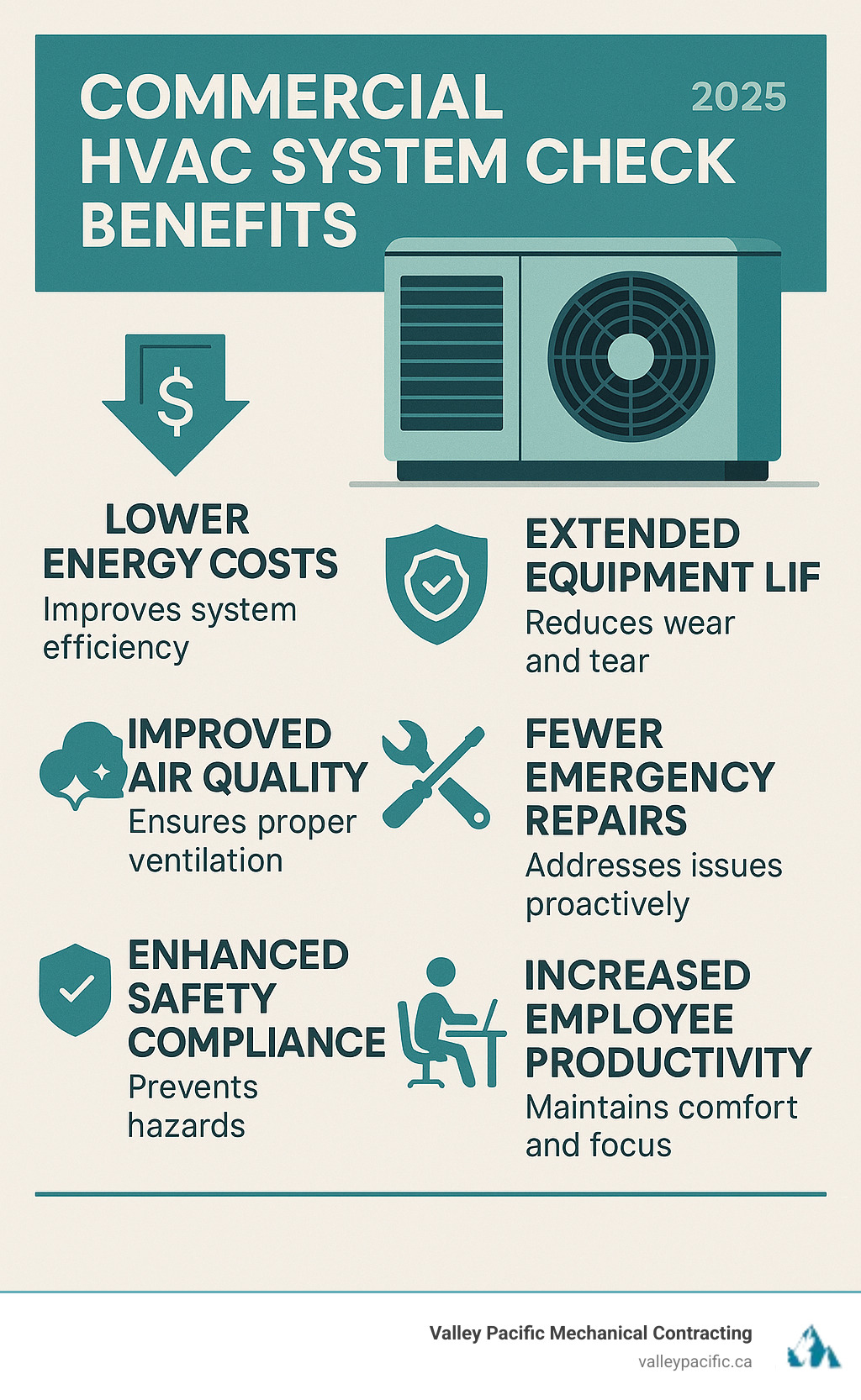
Why Regular HVAC Checks are Non-Negotiable for Your Business
Your HVAC system is likely the last thing on your mind when business is running smoothly. But that quiet hum keeps your operation comfortable, productive, and profitable. When it stops, everything else can grind to a halt.
Regular HVAC system checks are essential for any business wanting to avoid nasty surprises. Like a doctor's checkup, catching problems early saves you from major headaches and bills down the road.
The importance of maintenance goes beyond just keeping things running. A well-maintained system delivers significant cost savings through improved energy efficiency. Systems with regular attention use less energy, which translates directly to lower utility bills.
System longevity is another huge win. Proper care can add years to your commercial HVAC equipment's life, helping you avoid the cost of a premature, unexpected replacement.
Your Indoor Air Quality (IAQ) depends on a clean system. Dirty filters and coils don't just waste energy; they circulate dust, allergens, and harmful particles throughout your workspace.
Many business owners don't realize warranty preservation requires documented maintenance. Skipping regular checks can void your warranty, leaving you to pay for covered repairs. Our Seasonal Heat Pump Maintenance Tips can help.
Preventing major breakdowns is where maintenance really pays off. Ignored small issues like loose connections or minor leaks can become catastrophic failures. These often happen during extreme weather when you need your system most. Watch for HVAC System May Fail Soon: Signs to stay ahead of trouble.
Don't forget legal compliance. Many commercial properties must meet specific maintenance and safety standards, especially for gas equipment. Regular inspections ensure you meet all necessary codes.
The High Cost of Neglect
Ignoring your HVAC system is like playing Russian roulette with your business. The consequences hit hard and fast when things go wrong.
Unexpected downtime can shut down your operation. A restaurant losing AC during a heatwave or an office without heat in January means lost revenue, missed deadlines, and frustrated clients.
Expensive emergency repairs are the reality of neglect. Sudden failures mean overtime charges, rush orders for parts, and premium rates. These fixes often cost far more than routine maintenance.
Reduced equipment lifespan means buying replacements years earlier than planned. Poorly maintained systems wear out faster, creating a massive, unplanned capital expense. Check out these Signs You Need a New AC Installation.
Higher utility bills sneak up on you. Dirty components and inefficient operation force your system to work overtime, consuming more energy. These inflated bills eat away at your profit margins.
Uncomfortable employees and customers create problems beyond temperature. Poor conditions kill productivity and morale. For customer-facing businesses, discomfort drives people away and damages your reputation.
Most seriously, potential safety hazards put lives at risk. A cracked heat exchanger can leak deadly carbon monoxide, and faulty electrical components can cause fires. No responsible business owner can ignore these risks.
The ROI of Proactive Maintenance
Smart business owners know regular HVAC system checks are an investment that pays dividends, not an expense.
Lower energy consumption delivers immediate savings. Well-maintained systems operate at peak efficiency, using less power. Many businesses find these savings alone cover their maintenance costs within a year.
Fewer repair calls mean fewer disruptions and predictable expenses. Catching small problems during routine inspections helps you avoid emergency breakdowns that happen at the worst times.
Extended system life protects your capital investment. Consistent HVAC maintenance can add years to your equipment's lifespan, delaying replacement costs and allowing for better financial planning.
Budget predictability gives you peace of mind. A solid maintenance plan helps you anticipate HVAC expenses and avoid shocking repair bills. Our Maintenance Plan makes this easy.
Improved air quality and health benefits everyone. Clean systems mean cleaner air, leading to fewer sick days, better productivity, and a more pleasant environment for all.
Manufacturer warranty compliance protects your investment. Most warranties require documented professional maintenance. Skipping it can leave you on your own for expensive repairs. Our Comprehensive Heat Pump Service Plans ensure you stay compliant.
The bottom line: Proactive maintenance is the difference between smooth operations and costly surprises.
Your Comprehensive Commercial HVAC System Check Checklist
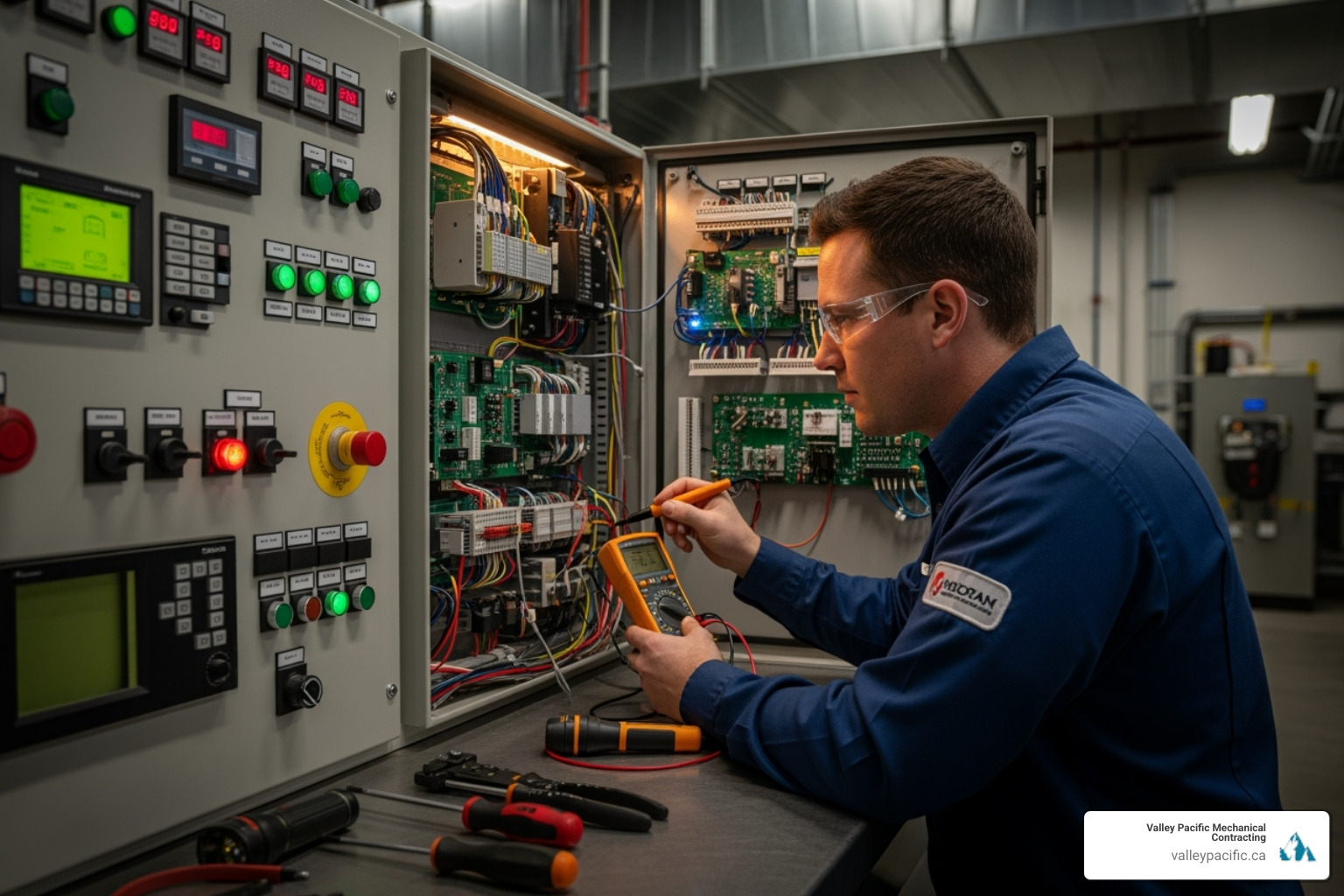
Think of your HVAC system check like a medical exam for your building. Some tasks are fine for your team, while others need a professional's trained eye. The key is knowing which is which.
A comprehensive inspection involves two task categories. The first includes routine checks your staff can handle safely with basic training as a front-line defense. The second requires specialized equipment and professional experience.
This approach gives you the best of both worlds. Your team catches obvious issues early, while trained technicians handle complex diagnostics and safety-critical inspections.
DIY HVAC System Check: What Your Team Can Handle
Your internal team plays a crucial role in maintaining your HVAC system between professional visits. These tasks can catch problems before they become expensive emergencies.
Thermostat verification: Check that thermostats match your business schedule and desired temperatures. Use an independent thermometer to compare readings. If they're off by more than a few degrees, your system may be overworking.
Air filter inspection and replacement: A dirty air filter is a common problem. A clogged filter forces your system to strain. Check filters monthly and replace them at least every 90 days, or more often in dusty environments.
Visual inspection of units: Regularly walk around your equipment. Look for loose panels, strange smells, unusual condensation, or visible damage. This is your first line of defense.
Clearing debris from outdoor units: This is crucial after storms or in the fall. Keep at least two feet of clearance around condenser units. Gently rinse coils with a garden hose; avoid pressure washers which can cause damage.
Checking for unobstructed vents and registers ensures proper airflow. Furniture, equipment, or stored items often block vents, creating hot/cold spots and forcing your system to work overtime.
Condensate drain checks prevent water damage and mold. Look for standing water in drain pans or clogs. If accessible, flush the drain line with white vinegar every few months to prevent buildup.
Listening for unusual noises: Rattling can mean loose connections. Slapping sounds may suggest something is in the blower. Squealing often indicates worn belts or parts needing lubrication. These are early warnings of developing issues.
When to Schedule a Professional HVAC System Check
While your team handles routine monitoring, the technical heart of an HVAC system check requires professional expertise and specialized equipment.
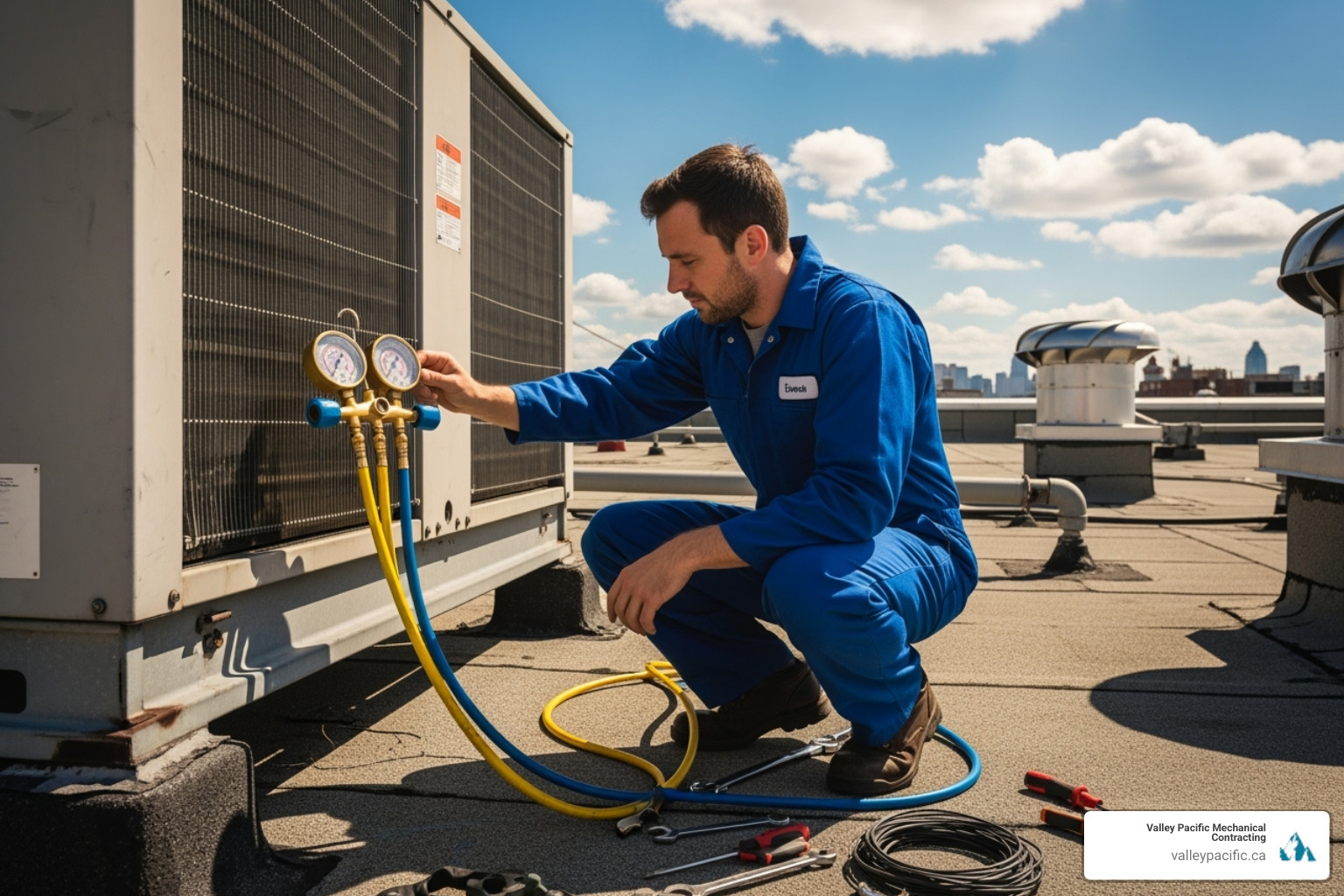
Electrical connections pose serious safety risks. We inspect all wiring, contacts, capacitors, and relays for wear or corrosion. Faulty components can cause system failures, tripped breakers, or fires—this is not a DIY task.
Blower components need detailed inspection and lubrication. We check the blower wheel, bearings, and moving parts. A failing blower motor can shut down your entire system.
Refrigerant levels and leak detection: Low refrigerant almost always indicates a leak in a closed system. We precisely measure levels, use specialized equipment to find leaks, and perform proper repairs. Watch for signs heat pump refrigerant is low between visits.
Ductwork inspection reveals hidden profit drains. Leaky ducts can waste 20-30% of conditioned air, often in inaccessible areas. We inspect the entire system and seal any breaches.
Coil cleaning requires professional techniques. Dirty coils reduce efficiency, and improper cleaning can cause damage. We restore their heat exchange capabilities safely.
Safety control testing protects your property and occupants. High-limit switches, pressure switches, and flame sensors must function perfectly. Our expert heat pump repair services include rigorous testing of these critical systems.
Gas pressure and piping tests are essential for gas systems. We check pressures, inspect for leaks, and verify proper combustion. This work requires professional certification for safety.
Heat exchanger inspection is a critical safety check. Cracks in this component can leak deadly carbon monoxide into your building. This inspection requires specialized equipment and training to detect life-threatening problems.
Common Issues Uncovered & Their Business Impact
During a professional HVAC system check, we often find problems that have been quietly undermining your business. While seemingly minor, their cumulative impact on your bottom line, comfort, and safety can be staggering. Understanding these common issues highlights the value of proactive maintenance.
Ductwork Leaks: The Silent Profit Killer
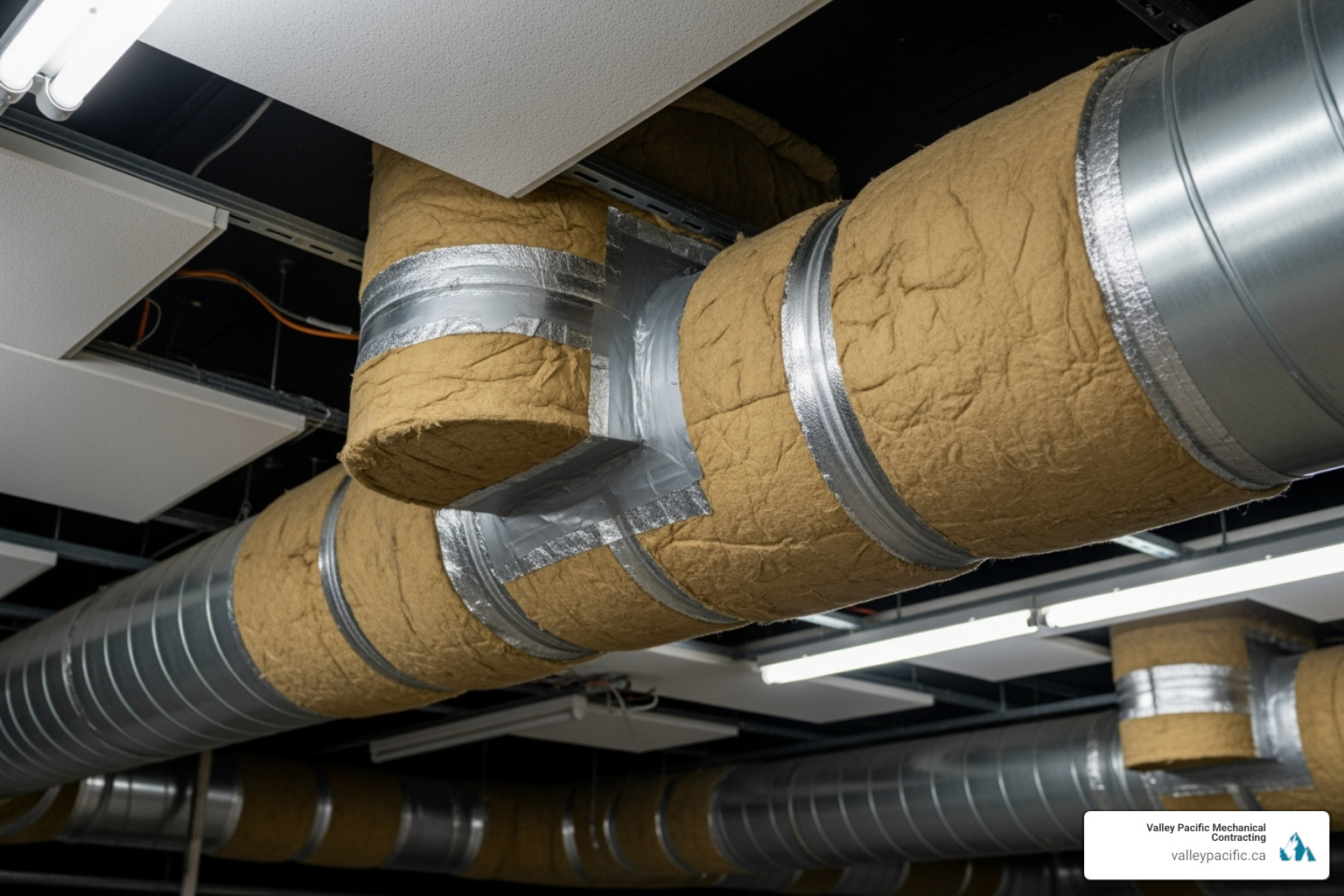
Imagine paying to heat or cool your building, but up to 20-30% of that conditioned air escapes through leaky ductwork into ceilings or walls. It's like filling a bathtub with the drain open—inefficient and costly.
Energy loss from ductwork leaks is a major profit killer. Your HVAC system works overtime to compensate, driving up energy bills. Sealing ductwork can cut heating and cooling costs significantly.
The comfort issues are also frustrating. Inconsistent temperatures create hot and cold spots, leaving employees and customers uncomfortable. Some rooms may be sweltering while others are chilly, regardless of thermostat settings.
Worse, leaky ducts create poor air quality. Gaps pull in dust, insulation fibers, and contaminants from unconditioned spaces, circulating polluted air throughout your building and affecting health and productivity.
Increased operational costs go beyond energy waste. The constant strain on your system wears out expensive components like compressors and blower motors, leading to more breakdowns and a shorter equipment lifespan.
The Heat Exchanger: A Critical Safety Check
A gas furnace's heat exchanger keeps dangerous combustion byproducts separate from your building's air. When this component fails, the consequences can be deadly.
Cracked heat exchangers develop from the metal expanding and contracting over time. Even small cracks create a severe safety hazard, as carbon monoxide can leak into your building's air supply.
Carbon monoxide poisoning can be fatal. The CDC reports hundreds of deaths from carbon monoxide poisoning annually. This colorless, odorless gas gives no warning, making professional inspections critical.
If we find a cracked heat exchanger during an HVAC system check, we must immediately shut down the system. There is no temporary fix; the furnace is unsafe until the heat exchanger is replaced, which often means replacing the unit. For reliable furnace services in Maple Ridge, BC, our team prioritizes your safety.
Refrigerant and Electrical Faults
These are two of the most common and devastating problems we find. Both can bring your system to a halt unexpectedly.
Low refrigerant levels are a sign of trouble. An AC system is a closed loop and shouldn't need refrigerant "topped off." Low levels mean there's a leak. Adding refrigerant without fixing the leak is wasteful and irresponsible.
When refrigerant is low, your system struggles to cool. This is a major problem during summer, when your AC might stop cooling during heatwaves. The compressor works harder, consuming more energy and wearing out faster.
Worn electrical contacts and tripped breakers can be early warnings of bigger problems. Loose connections cause frustrating intermittent operation. Electrical faults can also cause your AC to run constantly without cooling properly.
The worst-case scenario is compressor damage. The compressor is the heart of your cooling system, and replacing it is one of the most expensive HVAC repairs. Many electrical and refrigerant issues are precursors to compressor failure. Catching them early saves thousands and prevents unexpected shutdowns.
Frequently Asked Questions about Commercial HVAC Inspections
Commercial property managers and business owners have many questions about maintaining their HVAC systems. With over 30 years in business, we've heard most of them. Here are the most common questions we get about commercial HVAC system checks.
How often should our commercial HVAC system be inspected?
The short answer is twice a year, every year. We recommend biannual inspections for commercial HVAC systems to keep equipment running smoothly.
Spring inspections prepare your cooling system for summer. We check refrigerant levels, clean coils, inspect electrical components, and verify thermostat accuracy. This prevents AC failure during the first heatwave.
Fall inspections focus on your heating system, preparing it for winter. We perform critical safety checks on heat exchangers and gas lines, inspect burners, and test ignition systems to prevent you from being left in the cold.
Some businesses, like restaurants, busy retail stores, or manufacturing facilities, are high-usage environments that benefit from more frequent checks. The harder a system works, the more care it needs.
Always follow manufacturer's recommendations. Their maintenance schedules are designed to preserve warranty coverage. Our Comprehensive Heat Pump Service Plans are designed to meet these requirements and keep your system running efficiently.
How much does a professional HVAC inspection cost?
This is a common and fair question, as no business likes expense surprises.
The cost for a professional HVAC system check depends on several factors. Basic tune-ups are more affordable, focusing on essential tasks. Comprehensive inspections involve detailed diagnostics and are a higher investment, especially for larger properties or multiple units.
Cost is influenced by system size and complexity. A small office with one unit differs from a multi-story building with several. The number of units affects time and effort, as does uncovering issues that need immediate attention.
Businesses consistently find that routine inspections pay for themselves through lower energy bills, fewer emergency repairs, and longer equipment life. It's a smart investment. We also offer service agreements to make budgeting easier.
If cost is a concern, we offer Financing to help manage your budget. Contact us for a personalized quote to discuss what works for you.
How long does a commercial HVAC inspection take?
Business owners want to minimize disruption. The good news is most comprehensive inspections take one to three hours per system, and we work to minimize impact on your operations.
Several factors affect timing. Multiple systems take longer, as each unit needs a thorough assessment.
Accessibility matters. Units that are hard to reach, requiring special equipment or maneuvering, take more time to inspect safely and thoroughly.
The condition of your equipment also plays a role. Well-maintained systems are quicker to assess. If we find a significant issue, like a cracked heat exchanger, we'll need more time for diagnostics and to explain our findings.
Finally, detailed reporting is part of our service. We document our findings, recommend repairs, and provide a comprehensive report on your system's health. This is valuable for warranty purposes and future planning.
Ensure Your Business Runs Smoothly with Expert Care
Your business deserves an HVAC system that works flawlessly. A proactive maintenance strategy with regular HVAC system checks is essential for protecting your investment and ensuring your workplace is comfortable and safe for everyone.
Your HVAC system works tirelessly to maintain the perfect environment for employees and customers. Investing in regular maintenance is protecting your investment in your business's future. Preventive care saves you the headache and expense of emergency breakdowns.
Ensuring comfort and safety is more than temperature control. A well-maintained system provides clean air, prevents dangers like carbon monoxide leaks, and creates a thriving environment. Employees stay focused, customers have a positive experience, and you gain peace of mind.
Partnering with experts makes all the difference. At Valley Pacific Mechanical Contracting, we've offered stress-free HVAC maintenance for over 30 years. We understand the challenges commercial properties face in Mission, Maple Ridge, Langley, and the Lower Mainland. Our goal is a 'headache-free' experience so you can focus on your business.
What sets us apart is our commitment to be there when you need us. Our 24/7 emergency service means we're always a phone call away, because emergencies don't follow a convenient schedule.
We stand behind our work with the Daikin Comfort Promise, ensuring every job meets the highest standards. Choosing Valley Pacific Mechanical Contracting means choosing 30 years of expertise, modern solutions, and genuine care for your business.
Don't wait for warning signs to think about your HVAC system. The best time to schedule your commercial HVAC system check is before you need it. Let our experienced team give your system the attention it deserves, so you can have confidence your business is in expert hands.
Ready for proactive care? Contact Us today to find out why so many Lower Mainland businesses trust us to keep their operations running smoothly, comfortably, and efficiently.
When Your Furnace's Brain Stops Working
Furnace circuit board repair can save you hundreds of dollars compared to full replacement - but knowing when to tackle it yourself versus calling a professional makes all the difference.
Quick Answer for Furnace Circuit Board Issues:
- Common symptoms: Furnace won't start, blower runs constantly, intermittent operation
- Main causes: Cracked solder joints, failed relays, power surges, age-related wear
- DIY repair cost: $10-50 for components vs $200-600+ for replacement
- Safety first: Always turn off power at breaker and take photos before disconnecting wires
- When to call pros: Complex electrical issues, gas line work, or if you're unsure about safety
Your furnace control board is the brain of your heating system, regulating the entire heating sequence. When this critical component fails, your whole house can go cold.
The good news is that many control board problems stem from simple issues like cracked solder joints, a common failure mode. A simple relay replacement or basic soldering can often restore function to a board that would cost hundreds to replace.
What matters most is understanding the difference between a repair you can safely handle and one that requires professional expertise. This decision protects both your family's safety and your wallet.

Is Your Furnace Control Board the Culprit? Symptoms and Diagnosis
When you wake up to a cold house despite turning up the thermostat, a failing control board is a likely culprit. Maybe your furnace won't start at all, or the blower fan runs constantly. These frustrating scenarios often mean your furnace's "brain" is malfunctioning, which can leave you shivering and your energy bills skyrocketing.
If your furnace won't start despite hearing a click from the thermostat, the control board may be the issue. Sometimes the blower runs constantly, which can be caused by a relay stuck in the "on" position.
Intermittent operation is another telltale sign. The furnace starts, runs for a few minutes, then randomly shuts down. More concerning symptoms include a gas smell without ignition; if you smell gas, the board might not be sending the right signals. Always treat gas odors as an emergency. You might also hear clicking sounds without ignition, meaning the board isn't completing the startup sequence.
Visual inspection is your first detective tool for furnace circuit board repair diagnosis. Pop open that access panel and look for the obvious troublemakers. Burn marks or discoloration on the board are dead giveaways that something got way too hot. Bulging capacitors - those little cylindrical components - should sit flat and neat, not puffed up like tiny balloons.
The sneakiest culprit is often cracked solder joints. These hairline fractures are incredibly common, especially around the bigger components like relays and connectors. Fractured solder joints on appliance control boards are commonplace, and your furnace's constant vibration makes this problem even more likely.
Modern furnaces make diagnosis easier with diagnostic LED lights that blink in specific patterns - like Morse code for HVAC technicians. These error codes tell a story about what's going wrong inside your system. Checking for power with a multimeter can help you trace where the electrical flow gets interrupted, though this requires some electrical know-how.
Before you blame the control board entirely, it's smart to rule out other issues first. A dirty air filter can cause overheating that mimics control board failure. A faulty flame sensor or pressure switch can create similar symptoms. Our guide on signs your HVAC system may fail soon can help you spot these broader warning signs.
Common Causes of Control Board Failure
Control boards usually fail for specific reasons:
- Age and wear: Electronic components simply wear out over time.
- Power surges: Voltage spikes from lightning or grid fluctuations can fry sensitive circuitry.
- Water damage: Leaky condensate lines or high humidity can cause corrosion and short circuits.
- Clogged filters causing overheating: Restricted airflow makes the furnace run hotter, stressing electronic components.
- Vibration: Constant shaking can loosen connections and crack solder joints.
- Rodent damage: Pests can chew through wires near the control board.
- Stuck relays: These electromechanical switches can get dirty or fused over time.
How to Read Diagnostic Error Codes
Your furnace control board speaks to you through blinking lights - you just need to learn its language. Most boards have diagnostic LED lights that flash in specific patterns when something goes wrong.

Locating the code chart is your first step - check for a small sticker on the control board itself or inside the furnace access panel. Your owner's manual is another reliable source for this decoder ring.
Matching blink patterns requires a bit of patience. Watch the LED carefully - it might flash twice, pause, then repeat, or flash rapidly several times before going dark. Each pattern tells a different story about what's happening inside your furnace.
Common codes for board failure vary by manufacturer, but pressure switch errors and flame sensor faults are frequent culprits. Some codes directly indicate control board problems, while others point to component failures that the board is simply reporting.
Understanding these blinking messages gives you valuable insight into whether you're dealing with a simple component replacement or a more complex control board issue. It's like having a conversation with your furnace - once you know what it's trying to say, you can decide on the best course of action.
A Step-by-Step Guide to Furnace Circuit Board Repair and Replacement
While it may seem complex, many furnace circuit board repair jobs are manageable if you are methodical and prioritize safety. A patient, systematic approach is key to success, preventing a simple repair from becoming an expensive mistake. When done right, you'll save money and gain the satisfaction of a successful home repair.
Safety First: Essential Precautions
Working with electrical components in a gas appliance is serious business, as your furnace combines electricity and natural gas. Before opening the access panel, follow these essential safety precautions.

- Turn off power at the breaker: This is non-negotiable. Find the circuit breaker for your furnace and flip it to "OFF." Don't trust the furnace's power switch alone.
- Verify no power with a multimeter: Use a voltage tester to double-check that no electricity is flowing to the furnace. Test multiple connection points on the control board to be certain.
- Disconnect the gas supply if necessary: If your repair involves work near gas lines or you feel uncertain, shut off the gas valve leading to your furnace.
- Use an anti-static wrist strap: Protect delicate electronic components from static electricity, which can fry a circuit board.
- Take photos of everything: This is your most important tool. Snap pictures from multiple angles, getting close-ups of each connection before you begin.
How to Remove the Furnace Control Board
Once safety is handled, you can begin removing the board. This requires careful attention to detail.
- Locate the board: It's usually in the lower furnace section near the blower motor and looks like a small motherboard.
- Remove access panels: Unscrew or unclip the panels to get clear access, keeping track of all screws.
- Label wires and connectors: Rely on your photos. Disconnect one wire at a time, taking more photos as you go. This is more reliable than tape labels.
- Disconnect wire harnesses: Pull gently on the plastic connectors, not the wires. A slight wiggle can help dislodge them.
- Release the mounting hardware: Unclip or unscrew the board from its mountings. Handle the board by its edges to avoid touching components.
Performing a Simple Furnace Circuit Board Repair
This is where you can save hundreds of dollars, as many failures are simple issues you can fix with basic tools and a steady hand.

- Look for cracked solder joints: These are the usual suspects, appearing as thin rings around component leads, especially on larger parts like relays.
- Gather your soldering tools: You'll need a soldering iron (25-40 watts), rosin-core solder, and a desoldering tool. Ensure any replacement parts have matching specifications.
- Master the soldering technique: For cracked joints, heat the old solder until it flows and add a tiny bit of fresh solder to create a solid, shiny connection.
- Replace faulty relays: A new relay can cost as little as ten dollars. Remove the old solder, pull out the bad relay, insert the new one (noting its orientation), and solder each pin carefully.
- Clean the board: When finished, gently brush away any flux residue with isopropyl alcohol and a soft brush.
Installing the Repaired or New Board
Your careful documentation is crucial during installation. Do not rush; every connection must be perfect for safe and efficient operation.
- Secure the board: Mount it firmly in its clips or screw holes to prevent wobbling, which can cause intermittent connections.
- Connect wires one at a time: Use your photos as a guide, matching each wire to its correct terminal and ensuring a solid connection.
- Double-check every connection: Before proceeding, verify every connection against your reference photos. A misplaced wire can be dangerous.
- Reconnect all wire harnesses: Press harnesses firmly into their sockets until they click into place.
- Restore power carefully: Replace all access panels, turn the gas supply back on (if you turned it off), and then flip the circuit breaker.
- Test the system: Set the thermostat to call for heat and listen for the normal startup sequence. If it works, you've successfully completed your furnace circuit board repair!
If you encounter any issues or feel uncomfortable, call a professional. Our team at Valley Pacific is ready to help. Check out our heating repair services if you need an expert.
The Big Decision: Repair or Replace Your Furnace Control Board?
Standing in front of your silent furnace with a faulty control board, you're facing one of those pivotal homeowner moments. Do you repair what you have, or start fresh with a replacement? The choice between furnace circuit board repair and replacement isn't just about money. You're weighing cost savings against turnaround time, considering the environmental impact, and thinking about warranty implications.
The Case for Repair: When and How
Repair is often the smart money move, especially for common issues that haven't completely fried the board. Common repairable issues include bad relays, cracked solder joints, blown fuses, and blown capacitors. These are often easy to spot and fix.
Choosing repair offers significant cost-effectiveness, as it's a fraction of the cost of a new board. You also get to keep your original OEM board, ensuring perfect compatibility. Many professional services offer a plug-and-play return, sending back a fully tested board that's ready to install without complex programming.
The Case for Replacement: Choosing the Right Part
Sometimes, though, replacement is the more practical path forward.
Here's how repair stacks up against replacement across the key factors that matter most:
| Factor | Repair | Replacement |
|---|---|---|
| Cost | Lower (components and service fees) | Higher (new board plus installation) |
| Time | May involve shipping time for service | Often quicker if part is available locally |
| Warranty | Varies by repair service | Varies by manufacturer |
| Skill Level | Requires electronics knowledge | Basic wiring skills for DIY |
Replacement becomes necessary when your board has extensive burn damage, multiple fried components, or damaged circuit traces. If the board is too damaged to fix economically, or if replacement boards for older furnaces are no longer manufactured, a new board is the answer. In some cases, universal replacement modules are available.
The time-sensitive factor is also key. In the middle of winter, a locally available replacement board can restore heat faster than waiting for a repair service.
Choosing the right replacement requires some detective work. You'll need to decide between OEM and universal boards. OEM boards are identical to your original and offer the best compatibility. Universal boards work across multiple models but require careful checking.
Matching voltage and stages is absolutely critical for safety and proper operation. Your new board must match your furnace's voltage requirements and heating stages. Brand compatibility also matters, so always verify using your furnace's complete model number. If you need help finding furnace parts for your model, we're here to guide you through the process.
Key Considerations for DIY Furnace Circuit Board Repair
While DIY furnace circuit board repair is possible, it comes with real risks you need to understand upfront.
- Potential for further damage: A misdiagnosis or incorrect technique can turn a simple fix into an expensive disaster.
- Warranty implications: Unauthorized repairs can void your manufacturer's warranty, a costly mistake on newer furnaces.
- Safety hazards: Working with electricity and gas lines creates real risks of shock, leaks, and fire if safety protocols aren't followed perfectly.
- Incorrect part selection: Using a part with the wrong specifications can cause immediate failure or long-term problems.
- Diagnostic complexity: The issue may not be the control board. Without proper tools, you might replace a perfectly good part.
When to call a professional becomes the smart choice for complex electrical issues, anything involving gas line work, or simply when you're not feeling confident about the process. Your safety and your family's comfort are worth more than the money you might save on a DIY attempt.
At Valley Pacific Mechanical Contracting, we've spent over 30 years helping families in Mission, Maple Ridge, and Langley keep their homes comfortable. If you're feeling uncertain about tackling this yourself, don't hesitate to contact us for professional guidance. Sometimes the most empowering decision you can make is knowing when to call in the experts.
Frequently Asked Questions about Furnace Control Board Repair
We know that dealing with a broken furnace can feel overwhelming, especially when you're trying to figure out if the control board is the culprit. After helping countless homeowners across Mission, Maple Ridge, and Langley over the past 30+ years, we've heard just about every question imaginable. Here are the ones that come up most often.
How much does it cost to repair a furnace circuit board?
The cost for furnace circuit board repair is typically much more budget-friendly than a full replacement. Professional repair services are reasonably priced, while a new board can cost significantly more for the part alone, plus installation.
If you're handy, a DIY component replacement can be very inexpensive. For example, a new relay can be a small part that restores your entire system. The final cost depends on the problem's complexity, your furnace's age, and whether you DIY or hire a pro.
Can I replace my furnace circuit board myself?
Absolutely - but there's a big "if" here. If you're comfortable working with electrical components, follow safety rules religiously, and have the patience to be methodical, this can be a DIY project.
The secret to success? Those detailed photos we keep harping about. Seriously, you cannot take too many pictures before disconnecting anything. We've seen too many homeowners get halfway through a project only to stare at a tangle of wires, wondering where everything goes.
That said, there's no shame in calling for backup. Working with electricity and gas appliances carries real risks. If you feel uncertain at any point, or if the problem seems more complex than a straightforward board swap, professional installation is always the safest bet. Your family's safety is worth more than any potential savings.
How long does a furnace control board last?
Most furnace control boards are built to go the distance - typically lasting anywhere from 10 to 20 years. But like any hardworking component, several factors can either extend or shorten their lifespan.
Power surges are probably the biggest enemy of control boards. A lightning strike or electrical grid fluctuation can fry sensitive components instantly. That's why many homeowners invest in whole-house surge protection - it's like insurance for all your electronics.
Heat and moisture are also troublemakers. A clogged air filter forces your furnace to work harder, creating excess heat that stresses the control board. Water leaks from condensate lines or high humidity can cause corrosion and short circuits.
Don't forget about vibration either. Every time your furnace kicks on, it creates tiny vibrations that can gradually loosen solder joints over time. This is especially common around larger components like relays.
The good news? Regular maintenance goes a long way toward protecting your control board. Simple things like changing filters regularly, addressing water leaks promptly, and keeping the area around your furnace clean and dry can significantly extend its life. A well-maintained control board means your entire furnace runs more efficiently and reliably, saving you from those middle-of-winter breakdowns that nobody wants to deal with.
Conclusion: Taking Control of Your Home's Comfort
Understanding your furnace is empowering. You've now gained valuable insight into furnace circuit board repair, from diagnosis to deciding between repair and replacement. This knowledge helps you feel more in control when your furnace acts up.
You know how to spot symptoms, read diagnostic codes, and approach the problem safely. The potential for cost savings is real, but the confidence from making informed decisions is just as valuable.
Safety must always come first. We cannot stress this enough. Always disconnect power at the breaker, verify with your multimeter, and take those detailed photos before touching a single wire. These simple precautions protect both you and your furnace from costly mistakes.
There's no shame in knowing your limits. While DIY repairs can be incredibly rewarding, recognizing when a job requires professional expertise is crucial. Some problems are simply too complex or dangerous to tackle without proper training.
At Valley Pacific Mechanical Contracting, we've helped Lower Mainland families stay comfortable for over 30 years. Serving Mission, Maple Ridge, Langley, Pitt Meadows, and Coquitlam, we offer a headache-free experience with honest advice, quality work, and 24/7 emergency service.
Don't leave your comfort to chance. Whether you DIY a simple fix or need professional help, taking action is key. Request a quote for your furnace installation needs or reach out for expert advice on any heating challenge you're facing. Your warm, comfortable home is worth the investment.
A furnace that turns on and off more often than it should might seem like a small glitch. But in many Langley homes, short cycling is one of the earliest signs that something in the system is not right. Short cycling happens when a furnace starts up, runs for a short period, and shuts off before reaching the desired temperature, only to turn back on again soon after. This constant cycling is not just annoying. It can wear out parts faster, waste energy, and leave rooms feeling colder than they should be.
Many homeowners in Langley notice the problem when energy bills increase or when certain parts of the home do not stay warm for long. The problem may seem like it is just the weather or old insulation, but short cycling needs attention before it leads to a full breakdown. Recognizing the signs and understanding what might be behind this issue is the first step to getting your furnace back on track before colder fall temperatures settle in deeper.
Common Causes Of Furnace Short Cycling
A furnace does not randomly start turning off before a heating cycle finishes. There is always a reason, and it often comes down to air movement, thermostat control, or sizing issues. If short cycling is happening in your home, one of the following could be the cause:
- Dirty or clogged air filters: When a filter gets stuffed with dust and debris, airflow into the furnace drops. This leads to overheating, which triggers the furnace's safety limits, causing it to shut off early and restart once it cools down.
- Thermostat problems: A thermostat that is miscalibrated or installed in a poor location, like near a heat source or direct sunlight, can give wrong temperature readings. This causes the furnace to cycle more often than needed because it thinks the house is warmer or cooler than it really is.
- Incorrect furnace sizing: A furnace that is too large for the home will heat the space quickly and shut down prematurely, often before evenly heating the rooms. That might sound like a good thing, but it leads to repeated cycling that damages the system over time. On the other hand, undersized units strain to meet the thermostat’s set point, creating more frequent on-off cycles.
For example, one Langley homeowner noticed their furnace cycling on and off every few minutes last September. After a technician checked the system, it turned out the filter had not been changed in over a year. Once replaced, the unit returned to normal operation. Something as simple as that can make a big difference.
Warning Signs Of Furnace Short Cycling In Langley Homes
Short cycling does not always come with loud noises or fierce temperature changes, making it tricky to spot until it gets worse. Watch for these warning signs around your Langley home:
1. The furnace turns on and off often: If your furnace clicks on, runs for just a couple of minutes, and then shuts down, repeating the same pattern over and over, it is likely short cycling.
2. Higher gas or electric bills: A system turning on and off too often runs inefficiently. If your energy use has jumped but your usage habits have not, check the furnace.
3. Uneven heat around the home: Some rooms may feel warm, while others remain cold. This happens when a furnace does not stay on long enough to circulate enough warm air through all the vents.
Short cycling puts extra wear on components like motors and heat exchangers, which can lead to bigger problems during the colder months. Paying attention to these red flags can help prevent a sudden breakdown when you need your furnace working the most.
The next step is figuring out what actions to take and when it is time to have our professionals look into the issue. Short cycling will not fix itself, and over time, it only gets worse.
Potential Solutions and When to Call Our Professionals
Once you have spotted the signs of short cycling, your next question is likely, can you do anything about it? Some steps can be taken at home, but major issues need expert attention. Here is how to break it down.
Start with the basics:
- Check and replace your furnace filter if it has not been swapped in the past one to three months.
- Take a look at your thermostat settings. Make sure it is set to heat, on auto, and away from direct sunlight or heat-producing devices.
- Ensure air vents throughout the house are clear. Blocked vents can trap heat and cause temperature control problems.
If you have done these simple checks and your furnace is still cycling too often, the issue could be more complex. You might be dealing with a malfunctioning heat sensor, damaged limit switch, or deeper airflow restriction. These are not problems that can be easily diagnosed without training and the right equipment. In some cases, the entire furnace system has been incorrectly sized for the home, especially if major renovations or additions have been made since installation.
That is when it is important to call our technicians. They will be able to test each part of the system, locate the issue, and offer real solutions, whether that is adjusting the current setup or recommending repairs or updates.
Ensuring Efficient Furnace Operation for Your Langley Home
Ongoing maintenance can go a long way in preventing short cycling and other common furnace issues. It is not about reacting when problems pop up, but putting steps in place that help your system stay reliable all season long.
Here is what we recommend for Langley homeowners:
- Replace furnace filters regularly, usually every 1 to 3 months depending on the home’s conditions
- Book annual furnace inspections before the heating season begins to catch issues early
- Keep the area around the furnace clear of clutter or stored items to support safe and consistent airflow
- Keep return and supply vents unblocked throughout the home to make sure air moves properly
- Stay alert to new noises, smells, or changes in system behaviour even if they seem minor at first
Taking these small steps helps maintain your furnace’s efficiency, extends its working life, and reduces the chances of costly breakdowns when you need heat the most. Even things like sealing air leaks around windows or doors can help your heating system work less, resulting in fewer cycles.
Keep Your Home Warm and Cozy
Short cycling is more than a minor inconvenience. It is a warning sign that something is not working the way it should inside your heating system. Ignoring it can shorten your furnace’s lifespan and cost more over time through repairs and higher energy use. For homeowners in Langley, acting early can keep heating bills in check while making sure your home stays comfortable during cold months.
Pay attention to how long your furnace runs and how often it restarts. If anything seems off, do not wait until it turns into a bigger issue. Whether it is a quick fix like a clogged filter or something more involved like a system imbalance, early attention can save more than just money. It saves time, stress, and discomfort later on.
If your furnace is showing signs of short cycling and leaving your home unevenly heated, addressing the issue early can help maintain comfort and prevent further damage. If you require furnace repair in Langley, a professional assessment by Valley Pacific Mechanical Contracting Ltd. can keep your system running reliably during the cold months. For a quick estimate or to book a service visit, please contact us today.
When Pipes Fail: Understanding the Urgency of Water Line Emergencies
Burst pipe repair requires immediate action to prevent thousands of dollars in water damage. When a pipe fails, every minute counts, and knowing what to do can mean the difference between a manageable repair and a devastating flood.
Burst pipes often happen without warning. The primary cause is freezing temperatures, where expanding ice puts immense pressure on pipes until they crack or rupture. However, temperature isn't the only culprit; aging pipes, corrosion, high water pressure, and tree root intrusion can also cause sudden failures.
The cost of ignoring a burst pipe escalates quickly. While the repair itself might seem manageable, associated water damage, structural repairs, and potential mold remediation can push total costs into the thousands. That's why understanding both immediate response and long-term prevention is crucial for every homeowner.
This guide will walk you through everything from emergency response to professional repair options, helping you protect your home and minimize both damage and costs.

A Homeowner's First Response: What to Do Immediately When a Pipe Bursts
When you hear the sound of rushing water and find a burst pipe, it's critical to act fast. While the situation is overwhelming, staying calm and following these essential steps can save you thousands in damage and help you regain control.
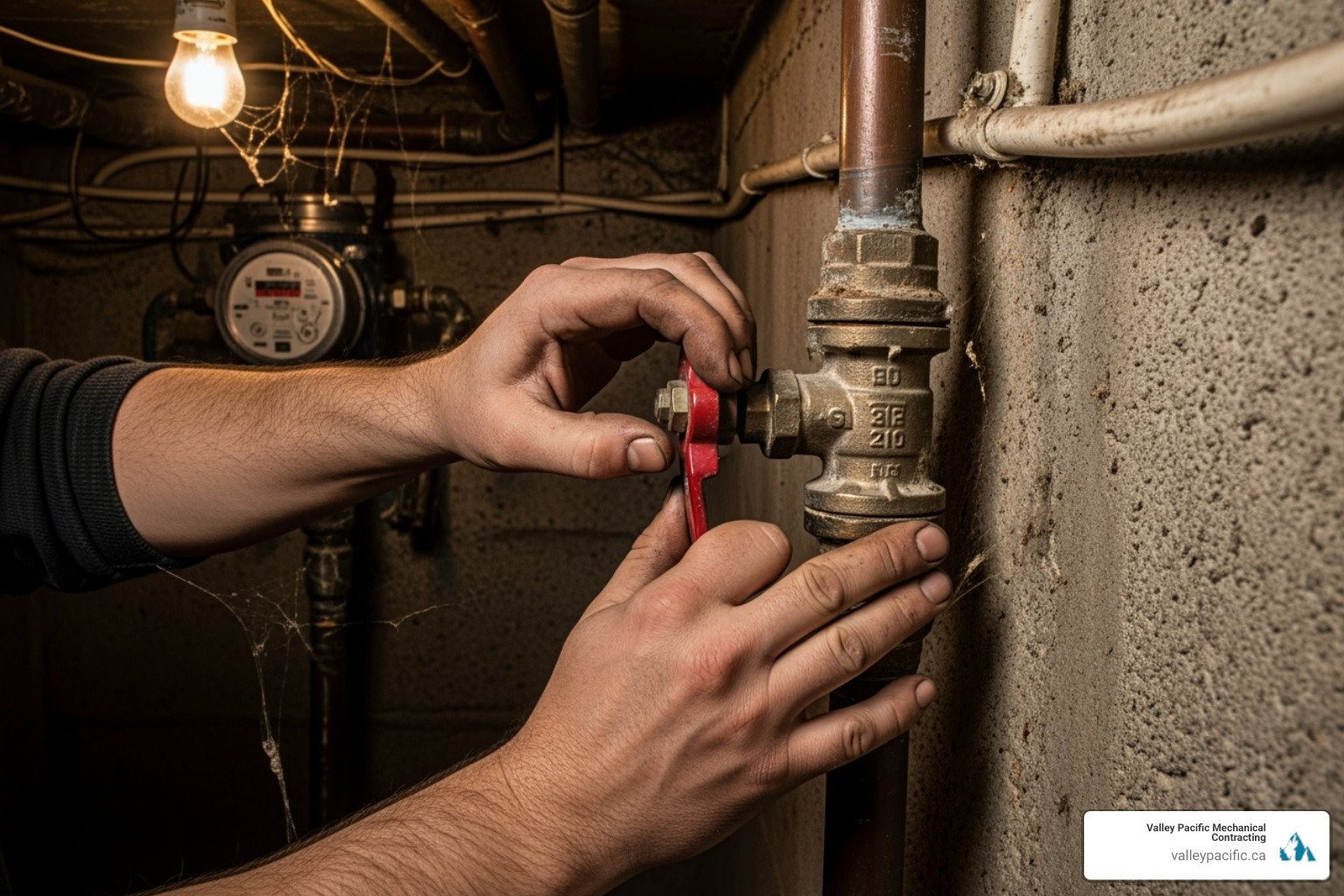
Step 1: Shut Off the Main Water Supply
This is your most important move. Every homeowner should know the location of their main water valve before an emergency. It's typically found where the main water line enters your home, such as the basement, crawl space, or utility room.
Turn the valve clockwise until it stops completely. This may be a quarter turn for a lever or several rotations for a wheel-style valve. Once the main supply is off, release the remaining pressure by opening the lowest faucet in your home, like a basement sink or outdoor spigot. Flush your toilets to empty their tanks and further reduce pressure in the system.
Step 2: Mitigate Immediate Damage
With the water flow stopped, focus on safety. Turn off electricity to any areas where water might reach outlets or appliances. If you're unsure, flip the main breaker to avoid electrical hazards.
Move valuables, electronics, and important documents to a dry area. Then, contain the spill using buckets, towels, and anything absorbent. A wet/dry vacuum is an excellent tool for removing standing water quickly. The faster you remove water, the less chance it has to seep into floors and walls, which helps prevent structural damage and mold growth.
Step 3: Call for Emergency Help
Once you've handled the immediate crisis, it's time for professionals. Burst pipe repair is not a typical DIY project, as underlying issues often require an expert eye. At Valley Pacific Mechanical, we offer 24/7 emergency service because we know plumbing disasters don't wait for business hours.
A professional assessment is crucial to determine if the burst is an isolated incident or a symptom of a larger problem. Our experienced technicians can identify the root cause and recommend the best course of action. When you need reliable help in the Lower Mainland, our Plumbing Services in Maple Ridge BC are designed to get your home back to normal quickly, minimizing damage and ensuring your plumbing system is safe and efficient.
Understanding the Enemy: Common Causes and Telltale Signs of Burst Pipes
A sudden water stain on the ceiling is a homeowner's nightmare, often signaling a burst pipe repair is needed. Pipes don't fail without reason; they often leave clues. Understanding the common causes and telltale signs can help you prevent a disaster.
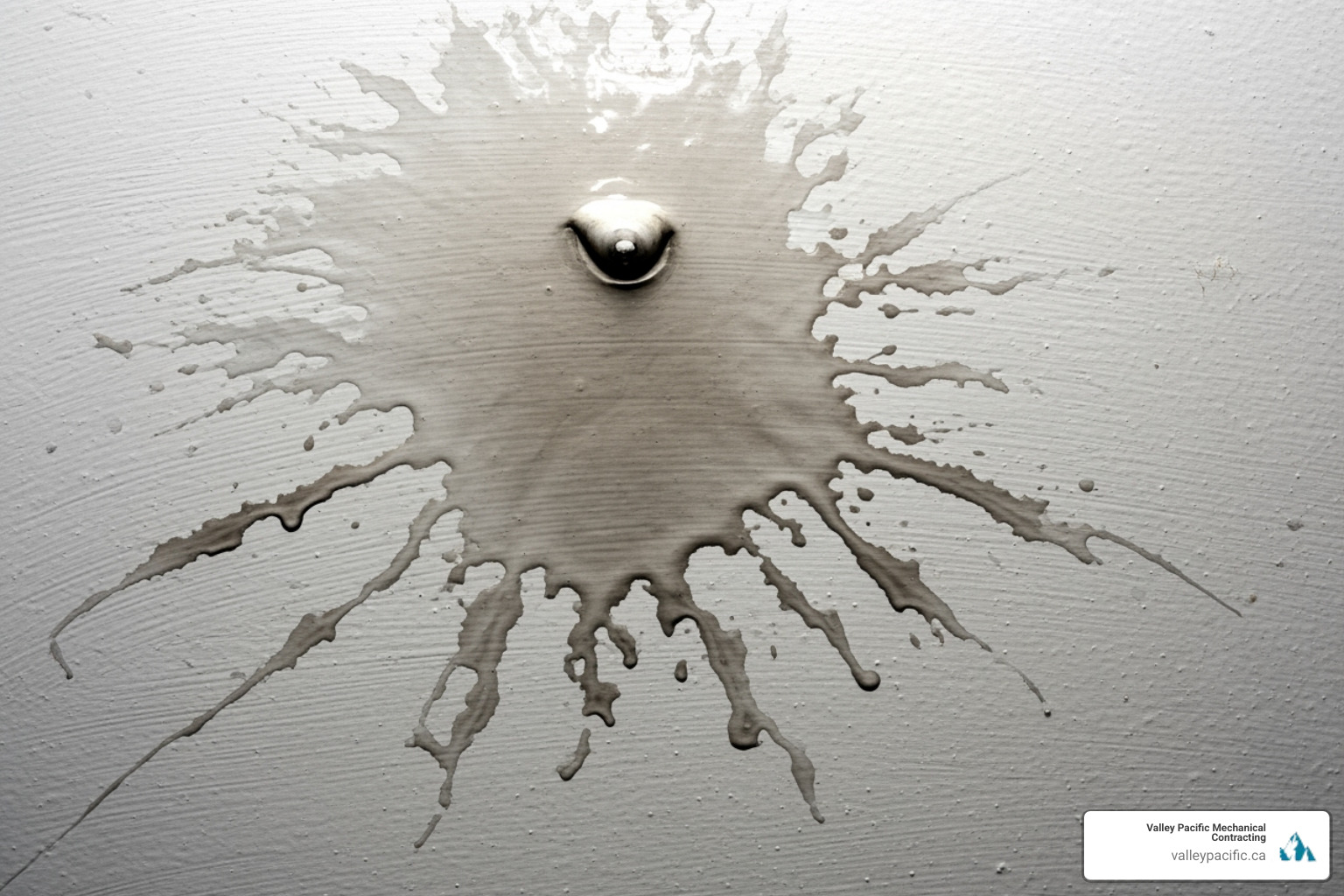
Why Do Pipes Burst?
Pipes can fail for several reasons, and knowing the culprits helps protect your home.
- Freezing Temperatures: As water freezes, it expands, creating immense pressure that can crack pipes. An ice plug blocks flow, causing pressure to build between the plug and a closed faucet, leading to a rupture.
- Corrosion and pH Imbalance: Imbalanced water pH can eat away at pipes from the inside, creating weak spots. Rusty water or a metallic taste are key warning signs.
- Clogs and High Water Pressure: A stubborn clog acts like a dam, causing pressure to build behind it. Similarly, consistently high water pressure puts constant stress on your entire plumbing system.
- Old Pipes: Older pipes are simply more vulnerable. If your home has Poly-B piping, you should seriously consider replacing it before it becomes an emergency. These pipes are known to break down, and older homes may also contain lead pipes, which pose serious health risks.
- Tree Root Intrusion: Tree roots seeking water can invade tiny cracks in underground pipes, growing larger and causing blockages and ruptures.
Signs That a Pipe Has Burst
Sometimes a burst is obvious, but often the signs are subtle. Look out for these clues:
- Fluctuating Water Pressure: A sudden drop or inconsistent pressure can mean water is escaping somewhere.
- Discoloured Water: Brown or rusty water often indicates internal pipe corrosion or that contaminants are entering through a crack.
- Puddles or Damp Spots: Unexplained wet spots on walls, ceilings, or floors are classic signs of a hidden leak.
- Strange Noises: Hissing, dripping, or banging sounds from behind walls can indicate a leak or pressure issues.
- High Water Bill: A sudden, unexplained spike in your water bill is a clear sign of a leak somewhere in your system.
- Musty Smells and Mold: The smell of dampness or visible mold growth in dry areas points to a hidden water source.
Catching these signs early gives you the best chance of addressing the problem before it becomes a full-blown burst pipe repair emergency.
The Professional Burst Pipe Repair Process: What to Expect
Once you've turned off the water and called for help, a professional burst pipe repair follows a clear, methodical process to get your home back to normal. Here’s what you can expect.
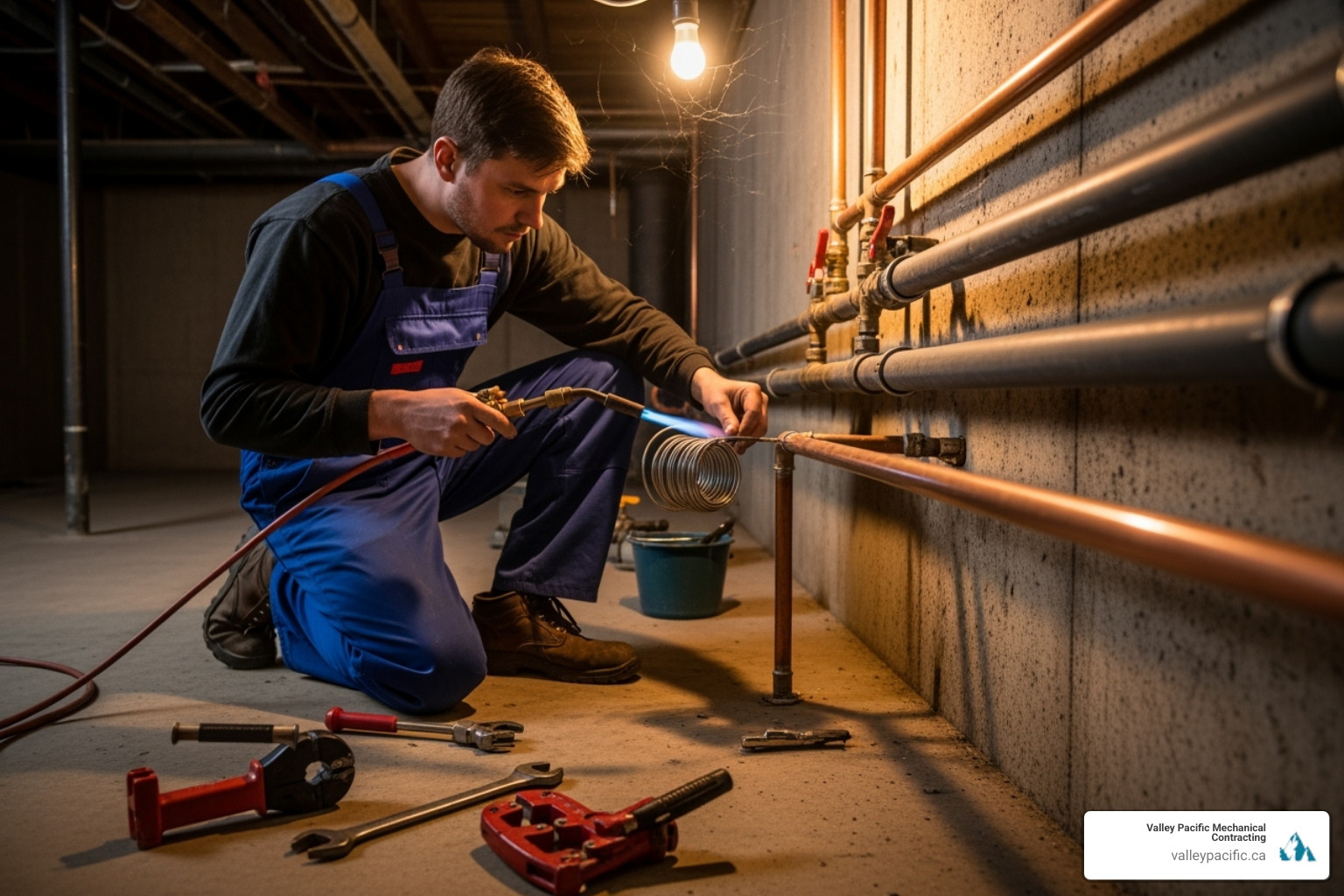
Temporary vs. Permanent Fixes
Temporary fixes can stop a leak in an emergency, but they are not long-term solutions. A professional repair is always necessary to address the underlying issue.
- Pipe clamps: These wrap around the damaged pipe with a rubber gasket to create a watertight seal.
- Epoxy putty: When mixed and applied, this compound hardens into a waterproof seal. You can use epoxy putty on various pipe materials.
- Rubber gaskets and tape: Specialized tape wrapped tightly and secured with hose clamps can provide a quick, temporary seal.
These are stopgap measures. Skipping a permanent, professional repair often leads to bigger problems later.
Understanding the Cost of Burst Pipe Repair
Burst pipe repair costs vary based on several key factors:
- Location: An exposed pipe in a basement is easier and cheaper to fix than one hidden behind a wall or under a floor, which requires demolition and restoration.
- Extent of Damage: A small pinhole leak is less costly to repair than a long section of a ruptured pipe.
- Pipe Materials: Copper, PEX, and PVC require different tools and techniques, affecting labor and material costs.
- Emergency Timing: After-hours or weekend emergency calls cost more than repairs scheduled during regular business hours.
- Additional Expenses: Costs can increase significantly with water damage cleanup, drying services, mold remediation, and structural repairs like replacing drywall or flooring.
We provide a transparent breakdown of all expected costs after our assessment and before starting work.
When to Replace a Drain Pipe Instead of Repairing It
Sometimes, replacement is more cost-effective than repeated repairs. Consider replacement if you have:
- Age: Old cast iron or clay drain pipes are often brittle and prone to failure.
- Frequent Clogs: If you need constant drain cleaning, the pipe itself may be sagging, corroded, or damaged.
- Visible Corrosion or Damage: Widespread rust or multiple cracks indicate the pipe's integrity is compromised. This is critical in older homes that may still contain lead pipes, which pose health risks.
- Tree Root Intrusion: If roots have invaded your pipes, they will likely return unless the vulnerable pipe section is replaced.
While replacement is more involved upfront, it provides long-term peace of mind and prevents future emergencies.
Proactive Prevention: How to Protect Your Home from Future Pipe Bursts
Nobody wants to deal with a burst pipe repair emergency at 2 AM on a Sunday morning. The good news? Most pipe bursts are completely preventable with some simple preparation and regular maintenance. Think of it as giving your plumbing system a little love so it doesn't surprise you with an unwelcome indoor waterfall later.
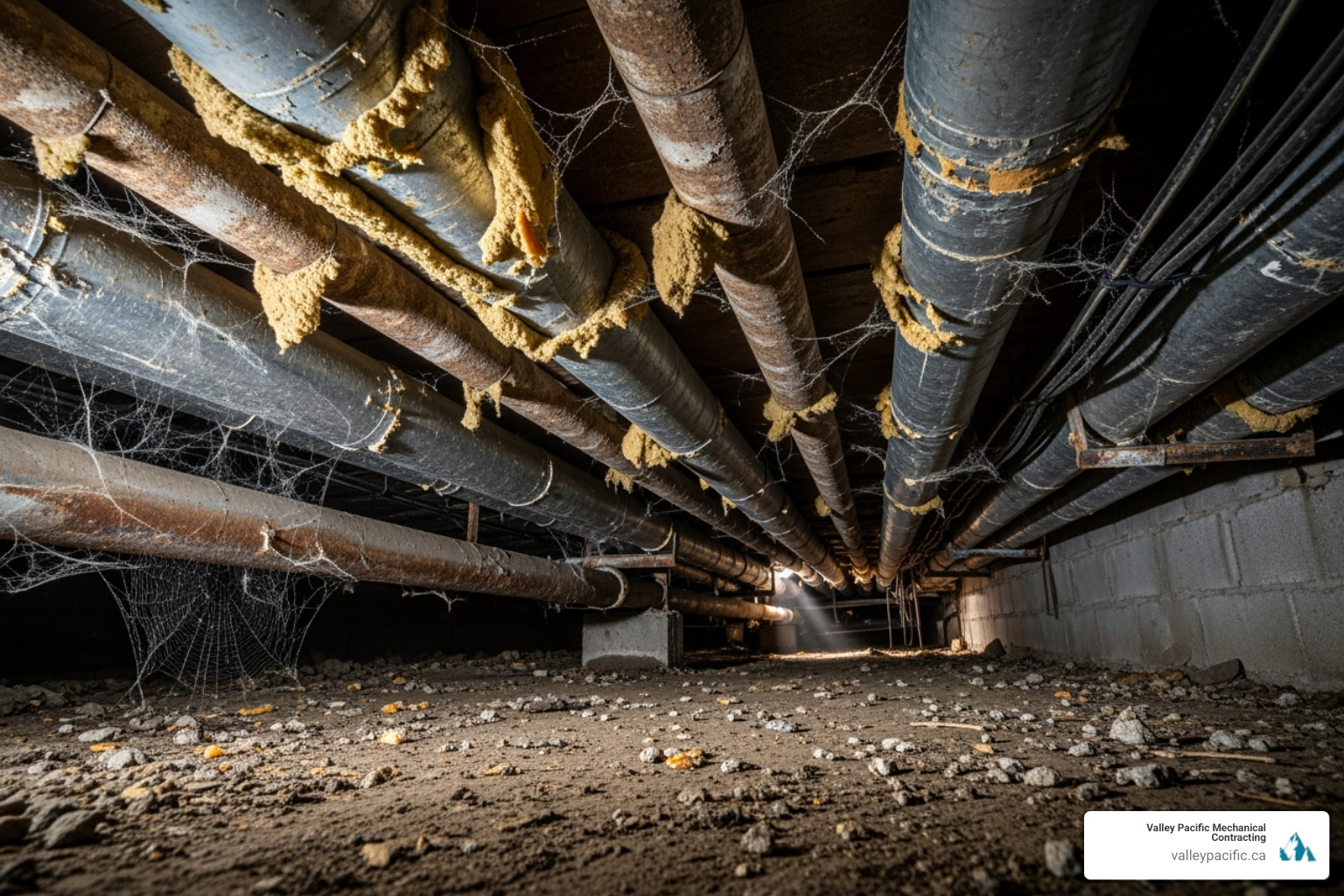
Cold Weather Prevention Tips
Here in the Lower Mainland, we know winter can bring some surprisingly chilly nights. While we might not face the brutal cold of the prairies, temperatures can still drop enough to cause serious problems for unprepared plumbing systems.
Insulating pipes is your first line of defense. Those exposed pipes in your basement, crawl space, or garage need protection from the cold. Foam pipe insulation is inexpensive and easy to install - just slip it over the pipes like a protective sleeve. Pay special attention to pipes along exterior walls, as these are the most vulnerable to temperature drops.
Sealing air leaks around your home makes a huge difference. Cold drafts can turn a manageable temperature drop into a pipe-freezing nightmare. Look for cracks or gaps where pipes enter your home, especially around the foundation. A little caulking now can save you thousands later.
During particularly cold snaps, keeping cabinet doors open under your kitchen and bathroom sinks allows warm air from your home to circulate around the pipes. It might look a bit odd, but it's much better than dealing with frozen pipes.
Don't forget about your outdoor connections. Disconnecting outdoor hoses before winter and shutting off the water supply to exterior spigots prevents water from sitting in these exposed areas where it can freeze and cause damage.
Maintaining consistent home heat is crucial, even when you're away. If you're heading out for a winter getaway, resist the urge to turn the heat way down to save money. Keep your thermostat at least at 13°C (55°F) to protect pipes hidden in walls and floors.
When temperatures drop dangerously low, letting a faucet drip slowly - particularly the one furthest from your main water supply - keeps water moving through the pipes. Moving water is much less likely to freeze solid than standing water.
If you're experiencing heating issues, like problems with your boiler, don't wait to address them. A properly functioning heating system is your best friend in preventing frozen pipes. For help with heating troubles, check out our guide on Troubleshooting No Hot Water From Boiler.
Year-Round Plumbing Maintenance
Prevention isn't just a winter activity. A few simple habits throughout the year can keep your plumbing system healthy and help you avoid emergency repairs.
Regular inspections don't require any special skills - just your eyes and a flashlight. Take a quick look under sinks, around your water heater, and in your basement every few months. Look for any signs of moisture, rust, or small leaks. Catching problems early means fixing them before they become expensive emergencies.
Water pressure that's too high puts constant stress on your entire plumbing system. If your showers feel like they could strip paint or your faucets seem overly aggressive, consider having a pressure regulator installed. Your pipes will thank you for the gentler treatment.
Never ignore small leaks, even if they seem harmless. That tiny drip under the bathroom sink isn't just wasting water - it's often a sign that something bigger is brewing. Addressing minor leaks promptly can prevent them from turning into major burst pipe repair situations.
Finally, know your plumbing system. Make sure everyone in your household knows where the main water shut-off valve is located. In an emergency, this knowledge is worth its weight in gold. If you can, also locate the individual shut-off valves for toilets, sinks, and appliances.
Taking these preventive steps might seem like extra work, but they're much easier than dealing with the stress, mess, and expense of a burst pipe. A little prevention today keeps the emergency plumber away tomorrow.
Frequently Asked Questions about Burst Pipe Repair
After helping thousands of homeowners through plumbing emergencies over our 30+ years in business, we've heard just about every question you can imagine. Here are the most common questions about burst pipe repair.
Can a pipe burst even if the water supply is turned off?
Yes, a pipe can burst even when the main water supply is off. Water trapped in your pipes can still freeze, expand, and create enough pressure to cause a rupture. This is especially common in unheated areas like crawl spaces or along exterior walls. While shutting off the water is the correct first step for an active flood, it doesn't eliminate the risk from freezing conditions.
How long does a typical burst pipe repair take?
The repair time depends entirely on the pipe's location and the extent of the damage. An easily accessible pipe in a basement might be repaired in a few hours. However, a pipe hidden behind a finished wall or under flooring will take much longer, as it requires cutting into surfaces for access and then patching them afterward. Significant water damage requiring drying and restoration can extend the overall timeline from days to weeks.
What are the consequences of ignoring a leaking or burst pipe?
Ignoring a leak, even a small one, can lead to severe consequences:
- Structural Damage: Water soaks into drywall, wood beams, and insulation, causing rot and weakening your home's structure. It can also create serious fire hazards if it reaches electrical wiring.
- Mold and Mildew: Mold can grow within 24-48 hours in damp conditions, posing health risks, especially for those with asthma or allergies.
- High Water Bills: A constant leak, no matter how small, will cause your water bills to skyrocket.
- Foundation Issues: Persistent leaks near your foundation can erode the soil, leading to settling, cracks, and costly structural instability.
Promptly addressing any leak is the best way to avoid these massive, expensive headaches. That's why we offer 24/7 emergency service—plumbing problems don't wait.
Secure Your Home with Expert Plumbing Solutions
When water is gushing from your pipes at 2 AM, you need more than just a plumber - you need a trusted partner who understands the urgency and stress you're facing. A burst pipe repair emergency isn't just about fixing the immediate problem; it's about restoring your peace of mind and protecting your home from future disasters.
Finding the right plumbing professional makes all the difference between a nightmare experience and a smooth resolution. Look for a company that offers genuine 24/7 emergency service (not just an answering machine), has extensive experience with burst pipe situations, and provides transparent pricing upfront. You want professionals who arrive equipped with the right tools and parts, not someone who needs to make multiple trips to the hardware store while your home floods.
Experience matters tremendously when it comes to emergency plumbing. A seasoned professional can quickly assess whether you need a simple repair or a more extensive pipe replacement, potentially saving you thousands in unnecessary work. They'll also spot potential problems that could cause future bursts, helping you avoid repeat emergencies.
At Valley Pacific Mechanical, we've been turning plumbing nightmares into manageable situations for over 30 years throughout the Lower Mainland. Whether you're in Langley, Maple Ridge, Mission, or Pitt Meadows, our team understands that a burst pipe doesn't wait for convenient business hours. That's why we offer true 24/7 emergency service - because your home's safety can't wait until Monday morning.
Our "headache-free" approach means we handle everything from the initial emergency response to coordinating with your insurance company for water damage claims. We arrive with fully stocked trucks, provide honest assessments, and complete most burst pipe repairs in a single visit. Plus, our Daikin Comfort Promise ensures you're getting quality workmanship that lasts.
Don't let a burst pipe turn your home into a disaster zone. When plumbing emergencies strike, you need professionals who combine decades of expertise with genuine care for your property and peace of mind. Contact Us today - because your home deserves protection you can count on.
Why Daikin Heat Pump Service Matters for Your Home's Comfort
Daikin heat pump service is essential for your system's efficiency, lifespan, and your home's year-round comfort. Regular maintenance prevents up to 25% energy waste, protecting your investment and ensuring comfort.
Key Daikin Heat Pump Service Requirements:
- Annual professional servicing by a certified technician
- Monthly filter cleaning (every 1-3 months depending on usage)
- Quarterly outdoor unit cleaning to remove debris
- Immediate attention for unusual noises, reduced performance, or error codes
- Professional inspection of refrigerant levels, electrical components, and safety controls
Your Daikin heat pump works year-round to keep your home comfortable. Without proper care, these systems can consume up to 25% more energy, leading to higher utility bills. The good news is that most maintenance issues are preventable with the right care schedule.
Regular service ensures peak efficiency, stable temperatures, and catches small problems before they become expensive repairs. Professionals check critical components like refrigerant levels and electrical connections that are unsafe for homeowners to handle.
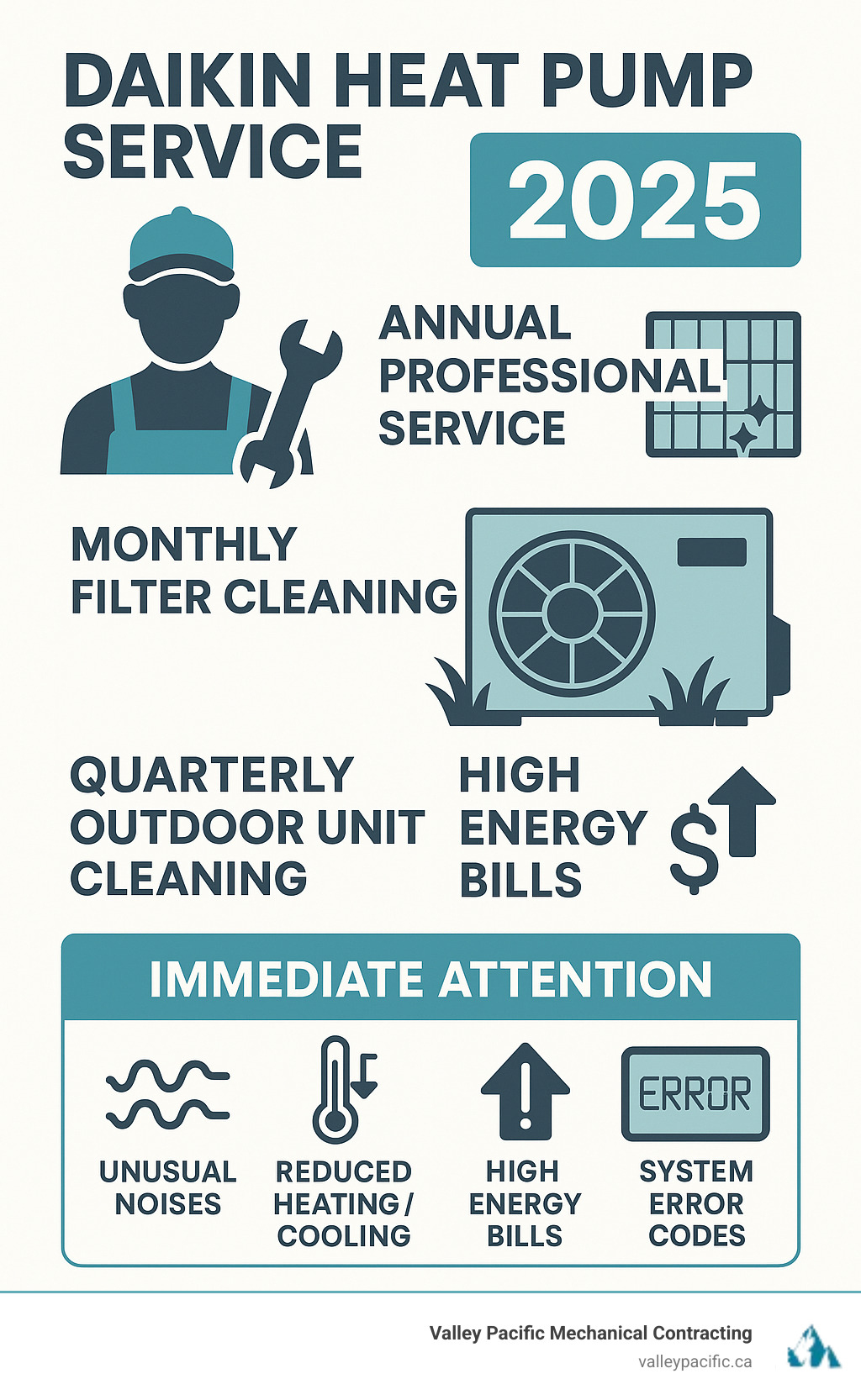
Why Regular Maintenance is Non-Negotiable for Your Daikin System
Think of your Daikin heat pump service schedule like going to the dentist – skipping it leads to bigger problems later. Your Daikin heat pump works tirelessly year-round, but without regular professional attention, this sophisticated system can become an expensive headache.
A neglected heat pump can waste up to 25% more energy than a well-maintained one. Regular maintenance delivers energy savings, lower utility bills, and extends your investment's lifespan.
Professional Daikin heat pump service goes beyond DIY. Technicians check refrigerant levels, inspect electrical components, and test system reliability, protecting your comfort and wallet. Crucially, it prevents costly repairs that happen at the worst times.
The Benefits of Proactive Care
Proactive maintenance on your Daikin system pays off. Peak performance ensures consistent comfort without the system working overtime. You'll enjoy stable home temperatures, eliminating annoying hot and cold spots.
A well-tuned system also has environmental benefits, producing reduced CO2 emissions by using less energy. This keeps utility bills predictable and helps the planet.
Crucially, regular professional service protects your warranty. Daikin requires documented annual maintenance to keep it valid, saving you from paying for repairs that should be covered.
Most importantly, you get genuine peace of mind. You can rest easy knowing your system won't fail during a heat wave or family gathering. While our 24/7 emergency service is always available, proper maintenance makes it unlikely you'll need it.
For seasonal care tips, check out our Seasonal Daikin Heat Pump Maintenance Tips.
The Risks of Neglecting Your System
Skipping maintenance is a gamble with your home's comfort, with consequences that surface at the worst times. Increased energy consumption hits your wallet monthly, as that extra 25% energy usage adds up fast during peak seasons.
Unexpected breakdowns have terrible timing, often occurring during extreme weather when repair services are in high demand. These stressful, expensive calls are avoidable.
Long before failure, you'll notice reduced comfort: weak airflow, inconsistent temperatures, and a system struggling to keep up. Component failure accelerates when parts are overworked, leading to costly repairs like compressor replacement.
Worst of all, neglect can void your warranty. If a major component fails, you'll face the full replacement cost instead of it being covered by your Daikin protection plan.
Don't wait for problems to announce themselves. Learn about Signs Your Daikin Heat Pump Needs Repair. If your system isn't defrosting properly, our guide Why is My Daikin Heat Pump Not Defrosting? can help you understand what's happening.
The Anatomy of a Professional Daikin Heat Pump Service
When you schedule a Daikin heat pump service, you're getting a comprehensive health check-up for your system that goes far beyond what a homeowner can safely do.
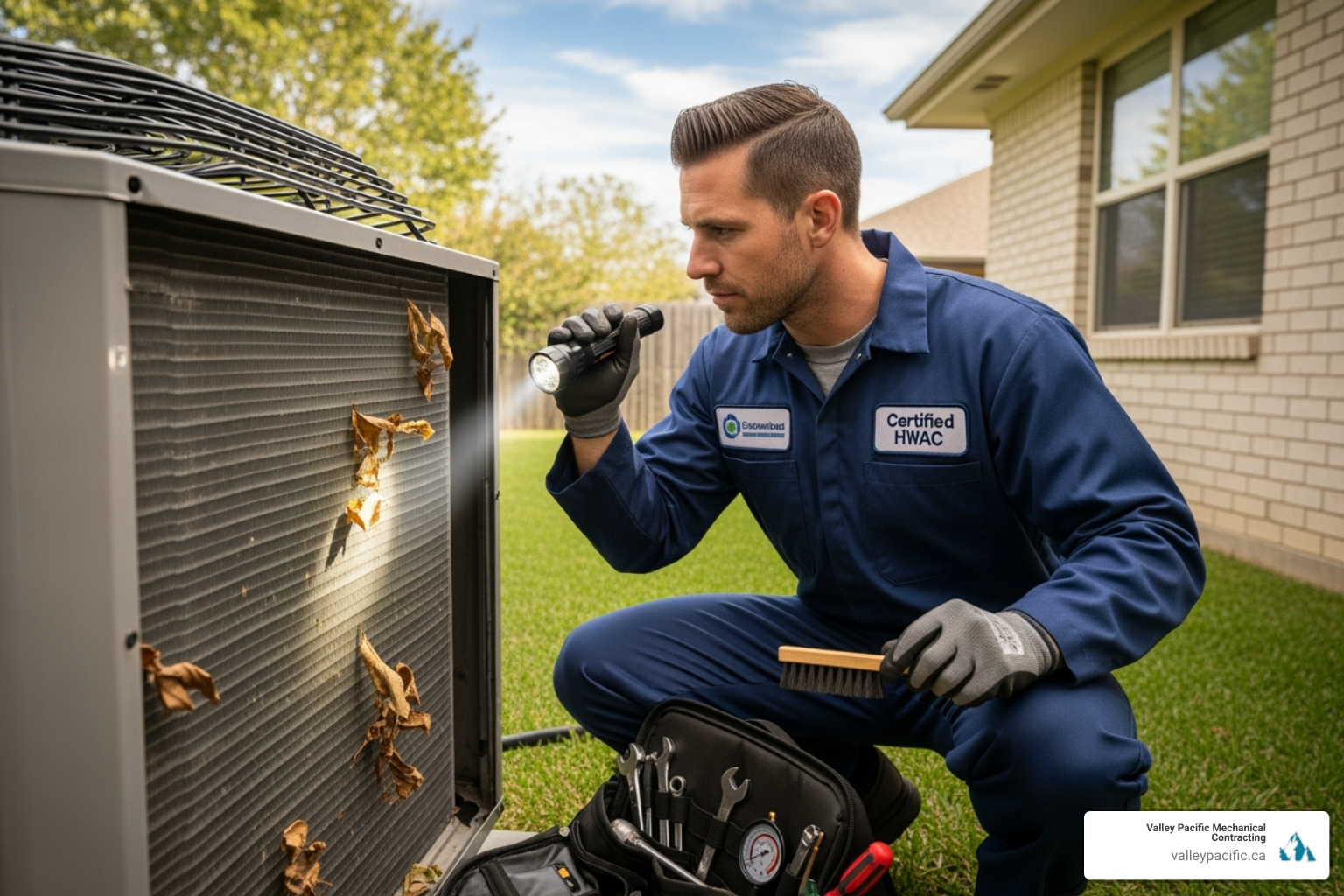
Our inspection starts with detailed system diagnostics using specialized equipment to detect invisible issues. We assess refrigerant levels, as incorrect amounts impact efficiency and lifespan. We scrutinize every electrical component for wear or corrosion that could cause dangerous malfunctions. We also check mechanical parts for wear and vibrations, and comprehensive safety checks ensure your system poses no risk to your family.
Key Components Checked During a Tune-Up
During a tune-up, our technicians methodically check every critical component. We start with air filters, cleaning or replacing them as needed, since clogged filters kill efficiency. We thoroughly clean indoor evaporator coils for optimal heat absorption and outdoor condenser coils to ensure proper heat release. We examine refrigerant lines for leaks and verify levels, as low refrigerant is a common cause of poor performance.
Your blower motor is inspected and lubricated for smooth, quiet operation and proper airflow. We also calibrate your thermostat for accurate temperature readings. The condensate drain is cleared of clogs to prevent water damage and mold. All electrical connections are tightened and inspected, and safety controls are rigorously tested to ensure they'll protect your system when needed.
For advanced diagnostics, we may perform a Megger Test to evaluate your system's electrical integrity, helping spot potential failures before they occur.
What to Expect from a Professional Daikin Heat Pump Service
Book your Daikin heat pump service with Valley Pacific Mechanical for thorough, professional care backed by 30+ years of expertise. We operate with complete transparency, so you always know what we're doing and why.
Service begins with a comprehensive inspection of indoor and outdoor units by our experienced, certified technicians. We then run detailed diagnostics and performance tests, measuring pressures, temperatures, and electrical readings against Daikin's standards.
Our cleaning process is thorough. We clean coils, blower components, and drains to remove dirt, debris, and mold that hinder performance. Moving parts are lubricated to reduce friction, prevent wear, and ensure quiet operation. For smart Daikin systems, we apply any necessary software updates for the latest performance optimizations.
You'll receive a detailed report explaining our work, any issues we found, and our recommendations. These lifecycle reports help you understand your system's health and plan for future maintenance needs. This isn't just about fixing problems—it's about preventing them entirely. Need repairs? Our Expert Daikin Heat Pump Repair Services team is ready to help.
Your Maintenance Schedule: DIY Tasks vs. Professional Service
Maintaining your Daikin heat pump is like car care: some tasks are DIY, while others need a professional. The key is knowing which is which.
Your Daikin heat pump service schedule is a partnership. You handle simple daily upkeep, while our technicians manage complex work requiring special tools. This approach prevents small problems from becoming big ones, as our annual service catches issues you might miss.
| Task Category | Specific Task | Frequency (Homeowner) | Frequency (Professional) |
|---|---|---|---|
| DIY (Homeowner) | Clean/Replace Air Filters | Every 1-3 months | Annually |
| Clear Debris from Outdoor Unit | Quarterly | Annually | |
| Check Thermostat Settings | As needed | Annually | |
| Visual Inspection of Units | Monthly | Annually | |
| Clean Fins, Grilles, Casing (Outdoor) | Every 3-6 months | Annually | |
| Professional Only | Comprehensive System Inspection | Annually | |
| Check/Adjust Refrigerant Levels | Annually | ||
| Electrical Connection Inspection & Tightening | Annually | ||
| Coil Cleaning (Deep) | Annually | ||
| Blower Motor Inspection & Lubrication | Annually | ||
| Condensate Drain Cleaning (Deep) | Annually | ||
| Safety Control Testing | Annually | ||
| Software Updates & Diagnostics | Annually | ||
| Indoor Wall Unit Deep Clean | Every 3-6 years | ||
| Duct Cleaning (for central systems) | Every 5-6 years |
Simple DIY Maintenance Tasks for Homeowners
DIY maintenance tasks are crucial for day-to-day performance, keeping your system efficient and your bills in check.
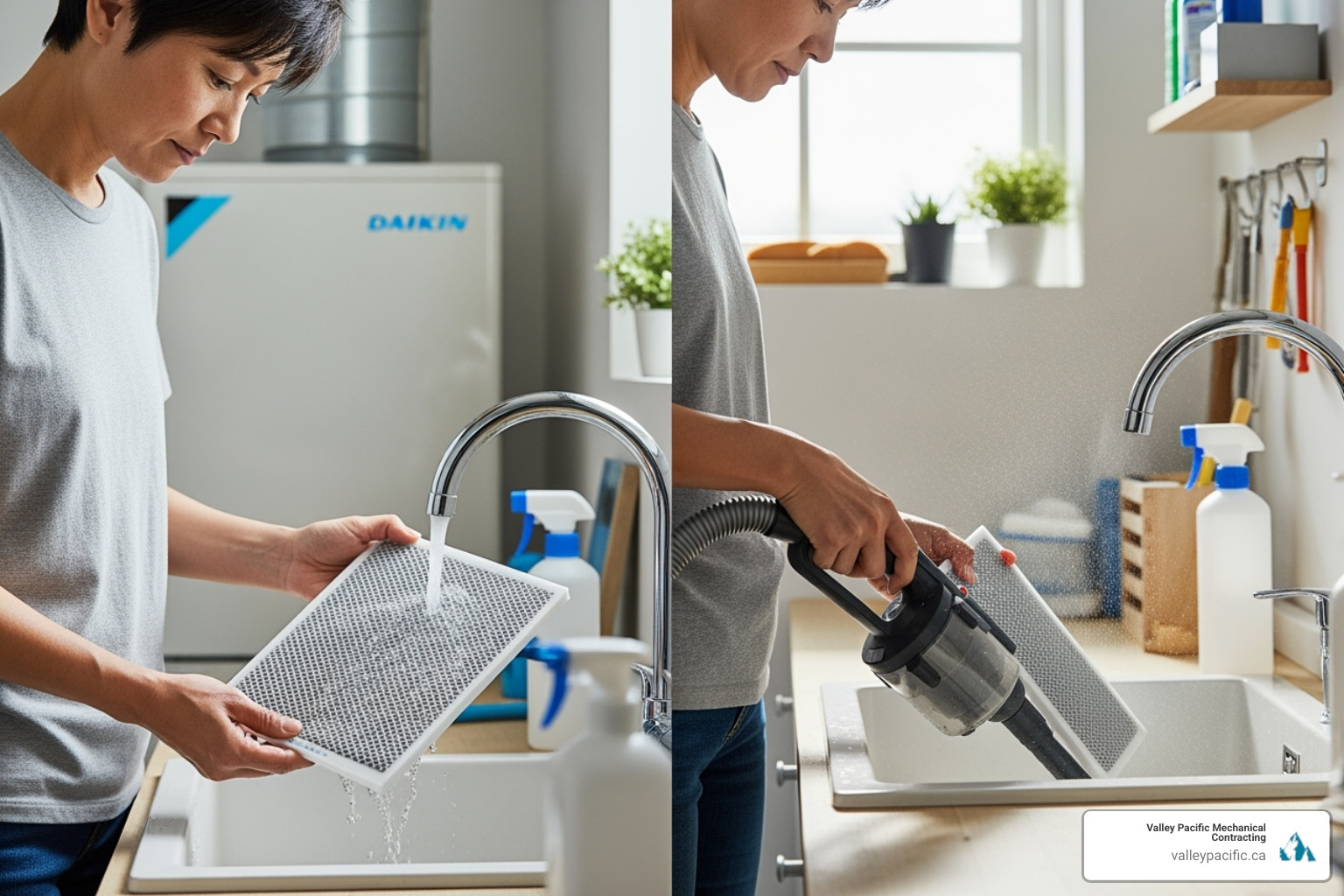
Always turn off the power to your heat pump before starting any cleaning – safety first!
Cleaning air filters is your most important DIY task. Check them monthly (more often with pets or during heavy use). If it's clogged, it's time to clean or replace it. For reusable filters, vacuum gently and wash with warm, soapy water. Ensure they are completely dry before reinserting to prevent mold.
Clearing outdoor unit debris is vital. Every few months, remove leaves, grass, and twigs. Keep at least two feet of clear space around the unit for proper airflow.
Checking thermostat settings is simple but important. Many service calls are resolved by switching from "heat" to "cool" mode.
For helpful tips on where to place your unit for optimal performance, check out our guide on Best Locations for Daikin Heat Pump Placement.
When to Call a Professional for Daikin Heat Pump Service
While DIY care is great, some tasks require a professional. Our certified technicians have the training, tools, and experience to handle complex jobs safely.
Annual servicing is non-negotiable. Even if your system seems fine, our technicians can spot potential issues before they become costly.
Refrigerant issues require a professional due to the specialized handling required. Call us if your system isn't cooling/heating properly or you see unusual ice buildup.
Electrical problems are for professionals only. If you experience tripped breakers, flickering lights, or burning smells, turn off the system and call us immediately.
Strange noises like grinding, squealing, or banging are not normal and signal that your system needs attention.
Poor performance, such as not reaching the set temperature or sudden bill spikes, indicates underlying issues that need professional diagnosis.
Error codes on your display are a call for help. While your manual may offer basic steps, persistent codes require a professional.
When you need expert service in your area, we're here to help with Daikin Heat Pump Repair in Pitt Meadows, BC. We also proudly serve Langley, Maple Ridge, Mission, and Coquitlam with the same headache-free experience you deserve.
Daikin's Commitment to Peak Performance
Daikin provides more than just heat pumps; they offer an ecosystem to ensure your system's peak performance for years. This commitment includes structured maintenance agreements, extended warranty options, and innovative digital platforms connecting you to your system's health and service history.
Daikin's approach focuses on quality assurance. They know ongoing care is key to long-term efficiency and comfort.
Understanding Daikin Maintenance Packages
Daikin offers tiered maintenance packages designed for different needs and budgets, ensuring top-notch Daikin heat pump service.
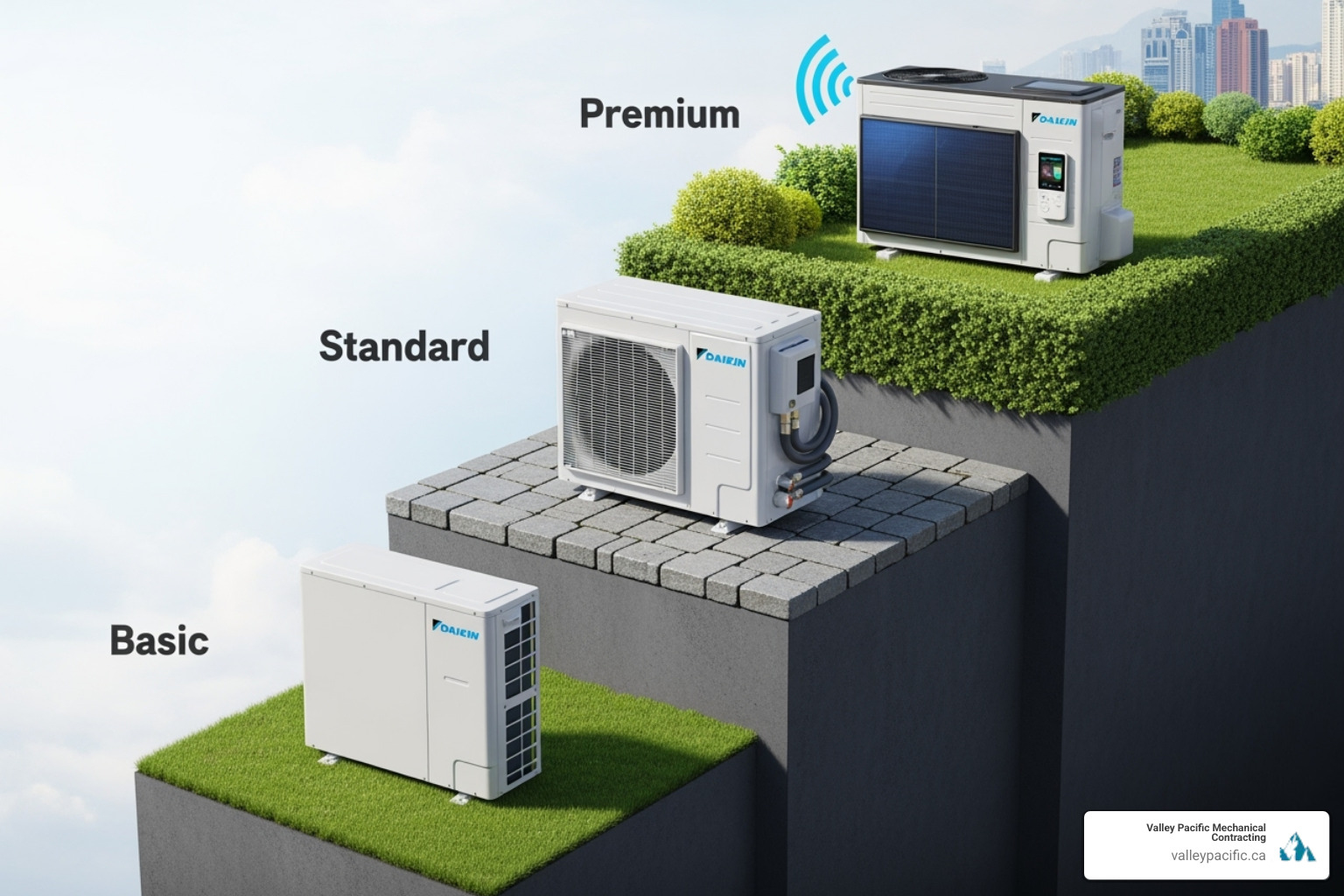
The F-Gas Care package (Bronze) covers essential F-Gas checks for compliance and safety. It includes annual maintenance and covers parts and corrective labor for preventative repairs during visits on units still under warranty.
Step up to Preventive Care (Silver), which adds comprehensive system checks, software updates, and coverage for Daikin spare parts replaced due to normal wear and tear.
The Exclusive Care package (Gold) offers ultimate peace of mind. It includes all lower-tier benefits plus one free breakdown callout annually and comprehensive coverage on parts and labor for Daikin components.
These packages are designed to prevent issues, ensuring your system operates efficiently and reliably for years.
The 'Stand by Me' Platform: Your Digital Service Hub
Daikin's clever 'Stand by Me' digital platform is your heat pump's personal health record, putting you in control of its care. This helpful platform keeps detailed maintenance records, sends service reminders, and tracks your warranty status, so you never miss a deadline or have to search for paperwork.
Your installer can also access it, giving them your system's history for faster, more efficient service calls. The warranty tracking feature is invaluable, showing what's covered and for how long, potentially saving you significant money on repairs.
Getting started is simple. Use the registration code from your installer to create an online profile and access your system's information and service packages. It's Daikin's way of providing lifelong support.
Ready to take control of your system's care? Register on Stand By Me and find how easy managing your heat pump maintenance can be.
For comprehensive service in your area, we also provide Daikin Heat Pump AC Services in Maple Ridge, BC and throughout the Lower Mainland.
Frequently Asked Questions about Daikin Heat Pump Maintenance
With 30+ years of experience, we've heard every question about Daikin heat pump service. Here are the most common ones. Asking them is the first step to proper system care.
How often should a Daikin heat pump be serviced?
Your Daikin heat pump needs professional service at least once a year. This annual inspection is crucial for performance, warranty validity, and preventing costly repairs. Skipping it often leads to bigger problems.
Between visits, homeowners should clean air filters every 1-3 months and clear debris from the outdoor unit quarterly. These simple tasks significantly impact performance.
What are common signs my Daikin heat pump needs service?
Your heat pump will signal problems. Look for these signs:
- Unusual noises like grinding, squealing, or banging.
- Performance issues, such as struggling to reach or maintain the set temperature or cycling on and off too frequently.
- A sudden spike in energy costs, which often means the system is working too hard.
- Strange odors (burning or musty), frozen coils, or error codes on the display.
- The unit won't turn on at all.
If you notice any of these, it's time for professional help.
Can I service my Daikin heat pump myself?
We encourage DIY maintenance! Cleaning filters, clearing debris from the outdoor unit, and checking thermostat settings are great tasks for homeowners to keep their system efficient.
However, complex tasks involving electrical components, refrigerant, or internal parts must be handled by a certified technician. This is for your safety and to protect your investment. Attempting these tasks without training is dangerous, can damage your unit, and may void your Daikin warranty. DIY repairs can often lead to more expensive problems.
The good news is our team has the training, tools, and 30+ years of experience to handle these tasks safely and effectively, as part of our commitment to a headache-free experience!
Your Local Experts for Daikin Service and Peace of Mind
At Valley Pacific Mechanical, we understand your Daikin heat pump is the heart of your home's comfort and key to manageable energy bills. For over 30 years, we've served homeowners in Mission, Maple Ridge, Langley, Pitt Meadows, and Coquitlam, bringing three decades of real experience to every job.
Our philosophy is to provide a "headache-free" experience. We handle stressful HVAC issues with professionalism, ensuring a smooth process from your first call to job completion. Our commitment to regular maintenance ensures system longevity and optimal performance. We prevent problems, not just fix them, by assessing your entire system's health.
We uphold the Daikin Comfort Promise, delivering the highest standard of service to ensure your investment provides reliable, efficient comfort for years. Life is unpredictable, which is why we offer 24/7 emergency service. We're always here when you need us, but with our proper maintenance, you'll be less likely to call.
Don't wait for a breakdown. Proactive care is better and less expensive than reactive repairs. Your Daikin heat pump is built to last—with the right attention.
Ready to give your system the professional attention it deserves? Contact us today to schedule your service or discuss installation options. We're here to help you enjoy the peace of mind that comes with knowing your Daikin system is in expert hands.
For new installations, explore our Daikin Heat Pump Installation in Maple Ridge, BC services.
When Your Furnace Breaks Down in Abbotsford: Quick Help Guide
When you need furnace repair abbotsford services, finding the right help fast is crucial for your comfort and safety, especially during our cold, wet winters. A failing furnace can lead to frozen pipes, health risks, and expensive emergency repairs.
Emergency Signs You Need Immediate Repair:
- Strange smells (especially gas odors)
- Loud banging or grinding noises
- No heat during cold weather
- Yellow pilot light instead of blue
- Carbon monoxide detector alarms
Abbotsford has experienced HVAC professionals who understand our local climate challenges. Recognizing early warning signs and knowing who to call can save you money, stress, and sleepless nights in the cold.
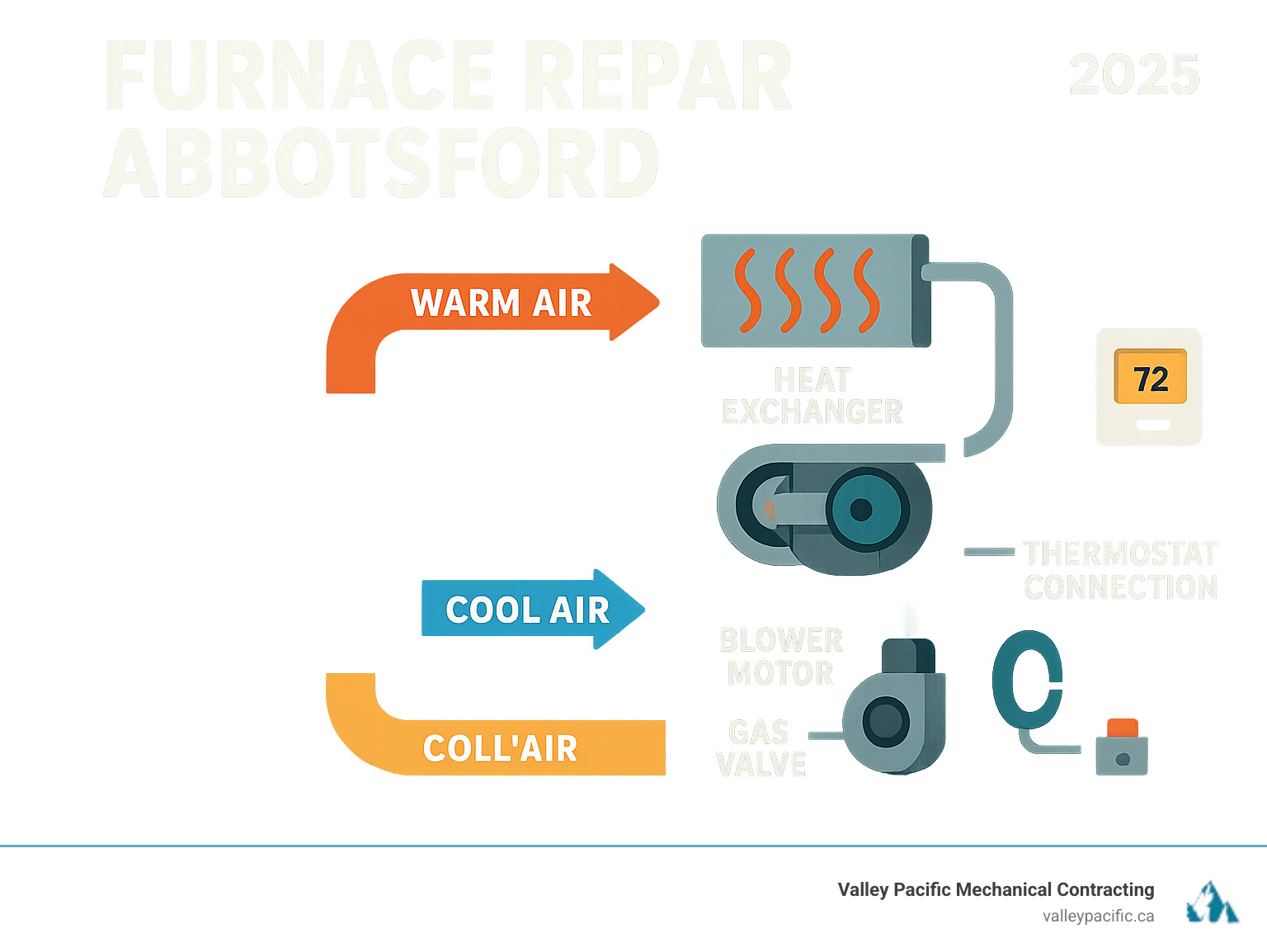
Telltale Signs Your Furnace Needs Repair

Your furnace usually gives warning signs before it fails completely. Recognizing these signals can save you from a mid-winter emergency. Look out for these common red flags:
- Unusual Noises: Banging, clanking, or screeching sounds often point to mechanical problems like a worn-out blower motor or burner issues.
- Strange Smells: A persistent metallic odor can mean overheating parts. If you smell sulfur or rotten eggs, you may have a gas leak—turn off your gas and call for emergency furnace repair Abbotsford service immediately.
- Inconsistent Heating: Cold spots in your home suggest your furnace is struggling to distribute heat, possibly due to thermostat, ductwork, or internal furnace problems.
- Rising Utility Bills: A sudden spike in energy costs means your furnace is working harder and less efficiently to heat your home.
- Yellow Pilot Light: A healthy pilot light is blue. A yellow or flickering flame indicates incomplete combustion, a potential carbon monoxide hazard.
- Frequent Cycling: A furnace that turns on and off constantly is working inefficiently and likely has an underlying issue.
Common Furnace Problems in Abbotsford Homes
In Abbotsford's damp climate, certain furnace issues are common:
- Thermostat Malfunctions: The furnace may be fine, but its control center is sending faulty signals.
- Clogged Filters: A dirty filter restricts airflow, causing the system to overwork and components to fail prematurely.
- Ignition or Pilot Light Failure: If the system can't ignite, it can't produce heat.
- Blower Motor Problems: A failing blower motor means poor or no airflow from your vents.
- General Wear and Tear: Components like heat exchangers and flame sensors wear out over time, reducing efficiency and safety. More info about HVAC services for home comfort can help you understand how maintenance prevents these issues.
DIY Troubleshooting vs. Calling a Professional
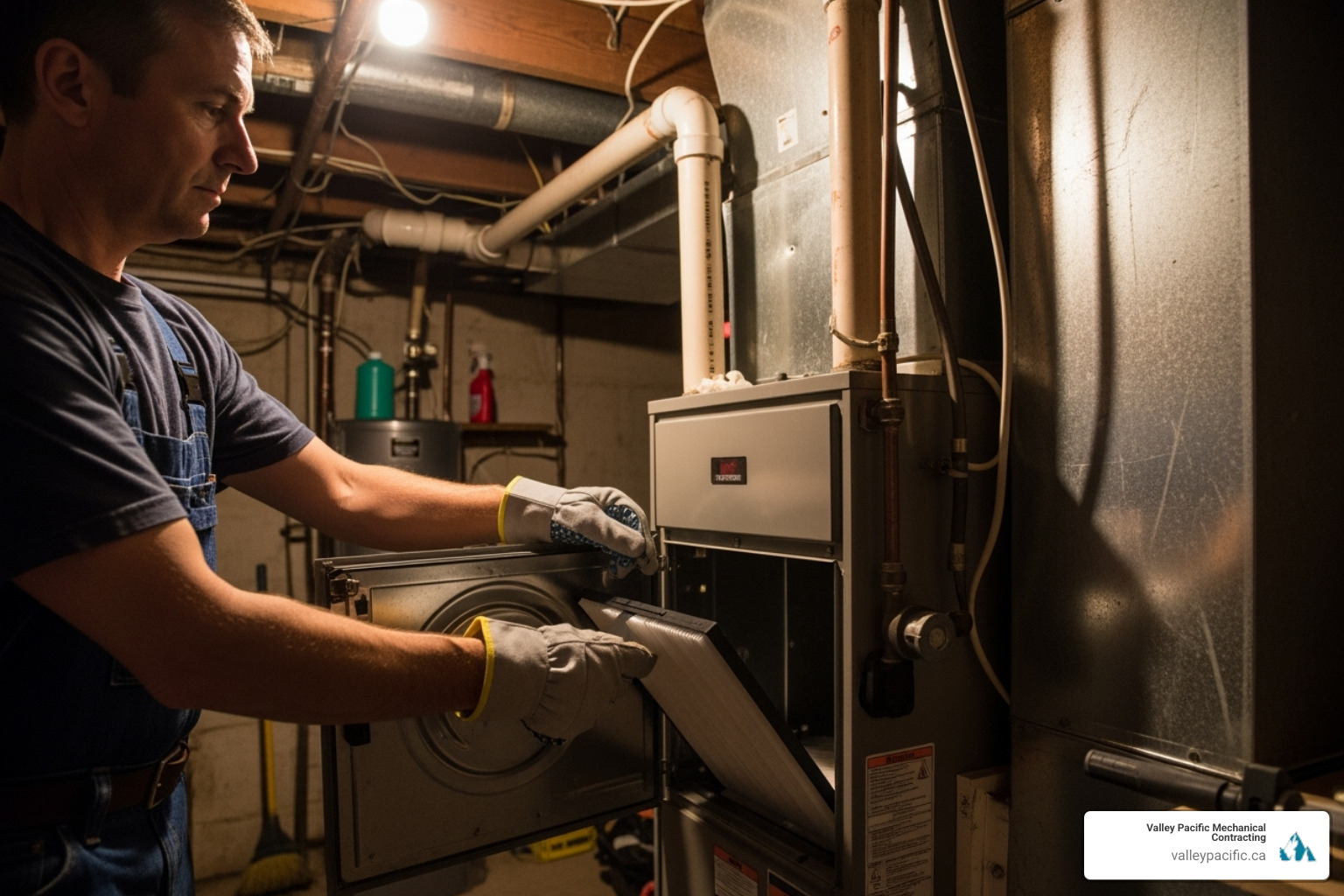
While some furnace issues have simple DIY fixes, it's crucial to know your limits. Furnaces involve gas, electricity, and combustion, making incorrect repairs a significant safety hazard. Attempting complex repairs can lead to gas leaks, carbon monoxide exposure, electrical shock, or more expensive damage.
Simple Steps You Can Take Before Calling for Service
Before calling for furnace repair abbotsford help, try these quick checks:
- Check the Thermostat: Ensure it's set to "heat" and the temperature is above the current room temperature.
- Replace the Air Filter: A clogged filter is a leading cause of furnace problems. Check it monthly during heating season.
- Clear Vents: Make sure all air vents are open and unblocked by furniture or rugs.
- Reset the System: Turn the furnace power switch off for 30 seconds, then back on. This can clear minor electronic glitches.
- Check the Breaker: Look for a tripped circuit breaker in your electrical panel and reset it if necessary.
When to Immediately Call for Professional Furnace Repair Abbotsford
For these issues, call a professional immediately for your safety:
- Gas Smell: If you smell rotten eggs, evacuate your home, then call your gas provider and an emergency repair service from a safe location.
- Loud Banging or Grinding Noises: These can indicate serious internal damage, like a cracked heat exchanger.
- Water Pooling Around the Furnace: This could be a condensate leak or a more serious issue that requires professional attention.
- No Heat in Extreme Cold: This is an emergency that can lead to frozen pipes and significant water damage.
- Carbon Monoxide Detector Alarm: Evacuate your home immediately and call 911.
For urgent situations in the Lower Mainland, our HVAC Repair Maple Ridge BC team is ready to provide a quick, safe response.
How to Choose the Right Company for Furnace Repair Abbotsford
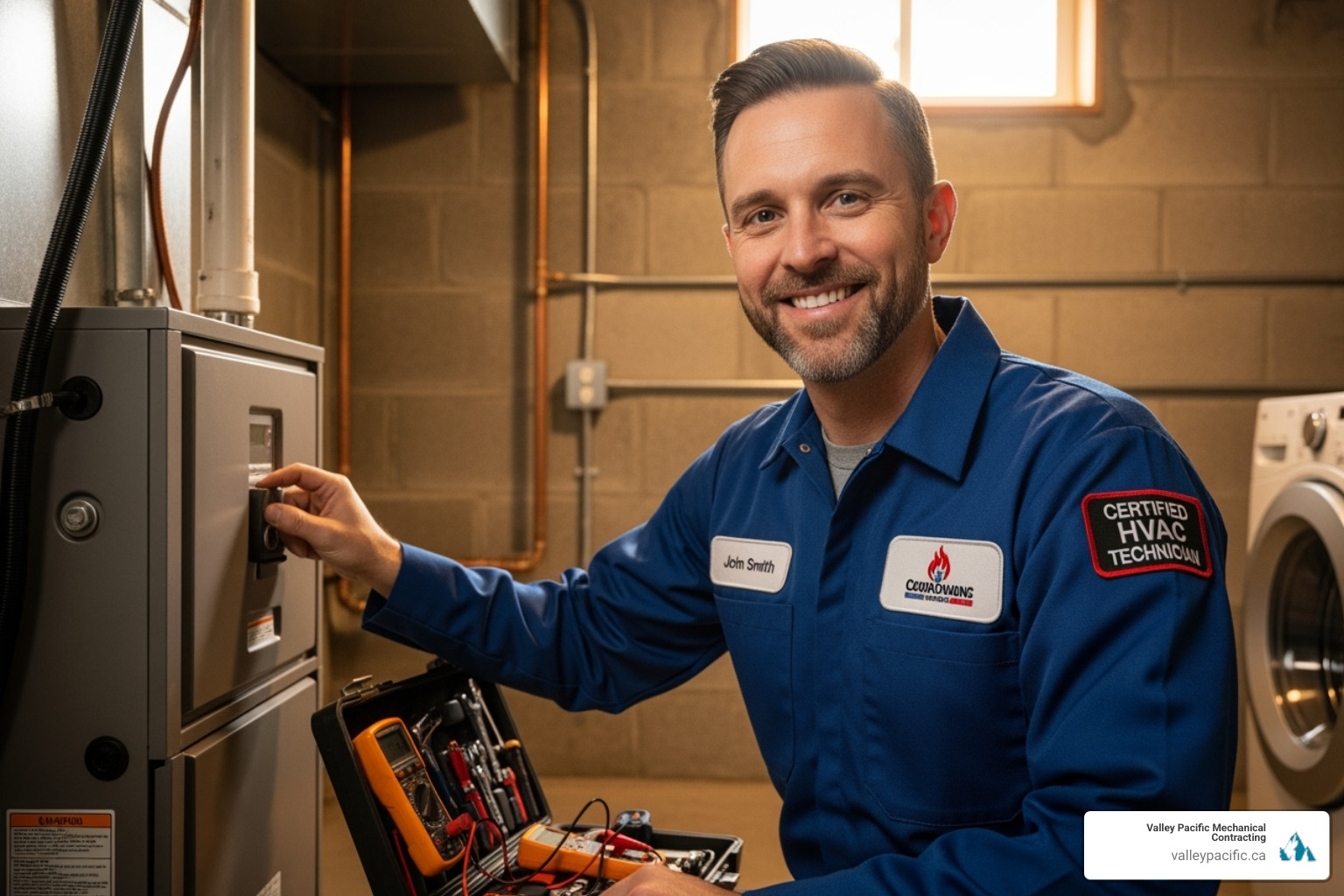
When your furnace fails, you need a trustworthy and reliable company. Here’s what to look for when choosing a provider for furnace repair abbotsford:
- Local Reputation & Reviews: Check for positive feedback from other Abbotsford homeowners.
- Licensing and Insurance: Technicians must be licensed by Technical Safety BC to work on gas furnaces. Ensure the company is fully insured.
- 24/7 Emergency Service: A furnace can break down at any time. A company that offers around-the-clock service is essential.
- Transparent Pricing: Look for clear, upfront estimates with no hidden fees.
Finding a Reliable and Certified HVAC Technician
Experience is key. A technician with years of experience in the Lower Mainland will diagnose problems faster and more accurately. Our team has over 30 years of expertise and receives ongoing factory training. Word-of-mouth recommendations from neighbors are also invaluable. Whether you need help in Abbotsford or require HVAC Services Langley, a trusted local professional makes all the difference.
Key Questions to Ask Your Technician
Before work begins, ask these questions to ensure you're getting professional service:
- What is your service call fee and what does it cover?
- Will I receive a detailed, written estimate before repairs start?
- What warranty do you offer on parts and labor?
- What is the estimated timeline for the repair?
Asking the right questions leads to the right company for your needs. For more tips, our guide on furnace installation homeowner essentials has useful information.
Understanding the Furnace Repair Process
When your furnace breaks down, knowing what to expect can turn a stressful situation into a manageable one. At Valley Pacific Mechanical Contracting, we've streamlined our furnace repair abbotsford process to be as transparent and "headache-free" as possible. Our process includes:
- Emergency Response: Our 24/7 service is ready for urgent calls, especially during Abbotsford's winters.
- Thorough Diagnosis: A certified technician performs a comprehensive inspection to find the root cause of the problem.
- Transparent Quoting: We provide a detailed, upfront estimate, explaining the necessary repairs in plain English.
- Efficient Repair: With your approval, we execute the repair. Our vans are stocked with common parts to enable same-day service.
- Final Testing: We test your furnace to ensure it's operating safely and efficiently before we consider the job done.
You can learn more about our comprehensive range of heating, cooling, and mechanical services at Services.
What to Do During an Extreme Weather Breakdown
A furnace failure in extreme cold is an emergency. Here's what to do:
- Safety First: If you smell gas or your carbon monoxide detector goes off, evacuate immediately and call 911.
- Call for Emergency Service: If basic troubleshooting doesn't work, call for professional help without delay to prevent frozen pipes. Our emergency team prioritizes these calls. We also provide Heating Repair Maple Ridge BC services.
- Use Temporary Heat Safely: While waiting, dress in layers and use electric space heaters with caution. Never use a gas oven or stovetop for heating.
Typical Costs and Common Furnace Types
The decision to repair or replace depends on age, repair frequency, and efficiency. If a repair costs over 50% of a new unit's price, replacement is often wiser.
Common furnace types in Abbotsford include:
- Gas Furnaces: Reliable and efficient, but require licensed technicians for repairs.
- Electric Furnaces: Simpler systems but can be more expensive to run.
- Heat Pumps: Popular for heating and cooling, but require specialized repair knowledge.
For residents in nearby communities, we also provide Furnace Repair Mission BC services.
Introduction
Furnace Fails? Abbotsford's Best Repair Services Are Here
When Your Furnace Breaks Down in Abbotsford: Quick Help Guide
When you need furnace repair abbotsford services, finding the right help fast is crucial for your comfort and safety, especially during our cold, wet winters. A failing furnace can lead to frozen pipes, health risks, and expensive emergency repairs.
Emergency Signs You Need Immediate Repair:
- Strange smells (especially gas odors)
- Loud banging or grinding noises
- No heat during cold weather
- Yellow pilot light instead of blue
- Carbon monoxide detector alarms
Abbotsford has experienced HVAC professionals who understand our local climate challenges. Recognizing early warning signs and knowing who to call can save you money, stress, and sleepless nights in the cold.
Telltale Signs Your Furnace Needs Repair
Imagine this: it's a chilly Abbotsford evening, and you notice your home isn't quite as toasty as it should be. Or perhaps, your furnace is making noises that sound less like a gentle hum and more like a rock concert. These aren't just quirks; they're often your furnace crying out for help. Recognizing these common signs early can prevent a minor issue from becoming a major, costly breakdown.
Common Signs Your Furnace is Struggling:
- Unusual Noises: Furnaces are generally quiet workhorses. If you hear banging, clanking, screeching, or whistling, it's time to pay attention. Banging noises, for instance, can indicate issues with the furnace's internal components, such as a dirty burner or a failing blower motor.
- Strange Smells: While a faint burning dust smell is common when you first turn on your furnace for the season, persistent or strong odors are a red flag. A metallic smell might suggest an overheating component, while a sulfur or rotten egg smell could indicate a gas leak – a serious emergency that requires immediate action.
- Inconsistent Heating: Are some rooms toasty while others are chilly? This "cold spot" phenomenon can point to a number of issues, from a malfunctioning thermostat to problems with your ductwork or the furnace's heat distribution system. It's working hard, but the heat isn't reaching where it needs to go.
- High Utility Bills: If your energy bills suddenly spike without a corresponding increase in usage, your furnace might be losing efficiency. This often happens when components are worn out, filters are clogged, or the system is struggling to maintain the desired temperature. It's essentially working overtime, burning more fuel to achieve less heat.
- Yellow Pilot Light: For older furnaces with a pilot light, it should always burn a strong blue flame. A yellow or flickering pilot light can indicate incomplete combustion, which can produce dangerous carbon monoxide. This is a critical safety concern.
- Frequent Cycling: A furnace that turns on and off too frequently (short cycling) or runs constantly without reaching the set temperature is inefficient and likely has an underlying problem.
Common Furnace Problems in Abbotsford Homes
In Abbotsford's damp climate, certain furnace issues are common:
- Thermostat Malfunctions: The furnace may be fine, but its control center is sending faulty signals.
- Clogged Filters: A dirty filter restricts airflow, causing the system to overwork and components to fail prematurely. More info about HVAC services for home comfort emphasizes the importance of clean filters for overall system health.
- Ignition Control Failure: If the system can't ignite, it can't produce heat.
- Blower Motor Issues: A failing blower motor means poor or no airflow from your vents.
- General Wear and Tear: Components like heat exchangers and flame sensors wear out over time, reducing efficiency and safety.
Understanding these signs and common problems is the first step in addressing your furnace repair abbotsford needs.
DIY Troubleshooting vs. Calling a Professional
When your furnace acts up, it's natural to want to try and fix it yourself. There are indeed some simple steps you can take, but it's crucial to understand the line between helpful DIY and dangerous territory. Furnaces deal with gas, electricity, and combustion, making them potentially hazardous if mishandled.
While we appreciate a good DIY spirit, attempting complex repairs without proper training can lead to:
- Gas Leaks: Creating a dangerous gas leak, which can lead to explosions or carbon monoxide poisoning.
- Carbon Monoxide Risk: Improper repairs can exacerbate the risk of producing this odorless, deadly gas.
- Electrical Hazards: Furnaces contain high-voltage components that can cause severe electrical shock.
- Further Damage: Misdiagnosing the issue can lead to more extensive and expensive damage.
Simple Steps You Can Take Before Calling for Service
Before you pick up the phone for furnace repair abbotsford, try these quick checks:
- Check Thermostat Settings: Ensure it's set to "heat" and the temperature is higher than the current room temperature.
- Replace Air Filter: A clogged filter is a common culprit. Check it every 1-3 months during heating season.
- Clear Vents: Make sure all supply and return vents are open and unobstructed.
- Reset the System: Turn the furnace's power switch off for 30 seconds, then turn it back on to clear minor glitches.
- Check Circuit Breaker: If the breaker for your furnace has tripped, reset it.
- Ensure Pilot Light is Lit (if applicable): It should be a strong blue flame.
When to Immediately Call for Professional Furnace Repair Abbotsford
These situations are often safety-related and require immediate expert intervention:
- Gas Smell: If you smell rotten eggs, leave your home immediately. From a safe location, call your gas provider and then us for emergency service.
- Loud Banging Noises: This can indicate a serious internal problem, such as a cracked heat exchanger.
- Water Pooling: Puddles around your furnace can lead to water damage or mold.
- No Heat During Extreme Cold: This is an emergency that puts your pipes at risk of freezing and bursting.
- Carbon Monoxide Detector Alarms: Evacuate your home immediately and call 911.
For urgent issues like these, you need prompt, reliable service. Our team is ready to respond. HVAC Repair Maple Ridge BC – we understand that a quick response can make all the difference.
How to Choose the Right Company for Furnace Repair Abbotsford
Choosing the right company for your furnace repair abbotsford needs means finding a knowledgeable, reliable, and caring professional. Here’s what to consider when vetting a service provider:
- Local Reputation: Look for companies with strong, positive feedback within the Abbotsford community.
- Certifications and Licensing: Ensure technicians are licensed by Technical Safety BC. This is non-negotiable for safety.
- Insurance: A reputable company will carry comprehensive insurance to protect you and your property.
- 24/7 Emergency Service: A company offering 24/7 service provides crucial peace of mind during Abbotsford's cold winters.
- Transparent Pricing: A trustworthy company provides clear, upfront estimates without hidden fees.
Finding a Reliable and Certified HVAC Technician
Finding a reliable technician is paramount. With over 30 years of expertise in the Lower Mainland, our BCIT-trained and government-licensed team has seen it all. We also extend our services to nearby communities, ensuring comprehensive coverage for all your heating and cooling needs, including HVAC Services Langley.
Key Questions to Ask Your Technician
Asking the right questions can help you feel confident in the repair process:
- What is your service call fee, and what does it include?
- How will you provide a repair estimate?
- What warranty do you offer on parts and labour?
- What is the estimated timeline for the repair?
- Are there any preventative measures I can take for this issue in the future?
For more insights, check out our guide on Furnace installation homeowner essentials.
Understanding the Furnace Repair Process
When your furnace breaks down, knowing what to expect can help ease the stress. At Valley Pacific Mechanical Contracting, we've streamlined our furnace repair abbotsford process to be as smooth and transparent as possible.
Our process includes:
- Emergency Response: Our 24/7 emergency service means help is always available.
- Thorough System Diagnosis: Our certified technicians perform a comprehensive inspection to pinpoint the problem.
- Transparent Quoting: We provide a detailed, upfront estimate in plain English with no hidden fees.
- Repair Execution: With your approval, we complete repairs efficiently, often on the spot.
- Final Testing: We test your furnace to confirm it's operating safely and efficiently.
You can learn more about our full range of services here: Services.
What to Do During an Extreme Weather Breakdown
A furnace breakdown in harsh winter weather is an urgent situation.
- Safety First: If you smell gas or your CO detector alarms, evacuate immediately and call 911 from a safe location.
- Call for Emergency Service: If basic troubleshooting fails, call for emergency furnace repair abbotsford service to prevent frozen pipes and costly damage.
- Temporary Heating Solutions: While waiting, layer up and use electric space heaters safely. Never use a gas oven for heat.
For any heating emergency, we're here to help in Abbotsford and nearby areas like Heating Repair Maple Ridge BC.
Typical Costs and Common Furnace Types
The repair versus replacement decision depends on age, repair frequency, and efficiency. If a repair costs more than 50% of a new furnace's price, replacement is often the smarter choice.
Common furnace types in Abbotsford include:
- Gas Furnaces: The most common, reliable, and cost-effective to operate.
- Electric Furnaces: Less expensive to install but typically cost more to run.
- Heat Pumps: Highly efficient systems for both heating and cooling.
Our technicians are trained to service all system types. For more information about furnace repairs in nearby communities, check out Furnace Repair Mission BC.
Why HVAC Preventative Maintenance is Your Home's Best Investment
HVAC preventative maintenance is a proactive approach to caring for your heating, ventilation, and air conditioning system through regular inspections, cleaning, and tune-ups. The benefits are significant:
- Energy savings: Reduce energy consumption by up to 30%.
- Extended lifespan: Systems can last 15-20 years, compared to 10 for neglected ones.
- Cost savings: Save an estimated $4 for every $1 spent on maintenance.
- Better air quality: Clean filters and components improve indoor air.
- Fewer breakdowns: Catch problems before they become emergencies.
Most homeowners overlook their HVAC system until it fails. However, this system consumes about 6% of all electricity produced in the United States, making it a major energy user in your home. The research is clear: for every dollar spent on preventative HVAC maintenance, you can save $4 in avoided breakdown and repair costs. With replacement costs ranging from $5,000 to $10,000, those savings are substantial.
Just as your car needs regular oil changes to run reliably, your HVAC system requires consistent attention to keep your family comfortable. Whether you're concerned about rising energy bills, system reliability, or protecting your investment, proper maintenance is the first step toward long-term peace of mind.
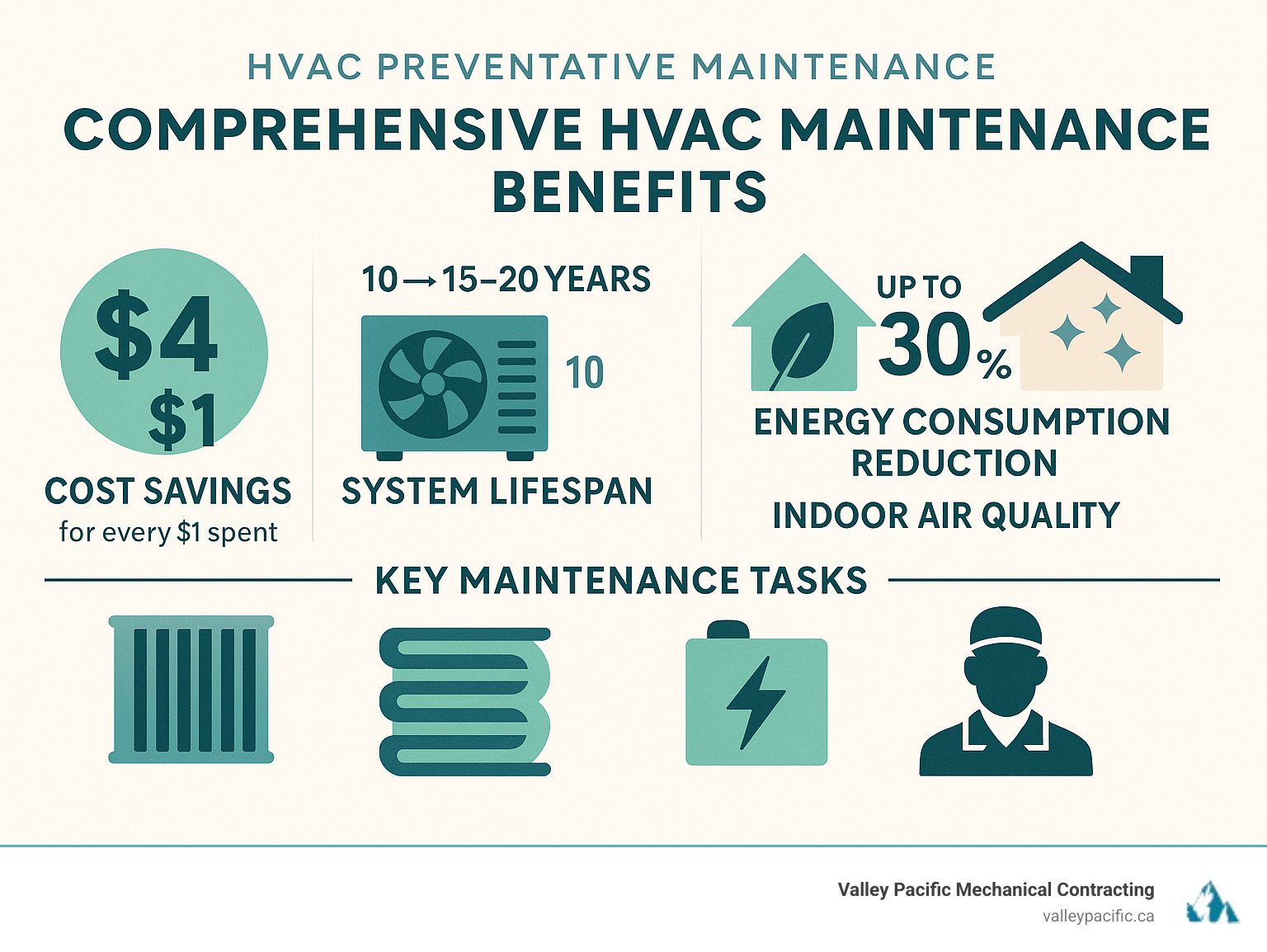
The Undeniable Value of Proactive HVAC Care
Your HVAC system works quietly around the clock, but it's often ignored until something goes wrong. HVAC preventative maintenance shifts your approach from reactive panic to proactive peace of mind. Just as a car needs oil changes, your HVAC system—one of the hardest-working appliances in your home—requires thoughtful care.
The U.S. Department of Energy confirms that regular maintenance delivers measurable benefits, including improved energy efficiency, lower utility bills, extended system lifespan, better indoor air quality, and fewer emergency repairs. The EPA has also documented how proper HVAC care impacts indoor air pollution. For more insights on creating a comfortable home, see our guide on HVAC Services for Home Comfort.
Maximizing Your System's Lifespan
A well-maintained HVAC system can run for 15 to 20 years. If you skip maintenance, you might face replacement in as little as 10 years—cutting its life in half. ACHR News research confirms that systems receiving regular attention last longer. With replacement costs reaching five figures, those extra years mean serious savings.
Every day, your HVAC unit battles dust, debris, and operational wear. Regular maintenance reduces this wear and tear by keeping components clean, lubricated, and functioning as designed. If you're curious about specific systems, our Comprehensive Heat Pump Service Plans offer targeted maintenance strategies.
Boosting Energy Efficiency and Lowering Bills
As dust and debris accumulate on coils and filters, your system works harder to maintain your desired temperature, causing energy bills to rise. It's forced to overcome resistance, much like trying to breathe through a dirty mask.
The U.S. Department of Energy data shows that HVAC systems consume about 6% of all U.S. electricity. The good news is that proper maintenance can reduce this energy consumption by up to 30%. This significant improvement means your system reaches the desired temperature faster and more efficiently, lowering your utility bills. Clean systems simply run better and cost less to operate. To optimize your cooling system's efficiency, learn more about our AC Service in Maple Ridge BC.
Improving Health and Indoor Air Quality
According to EPA research, the air inside your home can be two to five times more polluted than outdoor air. Your HVAC system can either help solve this problem or make it worse. A well-maintained system filters pollutants, reduces allergens, and prevents mold growth. When neglected, dirty filters stop working, and coils can become breeding grounds for bacteria and mold.
This means a poorly maintained system can circulate contaminants throughout your home, potentially triggering respiratory issues and worsening allergies. The difference in air quality after proper maintenance is often immediately noticeable. Cleaner air is essential for your family's wellbeing. For a custom approach, our Custom HVAC Services for Homes guide explores solutions for your specific needs.
The Core of HVAC Preventative Maintenance: A Comprehensive Checklist
Think of HVAC preventative maintenance as a thorough health checkup for your home's comfort system. It's a comprehensive process that goes far beyond simply changing a filter.
During a maintenance visit, our technicians follow a detailed checklist covering every critical component:
- Air filters: Inspected and replaced to prevent efficiency loss of up to 15%.
- Coils: Indoor evaporator and outdoor condenser coils are cleaned for optimal heat transfer and performance.
- Condensate drain line: Cleared of blockages to prevent water damage and mold.
- Electrical connections: Inspected and tightened to ensure safety and efficiency.
- Blower components: Cleaned and adjusted for proper airflow throughout your home.
- Thermostat: Calibrated to ensure accurate temperature readings.
- Refrigerant levels: Checked to ensure they are at the correct level for efficiency and equipment protection.
- Ductwork: Inspected for leaks, which can waste up to 40% of your system's energy.
- Safety controls: Tested to prevent potential hazards.
- Moving parts: Lubricated to reduce friction and extend motor life.
Heating System Specifics (Fall/Winter)
As cooler weather approaches, preparing your heating system is crucial for both comfort and safety. Our fall inspection includes a thorough furnace examination, with special attention on the heat exchanger to check for cracks that could lead to dangerous carbon monoxide leaks. We also check burner combustion for clean operation, verify correct gas pressure, and test all heating-specific safety controls like limit switches and flame sensors. Our team has been keeping Lower Mainland homes warm for over 30 years. Learn more in our guide to Heating Service in Maple Ridge, Pitt Meadows, Coquitlam.
Cooling System Specifics (Spring/Summer)
Before summer arrives, your air conditioner needs to be ready for the heat. Our spring AC inspection focuses on components that have been dormant. We clean the indoor evaporator coils and outdoor condenser coils to restore peak cooling performance and energy efficiency. We also check that refrigerant levels are precise, as incorrect levels can damage the system. Finally, we flush the condensate drain line to prevent clogs that cause water damage. For residents in Pitt Meadows, our AC Service in Pitt Meadows BC ensures your system is ready for summer.
DIY vs. Professional Maintenance: A Homeowner's Guide
When it comes to HVAC preventative maintenance, there's a clear line between tasks you can safely handle and those requiring professional expertise. Understanding this distinction is key to protecting your system, your warranty, and your family's safety.
| DIY Tasks (Homeowner) | Professional Tasks (Certified Technician) |
|---|---|
| Changing air filters | Comprehensive system inspection and diagnostics |
| Clearing debris from outdoor units | Coil cleaning (evaporator and condenser) |
| Cleaning vents and registers | Refrigerant level checks and leak detection |
| Checking thermostat batteries | Electrical connection tightening and safety checks |
| Ensuring clear airflow around indoor and outdoor units | Lubrication of moving parts (motors, bearings) |
| Listening for unusual noises and reporting them | Condensate drain line clearing with specialized tools |
| Monitoring energy bills for sudden increases | Heat exchanger inspection (furnace) |
| Burner assembly cleaning and adjustment (furnace) | |
| Blower motor and fan blade inspection and cleaning | |
| Ductwork inspection for leaks and sealing | |
| Testing all safety controls | |
| Calibration of thermostat | |
| Pressure and temperature checks |
Simple DIY Tasks for Homeowners
You can significantly impact your system's performance with a few simple tasks:
- Change air filters: This is the most important DIY task. Check filters monthly and replace them at least every 90 days (more often if you have pets or allergies).
- Clear debris from outdoor units: Keep the area around your condenser unit clear of leaves, grass, and other obstructions. Allow at least two feet of clearance on all sides.
- Clean vents and registers: Use a vacuum or cloth to remove dust and improve air circulation.
- Check thermostat batteries: If your thermostat malfunctions, a simple battery change might be all that's needed.
Understanding your specific system is also helpful. Our Seasonal Heat Pump Maintenance Tips are a great resource for heat pump owners.
Why Professional HVAC Preventative Maintenance is Non-Negotiable
While DIY tasks are valuable, they don't replace the critical work performed by a certified technician. Professional maintenance is essential for several reasons:
- Technical knowledge: Our experienced technicians spot subtle signs of wear, corrosion, or component failure that an untrained eye would miss.
- Specialized tools: We use precision instruments to accurately measure refrigerant levels, test electrical components, and assess airflow.
- Safety considerations: Working with high-voltage electricity, pressurized refrigerants, and furnace heat exchangers is dangerous without proper training and can risk fire or carbon monoxide leaks.
- Electrical and refrigerant work: This work must be handled by licensed professionals to be done legally, safely, and without damaging your system or the environment.
- Warranty compliance: Most manufacturers require documented professional maintenance to keep your warranty valid. Skipping annual tune-ups could void your coverage.
If you notice unusual noises, strange odors, or sudden spikes in your utility bills, these are signs your system needs professional attention. Our guide on Signs your HVAC System May Fail Soon can help you recognize these warnings. For expert help, our HVAC Repair in Maple Ridge BC team is ready to provide a headache-free solution.
The Financial Equation of HVAC Preventative Maintenance
HVAC preventative maintenance is an investment that puts money back in your pocket over time. The math is simple: for every dollar you spend on preventative maintenance, you can save an estimated four dollars in avoided repairs and breakdowns.

Typical Costs and What to Expect
Regular maintenance costs a fraction of emergency repairs. According to EcoWatch, annual maintenance typically runs between $75 and $150 per visit. Compare that to emergency repairs, which can cost hundreds or thousands. A failed compressor might cost $2,500 or more, and a full HVAC replacement typically ranges from $5,000 to $10,000, according to HomeAdvisor.
A well-maintained system can last 15-20 years, while a neglected one might fail after just 10. Proper maintenance can save you thousands by delaying premature replacement, and the energy savings alone often cover the cost of the service.
Is a Service Agreement a Worthwhile Investment?
A maintenance plan, like our Maintenance Plan, offers excellent value and takes the guesswork out of system care. Key advantages include:
- Priority service: During a heat wave or cold snap, you get bumped to the front of the line for repairs.
- Discounted repairs: Service agreement customers often receive reduced rates on parts and labor.
- Peace of mind: You can rest easy knowing your system has been professionally inspected and any potential issues have been addressed early.
- Simpler budgeting: Predictable maintenance costs eliminate the surprise of a major repair bill.
- Warranty protection: Documented professional maintenance is required by most manufacturers to keep your warranty valid.
A service agreement transforms HVAC care from a reactive expense into a proactive investment in your comfort, budget, and peace of mind.
Frequently Asked Questions about HVAC Maintenance
After 30 years of serving homeowners in the Lower Mainland, we've heard many of the same questions about HVAC preventative maintenance. Here are answers to the most common concerns.
How often should I schedule professional HVAC maintenance?
For most homes, twice a year is ideal. We recommend scheduling a visit in spring (April/May) to prepare your air conditioning system for summer, and another in fall (September/October) to prepare your heating system for winter.
If your system is older (over 10 years), used heavily, or if you have pets, you may benefit from more frequent checks. The key is consistency to prevent small issues from becoming expensive emergencies.
What are the most critical signs my HVAC system needs immediate attention?
Your system will often signal problems before it fails completely. Call a professional if you notice:
- Unusual noises: Banging, grinding, or squealing sounds often indicate a loose or worn-out part.
- Strange odors: A burning smell can signal electrical problems, while musty odors may indicate mold. A rotten egg smell could be a gas leak—evacuate immediately and call for help.
- Weak airflow: If air from your vents is weak or uneven, you could have blower issues or ductwork problems.
- Frequent cycling: If your system turns on and off more than usual, it's struggling to maintain the set temperature.
- High utility bills: A sudden, unexplained spike in energy costs suggests your system is working inefficiently.
Our guide on How Do I Know If My AC Needs Immediate Repair or Just Maintenance can help you assess the urgency.
Can I perform all HVAC maintenance myself?
While some DIY tasks are encouraged, you cannot and should not perform all maintenance yourself. Simple, safe tasks like changing air filters and clearing debris from your outdoor unit are beneficial.
However, most HVAC preventative maintenance involves complex procedures that require certified professionals. This is non-negotiable for several reasons:
- Safety: Working with electricity, refrigerant, and gas lines is dangerous without proper training.
- Warranty Protection: Most manufacturers require documented professional service to keep your warranty valid.
- Specialized Knowledge & Tools: Professionals can spot hidden issues and have the right equipment for accurate diagnostics and calibration.
Combining your regular care with our professional expertise is the best way to ensure a long-lasting, efficient system.
Conclusion
HVAC preventative maintenance is a simple practice with a powerful impact. It leads to systems that last longer, energy bills that drop by up to 30%, and healthier indoor air. Most importantly, it helps you avoid the stress and expense of an unexpected system failure on the hottest or coldest day of the year.
Proactive care is the key. The investment pays for itself, with every dollar spent on maintenance saving an estimated four dollars down the road. Beyond the savings, you gain the peace of mind that comes from knowing your home's comfort system is safe and reliable.
Your home should be a sanctuary. A well-maintained HVAC system works quietly in the background to ensure your family's comfort and safety. That's the headache-free experience every homeowner deserves.
For expert, headache-free service in Langley, Maple Ridge, Pitt Meadows, Mission, Coquitlam, and throughout the Lower Mainland, trust the 30+ years of experience at Valley Pacific Mechanical Contracting. We are committed to providing the reliable, professional care your system needs.
Ready to give your system the care it deserves? Learn more about our expert heat pump services and find out how we can help you maintain a comfortable, efficient home.
Why Your York Furnace Needs Expert Care
York furnace repair services help keep your home warm and comfortable when your heating system breaks down or starts acting up. Whether you're dealing with strange noises, uneven heating, or a complete system failure, finding qualified technicians who specialize in York furnaces can save you time, money, and stress.
Quick York Furnace Repair Guide:
- Check basics first - thermostat settings, power switch, air filter
- Listen for warning signs - humming, banging, or unusual noises
- Call professionals for - gas smells, no heat, or frequent cycling
- Find certified technicians - look for York-trained specialists
- Get multiple quotes - compare service options and pricing
York has been manufacturing reliable heating systems for over 135 years, with more than half of their products earning Energy Star certification. But even the best furnaces need maintenance and occasional repairs to keep running efficiently.
Common signs your York furnace needs attention include unusual noises like humming or banging, inconsistent heating throughout your home, higher energy bills, and frequent on-off cycling. These problems often start small but can lead to complete system failure if ignored.
The key is knowing when you can handle simple fixes yourself - like changing filters or checking thermostat settings - and when to call in the experts. Gas furnaces involve safety risks that require professional knowledge, especially when dealing with ignition systems or gas connections.
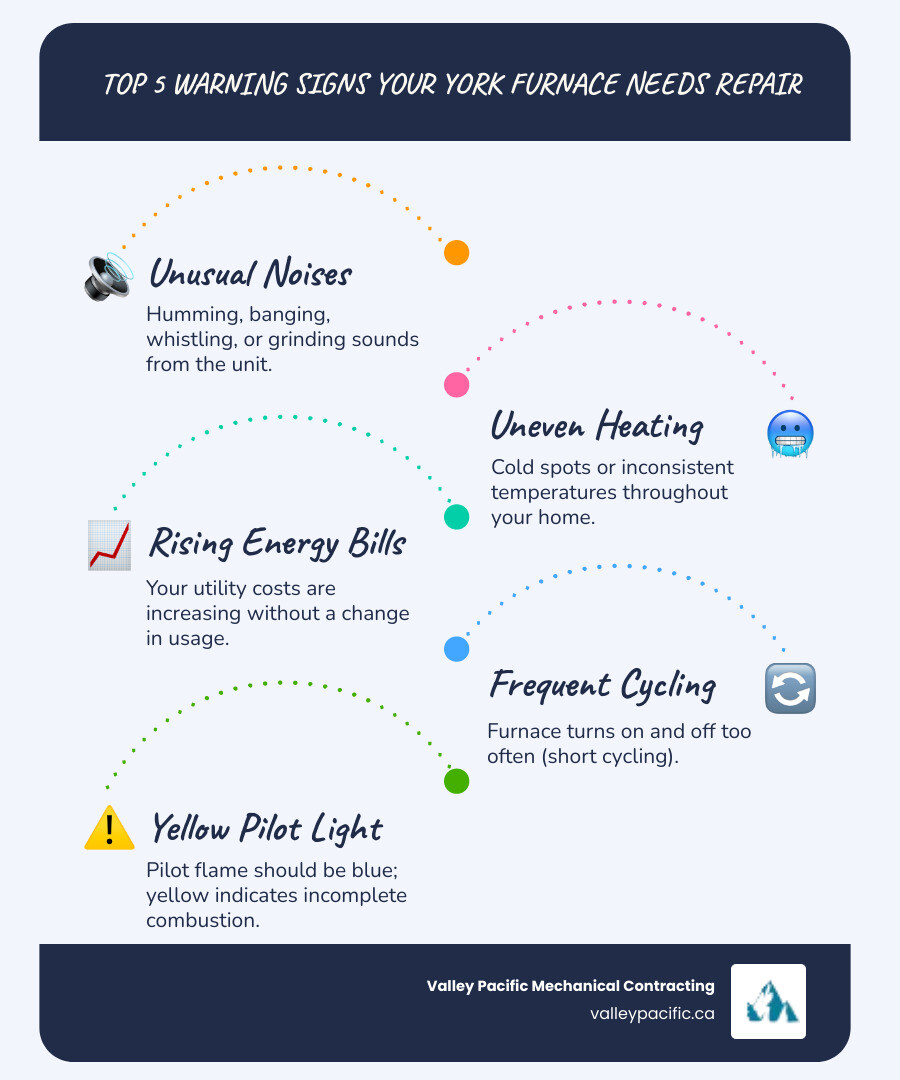
Is Your York Furnace Acting Up? Key Warning Signs
Your furnace has its own way of telling you when something's not quite right. After more than 30 years working with heating systems, we've learned that these "conversations" with your furnace are worth listening to. The trick is catching the early warning signs before they turn into expensive emergency repairs.
Unusual noises are often your first clue that something needs attention. Your York furnace will make some sounds during normal operation - a gentle whoosh of air or the soft click of components engaging. But when you start hearing humming, banging, or whistling sounds that weren't there before, your furnace is basically raising its hand and saying "help me out here!"
Maybe you've noticed inconsistent heating throughout your home. You know the feeling - your living room is nice and toasty, but the bedroom feels like an icebox. Or perhaps your furnace seems to be running constantly but never quite reaches the temperature you've set on the thermostat. These cold spots and temperature struggles usually mean your system isn't distributing heat the way it should.
Have you done a double-take at your energy bills lately? If they've jumped significantly without any changes in your heating habits, your York furnace might be working overtime to keep up. When heating systems start losing efficiency, they compensate by running longer and harder - which hits you right in the wallet.
Short cycling is another telltale sign that drives homeowners crazy. This is when your furnace turns on, runs for just a few minutes, then shuts off, only to repeat this dance over and over. It's like your furnace can't decide what it wants to do, and this constant stopping and starting puts unnecessary wear on all the components.
If your furnace has a pilot light, pay attention to its color. A healthy flame should be blue, but a yellow pilot light is a serious red flag. This yellow color can indicate incomplete combustion, which potentially releases dangerous carbon monoxide into your home. This isn't something to put on your "maybe later" list.
Poor air quality might seem unrelated to your heating system, but it's often connected. If your home feels stuffier than usual, you're noticing more dust, or family members are experiencing more respiratory issues, your furnace could be struggling with proper ventilation or circulation. For a deeper dive into warning signs, check out more info about signs your HVAC system may fail soon.
Common Problems and Their Causes
Let's get to the bottom of what's actually causing these frustrating symptoms. Understanding the root cause helps you figure out whether it's a quick fix or time to call in the cavalry.

Ignition system failure is behind many "my furnace won't start" calls. The ignitor is like the starter in your car - when it fails, nothing happens. Sometimes it's a simple ignitor replacement, but other times the problem involves the draft motor not working properly or issues with the gas control valve.
Your thermostat acts as the brain of your heating system, so when it starts malfunctioning, everything gets confused. A faulty thermostat might tell your furnace to run constantly, cause it to short cycle, or leave you shivering because it's not calling for heat at all. These mixed signals create unnecessary wear on your system and can drive your energy costs through the roof.
Here's the most common culprit we see: dirty air filters. It sounds too simple to cause major problems, but a clogged filter is like forcing your furnace to breathe through a straw. The blower motor has to work much harder to push air through, which leads to overheating and reduced efficiency throughout your entire system.
Malfunctioning blower motors cause their own set of headaches. When the motor that circulates heated air starts having problems - whether it's worn bearings, a faulty capacitor, or a loose blower wheel - your whole house feels the impact. Clogged vents create similar airflow issues, even when the blower motor is working perfectly.
Limit switch issues might sound technical, but they're actually a safety feature. These switches prevent your furnace from overheating by shutting it down when things get too hot. When they malfunction, your furnace might shut off unexpectedly or refuse to start. Regular maintenance is key to preventing many of these problems before they start.
Understanding Unusual Furnace Noises
Every strange sound coming from your furnace is trying to tell you something specific. Let's decode what your York furnace is actually saying:
Humming usually points to an electrical issue, especially if you hear it when the furnace isn't actively heating. This could be a failing ignitor trying to engage, loose components vibrating, or worn blower motor bearings asking for attention.
Banging sounds often happen right at the start of a heating cycle and indicate ignition delay. Gas builds up before igniting, creating that alarming "bang." It could also be loose ductwork expanding and contracting with temperature changes.
Whistling typically means airflow restriction somewhere in your system. Most often it's a very dirty air filter, but it could also be blocked return vents or leaky ductwork creating that high-pitched sound.
Scraping noises suggest metal-on-metal contact, usually involving the blower wheel. When the blower wheel becomes loose on its shaft, it can hit the housing or other components, creating that awful grinding sound that needs immediate attention.
These sounds aren't just annoying - they're your furnace's way of asking for help before a small problem becomes a big, expensive York furnace repair.
Troubleshooting Your York Furnace: DIY Fixes vs. Professional Repair
When your York furnace starts giving you trouble, your first instinct might be to grab your toolbox and dive right in. And honestly? Sometimes that's exactly the right move. A simple thermostat adjustment or filter change can save you both time and money. But here's the thing – knowing when to tackle a problem yourself versus when to call in the pros can make the difference between a quick fix and a costly disaster.
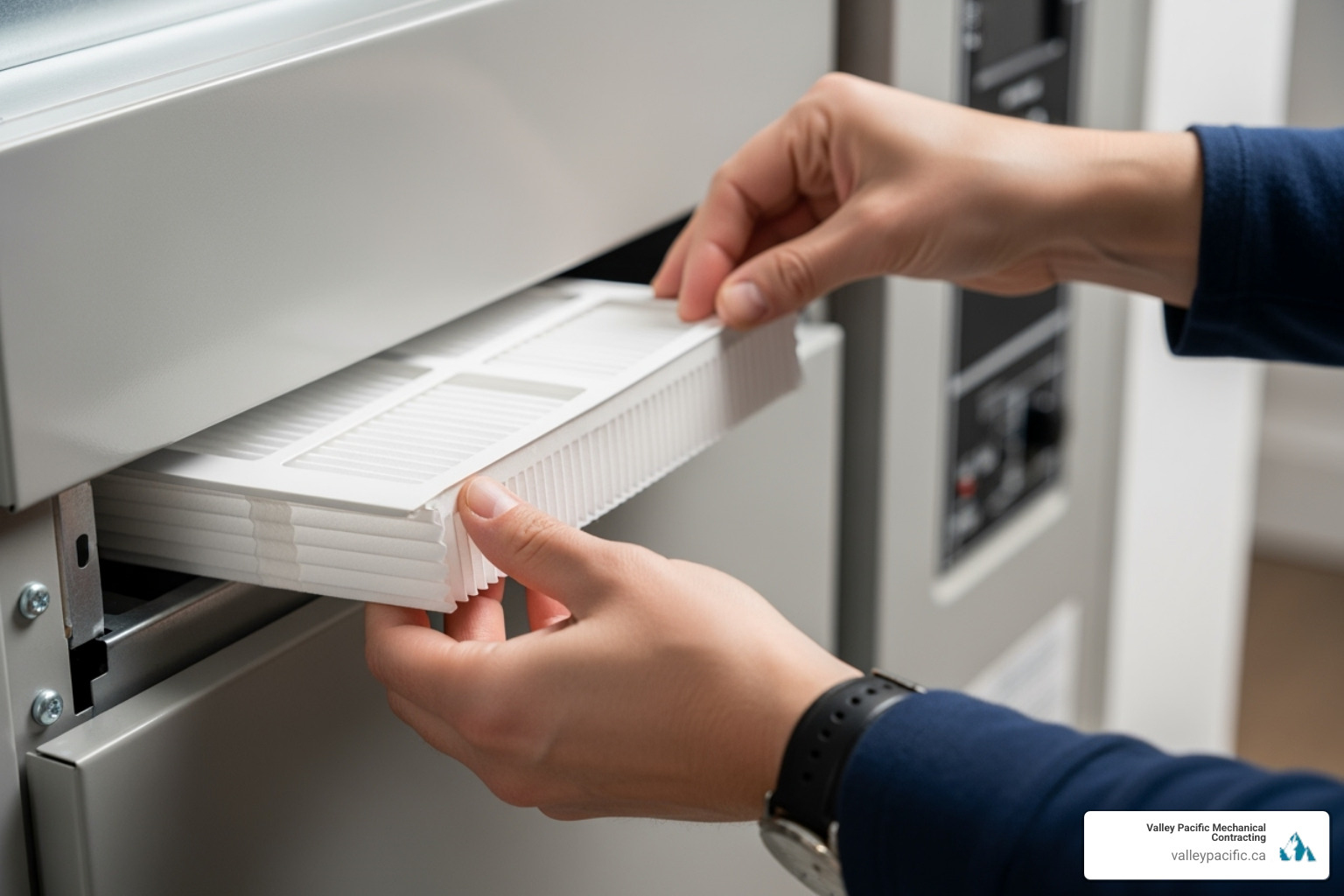
The key is starting with the basics. You'd be amazed how many "emergency" service calls we get that turn out to be something as simple as a tripped circuit breaker or a thermostat that got bumped to the wrong setting. Before you pick up the phone (or panic about repair costs), let's walk through some troubleshooting steps that might just solve your problem.
DIY Troubleshooting Before Calling for York Furnace Repair
Think of this as your furnace first-aid checklist. These are the safe, simple things every homeowner can – and should – check before calling for help.
Start with your thermostat settings. It sounds almost too obvious, but make sure it's actually set to "Heat" and that the temperature setting is higher than what your home currently feels like. Kids, guests, or even a quick dusting can accidentally change these settings. While you're there, replace those thermostat batteries if your display looks dim or blank. Fresh batteries solve more problems than you'd think!
Next up is your air filter inspection. This little guy is working overtime during heating season, and a clogged filter is like asking your furnace to breathe through a thick blanket. Check it monthly and swap it out if it looks gray, dusty, or you can't see light through it. This simple step prevents a shocking number of furnace headaches.
Take a walk around your home and ensure all vents are open and unblocked. That couch pushed against the return air vent or the stack of holiday decorations covering a floor register? They're making your furnace work much harder than it needs to. Your system needs to breathe freely to work efficiently.
Sometimes your furnace just needs a quick reset, like rebooting your computer. Find the power switch near your furnace unit (it looks like a regular light switch) and flip it off for about 30 seconds, then back on. While you're thinking about power, check your home's circuit breaker panel too – a tripped breaker is an easy fix that doesn't require any special skills.
When Professional York Furnace Repair is Necessary
Now, let's talk about when to step back and call in the cavalry. Gas appliances aren't toys, and some problems require the expertise that comes with years of training and proper tools.
If you smell gas anywhere near your furnace, stop everything. This isn't a DIY moment – it's an emergency. Turn off your furnace if you can do so safely, get everyone out of the house, and call your gas company and emergency services from outside. Don't flip any switches or use phones inside the house.
Loud banging or scraping noises coming from your furnace mean something mechanical has gone wrong. Maybe the blower wheel is loose, or internal components are damaged. Continuing to run the system could turn a moderate repair into a major replacement.
Water pooling around your unit might seem minor, but it can signal serious issues like a cracked heat exchanger or blocked drainage. Either way, it needs professional diagnosis to determine if it's a simple drain cleaning or something more serious.
When your furnace won't stay on and keeps cycling on and off repeatedly, that's called short cycling. It's hard on your system and usually points to problems with sensors, controls, or sizing issues that need expert attention.
No heat at all – whether your furnace won't start or is blowing cold air – typically means a major component has failed. The ignition system, gas valve, or control board might need replacement, and these aren't weekend warrior projects.
The ignition system deserves special mention because it's both crucial and potentially dangerous. If you hear repeated clicking without the burners lighting, or if you have an older pilot light that won't stay lit, the problem likely involves gas flow, flame sensors, or electrical components that require professional handling.
For situations like these, you need technicians who understand York systems inside and out. Our team provides comprehensive furnace services throughout the Lower Mainland, and we're always ready to help when your York furnace repair needs go beyond the DIY basics.
The Big Decision: Repair or Replace Your York Furnace?
Nobody wants to face this decision, but every homeowner eventually finds themselves here: Is it worth fixing your furnace one more time, or should you bite the bullet and replace it? After 30+ years of helping families in Langley, Mission, and Maple Ridge make this choice, we understand how overwhelming it can feel.
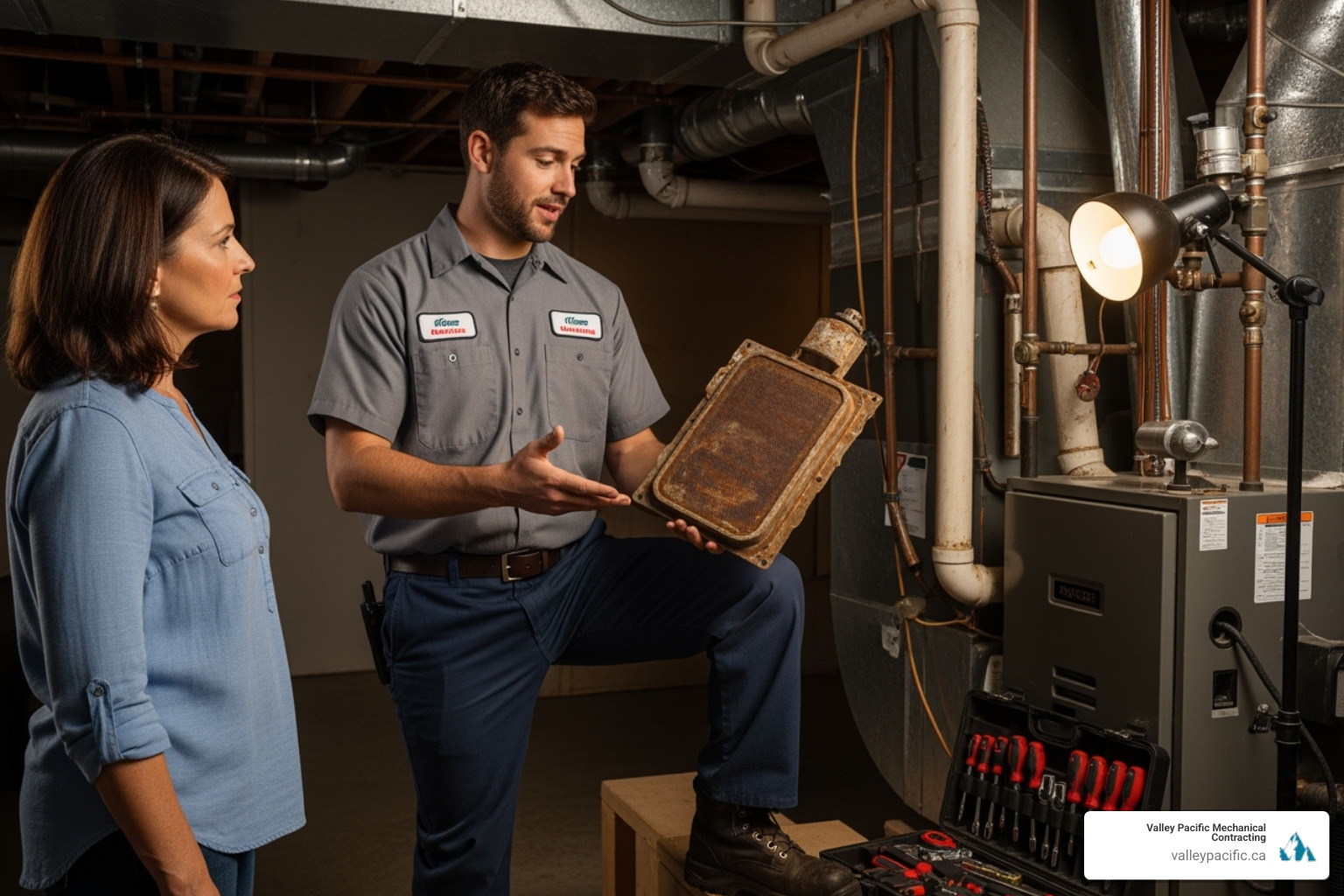
The good news? There are some clear guidelines that can help you make the right call for your situation and budget.
Age matters more than you might think. If your York furnace is over 15 years old, it's entering what we call the "frequent flyer" zone - where repairs become more common and expensive. Most furnaces have a lifespan of 15-20 years, and once they hit that milestone, components start failing more regularly.
Repair frequency is another big red flag. Are you calling for York furnace repair every winter? Those costs add up fast. We often see homeowners spend thousands on repairs over a couple of years, when a new furnace would have been more economical.
The 50% rule is your friend here: If a repair costs 50% or more of what a new furnace would cost, replacement usually makes more financial sense. It's like putting a new engine in a car that's already falling apart - sometimes you're just throwing good money after bad.
Energy efficiency is where things get really interesting. Older systems can be 50% less efficient than modern units. That means your 20-year-old furnace might be burning twice as much gas to heat your home compared to a new high-efficiency model. Those higher energy bills are costing you money every single month.
Deciding Between York Furnace Repair and Replacement
Here's a practical breakdown to help guide your decision:
| Factor | Repair Makes Sense | Replace Makes Sense |
|---|---|---|
| Age of Furnace | Less than 10 years | Over 15 years |
| Repair Cost | Minor, one-time fix Repair cost < 50% of new furnace | Major repair (heat exchanger, control board) Repair cost > 50% of new furnace |
| Energy Bills | Stable, no significant increase | Consistently rising for no clear reason |
| System Performance | Consistent heating, occasional minor issue | Uneven heating, frequent breakdowns, short cycling |
| Future Reliability | Good, system has been dependable | Deteriorating, frequent issues, lack of peace of mind |
Peace of mind is worth something too. If you're constantly worried about your furnace breaking down on the coldest night of the year, that stress has a cost. A new, reliable system means you can sleep soundly knowing your family will stay warm.
The Benefits of a Modern, High-Efficiency York Furnace
If replacement is the way to go, you're in for some pleasant surprises. Today's York furnaces aren't just more reliable - they're dramatically more efficient and comfortable than what you're used to.
Lower energy bills are usually the biggest motivator. Modern York furnaces can achieve AFUE ratings of up to 98%, meaning almost every dollar you spend on gas goes toward heating your home instead of going up the chimney. Compare that to older units that might only be 60-70% efficient, and you can see why your energy bills have been climbing.
Improved home comfort comes from smart technology like modulating burners and variable-speed blowers. Instead of your old furnace blasting hot air and then shutting off (creating those annoying temperature swings), newer systems adjust their output to maintain steady, even temperatures throughout your home.
Better indoor air quality is a bonus many homeowners don't expect. New furnaces can integrate with advanced filtration systems, removing allergens, dust, and even some viruses from your home's air. Your family breathes easier, literally.
Environmental benefits matter too. Using less fuel means reducing your carbon footprint - it's good for your wallet and the planet.
Smart thermostat compatibility lets you control your heating from anywhere. Forgot to turn down the heat before leaving for vacation? No problem - adjust it from your phone. You can also set up schedules that automatically optimize your energy usage.
The Start Saving Money with ENERGY STAR program shows just how much difference an efficient system can make in your monthly costs.
Making this decision isn't easy, but you don't have to make it alone. We're here to give you honest advice based on your specific situation, not just sell you the most expensive option. Sometimes a simple repair really is the best choice - and we'll tell you when that's the case.
Frequently Asked Questions about York Furnace Repair
Over our 30+ years serving the Lower Mainland, we've heard just about every furnace question imaginable. Here are the ones that come up most often when homeowners are dealing with York furnace repair issues.
How much does a typical York furnace repair cost?
This is probably the first question on every homeowner's mind when their furnace starts acting up. The honest answer? It really depends on what's wrong with your system.
Minor repairs like replacing an ignitor or flame sensor are typically less expensive and can often be completed quickly. These are the parts that wear out naturally over time and are considered routine maintenance items.
Major repairs are a different story entirely. If you're looking at replacing a blower motor, control board, or dealing with a cracked heat exchanger, you're talking about more significant investment. These components are more complex and require more labor to install properly.
Most reputable HVAC companies will charge a diagnostic fee to properly assess your furnace and identify the root cause of the problem. This fee covers the technician's time and expertise in figuring out exactly what's wrong before providing you with a detailed quote for the repair work.
We always believe in transparency - you'll know exactly what needs to be done and what it will cost before we start any work. No surprises, no hidden fees. That's part of our commitment to providing a truly headache-free experience.
What is the lifespan of a York furnace?
A well-maintained York furnace typically lasts between 15 to 20 years. But like most things in life, how long your furnace lasts depends on how well you take care of it.
Maintenance impact is huge when it comes to furnace longevity. We've seen furnaces that receive annual professional tune-ups and regular filter changes easily reach or exceed that 20-year mark. On the flip side, neglected furnaces often start having serious problems much earlier.
Model quality also plays a role. York's higher-end models, like their Affinity series, are built with more robust components and advanced technology that can contribute to a longer lifespan. These premium models are designed to handle the demands of daily operation year after year.
Usage patterns matter too. A furnace working overtime in our colder Lower Mainland winters will naturally experience more wear and tear than one in a milder climate. If your furnace is constantly running to keep up with demand, it's working harder and components may wear out sooner.
How can I prevent future furnace problems?
Prevention is always better (and cheaper!) than dealing with emergency repairs on the coldest day of the year. The good news is that most furnace problems are completely preventable with some basic care.
Annual professional tune-ups are absolutely essential. Think of it like getting your car serviced - a qualified technician will clean, inspect, and test all the components, catching small issues before they turn into expensive headaches. This single step is the most effective thing you can do to extend your furnace's life.
Consistent filter changes might seem simple, but dirty filters cause more furnace problems than almost anything else. Check your filter monthly during heating season and replace it every 1-3 months, or more often if you have pets or family members with allergies. A clogged filter forces your furnace to work much harder than it should.
Keeping the area around your furnace clear is another easy win. Your furnace needs proper airflow to operate safely and efficiently. Make sure there's at least a foot of clear space around the unit, and never store anything flammable nearby.
Pay attention to your furnace's normal sounds and performance. If you notice new noises, strange smells, or changes in how well it heats your home, don't ignore them. Early detection and prompt attention can prevent minor issues from becoming major repairs. Regular maintenance is key to keeping your system running smoothly for years to come.
Get Reliable, Headache-Free York Furnace Service
When your furnace starts acting up on a cold winter night, the last thing you want is more stress and headaches. That's exactly why we've built our entire approach around providing a truly headache-free experience for every client across the Lower Mainland.
York furnace repair doesn't have to be complicated or overwhelming. With over 30 years of expertise in HVAC systems, we've seen every possible furnace issue and know exactly how to fix them quickly and efficiently. Our team understands the unique features of York systems inside and out, from their innovative ClimaTrak™ technology to their variable-speed operations.

What makes York such a smart choice for your home? Their brand reputation speaks volumes - they've been innovating heating solutions for over 135 years, backed by Johnson Controls. York furnaces are built tough, using high-grade materials and rigorous testing to ensure they'll keep your family warm for decades to come.
The durability and reliability of York systems is legendary, but what really sets them apart is their range of options. Whether you're looking for an affordable entry-level model or a premium high-efficiency unit, York has something that fits your budget without cutting corners on quality. Plus, many of their models are Energy Star certified, which means lower energy bills and a smaller environmental footprint.
One of the biggest advantages of choosing York is their excellent warranty coverage. Most York furnaces come with a 10-year limited parts warranty, and premium models include a lifetime heat exchanger limited warranty. They even offer extended protection plans that can add up to 10 more years of coverage on both parts and labor - now that's peace of mind!
But here's the thing about warranties and reliable equipment - they only matter if you have qualified technicians who know how to work on your specific system. York maintains a network of Certified Comfort Expert™ Contractors who are specially trained on their products, and we're proud to be part of that network.
What really sets us apart is our commitment to being there when you need us most. Furnace problems don't wait for convenient business hours, which is why we offer 24/7 emergency service throughout Langley BC, Pitt Meadows BC, Maple Ridge BC, Mission BC, and Coquitlam BC.
Whether you need a quick repair, annual maintenance, or you're considering upgrading to a new high-efficiency York furnace, we're here to make the process as smooth as possible. No confusing technical jargon, no surprise charges, no runaround - just honest, reliable service from people who genuinely care about keeping your home comfortable.
Contact us for expert York furnace repair in Langley, BC and experience the difference that true expertise and genuine care can make. Your comfort is our priority, and we'll make sure your York furnace keeps your family warm all season long.
You reach for the AC remote on a warm summer day in Langley, click the power button, and nothing happens. It’s frustrating when a simple device like your remote stops working, especially when the heat makes your home uncomfortable. Without a working remote, adjusting the temperature or changing the fan speed suddenly becomes a hassle. Though it may seem like a minor inconvenience, the issue could be a sign of something bigger.
Before assuming the entire air conditioning unit is faulty, it’s important to walk through a few common issues that might be affecting the remote. Some problems have straightforward solutions, while others may require expert attention. By checking key areas, you can narrow down the cause and figure out whether a service call is necessary or if the issue can be resolved quickly.
Understanding Your AC Remote Control
AC remotes serve as the main control point for your system. They allow you to adjust temperature settings, change modes, set timers, and turn your system on or off without needing to access the indoor unit. Older models may have basic controls, while newer ones often feature digital screens, expanded modes, and memory functions. Despite the different layouts, most AC remotes share a similar structure.
A remote that doesn’t respond can feel like the whole system is failing. However, the remote and the AC unit function separately. In some cases, the system itself may still be working fine, but the commands simply aren’t getting through due to a remote issue. That’s why taking a systematic approach is the best way to figure out what’s wrong.
Quick AC Remote Troubleshooting Steps
You don’t need to be a technician to rule out a few easy problems. Start with the most basic fixes first:
- Replace the batteries: Weak or depleted batteries are a common cause. Swap them out for new ones and check if the display lights up or commands start responding.
- Check the pairing: Sometimes the remote needs to be re-synced with the indoor unit. Hold the reset or pairing button on the remote for a few seconds. Refer to your model’s manual for exact steps.
- Inspect for physical damage: If the remote has been dropped, stepped on, or exposed to moisture, it may have internal or external damage. Look for cracked screens, loose buttons, or signs of battery corrosion.
- Confirm the remote is on the correct mode: AC remotes can be set to Cooling, Fan, Auto, or Dry modes. Make sure the unit and remote are both set to Cooling, especially on hotter days.
- Clear line of sight: Blocked signals can prevent communication between the remote and the AC. Remove any objects between the two and make sure they are within close range.
These steps often take just a few minutes but can solve a surprising number of remote-related problems. If none of these fix the issue, the problem may lie deeper within the remote control or the AC system’s sensor.
Advanced AC Remote Troubleshooting for Langley Homeowners
If quick fixes didn’t help, it’s time to look into issues that may require a bit more attention. Some common but less obvious causes of remote failure include signal interference, alignment problems, or internal system errors.
One way to restart communication between the remote and the AC unit is to perform a full system reset. Most AC systems have a reset button either on the remote or somewhere near the indoor unit. Press and hold it for five to ten seconds, then allow a few minutes for the system to reboot. This often clears out temporary glitches that can disrupt the connection.
It’s also worth checking if anything in your home could be interfering with the remote’s signal. Items like cordless phones, Wi-Fi routers, and even microwave ovens placed too close to the unit can sometimes cause disruption. If possible, move electronic devices away from the signal path temporarily and test again.
Lastly, make sure the remote is aimed directly at the AC’s receiver sensor, usually located on the front panel of the indoor unit. Dust buildup, poor lighting, or even remote angle can prevent the signal from reaching the unit properly. Cleaning the sensor area and ensuring a clear line of sight can restore functionality.
While some of these steps are still easy to manage, if your AC remains unresponsive, a deeper electrical issue may be the cause. Internal component failure or sensor misalignment will need a closer look from a qualified technician. That’s when professional assistance becomes the next best step.
When to Call for Professional Help
If you’ve tried the common fixes and your remote is still unresponsive, it’s likely time to bring in trained technicians. A remote control that continues to malfunction even after a full reset could point to underlying AC system issues, not just the remote itself. In Langley homes, that can mean degraded sensors in the unit, faulty signal receivers, or wiring issues that aren't visible without opening the housing.
Other signs that it's time to call for service include blinking lights on the indoor unit that don’t match normal patterns, unusual beeping sounds, or cases where the remote does appear to work, but the AC isn't responding properly. These often indicate electrical problems or a failed receiver board inside the unit. Attempting to open your system or purchase third-party remotes without understanding compatibility can make matters worse or void your warranty.
AC units in Langley go through heavy use during the summer months, and breakdowns can happen at any time. When you've gone through standard troubleshooting and the issue still isn't fixed, that’s the point when professional equipment and experience are needed to diagnose and repair the fault safely. Our technicians can test the receiver, board, and communication path while also checking if the remote is transmitting signals correctly.
How to Maintain Your AC Remote Year-Round
Once the issue is solved, a little attention to remote control maintenance can prevent similar problems from returning. Dust, humidity, low battery leaks, and physical damage are the biggest causes of failure. Homeowners in Langley often deal with seasonal shifts in indoor air quality, which can affect sensitive electronics over time.
To keep your AC remote functioning smoothly:
- Wipe the surface regularly with a clean, dry cloth to prevent dust buildup on buttons and openings.
- Store it in a location away from direct sunlight, household moisture like kitchens or bathrooms, and out of children's reach.
- Avoid placing it on top of electronic devices such as TVs or Wi-Fi routers where interference may occur.
- Remove the batteries if you're not using the remote for long stretches of time, like during the off-season. This avoids corrosion and leakage.
- Check the buttons once every few weeks to confirm they are still responsive and not sticking from grime or spills.
Even something as simple as keeping a protective case can go a long way in preserving the device. Think of it like how you treat a TV remote, but with a bit more care since it controls important equipment tied to your comfort.
Stay Ahead of AC Remote Issues in Langley Homes
Frustration with an AC remote that won’t work is common, especially when it’s hot out and you just want to cool your space without hassle. Skipping the guesswork and checking the basics first can save a lot of time. Whether it’s a weak battery, a blocked sensor, or interference from another device, taking small steps early can help avoid bigger system problems.
If you continue running into issues even after troubleshooting, it’s smart to get it checked out properly before the system takes on more damage. A working remote not only gives you reliable control, it also saves you from overworking the unit due to missed commands. In the long run, that means better cooling, fewer energy spikes, and more peace of mind during Langley’s warmest months.
If you've gone through the basic and advanced steps but your remote still isn't working, professional AC repair in Langley may be the most effective solution. Valley Pacific Mechanical Contracting Ltd. offers expert diagnostics and service to restore your cooling system's performance quickly and reliably. For a quick estimate or to book a service visit, please contact us today.
Why Boiler Pressure Matters for Your Home's Comfort
Boiler pressure issues are a common heating problem, but most can be diagnosed and fixed with the right knowledge. Understanding why your pressure is too high, low, or fluctuating can save you time, money, and stress.
Quick Diagnosis Guide:
- Normal pressure: 1-1.5 bar when cold, 2-2.5 bar when hot
- Low pressure signs: Radiators not heating, boiler cutting out, gurgling noises
- High pressure signs: Water dripping from overflow pipe, boiler lockout, gauge in red zone
- Common causes: Bleeding radiators, system leaks, faulty components, overfilling
Your boiler's pressure is the force pushing hot water through your heating system. Like blood pressure, if it's too high or low, something is wrong.
It's important to distinguish boiler pressure from water pressure. Water pressure affects taps and showers, while boiler pressure only affects your central heating.
If pressure drops below 1 bar, your boiler often won't start. Above 3 bar, safety systems engage. Either way, you're left without heat.
Pressure naturally rises as water heats and expands, so seeing the gauge move is normal. Problems occur when the pressure stays outside the safe range or changes unexpectedly.
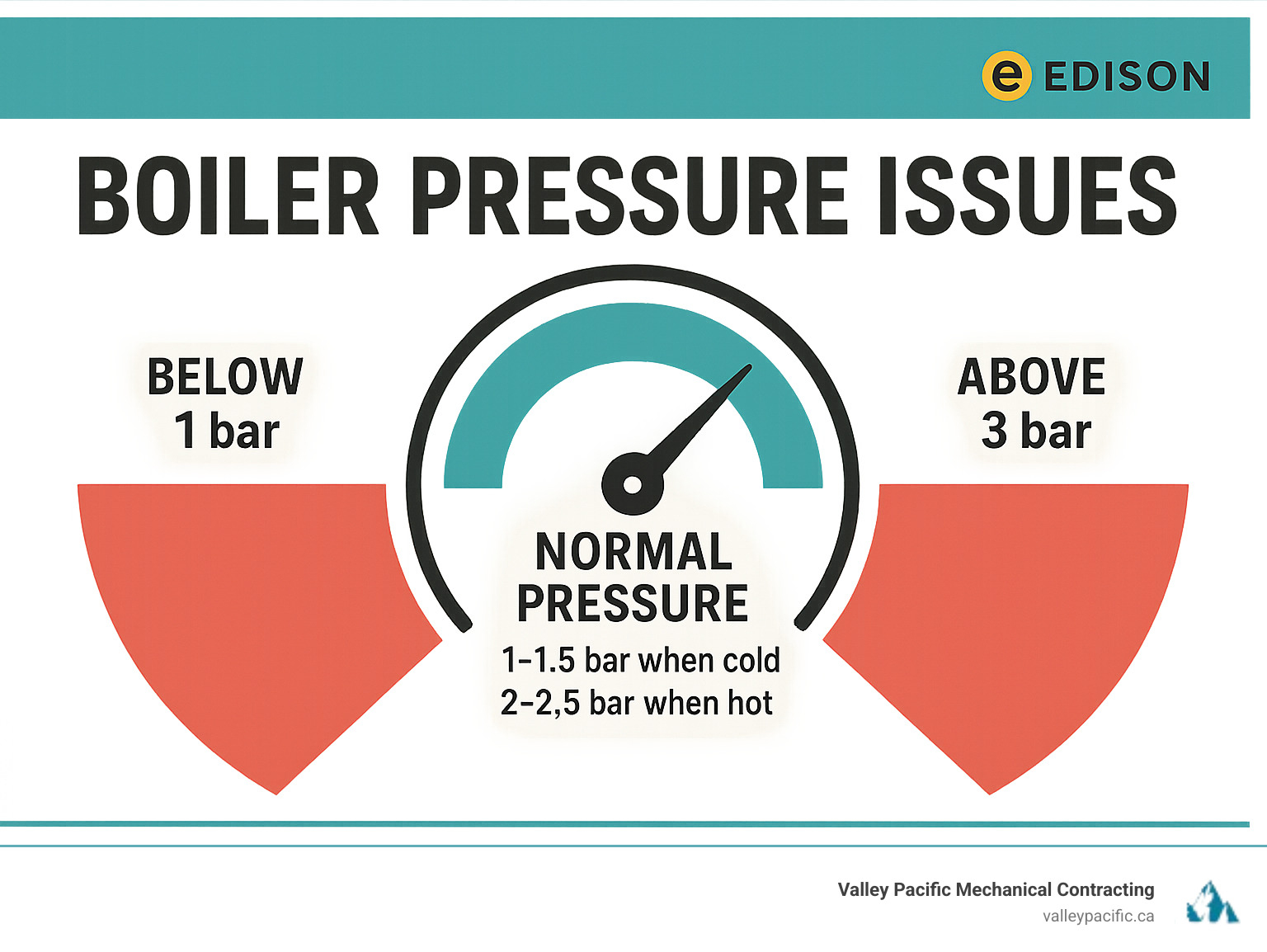
Understanding and Checking Your Boiler's Pressure
Boiler pressure is the force that pushes hot water through your pipes and radiators. When the pressure is right, your home stays warm. If not, you'll notice cold spots and strange noises.
Boiler pressure issues are straightforward. Your boiler is a sealed system, a closed loop where the same water circulates continuously.
When cold, your boiler should be between 1 and 1.5 bar. When the heating is on, the water heats and expands, causing the pressure to rise to between 2 and 2.5 bar. This is normal.
An expansion vessel acts like a shock absorber, accommodating the extra volume from heated water and managing these pressure changes.
Problems arise when pressure is consistently outside these ranges. Below 1 bar, the boiler may not start; above 3 bar, safety systems will activate.
| Pressure Issue | Low Boiler Pressure Signs | High Boiler Pressure Signs |
|---|---|---|
| Heating Performance | Radiators not heating properly, cold spots, weak circulation | Radiators may overheat, system works too hard |
| Sounds | Gurgling, banging, kettling noises from pipes and radiators | Whistling, excessive noise from boiler |
| Boiler Behavior | Frequent shutdowns, won't fire up, error codes | Automatic lockout, pressure relief valve activation |
| Visible Signs | No obvious external signs initially | Water dripping from overflow pipe outside |
How to Check Your Boiler's Pressure
Checking your boiler's pressure is an easy, 30-second task that can prevent future problems.
Locate your pressure gauge, which will be either an analogue dial or a digital display. Analogue gauges often have green (safe) and red (problem) zones.
For the most accurate reading, check the pressure when the system is cold (off for several hours).
Check before winter and after bleeding radiators, as bleeding releases water and can lower the pressure.
Simply read the number on the gauge. The ideal cold pressure is 1 to 1.5 bar.
Signs of Incorrect Boiler Pressure
Your heating system will give you signs when something is wrong. Catching these early can prevent serious problems.
The most obvious sign is radiators not heating properly. Low pressure means hot water can't reach all radiators, especially those far from the boiler.
Strange noises like gurgling can indicate air in the system (from low pressure), while banging or kettling suggests poor water flow.
Modern boilers will automatically shut down (lockout) if pressure is too low (below 0.5 bar) or too high (above 3 bar), often displaying an error code.
Look for leaks. High pressure can cause dripping from the external pressure relief pipe. Low pressure often indicates a leak somewhere in the system, causing damp spots.
If you're dealing with no hot water alongside these pressure symptoms, the two issues are likely connected. For more detailed troubleshooting steps, check out our guide on troubleshooting no hot water from boiler.
Troubleshooting Low Boiler Pressure
Low boiler pressure (below 1 bar) is a common issue, but it's usually simple to fix. In a sealed system, a pressure drop means water has escaped. The boiler needs this pressure to circulate hot water to your radiators.
Bleeding radiators is a common cause of pressure drops. When you release trapped air, a small amount of water escapes. You'll need to top up the pressure afterward.
Water leaks are another culprit. Even a tiny drip can cause a gradual pressure loss. If you're constantly repressurizing your system, a leak is the likely cause.
A faulty pressure relief valve can also cause pressure loss. It's designed to release water only at high pressure, but if it fails, it may drip constantly.
Older systems are more prone to developing small leaks over time as joints and seals wear out.
Fortunately, low pressure rarely requires expensive repairs and can often be fixed by repressurizing the system. For more guidance, see our guide on what to do when boiler pressure drops.
How to Repressurize Your Boiler (The Filling Loop)
Learning to repressurize your boiler is a basic skill that saves time and money. The process uses a "filling loop" to add water from the mains to your heating system.
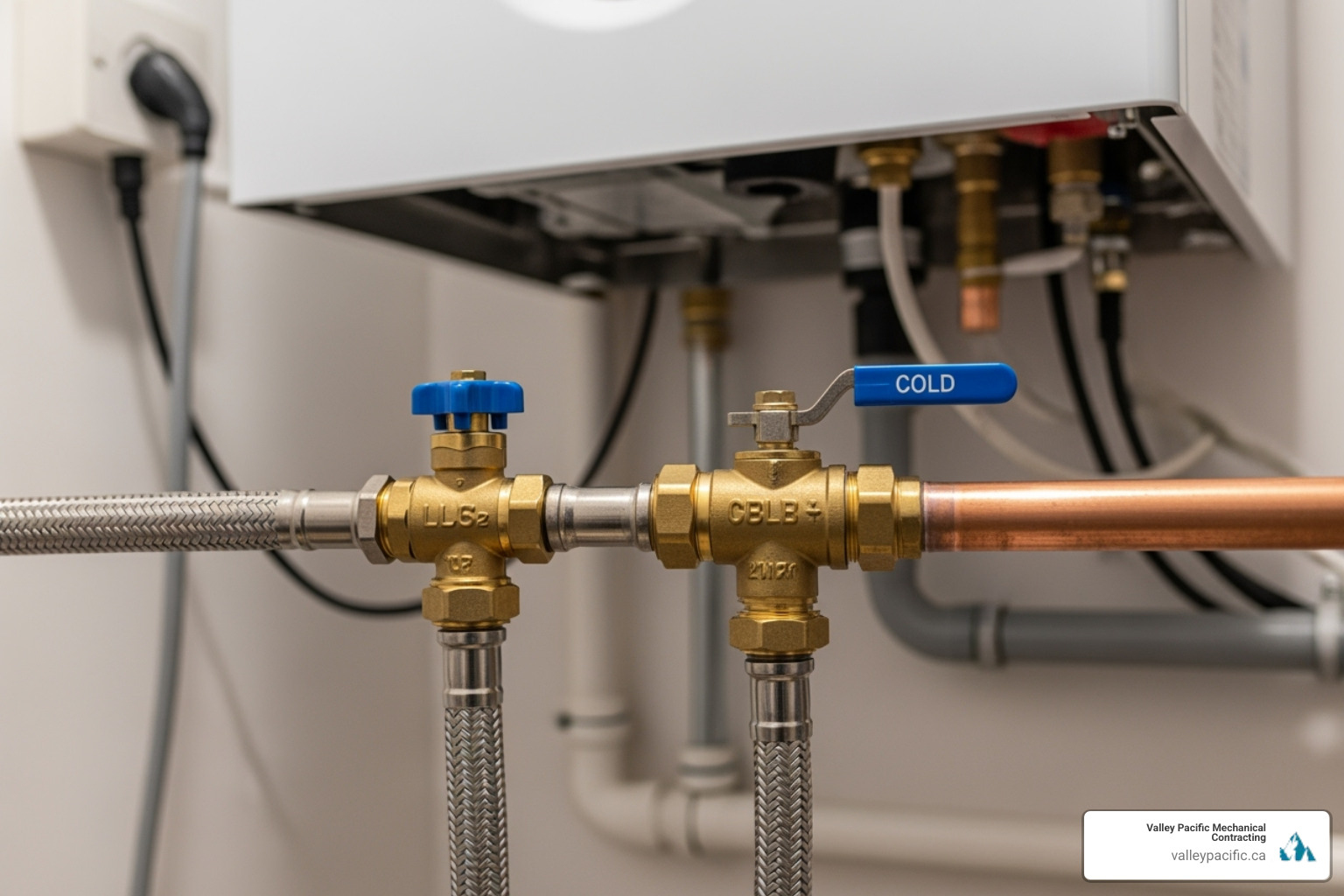
First, turn off your boiler and let it cool completely for safety and an accurate cold pressure reading.
Locate the filling loop under your boiler. It's a flexible hose or permanent pipe with two valves that connects your heating system to the water supply.
If the filling loop is detachable, ensure it's securely attached.
Slowly open both valves. You will hear water entering the system.
Watch the pressure gauge closely. As water enters, the pressure will rise. Aim for 1 to 1.5 bar. Do not let it go higher, or you will cause high-pressure problems.
Once you reach the target pressure, close both valves firmly to prevent overfilling.
If your filling loop is detachable, disconnect and store it.
Switch the boiler back on and press the reset button if needed to clear any error codes.
Consult your boiler manual for specific instructions, as models vary.
Finding Leaks: A Common Cause of Boiler pressure issues
If you're constantly repressurizing, you likely have a leak. Finding it requires some detective work, but leaks leave clues.
Start with a visual inspection of your heating system for damp patches, discolored paint, peeling wallpaper, or puddles, especially near pipes and radiators.
Listen for dripping sounds, which can lead you to hidden leaks inside walls or under floors.
Check radiator valves for dampness. A small leak from the spindle can sometimes be fixed by gently tightening it.
Inspect pipe joints for water stains, rust, or green corrosion, as they are common weak spots.
Check for drips under the boiler and inspect radiators thoroughly, including the bottom edges and back.
While you may find the leak, fixing it properly usually requires a professional. Unless it's a simple tightening of a valve, call an expert to resolve your boiler pressure issues permanently.
Tackling High Boiler Pressure
High boiler pressure (above 2.75 bar or in the red zone) is another common boiler pressure issue. It can cause significant problems for your heating system, putting unnecessary strain on components and triggering safety shutdowns that leave you without heat.
Overfilling the system is a common cause. This can happen if you add too much water when repressurizing or don't close the filling loop valves completely.
A faulty filling loop can also be the cause. If a valve is worn, it may allow water to continuously trickle into the system, slowly increasing the pressure.
Expansion vessel problems are also common. This component absorbs water expansion as it heats. If it fails or loses its air charge, the pressure will spike whenever the heating is on.
Less commonly, blockages from sludge or debris can cause pressure to build up, especially in older, unmaintained systems.
For more detailed information on this topic, Ariston has a helpful guide on Boiler Pressure Too High? Causes and how to fix it.
How to Safely Reduce Boiler Pressure
High pressure is often easier to fix than low pressure, as it simply involves removing excess water from the system.
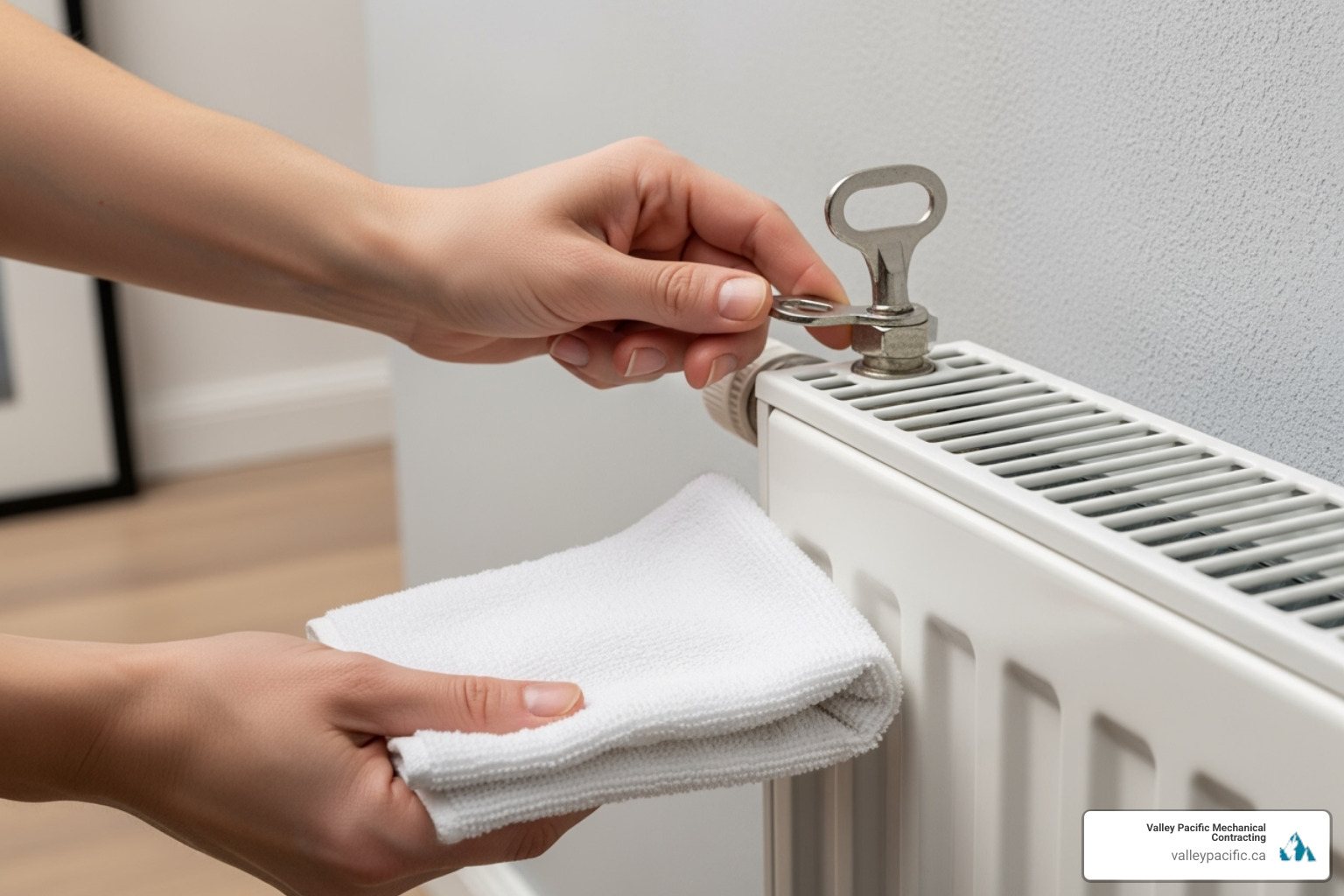
Bleeding radiators is the safest way to reduce high pressure. Turn off your boiler and let it cool down first.
Using a radiator key and a towel, slowly open the bleed valve on a radiator. Let air escape, followed by some water.
Watch the boiler's pressure gauge as you do this. Once the pressure drops to around 1.5 bar, close the valve. You may need to repeat this on another radiator if the pressure was very high.
If bleeding isn't enough, you can drain the system partially using a drain-off cock. However, if you're not comfortable with this, it's best to call a professional.
The pressure relief valve handles high pressure automatically and should not be operated manually. If it's constantly dripping, your pressure is too high or the valve is faulty.
This video shows you how to do it yourself and provides a helpful visual guide to the bleeding process.
The Role of Key Components in Boiler pressure issues
Understanding key components can help you spot problems early. When one part fails, the whole system is affected.
The expansion vessel is crucial for pressure control. It's a small tank with a diaphragm separating air and water. It absorbs the excess volume of expanding hot water, preventing pressure spikes. A failed expansion vessel causes pressure to be high when the system is hot and low when it's cold.
Your pressure relief valve (PRV) is a safety feature that opens to release water if the pressure exceeds 3 bar. A constantly dripping PRV indicates either high system pressure or a faulty valve.
The heat exchanger transfers heat to the water. A crack can cause internal leaks and pressure drops, while a clog can restrict flow and cause erratic pressure.
Component failures have predictable symptoms. A faulty expansion vessel causes pressure swings with temperature changes. A leaking PRV or heat exchanger causes a steady pressure drop.
If you've ruled out simple causes and the pressure is still erratic, you likely have a faulty component. Boiler error codes can often pinpoint the issue, signaling it's time to call a professional.
Preventative Maintenance and When to Call a Professional
Regular boiler maintenance is key to its longevity and reliability. Neglecting boiler pressure issues or general upkeep can lead to more serious problems.
Annual boiler servicing is the best way to maintain your system. A technician will check key components like the pressure relief valve and expansion vessel, inspect for leaks, and catch problems early.
Between services, perform regular DIY checks. Glance at the pressure gauge every few weeks, especially in winter. Catching issues early can prevent a system breakdown.
Bleed radiators periodically to keep the system efficient, and always check the pressure afterward.
The risks of ignoring incorrect boiler pressure include system strain wearing out parts, higher energy bills, damage to expensive components, and a complete loss of heat and hot water.
For comprehensive maintenance and repair services, including tackling stubborn pressure problems, our team is here to help. Learn more about our services for Boiler Repair Langley BC.
When to Call a Licensed Gas Fitter
While some boiler pressure issues are DIY-friendly, many situations require a professional. Knowing when to call an expert saves time, money, and avoids safety risks.
- Persistent pressure drops: If you're constantly repressurizing the system and can't find an external leak, you likely have an internal leak or faulty component that needs professional diagnosis.
- Rapidly rising pressure: If pressure rises quickly even after bleeding radiators, the expansion vessel or filling loop may be failing. This is not a DIY fix.
- Boiler error codes: Many pressure-related error codes point to complex internal faults that a professional can diagnose quickly.
- Suspected internal leaks: If pressure drops but there's no visible leak, a professional can use specialized equipment to find hidden leaks.
- Uncertainty or discomfort: If you're ever unsure or uncomfortable performing a fix, it's always safest to call for professional help.
- Safety concerns: Any unusual smells, sounds, or visible damage to your boiler requires immediate professional attention.
Our licensed professionals at Valley Pacific Mechanical have over 30 years of experience resolving complex boiler problems. We offer a headache-free experience with 24/7 emergency service. A qualified gas safe engineer (or a certified gas fitter like our team) has the training to keep your system running safely and efficiently.
Frequently Asked Questions about Boiler Pressure
We get many questions about boiler pressure issues. While it can seem mysterious, the basics are quite simple.
Why does my boiler pressure rise when the heating is on?
This is a common question with a simple physics-based answer: water expands when heated. As your heating warms the water in the system, the pressure naturally rises.
A normal pressure increase is from 1-1.5 bar (cold) to about 2-2.5 bar (hot). This indicates your boiler is working correctly.
However, a dramatic pressure increase (e.g., from 1 bar to over 3 bar) signals a problem, usually with the expansion vessel. A faulty vessel cannot accommodate the expanding water, causing a pressure spike.
Is low or high boiler pressure dangerous?
Modern boilers are very safe. They have features like automatic shut-offs and pressure relief valves to prevent dangerous situations.
If pressure is too high, the relief valve releases water. If it's too low, the boiler enters lockout mode and won't start, protecting the system.
While not dangerous in an explosive sense, incorrect pressure is still a problem. It strains the system, increases energy bills, and can lead to expensive component failures if ignored.
How does bleeding radiators affect boiler pressure?
Bleeding a radiator releases trapped air, which helps it heat evenly. However, bleeding also releases a small amount of water from the sealed system. This water loss causes the overall system pressure to drop.
You will almost always need to repressurize your boiler after bleeding radiators to return it to the optimal 1-1.5 bar range. If the pressure is below 1 bar, follow the steps to repressurize it.
Always check your boiler pressure after radiator maintenance to keep your system running smoothly.
Conclusion
Managing your boiler's pressure is crucial for your home's comfort and budget. Boiler pressure issues are often the cause of problems like cold radiators, strange noises, or a boiler that stops working.
You now have the knowledge to handle many of these problems. Regularly checking the pressure, knowing how to repressurize the system, and spotting warning signs early can prevent major issues. Aim for 1-1.5 bar when cold, and expect a normal rise to 2-2.5 bar when hot.
However, some issues require professional attention. Persistent pressure drops, error codes, or constantly rising pressure are signs it's time to call an expert.
That's where Valley Pacific Mechanical comes in. With over 30 years of experience across the Lower Mainland, from Mission to Coquitlam, our licensed technicians solve heating problems efficiently. We know a broken boiler is a major disruption, so we offer 24/7 emergency service for a headache-free experience.
Whether you need a quick fix, a system check, or an upgrade, we're here to help. You deserve consistent heat and hot water, and the peace of mind that your system is in good hands.
For a professional boiler installation in Langley, contact us today!
Why Your Coquitlam Home Needs Reliable Boiler Care
When your boiler repair Coquitlam needs arise, finding the right professional can mean the difference between a quick fix and days without heat or hot water. Whether you're dealing with strange noises, no hot water, or rising energy bills, knowing what to look for in a repair service saves you time, money, and stress.
Quick Guide to Choosing Boiler Repair Services in Coquitlam:
- Licensed gas fitters with proper certifications
- 24/7 emergency availability for urgent breakdowns
- Transparent pricing with upfront quotes
- Local reputation with positive customer reviews
- Insurance and bonding for your protection
- Experience with your boiler brand and type
Living in Coquitlam means dealing with cold winters where a functioning boiler isn't just comfort - it's essential. Boilers typically last 10-15 years with proper maintenance, but when problems arise, they need expert attention fast.
Strange noises, leaks, or inconsistent heating are your boiler's way of asking for help. The good news? Most boiler problems can be fixed on the spot by skilled technicians who understand the unique needs of Coquitlam homes.
This guide walks you through everything you need to know - from spotting early warning signs to choosing the right repair professional who'll get your home comfortable again.
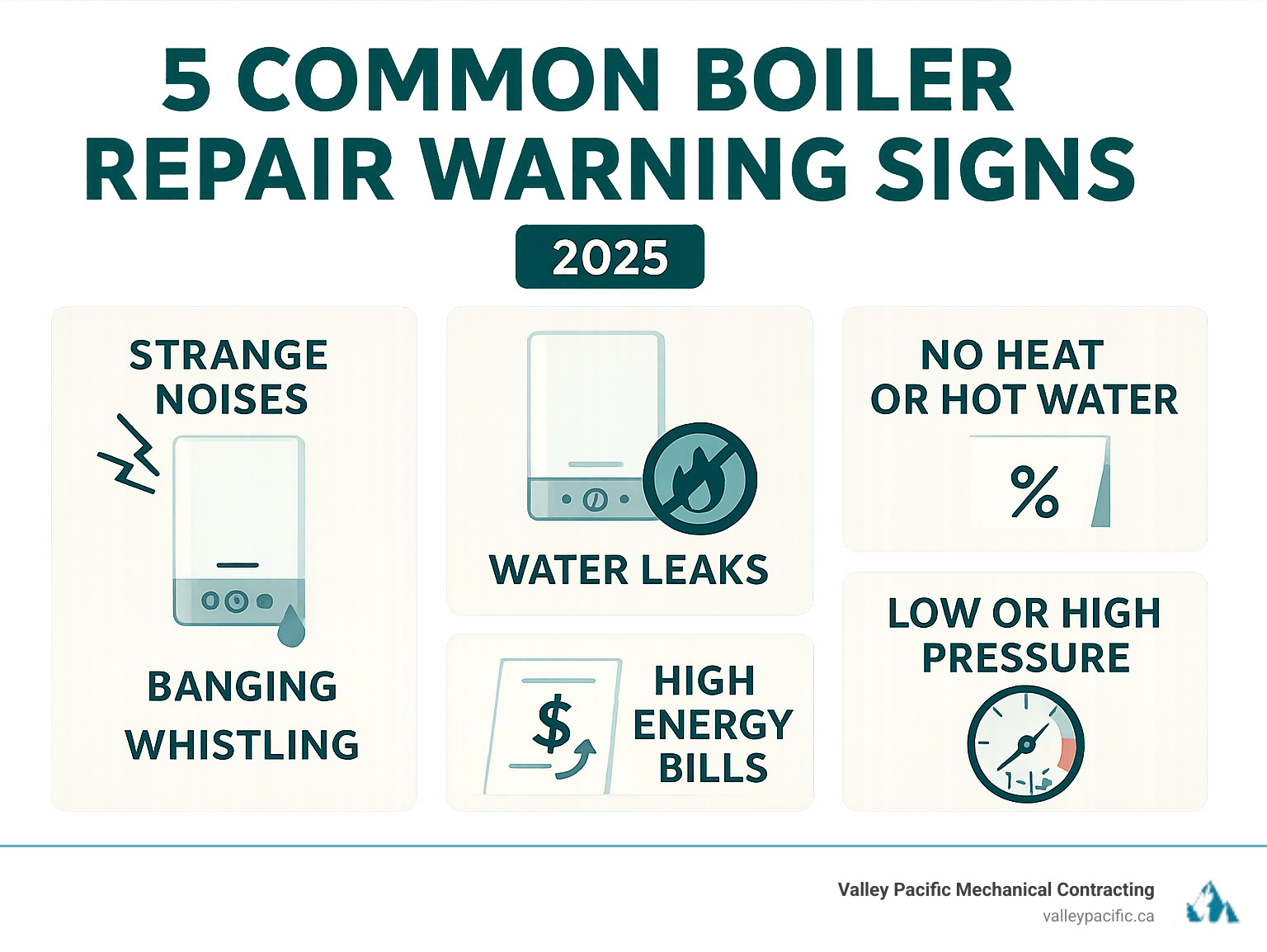
Telltale Signs Your Boiler Needs a Check-Up
Your boiler works quietly behind the scenes, keeping your Coquitlam home cozy and your showers warm. But when something's not right, it usually gives you fair warning - if you know what to look for.
Think of these signs as your boiler's way of raising its hand and saying "Hey, I need some help here!" Catching problems early can save you from those middle-of-winter emergencies when you really don't want to be without heat.
Strange noises are usually the first clue something's up. If your boiler suddenly sounds like it's hosting a percussion concert, pay attention. Banging (sometimes called "kettling") often means limescale has built up and is restricting water flow. Whistling could point to trapped air or a pump that's struggling. Gurgling sounds typically suggest air bubbles in the system or pressure issues.
Leaks and drips around your boiler are never something to ignore. Even a small puddle can signal bigger problems brewing - from worn seals to corroded pipes or a faulty pressure relief valve. Water and heating systems don't mix well when the water's in the wrong place.
When you have no heat or hot water, your boiler has clearly decided to take an unscheduled break. This could be anything from a thermostat having a bad day to a broken pump or diverter valve issues. If you're specifically dealing with hot water problems, our guide on troubleshooting no hot water from boiler can help you understand what might be happening.
Keep an eye on those rising energy bills too. If your utility costs suddenly spike without you cranking up the heat, your boiler might be working overtime to do its job. When components wear out or sediment builds up, efficiency drops and your wallet feels it.
For older boilers with a pilot light, watch the flame color. A healthy pilot light burns blue. If it's yellow or orange, or keeps going out, that's a safety concern that needs immediate attention from a professional boiler repair Coquitlam technician.
Low boiler pressure is another common issue. Your pressure gauge should read between 1 and 1.5 bars when the system is cold. If it consistently drops below this range, your boiler might struggle to heat properly or shut down entirely. Our detailed guide on what to do when boiler pressure drops walks you through the steps.
If your boiler keeps cycling on and off frequently - what we call "short cycling" - it's working harder than it should. This could be a thermostat problem, internal control issues, or even a sizing mismatch.
The good news? Most of these problems are fixable when caught early. The key is not waiting until you're shivering in your pajamas at 6 AM on a Monday morning. When you notice any of these warning signs, it's time to call in a qualified professional who can diagnose the issue and get your home comfortable again.
The Ultimate Guide to Boiler Repair Coquitlam Services
When your boiler decides to call it quits on the coldest day of winter (because that's always when it happens, right?), you need more than just a repair service – you need a reliable partner who understands the urgency. Professional boiler repair Coquitlam services are designed to get your home warm and comfortable again, fast.
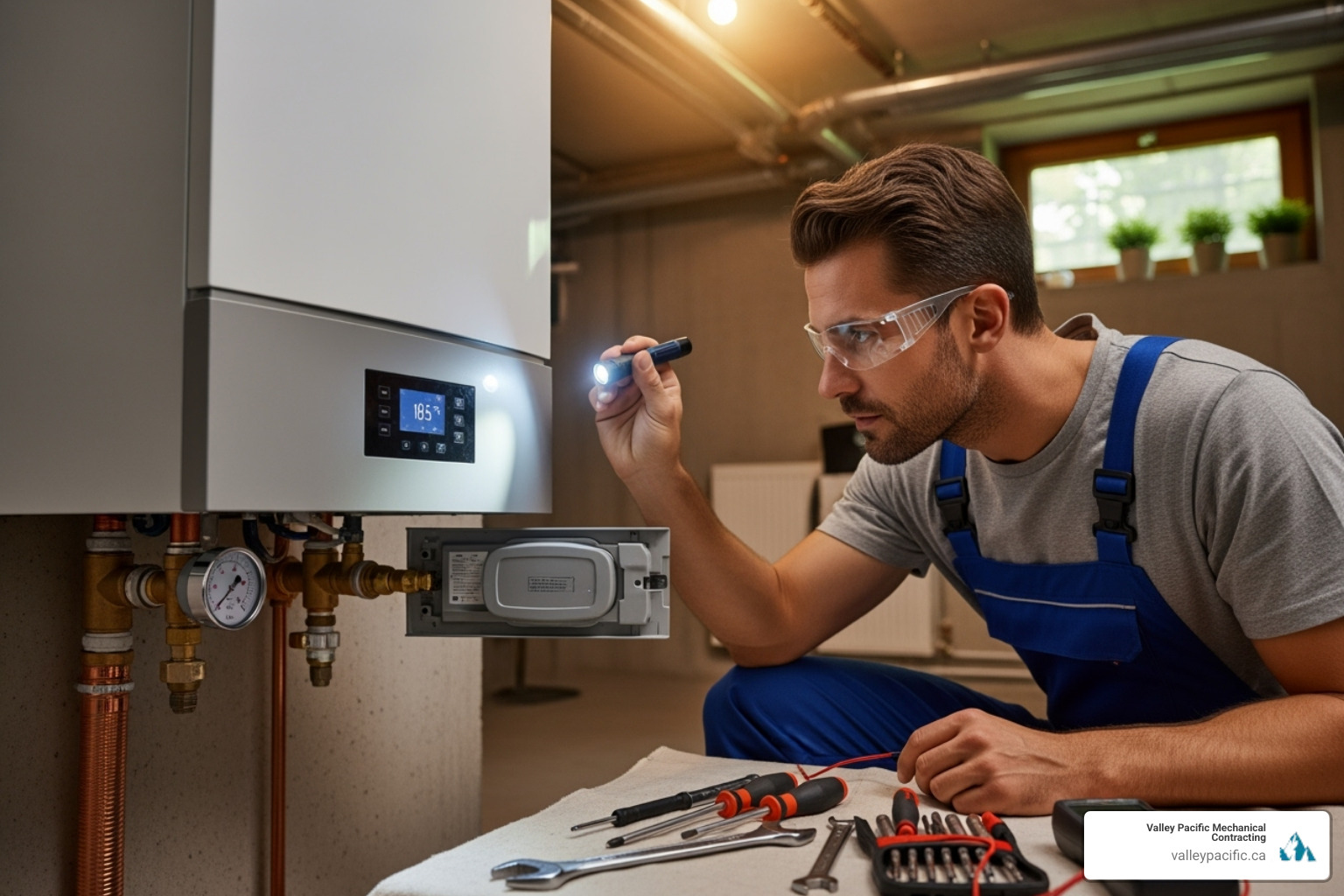
The reality is that boiler emergencies don't wait for convenient business hours. That's why 24/7 emergency response isn't just a nice-to-have feature – it's essential. When you're dealing with no heat in the middle of a Coquitlam winter, rapid response times can prevent water pipes from freezing and save you from a very uncomfortable night.
Safety always comes first when dealing with boiler repairs. Gas-fired boilers, in particular, require expert handling to avoid serious risks. Professional technicians prioritize your family's safety through comprehensive carbon monoxide testing – this colorless, odorless gas can be deadly if produced by a faulty boiler. They also conduct thorough gas leak detection to prevent fire hazards and ensure your gas lines are secure.
All quality repair work must meet local safety regulations as overseen by Technical Safety BC. This isn't just about following rules – it's about ensuring your boiler operates safely and legally, giving you peace of mind for years to come.
What to Expect from a Boiler Repair Coquitlam Technician
When a skilled technician arrives at your door, they bring both expertise and a systematic approach to solving your heating problems. The process starts with a thorough system diagnosis using advanced diagnostic tools. Most experienced technicians can identify issues quickly and accurately, often fixing boiler problems on the spot.
Once they've pinpointed the problem, the real work begins with component repair or replacement. This might involve fixing pumps, valves, thermostats, or electronic control boards. The best repair services come prepared with a wide range of common parts – control boards, transformers, relays, zone control valves, gas controls, thermocouples, aqua stats, and expansion tanks. Having these parts on hand means on-the-spot fixes whenever possible, getting your heat back quickly.
Pressure adjustment is another crucial step. Your boiler's pressure should typically read between 1 and 1.5 bars for optimal operation. Technicians will check and adjust this as needed to ensure your system runs efficiently.
After repairs, comprehensive efficiency testing confirms everything is working properly. This includes checking the air supply for the burner and ensuring all valves operate correctly. Many services also include descaling to remove built-up sediment and limescale, plus soot removal from the combustion chamber. These steps can significantly boost your boiler's efficiency and prevent future problems.
The best technicians explain all repair options clearly before starting work, so you understand exactly what's happening and why. You can learn more about comprehensive boiler services at Our Boiler Services.
Boiler Brands and Types We Service
Modern Coquitlam homes feature a variety of boiler types, each with its own advantages. High-efficiency boilers are designed to maximize energy savings by recovering heat that would otherwise escape. Combi-boilers are popular for their compact design – they provide both central heating and instant hot water without needing a separate tank. Natural gas boilers remain the most common choice, offering efficient and consistent heat throughout the home.
Professional repair services work with all major boiler brands commonly found in local homes. This includes trusted names like Viessmann, Triangle Tube, Navien, NTI, Laars, Bosch, Lennox, Rheem, Bradford White, and many others. The key is finding technicians who stay current with the latest technologies and models, ensuring they can handle whatever boiler challenge comes their way.
Whether you have a brand-new high-efficiency unit or an older reliable workhorse, experienced technicians have the knowledge and parts inventory to get your system running smoothly again.
The Big Decision: Repair or Replace Your Boiler?
Standing in front of a broken boiler on a cold Coquitlam morning, you're faced with a question every homeowner dreads: Should I fix this thing again, or is it time to say goodbye? It's a decision that can feel overwhelming, especially when you're already dealing with no heat or hot water.
The truth is, there's no one-size-fits-all answer. But understanding a few key factors can help you make the right choice for your home and budget.
Most boilers live happy, productive lives for 10-15 years with proper care. If your boiler is still in its prime years (under 10), a repair usually makes perfect sense. Think of it like your car - you wouldn't replace a 5-year-old vehicle because of a flat tire, right?
But when your boiler starts hitting those teenage years, the math changes. Frequent breakdowns become more than just an inconvenience - they're a sign your system is telling you something important.
Energy efficiency is another game-changer. Older boilers can be real energy hogs compared to today's high-efficiency models. If your utility bills have been creeping up even though your heating habits haven't changed, a new boiler might actually pay for itself through long-term savings.
The repair cost itself matters too. When a single repair bill approaches half the cost of a new system, it's worth having a serious conversation about replacement. Especially if you've been calling for boiler repair Coquitlam services more than once in the past year.
Here's how the numbers typically break down:
| Factor | Repair | Replace |
|---|---|---|
| Age | Boiler is less than 10 years old | Boiler is 10-15+ years old |
| Cost | Minor, inexpensive repair | High repair cost, frequent repairs |
| Efficiency | Boiler still operates efficiently | Boiler's efficiency has significantly dropped |
| Frequency of Issues | Isolated incident | Frequent breakdowns, recurring problems |
| Long-Term Outlook | Extends current boiler life for a few years | Significant long-term savings, improved comfort |
The good news? You don't have to make this decision alone. Our experienced technicians can assess your specific situation, taking into account your boiler's condition, your budget, and what makes sense for your family's long-term comfort.
If replacement is the right path, we're here to help every step of the way. From preparing your home for a new boiler to walking you through our professional boiler replacement process, we'll make sure the experience is as headache-free as possible.
Whether you repair or replace, the goal is the same: a warm, comfortable home that you can count on, season after season.
The Power of Prevention: Boiler Maintenance Essentials
Think about your favorite coffee maker - the one that faithfully brews your morning cup every single day. You wouldn't wait until it completely stops working to give it some care, right? Your boiler deserves the same thoughtful attention, especially when it's working hard to keep your Coquitlam home cozy through those chilly months.

Annual maintenance is like giving your boiler a yearly health check-up. Just as you wouldn't skip your doctor's appointment, your heating system needs that professional once-over to catch small issues before they turn into expensive headaches. The best time? Right before winter arrives, when you need your boiler most.
Here's the beautiful thing about regular boiler care - it pays you back in so many ways. System longevity jumps to the top of the list. A well-maintained boiler can serve your family faithfully for its full 10-15 year lifespan, instead of giving up early due to neglect.
Peak efficiency is another game-changer. Over time, your boiler collects dust, debris, and mineral buildup that makes it work harder than it should. Think of it like trying to breathe through a stuffy nose - everything becomes more difficult. When a technician cleans and tunes your system, it's like clearing those airways. Your boiler breathes easier and heats more effectively.
Those lower utility bills start showing up almost immediately after a good maintenance visit. An efficient boiler uses less energy to do the same job, which means more money stays in your pocket each month. It's one of those rare situations where spending a little upfront actually saves you money.
Safety might be the most important benefit of all. During maintenance, technicians test for carbon monoxide leaks and ensure all safety systems work properly. These checks protect your family from invisible dangers that could otherwise go unnoticed.
The real magic happens in preventing breakdowns. There's nothing quite like the sinking feeling when your boiler decides to quit on the coldest day of the year. Regular maintenance catches those potential problems when they're still small and manageable, not when they've grown into emergency boiler repair Coquitlam situations.
What happens during your annual boiler maintenance? Your technician becomes a detective, methodically checking every part of your system. They'll inspect everything visually first, looking for signs of wear or leaks. Then comes the operational testing - making sure your boiler starts up smoothly and cycles properly.
Pressure checks ensure your system maintains that sweet spot between 1 and 1.5 bars. Component testing covers all the important parts - pumps, fans, burners, and safety devices get individual attention. Your technician will clean internal components, removing buildup that reduces efficiency.
Gas pressure verification and venting system inspection keep everything running safely. They'll test your thermostat accuracy and check all safety devices like pressure relief valves. It's thorough work that gives you confidence in your system.
The investment in annual maintenance prevents future damage and saves significant money over time. When you consider the alternative - emergency repairs, higher energy bills, and shortened equipment life - prevention becomes the clear winner for your wallet and your peace of mind.
Choosing Your Coquitlam Boiler Repair Champion
When your boiler falters, you need a hero, not a headache. Choosing the right boiler repair Coquitlam company is crucial for a smooth and effective resolution. With so many options, how do you find the champion that will get your home warm and comfortable again?
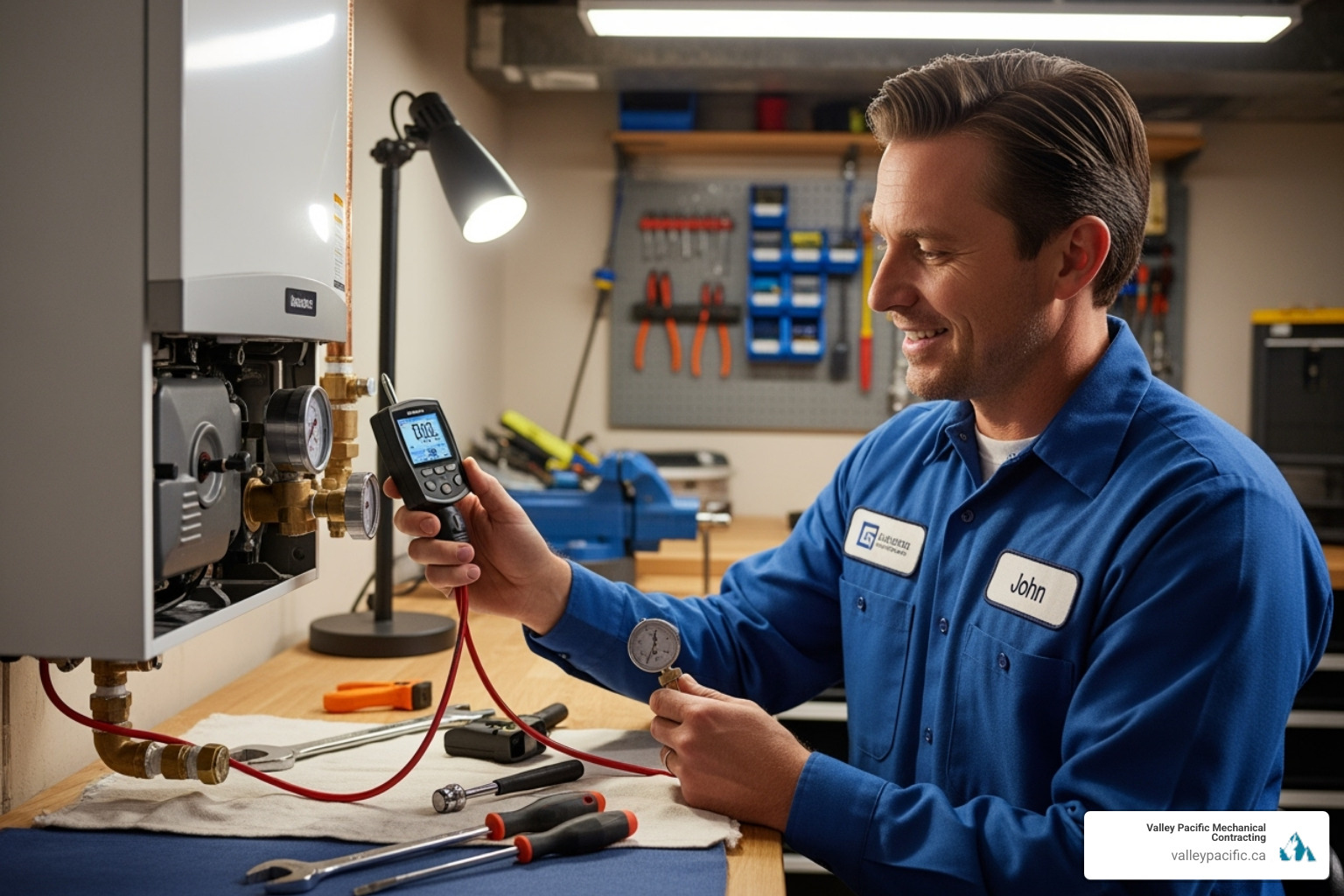
- Credentials & Licensing: This is non-negotiable. Ensure any company you consider employs licensed gas fitters and technicians certified by relevant provincial authorities. In British Columbia, this often involves certifications from Technical Safety BC. Licensing ensures they have the necessary training and expertise to work safely and effectively on your boiler.
- Insurance: Always verify that the company is fully insured and bonded. This protects you from liability in case of accidents or damage during the repair process.
- Experience & Expertise: Look for a company with a proven track record. Our team, for example, brings over 30 years of expertise in the HVAC and mechanical services industry. This extensive experience means we've encountered virtually every boiler problem imaginable and know how to diagnose and fix them efficiently.
- Customer Reviews: What do other Coquitlam residents say? Check online reviews on platforms like Homestars or Google. A consistent pattern of positive feedback regarding professionalism, punctuality, and quality of work is a strong indicator of a reputable company.
- Trusted Local Reputation: A company deeply rooted in the local community often has a stronger commitment to customer satisfaction. We proudly serve Coquitlam, along with our other local communities like Mission, Maple Ridge, and Langley, and understand the unique heating needs of homes in the Lower Mainland.
- Transparent Pricing: Nobody likes hidden fees or surprises. A reputable company will provide clear, upfront quotes before any work begins, explaining all repair options in plain language. You should know exactly what to expect.
- 24/7 Emergency Availability: Boilers don't break down on a schedule. The best companies offer 24/7 emergency service, ensuring that you're not left in the cold during an unexpected breakdown, no matter the time of day or night.
- Service Guarantees: Look for companies that stand behind their work. A satisfaction guarantee or warranty on parts and labor shows confidence in their service quality. We're not happy until you're happy.
Key Qualities for the Best Boiler Repair in Coquitlam
Beyond the general considerations, certain qualities truly set the best boiler repair services apart:
- Licensed Gas Fitters: As mentioned, this is paramount for safety and competence, especially when dealing with gas-fired boilers.
- Insured & Bonded: Protection for you and the technicians ensures peace of mind during the service.
- Positive Local Reputation: A company that consistently earns high praise from its local customers demonstrates reliability and trustworthiness.
- Clear Communication: The best technicians explain the problem, the proposed solution, and the costs involved in a way that's easy for you to understand, without technical jargon.
- Upfront Quotes: No surprises. A detailed, written estimate before work commences is a hallmark of professional service.
- Daikin Comfort Promise: As a testament to our commitment to customer satisfaction, we adhere to the Daikin Comfort Promise, ensuring your complete happiness with our services.
Choosing us means choosing a 'headache-free' experience from start to finish. We are committed to giving our customers the very best service possible. To learn more about our commitment to excellence, visit our About Us page.
Frequently Asked Questions about Boiler Issues
When your boiler starts acting up, it's natural to have questions. As boiler repair Coquitlam professionals with over 30 years of experience, we've heard them all. Here are the most common concerns homeowners share with us, along with straight answers that help keep your family safe and comfortable.
How often should my boiler be serviced?
Think of your boiler like your car - it needs regular check-ups to keep running smoothly. Annual service is the sweet spot for maintaining safety, efficiency, and getting the most years out of your investment.
The best time to schedule this? Before winter arrives. There's nothing worse than finding your boiler has issues on the first cold day of the season when every repair company in Coquitlam is swamped with emergency calls.
That yearly tune-up does more than just prevent breakdowns. It keeps your utility bills reasonable, catches small problems before they become expensive headaches, and gives you peace of mind knowing your family's heating system is running safely.
What should I do if I smell gas near my boiler?
This is serious - no question about it. The smell of gas around your boiler means you need to act fast and follow these steps exactly:
Get everyone out immediately. Don't walk, don't collect anything, just get your family and pets outside to safety. Once you're evacuating, avoid using any electronics - no light switches, no phones inside the house, no appliances. Even the smallest spark could be dangerous.
From a safe location away from your home, call your gas utility's emergency line first. If you're a FortisBC customer, call their emergency number. Other gas providers have their own emergency lines. They'll handle the immediate safety concern.
After the utility company has made sure everything is safe, then call a certified gas fitter to inspect and repair your system. Don't go back inside until professionals give you the all-clear.
Can I perform boiler repairs myself?
We get it - you're handy around the house, you've fixed plenty of things before, and you'd rather save some money. But boiler repair? This is definitely not a DIY job.
Here's the thing: boilers are complex systems that combine gas, electricity, water, and high-pressure components. Getting any of these wrong can create serious dangers. Gas leaks can lead to explosions or fires. Faulty combustion produces carbon monoxide - that silent, deadly gas you can't see or smell. There's also the risk of electrical shock from the control systems and potential water damage if connections aren't properly sealed.
Beyond the safety risks, boiler repair requires specialized tools, training, and certifications that take years to develop. What might seem like a simple fix often connects to other system components in ways that aren't obvious.
Licensed professionals exist for good reason - they have the knowledge and experience to diagnose problems correctly, make safe repairs, and ensure everything works properly together. When it comes to your family's safety and comfort, it's worth investing in expert care.
Your Partner for a Warm and Safe Coquitlam Home
When your boiler breaks down in the middle of a cold Coquitlam winter, you need more than just a repair service – you need a partner who truly understands what it means to restore comfort to your home. That's exactly what we've been doing for families and businesses across the Lower Mainland for over 30 years.
Our approach is simple: we believe dealing with heating problems shouldn't give you a headache. From the moment you call us to the final test of your newly repaired system, we're committed to making the entire experience as smooth and stress-free as possible. No surprises, no confusing technical jargon, and definitely no being left in the dark about what's happening with your boiler.
Professional service means more than just fixing the immediate problem. It means having licensed gas fitters who arrive on time, explain what they're doing, and clean up after themselves. It means standing behind our work with solid guarantees and the Daikin Comfort Promise. Most importantly, it means you can trust that when we leave, your boiler will be running safely and efficiently.
Whether you're dealing with strange noises at 2 AM, no hot water on a busy Monday morning, or you're simply ready for that annual maintenance check, we're here. Our 24/7 emergency service isn't just a marketing promise – it's our commitment to being there when Coquitlam families need us most.
Peace of mind comes from knowing you've chosen a team that's seen it all. After three decades in the business, there isn't a boiler problem we haven't encountered or a heating challenge we can't solve. We've built our reputation one satisfied customer at a time, right here in the communities we call home.
Ready to experience the difference that professional boiler repair Coquitlam service can make? Contact Us today to schedule your service or speak with one of our friendly experts. You can also Request a Quote custom to your specific needs.
And if you're exploring all your home comfort options, don't forget to Learn more about our comprehensive heat pump services – another way we help keep Lower Mainland homes comfortable year-round.
Your warm, safe, and comfortable home is our priority. Let's get your heating system back to doing what it does best.
Why Reliable HVAC Service Matters for Coquitlam Homeowners
HVAC repair Coquitlam services are essential when your heating or cooling system breaks down. A furnace failing in winter or an AC struggling in summer requires a fast response from a local contractor to avoid discomfort and high emergency repair costs.
Living in Coquitlam means dealing with coastal climate challenges that stress your HVAC system. The damp winters and occasional hot summers make reliable heating and cooling crucial. When you face common issues like no heat, weak airflow, or strange noises, you need licensed professionals who can help. Reputable contractors offer 24-hour emergency service to get your system running again quickly.
This guide covers everything about HVAC repair in Coquitlam, from recognizing warning signs to choosing a contractor and deciding between repair or replacement.
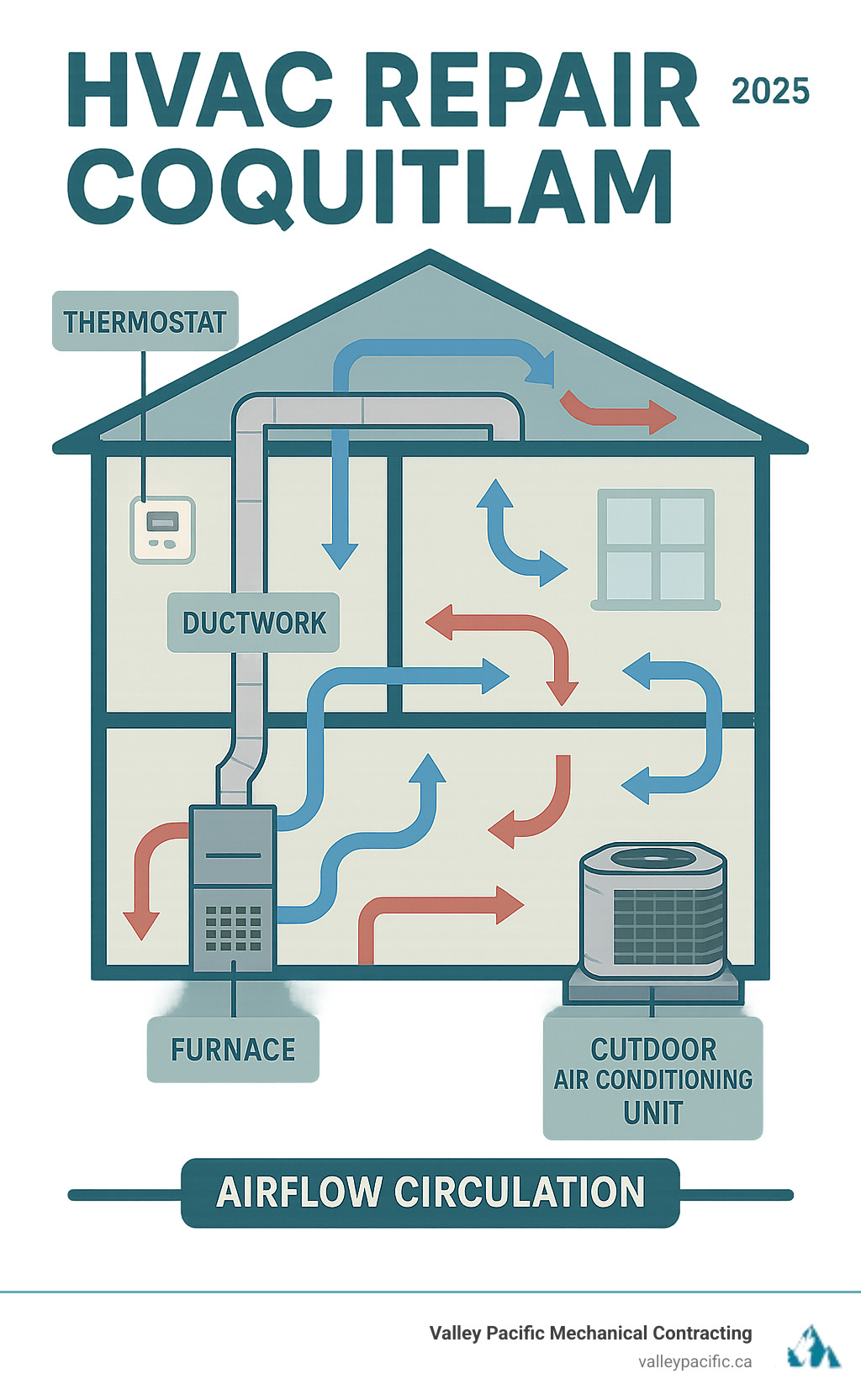
Recognizing the Red Flags: When to Call for HVAC Help
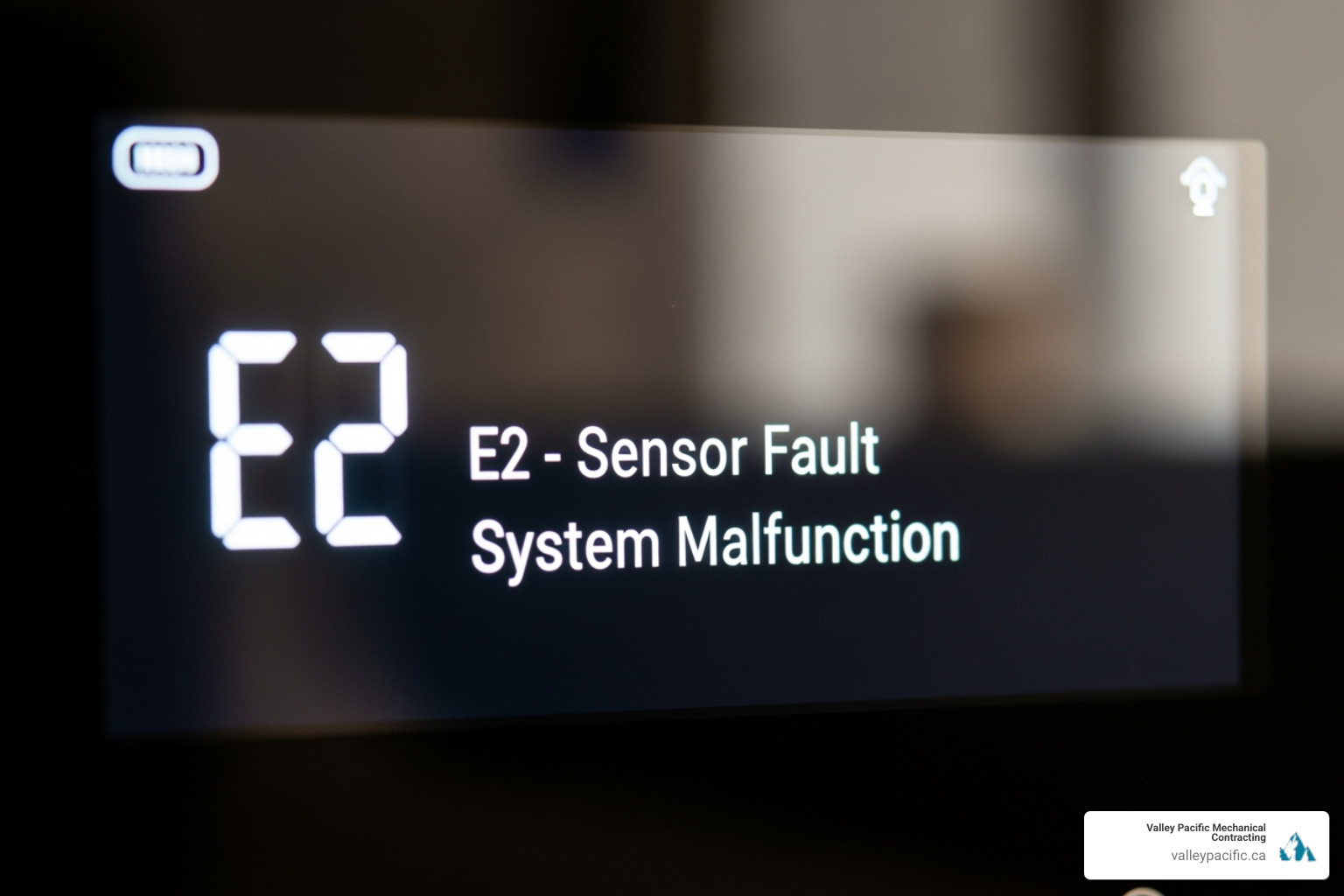
Your HVAC system usually gives warning signs before a complete breakdown. Knowing what to look for can save you from a cold morning with no heat.
- Strange noises: Banging, rattling, or grinding sounds often indicate loose parts or worn bearings.
- Unusual smells: A burning odor can signal electrical problems, while musty smells may point to mold in the ductwork. If you smell gas, evacuate immediately, call your gas company, then contact us for emergency service.
- Weak airflow: Air from vents feeling weak could mean a clogged filter, blocked ducts, or a failing blower motor.
- Inconsistent temperatures: Some rooms being too hot while others are cold can be caused by thermostat issues or leaky ducts.
- Rising energy bills: A sudden spike in your bills without a change in usage suggests your system is working inefficiently.
- System short-cycling: When your HVAC turns on and off too frequently, it causes excess wear and wastes energy.
- Water leaks: Leaks around your indoor or outdoor units are never a good sign and often point to a clogged drain line or other drainage problems.
Noticing these signs means it's time to call for professional HVAC repair Coquitlam service before a small problem becomes a major one.
Common Signs Your Furnace Needs Repair
During Coquitlam's chilly months, a malfunctioning furnace is an urgent problem. Key signs include:
- No heat production: The furnace runs but blows cold air, or it won't turn on at all. This could stem from the thermostat, gas supply, or ignition system.
- Pilot light issues: A flickering, yellow, or extinguished pilot light on older furnaces often indicates a problem with the thermocouple or gas flow. A yellow flame is a safety concern as it can indicate carbon monoxide production.
- Banging or rattling sounds: These noises can point to a loose blower wheel or a failing motor.
- Frequent cycling: The furnace turns on and off repeatedly, which is inefficient and hard on the system.
- Soot buildup: Soot around your furnace is another warning sign of incomplete combustion and potential carbon monoxide issues.
Don't risk your safety with furnace problems. Our team provides reliable Furnace Repair Coquitlam service.
Telltale Symptoms of a Failing Air Conditioner
When summer arrives, a struggling AC unit is immediately noticeable. Watch for these symptoms:
- Blowing warm air: This often means low refrigerant, a compressor issue, or a blocked condenser coil.
- Refrigerant leaks: Ice on refrigerant lines or hissing sounds indicate a leak that needs professional attention.
- Poor cooling performance: If your home never gets cool enough, the cause could be dirty filters or an undersized system.
- High humidity indoors: Your AC also dehumidifies. If your home feels clammy, the system isn't removing moisture properly.
- Frequent cycling: Like furnaces, ACs that turn on and off too often are inefficient and wearing out faster.
When your AC shows these signs, our experts provide dependable Air Conditioning Repair Coquitlam service to restore your comfort.
The Importance of Regular Maintenance
Regular maintenance is the best way to ensure your HVAC system is reliable and efficient.
- Preventative care: Technicians can catch small issues like loose wiring or dirty coils before they become expensive repairs.
- System longevity: Most HVAC systems last 10-20 years with proper care, but neglect can shorten this lifespan significantly.
- Energy efficiency: A well-maintained system uses less energy, lowering your utility bills. A clean filter alone can make a big difference.
- Improved air quality: Cleaning filters, coils, and other components removes dust and allergens from the air you breathe.
- Warranty validity: Most manufacturers require proof of regular professional maintenance to keep your warranty valid.
We offer comprehensive Services to keep your system running efficiently. An annual or bi-annual service appointment is a small investment that provides significant returns in comfort and peace of mind.
The Big Decision: Repair or Replace Your HVAC System?
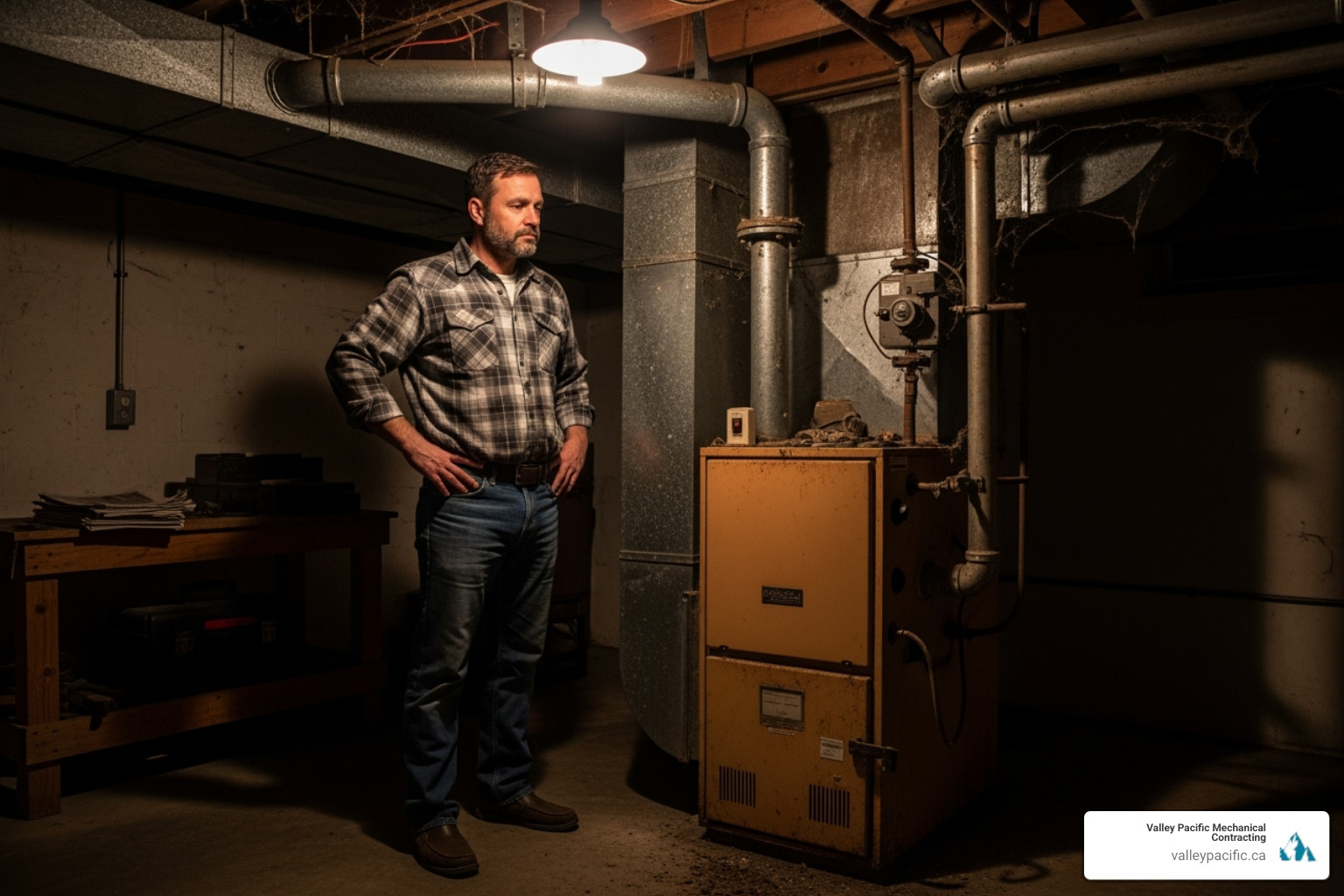
When your HVAC system breaks down, you face a tough decision: repair it again or replace it entirely? The cheaper repair might seem appealing, but it's not always the most cost-effective solution in the long run. The right choice depends on cost, system age, repair frequency, and your energy efficiency goals.
Average Lifespan of HVAC Components
Knowing the typical lifespan of your equipment can help guide your decision. These figures assume regular professional maintenance.
ComponentAverage Lifespan (with proper maintenance)Furnaces15-20 yearsAir Conditioners10-15 yearsHeat Pumps10-15 yearsBoilers15-20+ years
Coquitlam's coastal climate can be tough on outdoor units, making proper installation and regular care even more critical.
When to Repair vs. When to Replace
A good guideline is the "50% rule": if a repair costs more than half the price of a new system, replacement is usually the better financial choice.
Consider repairing your system if:
- It has minor issues with a reasonable repair cost.
- The system is under 10 years old and has been reliable.
- The equipment is still under warranty, which may cover the costs.
Consider replacing your system if:
- It needs a major component replacement, like a compressor or heat exchanger.
- It uses outdated technology, such as R-22 refrigerant.
- It has poor energy ratings, leading to high utility bills.
- You are calling for frequent breakdowns and repairs.
For heat pumps, which are well-suited for BC's climate, the same principles apply. Our team provides expert Heat Pump Repair Coquitlam services and can offer honest advice on whether to repair or replace your unit. We'll help you make the best call for your home and budget.
Your Guide to Professional HVAC Repair Coquitlam
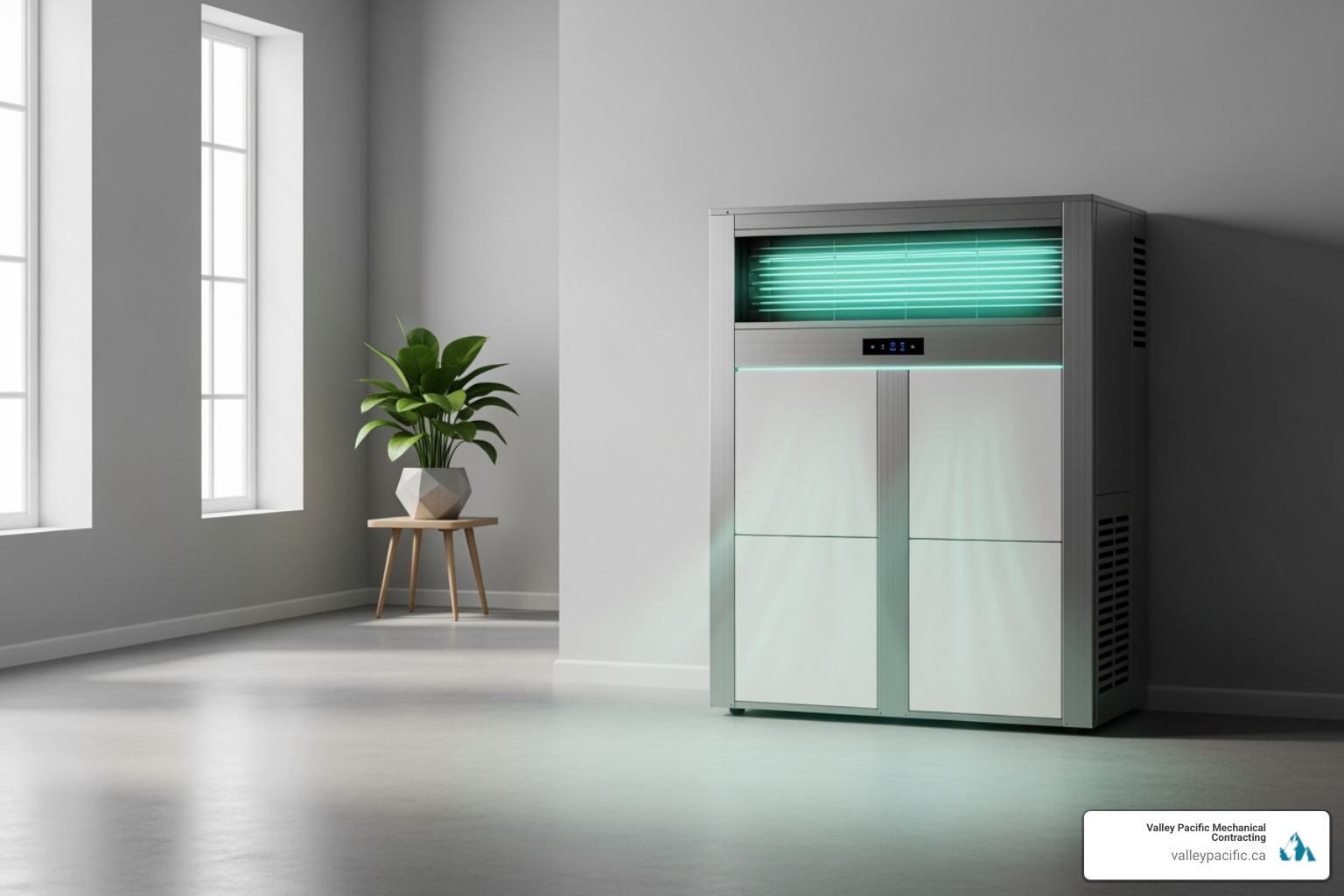
When your HVAC system fails, you need a professional who will fix it right the first time. At Valley Pacific Mechanical Contracting, we provide a "headache-free" experience backed by over 30 years of expertise. Choosing the right professional means looking for licensed, insured contractors with local experience and positive customer reviews, especially those offering 24/7 emergency service.
How to Choose a Reputable HVAC Contractor
Asking the right questions can save you from poor workmanship.
- Check for certifications: Look for Red Seal Certified technicians, the gold standard for skilled trades in Canada. For new installations, TECA Quality First Certification indicates a commitment to high standards.
- Get multiple quotes: Ask for detailed written estimates from at least two contractors to understand fair pricing. Be wary of quotes that seem too low.
- Verify insurance: Ensure the contractor has both liability insurance and workers' compensation to protect you from accidents on your property.
- Read online reviews: Check Google and other platforms for consistent feedback on punctuality, professionalism, and quality work.
Understanding HVAC Repair Costs in Coquitlam
Several factors influence the cost of HVAC repairs.
- Diagnostic fees: Most companies charge a fee to send a technician to assess the problem and provide an accurate diagnosis.
- Labour rates: These reflect the technician's skill and the complexity of the repair.
- Parts costs: Prices vary based on the component, brand, and availability.
- System accessibility: Equipment in hard-to-reach areas like crawl spaces may increase labour time.
- Emergency service fees: Expect higher rates for service outside of regular business hours, such as on weekends or holidays.
We believe in transparent pricing and provide a detailed estimate before any work begins. For a personalized assessment, Request a Quote.
Local Permit Requirements
The City of Coquitlam requires permits for most significant HVAC work, including new equipment installations and major system changes. This ensures the work meets BC Building Code standards for safety. Skipping permits can lead to insurance or resale issues later. As experienced professionals, we handle the permit application process for you. For more details, you can visit the official Coquitlam building permits page.
Boosting Efficiency and Savings with HVAC Upgrades
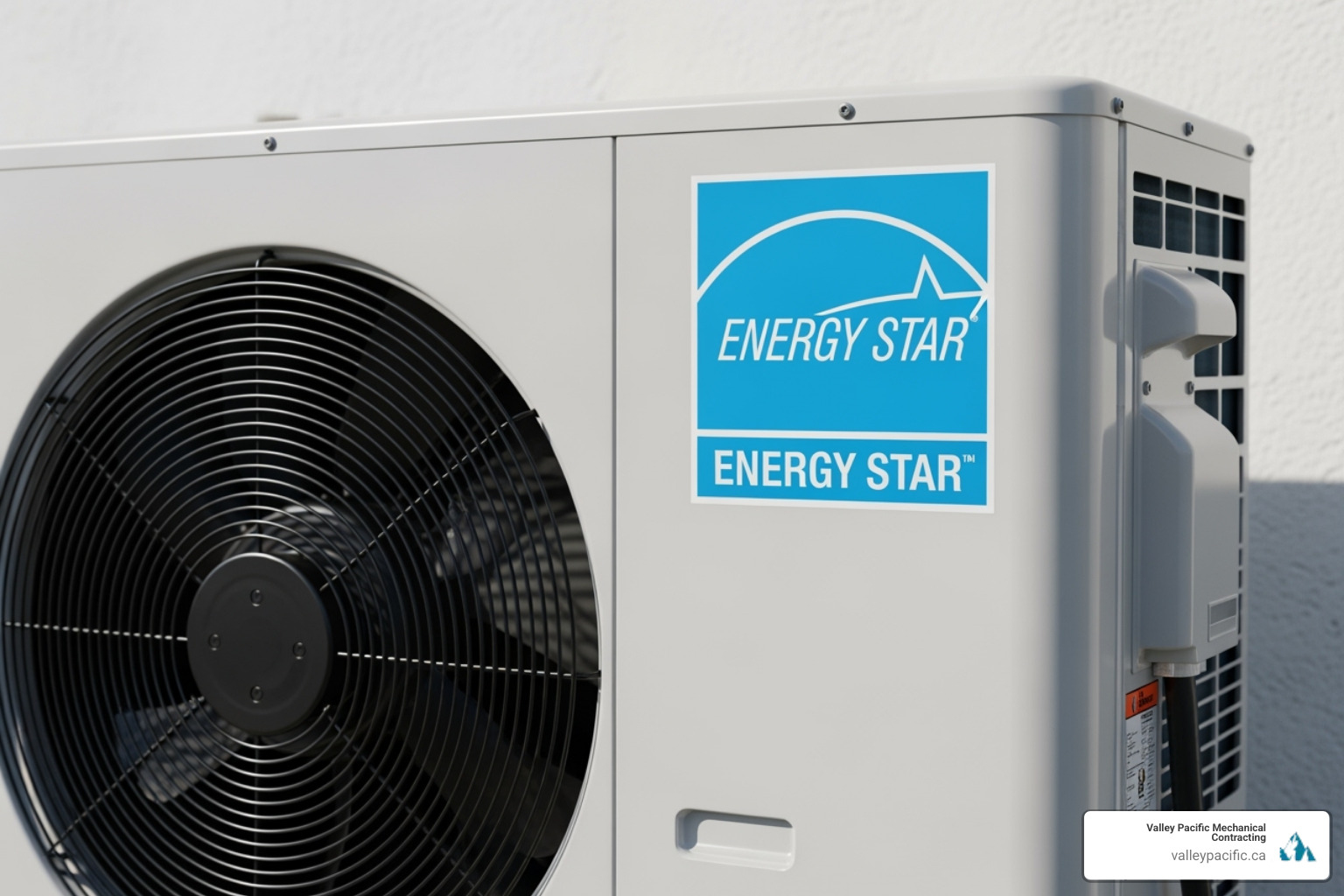
Upgrading to modern, efficient HVAC technology can significantly lower your energy bills while improving home comfort. Homeowners can reduce heating and cooling costs by 30% or more with a new system. Beyond savings, benefits include consistent temperatures, quieter operation, and better air quality. Using less energy also reduces your home's environmental impact.
Available Rebates and Incentives for Coquitlam Residents
You don't have to pay full price for these upgrades. Several rebate programs can help Coquitlam homeowners save money.
- FortisBC offers rebates for high-efficiency natural gas furnaces and other ENERGY STAR equipment.
- The CleanBC Better Homes program provides rebates for heat pumps and other efficiency improvements.
- The federal Greener Homes Grant offers grants for qualifying retrofits, including heat pump installations.
We can help you steer these programs and stack rebates to save thousands on your upgrade. You can explore current rebates to see what's available.
Energy-Saving HVAC Solutions
When planning for HVAC repair Coquitlam or considering an upgrade, several technologies offer excellent efficiency.
- Heat pumps: These systems are incredibly efficient for both heating and cooling, making them ideal for Coquitlam's climate. They move heat rather than creating it and pair perfectly with BC's clean electricity.
- High-efficiency furnaces: Modern natural gas furnaces convert more fuel into usable heat, dramatically lowering your gas bills.
- Ductless mini-splits: Perfect for solving hot or cold spots in specific rooms, or for homes without existing ductwork.
- Smart home integration: Smart thermostats learn your routine and can be controlled remotely, optimizing energy use without sacrificing comfort.
- High-efficiency boilers: For homes with radiant heating, modern boilers provide exceptional comfort and energy savings. Our expertise in Boiler Repair Coquitlam includes these advanced solutions.
Upgrading your HVAC system is an investment in a more comfortable, economical, and responsible home.
Frequently Asked Questions about HVAC Systems
As HVAC repair Coquitlam specialists, we often hear the same questions from homeowners. Here are answers to the most common ones.
How often should I service my HVAC system?
Annual service is essential. For a standard furnace or AC, a yearly tune-up is sufficient. If you have a heat pump that provides both heating and cooling, we recommend bi-annual service: once in the spring and once in the fall.
You should also perform basic maintenance yourself. Change filters every 3-6 months (more often if you have pets or allergies) and keep the area around your outdoor unit clear of debris.
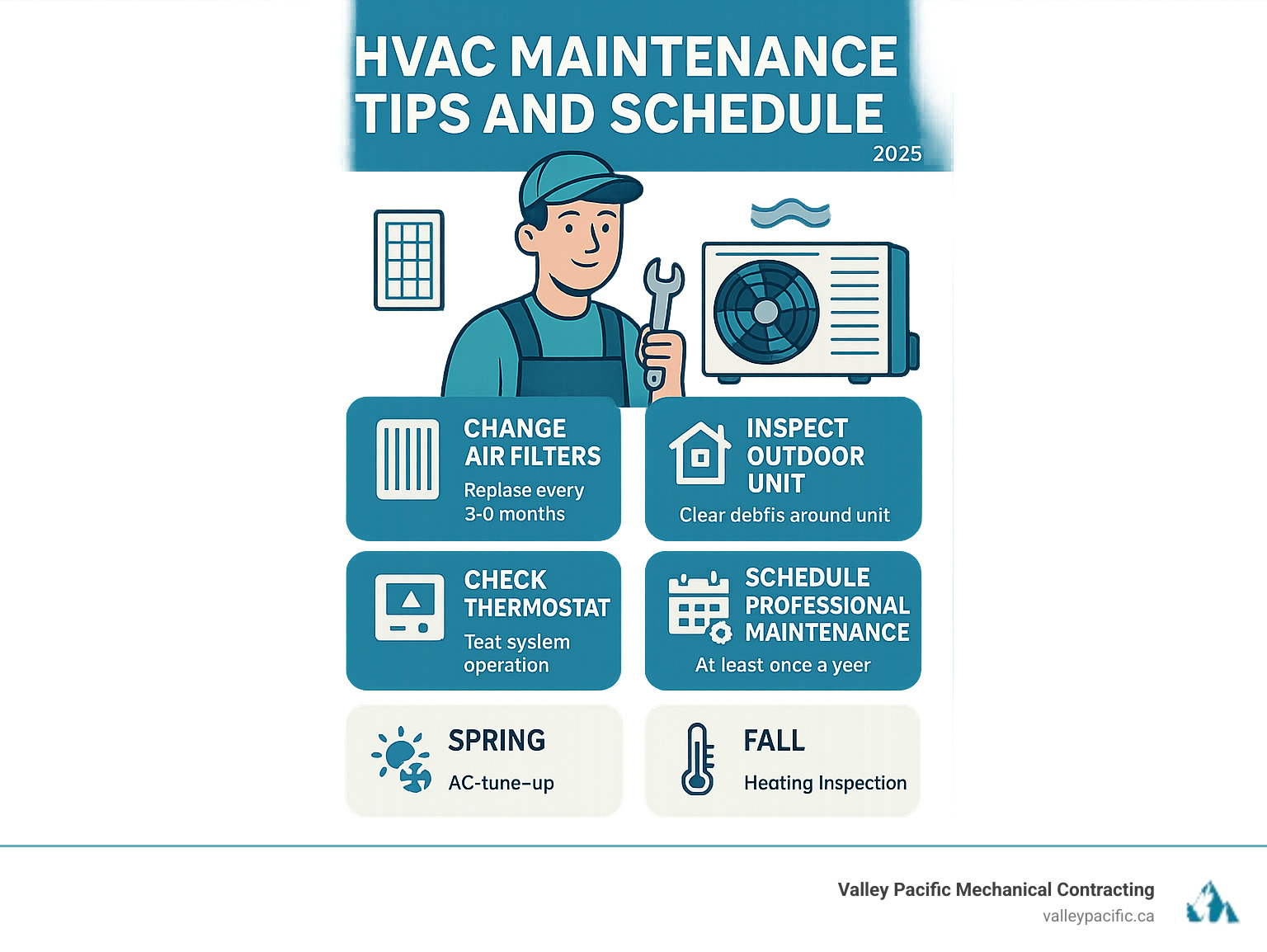
Why is my furnace blowing cold air?
Feeling cold air from your vents when you expect heat can have several causes:
- Thermostat settings: Check if the thermostat was accidentally set to "fan only" instead of "heat."
- Clogged air filter: A dirty filter can restrict airflow, causing the furnace's safety system to shut off the burners while the fan continues to run.
- Ignition failure: The pilot light may be out on an older furnace, or the electronic igniter on a newer model may have failed.
- Gas supply problem: An issue with the gas valve or an interruption in service will prevent the furnace from producing heat.
Most of these issues require a professional diagnosis to ensure a safe and correct repair.
Can I perform my own HVAC repairs?
While some basic maintenance is great for homeowners to do, complex repairs should be left to licensed professionals.
DIY-friendly tasks include changing air filters, clearing debris from around your outdoor unit, and keeping indoor vents unobstructed.
Repairs requiring a professional involve electrical components, natural gas lines, and refrigerants. Attempting these repairs yourself poses significant safety risks, including electrical shock, gas leaks, and fire. It can also void your warranty and potentially cause more damage to the system. Our Red Seal Certified technicians have the training and specialized tools to diagnose and fix problems safely and correctly. For anything beyond basic cleaning, calling a qualified technician is the safest and most cost-effective choice.
Conclusion
When you need HVAC repair Coquitlam, you don't have to face it alone. From spotting early warning signs like strange noises or high energy bills to deciding between repair and replacement, having a trusted professional makes all the difference.
The key is to act when your system shows signs of trouble and to choose a contractor who is certified, insured, and transparent about costs. Modern upgrades, often supported by rebates from programs like FortisBC and CleanBC, can also significantly improve your home's comfort and efficiency.
At Valley Pacific Mechanical Contracting, we have helped Coquitlam families stay comfortable for over 30 years. We understand the stress of a broken furnace or AC, which is why we offer a "headache-free" experience with 24/7 emergency service. Our team brings decades of expertise to every call, ensuring reliable, professional service backed by the Daikin Comfort Promise.
Your comfort is our priority. When you need trusted HVAC professionals, we're here to help.
Contact Us for expert boiler and HVAC services.
When the AC in your Maple Ridge home suddenly stops working, it's tempting to think it’s a simple power glitch. But if you find yourself repeatedly heading to the electrical panel to reset the same circuit breaker, that’s usually a sign of something more serious. Consistent breaker trips aren’t just inconvenient. They can be an early warning that your cooling system is experiencing electrical trouble that could lead to bigger problems if ignored.
In summer, your AC is already working overtime. Add electrical issues to the mix, and you could be looking at uncomfortable rooms, rising energy bills, and potential damage to your unit. Understanding why your AC circuit breaker keeps tripping can help you know when it’s time to reach out for help. The sooner the problem is addressed, the quicker your system gets back to keeping your home cool and safe.
Understanding Circuit Breakers
Every home has a circuit breaker panel that controls the flow of electricity to different systems and appliances. When too much electricity tries to pass through a circuit or when it senses a fault, the breaker triggers to stop the current. This isn’t a flaw in the system. It’s a safety feature. The breaker is doing its job by preventing overheating, fires, or damage to your equipment.
With AC units, circuit breaker trips often point to a system that is either pulling more power than it should or dealing with a mechanical fault. For instance, if your cooling system kicks on and the breaker immediately trips, it means the system is running in a way that could lead to overheating given continued operation. Breakers can also trip after running for a while, especially on hotter days when the AC is under more strain.
Breakers aren’t designed to be reset repeatedly. If your AC trips the circuit more than once, or daily, then there’s a problem at the root that needs to be diagnosed. Whether it’s an aging unit, wiring issues, or a part that’s beginning to fail, the breaker is giving you a clear message: something isn’t right.
Common Reasons an AC Circuit Breaker Keeps Tripping
There are many reasons your AC might be causing the breaker to trip. Some are quick to spot while others require a more detailed check. Here are some of the most common causes:
- Too many high-powered appliances are sharing the same circuit as the AC, leading to an overload
- A short circuit somewhere in the wiring or inside the unit, which can trigger immediate shutdown to prevent hazards
- Dirty air filters create extra strain on the system because the unit has to work harder to push air through them
- Refrigerant leaks put extra pressure on components like the compressor, forcing it to work harder and longer, which increases current draw and heat levels
- Fan motor issues or capacitor failure can also demand higher current than usual, which the breaker detects as dangerous
For example, in one Maple Ridge home, the breaker kept tripping every evening when the AC kicked in. After inspection, the issue turned out to be a clogged air filter and a failing capacitor. Once both were addressed, the system ran smoothly again without triggering the breaker.
If your breaker trips now and then, it may not seem urgent. But ignoring it risks further damage—not just to the AC but to your home’s electrical system too. Reaching out for help early can save both time and money.
Signs You Need Professional Help
Even if your AC seems to be running fine after resetting the breaker, that doesn’t mean the issue is gone. In fact, repeated breaker trips are one of the clearest signs that something deeper needs to be inspected. Homeowners in Maple Ridge should pay close attention if these signs keep happening:
- The breaker trips again as soon as the AC restarts
- There are visible burn marks or frayed wires near the electrical panel or unit
- You notice a burning smell or hear buzzing sounds when the system is on
- The AC starts but doesn’t run for long before shutting off
If you’ve ruled out things like an overcrowded circuit or a dirty air filter and the unit continues to shut down, you’re dealing with a problem that most likely can’t be resolved without help. Electrical faults, refrigerant issues, or failing internal components like the compressor or fan motor are not safe to inspect or repair without proper training and testing equipment. Trying to solve electrical problems on your own may not only risk further damage, but it can also lead to personal injury.
It’s also worth noting that trying to force your AC to restart by flipping the breaker over and over will put even more stress on the system. This could end up damaging the unit’s internal electrical parts beyond repair. When your circuit breaker refuses to stay active, that’s the system telling you to stop and call for service. Ignoring the signs or guessing at the fix only delays the solution. If your cooler isn’t delivering proper airflow anymore or you see a sudden change in indoor temperatures, it’s time to get it checked.
Prevention and Maintenance Tips to Avoid Breaker Trips
Preventing a persistent AC circuit breaker issue starts with regular upkeep and paying attention to early warning signs. While you can’t prevent every problem, there are a few simple steps that make a big difference:
1. Replace or clean your AC filters every 1 to 3 months during heavy use to prevent airflow problems
2. Make sure high-wattage items like space heaters, ovens, and dryers aren’t sharing the same circuit as your cooling system
3. Walk around the outdoor unit occasionally to see if plants, leaves, or debris are blocking any vents
4. If your home starts struggling to stay cool, avoid adjusting the thermostat over and over. Schedule a service check instead
5. Have our professionals inspect and service your system once a year, ideally before peak cooling season starts
Get familiar with how your system normally behaves so you can tell when something feels off. Sudden spikes in runtime, inconsistent airflow, or strange noises usually indicate the unit is struggling. These issues eventually lead to circuit breaker activation if left unresolved. Getting ahead of those problems with a quick checkup can prevent stress and downtime later in the season.
Why Early Intervention Keeps Your Cooling System Safe
An air conditioning system that repeatedly trips its breaker is more than just an annoyance. It’s a warning. Allowing that issue to continue without resolving the root cause puts added pressure on every part of the unit. From motors overheating to damage in the wiring, small problems can quickly become expensive ones. Taking action early protects the health of your cooling system and helps you maintain indoor comfort even during the hottest days in Maple Ridge.
If your AC keeps going dark and that breaker won’t hold, take it seriously. A proper diagnosis from one of our technicians can pinpoint the fault safely, giving you peace of mind that your system is operating the way it should. Whether it’s a failing part or something simple like a clogged filter, getting help early keeps the issue manageable and avoids further damage to both your equipment and electrical system.
Frequent breaker trips that disrupt your home's comfort in Maple Ridge signal a need for professional attention. Trust Valley Pacific Mechanical Contracting Ltd. to provide a fast, safe solution that repairs your system before small problems turn into larger issues. Timely AC repair in Maple Ridge can restore consistent, efficient cooling and help prevent further damage. For a quick estimate or to book a service visit, please contact us today.
Many homes in Pitt Meadows rely on older air conditioning systems that may still run, but are no longer doing the job as well as they should. As summer temperatures increase, an outdated or underperforming unit can struggle to keep up, leading to discomfort, high energy costs, and frequent issues. Without consistent cooling, the home can feel stuffy and unpleasant, especially during hot afternoons and evenings.
Figuring out whether it’s time to replace the AC isn’t always easy. Some systems might still function but no longer cool evenly or efficiently. Others break down often enough that repairs start adding up quickly. If your home is becoming harder to keep cool and your current setup isn't meeting your needs, now may be the time to think seriously about professional AC installation in Pitt Meadows.
Signs Your AC Needs Replacement
When an AC system starts to near the end of its lifespan, it usually doesn’t fail all at once. Instead, you may start noticing different signs that it's not performing like it used to. These signs can show up gradually, so it’s important to pay attention before bigger issues arise.
Here are a few symptoms that could mean your old AC is ready to be replaced:
- Frequent breakdowns: If you’re calling for repairs multiple times each season, that’s a clear signal your system is wearing down. Short-term fixes can become costly compared to replacing the unit.
- Poor cooling performance: When your AC is blowing warm air or struggling to cool your home evenly, even after maintenance, it's a sign the system may no longer be effective.
- Strange noises or smells: Grinding, clanking, and loud buzzing shouldn’t be part of your daily experience running the AC. Unusual smells, especially a burnt odour, can also point to electrical or mechanical issues.
- High energy bills: If your bill keeps going up, but you haven’t changed how long you run the AC, your system might be working harder than it should. This is common with aging units that lose efficiency over time.
Think about this example. One homeowner in Pitt Meadows found themselves scheduling repairs twice every summer for three straight years. After the third summer, they decided to invest in a new system. Not only did their comfort improve, but their monthly bills dropped, and they haven't had to make a single repair visit since. Replacing an old AC doesn’t just solve cooling problems—it helps avoid repeated visits and ongoing stress.
Spotting these issues early makes it easier to plan for a replacement and avoid emergency situations. If your AC is showing more than one of these signs, it might be time to discuss your options with our technicians. An early decision can mean a smoother installation process, better comfort all season, and better preparation before the hottest weeks of August arrive in Pitt Meadows.
Benefits Of Upgrading To A New AC
Replacing your AC system when the signs are clear can quickly turn into one of the smartest upgrades you’ll make for your home. While it might feel like a large expense upfront, the improvements you get right away make a noticeable difference.
Here’s what you can typically expect when installing a new AC in Pitt Meadows:
- Better energy use and lower bills: New models are built to use less electricity. That means you get the same or better cooling for less money each month.
- Reliable and even cooling: A modern AC delivers steady air throughout your home without weak spots or warm rooms.
- Smart technology options: Many newer units work with smart thermostats or include features like scheduling and zoning, giving you better control of how and when you cool your space.
- Eco-friendly systems: Today’s AC units often use refrigerants and parts that are easier on the environment while performing better.
It can be especially worthwhile to upgrade before your current unit stops working completely. Choosing the right time to replace your AC allows you to plan installation carefully, avoid dealing with outages in the middle of summer, and finish the upgrade when it’s most convenient for your family. Whether it’s comfort, cost efficiency, or dependability, a newer system offers improvements that start working for you right away.
Choosing The Right AC For Your Pitt Meadows Home
Deciding on a new AC system is more than just picking one that looks good or fits the budget. It has to make sense for the size and setup of your home. Choosing the wrong size can cause issues like short cycling, uneven cooling, or overworking the system. That’s why one of the first steps is to figure out how much cooling power your home really needs. This depends on square footage, layout, insulation, and even sun exposure.
Homeowners in Pitt Meadows looking for long-term performance should keep a few key features top-of-mind:
- Proper sizing and capacity: A unit that’s too small won’t keep up with demand, while one that’s too large might waste energy and cycle on and off too often.
- Energy efficiency (SEER ratings): Look for units with a higher Seasonal Energy Efficiency Ratio. These models will use less energy over time and help lower utility bills.
- Smart features: Depending on your comfort preferences, you can look for extras like programmable settings, multiple cooling zones, or remote access via mobile apps.
- Compatibility with your current setup: Depending on your ductwork and airflow, certain types of systems may work better than others.
Our professionals can help assess what configuration works best for your home. For example, a family in central Pitt Meadows had an older split-unit system that no longer fit their home after a renovation. After switching to a system with better zoning and a more accurate thermostat, they noticed faster cool-down times and better airflow through newly added rooms. That kind of change can make a big difference, especially when conditions outside stay warm for longer stretches.
The AC Installation Process
Once the decision to replace the unit is made, timing and coordination are important. You want a smooth process without surprises or unnecessary delays. Professional AC installation in Pitt Meadows follows a clear sequence to make sure everything works as it should.
Here’s what the process typically looks like:
1. Initial consultation: Our technicians come by for an in-home inspection. They listen to your needs, take measurements, and go over what you want in a new system.
2. Removal of the old unit: The old AC is safely disconnected and removed. That includes removing any parts that aren’t compatible with the upgrade.
3. Setting up the new system: The new air conditioner is installed and connected to the ductwork and controls. Adjustments are made to fit your home’s specific layout.
4. Final inspection and testing: Once installed, the system is tested for proper function, airflow, and energy use. Our professionals make sure everything is fully operational and walk through the basic settings so you feel confident using it.
The entire process is designed to get you up and running quickly without cutting corners. A professionally installed AC should run smoothly from day one and provide reliable comfort when you need it most.
Stay Cool And Comfortable This Summer
An outdated air conditioning unit doesn’t only make your home uncomfortable—it can cause increasing repair costs, rising bills, and more stress every summer. Recognizing the signs and making a switch before the system fails completely gives you time to plan, choose the right equipment, and make schedule-friendly decisions.
The benefits of upgrading are hard to ignore when you consider steady temperatures, better control, fewer breakdowns, and lower day-to-day running costs. With professional AC installation in Pitt Meadows, the process is straightforward and the results make day-to-day living much more comfortable. Making smart changes now helps set your home up for years of reliable performance.
Ready to upgrade your home with a modern cooling system that meets your specific needs in Pitt Meadows? Discover how our expert AC installation in Pitt Meadows can deliver reliable, consistent comfort throughout the warmer months. For a quick estimate or to book a service visit, please contact us today so Valley Pacific Mechanical Contracting Ltd. can help improve your comfort and energy efficiency.
During hot summer days in Mission, most homeowners expect their AC system to run smoothly and cool their home evenly. When one room feels like a freezer and the next is barely cooler than outdoors, it can become frustrating quickly. Uneven cooling is more than a minor comfort issue. It usually points to a larger problem within the air conditioning system or the home itself. Left unchecked, this issue can wear down your system, waste energy, and leave parts of the house unusable when temperatures peak.
Unlike minor comfort hiccups, uneven cooling in Mission homes tends to show up during extreme heat. It’s common to try adjusting the thermostat or closing vents in an attempt to fix the problem. But without getting to the root cause, those temporary fixes won’t last. Below are some of the common issues that might be affecting cooling performance and how you can start fixing them.
Common Causes of Uneven Cooling
Identifying why your home isn’t cooling evenly is the first step to fixing the issue. Many of the problems behind temperature swings are tied to airflow obstruction, thermostat troubles, insulation gaps, or system wear-and-tear.
1. Airflow Blockages
Blocked or restricted airflow is one of the most frequent causes of uneven cooling. When air can’t move freely from the AC system through the ducts and into each room, it leads to hot and cold areas inside your home. These airflow blockages come from:
- Closed or covered supply vents
- Dirty or collapsed ductwork
- Large furniture or drapes blocking return vents
Any block in the system forces the AC to work harder than it should. For example, in some homes in Mission, placing a couch too close to a wall vent is enough to disturb airflow into an entire living space. Duct issues usually require more attention, especially if there’s dust buildup or damaged sections behind walls or in the attic.
2. Thermostat Issues
The thermostat tells your AC system when to turn on and what temperature to aim for. If the thermostat itself isn’t in the right place or isn’t working properly, the rest of the system can only respond to wrong information. Some common problems include:
- Placing the thermostat too close to windows or heat sources
- Incorrect temperature readings due to faulty sensors
- Outdated or incompatible thermostat models with poor controls
Thermostats that sit in direct sunlight may consistently read the room as warmer than it actually is. As a result, the AC runs longer than necessary, overcooling some areas and barely touching others.
3. Insufficient Insulation
Even with a good AC system, poor insulation can leave parts of the house feeling warmer than the rest. This is especially true with second floors, basements, or home additions in older buildings. Insulation gaps allow cool air to escape and let in outside heat.
Key insulation trouble spots include:
- Attics without enough insulation padding
- Gaps around windows and door frames
- Exterior walls with old or missing filler
Homes in Mission that were built before modern building standards can frequently suffer from outdated insulation, especially in harder-to-reach areas like attic crawlspaces or behind finished drywall.
4. Aging or Inefficient AC Units
If your system is more than 10 to 15 years old, it may struggle to cool evenly even if everything appears to be working. Older systems often can’t keep up with modern comfort expectations or the needs of larger or renovated homes. You might have to run the system longer just to feel a difference, which doesn’t solve uneven cooling and increases energy use.
Signals that your system isn’t keeping up include:
- Long run times with little cooling effect
- Frequent repairs or breakdowns
- Loud or unusual sounds during operation
An outdated AC system often lacks the airflow capacity or zoning controls that newer systems provide. When paired with dirty filters or clogged coils, the problem only gets worse over time. Regular maintenance and seasonal checkups can help catch these shortcomings before they cause larger cooling issues.
Solutions to Improve Cooling Consistency
Getting more balanced cooling in your home usually starts with changes that support better airflow, accurate temperature control, and improved insulation. These adjustments don’t have to be overwhelming, but they often need a professional approach for real results.
Blocked vents or ducts are often easy to overlook, especially in tight spaces or unused rooms. Keeping the airflow open and unobstructed helps your AC distribute cold air evenly. Make sure vents aren’t being blocked by rugs, furniture, or curtains. It’s also worth inspecting vent covers for dust buildup. If airflow still feels weak in certain areas, it may be time for a full duct cleaning or repair.
Thermostat placement is another detail that can make a big difference. A thermostat placed near a window, kitchen, or direct sunlight may detect higher temperatures than the rest of the room. That can lead to overcooling other areas. The unit should be installed on an interior wall away from heat sources for a reading that better reflects the average room temperature. Replacing an older thermostat with a modern, programmable model can also help manage cooling zones more effectively.
When insulation is the reason for uneven temperatures, patching windows or replacing weather seals won’t be enough. You may need to reassess insulation in the attic or crawlspaces, where most cooled air escapes. Homes with older builds or home additions are more likely to have temperature imbalances in different wings or floors. These areas often benefit from upgraded wall insulation or higher-quality window panes built to reduce heat transfer.
Keeping your AC in good shape is just as important. Professional maintenance catches problems like clogged coils, low refrigerant, or uneven wear on fan blades. These issues reduce overall airflow and worsen cooling problems in different parts of the house. Maintenance appointments are a good safeguard before every summer starts and give your system the best shot at running consistently when temperatures climb in Mission.
Signs You Need Professional Help
If you've tried a few simple fixes and nothing’s changing, the issue is probably more than blocked vents or worn-out insulation. Uneven cooling that persists even after obvious steps have been taken is often a warning sign that your AC system isn’t functioning the way it should.
Here are a few signs that it’s time to bring in our professionals:
- Rooms that don’t respond to thermostat changes even after vents and filters have been checked
- A cooling schedule that seems inconsistent or random, leaving some areas too cold and others too warm
- A sharp increase in your energy bill with no clear reason
- Visible damage to ductwork, like disconnected joints or tears in flexible ducts
- Ice forming on the outdoor unit or refrigerant lines, which could point to airflow or refrigerant problems
- An AC that needs frequent repairs or runs for long stretches without reliably cooling the home
Many homeowners in Mission notice that their upstairs bedrooms never feel as comfortable as the main floor, even with the AC working all day. It can turn into a cycle of adjusting the thermostat up and down just to find a middle ground, often wasting energy in the process without solving the core problem.
Calling in our technicians gives you accurate diagnostics and solutions that are based on how your home is really operating. It’s not about guessing or hoping that a new filter will fix everything. It’s about putting the system back in balance using expert tools and years of experience with homes just like yours.
Maintain Comfort in Your Mission Home Year-Round
Uneven cooling does more than affect daily comfort. It causes homeowners to use more energy, pay for rising bills, and feel frustrated with a system that doesn’t perform evenly. In Mission, where hot summers are the norm, it's worth investing some attention into how your AC actually cools each area of your home.
Taking care of this issue early can prevent strain on your system and reduce long-term costs. Whether it’s sealing ducts, moving a thermostat, or fully servicing the system, each step builds up toward a more efficient and even flow of cool air. Staying proactive ensures your home stays comfortable without constantly needing to make manual changes to fight hot spots.
If you’ve run into signs that your cooling system isn’t working evenly, don’t wait to see if it gets worse. Getting your AC checked and maintained before the heat continues could save you a lot of trouble and money during the rest of the season.
Balancing the temperature throughout your Mission home requires proper upkeep and careful attention to your system's performance, and if you notice persistent issues with uneven cooling, reliable AC service in Mission can help restore consistent comfort across every room. Valley Pacific Mechanical Contracting Ltd. understands that a well-maintained system is key to avoiding bigger problems later on, so if you need professional support to address these cooling imbalances, for a quick estimate or to book a service visit, please contact us today.
It’s the middle of a warm summer afternoon in Maple Ridge, and out of nowhere, the cool air from your AC stops flowing. You check the vents, wait a few minutes, and flip the switch a few times but nothing changes. It’s a frustrating moment, especially when you’ve come to rely on your AC to keep your home comfortable. Unplanned air conditioning breakdowns can feel overwhelming, especially when they happen during high temperatures with no clear reason.
Knowing what to do in those first few minutes can make a big difference. The sooner you identify the issue or rule out common causes, the sooner you can get things back to normal. Acting quickly might even help you avoid further damage or prevent the problem from getting worse. Here's what might be going on and what you can do about it.
Common Reasons for Sudden AC Failures
When an air conditioner shuts off without warning, it's usually tied to a few common issues. While some of them are easily fixable, others may point to a deeper problem that needs professional attention. Below are some of the most frequent reasons your AC might stop working in your Maple Ridge home:
- Power supply problems: Something as simple as a tripped breaker or a neighbourhood-wide power outage can stop your AC in its tracks. Breakers can trip if there’s an overload, which is common during intense heat when systems work harder than usual.
- Thermostat issues: Sometimes the problem doesn’t start with the AC itself. If your thermostat has dead batteries, is set incorrectly, or isn't communicating with the unit, it may cause the system to stop running.
- Dirty air filters or blocked vents: A clogged air filter or blocked supply or return vent can restrict airflow, causing the system to overheat and shut off as a safety measure. Dirty filters are one of the most neglected aspects of home AC systems but one of the easiest to fix.
- Refrigerant leaks or low levels: If your AC starts up but blows warm air and then shuts down, there might be a refrigerant issue. Low refrigerant levels can cause your system to work inefficiently and trigger emergency shut-offs.
These are problems that many homeowners in Maple Ridge deal with during the summer. While a tripped breaker or filter issue might be sorted out with a quick check, refrigerant levels and thermostat failures usually need more than a basic fix.
Immediate Actions to Take
Once you notice your AC has stopped working, taking a few quick steps can help you figure out whether it’s something you can manage or something that needs professional help. Acting fast can also reduce the chance of further damage.
Here's what you should do right away:
1. Check the power supply
Head to your main electrical panel and see if the breaker linked to the AC unit has tripped. If it has, reset it once. Don’t keep flipping it if it continues to trip.
2. Adjust or replace thermostat batteries
Set your thermostat to cool and make sure the set temperature is lower than the current room temperature. If the display is blank or unresponsive, replace the batteries if it runs on them.
3. Inspect the air filter
Pull the filter out and check if it’s covered in dust. If it looks dirty or clogged, replace it. A fresh filter can restore airflow and potentially trigger the system to start working again after a brief reset.
4. Look at vents and the outdoor unit
Ensure the supply and return vents around the house are not blocked by furniture or drapes. Then, check the outdoor AC unit to make sure it’s clear of leaves, grass, or other debris.
Even after these steps, if your AC doesn’t kick back on or starts and then shuts down again shortly after, the issue likely needs a closer look. At that point, it’s worth contacting our professionals rather than hoping it resolves on its own. A homeowner in Maple Ridge once cleared their vents and replaced the thermostat batteries, but their AC still wouldn’t run for long. It turned out to be a refrigerant leak that caused the unit to shut off as a protective measure. Fixing that early stopped them from needing a more extensive coil replacement later.
When to Call for Professional AC Repair in Maple Ridge
If your AC still isn’t running after trying the basic steps, don’t wait it out. There are specific warning signs that point to larger issues, and ignoring them could lead to more expensive repairs or permanent damage down the line.
One of the most obvious signs is unusual sounds. A working AC should run fairly quietly. If you hear rattling, buzzing, grinding, or other odd noises, shut it down and call our professionals. These sounds can come from loose components, motor issues, or refrigerant problems. Strange smells are also a red flag. A burning odour might mean an electrical issue, while a musty smell could point to mould buildup in the ductwork or drain line.
Pooled water or visible leaks near the indoor unit are another signal to step away and consult someone trained. Moisture around the unit often comes from a clogged or damaged drain pan, or it could be refrigerant. Either way, it shouldn’t be dismissed. Quick action here avoids short-circuiting components or water damage around the unit.
If your AC is cycling on and off frequently without fully cooling the house, that’s another reason to get our professionals involved. This short cycling could be due to electrical issues, low refrigerant, or improper sizing. One of our trained technicians will be able to diagnose the problem accurately and get the unit working the way it should again.
Letting any of these signs go unchecked can end up reducing your system’s life span. When basic checks haven’t helped and something still feels off, that’s your cue to stop troubleshooting and get capable support.
Preventive Measures to Avoid Future Breakdowns
Once you’ve dealt with the immediate issue, the next step is making sure it doesn’t happen again. Skipping regular upkeep is one of the biggest reasons cooling systems fail during peak summer heat in Maple Ridge. Preventable problems often show up at the most inconvenient times.
Here are a few ways to keep your AC running smoothly:
- Schedule regular maintenance visits from our technicians before peak cooling months.
- Clear away leaves, weeds, and debris around your outdoor AC unit. Maintain at least two feet of space around it.
- Change air filters every few months or more often during high-usage periods.
- Double-check the thermostat settings every season and make sure it’s operating correctly.
- Keep all vents clean and uncovered to allow free airflow.
These simple habits go a long way. They help manage wear and tear, catch developing issues early, and reduce the load on your system when it’s hottest outside. One household in Maple Ridge started replacing filters every other month and keeping the area around the outdoor unit clean year-round. Since then, they’ve had no unexpected shutdowns, even during long summer stretches.
Staying Comfortable While Waiting for AC Repairs
If your AC needs professional work, it might take a little while before a repair visit is scheduled, especially during busy summer weeks. In the meantime, keeping your living space tolerable doesn’t require anything complex.
Close the blinds or curtains in rooms that get direct sun to reduce heat entry. Use ceiling and portable fans to circulate air and make the space feel cooler. Limit appliance use, like dishwashers and ovens, during the day. Open windows during early mornings or late evenings when the outside air is cooler. And most importantly, stay hydrated and avoid doing heavy chores in the hottest parts of the day.
Keeping yourself and your family as comfortable as possible until the system is back up matters just as much as the mechanical fix itself. With a few tweaks to your daily routine, you can keep the stress levels down while waiting for service.
The Smart Way Forward for Maple Ridge Homeowners
Air conditioning problems can catch anyone off guard, but how you respond can change both the short-term discomfort and the long-term reliability of your system. From power checks to filter changes, your first actions can buy you time and reduce damage. But recognizing the line between basic checks and when to involve our team is just as important.
Getting your AC back on track and keeping it that way does not need to be complicated. With seasonal upkeep, safe usage, and quick responses to irregular behaviour, you can avoid the worst of summer disruptions in Maple Ridge. Unexpected failures are not always preventable, but the steps you take after one happens make all the difference.
If your cooling system continues to cause problems and you need reliable AC repair in Maple Ridge, trust Valley Pacific Mechanical Contracting Ltd. to restore comfort to your home. For a quick estimate or to book a service visit, please contact us today.
A sudden foul smell drifting from your air conditioner can make your home in Langley feel a lot less inviting. Whether it smells musty, like dirty socks, or even something burning, odours from your AC usually point to something that’s off inside the system. During warm summer days, the last thing you want is to be forced to open your windows just to avoid breathing in unpleasant air every time the AC kicks on.
Smells coming from an AC are not harmless quirks. They are warning signs. Ignoring them can lead to even bigger problems down the line, such as damage to internal components or health concerns caused by mould or poor air quality. If your AC seems to be blowing strange smells into your home, it’s worth tracking down what’s causing it and getting the right help before a minor issue becomes a major headache.
Step-by-Step Guide to Diagnosing AC Odours at Home
If something smells off, it’s a good first step to inspect your AC system before calling for AC service in Langley. While some odours require professional servicing, others can be traced to simple maintenance problems. Homeowners can perform a few checks to understand what might be going on.
1. Inspect the Air Filters
Dirty air filters are a common source of odours coming from the AC vents. Dust, hair, pet dander, and pollen collect in your filter over time. If they are never changed, they can start to smell and even lead to mould growth.
- Pull out the filter and hold it up to the light. If light doesn’t pass through, it’s too clogged
- A musty smell is often linked to moisture mixing with debris
- Replace disposable filters every 30 to 90 days depending on use and local conditions
2. Check the Condensate Drain Line
The condensate drain helps move moisture away from your AC unit. If it’s blocked or filled with algae or bacteria, it could create a foul or sour smell that drifts into the vents.
- Look for standing water under the indoor unit, which may mean a clog
- Some clogs produce a stale or sour scent, especially in humid weather
3. Evaluate the Ductwork
Sometimes the issue is not inside the AC itself. Your ducts may be collecting dust, mould, or even pests or droppings, particularly if they haven’t been cleaned for some time.
- Smells that worsen just after the system starts could point to buildup inside the ducts
- An animal smell may mean a critter got in through a loose duct or vent
- A burnt smell could come from old insulation or debris close to heating components
One case we handled in Langley involved a strong rotten odour every time the AC turned on. The cause turned out to be a bird that had entered the ductwork through a loose vent cover outside. Professional duct cleaning and sealing of the exterior vent eliminated the smell and prevented future issues.
While some tasks seem doable at home, keep in mind that basic checks have their limits. If these steps don’t solve the issue or you cannot identify the source, it’s time to call our professionals for AC service in Langley.
Health Impacts of Ignoring Foul AC Odours
Unpleasant smells from your AC system aren’t just irritating. Some indicate problems that can affect your health. A musty or rotten smell might mean mould or bacteria is growing inside the system. When the AC runs, it pushes those particles through the air and into every room in your house.
Many Langley homeowners may experience symptoms like headaches, coughing, or eye irritation due to poor indoor air quality. Continued exposure to mould spores can trigger asthma or worsen allergies. If the smell comes from an internal electrical issue, such as burned-out wiring or melted insulation, it may even pose a risk to safety. Breathing air affected by these issues is unsafe and should not be ignored.
Foul smells affect more than health. They interfere with home comfort. If the air does not smell clean, your living space will not feel truly fresh. Long-term odours can even seep into carpets, curtains, and furniture. The longer unwanted smells remain, the harder they become to remove. Addressing odours early keeps your home smelling pleasant and your indoor air healthier during summer.
When to Call Our Professionals for Help
There’s a point where home solutions lose their effectiveness. If cleaning the unit and changing the filter does not get rid of the smell, or if the odour returns quickly, it’s time to consult experienced technicians. Our professionals have the tools and know-how to spot deeper issues that the average homeowner may miss.
You should contact us for AC service in Langley if:
- You replaced the air filter, but the smell still lingers
- The odour is strong and smells like burning, chemicals, or rotten material
- You see mould in or around vents or water pooling near the AC system
- The smell worsens with continued AC use
- Odd noises come from the unit, paired with the odour
Calling our technicians ensures that deeper problems are addressed correctly. They can check the evaporator coil, blower motor, and ductwork for any contributing factors. If an electrical short or mechanical fault is responsible, they can repair it safely. Our professionals can also detect early signs of future failures and fix them on the spot, often preventing larger repair costs and comfort problems down the road.
Ensure Fresh Air in Your Langley Home with Regular Maintenance
Odours from your AC do not always mean large-scale damage. Many get their start from basic neglect. Dirty filters, trapped moisture, and undisturbed dust in the ducts tend to build up when routine maintenance is skipped.
To help prevent these problems, follow a few simple practices:
- Change filters on schedule, based on the manufacturer’s recommendations
- Check around vents and the unit for signs of mould or dampness
- Keep AC vents open and avoid pushing furniture against them
- Pay attention to changes in humidity or indoor temperature balance
- Book seasonal inspections and cleanings with our technicians
Sticking to these preventative steps keeps your AC working more efficiently and helps it stay odour-free through the summer. Proactive care saves money and avoids future headaches.
Keep Your AC Unit Odour-Free All Summer Long
As soon as unpleasant smells come from your AC, it’s easy to put off action. But these signs should never be ignored. Whether caused by mould, built-up moisture, or electronic failure, most odours mean something is going wrong inside the system.
Langley homeowners who act early benefit from safer, cleaner indoor air. Even small maintenance tasks make a difference, and timely help from our technicians ensures nothing gets missed. The result is an AC that cools your home while keeping it fresh and comfortable during every warm day.
With professional care, your AC system can run smoothly, odour-free, and reliably throughout the summer. Addressing foul smells quickly means better comfort, improved air quality, and greater peace of mind for your household.
If unpleasant smells are affecting your indoor air and comfort, Valley Pacific Mechanical Contracting Ltd. is here to help bring your system back to peak condition with expert AC service in Langley. For a quick estimate or to book a service visit, please contact us today.
When you're planning a new AC installation in Pitt Meadows, it's easy to focus on choosing the brand, checking the features, or comparing energy ratings. But there's one detail that can make or break the performance of your new system: proper sizing. Homeowners often assume that bigger is better or play it safe with a smaller unit, but the size of your AC has a direct impact on comfort, efficiency, and dependability.
An incorrectly sized system doesn't just cause minor problems. It can mean higher utility bills, poor cooling performance, and more frequent calls for repairs. Proper sizing isn't about guesswork. It's about making sure the unit matches the needs of your home—nothing more, nothing less. Skipping this step can lead to avoidable issues down the road.
Understanding AC Sizing
AC sizing refers to the amount of cooling a system can deliver. This is typically measured in tons or BTUs (British Thermal Units). But choosing the right size isn't something you can do just by looking at your neighbour’s setup or picking a unit off the shelf. Your home has its own unique set of conditions that must be taken into account.
Here are some of the main factors that affect what size AC your home in Pitt Meadows needs:
- Total square footage: Larger homes need more powerful systems to distribute cool air evenly
- Insulation type and quality: Well-insulated homes hold cool air longer and may not need as large a unit
- Number of windows and their orientation: South-facing or large windows can increase heat gain significantly
- Number of occupants: More people produce more warmth indoors
- Layout and number of floors: A two-storey home usually requires a different cooling approach than a bungalow
It also helps to consider the local climate. Summers in Pitt Meadows can feel both hot and humid, so the system must be able to handle both cooling and moisture control without falling behind. A well-sized unit won’t just turn on and blast cool air—it will stay on long enough to remove humidity and steadily cool the space throughout the day.
Think of it like buying shoes. A size too small or too big might look fine at first, but it won’t take long before it becomes uncomfortable and causes bigger problems. That same concept applies to your AC unit.
Consequences Of Incorrect AC Sizing
Picking the wrong size can lead to several frustrating problems, many of which show up sooner than you'd expect. In some cases, you may notice that even with a new unit, your home still feels warm, or cooling rooms takes too long. Other times, it may seem like the system cycles on and off too frequently or never runs long enough to feel effective.
Here’s what can go wrong:
- If the AC is too small:
- The system may run constantly without cooling sufficiently
- Utility bills go up because of overextended operation
- Comfort levels drop, especially during the hottest part of the day
- If the AC is too large:
- Short cycling can occur, where the unit powers on and off too often
- Rooms may cool too quickly without properly removing humidity
- The system wears out faster due to repeated starts and stops
Frequent breakdowns and poor air distribution are also common signs that sizing was skipped or done incorrectly. These issues aren’t always immediately linked to the AC size by homeowners, but they almost always stem from that root cause. That’s why taking the time to size the system correctly up front can prevent costly headaches later.
The Role Of Professionals In Sizing Your AC System
Getting the size right isn't as simple as measuring a room or checking an online chart. Professional sizing involves a full evaluation of the home’s layout, insulation, and thermal dynamics. Relying on guesswork or assumptions often leads to systems that are too big or too small for the space they’re meant to cool. That’s why it’s important to have a proper assessment handled by someone trained in the process.
Our technicians follow strict steps to ensure accuracy. They don’t just look at square footage. They account for things like ceiling height, ductwork conditions, sun exposure, and daily usage patterns. For example, if a family in Pitt Meadows lives in a split-level home with large west-facing windows and a finished basement, those factors could heavily change the size and type of system needed. A one-size-fits-all approach won’t cut it here.
Proper sizing also requires tools and load calculations many homeowners won’t have. Our professionals use this information to recommend a unit that meets the cooling demands of the home without wasting energy or running non-stop. With the right equipment and a clear plan, installation goes more smoothly too. That means fewer delays or adjustments once the system is in place.
Choosing a system that’s been matched to your home’s true cooling needs gives you a strong foundation. Skipping this step opens the door to expensive problems that make your new AC feel like a bad investment. Getting it done right the first time saves time, money, and stress.
Why Proper Sizing Makes a Big Difference
The size of your AC unit affects nearly every part of how it performs. With the correct sizing, you’re set up for more stable temperatures across your home, fewer maintenance problems, and lower energy consumption. It’s a decision that pays off for years to come, not just during the first few months.
Some of the long-term benefits of proper sizing include:
- Better comfort: Fewer temperature swings or overly humid rooms
- Energy savings: Less energy wasted from overworking or short cycling
- Fewer breakdowns: The system runs as intended without strain
- Longer lifespan: Equipment wears out slower with balanced usage
- Consistent airflow: Rooms stay evenly cooled without sharp changes
It also means the system won’t struggle during heat waves. In Pitt Meadows, summer spikes can push lesser systems to their limits. With the right size unit, those stress points are easier to manage. The AC unit doesn’t have to constantly fight to keep up, so your home stays more comfortable without overloading the system.
It’s also worth noting that humidity control plays a big part in indoor comfort. An oversized system may cool the air fast but shut down before it removes enough moisture. This can leave your home feeling damp or sticky, even though the thermostat reads a comfortable number. A properly-sized AC cycles long enough to take care of both cooling and dehumidifying, which makes a noticeable difference inside.
Get the Fit That’s Right for Your Home
Choosing the right AC system for your home in Pitt Meadows goes beyond picking reliable equipment. Proper sizing is what ties the entire installation together. It’s the difference between a system that works well and one that becomes a never-ending source of repairs and energy loss. With accurate sizing, your AC unit can do its job without wasting electricity or leaving parts of your home uncomfortable.
Sizing sets the tone for the lifespan of your cooling system. If this important step gets skipped or rushed, it can lead to functional issues that affect your comfort and wallet year after year. Whether your home is large, small, open-concept, or multi-level, a properly-sized system delivers better control and reliable cooling performance all summer long.
For reliable, properly sized cooling in Pitt Meadows, working with Valley Pacific Mechanical Contracting Ltd ensures that your system meets your home's needs and delivers lasting comfort. Learn more about AC installation in Pitt Meadows, and for a quick estimate or to book a service visit, please contact us today.
When your AC vents are blowing warm air during the height of summer, it’s more than just a minor inconvenience. It can quickly make your home in Mission uncomfortable. You expect cool air from your cooling system. So when warm air starts flowing through the vents, it’s a clear sign that something isn’t working as it should. While the problem might seem minor at first, the underlying issue could range from simple to more serious.
The longer this issue goes unchecked, the more likely it is to affect your comfort, your energy bills, and the health of your AC system. It’s important to find the cause quickly rather than wait and hope it resolves on its own. Knowing what’s going on behind the scenes helps guide you on what to do next. Whether it’s blocked airflow, an off-track thermostat, or a refrigerant issue, early identification keeps damage to a minimum.
Common Causes of AC Vents Blowing Warm Air
Warm air from your vents usually means your AC system is not doing its job. There are several common triggers that can lead to this outcome. These symptoms often point to deeper performance or hardware issues.
1. Low Refrigerant Levels
Refrigerant is the liquid agent your system uses to remove heat from inside your home. If refrigerant levels are low, often because of leaks, it can’t complete the cooling process effectively. The result is warm air entering your space instead of cool. This kind of issue needs detection and repair by certified professionals.
2. Dirty Air Filters
When filters go unchanged, they fill up with dust and debris. A clogged filter restricts airflow, makes the system work harder, and may cause parts of the unit to freeze. That leads to weak airflow and warm air being circulated through your home. This is one of the most preventable problems homeowners can address.
3. Thermostat Issues
Thermostats might seem like small components, but their role is central. If the thermostat is set to heating by mistake or the batteries are low, it may send the wrong signals to the system. This leads to mixed results, such as vents blowing warm air when cooling is expected.
4. Blocked or Disconnected Ductwork
Air ducts carry cooled air throughout the home. If your ductwork becomes disconnected or damaged, it may leak or pull in warm air from non-conditioned areas. Attics or crawlspaces are common sources of heat that get introduced into the system through faulty ducts.
Consider this example: A homeowner in Mission noticed the AC ran non-stop, but rooms still felt warmer than normal. After inspection, a disconnected duct joint was found in the attic, allowing cool air to escape and warm attic air to enter the system. Once repaired, the system began performing normally, and temperatures dropped to expected levels.
If you’re noticing warm air and maintain regular settings, take some time to check common problem areas. If nothing looks out of place visually, it may be time to contact our professionals.
Solutions and Troubleshooting
Once the vents begin blowing warm air, the next step is figuring out what’s wrong. Some common problems have easy fixes, while others require tools and deep product knowledge.
Start with the air filter. If it’s been over a month since the filter was changed, it’s a good place to begin. Dirty, grey filters can limit your AC’s ability to cool your home. Changing the filter may restore airflow and reduce strain on the unit.
Next, inspect the thermostat. Make sure it’s on cooling mode and the set temperature is lower than the current room temperature. Replace the batteries if you’re unsure of their strength. An off-reading thermostat may act in unpredictable ways.
Move around your home and check each room vent. Make sure they aren’t blocked by furniture or curtains. Confirm that each one is fully open if meant to cool the room. If air pressure seems low or inconsistent, ductwork blockage may be the issue.
When warm air continues and you have ruled out filters and thermostats, refrigerant is often the culprit. Signs like ice on the outdoor unit, hissing sounds, or extended runtimes without cooling mean a leak could be present. This is where our technicians step in.
Troubleshooting checklist:
- Change dirty air filters every one to three months
- Ensure thermostat settings are correct and batteries are strong
- Check that vents are open and unobstructed
- Inspect for ice or airflow problems
- Contact our professionals if cooling does not return
If the simple steps do not help, more technical issues may be present. Our technicians can run diagnostics to identify leaks, failed components, or other system breakdowns.
Preventive Measures to Keep Your AC Running Efficiently
Stopping AC issues before they start is possible with regular care. Keeping your system maintained year-round will improve its reliability and cooling power.
Schedule seasonal inspections before the hottest months begin. Our technicians can check refrigerant levels, ensure proper airflow, and make adjustments as needed before heat waves arrive.
You also play a role. Keeping outside units clear of grass, leaves, and debris prevents outdoor airflow issues. Inside the home, make sure nothing blocks your vents and keep electronics or objects that produce heat away from thermostats.
Maintenance habits to adopt:
- Replace filters on time, especially during high-use periods
- Keep vents uncovered by furniture or curtains
- Clear debris around outdoor units
- Make sure thermostat is accurate and properly set
- Book annual inspections through certified technicians
Getting ahead of problems like refrigerant loss, electrical faults, or airflow challenges saves both time and stress. Reliable performance begins with consistent care.
Ensuring Optimal Comfort in Mission
In Mission, residents count on AC systems to keep homes comfortable. But those same systems can fall behind if neglected during the busy summer season. When vents blow hot air instead of cool, it adds frustration to a time of year where comfort is critical.
Working with local technicians who understand home layouts, climate needs, and equipment common in the area can result in shorter downtime and more accurate solutions. Whether it’s resolving airflow inconsistencies or correcting temperature controls, early attention keeps conditions stable.
Residents who complete regular maintenance or inspections tend to enjoy longer-lasting systems and better comfort during heat waves. Our Mission technicians are ready to support you with diagnostics, tune-ups, and reliable repairs.
Avoid letting small issues build into larger ones by responding early to unexpected system changes. Controlling a home’s climate during the height of summer should be simple and stress-free.
Restore Cool Comfort to Your Mission Home
When your cooling system stops doing its job, it becomes an urgent issue. If your AC suddenly starts blowing warm air and the thermostat is correctly set, don’t let it linger. Early checks help rule out minor causes. But when symptoms continue, getting help from trained professionals makes all the difference.
Issues like refrigerant leaks or failed duct seals are hard to detect without the right tools. That’s why inspections and proper service matter. Each part of your system relies on the next, and when one fails, overall performance drops.
Homes in Mission deserve steady, stress-free relief from summer heat. With proper inspections, regular maintenance, and prompt repairs, your system can perform when you need it most. Reliable cooling should be something you can count on—not hope for unexpectedly. Stay ahead of breakdowns by working with proven professionals. That way, you can enjoy your home and the summer season in comfort.
For reliable support in keeping your home cool, trust Valley Pacific Mechanical Contracting Ltd to address air conditioning concerns promptly. If you are dealing with persistent cooling issues, scheduling an AC repair in Mission can help ensure your system is operating efficiently. For a quick estimate or to book a service visit, please contact us today.
If you have noticed water pooling around your air conditioning unit in your Langley home, it is not something to ignore. While the sight of a leak might seem minor at first, it usually signals an issue inside the system that needs attention. Left unchecked, water damage can happen quickly and lead to much more expensive repairs. Understanding why your AC might be leaking and how to respond is an important part of keeping your home safe and comfortable, especially during the summer months.
Leaks are more common than most people expect. It is not always a major failure. Sometimes it is just a clogged drain line or frozen component. But regardless of the cause, leaving it for later is not worth the risk. Taking simple steps early on can keep the damage from getting worse and help avoid sudden breakdowns when you need your AC running the most.
Common Causes Of Water Leaks In AC Units
Water leaking from your AC does not necessarily mean the unit is broken, but something inside is not functioning the way it should. Here are three common issues that often lead to problem leaks:
1. Blocked Drain Line
Condensation naturally forms inside your AC unit when warm air passes over the cold evaporator coil. This moisture normally drains through a line and collects in a pan before slowly draining away. When that line gets clogged with dust, dirt, or mould buildup, water has nowhere to go. It backs up and may spill out from the AC unit and into your home.
2. Frozen Evaporator Coil
If the evaporator coil inside your system gets too cold, it can freeze. This usually happens when airflow is restricted by a dirty filter or there is low refrigerant in the system. Once the ice begins to melt, all that water can overflow and cause visible leaking around the AC. This is one of the top reasons homeowners notice water near their unit after it has been running for a while.
3. Improper Installation
An incorrectly installed system may not sit level, or the drainage system may not be set up properly. If the drain pan is tilted or the piping is misaligned, it can stop water from draining the way it is supposed to. Over time, this creates leaks and instability in the unit’s operation. For new units or newly renovated homes, this is something worth checking.
Step-By-Step Troubleshooting Guide
When you first discover a leak, your immediate thought might be to wipe it up and move on. But it is better to figure out where it is coming from. Here is how you can start pinpointing the source:
- Search for signs of a blocked drain line: Look underneath the AC unit for standing water. If you see more than usual or smell mildew, there is a good chance the drain line is clogged and backing up.
- Inspect the condition of the evaporator coil: Remove the front grille of your unit (if safe and accessible) and check if the coil looks frosty or has ice buildup. Ice that forms and later melts usually leads to leaking.
- Look at the drain pan: Check if the pan is cracked, tilted, or overfilled. If it is not holding water evenly or draining properly, there might be a structural or positioning issue.
- Make sure the system is level: Use a small level tool or visually check that the unit is not slanted. Uneven units disrupt water drainage and force it to spill out from the wrong areas.
One common example is when a homeowner assumes their AC is leaking because of a major fault, but it turns out their air filter had not been changed in months. Low airflow leads to a cold coil, which then freezes and causes the leaking once it thaws. Changing the air filter and clearing the drain line helped prevent it from happening again.
If you have done a few checks and still cannot find what’s wrong, or you are unable to reach certain parts safely, it is usually best to let our technicians take over. AC systems are made up of several parts that work together. If one of them is off, it can cause issues across the unit. A professional inspection helps find the problem faster and reduces the chance of long-term damage.
When To Call In The Professionals
Some AC issues can seem manageable at first, but small mistakes during a repair attempt can lead to even more damage. If you have attempted basic checks and your unit is still leaking, or if you have spotted issues that require access to inner components, it is time to get our professionals involved. Complex problems like refrigerant loss, internal pipe misalignment, electrical issues, or a damaged evaporator coil are best handled by trained technicians with the experience and tools to fix them safely.
You should also reach out if the leak has caused any damage to nearby floors or walls. Excess moisture can quickly soak into building materials and lead to mould growth or rot. Waiting too long puts your home and health at risk, especially if the unit continues to operate with faulty parts. If water is leaking again after earlier repairs or you notice persistent airflow problems, that is another sign the system is not fully fixed and needs expert diagnosis.
Here are clear signs it is time to call in our team:
- The AC is shutting off too early or running nonstop
- Ice forms frequently on the coils or lines
- Water is leaking into walls or ceilings, not just the floor
- You have already cleared the drain but water keeps overflowing
- The unit is making strange noises or smells damp after running
If you live in Langley and rely on your AC to stay comfortable during the summer, waiting too long can turn basic wear and tear into preventable damage.
Preventive Measures That Keep Your AC Running Right
Once the leak has been repaired, the best way to avoid having it happen again is through regular maintenance. Most AC leaks are caused by dirty filters, blocked pipes, or neglected components that go unnoticed until there is a visible problem. Staying consistent with upkeep helps resolve these issues before they become expensive.
Here are a few habits that make a big difference:
- Change your air filter every 1 to 3 months to maintain steady airflow and prevent ice buildup on the coil
- Check that the outdoor unit is free from leaves, grass, or other items that could clog the system
- Look at the drain line occasionally to spot any slow draining or early signs of blockage
- Watch for small puddles or increased humidity in the area where the unit is installed
- Schedule a full AC inspection at least once a year with our technicians to handle deeper servicing
These steps might seem simple, but they help extend the life of your AC and increase its reliability through the hotter days in Langley. Even if your system seems to be running fine, small internal issues can go unnoticed until they lead to problems like leaks or short cycling.
Protect Your Comfort With Proper AC Service In Langley
Water leaks from an AC unit usually start as minor problems, but they can turn into something harder to manage if ignored. Whether it is a blocked drain line or a frozen coil, the key is acting quickly. Regular upkeep and professional support give you added confidence that your cooling system in Langley can keep running smoothly even during peak summer temperatures.
By knowing what to look for, trying simple checks when a problem shows up, and scheduling help from qualified technicians, homeowners in Langley can avoid stress and expensive repairs. With the right steps, your home stays dry, comfortable, and ready for every warm day that lies ahead.
Valley Pacific Mechanical Contracting Ltd. understands that a leaking AC unit can lead to further damage if not addressed promptly. Maintaining your system correctly in Langley ensures your home stays cool and protected throughout the summer. When issues persist despite basic checks, a professional approach becomes necessary, and our AC service in Langley offers reliable support to restore comfort to your home. For a quick estimate or to book a service visit, please contact us today.
When your AC seems to be running without a break, it is more than just a mild annoyance. During the summer months in Pitt Meadows, that constant hum can quickly lead to higher energy bills, a home that never quite cools down the way it should, and a system that is working harder than necessary. A properly working AC should cycle on and off throughout the day—not run nonstop from morning to night.
It is easy to ignore at first, especially when the house is still comfortable. But if your AC keeps running long past what seems reasonable, that is a clear signal something is wrong. Whether it is a minor maintenance issue or a sign your system needs repair, pinpointing the cause early can save time, money, and hassle.
Common Reasons Your AC Keeps Running
When your AC refuses to shut off, there are a few usual suspects worth checking. Some problems are simple, while others can cause long-term damage if left alone. Here is what might be happening behind the scenes:
- Dirty air filters: Probably the most common issue. When the filter gets clogged, airflow slows down. Your AC works harder to push air through and ends up running for longer periods to try to cool your home.
- Thermostat settings or malfunctions: If your thermostat is not reading the temperature correctly or is not calibrated properly, your system could think it is hotter than it actually is. This keeps the AC going even after the house has reached the set temperature.
- Low refrigerant levels: Refrigerant helps your AC pull heat out of the air. When levels are low, often due to a leak, the system cannot cool the space efficiently, which causes it to run constantly trying to reach the set temperature.
- Electrical problems: Faulty relays or wiring issues can prevent the AC unit from shutting off even when it should. These problems are harder to detect without proper tools and are sometimes mistaken for thermostat or fan issues.
These causes are fairly common in residential systems around Pitt Meadows. For example, one homeowner noticed the AC would not stop running even on cooler mornings. After changing the air filter and noticing no improvement, a technician found that the refrigerant was low due to a slow leak that was not immediately obvious. Fixing that one issue not only solved the problem but also improved the system’s overall efficiency.
Consequences of Ignoring a Constantly Running AC
Letting your AC run non-stop without fixing the issue may seem harmless at first, but it often leads to more serious problems over time. The longer it continues, the more unnecessary strain it places on your system. That can shorten the overall lifespan of your AC and cause other components to wear down faster than expected.
Energy bills are often the first sign something is wrong. When your AC runs longer than it should, it uses more electricity to provide the same amount of cooling. The added cost can add up quickly, especially during warmer days in Pitt Meadows when the system already has to work harder to keep up.
You might also notice uneven cooling or find that your home just does not feel as comfortable. This often happens because the AC cannot manage airflow properly or maintain the right temperatures in different rooms. Over time, this can lead to more frequent breakdowns and more expensive repairs or part replacements.
Steps to Diagnose the Problem
Finding the source of the issue does not always require advanced tools. Some basic checks can help narrow things down. While not every issue can or should be fixed without help, this list can point you in the right direction.
1. Check and replace the air filter: This is one of the easiest starting points. If the filter looks dusty or clogged, replace it. A clean filter allows proper airflow and may stop the AC from overrunning.
2. Inspect the thermostat: Double-check your thermostat settings. Make sure the fan is set to "auto" and not "on." If the settings are accurate and your AC still runs too long, the thermostat itself might need to be recalibrated or replaced.
3. Look for signs of refrigerant leaks: Low refrigerant usually points to a leak. If warm air is blowing from your vents or you see ice forming on the unit’s lines, something is likely wrong. This type of repair should be handled by our professionals for safety and accuracy.
4. Check electrical components: If the previous steps do not help, the problem could be electrical. A faulty relay switch may be preventing the system from shutting off. These issues are harder to test safely without training, and should be left to our technicians for proper diagnosis and handling.
Why Professional AC Repair Is the Right Move
AC systems are complex. While replacing an air filter is straightforward, most other issues such as refrigerant leaks or faulty controls should be handled by trained professionals. Trying to fix these problems on your own can make things worse and may result in costly damage.
Our professionals bring the right equipment and experience to accurately assess your system. They check things like refrigerant charge levels, the condition of electrical parts, and whether components like the blower motor are working harder than they should. They can also identify early warning signs of wear and tear or failure that are not easy to spot without experience.
One common problem is a stuck relay, which might seem confusing for most homeowners. In a professional inspection, finding and fixing this kind of issue is usually quick. Repairs like this make a noticeable difference in performance and help the system stop wasting energy and overworking itself.
Timely repair does more than solve the current problem. It stops minor issues from escalating into breakdowns. It also keeps your system working near peak performance, and avoids the higher costs that come with more complex repairs or full unit replacements.
Keeping Your AC Running Right Through Summer
When your AC runs constantly, both your system and monthly expenses take a hit. Avoiding necessary repairs might seem simple, but it often ends with larger costs and bigger disruptions. Taking care of the issue as soon as you notice it is always the smarter approach.
Seasonal maintenance can help keep the issue from returning. Replacing filters regularly, scheduling tune-ups before summer heat peaks, and paying attention to changes in your system’s performance all help reduce wear. Professional maintenance checks allow small problems to be corrected before they grow into expensive repairs.
A fully functional AC keeps your home comfortable and your energy consumption under control even on the hottest days in Pitt Meadows. Whether you notice something sounds off or your system just does not seem to shut off when it should, paying attention early helps avoid sudden breakdowns.
If your AC is working harder than it used to, or if it seems to be running all day long, there is usually a clear reason. Solving that issue early saves money down the road, improves comfort, and protects the long-term performance of your system.
If you notice your AC running longer than it should in Pitt Meadows, it may be time to rely on expert services to prevent further expenses and discomfort. Our technicians at Valley Pacific Mechanical Contracting Ltd are experienced in diagnosing issues like thermostat malfunctions, low refrigerant, or electrical faults that keep your system from shutting off as it should. By addressing these problems early, you can reduce energy costs and avoid more extensive repairs later on. Consider scheduling professional AC repair in Pitt Meadows to get your system back on track, and for a quick estimate or to book a service visit, please contact us today.
A reliable air conditioning system isn’t just a comfort feature during summer in Maple Ridge. When temperatures rise in June and July, being able to count on that cool airflow makes a noticeable difference in how your home feels and functions. But what happens when your AC unit starts falling behind, working harder but cooling less? Many homeowners chalk it up to age or assume it’s just how the system works, but often, these are early signs it may be time to look into a replacement.
There are a few indicators that clearly point to a system that’s no longer keeping up. Whether it’s higher bills, more frequent breakdowns, or rooms that never seem to cool evenly, being aware of these signs can help you act before your current unit breaks down completely. Replacing an old or underperforming system with a new AC installation in Maple Ridge can prevent ongoing issues and improve comfort across every room in your home.
Rising Energy Bills
Consistently high energy bills can be one of the easiest ways to tell your AC system is running inefficiently. If your usage habits haven’t changed much, but your electricity bill keeps climbing during the summer months, the system may be losing efficiency. Older units often struggle to maintain suitable indoor temperatures, causing them to work longer and harder to meet the thermostat setting.
When an AC unit is no longer able to cool your home efficiently, it draws more power to try and keep up. This constant strain not only inflates your monthly bills but also increases wear on internal components like compressors and fans. Doing patchwork repairs under these conditions might buy you some time, but it won’t stop the financial drain.
Replacing the unit with one sized appropriately for your home and built with better energy performance can put those monthly costs back under control. Newer systems are designed to meet current efficiency standards, which means they need less power to cool the same space. If your current AC unit is more than a decade old, comparing your past few years of summer bills can be a good way to see how much more energy it’s using than it should be.
Frequent Repairs
Repairing your AC once or twice over a few years is normal, especially in a home with consistent summer cooling demands. But if you’re calling a technician every season—or worse, every couple of weeks—it could be a bigger sign that your current system is at the end of its run.
Here’s what to watch for when it comes to frequent AC problems:
- Repeated refrigerant leaks
- Failed capacitors and sensors
- Electrical issues like faulty relays, wiring, or control boards
- Fan motor replacements
If these types of issues are building up over time, you might be spending more on repairs than the system itself is worth. At a certain point, investing in a new AC installation offers better peace of mind and fewer recurring costs. Homeowners in Maple Ridge who put off replacement often find themselves spending more just to make an aging unit limp through another summer.
While the idea of replacing the unit may seem like a large step, it can be the more dependable and cost-effective one, especially if repair costs are starting to match or exceed what a new system would require. A new installation also reduces your chances of surprise breakdowns right in the middle of a heatwave.
Decreased Cooling Performance
If rooms in your Maple Ridge home are cooling unevenly or the system takes too long to bring temperatures down, that’s more than just an inconvenience. It’s often a signal that the current AC system is no longer capable of performing the way it should.
Keep an eye out for these kinds of performance issues:
- Certain rooms never get cool, no matter the thermostat setting
- Warm air blowing from vents
- Constant cycling on and off
- Thermostat has to be set unusually low to feel comfortable
These problems aren’t just a sign of airflow trouble. They can point to worn-out internal components, leaky ductwork, or reduced compressor efficiency. In many cases, trying to fix the issue without replacing the system only provides short-term relief.
A new AC installation that’s properly sized and suited for your home’s needs can restore consistency. You’ll also get better humidity control, faster cooling times, and less strain during extreme heat days. If your current system can no longer meet the comfort level your family needs, it’s likely time to consider an upgrade.
Loud or Unusual Noises
Air conditioning systems aren’t completely silent, but if yours is suddenly making new or louder noises, that’s a sign of trouble. Rattling, buzzing, clicking, or grinding sounds often point to mechanical wear or loose parts. Over time, components like the blower motor, fan blades, or compressor start to wear out, and when they do, strange noises become more common.
For example, a Maple Ridge homeowner called in because their AC made a screeching noise each time it turned on. It ended up being a worn-out motor belt that had started slipping. While parts like that can be replaced in some cases, repeated issues are a strong signal that the system may be on the decline.
Noises to watch for include:
- Banging or clanking: often caused by loose or broken parts
- Hissing: could mean a refrigerant leak
- Clicking during startup or shutdown: might suggest an electrical problem
- Buzzing: often linked to fan blades or electrical connections
- High-pitched squeals: may indicate bearing or belt problems
Constantly needing to track down the source of these sounds can be frustrating and expensive. Even more important, unresolved noise issues can lead to larger failures if ignored. A new AC installation can help eliminate these noises entirely and restore quiet, steady operation your home should expect.
Outdated AC Units and System Age
The typical air conditioner in residential homes is built to last for many years, depending on maintenance and usage. But once a system pushes past the 10-to-15 year range, performance almost always starts to dip. Even if it still runs, it won’t run as efficiently or as consistently as it once did.
Older systems may lack newer safety shut-offs or energy-saving features found in modern units. They’re also more prone to breakdowns, harder to find replacement parts for, and more expensive to operate. Some refrigerants used in older AC models have also been phased out, which means servicing them may not be an option in the future. As technology improves, holding onto an ageing system often leaves homeowners with rising costs and limited solutions.
If your unit was installed when you first moved into your Maple Ridge home and hasn’t had any major upgrades since, it may be time to evaluate whether it’s worth continuing repairs. While an older unit might still function, the question eventually becomes: is it working for your home the way it should?
Why A New System Can Make All the Difference
Ignoring signs of a failing air conditioning system can lead to discomfort during the hottest days of the year, and no homeowner wants to be stuck without cooling when it matters most. A new AC installation doesn’t just solve the old problems, it also gives your home better control, cleaner airflow, and more consistent temperatures throughout the day.
The summer months in Maple Ridge can place heavy demand on your existing system. When your unit begins to show signs like higher energy bills, repair call after repair call, poor cooling, strange noises, or if it’s nearing the end of its expected lifespan, it’s worth considering a full replacement instead of another fix. Every home deserves a system that fits its size, layout, and daily use.
Choosing to upgrade avoids the stress of unplanned breakdowns and constant repair costs. It brings peace of mind through steady performance, lower running costs, and quiet indoor comfort even during heat waves. Replacing an outdated AC isn’t about quick fixes, it’s about long-term comfort, reliability, and value for your home in Maple Ridge.
Is your home experiencing inconsistent cooling and mounting repair costs? If you suspect your system may need replacement, consider upgrading with an AC installation in Maple Ridge that offers better energy efficiency and long-term performance. Valley Pacific Mechanical Contracting Ltd. can help ensure your home stays cool and comfortable throughout the summer. For a quick estimate or to book a service visit, please contact us today.
Strange noises coming from your AC unit can be more than just a nuisance during a hot summer day in Mission. Whether it's a soft hiss or a harsh clanging, these sounds can signal problems hiding in the system. Ignoring them could lead to bigger issues later, including damaged parts, poor cooling performance, or higher energy bills. For homeowners relying on steady indoor comfort, getting ahead of these noises is an easy way to avoid unnecessary disruptions.
Each sound points to a different issue inside your AC setup, and being able to tell them apart helps you decide what needs attention right away. While some noises are small warnings, others can mean a part is about to break or that something serious is going wrong inside the equipment. Knowing what different sounds might mean gives you a clear way to respond before things get worse.
Common Noises and Their Causes
When an AC unit in your Mission home starts making new or louder noises, it’s often trying to tell you something’s off. While units aren’t completely silent by design, unusual or sudden sounds are rarely a good sign. Spotting these problems early can save you time and keep your summer from turning into a wait for emergency repairs.
Here are some of the most common AC noises and what they might mean:
- Hissing sounds
A hissing noise often points to a refrigerant leak. This type of leak isn’t always visible but causes the system to lose pressure and cooling power over time. It can also suggest a small valve leak, especially near the compressor. Since refrigerant is sealed in a pressurized system, any escaping gas deserves a closer look by trained technicians.
- Banging or clanging
Loud metal-on-metal sounds usually mean a part has come loose. This could be a broken fan blade, a motor mount that’s off-centre, or internal components that have shifted. Sometimes it's the fan hitting part of the frame or housing. Leaving this unchecked can cause long-term damage to the unit.
- Squealing or screeching
High-pitched squealing often comes from worn-out fan belts or issues with the motor bearing. These sounds are common in older units and can lead to serious problems if the motor quits suddenly. A good example is when you turn on the AC and it sounds like a car’s brakes failing. This isn’t something that will go away on its own.
- Clicking sounds
Clicking that happens only when the AC turns on or off may be normal. But if the clicking is constant, it's likely related to an electrical issue. Problems with relays, capacitors, or wiring can cause this and should be addressed quickly to prevent short cycling or system failure.
Understanding what each noise might mean helps you decide what steps to take next. Some light hissing or one-time clicks might not need immediate attention, but if the sound repeats or gets louder, it’s always best to investigate further. Ignoring these warnings can lead to more expensive repairs or even full system shutdowns.
Immediate Steps to Take If You Hear Unusual AC Noises
When you hear a strange noise from your AC unit in Mission, the first thing to do is stop and listen carefully. New or louder noises shouldn’t be brushed off, especially when daytime temperatures are high. Acting quickly helps minimize the chance of further damage and may protect your system from an unexpected breakdown.
Here are a few practical steps you can take right away:
1. Turn off your AC unit
Shutting off the system helps prevent extra wear and potential damage while you figure out what’s wrong.
2. Inspect the outdoor unit for anything obvious
Check the outdoor condenser for branches, leaves, or anything that may have fallen inside. If there’s debris stuck in the fan blades or housing, don’t attempt to remove it without the right experience.
3. Check the air filter
A dirty or clogged filter restricts airflow and can cause strain on the system, sometimes leading to abnormal sounds. Replacing the filter might help if the unit is struggling to move enough air.
4. Examine your thermostat
Make sure the settings haven’t changed unintentionally. Set it to your preferred temperature and see if the system responds the way it should.
These steps won’t fix any internal problems, but they can help you slow things down until our technicians get a closer look. Ignoring a noise in hopes it will go away rarely works. If anything, small issues have a habit of getting worse quickly, especially during a heatwave.
When to Get Help From Our Professionals
Some sound-related problems stay low-key for a while, but others don’t give you much time. If you’ve already tried the basics and the odd noise comes back every time your AC turns on, it’s time to bring in our professionals.
Reach out if you notice:
- A persistent hissing or bubbling noise (could be refrigerant-related)
- Loud banging, scraping, or knocking coming from the unit
- Squealing that continues through the cooling cycle
- Repeated clicking noises that won’t stop
- The sound changes in volume or pitch over time
- Any visible damage, like bent fan blades or dislodged panels
- Burning smells, smoke, or signs of scorched wiring
It’s especially important to act fast with electrical issues or refrigerant concerns. Damaged components and unsafe wiring don’t just affect cooling. They can pose real safety risks or shorten the life of your equipment. If something seems off and you’re unsure, it’s better to stop using the system and let our technicians check it thoroughly.
Keeping Your AC Running Quiet and Efficient in Mission
Living in Mission means warm days can hit hard through late spring and summer. Your home’s AC is supposed to keep you cool, not sound like it’s falling apart. One of the best ways to keep it in working shape is routine maintenance. That includes checking refrigerant levels, cleaning the coils, inspecting wiring and connections, and making sure all mechanical parts are properly secured.
In many cases, the strange noise that starts as an inconvenience is the first sign of wear. Maybe a fan mount is just beginning to slip, or a seal is leaking at a slow rate. When these issues are caught early during routine service, it prevents bigger, more expensive repairs later on. Quiet performance from your AC means it’s operating smoothly and efficiently, and that usually leads to better cooling and lower strain on the system.
If strange AC noises have you wondering what’s going on, don’t wait. A quick inspection now can help avoid major repairs in the middle of a Mission summer. Our technicians are here with the tools and training to identify the issue and get it fixed the right way. Regular checkups and timely repairs are all part of keeping your home cool and comfortable.
If you have been noticing odd sounds from your AC unit, getting timely AC service in Mission can help prevent inconvenience and further damage. Trust Valley Pacific Mechanical to identify the issue early so your system keeps running efficiently during the warmer months. For a quick estimate or to book a service visit, please contact us today.
When temperatures rise during Langley's summer heatwaves, homeowners rely heavily on their air conditioning systems to stay comfortable indoors. But if your AC is running and the house is still warm, it quickly becomes more than just an inconvenience. Many residents deal with this issue once the hot weather hits, and it can feel frustrating, especially when you're doing everything you think should work.
There are a few common things that can prevent your AC from cooling your home properly. Sometimes it's something simple like clogged filters, and other times the issue lies deeper in the system. Figuring out the cause early helps prevent further problems and keeps your home livable during the warmest months. Below are the most likely reasons homeowners in Langley may notice a lack of cool air when it matters most.
Check Your Thermostat Settings
It may sound basic, but checking your thermostat is the first step. Thermostat settings can be changed accidentally, especially in households where multiple people adjust the temperature. One small oversight can leave the system running in a fan-only mode or set at a much higher temperature than needed.
Here’s what to verify:
- Make sure the thermostat is set to "Cool"
- Check that the desired temperature is lower than the current room temperature
- Be sure the fan setting is on "Auto" instead of just "On"
When the fan is set to “On,” it runs continuously, even when the AC compressor isn't pushing cool air. This can give the impression that the system is working, even though it's not actively cooling the space. Also, make sure the batteries are still strong if your thermostat uses them. A low battery can make the device act unpredictably or shut off the cooling cycle prematurely.
If you use a programmable thermostat, double-check the schedule. A setting geared for energy-saving during the day might be preventing the AC from engaging when you actually need it.
Inspect the Air Filters
Dirty or blocked filters are one of the main reasons home AC systems start to lose their performance. When filters haven’t been changed in a while, airflow gets restricted. That means less cool air can reach the different parts of your Langley home, and the system has to work harder just to keep up.
If your AC is running but doesn’t feel like it’s cooling well, take a look at the filter. If you hold it up and can’t see through it, it’s time for a change. Depending on your home—pets, kids, or frequent use—you might need to replace filters more often than once every few months.
Common results of a dirty air filter include:
- Reduced airflow coming out of the vents
- Uneven cooling across the home
- Warm air blowing from the system
- AC unit freezing due to lack of proper airflow
Changing the filter is a quick fix, but it also signals that the system might need a deeper inspection if the issue continues. If the filter is clean and the problem still exists, the issue might lie with another component in the system.
Examine the Outdoor Unit
The outdoor unit plays a major role in keeping your AC system working properly. When it becomes blocked or dirty, cooling performance drops fast. Since it sits outside, it’s exposed to grass, dust, leaves, and even small branches. During summer in Langley, debris can build up quicker than expected, especially if you've recently mowed the lawn or experienced a windy afternoon.
Take a walk around your unit and give it a full check. Make sure there’s at least two feet of clear space on all sides. Look for anything that may be covering or clogging the coil surface. Dirty coils can’t release heat well, which stops the system from cooling your home. If you notice ice forming or water pooling around the unit, it may be a sign of deeper issues inside the system.
Keep an eye out for the following:
- Leaves or plastic bags caught in the fins
- Dirt or grass clippings packed into the coil face
- Physical signs of damage such as crushed fins or bent panels
- Unusual noises like rattling or buzzing
Clearing away debris can sometimes help fix minor airflow issues, but if cleaning the unit doesn’t restore cooling, the cause might be something more technical. That’s when it’s time to let our technicians take a look.
Assess Refrigerant Levels
Refrigerant is a key part of how your AC cools the air. It moves through the coils, absorbing heat from your home and releasing it outside. If the refrigerant level is off, the entire process gets interrupted. In Langley, a drop in refrigerant levels often shows up as warm air blowing from the vents or a noticeable fall in cooling ability, especially during long periods of high heat.
Low refrigerant isn’t something that happens with regular use—it’s usually caused by a leak. These leaks can be tiny and hard to find without the right tools. If your system starts short-cycling or ice forms on the indoor coil, don’t ignore it. Attempting to run the AC under these conditions can cause more damage.
Here are a few signs your refrigerant may be low:
- AC takes a long time to cool the house
- Vents are blowing warm or room-temperature air
- Hissing or bubbling sounds near the refrigerant line
- Ice buildup on refrigerant lines or the evaporator coil
Since refrigerant handling is regulated and requires a certified technician, it’s not something most homeowners can fix themselves. A trained eye can find the cause, seal the leak, and refill the system accurately.
Check for Electrical Issues
Electrical problems are another hidden issue that can prevent your air conditioner from working. The system depends on a steady flow of power through various connections, circuits, and relays. A tripped breaker or loose connection can easily shut down part of the system without warning. Sometimes you'll hear the fan running, but there won’t be any cooling because the compressor isn’t getting power.
Circuit breakers can trip during a power spike or when the AC is under strain during a heatwave. If the breaker for your outdoor unit keeps tripping, resist the urge to reset it over and over. Frequent resetting can damage components and usually indicates a larger problem like failing capacitors or compressor issues.
Here are some things to check:
- Did the AC breaker trip in the main panel?
- Are any disconnect switches near the unit turned off?
- Is there visible damage to thermostat wires, especially near pets or pests?
- Are any lights or electronics flickering when the AC kicks on?
If everything seems fine but the system still isn’t cooling, the electrical issue may be inside the unit. A licensed technician can safely test connections and components to keep your system running reliably through Langley’s hot spells.
Keeping Cool When Langley Temperatures Climb
Langley homeowners often face the same types of AC problems during heatwaves, especially when equipment is already under stress from daily use. Checking the thermostat, replacing air filters, inspecting the outdoor unit, confirming refrigerant levels, and looking into electrical issues are all steps that can prevent bigger repairs down the line. It’s frustrating when air conditioning works one week and not the next, but many of these problems follow clear patterns you can spot early.
Once you’ve done a basic review, that’s the best time to bring in trained professionals if your home still isn’t cooling properly. Quick fixes may hold things over temporarily, but most long-term issues need more than just surface checks. Our technicians work on systems like yours all the time and know how to isolate the cause quickly.
Consistent AC issues during warm Langley summers often mean the system hasn’t been inspected thoroughly or is being pushed past its limits. A timely repair or adjustment could make a big difference in performance and comfort. Summer weather is hard on HVAC systems, but problems don’t have to drag on with the right support and service.
For reliable service during these hot Langley days, trust Valley Pacific Mechanical Contracting Ltd. to help resolve your cooling issues by booking professional AC repair in Langley. For a quick estimate or to book a service visit, please contact us today.























